Table of Contents
- Software Reference for GS900MX/MPX Series Switches
- Contents
- Acknowledgments
- Part 1: Setting up the Switch
- Chapter 1: Getting Started
- Introduction
- How to Login
- How to Get Command Help
- How to Work with Command Modes
- How to See the Current Configuration
- Default Settings
- The Default Configuration
- How to Change the Password
- How to Set Strong Passwords
- How to Set an IP Address on VLAN 1
- How to Save and Boot from the Current Configuration
- How to Return to the Factory Defaults
- How to See System Information
- How to Set System Parameters
- How to Set the Time and Date
- How to Add and Remove Users
- How to Undo Settings
- How to Upgrade the Firmware
- Save Power with the Eco-Friendly Feature
- Trouble-shoot Fiber and Pluggable Issues
- Using the Find Me feature
- Controlling “show” Command Output
- Chapter 2: Command Syntax Conventions in this Software Reference
- Chapter 3: Start-Up Sequence
- Chapter 4: CLI Navigation Commands
- Chapter 5: User Access Commands
- Introduction
- Command List
- clear line console
- clear line vty
- enable password
- Using plain passwords
- Using encrypted passwords
- Using hidden passwords
- enable secret
- Using plain passwords
- Using encrypted passwords
- Using hidden passwords
- exec-timeout
- flowcontrol hardware (asyn/console)
- length (asyn)
- line
- privilege level
- security-password history
- security-password forced-change
- security-password lifetime
- security-password minimum-categories
- security-password minimum-length
- security-password reject-expired-pwd
- security-password warning
- service advanced-vty
- service http
- service password-encryption
- service telnet
- show privilege
- show security-password configuration
- show security-password user
- show telnet
- show users
- telnet
- telnet server
- terminal length
- terminal resize
- username
- Chapter 6: Creating and Managing Files
- Introduction
- USB Support
- Working with Files
- Creating and Using Configuration Files
- Copying Files to and from Your Device
- The Autoboot Feature
- Chapter 7: File Management Commands
- Introduction
- Command List
- autoboot enable
- boot config-file
- boot config-file backup
- boot system
- boot system backup
- cd
- copy current-software
- copy debug
- copy running-config
- copy startup-config
- copy (URL)
- copy zmodem
- create autoboot
- delete
- delete debug
- dir
- edit
- edit (URL)
- erase startup-config
- mkdir
- move
- move debug
- pwd
- rmdir
- show autoboot
- show boot
- show file
- show file systems
- show running-config
- show running-config access-list
- show running-config as-path access-list
- show running-config dhcp
- show running-config full
- show running-config interface
- show running-config ip route
- show running-config ipv6 access-list
- show running-config ipv6 route
- show running-config key chain
- show running-config lldp
- show running-config power-inline
- show running-config route-map
- show running-config router
- show running-config router-id
- show running-config security-password
- show startup-config
- show version
- write file
- write memory
- write terminal
- Chapter 8: System Configuration and Monitoring Commands
- Command List
- banner exec
- banner login (system)
- banner motd
- clock set
- clock summer-time date
- clock summer-time recurring
- clock timezone
- ecofriendly led
- ecofriendly lpi
- findme
- hostname
- max-fib-routes
- max-static-routes
- no debug all
- reboot
- reload
- show clock
- show cpu
- show cpu history
- show debugging
- show ecofriendly
- show interface memory
- show memory
- show memory allocations
- show memory history
- show memory pools
- show memory shared
- show process
- show reboot history
- show router-id
- show system
- show system environment
- show system interrupts
- show system mac
- show system pci device
- show system pci tree
- show system pluggable
- show system pluggable detail
- show system pluggable diagnostics
- show system serialnumber
- show tech-support
- speed (asyn)
- system territory (deprecated)
- terminal monitor
- undebug all
- Command List
- Chapter 9: Debugging and Logging
- Chapter 10: Logging Commands
- Command List
- clear exception log
- clear log
- clear log buffered
- clear log permanent
- default log buffered
- default log console
- default log email
- default log host
- default log monitor
- default log permanent
- log buffered
- log buffered (filter)
- log buffered size
- log console
- log console (filter)
- log email
- log email (filter)
- log email time
- log host
- log host (filter)
- log host time
- log monitor (filter)
- log permanent
- log permanent (filter)
- log permanent size
- log-rate-limit nsm
- show counter log
- show exception log
- show log
- show log config
- show log permanent
- show running-config log
- Command List
- Chapter 11: Scripting Commands
- Chapter 12: Interface Commands
- Chapter 13: Interface Testing Commands
- Chapter 1: Getting Started
- Part 2: Layer Two Switching
- Chapter 14: Switching Introduction
- Chapter 15: Switching Commands
- Command List
- backpressure
- clear loop-protection counters
- clear mac address-table static
- clear mac address-table dynamic
- clear port counter
- duplex
- flowcontrol (switch port)
- linkflap action
- loop-protection
- loop-protection action
- loop-protection action-delay-time
- loop-protection timeout
- mac address-table acquire
- mac address-table ageing-time
- mac address-table static
- mac address-table thrash-limit
- mirror interface
- platform stop-unreg-mc-flooding
- polarity
- show flowcontrol interface
- show loop-protection
- show mac address-table
- show mac address-table thrash-limit
- show mirror
- show mirror interface
- show platform
- show platform classifier statistics utilization brief
- show platform port
- show port-security interface
- show port-security intrusion
- show storm-control
- speed
- storm-control level
- thrash-limiting
- Command List
- Chapter 16: VLAN Introduction
- VLANs Introduction
- Virtual LANs (VLANs)
- Private VLANs
- Chapter 17: VLAN Commands
- Command List
- port-vlan-forwarding-priority
- private-vlan
- private-vlan association
- show port-vlan-forwarding-priority
- show vlan
- show vlan classifier group
- show vlan classifier group interface
- show vlan classifier interface group
- show vlan classifier rule
- switchport access vlan
- switchport enable vlan
- switchport mode access
- switchport mode private-vlan
- switchport mode private-vlan trunk promiscuous
- switchport mode private-vlan trunk secondary
- switchport mode trunk
- switchport private-vlan host-association
- switchport private-vlan mapping
- switchport trunk allowed vlan
- switchport trunk native vlan
- switchport voice dscp
- switchport voice vlan
- switchport voice vlan priority
- vlan
- vlan classifier activate
- vlan classifier group
- vlan classifier rule ipv4
- vlan classifier rule proto
- vlan database
- Command List
- Chapter 18: Spanning Tree Introduction: STP, RSTP, and MSTP
- Chapter 19: Spanning Tree Commands
- Command List
- clear spanning-tree statistics
- clear spanning-tree detected protocols (RSTP and MSTP)
- debug mstp (RSTP and STP)
- instance priority (MSTP)
- instance vlan (MSTP)
- region (MSTP)
- revision (MSTP)
- show debugging mstp
- show spanning-tree
- show spanning-tree brief
- show spanning-tree mst
- show spanning-tree mst config
- show spanning-tree mst detail
- show spanning-tree mst detail interface
- show spanning-tree mst instance
- show spanning-tree mst instance interface
- show spanning-tree mst interface
- show spanning-tree mst detail interface
- show spanning-tree statistics
- show spanning-tree statistics instance
- show spanning-tree statistics instance interface
- show spanning-tree statistics interface
- show spanning-tree vlan range-index
- spanning-tree autoedge (RSTP and MSTP)
- spanning-tree bpdu
- spanning-tree cisco-interoperability (MSTP)
- spanning-tree edgeport (RSTP and MSTP)
- spanning-tree enable
- spanning-tree errdisable-timeout enable
- spanning-tree errdisable-timeout interval
- spanning-tree force-version
- spanning-tree forward-time
- spanning-tree guard root
- spanning-tree hello-time
- spanning-tree link-type
- spanning-tree max-age
- spanning-tree max-hops (MSTP)
- spanning-tree mode
- spanning-tree mst configuration
- spanning-tree mst instance
- spanning-tree mst instance path-cost
- spanning-tree mst instance priority
- spanning-tree mst instance restricted-role
- spanning-tree mst instance restricted-tcn
- spanning-tree path-cost
- spanning-tree portfast (STP)
- spanning-tree portfast bpdu-filter
- spanning-tree portfast bpdu-guard
- spanning-tree priority (bridge priority)
- spanning-tree priority (port priority)
- spanning-tree restricted-role
- spanning-tree restricted-tcn
- spanning-tree transmit-holdcount
- undebug mstp
- Command List
- Chapter 20: Link Aggregation Introduction and Configuration
- Chapter 21: Link Aggregation Commands
- Introduction
- Command List
- channel-group
- clear lacp counters
- debug lacp
- lacp port-priority
- lacp system-priority
- lacp timeout
- show debugging lacp
- show diagnostic channel-group
- show etherchannel
- show etherchannel detail
- show etherchannel summary
- show lacp sys-id
- show lacp-counter
- show port etherchannel
- show static-channel-group
- static-channel-group
- undebug lacp
- Chapter 22: Power over Ethernet Introduction
- Introduction
- PoE and PoE+ Implementation
- PoE and PoE+ Configuration
- Chapter 23: Power over Ethernet Commands
- Introduction
- Command List
- clear power-inline counters interface
- debug power-inline
- power-inline allow-legacy
- power-inline description
- power-inline enable
- power-inline max
- power-inline priority
- power-inline usage-threshold
- service power-inline
- show debugging power-inline
- show power-inline
- show power-inline counters
- show power-inline interface
- show power-inline interface detail
- Part 3: IP and IPv6
- Chapter 24: Internet Protocol (IP) Addressing and Protocols
- Chapter 25: IP Addressing and Protocol Commands
- Introduction
- Command List
- arp-mac-disparity
- arp-aging-timeout
- arp (IP address MAC)
- arp log
- clear arp-cache
- debug ip packet interface
- ip address
- ip domain-list
- ip domain-lookup
- ip domain-name
- ip gratuitous-arp-link
- ip name-server
- ping
- show arp
- show debugging ip packet
- show hosts
- show ip domain-list
- show ip domain-name
- show ip interface
- show ip name-server
- show ip sockets
- tcpdump
- traceroute
- Chapter 26: IPv6 Introduction
- Chapter 27: IPv6 Commands
- Command List
- clear ipv6 neighbors
- ipv6 address
- ipv6 address autoconfig
- ipv6 enable
- ipv6 forwarding
- ipv6 nd managed-config-flag
- ipv6 nd minimum-ra-interval
- ipv6 nd other-config-flag
- ipv6 nd prefix
- ipv6 nd ra-interval
- ipv6 nd ra-lifetime
- ipv6 nd reachable-time
- ipv6 nd retransmission-time
- ipv6 nd suppress-ra
- ipv6 neighbor
- ipv6 opportunistic-nd
- ipv6 route
- ping ipv6
- show ipv6 forwarding
- show ipv6 interface brief
- show ipv6 neighbors
- show ipv6 route
- show ipv6 route summary
- traceroute ipv6
- Command List
- Chapter 28: Route Selection
- Introduction
- Types of Routes
- RIB and FIB Routing Tables
- Chapter 29: Routing Commands
- Chapter 30: RIP Configuration
- Chapter 31: RIP Commands
- Introduction
- Command List
- accept-lifetime
- alliedware-behavior
- cisco-metric-behavior (RIP)
- clear ip rip route
- debug rip
- default-information originate (RIP)
- default-metric (RIP)
- distance (RIP)
- distribute-list (RIP)
- fullupdate (RIP)
- ip rip authentication key-chain
- ip rip authentication mode
- ip rip authentication string
- ip rip receive-packet
- ip rip receive version
- ip rip send-packet
- ip rip send version
- ip rip send version 1-compatible
- ip rip split-horizon
- key
- key chain
- key-string
- maximum-prefix
- neighbor (RIP)
- network (RIP)
- offset-list (RIP)
- passive-interface (RIP)
- recv-buffer-size (RIP)
- redistribute (RIP)
- restart rip graceful
- rip restart grace-period
- route (RIP)
- router rip
- send-lifetime
- show debugging rip
- show ip protocols rip
- show ip rip
- show ip rip database
- show ip rip interface
- timers (RIP)
- undebug rip
- version
- Part 4: Multicast Applications
- Chapter 32: IGMP Snooping Introduction
- Chapter 33: IGMP Snooping Commands
- Introduction
- Command List
- clear ip igmp
- clear ip igmp group
- clear ip igmp interface
- debug igmp
- ip igmp snooping
- ip igmp snooping fast-leave
- ip igmp snooping querier
- ip igmp snooping report-suppression
- ip igmp snooping tcn query solicit
- ip igmp static-group
- ip igmp version
- show debugging igmp
- show ip igmp groups
- show ip igmp interface
- show ip igmp snooping statistics
- undebug igmp
- Chapter 34: MLD Snooping Introduction and Configuration
- Chapter 35: MLD Snooping Commands
- Command List
- clear ipv6 mld
- clear ipv6 mld group
- clear ipv6 mld interface
- debug mld
- ipv6 mld access-group
- ipv6 mld limit
- ipv6 mld snooping
- ipv6 mld snooping fast-leave
- ipv6 mld snooping mrouter
- ipv6 mld snooping querier
- ipv6 mld snooping report-suppression
- ipv6 mld static-group
- show debugging mld
- show ipv6 mld groups
- show ipv6 mld interface
- show ipv6 mld snooping mrouter
- show ipv6 mld snooping statistics
- Command List
- Part 5: Access and Security
- Chapter 36: Access Control Lists Introduction
- Chapter 37: IPv4 Hardware Access Control List (ACL) Commands
- Introduction
- IPv4 Hardware Access List Commands and Prompts
- Command List
- access-group
- access-list (hardware IP numbered)
- access-list (hardware MAC numbered)
- access-list hardware (named)
- (access-list hardware ICMP filter)
- (access-list hardware IP protocol filter)
- (access-list hardware MAC filter)
- (access-list hardware TCP UDP filter)
- commit (IPv4)
- show access-list (IPv4 Hardware ACLs)
- show interface access-group
- Chapter 38: IPv4 Software Access Control List (ACL) Commands
- Introduction
- IPv4 Software Access List Commands and Prompts
- Command List
- access-list extended (named)
- access-list (extended numbered)
- (access-list extended ICMP filter)
- (access-list extended IP filter)
- (access-list extended IP protocol filter)
- (access-list extended TCP UDP filter)
- access-list standard (named)
- access-list (standard numbered)
- (access-list standard named filter)
- (access-list standard numbered filter)
- clear ip prefix-list
- maximum-access-list
- show access-list (IPv4 Software ACLs)
- show ip access-list
- Chapter 39: IPv6 Software Access Control List (ACL) Commands
- Chapter 40: Quality of Service (QoS) Introduction
- Chapter 41: QoS Commands
- Command List
- class
- class-map
- clear mls qos interface policer-counters
- default-action
- description (QoS policy-map)
- egress-rate-limit
- match access-group
- match cos
- match dscp
- match eth-format protocol
- match ip-precedence
- match mac-type
- match tcp-flags
- match vlan
- mls qos cos
- mls qos enable
- mls qos map cos-queue to
- mls qos map premark-dscp to
- no police
- police single-rate action
- police twin-rate action
- policy-map
- priority-queue
- remark-map
- remark new-cos
- service-policy input
- show class-map
- show mls qos
- show mls qos interface
- show mls qos interface policer-counters
- show mls qos interface queue-counters
- show mls qos interface storm-status
- show mls qos maps cos-queue
- show mls qos maps premark-dscp
- show policy-map
- storm-action
- storm-downtime
- storm-protection
- storm-rate
- storm-window
- trust dscp
- wrr-queue disable queues
- wrr-queue weight queues
- Command List
- Chapter 42: Authentication Introduction and Configuration
- Authentication Introduction
- 802.1X-Authentication
- Web-Authentication
- What is Web-Authentication?
- Web-Authentication Basics
- Configuring Web-Authentication
- Starting a Web-Authentication Session
- Configuring an External Login Page
- Customizing Web-Authentication Login Page
- Support for Protocols Underlying Web-Authentication
- Web-Authentication Timeout Connect
- Web Authorization Proxy
- MAC-Authentication
- Tri-Authentication
- Tri-Authentication Configuration
- Two-Step Authentication
- Ensuring Authentication Methods Require Different Usernames and Passwords
- Roaming Authentication
- Unauthenticated Supplicant Traffic
- Chapter 43: Authentication Commands
- Command List
- auth auth-fail vlan
- auth critical
- auth dynamic-vlan-creation
- auth guest-vlan
- auth host-mode
- auth log
- auth max-supplicant
- auth reauthentication
- auth roaming disconnected
- auth roaming enable
- auth supplicant-mac
- auth timeout connect-timeout
- auth timeout quiet-period
- auth timeout reauth-period
- auth timeout server-timeout
- auth timeout supp-timeout
- auth two-step enable
- auth-mac enable
- auth-mac method
- auth-mac password
- auth-mac reauth-relearning
- auth-web enable
- auth-web forward
- auth-web max-auth-fail
- auth-web method
- auth-web-server blocking-mode
- auth-web-server dhcp ipaddress
- auth-web-server dhcp lease
- auth-web-server dhcp-wpad-option
- auth-web-server gateway (deleted)
- auth-web-server host-name
- auth-web-server http-redirect (deleted)
- auth-web-server intercept-port
- auth-web-server ipaddress
- auth-web-server login-url
- auth-web-server mode (deleted)
- auth-web-server page logo
- auth-web-server page sub-title
- auth-web-server page success-message
- auth-web-server page title
- auth-web-server page welcome-message
- auth-web-server ping-poll enable
- auth-web-server ping-poll failcount
- auth-web-server ping-poll interval
- auth-web-server ping-poll reauth-timer-refresh
- auth-web-server ping-poll timeout
- auth-web-server port
- auth-web-server redirect-delay-time
- auth-web-server redirect-url
- auth-web-server session-keep
- auth-web-server ssl
- auth-web-server sslport (deleted)
- auth-web-server ssl intercept-port
- copy proxy-autoconfig-file
- copy web-auth-https-file
- erase proxy-autoconfig-file
- erase web-auth-https-file
- show auth two-step supplicant brief
- show auth-mac
- show auth-mac diagnostics
- show auth-mac interface
- show auth-mac sessionstatistics
- show auth-mac statistics interface
- show auth-mac supplicant
- show auth-mac supplicant interface
- show auth-web
- show auth-web diagnostics
- show auth-web interface
- show auth-web sessionstatistics
- show auth-web statistics interface
- show auth-web supplicant
- show auth-web supplicant interface
- show auth-web-server
- show auth-web-server page
- show proxy-autoconfig-file
- Command List
- Chapter 44: AAA Introduction and Configuration
- Chapter 45: AAA Commands
- Command List
- aaa accounting auth-mac default
- aaa accounting auth-web default
- aaa accounting wireless
- aaa accounting commands
- aaa accounting dot1x
- aaa accounting login
- aaa accounting update
- aaa authentication auth-mac
- aaa authentication auth-web
- aaa authentication dot1x
- aaa authentication enable default group tacacs+
- aaa authentication enable default local
- aaa authentication login
- aaa group server
- aaa local authentication attempts lockout-time
- aaa local authentication attempts max-fail
- accounting login
- clear aaa local user lockout
- debug aaa
- login authentication
- show aaa local user locked
- show debugging aaa
- undebug aaa
- Command List
- Chapter 46: 802.1X Introduction and Configuration
- Chapter 47: 802.1X Commands
- Command List
- debug dot1x
- dot1x control-direction
- dot1x eap
- dot1x eapol-version
- dot1x initialize interface
- dot1x initialize supplicant
- dot1x keytransmit
- dot1x max-auth-fail
- dot1x max-reauth-req
- dot1x port-control
- dot1x timeout tx-period
- show debugging dot1x
- show dot1x
- show dot1x diagnostics
- show dot1x interface
- show dot1x sessionstatistics
- show dot1x statistics interface
- show dot1x supplicant
- show dot1x supplicant interface
- undebug dot1x
- Command List
- Chapter 48: RADIUS Introduction and Configuration
- Chapter 49: RADIUS Commands
- Chapter 50: TACACS+ Introduction and Configuration
- Chapter 51: TACACS+ Commands
- Chapter 52: Secure Shell (SSH) Introduction
- Chapter 53: Secure Shell (SSH) Configuration
- Chapter 54: Secure Shell (SSH) Commands
- Introduction
- Command List
- banner login (SSH)
- clear ssh
- crypto key destroy hostkey
- crypto key destroy userkey
- crypto key generate hostkey
- crypto key generate userkey
- crypto key pubkey-chain knownhosts
- crypto key pubkey-chain userkey
- debug ssh client
- debug ssh server
- service ssh
- show banner login
- show crypto key hostkey
- show crypto key pubkey-chain knownhosts
- show crypto key pubkey-chain userkey
- show crypto key userkey
- show running-config ssh
- show ssh
- show ssh client
- show ssh server
- show ssh server allow-users
- show ssh server deny-users
- ssh
- ssh client
- ssh server
- ssh server allow-users
- ssh server authentication
- ssh server deny-users
- ssh server resolve-host
- ssh server scp
- ssh server sftp
- undebug ssh client
- undebug ssh server
- Chapter 55: DHCP Snooping Introduction and Configuration
- Chapter 56: DHCP Snooping Commands
- Command List
- arp security
- arp security violation
- clear arp security statistics
- clear ip dhcp snooping binding
- clear ip dhcp snooping statistics
- debug arp security
- debug ip dhcp snooping
- ip dhcp snooping
- ip dhcp snooping agent-option
- ip dhcp snooping agent-option allow-untrusted
- ip dhcp snooping agent-option circuit-id vlantriplet
- ip dhcp snooping agent-option remote-id
- ip dhcp snooping binding
- ip dhcp snooping database
- ip dhcp snooping delete-by-client
- ip dhcp snooping delete-by-linkdown
- ip dhcp snooping max-bindings
- ip dhcp snooping subscriber-id
- ip dhcp snooping trust
- ip dhcp snooping verify mac-address
- ip dhcp snooping violation
- ip source binding
- service dhcp-snooping
- show arp security
- show arp security interface
- show arp security statistics
- show debugging arp security
- show debugging ip dhcp snooping
- show ip dhcp snooping
- show ip dhcp snooping acl
- show ip dhcp snooping agent-option
- show ip dhcp snooping binding
- show ip dhcp snooping interface
- show ip dhcp snooping statistics
- show ip source binding
- Command List
- Part 6: Network Availability
- Chapter 57: EPSR Introduction and Configuration
- Introduction
- Ring Components and Operation
- Fault Detection and Recovery
- Configuration Examples
- Interconnected Rings
- Superloop Protection
- EPSR Superloop Prevention
- Configuring a Basic Superloop Protected Two Ring EPSR Network
- Sample Show Output
- Adding a New Data VLAN to a Functioning Superloop Topology
- On Ring 1 EPSR instance blue - configure each of the transit nodes that connect to the common segment
- On Ring 1 EPSR instance blue - Add VLAN 50 to the Master Node
- On Ring 1 EPSR instance blue - Add VLAN 50 to the transit nodes
- On Ring 2 EPSR instance green - Add VLAN 50 to the Master Node
- On Ring 2 EPSR instance green - Add VLAN 50 to the remaining transit node
- EPSR and Spanning Tree Operation
- Chapter 58: EPSR Commands
- Command List
- debug epsr
- epsr
- epsr configuration
- epsr datavlan
- epsr enhancedrecovery enable
- epsr mode master controlvlan primary port
- epsr mode transit controlvlan
- epsr priority
- epsr state
- epsr trap
- show debugging epsr
- show epsr
- show epsr common segments
- show epsr config-check
- show epsr <epsr-instance>
- show epsr <epsr-instance> counters
- show epsr counters
- show epsr summary
- undebug epsr
- Command List
- Chapter 59: RRP Snooping Introduction and Commands
- Chapter 57: EPSR Introduction and Configuration
- Part 7: Network Management
- Chapter 60: AMF Introduction and Configuration
- Introduction to AMF
- AMF on GS900MX/MPX Series Switches: AMF Edge
- AMF Supported Products and Software Versions
- Key Benefits of AMF
- AMF Terminology and Introduction
- AMF Network Operational Concepts
- Configuring AMF
- Verifying the AMF Network
- Configuring Multiple Nodes at the Same Time: the Unified CLI
- AMF Backups
- Node Recovery
- AMF Safe Configuration
- Rolling-Reboot Firmware Upgrade
- Node Provisioning
- Chapter 61: AMF Commands
- Introduction
- AMF on GS900MX/MPX Series Switches: AMF Edge
- AMF Naming Convention
- atmf backup
- atmf backup bandwidth
- atmf backup delete
- atmf backup enable
- atmf backup now
- atmf backup server
- atmf backup stop
- atmf backup synchronize
- atmf cleanup
- atmf distribute firmware
- atmf domain vlan
- atmf enable
- atmf group (membership)
- atmf log-verbose
- atmf management subnet
- atmf management vlan
- atmf master
- atmf network-name
- atmf provision
- atmf provision node clone
- atmf provision node configure boot config
- atmf provision node configure boot system
- atmf provision node create
- atmf provision node delete
- atmf provision node license-cert
- atmf provision node locate
- atmf reboot-rolling
- atmf recover
- atmf recover led-off
- atmf remote-login
- atmf restricted-login
- atmf working-set
- clear atmf links statistics
- debug atmf
- debug atmf packet
- erase factory-default
- show atmf
- show atmf backup
- show atmf detail
- show atmf group
- show atmf group members
- show atmf links
- show atmf links detail
- show atmf links statistics
- show atmf memory
- show atmf nodes
- show atmf provision nodes
- show atmf tech
- show atmf working-set
- show debugging atmf
- show debugging atmf packet
- show running-config atmf
- switchport atmf-link
- type atmf node
- Introduction
- Chapter 62: NTP Introduction and Configuration
- Chapter 63: NTP Commands
- Chapter 64: Dynamic Host Configuration Protocol (DHCP) Introduction
- Chapter 65: Dynamic Host Configuration Protocol (DHCP) Commands
- Command List
- ip address dhcp
- ip dhcp-relay agent-option
- ip dhcp-relay agent-option checking
- ip dhcp-relay agent-option remote-id
- ip dhcp-relay information policy
- ip dhcp-relay maxhops
- ip dhcp-relay max-message-length
- ip dhcp-relay server-address
- service dhcp-relay
- show counter dhcp-client
- show counter dhcp-relay
- show dhcp lease
- show ip dhcp-relay
- Command List
- Chapter 66: SNMP Introduction
- Chapter 67: SNMP Commands
- Command List
- debug snmp
- show counter snmp-server
- show debugging snmp
- show running-config snmp
- show snmp-server
- show snmp-server community
- show snmp-server group
- show snmp-server user
- show snmp-server view
- snmp trap link-status
- snmp trap link-status suppress
- snmp-server
- snmp-server community
- snmp-server contact
- snmp-server enable trap
- snmp-server engineID local
- snmp-server engineID local reset
- snmp-server group
- snmp-server host
- snmp-server location
- snmp-server source-interface
- snmp-server startup-trap-delay
- snmp-server user
- snmp-server view
- undebug snmp
- Command List
- Chapter 68: SNMP MIBs
- Introduction
- Allied Telesis Enterprise MIB
- Other Enterprise MIBs
- Public MIBs
- Chapter 69: LLDP, LLDP-MED and Voice VLAN Introduction and Configuration
- Chapter 70: LLDP Commands
- Introduction
- Command List
- clear lldp statistics
- clear lldp table
- debug lldp
- lldp faststart-count
- lldp holdtime-multiplier
- lldp management-address
- lldp med-notifications
- lldp med-tlv-select
- lldp non-strict-med-tlv-order-check
- lldp notification-interval
- lldp notifications
- lldp port-number-type
- lldp reinit
- lldp run
- lldp timer
- lldp tlv-select
- lldp transmit receive
- lldp tx-delay
- location civic-location configuration
- location civic-location identifier
- location civic-location-id
- location coord-location configuration
- location coord-location identifier
- location coord-location-id
- location elin-location
- location elin-location-id
- show debugging lldp
- show lldp
- show lldp interface
- show lldp local-info
- show lldp neighbors
- show lldp neighbors detail
- show lldp statistics
- show lldp statistics interface
- show location
- Chapter 71: SMTP Commands
- Chapter 72: RMON Introduction and Configuration
- Chapter 73: RMON Commands
- Chapter 74: Triggers Introduction
- Chapter 75: Triggers Configuration
- Chapter 76: Trigger Commands
- Command List
- active (trigger)
- day
- debug trigger
- description (trigger)
- repeat
- script
- show debugging trigger
- show running-config trigger
- show trigger
- test
- time (trigger)
- trap
- trigger
- trigger activate
- type atmf node
- type cpu
- type interface
- type memory
- type periodic
- type ping-poll
- type reboot
- type stack disabled-master
- type stack link
- type stack master-fail
- type stack member
- type time
- type usb
- undebug trigger
- Command List
- Chapter 77: Cable Fault Locator Introduction
- Chapter 78: Cable Fault Locator Commands
- Chapter 79: Ping Polling Introduction and Configuration
- Chapter 80: Ping-Polling Commands
- Chapter 60: AMF Introduction and Configuration
- Part 8: Virtual Chassis Stacking
- Chapter 81: VCStack Introduction
- VCStack Introduction
- Features of Virtual Chassis Stacking
- VCStack Capable Switches
- The Physical Stack
- Two-Switch Stack Configuration
- Multiple Switch Stack Configuration
- Resilient Stacked Topology
- This network topology supplies multiple dual connections to a number of downstream distribution switches that can in turn connect to user devices. Similarly, the dual network paths provide very reliable connectivity to the servers portion of the network
- Resiliency link
- Resiliency link configurations via switch ports
- Stack Formation
- Stack Member Failure and Recovery
- Disabled Master Monitoring (DMM)
- Provisioning (Stack Members)
- Software Version Auto Synchronization
- VCStack Introduction
- Chapter 82: Stacking Commands
- Introduction
- Command List
- clear counter stack
- reboot rolling
- reload rolling
- remote-login
- show counter stack
- show provisioning (stack)
- show stack
- stack disabled-master-monitoring
- stack enable
- stack management subnet
- stack management vlan
- stack priority
- stack renumber
- stack renumber cascade
- stack resiliencylink
- stack virtual-chassis-id
- stack virtual-mac
- switch provision (stack)
- switchport resiliencylink
- Chapter 81: VCStack Introduction
- Appendix A: Command List
- Appendix B: Glossary
Allied Telesis AT-GS948MX-50 User Manual
Displayed below is the user manual for AT-GS948MX-50 by Allied Telesis which is a product in the Network Switches category. This manual has pages.
Related Manuals

Software Reference for GS900MX/MPX Series
Switches
AlliedWare Plus™ Operating System
Version 5.4.4E-1.x
C613-50065-01 REV B
AT-GS924MX
AT-GS924MPX
AT-GS948MX
AT-GS948MPX

Software Reference for GS900MX/MPX Series Switches
ii AlliedWare PlusTM Operating System - Version 5.4.4E-1.x C613-50065-01 REV B
Acknowledgments
This product includes software developed by the University of California, Berkeley and its
contributors.
Copyright ©1982, 1986, 1990, 1991, 1993 The Regents of the University of California.
All rights reserved.
This product includes software developed by the OpenSSL Project for use in the OpenSSL
Toolkit. For information about this see www.openssl.org/
Copyright ©1998-2008 The OpenSSL Project. All rights reserved.
This product includes software licensed under the GNU General Public License available
from: www.gnu.org/licenses/gpl2.html
Source code for all GPL licensed software in this product can be obtained from the Allied
Telesis GPL Code Download Center at: www.alliedtelesis.com/support/default.aspx
Allied Telesis is committed to meeting the requirements of the open source licenses
including the GNU General Public License (GPL) and will make all required source code
available.
If you would like a copy of the GPL source code contained in Allied Telesis products, please
send us a request by registered mail including a check for US$15 to cover production and
shipping costs and a CD with the GPL code will be mailed to you.
GPL Code Request
Allied Telesis Labs (Ltd)
PO Box 8011
Christchurch
New Zealand
©2015 Allied Telesis Inc. All rights reserved.
This documentation is subject to change without notice. No part of this publication may
be reproduced, stored in a retrieval system, or transmitted in any form or any means
electronic or mechanical, including photocopying and recording for any purpose other
than the purchaser’s internal use without the written permission of Allied Telesis, Inc.
Allied Telesis, AlliedWare Plus, EPSRing, SwitchBlade, and VCStack are trademarks or
registered trademarks in the United States and elsewhere of Allied Telesis, Inc. Adobe,
Acrobat, and Reader are either registered trademarks or trademarks of Adobe Systems
Incorporated in the United States and/or other countries. Additional brands, names and
products mentioned herein may be trademarks of their respective companies.
Getting the most from this manual
Although you can view this document using Acrobat version 5, to get the best from this
manual, we recommend using Adobe Acrobat Reader version 8 or later. You can download
Acrobat free from www.adobe.com/

Software Reference for GS900MX/MPX Series Switches
C613-50065-01 REV B AlliedWare PlusTM Operating System - Version 5.4.4E-1.x iii
Table of Contents
Part 1: Setting up the Switch
Chapter 1: Getting Started
Introduction...................................................................................................................................................................... 1.2
How to Login.................................................................................................................................................................... 1.2
How to Get Command Help ....................................................................................................................................... 1.3
Viewing a List of Valid Parameters .................................................................................................................... 1.3
Completing Keywords ........................................................................................................................................... 1.5
Viewing Command Error Messages .................................................................................................................. 1.6
How to Work with Command Modes...................................................................................................................... 1.7
Entering Privileged Exec Commands when in a Configuration Mode................................................. 1.9
How to See the Current Configuration................................................................................................................. 1.10
Default Settings.............................................................................................................................................................1.11
The Default Configuration......................................................................................................................................... 1.12
How to Change the Password..................................................................................................................................1.13
How to Set Strong Passwords..................................................................................................................................1.14
How to Set an IP Address on VLAN 1.....................................................................................................................1.16
How to Save and Boot from the Current Configuration.................................................................................1.17
How to Save to the Default Configuration File...........................................................................................1.17
How to Create and Use a New Configuration File .....................................................................................1.17
How to Return to the Factory Defaults.................................................................................................................1.19
How to See System Information .............................................................................................................................1.20
Viewing Overall System Information..............................................................................................................1.20
Viewing Voltage, Fan Status, and Temperature .........................................................................................1.20
Viewing the Serial Number ................................................................................................................................ 1.21
How to Set System Parameters ...............................................................................................................................1.22
How to Change the Telnet Session Timeout ............................................................................................... 1.22
How to Name the Switch....................................................................................................................................1.23
How to Display a Text Banner at Login.......................................................................................................... 1.24
How to Set the Time and Date................................................................................................................................. 1.25
How to Show Current Settings ......................................................................................................................... 1.25
How to Set the Time and Date..........................................................................................................................1.25
How to Set the Timezone ................................................................................................................................... 1.26
How to Configure Summer-Time.....................................................................................................................1.26
How to Add and Remove Users...............................................................................................................................1.27
Pre-Encrypted Passwords ................................................................................................................................... 1.28
How to Undo Settings.................................................................................................................................................1.30
How to Use the no Parameter ...........................................................................................................................1.30
How to Use the default Parameter .................................................................................................................. 1.30
How to Upgrade the Firmware................................................................................................................................ 1.31
Save Power with the Eco-Friendly Feature..........................................................................................................1.32
The Eco-Friendly LED Feature ...........................................................................................................................1.32
The Eco-Friendly LPI Feature.............................................................................................................................1.32
Trouble-shoot Fiber and Pluggable Issues..........................................................................................................1.33
Using the Find Me feature.........................................................................................................................................1.34
Controlling “show” Command Output.................................................................................................................1.35

Software Reference for GS900MX/MPX Series Switches
iv AlliedWare PlusTM Operating System - Version 5.4.4E-1.x C613-50065-01 REV B
Chapter 2: Command Syntax Conventions in this Software Reference
Chapter 3: Start-Up Sequence
AlliedWare Plus Start-Up.............................................................................................................................................. 3.2
Diagnostic Menu............................................................................................................................................................. 3.3
Bootloader Menu............................................................................................................................................................ 3.4
Start-Up Sequence .......................................................................................................................................................3.10
Chapter 4: CLI Navigation Commands
Command List.................................................................................................................................................................. 4.2
Chapter 5: User Access Commands
Introduction...................................................................................................................................................................... 5.2
Command List.................................................................................................................................................................. 5.2
Using plain passwords........................................................................................................................................... 5.5
Using encrypted passwords ................................................................................................................................ 5.5
Using hidden passwords....................................................................................................................................... 5.6
Using plain passwords........................................................................................................................................... 5.8
Using encrypted passwords ................................................................................................................................ 5.8
Using hidden passwords....................................................................................................................................... 5.9
Chapter 6: Creating and Managing Files
Introduction...................................................................................................................................................................... 6.2
USB Support ..................................................................................................................................................................... 6.2
Working with Files.......................................................................................................................................................... 6.2
Listing Files................................................................................................................................................................. 6.3
Displaying the Contents of Configuration and Text Files ......................................................................... 6.4
Navigating Through the File System ................................................................................................................ 6.4
Using the Editor........................................................................................................................................................ 6.6
Creating and Using Configuration Files ................................................................................................................. 6.8
Creating a Configuration File .............................................................................................................................. 6.8
Specifying the Start-Up Configuration Script................................................................................................ 6.8
Working with Configuration Files...................................................................................................................... 6.9
The Configuration File Fallback Order ...........................................................................................................6.10
Copying Files to and from Your Device................................................................................................................6.12
URL Syntax ...............................................................................................................................................................6.12
Copying Files...........................................................................................................................................................6.13
Copying from a Server to Running Configuration.....................................................................................6.17
The Autoboot Feature ................................................................................................................................................ 6.19
Restoring a Switch Using Autoboot from External Media ......................................................................6.20
Configure Autoboot ............................................................................................................................................. 6.22
Chapter 7: File Management Commands
Introduction...................................................................................................................................................................... 7.3
URL Syntax and Keyword Usage ........................................................................................................................ 7.3
Command List.................................................................................................................................................................. 7.5
Chapter 8: System Configuration and Monitoring Commands
Command List.................................................................................................................................................................. 8.2

Software Reference for GS900MX/MPX Series Switches
C613-50065-01 REV B AlliedWare PlusTM Operating System - Version 5.4.4E-1.x v
Chapter 9: Debugging and Logging
Introduction...................................................................................................................................................................... 9.2
Debugging........................................................................................................................................................................ 9.2
Logging to a Terminal............................................................................................................................................ 9.2
Turning Off Debugging......................................................................................................................................... 9.3
Logging .............................................................................................................................................................................. 9.3
Log Outputs............................................................................................................................................................... 9.4
Chapter 10: Logging Commands
Command List................................................................................................................................................................ 10.2
Chapter 11: Scripting Commands
Command List................................................................................................................................................................ 11.2
Chapter 12: Interface Commands
Command List................................................................................................................................................................ 12.2
Chapter 13: Interface Testing Commands
Command List................................................................................................................................................................ 13.2
Part 2: Layer Two Switching
Chapter 14: Switching Introduction
Introduction....................................................................................................................................................................14.2
Physical Layer Information........................................................................................................................................14.3
Switch Ports .............................................................................................................................................................14.3
Activating and Deactivating Switch Ports ....................................................................................................14.4
Autonegotiation.....................................................................................................................................................14.4
Duplex Mode...........................................................................................................................................................14.4
Speed Options ........................................................................................................................................................14.4
MDI/MDIX Connection Modes..........................................................................................................................14.5
The Layer 2 Switching Process.................................................................................................................................14.7
The Ingress Rules ...................................................................................................................................................14.7
The Learning Process ...........................................................................................................................................14.8
The Forwarding Process......................................................................................................................................14.9
The Egress Rules.....................................................................................................................................................14.9
Layer 2 Filtering...........................................................................................................................................................14.11
Ingress Filtering....................................................................................................................................................14.11
Storm Control...............................................................................................................................................................14.12
Loop Protection...........................................................................................................................................................14.13
Loop Detection ....................................................................................................................................................14.13
Thrash Limiting.....................................................................................................................................................14.14
Support for Jumbo Frames .....................................................................................................................................14.16
Port Mirroring...............................................................................................................................................................14.17
Port Security .................................................................................................................................................................14.18
IEEE 802.1X.............................................................................................................................................................14.18
Static MAC Address.............................................................................................................................................14.18
Quality of Service........................................................................................................................................................14.19
IGMP Snooping............................................................................................................................................................14.20

Software Reference for GS900MX/MPX Series Switches
vi AlliedWare PlusTM Operating System - Version 5.4.4E-1.x C613-50065-01 REV B
Chapter 15: Switching Commands
Command List................................................................................................................................................................ 15.2
Chapter 16: VLAN Introduction
VLANs Introduction...................................................................................................................................................... 16.2
Virtual LANs (VLANs)....................................................................................................................................................16.2
Configuring VLANs................................................................................................................................................ 16.3
Private VLANs.................................................................................................................................................................16.5
Private VLANs for Ports in Access Mode........................................................................................................16.5
Private VLAN Operation with Ports in Access Mode.................................................................................16.7
Access Mode Private VLAN Configuration Example ................................................................................. 16.8
Private VLANs for Trunked Ports ....................................................................................................................16.11
Trunked Port Private VLAN Configuration Example ...............................................................................16.12
Protocol Based VLAN Configuration Example ..........................................................................................16.16
Chapter 17: VLAN Commands
Command List................................................................................................................................................................ 17.2
Chapter 18: Spanning Tree Introduction: STP, RSTP, and MSTP
Introduction....................................................................................................................................................................18.2
Overview of Spanning Trees.....................................................................................................................................18.2
Spanning Tree Operation ................................................................................................................................... 18.2
Spanning Tree Modes .......................................................................................................................................... 18.4
Spanning Tree Protocol (STP)................................................................................................................................... 18.5
Configuring STP ............................................................................................................................................................18.6
Rapid Spanning Tree Protocol (RSTP) ...................................................................................................................18.8
Configuring RSTP.......................................................................................................................................................... 18.9
Multiple Spanning Tree Protocol (MSTP)...........................................................................................................18.11
Multiple Spanning Tree Instances (MSTI)....................................................................................................18.12
MSTP Regions........................................................................................................................................................18.13
Common and Internal Spanning Tree (CIST).............................................................................................18.15
MSTP Bridge Protocol Data Units (BPDUs) .................................................................................................18.17
Configuring MSTP.......................................................................................................................................................18.19
Chapter 19: Spanning Tree Commands
Command List................................................................................................................................................................ 19.3
Chapter 20: Link Aggregation Introduction and Configuration
Introduction and Overview.......................................................................................................................................20.2
Static and Dynamic (LACP) Link Aggregation....................................................................................................20.3
Static Channel Groups .........................................................................................................................................20.3
Dynamic (LACP) Channel Groups .................................................................................................................... 20.3
Link Aggregation Control Protocol (LACP)...................................................................................................20.3
Configuring an LACP Channel Group....................................................................................................................20.5
Minimal LACP Group Configuration ...............................................................................................................20.8
Configuring a Static Channel Group......................................................................................................................20.9
Chapter 21: Link Aggregation Commands
Introduction....................................................................................................................................................................21.2
Command List................................................................................................................................................................ 21.3

Software Reference for GS900MX/MPX Series Switches
C613-50065-01 REV B AlliedWare PlusTM Operating System - Version 5.4.4E-1.x vii
Chapter 22: Power over Ethernet Introduction
Introduction....................................................................................................................................................................22.2
PoE Standards.........................................................................................................................................................22.2
PoE (all standards) .................................................................................................................................................22.3
PoE (IEEE 802.3af)...................................................................................................................................................22.3
Enhanced PoE .........................................................................................................................................................22.3
PoE+ (IEEE 802.3at)................................................................................................................................................22.3
Differences Between PoE and PoE+................................................................................................................22.5
LLDP-MED (TIA-1057) with PoE+ (IEEE 802.3at)..........................................................................................22.5
PoE and PoE+ Applications................................................................................................................................22.5
Power Device (PD) Discovery ............................................................................................................................22.5
Power Classes..........................................................................................................................................................22.6
Power through the Cable ...................................................................................................................................22.7
Cable Types.............................................................................................................................................................. 22.8
Static and Automatic Power Allocation.........................................................................................................22.8
PoE and PoE+ Implementation ...............................................................................................................................22.9
Power Capacity.......................................................................................................................................................22.9
PoE Port Allocation and Distribution.............................................................................................................. 22.9
Power Threshold....................................................................................................................................................22.9
Negotiating Power Requirements.................................................................................................................22.10
PoE Port Management.......................................................................................................................................22.10
Powered Device (PD) Detection.....................................................................................................................22.10
Port Prioritization.................................................................................................................................................22.10
Software Monitoring ..........................................................................................................................................22.12
PoE and PoE+ Configuration..................................................................................................................................22.13
Add a Description for a PoE or PoE+ Port ...................................................................................................22.13
Configuring Capacity and Priority on a PoE or PoE+ Port.....................................................................22.14
Remotely Monitoring Power for all Connected PDs ...............................................................................22.15
Chapter 23: Power over Ethernet Commands
Introduction....................................................................................................................................................................23.2
Command List................................................................................................................................................................23.2
Part 3: IP and IPv6
Chapter 24: Internet Protocol (IP) Addressing and Protocols
Introduction....................................................................................................................................................................24.2
Address Resolution Protocol (ARP) ........................................................................................................................ 24.3
Static ARP Entries...................................................................................................................................................24.3
Timing Out ARP Entries ....................................................................................................................................... 24.3
Deleting ARP Entries.............................................................................................................................................24.4
ARP Logging............................................................................................................................................................ 24.5
DNS Client .......................................................................................................................................................................24.6
Internet Control Message Protocol (ICMP)..........................................................................................................24.8
Checking IP Connections...........................................................................................................................................24.9
Ping.............................................................................................................................................................................24.9
Traceroute ................................................................................................................................................................ 24.9
Chapter 25: IP Addressing and Protocol Commands
Introduction....................................................................................................................................................................25.2
Command List................................................................................................................................................................25.3

Software Reference for GS900MX/MPX Series Switches
viii AlliedWare PlusTM Operating System - Version 5.4.4E-1.x C613-50065-01 REV B
Chapter 26: IPv6 Introduction
Introduction....................................................................................................................................................................26.2
Overview..........................................................................................................................................................................26.2
IPv6 Addresses and Prefixes .....................................................................................................................................26.3
Address Types.........................................................................................................................................................26.3
IPv6 Headers............................................................................................................................................................26.4
The Internet Control Message Protocol (ICMPv6)...................................................................................... 26.7
IPv6 Routing ..........................................................................................................................................................26.10
Integration of IPv4 and IPv6 ............................................................................................................................26.10
IPv6 on your Switch ...................................................................................................................................................26.11
Enabling IPv6.........................................................................................................................................................26.11
IPv6 Stateless Address Autoconfiguration (SLAAC)................................................................................26.11
IPv6 EUI-64 Addressing......................................................................................................................................26.11
IPv6 Link-local Addresses..................................................................................................................................26.12
Chapter 27: IPv6 Commands
Command List................................................................................................................................................................ 27.2
Chapter 28: Route Selection
Introduction....................................................................................................................................................................28.2
Types of Routes .............................................................................................................................................................28.2
Interface Routes .....................................................................................................................................................28.2
Static Routes............................................................................................................................................................28.2
RIP Routes.................................................................................................................................................................28.3
RIB and FIB Routing Tables........................................................................................................................................28.4
Understanding the Routing Information Base (RIB).................................................................................. 28.4
Administrative Distance...................................................................................................................................... 28.5
Metric .........................................................................................................................................................................28.6
Equal Cost Multipath Routing...........................................................................................................................28.7
How AlliedWare Plus Deletes Routes .............................................................................................................28.7
How AlliedWare Plus Adds Routes ..................................................................................................................28.8
Troubleshooting Routes not Installed in the RIB .......................................................................................28.9
Troubleshooting Routes not Installed in the FIB........................................................................................28.9
Chapter 29: Routing Commands
Introduction....................................................................................................................................................................29.2
Command List................................................................................................................................................................29.3
Chapter 30: RIP Configuration
Introduction....................................................................................................................................................................30.2
Enabling RIP.................................................................................................................................................................... 30.2
Specifying the RIP Version......................................................................................................................................... 30.4
RIPv2 Authentication (Single Key).......................................................................................................................... 30.6
RIPv2 Text Authentication (Multiple Keys)..........................................................................................................30.8
RIPv2 md5 authentication (Multiple Keys) ........................................................................................................30.12
Chapter 31: RIP Commands
Introduction....................................................................................................................................................................31.2
Command List................................................................................................................................................................31.3

Software Reference for GS900MX/MPX Series Switches
C613-50065-01 REV B AlliedWare PlusTM Operating System - Version 5.4.4E-1.x ix
Part 4: Multicast Applications
Chapter 32: IGMP Snooping Introduction
Introduction....................................................................................................................................................................32.2
IGMP ..................................................................................................................................................................................32.3
Joining a Multicast Group (Membership Report)....................................................................................... 32.4
Staying in the Multicast Group (Query Message) ......................................................................................32.4
Leaving the Multicast Group (Leave Message)...........................................................................................32.4
IGMP Snooping..............................................................................................................................................................32.5
How IGMP Snooping Operates.........................................................................................................................32.5
IGMP Snooping and Querier Configuration Example ..............................................................................32.6
Query Solicitation .........................................................................................................................................................32.9
How Query Solicitation Works ..........................................................................................................................32.9
Query Solicitation Operation............................................................................................................................. 32.9
Speeding up IGMP Convergence in a Non-Looped Topology............................................................32.12
Enabling Query Solicitation on Multiple Switches in a Looped Topology .....................................32.12
Chapter 33: IGMP Snooping Commands
Introduction....................................................................................................................................................................33.2
Command List................................................................................................................................................................33.2
Chapter 34: MLD Snooping Introduction and Configuration
Introduction....................................................................................................................................................................34.2
MLD Snooping........................................................................................................................................................ 34.2
Chapter 35: MLD Snooping Commands
Command List................................................................................................................................................................ 35.2
Part 5: Access and Security
Chapter 36: Access Control Lists Introduction
Introduction....................................................................................................................................................................36.2
Overview...................................................................................................................................................................36.2
ACL Rules ..................................................................................................................................................................36.3
ACL Source and Destination Addresses ........................................................................................................36.3
ACL Reverse Masking ...........................................................................................................................................36.3
Hardware and Software ACL Types........................................................................................................................36.4
Defining Hardware MAC ACLs ..........................................................................................................................36.5
Defining Hardware IP ACLs ................................................................................................................................36.6
Actions for Hardware ACLs.................................................................................................................................36.7
Attaching Hardware ACLs to Interfaces ........................................................................................................36.7
Hardware ACLs and QoS Classifications...............................................................................................................36.8
Classifying Your Traffic.........................................................................................................................................36.8
Security ACLs...........................................................................................................................................................36.8
QoS ACLs...................................................................................................................................................................36.9
Attaching Hardware ACLs Using QoS ............................................................................................................36.9
Filtering Hardware ACLs with QoS ................................................................................................................36.11
Using QoS Match Commands with TCP Flags...........................................................................................36.11
ACL Filter Sequence Numbers ...............................................................................................................................36.14
ACL Filter Sequence Number Behavior .......................................................................................................36.14
ACL Filter Sequence Number Applicability................................................................................................36.14

Software Reference for GS900MX/MPX Series Switches
xAlliedWare Plus
TM Operating System - Version 5.4.4E-1.x C613-50065-01 REV B
ACL Filter Sequence Number Types .............................................................................................................36.15
ACL Filter Sequence Configuration......................................................................................................................36.18
Creating ACLs in Global Configuration Mode...........................................................................................36.20
Display the ACL configuration details..........................................................................................................36.22
Chapter 37: IPv4 Hardware Access Control List (ACL) Commands
Introduction....................................................................................................................................................................37.2
IPv4 Hardware Access List Commands and Prompts ...................................................................................... 37.3
Command List................................................................................................................................................................ 37.4
Chapter 38: IPv4 Software Access Control List (ACL) Commands
Introduction....................................................................................................................................................................38.2
IPv4 Software Access List Commands and Prompts........................................................................................38.3
Command List................................................................................................................................................................ 38.4
Chapter 39: IPv6 Software Access Control List (ACL) Commands
Introduction....................................................................................................................................................................39.2
IPv6 Software Access List Commands and Prompts........................................................................................39.3
Command List................................................................................................................................................................ 39.4
Chapter 40: Quality of Service (QoS) Introduction
Introduction....................................................................................................................................................................40.2
QoS Operations ......................................................................................................................................................40.2
QoS Packet Information .............................................................................................................................................40.3
Link Layer QoS ........................................................................................................................................................ 40.3
Differentiated Services Architecture...............................................................................................................40.4
The Differential Services Field...........................................................................................................................40.5
Processing Pre-Marked Packets........................................................................................................................40.6
Applying QoS on Your Switch..................................................................................................................................40.7
Classifying Your Data ..................................................................................................................................................40.7
Class Maps ................................................................................................................................................................ 40.7
Policy Maps ............................................................................................................................................................40.10
Premarking and Remarking Your Traffic ............................................................................................................40.11
CoS to Egress Queue Premarking ..................................................................................................................40.11
DSCP to Egress Queue Premarking...............................................................................................................40.13
Policing (Metering) Your Data................................................................................................................................40.15
Single-Rate Three-Color Policing ...................................................................................................................40.15
Two-Rate Three-Color Policing.......................................................................................................................40.16
Configuring and Applying a Policer..............................................................................................................40.17
Remarking Your Data ................................................................................................................................................40.18
Configuring the Egress Queues.............................................................................................................................40.19
Egress Queues and QoS markers ...................................................................................................................40.19
Egress Queue Commands Hierarchy ............................................................................................................40.19
Egress Queue Shaping..............................................................................................................................................40.21
Scheduling .............................................................................................................................................................40.21
Drop Mode .............................................................................................................................................................40.22
Storm Protection.........................................................................................................................................................40.24
Chapter 41: QoS Commands
Command List................................................................................................................................................................ 41.2

Software Reference for GS900MX/MPX Series Switches
C613-50065-01 REV B AlliedWare PlusTM Operating System - Version 5.4.4E-1.x xi
Chapter 42: Authentication Introduction and Configuration
Authentication Introduction ....................................................................................................................................42.2
Configuring a Guest VLAN..................................................................................................................................42.2
802.1X-Authentication ...............................................................................................................................................42.3
Web-Authentication....................................................................................................................................................42.4
What is Web-Authentication? ...........................................................................................................................42.4
Web-Authentication Basics................................................................................................................................42.4
Configuring Web-Authentication....................................................................................................................42.6
Starting a Web-Authentication Session ........................................................................................................ 42.8
Configuring an External Login Page.............................................................................................................42.10
Customizing Web-Authentication Login Page .........................................................................................42.13
Support for Protocols Underlying Web-Authentication .......................................................................42.15
Web-Authentication Timeout Connect .......................................................................................................42.20
Web Authorization Proxy..................................................................................................................................42.21
MAC-Authentication..................................................................................................................................................42.22
Why is MAC-Authentication Required? .......................................................................................................42.22
How Does MAC-Authentication Work? .......................................................................................................42.22
Configuring MAC-Authentication .................................................................................................................42.23
Tri-Authentication......................................................................................................................................................42.24
Tri-Authentication Configuration.........................................................................................................................42.25
Two-Step Authentication ........................................................................................................................................42.27
Ensuring Authentication Methods Require Different Usernames and Passwords .............................42.28
Roaming Authentication .........................................................................................................................................42.29
Roaming Authentication Overview ..............................................................................................................42.30
Roaming Authentication Feature Interactions .........................................................................................42.31
Unauthenticated Supplicant Traffic.....................................................................................................................42.32
Deciding When a Supplicant Fails Authentication..................................................................................42.34
Failed Authentication VLAN ............................................................................................................................42.35
Limitations on Allowed Feature Combinations........................................................................................42.35
Chapter 43: Authentication Commands
Command List................................................................................................................................................................ 43.3
Chapter 44: AAA Introduction and Configuration
AAA Introduction..........................................................................................................................................................44.2
Available Functions and Server Types ...........................................................................................................44.2
Server Groups and Method Lists......................................................................................................................44.3
Configuring AAA Login Authentication ............................................................................................................... 44.5
AAA Configuration Tasks ....................................................................................................................................44.5
Sample Authentication Configurations................................................................................................................44.7
Sample 802.1X-Authentication Configuration ........................................................................................... 44.7
Sample MAC-Authentication Configuration ...............................................................................................44.8
Sample Web-Authentication Configuration................................................................................................ 44.9
Sample Tri-Authentication Configuration..................................................................................................44.10
Chapter 45: AAA Commands
Command List................................................................................................................................................................ 45.2
Chapter 46: 802.1X Introduction and Configuration
Introduction....................................................................................................................................................................46.2
802.1X System Components .............................................................................................................................46.2
The 802.1X Implementation .....................................................................................................................................46.5
Configuring 802.1X ......................................................................................................................................................46.6

Software Reference for GS900MX/MPX Series Switches
xii AlliedWare PlusTM Operating System - Version 5.4.4E-1.x C613-50065-01 REV B
Chapter 47: 802.1X Commands
Command List................................................................................................................................................................ 47.2
Chapter 48: RADIUS Introduction and Configuration
Introduction....................................................................................................................................................................48.2
RADIUS Packets ...................................................................................................................................................... 48.3
RADIUS Attributes .................................................................................................................................................48.4
RADIUS Security .....................................................................................................................................................48.5
RADIUS Proxy .......................................................................................................................................................... 48.6
RADIUS Accounting .............................................................................................................................................. 48.7
RADIUS Configuration ................................................................................................................................................ 48.9
Switch Configuration Tasks................................................................................................................................48.9
Switch to RADIUS Server Communication .................................................................................................48.10
AAA Server Groups Configuration.................................................................................................................48.12
RADIUS Configuration Examples ..........................................................................................................................48.15
RADIUS Authentication .....................................................................................................................................48.15
Single RADIUS Server Configuration ............................................................................................................48.16
Multiple RADIUS Server Configuration ........................................................................................................48.17
RADIUS Server Group Configuration............................................................................................................48.17
RADIUS Server Configuration using Server Groups ................................................................................48.18
Chapter 49: RADIUS Commands
Command List................................................................................................................................................................ 49.2
Chapter 50: TACACS+ Introduction and Configuration
Introduction....................................................................................................................................................................50.2
TACACS+ Overview......................................................................................................................................................50.2
The AlliedWare Plus TACACS+ Implementation ........................................................................................50.2
Authentication........................................................................................................................................................50.3
Authorization ..........................................................................................................................................................50.3
Accounting...............................................................................................................................................................50.4
Configuration.................................................................................................................................................................50.5
Configure TACACS+..............................................................................................................................................50.5
TACACS+ Configuration Example ...................................................................................................................50.7
Chapter 51: TACACS+ Commands
Command List................................................................................................................................................................ 51.2
Chapter 52: Secure Shell (SSH) Introduction
Introduction....................................................................................................................................................................52.2
Secure Shell on the AlliedWare Plus OS.........................................................................................................52.2
Configuring the SSH Server ......................................................................................................................................52.4
Creating a Host Key............................................................................................................................................... 52.4
Enabling the Server...............................................................................................................................................52.4
Modifying the Server............................................................................................................................................52.5
Validating the Server Configuration...............................................................................................................52.6
Adding SSH Users ..................................................................................................................................................52.6
Authenticating SSH Users...................................................................................................................................52.7
Adding a Login Banner........................................................................................................................................ 52.7
Monitoring the Server and Managing Sessions..........................................................................................52.8
Debugging the Server..........................................................................................................................................52.8
Configuring the SSH Client ....................................................................................................................................... 52.9
Modifying the Client.............................................................................................................................................52.9

Software Reference for GS900MX/MPX Series Switches
C613-50065-01 REV B AlliedWare PlusTM Operating System - Version 5.4.4E-1.x xiii
Adding SSH Servers ............................................................................................................................................52.10
Authenticating with a Server...........................................................................................................................52.10
Connecting to a Server and Running Commands...................................................................................52.11
Copying files to and from the Server............................................................................................................52.11
Debugging the Client ........................................................................................................................................52.11
Chapter 53: Secure Shell (SSH) Configuration
SSH Server Configuration Example........................................................................................................................53.2
Chapter 54: Secure Shell (SSH) Commands
Introduction....................................................................................................................................................................54.2
Command List................................................................................................................................................................54.2
Chapter 55: DHCP Snooping Introduction and Configuration
Introduction....................................................................................................................................................................55.2
DHCP Snooping.............................................................................................................................................................55.2
DHCP Snooping Database..................................................................................................................................55.3
DHCP Relay Agent Option 82............................................................................................................................55.4
Traffic Filtering with DHCP Snooping ............................................................................................................55.6
ARP Security.............................................................................................................................................................55.8
MAC Address Verification ...................................................................................................................................55.8
DHCP Snooping Violations.................................................................................................................................55.8
Interactions with Other Features ............................................................................................................................55.9
Configuration...............................................................................................................................................................55.10
Configure DHCP Snooping...............................................................................................................................55.10
Disabling DHCP Snooping................................................................................................................................55.16
Related Features ..................................................................................................................................................55.16
Chapter 56: DHCP Snooping Commands
Command List................................................................................................................................................................ 56.2
Part 6: Network Availability
Chapter 57: EPSR Introduction and Configuration
Introduction....................................................................................................................................................................57.2
Ring Components and Operation ..........................................................................................................................57.2
Fault Detection and Recovery..................................................................................................................................57.4
Fault Recovery ........................................................................................................................................................ 57.4
Restoring Normal Operation .............................................................................................................................57.5
Managing Rings with Two Breaks....................................................................................................................57.6
Recovery When One Break is Restored.......................................................................................................... 57.8
Configuration Examples...........................................................................................................................................57.10
Single Domain, Single Ring Network............................................................................................................57.10
Single Ring, Dual Domain Network...............................................................................................................57.16
Interconnected Rings................................................................................................................................................57.17
Superloop Protection.........................................................................................................................................57.18
EPSR Superloop Prevention.............................................................................................................................57.19
Configuring a Basic Superloop Protected Two Ring EPSR Network..................................................57.22
Sample Show Output .........................................................................................................................................57.37
Adding a New Data VLAN to a Functioning Superloop Topology.....................................................57.41
EPSR and Spanning Tree Operation..............................................................................................................57.44

Software Reference for GS900MX/MPX Series Switches
xiv AlliedWare PlusTM Operating System - Version 5.4.4E-1.x C613-50065-01 REV B
Chapter 58: EPSR Commands
Command List................................................................................................................................................................ 58.2
Chapter 59: RRP Snooping Introduction and Commands
RRP Snooping Introduction ......................................................................................................................................59.2
Command List................................................................................................................................................................ 59.3
Part 7: Network Management
Chapter 60: AMF Introduction and Configuration
Introduction to AMF .................................................................................................................................................... 60.2
AMF on GS900MX/MPX Series Switches: AMF Edge........................................................................................ 60.2
AMF Supported Products and Software Versions............................................................................................. 60.2
Key Benefits of AMF .....................................................................................................................................................60.4
Unified Command-Line ....................................................................................................................................... 60.4
Configuration Backup and Recovery.............................................................................................................. 60.4
Rolling-Reboot Upgrade ..................................................................................................................................... 60.4
Node Provisioning................................................................................................................................................. 60.5
AMF Terminology and Introduction......................................................................................................................60.6
AMF Network ..........................................................................................................................................................60.6
AMF Nodes...............................................................................................................................................................60.6
Node Licensing.......................................................................................................................................................60.6
Node Interconnection..........................................................................................................................................60.7
AMF Domains..........................................................................................................................................................60.7
AMF Network Operational Concepts ....................................................................................................................60.9
Retention and Use of the ‘Manager’ Username..........................................................................................60.9
Working-Set .............................................................................................................................................................60.9
AMF Restricted Login .........................................................................................................................................60.10
Loop-Free Data Plane.........................................................................................................................................60.10
Aggregators...........................................................................................................................................................60.10
VCStacks..................................................................................................................................................................60.10
AMF External Removable Media ....................................................................................................................60.10
AMF Interaction with QoS and ACLs.............................................................................................................60.11
NTP and AMF.........................................................................................................................................................60.11
Configuring AMF.........................................................................................................................................................60.13
Verifying the AMF Network.....................................................................................................................................60.19
Configuring Multiple Nodes at the Same Time: the Unified CLI................................................................60.21
Working-Set Groups ...........................................................................................................................................60.22
Executing Commands on Working-Sets......................................................................................................60.23
Interactive Commands ......................................................................................................................................60.26
AMF Backups ................................................................................................................................................................60.27
Using External Media Storage.........................................................................................................................60.27
Performing a Manual Backup..........................................................................................................................60.28
Backing up to Remote Servers........................................................................................................................60.29
Node Recovery ............................................................................................................................................................60.31
Automatic Node Recovery ...............................................................................................................................60.31
Restoring a Node to a “Clean” State..............................................................................................................60.32
Manual Node Recovery .....................................................................................................................................60.33
Node Recovery on VCStacks............................................................................................................................60.34
AMF Safe Configuration ...........................................................................................................................................60.35
Detecting AMF Safe Configuration Operation..........................................................................................60.35
AMF Safe Configuration Procedures ............................................................................................................60.35
Undoing an AMF Safe Configuration ...........................................................................................................60.36

Software Reference for GS900MX/MPX Series Switches
C613-50065-01 REV B AlliedWare PlusTM Operating System - Version 5.4.4E-1.x xv
Rolling-Reboot Firmware Upgrade......................................................................................................................60.38
Performing a Rolling-Reboot Upgrade ........................................................................................................60.40
Node Provisioning......................................................................................................................................................60.42
Chapter 61: AMF Commands
Introduction....................................................................................................................................................................61.3
AMF on GS900MX/MPX Series Switches: AMF Edge.................................................................................61.3
AMF Naming Convention ...................................................................................................................................61.3
Chapter 62: NTP Introduction and Configuration
Introduction....................................................................................................................................................................62.2
Overview..........................................................................................................................................................................62.2
NTP on the Switch ........................................................................................................................................................ 62.3
Troubleshooting ...........................................................................................................................................................62.4
Configuration Example...............................................................................................................................................62.5
Chapter 63: NTP Commands
Command List................................................................................................................................................................ 63.2
Chapter 64: Dynamic Host Configuration Protocol (DHCP) Introduction
Introduction....................................................................................................................................................................64.2
DHCP .......................................................................................................................................................................... 64.2
DHCP Relay Agents ...............................................................................................................................................64.2
Configuring the DHCP Client....................................................................................................................................64.3
DHCP Relay Agent Introduction..............................................................................................................................64.4
Configuring the DHCP Relay Agent ................................................................................................................64.4
DHCP Relay Agent Information Option (Option 82) .................................................................................64.5
Chapter 65: Dynamic Host Configuration Protocol (DHCP) Commands
Command List................................................................................................................................................................ 65.2
Chapter 66: SNMP Introduction
Introduction....................................................................................................................................................................66.2
Network Management Framework........................................................................................................................66.2
Structure of Management Information ................................................................................................................66.4
Names ........................................................................................................................................................................66.5
Instances ................................................................................................................................................................... 66.6
Syntax ........................................................................................................................................................................66.7
Access ........................................................................................................................................................................66.7
Status .........................................................................................................................................................................66.7
Description...............................................................................................................................................................66.7
The SNMP Protocol ...................................................................................................................................................... 66.8
SNMP Versions........................................................................................................................................................66.8
SNMP Messages .....................................................................................................................................................66.9
Polling versus Event Notification.....................................................................................................................66.9
Message Format for SNMPv1 and SNMPv2c..............................................................................................66.10
SNMP Communities (Version v1 and v2c) ..................................................................................................66.11
SNMPv3 Entities ...................................................................................................................................................66.11
SNMPv3 Message Protocol Format...............................................................................................................66.12
SNMPv1 and SNMPv2c .............................................................................................................................................66.13
SNMP MIB Views for SNMPv1 and SNMPv2c .............................................................................................66.13
SNMP Communities............................................................................................................................................66.13

Software Reference for GS900MX/MPX Series Switches
xvi AlliedWare PlusTM Operating System - Version 5.4.4E-1.x C613-50065-01 REV B
Configuration Example (SNMPv1 and v2) ..................................................................................................66.15
SNMPv3 ..........................................................................................................................................................................66.18
SNMP MIB Views for SNMPv3 ..........................................................................................................................66.18
SNMP Groups ........................................................................................................................................................66.18
SNMP Users............................................................................................................................................................66.18
Configuration Example (SNMPv3) .................................................................................................................66.19
Using SNMP to Manage Files and Software ......................................................................................................66.20
Copy a File to or from a TFTP Server.............................................................................................................66.20
Upgrade Software and Configuration Files................................................................................................66.22
Chapter 67: SNMP Commands
Command List................................................................................................................................................................ 67.2
Chapter 68: SNMP MIBs
Introduction....................................................................................................................................................................68.2
About MIBs...............................................................................................................................................................68.2
About SNMP ............................................................................................................................................................68.2
Obtaining MIBs.......................................................................................................................................................68.2
Loading MIBs...........................................................................................................................................................68.3
Allied Telesis Enterprise MIB..................................................................................................................................... 68.5
AT-ALMMON-MIB .................................................................................................................................................. 68.6
AT-ATMF-MIB ..........................................................................................................................................................68.8
AT-BOARDS-MIB...................................................................................................................................................68.13
AT-DHCPSN-MIB...................................................................................................................................................68.17
AT-DNS-CLIENT-MIB............................................................................................................................................68.20
AT-ENVMONv2-MIB.............................................................................................................................................68.21
AT-EPSRv2-MIB .....................................................................................................................................................68.29
AT-FILEv2-MIB .......................................................................................................................................................68.32
AT-IP-MIB ................................................................................................................................................................68.39
AT-LICENSE-MIB ...................................................................................................................................................68.41
AT-LOG-MIB ...........................................................................................................................................................68.44
AT-LOOPPROTECT-MIB ......................................................................................................................................68.46
AT-MIBVERSION-MIB...........................................................................................................................................68.48
AT-NTP-MIB............................................................................................................................................................68.49
AT-PRODUCTS-MIB..............................................................................................................................................68.52
AT-RESOURCE-MIB ..............................................................................................................................................68.55
AT-SETUP-MIB .......................................................................................................................................................68.57
AT-SMI-MIB.............................................................................................................................................................68.66
AT-SYSINFO-MIB...................................................................................................................................................68.68
AT-TRIGGER-MIB...................................................................................................................................................68.73
AT-USER-MIB .........................................................................................................................................................68.75
AT-VCSTACK-MIB .................................................................................................................................................68.77
Other Enterprise MIBs ...............................................................................................................................................68.82
Public MIBs....................................................................................................................................................................68.83
Chapter 69: LLDP, LLDP-MED and Voice VLAN Introduction and Configuration
Introduction....................................................................................................................................................................69.2
Link Layer Discovery Protocol..................................................................................................................................69.2
LLDP-MED........................................................................................................................................................................69.3
Voice VLAN...................................................................................................................................................................... 69.3
LLDP Advertisements..................................................................................................................................................69.4
Type-Length-Value (TLV) ....................................................................................................................................69.4
LLDP-MED: Location Identification TLV.........................................................................................................69.7
Transmission and Reception ....................................................................................................................................69.8
LLDP-MED Operation ...........................................................................................................................................69.9

Software Reference for GS900MX/MPX Series Switches
C613-50065-01 REV B AlliedWare PlusTM Operating System - Version 5.4.4E-1.x xvii
Storing LLDP Information........................................................................................................................................69.10
Configuring LLDP .......................................................................................................................................................69.11
Configure LLDP.....................................................................................................................................................69.12
Configure LLDP-MED..........................................................................................................................................69.14
Configure Authentication for Voice VLAN..................................................................................................69.18
Chapter 70: LLDP Commands
Introduction....................................................................................................................................................................70.2
Command List................................................................................................................................................................70.2
Chapter 71: SMTP Commands
Command List................................................................................................................................................................ 71.2
Chapter 72: RMON Introduction and Configuration
Introduction....................................................................................................................................................................72.2
Overview..........................................................................................................................................................................72.2
RMON Configuration Example.................................................................................................................................72.3
Chapter 73: RMON Commands
Command List................................................................................................................................................................ 73.2
Chapter 74: Triggers Introduction
Introduction....................................................................................................................................................................74.2
Trigger Facility ...............................................................................................................................................................74.2
Configuring a Trigger..................................................................................................................................................74.2
Troubleshooting Triggers..........................................................................................................................................74.5
Chapter 75: Triggers Configuration
Introduction....................................................................................................................................................................75.2
Restrict Internet Access ..............................................................................................................................................75.2
Capture Unusual CPU and RAM Activity ..............................................................................................................75.4
See Daily Statistics........................................................................................................................................................75.6
Turn Off Power to Port LEDs .....................................................................................................................................75.7
Reduce Power Supplied to Ports.............................................................................................................................75.9
Capture Show Output and Save to a USB Storage Device ..........................................................................75.11
Load a Release File From a USB Storage Device..............................................................................................75.12
Chapter 76: Trigger Commands
Command List................................................................................................................................................................ 76.2
Chapter 77: Cable Fault Locator Introduction
Introduction to the Cable Fault Locator...............................................................................................................77.2
Capabilities...............................................................................................................................................................77.2
TDR Operating Principles....................................................................................................................................77.2
Using the Cable Fault Locator..................................................................................................................................77.3
Chapter 78: Cable Fault Locator Commands
Command List................................................................................................................................................................ 78.2

Software Reference for GS900MX/MPX Series Switches
xviii AlliedWare PlusTM Operating System - Version 5.4.4E-1.x C613-50065-01 REV B
Chapter 79: Ping Polling Introduction and Configuration
Introduction....................................................................................................................................................................79.2
How Ping Polling Works............................................................................................................................................. 79.2
Configuring Ping Polling............................................................................................................................................ 79.4
Creating a Polling Instance ................................................................................................................................79.4
Customizing a Polling Instance ........................................................................................................................79.5
Troubleshooting Ping Polling ...........................................................................................................................79.6
Interaction with Other Protocols ............................................................................................................................79.7
Chapter 80: Ping-Polling Commands
Command List................................................................................................................................................................ 80.2
Part 8: Virtual Chassis Stacking
Chapter 81: VCStack Introduction
VCStack Introduction ..................................................................................................................................................81.2
Features of Virtual Chassis Stacking ...............................................................................................................81.2
VCStack Capable Switches ................................................................................................................................. 81.3
The Physical Stack .................................................................................................................................................81.3
Two-Switch Stack Configuration......................................................................................................................81.4
Multiple Switch Stack Configuration.............................................................................................................. 81.4
Resilient Stacked Topology................................................................................................................................81.5
Stack Formation ............................................................................................................................................................ 81.9
The Role of the Stack Master ............................................................................................................................. 81.9
Stack Management VLAN .................................................................................................................................81.10
Stack Member Failure and Recovery ...................................................................................................................81.13
Fixed or Virtual MAC Addressing ...................................................................................................................81.13
Stack Resiliency Link...........................................................................................................................................81.14
Stack Failure Recovery .......................................................................................................................................81.15
Stack Separation and Recovery ......................................................................................................................81.16
Stack Maintenance..............................................................................................................................................81.16
Disabled Master Monitoring (DMM) ....................................................................................................................81.18
Provisioning (Stack Members) ...............................................................................................................................81.20
Provisioned Board Classes................................................................................................................................81.20
Applying Hardware Provisioning...................................................................................................................81.20
Removing Hardware Provisioning.................................................................................................................81.22
Displaying Provisioned Configurations.......................................................................................................81.23
Provisioning and Configuration Management.........................................................................................81.24
Software Version Auto Synchronization ............................................................................................................81.25
Introduction...........................................................................................................................................................81.25
How Auto Synchronization Works ................................................................................................................81.25
Chapter 82: Stacking Commands
Introduction....................................................................................................................................................................82.2
Command List................................................................................................................................................................82.3
Command List
Glossary

Part 1: Setting up the Switch
■Chapter 1 Getting Started
■Chapter 2 Command Syntax Conventions in this Software
Reference
■Chapter 3 Start-Up Sequence
■Chapter 4 CLI Navigation Commands
■Chapter 5 User Access Commands
■Chapter 6 Creating and Managing Files
■Chapter 7 File Management Commands
■Chapter 8 System Configuration and Monitoring
Commands
■Chapter 9 Debugging and Logging
■Chapter 10 Logging Commands
■Chapter 11 Scripting Commands
■Chapter 12 Interface Commands
■Chapter 13 Interface Testing Commands


Software Reference for GS900MX/MPX Series Switches
C613-50065-01 REV B AlliedWare PlusTM Operating System - Version 5.4.4E-1.x 1.1
Chapter 1: Getting Started
Introduction ...........................................................................................................................................1.2
How to Login .........................................................................................................................................1.2
How to Get Command Help.............................................................................................................1.3
Viewing a List of Valid Parameters..........................................................................................1.3
Completing Keywords.................................................................................................................1.5
Viewing Command Error Messages .......................................................................................1.6
How to Work with Command Modes ...........................................................................................1.7
Entering Privileged Exec Commands when in a Configuration Mode ......................1.9
How to See the Current Configuration ..................................................................................... 1.10
Default Settings ................................................................................................................................. 1.11
The Default Configuration ............................................................................................................. 1.12
How to Change the Password ......................................................................................................1.13
How to Set Strong Passwords....................................................................................................... 1.14
How to Set an IP Address on VLAN 1 ......................................................................................... 1.16
How to Save and Boot from the Current Configuration ..................................................... 1.17
How to Save to the Default Configuration File ............................................................... 1.17
How to Create and Use a New Configuration File.......................................................... 1.17
How to Return to the Factory Defaults...................................................................................... 1.19
How to See System Information .................................................................................................. 1.20
Viewing Overall System Information .................................................................................. 1.20
Viewing Voltage, Fan Status, and Temperature ............................................................. 1.20
Viewing the Serial Number..................................................................................................... 1.21
How to Set System Parameters....................................................................................................1.22
How to Change the Telnet Session Timeout ................................................................... 1.22
How to Name the Switch ........................................................................................................ 1.23
How to Display a Text Banner at Login .............................................................................. 1.24
How to Set the Time and Date ..................................................................................................... 1.25
How to Show Current Settings ............................................................................................. 1.25
How to Set the Time and Date .............................................................................................. 1.25
How to Set the Timezone........................................................................................................ 1.26
How to Configure Summer-Time......................................................................................... 1.26
How to Add and Remove Users ................................................................................................... 1.27
Pre-Encrypted Passwords ....................................................................................................... 1.28
How to Undo Settings ..................................................................................................................... 1.30
How to Use the no Parameter ............................................................................................... 1.30
How to Use the default Parameter....................................................................................... 1.30
How to Upgrade the Firmware .................................................................................................... 1.31
Save Power with the Eco-Friendly Feature.............................................................................. 1.32
The Eco-Friendly LED Feature ............................................................................................... 1.32
The Eco-Friendly LPI Feature ................................................................................................. 1.32
Trouble-shoot Fiber and Pluggable Issues .............................................................................. 1.33
Using the Find Me feature ............................................................................................................. 1.34
Controlling “show” Command Output...................................................................................... 1.35

Getting Started
Software Reference for GS900MX/MPX Series Switches
1.2 AlliedWare PlusTM Operating System - Version 5.4.4E-1.x C613-50065-01 REV B
Introduction
This chapter introduces a number of commonly-used management features of the
AlliedWare PlusTM Operating System (OS).
How to Login
Step 1: Set the console baud rate if necessary
The default baud rate is 9600.
By default the AlliedWare PlusTM OS supports VT100 compatible terminals on the console
port. This means that the terminal size is 80 columns by 24 rows.
Step 2: Login with manager/friend
The defaults are:
The switch logs you into User Exec mode. From User Exec mode, you can perform high-
level diagnostics (some show commands, ping, traceroute, for example), start sessions
(Telnet, SSH), and change mode.
username: manager
password: friend

Getting Started
Software Reference for GS900MX/MPX Series Switches
C613-50065-01 REV B AlliedWare PlusTM Operating System - Version 5.4.4E-1.x 1.3
How to Get Command Help
The following kinds of command help are available:
■lists of valid parameters with brief descriptions (the ? key)
■completion of keywords (the Tab key)
■error messages for incomplete or incorrect syntax
Command
Abbreviations
The AlliedWare PlusTM CLI contains a number of abbreviations for its commands. For
example, the show interface command can be entered in the abbreviated form shown
below:
Viewing a List of Valid Parameters
To get syntax help, type ? (i.e. “space question mark”) after:
■the prompt. This will list all commands available in the mode you are in.
■one or more parameters. This will list parameters that can come next in the partial
command.
■one or more letters of a parameter. This will list matching parameters.
Example To see which commands are available in Privileged Exec mode, enter “?” at the Privileged
Exec mode command prompt:
This results in output as shown in Figure 1-1below:
Example To see which show commands that start with “i” are available in Privileged Exec mode,
enter “?” after show i:
awplus# sh in vlan100
Note The AlliedWare PlusTM OS only displays one screenful of text at a time, with the
prompt “--More--” at the end of each screenful. Press the space bar to display
the next screenful or the Q key to return to the command prompt.
awplus# ?
Figure 1-1: Example output from the ? command
Exec commands:
activate Activate a script
cd Change the current working directory
clear Reset functions
clock Manage clock
configure Enter configuration mode
copy Copy from one file to another
.
.
.
awplus# show i?

Getting Started
Software Reference for GS900MX/MPX Series Switches
1.4 AlliedWare PlusTM Operating System - Version 5.4.4E-1.x C613-50065-01 REV B
This results in the following output:
Examples To use the ? help to work out the syntax for the clock timezone command, enter the
following sequence of commands:
The above example demonstrates that the ? help only indicates what you can type next.
For commands that have a series of parameters, like clock timezone, the ? help does not
make the number of parameters obvious.
Figure 1-2: Example output from the show i? command
interface Select an interface to configure
ip Internet Protocol (IP)
ipv6 Internet Protocol version 6 (IPv6)
awplus(config)# clock ?
summer-time Manage summer-time
timezone Set clock timezone
awplus(config)# clock timezone ?
TIMEZONE Timezone name, up to 5 characters
awplus(config)# clock timezone NZST ?
minus negative offset
plus positive offset
awplus(config)# clock timezone NZST plus ?
<0-12> Time zone offset to UTC
awplus(config)# clock timezone NZST plus 12

Getting Started
Software Reference for GS900MX/MPX Series Switches
C613-50065-01 REV B AlliedWare PlusTM Operating System - Version 5.4.4E-1.x 1.5
Completing Keywords
To complete keywords, type the Tab key after part of the command.
If only one keyword matches the partial command, the AlliedWare PlusTM OS fills in that
keyword. If multiple keywords match, it lists them.
Examples In this example we use Tab completion in successive steps to build the complete
command show ip dhcp snooping. We have included “<Tab>” to show where to type the
Tab key — this is not displayed on screen.
Figure 1-3: Example output after entering the command show ip <Tab>
dhcp dhcp-relay domain-list
domain-name extcommunity-list filter
forwarding igmp interface
irdp mroute mvif
name-server nat
pim protocols rip
route rpf
Figure 1-4: Example output after entering the command, show ip d<Tab>
awplus#show ip d<Tab>
dhcp dhcp-relay domain-list domain-name
Figure 1-5: Example output from the show ip dhcp <Tab> command
awplus#show ip dhcp <Tab>
binding pool server snooping
Figure 1-6: Example output from the show ip dhcp s<Tab> command
awplus#show ip dhcp s<Tab>
server snooping

Getting Started
Software Reference for GS900MX/MPX Series Switches
1.6 AlliedWare PlusTM Operating System - Version 5.4.4E-1.x C613-50065-01 REV B
Viewing Command Error Messages
The switch displays the following generic error messages about command input:
% Incomplete command—this message indicates that the command requires more
parameters. Use the ? help to find out what other parameters are available.
% Invalid input detected at '^' marker—this indicates that the switch could not process
the command you entered. The switch also prints the command and marks the first invalid
character by putting a '^' under it. Note that you may get this error if you enter a
command in the wrong mode, as the following output shows.
% Unrecognized command—when you try to use ? help and get this message, it
indicates that the switch can not provide help on the command because it does not
recognize it. This means the command does not exist, or that you have entered it in the
wrong mode, as the following output shows.
awplus# interface
% Incomplete command.
awplus# interface port1.0.1
interface port1.0.1
^
% Invalid input detected at '^' marker.
awplus# interface ?
% Unrecognized command
Note The AlliedWare PlusTM OS does not tell you when commands are successful. If it
does not display an error message, you can assume the command was
successful.

Getting Started
Software Reference for GS900MX/MPX Series Switches
C613-50065-01 REV B AlliedWare PlusTM Operating System - Version 5.4.4E-1.x 1.7
How to Work with Command Modes
The following figure shows the command mode hierarchy and the commands you use to
move to lower-level modes.
Multiple users can telnet and issue commands using the User Exec mode and the
Privileged Exec mode. However, only one user is allowed to use the Configure mode at a
time. This prevents multiple users from issuing configuration commands simultaneously.
Figure 1-7: AlliedWare PlusTM CLI modes
User Exec mode User Exec mode is the mode you log into on the switch.
It lets you perform high-level diagnostics (show commands, ping, traceroute, for
example), start sessions (Telnet, SSH), and change mode.
The default User Exec mode prompt is awplus>
Privileged Exec
mode
To change from User Exec to Privileged Exec mode, enter the command:
Privileged Exec mode is the main mode for monitoring—for example, running show
commands and debugging. From Privileged Exec mode, you can do all the commands
from User Exec mode plus many system commands.
The default Privileged Exec mode prompt is awplus#
AlliedWare Plus CLI modes
User
Exec mode
Privileged
Exec mode
Interface
mode
enable Command used to
enter the next
command mode
Command mode
configure terminal
interface
[interface name]
Other
sub-modes
Global
Configuration
mode
awplus# enable

Getting Started
Software Reference for GS900MX/MPX Series Switches
1.8 AlliedWare PlusTM Operating System - Version 5.4.4E-1.x C613-50065-01 REV B
Global
Configuration
mode
To change from Privileged Exec to Global Configuration mode, enter the command:
From Global Configuration mode, you can configure most aspects of the switch.
The default Global Configuration mode prompt is awplus(config)#
Lower-level
configuration
modes
A number of features are configured by entering a lower-level mode from Global
Configuration mode.
Some protocols have commands in both Global Configuration mode and lower-level
configuration modes. For example, to configure MSTP, you use:
■Global Configuration mode to select MSTP as the spanning tree mode
■MST mode to create instances and specify other MSTP settings
■Interface Configuration mode to associate the instances with the appropriate ports.
Returning to
higher-level
modes
The following figure shows the commands to use to move from a lower-level mode to a
higher-level mode.
Figure 1-8: Returning to higher-level modes
awplus# configure terminal
AlliedWare Plus CLI modes - returning to higher-level modes
User
Exec mode
Privileged
Exec mode
mode
disable Command used to
return to this
command mode
Command mode
exit
Sub-modes
exit
end
or Ctrl+Z
or Ctrl+C
Global
Configuration

Getting Started
Software Reference for GS900MX/MPX Series Switches
C613-50065-01 REV B AlliedWare PlusTM Operating System - Version 5.4.4E-1.x 1.9
Examples To go from Interface Configuration to Global Configuration mode:
To go from Interface Configuration to Privileged Exec mode:
To go from Privileged Exec to User Exec:
Entering Privileged Exec Commands when in a
Configuration Mode
As you configure the switch you will be constantly entering various show commands to
confirm your configuration. This requires constantly changing between configuration
modes and Privileged Exec mode.
However, you can run Privileged Exec commands without changing mode, by using the
command:
You cannot use the ? help to find out command syntax when using the do command.
Example To display information about the IP interfaces when in Global Configuration mode, enter
the command:
This results in the following output:
Figure 1-9: Example output after entering the command “do show ip int brief”
awplus(config-if)# exit
awplus(config)#
awplus(config-if)# end
awplus#
awplus# exit
awplus>
do <command you want to run>
awplus(config)# do show ip int brief
Interface IP-Address Status Protocol
vlan1 unassigned admin up running
vlan2 unassigned admin up running

Getting Started
Software Reference for GS900MX/MPX Series Switches
1.10 AlliedWare PlusTM Operating System - Version 5.4.4E-1.x C613-50065-01 REV B
How to See the Current Configuration
The current configuration is called the running-config. To see it, enter the following
command in either Privileged Exec mode or any configuration mode:
To see only part of the current configuration, enter the command:
This displays only the lines that contain word.
To start the display at a particular place, enter the command:
This searches the running-config for the first instance of word and begins the display from
that line.
awplus# show running-config
awplus# show running-config|include <word>
awplus# show running-config|begin <word>
Note The show running-config command works in all modes except User Exec
mode.

Getting Started
Software Reference for GS900MX/MPX Series Switches
C613-50065-01 REV B AlliedWare PlusTM Operating System - Version 5.4.4E-1.x 1.11
Default Settings
When the switch first starts up with the AlliedWare PlusTM OS, it applies default settings
and copies these defaults dynamically into its running-config.
These default settings mean that the AlliedWare PlusTM OS:
■encrypts passwords, such as user passwords
■records log message priority in log messages
■turns on the telnet server so that you can telnet to the switch
■enables the switch to look up domain names (but for domain name lookups to work,
you have to configure a DNS server)
■turns off L3 multicast packet switching in the switch’s hardware. This prevents L3
multicast from flooding the switch’s CPU in its default state as an L2 switch
■sets the maximum number of ECMP routes to 4
■turns on RSTP on all ports. Note that the ports are not set to be edge ports
■sets all the switch ports to access mode. This means they are untagged ports, suitable
for connecting to hosts
■creates VLAN 1and adds all the switch ports to it
■allows logins on the serial console port
■allows logins on VTY sessions (for telnet, for example)
■has switching enabled, so Layer 2 traffic is forwarded appropriately without further
configuration
■allocates all the routing table memory space to IPv4 and IPv6 routes
■has ports set to autonegotiate their speed and duplex mode
■has copper ports set to auto MDI/MDI-X mode

Getting Started
Software Reference for GS900MX/MPX Series Switches
1.12 AlliedWare PlusTM Operating System - Version 5.4.4E-1.x C613-50065-01 REV B
The Default Configuration
Most of the above default settings are in the form of commands, which the switch copies
to its running-config when it first boots up.
For more information about start-up files, see “How to Save and Boot from the Current
Configuration” on page 1.17.

Getting Started
Software Reference for GS900MX/MPX Series Switches
C613-50065-01 REV B AlliedWare PlusTM Operating System - Version 5.4.4E-1.x 1.13
How to Change the Password
To change the password for the manager account, enter Global Configuration mode and
enter the following command:
The password can be up to 23 characters in length and include characters from up to four
categories. The password categories are:
■uppercase letters: A to Z
■lowercase letters: a to z
■digits: 0 to 9
■special symbols: all printable ASCII characters not included in the previous three
categories. The question mark ? cannot be used as it is reserved for help functionality.
awplus(config)# username manager password <new-password>

Getting Started
Software Reference for GS900MX/MPX Series Switches
1.14 AlliedWare PlusTM Operating System - Version 5.4.4E-1.x C613-50065-01 REV B
How to Set Strong Passwords
The password security rules are disabled by default. To set password security rules for
users with administrative rights, or privilege level 15, enter Global Configuration mode.
You can then either specify whether the user is forced to change an expired password at
the next login, or specify whether the user is not allowed to login with an expired
password. You will need to specify a password lifetime greater than 0 before selecting
either of these features. Note that the security-password forced-change and the security-
password reject-expired-pwd commands cannot be enabled concurrently.
Password lifetime Enter the following command to specify the password lifetime in days:
Note that the value 0 will disable lifetime functionality and passwords will never expire. If
lifetime functionality is disabled, the security-password forced-change command and
the security-password warning command are also disabled.
Password forced
change
To specify that a user is forced to change an expired password at the next login, enter the
following command:
If the security-password forced-change command is enabled, users with expired
passwords are forced to change to a password that must comply with the current
password security rules at the next login.
Reject expired
password
To specify that a user is not allowed to login with an expired password, enter the following
command:
If the security-password reject-expired-pwd command is enabled, users with expired
passwords are rejected at login. Users then have to contact the Network Administrator to
change their password.
Use other password security rules to further configure password security settings.
Password warning To specify the number of days before the password expires that the user will receive a
warning message specifying the remaining lifetime of the password, enter the command:
The value 0 will disable warning functionality and the warning period must be less than,
or equal to, the password lifetime.
awplus(config)# security-password lifetime <0-1000>
awplus(config)# security-password forced-change
awplus(config)# security-password reject-expired-pwd
Caution Once all users’ passwords are expired you are unable to login to the device
again if the security-password reject-expired-pwd command has been
executed. You will have to reboot the device with a default configuration
file, or load an earlier software version that does not have the security
password feature.
We recommend you never have the command line “security-password
reject-expired-pwd” in a default config file.
awplus(config)# security-password warning <0-1000>

Getting Started
Software Reference for GS900MX/MPX Series Switches
C613-50065-01 REV B AlliedWare PlusTM Operating System - Version 5.4.4E-1.x 1.15
Password history To specify the number of previous passwords that are unable to be reused enter the
command:
The value 0 will disable history functionality. If history functionality is disabled, all users’
password history is reset and all password history is lost. A new password is invalid if it
matches a password retained in the password history.
Password minimum
length
To specify the minimum allowable password length, enter the command:
Password minimum
categories
To specify the minimum number of categories that the password must contain in order to
be considered valid, enter the command:
The password categories are:
■uppercase letters: A to Z
■lowercase letters: a to z
■digits: 0 to 9
■special symbols: all printable ASCII characters not included in the previous three
categories. The question mark ? cannot be used as it is reserved for help functionality
To ensure password security, the minimum number of categories should align with the
lifetime selected, i.e. the fewer categories specified the shorter the lifetime specified.
How to add a user is described in “How to Add and Remove Users” on page 1.27.
Display security
password settings
To list the configuration settings for the various security password rules, enter the
command:
To list users remaining lifetime or last password change, enter the command:
awplus(config)# security-password history <0-15>
awplus(config)# security-password minimum-length <1-23>
awplus(config)# security-password minimum-categories <1-4>
awplus(config)# show security-password configuration
awplus(config)# show security-password user

Getting Started
Software Reference for GS900MX/MPX Series Switches
1.16 AlliedWare PlusTM Operating System - Version 5.4.4E-1.x C613-50065-01 REV B
How to Set an IP Address on VLAN 1
This section describes how to set an IP address on the default VLAN (vlan1).
Step 1: If desired, check the current configuration
After logging in, enter Privileged Exec mode by using the command:
Then check the current configuration by using one of the following commands:
The output looks like this:
This output looks like this:
Step 2: Enter Interface Configuration mode for the vlan1 interface
Enter Global Configuration mode and enter the command:
Step 3: Enter the IP address and mask
Enter the command:
For example, to set the address to 172.28.8.210/16, enter the command:
awplus# enable
awplus# show ip interface vlan1 brief
Interface IP-Address Status Protocol
vlan1 172.28.8.200 admin up running
awplus# show running-config interface vlan1
!
interface vlan1
ip address 172.28.8.200/16
!
awplus(config)# interface vlan1
awplus(config-if)# ip address <address/mask>
awplus(config-if)# ip address 172.28.8.210/16

Getting Started
Software Reference for GS900MX/MPX Series Switches
C613-50065-01 REV B AlliedWare PlusTM Operating System - Version 5.4.4E-1.x 1.17
How to Save and Boot from the Current
Configuration
This section tells you how to save your configuration and run the saved configuration
when the switch starts up.
You can either:
■save the configuration to the switch’s default configuration file (called “default.cfg”).
By default, the switch uses that file at start-up.
■create a new configuration file and set the switch to use the new configuration file at
start-up.
How to Save to the Default Configuration File
Enter Privileged Exec mode and enter the command:
The parameter startup-config is a short-cut for the current boot configuration file, which
will be the default configuration file unless you have changed it, as described in the next
section.
How to Create and Use a New Configuration File
Step 1: Copy the current configuration to a new file
Enter Privileged Exec mode and enter the command:
Example To save the current configuration in a file called example.cfg, enter the command
Step 2: Set the switch to use the new file at startup
To run the new file’s configuration when the switch starts up, enter Global Configuration
mode and enter the command:
Note that you can set the switch to use a configuration file on a USB storage device if you
have saved the configuration file to a USB storage device. You can only specify that the
configuration file is on a USB storage device if there is a backup configuration file already
specified in Flash.
To set a backup configuration file to load if the main configuration file cannot be loaded,
enter the command:
awplus# copy running-config startup-config
awplus# copy running-config <destination-url>
awplus# copy running-config example.cfg
awplus(config)# boot config-file <filepath-filename>
awplus(config)# boot config-file backup <filepath-filename>

Getting Started
Software Reference for GS900MX/MPX Series Switches
1.18 AlliedWare PlusTM Operating System - Version 5.4.4E-1.x C613-50065-01 REV B
For an explanation of the configuration fallback order, see “The Configuration File
Fallback Order” on page 6.10.
Example To run the commands in example.cfg on startup, enter the command:
To set backup.cfg as the backup to the main configuration file, enter the command:
Step 3: Display the new settings
To see the files that the switch uses at startup, enter Privileged Exec mode and enter the
command:
The output looks like this:
Step 4: Continue updating the file when you change the configuration
When you next want to save the current configuration, enter Privileged Exec mode and
enter the command:
The parameter startup-config is a short-cut for the current boot configuration file.
awplus(config)# boot config-file flash:/example.cfg
awplus(config)# boot config-file backup flash:/backup.cfg
awplus# show boot
Boot configuration
----------------------------------------------------------------
Current software : GS900-5.4.4E-1.1.rel
Current boot image : flash:/GS900-5.4.4E-1.1.rel
Backup boot image : flash:/GS900-5.4.4E-1.1.rel
Default boot config: flash:/default.cfg
Current boot config: usb:/example.cfg (file exists)
Backup boot config: flash:/backup.cfg (file exists)
awplus# copy running-config startup-config

Getting Started
Software Reference for GS900MX/MPX Series Switches
C613-50065-01 REV B AlliedWare PlusTM Operating System - Version 5.4.4E-1.x 1.19
How to Return to the Factory Defaults
The switch dynamically adds the default settings to the running-config at start-up if the
default file is not present. This section describes how to use this feature to return to the
factory defaults.
Completely
restore defaults
To completely remove your configuration and return to the factory default configuration,
delete or rename the default file and make sure no other file is set as the start-up
configuration file.
To find the location of the default boot configuration file, enter Privileged Exec mode and
enter the command:
To delete the default file when it is the current boot configuration file, enter Privileged
Exec mode and enter either of the commands:
or:
Note that erasing startup-config deletes the current boot configuration file—it does not
simply stop the file from being the boot file.
To make sure that no other file is loaded at start-up, enter Global Configuration mode and
enter the command:
Partially restore
defaults
To partially restore the default settings, make a configuration file that contains the settings
you want to keep and set this as the start-up configuration file. On start-up, the switch will
add the missing settings to the running-config.
Note After reboot the show running-config output will show the default factory
settings for your switch once you have removed the default.cfg file. To recreate
the default.cfg file enter copy running-config startup-config. When you enter
copy running-config startup-config commands the default.cfg file is updated
with the startup-config.
awplus# show boot
awplus# delete force <filename>
awplus# erase startup-config
awplus(config)# no boot config-file

Getting Started
Software Reference for GS900MX/MPX Series Switches
1.20 AlliedWare PlusTM Operating System - Version 5.4.4E-1.x C613-50065-01 REV B
How to See System Information
This section describes how to view the following system information:
■overview information
■details of temperature and voltage
■serial number
Viewing Overall System Information
To display an overview of the switch hardware, software, and system settings, enter User
Exec or Privileged Exec mode and enter the command:
The output looks like this:
Viewing Voltage, Fan Status, and Temperature
The switch monitors the environmental status of the switch and its power supplies and
fan. To display this information, enter User Exec or Privileged Exec mode and enter the
command:
awplus# show system
GS900#show system
Stack System Status Thu May 29 02:02:30 2014
Stack member 1
Board ID Bay Board Name Rev Serial number
--------------------------------------------------------------------------------
Base 392 GS948MX X1-0 A04939H131100021
--------------------------------------------------------------------------------
RAM: Total: 494848 kB Free: 399396 kB
Flash: 62.0MB Used: 45.4MB Available: 16.6MB
--------------------------------------------------------------------------------
Environment Status : Normal
Uptime : 0 days 00:02:30
Bootloader version : 3.0.3-devel
Current software : GS900-5.4.4E-1.1.rel
Software version : Version 5.4.4E-1
Build date : Thu May 29 01:32:39 NZST 2014
Current boot config: flash:/default.cfg (file exists)
System Name
GS900
System Contact
System Location
GS900#
awplus# show system environment

Getting Started
Software Reference for GS900MX/MPX Series Switches
C613-50065-01 REV B AlliedWare PlusTM Operating System - Version 5.4.4E-1.x 1.21
The output looks like this:
Viewing the Serial Number
The switch’s serial number is displayed in the output of the show system command on
page 8.46, but for convenience, you can also display it by itself. To do this, enter User Exec
or Privileged Exec mode and enter the command:
The output looks like this:
GS900#show system environment
Environment Monitoring Status
Overall Status: Normal
Resource ID: 1 Name: GS948MX
ID Sensor (Units) Reading Low Limit High Limit Status
1 Voltage: 1.8V (Volts) 1.810 1.612 1.975 Ok
2 Voltage: 1.0V (Volts) 1.011 0.891 1.090 Ok
3 Voltage: 3.3V (Volts) 3.351 3.028 3.545 Ok
4 Voltage: 5.0V (Volts) 5.079 4.477 5.498 Ok
5 Voltage: 1.2V (Volts) 1.215 1.046 1.292 Ok
6 Temp: CPU (Degrees C) 56 -11 75 Ok
7 Temp: System (Degrees C) 57 -11 80 Ok
GS900#
awplus# show system serialnumber
P1FY7502C

Getting Started
Software Reference for GS900MX/MPX Series Switches
1.22 AlliedWare PlusTM Operating System - Version 5.4.4E-1.x C613-50065-01 REV B
How to Set System Parameters
You can set system parameters to personalize the switch and make it easy to identify it
when troubleshooting. This section describes how to configure the following system
parameters:
■telnet session timeout
■switch name
■login banner
How to Change the Telnet Session Timeout
By default, telnet sessions time out after 10 minutes of idle time. If desired, you can
change this.
To change the timeout for all telnet sessions, enter Global Configuration mode and enter
the commands:
The new timeout value only applies to new sessions, not current sessions.
Examples To set the timeout to 30 minutes, enter the command:
To set the timeout to 30 seconds, enter the command:
To set the timeout to infinity, so that sessions never time out, enter either of the
commands:
awplus(config)# line vty 0 32
awplus(config-line)# exec-timeout <new-timeout>
awplus(config-line)# exec-timeout 30
awplus(config-line)# exec-timeout 0 30
awplus(config-line)# no exec-timeout
awplus(config-line)# exec-timeout 0 0

Getting Started
Software Reference for GS900MX/MPX Series Switches
C613-50065-01 REV B AlliedWare PlusTM Operating System - Version 5.4.4E-1.x 1.23
How to Name the Switch
To give the switch a name, enter Global Configuration mode and enter the command:
For example, to name the switch “mycompany”:
The prompt displays the new name:
The name can contain hyphens and underscore characters, for example:
However, the name must be a single word, as the following example shows.
It also cannot be surrounded by quote marks, as the following example shows.
Removing the
name
To remove the hostname, enter the command:
The prompt changes back to the default prompt:
awplus(config)# hostname <name>
awplus(config)# hostname mycompany
mycompany(config)#
mycompany(config)#hostname mycompany_more_words
mycompany_more_words(config)#hostname mycompany-hyphenated
mycompany-hyphenated(config)
mycompany(config)#hostname mycompany more words
^
% Invalid input detected at '^' marker.
awplus(config)#hostname "mycompany more words"
% hostname contains invalid characters
mycompany(config)# no hostname
awplus(config)#

Getting Started
Software Reference for GS900MX/MPX Series Switches
1.24 AlliedWare PlusTM Operating System - Version 5.4.4E-1.x C613-50065-01 REV B
How to Display a Text Banner at Login
By default, the switch displays the AlliedWare PlusTM OS version and build date before
login. You can customize this by changing the Message of the Day (MOTD) banner.
To enter a new MOTD banner, enter Global Configuration mode and enter the command:
The text can contain spaces and other printable characters. You do not have to surround
words with quote marks.
Example To display “this is a new banner” when someone logs in, enter the command:
This results in the following output at login:
Removing the
banner
To return to the default banner (AlliedWare PlusTM OS version and build date), enter the
command:
To remove the banner instead of replacing it, enter the command:
awplus(config)# banner motd <banner-text>
awplus(config)# banner motd this is a new banner
awplus login: manager
Password:
this is a new banner
awplus>
awplus(config)# banner motd default
awplus(config)# no banner motd

Getting Started
Software Reference for GS900MX/MPX Series Switches
C613-50065-01 REV B AlliedWare PlusTM Operating System - Version 5.4.4E-1.x 1.25
How to Set the Time and Date
There are three aspects to setting the time and date:
■setting the current time and date (“How to Set the Time and Date” on page 1.25)
■setting the timezone (“How to Set the Timezone” on page 1.26)
■configuring the switch to automatically change the time when summer-time begins
and ends (“How to Configure Summer-Time” on page 1.26)
Instead of manually setting the time, you can use NTP to automatically get the time from
another device.
How to Show Current Settings
To display the current time, timezone and date, enter Privileged Exec mode and enter the
command:
The output looks like this:
How to Set the Time and Date
To set the time and date, enter Privileged Exec mode and enter the clock set command:
clock set <hh:mm:ss> <day> <month> <year>
:where:
■hh is two digits giving the hours in 24-hour format (e.g. 14)
■mm is two digits giving the minutes
■ss is two digits giving the seconds
■day is two digits giving the day of the month
■month is the first three letters of the month name (e.g. sep)
■year is four digits giving the year
Example To set the time to 14:00:00 on 25 January 2012, use the command:
awplus# show clock
UTC Time: Wed, 16 May 2013 16:08:14 +0000
Timezone: UTC
Timezone Offset: +00:00
Summer time zone: None
awplus# clock set 14:00:00 25 jan 2012

Getting Started
Software Reference for GS900MX/MPX Series Switches
1.26 AlliedWare PlusTM Operating System - Version 5.4.4E-1.x C613-50065-01 REV B
How to Set the Timezone
To set the timezone, enter Global Configuration mode and enter the clock timezone
command:
clock timezone <timezone-name> {plus|minus} <0-12>
The <timezone-name> can be any string up to 6 characters long.
To return the timezone to UTC+0, enter the command:
Example To set the timezone to Eastern Standard Time, use the command:
How to Configure Summer-Time
There are two approaches for setting summer-time:
■recurring, when you specify the week when summer-time starts and ends and each
year the switch changes the time at those weeks. For example, Eastern Daylight Time
(EDT) starts at 2 am on the second Sunday in March and ends at 2 am on the first
Sunday in November.
■date-based, when you specify the start and end dates for summer-time for a particular
year. For example, Eastern Daylight Time (EDT) starts at 2 am on Sunday, 8 March 2008
and ends at 2 am on Sunday, 2 November 2008.
Recurring To set summer-time with recurring dates, enter Global Configuration mode and enter the
clock summer-time recurring command:
clock summer-time <zone-name> recurring <start-week> <start-
day> <start-month> <start-time> <end-week> <end-day>
<end-month> <end-time> <1-180>
The <zone-name> can be any string up to 6 characters long.
The <start-time> and <end-time> are in the form hh:mm, in 24-hour time.
Note that if you specify 5 for the week, this changes the time on the last day of the month,
not the 5th week.
Example To configure EDT, enter the command:
Date-based To set summer-time for a single year, enter Global Configuration mode and enter the clock
summer-time date command:
clock summer-time <zone-name> date <start-day> <start-month>
<start-year> <start-time> <end-day> <end-month> <end-year>
<end-time> <1-180>
The <zone-name> can be any string up to 6 characters long.
The <start-time> and <end-time> are in the form hh:mm, in 24-hour time.
awplus(config)# no clock timezone
awplus(config)# clock timezone EST minus 5
awplus(config)# clock summer-time EDT recurring 2 Sun Mar
02:00 1 Sun Nov 02:00 60

Getting Started
Software Reference for GS900MX/MPX Series Switches
C613-50065-01 REV B AlliedWare PlusTM Operating System - Version 5.4.4E-1.x 1.27
Example For example, to configure EDT for 2008 enter the command:
How to Add and Remove Users
Adding users To add a new user with administrative rights, enter Global Configuration mode and enter
the command:
Both <name> and <password> can contain any printable character and are case sensitive.
When you add a user with administrative rights, <password> will have to conform to the
following rules:
■security-password minimum-categories command on page 5.20
■security-password minimum-length command on page 5.21
■security-password history command on page 5.17. If this command is enabled,
<password> is invalid if it matches a password retained in the password history.
The AlliedWare PlusTM OS gives you a choice of 1 or 15 for the privilege level. Level 1 users
are limited to User Exec mode so you need to set most users to level 15.
For example, to add user Bob with password 123$%^, enter the command:
Removing users To remove a user, enter Global Configuration mode and enter the command:
no username <name>
For example, to remove user Bob, enter the command:
Note that you can delete all users, including the user called “manager” and the user you
are logged in as. If all privilege 15 user accounts are deleted, a warning message is
generated:
If all privilege level 15 user accounts are deleted, and there are no other users configured
for the device, you may have to reboot with the default configuration file.
awplus(config)# clock summer-time EDT date 8 Mar 2008 02:00
2 Nov 2008 02:00 60
awplus(config)# username <name> privilege 15 password
<password>
awplus(config)# username Bob privilege 15 password 123$%^
awplus(config)# no username Bob
% Warning: No privileged users exist.

Getting Started
Software Reference for GS900MX/MPX Series Switches
1.28 AlliedWare PlusTM Operating System - Version 5.4.4E-1.x C613-50065-01 REV B
If there is a user account on the device with a lower privilege level and a password has
already been set with the enable password command on page 5.4, you can login and still
enter privileged mode. When executing the enable command, enter the password
created with the enable password command. For example, if the password is
mypassword:
Displaying users To list the currently logged-in users, enter User Exec or Privileged Exec mode and enter the
command:
The output looks like this:
To list all configured users, enter User Exec or Privileged Exec mode and enter the
command:
The output looks like this:
Pre-Encrypted Passwords
The running-config output above includes the number 8 after the password parameter.
This indicates that the password is displayed in its encrypted form.
You can enter the number 8 and a pre-encrypted password on the command line. You
may want to pre-encrypt passwords if you need to load them onto switches via an
insecure method (such as HTTP, or by emailing them to remote users).
Testing this
feature
If you want to test the effect of this, create a new user for the test instead of using the
manager user. The test stops you from logging in as the test user, so you need to have the
manager user available to log in as.
awplus> enable mypassword
awplus#
awplus# show users
Line User Host(s) Idle Location Priv Idletime Timeout
con 0 manager idle 00:00:00 ttyS0 15 10 N/A
vty 0 bob idle 00:00:03 172.16.11.3 1 0 5
awplus# show running-config|include username
username manager privilege 15 password 8 $1$bJoVec4D$JwOJGPr7YqoExA0GVasdE0
username Bob privilege 15 password 8 $1$gXJLY8dw$iqkMXLgQxbzSOutNUa5E2.
Caution Only enter the number 8 if you are entering a pre-encrypted password—
otherwise, you will be unable to log in using the password and will be unable
to access the switch through that username. The next section describes why.

Getting Started
Software Reference for GS900MX/MPX Series Switches
C613-50065-01 REV B AlliedWare PlusTM Operating System - Version 5.4.4E-1.x 1.29
The following output shows how specifying the number 8 puts the password into the
running-config exactly as you typed it:
After entering the command above, logging in as “Bob” with a password of “friend” does
not work. This is because the switch takes the password you enter (“friend”), hashes it, and
compares the hash with the string in the running-config (“friend”). The hashed value and
“friend” are not the same, so the switch rejects the login.
awplus(config)#username Bob privilege 15 password 8 friend
awplus(config)#show running-config |include username Bob
username Bob privilege 15 password 8 friend

Getting Started
Software Reference for GS900MX/MPX Series Switches
1.30 AlliedWare PlusTM Operating System - Version 5.4.4E-1.x C613-50065-01 REV B
How to Undo Settings
There are two possibilities for undoing settings: the no parameter and the default
parameter.
How to Use the no Parameter
To undo most settings, simply re-enter the first parameters of the configuration command
with the parameter no before them.
Example You can set the timezone to Eastern Standard Time by entering the command:
To remove the timezone setting, enter the command:
How to Use the default Parameter
Some commands have a default parameter that returns the feature to its default setting.
Example You can change the login banner to “this is a new banner” by entering the command:
To return to the default banner, enter the command:
Note that this command also has a no parameter that lets you remove the banner
altogether.
awplus(config)# clock timezone EST minus 5
awplus(config)# no clock timezone
awplus(config)# banner motd this is a new banner
awplus(config)# banner motd default

Getting Started
Software Reference for GS900MX/MPX Series Switches
C613-50065-01 REV B AlliedWare PlusTM Operating System - Version 5.4.4E-1.x 1.31
How to Upgrade the Firmware
New releases of the AlliedWare PlusTM OS become available regularly. Contact your
customer support representative for more information.
Step 1: Put the new release onto your TFTP server or your USB drive
Step 2: If necessary, create space in the switch’s Flash memory for the
new release
Note that you cannot delete the current release file.
To see how much space is free, use the command:
Step 3: Copy the new release from your TFTP server or your USB drive
onto the switch
Follow the relevant instructions in “Copying with Trivial File Transfer Protocol (TFTP)”
on page 6.16, or “Copying to and from NVS or a USB storage device” on page 6.15.
Step 4: Set the switch to boot from the new release
Enter Global Configuration mode and enter the command:
You can set a backup release file to load if the main release file cannot be loaded. Enter the
command:
Step 5: Check the boot settings
Enter Privileged Exec mode and enter the command:
Step 6: Reboot
Enter Privileged Exec mode and enter the command:
awplus# show file systems
awplus(config)# boot system <filepath-filename>
awplus(config)# boot system backup <filepath-filename>
awplus# show boot
awplus# reboot

Getting Started
Software Reference for GS900MX/MPX Series Switches
1.32 AlliedWare PlusTM Operating System - Version 5.4.4E-1.x C613-50065-01 REV B
Save Power with the Eco-Friendly Feature
The Eco-Friendly LED Feature
You can conserve power by enabling the eco-friendly LED (Light Emitting Diode) feature
either by entering the ecofriendly led command on page 8.12 or by pressing the
eco-friendly button on the front panel. This feature disables power to the port LEDs, but
not the power indicator LED. In the eco-friendly mode, one of the horizontal segments of
the seven segment display will glow permanently. If the device is a stack master, the upper
segment will glow; if the device is a stack member or a stand alone unit, the center
segment will glow.
When the eco-friendly LED feature is enabled, a port’s LED will not change if the port’s
status changes. When the eco-friendly feature is disabled and power is returned to port
LEDs, the LEDs will correctly show the current state of the ports.
In a stack environment, enabling the eco-friendly LED feature on the stack master will
apply the feature to every member of the stack.
The eco-friendly LED feature is disabled by default. To globally enable the feature for all
LED ports on the switch, either push the eco-switch button or enter the commands:
For an example of how to configure a trigger to enable the eco-friendly LED feature, see
“Turn Off Power to Port LEDs” on page 75.7.
The Eco-Friendly LPI Feature
You can also conserve power by enabling the eco-friendly LPI (Low Power Idle) feature
with the ecofriendly lpi command on page 8.13. This feature reduces the power supplied
to the ports by the switch whenever the ports are idle and are connected to IEEE 802.3az
Energy Efficient Ethernet compliant host devices. All ports configured for LPI must support
LPI in hardware and must be configured to autonegotiate by default or by using the
speed and duplex commands as needed.
LPI is a feature of the IEEE 802.3az Energy Efficient Ethernet (EEE) standard. LPI lowers
power consumption of switch ports during periods of low link utilization when connected
to IEEE 802.3az compliant host devices. If no data is sent then the switch port can enter a
sleep state, called Low Power Idle (LPI), to conserve power used by the switch.
The eco-friendly LPI (Low Power Idle) feature is disabled by default. To enable the feature
for a switch port, or for a range of switch ports in the example below, enter the commands:
For an example of how to configure a trigger to enable the eco-friendly LPI feature, see
“Reduce Power Supplied to Ports” on page 75.9.
awplus# configure terminal
awplus(config)# ecofriendly led
awplus# configure terminal
awplus(config)# interface port1.0.2-port1.0.6
awplus(config-if)# ecofriendly lpi

Getting Started
Software Reference for GS900MX/MPX Series Switches
C613-50065-01 REV B AlliedWare PlusTM Operating System - Version 5.4.4E-1.x 1.33
Trouble-shoot Fiber and Pluggable Issues
Digital Diagnostics Monitoring (DDM) for SFP (1 Gigabit Small Form-factor Pluggable) and
SFP+ (10 Gigabit Small Form-factor Pluggable) transceivers allows you to measure optical
parameters for pluggables installed in a switch and trouble shoot fiber issues.
Fiber cable can be vulnerable to damage. Patch panels and patch cables can be connected
with the wrong type of fiber, fiber splices can become faulty and fiber cables can be cut
accidentally. Trouble shooting fiber issues has required special equipment and expertise
to find the source of a problem causing signal attenuation. Digital monitoring features
help find fiber issues.
Different types of transceivers are supported in different models of switch. See your Allied
Telesis dealer for more information about the particular models of pluggables that your
switch supports, and if these transceivers also support digital monitoring.
To display information about transceivers installed on your switch, enter the following
command:
The following parameters are measured and are displayed in show system pluggable
diagnostics command output:
■Temperature (Centigrade) inside the transceiver
■Vcc (Volts) voltage supplied to the transceiver
■Tx Bias (mA) current to the Laser Diode in the transceiver
■Tx Power (mW) the amount of light transmitted from the transceiver
■Rx Power (mW) the amount of light received in the transceiver
You can track Tx Bias to find out how the Laser Diode in the transceiver is aging by
comparing the Tx Bias for one transceiver against Tx Bias for others. You can use this
information to see if any transceivers may need replacement.
You can trouble shoot fiber connectivity issues by checking the Tx Power at one end of the
fiber link against the Rx Power at the other end of the fiber link to measure the
attenuation. Knowing the attenuation enables you to determine if there are anomalies in
the fiber cable.
Note that Tx Power differences between the same type of transceivers installed on a
switch may indicate that a transceiver is not seated or locked. Ensuring transceivers are
seated and locked in place with the retaining clip will keep the fiber link up if there is any
vibration or movement that can dislodge a fiber cable. Rx Power differences may indicate
poor fiber patch cables, poor connectors or poor splices. Tracking Tx Bias for installed
transceivers and measuring attenuation for fiber links allows you to perform periodic
preventative maintenance, instead of reacting to a failure. Tracking Tx Power differences
can be used as an indicator of failure in an which may need replacing.
awplus# show system pluggable diagnostics

Getting Started
Software Reference for GS900MX/MPX Series Switches
1.34 AlliedWare PlusTM Operating System - Version 5.4.4E-1.x C613-50065-01 REV B
Using the Find Me feature
The Find Me feature enables you to physically locate a specific device from a group of
similar devices.
Running the findme command on page 8.15 causes the device’s LEDs to alternately flash
green and amber at a rate of 1 Hz. If the switch has no amber LED, then the green LED will
flash on/off at a rate of 1 Hz.
An optional interface parameter specifies one or more interfaces to flash, while an
optional member parameter specifies a particular stack member. Both these parameters
are mutually exclusive. If no interface or member parameter is specified, then all ports on
the device or stack are flashed.
An optional timeout parameter specifies the flash behavior duration. The default time is
one minute (60 seconds). Normal LED behavior is restored automatically after either the
default time, or a specified time, has elapsed or a no findme command is used.

Getting Started
Software Reference for GS900MX/MPX Series Switches
C613-50065-01 REV B AlliedWare PlusTM Operating System - Version 5.4.4E-1.x 1.35
Controlling “show” Command Output
You can control the output of show commands by using the | and > or >> tokens in the
following ways:
■To display only part of the output, follow the command with | and then other
keywords (see Output modifiers below)
■To save the output to a file, follow the command with > filename
■To append the output to an existing file, follow the command with >> filename
Using the ? after typing the show command displays the following information about
these tokens:
Output modifiers Type the | (vertical bar) to use output modifiers.
Begin The begin parameter causes the display to begin at the first line that contains the input
string.
awplus# show users
| Output modifiers
> Output redirection
>> Output redirection (append)
append Append output
begin Begin with the first line that contains
matching output
exclude Exclude lines that contain matching output
include Include lines that contain matching output
redirect Redirect output
awplus# show run | begin vlan1
...skipping
interface vlan1
ip address 192.168.14.1
!!
line con 0
login
line vty 0 4
login
!
end

Getting Started
Software Reference for GS900MX/MPX Series Switches
1.36 AlliedWare PlusTM Operating System - Version 5.4.4E-1.x C613-50065-01 REV B
Exclude The exclude parameter excludes all lines of output that contain the input string. In the
following output all lines containing the word “input” are excluded:
Include The include parameter includes only those lines of output that contain the input string. In
the output below, all lines containing the word “input” are included:
Redirect The redirect parameter puts the lines of output into the specified file. If the file already
exists, the new output overwrites the file’s contents; the new output is not appended to
the existing file contents.
| redirect and > are synonyms.
Output redirection The output redirection token > puts the lines of output into the specified file. If the file
already exists, the new output overwrites the file’s contents; the new output is not
appended to the existing file contents.
| redirect and > are synonyms.
Append output The append output token >> adds the lines of output into the specified file. The file must
already exist, for the new output to be added to the end of the file’s contents; the new
output is appended to the existing file contents.
| append and >> are synonyms.
awplus# show interface vlan1 | exclude input
Interface vlan1
Scope: both
Hardware is Ethernet, address is 192.168.14.1
index 3 metric 1 mtu 1500 <UP,BROADCAST,RUNNING,MULTICAST>
Label switching is disabled
No Virtual Circuit configured
Administrative Group(s): None
DSTE Bandwidth Constraint Mode is MAM
output packets 4438, bytes 394940, dropped 0
output errors 0, aborted 0, carrier 0, fifo 0, heartbeat 0,
window 0
collisions 0
awplus# show interface vlan1 | include input
input packets 80434552, bytes 2147483647, dropped 0, multicast packets 0
input errors 0, length 0, overrun 0, CRC 0, frame 0, fifo 1, missed 0
awplus# show history | redirect history.txt
awplus# show history > history.txt
awplus# show history >> history.txt

Software Reference for GS900MX/MPX Series Switches
C613-50065-01 REV B AlliedWare PlusTM Operating System - Version 5.4.4E-1.x 2.1
Chapter 2: Command Syntax Conventions in
this Software Reference
The following table describes how command line interface syntax is shown in this Software Reference.
Syntax element Example What to enter in the command line
Keywords are shown in
lowercase fixed-width font or
bold variable-width font.
show spanning-tree mst
or
show ip route
Some keywords are required, and
others are optional parameters.
Type keywords exactly as they
appear in the command syntax.
Number ranges are enclosed in
angle-brackets < > and
separated by a hyphen.
<0-255> Enter a number from the range. Do
not enter the angle brackets.
Placeholders are shown in
lowercase italics within angle-
brackets < >, or in uppercase
italics.
<port-list>
or
ip dhcp pool NAME
Replace the placeholder with the
value you require. The placeholder
may be an IP address, a text string,
or some other value. See the
parameter table for the command
for information about the type of
value to enter. Do not enter the
angle-brackets.
Repeats are shown with ellipsis. param1... Enter the parameter one or more
times.
Optional elements are shown in
brackets: [ ] vlan <vid> [name <vlan-
name>]
If you need the optional parameter,
enter it. Do not enter the brackets.
Required choices are enclosed
in braces and separated by a
vertical bar (pipe) : {|}
spanning-tree {mstp|rstp|
stp} enable
Enter one only of the options. Do
not enter the braces or vertical bar.
Optional choices are enclosed in
or brackets and separated by a
vertical bar (pipe): [|]
[param1|param2] If needed, enter one only of the
options. Do not enter the brackets
or vertical bar.
Inclusive options are enclosed
in braces, and separated by
brackets: {[ ] [ ]}
{[param1] [param2]
[param3]}
Enter one or more of the options
and separate them with a space. Do
not enter the braces or brackets.

Command Syntax Conventions in this Software Reference
Software Reference for GS900MX/MPX Series Switches
2.2 AlliedWare PlusTM Operating System - Version 5.4.4E-1.x C613-50065-01 REV B

Start-Up Sequence
Software Reference for GS900MX/MPX Series Switches
C613-50065-01 REV B AlliedWare PlusTM Operating System - Version 5.4.4E-1.x 3.1
Chapter 3: Start-Up Sequence
AlliedWare Plus Start-Up ...................................................................................................................3.2
Diagnostic Menu ..................................................................................................................................3.3
Bootloader Menu .................................................................................................................................3.4
Start-Up Sequence............................................................................................................................ 3.10

Start-Up Sequence
Software Reference for GS900MX/MPX Series Switches
3.2 AlliedWare PlusTM Operating System - Version 5.4.4E-1.x C613-50065-01 REV B
AlliedWare Plus Start-Up
Every switch has a start-up process. A specified version of product software must be
loaded and executed. The bootloader is the executable code responsible for setting up
the system and loading the release software.
The bootloader is the software that runs the unit when it first powers up, performing basic
initialization and executing the product software release. As part of the start-up process of
the switch, the bootloader allows you various options before running the product release
software.
Previous versions of AlliedWare provide the option to boot to EPROM if a software release
cannot be loaded or if selected by the user. The EPROM provides enough basic
functionality to get a working software release loaded and operational on the switch. In
AlliedWare Plus™ this task is handled by the bootloader.
As AlliedWare Plus™ begins its start-up process; there are two options that allow you to
access either the diagnostic menu, or the bootloader menu. The following prompt is
displayed when these options are temporarily available:
You can now enter one of the following two options to determine how the start-up
process proceeds:
■Enter Ctrl+D to display the diagnostic menu.
■Enter Ctrl+B to display the bootloader menu.
Bootloader 3.0.0-devel loaded
Press <Ctrl+B> for the Boot Menu

Start-Up Sequence
Software Reference for GS900MX/MPX Series Switches
C613-50065-01 REV B AlliedWare PlusTM Operating System - Version 5.4.4E-1.x 3.3
Diagnostic Menu
Enter Ctrl+D during start-up to access the bootloader diagnostic menu, and provide
options for performing various hardware tests. This can be useful as a tool for confirming a
suspected hardware problem at the direction of network engineering personnel. When
you enter Ctrl+D, the stage 1 diagnostics menu is displayed:
The options in the stage 1 diagnostics menu allow you to initiate the following tests:
■RAM: The Bootloader fully tests any/all SDRAM installed in the system.
■NVS: The Bootloader fully tests any/all non-volatile (battery backed) SRAM installed in
the system.
■checksum: The Bootloader checksum ROM memory for error detection.
For example, enter “2” to select a Quick RAM test:
Enter “7” to display the stage 2 diagnostics menu:
The options in the stage 2 diagnostics menu allow you to initiate the following tests:
■Flash: The Bootloader tests the user file system area of Flash. The bootloader is stored
in a protected area of Flash that is not accessed by the user file system.
■Flash Erase: The Bootloader erases the user file system area of Flash only.
Once any required tests are completed from the diagnostics menu, enter “9” to quit the
diagnostic menu and continue the switch boot-up process.
Bootup Stage 1 Diagnostics Menu:
0. Restart
1. Full RAM test
2. Quick RAM test
3. Battery backed RAM (NVS) test
4. Bootloader ROM checksum test
----------------------------------
7. Bootup stage 2 diagnostics menu
----------------------------------
8. Quit to U-Boot shell
9. Quit and continue booting
Enter selection ==>
Quick RAM test - press Q to quit, S to skip when failing
Writing pattern ................................
Checking pattern ................................
Writing complemented pattern ....................
Checking complemented pattern ...................
Pass 1 total errors 0
Entering stage 2...
Bootup Stage 2 Diagnostics Menu:
0. Restart
2. Test FLASH (Filesystem only)
4. Erase FLASH (Filesystem only)
5. Card slot test
----------------------------------
8. Quit to U-Boot shell
9. Quit and continue booting

Start-Up Sequence
Software Reference for GS900MX/MPX Series Switches
3.4 AlliedWare PlusTM Operating System - Version 5.4.4E-1.x C613-50065-01 REV B
Bootloader Menu
Enter Ctrl+B during start-up to access the bootloader menu where boot options can be
set. The boot options shown are explained in detail under this example.
Boot options A powerful feature of AlliedWare Plus™ is the ability to boot from a variety of sources.
Previously the switch was constrained to just booting off the release loaded into Flash
memory. The only software release upgrade path being to load a new release into Flash
memory and then set this release to be loaded at the next restart.
With AlliedWare Plus™ the switch can boot from other sources, such as a USB stick or
network server. This provides a very flexible system, with multiple options to upgrade
software releases and for system recovery.
Details of the bootloader menu options are as follows:
1. Perform one-off boot from alternate source
Enter “1” in the top-level menu to provide the following one-off boot options:
Boot Menu:
WARNING: The bootloader is not currently password protected.
------------------------------------------------------
B. Boot backup software
------------------------------------------------------
S. Security Level
------------------------------------------------------
0. Restart
1. Perform one-off boot from alternate source
2. Change the default boot source (for advanced users)
3. Update Bootloader
4. Adjust the console baud rate
5. Special boot options
6. System information
7. Restore Bootloader factory settings
------------------------------------------------------
9. Quit and continue booting
Enter selection ==>
Enter selection ==> 1
Select device:
0. Return to previous menu
------------------------------------------------------
1. Flash (flash:)
2. TFTP (tftp://)
3. YMODEM (ymodem:)
4. USB (usb:)
Enter selection ==>

Start-Up Sequence
Software Reference for GS900MX/MPX Series Switches
C613-50065-01 REV B AlliedWare PlusTM Operating System - Version 5.4.4E-1.x 3.5
You can select a one-off boot from Flash, USB storage device, network server (TFTP), or
ymodem. The selected option will be used for the next restart (only) of the switch. If you
select to boot from the network, the bootloader prompts the user for the required
network address details.
.
When the switch is booted up using the ‘one-off’ selected source for the software release,
it provides the option to copy the release just used to Flash for further/permanent use:
Note These settings are specific to the Bootloader. They are not related in any way to
what may be configured by the main software release.
Enter IP version [4|6]......... [4]:
Enter IP address for eth0 ..... [0.0.0.0]: 172.28.8.210
Enter subnet mask ............. [0.0.0.0]: 255.255.0.0
Enter gateway IP .............. [0.0.0.0]: 172.28.0.1
Enter TFTP server IP .......... [0.0.0.0]: 172.30.1.242
Enter filename ................ []: GS900-5.4.4E-1.1.rel
Loading tftp://172.30.1.242/GS900-5.4.4E-1.1.rel...
login: manager
Password: ******
The system has been booted using the one off boot/recovery
mechanism.
Bootup has successfully completed.
Write this release to flash? (y/n):

Start-Up Sequence
Software Reference for GS900MX/MPX Series Switches
3.6 AlliedWare PlusTM Operating System - Version 5.4.4E-1.x C613-50065-01 REV B
2. Change the default boot source (for advanced users)
Entering “2” in the top-level menu provides the option to set the boot source
permanently.
The same boot source options are provided as with the one-off selection, but this time
every restart of the switch will result in the unit booting from the selected source.
3. Update Bootloader
This option allows for the bootloader code to be updated. It is not detailed here, as it is
envisioned that this would rarely need to be done, and only at the request of (and with
support from) Allied Telesis engineering.
Boot Menu:
WARNING: The bootloader is not currently password protected.
------------------------------------------------------
B. Boot backup software
------------------------------------------------------
S. Security Level
------------------------------------------------------
0. Restart
1. Perform one-off boot from alternate source
2. Change the default boot source (for advanced users)
3. Update Bootloader
4. Adjust the console baud rate
5. Special boot options
6. System information
7. Restore Bootloader factory settings
------------------------------------------------------
9. Quit and continue booting
Enter selection ==>
Enter selection ==> 2
NOTE: These settings are specific to the Bootloader.
They are not related in any way to what may be configured
by the 'boot system' command in the main software release.
Select device:
0. Return to previous menu
------------------------------------------------------
1. Flash (flash:)
3. TFTP (tftp://)
4. YMODEM (ymodem:)
6. USB (usb:)
------------------------------------------------------
9. Boot from default (determined by main CLI)
Enter selection ==> 1

Start-Up Sequence
Software Reference for GS900MX/MPX Series Switches
C613-50065-01 REV B AlliedWare PlusTM Operating System - Version 5.4.4E-1.x 3.7
4. Adjust the console baud rate
The baud rate of the console session is set here to match the terminal program being used
for management of the switch when connected directly to the asynchronous port. The
switch’s default value is 9600. The baud rate selected can be set as the ‘new’ default for
future use if preferred.
Boot Menu:
WARNING: The bootloader is not currently password protected.
------------------------------------------------------
B. Boot backup software
------------------------------------------------------
S. Security Level
------------------------------------------------------
0. Restart
1. Perform one-off boot from alternate source
2. Change the default boot source (for advanced users)
3. Update Bootloader
4. Adjust the console baud rate
5. Special boot options
6. System information
7. Restore Bootloader factory settings
------------------------------------------------------
9. Quit and continue booting
Enter selection ==>
Select baud rate:
0. Return to previous menu
------------------------------------------------------
1. 9600
2. 19200
3. 38400
4. 57600
5. 115200
6. 230400 (Setting can't be made permanent)
7. 460800 (Setting can't be made permanent)
Enter selection ==> 1
Change your terminal program baud rate to 9600 and press
enter... if for some reason you are unable to do this,
power cycle the device and the existing baud rate will be
restored.
Use this baud rate by default? (Y/N) ==> n

Start-Up Sequence
Software Reference for GS900MX/MPX Series Switches
3.8 AlliedWare PlusTM Operating System - Version 5.4.4E-1.x C613-50065-01 REV B
5. Special boot options
The special boot options allow for system recovery in the event of a forgotten password or
to the default configuration.
6. System information
The system information option provides some details on the hardware platform in use,
such as CPU, memory, hardware (MAC) address and so on.
Boot Menu:
WARNING: The bootloader is not currently password protected.
------------------------------------------------------
B. Boot backup software
------------------------------------------------------
S. Security Level
------------------------------------------------------
0. Restart
1. Perform one-off boot from alternate source
2. Change the default boot source (for advanced users)
3. Update Bootloader
4. Adjust the console baud rate
5. Special boot options
6. System information
7. Restore Bootloader factory settings
------------------------------------------------------
9. Quit and continue booting
Enter selection ==>
Special boot options menu:
0. Return to previous menu
------------------------------------------------------
1. Skip startup script (Use system defaults)
Enter selection ==>
Boot Menu:
WARNING: The bootloader is not currently password protected.
------------------------------------------------------
B. Boot backup software
------------------------------------------------------
S. Security Level
------------------------------------------------------
0. Restart
1. Perform one-off boot from alternate source
2. Change the default boot source (for advanced users)
3. Update Bootloader
4. Adjust the console baud rate
5. Special boot options
6. System information
7. Restore Bootloader factory settings
------------------------------------------------------
9. Quit and continue booting
Enter selection ==>

Start-Up Sequence
Software Reference for GS900MX/MPX Series Switches
C613-50065-01 REV B AlliedWare PlusTM Operating System - Version 5.4.4E-1.x 3.9
7. Restore Bootloader factory settings
This option allows the bootloader to be set back to factory defaults.
The bootloader menu provides a powerful set of options for flexibility in the way software
releases are upgraded on the switch, and system recovery is performed.
Caution This option erases any settings that may have been configured by this
menu
Are you sure? (Y/N) ==>

Start-Up Sequence
Software Reference for GS900MX/MPX Series Switches
3.10 AlliedWare PlusTM Operating System - Version 5.4.4E-1.x C613-50065-01 REV B
Start-Up Sequence
The start-up sequence for a device running AlliedWare Plus™ under normal circumstances
will be as seen in the following pages. This sequence will be seen when everything loads
and runs as expected.
Note To enter the bootloader or diagnostic menus discussed previously, Ctrl+B or
Ctrl+D must be entered when prompted before the software modules start
loading.

Start-Up Sequence
Software Reference for GS900MX/MPX Series Switches
C613-50065-01 REV B AlliedWare PlusTM Operating System - Version 5.4.4E-1.x 3.11
Reading flash:GS900-5.4.4E-1.1.rel...
Verifying release... OK
Booting...
Starting base/first... [ OK ]
Mounting virtual filesystems... [ OK ]
______________ ____
/\ \ / /______\
/ \ \_ __/ /| ______ |
/ \ | | / | ______ |
/ \ \ / / \ ____ /
/______/\____\ \/ /____________/
Allied Telesis Inc.
AlliedWare Plus (TM) vVersion 5.4.4E-1
Current release filename: GS900-5.4.4E-1.1.rel
Original release filename: GS900-5.4.4E-1.1.rel
Built: Fri Feb 28 10:34:21 NZDT 2015
Mounting static filesystems... [ OK ]
Checking flash filesystem... [ OK ]
Mounting flash filesystem... [ OK ]
Checking NVS filesystem... [ OK ]
Mounting NVS filesystem... [ OK ]
Starting base/dbus... [ OK ]
Starting base/syslog... [ OK ]
Starting base/loopback... [ OK ]
Starting base/poe_done... [ OK ]
Starting base/sysctl... [ OK ]
Starting base/portmapper... [ OK ]
Received event syslog.done
Starting base/reboot-stability... [ OK ]
Checking system reboot stability... [ OK ]
Starting base/cron... [ OK ]
Starting base/appmond... [ OK ]
Starting hardware/openhpi... [ OK ]
Starting hardware/timeout... [ OK ]
Starting base/inet... [ OK ]
Starting base/modules... [ OK ]
Received event modules.done
Received event board.inserted
Starting network/poefw... [ OK ]
Received event poefw.done
Received event hardware.done
Starting network/startup... [ OK ]
Starting base/external-media... [ OK ]
Starting network/stackd... [ OK ]
Starting network/election.timeout... [ OK ]
Received event network.enabled
Initializing HA processes:
hostd, cntrd, nsm, ripngd, sflowd, auth, epsr
hsl, imiproxyd, irdpd, lldpd, loopprot, mstp, ospf6d
pdmd, pim6d, ripd, rmon, vrrpd, atmfd, bgpd
lacp, ospfd, pimd, udldd, imi
Received event network.initialized
21:14:13 awplus-1 VCS[951]: No neighboring members found, unit may be in a stand
alone configuration
Received event vcs.elected-master
21:14:13 awplus-1 VCS[951]: Startup speed can be improved by adding 'no stack 1
enable' to configuration
21:14:13 awplus-1 VCS[951]: Member 1 (eccd.6d9d.4eed) has become the Active Mast
er
Assigning Active Workload to HA processes:
21:14:13 awplus VCS[951]: Stack Virtual MAC is 0000.cd37.0065
21:14:22 awplus ATMF[896]: host_eccd_6d9d_4eed has joined. 1 member in total.
authd, epsrd, hsl, irdpd, lacpd, lldpd, loopprotd
mstpd, nsm, rmond, sflowd, vrrpd, imi, imiproxyd
Received event network.activated
Loading configuration file flash:/default.cfg, please wait.
...
done!
Received event network.configured
awplus login: manager
Password:

Start-Up Sequence
Software Reference for GS900MX/MPX Series Switches
3.12 AlliedWare PlusTM Operating System - Version 5.4.4E-1.x C613-50065-01 REV B
Verifying release... OK
Booting...
Starting base/first... [ OK ]
Mounting virtual filesystems... [ OK ]
______________ ____
/\ \ / /______\
/ \ \_ __/ /| ______ |
/ \ | | / | ______ |
/ \ \ / / \ ____ /
/______/\____\ \/ /____________/
Allied Telesis Inc.
AlliedWare Plus (TM) v0.0.0
Current release filename:Version 5.4.4E-1-0.1.rel
Original release filename: Version 5.4.4E-1-0.1.rel
Built: Thu May 29 01:32:38 NZST 2015
hwclock: settimeofday: Invalid argument
Mounting static filesystems... [ OK ]
Checking flash filesystem... [ OK ]
Mounting flash filesystem... [ OK ]
Checking for last gasp debug output... [ OK ]
Checking NVS filesystem... [ OK ]
Mounting NVS filesystem... [ OK ]
Starting base/dbus... [ OK ]
Starting base/syslog... [ OK ]
Starting base/loopback... [ OK ]
Starting base/poe_done... [ OK ]
Starting base/sysctl... [ OK ]
Starting base/portmapper... [ OK ]
Received event syslog.done
Starting base/reboot-stability... [ OK ]
Checking system reboot stability... [ OK ]
Starting base/cron... [ OK ]
Starting base/appmond... [ OK ]
Starting hardware/openhpi... [ OK ]
Starting hardware/timeout... [ OK ]
Starting base/inet... [ OK ]
Starting base/modules... [ OK ]
Received event modules.done
Received event board.inserted
Received event hardware.done
Starting network/startup... [ OK ]
Starting base/external-media... [ OK ]
Starting network/stackd... [ OK ]
Starting network/election.timeout... [ OK ]
Received event network.enabled
Initializing HA processes:
hostd, auth, cntrd, epsr, hsl, imiproxyd, mstp
nsm, rmon, sflowd, atmfd, imi, irdpd, lacp
lldpd, loopprot, udldd
Received event network.initialized
Assigning Active Workload to HA processes:
00:01:26 awplus VCS[996]: Stack Virtual MAC is 0000.cd37.02ea
hsl, nsm, lacpd, loopprotd, mstpd, rmond, sflowd
authd, epsrd, irdpd, lldpd, imi, imiproxyd
Received event network.activated
Loading default configuration
.......
done!
Received event network.configured
GS900 login:

Start-Up Sequence
Software Reference for GS900MX/MPX Series Switches
C613-50065-01 REV B AlliedWare PlusTM Operating System - Version 5.4.4E-1.x 3.13
There are three possible status results displayed for each module loaded - OK, INFO,
ERROR:
■OK means that the module has loaded correctly.
■INFO means that an error occurred, but the device is usable.
■ERROR means that an error occurred and device operation may be affected.
Additional specific information accompanies an INFO or ERROR status result. For example,
if a corrupt release file was set as the startup release, the following error message would
be seen:
Whether an error message results in a case of the device being unusable will depend on
the specific error and message, so will need to be dealt with on a case by case basis. If a
software release has been corrupted, as shown on start-up, a new release may need to be
loaded.
Bootloader 3.0.0-devel loaded
Press <Ctrl+B> for the Boot Menu
Reading filesystem...
Error: Release filename is invalid (should be GS900-5.4.4E-1.1.rel)
Error: There is no backup release file set
Error: Boot failed. Please recover the system using the Boot Menu
Restarting...Bootloader 3.0.0-devel loaded
Press <Ctrl+B> for the Boot Menu

Start-Up Sequence
Software Reference for GS900MX/MPX Series Switches
3.14 AlliedWare PlusTM Operating System - Version 5.4.4E-1.x C613-50065-01 REV B

Software Reference for GS900MX/MPX Series Switches
C613-50065-01 REV B AlliedWare PlusTM Operating System - Version 5.4.4E-1.x 4.1
Chapter 4: CLI Navigation Commands
Command List .......................................................................................................................................4.2
configure terminal ...............................................................................................................................4.2
disable (Privileged Exec mode) .......................................................................................................4.2
do ...............................................................................................................................................................4.3
enable (Privileged Exec mode)........................................................................................................4.4
end.............................................................................................................................................................4.6
exit .............................................................................................................................................................4.6
help ...........................................................................................................................................................4.7
logout .......................................................................................................................................................4.7
show history...........................................................................................................................................4.8

CLI Navigation Commands
Software Reference for GS900MX/MPX Series Switches
4.2 AlliedWare PlusTM Operating System - Version 5.4.4E-1.x C613-50065-01 REV B
Command List
This chapter provides an alphabetical reference for the commands used to navigate
between different modes. This chapter also provides a reference for the help and show
commands used to help navigate within the CLI.
configure terminal
This command enters the Global Configuration command mode.
Syntax configure terminal
Mode Privileged Exec
Example To enter the Global Configuration command mode (note the change in the command
prompt), enter the command:
disable (Privileged Exec mode)
This command exits the Privileged Exec mode, returning the prompt to the User Exec
mode. To end a session, use the exit command.
Syntax disable
Mode Privileged Exec
Example To exit the Privileged Exec mode, enter the command:
Related Commands enable (Privileged Exec mode)
end
exit
awplus# configure terminal
awplus(config)#
awplus# disable
awplus>

CLI Navigation Commands
Software Reference for GS900MX/MPX Series Switches
C613-50065-01 REV B AlliedWare PlusTM Operating System - Version 5.4.4E-1.x 4.3
do
This command lets you to run User Exec and Privileged Exec mode commands when you
are in any configuration mode.
Syntax do <command>
Mode Any configuration mode
Example
Parameter Description
<command> Specify the command and its parameters.
awplus# configure terminal
awplus(config)# do ping 192.0.2.23

CLI Navigation Commands
Software Reference for GS900MX/MPX Series Switches
4.4 AlliedWare PlusTM Operating System - Version 5.4.4E-1.x C613-50065-01 REV B
enable (Privileged Exec mode)
This command enters the Privileged Exec mode and optionally changes the privilege level
for a session. If a privilege level is not specified then the maximum privilege level (15) is
applied to the session. If the optional privilege level is omitted then only users with the
maximum privilege level can access Privileged Exec mode without providing the
password as specified by the enable password or enable secret commands. If no
password is specified then only users with the maximum privilege level set with the
username command can assess Privileged Exec mode.
Syntax enable [<privilege-level>]
Mode User Exec
Usage Many commands are available from the Privileged Exec mode that configure operating
parameters for the switch, so you should apply password protection to the Privileged Exec
mode to prevent unauthorized use. Passwords can be encrypted but then cannot be
recovered. Note that non-encrypted passwords are shown in plain text in configurations.
The username command sets the privilege level for the user. After login, users are given
access to privilege level 1. Users access higher privilege levels with the enable (Privileged
Exec mode) command. If the privilege level specified is higher than the users configured
privilege level specified by the username command, then the user is prompted for the
password for that level.
Note that a separate password can be configured for each privilege level using the enable
password and the enable secret commands from the Global Configuration mode. The
service password-encryption command encrypts passwords configured by the enable
password and the enable secret commands, so passwords are not shown in plain text in
configurations.
Example The following example shows the use of the enable command to enter the Privileged Exec
mode (note the change in the command prompt).
Parameter Description
<privilege-
level>
Specify the privilege level for a CLI session in the range <1-15>, where
15 is the maximum privilege level, 7 is the intermediate privilege level
and 1 is the minimum privilege level. The privilege level for a user must
match or exceed the privilege level set for the CLI session for the user
to access Privileged Exec mode. Privilege level for a user is configured
by username.
awplus> enable
awplus#

CLI Navigation Commands
Software Reference for GS900MX/MPX Series Switches
C613-50065-01 REV B AlliedWare PlusTM Operating System - Version 5.4.4E-1.x 4.5
The following example shows the enable command enabling access the Privileged Exec
mode for users with a privilege level of 7 or greater. Users with a privilege level of 7 or
greater do not need to enter a password to access Privileged Exec mode. Users with a
privilege level 6 or less need to enter a password to access Privilege Exec mode. Use the
enable password command or the enable secret commands to set the password to
enable access to Privileged Exec mode.
Related Commands disable (Privileged Exec mode)
enable password
enable secret
exit
service password-encryption
username
awplus> enable 7
awplus#

CLI Navigation Commands
Software Reference for GS900MX/MPX Series Switches
4.6 AlliedWare PlusTM Operating System - Version 5.4.4E-1.x C613-50065-01 REV B
end
This command returns the prompt to the Privileged Exec command mode from any other
advanced command mode.
Syntax end
Mode All advanced command modes, including Global Configuration and Interface
Configuration modes.
Example The following example shows the use of the end command to return to the Privileged
Exec mode directly from Interface mode.
Related Commands disable (Privileged Exec mode)
enable (Privileged Exec mode)
exit
exit
This command exits the current mode, and returns the prompt to the mode at the
previous level. When used in User Exec mode, the exit command terminates the session.
Syntax exit
Mode All command modes, including Global Configuration and Interface Configuration modes.
Example The following example shows the use of exit command to exit Interface mode, and
return to Configure mode.
Related Commands disable (Privileged Exec mode)
enable (Privileged Exec mode)
end
awplus# configure terminal
awplus(config)# interface vlan2
awplus(config-if)# end
awplus#
awplus# configure terminal
awplus(config)# interface vlan2
awplus(config-if)# exit
awplus(config)#

CLI Navigation Commands
Software Reference for GS900MX/MPX Series Switches
C613-50065-01 REV B AlliedWare PlusTM Operating System - Version 5.4.4E-1.x 4.7
help
This command displays a description of the AlliedWare PlusTM OS help system.
Syntax help
Mode All command modes
Example To display a description on how to use the system help, use the command:
Output Figure 4-1: Example output from the help command
logout
This command exits the User Exec or Privileged Exec modes and ends the session.
Syntax logout
Mode User Exec and Privileged Exec
Example To exit the User Exec mode, use the command:
awplus# help
When you need help at the command line, press '?'.
If nothing matches, the help list will be empty. Delete
characters until entering a '?' shows the available options.
Enter '?' after a complete parameter to show remaining valid
command parameters (e.g. 'show ?').
Enter '?' after part of a parameter to show parameters that
complete the typed letters (e.g. 'show ip?').
awplus# logout

CLI Navigation Commands
Software Reference for GS900MX/MPX Series Switches
4.8 AlliedWare PlusTM Operating System - Version 5.4.4E-1.x C613-50065-01 REV B
show history
This command lists the commands entered in the current session. The history buffer is
cleared automatically upon reboot.
The output lists all command line entries, including commands that returned an error.
For information on output options, see “Controlling “show” Command Output” on
page 1.35.
Syntax show history
Mode User Exec and Privileged Exec
Example To display the commands entered during the current session, use the command:
Output Figure 4-2: Example output from the show history command
awplus# show history
1 en
2 show ru
3 con t
4 route-map er deny 3
5 exit
6 ex
7 di

Software Reference for GS900MX/MPX Series Switches
C613-50065-01 REV B AlliedWare PlusTM Operating System - Version 5.4.4E-1.x 5.1
Chapter 5: User Access Commands
Introduction ...........................................................................................................................................5.2
Command List .......................................................................................................................................5.2
clear line console..................................................................................................................................5.2
clear line vty ...........................................................................................................................................5.3
enable password ..................................................................................................................................5.4
Using plain passwords ................................................................................................................5.5
Using encrypted passwords......................................................................................................5.5
Using hidden passwords............................................................................................................5.6
enable secret..........................................................................................................................................5.7
Using plain passwords ................................................................................................................5.8
Using encrypted passwords......................................................................................................5.8
Using hidden passwords............................................................................................................5.9
exec-timeout....................................................................................................................................... 5.10
flowcontrol hardware (asyn/console)........................................................................................ 5.11
length (asyn) ....................................................................................................................................... 5.13
line .......................................................................................................................................................... 5.14
privilege level ..................................................................................................................................... 5.16
security-password history.............................................................................................................. 5.17
security-password forced-change .............................................................................................. 5.18
security-password lifetime............................................................................................................. 5.19
security-password minimum-categories.................................................................................. 5.20
security-password minimum-length ......................................................................................... 5.21
security-password reject-expired-pwd ..................................................................................... 5.22
security-password warning ........................................................................................................... 5.23
service advanced-vty ....................................................................................................................... 5.24
service http.......................................................................................................................................... 5.25
service password-encryption........................................................................................................ 5.26
service telnet....................................................................................................................................... 5.27
show privilege.................................................................................................................................... 5.28
show security-password configuration..................................................................................... 5.29
show security-password user ....................................................................................................... 5.30
show telnet.......................................................................................................................................... 5.31
show users ........................................................................................................................................... 5.32
telnet...................................................................................................................................................... 5.33
telnet server ........................................................................................................................................ 5.34
terminal length .................................................................................................................................. 5.35
terminal resize.................................................................................................................................... 5.36
username ............................................................................................................................................. 5.37

User Access Commands
Software Reference for GS900MX/MPX Series Switches
5.2 AlliedWare PlusTM Operating System - Version 5.4.4E-1.x C613-50065-01 REV B
Introduction
This chapter provides an alphabetical reference of commands used to configure user
access.
Command List
clear line console
This command resets a console line. If a terminal session exists on the line then the
terminal session is terminated. If console line settings have changed then the new settings
are applied.
Syntax clear line console 0
Mode Privileged Exec
Example To reset the console line (asyn), use the command:
Related Commands clear line vty
flowcontrol hardware (asyn/console)
line
show users
awplus# clear line console 0
% The new settings for console line 0 have been
applied

User Access Commands
Software Reference for GS900MX/MPX Series Switches
C613-50065-01 REV B AlliedWare PlusTM Operating System - Version 5.4.4E-1.x 5.3
clear line vty
This command resets a VTY line. If a session exists on the line then it is closed.
Syntax clear line vty <0-32>
Mode Privileged Exec
Example To reset the first vty line, use the command:
Related Commands privilege level
line
show telnet
show users
Parameter Description
<0-32>Line number
awplus# clear line vty 1

User Access Commands
Software Reference for GS900MX/MPX Series Switches
5.4 AlliedWare PlusTM Operating System - Version 5.4.4E-1.x C613-50065-01 REV B
enable password
To set a local password to control access to various privilege levels, use the enable
password Global Configuration command. Use the enable password command to
modify or create a password to be used, and use the no enable password command to
remove the password.
Note that the enable secret command is an alias for the enable password command, and
the no enable secret command is an alias for the no enable password command. Issuing
a no enable password command removes a password configured with the enable secret
command. The enable password command is shown in the running and startup
configurations. Note that if the enable secret command is entered then enable
password is shown in the configuration.
Syntax enable password [<plain>|8 <hidden>|level <1-15> 8 <hidden>]
no enable password [level <1-15>]
Default The privilege level for enable password is level 15 by default. Previously the default was
level 1.
Mode Global Configuration
Usage This command enables the Network Administrator to set a password for entering the
Privileged Exec mode when using the enable (Privileged Exec mode) command. There
are three methods to enable a password. In the examples below, for each method, note
that the configuration is different and the configuration file output is different, but the
password string to be used to enter the Privileged Exec mode with the enable command
is the same (mypasswd).
A user can now have an intermediate CLI security level set with this command for privilege
level 7 to access all the show commands in Privileged Exec mode and all the commands in
User Exec mode, but not any configuration commands in Privileged Exec mode.
Note that the enable password command is an alias for the enable secret command and
one password per privilege level is allowed using these commands. Do not assign one
password to a privilege level with enable password and another password to a privilege
level with enable secret. Use enable password or enable secret commands. Do not use
both on the same level.
Parameter Description
<plain>Specifies the unencrypted password.
8Specifies a hidden password will follow.
<hidden>Specifies the hidden encrypted password. Use an encrypted
password for better security where a password crosses the network
or is stored on a TFTP server.
level Privilege level <1-15>. Level for which the password applies. You can
specify up to 16 privilege levels, using numbers 1 through 15. Level 1
is normal EXEC-mode user privileges for User Exec mode. If this
argument is not specified in the command or the no variant of the
command, the privilege level defaults to 15 (enable mode privileges)
for Privileged Exec mode. A privilege level of 7 can be set for
intermediate CLI security.

User Access Commands
Software Reference for GS900MX/MPX Series Switches
C613-50065-01 REV B AlliedWare PlusTM Operating System - Version 5.4.4E-1.x 5.5
Using plain passwords
The plain password is a clear text string that appears in the configuration file as
configured.
This results in the following show output:
Using encrypted passwords
Configure an encrypted password using the service password-encryption command.
First, use the enable password command to specify the string that you want to use as a
password (mypasswd). Then, use the service password-encryption command to encrypt
the specified string (mypasswd). The advantage of using an encrypted password is that
the configuration file does not show mypasswd, it will only show the encrypted string
fU7zHzuutY2SA.
This results in the following show output:
awplus# configure terminal
awplus(config)# enable password mypasswd
awplus(config)# end
awplus#show run
Current configuration:
hostname awplus
enable password mypasswd
!
interface lo
awplus# configure terminal
awplus(config)# enable password mypasswd
awplus(config)# service password-encryption
awplus(config)# end
awplus#show run
Current configuration:
hostname awplus
enable password 8 fU7zHzuutY2SA
service password-encryption
!
interface lo

User Access Commands
Software Reference for GS900MX/MPX Series Switches
5.6 AlliedWare PlusTM Operating System - Version 5.4.4E-1.x C613-50065-01 REV B
Using hidden passwords
Configure an encrypted password using the HIDDEN parameter (8) with the enable
password command. Use this method if you already know the encrypted string
corresponding to the plain text string that you want to use as a password. It is not required
to use the service password-encryption command for this method. The output in the
configuration file will show only the encrypted string, and not the text string.
This results in the following show output:
Related Commands enable (Privileged Exec mode)
enable secret
service password-encryption
privilege level
show privilege
username
show running-config
awplus# configure terminal
awplus(config)# enable password 8 fU7zHzuutY2SA
awplus(config)# end
awplus#show run
Current configuration:
hostname awplus
enable password 8 fU7zHzuutY2SA
!
interface lo

User Access Commands
Software Reference for GS900MX/MPX Series Switches
C613-50065-01 REV B AlliedWare PlusTM Operating System - Version 5.4.4E-1.x 5.7
enable secret
To set a local password to control access to various privilege levels, use the enable secret
Global Configuration command. Use the enable secret command to modify or create a
password to be used, and use the no enable secret command to remove the password.
Note that the enable secret command is an alias for the enable password command, and
the no enable secret command is an alias for the no enable password command. Issuing
a no enable password command removes a password configured with the enable secret
command. The enable password command is shown in the running and startup
configurations. Note that if the enable secret command is entered then enable
password is shown in the configuration
Syntax enable secret [<plain>|8 <hidden>|level <0-15> 8 <hidden>]
no enable secret [level <1-15>]
Default The privilege level for enable secret is level 15 by default.
Mode Global Configuration
Usage This command enables the Network Administrator to set a password for entering the
Privileged Exec mode when using the enable (Privileged Exec mode) command. There
are three methods to enable a password. In the examples below, for each method, note
that the configuration is different and the configuration file output is different, but the
password string to be used to enter the Privileged Exec mode with the enable command
is the same (mypasswd).
A user can have an intermediate CLI security level set with this command for privilege
level 7 to access all the show commands in Privileged Exec mode and all the commands in
User Exec mode, but not any configuration commands in Privileged Exec mode.
Note that the enable secret command is an alias for the enable password command and
one password per privilege level is allowed using these commands. Do not assign one
password to a privilege level with enable password and another password to a privilege
level with enable secret. Use enable password or enable secret commands. Do not use
both on the same level.
Parameter Description
<plain>Specifies the unencrypted password.
8Specifies a hidden password will follow.
<hidden>Specifies the hidden encrypted password. Use an encrypted
password for better security where a password crosses the network
or is stored on a TFTP server.
level Privilege level <1-15>. Level for which the password applies. You can
specify up to 16 privilege levels, using numbers 1 through 15. Level 1
is normal EXEC-mode user privileges for User Exec mode. If this
argument is not specified in the command or the no variant of the
command, the privilege level defaults to 15 (enable mode privileges)
for Privileged Exec mode. A privilege level of 7 can be set for
intermediate CLI security.

User Access Commands
Software Reference for GS900MX/MPX Series Switches
5.8 AlliedWare PlusTM Operating System - Version 5.4.4E-1.x C613-50065-01 REV B
Using plain passwords
The plain password is a clear text string that appears in the configuration file as
configured.
This results in the following show output:
Using encrypted passwords
Configure an encrypted password using the service password-encryption command.
First, use the enable password command to specify the string that you want to use as a
password (mypasswd). Then, use the service password-encryption command to encrypt
the specified string (mypasswd). The advantage of using an encrypted password is that
the configuration file does not show mypasswd, it will only show the encrypted string
fU7zHzuutY2SA.
This results in the following show output:
awplus# configure terminal
awplus(config)# enable secret mypasswd
awplus(config)# end
awplus#show run
Current configuration:
hostname awplus
enable password mypasswd
!
interface lo
awplus# configure terminal
awplus(config)# enable secret mypasswd
awplus(config)# service password-encryption
awplus(config)# end
awplus#show run
Current configuration:
hostname awplus
enable password 8 fU7zHzuutY2SA
service password-encryption
!
interface lo

User Access Commands
Software Reference for GS900MX/MPX Series Switches
C613-50065-01 REV B AlliedWare PlusTM Operating System - Version 5.4.4E-1.x 5.9
Using hidden passwords
Configure an encrypted password using the HIDDEN parameter (8) with the enable
password command. Use this method if you already know the encrypted string
corresponding to the plain text string that you want to use as a password. It is not required
to use the service password-encryption command for this method. The output in the
configuration file will show only the encrypted string, and not the text string:
This results in the following show output:
Related Commands enable (Privileged Exec mode)
enable secret
service password-encryption
privilege level
show privilege
username
show running-config
awplus# configure terminal
awplus(config)# enable secret 8 fU7zHzuutY2SA
awplus(config)# end
awplus#show run
Current configuration:
hostname awplus
enable password 8 fU7zHzuutY2SA
!
interface lo

User Access Commands
Software Reference for GS900MX/MPX Series Switches
5.10 AlliedWare PlusTM Operating System - Version 5.4.4E-1.x C613-50065-01 REV B
exec-timeout
This command sets the interval your device waits for user input from either a console or
VTY connection. Once the timeout interval is reached, the connection is dropped. This
command sets the time limit when the console or VTY connection automatically logs off
after no activity.
The no variant of this command removes a specified timeout and resets to the default
timeout (10 minutes).
Syntax exec-timeout {<minutes>} [<seconds>]
no exec-timeout
Default The default for the exec-timeout command is 10 minutes and 0 seconds (exec-timeout 10
0).
Mode Line Configuration
Usage This command is used set the time the telnet session waits for an idle VTY session, before
it times out. An exec-timeout 0 0 setting will cause the telnet session to wait indefinitely.
The command exec-timeout 0 0 is useful while configuring a device, but reduces device
security.
If no input is detected during the interval then the current connection resumes. If no
connections exist then the terminal returns to an idle state and disconnects incoming
sessions.
Examples To set VTY connections to timeout after 2 minutes, 30 seconds if there is no response from
the user, use the following commands:
To reset the console connection to the default timeout of 10 minutes 0 seconds if there is
no response from the user, use the following commands:
Validation
Commands
show running-config
Related Commands line
service telnet
Parameter Description
<minutes> <0-35791> Required integer timeout value in minutes
<seconds> <0-2147483> Optional integer timeout value in seconds
awplus# configure terminal
awplus(config)# line vty 0 32
awplus(config-line)# exec-timeout 2 30
awplus# configure terminal
awplus(config)# line console 0
awplus(config-line)# no exec-timeout

User Access Commands
Software Reference for GS900MX/MPX Series Switches
C613-50065-01 REV B AlliedWare PlusTM Operating System - Version 5.4.4E-1.x 5.11
flowcontrol hardware (asyn/console)
Use this command to enable RTS/CTS (Ready To Send/Clear To Send) hardware flow
control on a terminal console line (asyn port) between the DTE (Data Terminal Equipment)
and the DCE (Data Communications Equipment).
Syntax flowcontrol hardware
no flowcontrol hardware
Mode Line Configuration
Default Hardware flow control is disabled by default.
Usage Hardware flow control makes use of the RTS and CTS control signals between the DTE and
DCE where the rate of transmitted data is faster than the rate of received data. Flow
control is a technique for ensuring that a transmitting entity does not overwhelm a
receiving entity with data. When the buffers on the receiving device are full, a message is
sent to the sending device to suspend the transmission until the data in the buffers has
been processed.
Hardware flow control can be configured on terminal console lines (e.g. asyn0). For
Reverse Telnet connections, hardware flow control must be configured to match on both
the Access Server and the Remote Device. For terminal console sessions, hardware flow
control must be configured to match on both the DTE and the DCE. Settings are saved in
the running configuration. Changes are applied after reboot, clear line console, or after
closing the session.
Use show running-config and show startup-config commands to view hardware flow
control settings that take effect after reboot for a terminal console line. See the show
running-config command output:
Note that line configuration commands do not take effect immediately. Line configuration
commands take effect after one of the following commands or events:
■issuing a clear line console command
■issuing a reboot command
■logging out of the current session
Examples To enable hardware flow control on terminal console line asyn0, use the commands:
awplus#show running-config
!
line con 1
speed 9600
mode out 2001
flowcontrol hardware
!
awplus# configure terminal
awplus(config)# line console 0
awplus(config-line)# flowcontrol hardware

User Access Commands
Software Reference for GS900MX/MPX Series Switches
5.12 AlliedWare PlusTM Operating System - Version 5.4.4E-1.x C613-50065-01 REV B
To disable hardware flow control on terminal console line asyn0, use the commands:
Related Commands clear line console
show running-config
speed (asyn)
awplus# configure terminal
awplus(config)# line console 0
awplus(config-line)# no flowcontrol hardware

User Access Commands
Software Reference for GS900MX/MPX Series Switches
C613-50065-01 REV B AlliedWare PlusTM Operating System - Version 5.4.4E-1.x 5.13
length (asyn)
Use this command to specify the number of rows of output that the device will display
before pausing, for the console or VTY line that you are configuring.
The no variant of this command restores the length of a line (terminal session) attached to
a console port or to a VTY to its default length of 22 rows.
Syntax length <0-512>
no length
Mode Line Configuration
Default The length of a terminal session is 22 rows. The no length command restores the default.
Usage If the output from a command is longer than the length of the line the output will be
paused and the ‘–More–’ prompt allows you to move to the next screen full of data.
A length of 0 will turn off pausing and data will be displayed to the console as long as
there is data to display.
Examples To set the terminal session length on the console to 10 rows, use the command:
To reset the terminal session length on the console to the default (22 rows), use the
command:
To display output to the console continuously, use the command:
Related Commands terminal length
terminal resize
Parameter Description
<0-512> Number of lines on screen. Specify 0 for no pausing.
awplus# configure terminal
awplus(config)# line console 0
awplus(config-line)# length 10
awplus# configure terminal
awplus(config)# line console 0
awplus(config-line)# no length
awplus# configure terminal
awplus(config)# line console 0
awplus(config-line)# length 0

User Access Commands
Software Reference for GS900MX/MPX Series Switches
5.14 AlliedWare PlusTM Operating System - Version 5.4.4E-1.x C613-50065-01 REV B
line
Use this command to enter line configuration mode for the specified VTYs or the console.
The command prompt changes to show that the switch is in Line Configuration mode.
Syntax line vty <first-line> [<last-line>]
line console 0
Mode Global Configuration
Usage In Line Configuration mode, you can configure console and virtual terminal settings,
including setting speed (asyn), length (asyn), privilege level, and authentication (login
authentication) or accounting (accounting login) method lists.
To change the console (asyn) port speed, use this line command to enter Line
Configuration mode before using the speed (asyn) command on page 8.66. Set the
console speed (Baud rate) to match the transmission rate of the device connected to the
console (asyn) port on your switch.
Note that line configuration commands do not take effect immediately. Line configuration
commands take effect after one of the following commands or events:
■issuing a clear line console command
■issuing a reboot command
■logging out of the current session
Examples To enter Line Configuration mode in order to configure all VTYs, use the commands:
To enter Line Configuration mode to configure the console (asyn 0) port terminal line, use
the commands:
Parameter Description
<first-line> <0-32> Specify the first line number.
<last-line> <0-32> Specify the last line number.
console The console terminal line(s) for local access.
vty Virtual terminal for remote console access.
awplus# configure terminal
awplus(config)# line vty 0 32
awplus(config-line)#
awplus# configure terminal
awplus(config)# line console 0
awplus(config-line)#

User Access Commands
Software Reference for GS900MX/MPX Series Switches
C613-50065-01 REV B AlliedWare PlusTM Operating System - Version 5.4.4E-1.x 5.15
Related Commands accounting login
clear line console
clear line vty
flowcontrol hardware (asyn/console)
length (asyn)
login authentication
privilege level
speed (asyn)

User Access Commands
Software Reference for GS900MX/MPX Series Switches
5.16 AlliedWare PlusTM Operating System - Version 5.4.4E-1.x C613-50065-01 REV B
privilege level
This command sets a privilege level for VTY or console connections. The configured
privilege level from this command overrides a specific user’s initial privilege level at the
console login.
Syntax privilege level <1-15>
Mode Line Configuration
Usage You can set an intermediate CLI security level for a console user with this command by
applying privilege level 7 to access all show commands in Privileged Exec and all User Exec
commands. However, intermediate CLI security will not show configuration commands in
Privileged Exec.
Examples To set the console connection to have the maximum privilege level, use the following
commands:
To set all vty connections to have the minimum privilege level, use the following
commands:
To set all vty connections to have an intermediate CLI security level, to access all show
commands, use the following commands:
Related Commands enable password
line
show privilege
username
awplus# configure terminal
awplus(config)# line console 0
awplus(config-line)# privilege level 15
awplus# configure terminal
awplus(config)# line vty 0 5
awplus(config-line)# privilege level 1
awplus# configure terminal
awplus(config)# line vty 0 5
awplus(config-line)# privilege level 7

User Access Commands
Software Reference for GS900MX/MPX Series Switches
C613-50065-01 REV B AlliedWare PlusTM Operating System - Version 5.4.4E-1.x 5.17
security-password history
This command specifies the number of previous passwords that are unable to be reused. A
new password is invalid if it matches a password retained in the password history.
The no security-password history command disables the security password history
functionality.
Syntax security-password history <0-15>
no security-password history
Default The default history value is 0, which will disable the history functionality.
Mode Global Configuration
Examples To restrict reuse of the three most recent passwords, use the command:
To allow the reuse of recent passwords, use the command:
Validation
Commands
show running-config security-password
show security-password configuration
Related Commands security-password forced-change
security-password lifetime
security-password minimum-categories
security-password minimum-length
security-password reject-expired-pwd
security-password warning
Parameter Description
<0-15> The allowable range of previous passwords to match against. A
value of 0 will disable the history functionality and is equivalent to
the no security-password history command. If the history
functionality is disabled, all users’ password history is reset and all
password history is lost.
awplus# configure terminal
awplus(config)# security-password history 3
awplus# configure terminal
awplus(config)# no security-password history

User Access Commands
Software Reference for GS900MX/MPX Series Switches
5.18 AlliedWare PlusTM Operating System - Version 5.4.4E-1.x C613-50065-01 REV B
security-password forced-change
This command specifies whether or not a user is forced to change an expired password at
the next login. If this feature is enabled, users whose passwords have expired are forced to
change to a password that must comply with the current password security rules at the
next login.
Note that to use this command, the lifetime feature must be enabled with the security-
password lifetime command and the reject-expired-pwd feature must be disabled with
the security-password reject-expired-pwd command.
The no security-password forced-change command disables the forced-change feature.
Syntax security-password forced-change
no security-password forced-change
Default The forced-change feature is disabled by default.
Mode Global Configuration
Example To force a user to change their expired password at the next login, use the command:
Validation
Commands
show running-config security-password
show security-password configuration
Related Commands security-password history
security-password lifetime
security-password minimum-categories
security-password minimum-length
security-password reject-expired-pwd
security-password warning
awplus# configure terminal
awplus(config)# security-password forced-change

User Access Commands
Software Reference for GS900MX/MPX Series Switches
C613-50065-01 REV B AlliedWare PlusTM Operating System - Version 5.4.4E-1.x 5.19
security-password lifetime
This command enables password expiry by specifying a password lifetime in days.
Note that when the password lifetime feature is disabled, it also disables the security-
password forced-change command and the security-password warning command.
The no security-password lifetime command disables the password lifetime feature.
Syntax security-password lifetime <0-1000>
no security-password lifetime
Default The default password lifetime is 0, which will disable the lifetime functionality.
Mode Global Configuration
Example To configure the password lifetime to 10 days, use the command:
Validation
Commands
show running-config security-password
show security-password configuration
Related Commands security-password history
security-password forced-change
security-password minimum-categories
security-password minimum-length
security-password reject-expired-pwd
security-password warning
show security-password user
Parameter Description
<0-1000> Password lifetime specified in days. A value of 0 will disable lifetime
functionality and the password will never expire. This is equivalent
to the no security-password lifetime command.
awplus# configure terminal
awplus(config)# security-password lifetime 10

User Access Commands
Software Reference for GS900MX/MPX Series Switches
5.20 AlliedWare PlusTM Operating System - Version 5.4.4E-1.x C613-50065-01 REV B
security-password minimum-categories
This command specifies the minimum number of categories that the password must
contain in order to be considered valid. The password categories are:
■uppercase letters: A to Z
■lowercase letters: a to z
■digits: 0 to 9
■special symbols: all printable ASCII characters not included in the previous three
categories. The question mark (?) cannot be used as it is reserved for help
functionality.
Note that to ensure password security, the minimum number of categories should align
with the lifetime selected, i.e. the fewer categories specified the shorter the lifetime
specified.
Syntax security-password minimum-categories <1-4>
Default The default number of categories that the password must satisfy is 1.
Mode Global Configuration
Example To configure the required minimum number of character categories to be 3, use the
command:
Validation
Commands
show running-config security-password
show security-password configuration
Related Commands security-password history
security-password forced-change
security-password lifetime
security-password minimum-length
security-password reject-expired-pwd
security-password warning
username
Parameter Description
<1-4> Number of categories the password must satisfy, in the range 1 to 4.
awplus# configure terminal
awplus(config)# security-password minimum-categories 3

User Access Commands
Software Reference for GS900MX/MPX Series Switches
C613-50065-01 REV B AlliedWare PlusTM Operating System - Version 5.4.4E-1.x 5.21
security-password minimum-length
This command specifies the minimum allowable password length. This value is checked
against when there is a password change or a user account is created.
Syntax security-password minimum-length <1-23>
Default The default minimum password length is 1.
Mode Global Configuration
Example To configure the required minimum password length as 8, use the command:
Validation
Commands
show running-config security-password
show security-password configuration
Related Commands security-password history
security-password forced-change
security-password lifetime
security-password minimum-categories
security-password reject-expired-pwd
security-password warning
username
Parameter Description
<1-23> Minimum password length in the range from 1 to 23.
awplus# configure terminal
awplus(config)# security-password minimum-length 8

User Access Commands
Software Reference for GS900MX/MPX Series Switches
5.22 AlliedWare PlusTM Operating System - Version 5.4.4E-1.x C613-50065-01 REV B
security-password reject-expired-pwd
This command specifies whether or not a user is allowed to login with an expired
password. Users with expired passwords are rejected at login if this functionality is
enabled. Users then have to contact the Network Administrator to change their password.
Note that when the reject-expired-pwd functionality is disabled and a user logs on with an
expired password, if the forced-change feature is enabled with security-password
forced-change command, a user may have to change the password during login
depending on the password lifetime specified by the security-password lifetime
command.
The no security-password reject-expired-pwd command disables the reject-expired-pwd
feature.
Syntax security-password reject-expired-pwd
no security-password reject-expired-pwd
Default The reject-expired-pwd feature is disabled by default.
Mode Global Configuration
Example To configure the system to reject users with an expired password, use the command:
Validation
Commands
show running-config security-password
show security-password configuration
Related Commands security-password history
security-password forced-change
security-password lifetime
security-password minimum-categories
security-password minimum-length
security-password warning
show security-password user
Caution Once all users’ passwords are expired you are unable to login to the device
again if the security-password reject-expired-pwd command has been
executed. You will have to reboot the device with a default configuration
file, or load an earlier software version that does not have the security
password feature.
We recommend you never have the command line “security-password
reject-expired-pwd” in a default config file.
awplus# configure terminal
awplus(config)# security-password reject-expired-pwd

User Access Commands
Software Reference for GS900MX/MPX Series Switches
C613-50065-01 REV B AlliedWare PlusTM Operating System - Version 5.4.4E-1.x 5.23
security-password warning
This command specifies the number of days before the password expires that the user will
receive a warning message specifying the remaining lifetime of the password.
Note that the warning period cannot be set unless the lifetime feature is enabled with the
security-password lifetime command.
The no security-password warning command disables this feature.
Syntax security-password warning <0-1000>
no security-password warning
Default The default warning period is 0, which disables warning functionality.
Mode Global Configuration
Example To configure a warning period of three days, use the command:
Validation
Commands
show running-config security-password
show security-password configuration
Related Commands security-password history
security-password forced-change
security-password lifetime
security-password minimum-categories
security-password minimum-length
security-password reject-expired-pwd
Parameter Description
<0-1000> Warning period in the range from 0 to 1000 days. A value 0 disables
the warning functionality and no warning message is displayed for
expiring passwords. This is equivalent to the no security-password
warning command. The warning period must be less than, or equal
to, the password lifetime set with the security-password lifetime
command.
awplus# configure terminal
awplus(config)# security-password warning 3

User Access Commands
Software Reference for GS900MX/MPX Series Switches
5.24 AlliedWare PlusTM Operating System - Version 5.4.4E-1.x C613-50065-01 REV B
service advanced-vty
This command enables the advanced-vty help feature. This allows you to use TAB
completion for commands. Where multiple options are possible, the help feature displays
the possible options.
The no service advanced-vty command disables the advanced-vty help feature.
Syntax service advanced-vty
no service advanced-vty
Default The advanced-vty help feature is enabled by default.
Mode Global Configuration
Examples To disable the advanced-vty help feature, use the command:
To re-enable the advanced-vty help feature after it has been disabled, use the following
commands:
awplus# configure terminal
awplus(config)# no service advanced-vty
awplus# configure terminal
awplus(config)# service advanced-vty

User Access Commands
Software Reference for GS900MX/MPX Series Switches
C613-50065-01 REV B AlliedWare PlusTM Operating System - Version 5.4.4E-1.x 5.25
service http
This command enables the HTTP (Hypertext Transfer Protocol) service. The HTTP service is
enabled by default.
The no service http command disables the HTTP feature.
Syntax service http
no service http
Default The HTTP service is enabled by default.
Mode Global Configuration
Examples To disable the HTTP service, use the command:
To re-enable the HTTP service after it has been disabled, use the following commands:
awplus# configure terminal
awplus(config)# no service http
awplus# configure terminal
awplus(config)# service http

User Access Commands
Software Reference for GS900MX/MPX Series Switches
5.26 AlliedWare PlusTM Operating System - Version 5.4.4E-1.x C613-50065-01 REV B
service password-encryption
Use this command to enable password encryption. This is enabled by default. When
password encryption is enabled, the device displays passwords in the running config in
encrypted form instead of in plain text.
Use the no service password-encryption command to stop the device from displaying
newly-entered passwords in encrypted form. This does not change the display of existing
passwords.
Syntax service password-encryption
no service password-encryption
Mode Global Configuration
Example
Validation
Commands
show running-config
Related Commands enable password
awplus# configure terminal
awplus(config)# service password-encryption

User Access Commands
Software Reference for GS900MX/MPX Series Switches
C613-50065-01 REV B AlliedWare PlusTM Operating System - Version 5.4.4E-1.x 5.27
service telnet
Use this command to enable the telnet server. The server is enabled by default. Enabling
the telnet server starts the switch listening for incoming telnet sessions on the configured
port.
The server listens on port 23, unless you have changed the port by using the privilege
level command on page 5.16.
Use the no variant of this command to disable the telnet server. Disabling the telnet server
will stop the switch listening for new incoming telnet sessions. However, existing telnet
sessions will still be active.
Syntax service telnet [ip|ipv6]
no service telnet [ip|ipv6]
Default The IPv4 and IPv6 telnet servers are enabled by default.
The configured telnet port is TCP port 23 by default.
Mode Global Configuration
Examples To enable both the IPv4 and IPv6 telnet servers, use the following commands:
To enable the IPv6 telnet server only, use the following commands:
To disable both the IPv4 and IPv6 telnet servers, use the following commands:
To disable the IPv6 telnet server only, use the following commands:
Related Commands clear line vty
show telnet
telnet server
awplus# configure terminal
awplus(config)# service telnet
awplus# configure terminal
awplus(config)# service telnet ipv6
awplus# configure terminal
awplus(config)# no service telnet
awplus# configure terminal
awplus(config)# no service telnet ipv6

User Access Commands
Software Reference for GS900MX/MPX Series Switches
5.28 AlliedWare PlusTM Operating System - Version 5.4.4E-1.x C613-50065-01 REV B
show privilege
This command displays the current user privilege level, which can be any privilege level in
the range <1-15>. Privilege levels <1-6> allow limited user access (all User Exec
commands), privilege levels <7-14> allow restricted user access (all User Exec commands
plus Privileged Exec show commands). Privilege level 15 gives full user access to all
Privileged Exec commands.
Syntax show privilege
Mode User Exec and Privileged Exec
Usage A user can have an intermediate CLI security level set with this command for privilege
levels <7-14> to access all show commands in Privileged Exec mode and all commands in
User Exec mode, but no configuration commands in Privileged Exec mode.
Example To show the current privilege level of the user, use the command:
Output Figure 5-1: Example output from the show privilege command
Related Commands privilege level
awplus# show privilege
awplus#show privilege
Current privilege level is 15
awplus#disable
awplus>show privilege
Current privilege level is 1

User Access Commands
Software Reference for GS900MX/MPX Series Switches
C613-50065-01 REV B AlliedWare PlusTM Operating System - Version 5.4.4E-1.x 5.29
show security-password configuration
This command displays the configuration settings for the various security password rules.
Syntax show security-password configuration
Mode Privileged Exec
Example To display the current security-password rule configuration settings, use the command:
Output Figure 5-2: Example output from the show security-password configuration
command
Related Commands show running-config security-password
show security-password user
awplus# show security-password configuration
Security Password Configuration
Minimum password length ............................ 8
Minimum password character categories to match ..... 3
Number of previously used passwords to restrict..... 4
Password lifetime .................................. 30 day(s)
Warning period before password expires ........... 3 day(s)
Reject expired password at login ................... Disabled
Force changing expired password at login ......... Enabled

User Access Commands
Software Reference for GS900MX/MPX Series Switches
5.30 AlliedWare PlusTM Operating System - Version 5.4.4E-1.x C613-50065-01 REV B
show security-password user
This command displays user account and password information for all users.
Syntax show security-password user
Mode Privileged Exec
Example To display the system users’ remaining lifetime or last password change, use the
command:
Output Figure 5-3: Example output from the show security-password user command
Related Commands show running-config security-password
show security-password configuration
awplus# show security-password user
User account and password information
UserName Privilege Last-PWD-Change Remaining-lifetime
----------------------------------------------------------------
manager 15 4625 day(s) ago No Expiry
bob15 15 0 day(s) ago 30 days
ted7 7 0 day(s) ago No Expiry
mike1 1 0 day(s) ago No Expiry

User Access Commands
Software Reference for GS900MX/MPX Series Switches
C613-50065-01 REV B AlliedWare PlusTM Operating System - Version 5.4.4E-1.x 5.31
show telnet
This command shows the Telnet server settings.
Syntax show telnet
Mode User Exec and Privileged Exec
Example To show the Telnet server settings, use the command:
Output Figure 5-4: Example output from the show telnet command
Related Commands clear line vty
service telnet
show users
telnet server
awplus# show telnet
Telnet Server Configuration
------------------------------------------------------------
Telnet server : Enabled
Protocol : IPv4,IPv6
Port : 23

User Access Commands
Software Reference for GS900MX/MPX Series Switches
5.32 AlliedWare PlusTM Operating System - Version 5.4.4E-1.x C613-50065-01 REV B
show users
This command shows information about the users who are currently logged into the
device.
Syntax show users
Mode User Exec and Privileged Exec
Example To show the users currently connected to the device, use the command:
Output Figure 5-5: Example output from the show users command
Table 5-1: Parameters in the output of the show users command
awplus# show users
Line User Host(s) Idle Location Priv Idletime Timeout
con 0 manager idle 00:00:00 ttyS0 15 10 N/A
vty 0 bob idle 00:00:03 172.16.11.3 1 0 5
Parameter Description
Line Console port user is connected to.
User Login name of user.
Host(s) Status of the host the user is connected to.
Idle How long the host has been idle.
Location URL location of user.
Priv The privilege level in the range 1 to 15, with 15 being the highest.
Idletime The time interval the device waits for user input from either a
console or VTY connection.
Timeout The time interval before a server is considered unreachable.

User Access Commands
Software Reference for GS900MX/MPX Series Switches
C613-50065-01 REV B AlliedWare PlusTM Operating System - Version 5.4.4E-1.x 5.33
telnet
Use this command to open a telnet session to a remote device.
Syntax telnet {<hostname>|[ip] <ipv4-addr>|[ipv6] <ipv6-addr>} [<port>]
Mode User Exec and Privileged Exec
Examples To connect to TCP port 2602 on the device at 10.2.2.2, use the command:
To connect to the telnet server host.example, use the command:
To connect to the telnet server host.example on TCP port 100, use the command:
Parameter Description
<hostname>The host name of the remote system.
ip Keyword used to specify the IPv4 address or host name of a remote
system.
<ipv4-addr> An IPv4 address of the remote system.
ipv6 Keyword used to specify the IPv6 address of a remote system
<ipv6-addr> Placeholder for an IPv6 address in the format x:x::x:x, for
example, 2001:db8::8a2e:7334
<port>Specify a TCP port number (well known ports are in the range 1-
1023, registered ports are 1024-49151, and private ports are 49152-
65535).
awplus# telnet 10.2.2.2 2602
awplus# telnet host.example
awplus# telnet host.example 100

User Access Commands
Software Reference for GS900MX/MPX Series Switches
5.34 AlliedWare PlusTM Operating System - Version 5.4.4E-1.x C613-50065-01 REV B
telnet server
This command enables the telnet server on the specified TCP port. If the server is already
enabled then it will be restarted on the new port. Changing the port number does not
affect the port used by existing sessions.
Syntax telnet server {<1-65535>|default}
Mode Global Configuration
Example To enable the telnet server on TCP port 2323, use the following commands:
Related Commands show telnet
Parameter Description
<1-65535> The TCP port to listen on.
default Use the default TCP port number 23.
awplus# configure terminal
awplus(config)# telnet server 2323

User Access Commands
Software Reference for GS900MX/MPX Series Switches
C613-50065-01 REV B AlliedWare PlusTM Operating System - Version 5.4.4E-1.x 5.35
terminal length
Use the terminal length command to specify the number of rows of output that the
device will display before pausing, for the currently-active terminal only.
Use the terminal no length command to remove the length specified by this command.
The default length will apply unless you have changed the length for some or all lines by
using the length (asyn) command on page 5.13.
Syntax terminal length <length>
terminal no length [<length>]
Mode User Exec and Privileged Exec
Examples The following example sets the number of lines to 15:
The following example removes terminal length set previously:
Related Commands length (asyn)
terminal resize
Parameter Description
<length><0-512> Number of rows that the device will display on the
currently-active terminal before pausing.
awplus# terminal length 15
awplus# terminal no length

User Access Commands
Software Reference for GS900MX/MPX Series Switches
5.36 AlliedWare PlusTM Operating System - Version 5.4.4E-1.x C613-50065-01 REV B
terminal resize
Use this command to automatically adjust the number of rows of output on the console,
which the device will display before pausing, to the number of rows configured on the
user’s terminal.
Syntax terminal resize
Mode User Exec and Privileged Exec
Usage When the user’s terminal size is changed, then a remote session via SSH or TELNET adjusts
the terminal size automatically. However, this cannot normally be done automatically for a
serial or console port. This command automatically adjusts the terminal size for a serial or
console port.
Examples The following example automatically adjusts the number of rows shown on the console:
Related Commands length (asyn)
terminal length
awplus# terminal resize

User Access Commands
Software Reference for GS900MX/MPX Series Switches
C613-50065-01 REV B AlliedWare PlusTM Operating System - Version 5.4.4E-1.x 5.37
username
This command creates or modifies a user to assign a privilege level and a password.
Syntax username <name> privilege <0-15> [password [8] <password>]
username <name> password [8] <password>
no username <name>
Note The default username privilege level of 1 is not shown in running-config
output. Any username privilege level that has been modified from the default is
shown.
Parameter Description
<name>The login name for the user. Do not use punctuation marks such as single quotes (‘ ‘),
double quotes (““), or colons ( : ) with the user login name.
privilege The user’s privilege level. Use the privilege levels to set the access rights for each user.
<0-15> A privilege level: either 0 (no access), 1-14 (limited access) or 15 (full
access). A user with privilege level 1-14 can only access higher
privilege levels if an enable password has been configured for the
level the user tries to access and the user enters that password.
A user at privilege level 1 can access the majority of show
commands. A user at privilege level 7 can access the majority of
show commands including platform show commands. Privilege
Level 15 (to access the Privileged Exec command mode) is required
to access configuration commands as well as show commands in
Privileged Exec.
password A password that the user must enter when logging in.
8Specifies that you are entering a password as a string that has
already been encrypted, instead of entering a plain-text password.
The running-config displays the new password as an encrypted
string even if password encryption is turned off.
Note that the user enters the plain-text version of the password
when logging in.
<password>The user’s password. The password can be up to 23 characters in
length and include characters from up to four categories. The
password categories are:
■uppercase letters: A to Z
■lowercase letters: a to z
■digits: 0 to 9
■special symbols: all printable ASCII characters not included in the
previous three categories. The question mark ? cannot be used
as it is reserved for help functionality.

User Access Commands
Software Reference for GS900MX/MPX Series Switches
5.38 AlliedWare PlusTM Operating System - Version 5.4.4E-1.x C613-50065-01 REV B
Mode Global Configuration
Default The privilege level is 1 by default. Note the default is not shown in running-config output.
Usage An intermediate CLI security level (privilege level 7 to privilege level 14) allows a CLI user
access to the majority of show commands, including the platform show commands that
are available at privilege level 1 to privilege level 6). Note that some show commands,
such as show running-configuration and show startup-configuration, are only available at
privilege level 15.
A privilege level of 0 can be set for port authentication purposes from a RADIUS server.
Examples To create the user bob with a privilege level of 15, for all show commands including show
running-configuration and show startup-configuration and to access configuration
commands in Privileged Exec command mode, and the password bobs_secret, use the
commands:
To create a user junior_admin with a privilege level of 7, for intermediate CLI security
level access for most show commands, and the password show_only, use the
commands:
Related Commands enable password
security-password minimum-categories
security-password minimum-length
awplus# configure terminal
awplus(config)# username bob privilege 15 password
bobs_secret
awplus# configure terminal
awplus(config)# username junior_admin privilege 7
password show_only

Software Reference for GS900MX/MPX Series Switches
C613-50065-01 REV B AlliedWare PlusTM Operating System - Version 5.4.4E-1.x 6.1
Chapter 6: Creating and Managing Files
Introduction ...........................................................................................................................................6.2
USB Support...........................................................................................................................................6.2
Working with Files ...............................................................................................................................6.2
Listing Files......................................................................................................................................6.3
Displaying the Contents of Configuration and Text Files ..............................................6.4
Navigating Through the File System .....................................................................................6.4
Using the Editor.............................................................................................................................6.6
Creating and Using Configuration Files.......................................................................................6.8
Creating a Configuration File....................................................................................................6.8
Specifying the Start-Up Configuration Script.....................................................................6.8
Working with Configuration Files ...........................................................................................6.9
The Configuration File Fallback Order ............................................................................... 6.10
Copying Files to and from Your Device..................................................................................... 6.12
URL Syntax.................................................................................................................................... 6.12
Copying Files ............................................................................................................................... 6.13
Copying from a Server to Running Configuration......................................................... 6.17
The Autoboot Feature ..................................................................................................................... 6.19
Restoring a Switch Using Autoboot from External Media .......................................... 6.20
Configure Autoboot.................................................................................................................. 6.22

Creating and Managing Files
Software Reference for GS900MX/MPX Series Switches
6.2 AlliedWare PlusTM Operating System - Version 5.4.4E-1.x C613-50065-01 REV B
Introduction
This chapter provides information on:
■USB Support
■Working with Files
■Creating and Using Configuration Files
■Copying Files to and from Your Device
USB Support
Your switch supports both standard and secure USB storage devices.
USB storage devices used as backup memory can be easily pulled out of a switch. You can
use Secure USB storage devices to protect this data in the event that it is mislaid or in
unauthorized hands. Secure USB devices provide password (PIN)-protected encryption to
the data they store.
Note that if the switch reboots, the Secure USB key will be locked.
After a VCStack failover, when a stack member recovers, the Secure USB device cannot be
accessed until it is unlocked.
Working with Files
The AlliedWare PlusTM OS lets you create directory trees for file storage. This section
shows:
■“Listing Files” on page 6.3—listing files and seeing how much free space you have
■“Displaying the Contents of Configuration and Text Files” on page 6.4
■“Navigating Through the File System” on page 6.4—identifying the current
directory, changing directories, and creating and deleting directories
■“Using the Editor” on page 6.6
Flash compaction The Flash memory on the switch automatically compacts itself to recover space available
from deleted files. The switch only does this when necessary, and not every file deletion
causes Flash compaction. Flash compaction can occur after a file of any size is added to or
deleted from the switch.
Caution While Flash is compacting, the console is unresponsive. Do not restart the
switch, as interrupting Flash compaction can damage files.

Creating and Managing Files
Software Reference for GS900MX/MPX Series Switches
C613-50065-01 REV B AlliedWare PlusTM Operating System - Version 5.4.4E-1.x 6.3
Listing Files
To list files, enter Privileged Exec mode and enter the command:
The output lists files and directories in order of modification date, descending. It looks like
this:
Listing files including hidden system files
The dir command does not list all files—it hides system files and directories because users
generally do not need to create or edit them. To list all files including system files, enter
Privileged Exec mode and enter the command:
The output looks like this:
The hidden files and directories begin with a dot.
Seeing information about the filesystem
To display information about the different memory types on the switch, enter Privileged
Exec mode and enter the command:
The output includes the amount of free memory and the prefix you type to access that
memory type, and looks like this:
awplus# dir
-rw- 534 Jul 12 2014 17:52:50 stp.cfg
-rw- 534 Jul 12 2014 17:12:50 example.cfg
-rw- 12429011 Jul 12 2014 16:26:06 GS900-5.4.4E-1.1.rel
awplus# dir all
drwx 0 Jul 12 2011 17:16:32 ./
-rw- 401 Jul 12 2011 17:16:32 example.cfg
-rw- 534 Jul 12 2011 17:52:50 stp.cfg
-rw- 12429011 Jul 12 2011 16:26:06 GS900-5.4.4E-1.1.rel
drwx 216 Jul 9 2011 11:31:18 ../
drwx 0 Jun 13 2011 04:31:51 .configs/
-rw- 17 Jun 13 2011 04:27:27 .release
drwx 0 Jul 10 2011 23:40:00 .ssh/
awplus# show file systems
Size(b) Free(b) Type Flags Prefixes S/D/V Lcl/Ntwk Avail
----------------------------------------------------------------
126.0M 106.4M flash rw flash: static local Y
- - system rw system: virtual local -
10.0M 9.8M debug rw debug: static local Y
499.0K 404.0K nvs rw nvs: static local Y
- - usbstick rw usb: dynamic local N
- - tftp rw tftp: - network -
- - scp rw scp: - network -
- - sftp ro sftp: - network -
- - http ro http: - network -

Creating and Managing Files
Software Reference for GS900MX/MPX Series Switches
6.4 AlliedWare PlusTM Operating System - Version 5.4.4E-1.x C613-50065-01 REV B
Listing files in a subdirectory
To list the contents of a directory, enter Privileged Exec mode and enter the command:
Tip You can specify the directory with or without a / after the directory name.
Example To display the contents of a directory called “example”, enter the command:
Listing files in NVS memory or on a USB storage device
To list the contents of a directory on a USB storage device, enter the command:
Example To display the contents of a directory in NVS called “example”, enter the command:
Displaying the Contents of Configuration and
Text Files
To display the contents of a file, enter Privileged Exec mode and enter the command:
Example To display the contents of the file called “example.cfg”, enter the command:
Navigating Through the File System
Showing the current directory
To see which directory you are currently in, enter Privileged Exec mode and enter the
command:
For the top-level directory, the output looks like this:
awplus# dir <directory-name>
awplus# dir example
awplus# dir usb:<directory-name>
awplus# dir nvs:example
awplus# show file <filename>
awplus# show file example.cfg
awplus# pwd
flash:/

Creating and Managing Files
Software Reference for GS900MX/MPX Series Switches
C613-50065-01 REV B AlliedWare PlusTM Operating System - Version 5.4.4E-1.x 6.5
Changing directories
To change to another directory, enter Privileged Exec mode and enter the command:
To go to a directory one level higher in the directory tree, enter the command:
Example To change to a directory called “example”, enter the command:
To go up one level, which returns you to the top level directory, enter the command:
Changing to a directory in NVS memory or on a USB storage
device
To change to the top-level directory in the NVS memory filesystem, enter Privileged Exec
mode and enter the command:
To change to the top-level directory on a USB storage device, enter the command:
Next, you can change to other directories by entering the command:
Alternatively, you can go straight from Flash to a subdirectory in the alternative filesystem,
by entering one of the commands:
To return to the Flash filesystem, enter the command:
Example To change to the directory within NVS called “example”, enter the command:
awplus# cd <directory-name>
awplus# cd ..
awplus# cd example
awplus# cd ..
awplus# cd nvs:
awplus# cd usb:/
awplus# cd <directory-name>
awplus# cd nvs:<directory-name>
awplus# cd usb:/<directory-name>
awplus# cd flash:/
awplus# cd nvs:example

Creating and Managing Files
Software Reference for GS900MX/MPX Series Switches
6.6 AlliedWare PlusTM Operating System - Version 5.4.4E-1.x C613-50065-01 REV B
To go up one level, which returns you to the top-level directory of NVS memory, enter the
command:
Creating new directories
To create a directory, enter Privileged Exec mode and enter the command:
Example To make a directory called “example” within the Flash filesystem, enter the command:
Deleting directories
To delete an empty directory, enter Privileged Exec mode and enter the command:
To delete a directory and all its contents, enter Privileged Exec mode and enter the
command:
The switch prompts you for confirmation.
Example To delete an empty directory called “example” from within the Flash filesystem, enter the
command:
Using the Editor
The inbuilt editor is JOE (Joe’s Own Editor).
To edit an existing file, enter Privileged Exec mode and enter the command:
To open the editor with an empty file, enter the command:
When you save the new file, you may need to specify the filesystem to store it on. For
Flash, use flash:/<filename>.
Using JOE To format and manipulate text in JOE, you use control-character sequences. The following
table summarizes a few useful sequences—for details, see:
awplus# cd ..
awplus# mkdir <directory-name>
awplus# mkdir example
awplus# rmdir <directory-name>
awplus# delete recursive <directory-name>
awplus# rmdir example
awplus# edit <filename>
awplus# edit

Creating and Managing Files
Software Reference for GS900MX/MPX Series Switches
C613-50065-01 REV B AlliedWare PlusTM Operating System - Version 5.4.4E-1.x 6.7
joe-editor.sourceforge.net/manpage.html.
Function Control-character sequence
Access the help Ctrl-K-H
Save the file without exiting (for new files, this
prompts for a filename)
Ctrl-K-D
Save the file and exit (this prompts for a
filename)
Ctrl-K-X
Exit without saving the file Ctrl-C
Go to the beginning of the file Ctrl-K-U
Go to the end of the file Ctrl-K-V
Go up one full screen of text in the file Ctrl-U
Go down one full screen of text in the file Ctrl-V
Select a block of text:
Mark the beginning of the block Ctrl-K-B
Mark the end of the block Ctrl-K-K
Copy and paste a selected block of text Place cursor at destination then enter
Ctrl-K-C
Move a selected block of text Place cursor at destination then enter
Ctrl-K-M
Delete a selected block of text Ctrl-K-Y

Creating and Managing Files
Software Reference for GS900MX/MPX Series Switches
6.8 AlliedWare PlusTM Operating System - Version 5.4.4E-1.x C613-50065-01 REV B
Creating and Using Configuration Files
This section provides instructions on:
■Creating a Configuration File
■Specifying the Start-Up Configuration Script
■Working with Configuration Files
Creating a Configuration File
A configuration file is a text file that contains a sequence of standard commands for a
specific purpose. Configuration files have a .cfg extension.
You can create and edit configuration files on your device by:
■saving the dynamic configuration on the device, known as the running-config (see
“Working with Configuration Files”). Use the command:
where URL specifies a file in Flash. If you do not specify a file name, the switch names
the file default.cfg.
■using the device’s text editor. Use the command:
where source-URL is the name of the copied file in Flash memory.
■creating a file on a remote PC, then copying it to onto your device. See “Copying
Files” for more information about using the copy commands.
Once you have created a configuration file, you can use it as the startup-config file. See
“Specifying the Start-Up Configuration Script” for more information.
Specifying the Start-Up Configuration Script
When you restart your device, or when it automatically restarts, it executes the pre-
configured commands in a configuration script known as the boot config or
startup-config file.
When you first start your device, the script set as the startup-config file is default.cfg. If
desired, you can overwrite default.cfg with another configuration. Alternatively, you can
change the startup-config by specifying a new file as the startup-config. Use the
command:
where URL specifies the name and location of a configuration file. At the next restart, the
device executes the commands in the specified file.
You can specify that the configuration file is either in the Flash or USB storage device
filesystem. However, if you specify that the configuration file is on a USB storage device
then you must first create a backup configuration file stored in Flash.
awplus# copy running-config (destination-URL)
awplus# edit (source-URL)
awplus(config)# boot config-file backup URL

Creating and Managing Files
Software Reference for GS900MX/MPX Series Switches
C613-50065-01 REV B AlliedWare PlusTM Operating System - Version 5.4.4E-1.x 6.9
To specify a backup configuration file, use the command:
where URL specifies the name and location of a configuration file.
You can change the content of the file set as the startup-config file by:
■entering commands directly into the CLI, then saving this configuration using the
command:
This command saves the device’s dynamic configuration into the file that is currently
configured as the startup-config file.
■writing commands into a configuration file (see “Creating a Configuration File”
below), then using the command:
This command saves the script from the source file into the file that is currently
configured as the startup-config file.
To display the name of the configuration file that is set to execute when the device
restarts, enter the command:
To see the commands in the startup-config file, use the command:
To erase the file set as the startup-config file, use the command:
At the next restart that occurs after you’ve erased the file, the device loads the
configuration in the file default.cfg. This file is set on the system as a backup
configuration file that loads if no other file is set as the startup-config file.
Working with Configuration Files
When you use the CLI to configure your device, it stores this dynamic configuration as a
list of commands called the running-config. To view the device’s running-config, use the
command:
If you turn off the device or restart it, any unsaved changes to the running-config are lost.
To save the running-config as a configuration script, use the command:
awplus(config)# boot config-file backup backup URL
awplus# copy running-config startup-config
awplus# copy SOURCE-URL startup-config
awplus# show boot
awplus# show startup-config
awplus# erase startup-config
awplus# show running-config
awplus# copy running-config destination-url

Creating and Managing Files
Software Reference for GS900MX/MPX Series Switches
6.10 AlliedWare PlusTM Operating System - Version 5.4.4E-1.x C613-50065-01 REV B
You may have many configuration files. Storing them on a device allows you to keep a
backup device with configuration scripts for every device in the network to speed up
network recovery time. Multiple scripts also let you test new configuration scripts before
setting them as the startup-config. For example, to test a new script named test.cfg, enter
the command:
This allows you to run a configuration file any time without restarting the device, by
replacing the system’s current dynamic configuration with the script in the configuration
file. However, note that some commands require you to restart the device before they can
take effect, such as the platform commands.
You can also set a trigger to automatically execute a configuration script when a
predetermined event occurs. For information about creating triggers, see Chapter 74,
Triggers Introduction.
The Configuration File Fallback Order
The configuration fallback order is: configuration file, backup configuration file, default
configuration file and then the factory default configuration. It is important to note the
there is a distinction in system behavior between when writing to the startup-config file
and when the system boots up.
When you copy a configuration script from a source file into the startup-config file the
system will write to the first file that is configured. Potentially, this means that if a
configuration file and a backup configuration file are not set you will write to the
default.cfg.
At system startup the device goes through the fallback sequence until it finds a file that
exists. For example, if the configuration file is not found then the backup configuration file
becomes the current boot configuration, or startup-config, and so on. In the output
displayed by the show boot command, the Current boot config parameter shows the
startup-config file that the switch will load during the next boot cycle. The fallback
sequence when configuration files are deleted is shown below in output from the show
boot command.
In the example output below, the current boot configuration file, my.cfg, is set on the USB
storage device. This is the startup-config file that the device loads at the next boot cycle.
awplus# copy flash:/test.cfg running-config
awplus#show boot
Boot configuration
----------------------------------------------------------------
Current software : GS900-5.4.4E-1.1.rel
Current boot image : usb:/GS900-5.4.4E-1.1.rel
Backup boot image : flash:/GS900-5.4.4E-1.1.rel
Default boot config: flash:/default.cfg
Current boot config: usb:/my.cfg (file exists)
Backup boot config: flash:/backup.cfg (file exists)

Creating and Managing Files
Software Reference for GS900MX/MPX Series Switches
C613-50065-01 REV B AlliedWare PlusTM Operating System - Version 5.4.4E-1.x 6.11
In the example output below, the no boot-config command has been used to delete the
configuration file my.cfg on the USB storage device. The backup configuration file
backup.cfg in Flash then becomes the current boot config.
In the example output below, the no boot-config backup command has been used to
delete the backup configuration file backup.cfg. The default configuration file default.cfg
then becomes the current boot config.
If the current boot configuration file is set on a USB storage device and this device has
been removed from the switch, the Current boot config parameter field indicates that this
file cannot be found, as shown in the following example output.
At system startup the switch will load the backup configuration file as the startup-config.
awplus#show boot
Boot configuration
----------------------------------------------------------------
Current software : GS900-5.4.4E-1.1.rel
Current boot image : usb:/GS900-5.4.4E-1.1.rel
Backup boot image : flash:/GS900-5.4.4E-1.1.rel
Default boot config: flash:/default.cfg
Current boot config: flash:/backup.cfg (file exists)
Backup boot config: flash:/backup.cfg (file exists)
awplus#show boot
Boot configuration
----------------------------------------------------------------
Current software : GS900-5.4.4E-1.1.rell
Current boot image : usb:/GS900-5.4.4E-1.1.rel
Backup boot image : flash:/GS900-5.4.4E-1.1.rel
Default boot config: flash:/default.cfg
Current boot config: flash:/default.cfg (file exists)
Backup boot config: Not set
awplus#show boot
Boot configuration
----------------------------------------------------------------
Current software : GS900-5.4.4E-1.1.rel
Current boot image : usb:/GS900-5.4.4E-1.1.rel
Backup boot image : flash:/GS900-5.4.4E-1.1.rel
Default boot config: flash:/default.cfg
Current boot config: usb:/my.cfg (file not found)
Backup boot config: flash:/backup.cfg (file exists)

Creating and Managing Files
Software Reference for GS900MX/MPX Series Switches
6.12 AlliedWare PlusTM Operating System - Version 5.4.4E-1.x C613-50065-01 REV B
Copying Files to and from Your Device
This section provides instructions on:
■URL Syntax
■Copying Files
URL Syntax
Many of the file management commands use the placeholder “URL” to represent the
name and location of the file that you want to act on. The following table explains the
syntax of this URL for each different type of file location.
When you copy a
file... Use this syntax: Example:
Copying in local
Flash memory
flash:[/][<directory>/]<filename>To specify a file in the configs directory in
Flash:
flash:configs/example.cfg
Copying to or from
a USB storage
device
usb:[/][<directory>/]<filename>To specify a file in the top-level directory of
the USB stick:
usb:example.cfg
Copying with
Hypertext Trans-
fer Protocol
(HTTP)
http://
[[<username>:<password>]@] {<host
name>|<host-ip>}[/<filepath>]/
<filename>
To specify a file in the configs directory on
the server:
http://www.company.com/configs/
example.cfg
Copying with
Trivial File Trans-
fer Protocol
(TFTP)
tftp://[[<location>]/
<directory>]/<filename>
To specify a file in the top-level directory of
the server:
tftp://172.1.1.1/example.cfg
Copying with
Secure Copy
(SCP)
scp://<username>@<location>[/
<directory>][/<filename>]
To specify a file in the configs directory on
the server, logging on as user “bob”:
e.g. scp://bob@10.10.0.12/
configs/example.cfg
Copying with SSH
File Transfer Pro-
tocol (SFTP)
sftp://[[<location>]/
<directory>]/<filename>
To specify a file in the top-level directory of
the server:
sftp://10.0.0.5/example.cfg
Copying to or from
stack member
Flash
<hostname>-<stack_ID>/flash:[/
][<directory>/]
<stack_member_filename>
To specify a file in the configs directory on
member 2 of a stack named vcstack:
vcstack-2/flash:/configs/
example.cfg

Creating and Managing Files
Software Reference for GS900MX/MPX Series Switches
C613-50065-01 REV B AlliedWare PlusTM Operating System - Version 5.4.4E-1.x 6.13
The URL can include characters from up to four categories. The URL categories are:
1. uppercase letters: A to Z
2. lowercase letters: a to z
3. digits: 0 to 9
4. special symbols: all printable ASCII characters not included in the previous three
categories. Including the following characters:
« -
« /
« .
« _
« @
« "
« '
« *
« :
« ~
« ?
Do not use spaces or parentheses within filenames. Use hyphens or underlines instead.
Copying Files
To copy files, use the copy commands. These commands allow you to copy files:
■between different memory types attached to your device. Use the command:
See “Copying within a filesystem” and “” for further details.
■across a serial connection using ZMODEM. Use the command:
See “Copying with ZMODEM” for further details.
awplus# copy <local-source> <local-destination> <filename>
awplus# copy zmodem

Creating and Managing Files
Software Reference for GS900MX/MPX Series Switches
6.14 AlliedWare PlusTM Operating System - Version 5.4.4E-1.x C613-50065-01 REV B
■from your device onto a remote device, or to your device from a remote device. To
copy a file across an interface with IP configured, use the command:
To copy files across these interfaces you can use the following protocols:
« “Copying with Hypertext Transfer Protocol (HTTP)”
« “Copying with Trivial File Transfer Protocol (TFTP)”
« “Copying with Secure Copy (SCP)”
« “Copying with SSH File Transfer Protocol (SFTP)”
Copying within a filesystem
Within a directory To copy a file within the same directory, enter Privileged Exec mode and enter the
command:
If the file already exists, the switch asks whether to overwrite it, with a message like this:
To overwrite, press the “y” key then the Enter key.
Between
directories
To copy a file to another directory within the same filesystem, enter the command:
The / after the directory name is required. Otherwise the switch displays an error
(“37: Destination file is a directory”).
The switch then prompts you for the destination filename. To give the copy a new name,
type the name at the prompt. You can include directory names in the path.
To use the same filename as the original, press the Enter key (do not press the “y” key—
that names the copy “y”).
Example To put a copy of example.cfg into the example directory, enter the command:
The prompt and messages look like this:
awplus# copy SOURCE-URL DESTINATION-URL
awplus# copy <source-filename> <destination-filename>
Overwrite flash:/example.cfg? (y/n)[n]:
awplus# copy <source-filename> <directory-name>
awplus# copy example.cfg example/
Enter destination file name [example.cfg]:
Copying from source file, please wait...
Copying to destination file, please wait...
0: Successful operation

Creating and Managing Files
Software Reference for GS900MX/MPX Series Switches
C613-50065-01 REV B AlliedWare PlusTM Operating System - Version 5.4.4E-1.x 6.15
Copying to and from NVS or a USB storage device
In a stacked environment you can only access flash and nvs using the stack member
file path. To access a USB storage device on a backup stack member, use the remote-login
command on page 82.5.
To copy between filesystems, you need to specify the filesystem prefix (nvs: or usb:).
For example, to copy from Flash to NVS when your current directory is the top-level Flash
directory, enter Privileged Exec mode and enter the command:
For example, to copy from Flash to the USB storage device when your current directory is
the top-level Flash directory, enter Privileged Exec mode and enter the command:
The switch prompts you for the filename, as described in the previous section.
To copy from NVS to Flash when your current directory is the top-level Flash directory,
enter the command:
Example To copy the file “example.txt” from the directory called “example” in NVS, to the top level
of Flash, enter the command:
awplus# copy <source-filename> nvs:sd:
awplus# copy <source-filename> usb:
awplus# copy nvs:<source-filename> <destination-filename>
awplus# copy nvs:example/example.txt example.txt

Creating and Managing Files
Software Reference for GS900MX/MPX Series Switches
6.16 AlliedWare PlusTM Operating System - Version 5.4.4E-1.x C613-50065-01 REV B
Copying with ZMODEM
ZMODEM allows you to copy files from a network host over an asynchronous port. Use the
command:
to open Minicom and transfer a file. Alternatively you can specify the file name within the
command:
For example, to copy the file “july.cfg” from Flash memory using ZMODEM, use the
command:
Copying with Hypertext Transfer Protocol (HTTP)
You device has a built-in HTTP client. The HTTP client enables the device to act as a
browser by sending HTTP “get” or “post” requests to an HTTP server. The client is enabled
by default.
For example, to load the file “bob.key” onto Flash from the security directory on the web
server at www.company.com, use the command:
Copying with Trivial File Transfer Protocol (TFTP)
TFTP runs over User Datagram Protocol (UDP). It is simpler and faster than FTP but has
minimal capability, such as no provisions for user authentication.
To copy a file from a TFTP server to Flash memory, enter Privileged Exec mode and enter
the command:
The switch prompts you for the:
■TFTP server hostname (you can enter its IP address instead)
■source filename on the TFTP server
■destination filename in Flash on the switch
To copy a file from Flash to a TFTP server, enter the command:
Follow the prompts for source filename, server, and destination filename.
awplus# copy zmodem
awplus# copy SOURCE-URL zmodem
awplus# copy flash:/july.cfg zmodem
awplus# copy http://www.company.com/security/bob.key
flash:/bob.key
awplus# copy tftp flash
Note You can specify the server and filename in the command instead of waiting for
prompts. Use a format like the following:
copy tftp://172.1.1.1/example.cfg flash
awplus# copy flash tftp

Creating and Managing Files
Software Reference for GS900MX/MPX Series Switches
C613-50065-01 REV B AlliedWare PlusTM Operating System - Version 5.4.4E-1.x 6.17
If the file is not in the top level of the TFTP server, include the path as part of the filename.
Example To copy example.cfg to the TFTP server at
1
72.
1
.
1
.
1
, enter the command:
The prompts, responses, and messages look like this:
To load the file “bob.key” from a TFTP server, where the file is in the folder “security”, use
the command:
Copying with Secure Copy (SCP)
Secure Copy (SCP) provides a secure way to copy files to and from a remote device using
SSH. The AlliedWare PlusTM OS includes both a SSH server and a SSH client. You must
enable the SSH server before your device accepts connections from SCP clients. See the
Chapter 52, Secure Shell (SSH) Introduction for more information.
For example, to load the file “beth.key” onto Flash from the key directory on a remote SSH
server at 10.10.0.12, using the username “bob”, use the command:
Copying with SSH File Transfer Protocol (SFTP)
SSH File Transfer Protocol (SFTP) provides a secure way to copy files onto your device from
a remote device. The AlliedWare PlusTM OS includes both a SSH server and a SSH client.
SFTP provides additional features from SCP, such as allowing you to manipulate the
remote files, and halt or resume file transfers without closing the session.
For example, to load the file “rei.cfg” onto Flash memory from the remote server at
10.0.0.5, use the command:
Copying from a Server to Running Configuration
Use the copy tftp variant of the copy running-config command on page 7.14 to load a
configuration file from a server to the running configuration of the switch.
The configuration will be added to the running configuration as if the commands were
typed in the command line interface.
awplus# copy flash tftp
Enter source file name []:example.cfg
Enter destination host name []:172.1.1.1
Enter destination file name [example.cfg]:
Copying from source file, please wait...
Copying to destination file, please wait...
0: Successful operation
awplus# copy tftp://security/bob.key flash:/bob.key
awplus# copy scp://bob@10.10.0.12/key/beth.key
flash:/beth.key
awplus# copy sftp://10.0.0.5/rei.cfg flash:/rei.cfg

Creating and Managing Files
Software Reference for GS900MX/MPX Series Switches
6.18 AlliedWare PlusTM Operating System - Version 5.4.4E-1.x C613-50065-01 REV B
The resulting configuration file will be a combination of the previous running
configuration and the loaded configuration file. The loaded configuration file has
precedence.

Creating and Managing Files
Software Reference for GS900MX/MPX Series Switches
C613-50065-01 REV B AlliedWare PlusTM Operating System - Version 5.4.4E-1.x 6.19
The Autoboot Feature
The Autoboot feature enables your switch to automatically load a specific release file and/
or configuration file from external media, such as USB storage device, into Flash memory,
providing there is enough free space available.
If there is not enough free space, the Autoboot feature will exit and booting will revert to
what was previously set by the CLI. This feature is enabled only the first time the device is
powered up in the field. Subsequently, the Autoboot feature is disabled by default.
The Autoboot feature minimizes network downtime by avoiding the need for manual
configuration of a replacement device.
If you use prepared external media for the first time boot, the Autoboot feature gives you
the ability to easily ensure the device boots with your desired release and configuration
files. You must prepare the external media for this purpose using an initiation file,
autoboot.txt, and accompanying release and configuration files.
Use the create autoboot command to create an autoboot.txt file on external media.
This command will automatically ensure that the keys and values that are expected in this
file are correct. After the file is created the command will copy the current release and
configuration files across to the external media. The autoboot.txt file is read/writable
by any desktop operating system currently supported by the AlliedWare Plus™ Operating
System. Note that the external media file system is not case sensitive.
When the Autoboot feature is enabled, the device on boot-up:
■checks for a special file called autoboot.txt on external media, and if this file
exists,
■checks in the file for the “key=value” pair
“Copy_from_external_media_enabled=yes”, and if this enable flag is set,
■loads the release file and/or configuration file from external media.
An example of a valid autoboot.txt file is shown in Figure 6-1 below.
Figure 6-1: Example autoboot.txt file
We recommend that no directories are present on external media used to hold the
autoboot.txt file. In addition, large numbers of files on external media may slow the
booting process.
; J Smith, GS948MX, 14 May 2015
[AlliedWare Plus]
Copy_from_external_media_enabled=yes
Boot_Release=GS900-5.4.4E-1.1.rel
Boot_Config=network1.cfg
Note The Autoboot feature is not supported in a stacked configuration.
Do not remove external media part way through the copy process as this may
leave the device in an unstable state.
Configuration files placed on external media reduce security. Therefore, ensure
adequate security precautions are taken with external media holding
configuration files.

Creating and Managing Files
Software Reference for GS900MX/MPX Series Switches
6.20 AlliedWare PlusTM Operating System - Version 5.4.4E-1.x C613-50065-01 REV B
Restoring a Switch Using Autoboot from External
Media
The example below describes the sequence of events when a switch in the field fails and is
restored using this feature:
1. Using the create autoboot command, a network engineer has previously manually
created a restore external media device, such as a USB storage device. The external
media device contains the following components:
« An autoboot.txt file with required contents
« An appropriate release file
« A configuration file
2. A switch fails in the field.
3. A replacement switch of same model is installed.
4. The previously created external media device is placed into the replacement switch.
5. The switch powers up using its pre-installed release if present. It automatically checks
the external media device for the autoboot.txt file.
6. The switch finds a valid autoboot.txt file on the external media device, with the
value “Copy_from_external_media_enabled” set. The release file and configuration
file both exist on the external media device.
7. The MD5sum of pre-installed Flash release file is compared to the MD5sum of the
release file stored in the external media device. If they do not match, because the
release file in the replacement switch is either missing or different, then the release is
restored from the external media device. If the release files already match, then the
release file is not copied from the external media device.
8. The MD5sum of the Flash configuration file default.cfg (if pre-installed in the
replacement switch) is compared to the MD5sum of the configuration file stored in
the external media device. If they do not match, because the configuration file in the
replacement switch is either missing or different, then the configuration file is
restored from the external media device. If the configuration files already match, then
the configuration file is not copied from the external media device.
9. The memory space available in the switch Flash is checked to ensure the release and
configuration files stored in the external media device will fit. If there is not enough
space the Autoboot feature will exit.
10. The release file and configuration files are automatically copied from the external
media device to switch Flash memory. The switch release and configuration files are
updated to contain the appropriate names.
11. The switch is automatically rebooted.
12. The replacement switch is now running the restored release and configuration files.
Subsequent reboots are based on the restored release and configuration files stored
in the switch Flash memory.

Creating and Managing Files
Software Reference for GS900MX/MPX Series Switches
C613-50065-01 REV B AlliedWare PlusTM Operating System - Version 5.4.4E-1.x 6.21
13. If you want to Autoboot from external media on this specific switch in the future, you
must now manually enable the Autoboot feature in the configuration menu via the
autoboot enable command. This command resets the enable flag stored internally in
the switch NVS memory.

Creating and Managing Files
Software Reference for GS900MX/MPX Series Switches
6.22 AlliedWare PlusTM Operating System - Version 5.4.4E-1.x C613-50065-01 REV B
Configure Autoboot
This section describes the commands used to configure the Autoboot feature.
Table 6-1: Configuration procedures for the Autoboot feature
Create an Autoboot file (autoboot.txt)
awplus#
create autoboot [usb] Create an autoboot.txt file on external media.
Enable the Autoboot feature
awplus#
configure terminal Enter Global Configuration mode.
awplus(config)#
autoboot enable The Autoboot feature is enabled by default the first time
the device is powered up in the field. Use this command to
enable the feature subsequently.
Disable the Autoboot feature
awplus(config)#
no autoboot enable Use this command to disable the Autoboot feature.
Display Autoboot configuration and status
awplus#
show autoboot Display detailed information about the current Autoboot
configuration and status.
awplus#
show boot Display the status of the Autoboot feature; either enabled
or disabled.

Software Reference for GS900MX/MPX Series Switches
C613-50065-01 REV B AlliedWare PlusTM Operating System - Version 5.4.4E-1.x 7.1
Chapter 7: File Management Commands
Introduction ...........................................................................................................................................7.3
URL Syntax and Keyword Usage..............................................................................................7.3
Command List .......................................................................................................................................7.5
autoboot enable...................................................................................................................................7.5
boot config-file .....................................................................................................................................7.6
boot config-file backup......................................................................................................................7.8
boot system............................................................................................................................................7.9
boot system backup......................................................................................................................... 7.11
cd............................................................................................................................................................. 7.12
copy current-software..................................................................................................................... 7.12
copy debug ......................................................................................................................................... 7.13
copy running-config ........................................................................................................................ 7.14
copy startup-config.......................................................................................................................... 7.15
copy (URL)............................................................................................................................................ 7.16
copy zmodem..................................................................................................................................... 7.18
create autoboot................................................................................................................................. 7.19
delete..................................................................................................................................................... 7.20
delete debug ...................................................................................................................................... 7.21
dir............................................................................................................................................................ 7.22
edit.......................................................................................................................................................... 7.24
edit (URL).............................................................................................................................................. 7.25
erase startup-config ......................................................................................................................... 7.26
mkdir...................................................................................................................................................... 7.27
move ...................................................................................................................................................... 7.28
move debug........................................................................................................................................ 7.29
pwd ........................................................................................................................................................ 7.30
rmdir ...................................................................................................................................................... 7.31
show autoboot................................................................................................................................... 7.32
show boot............................................................................................................................................ 7.33
show file................................................................................................................................................ 7.35
show file systems .............................................................................................................................. 7.36
show running-config ....................................................................................................................... 7.38
show running-config access-list .................................................................................................. 7.40
show running-config as-path access-list.................................................................................. 7.41
show running-config dhcp............................................................................................................ 7.42
show running-config full................................................................................................................ 7.43
show running-config interface..................................................................................................... 7.44
show running-config ip route ...................................................................................................... 7.46
show running-config ipv6 access-list ........................................................................................ 7.47
show running-config ipv6 route..................................................................................................7.48
show running-config key chain ...................................................................................................7.49
show running-config lldp............................................................................................................... 7.50
show running-config power-inline............................................................................................. 7.51
show running-config route-map................................................................................................. 7.52
show running-config router.......................................................................................................... 7.53
show running-config router-id .................................................................................................... 7.54
show running-config security-password.................................................................................. 7.55

File Management Commands
Software Reference for GS900MX/MPX Series Switches
7.2 AlliedWare PlusTM Operating System - Version 5.4.4E-1.x C613-50065-01 REV B
show startup-config......................................................................................................................... 7.56
show version....................................................................................................................................... 7.57
write file................................................................................................................................................ 7.58
write memory..................................................................................................................................... 7.58
write terminal ..................................................................................................................................... 7.58

File Management Commands
Software Reference for GS900MX/MPX Series Switches
C613-50065-01 REV B AlliedWare PlusTM Operating System - Version 5.4.4E-1.x 7.3
Introduction
This chapter provides an alphabetical reference of AlliedWare PlusTM OS file management
commands.
URL Syntax and Keyword Usage
Many of the commands in this chapter use the placeholder “URL” to represent the name
and location of the file that you want to act on. The following table explains the syntax of
this URL for each different type of file location.
Valid characters
The URL can include characters from up to four categories. The URL categories are:
1. uppercase letters: A to Z
2. lowercase letters: a to z
3. digits: 0 to 9
When you copy a
file... Use this syntax: Example:
Copying in local
Flash memory
flash:[/][<directory>/]<filename>To specify a file in the configs directory in
Flash:
flash:configs/example.cfg
Copying to or from
a USB storage
device
usb:[/][<directory>/]<filename>To specify a file in the top-level directory of
the USB stick:
usb:example.cfg
Copying with
Hypertext Trans-
fer Protocol
(HTTP)
http://
[[<username>:<password>]@] {<host
name>|<host-ip>}[/<filepath>]/
<filename>
To specify a file in the configs directory on
the server:
http://www.company.com/configs/
example.cfg
Copying with
Trivial File Trans-
fer Protocol
(TFTP)
tftp://[[<location>]/
<directory>]/<filename>
To specify a file in the top-level directory of
the server:
tftp://172.1.1.1/example.cfg
Copying with
Secure Copy
(SCP)
scp://<username>@<location>[/
<directory>][/<filename>]
To specify a file in the configs directory on
the server, logging on as user “bob”:
e.g. scp://bob@10.10.0.12/
configs/example.cfg
Copying with SSH
File Transfer Pro-
tocol (SFTP)
sftp://[[<location>]/
<directory>]/<filename>
To specify a file in the top-level directory of
the server:
sftp://10.0.0.5/example.cfg
Copying to or from
stack member
Flash
<hostname>-<stack_ID>/flash:[/
][<directory>/]
<stack_member_filename>
To specify a file in the configs directory on
member 2 of a stack named vcstack:
vcstack-2/flash:/configs/
example.cfg

File Management Commands
Software Reference for GS900MX/MPX Series Switches
7.4 AlliedWare PlusTM Operating System - Version 5.4.4E-1.x C613-50065-01 REV B
4. special symbols: all printable ASCII characters not included in the previous three
categories. Including the following characters:
« -
« /
« .
« _
« @
« "
« '
« *
« :
« ~
« ?
Do not use spaces or parentheses within filenames. Use hyphens or underscores instead.
Syntax for directory listings
A leading slash (/) indicates the root of the current filesystem location.
In commands where you need to specify the local filesystem’s Flash base directory, you
may use flash or flash: or flash:/. For example, these commands are all the same:
■dir flash
■dir flash:
■dir flash:/
Similarly, you can specify the USB storage device base directory with usb or usb: or usb:/
You cannot name a directory or subdirectory flash, nvs, usb, card, tftp, scp, sftp or http.
These keywords are reserved for tab completion when using various file commands.
In a stacked environment you can only access flash and nvs using the stack member
filepath (e.g. dir awplus-2/flash:/). To access a USB storage device on a backup
stack member, use the remote-login command on page 82.5.

File Management Commands
Software Reference for GS900MX/MPX Series Switches
C613-50065-01 REV B AlliedWare PlusTM Operating System - Version 5.4.4E-1.x 7.5
Command List
autoboot enable
This command enables the device to restore a release file and/or a configuration file from
external media, such as a USB storage device.
When the Autoboot feature is enabled, the device looks for a special file called
autoboot.txt on the external media. If this file exists, the device will check the key and
values in the file and recover the device with a new release file and/or configuration file
from the external media. An example of a valid autoboot.txt file is shown in
Figure 7-1 below.
Figure 7-1: Example autoboot.txt file
Use the no variant of this command to disable the Autoboot feature.
Syntax autoboot enable
no autoboot enable
Default The Autoboot feature operates the first time the device is powered up in the field, after
which the feature is disabled by default.
Mode Global Configuration
Example To enable the Autoboot feature, use the command:
To disable the Autoboot feature, use the command:
Related Commands create autoboot
show autoboot
show boot
[AlliedWare Plus]
Copy_from_external_media_enabled=yes
Boot_Release=GS900-5.4.4E-1.1.rel
Boot_Config=network1.cfg
Note This command is not supported in a stacked configuration.
awplus# configure terminal
awplus(config)# autoboot enable
awplus# configure terminal
awplus(config)# no autoboot enable

File Management Commands
Software Reference for GS900MX/MPX Series Switches
7.6 AlliedWare PlusTM Operating System - Version 5.4.4E-1.x C613-50065-01 REV B
boot config-file
Use this command to set the configuration file to use during the next boot cycle.
Use the no variant of this command to remove the configuration file.
Syntax boot config-file <filepath-filename>
no boot config-file
Mode Global Configuration
Usage You can only specify that the configuration file is on a USB storage device if there is a
backup configuration file already specified in Flash. If you attempt to set the configuration
file on a USB storage device and a backup configuration file is not specified in Flash, the
following error message is displayed:
For an explanation of the configuration fallback order, see “The Configuration File
Fallback Order” on page 6.10.
Examples To run the configuration file branch.cfg stored on the switch’s Flash filesystem the next
time the device boots up, use the commands:
To remove the configuration file branch.cfg stored on the switch’s Flash filesystem the
next time the device boots up, use the commands:
To run the configuration file branch.cfg stored on the switch’s USB storage device
filesystem the next time the device boots up, use the commands:
Parameter Description
<filepath-filename> Filepath and name of a configuration file.
The specified configuration file must exist in the specified
filesystem.
Valid configuration files must have a .cfg extension.
% Backup configuration files must be stored in the flash
filesystem
awplus# configure terminal
awplus(config)# boot config-file flash:/branch.cfg
awplus# configure terminal
awplus(config)# no boot config-file flash:/branch.cfg
awplus# configure terminal
awplus(config)# boot config-file usb:/branch.cfg

File Management Commands
Software Reference for GS900MX/MPX Series Switches
C613-50065-01 REV B AlliedWare PlusTM Operating System - Version 5.4.4E-1.x 7.7
To remove the configuration file branch.cfg stored on the switch’s USB storage device
filesystem the next time the device boots up, use the commands:
Related Commands boot config-file backup
boot system
boot system backup
show boot
awplus# configure terminal
awplus(config)# no boot config-file usb:/branch.cfg

File Management Commands
Software Reference for GS900MX/MPX Series Switches
7.8 AlliedWare PlusTM Operating System - Version 5.4.4E-1.x C613-50065-01 REV B
boot config-file backup
Use this command to set a backup configuration file to use if the main configuration file
cannot be accessed.
Use the no variant of this command to remove the backup configuration file.
Syntax boot config-file backup <filepath-filename>
no boot config-file backup
Mode Global Configuration
Usage For an explanation of the configuration fallback order, see “The Configuration File
Fallback Order” on page 6.10.
Examples To set the configuration file backup.cfg as the backup to the main configuration file,
use the commands:
To remove the configuration file backup.cfg as the backup to the main configuration
file, use the commands:
Related Commands boot config-file
boot system
boot system backup
show boot
Parameter Description
<filepath-filename> Filepath and name of a backup configuration file.
Backup configuration files must be in the Flash filesystem.
Valid backup configuration files must have a .cfg
extension.
backup The specified file is a backup configuration file.
awplus# configure terminal
awplus(config)# boot config-file backup flash:/backup.cfg
awplus# configure terminal
awplus(config)# no boot config-file backup flash:/backup.cfg

File Management Commands
Software Reference for GS900MX/MPX Series Switches
C613-50065-01 REV B AlliedWare PlusTM Operating System - Version 5.4.4E-1.x 7.9
boot system
Use this command to set the release file to load during the next boot cycle.
Use the no variant of this command to remove the release file as the boot file.
Syntax boot system <filepath-filename>
no boot system
Mode Global Configuration
Usage You can only specify that the release file is on a USB storage device if there is a backup
release file already specified in Flash. If you attempt to set the release file on a USB storage
device and a backup release file is not specified in Flash, the following error message is
displayed:
In a VCStack configuration, a release file on a USB storage device is accepted only if a card
is inserted in all stack members and all stack members have a bootloader version that
supports booting from card. If a stack member has a card removed an error message is
displayed. For example, if stack member 2 does not have a card inserted the following
message is displayed:
Examples To run the release file GS900-5.4.4E-1.1.rel stored on the switch’s Flash filesystem the
next time the device boots up, use the commands:
To remove the release file GS900-5.4.4E-1.1.rel stored on the switch’s Flash
filesystem the next time the device boots up, use the commands:
To run the release file GS900-5.4.4E-1.1.rel stored on the switch’s USB storage device
Parameter Description
<filepath-filename> Filepath and name of a release file.
The specified release file must exist and must be stored
in the root directory of the specified filesystem.
Valid release files must have a .rel extension.
% A backup boot image must be set before setting a current boot
image on USB storage device
% Stack member 2 has no card inserted
awplus# configure terminal
awplus(config)# boot system flash:/GS900-5.4.4E-1.1.rel
awplus# configure terminal
awplus(config)# no boot system flash:/GS900-5.4.4E-1.1.rel

File Management Commands
Software Reference for GS900MX/MPX Series Switches
7.10 AlliedWare PlusTM Operating System - Version 5.4.4E-1.x C613-50065-01 REV B
filesystem the next time the device boots up, use the commands:
To remove the release file GS900-5.4.4E-1.1.rel stored on the switch’s USB storage
device filesystem the next time the device boots up, use the commands:
In a VCStack configuration, if there is not enough space to synchronize the new release
across the stack, the boot system command has an interactive mode that prompts you to
delete old releases.
Related Commands boot config-file
boot config-file backup
boot system backup
show boot
awplus# configure terminal
awplus(config)# boot system usb:/GS900-5.4.4E-1.1.rel
awplus# configure terminal
awplus(config)# boot system usb:/GS900-5.4.4E-1.1.rel
awplus# configure terminal
awplus(config)# boot system GS900-5.4.4E-1.1.rel
Insufficient flash available on stack member-2 (11370496)
to synchronize file GS900-5.4.4E-1.1.rel (14821895).
List of release files on stack member-2
GS900-5.4.4E-1.1.rel (14822400)
Select files to free up space,
Delete awplus-2/flash:/GS900-5.4.4E-1.1.rel? (y/n)[n]:y
awplus(config)# y
Deleting selected files, please
wait....................................
Successful operation
VCS synchronizing file across the stack, please
wait........................................
File synchronization with stack member-2 successfully completed
[DONE]

File Management Commands
Software Reference for GS900MX/MPX Series Switches
C613-50065-01 REV B AlliedWare PlusTM Operating System - Version 5.4.4E-1.x 7.11
boot system backup
Use this command to set a backup release file to load if the main release file cannot be
loaded.
Use the no variant of this command to remove the backup release file as the backup boot
file.
Syntax boot system backup <filepath-filename>
no boot system backup
Mode Global Configuration
Examples To specify the file GS900-5.4.4E-1.1.rel as the backup to the main release file, use the
commands:
To remove the file GS900-5.4.4E-1.1.rel as the backup to the main release file, use the
commands:
Related Commands boot config-file
boot config-file backup
boot system
show boot
Parameter Description
<filepath-filename> Filepath and name of a backup release file.
Backup release files must be in the Flash filesystem.
Valid release files must have a .rel extension.
backup The specified file is a backup release file.
awplus# configure terminal
awplus(config)# boot system backup flash:/GS900-5.4.4E-1.1.rel
awplus# configure terminal
awplus(config)# no boot system backup flash:/GS900-5.4.4E-
1.1.rel

File Management Commands
Software Reference for GS900MX/MPX Series Switches
7.12 AlliedWare PlusTM Operating System - Version 5.4.4E-1.x C613-50065-01 REV B
cd
This command changes the current working directory.
Syntax cd <directory-url>
Mode Privileged Exec
Example To change to the directory called images, use the command:
Related Commands dir
pwd
show file systems
copy current-software
This command copies the AlliedWare PlusTM OS software that the device has booted from,
to a destination file. Specify whether the destination is Flash or USB when saving the
software to the local filesystem.
Syntax copy current-software <destination-url>
Mode Privileged Exec
Example To copy the current software as installed in the working directory with the file name
my-release.rel, use the command:
Related Commands boot system backup
show boot
Parameter Description
<directory-url> URL of the directory.
awplus# cd images
Parameter Description
<destination-url> The URL where you would like the current running-release
saved. This command creates a file if no file exists with the
specified filename. If a file already exists, then the CLI
prompts you before overwriting the file. See “URL Syntax
and Keyword Usage” on page 7.3 for valid URL syntax.
awplus# copy current-software my-release.rel

File Management Commands
Software Reference for GS900MX/MPX Series Switches
C613-50065-01 REV B AlliedWare PlusTM Operating System - Version 5.4.4E-1.x 7.13
copy debug
This command copies a specified debug file to a destination file. Specify whether the
destination is Flash or USB when saving the software to the local filesystem.
Syntax copy debug {<destination-url>|debug|flash|nvs|scp|tftp|usb} {<source-
url>|debug|flash|nvs|scp|tftp|usb}
Mode Privileged Exec
Example To copy debug output to a USB storage device with a filename my-debug, use the
following command:
Output Figure 7-2: CLI prompt after entering the copy debug command
Related Commands delete debug
move debug
Parameter Description
<destination-url> The URL where you would like the debug output saved. See
“URL Syntax and Keyword Usage” on page 7.3 for valid
URL syntax.
<source-url> The URL where the debug output originates. See “URL
Syntax and Keyword Usage” on page 7.3 for valid URL
syntax.
awplus# copy debug usb:mydebug
Enter source file name []:

File Management Commands
Software Reference for GS900MX/MPX Series Switches
7.14 AlliedWare PlusTM Operating System - Version 5.4.4E-1.x C613-50065-01 REV B
copy running-config
This command copies the running-config to a destination file, or copies a source file into
the running-config. Commands entered in the running-config do not survive a device
reboot unless they are saved in a configuration file.
Syntax copy <source-url> running-config
copy running-config [<destination-url>]
copy running-config startup-config
Mode Privileged Exec
Examples To copy the running-config into the startup-config, use the command:
To copy the file layer3.cfg into the running-config, use the command:
To use SCP to copy the running-config as current.cfg to the remote server listening
on TCP port 2000, use the command:
Related Commands copy startup-config
write file
write memory
Parameter Description
<source-url>The URL of a configuration file. This must be a valid
configuration file with a .cfg filename extension. Specify
this when you want the script in the file to become the new
running-config. The URL can contain the following
protocols or location words. See “URL Syntax and
Keyword Usage” on page 7.3 for valid URL syntax.
<destination-url>The URL where you would like the current running-config
saved. This command creates a file if no file exists with the
specified filename. If a file already exists, then the CLI
prompts you before overwriting the file. See “URL Syntax
and Keyword Usage” on page 7.3 for valid URL syntax. If
you do not specify a file name, the switch saves the
running-config to a file called default.cfg.
startup-config Copies the running-config into the file set as the current
startup-config file.
awplus# copy running-config startup-config
awplus# copy layer3.cfg running-config
awplus# copy running-config scp://user@server:2000/
config_files/current.cfg

File Management Commands
Software Reference for GS900MX/MPX Series Switches
C613-50065-01 REV B AlliedWare PlusTM Operating System - Version 5.4.4E-1.x 7.15
copy startup-config
This command copies the startup-config script into a destination file, or alternatively
copies a configuration script from a source file into the startup-config file. Specify whether
the destination is Flash or USB when loading from the local filesystem.
Syntax copy <source-url> startup-config
copy startup-config <destination-url>
Mode Privileged Exec
Examples To copy the file Layer3.cfg to the startup-config, use the command:
To copy the startup-config as the file oldconfig.cfg in the current directory, use
the command:
Related Commands copy running-config
Parameter Description
<source-url> The URL of a configuration file. This must be a valid
configuration file with a .cfg filename extension. Specify this
to copy the script in the file into the startup-config file. Note
that this does not make the copied file the new startup file,
so any further changes made in the configuration file are not
added to the startup-config file unless you reuse this
command. See “URL Syntax and Keyword Usage” on
page 7.3 for valid URL syntax.
<destination-url> The destination and filename that you are saving the startup-
config as. This command creates a file if no file exists with the
specified filename. If a file already exists, then the CLI
prompts you before overwriting the file. See “URL Syntax
and Keyword Usage” on page 7.3 for valid URL syntax.
awplus# copy Layer3.cfg startup-config
awplus# copy startup-config oldconfig.cfg

File Management Commands
Software Reference for GS900MX/MPX Series Switches
7.16 AlliedWare PlusTM Operating System - Version 5.4.4E-1.x C613-50065-01 REV B
copy (URL)
This command copies a file. This allows you to:
■copy files from your device to a remote device
■copy files from a remote device to your device
■copy files stored on Flash memory to or from a different memory type, such as a USB
storage device
■create two copies of the same file on your device
Syntax copy <source-url> <destination-url>
Mode Privileged Exec
Usage The URL can include characters from up to four categories. The URL categories are:
1. uppercase letters: A to Z
2. lowercase letters: a to z
3. digits: 0 to 9
4. special symbols: all printable ASCII characters not included in the previous three
categories. Including the following characters:
« -
« /
« .
« _
« @
« "
« '
« *
« :
« ~
« ?
Do not use spaces or parentheses within filenames. Use hyphens or underlines instead.
Parameter Description
<source-url> The URL of the source file. See “URL Syntax and Keyword
Usage” on page 7.3 for valid URL syntax.
<destination-url> The URL for the destination file. See “URL Syntax and
Keyword Usage” on page 7.3 for valid URL syntax.

File Management Commands
Software Reference for GS900MX/MPX Series Switches
C613-50065-01 REV B AlliedWare PlusTM Operating System - Version 5.4.4E-1.x 7.17
Examples To use TFTP to copy the file bob.key into the current directory from the remote server at
10.0.0.1, use the command:
To use SFTP to copy the file new.cfg into the current directory from a remote server at
10.0.1.2, use the command:
To use SCP with the username beth to copy the file old.cfg into the directory
config_files on a remote server that is listening on TCP port 2000, use the command:
To copy the file newconfig.cfg onto your device’s Flash from a USB storage device, use
the command:
To copy the file newconfig.cfg to a USB storage device from your device’s Flash, use
the command:
To copy the file config.cfg into the current directory from a USB storage device, and
rename it to configtest.cfg, use the command:
To copy the file config.cfg into the current directory from a remote file server, and
rename it to configtest.cfg, use the command:
To copy the file test.txt from the top level of Flash on stack member 2 to the current
directory in the stack master, use the command:
Note that you must specify either the NVS or Flash filesystem on the (backup) stack
member (flash: in this example).
Related Commands copy zmodem
edit (URL)
show file systems
awplus# copy tftp://10.0.0.1/bob.key bob.key
awplus# copy sftp://10.0.1.2/new.cfg bob.key
awplus# copy scp://beth@serv:2000/config_files/old.cfg old.cfg
awplus# copy usb:/newconfig.cfg flash:/newconfig.cfg
awplus# copy flash:/newconfig.cfg usb:/newconfig.cfg
awplus# copy usb:/config.cfg configtest.cfg
awplus# copy fserver:/config.cfg configtest.cfg
awplus# copy awplus-2/flash:/test.txt test.txt

File Management Commands
Software Reference for GS900MX/MPX Series Switches
7.18 AlliedWare PlusTM Operating System - Version 5.4.4E-1.x C613-50065-01 REV B
copy zmodem
This command allows you to copy files using ZMODEM using Minicom. ZMODEM works
over a serial connection and does not need any interfaces configured to do a file transfer.
Syntax copy <source-url> zmodem
copy zmodem
Mode Privileged Exec
Example To copy the local file asuka.key using ZMODEM, use the command:
Related Commands copy (URL)
show file systems
Parameter Description
<source-url> The URL of the source file. See “URL Syntax and Keyword
Usage” on page 7.3 for valid URL syntax.
awplus# copy asuka.key zmodem

File Management Commands
Software Reference for GS900MX/MPX Series Switches
C613-50065-01 REV B AlliedWare PlusTM Operating System - Version 5.4.4E-1.x 7.19
create autoboot
Use this command to create an autoboot.txt file on external media. This command
will automatically ensure that the keys and values that are expected in this file are correct.
After the file is created the create autoboot command will copy the current release and
configuration files across to the external media. The external media is then available to
restore a release file and/or a configuration file to the device.
Syntax create autoboot [usb]
Mode Privileged Exec
Example To create an autoboot.txt file on external media, use the command:
Related Commands autoboot enable
show autoboot
show boot
awplus# create autoboot usb

File Management Commands
Software Reference for GS900MX/MPX Series Switches
7.20 AlliedWare PlusTM Operating System - Version 5.4.4E-1.x C613-50065-01 REV B
delete
This command deletes files or directories.
Syntax delete [force] [recursive] <url>
Mode Privileged Exec
Examples To delete the file temp.cfg from the current directory, use the command:
To delete the read-only file one.cfg from the current directory, use the command:
To delete the directory old_configs, which is not empty, use the command:
To delete the directory new_configs, which is not empty, without prompting if any
read-only files are being deleted, use the command:
Related Commands erase startup-config
rmdir
Parameter Description
force Ignore nonexistent filenames and never prompt before deletion.
recursive Remove the contents of directories recursively.
<url>URL of the file to delete. See “URL Syntax and Keyword Usage” on
page 7.3 for valid URL syntax.
awplus# delete temp.cfg
awplus# delete force one.cfg
awplus# delete recursive old_configs
awplus# delete force recursive new_configs

File Management Commands
Software Reference for GS900MX/MPX Series Switches
C613-50065-01 REV B AlliedWare PlusTM Operating System - Version 5.4.4E-1.x 7.21
delete debug
Use this command to delete a specified debug output file.
Syntax delete debug <source-url>
Mode Privileged Exec
Example To delete debug output, use the following command:
Output Figure 7-3: CLI prompt after entering the delete debug command
Related Commands copy debug
move debug
Parameter Description
<source-url> The URL where the debug output originates. See “URL Syntax
and Keyword Usage” on page 7.3 for valid URL syntax.
awplus# delete debug
Enter source file name []:

File Management Commands
Software Reference for GS900MX/MPX Series Switches
7.22 AlliedWare PlusTM Operating System - Version 5.4.4E-1.x C613-50065-01 REV B
dir
This command lists the files on a filesystem. If no directory or file is specified then this
command lists the files in the current working directory.
Syntax dir [all] [recursive] [sort [reverse] [name|size|time]] [<url>|debug|
flash|nvs|usb]
Mode Privileged Exec
Usage In a stacked environment you can use the CLI on a stack master to access filesystems that
are located on another stack member. Refer to the URL Syntax and Keyword Usage.
Examples To list the files in the current working directory, use the command:
To list the non-hidden files in the root of the Flash filesystem, use the command:
To list all the files in the root of the Flash filesystem, use the command:
To list recursively the files in the Flash filesystem, use the command:
Parameter Description
all List all files.
recursive List the contents of directories recursively.
sort Sort directory listing.
reverse Sort using reverse order.
name Sort by name.
size Sort by size.
time Sort by modification time (default).
<url>URL of the directory or file. If no directory or file is specified,
then this command lists the files in the current working
directory.
debug Debug root directory
flash Flash memory root directory
nvs NVS memory root directory
usb USB storage device root directory
awplus# dir
awplus# dir flash
awplus# dir all flash:
awplus# dir recursive flash:

File Management Commands
Software Reference for GS900MX/MPX Series Switches
C613-50065-01 REV B AlliedWare PlusTM Operating System - Version 5.4.4E-1.x 7.23
To list the files in alphabetical order, use the command:
To list the files by size, smallest to largest, use the command:
To sort the files by modification time, oldest to newest, use the command:
To list the files within the Flash filesystem for stack member 2, use the command:
Note that you must specify the filesystem on the stack member (flash in this example).
Related Commands cd
pwd
awplus# dir sort name
awplus# dir sort reverse size
awplus# dir sort reverse time
awplus# dir awplus-2/flash:/

File Management Commands
Software Reference for GS900MX/MPX Series Switches
7.24 AlliedWare PlusTM Operating System - Version 5.4.4E-1.x C613-50065-01 REV B
edit
This command opens a text file in the AlliedWare PlusTM text editor. Once opened you can
use the editor to alter to the file.
If a filename is specified and it already exists, then the editor opens it in the text editor.
If no filename is specified, the editor prompts you for one when you exit it.
Before starting the editor make sure your terminal, terminal emulation program, or Telnet
client is 100% compatible with a VT100 terminal. The editor uses VT100 control sequences
to display text on the terminal.
For more information about using the editor, including control sequences, see “Using the
Editor” on page 6.6.
Syntax edit [<filename>]
Mode Privileged Exec
Examples To create and edit a new text file, use the command:
To edit the existing configuration file myconfig.cfg stored on your device’s Flash
memory, use the command:
Related Commands edit (URL)
show file
Parameter Description
<filename> Name of a file in the local Flash filesystem.
awplus# edit
awplus# edit myconfig.cfg

File Management Commands
Software Reference for GS900MX/MPX Series Switches
C613-50065-01 REV B AlliedWare PlusTM Operating System - Version 5.4.4E-1.x 7.25
edit (URL)
This command opens a remote text file as read-only in the AlliedWare PlusTM text editor.
Before starting the editor make sure your terminal, terminal emulation program, or Telnet
client is 100% compatible with a VT100 terminal. The editor uses VT100 control sequences
to display text on the terminal.
Syntax edit <url>
Mode Privileged Exec
Usage The URL can include characters from up to four categories. The URL categories are:
1. uppercase letters: A to Z
2. lowercase letters: a to z
3. digits: 0 to 9
4. special symbols: all printable ASCII characters not included in the previous three
categories. Including the following characters:
« -
« /
« .
« _
« @
« "
« '
« *
« :
« ~
« ?
Do not use spaces or parentheses within filenames. Use hyphens or underlines instead.
Example To view the file bob.key stored in the security directory of a TFTP server, use the
command:
Related Commands copy (URL)
edit
show file
Parameter Description
<url> The URL of the remote file. See “URL Syntax and Keyword
Usage” on page 7.3 for valid URL syntax.
awplus# edit tftp://security/bob.key

File Management Commands
Software Reference for GS900MX/MPX Series Switches
7.26 AlliedWare PlusTM Operating System - Version 5.4.4E-1.x C613-50065-01 REV B
erase startup-config
This command deletes the file that is set as the startup-config file, which is the
configuration file that the system runs when it boots up.
At the next restart, the device loads the default configuration file, default.cfg. If default.cfg
no longer exists, then the device loads with the factory default configuration. This
provides a mechanism for you to return the device to the factory default settings.
Syntax erase startup-config
Mode Privileged Exec
Example To delete the file currently set as the startup-config, use the command:
Related Commands boot config-file backup
copy running-config
copy startup-config
show boot
awplus# erase startup-config

File Management Commands
Software Reference for GS900MX/MPX Series Switches
C613-50065-01 REV B AlliedWare PlusTM Operating System - Version 5.4.4E-1.x 7.27
mkdir
This command makes a new directory.
Syntax mkdir <url>
Mode Privileged Exec
Usage You cannot name a directory or subdirectory flash, nvs, usb, card, tftp, scp, sftp or http.
These keywords are reserved for tab completion when using various file commands.
Example To make a new directory called images in the current directory, use the command:
Related Commands cd
dir
pwd
Parameter Description
<url> URL of the directory that you are creating.
awplus# mkdir images

File Management Commands
Software Reference for GS900MX/MPX Series Switches
7.28 AlliedWare PlusTM Operating System - Version 5.4.4E-1.x C613-50065-01 REV B
move
This command renames or moves a file.
Syntax move <source-url> <destination-url>
Mode Privileged Exec
Examples To rename the file temp.cfg to startup.cfg, use the command:
To move the file temp.cfg from the root of the Flash filesystem to the directory
myconfigs, use the command:
Related Commands delete
edit
show file
show file systems
Parameter Description
<source-url> The URL of the source file. See “URL Syntax and Keyword
Usage” on page 7.3 for valid URL syntax.
<destination-url> The URL of the destination file. See “URL Syntax and
Keyword Usage” on page 7.3 for valid URL syntax.
awplus# move temp.cfg startup.cfg
awplus# move temp.cfg myconfigs/temp.cfg

File Management Commands
Software Reference for GS900MX/MPX Series Switches
C613-50065-01 REV B AlliedWare PlusTM Operating System - Version 5.4.4E-1.x 7.29
move debug
This command moves a specified debug file to a destination debug file.
Specify whether the destination is Flash or USB when saving the software to the local
filesystem.
Syntax move debug {<destination-url>|debug|flash|nvs|usb} {<source-url>|
debug|flash|nvs|usb}
Mode Privileged Exec
Example To move debug output onto a USB storage device with a filename my-debug, use the
following command:
Output Figure 7-4: CLI prompt after entering the move debug command
Related Commands copy debug
delete debug
Parameter Description
<destination-url> The URL where you would like the debug output moved to.
See “URL Syntax and Keyword Usage” on page 7.3 for
valid URL syntax.
<source-url> The URL where the debug output originates. See “URL
Syntax and Keyword Usage” on page 7.3 for valid URL
syntax.
awplus# move debug usb:my-debug
Enter source file name []:

File Management Commands
Software Reference for GS900MX/MPX Series Switches
7.30 AlliedWare PlusTM Operating System - Version 5.4.4E-1.x C613-50065-01 REV B
pwd
This command prints the current working directory.
Syntax pwd
Mode Privileged Exec
Example To print the current working directory, use the command:
Related Commands cd
awplus# pwd

File Management Commands
Software Reference for GS900MX/MPX Series Switches
C613-50065-01 REV B AlliedWare PlusTM Operating System - Version 5.4.4E-1.x 7.31
rmdir
This command removes a directory. The directory must be empty for the command to
work unless the optional force keyword is used to remove all subdirectories or files in a
directory.
Syntax rmdir [force] <url>
Mode Privileged Exec
Usage In a stacked environment you can use the CLI on a stack master to access filesystems that
are located on another stack member. Refer to the URL Syntax and Keyword Usage.
Examples To remove the directory images from the top level of the Flash filesystem, use the
command:
To force the removal of directory level1 containing subdirectory level2, use the
command:
To remove a directory called test from the top level of the Flash filesystem, in stack
member 3, use the command:
Note that you must specify the filesystem, (“flash:” in this example).
Related Commands cd
dir
mkdir
pwd
Parameter Description
force Optional keyword that allows you to delete any directories
that are not empty and may contain files or subdirectories.
<url>The URL of the directory.
awplus# rmdir flash:/images
awplus# mkdir level1
awplus# mkdir level1/level2
awplus# rmdir force level1
awplus# rmdir awplus-3/flash:/test

File Management Commands
Software Reference for GS900MX/MPX Series Switches
7.32 AlliedWare PlusTM Operating System - Version 5.4.4E-1.x C613-50065-01 REV B
show autoboot
This command displays the Autoboot configuration and status.
Syntax show autoboot
Mode Privileged Exec
Example To show the Autoboot configuration and status, use the command:
Output Figure 7-5: Example output from the show autoboot command
Figure 7-6: Example output from the show autoboot command when an external
media source is not present
Related Commands autoboot enable
create autoboot
show boot
awplus# show autoboot
awplus#show autoboot
Autoboot configuration
--------------------------------------------------------------------------------
Autoboot status : enabled
USB file autoboot.txt exists : yes
Restore information on USB
Autoboot enable in autoboot.txt : yes
Restore release file : GS900-5.4.4E-1.1.rel (file exists)
Restore configuration file : network_1.cfg (file exists)
awplus#show autoboot
Autoboot configuration
--------------------------------------------------------------------------------
Autoboot status : enabled
External media source : USB not found.

File Management Commands
Software Reference for GS900MX/MPX Series Switches
C613-50065-01 REV B AlliedWare PlusTM Operating System - Version 5.4.4E-1.x 7.33
show boot
This command displays the current boot configuration.
Syntax show boot
Mode Privileged Exec
Example To show the current boot configuration, use the command:
Output Figure 7-7: Example output from the show boot command with the current boot
config set on a USB storage device
Figure 7-8: Example output from the show boot command
Table 7-1: Parameters in the output of the show boot command
awplus# show boot
awplus#show boot
Boot configuration
----------------------------------------------------------------
Current software : GS900-5.4.4E-1.1.rel
Current boot image : usb:/GS900-5.4.4E.rel
Backup boot image : flash:/GS900-5.4.4E.rel
Default boot config: flash:/default.cfg
Current boot config: usb:/my.cfg (file exists)
Backup boot config: flash:/backup.cfg (file not found)
Autoboot status : enabled
awplus#show boot
Boot configuration
----------------------------------------------------------------
Current software : GS900-5.4.4E-1.1.rel
Current boot image : flash:/GS900-5.4.4E.rel
Backup boot image : flash:/GS900-5.4.4E.rel
Default boot config: flash:/default.cfg
Current boot config: flash:/my.cfg (file exists)
Backup boot config: flash:/backup.cfg (file not found)
Autoboot status : enabled
Parameter Description
Current software The current software release that the device is using.
Current boot image The boot image currently configured for use during the
next boot cycle.
Backup boot image The boot image to use during the next boot cycle if the
device cannot load the main image.
Default boot config The default startup configuration file. The device loads
this configuration script if no file is set as the startup-
config file.
Current boot config The configuration file currently configured as the
startup-config file. The device loads this configuration file
during the next boot cycle if this file exists.

File Management Commands
Software Reference for GS900MX/MPX Series Switches
7.34 AlliedWare PlusTM Operating System - Version 5.4.4E-1.x C613-50065-01 REV B
Related Commands autoboot enable
boot config-file backup
boot system backup
show autoboot
Backup boot config The configuration file to use during the next boot cycle if
the main configuration file cannot be loaded.
Autoboot status The status of the Autoboot feature; either enabled or
disabled.
Parameter Description

File Management Commands
Software Reference for GS900MX/MPX Series Switches
C613-50065-01 REV B AlliedWare PlusTM Operating System - Version 5.4.4E-1.x 7.35
show file
This command displays the contents of a specified file.
Syntax show file {<filename>|<url>}
Mode Privileged Exec
Example To display the contents of the file oldconfig.cfg, which is in the current directory, use
the command:
Related Commands edit
edit (URL)
show file systems
Parameter Description
<filename> Name of a file on the local Flash filesystem.
<url> URL of a file.
awplus# show file oldconfig.cfg

File Management Commands
Software Reference for GS900MX/MPX Series Switches
7.36 AlliedWare PlusTM Operating System - Version 5.4.4E-1.x C613-50065-01 REV B
show file systems
This command lists the filesystems and their utilization information where appropriate.
If this command is entered on the stack master, it will list the filesystems for all the stack
members. A stack member heading is displayed to distinguish the different lists shown for
each stack member.
Syntax show file systems
Mode Privileged Exec
Examples To display the filesystems for either a standalone device, or a complete stack, use the
command:
Output Figure 7-9: Example output from the show file systems command
awplus# show file systems
awplus#show file systems
Size(b) Free(b) Type Flags Prefixes S/D/V Lcl/Ntwk Avail
-------------------------------------------------------------------
63.0M 29.4M flash rw flash: static local Y
- - system rw system: virtual local -
10.0M 9.9M debug rw debug: static local Y
499.0K 404.0K nvs rw nvs: static local Y
- - usbstick rw usb: dynamic local N
- - tftp rw tftp: - network -
- - scp rw scp: - network -
- - sftp ro sftp: - network -
- - http ro http: - network -
- - rsync rw rsync: - network -

File Management Commands
Software Reference for GS900MX/MPX Series Switches
C613-50065-01 REV B AlliedWare PlusTM Operating System - Version 5.4.4E-1.x 7.37
Related Commands edit
edit (URL)
show file
Table 7-2: Parameters in the output of the show file systems command
Parameter Description
Size (B)
Available
The total memory available to this filesystem. The units are given
after the value and are M for Megabytes or k for kilobytes.
Free (B) The total memory free within this filesystem. The units are given
after the value and are M for Megabytes or k for kilobytes.
Type The memory type used for this filesystem:
flash, system, nvs, usbstick, tftp, scp, sftp, or http.
Flags The file setting options: rw (read write), ro (read only).
Prefixes The prefixes used when entering commands to access the
filesystems:
flash, system, nvs, usb, tftp, scp, sftp, or http.
S/V/D The memory type: static, virtual, dynamic.
Lcl / Ntwk Whether the memory is located locally or via a network connection.
Avail Whether the memory is accessible: Y (yes), N (no), - (not
appropriate)

File Management Commands
Software Reference for GS900MX/MPX Series Switches
7.38 AlliedWare PlusTM Operating System - Version 5.4.4E-1.x C613-50065-01 REV B
show running-config
This command displays the current configuration of the device. The output includes all
non-default configuration; default settings are not displayed.
You can control the output in any one of the following ways:
■To display only lines that contain a particular word, enter | include word after the
command
■To start the display at the first line that contains a particular word, enter | begin word
after the command
■To save the output to a file, enter > filename after the command
For more information, see “Controlling “show” Command Output” on page 1.35.
Syntax show running-config
Mode Privileged Exec and Global Configuration
Example To display the current dynamic configuration of your device, use the command:
awplus# show running-config

File Management Commands
Software Reference for GS900MX/MPX Series Switches
C613-50065-01 REV B AlliedWare PlusTM Operating System - Version 5.4.4E-1.x 7.39
Output Figure 7-10: Example output from the show running-config command
Related Commands copy running-config
show running-config access-list
GS900>ena
GS900#show running-config
!
service password-encryption
!
hostname GS900
!
no banner motd
!
username manager privilege 15 password 8 $1$bJoVec4D$JwOJGPr7YqoExA0GVasdE0
!
no service ssh
!
platform hwfilter-size ipv4-limited-ipv6
!
service telnet
!
service http
!
no clock timezone
!
snmp-server
snmp-server enable trap dhcpsnooping
!
aaa authentication enable default local
aaa authentication login default local
!
!
stack virtual-mac
stack virtual-chassis-id 746
!
ip domain-lookup
!
no service dhcp-server
!
spanning-tree mode rstp
!
auth-web-server gateway 192.168.1.1 vlan 1
latform l3-hashing-algorithm crc16l
!
mls qos enable
!
policy-map pmap1
class default
!
switch 1 provision GS948MX
!
interface port1.0.1-1.0.26
switchport
switchport mode access
!
interface vlan1
ip address 192.168.1.1/24
!
!
line con 0
line vty 0 4
!
end
GS900#

File Management Commands
Software Reference for GS900MX/MPX Series Switches
7.40 AlliedWare PlusTM Operating System - Version 5.4.4E-1.x C613-50065-01 REV B
show running-config access-list
Use this command to show the running system status and configuration details for access-
list.
For information on output options, see “Controlling “show” Command Output” on
page 1.35.
Syntax show running-config access-list
Mode Privileged Exec and Global Configuration
Example To display the running system status and configuration details for access-list, use the
command:
Output Figure 7-11: Example output from the show running-config access-list command
Related Commands copy running-config
show running-config
awplus# show running-config access-list
!
access-list abc remark annai
access-list abc deny any
access-list abd deny any
!

File Management Commands
Software Reference for GS900MX/MPX Series Switches
C613-50065-01 REV B AlliedWare PlusTM Operating System - Version 5.4.4E-1.x 7.41
show running-config as-path access-list
Use this command to show the running system status and configuration details for as-
path access-list.
For information on output options, see “Controlling “show” Command Output” on
page 1.35.
Syntax show running-config as-path access-list
Mode Privileged Exec and Global Configuration
Example To display the running system status and configuration details for as-path access-list, use
the command:
Output Figure 7-12: Example output from the show running-config as-path access-list
command
Related Commands copy running-config
show running-config
awplus# show running-config as-path access-list
!
ip as-path access-list wer permit knsmk
!

File Management Commands
Software Reference for GS900MX/MPX Series Switches
7.42 AlliedWare PlusTM Operating System - Version 5.4.4E-1.x C613-50065-01 REV B
show running-config dhcp
Use this command to display the running configuration for DHCP server, DHCP snooping,
and DHCP relay.
Syntax show running-config dhcp
Mode Privileged Exec and Global Configuration
Example To display to display the running configuration for DHCP server, DHCP snooping, and
DHCP relay:
Output Figure 7-13: Example output from the show running-config dhcp command
Related Commands copy running-config
show running-config
awplus# show running-config dhcp
!
#show running-config dhcp
no service dhcp-server
!
service dhcp-snooping
!
interface port1.0.1
ip dhcp snooping trust
!
interface port1.0.3
ip dhcp snooping max-bindings 25
access-group dhcpsnooping
!
interface port1.0.4
ip dhcp snooping max-bindings 25
access-group dhcpsnooping
!
interface po1
ip dhcp snooping max-bindings 25
arp security violation log
!
interface sa1
ip dhcp snooping max-bindings 25
access-group dhcpsnooping
arp security violation log
!
interface vlan100
ip dhcp snooping
arp security
!
interface vlan200
ip dhcp snooping
arp security
!

File Management Commands
Software Reference for GS900MX/MPX Series Switches
C613-50065-01 REV B AlliedWare PlusTM Operating System - Version 5.4.4E-1.x 7.43
show running-config full
Use this command to show the complete status and configuration of the running system.
For information on output options, see “Controlling “show” Command Output” on
page 1.35.
Syntax show running-config full
Mode Privileged Exec and Global Configuration
Example To display the complete status and configuration of the running system, use the
command:
Related Commands copy running-config
show running-config
awplus# show running-config full

File Management Commands
Software Reference for GS900MX/MPX Series Switches
7.44 AlliedWare PlusTM Operating System - Version 5.4.4E-1.x C613-50065-01 REV B
show running-config interface
This command displays the current configuration of one or more interfaces on the switch.
For information on output options, see “Controlling “show” Command Output” on
page 1.35.
Syntax show running-config interface [<interface-list>] [dot1x|ip igmp|lacp|
mstp|rip|rstp|stp]
Mode Privileged Exec and Global Configuration
Examples To display the current running configuration of your switch for ports 1 to 4, use the
command:
Parameter Description
<interface-list>The interfaces or ports to display information about. An
interface-list can be:
■a continuous range of interfaces, ports, static channel
groups or dynamic (LACP) channel groups separated by
a hyphen,
e.g. vlan2-8,orport1.0.1-1.0.4,orsa1-2, or
po1-2
■a comma-separated list of the above,
e.g. port1.0.1,port1.0.4-1.0.6. Do not mix
interface types in a list
The specified interfaces must exist.
dot1x Displays running configuration for 802.1X port
authentication for the specified interfaces.
lacp Displays running configuration for LACP (Link Aggregation
Control Protocol) for the specified interfaces.
ip igmp Displays running configuration for IGMP (Internet Group
Management Protocol) for the specified interfaces.
ip multicast Displays running configuration for general multicast
settings for the specified interfaces.
mstp Displays running configuration for MSTP (Multiple
Spanning Tree Protocol) for the specified interfaces.
rip Displays running configuration for RIP (Routing Information
Protocol) for the specified interfaces.
rstp Displays running configuration for RSTP (Rapid Spanning
Tree Protocol) for the specified interfaces.
stp Displays running configuration for STP (Spanning Tree
Protocol) for the specified interfaces.
awplus# show running-config interface port1.0.1-port1.0.4

File Management Commands
Software Reference for GS900MX/MPX Series Switches
C613-50065-01 REV B AlliedWare PlusTM Operating System - Version 5.4.4E-1.x 7.45
To display the current running configuration of a switch for VLAN 1, use the command:
To display the current running configuration of a switch for VLANs 1 and 3-5, use the
command:
Output Figure 7-14: Example output from a show running-config interface port1.0.2
command
Figure 7-15: Example output from the show running-config interface command
Related Commands copy running-config
show running-config
awplus# show running-config interface vlan1
awplus# show running-config interface vlan1,vlan3-vlan5
awplus#sh running-config interface port1.0.2
!
interface port1.0.2
switchport
switchport mode access
!
awplus#show running-config interface
interface port1.0.1-1.0.6
switchport
switchport mode access
!
interface port1.0.25-1.0.26
switchport
switchport mode access
switchport access vlan 14
!
interface port1.0.27-1.0.28
switchport
switchport mode access
switchport access vlan 15
!
interface vlan1
ip address 192.168.1.1/24
ipv6 enable
ipv6 mld
!
interface vlan12
ip address 192.168.3.1/24
!
interface vlan13
ip address 192.168.2.1/24

File Management Commands
Software Reference for GS900MX/MPX Series Switches
7.46 AlliedWare PlusTM Operating System - Version 5.4.4E-1.x C613-50065-01 REV B
show running-config ip route
Use this command to show the running system static IPv4 route configuration.
For information on output options, see “Controlling “show” Command Output” on
page 1.35.
Syntax show running-config ip route
Mode Privileged Exec and Global Configuration
Example To display the running system static IPv4 route configuration, use the command:
Output Figure 7-16: Example output from the show running-config ip route command
Related Commands copy running-config
show running-config
awplus# show running-config ip route
!
ip route 3.3.3.3/32 vlan3
ip route 3.3.3.3/32 vlan2
!

File Management Commands
Software Reference for GS900MX/MPX Series Switches
C613-50065-01 REV B AlliedWare PlusTM Operating System - Version 5.4.4E-1.x 7.47
show running-config ipv6 access-list
Use this command to show the running system status and configuration for IPv6 ACLs.
For information on output options, see “Controlling “show” Command Output” on
page 1.35.
Syntax show running-config ipv6 access-list
Mode Privileged Exec and Global Configuration
Example To display the running system status and configuration for IPv6 ACLs, use the command:
Output Figure 7-17: Example output from the show running-config ipv6 access-list
command
Related Commands copy running-config
show running-config
awplus# show running-config ipv6 access-list
!
ipv6 access-list abc permit any
!

File Management Commands
Software Reference for GS900MX/MPX Series Switches
7.48 AlliedWare PlusTM Operating System - Version 5.4.4E-1.x C613-50065-01 REV B
show running-config ipv6 route
Use this command to show the running system static IPv6 route configuration.
For information on output options, see “Controlling “show” Command Output” on
page 1.35.
Syntax show running-config ipv6 route
Mode Privileged Exec and Global Configuration
Example To display the running system static IPv6 route configuration, use the command:
Output Figure 7-18: Example output from the show running-config ipv6 route command
Related Commands copy running-config
show running-config
awplus# show running-config ipv6 route
!
ipv6 route 3e11::/64 lo
ipv6 route 3e11::/64 vlan2
ipv6 route fe80::/64 vlan3
!

File Management Commands
Software Reference for GS900MX/MPX Series Switches
C613-50065-01 REV B AlliedWare PlusTM Operating System - Version 5.4.4E-1.x 7.49
show running-config key chain
Use this command to show the running system key-chain related configuration.
For information on output options, see “Controlling “show” Command Output” on
page 1.35.
Syntax show running-config key chain
Mode Privileged Exec and Global Configuration
Example To display the running system key-chain related configuration, use the command:
Output Figure 7-19: Example output from the show running-config key chain command
Related Commands copy running-config
show running-config
awplus# show running-config key chain
!
key chain 12
key 2
key-string 234
!
key chain 123
key 3
key-string 345
!

File Management Commands
Software Reference for GS900MX/MPX Series Switches
7.50 AlliedWare PlusTM Operating System - Version 5.4.4E-1.x C613-50065-01 REV B
show running-config lldp
This command shows the current running configuration of LLDP.
Syntax show running-config lldp
Mode Privileged Exec and Global Configuration
Example To display the current configuration of LLDP, use the command:
Output Figure 7-20: Example output from the show running-config lldp command
Related Commands show lldp
show lldp interface
awplus# show running-config lldp
awplus#show running-config lldp
lldp notification-interval 10
lldp timer 20
!
interface port1.0.1
lldp notifications
lldp tlv-select port-description
lldp tlv-select system-name
lldp tlv-select system-description
lldp tlv-select management-address
lldp transmit receive

File Management Commands
Software Reference for GS900MX/MPX Series Switches
C613-50065-01 REV B AlliedWare PlusTM Operating System - Version 5.4.4E-1.x 7.51
show running-config power-inline
Use this command to show the Power over Ethernet (PoE) running system status and
configuration details. The PoE usage-threshold percentage as specified by the power-
inline usage-threshold command is displayed in the running-config using this
command.
See Chapter 22, Power over Ethernet Introduction and Chapter 23, Power over
Ethernet Commands for more information about PoE.
For information on output options, see “Controlling “show” Command Output” on
page 1.35.
Syntax show running-config power-inline
Mode Privileged Exec and Global Configuration
Example To display the PoE running system status and configuration details, use the command:
Output Figure 7-21: Example output from the show running-config power-inline command
Related Commands power-inline usage-threshold
show power-inline
awplus# show running-config power-inline
!
power-inline usage-threshold 90
!

File Management Commands
Software Reference for GS900MX/MPX Series Switches
7.52 AlliedWare PlusTM Operating System - Version 5.4.4E-1.x C613-50065-01 REV B
show running-config route-map
Use this command to show the running system status and configuration details for route-
map.
For information on output options, see “Controlling “show” Command Output” on
page 1.35.
Syntax show running-config route-map
Mode Privileged Exec and Global Configuration
Example To display the running system status and configuration details for route-map, use the
command:
Output Figure 7-22: Example output from the show running-config route-map command
Related Commands copy running-config
show running-config
awplus# show running-config route-map
!
route-map abc deny 2
match community 2
!
route-map abc permit 3
match route-type external type-2
set metric-type type-1
!

File Management Commands
Software Reference for GS900MX/MPX Series Switches
C613-50065-01 REV B AlliedWare PlusTM Operating System - Version 5.4.4E-1.x 7.53
show running-config router
Use the show running-config router command to display the current running
configuration for a given router.
For information on output options, see “Controlling “show” Command Output” on
page 1.35.
Syntax show running-config router <protocol>
Mode Privileged Exec and Global Configuration
Example To display the current running configuration for a given router, use the command:
Related Commands copy running-config
show running-config
Parameter Description
<protocol>rip or vrrp
rip Routing Information Protocol (RIP)
vrrp Virtual Redundancy Routing Protocol (VRRP)
awplus# show running-config router rip

File Management Commands
Software Reference for GS900MX/MPX Series Switches
7.54 AlliedWare PlusTM Operating System - Version 5.4.4E-1.x C613-50065-01 REV B
show running-config router-id
Use this command to show the running system global router ID configuration.
For information on output options, see “Controlling “show” Command Output” on
page 1.35.
Syntax show running-config router-id
Mode Privileged Exec and Global Configuration
Example To display the running system global router ID configuration, use the command:
Output Figure 7-23: Example output from the show running-config router-id command
Related Commands copy running-config
show running-config
awplus# show running-config router-id
!
router-id 3.3.3.3
!

File Management Commands
Software Reference for GS900MX/MPX Series Switches
C613-50065-01 REV B AlliedWare PlusTM Operating System - Version 5.4.4E-1.x 7.55
show running-config security-password
This command displays the configuration settings for the various security-password rules.
If a default parameter is used for a security-password rule, therefore disabling that rule, no
output is displayed for that feature.
For information on output options, see “Controlling “show” Command Output” on
page 1.35.
Syntax show running-config security-password
Mode Privileged Exec and Global Configuration
Example To display the current security-password rule settings in the running-config, use the
command:
Output Figure 7-24: Example output from the show running-config security-password
command
Related Commands show security-password configuration
show security-password user
awplus# show running-config security-password
security-password minimum-length 8
security-password minimum-categories 3
security-password history 4
security-password lifetime 30
security-password warning 3
security-password forced-change

File Management Commands
Software Reference for GS900MX/MPX Series Switches
7.56 AlliedWare PlusTM Operating System - Version 5.4.4E-1.x C613-50065-01 REV B
show startup-config
This command displays the contents of the start-up configuration file, which is the file that
the device runs on start-up.
For information on output options, see “Controlling “show” Command Output” on
page 1.35.
Syntax show startup-config
Mode Privileged Exec
Example To display the contents of the current start-up configuration file, use the command:
Output Figure 7-25: Example output from the show startup-config command
Related Commands boot config-file backup
copy running-config
copy startup-config
erase startup-config
show boot
awplus# show startup-config
awplus#show startup-config
!
service password-encryption
!
username manager privilege 15 password 8 $1$bJoVec4D$JwOJGPr7YqoExA0GVasdE0
!
no service ssh
!
service telnet
!
service http
!
no clock timezone
.
.
.
line con 0
line vty 0 4
!
end

File Management Commands
Software Reference for GS900MX/MPX Series Switches
C613-50065-01 REV B AlliedWare PlusTM Operating System - Version 5.4.4E-1.x 7.57
show version
This command displays the version number and copyright details of the current
AlliedWare PlusTM OS your device is running.
For information on output options, see “Controlling “show” Command Output” on
page 1.35.
Syntax show version
Mode User Exec and Privileged Exec
Example To display the version details of your currently installed software, use the command:
Output Figure 7-26: Example output from the show version command
Related Commands boot system backup
show boot
awplus# show version
awplus#show version
AlliedWare Plus (TM) 5.4.3 19/11/12 13:22:32
Build name : GS900-5.4.4E-1.1.rel
Build date : Fri Jun 6 13:22:32 NZST 2014
Build type : RELEASE
NET-SNMP SNMP agent software
(c) 1996, 1998-2000 The Regents of the University of California.
All rights reserved;
(c) 2001-2003, Networks Associates Technology, Inc. All rights reserved.
(c) 2001-2003, Cambridge Broadband Ltd. All rights reserved.
(c) 2003, Sun Microsystems, Inc. All rights reserved.
(c) 2003-2006, Sparta, Inc. All rights reserved.
(c) 2004, Cisco, Inc and Information Network
Center of Beijing University of Posts and Telecommunications.
All rights reserved.
RSA Data Security, Inc. MD5 Message-Digest Algorithm
(c) 1991-2, RSA Data Security, Inc. Created 1991. All rights reserved.
OpenSSL Library
Copyright (C) 1998-2011 The OpenSSL Project. All rights reserved.
Original SSLeay License
Copyright (C) 1995-1998 Eric Young (eay@cryptsoft.com).
sFlow(R) Agent Software
Copyright (c) 2002-2006 InMon Corp.
DHCP Library
Copyright (c) 2004-2012 by Internet Systems Consortium, Inc. ("ISC")
Copyright (c) 1995-2003 by Internet Software Consortium.
DHCP Bind
Copyright (c) 2005 - 2008, Holger Zuleger HZnet. All rights reserved.
Application Interface Specification Framework
Copyright (c) 2002-2004 MontaVista Software, Inc;
Copyright (c) 2005-2010 Red Hat, Inc.
Hardware Platform Interface Library
Copyright (c) 2004 by Intel Corp.
Copyright (C) IBM Corp. 2004-2008.
Corosync Cluster Engine
Copyright (c) 2002-2004 MontaVista Software, Inc. All rights reserved.
Copyright (c) 2005-2010 Red Hat, Inc. File Utility Library
Copyright (c) Ian F. Darwin 1986-1987, 1989-1992, 1994-1995.
Software written by Ian F. Darwin and others;
maintained 1994- Christos Zoulas.
ProL2TP
Copyright Katalix Systems Ltd, 2010, 2011.
All rights reserved.
Portions of this product are covered by the GNU GPL, source code may be
downloaded from: http://www.alliedtelesis.co.nz/support/gpl/awp.html

File Management Commands
Software Reference for GS900MX/MPX Series Switches
7.58 AlliedWare PlusTM Operating System - Version 5.4.4E-1.x C613-50065-01 REV B
write file
This command copies the running-config into the file that is set as the current startup-
config file. This command is a synonym of the write memory and copy running-config
startup-config commands.
Syntax write [file]
Mode Privileged Exec
Example To write configuration data to the start-up configuration file, use the command:
Related Commands copy running-config
write memory
show running-config
write memory
This command copies the running-config into the file that is set as the current startup-
config file. This command is a synonym of the write file and copy running-config
startup-config commands.
Syntax write [memory]
Mode Privileged Exec
Example To write configuration data to the start-up configuration file, use the command:
Related Commands copy running-config
write file
show running-config
write terminal
This command displays the current configuration of the device. This command is a
synonym of the show running-config command.
Syntax write terminal
Mode Privileged Exec
Example To display the current configuration of your device, use the command:
Related Commands show running-config
awplus# write file
awplus# write memory
awplus# write terminal

Software Reference for GS900MX/MPX Series Switches
C613-50065-01 REV B AlliedWare PlusTM Operating System - Version 5.4.4E-1.x 8.1
Chapter 8: System Configuration and
Monitoring Commands
Command List .......................................................................................................................................8.2
banner exec............................................................................................................................................8.2
banner login (system).........................................................................................................................8.4
banner motd..........................................................................................................................................8.5
clock set ...................................................................................................................................................8.6
clock summer-time date....................................................................................................................8.7
clock summer-time recurring ..........................................................................................................8.9
clock timezone................................................................................................................................... 8.11
ecofriendly led.................................................................................................................................... 8.12
ecofriendly lpi..................................................................................................................................... 8.13
findme ................................................................................................................................................... 8.15
hostname ............................................................................................................................................. 8.17
max-fib-routes.................................................................................................................................... 8.19
max-static-routes .............................................................................................................................. 8.20
no debug all ........................................................................................................................................ 8.21
reboot.................................................................................................................................................... 8.22
reload..................................................................................................................................................... 8.23
show clock ........................................................................................................................................... 8.24
show cpu .............................................................................................................................................. 8.25
show cpu history ............................................................................................................................... 8.28
show debugging ............................................................................................................................... 8.30
show ecofriendly............................................................................................................................... 8.31
show interface memory.................................................................................................................. 8.33
show memory..................................................................................................................................... 8.35
show memory allocations.............................................................................................................. 8.37
show memory history...................................................................................................................... 8.38
show memory pools......................................................................................................................... 8.40
show memory shared...................................................................................................................... 8.41
show process ...................................................................................................................................... 8.42
show reboot history ......................................................................................................................... 8.44
show router-id.................................................................................................................................... 8.45
show system ....................................................................................................................................... 8.46
show system environment ............................................................................................................ 8.47
show system interrupts................................................................................................................... 8.48
show system mac.............................................................................................................................. 8.49
show system pci device .................................................................................................................. 8.50
show system pci tree ....................................................................................................................... 8.51
show system pluggable.................................................................................................................. 8.52
show system pluggable detail ..................................................................................................... 8.55
show system pluggable diagnostics.......................................................................................... 8.59
show system serialnumber............................................................................................................ 8.62
show tech-support ........................................................................................................................... 8.63
speed (asyn) ........................................................................................................................................ 8.66
system territory (deprecated)....................................................................................................... 8.67
terminal monitor ............................................................................................................................... 8.68
undebug all ......................................................................................................................................... 8.69

System Configuration and Monitoring Commands
Software Reference for GS900MX/MPX Series Switches
8.2 AlliedWare PlusTM Operating System - Version 5.4.4E-1.x C613-50065-01 REV B
Command List
This chapter provides an alphabetical reference of commands for configuring and
monitoring the system.
banner exec
This command configures the User Exec mode banner that is displayed on the console
after you login. The banner exec default command restores the User Exec banner to the
default banner. Use the no banner exec command to disable the User Exec banner and
remove the default User Exec banner.
Syntax banner exec <banner-text>
banner exec default
no banner exec
Default By default, the AlliedWare PlusTM version and build date is displayed at console login, such
as:
Mode Global Configuration
Examples To configure a User Exec mode banner after login, enter the following commands:
To restore the default User Exec mode banner after login, enter the following commands:
AlliedWare Plus (TM) Version 5.4.4E-1 03/31/14 00:44:25
awplus#configure terminal
awplus(config)#banner exec enable to move to Priv Exec mode
awplus(config)#exit
awplus#exit
awplus login: manager
Password:
enable to move to Priv Exec mode
awplus>
awplus#configure terminal
awplus(config)#banner exec default
awplus(config)#exit
awplus#exit
awplus login: manager
Password:
AlliedWare Plus (TM) Version 5.4.4E-1 03/31/14 13:03:59
awplus>

System Configuration and Monitoring Commands
Software Reference for GS900MX/MPX Series Switches
C613-50065-01 REV B AlliedWare PlusTM Operating System - Version 5.4.4E-1.x 8.3
To remove the User Exec mode banner after login, enter the following commands:
Related Commands banner login (system)
banner motd
awplus#configure terminal
awplus(config)#no banner exec
awplus(config)#exit
awplus#exit
awplus login: manager
Password:
awplus>

System Configuration and Monitoring Commands
Software Reference for GS900MX/MPX Series Switches
8.4 AlliedWare PlusTM Operating System - Version 5.4.4E-1.x C613-50065-01 REV B
banner login (system)
This command configures the login banner that is displayed on the console when you
login. The login banner is displayed on all connected terminals. The login banner is
displayed after the MOTD (Message-of-the-Day) banner and before the login username
and password prompts.
Use the no banner login command to disable the login banner.
Syntax banner login
no banner login
Default By default, no login banner is displayed at console login.
Mode Global Configuration
Examples To configure a login banner to be displayed when you login, enter the following
commands:
To remove the login banner, enter the following commands:
:
Related Commands banner exec
banner motd
awplus#configure terminal
awplus(config)#banner login
Type CNTL/D to finish.
authorised users only
awplus(config)#exit
awplus#exit
authorised users only
awplus login: manager
Password:
AlliedWare Plus (TM) Version 5.4.4E-1 03/31/14 13:03:59
awplus>
awplus#configure terminal
awplus(config)#no banner login
awplus(config)#exit
awplus#exit
awplus login: manager
Password:
awplus>

System Configuration and Monitoring Commands
Software Reference for GS900MX/MPX Series Switches
C613-50065-01 REV B AlliedWare PlusTM Operating System - Version 5.4.4E-1.x 8.5
banner motd
Use this command to change the text MOTD (Message-of-the-Day) banner displayed
before login. The MOTD banner is displayed on all connected terminals. The MOTD banner
is useful for sending messages that affect all network users, for example, any imminent
system shutdowns.
Use the no variant of this command to not display a text MOTD (Message-of-the-Day)
banner on login.
Syntax banner motd <motd-text>
no banner motd
Default By default, the switch displays the AlliedWare PlusTM OS version and build date before
login.
Mode Global Configuration
Examples To configure a MOTD banner to be displayed when you login, enter the following
commands:
:
To remove the login banner, enter the following commands:
Related Commands banner exec
banner login (system)
awplus>enable
awplus#configure terminal
awplus(config)#banner motd system shutdown at 6pm
awplus(config)#exit
awplus#exit
system shutdown at 6pm
awplus login: manager
Password:
AlliedWare Plus (TM) Version 5.4.4E-1 03/31/14 13:03:59
awplus>enable
awplus#configure terminal
awplus(config)#no banner motd
awplus(config)#exit
awplus#exit
awplus login: manager
Password:
AlliedWare Plus (TM) Version 5.4.4E-1 03/31/14 13:03:59
awplus>

System Configuration and Monitoring Commands
Software Reference for GS900MX/MPX Series Switches
8.6 AlliedWare PlusTM Operating System - Version 5.4.4E-1.x C613-50065-01 REV B
clock set
This command sets the time and date for the system clock.
Syntax clock set <hh:mm:ss> <day> <month> <year>
Mode Privileged Exec
Usage Configure the timezone before setting the local time. Otherwise, when you change the
timezone, the device applies the new offset to the local time.
Example To set the time and date on your system to 2pm on the 2nd of April 2007, use the
command:
Related Commands clock timezone
Parameter Description
<hh:mm:ss> Local time in 24-hour format
<day> Day of the current month <1-31>
<month> The first three letters of the current month.
<year> Current year <2000-2035>
Note If Network Time Protocol (NTP) is enabled, then you cannot change the time or
date using this command. NTP maintains the clock automatically using an
external time source. If you wish to manually alter the time or date, you must
first disable NTP.
awplus# clock set 14:00:00 2 apr 2007

System Configuration and Monitoring Commands
Software Reference for GS900MX/MPX Series Switches
C613-50065-01 REV B AlliedWare PlusTM Operating System - Version 5.4.4E-1.x 8.7
clock summer-time date
This command defines the start and end of summertime for a specific year only, and
specifies summertime’s offset value to Standard Time for that year.
The no variant of this command removes the device’s summertime setting. This clears
both specific summertime dates and recurring dates (set with the clock summer-time
recurring command on page 8.9).
By default, the device has no summertime definitions set.
Syntax clock summer-time <timezone-name> date <start-day> <start-month>
<start-year> <start-time> <end-day> <end-month> <end-year>
<end-time> <1-180>
no clock summer-time
Mode Global Configuration
Examples To set a summertime definition for New Zealand using NZST (UTC+12:00) as the standard
time, and NZDT (UTC+13:00) as summertime, with the summertime set to begin on the 1st
October 2007 and end on the 18th of March 2008:
Parameter Description
<timezone-name> A description of the summertime zone, up to 6 characters long.
date Specifies that this is a date-based summertime setting for just
the specified year.
<start-day> Day that the summertime starts, in the range 1-31.
<start-month> First three letters of the name of the month that the
summertime starts.
<start-year> Year that summertime starts, in the range 2000-2035.
<start-time> Time of the day that summertime starts, in the 24-hour time
format HH:MM.
<end-day> Day that summertime ends, in the range 1-31.
<end-month> First three letters of the name of the month that the
summertime ends.
<end-year> Year that summertime ends, in the range 2000-2035.
<end-time> Time of the day that summertime ends, in the 24-hour time
format HH:MM.
<1-180> The offset in minutes.
awplus(config)# clock summer-time NZDT date 1 oct 2:00 2007 18
mar 2:00 2008 60

System Configuration and Monitoring Commands
Software Reference for GS900MX/MPX Series Switches
8.8 AlliedWare PlusTM Operating System - Version 5.4.4E-1.x C613-50065-01 REV B
To remove any summertime settings on the system, use the command:
Related Commands clock summer-time recurring
clock timezone
awplus(config)# no clock summer-time

System Configuration and Monitoring Commands
Software Reference for GS900MX/MPX Series Switches
C613-50065-01 REV B AlliedWare PlusTM Operating System - Version 5.4.4E-1.x 8.9
clock summer-time recurring
This command defines the start and end of summertime for every year, and specifies
summertime’s offset value to Standard Time.
The no variant of this command removes the device’s summertime setting. This clears
both specific summertime dates (set with the clock summer-time date command on
page 8.7) and recurring dates.
By default, the device has no summertime definitions set.
Syntax clock summer-time <timezone-name> recurring <start-week> <start-day>
<start-month> <start-time> <end-week> <end-day> <end-month>
<end-time> <1-180>
no clock summer-time
Mode Global Configuration
Parameter Description
<timezone-
name>
A description of the summertime zone, up to 6 characters long.
recurring Specifies that this summertime setting applies every year from
now on.
<start-week> Week of the month when summertime starts, in the range 1-5. The
value 5 indicates the last week that has the specified day in it for
the specified month. For example, to start summertime on the last
Sunday of the month, enter 5 for <start-week> and sun for
<start-day>.
<start-day> Day of the week when summertime starts. Valid values are mon,
tue, wed, thu, fri, sat or sun.
<start-month> First three letters of the name of the month that summertime
starts.
<start-time> Time of the day that summertime starts, in the 24-hour time
format HH:MM.
<end-week> Week of the month when summertime ends, in the range 1-5. The
value 5 indicates the last week that has the specified day in it for
the specified month. For example, to end summertime on the last
Sunday of the month, enter 5 for <end-week> and sun for <end-
day>.
<end-day> Day of the week when summertime ends. Valid values are mon,
tue, wed, thu, fri, sat or sun.
<end-month> First three letters of the name of the month that summertime ends.
<end-time> Time of the day that summertime ends, in the 24-hour time format
HH:MM.
<1-180> The offset in minutes.

System Configuration and Monitoring Commands
Software Reference for GS900MX/MPX Series Switches
8.10 AlliedWare PlusTM Operating System - Version 5.4.4E-1.x C613-50065-01 REV B
Examples To set a summertime definition for New Zealand using NZST (UTC+12:00) as the standard
time, and NZDT (UTC+13:00) as summertime, with summertime set to start on the 1st
Sunday in October, and end on the 3rd Sunday in March, use the command:
To remove any summertime settings on the system, use the command:
Related Commands clock summer-time date
clock timezone
awplus(config)# clock summer-time NZDT recurring 1 sun oct 2:00
3 sun mar 2:00 60
awplus(config)# no clock summer-time

System Configuration and Monitoring Commands
Software Reference for GS900MX/MPX Series Switches
C613-50065-01 REV B AlliedWare PlusTM Operating System - Version 5.4.4E-1.x 8.11
clock timezone
This command defines the device’s clock timezone. The timezone is set as a offset to the
UTC.
The no variant of this command resets the system time to UTC.
By default, the system time is set to UTC.
Syntax clock timezone <timezone-name> {minus|plus} [<0-13>|<0-12>:<00-59>]
no clock timezone
Mode Global Configuration
Usage Configure the timezone before setting the local time. Otherwise, when you change the
timezone, the device applies the new offset to the local time.
Examples To set the timezone to New Zealand Standard Time with an offset from UTC of +12 hours,
use the command:
To set the timezone to Indian Standard Time with an offset from UTC of +5:30 hours, use
the command:
To set the timezone back to UTC with no offsets, use the command:
Related Commands clock set
clock summer-time date
clock summer-time recurring
Parameter Description
<timezone-name> A description of the timezone, up to 6 characters long.
minus or
plus
The direction of offset from UTC. The minus option
indicates that the timezone is behind UTC. The plus option
indicates that the timezone is ahead of UTC.
<0-13> The offset in hours or from UTC.
<0-12>:<00-59> The offset in hours or from UTC.
awplus(config)# clock timezone NZST plus 12
awplus(config)# clock timezone IST plus 5:30
awplus(config)# no clock timezone

System Configuration and Monitoring Commands
Software Reference for GS900MX/MPX Series Switches
8.12 AlliedWare PlusTM Operating System - Version 5.4.4E-1.x C613-50065-01 REV B
ecofriendly led
Use this command to enable the eco-friendly LED (Light Emitting Diode) feature, which
turns off power to the port LEDs, including the stack port status LEDs. Power to the system
status, SD and stack management LEDs is not disabled.
Use the no variant of this command to disable the eco-friendly LED feature.
Syntax ecofriendly led
no ecofriendly led
Default The eco-friendly LED feature is disabled by default.
Mode Global Configuration
Usage When the eco-friendly LED feature is enabled, a change in port status will not affect the
display of the associated LED. When the eco-friendly LED feature is disabled and power is
returned to port LEDs, the LEDs will correctly show the current state of the ports.
In a stack environment, enabling the eco-friendly LED feature on the stack master will
apply the feature to every member of the stack.
For an example of how to configure a trigger to enable the eco-friendly LED feature, see
“Turn Off Power to Port LEDs” on page 75.7. See also the section “Save Power with the
Eco-Friendly Feature” on page 1.32.
Examples To enable the eco-friendly LED feature which turns off power to all port LEDs, use the
following commands:
To disable the eco-friendly LED feature, use the following command:
Related Commands ecofriendly lpi
show ecofriendly
awplus# configure terminal
awplus(config)# ecofriendly led
awplus# configure terminal
awplus(config)# no ecofriendly led

System Configuration and Monitoring Commands
Software Reference for GS900MX/MPX Series Switches
C613-50065-01 REV B AlliedWare PlusTM Operating System - Version 5.4.4E-1.x 8.13
ecofriendly lpi
Use this command to conserve power by enabling the eco-friendly LPI (Low Power Idle)
feature. This feature reduces the power supplied to the ports by the switch whenever the
ports are idle and are connected to IEEE 802.3az Energy Efficient Ethernet compliant host
devices. See the section “Save Power with the Eco-Friendly Feature” on page 1.32.
LPI is a feature of the IEEE 802.3az Energy Efficient Ethernet (EEE) standard. LPI lowers
power consumption of switch ports during periods of low link utilization when connected
to IEEE 802.3az compliant host devices. If no data is sent then the switch port can enter a
sleep state, called Low Power Idle (LPI), to conserve power used by the switch.
Use the no variant of this command to disable the eco-friendly LPI feature.
Syntax ecofriendly lpi
no ecofriendly lpi
Default The eco-friendly LPI feature is disabled by default.
Mode Interface Configuration for a switch port, or Interface Configuration for a range of switch
ports.
Usage For an example of how to configure a trigger to enable the eco-friendly LPI feature, see
“Reduce Power Supplied to Ports” on page 75.9.
All ports configured for LPI must support LPI in hardware and must be configured to auto
negotiate by default or by using the speed and duplex commands as needed.
Examples To enable the eco-friendly LPI feature on a switch port, port1.0.2, use the following
commands:
To enable the eco-friendly LPI feature on a range of switch ports, port1.0.2-
port1.0.4, use the following commands:
To disable the eco-friendly feature on port1.0.2, use the following commands:
awplus# configure terminal
awplus(config)# interface port1.0.2
awplus(config-if)# ecofriendly lpi
awplus# configure terminal
awplus(config)# interface port1.0.2-port1.0.4
awplus(config-if)# ecofriendly lpi
awplus# configure terminal
awplus(config)# interface port1.0.2
awplus(config-if)# no ecofriendly lpi

System Configuration and Monitoring Commands
Software Reference for GS900MX/MPX Series Switches
8.14 AlliedWare PlusTM Operating System - Version 5.4.4E-1.x C613-50065-01 REV B
To disable the eco-friendly feature on a range of switch ports, port1.0.2-port1.0.4,
use the following commands:
Related Commands duplex
ecofriendly led
show ecofriendly
show interface
speed
awplus# configure terminal
awplus(config)# interface port1.0.2-port1.0.4
awplus(config-if)# no ecofriendly lpi

System Configuration and Monitoring Commands
Software Reference for GS900MX/MPX Series Switches
C613-50065-01 REV B AlliedWare PlusTM Operating System - Version 5.4.4E-1.x 8.15
findme
Use this command to physically locate a specific device from a group of similar devices.
Activating the command causes a selected number of port LEDs to alternately flash green
then amber (if that device has amber LEDs) at a rate of 1 Hz.
Use the no variant of this command to deactivate the Find Me feature prior to the timeout
expiring.
Syntax findme [interface <port-list>|member <stack-ID>] [timeout <duration>]
no findme
Default By default all port LEDs flash for 60 seconds.
Mode Privileged Exec
Usage Running the findme command causes the device’s port LEDs to flash. An optional timeout
parameter specifies the flash behavior duration. Normal LED behavior is restored
automatically after either the default time, or a specified time has elapsed, or a no findme
command is used. You can specify which interface or interfaces are flashed with the
optional interface parameter.
You can specify a particular stack member with the optional member parameter. All
available interfaces are flashed by default.
Example To activate the Find Me feature for the default duration (60 seconds) on all ports, use the
following command:
To activate the Find Me feature for 120 seconds on all ports, use the following command:
Parameter Description
<port-list> The ports to flash. The port list can be:
■a switch port, e.g. port1.0.4
■a continuous range of ports separated by a hyphen,
e.g. port1.0.1-1.0.4
■a comma-separated list of ports and port ranges,
e.g. port1.0.1,port1.0.5-1.0.6.
<stack-ID>Stack member number, from 1 to 4.
<duration>Specify the duration in seconds within the range of 5-3600 seconds.
Note The interface and member parameters are mutually exclusive.
awplus# findme
awplus# findme timeout 120

System Configuration and Monitoring Commands
Software Reference for GS900MX/MPX Series Switches
8.16 AlliedWare PlusTM Operating System - Version 5.4.4E-1.x C613-50065-01 REV B
To activate the Find Me feature for the default duration (60 seconds) on switch port
interfaces port1.0.2 through port1.0.4, use the following command:
In the example above, ports 2 to 4 will flash 4 times and then all ports will flash twice. Each
alternate flash will be amber (if that device has amber LEDs). This pattern will repeat until
timeout (default or set) or no findme commands are used.
To deactivate the Find Me feature, use the following command:
To activate the Find Me feature for the default duration on stack member 2, use the
following command:
In the example above, all ports on member 2 will flash 4 times and then all ports in the
stack will flash twice. Each alternate flash will be amber (if that device has amber LEDs).
This pattern will repeat until the timeout (default or set) expires or the no findme
commands is used.
awplus# findme interface port1.0.2-1.0.4
awplus# no findme
awplus# findme member 2

System Configuration and Monitoring Commands
Software Reference for GS900MX/MPX Series Switches
C613-50065-01 REV B AlliedWare PlusTM Operating System - Version 5.4.4E-1.x 8.17
hostname
This command sets the name applied to the device as shown at the prompt. The
hostname is:
■displayed in the output of the show system command
■displayed in the CLI prompt so you know which device you are configuring
■stored in the MIB object sysName
On a stack, after the stack master is elected, the master will have a host name: awplus by
default, and this also becomes the name of the stack. Individual stack members (excluding
the master) will have a host name that is the stack name hyphenated with a numeric suffix.
For example, awplus-1, awplus-2 and so on.
The hostname command can then be used to change the stack name and the stack
master's host name. For example, for the hostname Lab the stack master’s host name will
be Lab and the other stack members will have host names Lab-1, Lab-2 and so on.
In case of stack master fail-over, or stack split, the new stack will use the previous stack
name as its host name and the stack name, unless it is changed by executing the
hostname command on the new stack master.
Use the no variant of this command to revert the hostname setting to its default
(awplus).
Syntax hostname <hostname>
no hostname [<hostname>]
Default awplus
Mode Global Configuration
Usage The name must also follow the rules for ARPANET host names. The name must start with a
letter, end with a letter or digit, and use only letters, digits, and hyphens. Refer to RFC
1035.
Example To set the system name to HQ-Sales, use the command:
Parameter Description
<hostname> Specifies the name given to a specific switch. Also referred to as the
Node Name in AMF output screens.
Note Within an AMF network, any switch without a hostname applied will
automatically be assigned a name based on its MAC address.
To efficiently manage your network using AMF, we strongly advise that you
devise a naming convention for your network switches and accordingly apply
an appropriate hostname to each switch.
awplus# configure terminal
awplus(config)# hostname HQ-Sales

System Configuration and Monitoring Commands
Software Reference for GS900MX/MPX Series Switches
8.18 AlliedWare PlusTM Operating System - Version 5.4.4E-1.x C613-50065-01 REV B
This changes the prompt to:
To revert to the default hostname awplus, use the command:
This changes the prompt to:
Related Commands show system
HQ-Sales(config)#
HQ-Sales(config)# no hostname
awplus(config)#
Note When AMF is configured, running the no hostname command will apply a
hostname that is based on the MAC address of the switch node, for example,
node_0016_76b1_7a5e.

System Configuration and Monitoring Commands
Software Reference for GS900MX/MPX Series Switches
C613-50065-01 REV B AlliedWare PlusTM Operating System - Version 5.4.4E-1.x 8.19
max-fib-routes
This command enables you to control the maximum number of FIB routes configured. It
operates by providing parameters that enable you to configure preset maximums and
warning message thresholds. The operation of these parameters is explained in the
Parameter / Descriptions table shown below.
Use the no variant of this command to set the maximum number of fib routes to the
default of 4294967294 fib routes.
Syntax max-fib-routes <1-4294967294> [<1-100>|warning-only]
no max-fib-routes
Default The default number of fib routes is the maximum number of fib routes (4294967294).
Mode Global Configuration
Examples To set the maximum number of dynamic routes to 2000 and warning threshold of 75%,
use the following commands:
Note To set static routes, use the max-static-routes command on page 8.20.
Parameter Description
max-fib-routes This is a the maximum number of routes that can be stored in
the switch’s Forwarding Information dataBase. In practice, other
practical system limits would prevent this maximum being
reached.
<1-4294967294>The allowable configurable range for setting the maximum
number of FIB-routes.
<1-100>This parameter enables you to optionally apply a percentage
value. This percentage will be based on the maximum number
of FIB routes you have specified. This will cause a warning
message to appear when your routes reach your specified
percentage value. Routes can continue to be added until your
configured maximum value is reached.
warning-only This parameter enables you to optionally apply a warning
message. If you set this option a warning message will appear if
your maximum configured value is reached. Routes can
continue to be added until your switch reaches either the
maximum capacity value of 4294967294, or a practical system
limit.
awplus# config terminal
awplus(config)# max-fib-routes 2000 75

System Configuration and Monitoring Commands
Software Reference for GS900MX/MPX Series Switches
8.20 AlliedWare PlusTM Operating System - Version 5.4.4E-1.x C613-50065-01 REV B
max-static-routes
Use this command to set the maximum number of static routes, excluding FIB (Forwarding
Information Base) routes. Note that FIB routes are set and reset using max-fib-routes.
Use the no variant of this command to set the maximum number of static routes to the
default of 1000 static routes.
.
Syntax max-static-routes <1-1000>
no max-static-routes
Default The default number of static routes is the maximum number of static routes (1000).
Mode Global Configuration
Example To reset the maximum number of static routes to the default maximum, use the
command:
Related Commands max-fib-routes
Note To set dynamic FIB routes, use the max-fib-routes command on page 8.19.
awplus# configure terminal
awplus(config)# no max-static-routes
Note Static routes are applied before adding routes to the RIB (Routing Information
Base). Therefore, rejected static routes will not appear in the running config.

System Configuration and Monitoring Commands
Software Reference for GS900MX/MPX Series Switches
C613-50065-01 REV B AlliedWare PlusTM Operating System - Version 5.4.4E-1.x 8.21
no debug all
This command disables the debugging facility for all features on your device. This stops
the device from generating any diagnostic debugging messages.
The debugging facility is disabled by default.
Syntax no debug all [dot1x|ipv6|nsm]
Mode Global Configuration and Privileged Exec
Example To disable debugging for all features, use the command:
To disable all 802.1X debugging, use the command:
To disable all IPv6 debugging, use the command:
To disable all NSM debugging, use the command:
Related Commands undebug all
Parameter Description
dot1x Turns off all debugging for IEEE 802.1X port-based network access-
control.
ipv6 Turns off all debugging for IPv6 (Internet Protocol version 6).
nsm Turns off all debugging for the NSM (Network Services Module).
awplus# no debug all
awplus# no debug all
awplus# no debug all
awplus# no debug all

System Configuration and Monitoring Commands
Software Reference for GS900MX/MPX Series Switches
8.22 AlliedWare PlusTM Operating System - Version 5.4.4E-1.x C613-50065-01 REV B
reboot
This command halts the device and performs a cold restart (also known as reload). It
displays a confirmation request before restarting.
You can reboot a stand-alone device, a stack, or a specified stack member.
Syntax reboot <stack-ID>
reload <stack-ID>
reboot
reload
Mode Privileged Exec
Usage The reboot and reload commands perform the same action.
When restarting the whole stack, you can either use this reboot command to reboot all
stack members immediately, or to minimize downtime, reboot the stack members in a
rolling sequence by using the reboot rolling command on page 82.4.
Examples To restart the stand-alone device, use the command:
To restart all devices in the stack, use the command:
To restart stack member 2, use the command:
If the specified stack member ID does not exist in the current stack, the command is
rejected.
Related Commands reboot rolling
reload rolling
Parameter Description
<stack-ID>Stack member number, from 1 to 4.
awplus# reboot
reboot system? (y/n): y
awplus# reboot
Are you sure you want to reboot the whole stack? (y/n): y
awplus# reboot stack-member 2
reboot stack-member 2 system? (y/n): y

System Configuration and Monitoring Commands
Software Reference for GS900MX/MPX Series Switches
8.24 AlliedWare PlusTM Operating System - Version 5.4.4E-1.x C613-50065-01 REV B
show clock
This command displays the system’s current configured local time and date. It also
displays other clock related information such as timezone and summertime configuration.
For information on output options, see “Controlling “show” Command Output” on
page 1.35.
Syntax show clock
Mode User Exec and Privileged Exec
Example To display the system’s current local time, use the command:
Output Figure 8-1: Example output from the show clock command for a switch using New
Zealand time
Related Commands clock set
clock summer-time date
clock summer-time recurring
clock timezone
awplus# show clock
Local Time: Mon, 6 Aug 2007 13:56:06 +1200
UTC Time: Mon, 6 Aug 2007 01:56:06 +0000
Timezone: NZST
Timezone Offset: +12:00
Summer time zone: NZDT
Summer time starts: Last Sunday in September at 02:00:00
Summer time ends: First Sunday in April at 02:00:00
Summer time offset: 60 mins
Summer time recurring: Yes
Table 8-1: Parameters in the output of the show clock command
Parameter Description
Local Time Current local time.
UTC Time Current UTC time.
Timezone The current configured timezone name.
Timezone Offset Number of hours offset to UTC.
Summer time zone The current configured summertime zone name.
Summer time starts Date and time set as the start of summer time.
Summer time ends Date and time set as the end of summer time.
Summer time offset Number of minutes that summer time is offset from the
system’s timezone.
Summer time
recurring
Whether the device will apply the summer time settings
every year or only once.

System Configuration and Monitoring Commands
Software Reference for GS900MX/MPX Series Switches
C613-50065-01 REV B AlliedWare PlusTM Operating System - Version 5.4.4E-1.x 8.25
show cpu
This command displays a list of running processes with their CPU utilization.
For information on output options, see “Controlling “show” Command Output” on
page 1.35.
Syntax show cpu [<stack-ID>] [sort {thrds|pri|sleep|runtime}]
Mode User Exec and Privileged Exec
Usage Entering this command on the stack master will display the information for all the stack
members. A stack member heading will distinguish the different information for every
stack member device.
Examples To show the CPU utilization of current processes, sorting them by the number of threads
the processes are using, use the command:
Note that in a stack environment, executing this command on the stack master will show
CPU utilization for all stack members.
To show CPU utilization for a specific stack member (in this case stack member 2), use the
following command:
Parameter Description
<stack-ID> Stack member number, from 1 to 4.
sort Changes the sorting order using the following fields. If you do not
specify a field, then the list is sorted by percentage CPU utilization.
thrds Sort by the number of threads.
pri Sort by the process priority.
sleep Sort by the average time sleeping.
runtime Sort by the runtime of the process.
awplus# show cpu sort thrds
awplus# show cpu 2

System Configuration and Monitoring Commands
Software Reference for GS900MX/MPX Series Switches
8.26 AlliedWare PlusTM Operating System - Version 5.4.4E-1.x C613-50065-01 REV B
Output Figure 8-2: Example output from the show cpu command
Stack member 2:
CPU averages:
1 second: 12%, 20 seconds: 2%, 60 seconds: 2%
System load averages:
1 minute: 0.03, 5 minutes: 0.02, 15 minutes: 0.00
Current CPU load:
userspace: 6%, kernel: 4%, interrupts: 1% iowaits: 0%
user processes
==============
pid name thrds cpu% pri state sleep% runtime
1544 hostd 1 2.8 20 run 0 120
1166 exfx 17 1.8 20 sleep 0 3846
1198 stackd 1 0.9 20 sleep 0 459
1284 aisexec 44 0.9 -2 sleep 0 2606
1 init 1 0.0 20 sleep 0 120
9772 sh 1 0.0 20 sleep 0 0
9773 corerotate 1 0.0 20 sleep 0 0
853 syslog-ng 1 0.0 20 sleep 0 356
859 klogd 1 0.0 20 sleep 0 1
910 inetd 1 0.0 20 sleep 0 3
920 portmap 1 0.0 20 sleep 0 0
931 crond 1 0.0 20 sleep 0 1
1090 openhpid 11 0.0 20 sleep 0 233
1111 hpilogd 1 0.0 20 sleep 0 0
1240 hsl 1 0.0 20 sleep 0 79
1453 authd 1 0.0 20 sleep 0 85
1497 cntrd 1 0.0 20 sleep 0 2
1520 epsrd 1 0.0 20 sleep 0 56
1571 imi 1 0.0 20 sleep 0 275
1594 irdpd 1 0.0 20 sleep 0 23
1617 lacpd 1 0.0 20 sleep 0 87
1638 mstpd 1 0.0 20 sleep 0 75
1662 nsm 1 0.0 20 sleep 0 163
1685 ospfd 1 0.0 20 sleep 0 35
1708 pdmd 1 0.0 20 sleep 0 23
1729 pimd 1 0.0 20 sleep 0 32
1751 ripd 1 0.0 20 sleep 0 33
1775 ripngd 1 0.0 20 sleep 0 25
1797 rmond 1 0.0 20 sleep 0 64
1963 ntpd 1 0.0 20 sleep 0 15
2102 atlgetty 1 0.0 20 sleep 0 0
2712 rpc.statd 1 0.0 20 sleep 0 0
2716 rpc.statd 1 0.0 20 sleep 0 0
2722 rpc.mountd 1 0.0 20 sleep 0 0
2821 automount 1 0.0 20 sleep 0 82
2892 ntpd 1 0.0 20 sleep 0 17
2912 sshd 1 0.0 20 sleep 0 0
9774 login 1 0.0 20 sleep 0 2
12689 more 1 0.0 20 sleep 0 0
.
.
.
Table 8-2: Parameters in the output of the show cpu command
Parameter Description
Stack member Stack member number.
CPU averages Average CPU utilization for the periods stated.
System load
averages The average number of processes waiting for CPU time for the
periods stated.
Current CPU load Current CPU utilization specified by load types.

System Configuration and Monitoring Commands
Software Reference for GS900MX/MPX Series Switches
C613-50065-01 REV B AlliedWare PlusTM Operating System - Version 5.4.4E-1.x 8.27
Related Commands show memory
show memory allocations
show memory history
show memory pools
show process
pid Identifier number of the process.
name A shortened name for the process
thrds Number of threads in the process.
cpu% Percentage of CPU utilization that this process is consuming.
pri Process priority state.
state Process state; one of “run”, “sleep”, “zombie”, and “dead”.
sleep% Percentage of time that the process is in the sleep state.
runtime The time that the process has been running for, measured in
jiffies. A jiffy is the duration of one tick of the system timer
interrupt.
Table 8-2: Parameters in the output of the show cpu command (cont.)
Parameter Description

System Configuration and Monitoring Commands
Software Reference for GS900MX/MPX Series Switches
8.28 AlliedWare PlusTM Operating System - Version 5.4.4E-1.x C613-50065-01 REV B
show cpu history
This command prints a graph showing the historical CPU utilization.
For information on output options, see “Controlling “show” Command Output” on
page 1.35.
Syntax show [<stack-ID>]cpu history
Mode User Exec and Privileged Exec
Usage This command’s output displays three graphs of the percentage CPU utilization:
■per second for the last minute, then
■per minute for the last hour, then
■per 30 minutes for the last 30 hours.
If this command is entered on the stack master, it will print graphs for all the stack
members. A stack member heading will be displayed to distinguish the different graphs
for every stack member.
Examples To display a graph showing the historical CPU utilization of the device, use the command:
To display the CPU utilization history graph for stack member 2, use the command:
where 2 is the node id of the stack member.
Parameter Description
<stack-ID>Stack member number, from 1 to 4.
awplus# show cpu history
awplus# show 2 cpu history

System Configuration and Monitoring Commands
Software Reference for GS900MX/MPX Series Switches
C613-50065-01 REV B AlliedWare PlusTM Operating System - Version 5.4.4E-1.x 8.29
Output Figure 8-3: Example output from the show cpu history command
Related Commands show memory
show memory allocations
show memory pools
show process
Stack member 2:
Per second CPU load history
100
90
80
70
60
50
40
30
20
10 ************************************************************
|....|....|....|....|....|....|....|....|....|....|....|....
Oldest Newest
CPU load% per second (last 60 seconds)
* = average CPU load%
Per minute CPU load history
100 *+
90 +
80
70
60
50
40
30
20 + +
10 ****************************************************
|....|....|....|....|....|....|....|....|....|....|....|....
Oldest Newest
CPU load% per minute (last 60 minutes)
* = average CPU load%, + = maximum
Per (30) minute CPU load history
100 +
90
80
70
60
50
40
30
20
10 **
|....|....|....|....|....|....|....|....|....|....|....|....
Oldest Newest
CPU load% per 30 minutes (last 60 values / 30 hours)
* = average, - = minimum, + = maximum
.
.
.

System Configuration and Monitoring Commands
Software Reference for GS900MX/MPX Series Switches
8.30 AlliedWare PlusTM Operating System - Version 5.4.4E-1.x C613-50065-01 REV B
show debugging
This command displays information for all debugging options.
For information on output options, see “Controlling “show” Command Output” on
page 1.35.
Syntax show debugging
Default This command runs all the show debugging commands in alphabetical order.
Mode User Exec and Privileged Exec
Usage This command displays all debugging information, similar to the way the show tech-
support command displays all show output for use by Allied Telesis authorized service
personnel only.
Example To display all debugging information, use the command:
Output Figure 8-4: Example output from the show debugging command
Related Commands show debugging aaa
show debugging dot1x
show debugging epsr
show debugging igmp
show debugging lacp
show debugging lldp
show debugging mstp
show debugging power-inline
show debugging radius
show debugging snmp
awplus# show debugging
awplus#show debugging
AAA debugging status:
Authentication debugging is off
Accounting debugging is off
% DHCP Snooping service is disabled
802.1X debugging status:
EPSR debugging status:
EPSR Info debugging is off
EPSR Message debugging is off
EPSR Packet debugging is off
EPSR State debugging is off
IGMP Debugging status:
IGMP Decoder debugging is off
IGMP Encoder debugging is off
.
.
.

System Configuration and Monitoring Commands
Software Reference for GS900MX/MPX Series Switches
C613-50065-01 REV B AlliedWare PlusTM Operating System - Version 5.4.4E-1.x 8.31
show ecofriendly
This command displays the switch’s eco-friendly configuration status. The ecofriendly led
and ecofriendly lpi configuration status are shown in the show ecofriendly output.
Syntax show ecofriendly
Mode Privileged Exec and Global Configuration
Example To display the switch’s eco-friendly configuration status, use the following command:
Output Figure 8-5: Example output from the show ecofriendly command
awplus# show ecofriendly
awplus#show ecofriendly
Front panel port LEDs normal
Energy efficient ethernet
Port Name Configured Status
port1.0.1 Port 1 lpi lpi
port1.0.2 lpi lpi
port1.0.3 lpi lpi
port1.0.4 off off
port1.0.5 lpi off
port1.0.6 Port 6 off off
port1.0.7 off -
port1.0.8 off -
port1.0.9 off -
port1.0.10 off -
...
Table 8-3: Parameters in the output of the show ecofriendly command
Parameter Description
normal The eco-friendly LED feature is disabled and port LEDs
show the current state of the ports. This is the default
setting.
off The eco-friendly LED feature is enabled and power to
the port LEDs is disabled.
normal (configuration
overridden by eco
button)
The eco-friendly LED feature has been disabled with
the eco-switch button, overriding the configuration
set with the ecofriendly led command. The port LEDs
show the current state of the ports.
off (configuration
overridden by eco
button)
The eco-friendly LED feature has been enabled with
the eco-switch button, overriding the configuration
set with the ecofriendly led command. Power to the
port LEDs is disabled.
Port Displays the port number as assigned by the switch.
Name Displays the port name if a name is configured for a
port number.

System Configuration and Monitoring Commands
Software Reference for GS900MX/MPX Series Switches
8.32 AlliedWare PlusTM Operating System - Version 5.4.4E-1.x C613-50065-01 REV B
Related Commands ecofriendly led
ecofriendly lpi
Configured The eco-friendly LPI feature is configured on the port.
Either LPI or off is displayed.
Status The eco-friendly LPI feature is active on the port. Either
LPI or off is displayed. Ports that are not running show
a dash (-).
Table 8-3: Parameters in the output of the show ecofriendly command (cont.)
Parameter Description

System Configuration and Monitoring Commands
Software Reference for GS900MX/MPX Series Switches
C613-50065-01 REV B AlliedWare PlusTM Operating System - Version 5.4.4E-1.x 8.33
show interface memory
This command displays the shared memory used by either all interfaces, or the specified
interface or interfaces. The output is useful for diagnostic purposes by Allied Telesis
authorized service personnel.
For information on output options, see “Controlling “show” Command Output” on
page 1.35.
Syntax show interface memory
show interface <port-list> memory
Mode User Exec and Privileged Exec
Example To display the shared memory used by all interfaces, use the command:
To display the shared memory used by port1.0.1 and port1.0.5 to port1.0.6,
use the command:
Parameter Description
<port-list> The ports to display information about. The port list can be:
■a switch port (e.g. port1.0.4) a static channel group (e.g. sa2)
or a dynamic (LACP) channel group (e.g. po2)
■a continuous range of ports separated by a hyphen,
e.g. port1.0.1-1.0.4, or sa1-2, or po1-2
■a comma-separated list of ports and port ranges,
e.g. port1.0.1,port1.0.4-1.0.6. Do not mix switch ports,
static channel groups, and dynamic (LACP) channel groups in the
same list
awplus# show interface memory
awplus# show interface port1.0.1,port1.0.5-1.0.6 memory

System Configuration and Monitoring Commands
Software Reference for GS900MX/MPX Series Switches
8.34 AlliedWare PlusTM Operating System - Version 5.4.4E-1.x C613-50065-01 REV B
Output Figure 8-6: Example output from the show interface <port-list> memory command
Figure 8-7: Example output from the show interface memory command
Related Commands show interface brief
show interface status
awplus#show interface port1.0.1,port1.0.5-1.0.6 memory
Vlan blocking state shared memory usage
---------------------------------------------
Interface shmid Bytes Used nattch Status
port1.0.1 393228 512 1
port1.0.5 491535 512 1
port1.0.6 557073 512 1
awplus#show interface memory
Vlan blocking state shared memory usage
---------------------------------------------
Interface shmid Bytes Used nattch Status
port1.0.1 393228 512 1
port1.0.2 458766 512 1
port1.0.3 360459 512 1
port1.0.4 524304 512 1
port1.0.5 491535 512 1
port1.0.6 557073 512 1
port1.0.7 327690 512 1
port1.0.8 655380 512 1
port1.0.9 622611 512 1
.
.
port1.0.21 950301 512 1
port1.0.22 1048608 512 1
port1.0.23 1015839 512 1
port1.0.24 1081377 512 1
lo 425997 512 1
po1 1179684 512 1
po2 1212453 512 1
sa3 1245222 512 1

System Configuration and Monitoring Commands
Software Reference for GS900MX/MPX Series Switches
C613-50065-01 REV B AlliedWare PlusTM Operating System - Version 5.4.4E-1.x 8.35
show memory
This command displays the memory used by each process that is currently running
For information on output options, see “Controlling “show” Command Output” on
page 1.35.
Syntax show memory [<stack-ID>] [sort {size|peak|stk}]
Mode User Exec and Privileged Exec
Usage If this command is entered on the stack master, it will display corresponding memory
utilization information for all the stack members. A stack member heading will display the
information for every stack member device.
Example To display the memory used by the current running processes, use the command:
Output Figure 8-8: Example output from the show memory command
Parameter Description
<stack-ID>Stack member number, from 1 to 4.
sort Changes the sorting order for the list of processes. If you do not
specify this, then the list is sorted by percentage memory
utilization.
size Sort by the amount of memory the process is
currently using.
peak Sort by the amount of memory the process is
currently using.
stk Sort by the stack size of the process.
awplus# show memory
awplus#show memory
Stack member 1:
RAM total: 514920 kB; free: 382716; buffers: 16368 kB
user processes
==============
pid name mem% size peak data stk
962 pss 6 33112 36260 27696 244
1 init 0 348 1092 288 84
797 syslog-ng 0 816 2152 752 84
803 klogd 0 184 1244 124 84
843 inetd 0 256 1256 136 84
.
.
.

System Configuration and Monitoring Commands
Software Reference for GS900MX/MPX Series Switches
8.36 AlliedWare PlusTM Operating System - Version 5.4.4E-1.x C613-50065-01 REV B
Related Commands show memory allocations
show memory history
show memory pools
show memory shared
Table 8-4: Parameters in the output of the show memory command
Parameter Description
Stack member Stack member number.
RAM total Total amount of RAM memory free.
free Available memory size.
buffers Memory allocated kernel buffers.
pid Identifier number for the process.
name Short name used to describe the process.
mem% Percentage of memory utilization the process is currently using.
size Amount of memory currently used by the process.
peak Greatest amount of memory ever used by the process.
data Amount of memory used for data.
stk The stack size.

System Configuration and Monitoring Commands
Software Reference for GS900MX/MPX Series Switches
C613-50065-01 REV B AlliedWare PlusTM Operating System - Version 5.4.4E-1.x 8.37
show memory allocations
This command displays the memory allocations used by processes.
For information on output options, see “Controlling “show” Command Output” on
page 1.35.
Syntax show memory allocations [<process>]
Mode User Exec and Privileged Exec
Example To display the memory allocations used by all processes on your device, use the
command:
Output Figure 8-9: Example output from the show memory allocations command
Related Commands show memory
show memory history
show memory pools
show memory shared
show tech-support
Parameter Description
<process> Displays the memory allocation used by the specified process.
awplus# show memory allocations
awplus#show memory allocations
Memory allocations for imi
-----------------------------
Current 15093760 (peak 15093760)
Statically allocated memory:
- binary/exe : 1675264
- libraries : 8916992
- bss/global data : 2985984
- stack : 139264
Dynamically allocated memory (heap):
- total allocated : 1351680
- in use : 1282440
- non-mmapped : 1351680
- maximum total allocated : 1351680
- total free space : 69240
- releasable : 68968
- space in freed fastbins : 16
Context
filename:line allocated freed
+ lib.c:749 484
.
.
.

System Configuration and Monitoring Commands
Software Reference for GS900MX/MPX Series Switches
8.38 AlliedWare PlusTM Operating System - Version 5.4.4E-1.x C613-50065-01 REV B
show memory history
This command prints a graph showing the historical memory usage.
For information on output options, see “Controlling “show” Command Output” on
page 1.35.
Syntax show memory history <stack-ID>
Mode User Exec and Privileged Exec
Usage This command’s output displays three graphs of the percentage memory utilization:
■per second for the last minute, then
■per minute for the last hour, then
■per 30 minutes for the last 30 hours.
If entered on the stack master, this command will display corresponding memory
utilization information for all the stack members. A stack member heading will be
displayed to distinguish the different lists for every stack member.
Examples To show a graph displaying the historical memory usage for either a single unstacked
device, or a complete stack, use the command:
To show a graph displaying the historical memory usage for specific stack member (stack
member 2 in this example) within a stack, use the command:
Parameter Description
<stack-ID>Stack member number, from 1 to 4.
awplus# show memory history
awplus# show memory history 2

System Configuration and Monitoring Commands
Software Reference for GS900MX/MPX Series Switches
C613-50065-01 REV B AlliedWare PlusTM Operating System - Version 5.4.4E-1.x 8.39
Output Figure 8-10: Example output from the show memory history command
Related Commands show memory allocations
show memory pools
show memory shared
show tech-support
STACK member 1:
Per minute memory utilization history
100
90
80
70
60
50
40*************************************************************
30
20
10
|....|....|....|....|....|....|....|....|....|....|....|....
Oldest Newest
Memory utilization% per minute (last 60 minutes)
* = average memory utilisation%.
.
.
.
----------------------------------------------------------------
STACK member 2:
Per minute memory utilization history
100
90
80
70
60
50
40*************************************************************
30
20
10
|....|....|....|....|....|....|....|....|....|....|....|....
Oldest Newest
Memory utilization% per minute (last 60 minutes)
* = average memory utilisation%.
.
.
.

System Configuration and Monitoring Commands
Software Reference for GS900MX/MPX Series Switches
8.40 AlliedWare PlusTM Operating System - Version 5.4.4E-1.x C613-50065-01 REV B
show memory pools
This command shows the memory pools used by processes.
For information on output options, see “Controlling “show” Command Output” on
page 1.35.
Syntax show memory pools [<process>]
Mode User Exec and Privileged Exec
Example To shows the memory pools used by processes, use the command:
Output Figure 8-11: Example output from the show memory pools command
Related Commands show memory allocations
show memory history
show tech-support
Parameter Description
<process> Displays the memory pools used by the specified process.
awplus# show memory pools
awplus#show memory pools
Memory pools for imi
----------------------
Current 15290368 (peak 15290368)
Statically allocated memory:
- binary/exe : 1675264
- libraries : 8916992
- bss/global data : 2985984
- stack : 139264
Dynamically allocated memory (heap):
- total allocated : 1548288
- in use : 1479816
- non-mmapped : 1548288
- maximum total allocated : 1548288
- total free space : 68472
- releasable : 68200
- space in freed fastbins : 16
.
.
.

System Configuration and Monitoring Commands
Software Reference for GS900MX/MPX Series Switches
C613-50065-01 REV B AlliedWare PlusTM Operating System - Version 5.4.4E-1.x 8.41
show memory shared
This command displays shared memory allocation information. The output is useful for
diagnostic purposes by Allied Telesis authorized service personnel.
For information on output options, see “Controlling “show” Command Output” on
page 1.35.
Syntax show memory shared
Mode User Exec and Privileged Exec
Example To display information about the shared memory allocation used on the switch, use the
command:
Output Figure 8-12: Example output from the show memory shared command
Related Commands show memory allocations
show memory history
show memory sort
awplus# show memory shared
awplus#show memory shared
Shared Memory Status
--------------------------
Segment allocated = 39
Pages allocated = 39
Pages resident = 11
Shared Memory Limits
--------------------------
Maximum number of segments = 4096
Maximum segment size (kbytes) = 32768
Maximum total shared memory (pages) = 2097152
Minimum segment size (bytes) = 1

System Configuration and Monitoring Commands
Software Reference for GS900MX/MPX Series Switches
8.42 AlliedWare PlusTM Operating System - Version 5.4.4E-1.x C613-50065-01 REV B
show process
This command lists a summary of the current running processes.
For information on output options, see “Controlling “show” Command Output” on
page 1.35.
Syntax show process [<stack-ID>] [sort {cpu|mem}]
Mode User Exec and Privileged Exec
Usage For a stacked configuration, if this command is entered on the stack master, it will display
the information for all the stack members. A stack member heading will be displayed to
distinguish the different information for every stack member.
Example To display a summary of the current running processes, use the command:
To display a summary of the current running processes on stack member 2, use the
command:
Output Figure 8-13: Example output from the show process command
Parameter Description
<stack-ID>Stack member number, from 1 to 4.
sort Changes the sorting order for the list of processes.
cpu Sorts the list by the percentage of CPU utilization.
mem Sorts the list by the percentage of memory
utilization.
awplus# show process
awplus# show process 2
Stack member 2:
CPU load for 1 minute: 0%; 5 minutes: 3%; 15 minutes: 0%
RAM total: 514920 kB; free: 382600 kB; buffers: 16368 kB
user processes
==============
pid name thrds cpu% mem% pri state sleep%
962 pss 12 0 6 25 sleep 5
1 init 1 0 0 25 sleep 0
797 syslog-ng 1 0 0 16 sleep 88
kernel threads
==============
pid name cpu% pri state sleep%
71 aio/0 0 20 sleep 0
3 events/0 0 10 sleep 98
.
.
.

System Configuration and Monitoring Commands
Software Reference for GS900MX/MPX Series Switches
C613-50065-01 REV B AlliedWare PlusTM Operating System - Version 5.4.4E-1.x 8.43
Related Commands show cpu
show cpu history
Table 8-5: Parameters in the output from the show process command
Parameter Description
Stack member Stack member number.
CPU load Average CPU load for the given period.
RAM total Total memory size.
free Available memory.
buffers Memory allocated to kernel buffers.
pid Identifier for the process.
name Short name to describe the process.
thrds Number of threads in the process.
cpu% Percentage of CPU utilization that this process is consuming.
mem% Percentage of memory utilization that this process is consuming.
pri Process priority.
state Process state; one of “run”, “sleep”, “stop”, “zombie”, or “dead”.
sleep% Percentage of time the process is in the sleep state.

System Configuration and Monitoring Commands
Software Reference for GS900MX/MPX Series Switches
8.44 AlliedWare PlusTM Operating System - Version 5.4.4E-1.x C613-50065-01 REV B
show reboot history
Use this command to display the switch’s reboot history.
Syntax show reboot history [<stack-ID>]
Mode User Exec and Privileged Exec
Example To show the reboot history of stack member 2, use the command:
Output Figure 8-14: Example output from the show reboot history command
Related Commands show tech-support
Parameter Description
<stack-ID> Stack member number, from 1 to 4.
awplus# show reboot history 2
awplus#show reboot history 2
Stack member 2:
<date> <time> <type> <description>
------------------------
2014-01-10 01:42:04 Expected User Request
2014-01-10 01:35:31 Expected User Request
2014-01-10 01:16:25 Unexpected Rebooting due to critical process (network/nsm)
failure!
2014-01-10 01:11:04 Unexpected Rebooting due to critical process (network/nsm)
failure!
2014-01-09 20:46:40 Unexpected Rebooting due to VCS duplicate member-ID
2014-01-09 19:56:16 Expected User Request
2014-01-09 19:51:20 Expected User Request
Table 8-6: Parameters in the output from the show reboot history command
Parameter Description
user request User initiated reboot via the CLI.

System Configuration and Monitoring Commands
Software Reference for GS900MX/MPX Series Switches
C613-50065-01 REV B AlliedWare PlusTM Operating System - Version 5.4.4E-1.x 8.45
show router-id
Use this command to show the Router ID of the current system.
For information on output options, see “Controlling “show” Command Output” on
page 1.35.
Syntax show router-id
Mode User Exec and Privileged Exec
Example To display the Router ID of the current system, use the command:
Output Figure 8-15: Example output from the show router-id command
awplus# show router-id
awplus>show router-id
Router ID: 10.55.0.2 (automatic)

System Configuration and Monitoring Commands
Software Reference for GS900MX/MPX Series Switches
8.46 AlliedWare PlusTM Operating System - Version 5.4.4E-1.x C613-50065-01 REV B
show system
This command displays general system information about the device, including the
hardware installed, memory, and software versions loaded. It also displays location and
contact details when these have been set.
For information on output options, see “Controlling “show” Command Output” on
page 1.35.
Syntax show system
Mode User Exec and Privileged Exec
Example To display configuration information, use the command:
Usage For a stacked configuration, if this command is entered on the stack master, it will display
the information for all the stack members. A stack member heading will be displayed to
distinguish the different information for every stack member.
Output Figure 8-16: Example output from the show system command
Related Commands show system environment
awplus# show system
GS900#show system
Stack System Status Thu May 29 02:40:53 2014
Stack member 1
Board ID Bay Board Name Rev Serial number
--------------------------------------------------------------------------------
Base 392 GS948MX X1-0 A04939H131100021
--------------------------------------------------------------------------------
RAM: Total: 494848 kB Free: 396052 kB
Flash: 62.0MB Used: 45.4MB Available: 16.6MB
--------------------------------------------------------------------------------
Environment Status : Normal
Uptime : 0 days 00:40:53
Bootloader version : 3.0.3
Current software : GS900-5.4.4E-1.1.rel
Software version : 5.4.4E-0.1
Build date : Thu May 29 01:32:39 NZST 2015
Current boot config: flash:/default.cfg (file exists)
System Name
GS900
System Contact
System Location
GS900#

System Configuration and Monitoring Commands
Software Reference for GS900MX/MPX Series Switches
C613-50065-01 REV B AlliedWare PlusTM Operating System - Version 5.4.4E-1.x 8.47
show system environment
This command displays the current environmental status of your device and any attached
PSU, XEM, or other expansion option. The environmental status covers information about
temperatures, fans, and voltage.
For information on output options, see “Controlling “show” Command Output” on
page 1.35.
Syntax show system environment
Mode User Exec and Privileged Exec
Usage For a stacked configuration, if this command is entered on the stack master, it will display
the information for all the stack members. A stack member heading will be displayed to
distinguish the different information for every stack member.
Example To display the system’s environmental status, use the command:
Output Figure 8-17: Example output from the show system environment command
Related Commands show system
awplus# show system environment
Stack Environment Monitoring Status
Stack member 1:
Overall Status: Normal
Resource ID: 1 Name: GS948MX
ID Sensor (Units) Reading Low Limit High Limit Status
1 Fan: Fan 1 (Rpm) 4344 3000 - Ok
2 Voltage: 1.8V (Volts) 1.804 1.617 1.978 Ok
3 Voltage: 1.0V (Volts) 0.995 0.896 1.099 Ok
4 Voltage: 3.3V (Volts) 3.291 2.960 3.613 Ok
5 Voltage: 5.0V (Volts) 5.066 4.477 5.498 Ok
6 Voltage: 1.2V (Volts) 1.187 1.072 1.318 Ok
7 Temp: CPU (Degrees C) 50 -10 90 Ok

System Configuration and Monitoring Commands
Software Reference for GS900MX/MPX Series Switches
8.48 AlliedWare PlusTM Operating System - Version 5.4.4E-1.x C613-50065-01 REV B
show system interrupts
Use this command to display the number of interrupts for each IRQ (Interrupt Request)
used to interrupt input lines on a PIC (Programmable Interrupt Controller) on your switch.
For information on output options, see “Controlling “show” Command Output” on
page 1.35.
Syntax show system interrupts
Mode User Exec and Privileged Exec
Example To display information about the number of interrupts for each IRQ in your device, use the
command:
Output Figure 8-18: Example output from the show system interrupts command
Related Commands show system environment
awplus# show system interrupts
awplus#show system interrupts
CPU0
5: 10428098 Enabled 0 MIPS linux-kernel-bde
6: 0 Enabled 0 MIPS bcma-usb-ohci:usb1, bcma-usb-ehci:
usb2
7: 300725368 Enabled 0 MIPS timer
18: 598364339 Enabled 0 MIPS-CC bcma_i2c
22: 4909 Enabled 0 MIPS-CC serial
31: 1 Enabled 0 MIPS-GPIO GPIO-Ethernet PHY
35: 2 Enabled 0 MIPS-GPIO GPIO-ECO Button
40: 4 Enabled 0 MIPS-GPIO PSU Interrupt
42: 0 Enabled 0 MIPS-GPIO PSU2 power good
43: 0 Enabled 0 MIPS-GPIO PSU1 power good
ERR: 0
awplus#

System Configuration and Monitoring Commands
Software Reference for GS900MX/MPX Series Switches
C613-50065-01 REV B AlliedWare PlusTM Operating System - Version 5.4.4E-1.x 8.49
show system mac
This command displays the physical MAC address available on a standalone switch, or a
stack. This command also shows the virtual MAC address for a for a stack if the stack virtual
MAC address feature is enabled with the stack virtual-mac or the stack enable
command.
Syntax show system mac
Mode User Exec and Privileged Exec
Usage This command also displays the virtual MAC address, if the VCStack Plus virtual MAC
address feature is enabled with the stack virtual-mac command.
For information about this VCStack Plus feature, see the section Fixed or Virtual MAC
Addressing in the VCStack Introduction chapter.
Example To display the physical MAC address enter the following command:
Output Figure 8-19: Example output from the show system mac command
Output Figure 8-20: Example output showing how to use the stack virtual-mac command
and the show system mac command
Related Commands stack virtual-mac
awplus# show system mac
awplus#show system mac
eccd.6d9d.4eed
awplus#configure terminal
Enter configuration commands, one per line. End with CNTL/Z.
awplus(config)#stack virtual-mac
% Please check that the new MAC 0000.cd37.0065 is unique within
the network.
% Save the config and restart the system for this change to take
effect.
Member1#copy run start
Building configuration...
[OK]
Member1#reload
reboot system? (y/n): y
... Rebooting at user request ...
Loading default configuration
....
awplus login: manager
Password:
awplus>show system mac
eccd.6d9d.4eed
Virtual MAC Address 0000.cd37.0065

System Configuration and Monitoring Commands
Software Reference for GS900MX/MPX Series Switches
8.50 AlliedWare PlusTM Operating System - Version 5.4.4E-1.x C613-50065-01 REV B
show system pci device
Use this command to display the PCI devices on your switch.
For information on output options, see “Controlling “show” Command Output” on
page 1.35.
Syntax show system pci device
Mode User Exec and Privileged Exec
Example To display information about the PCI devices on your switch, use the command:
Output Example output from the show system pci device command
Related Commands show system environment
show system pci tree
awplus# show system pci device
awplus#show system pci device
00:0c.0 Class 0200: 11ab:00d1 (rev 01)
Flags: bus master, 66Mhz, medium devsel, latency 128, IRQ 113
Memory at 5ffff000 (32-bit, non-prefetchable) [size=4K]
Memory at 58000000 (32-bit, non-prefetchable) [size=64M]
00:0d.0 Class 0200: 11ab:00d1 (rev 01)
Flags: bus master, 66Mhz, medium devsel, latency 128, IRQ 116
Memory at 57fff000 (32-bit, non-prefetchable) [size=4K]
Memory at 50000000 (32-bit, non-prefetchable) [size=64M]
Member1#show system pci device
00:00.0 Class 0600: 14e4:5300 (rev 01)
Subsystem: 14e4:5300
Flags: bus master, fast devsel, latency 0, IRQ 5
Memory at 18000000 (64-bit, non-prefetchable) [size=16K]
Memory at <unassigned> (64-bit, non-prefetchable) [size=128M]
Capabilities: [40] Power Management version 3
Capabilities: [58] #09 [0078]
Capabilities: [48] Message Signalled Interrupts: 64bit+ Queue=0/0 Enable
-
Capabilities: [d0] #10 [0041]
00:01.0 Class 0200: 14e4:b321 (rev 12)
Subsystem: 14e4:4d4c
Flags: bus master, fast devsel, latency 0, IRQ 5
Memory at 08000000 (64-bit, non-prefetchable) [size=256K]
Capabilities: [48] Power Management version 3
Capabilities: [50] Vital Product Data
Capabilities: [58] Message Signalled Interrupts: 64bit+ Queue=0/3 Enable
-
Capabilities: [a0] #11 [0000]
Capabilities: [ac] #10 [0002]
Member1#

System Configuration and Monitoring Commands
Software Reference for GS900MX/MPX Series Switches
C613-50065-01 REV B AlliedWare PlusTM Operating System - Version 5.4.4E-1.x 8.51
show system pci tree
Use this command to display the PCI tree on your switch.
For information on output options, see “Controlling “show” Command Output” on
page 1.35.
Syntax show system pci tree
Mode User Exec and Privileged Exec
Example To display information about the PCI tree on your switch, use the command:
Output Figure 8-21: Example output from the show system pci tree command
Related Commands show system environment
show system pci device
awplus# show system pci tree
awplus>show system pci tree
-[00]-+-0c.0 11ab:00d1
\-0d.0 11ab:00d1

System Configuration and Monitoring Commands
Software Reference for GS900MX/MPX Series Switches
8.52 AlliedWare PlusTM Operating System - Version 5.4.4E-1.x C613-50065-01 REV B
show system pluggable
This command displays brief pluggable transceiver information showing the pluggable
type, the pluggable serial number, and the pluggable port on the switch. Different types
of pluggable transceivers are supported in different models of switch. See your Allied
Telesis dealer for more information about the models of pluggables that your switch
supports.
For information on output options, see “Controlling “show” Command Output” on
page 1.35.
Syntax show system pluggable [<port-list>]
Mode User Exec and Privileged Exec
Usage Entering this command will display the information for all pluggable transceivers in the
system. In a stack, a separate heading will be displayed to distinguish each stack member’s
information.
Example To display brief information about pluggable transceivers installed in port1.0.1
through port1.0.4, use the command:
Output Figure 8-22: Example output from the show system pluggable port1.0.1-1.0.4
command
Parameter Description
<port-list> The ports to display information about. The port list can be:
■a switch port (e.g. port1.0.12)
■a continuous range of ports separated by a hyphen,
e.g. port1.0.1-1.0.24
■a comma-separated list of ports and port ranges,
e.g. port1.0.1,port1.0.4-1.2.24.
awplus# show system pluggable port1.0.1-1.0.4
System Pluggable Information
Port Manufacturer Device Serial Number Datecode Type
--------------------------------------------------------------------------------
1.0.1 AGILENT HFBR-5710L 0401312315461272 040131 1000BASE-SX
1.0.2 AGILENT QBCU-5730R AK0614GKF7 060408 1000BASE-T
1.0.3 AGILENT HFBR-5710L 0305130112182696 030513 1000BASE-SX
1.0.4 AGILENT HBCU-5710R AK051300SM 050402 1000BASE-T
--------------------------------------------------------------------------------

System Configuration and Monitoring Commands
Software Reference for GS900MX/MPX Series Switches
C613-50065-01 REV B AlliedWare PlusTM Operating System - Version 5.4.4E-1.x 8.53
Example To display information about the pluggable transceiver installed in port1.0.1, use the
command:
Output Figure 8-23: Example output from the show system pluggable port1.0.1 command
awplus# show system pluggable port1.0.1
System Pluggable Information
Port Manufacturer Device Serial Number Datecode Type
--------------------------------------------------------------------------------
1.0.1 AGILENT HFBR-5710L 0401312315461272 040131 1000BASE-SX
--------------------------------------------------------------------------------

System Configuration and Monitoring Commands
Software Reference for GS900MX/MPX Series Switches
8.54 AlliedWare PlusTM Operating System - Version 5.4.4E-1.x C613-50065-01 REV B
Table 8-7: Parameters in the output from the show system pluggables command
Related Commands show system environment
show system pluggable detail
show system pluggable diagnostics
Parameter Description
Stack member The stack member number.
Port Specifies the vendor’s name for the installed pluggable
transceiver.
Vendor Name Specifies the vendor’s name for the installed pluggable
transceiver.
Device Name Specifies the device name for the installed pluggable
transceiver.
Device Type Specifies the device type for the installed pluggable
transceiver.
Serial Number Specifies the serial number for the installed pluggable
transceiver.
Manufacturing
Datecode Specifies the manufacturing datecode for the installed
pluggable transceiver. Checking the manufacturing
datecode with the vendor may be useful when
determining Laser Diode aging issues. See the Trouble-
shoot Fiber and Pluggable Issues section in the System
Configuration and Monitoring Commands chapter.
SFP Laser
Wavelength
Specifies the laser wavelength of the installed pluggable
transceiver.
Datecode Specifies the manufacturing datecode for the installed
pluggable transceiver. Checking the manufacturing
datecode with the vendor may be useful when
determining Laser Diode aging issues. See the Trouble-
shoot Fiber and Pluggable Issues section in the System
Configuration and Monitoring Commands chapter.
Device Type Specifies the device type for the installed pluggable
transceiver

System Configuration and Monitoring Commands
Software Reference for GS900MX/MPX Series Switches
C613-50065-01 REV B AlliedWare PlusTM Operating System - Version 5.4.4E-1.x 8.55
show system pluggable detail
This command displays detailed pluggable transceiver information showing the
pluggable type, the pluggable serial number, and the pluggable port on the switch.
Different types of pluggable transceivers are supported in different models of switch. See
your Allied Telesis dealer for more information about the models of pluggables that your
switch supports.
For information on output options, see “Controlling “show” Command Output” on
page 1.35.
Syntax show system pluggable [<port-list>] detail
Mode User Exec and Privileged Exec
Usage For a stacked configuration, if this command is entered on the stack master, it will display
detailed information about the pluggable transceivers for all the stack members. A stack
member heading will be displayed to distinguish the different pluggable transceiver
information for every stack member.
In addition to the information about pluggable transceivers displayed using the show
system pluggable command (port, manufacturer, serial number, manufacturing
datecode, and type information), the show system pluggable detail command displays
the following information:
■SFP Laser Wavelength: Specifies the laser wavelength of the installed pluggable
transceiver
■Single mode Fiber: Specifies the link length supported by the pluggable transceiver
using single mode fiber
■OM1 (62.5μm) Fiber: Specifies the link length (in μm - micron) supported by the
pluggable transceiver using 62.5 micron multi-mode fiber.
■OM2 (50 μm) Fiber: Specifies the link length (in μm - micron) supported by the
pluggable transceiver using 50 micron multi-mode fiber.
■Diagnostic Calibration: Specifies whether the pluggable transceiver supports DDM
or DOM Internal or External Calibration.
« Internal is displayed if the pluggable transceiver supports DDM or DOM Internal
Calibration.
« External is displayed if the pluggable transceiver supports DDM or DOM External
Calibration.
« - is displayed if SFP or SFP+ DDM Internal Calibration or External Calibration is not
supported.
■Power Monitoring: Displays the received power measurement type, which can be
either OMA (Optical Module Amplitude) or Avg (Average Power) measured in μW.
Parameter Description
<port-list> The ports to display information about. The port list can be:
■a switch port (e.g. port1.0.12)
■a continuous range of ports separated by a hyphen,
e.g. port1.0.1-1.0.24
■a comma-separated list of ports and port ranges, e.g.
port1.0.1,port1.0.4-1.2.24.

System Configuration and Monitoring Commands
Software Reference for GS900MX/MPX Series Switches
8.56 AlliedWare PlusTM Operating System - Version 5.4.4E-1.x C613-50065-01 REV B
Example To display detailed information about the pluggable transceivers installed in a particular
port on the switch, use a command like:
To display detailed information about all the pluggable transceivers installed on the
switch, use the command:
Output Figure 8-24: Example output from the show system pluggable detail command on a
switch
Example To display detailed information about the pluggable transceivers installed on a stack, use
the command:
Note For parameters that are not supported or not specified, a hyphen is displayed
instead.
awplus# show system pluggable port1.0.24 detail
awplus# show system pluggable detail
awplus#show system pluggable port1.0.24 detail
System Pluggable Information Detail
Port1.0.24
==========
Vendor Name: AGILENT
Device Name: HFCT-5710L
Device Type: 1000BASE-LX
Serial Number: 0402142241184360
Manufacturing Datecode: 040214
SFP Laser Wavelength: -
Link Length Supported
Single Mode Fiber : 10Km
OM1 (62.5um) Fiber: 550m
OM2 (50um) Fiber : 550m
Diagnostic Calibration: Internal
Power Monitoring: Avg
FEC BER support: -
awplus# show system pluggable detail

System Configuration and Monitoring Commands
Software Reference for GS900MX/MPX Series Switches
C613-50065-01 REV B AlliedWare PlusTM Operating System - Version 5.4.4E-1.x 8.57
Output Figure 8-25: Example output from the show system pluggable detail command on a
stack
Table 8-8: Parameters in the output from the show system pluggables detail
command:
awplus#show system pluggable detail
System Pluggable Information Detail
Stack member 1:
Port1.0.24
==========
Vendor Name: AGILENT
Device Name: HFCT-5710L
Device Type: 1000BASE-LX
Serial Number: 0402142241184360
Manufacturing Datecode: 040214
SFP Laser Wavelength: -
Link Length Supported
Single Mode Fiber : 10Km
OM1 (62.5um) Fiber: 550m
OM2 (50um) Fiber : 550m
Diagnostic Calibration: Internal
Power Monitoring: Avg
FEC BER support: -
Stack member 2:
Port2.0.24
==========
Vendor Name: FINISAR CORP.
Device Name: FTRJ-8519-7D-CSC
Device Type: 1000BASE-SX
Serial Number: P430KGY
Manufacturing Datecode: 030718
SFP Laser Wavelength: 850nm
Link Length Supported
Single Mode Fiber : -
OM1 (62.5um) Fiber: 300m
OM2 (50um) Fiber : 550m
Diagnostic Calibration: Internal
Power Monitoring: OMA
FEC BER support: Yes
Parameter Description
Stack member The stack member number..
Port Specifies the port the pluggable transceiver is installed in.
Vendor Name Specifies the vendor’s name for the installed pluggable
transceiver.
Device Name Specifies the device name for the installed pluggable
transceiver.
Device Type Specifies the device type for the installed pluggable
transceiver..
Serial Number Specifies the serial number for the installed pluggable
transceiver.
Manufacturing
Datecode
Specifies the manufacturing datecode for the installed
pluggable transceiver. Checking the manufacturing
datecode with the vendor may be useful when determining
Laser Diode aging issues. See the Trouble-shoot Fiber and
Pluggable Issues section in the System Configuration and
Monitoring Commands chapter.

System Configuration and Monitoring Commands
Software Reference for GS900MX/MPX Series Switches
8.58 AlliedWare PlusTM Operating System - Version 5.4.4E-1.x C613-50065-01 REV B
Related Commands show system environment
show system pluggable
show system pluggable diagnostics
SFP Laser
Wavelength Specifies the laser wavelength of the installed pluggable
transceiver.
Single Mode Fiber Specifies the link length supported by the pluggable
transceiver using single mode fiber.
OM1 (62.5um)
Fiber
Specifies the link length (in μm - micron) supported by the
pluggable transceiver using 62.5 micron multi-mode fiber.
OM2 (50um) Fiber Specifies the link length (in μm - micron) supported by the
pluggable transceiver using 50 micron multi-mode fiber.
Diagnostic
Calibration
Specifies whether the pluggable transceiver supports DDM
or DOM Internal or External Calibration:
Internal is displayed if the pluggable transceiver supports
DDM or DOM Internal Calibration.
External is displayed if the pluggable transceiver supports
DDM or DOM External Calibration.
- is displayed if SFP or SFP+ DDM Internal Calibration or
External Calibration is not supported.
Power Monitoring Displays the received power measurement type, which can
be either OMA (Optical Module Amplitude) or Avg (Average
Power) measured in μW.
Parameter Description

System Configuration and Monitoring Commands
Software Reference for GS900MX/MPX Series Switches
C613-50065-01 REV B AlliedWare PlusTM Operating System - Version 5.4.4E-1.x 8.59
show system pluggable diagnostics
This command displays diagnostic information about SFP and SFP+ pluggable
transceivers, which support Digital Diagnostic Monitoring (DDM).
Different types of pluggable transceivers are supported in different models of switch. See
your switch’s Datasheet for more information about the models of pluggables that your
switch supports.
For information on output options, see “Controlling “show” Command Output” on
page 1.35.
Syntax show system pluggable [<port-list>] diagnostics
Parameter Description
<port-list> The ports to display information about. The port list can be:
■a switch port (e.g. port1.0.12)
■a continuous range of ports separated by a hyphen, e.g. port1.0.1-1.0.24
■a comma-separated list of ports and port ranges, e.g. port1.0.1,port1.0.4-
1.2.24.

System Configuration and Monitoring Commands
Software Reference for GS900MX/MPX Series Switches
8.60 AlliedWare PlusTM Operating System - Version 5.4.4E-1.x C613-50065-01 REV B
Mode User Exec and Privileged Exec
Usage For a stacked configuration, if this command is entered on the stack master, it will display
information about the pluggable transceivers for all the stack members. A stack member
heading will be displayed to distinguish different pluggable transceiver information for
every stack member.
Modern optical SFP and SFP+ transceivers support Digital Diagnostics Monitoring (DDM)
functions.
Diagnostic monitoring features allow you to monitor real-time parameters of the
pluggable transceiver, such as optical output power, optical input power, temperature,
laser bias current, and transceiver supply voltage. Additionally, RX LOS (Loss of Signal) is
shown when the received optical level is below a preset threshold. Monitor these
parameters to check on the health of all transceivers, selected transceivers or a specific
transceiver installed in a switch.
Examples To display detailed information about all pluggable transceivers installed on a standalone
switch, use the command:
Output Figure 8-26: Example output from the show system pluggable diagnostics command
To display detailed information about the pluggable transceiver installed in port1.0.22
on a standalone switch, use the command:
Output Figure 8-27: Example output from the show system pluggable diagnostics
port1.0.22 command
awplus# show system pluggable diagnostics
awplus#show system pluggable diagnostics
System Pluggable Information Diagnostics
Port1.0.21 Status Alarms Warnings
Reading Alarm Max Min Warning Max Min
Temp: (Degrees C) 29.387 - 100.00 -40.00 - 85.000 -10.00
Vcc: (Volts) 3.339 - 3.465 3.135 - 3.400 3.200
Tx Bias: (mA) 10.192 - 37.020 3.260 - 34.520 5.760
Tx Power: (mW) 17.872 - 35.643 8.953 - 28.313 11.271
Rx Power: (mW) 0.006 Low 15.849 0.025 Low 12.589 0.040
Rx LOS: Rx Down
Port1.0.22 Status Alarms Warnings
Reading Alarm Max Min Warning Max Min
Temp: (Degrees C) 29.387 - 100.00 -40.00 - 85.000 -10.00
Vcc: (Volts) 3.378 - 3.630 2.970 - 3.465 3.135
Tx Bias: (mA) 2.802 - 6.000 1.000 - 5.000 1.000
Tx Power: (mW) 2.900 - 11.000 0.600 - 10.000 0.850
Rx Power: (mW) 1.739 - 18.000 0.000 - 10.000 0.200
Rx LOS: Rx Up
awplus# show system pluggable diagnostics port1.0.22
awplus#show system pluggable port1.0.22 diagnostics
System Pluggable Information Diagnostics
Port1.0.22 Status Alarms Warnings
Reading Alarm Max Min Warning Max Min
Temp: (Degrees C) 29.387 - 100.00 -40.00 - 85.000 -10.00
Vcc: (Volts) 3.378 - 3.630 2.970 - 3.465 3.135
Tx Bias: (mA) 2.802 - 6.000 1.000 - 5.000 1.000
Tx Power: (mW) 2.900 - 11.000 0.600 - 10.000 0.850
Rx Power: (mW) 1.739 - 18.000 0.000 - 10.000 0.200
Rx LOS: Rx Up

System Configuration and Monitoring Commands
Software Reference for GS900MX/MPX Series Switches
C613-50065-01 REV B AlliedWare PlusTM Operating System - Version 5.4.4E-1.x 8.61
Table 8-9: Parameters in the output from the show system pluggables diagnostics
command
Related Commands show system environment
show system pluggable
show system pluggable detail
Parameter Description
Temp
(Degrees C)
Shows the temperature inside the transceiver.
Vcc (Volts) Shows voltage supplied to the transceiver.
Tx Bias (mA) Shows current to the Laser Diode in the transceiver.
Tx Power
(mW)
Shows the amount of light transmitted from the transceiver.
Rx Power
(mW) Shows the amount of light received in the transceiver.
Rx LOS Shows when the received optical level falls below a preset
threshold.

System Configuration and Monitoring Commands
Software Reference for GS900MX/MPX Series Switches
8.62 AlliedWare PlusTM Operating System - Version 5.4.4E-1.x C613-50065-01 REV B
show system serialnumber
This command shows the serial number information for the switch.
For information on output options, see “Controlling “show” Command Output” on
page 1.35.
Syntax show system serialnumber
Mode User Exec and Privileged Exec
Example To display the serial number information for the switch, use the command:
Output Figure 8-28: Example output from the show system serialnumber command
awplus# show system serialnumber
awplus#show system serialnumber
45AX5300X

System Configuration and Monitoring Commands
Software Reference for GS900MX/MPX Series Switches
C613-50065-01 REV B AlliedWare PlusTM Operating System - Version 5.4.4E-1.x 8.63
show tech-support
This command generates system and debugging information for the switch and saves it to
a file. You can optionally limit the command output to display only information for a given
protocol or feature.
The command generates a large amount of output, which is saved to a file in compressed
format. The output file name can be specified by outfile option. If the output file already
exists, a new file name is generated with the current time stamp. If the output filename
does not end with “.gz”, then “.gz” is appended to the filename. Since output files may be
too large for Flash on the switch we recommend saving files to either an SD card, USB
storage device, or TFTP server whenever possible to avoid switch lockup. This method is
not likely to be appropriate when running the working set option of ATMF across a range
of physically separated switches.
For information on output options, see “Controlling “show” Command Output” on
page 1.35.
The output of this command may include the result of the following commands:
Syntax show tech-support {all|[atmf|dhcpsn|epsr|igmp|ip|ipv6|mld|pim|rip|
stack|stp|system|tacacs+]|[outfile <filename>]}
Parameter Description
all Display full information
atmf Display ATMF- specific information
dhcpsn Display DHCP Snooping specific information
epsr Display EPSR specific information
igmp Display IGMP specific information
ip Display IP specific information
ipv6 Display IPv6 specific information
mld Display MLD specific information
outfile Output file name
pim Display PIM related information
rip Display Routing Information Protocol (RIP) related information
stack Display stacking device information
stp Display STP specific information
system Display general system information
tacacs+ Display TACACS+ information
|Output modifier
>Output redirection
>> Output redirection (append)
<filename>Specifies a name for the output file. If no name is specified, this file
will be saved as: tech-support.txt.gz.

System Configuration and Monitoring Commands
Software Reference for GS900MX/MPX Series Switches
8.64 AlliedWare PlusTM Operating System - Version 5.4.4E-1.x C613-50065-01 REV B
Default Captures all information for the switch.
By default the output is saved to the file ‘tech-support.txt.gz’ in the current directory.
If this file already exists in the current directory then a new file is generated with the time
stamp appended to the file name, for example ‘tech-support20080109.txt.gz’, s o t h e
last saved file is retained.
Usage This command is useful for collecting a large amount of information about all protocols or
specific protocols on your switch so that it can then be analyzed for troubleshooting
purposes. The output of this command can be provided to technical support staff when
reporting a problem.
Mode Privileged Exec
Examples show tech-support
Output The output of this command may include the result of the following commands:
show arp
show arp security
show arp security interface
show arp security statistics
show boot
show counter dhcp-client
show counter log
show counter mail
show counter ntp
show counter ping-poll
show counter snmp-server
show counter stack
show cpu
show cpu history
show diagnostic channel-group
show etherchannel
show etherchannel detail
show exception log
show interface
show interface brief
show ip dhcp snooping
show ip dhcp snooping acl
show ip dhcp snooping binding
show ip dhcp snooping interface
show ip dhcp snooping statistics
show ip igmp groups
show ip igmp interface
show ip interface
show ip route
show ip source binding
show lacp-counter
awplus# show tech-support
Note You can manage your show output, or make it a more selective, by using a command
modifier. For information on using show-command modifiers see “Controlling “show”
Command Output” on page 1.35.

System Configuration and Monitoring Commands
Software Reference for GS900MX/MPX Series Switches
C613-50065-01 REV B AlliedWare PlusTM Operating System - Version 5.4.4E-1.x 8.65
show lacp sys-id
show log
show log permanent
show memory
show memory allocations
show memory history
show memory pools
show ntp associations
show ntp status
show platform
show platform port
show power-inline
show reboot history
show running-config
show spanning-tree
show stack
show stack detail (see the show stack command)
show startup-config
show static-channel-group
show system
show system environment
show system pluggable
show users
show vlan brief (see the show vlan command)

System Configuration and Monitoring Commands
Software Reference for GS900MX/MPX Series Switches
8.66 AlliedWare PlusTM Operating System - Version 5.4.4E-1.x C613-50065-01 REV B
speed (asyn)
This command changes the console speed from the switch. Note that a change in console
speed is applied for subsequent console sessions. Exit the current session to enable the
console speed change using the clear line console command.
Syntax speed <console-speed-in-bps>
Default The default console speed baud rate is 9600 bps.
Mode Line Configuration
Usage This command is used to change the console (asyn) port speed. Set the console speed to
match the transmission rate of the device connected to the console (asyn) port on your
switch.
Example To set the terminal console (asyn0) port speed from the switch to 57600 bps, then exit the
session, and log in again to enable the change, use the commands:
Related Commands line
clear line console
show running-config
Parameter Description
<console-speed-in-bps>Console speed Baud rate
1200 1200 Baud
2400 2400 Baud
9600 9600 Baud
19200 19200 Baud
38400 38400 Baud
57600 57600 Baud
115200 115200 Baud
awplus# configure terminal
awplus(config)# line console 0
awplus(config-line)# speed 57600
awplus(config-line)# exit
awplus(config)# exit
awplus# exit
The new console speed of 57600 bps is applied after exiting the session and before
login.
awplus login:
Password:
awplus>

System Configuration and Monitoring Commands
Software Reference for GS900MX/MPX Series Switches
8.68 AlliedWare PlusTM Operating System - Version 5.4.4E-1.x C613-50065-01 REV B
system territory (deprecated)
This command has been deprecated in version 5.4.4-0.1. It now has no effect.

System Configuration and Monitoring Commands
Software Reference for GS900MX/MPX Series Switches
C613-50065-01 REV B AlliedWare PlusTM Operating System - Version 5.4.4E-1.x 8.69
terminal monitor
Use this command to display debugging output on a terminal.
To display the cursor after a line of debugging output, press the Enter key.
Use the command terminal no monitor to stop displaying debugging output on the
terminal, or use the timeout option to stop displaying debugging output on the terminal
after a set time.
Syntax terminal monitor [<1-60>]
terminal no monitor
Default Disabled
Mode User Exec and Privileged Exec
Examples To display debugging output on a terminal, enter the command:
To specify timeout of debugging output after 60 seconds, enter the command:
To stop displaying debugging output on the terminal, use the command:
Related Commands All debug commands
Parameter Description
<1-60>Set a timeout between 1 and 60 seconds for terminal output.
awplus# terminal monitor
awplus# terminal monitor 60
awplus# terminal no monitor

Software Reference for GS900MX/MPX Series Switches
C613-50065-01 REV B AlliedWare PlusTM Operating System - Version 5.4.4E-1.x 9.1
Chapter 9: Debugging and Logging
Introduction ...........................................................................................................................................9.2
Debugging .............................................................................................................................................9.2
Logging to a Terminal .................................................................................................................9.2
Turning Off Debugging ..............................................................................................................9.3
Logging....................................................................................................................................................9.3
Log Outputs....................................................................................................................................9.4

Debugging and Logging
Software Reference for GS900MX/MPX Series Switches
9.2 AlliedWare PlusTM Operating System - Version 5.4.4E-1.x C613-50065-01 REV B
Introduction
AlliedWare PlusTM has a comprehensive debugging and logging facility in various
protocols and components. This chapter describes how to start/stop debugging and
logging. For detailed descriptions of the commands used to configure logging, see
Chapter 10, Logging Commands.
Debugging
Many protocols have debug commands. Debug commands, when used with the
parameters, log protocol-specific information. For example, using the debug mstp
protocol command, results in the device writing all debugging messages generated by
the MSTP algorithm to the logging system.
On using a debug command, the protocol continues to generate output until the no
parameter is used with the command. To specify where logging output is sent, and the
level of events to log, use the log commands in Chapter 10, Logging Commands.
Logging to a Terminal
To start debugging to the terminal:
Step 1: Turn on the debug options by using the relevant debug
command
Step 2: Run the terminal monitor command
awplus> enable
awplus# configure terminal
awplus(config)# debug <protocol> (parameter)
awplus(config)# exit
awplus# terminal monitor
Sample Output This is a sample output of the debug rsvp events command displayed on the terminal:
awplus#terminal monitor
Dec 2 16:41:49 localhost RSVP[6518]: RSVP: RSVP message sent to
10.10.23.60/32 via interface vlan2
Dec 2 16:41:57 localhost RSVP[6518]: RSVP: Received an RSVP message
of type RSVP Reservation from 192.168.0.60 via interface vlan2
Dec 2 16:41:57 localhost RSVP[6518]: RSVP: Received a RESV message
from 10.10.23.60/32

Debugging and Logging
Software Reference for GS900MX/MPX Series Switches
C613-50065-01 REV B AlliedWare PlusTM Operating System - Version 5.4.4E-1.x 9.3
Turning Off Debugging
To turn off debugging, use the no debug or undebug command. When a protocol is
specified with the no debug or undebug commands, debugging is stopped for the
specified protocol. To stop all debugging, use the all parameter with these commands.
awplus(config)# no debug rstp
or
awplus#undebug all
Logging
Protocols generate important debugging messages by default, and send them to the
logging system. Additional more detailed messages can be generated by enabling
debugging (“Debugging” on page 9.2).
Messages can be filtered based on: the program that generated the message, the severity
level of the message, the type of facility that generated the message, substrings within the
message text.
The severity levels in order are:
■emergencies
■alerts
■critical
■errors
■warnings
■notifications
■informational
■debugging
The facility categories are:
■auth Security/authorization messages
■authpriv Security/authorization messages (private)
■cron Clock daemon
■daemon System daemons
■ftp FTP daemon
■kern Kernel messages
■lpr Line printer subsystem
■mail Mail system
■news Network news subsystem
■syslog Messages generated internally by syslogd
■user Random user-level messages
■uucp UUCP subsystem

Debugging and Logging
Software Reference for GS900MX/MPX Series Switches
9.4 AlliedWare PlusTM Operating System - Version 5.4.4E-1.x C613-50065-01 REV B
Log Outputs
The following types of logging output are available:
■buffered
■permanent
■terminal
■console
■host
■email
Buffered log The buffered log is a file stored in RAM on the device. Because it is stored in RAM its
content does not survive a reboot of the device. A device can only have one instance of
the buffered log. The buffered log is enabled by default and has a filter to include
messages with a severity level of ‘notifications’ and above. The buffered log can be
enabled or disabled using the commands:
Additional filters can be added and removed using the commands described in log
buffered (filter) command on page 10.8:
The following log buffered commands are available:
awplus# configure terminal
awplus(config)# log buffered
awplus(config)# no log buffered
awplus(config)# log buffered {facility|level|msgtext|program}
awplus(config)# no log buffered {facility|level|msgtext|
program}
show log Displays the entire contents of the buffered log.
show log tail Displays the 10 most recent entries in the buffered
log.
show log tail <10-250> Displays a specified number of the most recent
entries in the buffered log.
show log config Displays the configuration of all log outputs.
log buffered size Specify the amount of memory the buffered log
may use.
clear log Remove the contents of the buffered log (and
permanent log if it exists).
clear log buffered Remove the contents of the buffered log only.
default log buffered Restore the buffered log to its default
configuration.

Debugging and Logging
Software Reference for GS900MX/MPX Series Switches
C613-50065-01 REV B AlliedWare PlusTM Operating System - Version 5.4.4E-1.x 9.5
Permanent log A device can only have one instance of the permanent log. The permanent log is enabled
by default and has a filter to include messages with a severity level of ‘warning’ and above.
The permanent log can be disabled using the command:
Additional filters can be added and removed using the commands described in log
permanent (filter):
Host log A host log sends log messages to a remote syslog server. A device may have many syslog
hosts configured. To configure or remove a host use the commands:
where <ip-addr> is the IP address of the remote syslog server.
There are no default filters associated with host outputs when they are created. Filters can
be added and removed with the log host (filter) command on page 10.23.
awplus# configure terminal
awplus(config)# no log permanent
awplus# configure terminal
awplus(config)# log permanent {facility|level|msgtext|
program}
awplus(config)# no log permanent {facility|level|msgtext|
program}
Table 9-1: Permanent log commands
Command Description
show log permanent Display the entire contents of the permanent log.
show log permanent tail Display the 10 most recent entries in the permanent
log.
show log permanent tail
<10-250> Display a specified number of the most recent
entries in the permanent log.
show log config Display the configuration of all log outputs.
log permanent size Specify the amount of memory the permanent log
may use.
clear log Remove the contents of the buffered log and
permanent log.
clear log permanent Remove the contents of the permanent log only.
default log permanent Restore the permanent log to its default
configuration.
awplus# configure terminal
awplus(config)# log host <ip-addr>9
awplus(config)# no log host <ip-addr>9

Debugging and Logging
Software Reference for GS900MX/MPX Series Switches
9.6 AlliedWare PlusTM Operating System - Version 5.4.4E-1.x C613-50065-01 REV B
It is not possible to view the log messages sent to this type of output as they are not
retained on the device. They must be viewed on the remote device. The other host log
commands are:
Email log An email log sends log messages to an email address. A device may have many email logs
configured. To configure or remove an email log use the commands:
where <email-address> is the destination email address.
There are no default filters associated with email outputs when they are created. Filters
can be added and removed with the commands described in log email (filter):
It is not possible to view the log messages sent to this type of output as they are not
retained on the device. They must be viewed by the email recipient.
The other email log commands are:
Email logs are sent in batches of approximately 20 messages and have the subject line
“Log messages”
show log config Displays the configuration of all log outputs.
log host time Adjust the time information in messages to a time zone
other than the one configured on this device.
default log host
<ip-address> Restores the device default settings for log sent to a remote
syslog server.
awplus# configure terminal
awplus(config)# log email <email-address>
awplus(config)# no log email <email-address>
awplus# configure terminal
awplus(config)# log email <email-address> {facility|level|
msgtext|program}
awplus(config)# no log email <email-address> {facility|
level|msgtext|program}
show log config Displays the configuration of all log outputs.
log email time Adjust the time information in messages to a time zone
other than the one configured on this device.
default log email Restores the device default settings for log messages sent to
an email address.
Note An email server and “from” address must be configured on the device in order
for email logs to work:
■mail from <email-address>
■mail smtpserver <ip-address>
where the <email-address> is the ‘From:’ field on the sent email, and the
<ip-address> is the email’s destination SMTP server.

Software Reference for GS900MX/MPX Series Switches
C613-50065-01 REV B AlliedWare PlusTM Operating System - Version 5.4.4E-1.x 10.1
Chapter 10: Logging Commands
Command List .................................................................................................................................... 10.2
clear exception log ........................................................................................................................... 10.2
clear log ................................................................................................................................................ 10.2
clear log buffered.............................................................................................................................. 10.3
clear log permanent......................................................................................................................... 10.3
default log buffered ......................................................................................................................... 10.4
default log console........................................................................................................................... 10.4
default log email................................................................................................................................ 10.5
default log host.................................................................................................................................. 10.5
default log monitor .......................................................................................................................... 10.6
default log permanent .................................................................................................................... 10.6
log buffered......................................................................................................................................... 10.7
log buffered (filter)............................................................................................................................ 10.8
log buffered size..............................................................................................................................10.11
log console ........................................................................................................................................10.12
log console (filter) ...........................................................................................................................10.13
log email.............................................................................................................................................10.16
log email (filter)................................................................................................................................10.17
log email time...................................................................................................................................10.20
log host ...............................................................................................................................................10.22
log host (filter)..................................................................................................................................10.23
log host time.....................................................................................................................................10.26
log monitor (filter)...........................................................................................................................10.28
log permanent .................................................................................................................................10.30
log permanent (filter) ....................................................................................................................10.31
log permanent size.........................................................................................................................10.33
log-rate-limit nsm ...........................................................................................................................10.34
show counter log ............................................................................................................................10.35
show exception log........................................................................................................................10.36
show log .............................................................................................................................................10.37
show log config ...............................................................................................................................10.39
show log permanent......................................................................................................................10.42
show running-config log..............................................................................................................10.43

Logging Commands
Software Reference for GS900MX/MPX Series Switches
10.2 AlliedWare PlusTM Operating System - Version 5.4.4E-1.x C613-50065-01 REV B
Command List
This chapter provides an alphabetical reference of commands used to configure logging.
clear exception log
This command resets the contents of the exception log, but does not remove the
associated core files.
Syntax clear exception log
Mode Privileged Exec
Example
clear log
This command removes the contents of the buffered and permanent logs.
Syntax clear log
Mode Privileged Exec
Example To delete the contents of the buffered and permanent log use the command:
Validation
Commands
show log
Related Commands clear log buffered
clear log permanent
Note When this command is used within a stacked environment, it will remove the
contents of the exception logs in all stack members.
awplus# clear exception log
Note When this command is used within a stacked environment, it will remove the
contents of the buffered and permanent logs in all stack members.
awplus# clear log

Logging Commands
Software Reference for GS900MX/MPX Series Switches
C613-50065-01 REV B AlliedWare PlusTM Operating System - Version 5.4.4E-1.x 10.3
clear log buffered
This command removes the contents of the buffered log.
Syntax clear log buffered
Mode Privileged Exec
Example To delete the contents of the buffered log use the following commands:
Validation
Commands
show log
Related Commands clear log
clear log permanent
clear log permanent
This command removes the contents of the permanent log.
Syntax clear log permanent
Mode Privileged Exec
Example To delete the contents of the permanent log use the following commands:
Validation
Commands
show log
Related Commands clear log
clear log buffered
Note When this command is used within a stacked environment, it will remove the
contents of the buffered logs in all stack members.
awplus# clear log buffered
Note When this command is used within a stacked environment, it will remove the
contents of the buffered logs in all stack members.
awplus# clear log permanent

Logging Commands
Software Reference for GS900MX/MPX Series Switches
10.4 AlliedWare PlusTM Operating System - Version 5.4.4E-1.x C613-50065-01 REV B
default log buffered
This command restores the default settings for the buffered log stored in RAM. By default
the size of the buffered log is 50 kB and it accepts messages with the severity level of
“warnings” and above.
Syntax default log buffered
Default The buffered log is enabled by default.
Mode Global Configuration
Example To restore the buffered log to its default settings use the following commands:
Validation
Commands
show log config
Related Commands log buffered
log buffered size
default log console
This command restores the default settings for log messages sent to the terminal when a
log console command is issued. By default all messages are sent to the console when a
log console command is issued.
Syntax default log console
Mode Global Configuration
Example To restore the log console to its default settings use the following commands:
Validation
Commands
show log config
Related Commands log console
log console (filter)
awplus# configure terminal
awplus(config)# default log buffered
awplus# configure terminal
awplus(config)# default log console

Logging Commands
Software Reference for GS900MX/MPX Series Switches
C613-50065-01 REV B AlliedWare PlusTM Operating System - Version 5.4.4E-1.x 10.5
default log email
This command restores the default settings for log messages sent to an email address. By
default no filters are defined for email addresses. Filters must be defined before messages
will be sent. This command also restores the remote syslog server time offset value to local
(no offset).
Syntax default log email <email-address>
Mode Global Configuration
Example To restore the default settings for log messages sent to the email address
admin@alliedtelesis.com use the following commands:
Related Commands show log config
default log host
This command restores the default settings for log sent to a remote syslog server. By
default no filters are defined for remote syslog servers. Filters must be defined before
messages will be sent. This command also restores the remote syslog server time offset
value to local (no offset).
Syntax default log host <ip-addr>
Mode Global Configuration
Example To restore the default settings for messages sent to the remote syslog server with IP
address 10.32.16.21 use the following commands:
Validation
Commands
show log config
Related Commands log email
Parameter Description
<email-address> The email address to send log messages to
awplus# configure terminal
awplus(config)# default log email admin@alliedtelesis.com
Parameter Description
<ip-addr>The IP address of a remote syslog server
awplus# configure terminal
awplus(config)# default log host 10.32.16.21

Logging Commands
Software Reference for GS900MX/MPX Series Switches
10.6 AlliedWare PlusTM Operating System - Version 5.4.4E-1.x C613-50065-01 REV B
default log monitor
This command restores the default settings for log messages sent to the terminal when a
terminal monitor command is used.
Syntax default log monitor
Default All messages are sent to the terminal when a terminal monitor command is used.
Mode Global Configuration
Example To restore the log monitor to its default settings use the following commands:
Related Commands log monitor (filter)
show log config
default log permanent
This command restores the default settings for the permanent log stored in NVS. By
default, the size of the permanent log is 50 kB and it accepts messages with the severity
level of warnings and above.
Syntax default log permanent
Default The permanent log is enabled by default.
Mode Global Configuration
Example To restore the permanent log to its default settings use the following commands:
Related Commands log permanent
log permanent size
show log config
awplus# configure terminal
awplus(config)# default log monitor
awplus# configure terminal
awplus(config)# default log permanent

Logging Commands
Software Reference for GS900MX/MPX Series Switches
C613-50065-01 REV B AlliedWare PlusTM Operating System - Version 5.4.4E-1.x 10.7
log buffered
This command configures the device to store log messages in RAM. Messages stored in
RAM are not retained on the device over a restart. Once the buffered log reaches its
configured maximum allowable size old messages will be deleted to make way for new
ones.
Syntax log buffered
no log buffered
Default The buffered log is configured by default.
Mode Global Configuration
Examples To configured the device to store log messages in RAM use the following commands:
To configure the device to not store log messages in a RAM buffer use the following
commands:
Validation
Commands
show log config
Related Commands default log buffered
log buffered (filter)
log buffered size
awplus# configure terminal
awplus(config)# log buffered
awplus# configure terminal
awplus(config)# no log buffered

Logging Commands
Software Reference for GS900MX/MPX Series Switches
10.8 AlliedWare PlusTM Operating System - Version 5.4.4E-1.x C613-50065-01 REV B
log buffered (filter)
Use this command to create a filter to select messages to be sent to the buffered log.
Selection can be based on the priority/ severity of the message, the program that
generated the message, the logging facility used, a sub-string within the message or a
combination of some or all of these.
The no variant of this command removes the corresponding filter, so that the specified
messages are no longer sent to the buffered log.
Syntax log buffered [level <level>] [program <program-name>]
[facility <facility>] [msgtext <text-string>]
no log buffered [level <level>] [program <program-name>]
[facility <facility>] [msgtext <text-string>]
Parameter Description
level Filter messages to the buffered log by severity level.
<level>The minimum severity of message to send to the buffered log. The
level can be specified as one of the following numbers or level
names, where 0 is the highest severity and 7 is the lowest severity:
0 emergencies: System is unusable
1 alerts Action must be taken immediately
2 critical Critical conditions
3 errors Error conditions
4 warnings Warning conditions
5 notices Normal, but significant, conditions
6 informational Informational messages
7 debugging Debug-level messages
program Filter messages to the buffered log by program. Include messages
from a specified program in the buffered log.
<program-
name>
The name of a program to log messages from, either one of the
following predefined program names (not case-sensitive), or
another program name (case-sensitive) that you find in the log
output.
rip Routing Information Protocol (RIP)
rsvp Resource Reservation Protocol (RSVP)
dot1x IEEE 802.1X Port-Based Access Control
lacp Link Aggregation Control Protocol (LACP)
stp Spanning Tree Protocol (STP)
rstp Rapid Spanning Tree Protocol (RSTP)
mstp Multiple Spanning Tree Protocol (MSTP)
imi Integrated Management Interface (IMI)
imish Integrated Management Interface Shell (IMISH)
epsr Ethernet Protection Switched Rings (EPSR)
rmon Remote Monitoring
loopprot Loop Protection
poe Power-inline (Power over Ethernet)
dhcpsn DHCP snooping (DHCPSN)

Logging Commands
Software Reference for GS900MX/MPX Series Switches
C613-50065-01 REV B AlliedWare PlusTM Operating System - Version 5.4.4E-1.x 10.9
Default By default the buffered log has a filter to select messages whose severity level is “notices
(5)” or higher. This filter may be removed using the no variant of this command.
Mode Global Configuration
Examples To add a filter to send all messages generated by EPSR that have a severity of notices or
higher to the buffered log use the following commands:
To add a filter to send all messages containing the text “Bridging
initialization”, to the buffered log use the following commands:
To remove a filter that sends all messages generated by EPSR that have a severity of
notices or higher to the buffered log use the following commands:
facility Filter messages to the buffered log by syslog facility.
<facility>Specify one of the following syslog facilities to include messages
from in the buffered log:
kern Kernel messages
user Random user-level messages
mail Mail system
daemon System daemons
auth Security/authorization messages
syslog Messages generated internally by syslogd
lpr Line printer subsystem
news Network news subsystem
uucp UUCP subsystem
cron Clock daemon
authpriv Security/authorization messages (private)
ftp FTP daemon
msgtext Select messages containing a certain text string (maximum 128
characters).
<text-
string>
A text string to match (maximum 128 characters). This is case
sensitive, and must be the last text on the command line.
Parameter Description
awplus# configure terminal
awplus(config)# log buffered level notices program epsr
awplus# configure terminal
awplus(config)# log buffered msgtext Bridging initialization
awplus# configure terminal
awplus(config)# no log buffered level notices program epsr

Logging Commands
Software Reference for GS900MX/MPX Series Switches
10.10 AlliedWare PlusTM Operating System - Version 5.4.4E-1.x C613-50065-01 REV B
To remove a filter that sends all messages containing the text “Bridging
initialization”, to the buffered log use the following commands:
Validation
Commands
show log config
Related Commands default log buffered
log buffered
log buffered size
awplus# configure terminal
awplus(config)# no log buffered msgtext Bridging initialization

Logging Commands
Software Reference for GS900MX/MPX Series Switches
C613-50065-01 REV B AlliedWare PlusTM Operating System - Version 5.4.4E-1.x 10.11
log buffered size
This command configures the amount of memory that the buffered log is permitted to
use. Once this memory allocation has been filled old messages will be deleted to make
room for new messages.
Syntax log buffered size <50-250>
Mode Global Configuration
Example To allow the buffered log to use up to 100 kB of RAM use the following commands:
Validation
Commands
show log config
Related Commands default log buffered
log buffered
Parameter Description
<50-250> Size of the RAM log in kilobytes
awplus# configure terminal
awplus(config)# log buffered size 100

Logging Commands
Software Reference for GS900MX/MPX Series Switches
10.12 AlliedWare PlusTM Operating System - Version 5.4.4E-1.x C613-50065-01 REV B
log console
This command configures the device to send log messages to consoles. The console log is
configured by default to send messages to the devices main console port.
Use the no variant of this command to configure the device not to send log messages to
consoles.
Syntax log console
no log console
Mode Global Configuration
Examples To configure the device to send log messages use the following commands:
To configure the device not to send log messages in all consoles use the following
commands:
Validation
Commands
show log config
Related Commands log console (filter)
awplus# configure terminal
awplus(config)# log console
awplus# configure terminal
awplus(config)# no log console

Logging Commands
Software Reference for GS900MX/MPX Series Switches
C613-50065-01 REV B AlliedWare PlusTM Operating System - Version 5.4.4E-1.x 10.13
log console (filter)
This command creates a filter to select messages to be sent to all consoles when the log
console command is given. Selection can be based on the priority/severity of the
message, the program that generated the message, the logging facility used, a sub-string
within the message or a combination of some or all of these.
Syntax log console [level <level>] [program <program-name>]
[facility <facility>] [msgtext <text-string>]
no log console [level <level>] [program <program-name>]
[facility <facility>] [msgtext <text-string>]
Parameter Description
level Filter messages by severity level.
<level>The minimum severity of message to send. The level can be specified
as one of the following numbers or level names, where 0 is the highest
severity and 7 is the lowest severity:
0 emergencies: System is unusable
1|alerts Action must be taken immediately
2|critical Critical conditions
3|errors Error conditions
4|warnings Warning conditions
5|notices Normal, but significant, conditions
6|informational Informational messages
7|debugging Debug-level messages
program Filter messages by program. Include messages from a specified
program.
<program-
name>
The name of a program to log messages from, either one of the
following predefined program names (not case-sensitive), or another
program name (case-sensitive) that you find in the log output.
rip Routing Information Protocol (RIP)
rsvp Resource Reservation Protocol (RSVP)
dot1x IEEE 802.1X Port-Based Access Control
lacp Link Aggregation Control Protocol (LACP)
stp Spanning Tree Protocol (STP)
rstp Rapid Spanning Tree Protocol (RSTP)
mstp Multiple Spanning Tree Protocol (MSTP)
imi Integrated Management Interface (IMI)
imish Integrated Management Interface Shell (IMISH)
epsr Ethernet Protection Switched Rings (EPSR)
rmon Remote Monitoring
loopprot Loop Protection
poe Power-inline (Power over Ethernet)
dhcpsn DHCP snooping (DHCPSN)
facility Filter messages to the buffered log by syslog facility.

Logging Commands
Software Reference for GS900MX/MPX Series Switches
10.14 AlliedWare PlusTM Operating System - Version 5.4.4E-1.x C613-50065-01 REV B
Default By default the buffered log has a filter to select messages whose severity level is
critical or higher. This filter may be removed using the no variant of this command.
This filter may be removed and replaced by filters that are more selective.
Mode Global Configuration
Examples To create a filter to send all messages generated by MSTP that have a severity of info or
higher to console instances where the log console command has been given, remove the
default filter that includes everything use the following commands:
and then use the command:
To create a filter to send all messages containing the text “Bridging
initialization” to console instances where the log console command has been
given use the following commands:
To remove a filter that sends all messages generated by EPSR that have a severity of
notices or higher to consoles use the following commands:
<facility>Specify one of the following syslog facilities to include messages from:
kern Kernel messages
user Random user-level messages
mail Mail system
daemon System daemons
auth Security/authorization messages
syslog Messages generated internally by syslogd
lpr Line printer subsystem
news Network news subsystem
uucp UUCP subsystem
cron Clock daemon
authpriv Security/authorization messages (private)
ftp FTP daemon
msgtext Select messages containing a certain text string
<text-
string>
A text string to match. This is case sensitive, and must be the last text
on the command line.
Parameter Description
awplus# configure terminal
awplus(config)# log console level info program mstp
awplus(config)# log console level info program mstp
awplus# configure terminal
awplus(config)# log console msgtext "Bridging initialization"
awplus# configure terminal
awplus(config)# no log console level notices program epsr

Logging Commands
Software Reference for GS900MX/MPX Series Switches
C613-50065-01 REV B AlliedWare PlusTM Operating System - Version 5.4.4E-1.x 10.15
To remove a default filter that includes sending critical, alert and emergency
level messages to the console use the following commands:
Validation
Commands
show log config
Related Commands log console
awplus# configure terminal
awplus(config)# no log console level critical

Logging Commands
Software Reference for GS900MX/MPX Series Switches
10.16 AlliedWare PlusTM Operating System - Version 5.4.4E-1.x C613-50065-01 REV B
log email
This command configures the device to send log messages to an email address. The email
address is specified in this command.
Syntax log email <email-address>
Default By default no filters are defined for email log targets. Filters must be defined before
messages will be sent.
Mode Global Configuration
Example To have log messages emailed to the email address admin@alliedtelesis.com use
the following commands:
Validation
Commands
show log config
Related Commands default log email
log email
Parameter Description
<email-address> The email address to send log messages to
awplus# configure terminal
awplus(config)# log email admin@alliedtelesis.com

Logging Commands
Software Reference for GS900MX/MPX Series Switches
C613-50065-01 REV B AlliedWare PlusTM Operating System - Version 5.4.4E-1.x 10.17
log email (filter)
This command creates a filter to select messages to be sent to an email address. Selection
can be based on the priority/ severity of the message, the program that generated the
message, the logging facility used, a sub-string within the message or a combination of
some or all of these.
The no variant of this command configures the device to no longer send log messages to
a specified email address. All configuration relating to this log target will be removed.
Syntax log email <email-address> [level <level>] [program <program-name>]
[facility <facility>] [msgtext <text-string>]
no log email <email-address> [level <level>] [program <program-name>]
[facility <facility>] [msgtext <text-string>]
Parameter Description
<email-
address>
The email address to send logging messages to
level Filter messages by severity level.
<level>The minimum severity of messages to send. The level can be
specified as one of the following numbers or level names, where 0 is
the highest severity and 7 is the lowest severity:
0 emergencies: System is unusable
1 alerts Action must be taken immediately
2 critical Critical conditions
3 errors Error conditions
4 warnings Warning conditions
5 notices Normal, but significant, conditions
6 informational Informational messages
7 debugging Debug-level messages
program Filter messages by program. Include messages from a specified
program in the log.

Logging Commands
Software Reference for GS900MX/MPX Series Switches
10.18 AlliedWare PlusTM Operating System - Version 5.4.4E-1.x C613-50065-01 REV B
<program-
name>
The name of a program to log messages from, either one of the
following predefined program names (not case-sensitive), or
another program name (case -sensitive) that you find in the log
output.
rip Routing Information Protocol (RIP)
rsvp Resource Reservation Protocol (RSVP)
dot1x IEEE 802.1X Port-Based Access Control
lacp Link Aggregation Control Protocol (LACP)
stp Spanning Tree Protocol (STP)
rstp Rapid Spanning Tree Protocol (RSTP)
mstp Multiple Spanning Tree Protocol (MSTP)
imi Integrated Management Interface (IMI)
imish Integrated Management Interface Shell (IMISH)
epsr Ethernet Protection Switched Rings (EPSR)
rmon Remote Monitoring
loopprot Loop Protection
poe Power-inline (Power over Ethernet)
dhcpsn DHCP snooping (DHCPSN)
facility Filter messages to the log by syslog facility.
<facility>Specify one of the following syslog facilities to include messages
from in the log:
kern Kernel messages
user Random user-level messages
mail Mail system
daemon System daemons
auth Security/authorization messages
syslog Messages generated internally by syslogd
lpr Line printer subsystem
news Network news subsystem
uucp UUCP subsystem
cron Clock daemon
authpriv Security/authorization messages (private)
ftp FTP daemon
msgtext Select messages containing a certain text string
<text-
string>
A text string to match. This is case sensitive, and must be the last
text on the command line.
Parameter Description

Logging Commands
Software Reference for GS900MX/MPX Series Switches
C613-50065-01 REV B AlliedWare PlusTM Operating System - Version 5.4.4E-1.x 10.19
Mode Global Configuration
Examples To create a filter to send all messages generated by EPSR that have a severity of notices
or higher to the email address admin@homebase.com use the following commands:
To create a filter to send all messages containing the text “Bridging
initialization”, to the email address admin@homebase.com use the following
commands:
To create a filter to send messages with a severity level of informational and above to
the email address admin@alliedtelesis.com use the following commands:
To stop the device emailing log messages emailed to the email address
admin@alliedtelesis.com use the following commands:
To remove a filter that sends all messages generated by EPSR that have a severity of
notices or higher to the email address admin@homebase.com use the following
commands:
To remove a filter that sends messages with a severity level of informational and
above to the email address admin@alliedtelesis.com use the following
commands:
Related Commands default log email
log email
show log config
awplus# configure terminal
awplus(config)# log email admin@homebase.com level notices
program epsr
awplus# configure terminal
awplus(config)# log email admin@homebase.com msgtext
"Bridging initialization"
awplus# configure terminal
awplus(config)# log email admin@alliedtelesis.com level
informational
awplus# configure terminal
awplus(config)# no log email admin@homebase.com
awplus# configure terminal
awplus(config)# no log email admin@homebase.com level
notices program epsr
awplus# configure terminal
awplus(config)# no log email admin@alliedtelesis.com level
informational

Logging Commands
Software Reference for GS900MX/MPX Series Switches
10.20 AlliedWare PlusTM Operating System - Version 5.4.4E-1.x C613-50065-01 REV B
log email time
This command configures the time used in messages sent to an email address. If the
syslog server is in a different time zone to your switch then the time offset can be
configured using either the utc-offset parameter option keyword or the local-offset
parameter option keyword, where utc-offset is the time difference from UTC (Universal
Time, Coordinated) and local-offset is the difference from local time.
Syntax log email <email-address> time {local|local-offset|utc-offset {plus|
minus}<0-24>}
Default The default is local time.
Mode Global Configuration
Usage Use the local option if the email recipient is in the same time zone as this device. Messages
will display the time as on the local device when the message was generated.
Use the offset option if the email recipient is in a different time zone to this device. Specify
the time offset of the email recipient in hours. Messages will display the time they were
generated on this device but converted to the time zone of the email recipient.
Examples To send messages to the email address test@home.com in the same time zone as the
switch’s local time zone, use the following commands:
Parameter Description
<email-address> The email address to send log messages to
time Specify the time difference between the email recipient and the
switch you are configuring.
local The switch is in the same time zone as the email recipient
local-offset The switch is in a different time zone to the email recipient. Use
the plus or minus keywords and specify the difference (offset)
from local time of the switch to the email recipient in hours.
utc-offset The switch is in a different time zone to the email recipient. Use
the plus or minus keywords and specify the difference (offset)
from UTC time of the switch to the email recipient in hours.
plus Negative offset (difference) from the switch to the email
recipient.
minus Positive offset (difference) from the switch to the email
recipient.
<0-24> World Time zone offset in hours
awplus# configure terminal
awplus(config)# log email admin@base.com time local 0

Logging Commands
Software Reference for GS900MX/MPX Series Switches
C613-50065-01 REV B AlliedWare PlusTM Operating System - Version 5.4.4E-1.x 10.21
To send messages to the email address admin@base.com with the time information
converted to the time zone of the email recipient, which is 3 hours ahead of the switch’s
local time zone, use the following commands:
To send messages to the email address user@remote.com with the time information
converted to the time zone of the email recipient, which is 3 hours behind the switch’s UTC
time zone, use the following commands:
Validation
Commands
show log config
Related Commands default log buffered
awplus# configure terminal
awplus(config)# log email admin@base.com time local-offset
plus 3
awplus# configure terminal
awplus(config)# log email user@remote.com time utc-offset
minus 3

Logging Commands
Software Reference for GS900MX/MPX Series Switches
10.22 AlliedWare PlusTM Operating System - Version 5.4.4E-1.x C613-50065-01 REV B
log host
This command configures the device to send log messages to a remote syslog server via
UDP port 514. The IP address of the remote server must be specified. By default no filters
are defined for remote syslog servers. Filters must be defined before messages will be
sent.
Syntax log host <ip-addr>
no log host <ip-addr>
Mode Global Configuration
Examples To configure the device to send log messages to a remote syslog server with IP address
10.32.16.99 use the following commands:
To stop the device from sending log messages to the remote syslog server with IP address
10.32.16.99 use the following commands:
Validation
Commands
show log config
Related Commands default log host
Parameter Description
<ip-addr> The IP address of a remote syslog server in dotted decimal format
A.B.C.D
awplus# configure terminal
awplus(config)# log host 10.32.16.99
awplus# configure terminal
awplus(config)# no log host 10.32.16.99

Logging Commands
Software Reference for GS900MX/MPX Series Switches
C613-50065-01 REV B AlliedWare PlusTM Operating System - Version 5.4.4E-1.x 10.23
log host (filter)
This command creates a filter to select messages to be sent to a remote syslog server.
Selection can be based on the priority/severity of the message, the program that
generated the message, the logging facility used, a substring within the message or a
combination of some or all of these.
The no variant of this command configures the device to no longer send log messages to
a remote syslog server. The IP address of the syslog server must be specified. All
configuration relating to this log target will be removed.
Syntax log host <ip-addr> [level <level>] [program <program-name>]
[facility <facility>] [msgtext <text-string>]
no log host <ip-addr> [level <level>] [program <program-name>]
[facility <facility>] [msgtext <text-string>]
Parameter Description
<ip-addr>The IP address of a remote syslog server
level Filter messages by severity level.
<level> The minimum severity of messages to send. The level can be specified
as one of the following numbers or level names, where 0 is the highest
severity and 7 is the lowest severity:
0|emergencies: System is unusable
1|alerts Action must be taken immediately
2|critical Critical conditions
3|errors Error conditions
4|warnings Warning conditions
5|notices Normal, but significant, conditions
6|informational Informational messages
7|debugging Debug-level messages
program Filter messages by program. Include messages from a specified
program in the log.
<program-
name>
The name of a program to log messages from, either one of the
following predefined program names (not case-sensitive), or another
program name (case -sensitive) that you find in the log output.
rip Routing Information Protocol
rsvp Resource Reservation Protocol (RSVP)
dot1x IEEE 802.1X Port-Based Access Control

Logging Commands
Software Reference for GS900MX/MPX Series Switches
10.24 AlliedWare PlusTM Operating System - Version 5.4.4E-1.x C613-50065-01 REV B
Mode Global Configuration
Examples To create a filter to send all messages generated by EPSR that have a severity of notices
or higher to a remote syslog server with IP address 10.32.16.21 use the following
commands:
<program-
name>
(cont.)
lacp Link Aggregation Control Protocol (LACP)
stp Spanning Tree Protocol (STP)
rstp Rapid Spanning Tree Protocol (RSTP)
mstp Multiple Spanning Tree Protocol (MSTP)
imi Integrated Management Interface (IMI)
imish Integrated Management Interface Shell (IMISH)
epsr Ethernet Protection Switched Rings (EPSR)
rmon Remote Monitoring
loopprot Loop Protection
poe Power-inline (Power over Ethernet)
dhcpsn DHCP snooping (DHCPSN)
facility Filter messages to the log by syslog facility.
<facility>Specify one of the following syslog facilities to include messages from
in the log:
kern Kernel messages
user Random user-level messages
mail Mail system
daemon System daemons
auth Security/authorization messages
syslog Messages generated internally by syslogd
lpr Line printer subsystem
news Network news subsystem
uucp UUCP subsystem
cron Clock daemon
authpriv Security/authorization messages (private)
ftp FTP daemon
msgtext Select messages containing a certain text string
<text-
string>
A text string to match. This is case sensitive, and must be the last text
on the command line.
Parameter Description
awplus# configure terminal
awplus(config)# log host 10.32.16.21 level notices program epsr

Logging Commands
Software Reference for GS900MX/MPX Series Switches
C613-50065-01 REV B AlliedWare PlusTM Operating System - Version 5.4.4E-1.x 10.25
To create a filter to send all messages containing the text “Bridging
initialization”, to a remote syslog server with IP address 10.32.16.21 use the
following commands:
To create a filter to send messages with a severity level of informational and above to
the syslog server with IP address 10.32.16.21 use the following commands:
To remove a filter that sends all messages generated by EPSR that have a severity of
notices or higher to a remote syslog server with IP address 10.32.16.21 use the
following commands:
To remove a filter that sends all messages containing the text “Bridging
initialization”, to a remote syslog server with IP address 10.32.16.21 use the
following commands:
To remove a filter that sends messages with a severity level of informational and
above to the syslog server with IP address 10.32.16.21 use the following commands:
Related Commands default log host
show log config
awplus# configure terminal
awplus(config)# log host 10.32.16.21 msgtext "Bridging
initialization"
awplus# configure terminal
awplus(config)# log host 10.32.16.21 level informational
awplus# configure terminal
awplus(config)# no log host 10.32.16.21 level notices program
epsr
awplus# configure terminal
awplus(config)# no log host 10.32.16.21 msgtext "Bridging
initialization"
awplusawpluls# configure terminal
awplus(config)# no log host 10.32.16.21 level informational

Logging Commands
Software Reference for GS900MX/MPX Series Switches
10.26 AlliedWare PlusTM Operating System - Version 5.4.4E-1.x C613-50065-01 REV B
log host time
This command configures the time used in messages sent to a remote syslog server. If the
syslog server is in a different time zone to your switch then the time offset can be
configured using either the utc-offset parameter option keyword or the local-offset
parameter option keyword, where utc-offset is the time difference from UTC (Universal
Time, Coordinated) and local-offset is the difference from local time.
Syntax log host <email-address> time {local|local-offset|utc-offset {plus|
minus} <0-24>}
Default The default is local time.
Mode Global Configuration
Usage Use the local option if the remote syslog server is in the same time zone as the switch.
Messages will display the time as on the local device when the message was generated.
Use the offset option if the email recipient is in a different time zone to this device. Specify
the time offset of the remote syslog server in hours. Messages will display the time they
were generated on this device but converted to the time zone of the remote syslog server.
Examples To send messages to the remote syslog server with the IP address 10.32.16.21 in the
same time zone as the switch’s local time zone, use the following commands:
To send messages to the remote syslog server with the IP address 10.32.16.12 with
the time information converted to the time zone of the remote syslog server, which is 3
hours ahead of the switch’s local time zone, use the following commands:
Parameter Description
<email-address> The email address to send log messages to
time Specify the time difference between the email recipient and the
switch you are configuring.
local The switch is in the same time zone as the email recipient
local-offset The switch is in a different time zone to the email recipient. Use
the plus or minus keywords and specify the difference (offset)
from local time of the switch to the email recipient in hours.
utc-offset The switch is in a different time zone to the email recipient. Use
the plus or minus keywords and specify the difference (offset)
from UTC time of the switch to the email recipient in hours.
plus Negative offset (difference) from the switch to the syslog server.
minus Positive offset (difference) from the switch to the syslog server.
<0-24> World Time zone offset in hours
awplus# configure terminal
awplus(config)# log host 10.32.16.21 time local 0
awplus# configure terminal
awplus(config)# log host 10.32.16.12 time local-offset plus 3

Logging Commands
Software Reference for GS900MX/MPX Series Switches
C613-50065-01 REV B AlliedWare PlusTM Operating System - Version 5.4.4E-1.x 10.27
To send messages to the remote syslog server with the IP address 10.32.16.02 with
the time information converted to the time zone of the email recipient, which is 3 hours
behind the switch’s UTC time zone, use the following commands:
Validation
Commands
show log config
Related Commands default log buffered
awplus# configure terminal
awplus(config)# log host 10.32.16.02 time utc-offset minus 3

Logging Commands
Software Reference for GS900MX/MPX Series Switches
10.28 AlliedWare PlusTM Operating System - Version 5.4.4E-1.x C613-50065-01 REV B
log monitor (filter)
This command creates a filter to select messages to be sent to the terminal when the
terminal monitor command is given. Selection can be based on the priority/severity of the
message, the program that generated the message, the logging facility used, a sub-string
within the message or a combination of some or all of these.
Syntax log monitor [level <level>] [program <program-name>]
[facility <facility>] [msgtext <text-string>]
no log monitor [level <level>] [program <program-name>]
[facility <facility>] [msgtext <text-string>]
Parameter Description
level Filter messages to the permanent log by severity level.
<level>The minimum severity of message to send to the log. The level can be
specified as one of the following numbers or level names, where 0 is
the highest severity and 7 is the lowest severity:
0|emergencies: System is unusable
1|alerts Action must be taken immediately
2|critical Critical conditions
3|errors Error conditions
4|warnings Warning conditions
5|notices Normal, but significant, conditions
6|informational Informational messages
7|debugging Debug-level messages
program Filter messages to the permanent log by program. Include messages
from a specified program in the log.
<program-
name>
The name of a program to log messages from, either one of the
following predefined program names (not case-sensitive), or another
program name (case -sensitive) that you find in the log output.
rip Routing Information Protocol (RIP)
rsvp Resource Reservation Protocol (RSVP)
dot1x IEEE 802.1X Port-Based Access Control
lacp Link Aggregation Control Protocol (LACP)
stp Spanning Tree Protocol (STP)
rstp Rapid Spanning Tree Protocol (RSTP)
mstp Multiple Spanning Tree Protocol (MSTP)
imi Integrated Management Interface (IMI)
<program-
name>
(cont.)
imish Integrated Management Interface Shell (IMISH)
epsr Ethernet Protection Switched Rings (EPSR)
rmon Remote Monitoring
loopprot Loop Protection
poe Power-inline (Power over Ethernet)
dhcpsn DHCP snooping (DHCPSN)
facility Filter messages to the permanent log by syslog facility.

Logging Commands
Software Reference for GS900MX/MPX Series Switches
C613-50065-01 REV B AlliedWare PlusTM Operating System - Version 5.4.4E-1.x 10.29
Default By default there is a filter to select all messages. This filter may be removed and replaced
by filters that are more selective.
Mode Global Configuration
Examples To create a filter to send all messages generated by MSTP that have a severity of info or
higher to terminal instances where the terminal monitor command has been given use
the following commands:
To remove a filter that sends all messages generated by EPSR that have a severity of
notices or higher to the terminal use the following commands:
To remove a default filter that includes sending everything to the terminal use the
following commands:
Validation
Commands
show log config
Related Commands terminal monitor
<facility>Specify one of the following syslog facilities to include messages from
in the log:
kern Kernel messages
user Random user-level messages
mail Mail system
daemon System daemons
auth Security/authorization messages
syslog Messages generated internally by syslogd
lpr Line printer subsystem
news Network news subsystem
uucp UUCP subsystem
cron Clock daemon
authpriv Security/authorization messages (private)
ftp FTP daemon
msgtext Select messages containing a certain text string
<text-
string>
A text string to match. This is case sensitive, and must be the last text
on the command line.
Parameter Description
awplus# configure terminal
awplus(config)# log monitor level info program mstp
awplus# configure terminal
awplus(config)# no log monitor level notices program epsr
awplus# configure terminal
awplus(config)# no log monitor level debugging

Logging Commands
Software Reference for GS900MX/MPX Series Switches
10.30 AlliedWare PlusTM Operating System - Version 5.4.4E-1.x C613-50065-01 REV B
log permanent
This command configures the device to send permanent log messages to non-volatile
storage (NVS) on the device. The content of the permanent log is retained over a reboot.
Once the permanent log reaches its configured maximum allowable size old messages
will be deleted to make way for new messages.
The no variant of this command configures the device not to send any messages to the
permanent log. Log messages will not be retained over a restart.
Syntax log permanent
no log permanent
Mode Global Configuration
Examples To enable permanent logging use the following commands:
To disable permanent logging use the following commands:
Validation
Commands
show log config
Related Commands default log permanent
log permanent (filter)
log permanent size
show log permanent
awplus# configure terminal
awplus(config)# log permanent
awplus# configure terminal
awplus(config)# no log permanent

Logging Commands
Software Reference for GS900MX/MPX Series Switches
C613-50065-01 REV B AlliedWare PlusTM Operating System - Version 5.4.4E-1.x 10.31
log permanent (filter)
This command creates a filter to select messages to be sent to the permanent log.
Selection can be based on the priority/ severity of the message, the program that
generated the message, the logging facility used, a sub-string within the message or a
combination of some or all of these.
The no variant of this command removes the corresponding filter, so that the specified
messages are no longer sent to the permanent log.
Syntax log permanent [level <level>] [program <program-name>]
[facility <facility>] [msgtext <text-string>]
no log permanent [level <level>] [program <program-name>]
[facility <facility>] [msgtext <text-string>]
Parameter Description
level Filter messages to the permanent log by severity level.
<level>The minimum severity of message to send to the log. The level can be
specified as one of the following numbers or level names, where 0 is
the highest severity and 7 is the lowest severity:
0|emergencies: System is unusable
1|alerts Action must be taken immediately
2|critical Critical conditions
3|errors Error conditions
4|warnings Warning conditions
5|notices Normal, but significant, conditions
6|informational Informational messages
7|debugging Debug-level messages
program Filter messages to the permanent log by program. Include messages
from a specified program in the log.
<program-
name>
The name of a program to log messages from, either one of the
following predefined program names (not case-sensitive), or another
program name (case -sensitive) that you find in the log output.
rip Routing Information Protocol (RSVP)
rsvp Resource Reservation Protocol (RSVP)
dot1x IEEE 802.1X Port-Based Access Control
lacp Link Aggregation Control Protocol (LACP)
stp Spanning Tree Protocol (STP)
rstp Rapid Spanning Tree Protocol (RSTP)
mstp Multiple Spanning Tree Protocol (MSTP)
imi Integrated Management Interface (IMI)
imish Integrated Management Interface Shell (IMISH)
epsr Ethernet Protection Switched Rings (EPSR)
rmon Remote Monitoring
loopprot Loop Protection
poe Power-inline (Power over Ethernet)
dhcpsn DHCP snooping (DHCPSN)

Logging Commands
Software Reference for GS900MX/MPX Series Switches
10.32 AlliedWare PlusTM Operating System - Version 5.4.4E-1.x C613-50065-01 REV B
Default By default the buffered log has a filter to select messages whose severity level is notices
(5) or higher. This filter may be removed using the no variant of this command.
Mode Global Configuration
Examples To create a filter to send all messages generated by EPSR that have a severity of notices
or higher to the permanent log use the following commands:
To create a filter to send all messages containing the text “Bridging
initialization”, to the permanent log use the following commands:
Validation
Commands
show log config
Related Commands default log permanent
log permanent
log permanent size
show log permanent
facility Filter messages to the permanent log by syslog facility.
<facility>Specify one of the following syslog facilities to include messages from
in the log:
kern Kernel messages
user Random user-level messages
mail Mail system
daemon System daemons
auth Security/authorization messages
syslog Messages generated internally by syslogd
lpr Line printer subsystem
news Network news subsystem
uucp UUCP subsystem
cron Clock daemon
authpriv Security/authorization messages (private)
ftp FTP daemon
msgtext Select messages containing a certain text string
<text-
string>
A text string to match. This is case sensitive, and must be the last text
on the command line.
Parameter Description
awplus# configure terminal
awplus(config)# log permanent level notices program epsr
awplus# configure terminal
awplus(config)# log permanent msgtext Bridging initialization

Logging Commands
Software Reference for GS900MX/MPX Series Switches
C613-50065-01 REV B AlliedWare PlusTM Operating System - Version 5.4.4E-1.x 10.33
log permanent size
This command configures the amount of memory that the permanent log is permitted to
use. Once this memory allocation has been filled old messages will be deleted to make
room for new messages.
Syntax log permanent size <50-250>
Mode Global Configuration
Example To allow the permanent log to use up to 100 kB of NVS use the following commands:
Validation
Commands
show log config
Related Commands default log permanent
log permanent
Parameter Description
<50-250> Size of the permanent log in kilobytes
awplus# configure terminal
awplus(config)# log permanent size 100

Logging Commands
Software Reference for GS900MX/MPX Series Switches
10.34 AlliedWare PlusTM Operating System - Version 5.4.4E-1.x C613-50065-01 REV B
log-rate-limit nsm
This command limits the number of log messages generated by the switch for a given
interval.
Use the no variant of this command to revert to the default number of log messages
generated by the switch of up to 200 log messages per second.
Syntax log-rate-limit nsm messages <message-limit> interval <time-interval>
no log-rate-limit nsm
Default By default, the switch will allow 200 log messages to be generated per second.
Mode Global Configuration
Usage Previously, if the switch received a continuous stream of IGMP packets with errors, such as
when a packet storm occurs because of a network loop, then the switch generates a lot of
log messages using more and more memory, which may ultimately cause the switch to
shutdown. This log rate limiting feature constrains the rate that log messages are
generated by the switch.
Note that if within the given time interval, the number of log messages exceeds the limit,
then any excess log messages are discarded. At the end of the time interval, a single log
message is generated indicating that log messages were discarded due to the log rate
limit being exceeded.
Thus if the expectation is that there will be a lot of discarded log messages due to log rate
limiting, then it is advisable to set the time interval to no less than 100, which means that
there would only be one log message, indicating log excessive log messages have been
discarded.
Examples To limit the switch to generate up to 300 log messages per second, use the following
commands:
To return the switch the default setting, to generate up to 200 log messages per second,
use the following commands:
Parameter Description
<message-limit><1-65535>
The number of log messages generated by the switch.
<time-interval><0-65535>
The time period for log message generation in 1/100 seconds.
If an interval of 0 is specified then no log message rate limiting
is applied.
awplus# configure terminal
awplus(config)# log-rate-limit nsm messages 300 interval 100
awplus# configure terminal
awplus(config)# no log-rate-limit nsm

Logging Commands
Software Reference for GS900MX/MPX Series Switches
C613-50065-01 REV B AlliedWare PlusTM Operating System - Version 5.4.4E-1.x 10.35
show counter log
This command displays log counter information.
For information on output options, see “Controlling “show” Command Output” on
page 1.35.
Syntax show counter log
Mode User Exec and Privileged Exec
Example To display the log counter information, use the command:
Output Figure 10-1: Example output from the show counter log command
Table 10-1: Parameters in output of the show counter log command
Related Commands show log config
awplus# show counter log
Log counters
Total Received ......... 2328
Total Received P0 ......... 0
Total Received P1 ......... 0
Total Received P2 ......... 1
Total Received P3 ......... 9
Total Received P4 ......... 32
Total Received P5 ......... 312
Total Received P6 ......... 1602
Total Received P7 ......... 372
Parameter Description
Total Received Total number of messages received by the log
Total Received P0 Total number of Priority 0 (Emergency) messages received
Total Received P1 Total number of Priority 1 (Alert) messages received
Total Received P2 Total number of Priority 2 (Critical) messages received
Total Received P3 Total number of Priority 3 (Error) messages received
Total Received P4 Total number of Priority 4 (Warning) messages received
Total Received P5 Total number of Priority 5 (Notice) messages received
Total Received P6 Total number of Priority 6 (Info) messages received
Total Received P7 Total number of Priority 7 (Debug) messages received

Logging Commands
Software Reference for GS900MX/MPX Series Switches
10.36 AlliedWare PlusTM Operating System - Version 5.4.4E-1.x C613-50065-01 REV B
show exception log
This command displays the contents of the exception log. When used within a stacked
environment, this command will display the contents of the exception log for all the stack
members.
Syntax show exception log
Mode User Exec and Privileged Exec
Example To display the exception log, use the command:
Output Figure 10-2: Example output from the show exception log command on a switch
awplus# show exception log
awplus#show exception log
Stack member 1:
<date> <time> <facility>.<severity> <program[<pid>]>: <message>
-------------------------------------------------------------------------
2014 Jan 27 09:57:47 local7.debug awplus corehandler : Process imish (PID:3746)
signal 11, core dumped to /flash/imish-x610-5.4.3-3.7-1-1390816667-3746.tgz
2014 Jan 27 09:57:47 local7.debug awplus corehandler : Process imish (PID:2504)
signal 11, core dumped to /flash/imish-x610-5.4.3-3.7-1-1390816667-2504.tgz
2014 Jan 27 09:58:02 local7.debug awplus corehandler : Process ospfd (PID:1512)
signal 5, core dumped to /flash/ospfd-x610-5.4.3-3.7-1-1390816682-1512.tgz
-------------------------------------------------------------------------
Stack member 2:
<date> <time> <facility>.<severity> <program[<pid>]>: <message>
-------------------------------------------------------------------------
2014 Jan 27 09:58:16 local7.debug awplus-2 corehandler : Process imi (PID:1427)
signal 5, core dumped to /flash/imi-x610-5.4.3-3.7-2-1390816696-1427.tgz
-------------------------------------------------------------------------

Logging Commands
Software Reference for GS900MX/MPX Series Switches
C613-50065-01 REV B AlliedWare PlusTM Operating System - Version 5.4.4E-1.x 10.37
show log
This command displays the contents of the buffered log.
For information on output options, see “Controlling “show” Command Output” on
page 1.35.
Syntax show log [tail [<10-250>]]
Default By default the entire contents of the buffered log is displayed.
Mode User Exec, Privileged Exec and Global Configuration
Usage If the optional tail parameter is specified only the latest 10 messages in the buffered log
are displayed. A numerical value can be specified after the tail parameter to select how
many of the latest messages should be displayed.
Examples To display the contents of the buffered log use the command:
To display the 10 latest entries in the buffered log use the command:
Output Figure 10-3: Example output from the show log command
Parameter Description
tail Display only the latest log entries.
<10-250> Specify the number of log entries to display.
awplus# show log
awplus# show log tail 10
awplus#show log
<date> <time> <facility>.<severity> <program[<pid>]>: <message>
--------------------------------------------------------------------
2011 Aug 29 07:55:22 kern.notice awplus kernel: Linux version 2.6.32.12-at1 (mak
er@awpmaker03-dl) (gcc version 4.3.3 (Gentoo 4.3.3-r3 p1.2, pie-10.1.5) ) #1 Wed
Dec 8 11:53:40 NZDT 2010
2011 Aug 29 07:55:22 kern.warning awplus kernel: No pci config register base in
dev tree, using default
2011 Aug 29 07:55:23 kern.notice awplus kernel: Kernel command line: console=tty
S0,9600 releasefile=GS900-5.4.4E-1.1.rel ramdisk=14688 bootversion=1.1.0-rc12
loglevel=1
extraflash=00000000
2011 Aug 29 07:55:25 kern.notice awplus kernel: RAMDISK: squashfs filesystem fou
nd at block 0
2011 Aug 29 07:55:28 kern.warning awplus kernel: ipifwd: module license 'Proprie
tary' taints kernel.
.
.
.

Logging Commands
Software Reference for GS900MX/MPX Series Switches
10.38 AlliedWare PlusTM Operating System - Version 5.4.4E-1.x C613-50065-01 REV B
Figure 10-4: Example output from the show log tail command
Related Commands show log config
show log permanent
awplus#show log tail
<date> <time> <facility>.<severity> <program[<pid>]>: <message>
--------------------------------------------------------------------
2006 Nov 10 13:30:01 cron.notice crond[116]: USER manager pid 469 cmd logrotate /
etc/logrotate.conf
2006 Nov 10 13:30:01 cron.notice crond[116]: USER manager pid 471 cmd nbqueue --
wipe
2006 Nov 10 13:35:01 cron.notice crond[116]: USER manager pid 472 cmd nbqueue --
wipe
2006 Nov 10 13:40:01 cron.notice crond[116]: USER manager pid 477 cmd nbqueue --
wipe
2006 Nov 10 13:44:36 syslog.notice syslog-ng[67]: Log statistics;
processed=\’center(queued)=70\’, processed=\’2006 Nov 10 13:45:01 cron.notice
crond[116]: USER manager pid 478 cmd logrotate /etc/logrotate.conf
2006 Nov 10 13:45:01 cron.notice crond[116]: USER manager pid 480 cmd nbqueue --
wipe
2006 Nov 10 13:49:32 syslog.notice syslog-ng[67]: SIGHUP received, reloading
configuration;
2006 Nov 10 13:50:01 cron.notice crond[116]: USER manager pid 482 cmd nbqueue --
wipe
2006 Nov 10 13:55:01 cron.notice crond[116]: USER manager pid 483 cmd nbqueue --
wipe
.
.
.

Logging Commands
Software Reference for GS900MX/MPX Series Switches
C613-50065-01 REV B AlliedWare PlusTM Operating System - Version 5.4.4E-1.x 10.39
show log config
This command displays information about the logging system. This includes the
configuration of the various log destinations, buffered, permanent, syslog servers (hosts)
and email addresses. This also displays the latest status information for each of these
destinations.
Syntax show log config
Mode User Exec, Privileged Exec and Global Configuration
Example To display the logging configuration use the command:
awplus# show log config

Logging Commands
Software Reference for GS900MX/MPX Series Switches
10.40 AlliedWare PlusTM Operating System - Version 5.4.4E-1.x C613-50065-01 REV B
Output Figure 10-5: Example output from the show log config command
Buffered log:
Status ......... enabled
Maximum size ... 100kb
Filters:
*1 Level ........ notices
Program ...... any
Facility ..... any
Message text . any
2 Level ........ informational
Program ...... mstp
Facility ..... daemon
Message text . any
Statistics ..... 1327 messages received, 821 accepted by filter (2006 Dec 11
10:36:16)
Permanent log:
Status ......... enabled
Maximum size ... 60kb
Filters:
1 Level ........ error
Program ...... any
Facility ..... any
Message text . any
*2 Level ........ warnings
Program ...... dhcp
Facility ..... any
Message text . "pool exhausted"
Statistics ..... 1327 messages received, 12 accepted by filter (2006 Dec 11
10:36:16)
Host 10.32.16.21:
Time offset .... +2:00
Offset type .... UTC
Filters:
1 Level ........ critical
Program ...... any
Facility ..... any
Message text . any
Statistics ..... 1327 messages received, 1 accepted by filter (2006 Dec 11
10:36:16)
Email admin@alliedtelesis.com:
Time offset .... +0:00
Offset type .... Local
Filters:
1 Level ........ emergencies
Program ...... any
Facility ..... any
Message text . any
Statistics ..... 1327 messages received, 0 accepted by filter (2006 Dec 11
10:36:16)
Monitor log:
Filters:
*1 Level ...... debugging
Program .... any
Facility ... any
Msg text ... any
Statistics ..... Not available
Console log:
Status ......... enabled
List of consoles:
1 .............. ttyS0
Filters:
*1 Level ...... critical
Program .... any
Facility ... any
Msg text ... any
Statistics ..... 1327 messages received, 1 accepted by filter (2006 Dec 11
10:36:16)

Logging Commands
Software Reference for GS900MX/MPX Series Switches
C613-50065-01 REV B AlliedWare PlusTM Operating System - Version 5.4.4E-1.x 10.41
In the above example the ’*’ next to filter 1 in the buffered log configuration indicates that
this is the default filter. The permanent log has had its default filter removed, so none of
the filters are marked with “*’.
Related Commands show counter log
show log
show log permanent
Note Terminal log and console log cannot be set at the same time. If console logging
is enabled then the terminal logging is turned off.

Logging Commands
Software Reference for GS900MX/MPX Series Switches
10.42 AlliedWare PlusTM Operating System - Version 5.4.4E-1.x C613-50065-01 REV B
show log permanent
This command displays the contents of the permanent log.
When used within a stacked environment, this command will display the contents of the
permanent log for all the stack members, unless you specify a particular stack member.
Syntax show log permanent[<stack-ID>][tail [<10-250>]]
Default If the optional tail parameter is specified only the latest 10 messages in the permanent
log are displayed. A numerical value can be specified after the tail parameter to select
how many of the latest messages should be displayed.
Mode User Exec, Privileged Exec and Global Configuration
Example To display the permanent log of stack member 2, use the command:
Output Figure 10-6: Example output from the show log permanent command
Related Commands show log
Parameter Description
<stack-ID> Stack member number, from 1 to 4.
tail Display only the latest log entries.
<10-250> Specify the number of log entries to display.
awplus# show log permanent 2
awplus#show log permanent 2
Stack member 2:
<date> <time> <facility>.<severity> <program[<pid>]>: <message>
-------------------------------------------------------------------------
2014 Feb 25 09:10:48 daemon.crit awplus-2 HPI: HOTSWAP Pluggable 2.0.51 hotswapped
in: AT-StackXS/1.0
2014 Feb 25 09:10:48 daemon.crit awplus-2 HPI: HOTSWAP Pluggable 2.0.52 hotswapped
in: 2127931-2
2014 Feb 25 09:10:50 user.crit awplus-2 VCS[922]: Member 1 (eccd.6d7d.a50e) has
joined the stack
2014 Feb 25 09:10:52 user.crit awplus-2 VCS[922]: Member 1 (eccd.6d7d.a50e) has
become the Active Master
2014 Feb 25 09:10:52 local6.alert awplus-2 VCS[922]: stack member has booted from
non-default location, SW version auto synchronization cannot be supported.
2014 Feb 25 09:10:52 user.crit awplus-2 VCS[922]: Stack Virtual MAC is
0000.cd37.0002
2014 Feb 25 09:11:46 user.crit awplus-2 ATMF[862]: awplus-x510 has joined. 1
member in total.

Logging Commands
Software Reference for GS900MX/MPX Series Switches
C613-50065-01 REV B AlliedWare PlusTM Operating System - Version 5.4.4E-1.x 10.43
show running-config log
This command displays the current running configuration of the Log utility.
Syntax show running-config log
Mode Privileged Exec and Global Configuration
Example To display the current configuration of the log utility, use the command:
Related Commands show log
show log config
awplus# show running-config log

Logging Commands
Software Reference for GS900MX/MPX Series Switches
10.44 AlliedWare PlusTM Operating System - Version 5.4.4E-1.x C613-50065-01 REV B

Software Reference for GS900MX/MPX Series Switches
C613-50065-01 REV B AlliedWare PlusTM Operating System - Version 5.4.4E-1.x 11.1
Chapter 11: Scripting Commands
Command List .................................................................................................................................... 11.2
activate.................................................................................................................................................. 11.2
echo........................................................................................................................................................ 11.3
wait......................................................................................................................................................... 11.4

Scripting Commands
Software Reference for GS900MX/MPX Series Switches
11.2 AlliedWare PlusTM Operating System - Version 5.4.4E-1.x C613-50065-01 REV B
Command List
This chapter provides commands used for command scripts.
activate
This command activates a script file.
Syntax activate [background] <script>
Mode Privileged Exec
Usage When a script is activated, the privilege level is set to 1 enabling User Exec commands to
run in the script. If you need to run Privileged Exec commands in your script you need to
add an enable (Privileged Exec mode) command to the start of your script. If you need to
run Global Configuration commands in your script you need to add a configure terminal
command after the enable command at the start of your script.
The activate command executes the script in a new shell. A terminal length shell
command, such as terminal length 0 may also be required to disable a delay that would
pause the display.
A script must be a text file with a filename extension of either .sh or .scp only for the
AlliedWare Plus™ CLI to activate the script file. The .sh filename extension indicates the file
is an ASH script, and the .scp filename extension indicates the file is an AlliedWare Plus™
script.
Examples To activate a command script to run as a background process, use the command:
Related Commands configure terminal
echo
enable (Privileged Exec mode)
wait
Parameter Description
background Activate a script to run in the background. A process that is running in
the background will operate as a separate task, and will not interrupt
foreground processing. Generally, we recommend running short,
interactive scripts in the foreground and longer scripts in the
background. The default is to run the script in the foreground.
<script>The file name of the script to activate. The script is a command script
consisting of commands documented in this software reference.
Note that you must use either a .scp or a .sh filename extension for a
valid script text file, as described below in the usage section for this
command.
awplus# activate background test.scp

Scripting Commands
Software Reference for GS900MX/MPX Series Switches
C613-50065-01 REV B AlliedWare PlusTM Operating System - Version 5.4.4E-1.x 11.3
echo
This command echoes a string to the terminal, followed by a blank line.
Syntax echo <line>
Mode User Exec and Privileged Exec
Usage This command may be useful in CLI scripts, to make the script print user-visible comments.
Example To echo the string Hello World to the console, use the command:
Output
Related Commands activate
wait
Parameter Description
<line>The string to echo
awplus# echo Hello World
Hello World

Scripting Commands
Software Reference for GS900MX/MPX Series Switches
11.4 AlliedWare PlusTM Operating System - Version 5.4.4E-1.x C613-50065-01 REV B
wait
This command pauses execution of the active script for the specified period of time.
Syntax wait <delay>
Default No wait delay is specified by default to pause script execution.
Mode Privileged Exec (when executed from a script not directly from the command line)
Usage Use this command to pause script execution in an .scp (AlliedWare Plus™ script) or an .sh
(ASH script) file executed by the activate command. The script must contain an enable
(Privileged Exec mode) command since the wait command is only executed in the
Privileged Exec mode.When a script is activated, the privilege level is set to 1 enabling
User Exec commands to run in the script. If you need to run Privileged Exec commands in
your script you need to add an enable (Privileged Exec mode) command to the start of
your script.
Related Commands activate
echo
enable (Privileged Exec mode)
Parameter Description
<delay><1-65335> Specify the time delay in seconds

Software Reference for GS900MX/MPX Series Switches
C613-50065-01 REV B AlliedWare PlusTM Operating System - Version 5.4.4E-1.x 12.1
Chapter 12: Interface Commands
Command List .................................................................................................................................... 12.2
description (interface) ..................................................................................................................... 12.2
interface (to configure) ................................................................................................................... 12.3
mru ......................................................................................................................................................... 12.5
mtu ......................................................................................................................................................... 12.7
show interface.................................................................................................................................... 12.9
show interface brief........................................................................................................................12.12
show interface status.....................................................................................................................12.13
shutdown...........................................................................................................................................12.15

Interface Commands
Software Reference for GS900MX/MPX Series Switches
12.2 AlliedWare PlusTM Operating System - Version 5.4.4E-1.x C613-50065-01 REV B
Command List
This chapter provides an alphabetical reference of commands used to configure and
display interfaces.
description (interface)
Use this command to add a description to a specific port or interface.
Syntax description <description>
Mode Interface Configuration
Example The following example uses this command to describe the device that a switch port is
connected to.
Parameter Description
<description> Text describing the specific interface.
awplus# configure terminal
awplus(config)# interface port1.0.2
awplus(config-if)# description Boardroom PC

Interface Commands
Software Reference for GS900MX/MPX Series Switches
C613-50065-01 REV B AlliedWare PlusTM Operating System - Version 5.4.4E-1.x 12.3
interface (to configure)
Use this command to select one or more interfaces to configure.
Syntax interface <interface-list>
interface lo
Usage A local loopback interface is one that is always available for higher layer protocols to use
and advertise to the network. Although a local loopback interface is assigned an IP
address, it does not have the usual requirement of connecting to a lower layer physical
entity. This lack of physical attachment creates the perception of a local loopback interface
always being accessible via the network.
Local loopback interfaces can be utilized by a number of protocols for various purposes.
They can be used to improve access to the switch and also increase its reliability, security,
scalability and protection. In addition, local loopback interfaces can add flexibility and
simplify management, information gathering and filtering.
One example of this increased reliability is for OSPF to advertise a local loopback interface
as an interface-route into the network irrespective of the physical links that may be “up” or
“down” at the time. This provides a higher probability that the routing traffic will be
received and subsequently forwarded.
Mode Global Configuration
Example The following example shows how to enter Interface mode to configure vlan1. Note how
the prompt changes.
Parameter Description
<interface-list>The interfaces or ports to configure.
An interface-list can be:
■an interface such as a VLAN (e.g. vlan2), a switch port
(e.g. port1.0.6), a static channel group (e.g. sa2) or a
dynamic (LACP) channel group (e.g. po2)
■a continuous range of interfaces, ports, static channel
groups or dynamic (LACP) channel groups separated by a
hyphen;
e.g. vlan2-8,orport1.0.1-1.0.6,orsa1-2, or
po1-2
■a comma-separated list of the above;
e.g. port1.0.1,port1.0.4-1.0.6. Do not mix
interface types in a list
The specified interfaces must exist.
lo The local loopback interface.
awplus# configure terminal
awplus(config)# interface vlan1
awplus(config-if)#

Interface Commands
Software Reference for GS900MX/MPX Series Switches
12.4 AlliedWare PlusTM Operating System - Version 5.4.4E-1.x C613-50065-01 REV B
The following example shows how to enter Interface mode to configure the local
loopback interface.
Related Commands ip address
show interface
show interface brief
awplus# configure terminal
awplus(config)# interface lo
awplus(config-if)#

Interface Commands
Software Reference for GS900MX/MPX Series Switches
C613-50065-01 REV B AlliedWare PlusTM Operating System - Version 5.4.4E-1.x 12.5
mru
Use this command to set the Maximum Receive Unit (MRU) size for switch ports, where
MRU is the maximum frame size (excluding headers) that switch ports can receive. For
more information, see “Support for Jumbo Frames” on page 14.16.
Use the no variant of this command to remove a previously specified Maximum Receive
Unit (MRU) size for switch ports, and restore the default MRU size (1500 bytes) for switch
ports.
Syntax mru <mru-size>
no mru
Default The default MRU size is 1500 bytes for switch ports.
Mode Interface Configuration for switch ports.
Usage Note that show interface output will only show MRU size for switch ports.
Examples To configure an MRU of 16357 bytes on port1.0.2, use the commands:
Note The figure of 1500 bytes specifies the payload only. For an IEEE 802.1q frame,
provision is made (internally) for the following additional components:
■Source and Destination addresses
■EtherType field
■Priority and VLAN tag fields
■FCS
These additional components increase the frame size internally to 1522 bytes.
Parameter Description
<mru-size><68-16357>
Specifies the Maximum Receive Unit (MRU) size in bytes, where 1500
bytes is the default Ethernet MRU size for an interface.
awplus# configure terminal
awplus(config)# interface port1.0.2
awplus(config-if)# mru 16357

Interface Commands
Software Reference for GS900MX/MPX Series Switches
12.6 AlliedWare PlusTM Operating System - Version 5.4.4E-1.x C613-50065-01 REV B
To configure an MRU of 1500 bytes on port1.0.2 to port1.0.4 use the commands:
To restore the MRU size of 1500 bytes on port1.0.2, use the commands:
Related Commands show interface
awplus# configure terminal
awplus(config)# interface port1.0.2-port1.0.4
awplus(config-if)# mru 1500
awplus# configure terminal
awplus(config)# interface port1.0.2
awplus(config-if)# no mru

Interface Commands
Software Reference for GS900MX/MPX Series Switches
C613-50065-01 REV B AlliedWare PlusTM Operating System - Version 5.4.4E-1.x 12.7
mtu
Use this command to set the Maximum Transmission Unit (MTU) size for VLANs, where
MTU is the maximum packet size that VLANs can transmit. The MTU size setting is applied
to both IPv4 and IPv6 packet transmission.
Use the no variant of this command to remove a previously specified Maximum
Transmission Unit (MTU) size for VLANs, and restore the default MTU size (1500 bytes) for
VLANs.
Syntax mtu <mtu-size>
no mtu
Default The default MTU size is 1500 bytes for VLAN interfaces.
Mode Interface Configuration for VLAN interfaces.
Usage If a switch receives an IPv4 packet for Layer 3 switching to another VLAN with an MTU size
smaller than the packet size, and if the packet has the ‘don’t fragment’ bit set, then the
switch will send an ICMP ‘destination unreachable’ (3) packet type and a ‘fragmentation
needed and DF set’ (4) code back to the source. For IPv6 packets bigger than the MTU size
of the transmitting VLAN interface, an ICMP ‘packet too big’ (ICMP type 2 code 0) message
is sent to the source.
Note that show interface output will only show MTU size for VLAN interfaces.
Examples To configure an MTU size of 1500 bytes on interface vlan2, use the commands:
To configure an MTU size of 1500 bytes on interfaces vlan2 to vlan4, use the
commands:
To restore the MTU size to the default MTU size of 1500 bytes on vlan2, use the
commands
Parameter Description
<mtu-size><68-1582>
Specifies the Maximum Transmission Unit (MTU) size in bytes, where
1500 bytes is the default Ethernet MTU size for an interface.
awplus# configure terminal
awplus(config)# interface vlan2
awplus(config-if)# mtu 1500
awplus# configure terminal
awplus(config)# interface vlan2-vlan4
awplus(config-if)# mtu 1500
awplus# configure terminal
awplus(config)# interface vlan2
awplus(config-if)# no mtu

Interface Commands
Software Reference for GS900MX/MPX Series Switches
12.8 AlliedWare PlusTM Operating System - Version 5.4.4E-1.x C613-50065-01 REV B
To restore the MTU size to the default MTU size of 1500 bytes on vlan2 and vlan4, use
the commands
Related Commands show interface
awplus# configure terminal
awplus(config)# interface vlan2-vlan4
awplus(config-if)# no mtu

Interface Commands
Software Reference for GS900MX/MPX Series Switches
C613-50065-01 REV B AlliedWare PlusTM Operating System - Version 5.4.4E-1.x 12.9
show interface
Use this command to display interface configuration and status.
For information on output options, see “Controlling “show” Command Output” on
page 1.35.
Mode User Exec and Privileged Exec
Usage Note that the output displayed with this command will show MTU (Maximum
Transmission Unit) size for VLAN interfaces, and MRU (Maximum Received Unit) size for
switch ports.
Parameter Description
<interface-list>The interfaces or ports to configure. An interface-list can be:
■an interface such as a VLAN (e.g. vlan2), a switch port (e.g.
port1.0.6), a static channel group (e.g. sa2) or a
dynamic (LACP) channel group (e.g. po2)
■a continuous range of interfaces, ports, static channel
groups or dynamic (LACP) channel groups separated by a
hyphen;
e.g. vlan2-8,orport1.0.1-1.0.6,orsa1-2,
or po1-2
■a comma-separated list of the above;
e.g. port1.0.1,port1.0.4-1.0.6. Do not mix
interface types in a list
The specified interfaces must exist.
lo The local loopback interface.

Interface Commands
Software Reference for GS900MX/MPX Series Switches
12.10 AlliedWare PlusTM Operating System - Version 5.4.4E-1.x C613-50065-01 REV B
Example To display configuration and status information for all interfaces, use the command:
Figure 12-1: Example output from the show interface command
awplus# show interface
awplus#show interface
Interface port1.0.1
Scope: both
Link is UP, administrative state is UP
Thrash-limiting
Status Not Detected, Action link-down, Timeout 60(s)
Hardware is Ethernet, address is 0000.cd24.daeb
index 5001 metric 1 mru 1500
<UP,BROADCAST,RUNNING,MULTICAST>
current duplex half, current speed 100
configured duplex auto, configured speed auto, configured polarity auto
current ecofriendly lpi
configured ecofriendly lpi
SNMP link-status traps: Sending (Suppressed after 20 traps in 60 sec.)
input packets 2396, bytes 324820, dropped 0, multicast packets 2370
output packets 73235, bytes 406566, multicast packets 7321 broadcast packets 7
Time since last state change: 0 days 16:35:52
Interface port2.0.2
Scope: both
Link is DOWN, administrative state is UP
Thrash-limiting
Status Unknown, Action learn-disable, Timeout 1(s)
Hardware is Provisioned, address is 0000.0000.0000
index 8001 metric 1 mru 1500
<BROADCAST,MULTICAST>
current duplex half, current speed 100
configured duplex auto, configured speed auto, configured polarity auto
current ecofriendly lpi
configured ecofriendly lpi
SNMP link-status traps: Disabled
input packets 0, bytes 0, dropped 0, multicast packets 0
output packets 0, bytes 0, multicast packets 0 broadcast packets 0
Time since last state change: 0 days 16:35:52
Interface lo
Scope: both
Link is UP, administrative state is UP
Hardware is Loopback
index 1 metric 1
<UP,LOOPBACK,RUNNING>
SNMP link-status traps: Disabled
input packets 0, bytes 0, dropped 0, multicast packets 0
output packets 0, bytes 0, multicast packets 0 broadcast packets 0
Time since last state change: 0 days 16:35:52
Interface vlan1
Scope: both
Link is DOWN, administrative state is UP
Hardware is VLAN, address is 0000.cd24.daa8
index 201 metric 1 mtu 1500
arp ageing timeout 300
<UP,BROADCAST,MULTICAST>
VRF Binding: Not bound
SNMP link-status traps: Disabled
Bandwidth 1g
input packets 0, bytes 0, dropped 0, multicast packets 0
output packets 29, bytes 1334, multicast packets 0 broadcast packets 0
Time since last state change: 0 days 05:36:40

Interface Commands
Software Reference for GS900MX/MPX Series Switches
C613-50065-01 REV B AlliedWare PlusTM Operating System - Version 5.4.4E-1.x 12.11
To display configuration and status information for interface lo, use the command:
Figure 12-2: Example output from the show interface lo command
To display configuration and status information for interfaces vlan1 and vlan2, use the
command:
Figure 12-3: Example output from the show interface vlan1,vlan2 command
Related Commands ecofriendly lpi
mru
mtu
show interface brief
awplus# show interface lo
awplus#show interface lo
Interface lo
Scope: both
Link is UP, administrative state is UP
Hardware is Loopback
index 1 metric 1
<UP,LOOPBACK,RUNNING>
SNMP link-status traps: Disabled
input packets 0, bytes 0, dropped 0, multicast packets 0
output packets 0, bytes 0, multicast packets 0 broadcast packets 0
Time since last state change: 69 days 01:28:47
awplus# show interface vlan1,vlan2
awplus#show interface vlan1,vlan2
Interface vlan1
Scope: both
Link is UP, administrative state is UP
Hardware is VLAN, address is 0015.77e9.5c50
IPv4 address 192.168.1.1/24 broadcast 192.168.1.255
index 201 metric 1 mtu 1500
arp ageing timeout 300
<UP,BROADCAST,RUNNING,MULTICAST>
SNMP link-status traps: Disabled
Bandwidth 1g
input packets 295606, bytes 56993106, dropped 5, multicast packets 156
output packets 299172, bytes 67379392, multicast packets 0 broadcast packets 0
Time since last state change: 0 days 14:22:39
Interface vlan2
Scope: both
Link is DOWN, administrative state is UP
Hardware is VLAN, address is 0015.77e9.5c50
IPv4 address 192.168.2.1/24 broadcast 192.168.2.255
Description: ip_phone_vlan
index 202 metric 1 mtu 1500
arp ageing timeout 300
<UP,BROADCAST,MULTICAST>
SNMP link-status traps: Disabled
Bandwidth 1g
input packets 0, bytes 0, dropped 0, multicast packets 0
output packets 90, bytes 4244, multicast packets 0 broadcast packets 0
Time since last state change: 0 days 14:22:39

Interface Commands
Software Reference for GS900MX/MPX Series Switches
12.12 AlliedWare PlusTM Operating System - Version 5.4.4E-1.x C613-50065-01 REV B
show interface brief
Use this command to display brief interface, configuration, and status information,
including provisioning information.
For information on output options, see “Controlling “show” Command Output” on
page 1.35.
Syntax show interface brief
Mode User Exec and Privileged Exec
Output Figure 12-4: Example output from the show interface brief command
Table 12-1: Parameters in the output of the show interface brief command
Related Commands show interface
show interface memory
awplus#show int brief
Interface Status Protocol
port1.0.1 admin up down
port1.0.2 admin up down
port1.0.3 admin up down
port1.0.4 admin up down
port1.0.5 admin up down
port1.0.6 admin up running
lo admin up running
vlan1 admin up down
vlan2 admin up down
Parameter Description
Interface The name or type of interface.
Status The administrative state. This can be either admin up or
admin down.
Protocol The link state. This can be either down, running, or provisioned.

Interface Commands
Software Reference for GS900MX/MPX Series Switches
C613-50065-01 REV B AlliedWare PlusTM Operating System - Version 5.4.4E-1.x 12.13
show interface status
Use this command to display the status of the specified interface or interfaces. Note that
when no interface or interfaces are specified then the status of all interfaces on the switch
are shown.
Syntax show interface [<port-list>] status
Examples To display the status of ports 1.0.1 to 1.0.5, use the commands:
To display the status of all ports, use the commands:
Parameter Description
<port-list>The ports to display information about. The port list can be:
■a switch port (e.g. port1.0.6) a static channel group (e.g. sa2)
or a dynamic (LACP) channel group (e.g. po2)
■a continuous range of ports separated by a hyphen,
e.g. port1.0.1-1.0.6, or sa1-2, or po1-2
■a comma-separated list of ports and port ranges,
e.g. port1.0.1,port1.0.4-1.0.6. Do not mix switch ports,
static channel groups, and dynamic (LACP) channel groups in the
same list
awplus# show interface port1.0.1-1.0.4 status
Figure 12-5: Example output from the show interface <port-list> status command
awplus#show interface port1.0.1 -1.0.5 status
Port Name Status Vlan Duplex Speed Type
port1.0.1 notconnect 1 auto auto 1000BASE-T
port1.0.2 notconnect 1 auto auto 1000BASE-T
port1.0.3 notconnect 1 auto auto 1000BASE-T
port1.0.4 notconnect 1 auto auto 1000BASE-T
awplus# show interface status
Figure 12-6: Example output from the show interface status command
awplus#sho int status
Port Name Status Vlan Duplex Speed Type
port1.0.1 Trunk_Net connected trunk a-full a-1000 1000BaseTX
port1.0.2 Access_Net1 connected 5 full 100 1000BaseTX
port1.0.3 Access_Net1 disabled 5 auto auto 1000BaseTX
port1.0.4 Access_Net2 connected 6 a-half a-100 1000BaseTX
port1.0.5 Private_Prom connected 10 a-full a-100 1000BaseTX
port1.0.6 Private_Net1 connected 10,11 a-full a-100 1000BaseTX
port1.0.7 Private_Net2 connected 10,12 a-full a-100 1000BaseTX
port1.0.8 notconnect 1 auto auto 1000BaseTX
.
.
port1.0.23 disabled 1 auto auto not present
port1.0.24 notconnect 1 auto auto unknown
sa1 notconnect trunk auto auto

Interface Commands
Software Reference for GS900MX/MPX Series Switches
12.14 AlliedWare PlusTM Operating System - Version 5.4.4E-1.x C613-50065-01 REV B
Related Commands show interface
show interface memory
Table 12-2: Parameters in the output from the show interface status command
Parameter Description
Port Name/Type of the interface.
Name Description of the interface.
Status The administrative and operational status of the interface; one of:
■disabled: the interface is administratively down.
■connect: the interface is operationally up.
■notconnect: the interface is operationally down.
Vlan VLAN type or VLAN IDs associated with the port:
■When the VLAN mode is trunk, it displays trunk (it does not
display the VLAN IDs).
■When the VLAN mode is access, it displays the VLAN ID.
■When the VLAN mode is private promiscuous, it displays the
primary VLAN ID if it has one, and promiscuous if it does not
have a VLAN ID.
■When the VLAN mode is private host, it displays the primary
and secondary VLAN IDs.
■When the port is an Eth port, it displays none: there is no VLAN
associated with it.
■When the VLAN is dynamically assigned, it displays the current
dynamically assigned VLAN ID (not the access VLAN ID), or
dynamic if it has multiple VLANs dynamically assigned.
Duplex The actual duplex mode of the interface, preceded by a- if it has
autonegotiated this duplex mode. If the port is disabled or not
connected, it displays the configured duplex setting.
Speed The actual link speed of the interface, preceded by a- if it has
autonegotiated this speed. If the port is disabled or not
connected, it displays the configured speed setting.
Type The type of interface, e.g. 1000BaseTX. For SFP bays, it displays
Unknown if it does not recognize the type of SFP installed, or
Not present if an SFP is not installed or is faulty.

Interface Commands
Software Reference for GS900MX/MPX Series Switches
C613-50065-01 REV B AlliedWare PlusTM Operating System - Version 5.4.4E-1.x 12.15
shutdown
This command shuts down the selected interface. This administratively disables the link
and takes the link down at the physical (electrical) layer.
Use the no variant of this command to disable this function and therefore to bring the link
back up again.
Syntax shutdown
no shutdown
Mode Interface Configuration
Example The following example shows the use of the shutdown command to shut down
port1.0.2.
The following example shows the use of the no shutdown command to bring up
port1.0.2.
The following example shows the use of the shutdown command to shut down vlan2.
The following example shows the use of the no shutdown command to bring up
vlan2.
awplus# configure terminal
awplus(config)# interface port1.0.2
awplus(config-if)# shutdown
awplus# configure terminal
awplus(config)# interface port1.0.2
awplus(config-if)# no shutdown
awplus# configure terminal
awplus(config)# interface vlan2
awplus(config-if)# shutdown
awplus# configure terminal
awplus(config)# interface vlan2
awplus(config-if)# no shutdown

Interface Commands
Software Reference for GS900MX/MPX Series Switches
12.16 AlliedWare PlusTM Operating System - Version 5.4.4E-1.x C613-50065-01 REV B

Software Reference for GS900MX/MPX Series Switches
C613-50065-01 REV B AlliedWare PlusTM Operating System - Version 5.4.4E-1.x 13.1
Chapter 13: Interface Testing Commands
Command List .................................................................................................................................... 13.2
clear test interface............................................................................................................................. 13.2
service test........................................................................................................................................... 13.3
test interface ....................................................................................................................................... 13.4

Interface Testing Commands
Software Reference for GS900MX/MPX Series Switches
13.2 AlliedWare PlusTM Operating System - Version 5.4.4E-1.x C613-50065-01 REV B
Command List
This chapter provides an alphabetical reference of commands used for testing interfaces.
clear test interface
This command clears test results and counters after issuing a test interface command. Test
results and counters must be cleared to issue subsequent test interface commands later
on.
Syntax clear test interface {<port-list>|all}
Mode Privileged Exec
Examples To clear the counters for port1.0.1 use the command:
To clear the counters for all interfaces use the command:
Related Commands test interface
Parameter Description
<port-list>The ports to test. A port-list can be:
■a switch port (e.g. port1.0.6)
■a continuous range of ports separated by a hyphen,
e.g. port1.0.1-port1.0.6
■a comma-separated list of the above,
e.g. port1.0.1,port1.0.5-1.0.6
The specified ports must exist.
all All interfaces
awplus# clear test interface port1.0.1
awplus# clear test interface all

Interface Testing Commands
Software Reference for GS900MX/MPX Series Switches
C613-50065-01 REV B AlliedWare PlusTM Operating System - Version 5.4.4E-1.x 13.3
service test
This command puts the device into the interface testing state, ready to begin testing. After
entering this command, enter Interface Configuration mode for the desired interfaces and
enter the command test interface.
Do not test interfaces on a device that is part of a live network—disconnect the device
first.
Use the no variant of this command to stop the test service.
Syntax service test
no service test
Mode Global Configuration
Example To put the device into a test state, use the command:
Related Commands test interface
awplus(config)# service test

Interface Testing Commands
Software Reference for GS900MX/MPX Series Switches
13.4 AlliedWare PlusTM Operating System - Version 5.4.4E-1.x C613-50065-01 REV B
test interface
This command starts a test on a port or all ports or a selected range or list of ports.
Use the no variant of this command to disable this function. The test duration can be
configured by specifying the time in minutes after specifying a port or ports to test.
For an example of all the commands required to test switch ports, see the Examples
section in this command. To test the Eth port, set its speed to 100 by using the command
speed 100.
Syntax test interface {<port-list>|all} [time{<1-60>|cont}]
no test interface {<port-list>|all}
Mode Privileged Exec
Example To test the switch ports in VLAN 1, install loopbacks in the ports, and enter the following
commands:
Note Do not run test interface on live networks because this will degrade network
performance.
Parameter Description
<port-list>The ports to test. A port-list can be:
■a switch port (e.g. port1.0.6)
■a continuous range of ports separated by a hyphen,
e.g. port1.0.1-port1.0.6
■a comma-separated list of the above,
e.g. port1.0.1,port1.0.5-1.0.6
The specified ports must exist.
all All ports
time Keyword entered prior to the value for the time duration of the
interface test.
<1-60>Specifies duration of time to test the interface or interfaces in
minutes (from a minimum of 1 minute to a maximum of 60 minutes).
The default is 4 minutes.
cont Specifies continuous interface testing until canceled with command
negation.
awplus(config)# service test
awplus(config)# no spanning-tree rstp enable bridge-forward
awplus(config)# interface vlan1
awplus(config-if)# shutdown
awplus(config-if)# end
awplus# test interface all

Interface Testing Commands
Software Reference for GS900MX/MPX Series Switches
C613-50065-01 REV B AlliedWare PlusTM Operating System - Version 5.4.4E-1.x 13.5
To see the output, use the commands:
To start the test on all interfaces for 1 minute use the command:
Related Commands clear test interface
awplus# show test
awplus# show test count
awplus# test interface all time 1

Interface Testing Commands
Software Reference for GS900MX/MPX Series Switches
13.6 AlliedWare PlusTM Operating System - Version 5.4.4E-1.x C613-50065-01 REV B

Part 2: Layer Two Switching
■Chapter 14 Switching Introduction
■Chapter 15 Switching Commands
■Chapter 16 VLAN Introduction
■Chapter 17 VLAN Commands
■Chapter 18 Spanning Tree Introduction: STP, RSTP, and
MSTP
■Chapter 19 Spanning Tree Commands
■Chapter 20 Link Aggregation Introduction and
Configuration
■Chapter 21 Link Aggregation Commands
■Chapter 22 Power over Ethernet Introduction
■Chapter 23 Power over Ethernet Commands


Software Reference for GS900MX/MPX Series Switches
C613-50065-01 REV B AlliedWare PlusTM Operating System - Version 5.4.4E-1.x 14.1
Chapter 14: Switching Introduction
Introduction ........................................................................................................................................ 14.2
Physical Layer Information ............................................................................................................ 14.3
Switch Ports ................................................................................................................................. 14.3
Activating and Deactivating Switch Ports ........................................................................ 14.4
Autonegotiation......................................................................................................................... 14.4
Duplex Mode ............................................................................................................................... 14.4
Speed Options ............................................................................................................................ 14.4
MDI/MDIX Connection Modes .............................................................................................. 14.5
The Layer 2 Switching Process ..................................................................................................... 14.7
The Ingress Rules........................................................................................................................ 14.7
The Learning Process................................................................................................................ 14.8
The Forwarding Process ..........................................................................................................14.9
The Egress Rules......................................................................................................................... 14.9
Layer 2 Filtering ...............................................................................................................................14.11
Ingress Filtering ........................................................................................................................14.11
Storm Control ...................................................................................................................................14.12
Loop Protection ...............................................................................................................................14.13
Loop Detection ........................................................................................................................14.13
Thrash Limiting.........................................................................................................................14.14
Support for Jumbo Frames..........................................................................................................14.16
Port Mirroring ...................................................................................................................................14.17
Port Security......................................................................................................................................14.18
IEEE 802.1X .................................................................................................................................14.18
Static MAC Address.................................................................................................................14.18
Quality of Service ............................................................................................................................14.19
IGMP Snooping................................................................................................................................14.20

Switching Introduction
Software Reference for GS900MX/MPX Series Switches
14.2 AlliedWare PlusTM Operating System - Version 5.4.4E-1.x C613-50065-01 REV B
Introduction
This chapter gives an overview of Layer 1 and 2 switching.
Layer 2 switches are used to connect multiple Local Area Network (LAN) segments
together to form an extended LAN. Stations connected to different LANs can be
configured to communicate with one another as if they were on the same LAN. They can
also divide one physical LAN into multiple Virtual LANs (VLANs). Stations connected to
each other on the same extended LAN can be grouped in separate VLANs, so that a station
in one VLAN can communicate directly with other stations in the same VLAN, but must go
through higher layer routing protocols to communicate with those stations in other
VLANs.
Layer 2 switches appear transparent to higher layer protocols, transferring frames
between the data link layers of the networks to which they are attached. A Layer 2 switch
accesses each physical link according to the rules for that particular network. Access may
not always be instant, so the switch must be capable of storing and forwarding frames.
Storing and forwarding enables the switch to examine both the VLAN tag fields and
Ethernet MAC address fields in order to forward the frames to their appropriate
destination. In this way, the switch can act as an intelligent filtering device, redirecting or
blocking the movement of frames between networks.
Because switch ports can sometimes receive frames faster than it can forward them, the
switch has Quality of Service (QoS) queues in which frames await transmission according
to their priority. Such a situation could occur where data enters a number of input ports all
destined for the same output port.
The switch can be used to:
■Increase both the physical extent and the maximum number of stations on a LAN.
LANs are limited in their physical extent by the signal distortion and propagation
delay characteristics of the media. The switch overcomes this limitation by receiving a
frame on one LAN and then retransmitting it to another. The physical characteristics
of the LAN media also place a practical limit on the number of stations that can be
connected to a single LAN segment. The switch overcomes this limitation by joining
LAN segments to form an extended LAN capable of supporting more stations than
either of the individual LAN segments.
■Connect LANs that have a common data link layer protocol but different physical
media, for example, Ethernet 10BASET, 100BASET, and 10BASEF.
■Increase the availability of LANs by allowing multiple redundant paths to be
physically configured and selected dynamically, using the Spanning Tree algorithm.
■Reduce the load on a LAN or increase the effective bandwidth of a LAN, by filtering
traffic.
■Prioritize the transmission of data with high Quality of Service requirements.
By using Virtual LANs (VLANs), a single physical LAN can be separated into multiple Virtual
LANs. VLANs can be used to:
■Further improve LAN performance, as broadcast traffic is limited to LAN segments
serving members of the VLAN to which the sender belongs.
■Provide security, as frames are forwarded to those stations belonging to the sender’s
VLAN, and not to stations in other VLANs on the same physical LAN.
■Reduce the cost of moving or adding stations to function or security based LANs, as
this generally requires only a change in the VLAN configuration.

Switching Introduction
Software Reference for GS900MX/MPX Series Switches
C613-50065-01 REV B AlliedWare PlusTM Operating System - Version 5.4.4E-1.x 14.3
Physical Layer Information
Switch Ports
A unique port number identifies each switch port. The software supports a number of
features at the physical level that allow it to be connected in a variety of physical networks.
This physical layer (Layer 1) versatility includes:
■Enabling and disabling of ports
■Auto negotiation of port speed and duplex mode, where supported by the port type
■Manual setting of port speed and duplex mode, where supported by the port type
■Link up and link down triggers
■Packet storm protection
■Port mirroring
■Support for SNMP management
Port numbering
Ports are numbered using a 3 digit format x.y.z where x is the device number (within a
stacked configuration), y is the module number within the device, and z is the port
number within the module. Ports connected directly to the switch chassis or baseboard
(rather than a pluggable module) are given the module number 0. In an unstacked
configuration all device numbers are 1. For example, port1.2.6 represents device 1,
module 2, port 6.
Adding a
description
You can add a description to an interface to help identify its purpose or position. For
example, to add the description “connected to Nerv” to port1.0.3, use the commands:
Port ranges
Continuous To configure a continuous range of ports at the same time, enter the range in the format:
portx.y.z-portx.y.z
For example, to configure the same interface setting on port1.0.1 to port1.0.2,
enter the Global Configuration mode command:
Non-continuous To configure a non-continuous set of ports at the same time, enter a comma-separated
list:
portx.y.z,portx.y.z
For example, to configure the same interface setting on port1.0.1 and port1.0.5,
enter the Global Configuration mode command:
awplus(config)# interface port1.0.3
awplus(config-if)# description connected to Nerv
awplus(config)# interface port1.0.1-port1.0.2
awplus(config)# interface port1.0.1,port1.0.5

Switching Introduction
Software Reference for GS900MX/MPX Series Switches
14.4 AlliedWare PlusTM Operating System - Version 5.4.4E-1.x C613-50065-01 REV B
You can combine a hyphen-separated range and a comma-separated list. To configure the
same setting on port1.0.1 to port1.0.3 and port1.0.5, enter the Global
Configuration mode command:
Activating and Deactivating Switch Ports
An active switch port is one that is available for packet reception and transmission.
Disabling a switch port does not affect the STP operation on the port. By default ports and
VLANs are activated.
To shutdown a port or VLAN use the shutdown command on page 12.15. Use the no
variant of this command to reactivate it.
Autonegotiation
Autonegotiation lets the port adjust its speed and duplex mode to accommodate the
device connected to it. When the port connects to another autonegotiating device, they
negotiate the highest possible speed and duplex mode for both of them.
By default, all ports autonegotiate. Setting the port to a fixed speed and duplex mode may
be necessary when connecting to a device that cannot autonegotiate.
Duplex Mode
Ports can operate in full duplex or half duplex mode depending on the type of port it is.
When in full duplex mode, a port transmits and receives data simultaneously. When in half
duplex mode, the port transmits or receives but not both at the same time.
You can set a port to use either of these options, or allow it to autonegotiate the duplex
mode with the device at the other end of the link. To configure the duplex mode, use
these commands:
Speed Options
Before configuring a port’s speed, check the hardware limit for the particular port type.
The following list can be used as a guide:
■non-SFP RJ-45 copper switch ports: 10, 100 or 1000 Mbps
■supported tri-speed copper SFPs: 10, 100 or 1000 Mbps
■fiber SFPs: 100 Mbps to 1000Mbps, depending on the SFP type
■SFP+ / XFP modules: 10 Gbps
awplus(config)# interface port1.0.1-port1.0.3,port1.0.5
awplus#
configure terminal Enter Global Configuration mode
awplus(config)#
interface port1.0.1 Enter Interface Configuration mode for port 1.0.1
awplus(config-if)#
duplex {auto|full|half} Enter the Duplex mode for port 1.0.1

Switching Introduction
Software Reference for GS900MX/MPX Series Switches
C613-50065-01 REV B AlliedWare PlusTM Operating System - Version 5.4.4E-1.x 14.5
For the latest list of approved SFP transceivers either contact your authorized distributor
or reseller, or visit alliedtelesis.com.
You can set a port to use one of these speed options, or allow it to autonegotiate the
speed with the device at the other end of the link.
Most types of switch port can operate in either full duplex or half duplex mode. In full
duplex mode a port can transmit and receive data simultaneously. In half duplex mode
the port can either transmit or receive, but not at the same time.
Make sure that the configuration of the switch matches the configuration of the device at
the far end of the link. In particular, avoid having one end autonegotiate duplex mode
while the other end is fixed. For example, if you set one end of a link to autonegotiate and
fix the other end at full duplex, the autonegotiating end cannot determine that the fixed
end is full duplex capable. Therefore, the autonegotiating end selects half-duplex
operation. This results in a duplex mismatch and packet loss. To avoid this, either fix the
mode at both ends, or use autonegotiation at both ends.
Configuring the port speed
To set the port speed to 1000 Mbps on port 1.0.1, use the commands:
MDI/MDIX Connection Modes
By default, copper 10Base-T, 100Base-T, and 1000Base-T ports on the switch automatically
set the Media Dependant Interface mode to MDI or MDIX for successful physical
connections. We recommend using this default setting. However, you can configure them
to have either fixed MDI mode or fixed MDIX mode by using the polarity command on
page 15.24. MDI/MDIX mode polarity does not apply to fiber ports.
Connections to 10BASE-T, 100BASE-T, and 1000BASE-T networks may either be straight
though (MDI) or crossover (MDIX). The crossover connection can be achieved by using
either a crossover cable or by integrating the crossover function within the device. In the
latter situation, the connector is referred to as an MDIX connection. Refer to your switch’s
Hardware Reference for more detailed information on physical connections cabling.
The IEEE 802.3 standard defines a series of Media Dependant Interface types and their
physical connections. For twisted pair (10BASE-T) networking, the standard defines that
connectors that conform to the IEC 60603-7 standard. The Figure 14-1f shows a
connector of this type.
awplus#
configure terminal Enter the Global Configuration mode.
awplus(config)#
interface port1.0.1 Enter Interface Configuration mode for port
1.0.1
awplus(config-if)#
speed 1000 Set the port speed for port 1.0.1 to 1000 Mbps.

Switching Introduction
Software Reference for GS900MX/MPX Series Switches
14.6 AlliedWare PlusTM Operating System - Version 5.4.4E-1.x C613-50065-01 REV B
Figure 14-1: Connector used for 10BASE-T networks
1
8
1
8
RJPIN

Switching Introduction
Software Reference for GS900MX/MPX Series Switches
C613-50065-01 REV B AlliedWare PlusTM Operating System - Version 5.4.4E-1.x 14.7
The Layer 2 Switching Process
The Layer 2 switching process comprises these related but separate processes:
■The Ingress Rules
■The Learning Process
■The Forwarding Process
■The Egress Rules
Ingress rules admit or discard frames based on their VLAN tagging.
The Learning process learns the MAC addresses and VLAN membership of frames
admitted on each port.
The Forwarding process determines which ports the frames are forwarded to, and the
Quality of Service priority with which they are transmitted.
Finally, Egress rules determine for each frame whether VLAN tags are included in the
Ethernet frames that are transmitted.
These processes assume that each station on the extended LAN has a unique data link
layer address, and that all data link layer frames have a header which includes the source
(sender’s) MAC address and destination (recipient’s) MAC address.
The Ingress Rules
All frames, tagged and untagged, that a VLAN-aware switch receives must be classified
into a VLAN. Each received frame is mapped to exactly one VLAN. If an incoming frame is
tagged with a valid VLAN identifier (VID) then that VID is used. If an incoming frame is
untagged or is priority tagged (a tagged frame with a VID of all zeros), then the switch
uses internal VLAN association rules to determine the VLAN it belongs to. The default
settings for the ingress rules are to Admit All Frames, and for Ingress Filtering to be on.
Every port belongs to one or more VLANs so every incoming frame has a VID to show
which VLAN it belongs. The final part of the Ingress Rules depends on whether Ingress
Filtering is enabled for the port. If Ingress Filtering is disabled, all frames are passed on to
the Learning process, regardless of which VLAN they belong to. If Ingress Filtering is
enabled (by default), frames are admitted only when they have the VID of a VLAN to which
the port belongs. Frames are discarded when they do not have an associated VID
matching the VLAN assigned to a port.
The possible association rules, in order of precedence, are:
■IP subnet/IPX network classification
■protocol classification
■port classification
The default VLAN classification is based upon the port on which the incoming frame
(untagged, or priority tagged) was received. It is possible for an incoming untagged, or
priority tagged, frame to match more than one of the association rules.
Each port on the switch can be configured to be one of two modes:
■only untagged frames - access mode
■VLAN-tagged frames - trunk mode

Switching Introduction
Software Reference for GS900MX/MPX Series Switches
14.8 AlliedWare PlusTM Operating System - Version 5.4.4E-1.x C613-50065-01 REV B
Access mode
This mode can be used to connect to VLAN unaware devices. Frames to and from access
mode ports carry no VLAN tagging information.
Trunk mode
This mode is used to connect VLAN capable devices. All devices that connect using trunk
mode ports must be VLAN aware.
You can specify a “native” VLAN on a trunk port. When the port receives untagged packets,
it will tag the packets with the VID of the native VLAN. Note that packets from the native
VLAN egress the port untagged.
To specify the native VLAN, use the switchport trunk native vlan command on page
17.28.
The Learning Process
The learning process uses an adaptive learning algorithm, sometimes called backward
learning, to discover the location of each station on the extended LAN.
All frames admitted by the ingress rules on any port are passed on to the forwarding
process when they are for destinations in the same VLAN. Frames destined for other
VLANs are passed to a Layer 3 protocol, such as IP. For every frame admitted, the frame’s
source MAC address and VID are compared with entries in the forwarding database for the
VLAN (also known as a MAC Address table) maintained by the switch. When the frame’s
source address is not in the forwarding database for the VLAN, the address is added and
an ageing timer for that entry is started. When the frame’s source address is already in the
forwarding database, the ageing timer for that entry is restarted.
By default, switch learning is enabled. It can be disabled with the no mac address-table
acquire command, and re-enabled using the mac address-table acquire command on
page 15.16.
If the ageing timer for an entry in the forwarding database expires before another frame
with the same source address is received, the entry is removed from the forwarding
database. This prevents the forwarding database from being filled with information about
stations that are inactive or have been disconnected from the network. It also ensures that
entries for active stations are kept alive in the forwarding database.
By default, the ageing timer is enabled with a default ageing-time. The ageing timer can
be reset to the default with the no mac address-table ageing-time command. The
ageing timer can be increased or decreased using the mac address-table ageing-time
command.
If switch learning is disabled and the ageing timer has aged out all dynamically learned
filter entries, only statically entered MAC source addresses decide the packets to forward
or discard. When the switch finds no matching entries in the forwarding database during
the forwarding process, all switch ports in the VLAN are flooded with the packet, except
the port that received it.
The default for the mac address-table ageing-time is 300 seconds (5 minutes) and can be
modified by using the command mac address-table ageing-time. The no mac address-
table ageing-time command will reset the ageing-time back to the default (5 minutes).

Switching Introduction
Software Reference for GS900MX/MPX Series Switches
C613-50065-01 REV B AlliedWare PlusTM Operating System - Version 5.4.4E-1.x 14.9
To set the mac address-table ageing-time to 1000 seconds:
To display general switch settings, including settings for switch learning and the switch
ageing timer, use the show system command on page 8.46.
The Forwarding Process
After a VID is assigned to a frame using the ingress rules, the switch forwards it to the
destination MAC address specified in the frame. To do this the switch must learn which
MAC addresses are available on each port for each VLAN. When the destination MAC
address is not found, the switch floods the frame on all ports that are members of the
VLAN except the port on which the frame was received.
The forwarding database (also known as the MAC Address table) determines the egress
port on which the destination MAC address has been learned. MAC addresses are learned
dynamically as part of the Layer 2 switching process.
The forwarding database is ordered according to MAC address and VLAN identifier. This
means a MAC address can appear more than once in the forwarding database having
been learned on the same port but for different VLANs. This could occur if the IP address of
an end station is changed thereby moving the end station to a different IP subnet-based
VLAN while still connected to the same switch port. When the forwarding database
ageing process is enabled, old entries in the forwarding database are deleted after a
user-configurable period.
If the destination address is found, the switch discards the frame when the port is not in
the STP forwarding or disabled state if the destination address is on the same port as the
source address, or if there is a static filter entry for the destination address set to discard
(see “Layer 2 Filtering” on page 14.11). Otherwise, the frame is forwarded on the
indicated port.
Forwarding occurs only when the port on which the frame was received is in the Spanning
Tree forwarding or disabled state. The destination address is then looked up in the
forwarding database for the VLAN.
The Egress Rules
After the forwarding process has determined from which ports and transmission queues
to forward a frame, the egress rules for each port determine whether the outgoing frame
is VLAN-tagged with its numerical VLAN identifier (VID).
A port must belong to a VLAN at all times unless the port has been set as the mirror port
for the switch.
awplus#
configure terminal Enter the config terminal mode
awplus(config)#
mac address-table ageing-time 1000 Set the ageing time to 1000
seconds

Switching Introduction
Software Reference for GS900MX/MPX Series Switches
14.10 AlliedWare PlusTM Operating System - Version 5.4.4E-1.x C613-50065-01 REV B
A port can transmit VLAN-tagged frames for any VLAN to which the port belongs. A port
can transmit untagged frames for any VLAN for which the port is configured, e.g. IP
subnet-based or protocol-based, unless prevented by the port-based VLAN egress rules. A
port that belongs to a port-based VLAN can transmit untagged packets for only one VLAN.
For more information about VLANs and VLAN tagging, see Chapter 16, VLAN
Introduction.
For more information on port tagging see the following commands:
switchport mode access command on page 17.16
switchport mode trunk command on page 17.22

Switching Introduction
Software Reference for GS900MX/MPX Series Switches
C613-50065-01 REV B AlliedWare PlusTM Operating System - Version 5.4.4E-1.x 14.11
Layer 2 Filtering
The switch has a forwarding database (also known as the MAC address table) whose
entries determine whether frames are forwarded or discarded over each port. Entries in
the forwarding database are created dynamically by the learning process. A dynamic entry
is automatically deleted from the forwarding database when its ageing timer expires.
The forwarding database supports queries by the forwarding process as to whether
frames with given values of the destination MAC address field should be forwarded to a
given port.
For each VLAN, the destination MAC address of a frame to be forwarded is checked against
the forwarding database. If there is no entry for the destination address and VLAN, the
frame is transmitted on all ports in the VLAN that are in the forwarding state, except the
port on which the frame was received. This process is referred to as flooding. If an entry is
found in the forwarding database but the entry is not marked forwarding or the entry
points to the same port the frame was received on, the frame is discarded. Otherwise, the
frame is transmitted on the port specified by the forwarding database.
Ingress Filtering
The ingress-filter parameter of the switchport mode trunk command on page 17.22 and
the switchport mode access command on page 17.16, enables or disables ingress
filtering of frames entering the specified port (or port range).
Each port on the switch belongs to one or more VLANs. If ingress filtering is enabled, any
frame received on the specified port is only admitted if its VID matches one for which the
port is tagged. Any frame received on the port is discarded if its VID does not match one
for which the port is tagged.
Untagged frames are admitted and are assigned the VLAN Identifier (VID) of the port’s
native VLAN. Ingress filtering can be turned off by setting the disable parameter of the
above two commands. The default setting of the enable / disable parameter option is
enable.
Note Enabling the vlan-disable parameter of the thrash-limiting command on
page 15.46 will also enable ingress filtering, and will override the setting of the
switchport mode access, and trunk commands

Switching Introduction
Software Reference for GS900MX/MPX Series Switches
14.12 AlliedWare PlusTM Operating System - Version 5.4.4E-1.x C613-50065-01 REV B
Storm Control
The packet storm-control feature enables you to set limits on the reception rate of
broadcast, multicast frames and destination lookup failures. You can set separate limits
beyond which each of the different packet types are discarded.
For more information on applying storm-control, see the storm-control level command
on page 15.45.
To apply storm-control by limiting broadcasts to 30% on port1.0.4:
To turn off storm protection on port1.0.4:
Note A destination lookup failure (DLF) is the event of receiving a unicast Ethernet
frame with an unknown destination address.
awplus(config-if)#
configure terminal Enter Global Configuration mode.
awplus(config-if)#
interface port1.0.4 Enter the Interface Configuration
mode for the selected port.
awplus(config-if)#
storm-control broadcast level 30 Configure the interface.
awplus(config-if)#
configure terminal Enter Global Configuration mode.
awplus(config-if)#
interface port1.0.4 Enter the Interface Configuration mode
for the selected port.
awplus(config-if)#
no storm-control broadcast level Configure the interface.

Switching Introduction
Software Reference for GS900MX/MPX Series Switches
C613-50065-01 REV B AlliedWare PlusTM Operating System - Version 5.4.4E-1.x 14.13
Loop Protection
Loop protection is a general term that embraces several different methods you can apply
to protect your network from effects such as broadcast storms that can result from data
loops or equipment malfunction.
Two methods of loop protection are available:
■Loop Detection
■Thrash Limiting
Loop Detection
Introduction
This feature is used to detect loops with a network segment. If a loop is detected then a
selected protection mechanism is applied to limit the effect of the loop. The loop
protection actions can be applied either to the port at which the loop is detected or to the
VLAN within which the loop was detected.
Limiting Actions You can configure loop detection to apply one of the following mechanisms when a loop
condition is detected:
■Block all traffic on the port (or aggregated link) that detected the loop, and take down
the link.
■Block all traffic on the port (or aggregated link) that detected the loop, but keep the
link in the up state.
■Block all traffic on a vlan. Note that setting this parameter will also enable ingress
filtering. This is the default action.
■Take no action, but log the details.
■Take no action.
Operation
To detect loops this feature operates by transmitting a series of Loop Detection Frames
(LDFs) from each switch port out into the network. If no loops exist, then none of these
frame should ever return. If a frame returns to its original port, the detection mechanism
assumes that there is a loop somewhere in the network and offers a number of protective
options.
Each LDF is a Layer 2 LLC frame that contains the following components:
■the source MAC address of the originating switch
■the destination MAC address of the non-existent end station 00-00-F4-27-71-01
■VLAN ID (where the port is a tagged member of a VLAN).
■a randomly generated LDF ID number.
You can set the detection mechanism to remember the LDF ID of up to 5 of the most
recently transmitted LDF frames. Each of the 5 most recently transmitted frames is
compared with every frame that arrives at that same port.

Switching Introduction
Software Reference for GS900MX/MPX Series Switches
14.14 AlliedWare PlusTM Operating System - Version 5.4.4E-1.x C613-50065-01 REV B
Configuration
To enable loop protection and configure its basic parameters, you use the loop-
protection command on page 15.12.
Example To enable the loop-detect mechanism, and generate loop-detect frames once every 5
seconds, use the command:
You can now use the loop-protection action command on page 15.13 configure the
action that the switch will take if a loop is detected.
Example To disable an interface, and bring the link down, when a network loop is detected, use the
command:
Now decide how long you want the protective action to apply for. You configure this
function by using the loop-protection timeout command on page 15.15.
Example To configure a loop protection action timeout of 10 seconds, use the command:
Example To configure a loop protection action delay time of 10 seconds, use the commands:
Thrash Limiting
MAC address thrashing occurs when MAC addresses move rapidly between one or more
ports or trunks, for example, due to a network loop.
Thrash limiting enables you to apply actions to a port when thrashing is detected. It is
supported on all port types and also on aggregated ports.
awplus(config)# loop-protection loop-detect ldf-interval 5
Note LDFs are sent sequentially for each VLAN defined to a particular port. For
example, if a particular port in this example is a member of 4 VLANs, then the
LDFs will be sent from this port at the rate of 4 frames every 5 seconds.
awplus(config-if)# loop-protection action link-down
awplus(config-if)# loop-protection timeout 10
awplus(config-if)# loop-protection action-delay-time
10

Switching Introduction
Software Reference for GS900MX/MPX Series Switches
C613-50065-01 REV B AlliedWare PlusTM Operating System - Version 5.4.4E-1.x 14.15
Limiting Actions There are several different thrash actions that you can apply to a port when thrashing is
detected. These actions are:
■learnDisable: MAC address learning is temporarily disabled on the port.
■portDisable: The port is logically disabled. Traffic flow is prevented, but the link
remains up. The device at the other end does not notice that the port has changed
status, and the link LEDs at both ends stay on.
■linkDown: The port is physically disabled and the link is down. This is equivalent to
entering the shutdown command on page 12.15.
■vlanDisable: The port is disabled only for the VLAN on which thrashing has occurred.
It can still receive and transmit traffic for any other VLANs of which it is a member.
When a MAC address is thrashing between two ports, one of these ports (the first to cross
its thrashing threshold) is disabled. All other ports on the device will then have their
threshold counters reset.
To set a thrash action for a port, use the thrash-limiting command on page 15.46:
Re-enabling a port When a port is disabled, either completely or for a specific VLAN, it remains disabled until
it is manually re-enabled in any of the following ways:
■by using SNMP
■by rebooting the switch or stack
■by specifying a thrash timeout value along with the thrash action
■via the CLI

Switching Introduction
Software Reference for GS900MX/MPX Series Switches
14.16 AlliedWare PlusTM Operating System - Version 5.4.4E-1.x C613-50065-01 REV B
Support for Jumbo Frames
Jumbo frames are frames with more than 1500 bytes of payload. You can enable jumbo
frame support on the switch to improve throughput and network utilization. Jumbo frame
support allows you to put more data in each packet that the switch has to process.
The maximum received packet size is 16357 bytes.
You can increase the Maximum Receive Unit (MRU) size for switch ports to receive jumbo
frames with payload larger than 1500 bytes. To increase MRU size, use the mru command
on page 12.5.
Note Jumbo packet switching is supported for L2 and L3 traffic flows that have
established traffic paths. Jumbo frames cannot be used for establishing these
network paths. Please use frames less than 1518 bytes to establish the path, for
example by pinging the destination.

Switching Introduction
Software Reference for GS900MX/MPX Series Switches
C613-50065-01 REV B AlliedWare PlusTM Operating System - Version 5.4.4E-1.x 14.17
Port Mirroring
Port mirroring enables traffic being received and transmitted on a switch port to be sent
to another switch port, the mirror port, usually for the purposes of capturing the data with
a protocol analyzer.
The mirror port is the only switch port that does not belong to a VLAN, and therefore does
not participate in any other switching. Before the mirror port can be set, it must be
removed from all trunk groups and all VLANs except the default VLAN.
The following example sets mirroring on ports 1.0.2 and 1.0.5 for both incoming and
outgoing data.
To configure port 1.0.2 to mirror port 1.0.5:
Note Due to the internal hardware properties of the switch, frames that are destined
to leave the mirrored port untagged (i.e. will have their VLAN tag removed on
egress) will be received by the mirror port with the tag retained. Consequently,
if frames were being transmitted by the mirror port (into the network) at wire
speed, then the mirror port might be unable to accept all the frames supplied
to it.
awplus#
configure terminal Enter Global Configuration mode.
awplus(config)#
interface port1.0.2 Enter the Interface Configuration mode for
port1.0.2.
awplus(config-if)#
mirror interface port1.0.5
direction both
Configure this port to mirror port 1.0.5.

Switching Introduction
Software Reference for GS900MX/MPX Series Switches
14.18 AlliedWare PlusTM Operating System - Version 5.4.4E-1.x C613-50065-01 REV B
Port Security
The port security features provide control over the stations connected to each switch port.
■802.1x
■Static MAC address
IEEE 802.1X
IEEE 802.1X restricts unauthenticated devices from connecting to the switch. After
authentication is successful, traffic is allowed through the switch. For more information
see Chapter 46, 802.1X Introduction and Configuration.
Static MAC Address
If a new MAC address is seen on a port with port security enabled and the MAC address is
statically configured for another port, a violation is triggered. The maximum learn limit will
be ignored and the specified intrusion action for the port will be carried out.

Switching Introduction
Software Reference for GS900MX/MPX Series Switches
C613-50065-01 REV B AlliedWare PlusTM Operating System - Version 5.4.4E-1.x 14.19
Quality of Service
Quality of Service (QoS) enables you to both prioritize traffic and limit its available
bandwidth. The concept of QoS is a departure from the original networking protocols, in
which all traffic on the Internet or within a LAN had the same available bandwidth.
Without QoS, all traffic types are equally likely to be dropped if a link becomes
oversubscribed. This approach is now inadequate in many networks, because traffic levels
have increased and networks often carry time-critical applications such as streams of real-
time video data. QoS also enables service providers to easily supply different customers
with different amounts of bandwidth.
Configuring Quality of Service involves two separate stages:
1. Classifying traffic into flows, according to a wide range of criteria. Classification is
performed by the switch’s class maps.
2. Acting on these traffic flows.
For more information on QoS see Chapter 40, Quality of Service (QoS) Introduction and
Chapter 41, QoS Commands.

Switching Introduction
Software Reference for GS900MX/MPX Series Switches
14.20 AlliedWare PlusTM Operating System - Version 5.4.4E-1.x C613-50065-01 REV B
IGMP Snooping
IGMP (Internet Group Management Protocol) is used by IP hosts to report their multicast
group memberships to routers and switches. IP hosts join a multicast group to receive
broadcast messages directed to the multicast group address. IGMP is an IP-based protocol
and uses IP addresses to identify both the multicast groups and the host members. For a
VLAN-aware devices, this means multicast group membership is on a per-VLAN basis. If at
least one port in the VLAN is a member of a multicast group, by default multicast packets
will be flooded onto all ports in the VLAN.
IGMP snooping enables the switch to forward multicast traffic intelligently on the switch.
The switch listens to IGMP membership reports, queries and leave messages to identify
the switch ports that are members of multicast groups. Multicast traffic will only be
forwarded to ports identified as members of the specific multicast group.
IGMP snooping is performed at Layer 2 on VLAN interfaces automatically. By default, the
switch will forward traffic only from those ports with multicast listeners, therefore it will
not act as a simple hub and flood all multicast traffic out all ports. IGMP snooping is
independent of the IGMP and Layer 3 configuration, so an IP interface does not have to be
attached to the VLAN, and IGMP does not have to be enabled or configured.
IGMP snooping is enabled by default.
For more information on IGMP see Chapter 32, IGMP Snooping Introduction and
Chapter 33, IGMP Snooping Commands.

Software Reference for GS900MX/MPX Series Switches
C613-50065-01 REV B AlliedWare PlusTM Operating System - Version 5.4.4E-1.x 15.1
Chapter 15: Switching Commands
Command List .................................................................................................................................... 15.2
backpressure....................................................................................................................................... 15.2
clear loop-protection counters .................................................................................................... 15.3
clear mac address-table static ...................................................................................................... 15.4
clear mac address-table dynamic................................................................................................ 15.5
clear port counter ............................................................................................................................. 15.7
duplex.................................................................................................................................................... 15.8
flowcontrol (switch port)................................................................................................................ 15.9
linkflap action...................................................................................................................................15.11
loop-protection................................................................................................................................15.12
loop-protection action ..................................................................................................................15.13
loop-protection action-delay-time...........................................................................................15.14
loop-protection timeout ..............................................................................................................15.15
mac address-table acquire...........................................................................................................15.16
mac address-table ageing-time.................................................................................................15.17
mac address-table static...............................................................................................................15.18
mac address-table thrash-limit ..................................................................................................15.19
mirror interface ................................................................................................................................15.20
platform stop-unreg-mc-flooding ............................................................................................15.22
polarity................................................................................................................................................15.24
show flowcontrol interface..........................................................................................................15.25
show loop-protection....................................................................................................................15.26
show mac address-table...............................................................................................................15.27
show mac address-table thrash-limit ......................................................................................15.29
show mirror .......................................................................................................................................15.30
show mirror interface ....................................................................................................................15.31
show platform ..................................................................................................................................15.32
show platform classifier statistics utilization brief ..............................................................15.33
show platform port.........................................................................................................................15.34
show port-security interface .......................................................................................................15.40
show port-security intrusion.......................................................................................................15.41
show storm-control........................................................................................................................15.42
speed ...................................................................................................................................................15.43
storm-control level .........................................................................................................................15.45
thrash-limiting..................................................................................................................................15.46

Switching Commands
Software Reference for GS900MX/MPX Series Switches
15.2 AlliedWare PlusTM Operating System - Version 5.4.4E-1.x C613-50065-01 REV B
Command List
This chapter provides an alphabetical reference of commands used to configure
switching. For more information see Chapter 14, Switching Introduction.
backpressure
This command provides a method of applying flow control to ports running in half duplex
mode. The setting will only apply when the link is in the half-duplex state.
You can disable backpressure on an interface using the off parameter or the no variant of
this command.
Syntax backpressure {on|off}
no backpressure
Default Backpressure is turned off by default. You can determine whether an interface has
backpressure enabled by viewing the running-config output; backpressure on is shown
for interfaces if this feature is enabled.
Mode Interface Configuration
Usage The backpressure feature enables half duplex Ethernet ports to control traffic flow during
congestion by preventing further packets arriving. Back pressure utilizes a pre-802.3x
mechanism in order to apply Ethernet flow control to switch ports that are configured in
the half duplex mode.
The flow control applied by the flowcontrol (switch port) command on page 15.9
operates only on full-duplex links, whereas back pressure operates only on half-duplex
links.
If a port has insufficient capacity to receive further frames, the switch will simulate a
collision by transmitting a CSMACD jamming signal from this port until the buffer empties.
The jamming signal causes the sending switch to stop transmitting and wait a random
period of time, before retransmitting its data, thus providing time for the buffer to clear.
Although this command is only valid for switch ports operating in half-duplex mode the
remote switch (the one sending the data) can be operating in the full duplex mode.
To see the currently-negotiated duplex mode for ports whose links are up, use the
command show interface. To see the configured duplex mode (when different from the
default), use the command show running-config.
Examples To enable back pressure flow control on interfaces port1.0.1-port1.0.2 enter the
following commands:
Parameters Description
on Enables half-duplex flow control.
off Disables half-duplex flow control.
awplus# configure terminal
awplus(config)# interface port1.0.1-port1.0.2
awplus(config-if)# backpressure on

Switching Commands
Software Reference for GS900MX/MPX Series Switches
C613-50065-01 REV B AlliedWare PlusTM Operating System - Version 5.4.4E-1.x 15.3
To disable back pressure flow control on interface port1.0.2 enter the following
commands:
Validation
Commands
show running-config
show interface
Related Commands duplex
clear loop-protection counters
Use this command to clear the counters for the Loop Protection counters.
Syntax clear loop-protection [interface <port-list>] counters
Mode Privileged Exec
Examples To clear the counter information:
awplus# configure terminal
awplus(config)# interface port1.0.2
awplus(config-if)# backpressure off
Parameters Description
interface The interface whose counters are to be cleared.
<port-list>A port, a port range, or an aggregated link.
awplus# clear loop-protection counters
awplus# clear loop-protection interface port1.0.1 counters

Switching Commands
Software Reference for GS900MX/MPX Series Switches
15.4 AlliedWare PlusTM Operating System - Version 5.4.4E-1.x C613-50065-01 REV B
clear mac address-table static
Use this command to clear the filtering database of all statically configured entries for a
selected MAC address, interface, or VLAN.
Syntax clear mac address-table static [address <mac-address>|
interface <port>|vlan <vid>]
Mode Privileged Exec
Usage Use this command with options to clear the filtering database of all entries made from the
CLI for a given MAC address, interface or VLAN. Use this command without options to clear
any entries made from the CLI.
Compare this usage with clear mac address-table dynamic command on page 15.5.
Examples This example shows how to clear all filtering database entries configured through the CLI.
This example shows how to clear all filtering database entries for a given interface
configured through the CLI.
This example shows how to clear filtering database entries filtering database entries
configured through the CLI for a given mac address.
Related Commands clear mac address-table dynamic
mac address-table static
show mac address-table
Parameter Description
address Specify a MAC (Media Access Control) address to be cleared from
the filtering database.
<mac-address> Enter a MAC address to be cleared from the database in the format
HHHH.HHHH.HHHH.
interface Specify a switch port to be cleared from the filtering database.
<port> Specify the switch port from which address entries will be cleared.
This can be a single switch port, (e.g. port1.0.4), a static
channel group (e.g. sa2), or a dynamic (LACP) channel group (e.g.
po2).
vlan Specify a VLAN to be cleared from the filtering database.
<vid> Enter a VID (VLAN ID) in the range <1-4094> to be cleared from
the filtering database.
awplus# clear mac address-table static
awplus# clear mac address-table static interface port1.0.3
awplus# clear mac address-table static address 0202.0202.0202

Switching Commands
Software Reference for GS900MX/MPX Series Switches
C613-50065-01 REV B AlliedWare PlusTM Operating System - Version 5.4.4E-1.x 15.5
clear mac address-table dynamic
Use this command to clear the filtering database of all entries learned for a selected MAC
address, an MSTP instance, a switch port interface or a VLAN interface.
Syntax clear mac address-table dynamic [address <mac-address>|
interface <port> [instance <inst>]|vlan <vid>]
Mode Privileged Exec
Usage Use this command with options to clear the filtering database of all entries learned for a
given MAC address, interface or VLAN. Use this command without options to clear any
learned entries.
Use the optional instance parameter to clear the filtering database entries associated
with a specified MSTP instance Note that you must first specify a switch port interface
before you can specify an MSTP instance.
Compare this usage and operation with the clear mac address-table static command on
page 15.4. Note that an MSTP instance cannot be specified with clear mac address-table
static.
Examples This example shows how to clear all dynamically learned filtering database entries for all
interfaces, addresses, VLANs.
This example shows how to clear all dynamically learned filtering database entries when
learned through switch operation for a given MAC address.
Parameter Description
interface Specify a switch port to be cleared from the filtering database.
<port> Specify the switch port from which address entries will be cleared.
This can be a single switch port, (e.g. port1.0.4), a static
channel group (e.g. sa2), or a dynamic (LACP) channel group (e.g.
po2).
address Specify a MAC (Media Access Control) address to be cleared from
the filtering database.
<mac-address> Enter a MAC address to be cleared from the database in the format
HHHH.HHHH.HHHH.
instance Specify an MSTP (Multiple Spanning Tree) instance to be cleared
from the filtering database.
<inst> Enter an MSTP instance in the range <1-63> to be cleared from
the filtering database.
vlan Specify a VLAN to be cleared from the filtering database.
<vid> Enter a VID (VLAN ID) in the range <1-4094> to be cleared from
the filtering database.
awplus# clear mac address-table dynamic
awplus# clear mac address-table dynamic address 0202.0202.0202

Switching Commands
Software Reference for GS900MX/MPX Series Switches
15.6 AlliedWare PlusTM Operating System - Version 5.4.4E-1.x C613-50065-01 REV B
This example shows how to clear all dynamically learned filtering database entries when
learned through switch operation for a given MSTP instance 1 on switch port interface
port1.0.2.
Related Commands clear mac address-table static
show mac address-table
awplus# clear mac address-table dynamic interface port1.0.2
instance 1

Switching Commands
Software Reference for GS900MX/MPX Series Switches
C613-50065-01 REV B AlliedWare PlusTM Operating System - Version 5.4.4E-1.x 15.7
clear port counter
Use this command to clear the packet counters of the port.
Syntax clear port counter [<port>]
Mode Privileged Exec
Example To clear the packet counter for port1.0.1, use the command:
Related Commands show platform port
Parameter Description
<port> The port number or range
awplus# clear port counter port1.0.1

Switching Commands
Software Reference for GS900MX/MPX Series Switches
15.8 AlliedWare PlusTM Operating System - Version 5.4.4E-1.x C613-50065-01 REV B
duplex
This command changes the duplex mode for the specified port.
To see the currently-negotiated duplex mode for ports whose links are up, use the
command show interface. To see the configured duplex mode (when different from the
default), use the command show running-config.
Syntax duplex {auto|full|half}
Default By default, ports auto-negotiate duplex mode (except for 100Base-FX ports which do not
support auto-negotiation, so default to full duplex mode).
Mode Interface Configuration
Usage Switch ports in a static or dynamic (LACP) channel group must have the same port speed
and be in full duplex mode. Once switch ports have been aggregated into a channel
group, you can set the duplex mode of all the switch ports in the channel group by
applying this command to the channel group.
Examples To specify full duplex for port1.0.4, enter the following commands:
To specify half duplex for port1.0.4, enter the following commands:
To auto-negotiate duplex mode for port1.0.4, enter the following commands:
Related Commands backpressure
polarity
speed
show interface
Parameter Description
auto Auto-negotiate duplex mode.
full Operate in full duplex mode only.
half Operate in half duplex mode only.
awplus# configure terminal
awplus(config)# interface port1.0.4
awplus(config-if)# duplex full
awplus# configure terminal
awplus(config)# interface port1.0.4
awplus(config-if)# duplex half
awplus# configure terminal
awplus(config)# interface port1.0.4
awplus(config-if)# duplex auto

Switching Commands
Software Reference for GS900MX/MPX Series Switches
C613-50065-01 REV B AlliedWare PlusTM Operating System - Version 5.4.4E-1.x 15.9
flowcontrol (switch port)
Use this command to enable flow control, and configure the flow control mode for the
switch port.
Use the no variant of this command to disable flow control for the specified switch port.
Syntax flowcontrol {send|receive} {off|on}
no flowcontrol
Default By default, flow control is disabled.
Mode Interface Configuration
Usage The flow control mechanism specified by 802.3x is only for full duplex links. It operates by
sending PAUSE frames to the link partner to temporarily suspend transmission on the link
Flow control enables connected Ethernet ports to control traffic rates during congestion
by allowing congested nodes to pause link operation at the other end. If one port
experiences congestion, and cannot receive any more traffic, it notifies the other port to
stop sending until the condition clears. When the local device detects congestion at its
end, it notifies the remote device by sending a pause frame. On receiving a pause frame,
the remote device stops sending data packets, which prevents loss of data packets during
the congestion period.
Flow control is not recommended when running QoS or ACLs, because the complex
queuing, scheduling, and filtering configured by QoS or ACLs may be slowed by applying
flow control.
For half-duplex links, an older form of flow control known as backpressure is supported.
See the related backpressure command on page 15.2.
For flow control on async serial (console) ports, see the flowcontrol hardware (asyn/
console) command on page 5.11.
Examples
Parameter Description
receive When the port receives pause frames, it temporarily stops (pauses)
sending traffic.
on Enable the specified flow control.
off Disable the specified flow control.
send When the port is congested (receiving too much traffic), it sends
pause frames to request the other end to temporarily stop (pause)
sending traffic.
awplus# configure terminal
awplus(config)# interface port1.0.2
awplus(config-if)# flowcontrol receive on

Switching Commands
Software Reference for GS900MX/MPX Series Switches
15.10 AlliedWare PlusTM Operating System - Version 5.4.4E-1.x C613-50065-01 REV B
Validation
Commands
show running-config
Related Commands backpressure
awplus# configure terminal
awplus(config)# interface port1.0.2
awplus(config-if)# flowcontrol receive off

Switching Commands
Software Reference for GS900MX/MPX Series Switches
C613-50065-01 REV B AlliedWare PlusTM Operating System - Version 5.4.4E-1.x 15.11
linkflap action
Use this command to detect flapping on all ports. If more than 15 flaps occur in less than
15 seconds the flapping port will shut down.
Use the no variant of this command to disable flapping detection at this rate.
Syntax linkflap action [shutdown]
no linkflap action
Default Linkflap action is disabled by default.
Mode Global Configuration
Example To enable the linkflap action command on the switch, use the following commands:
Parameter Description
linkflap Global setting for link flapping.
action Specify the action for port.
shutdown Shutdown the port.
awplus# configure terminal
awplus(config)# linkflap action shutdown

Switching Commands
Software Reference for GS900MX/MPX Series Switches
15.12 AlliedWare PlusTM Operating System - Version 5.4.4E-1.x C613-50065-01 REV B
loop-protection
Use this command to enable the loop-protection loop-detection feature, and configure
the detection mechanism parameters.
Use the no variant of this command to disable the loop-protection loop-detection feature.
Syntax loop-protection loop-detect [ldf-interval <period>]
[ldf-rx-window <frames>] [fast-block]
no loop-protection [loop-detect]
Default The loop-protection loop-detection feature is disabled by default.
The default interval is 10 seconds, and the default window size is 3 frames.
Mode Global Configuration
Usage See the Loop Protection section in Chapter 14, Switching Introduction for relevant
conceptual, configuration, and overview information prior to applying this command.
Example To enable the loop-detect mechanism on the switch, and generate loop-detect frames
once every 5 seconds, use the following commands:
Related Commands loop-protection action
loop-protection timeout
show loop-protection
thrash-limiting
Parameter Description
loop-detect Enables loop detection when used with loop-protection
keywords. Disables loop detection when used with no loop-
protection keywords.
ldf-interval The time (in seconds) between successive loop-detect frames
being sent.
<period> Specify a period between 1 and 600 seconds. The default is 10
seconds.
ldf-rx-window The number of transmitted loop detection frames whose
details are held for comparing with frames arriving at the same
port.
<frames> Specify a value for the window size between 1 and 5 frames.
The default is 3 frames.
[fast-block] The fast-block blocks transmitting port to keep partial
connectivity.
awplus# configure terminal
awplus(config)# loop-protection loop-detect ldf-interval 5

Switching Commands
Software Reference for GS900MX/MPX Series Switches
C613-50065-01 REV B AlliedWare PlusTM Operating System - Version 5.4.4E-1.x 15.13
loop-protection action
Use this command to specify the protective action to apply when a network loop is
detected on an interface.
Use the no variant of this command to reset the loop protection actions to the default
action, vlan-disable, on an interface.
Syntax loop-protection action {link-down|log-only|port-disable|vlan-disable|
none}
no loop-protection action
Default loop-protection action vlan-disable
Mode Interface Configuration
Usage See the Loop Protection section in Chapter 14, Switching Introduction for relevant
conceptual, configuration, and overview information prior to applying this command.
Example To disable an interface (port1.0.4), and bring the link down, when a network loop is
detected, use the commands:
Related Commands loop-protection
loop-protection timeout
show loop-protection
thrash-limiting
Parameter Description
link-down Block all traffic on a port (or aggregated link) that detected the
loop, and take down the link.
log-only Details of loop conditions are logged. No action is applied to the
port (or aggregated link).
port-disable Block all traffic on interface for which the loop occurred, but keep
the link in the up state.
vlan-disable Block all traffic for the VLAN on which the loop traffic was detected.
Note that setting this parameter will also enable ingress filtering.
This is the default action.
none Applies no protective action.
awplus# configure terminal
awplus(config)# interface port1.0.4
awplus(config-if)# loop-protection action link-down

Switching Commands
Software Reference for GS900MX/MPX Series Switches
15.14 AlliedWare PlusTM Operating System - Version 5.4.4E-1.x C613-50065-01 REV B
loop-protection action-delay-time
Use this command to sets the loop protection action delay time for an interface to
specified values in seconds. The action delay time specifies the waiting period for the
action.
Use the no variant of this command to reset the loop protection action delay time for an
interface to default.
Syntax loop-protection action-delay-time <0-86400>
no loop-protection action
Default Action delay timer is disabled by default.
Mode Interface Configuration
Example To configure a loop protection action delay time of 10 seconds, use the commands:
To reset the Loop Protection action delay time to default, use the commands:
Related Commands show loop-protection
Parameter Description
<0-86400> Time in seconds; 0 means action delay timer is disabled.
awplus# configure terminal
awplus(config)# interface port1.0.4
awplus(config-if)# loop-protection action-delay-time
10
awplus# configure terminal
awplus(config)# interface port1.0.4
awplus(config-if)# no loop-protection action-delay-
time

Switching Commands
Software Reference for GS900MX/MPX Series Switches
C613-50065-01 REV B AlliedWare PlusTM Operating System - Version 5.4.4E-1.x 15.15
loop-protection timeout
Use this command to specify the Loop Protection recovery action duration on an
interface.
Use the no variant of this command to set the loop protection timeout to the default.
Syntax loop-protection timeout <duration>
no loop-protection timeout
Default The default is 7 seconds.
Mode Interface Configuration
Usage See the Loop Protection section in Chapter 14, Switching Introduction for relevant
conceptual, configuration, and overview information prior to applying this command.
Example To configure a loop protection action timeout of 10 seconds for port1.0.4, use the
command:
Related Commands loop-protection
loop-protection action
show loop-protection
thrash-limiting
Parameter Description
<duration> The time (in seconds) for which the configured action will apply
before being disabled. This duration can be set between 0 and 86400
seconds (24 hours). The set of 0 means infinity so timeout does not
expire.
awplus# configure terminal
awplus(config)# interface port1.0.4
awplus(config-if)# loop-protection timeout 10

Switching Commands
Software Reference for GS900MX/MPX Series Switches
15.16 AlliedWare PlusTM Operating System - Version 5.4.4E-1.x C613-50065-01 REV B
mac address-table acquire
Use this command to enable MAC address learning on the device.
Use the no variant of this command to disable learning.
Syntax mac address-table acquire
no mac address-table acquire
Default Learning is enabled by default for all instances.
Mode Global Configuration
Example
awplus# configure terminal
awplus(config)# mac address-table acquire

Switching Commands
Software Reference for GS900MX/MPX Series Switches
C613-50065-01 REV B AlliedWare PlusTM Operating System - Version 5.4.4E-1.x 15.17
mac address-table ageing-time
Use this command to specify an ageing-out time for a learned MAC address. The learned
MAC address will persist for at least the specified time.
The no variant of this command will reset the ageing-out time back to the default of 300
seconds (5 minutes).
Syntax mac address-table ageing-time <ageing-timer> none
no mac address-table ageing-time
Default The default ageing time is 300 seconds.
Mode Global Configuration
Examples The following commands specify various ageing timeouts on the switch:
Parameter Description
<ageing-timer> <10-1000000> The number of seconds of persistence.
none Disable learned MAC address timeout.
awplus# configure terminal
awplus(config)# mac address-table ageing-time 1000
awplus# configure terminal
awplus(config)# mac address-table ageing-time none
awplus# configure terminal
awplus(config)# no mac address-table ageing-time

Switching Commands
Software Reference for GS900MX/MPX Series Switches
15.18 AlliedWare PlusTM Operating System - Version 5.4.4E-1.x C613-50065-01 REV B
mac address-table static
Use this command to statically configure the MAC address-table to forward or discard
frames with a matching destination MAC address.
Syntax mac address-table static <mac-addr> {forward|discard} interface
<port> [vlan <vid>]
no mac address-table static <mac-addr> {forward|discard} interface
<port> [vlan <vid>]
Mode Global Configuration
Usage The mac address-table static command is only applicable to Layer 2 switched traffic
within a single VLAN. Do not apply the mac address-table static command to Layer 3
switched traffic passing from one VLAN to another VLAN. Frames will not be discarded
across VLANs because packets are routed across VLANs. This command only works on
Layer 2 traffic.
Example
Related Commands clear mac address-table static
show mac address-table
Parameter Description
<mac-addr> The destination MAC address in HHHH.HHHH.HHHH format.
<port>The port to display information about. The port may be a switch port
(e.g. port1.0.4), a static channel group (e.g. sa2), or a dynamic
(LACP) channel group (e.g. po2).
<vid> The VLAN ID. If you do not specify a VLAN, its value defaults to vlan 1.
awplus# configure terminal
awplus(config)# mac address-table static 2222.2222.2222 forward
interface port1.0.4 vlan 3

Switching Commands
Software Reference for GS900MX/MPX Series Switches
C613-50065-01 REV B AlliedWare PlusTM Operating System - Version 5.4.4E-1.x 15.19
mac address-table thrash-limit
Use this command to set the thrash limit on the switch or stack. Thrashing occurs when a
MAC address table rapidly “flips” its mapping of a single MAC address between two
subnets, usually as a result of a network loop.
Use the no variant of this command to disable thrash limiting.
Syntax mac address-table thrash-limit <rate>
no mac address-table thrash-limit
Default No thrash limiting
Mode Global Configuration
Usage Use this command to limit thrashing on the selected port range.
Example To apply a thrash limit of 100 MAC address flips per second:
Related Commands show mac address-table thrash-limit
Parameter Description
<rate> sets the maximum thrash rate at which limiting is applied. This rate can
be set between 5 and 255 MAC thrashing flips per second. Once the
thrash limit rate is reached, the port is considered to be thrashing.
awplus# configure terminal
awplus(config)# mac address-table thrash-limit 100

Switching Commands
Software Reference for GS900MX/MPX Series Switches
15.20 AlliedWare PlusTM Operating System - Version 5.4.4E-1.x C613-50065-01 REV B
mirror interface
Use this command to define a mirror port and mirrored (monitored) ports and direction of
traffic to be mirrored. The port for which you enter interface mode will be the mirror port.
The destination port is removed from all VLANs, and no longer participates in other
switching.
Use the no variant of this command to disable port mirroring by the destination port on
the specified source port.
Use the none variant of this command when using copy-to-mirror ACL and QoS
commands.
Syntax mirror interface <source-port-list> direction {both|receive|transmit}
mirror interface none
no mirror interface <source-port-list>
no mirror interface none
Mode Interface Configuration
Usage Use this command to send traffic to another device connected to the mirror port for
monitoring.
See “Port Mirroring” on page 14.17.
Parameter Description
<source-port-list> The source switch ports to mirror. A port-list can be:
■a port (e.g. port1.0.2)
■a continuous range of ports separated by a hyphen,
e.g. port1.0.1-1.0.2
■a comma-separated list of ports and port ranges,
e.g. port1.0.1,port1.0.4-1.0.6
The source port list cannot include dynamic or static
channel groups (link aggregators).
direction Specifies whether to mirror traffic that the source port
receives, transmits, or both.
both Mirroring traffic both received and transmitted by the
source port.
receive Mirroring traffic received by the source port.
transmit Mirroring traffic transmitted by the source port.
none Specify this parameter for use with the ACL (Access Control
List) access-list and QoS (Quality of Service) default action
commands when used with the copy-to-mirror parameter
option, so you can specify the destination port (the
analyzer port) for the traffic without specifying a source
mirror port. See the ACL commands access-list (hardware
IP numbered) and access-list (hardware MAC
numbered), and the QoS command default-action for
further information.

Switching Commands
Software Reference for GS900MX/MPX Series Switches
C613-50065-01 REV B AlliedWare PlusTM Operating System - Version 5.4.4E-1.x 15.21
A mirror port cannot be associated with a VLAN. If a switch port is configured to be a
mirror port, it is automatically removed from any VLAN it was associated with.
This command can only be applied to a single mirror (destination) port, not to a range of
ports, nor to a static or dynamic channel group. Do not apply multiple interfaces with an
interface command before issuing the mirror interface command. One interface may have
multiple mirror interfaces.
Example To mirror traffic received and transmitted on port1.0.4 and port1.0.5 to destination
port1.0.3, use the commands:
To enable use with the access-list (hardware IP numbered) ACL and default-action QoS
commands to destination port1.0.3 without specifying a source port, use the
commands:
To mirror all TCP traffic, received or transmitted to analyzer port1.0.1, see the sample
config below:
Related Commands access-list (hardware IP numbered)
access-list (hardware MAC numbered)
default-action
awplus# configure terminal
awplus(config)# interface port1.0.3
awplus(config-if)# mirror interface port1.0.4,port1.0.5
direction both
awplus# configure terminal
awplus(config)# interface port1.0.3
awplus(config-if)# mirror interface none
awplus#show running-config
!
mls qos enable
access-list 3000 copy-to-mirror tcp any any
access-group 3000
!
interface port1.0.1
mirror interface none
switchport
!

Switching Commands
Software Reference for GS900MX/MPX Series Switches
15.22 AlliedWare PlusTM Operating System - Version 5.4.4E-1.x C613-50065-01 REV B
platform stop-unreg-mc-flooding
This command stops multicast packets flooding out of all the ports in the VLAN until these
packets are registered. This command does this by sending unregistered multicast packets
to the switch processor, so there is no flooding of the multicast traffic onto the VLAN.
Unregistered traffic will not flow until the switch has registered it, regardless of attempts
to subscribe to it. Once the traffic is registered, it flows to registered subscribers and ports.
Use the no variant of this command to revert to default behavior and disable this feature.
Syntax platform stop-unreg-mc-flooding
no platform stop-unreg-mc-flooding
Default This feature is disabled by default.
Mode Global Configuration
Usage This command stops the periodic flooding of unknown or unregistered multicast packets
when the Group Membership interval timer expires and there are no subscribers to a
multicast group. If there is multicast traffic in a VLAN without subscribers, multicast traffic
temporarily floods out of the VLAN when the Group Membership interval timer expires,
which happens when the switch does not get replies from Group Membership queries.
For further information about query messages see the Staying in the Multicast Group
(Query Message) section in Chapter 32, IGMP Snooping Introduction.
This command also stops the initial flood of multicast packets that happens when a new
multicast source starts to send traffic. This flooding lasts until snooping recognizes the
multicast group. For example, in sites where IP cameras have multicast groups, traffic is
flooded to the VLAN and causes large bursts of traffic. Use this command when there is
limited processing available for large bursts of traffic, such as in sites with IP cameras.
Output See the console message warning about IPv6 operation after entering this command:
See these sample console messages when the Group Membership interval timer expires,
which happens when the switch does not get replies from Group Membership queries:
Note This command should not be used within any IPv6 networks.
IPv6 neighbor discovery operation is inhibited by this feature.
This command does not stop reserved Local Network Control Block IPv4
multicast packets in the address range 224.0.0.1 to 224.0.0.255 (224.0.0/24).
See www.iana.org/assignments/multicast-addresses/multicast-
addresses.xml#multicast-addresses-1
% WARNING: IPv6 will not work with this setting enabled
% Please consult the documentation for more information
awplus: [MLD-EVENTS] Grp - Rec Liveness Timer: Expiry for Grp ff0e::1 on port1.2.7
awplus: [IGMP-EVENTS] : Expiry (Unreg MC Timer) for Grp 224.2.2.2 on vlan4

Switching Commands
Software Reference for GS900MX/MPX Series Switches
C613-50065-01 REV B AlliedWare PlusTM Operating System - Version 5.4.4E-1.x 15.23
Examples To enable this feature and stop multicast packet flooding, use the following commands:
To disable this feature and allow multicast packet flooding, use the following commands:
Related Commands show platform
show running-config
awplus# configure terminal
awplus(config)# platform stop-unreg-mc-flooding
awplus# configure terminal
awplus(config)# no platform stop-unreg-mc-flooding

Switching Commands
Software Reference for GS900MX/MPX Series Switches
15.24 AlliedWare PlusTM Operating System - Version 5.4.4E-1.x C613-50065-01 REV B
polarity
This command sets the MDI/MDIX polarity on a copper-based switch port.
Syntax polarity {auto|mdi|mdix}
Default By default, switch ports set the polarity automatically (auto).
Mode Interface Configuration
Usage We recommend the default auto setting for MDI/MDIX polarity. Polarity applies to copper
10BASE-T, 100BASE-T, and 1000BASE-T switch ports; It does not apply to fiber ports. For
more information, see “MDI/MDIX Connection Modes” on page 14.5.
Example To set the polarity for port1.0.6 to fixed MDI mode, use the following commands:
Parameter Description
mdi Sets the polarity to MDI (medium dependent interface).
mdix Sets the polarity to MDI-X (medium dependent interface crossover).
auto The switch port sets the polarity automatically. This is the default option.
awplus# configure terminal
awplus(config)# interface port1.0.6
awplus(config-if)# polarity mdi

Switching Commands
Software Reference for GS900MX/MPX Series Switches
C613-50065-01 REV B AlliedWare PlusTM Operating System - Version 5.4.4E-1.x 15.25
show flowcontrol interface
Use this command to display flow control information.
Syntax show flowcontrol interface <port>
Mode User Exec and Privileged Exec
Example To display the flow control for the port1.0.5, use the command:
Output Figure 15-1: Example output from the show flowcontrol interface command for a
specific interface
Parameter Description
<port> Specifies the name of the port to be displayed.
awplus# show flowcontrol interface port1.0.5
Port Send FlowControl Receive FlowControl RxPause TxPause
admin oper admin oper
----- ------- -------- ------- -------- ------- -------
port1.0.5 on on on on 0 0

Switching Commands
Software Reference for GS900MX/MPX Series Switches
15.26 AlliedWare PlusTM Operating System - Version 5.4.4E-1.x C613-50065-01 REV B
show loop-protection
Use this command to display the current loop protection setup for the device.
Syntax show loop-protection [interface <port-list>] [counters]
Mode User Exec and Privileged Exec
Usage This command is used to display the current configuration and operation of the Loop
Protection feature
Examples To display the current configuration status for port1.0.1, use the command:
Figure 15-2: Example output from the show loop-protection command
To display the counter information for port1.0.1, use the command:
Figure 15-3: Example output from the show loop-protection interface counters
command for port1.0.1
Parameter Description
interface The interface selected for display.
<port-list> A port, a port range, or an aggregated link.
counters Displays counter information for loop protection.
awplus# show loop-protection interface port1.0.1
Loop-Detection: Enabled
LDF Interval: 10 [sec]
Interface: port1.0.1
Action: port-disable
Timeout: 300 [sec]
Vlan: 1
Status: Blocking
Timeout Remaining: 115 [sec]
Vlan: 2
Status: Normal
Timeout Remaining: 0 [sec]
awplus #show loop-protection interface port1.0.1 counters
Interface: port1.0.1
Vlan: 1
LDF Tx: 3
LDF Rx: 1
Invalid LDF Rx: 1
Action: 1
Vlan: 2
LDF Tx: 3
LDF Rx: 0
Invalid LDF Rx: 0
Action: 0

Switching Commands
Software Reference for GS900MX/MPX Series Switches
C613-50065-01 REV B AlliedWare PlusTM Operating System - Version 5.4.4E-1.x 15.27
show mac address-table
Use this command to display the mac address-table for all configured VLANs.
Syntax show mac address-table
Mode User Exec and Privileged Exec
Usage The show mac address-table command is only applicable to view a mac address-table for
Layer 2 switched traffic within VLANs.
Example To display the mac address-table, use the following command:
Output See the below sample output captured when there was no traffic being switched:
awplus# show mac address-table
awplus#show mac address-table
VLAN Port MAC State
1 unknown 0000.cd28.0752 static
ARP - 0000.cd00.0000 static

Switching Commands
Software Reference for GS900MX/MPX Series Switches
15.28 AlliedWare PlusTM Operating System - Version 5.4.4E-1.x C613-50065-01 REV B
See the sample output captured when packets were switched and mac addresses were
learned:
Note the new mac addresses learned for port1.0.4 and port1.0.6 added as
dynamic entries.
Note the first column of the output below shows VLAN IDs if multiple VLANs are
configured:
Also note manually configured static mac-addresses are shown to the right of the type
column:
Related Commands clear mac address-table dynamic
clear mac address-table static
mac address-table static
awplus#show mac address-table
VLAN Port MAC State
1 unknown 0000.cd28.0752 static
1 port1.0.6 0030.846e.9bf4 dynamic
1 port1.0.4 0030.846e.bac7 dynamic
ARP - 0000.cd00.0000 static
awplus#show mac address-table
VLAN Port MAC State
1 unknown 0000.cd28.0752 static
1 port1.0.4 0030.846e.bac7 dynamic
2 unknown 0000.cd28.0752 static
2 port1.0.6 0030.846e.9bf4 dynamic
ARP - 0000.cd00.0000 static
awplus(config)#mac address-table static 0000.1111.2222 for int
port1.0.3 vlan 2
awplus(config)#end
awplus#
awplus#show mac address-table
VLAN Port MAC State
1 unknown 0000.cd28.0752 static
1 port1.0.2 0030.846e.bac7 dynamic
2 port1.0.3 0000.1111.2222 static
2 unknown 0000.cd28.0752 static
2 port1.0.5 0030.846e.9bf4 dynamic
ARP - 0000.cd00.0000 statics

Switching Commands
Software Reference for GS900MX/MPX Series Switches
C613-50065-01 REV B AlliedWare PlusTM Operating System - Version 5.4.4E-1.x 15.29
show mac address-table thrash-limit
Use this command to display the current thrash limit set for all interfaces on the device.
Syntax show mac address-table thrash-limit
Mode User Exec and Privileged Exec
Example To display the current, use the following command:
Output Figure 15-4: Example output from the show mac address-table thrash-limit
command
Related Commands mac address-table thrash-limit
awplus# show mac address-table thrash-limit
% Thrash-limit 7 movements per second

Switching Commands
Software Reference for GS900MX/MPX Series Switches
15.30 AlliedWare PlusTM Operating System - Version 5.4.4E-1.x C613-50065-01 REV B
show mirror
Use this command to display the status of all mirrored ports.
Syntax show mirror
Mode User Exec and Privileged Exec
Example To display the status of all mirrored ports, use the following command:
Output Figure 15-5: Example output from the show mirror command
awplus# show mirror
Mirror Test Port Name: port1.0.1
Mirror option: Enabled
Mirror direction: both
Monitored Port Name: port1.0.2
Mirror Test Port Name: port1.0.3
Mirror option: Enabled
Mirror direction: receive
Monitored Port Name: port1.0.4
Mirror Test Port Name: port1.0.3
Mirror option: Enabled
Mirror direction: receive
Monitored Port Name: port1.0.1
Mirror Test Port Name: port1.0.1
Mirror option: Enabled
Mirror direction: receive
Monitored Port Name: port1.0.3
Mirror Test Port Name: port1.0.1
Mirror option: Enabled
Mirror direction: transmit
Monitored Port Name: port1.0.4

Switching Commands
Software Reference for GS900MX/MPX Series Switches
C613-50065-01 REV B AlliedWare PlusTM Operating System - Version 5.4.4E-1.x 15.31
show mirror interface
Use this command to display port mirroring configuration for a mirrored (monitored)
switch port.
Syntax show mirror interface <port>
Mode User Exec, Privileged Exec and Interface Configuration
Example To display port mirroring configuration for the port1.0.4, use the following commands:
Output Figure 15-6: Example output from the show mirror interface command
Parameter Description
<port>The monitored switch port to display information about.
awplus# configure terminal
awplus(config)# interface port1.0.4
awplus(config-if)# show mirror interface port1.0.4
Mirror Test Port Name: port1.0.3
Mirror option: Enabled
Mirror direction: both
Monitored Port Name: port1.0.4

Switching Commands
Software Reference for GS900MX/MPX Series Switches
15.32 AlliedWare PlusTM Operating System - Version 5.4.4E-1.x C613-50065-01 REV B
show platform
This command displays the settings configured by using the platform commands.
Syntax show platform
Mode Privileged Exec
Usage This command displays the settings in the running config. For changes in some of these
settings to take effect, the switch must be rebooted with the new settings in the startup
config.
Example To check the settings configured with platform commands on the switch, use the
following command:
awplus# show platform

Switching Commands
Software Reference for GS900MX/MPX Series Switches
C613-50065-01 REV B AlliedWare PlusTM Operating System - Version 5.4.4E-1.x 15.33
show platform classifier statistics utilization brief
This command displays the number of used entries available for various platform
functions, and the percentage that number of entries represents of the total available.
Syntax show platform classifier statistics utilization brief
Mode Privileged Exec
Example To display the platform classifier utilization statistics, use the following command:
Output Figure 15-7: Output from the show platform classifier statistics utilization brief
command
Related Commands show platform
awplus# show platform classifier statistics utilization brief
[Instance 3.0]
(Port1.0.1-1.0.24)
Number of Entries:
Policy Type Group ID Used / Total
----------------------------------------------
ACL 1476395009 0 / 122 ( 0%)
DoS -1 0 / 0 ( 0%)
VLAN Counter -1 0 / 0 ( 0%)
QoS 0 / 768 ( 0%)
[Instance 3.1]
(Port1.0.25-1.0.48)
Number of Entries:
Policy Type Group ID Used / Total
----------------------------------------------
ACL 1476395009 0 / 122 ( 0%)
DoS -1 0 / 0 ( 0%)
VLAN Counter -1 0 / 0 ( 0%)
QoS 2 / 768 ( 0%)

Switching Commands
Software Reference for GS900MX/MPX Series Switches
15.34 AlliedWare PlusTM Operating System - Version 5.4.4E-1.x C613-50065-01 REV B
show platform port
This command displays the various port registers or platform counters for specified
switchports.
Syntax show platform port [<port-list>|counters]
Mode Privileged Exec
Examples To display port registers for port1.0.1 and port1.0.2 use the following command:
To display platform counters for port1.0.1 and port1.0.2 use the following
command:
Output Figure 15-8: Example output from the show platform port command
Parameter Description
<port-list> The ports to display information about. A port-list can be:
■a continuous range of ports separated by a hyphen,
e.g. port1.0.1-1.0.6
■a comma-separated list of ports and port ranges,
e.g. port1.0.1,port1.0.4-1.0.6.
counters Show the platform counters.
awplus# show platform port port1.0.1-port1.0.2
awplus# show platform port port1.0.1-port1.0.2 counters
awplus#show platform port port1.0.1
Phy register value for port1.0.1 (ifindex: 5001)
00:1140 01:7949 02:0020 03:60B1 04:01E1 05:0000 06:0004 07:2001
08:0000 09:0600 10:0000 11:0000 12:0000 13:0000 14:0000 15:0000
16:0000 17:0000 18:0000 19:0000 20:0000 21:0000 22:0000 23:0000
24:0000 25:0000 26:0000 27:0000 28:0000 29:0000 30:0000 31:0000
Port configuration for lport 0x08001000:
enabled: 1
loopback: 0
link: 0
speed: 0 max speed: 1000
duplex: 0
linkscan: 2
autonegotiate: 1
master: 2
tx pause: 1 rx pause: 1
untagged vlan: 1
vlan filter: 3
stp state: 1
learn: 5
discard: 0
max frame size: 1522
MC Disable SA: no
MC Disable TTL: no
MC egress untag: 0
MC egress vid: 0
MC TTL threshold: -1

Switching Commands
Software Reference for GS900MX/MPX Series Switches
C613-50065-01 REV B AlliedWare PlusTM Operating System - Version 5.4.4E-1.x 15.35
Table 15-1: Parameters in the output from the show platform port command
Parameter Description
Ethernet MAC counters
Combined receive/
transmit packets by
size (octets) counters
Number of packets in each size range received and
transmitted.
64 Number of 64 octet packets received and
transmitted.
65 - 127 Number of 65 - 127 octet packets received and
transmitted.
128 - 255 Number of 128 - 255 octet packets received and
transmitted.
256 - 511 Number of 256 - 511 octet packets received and
transmitted.
512 - 1023 Number of 512 - 1023 octet packets received and
transmitted.
1024 - MaxPktSz Number of packets received and transmitted with
size 1024 octets to the maximum packet length.
1519 - 1522 Number of 1519 - 1522 octet packets received and
transmitted.
1519 - 2047 Number of 1519 - 2047 octet packets received and
transmitted.
2048 - 4095 Number of 2048 - 4095 octet packets received and
transmitted.
4096 - 9216 Number of 4096 - 9216 octet packets received and
transmitted.
General Counters
Receive Counters for traffic received.
Octets Number of octets received.
Pkts Number of packets received.
FCSErrors Number of FCS (Frame Check Sequence) error events
received.
UnicastPkts Number of unicast packets received.
MulticastPkts Number of multicast packets received.
BroadcastPkts Number of broadcast packets received.
PauseMACCtlFrms Number of Pause MAC Control Frames received.
OversizePkts Number of oversize packets received.
Fragments Number of fragments received.
Jabbers Number of jabber frames received.
UnsupportOpcode Number of MAC Control frames with unsupported
opcode received.
AlignmentErrors Receive Alignment Error Frame Counter.
SysErDurCarrier Receive Code Error Counter.

Switching Commands
Software Reference for GS900MX/MPX Series Switches
15.36 AlliedWare PlusTM Operating System - Version 5.4.4E-1.x C613-50065-01 REV B
CarrierSenseErr Receive False Carrier Counter.
UndersizePkts Number of undersized packets received.
Transmit Counters for traffic transmitted.
Octets Number of octets transmitted.
Pkts Number of packets transmitted.
UnicastPkts Number of unicast packets transmitted.
MulticastPkts Number of multicast packets transmitted.
BroadcastPkts Number of broadcast packets transmitted.
PauseMACCtlFrms Number of Pause MAC Control Frames transmitted.
OversizePkts Number of oversize packets transmitted.
FrameWDeferrdTx Transmit Single Deferral Frame counter.
FrmWExcesDefer Transmit Multiple Deferral Frame counter.
SingleCollsnFrm Transmit Single Collision Frame counter.
MultCollsnFrm Transmit Multiple Collision Frame counter.
LateCollisions Transmit Late Collision Frame counter.
ExcessivCollsns Transmit Excessive Collision Frame counter.
Collisions Transmit Total Collision counter
Layer 3 Counters
ifInUcastPkts Inbound interface Unicast counter.
ifInDiscards Inbound interface Discarded Packets counter.
ipInHdrErrors Inbound interface Header Errors counter.
ifOutUcastPkts Outbound interface Unicast counter.
ifOutErrors Outbound interface Error counter.
Miscellaneous Counters
DropEvents Drop Event counter
ifOutDiscards Outbound interface Discarded Packets counter.
MTUExcdDiscard Receive MTU Check Error Frame Counter
Table 15-1: Parameters in the output from the show platform port command (cont.)
Parameter Description

Switching Commands
Software Reference for GS900MX/MPX Series Switches
C613-50065-01 REV B AlliedWare PlusTM Operating System - Version 5.4.4E-1.x 15.37
Output Figure 15-9: Example output from the show platform port counters command
awplus#show platform port port1.0.1 counters
Switch Port Counters
--------------------------------------------------------------------------
Port port1.0.1 Ethernet MAC counters:
Combined receive/transmit packets by size (octets) counters:
64 0 1024 - MaxPktSz 0
65 - 127 0 1519 - 1522 0
128 - 255 0 1519 - 2047 0
256 - 511 0 2048 - 4095 0
512 - 1023 0 4096 - 9216 0
General Counters:
Receive Transmit
Octets 0 Octets 0
Pkts 0 Pkts 0
FCSErrors 0
UnicastPkts 0 UnicastPkts 0
MulticastPkts 0 MulticastPkts 0
BroadcastPkts 0 BroadcastPkts 0
PauseMACCtlFrms 0 PauseMACCtlFrms 0
OversizePkts 0
Fragments 0
Jabbers 0
UnsupportOpcode 0
AlignmentErrors 0
SymErDurCarrier 0
CarrierSenseErr 0
UndersizePkts 0
FrameWDeferrdTx 0
FrmWExcesDefer 0
SingleCollsnFrm 0
MultCollsnFrm 0
LateCollisions 0
ExcessivCollsns 0
Collisions 0
Layer 3 Counters:
ifInUcastPkts 0 ifOutUcastPkts 0
ifInDiscards 0 ifOutErrors 0
ipInHdrErrors 0
Miscellaneous Counters:
DropEvents 0
ifOutDiscards 0
MTUExcdDiscard 0
--------------------------------------------------------------------------
Table 15-2: Output parameters from the show platform port counters command
Parameter Description
Ethernet MAC counters
Combined receive/
transmit packets by
size (octets)
counters
Number of packets in each size range received and
transmitted.
64 Number of 64 octet packets received and transmitted.
65 - 127 Number of 65 - 127 octet packets received and
transmitted.

Switching Commands
Software Reference for GS900MX/MPX Series Switches
15.38 AlliedWare PlusTM Operating System - Version 5.4.4E-1.x C613-50065-01 REV B
128 - 255 Number of 128 - 255 octet packets received and
transmitted.
256 - 511 Number of 256 - 511 octet packets received and
transmitted.
512 - 1023 Number of 512 - 1023 octet packets received and
transmitted.
1024 - MaxPktSz Number of packets received and transmitted with size
1024 octets to the maximum packet length.
General Counters
Receive Counters for traffic received.
Octets Number of octets received.
Pkts Number of packets received.
CRCErrors Number of CRC (Cyclic Redundancy Check) error events
received.
UnicastPkts Number of unicast packets received.
MulticastPkts Number of multicast packets received.
BroadcastPkts Number of broadcast packets received.
FlowCtrlFrms Number of good Flow Control frames received.
OversizePkts Number of oversize packets received.
Fragments Number of fragments received.
Jabbers Number of jabber frames received.
UnsupportOpcode Number of MAC Control frames with unsupported opcode
received.
UndersizePkts Number of undersized packets received.
Transmit Counters for traffic transmitted.
Octets Number of octets transmitted.
Pkts Number of packets transmitted.
UnicastPkts Number of unicast packets transmitted.
MulticastPkts Number of multicast packets transmitted.
BroadcastPkts Number of broadcast packets transmitted.
FlowCtrlFrms Number of good Flow Control frames transmitted.
OversizePkts Number of oversize packets transmitted.
FlowCtrlFrms The number of Flow Control frames transmitted.
Collisions Total number of collisions seen by the MAC.
LateCollisions Total number of late collisions seen by the MAC.
ExcessivCollsns Number of frames dropped in the transmit MAC due to
excessive collisions. This is applicable for Half-Duplex
mode only.
Table 15-2: Output parameters from the show platform port counters command
Parameter Description

Switching Commands
Software Reference for GS900MX/MPX Series Switches
C613-50065-01 REV B AlliedWare PlusTM Operating System - Version 5.4.4E-1.x 15.39
Miscellaneous Counters
Mac TxErr Number of frames not transmitted correctly or dropped
due to internal MAC transmit error.
Mac RxErr Number of Receive Error events seen by the receive side of
the MAC.
DropEvents Number of instances that the port was unable to receive
packets due to insufficient bandwidth to one of the PP
internal resources, such as the DRAM or buffer allocation.
Table 15-2: Output parameters from the show platform port counters command
Parameter Description

Switching Commands
Software Reference for GS900MX/MPX Series Switches
15.40 AlliedWare PlusTM Operating System - Version 5.4.4E-1.x C613-50065-01 REV B
show port-security interface
Use this command to show the current port-security configuration and the switch port
status.
Syntax show port-security interface <port>
Mode Privileged Exec
Example To see the port-security status on port1.0.1, use the following command:
Output Figure 15-10: Example output from the show port-security interface command
Parameter Description
<port> The port to display information about. The port may be a switch
port (e.g. port1.0.4), a static channel group (e.g. sa3), or a
dynamic (LACP) channel group (e.g. po4).
awplus# show port-security interface port1.0.1
Port Security configuration
Security Enabled : YES
Port Status : ENABLED
Violation Mode : TRAP
Aging : OFF
Maximum MAC Addresses : 3
Total MAC ddresses : 1
Lock Status : UNLOCKED
Security Violation Count : 0
Last Violation Source Address : None

Switching Commands
Software Reference for GS900MX/MPX Series Switches
C613-50065-01 REV B AlliedWare PlusTM Operating System - Version 5.4.4E-1.x 15.41
show port-security intrusion
Shows the intrusion list. If the port is not specified, the entire intrusion table is shown.
Syntax show port-security intrusion [interface <port>]
Mode Privileged Exec
Example To see the intrusion list on port1.0.1, use the following command:
Output Figure 15-11: Example output from the show port-security intrusion command for
port 1.0.1
Parameter Description
interface Specify a port
<port>The port to display information about. The port may be a switch
port (e.g. port1.0.4), a static channel group (e.g. sa3), or a
dynamic (LACP) channel group (e.g. po4).
awplus# show port-security intrusion interface port1.0.1
Port Security Intrusion List
Interface: port1.0.1 -3 intrusion(s) detected
11-22-33-44-55-04 11-22-33-44-55-06 11-22-33-44-55-08

Switching Commands
Software Reference for GS900MX/MPX Series Switches
15.42 AlliedWare PlusTM Operating System - Version 5.4.4E-1.x C613-50065-01 REV B
show storm-control
Use this command to display storm-control information for all interfaces or a particular
interface.
Syntax show storm-control [<port>]
Mode User Exec and Privileged Exec
Example To display storm-control information for port1.0.2, use the following command:
Output Figure 15-12: Example output from the show storm-control command for port1.0.2
Example To display storm-control information for all ports, use the following command:
Output Figure 15-13: Example output from the show storm-control command for all ports
Related Commands storm-control level
Parameter Description
<port>The port to display information about. The port may be a switch port
(e.g. port1.0.4), a static channel group (e.g. sa2), or a dynamic
(LACP) channel group (e.g. po2).
awplus# show storm-control port1.0.2
Port BcastLevel McastLevel DlfLevel
port1.0.2 40. 0% 100. 0% 100. 0%
awplus# show storm-control
awplus#show storm-control
Port BcastLevel McastLevel DlfLevel
port1.0.1 100.0% 100.0% 100.0%
port1.0.2 100.0% 100.0% 100.0%
port1.0.3 100.0% 100.0% 100.0%
port1.0.4 100.0% 100.0% 100.0%
port1.0.5 100.0% 100.0% 100.0%
port1.0.6 100.0% 100.0% 100.0%
port1.0.7 100.0% 100.0% 100.0%
port1.0.8 100.0% 100.0% 100.0%
port1.0.9 100.0% 100.0% 100.0%
port1.0.10 100.0% 100.0% 100.0%
port1.0.11 100.0% 100.0% 100.0%
port1.0.12 100.0% 100.0% 100.0%
port1.0.13 100.0% 100.0% 100.0%
port1.0.14 100.0% 100.0% 100.0%
port1.0.15 100.0% 100.0% 100.0%
port1.0.16 100.0% 100.0% 100.0%
port1.0.17 100.0% 100.0% 100.0%
port1.0.18 100.0% 100.0% 100.0%
port1.0.19 100.0% 100.0% 100.0%
port1.0.20 100.0% 100.0% 100.0%
port1.0.21 100.0% 100.0% 100.0%
port1.0.22 100.0% 100.0% 100.0%
port1.0.23 100.0% 100.0% 100.0%
port1.0.24 100.0% 100.0% 100.0%

Switching Commands
Software Reference for GS900MX/MPX Series Switches
C613-50065-01 REV B AlliedWare PlusTM Operating System - Version 5.4.4E-1.x 15.43
speed
This command changes the speed of the specified port. You can optionally specify the
speed or speeds that get autonegotiated, so autonegotiation is only attempted at the
specified speeds.
To see the currently-negotiated speed for ports whose links are up, use the show
interface command. To see the configured speed (when different from the default), use
the show running-config command.
Syntax speed {10|100|1000|10000|auto [10][100][1000][10000]}
The following table shows the speed options for each type of port.
Mode Interface Configuration
Default By default, ports autonegotiate speed (except for 100Base-FX ports which do not support
auto-negotiation, so default to 100Mbps).
Usage Switch ports in a static or dynamic (LACP) channel group must have the same port speed
and be in full duplex mode. Once switch ports have been aggregated into a channel
group, you can set the speed of all the switch ports in the channel group by applying this
command to the channel group.
Examples To set the speed of a tri-speed port to
1
00Mbps, enter the following commands:
Port type Speed Options (units are Mbps)
RJ-45 and RJ.5copper ports auto (default)
1
0
1
00
1
000
supported tri-speed copper
SFPs
auto (default)
1
0
1
00
1
000
1
00Mb fiber SFPs
1
00
1
000Mb fiber SFPs auto (default)
1
000
10000Mb fiber SFP+ auto (default)
1
0000
Note Note that if multiple speeds are specified after the auto option to
autonegotiate speeds, then only those speeds specified are attempted for
autonegotiation.
awplus# configure terminal
awplus(config)# interface port1.0.4
awplus(config-if)# speed 100

Switching Commands
Software Reference for GS900MX/MPX Series Switches
15.44 AlliedWare PlusTM Operating System - Version 5.4.4E-1.x C613-50065-01 REV B
To return the port to auto-negotiating its speed, enter the following commands:
To set a port to auto-negotiate its speed at 100Mbps and 1000Mbps, enter the following
commands:
To set a port to auto-negotiate its speed at 1000Mbps only, enter the following
commands:
Related Commands duplex
ecofriendly lpi
polarity
show interface
speed (asyn)
awplus# configure terminal
awplus(config)# interface port1.0.4
awplus(config-if)# speed auto
awplus# configure terminal
awplus(config)# interface port1.0.2
awplus(config-if)# speed auto 100 1000
awplus# configure terminal
awplus(config)# interface port1.0.2
awplus(config-if)# speed auto 1000

Switching Commands
Software Reference for GS900MX/MPX Series Switches
C613-50065-01 REV B AlliedWare PlusTM Operating System - Version 5.4.4E-1.x 15.45
storm-control level
Use this command to specify the threshold level for broadcasting, multicast, or destination
lookup failure (DLF) traffic for the port. Storm-control limits the specified traffic type to the
specified threshold.
Use the no variant of this command to disable storm-control for broadcast, multicast or
DLF traffic.
Syntax storm-control {broadcast|multicast|dlf} level <level>
no storm-control {broadcast|multicast|dlf} level
Default By default, storm-control is disabled.
Mode Interface Configuration
Usage Flooding techniques are used to block the forwarding of unnecessary flooded traffic. A
packet storm occurs when a large number of broadcast packets are received on a port.
Forwarding these packets can cause the network to slow down or time out.
Example To limit broadcast traffic on port1.0.2 to 30% of the maximum port speed, use the
following commands:
Related Commands show storm-control
Parameter Description
<level> <0-100> Specifies the threshold as a percentage of the maximum
port speed.
broadcast Applies the storm-control to broadcast frames.
multicast Applies the storm-control to multicast frames.
dlf Applies the storm-control to destination lookup failure traffic.
awplus# configure terminal
awplus(config)# interface port1.0.2
awplus(config-if)# storm-control broadcast level 30

Switching Commands
Software Reference for GS900MX/MPX Series Switches
15.46 AlliedWare PlusTM Operating System - Version 5.4.4E-1.x C613-50065-01 REV B
thrash-limiting
Sets and configures the thrash limit action that will be applied to any port on the switch
when a thrashing condition is detected. The thrash-limiting timeout specifies the time, in
seconds, for which the thrash action is employed.
Syntax thrash-limiting {[action {learn-disable|link-down|port-disable|
vlan-disable|none}] [timeout <0-86400>]}
no thrash-limiting {action|timeout}
Default The default action is learn-disable.
Mode Interface Configuration
Usage See the Thrash Limiting section in Chapter 14, Switching Introduction for relevant
conceptual, configuration, and overview information prior to applying this command.
Examples To set the action to learn disable for port1.0.4, use the following commands:
To block all traffic on a vlan, use the following command:
To set the thrash limiting timeout to 5 seconds, use the following command:
Parameter Description
action The mac thrashing detected action. The default is vlan-disable.
learn-disable Disable mac address learning
link-down Block all traffic on an interface - link down
port-disable Block all traffic on an interface - link remains up
vlan-disable Block all traffic on a vlan. Note that setting this parameter will
also enable ingress filtering.
none No thrash action
timeout Set the duration for the thrash action
<0-86400> The duration of the applied thrash action in seconds. The
default is 1 seconds.
awplus# configure terminal
awplus(config)# interface port1.0.4
awplus(config-if)# thrash-limiting action learn-disable
awplus# configure terminal
awplus(config)# thrash-limiting action vlan-disable
awplus(config-if)# thrash-limiting timeout 5

Switching Commands
Software Reference for GS900MX/MPX Series Switches
C613-50065-01 REV B AlliedWare PlusTM Operating System - Version 5.4.4E-1.x 15.47
To set the thrash limiting action to its default, use the following command:
To set the thrash limiting timeout to its default, use the following command:
Related Commands loop-protection
loop-protection action
loop-protection timeout
show loop-protection
awplus(config-if)# no thrash-limiting action
awplus(config-if)# no thrash-limiting timeout

Switching Commands
Software Reference for GS900MX/MPX Series Switches
15.48 AlliedWare PlusTM Operating System - Version 5.4.4E-1.x C613-50065-01 REV B

Software Reference for GS900MX/MPX Series Switches
C613-50065-01 REV B AlliedWare PlusTM Operating System - Version 5.4.4E-1.x 16.1
Chapter 16: VLAN Introduction
VLANs Introduction .......................................................................................................................... 16.2
Virtual LANs (VLANs) ........................................................................................................................ 16.2
Configuring VLANs.................................................................................................................... 16.3
Private VLANs ..................................................................................................................................... 16.5
Private VLANs for Ports in Access Mode ............................................................................ 16.5
Private VLAN Operation with Ports in Access Mode ..................................................... 16.7
Access Mode Private VLAN Configuration Example...................................................... 16.8
Private VLANs for Trunked Ports ........................................................................................16.11
Trunked Port Private VLAN Configuration Example....................................................16.12
Protocol Based VLAN Configuration Example...............................................................16.16

VLAN Introduction
Software Reference for GS900MX/MPX Series Switches
16.2 AlliedWare PlusTM Operating System - Version 5.4.4E-1.x C613-50065-01 REV B
VLANs Introduction
This chapter describes Virtual LANs (VLAN), VLAN features and configuration on the
switch. For detailed descriptions of commands used to configure VLANs, see Chapter 17,
VLAN Commands. For information about Voice VLAN and LLDP-MED, see Chapter 69,
LLDP, LLDP-MED and Voice VLAN Introduction and Configuration.
Virtual LANs (VLANs)
A Virtual LAN (VLAN) is a logical, software-defined subnetwork. It allows similar devices on
the network to be grouped together into one broadcast domain, irrespective of their
physical position in the network. Multiple VLANs can be used to group workstations,
servers, and other network equipment connected to the switch, according to similar data
and security requirements.
Decoupling logical broadcast domains from the physical wiring topology offers several
advantages, including the ability to:
■Move devices and people with minimal, or no, reconfiguration
■Change a device’s broadcast domain and access to resources without physically
moving the device, by software reconfiguration or by moving its cable from one
switch port to another
■Isolate parts of the network from other parts, by placing them in different VLANs
■Share servers and other network resources without losing data isolation or security
■Direct broadcast traffic to only those devices which need to receive it, to reduce traffic
across the network
■Connect 802.1Q-compatible switches together through one port on each switch
Devices that are members of the same VLAN only exchange data with each other through
the switch’s Layer 2 switching capabilities. To exchange data between devices that are
located in different VLANs, the switch’s Layer 3 (routing) capabilities are used.
Different IP subnets are associated with different VLANs. The switch’s IP router table will be
populated by the routes to the subnets on any active VLANs, and by routes statically
configured over active VLAN interfaces, or learned via routing protocols operating over
these interfaces.
The device supports up to 4094 VLANs (the maximum allowed by the VID field in the
802.1Q tag). On some devices a few of these VLANs may be reserved for management
purposes.
When the switch is first powered up (and therefore unconfigured), it creates a default
VLAN with a VID of 1 and an interface name of vlan1. In this initial condition, the switch
attaches all its ports to this default VLAN.
The default VLAN cannot be deleted, and ports can only be removed from it if they also
belong to at least one other VLAN. If all the devices on the physical LAN belong to the
same logical LAN, that is, the same broadcast domain, then the default settings will be
acceptable, and no additional VLAN configuration is required.

VLAN Introduction
Software Reference for GS900MX/MPX Series Switches
C613-50065-01 REV B AlliedWare PlusTM Operating System - Version 5.4.4E-1.x 16.3
Configuring VLANs
Defaults By default, all switch ports are in access mode, are associated with the default VLAN
(vlan1), and have ingress filtering on. You cannot delete vlan1.
VLAN names When you create a VLAN (using the vlan command), you give it a numerical VLAN
Identifier (VID) - a number from 2 to 4094. If tagged frames are transmitted from this VLAN,
they will contain this VID in their tag. You may also give it an arbitrary alphanumeric name
containing a meaningful description, which is not transmitted to other devices.
When referring to a VLAN, some commands require the VLAN to be specified by its VID
while some commands require it to be specified by its interface name: vlan<VID>. In
command output, the VLAN may be referred to by its VID, its interface name (vlan<VID>),
or its VLAN name (the arbitrary alphanumeric string).
You can name a VLAN with a string containing “vlan” and its VLAN Identifier (VID). To avoid
confusion, we recommend not naming it “vlan” followed by any number different from its
VID.
Access mode A switch port in access mode sends untagged Ethernet frames, that is, frames without a
VLAN tag. Each port is associated with one VLAN (the port-based VLAN, by default, vlan1),
and when it receives untagged frames, it associates them with the VID of this VLAN. You
can associate the port with another VLAN (using the switchport access vlan command).
This removes it from the default VLAN.
Use access mode for any ports connected to devices that do not use VLAN tagging, for
instance PC workstations.
Trunk mode A switch port in trunk mode is associated with one or more VLANs for which it transmits
VLAN-tagged frames, and for which it identifies incoming tagged frames with these VIDs.
To allow a switch port to distinguish and identify traffic from different VLANs, put it in
trunk mode (using the switchport mode trunk command), and add the VLANs (using the
switchport trunk allowed vlan command). Use trunk mode for ports connected to other
switches which send VLAN-tagged traffic from one or more VLANs.
A trunk mode port may also have a native VLAN (by default vlan1), for which it transmits
untagged frames, and with which it associates incoming untagged frames (using the
switchport trunk native vlan command).
Ports in trunk mode can be enabled as promiscuous ports for private VLANs (using the
switchport mode private-vlan trunk promiscuous) and secondary ports for private
VLANs (using the switchport mode private-vlan trunk secondary).
Mirror ports A mirror port cannot be associated with a VLAN. If a switch port is configured to be a
mirror port (using the mirror interface command), it is automatically removed from any
VLAN it was associated with.
VLANs and
channel groups
All the ports in a channel group must have the same VLAN configuration: they must
belong to the same VLANs and have the same tagging status, and can only be operated
on as a group.

VLAN Introduction
Software Reference for GS900MX/MPX Series Switches
16.4 AlliedWare PlusTM Operating System - Version 5.4.4E-1.x C613-50065-01 REV B
Table 16-1: Configuration procedure for VLANs
Step 1. Create VLANs
awplus#
configure terminal Enter Configuration mode.
awplus(config)#
vlan database Enter VLAN Configuration mode.
awplus(config-vlan)#
vlan <vid> [name <vlan-name>]
[state {enable|disable}]
or
vlan <vid-range> [state {enable|
disable}]
Create VLANs.
Step 2. Associate switch ports with VLANs
awplus(config-vlan)#
interface <port-list> Associate switch ports in access mode with VLANs:
Enter Interface Configuration mode for the switch ports
that will be in access mode for a particular VLAN.
Associate the VLAN with these ports in access mode.
Repeat for other VLANs and ports in access mode.
awplus(config-if)#
switchport access vlan <vlan-id>
awplus(config-if)#
interface <port-list> Associate switch ports in trunk mode with VLANs. Enter
Interface Configuration mode for all the switch ports that
will be in trunk mode for a particular set of VLANs.
Set these switch ports to trunk mode.
Allow these switch ports to trunk this set of VLANs.
awplus(config-if)#
switchport mode trunk
[ingress-filter {enable|disable}]
awplus(config-if)#
switchport trunk allowed vlan all
or
switchport trunk allowed vlan add
<vid-list>
awplus(config-if)#
switchport trunk native vlan
{<vid>|none}
By default, a trunk mode switch port’s native VLAN, the
VLAN that the port uses for untagged packet, is VLAN
1
.
If required, change the native VLAN from the default.
awplus(config-if)#
exit Return to Global Configuration mode.
awplus(config)#
exit Return to Privileged Exec mode.
awplus#
show vlan {all|brief|dynamic|
static|auto|static-ports<1-4094>}
Confirm VLAN configuration.

VLAN Introduction
Software Reference for GS900MX/MPX Series Switches
C613-50065-01 REV B AlliedWare PlusTM Operating System - Version 5.4.4E-1.x 16.5
Private VLANs
Private VLANs combine the network advantages of conventional VLANs, with an added
degree of privacy obtained by limiting the connectivity between selected ports.
This section provides an introduction to:
■Private VLANs for ports in access mode
■Private VLANs for Trunked Ports
Private VLANs for Ports in Access Mode
An example application of a private VLAN would be a library in which user booths each
have a PC with Internet access. In this situation it would usually be undesirable to allow
communication between these individual PCs. Connecting the PC to ports within a private
isolated VLAN would enable each PC to access the Internet or a library server via a single
connection, whilst preventing access between the PCs in the booths.
Another application might be to use private VLANs to simplify IP address assignment.
Ports can be isolated from each other whilst still belonging to the same subnet.
A private VLAN comprises the following components:
■a single promiscuous port
■one or more host ports. There are two types of host port:
« isolated ports: These can only communicate with the promiscuous port that is
associated with the isolated VLAN.
« community ports: These can communicate with their associated promiscuous
port and other community ports within the community VLAN.
■a single primary VLAN
■one or more secondary VLANs: There are two types of secondary VLAN:
« isolated VLANs: In this VLAN type, communication can only take place between
each host port and its associated promiscuous port.
« community VLANs: In this VLAN type, communication can take place between
host ports and between each host port and its associated promiscuous port.
Membership rules for private VLANs in access mode
The following membership rules apply when creating and operating private VLANs in
access mode.
Each private VLAN:
■must contain one promiscuous port (or aggregated link)
■may contain multiple host ports
■can be configured to span switch instances
■can only contain promiscuous and host ports
■cannot use the default VLAN (vlan1)
■a private isolated VLAN can only contain a single promiscuous port
■a private community VLAN can contain more than one promiscuous port

VLAN Introduction
Software Reference for GS900MX/MPX Series Switches
16.6 AlliedWare PlusTM Operating System - Version 5.4.4E-1.x C613-50065-01 REV B
A promiscuous port:
■is a member of the primary VLAN and all its associated secondary VLANs
■cannot be a member of both private and non-private VLANs
A host port:
■can be a member of multiple private (community) VLANs, but all these VLANs must
share the same promiscuous port
■cannot be a host port in some VLANs and a non-host port in others
■cannot be a promiscuous port in another VLAN
Promiscuous ports
A promiscuous port can communicate with all ports that are members of its associated
secondary VLANs. Multiple promiscuous ports can exist in a primary VLAN, but only if the
primary VLAN is only associated with community VLANS (that is, that there are no isolated
VLANs associated with this port).
A promiscuous port is a member of the primary VLAN and all associated secondary VLANs.
Its Port VID is set to the VLAN ID of the primary VLAN.
Host ports
Host ports have two levels of connectivity depending on whether they exist in an isolated
or a community VLAN.
1. Host ports within an isolated VLAN
These ports are only allowed to communicate with their VLAN’s promiscuous port, even
though they share their secondary (isolated) VLAN with other hosts. The host ports receive
their data from the promiscuous port via the primary VLAN, and individually transmit their
data to the promiscuous port via their common secondary VLAN.
2. Host ports within a community VLAN
These ports are able to communicate with both the promiscuous port and the other ports
within the community VLAN that they are associated with. They receive their data from
the promiscuous port via the primary VLAN, and transmit their data to both the
promiscuous port and the other host ports (within their community VLAN) via their
common secondary VLAN. However, the only external path from a community VLAN is
from its promiscuous port.

VLAN Introduction
Software Reference for GS900MX/MPX Series Switches
C613-50065-01 REV B AlliedWare PlusTM Operating System - Version 5.4.4E-1.x 16.7
Private VLAN Operation with Ports in Access Mode
A basic private VLAN operation is shown in the following figure. It comprises a primary
VLAN 20 plus community and isolated VLANS.
Figure 16-1: Private VLAN
The ports on this switch have the following configuration:
■Port 1.0.1 is the promiscuous port and is a member of the primary VLAN 20 and all its
associated secondary VLANs.
■Ports 1.0.2 to 1.0.4 are members of the community VLAN 21 and are able to
communicate with both the promiscuous port and all other ports in VLAN 21.
■Ports 1.0.10 to 1.0.12 are members of the community VLAN 22 and are able to
communicate with both the promiscuous port and all other ports in VLAN 22.
■Ports 1.0.6 to 1.0.8 are members of the isolated VLAN 23. Each of these ports can only
communicate with the promiscuous port.
Table 16-2: Private VLANs - Port Tagging
Port Mode Untagged VLAN Membership PVID
1.0.1 Promiscuous 20, 21, 22, 23 20
1.0.2 to 1.0.4 Host 20, 21 21
1.0.10 to 1.0.12 Host 20, 22 22
1.0.6 to 1.0.8 Host 20, 23 23
1.0.5 Not members of the private VLAN -
1.0.9 Not members of the private VLAN -
private_VLAN_1_1
Internet
WEB
Server
Ports 1.0.2 to 1.0.4
Community VLAN 21
plus
Primary VLAN 20
Ports 1.0.10 to 1.0.12
Community VLAN 22
plus
Primary VLAN 20
Ports 1.0.6 to 1.0.8
Isolated VLAN 23
plus
Primary VLAN 20
Promiscuous
Port 1.0.1
VLANs 20 to 23

VLAN Introduction
Software Reference for GS900MX/MPX Series Switches
16.8 AlliedWare PlusTM Operating System - Version 5.4.4E-1.x C613-50065-01 REV B
Private VLANs operate within a single switch and comprise one primary VLAN plus a
number of secondary VLANS. All data enters the private VLAN ports untagged.
Using the example of Figure 16-1, data enters the switch via the promiscuous
port1.0.1 and is forwarded to the host ports using VLAN 20, the primary VLAN. Data
returning from the host ports to the promiscuous port (and exiting the switch) use the
secondary VLAN associated with its particular host port, VLAN 21, 22, or 23 in the example.
Thus the data flows into the switch via the primary VLAN and out of the switch via the
secondary VLANs. This situation is not detected outside of the switch, because all its
private ports are untagged. Note however, that data flowing between ports within the
same community VLAN will do so using the VID of the community VLAN.
Portfast on private VLANS
Within private VLANs, we recommend that you place all host ports into spanning-tree
portfast mode and enable BPDU guard. Portfast assumes that because host ports will also
be edge ports, they will have no alternative paths (loops) via other bridges. These ports
are therefore allowed to move directly from the spanning-tree blocking state into the
forwarding state, thus bypassing the intermediate states.
Applying BPDU guard is an extra precaution. This feature disables an edge port if it
receives a BPDU frame, because receiving such a frame would indicate that the port has a
connection to another network bridge.
For more information on BPDU guard and portfast, see their following commands:
■spanning-tree portfast bpdu-guard command on page 19.64
■spanning-tree portfast (STP) command on page 19.60
Access Mode Private VLAN Configuration Example
Table 16-3: Configuration procedure for access mode private VLANs
Command Description
Step 1. Create the VLANs
awplus#
configure terminal Enter Global Configuration mode.
awplus(config)#
vlan database Enter VLAN Configuration mode.
awplus(config-vlan)#
vlan 20-23 Create the VLANs.
Step 2. Create the private VLANs and set the type
awplus(config-vlan)#
private-vlan 20 primary Create primary VLAN 20.
awplus(config-vlan)#
private-vlan 21 community Create community VLAN 21.
awplus(config-vlan)#
private-vlan 22 community Create community VLAN 22.

VLAN Introduction
Software Reference for GS900MX/MPX Series Switches
C613-50065-01 REV B AlliedWare PlusTM Operating System - Version 5.4.4E-1.x 16.9
awplus(config-vlan)#
private-vlan 23 isolated Create isolated VLAN 23.
Step 3. Associate the secondary VLANs with the primary VLAN
awplus(config-vlan)#
private-vlan 20 association
add 21
Associate secondary VLAN 21 with the
primary VLAN 20.
awplus(config-vlan)#
private-vlan 20 association
add 22
Associate secondary VLAN 22 with the
primary VLAN 20.
awplus(config-vlan)#
private-vlan 20 association
add 23
Associate secondary VLAN 23 with the
primary VLAN 20.
Step 4. Set port 1.0.1 to be the promiscuous port
awplus(config-if)#
exit Return to Global Configuration mode.
awplus(config)#
interface port1.0.1 Enter Interface Configuration mode for
port1.0.1.
awplus(config-if)#
switchport mode private-
vlan promiscuous
Set the port as a promiscuous ports.
Step 5. Set the other ports to be host ports
awplus(config-if)#
exit Return to Global Configuration mode.
awplus(config)#
interface port1.0.2-1.0.4,
port1.0.6
Enter Interface Configuration mode for the
ports.
awplus(config-if)#
switchport mode private-
vlan host
Set the ports as host ports.
Step 6. On the promiscuous port, map the primary VLAN to each of the
secondary VLANs
awplus(config-if)#
exit Return to Global Configuration mode.
awplus(config)#
interface port1.0.1 Enter Interface Configuration mode for
port1.0.1.
Table 16-3: Configuration procedure for access mode private VLANs (cont.)
Command Description

VLAN Introduction
Software Reference for GS900MX/MPX Series Switches
16.10 AlliedWare PlusTM Operating System - Version 5.4.4E-1.x C613-50065-01 REV B
awplus(config-if)#
switchport private-vlan
mapping 20 add 21-23
Associate primary VLAN 20 and the
secondary VLANs 21 to 23 to the
promiscuous port.
Step 7. Associate the community host ports with the community VLANs
awplus(config-if)#
exit Return to Global Configuration mode.
awplus(config)#
interface port1.0.2-1.0.4 Enter Interface Configuration mode for ports
1.0.2 to 1.0.4.
awplus(config-if)#
switchport private-vlan
host-association 20 add 21
Associate primary VLAN 20 and secondary
VLAN 21 to the host ports.
awplus(config-if)#
exit Return to Global Configuration mode.
awplus(config)#
interface port1.0.10-1.0.12 Enter Interface Configuration mode for ports
1.0.10 to 1.0.12.
awplus(config-if)#
switchport private-vlan
host-association 20 add 22
Associate primary VLAN 20 and secondary
VLAN 22 to the host ports.
Step 8. Associate the isolated host ports with the isolated VLAN 23
awplus(config-if)#
exit Return to Global Configuration mode.
awplus(config)#
interface port1.0.6-1.0.8 Enter Interface Configuration mode for ports
1.0.6 to 1.0.8.
awplus(config-if)#
switchport private-vlan
host-association 20 add 23
Associate primary VLAN 20 and secondary
VLAN 23 to the host ports.
Table 16-3: Configuration procedure for access mode private VLANs (cont.)
Command Description

VLAN Introduction
Software Reference for GS900MX/MPX Series Switches
C613-50065-01 REV B AlliedWare PlusTM Operating System - Version 5.4.4E-1.x 16.11
Private VLANs for Trunked Ports
Private VLAN trunk ports allow you to combine traffic for private isolated VLANs over a
trunk. A port in trunk mode enabled as a promiscuous port with the switchport mode
private-vlan trunk promiscuous command can carry both multiple isolated private
VLANs and non-private VLANs. A promiscuous port in trunk mode allows you to combine
multiple isolated VLANs on a single trunk port. A port in trunk mode enabled as a
secondary port with the switchport mode private-vlan trunk secondary command can
combine traffic for multiple isolated VLANs over a trunk.
A private VLAN group for trunked ports comprises the following components:
■a single promiscuous port
■one or more isolated secondary ports: These can only communicate with the
associated promiscuous port.
■isolated VLANs: In this VLAN type, communication can only take place between each
secondary port and its associated promiscuous port. Membership rules for private
VLANs for trunked ports
The following membership rules apply when creating and operating private VLANs for
trunked ports.
A promiscuous trunk port:
■must be in trunk mode
■can be a member of both isolated VLANs and non-isolated VLANs
■has a group ID that is solely used to associate the promiscuous port with secondary
ports
A secondary trunk port:
■must be in trunk mode
■can only be a member of isolated VLANs
■cannot be a promiscuous port in another VLAN
■has a group ID that is solely used to associate the secondary port with its promiscuous
port
Unlike private VLANs for ports in access mode, private VLANs for trunked ports have no
secondary to primary VLAN mappings.
Note Private VLAN trunk ports are not supported by the current AlliedWare Plus GVRP
implementation. Private VLAN trunk ports and GVRP are mutually exclusive.

VLAN Introduction
Software Reference for GS900MX/MPX Series Switches
16.12 AlliedWare PlusTM Operating System - Version 5.4.4E-1.x C613-50065-01 REV B
Trunked Port Private VLAN Configuration Example
A basic trunked port private VLAN operation is shown in the following figure.
Figure 16-2: Trunked port private VLAN
The ports on Switch A have the following configuration:
■Port 1.0.1 is the promiscuous port, and has a group ID of 1
■Port 1.0.2 is a secondary port for isolated private VLANs 10 and 20, and has a group ID
of 1
■Port 1.0.3 is a secondary port for isolated private VLANs 10, 20 and 30, and has a group
ID of 1
The configuration procedure in Table 16-4 show the steps to configure Switch A.
private_VLANs_2_1
secondary port1.0.2
port1.0.2
port1.0.3
port1.0.4
Servers
vlan 10
vlan 20
vlan 30
promiscuous port1.0.1
Switch A
secondary port1.0.3
vlan 10, 20 vlan 10, 20, 30
port1.0.1 port1.0.1
vlan 10, 20, 30
Secondary ports cannot
directly communicate

VLAN Introduction
Software Reference for GS900MX/MPX Series Switches
C613-50065-01 REV B AlliedWare PlusTM Operating System - Version 5.4.4E-1.x 16.13
Table 16-4: Configuration procedure for Switch A
Command Description
Step 1. Create the VLANs
awplus#
configure terminal Enter Global Configuration mode.
awplus(config)#
vlan database Enter VLAN Configuration mode.
awplus(config-vlan)#
vlan 10,20,30 Create the VLANs.
Step 2. Create the private VLANs and set the type
awplus(config-vlan)#
private-vlan 10 isolated Create isolated VLAN 10.
awplus(config-vlan)#
private-vlan 20 isolated Create isolated VLAN 20.
awplus(config-vlan)#
private-vlan 30 isolated Create isolated VLAN 30.
awplus(config-vlan)#
interface port1.0.1 Enter Interface Configuration mode for
port1.0.1.
awplus(config-if)#
switchport mode trunk Set the switching characteristics of the port to
trunk.
awplus(config-if)#
switchport trunk allowed vlan add 10,20,30 Add the VLANs to be trunked over this port.
Step 3. Set port 1.0.2 to trunk mode and add the VLANs to be trunked over the port
awplus(config-if)#
exit Return to Global Configuration mode.
awplus(config)#
interface port1.0.2 Enter Interface Configuration mode for
port1.0.2.
awplus(config-if)#
switchport mode trunk Set the switching characteristics of the port to
trunk.
awplus(config-if)#
switchport trunk allowed vlan add 10,20 Add the VLANs to be trunked over this port.

VLAN Introduction
Software Reference for GS900MX/MPX Series Switches
16.14 AlliedWare PlusTM Operating System - Version 5.4.4E-1.x C613-50065-01 REV B
Step 4. Set port 1.0.3 to trunk mode and add the VLANs to be trunked over the port
awplus(config-if)#
exit Return to Global Configuration mode.
awplus(config)#
interface port1.0.3 Enter Interface Configuration mode for port
1.0.3.
awplus(config-if)#
switchport mode trunk Set the switching characteristics of the port to
trunk.
awplus(config-if)#
switchport trunk allowed vlan add 10,20,30 Add the VLANs to be trunked over this port.
Step 5. Set port 1.0.1 to be the promiscuous port
awplus(config-if)#
exit Return to Global Configuration mode.
awplus(config)#
interface port1.0.1 Enter Interface Configuration mode for port
1.0.1.
awplus(config-if)#
switchport mode private-vlan trunk
promiscuous group 1
Enable the port in trunk mode to be
promiscuous port for isolated VLANs 10, 20 and
30 with a group ID of 1.
Step 6. Set port 1.0.2 to be a secondary port
awplus(config-if)#
exit Return to Global Configuration mode.
awplus(config)#
interface port1.0.2 Enter Interface Configuration mode for
port1.0.2.
awplus(config-if)#
switchport mode private-vlan trunk
secondary group 1
Enable the port in trunk mode to be a
secondary port for isolated VLANs 10 and 20
with a group ID of 1.
Step 7. Set port 1.0.3 to be a secondary port
awplus(config-if)#
exit Return to Global Configuration mode.
Table 16-4: Configuration procedure for Switch A(cont.)
Command Description

VLAN Introduction
Software Reference for GS900MX/MPX Series Switches
C613-50065-01 REV B AlliedWare PlusTM Operating System - Version 5.4.4E-1.x 16.15
awplus(config)#
interface port1.0.3 Enter Interface Configuration mode for
port1.0.3.
awplus(config-if)#
switchport mode private-vlan trunk
secondary group 1
Enable the port in trunk mode to be a
secondary port for isolated VLANs 10, 20 and 30
with a group ID of 1.
Table 16-4: Configuration procedure for Switch A(cont.)
Command Description

VLAN Introduction
Software Reference for GS900MX/MPX Series Switches
16.16 AlliedWare PlusTM Operating System - Version 5.4.4E-1.x C613-50065-01 REV B
Protocol Based VLAN Configuration Example
A protocol based VLAN topology is shown below in Figure 16-3.
See the configuration procedure to configure Switch A in Table 16-4
Figure 16-3: Protocol based VLAN configuration
Switch A has the following configuration to enable protocol based VLAN classification:
■VLAN 100 and VLAN 101 created and applied to port1.0.2 and port1.0.3 respectively
■IPv4 and IPv6 VLAN classifier rules created and mapped to VLAN 100 and VLAN 101
■VLAN classifier group created and mapped to port1.0.1
■VLAN 100 and VLAN 101 are trunked over port1.0.2 and port1.0.3 respectively
■IPv4 packets received on port1.0.1 go to port1.0.2 VLAN 100
■IPv6 packets received on port1.0.1 go to port1.0.3 VLAN 101
protocol_VLAN_1
IPv6 packets
IPv4 packets
VOIP Server
VLAN 100VLAN101
Switch A
port1.0.1
Internet Server
port1.0.2
port1.0.3
Customer Network
IPv4 packets go to
port1.0.2 VLAN100
IPv6 packets go to
port1.0.3 VLAN101
IPv6 packets IPv4 packets

VLAN Introduction
Software Reference for GS900MX/MPX Series Switches
C613-50065-01 REV B AlliedWare PlusTM Operating System - Version 5.4.4E-1.x 16.17
The configuration procedure in Table 16-4 show the steps to configure Switch A.
Table 16-5: Configuration procedure for Switch A
Command Description
Step 1. Create the VLANs 100 and 101
awplus#
configure terminal Enter Global Configuration mode.
awplus(config)#
vlan database Enter VLAN Configuration mode.
awplus(config-vlan)#
vlan 100,101 Create the VLANs.
awplus(config-vlan)#
exit Exit VLAN Configuration mode.
Step 2. Create two protocol type based VLAN classifier rules for IPv4 and IPv6 mapped to VLAN 100 and
101
awplus(config)#
vlan classifier rule 1 proto ip encap
ethv2 vlan 100
Create a VLAN classifier rule 1 for IPv4 packets
on VLAN 100.
awplus(config)#
vlan classifier rule 2 proto ipv6 encap
ethv2 vlan 101
Create a VLAN classifier rule 2 for IPv6 packets
on VLAN 101.
Step 3. Create a group of VLAN classifier rules and map the defined VLAN classifier rules 1 and 2 to the
group
awplus(config)#
vlan classifier group 1 add rule 1 Add VLAN classifier rule 1 to VLAN classifier
group 1.
awplus(config)#
vlan classifier group 1 add rule 2 Add VLAN classifier rule 2 to VLAN classifier
group 1.
Step 4. Associate the created VLAN classifier group 1 with port1.0.1
awplus(config)#
interface port1.0.1 Enter Interface Configuration mode for
port1.0.1.
awplus(config-if)#
vlan classifier activate 1 Associate VLAN classifier group 1 with
port1.0.1.
awplus(config-if)#
exit Exit Interface Configuration mode.
Step 5. Add VLAN 100 to be trunked over port1.0.2

VLAN Introduction
Software Reference for GS900MX/MPX Series Switches
16.18 AlliedWare PlusTM Operating System - Version 5.4.4E-1.x C613-50065-01 REV B
awplus(config)#
interface port1.0.2 Enter Interface Configuration mode for
port1.0.2.
awplus(config-if)#
switchport mode trunk Enable switchport trunking on port1.0.2.
awplus(config-if)#
switchport trunk allowed vlan add 100 Add VLAN 100 to be trunked over
port1.0.2.
awplus(config-if)#
exit Exit Interface Configuration mode.
Step 6. Add VLAN 101 to be trunked over port1.0.3
awplus(config)#
interface port1.0.3 Enter Interface Configuration mode for
port1.0.3.
awplus(config-if)#
switchport mode trunk Enable switchport trunking on port1.0.3.
awplus(config-if)#
switchport trunk allowed vlan add 101 Add VLAN 101 to be trunked over
port1.0.3.
awplus(config-if)#
exit Exit Interface Configuration mode.
Table 16-5: Configuration procedure for Switch A(cont.)
Command Description

Software Reference for GS900MX/MPX Series Switches
C613-50065-01 REV B AlliedWare PlusTM Operating System - Version 5.4.4E-1.x 17.1
Chapter 17: VLAN Commands
Command List .................................................................................................................................... 17.2
port-vlan-forwarding-priority....................................................................................................... 17.3
private-vlan ......................................................................................................................................... 17.6
private-vlan association.................................................................................................................. 17.7
show port-vlan-forwarding-priority ........................................................................................... 17.8
show vlan ............................................................................................................................................. 17.9
show vlan classifier group............................................................................................................17.10
show vlan classifier group interface.........................................................................................17.11
show vlan classifier interface group.........................................................................................17.12
show vlan classifier rule ................................................................................................................17.13
switchport access vlan ..................................................................................................................17.14
switchport enable vlan..................................................................................................................17.15
switchport mode access ...............................................................................................................17.16
switchport mode private-vlan....................................................................................................17.17
switchport mode private-vlan trunk promiscuous.............................................................17.18
switchport mode private-vlan trunk secondary ..................................................................17.20
switchport mode trunk .................................................................................................................17.22
switchport private-vlan host-association...............................................................................17.23
switchport private-vlan mapping .............................................................................................17.24
switchport trunk allowed vlan....................................................................................................17.25
switchport trunk native vlan.......................................................................................................17.28
switchport voice dscp....................................................................................................................17.29
switchport voice vlan.....................................................................................................................17.30
switchport voice vlan priority.....................................................................................................17.32
vlan.......................................................................................................................................................17.33
vlan classifier activate....................................................................................................................17.34
vlan classifier group .......................................................................................................................17.35
vlan classifier rule ipv4 ..................................................................................................................17.36
vlan classifier rule proto................................................................................................................17.37
vlan database....................................................................................................................................17.40

VLAN Commands
Software Reference for GS900MX/MPX Series Switches
C613-50065-01 REV B AlliedWare PlusTM Operating System - Version 5.4.4E-1.x 17.3
port-vlan-forwarding-priority
Use this command to set the highest priority protocol to control transitions from blocking
to forwarding traffic. This command prioritizes switch port forwarding mode control,
when more than one of EPSR, Loop Protection, and MAC thrashing protection protocols
are used on the switch.
EPSR, Loop Protection and MAC Thrashing use the same mechanism to block or forward
traffic. This command sets the highest priority protocol to control transitions from
blocking to forwarding traffic. Setting the priority stops contention between protocols.
For example, If EPSR is set to the highest priority protocol to block traffic on vlan10 on
port1.0.2 then this stops MAC Thrashing from forwarding traffic on vlan10 on port1.0.2.
Use the no variant of this command to restore the default highest priority protocol back to
the default of EPSR.
For more information about EPSR, see the section “EPSR Introduction and
Configuration” on page 57.1.
Syntax port-vlan-forwarding-priority {epsr|loop-protection|none}
no port-vlan-forwarding-priority
Default By default, the highest priority protocol is EPSR
Mode Global Configuration
Caution loop-protection and none parameter options must not be set on an EPSR
master node. Use the epsr parameter option on an EPSR master node instead.
Setting this command incorrectly on an EPSR master node could cause
unexpected broadcast storms.
Parameter Description
epsr Sets EPSR as the highest priority protocol. Use this parameter on
an EPSR master node to avoid unexpected broadcast storms.
loop-
protection
Sets Loop Protection as the highest priority protocol.
Note that this option must not be set on an EPSR master node.
Use the epsr parameter option on an EPSR master node to avoid
unexpected broadcast storms.
none Sets the protocols to have equal priority. This was the previous
behavior before this command was added, and allows protocols
to override each other to set a port to forwarding a VLAN.
Note that this option must not be set on a EPSR master node.
Use the epsr parameter option on an EPSR master node to avoid
unexpected broadcast storms.

VLAN Commands
Software Reference for GS900MX/MPX Series Switches
17.4 AlliedWare PlusTM Operating System - Version 5.4.4E-1.x C613-50065-01 REV B
Usage EPSR, Loop Protection and MAC Thrashing protection do not usually need to be
configured on a switch, because they perform similar functions—each prevents network
loops by blocking a selected port for each (loop containing) VLAN.
However, if more than one of these three features is configured on a switch, you can use
this command to prioritize either EPSR or Loop Protection when their effects on a port
would conflict and override each other. Previously, each protocol could set a port to
forwarding for a VLAN, sometimes overriding the previous setting by another protocol to
block the port. This could sometimes lead to unexpected broadcast storms.
Now, when a protocol is set to have the highest priority over a data VLAN on a port, it will
not allow other protocols to put that port-vlan into a forwarding state if the highest
priority protocol blocked it.
The priority mechanism is only used for blocking-to-forwarding transitions; protocols
remain independent on the forwarding-to-blocking transitions.
For example, with an EPSR master node in a two-node ESPR ring with the below settings:
■The EPSR master node primary port is configured to switchport interface port1.0.1
■The EPSR master node secondary port is configured to switchport interface port1.0.2
■The EPSR master node control VLAN is configured to VLAN interface vlan10
■The EPSR master node has a first data VLAN configured to VLAN interface vlan20
■The EPSR master node has a second data VLAN configured to VLAN interface vlan30.
Initially, the EPSR ring is complete, with port1.0.2 blocking data VLANs vlan20 and
vlan30 and some broadcast traffic flowing through. If the user removes vlan30 from
EPSR, a storm is created on vlan30. MAC thrashing protection detects it and blocks
vlan30.
Then after the storm has stopped, MAC thrashing protection sets it to forwarding again
and it keeps oscillating between forwarding and blocking. In the meantime, the user adds
back vlan30 to EPSR as a data VLAN and EPSR blocks it on port1.0.2.
If the priority is set to none (port-vlan-forwarding-priority none), MAC thrashing
protection notices that the storm has stopped again and decides to put vlan30 on
port1.0.2 into forwarding state. This overrides what EPSR requires for this port-VLAN and
creates a storm. This matches the old behavior before this feature was implemented.
If the priority is set to EPSR or default (port-vlan-forwarding-priority epsr), MAC
thrashing protection notices that the storm has stopped again and attempts to put
vlan30 on port1.0.2 into forwarding state. The higher priority protocol (EPSR) is blocking
the VLAN on this port, so it stays blocking and no storm occurs.
Example To prioritize EPSR over Loop Protection or MAC Thrashing protection settings, so that Loop
Protection or MAC Thrashing protection cannot set a port to the forwarding state a VLAN
if EPSR has set it to the blocking state, use the commands:
awplus# configure terminal
awplus(config)# port-vlan-forwarding-priority epsr

VLAN Commands
Software Reference for GS900MX/MPX Series Switches
C613-50065-01 REV B AlliedWare PlusTM Operating System - Version 5.4.4E-1.x 17.5
To prioritize Loop Protection over EPSR or MAC Thrashing protection settings, so that EPSR
or MAC Thrashing protection cannot set a port to the forwarding state a VLAN if Loop
Protection has set it to the blocking state, use the commands:
To set EPSR, Loop Protection, and MAC Thrashing protection protocols to have equal
priority for port forwarding and blocking, which allows the protocols to override each
other to set a port to the forwarding or blocking states, use the commands:
To restore the default highest priority protocol back to the default of EPSR, use the
commands:
Related Commands show port-vlan-forwarding-priority
awplus# configure terminal
awplus(config)# port-vlan-forwarding-priority loop-
protection
awplus# configure terminal
awplus(config)# port-vlan-forwarding-priority none
awplus# configure terminal
awplus(config)# no port-vlan-forwarding-priority

VLAN Commands
Software Reference for GS900MX/MPX Series Switches
17.6 AlliedWare PlusTM Operating System - Version 5.4.4E-1.x C613-50065-01 REV B
private-vlan
Use this command to a create a private VLAN. Private VLANs can be either primary or
secondary. Secondary VLANs can be ether community or isolated.
Use the no variant of this command to remove the specified private VLAN.
For more information, see the section “Private VLANs” on page 16.5.
Syntax private-vlan <vlan-id> {community|isolated|primary}
no private-vlan <vlan-id> {community|isolated|primary}
Mode VLAN Configuration
Examples
Parameter Description
<vlan-id>VLAN ID in the range <2-4094> for the VLAN which is to be made a
private VLAN.
community Community VLAN.
isolated Isolated VLAN.
primary Primary VLAN.
awplus# configure terminal
awplus(config)# vlan database
awplus(config-vlan)# vlan 2 name vlan2 state enable
awplus(config-vlan)# vlan 3 name vlan3 state enable
awplus(config-vlan)# vlan 4 name vlan4 state enable
awplus(config-vlan)# private-vlan 2 primary
awplus(config-vlan)# private-vlan 3 isolated
awplus(config-vlan)# private-vlan 4 community
awplus# configure terminal
awplus(config)# vlan database
awplus(config-vlan)# no private-vlan 2 primary
awplus(config-vlan)# no private-vlan 3 isolated
awplus(config-vlan)# no private-vlan 4 community

VLAN Commands
Software Reference for GS900MX/MPX Series Switches
C613-50065-01 REV B AlliedWare PlusTM Operating System - Version 5.4.4E-1.x 17.7
private-vlan association
Use this command to associate a secondary VLAN to a primary VLAN. Only one isolated
VLAN can be associated to a primary VLAN. Multiple community VLANs can be associated
to a primary VLAN.
Use the no variant of this command to remove association of all the secondary VLANs to a
primary VLAN.
For more information, see the section “Private VLANs” on page 16.5.
Syntax private-vlan <primary-vlan-id> association {add <secondary-vlan-id>|
remove <secondary-vlan-id>}
no private-vlan <primary-vlan-id> association
Mode VLAN Configuration
Examples The following commands associate primary VLAN 2 with secondary VLAN 3:
The following commands remove the association of primary VLAN 2 with secondary
VLAN 3:
The following commands remove all secondary VLAN associations of primary VLAN 2:
Parameter Description
<primary-vlan-id>VLAN ID of the primary VLAN.
<secondary-vlan-id>VLAN ID of the secondary VLAN
(either isolated or community).
awplus# configure terminal
awplus(config)# vlan database
awplus(config-vlan)# private-vlan 2 association add 3
awplus# configure terminal
awplus(config)# vlan database
awplus(config-vlan)# private-vlan 2 association remove 3
awplus# configure terminal
awplus(config)# vlan database
awplus(config-vlan)# no private-vlan 2 association

VLAN Commands
Software Reference for GS900MX/MPX Series Switches
17.8 AlliedWare PlusTM Operating System - Version 5.4.4E-1.x C613-50065-01 REV B
show port-vlan-forwarding-priority
Use this command to display the highest priority protocol that controls port-vlan
forwarding or blocking traffic. This command displays whether EPSR or Loop Protection is
set as the highest priority for determining whether a port forwards a VLAN, as set by the
port-vlan-forwarding-priority command.
For more information about EPSR, see the section “EPSR Introduction and
Configuration” on page 57.1.
Syntax show port-vlan-forwarding-priority
Mode Privileged Exec
Example To display the highest priority protocol, use the command:
Output Figure 17-1: Example output from the show port-vlan-forwarding-priority command
Related Commands port-vlan-forwarding-priority
awplus# show port-vlan-forwarding-priority
Port-vlan Forwarding Priority: EPSR

VLAN Commands
Software Reference for GS900MX/MPX Series Switches
C613-50065-01 REV B AlliedWare PlusTM Operating System - Version 5.4.4E-1.x 17.9
show vlan
Use this command to display information about a particular VLAN by specifying the VLAN
ID. It displays information for all the VLANs configured.
For information on output options, see “Controlling “show” Command Output” on
page 1.35.
Syntax show vlan {all|brief|dynamic|static|auto|static-ports<1-4094>}
Mode User Exec and Privileged Exec
Example To display information about VLAN 2, use the command:
Output Figure 17-2: Example output from the show vlan command
Related Commands vlan
Parameter Description
<1-4094> Display information about the VLAN specified by the VLAN ID.
all Display information about all VLANs on the device.
brief Display information about all VLANs on the device.
dynamic Display information about all VLANs learned dynamically.
static Display information about all statically configured VLANs.
auto Display information about all auto-configured VLANs.
static-
ports
Display static egress/forbidden ports.
awplus# show vlan 2
VLAN ID Name Type State Member ports
(u)-Untagged, (t)-Tagged
======= ================ ======= ======= ====================================
2 VLAN0002 STATIC ACTIVE port1.0.3(u) port1.0.4(u) port1.0.5(u)
port1.0.6(u)
.
.

VLAN Commands
Software Reference for GS900MX/MPX Series Switches
17.10 AlliedWare PlusTM Operating System - Version 5.4.4E-1.x C613-50065-01 REV B
show vlan classifier group
Use this command to display information about all configured VLAN classifier groups or a
specific group.
For information on output options, see “Controlling “show” Command Output” on
page 1.35.
Syntax show vlan classifier group [<1-16>]
Mode User Exec and Privileged Exec
Usage If a group ID is not specified, all configured VLAN classifier groups are shown. If a group ID
is specified, a specific configured VLAN classifier group is shown.
Example To display information about VLAN classifier group 1, enter the command:
Related Commands vlan classifier group
Parameter Description
<1-16> VLAN classifier group identifier
awplus# show vlan classifier group 1

VLAN Commands
Software Reference for GS900MX/MPX Series Switches
C613-50065-01 REV B AlliedWare PlusTM Operating System - Version 5.4.4E-1.x 17.11
show vlan classifier group interface
Use this command to display information about a single switch port interface for all
configured VLAN classifier groups.
For information on output options, see “Controlling “show” Command Output” on
page 1.35.
Syntax show vlan classifier group interface <switch-port>
Mode User Exec and Privileged Exec
Usage All configured VLAN classifier groups are shown for a single interface.
Example To display VLAN classifier group information for switch port interface port1.0.2, enter
the command:
Output Figure 17-3: Example output from the show vlan classifier group interface port1.0.1
command:
Related Commands vlan classifier group
show vlan classifier interface group
Parameter Description
<switch-port> Specify the switch port interface classifier group identifier
awplus# show vlan classifier group interface port1.0.2
vlan classifier group 1 interface port1.0.1

VLAN Commands
Software Reference for GS900MX/MPX Series Switches
17.12 AlliedWare PlusTM Operating System - Version 5.4.4E-1.x C613-50065-01 REV B
show vlan classifier interface group
Use this command to display information about all interfaces configured for a VLAN group
or all the groups.
For information on output options, see “Controlling “show” Command Output” on
page 1.35.
Syntax show vlan classifier interface group [<1-16>]
Mode User Exec and Privileged Exec
Usage If a group ID is not specified, all interfaces configured for all VLAN classifier groups are
shown. If a group ID is specified, the interfaces configured for this VLAN classifier group
are shown.
Example To display information about all interfaces configured for all VLAN groups, enter the
command:
To display information about all interfaces configured for VLAN group 1, enter the
command:
Output Figure 17-4: Example output from the show vlan classifier interface group command
Output Figure 17-5: Example output from the show vlan classifier interface group 1
command
Related Commands vlan classifier group
show vlan classifier group interface
Parameter Description
<1-16> VLAN classifier interface group identifier
awplus# show vlan classifier interface group
awplus# show vlan classifier interface group 1
vlan classifier group 1 interface port1.0.1
vlan classifier group 1 interface port1.0.2
vlan classifier group 2 interface port1.0.3
vlan classifier group 2 interface port1.0.4
vlan classifier group 1 interface port1.0.1
vlan classifier group 1 interface port1.0.2

VLAN Commands
Software Reference for GS900MX/MPX Series Switches
C613-50065-01 REV B AlliedWare PlusTM Operating System - Version 5.4.4E-1.x 17.13
show vlan classifier rule
Use this command to display information about all configured VLAN classifier rules or a
specific rule.
For information on output options, see “Controlling “show” Command Output” on
page 1.35.
Syntax show vlan classifier rule [<1-256>]
Mode User Exec and Privileged Exec
Usage If a rule ID is not specified, all configured VLAN classifier rules are shown. If a rule ID is
specified, a specific configured VLAN classifier rule is shown.
Example To display information about VLAN classifier rule 1, enter the command:
Output Figure 17-6: Example output from the show vlan classifier rule 1 command
Related Commands vlan classifier activate
vlan classifier rule ipv4
vlan classifier rule proto
Parameter Description
<1-256> VLAN classifier rule identifier
awplus# show vlan classifier rule 1
vlan classifier group 1 add rule 1

VLAN Commands
Software Reference for GS900MX/MPX Series Switches
17.14 AlliedWare PlusTM Operating System - Version 5.4.4E-1.x C613-50065-01 REV B
switchport access vlan
Use this command to change the port-based VLAN of the current port.
Use the no variant of this command to change the port-based VLAN of this port to the
default VLAN, vlan1.
Syntax switchport access vlan <vlan-id>
no switchport access vlan
Default Reset the default VLAN 1 to specified switchports using the negated form of this
command.
Mode Interface Configuration
Usage Any untagged frame received on this port will be associated with the specified VLAN.
Examples To change the port-based VLAN to VLAN 3 for port1.0.2, use the commands:
To reset the port-based VLAN to the default VLAN 1 for port1.0.2, use the commands:
Related Commands show vlan
Parameter Description
<vlan-id><1-4094> The port-based VLAN ID for the port.
awplus# configure terminal
awplus(config)# interface port1.0.2
awplus(config-if)# switchport access vlan 3
awplus# configure terminal
awplus(config)# interface port1.0.2
awplus(config-if)# no switchport access vlan

VLAN Commands
Software Reference for GS900MX/MPX Series Switches
C613-50065-01 REV B AlliedWare PlusTM Operating System - Version 5.4.4E-1.x 17.15
switchport enable vlan
This command enables the VLAN on the port manually once disabled by certain actions,
such as QSP (QoS Storm Protection) or EPSR (Ethernet Protection Switching Ring). Note
that if the VID is not given, all disabled VLANs are re-enabled.
Syntax switchport enable vlan [<1-4094>]
Mode Interface Configuration
Example To re -enable the port1.0.1 from VLAN 1:
Related Commands show mls qos interface storm-status
storm-window
Parameter Description
vlan Re-enables the VLAN on the port.
<1-4094> VLAN ID.
awplus# configure terminal
awplus(config)# interface port1.0.1
awplus(config-if)# switchport enable vlan 1

VLAN Commands
Software Reference for GS900MX/MPX Series Switches
17.16 AlliedWare PlusTM Operating System - Version 5.4.4E-1.x C613-50065-01 REV B
switchport mode access
Use this command to set the switching characteristics of the port to access mode.
Received frames are classified based on the VLAN characteristics, then accepted or
discarded based on the specified filtering criteria.
Syntax switchport mode access [ingress-filter {enable|disable}]
Default By default, ports are in access mode with ingress filtering on.
Usage Use access mode to send untagged frames only.
Mode Interface Configuration
Example
Parameter Description
ingress-filter Set the ingress filtering for the received frames.
enable Turn on ingress filtering for received frames. This is the default.
disable Turn off ingress filtering to accept frames that do not meet the
classification criteria.
awplus# configure terminal
awplus(config)# interface port1.0.2
awplus(config-if)# switchport mode access ingress-filter
enable

VLAN Commands
Software Reference for GS900MX/MPX Series Switches
C613-50065-01 REV B AlliedWare PlusTM Operating System - Version 5.4.4E-1.x 17.17
switchport mode private-vlan
Use this command to make a Layer 2 port a private VLAN host port or a promiscuous port.
Use the no variant of this command to remove the configuration.
Syntax switchport mode private-vlan {host|promiscuous}
no switchport mode private-vlan {host|promiscuous}
Mode Interface Configuration
Examples
Related Commands switchport private-vlan mapping
Parameter Description
host This port type can communicate with all other host ports assigned to
the same community VLAN, but it cannot communicate with the
ports in the same isolated VLAN. All communications outside of this
VLAN must pass through a promiscuous port in the associated
primary VLAN.
promiscuous A promiscuous port can communicate with all interfaces, including
the community and isolated ports within a private VLAN.
awplus# configure terminal
awplus(config)# interface port1.0.2
awplus(config-if)# switchport mode private-vlan host
awplus(config)# interface port1.0.3
awplus(config-if)# switchport mode private-vlan promiscuous
awplus(config)# interface port1.0.4
awplus(config-if)# no switchport mode private-vlan promiscuous

VLAN Commands
Software Reference for GS900MX/MPX Series Switches
17.18 AlliedWare PlusTM Operating System - Version 5.4.4E-1.x C613-50065-01 REV B
switchport mode private-vlan trunk promiscuous
Use this command to enable a port in trunk mode to be promiscuous port for isolated
VLANs.
Use the no variant of this command to remove a port in trunk mode as a promiscuous port
for isolated VLANs. You must first remove the secondary port, or ports, in trunk mode
associated with the promiscuous port with the no switchport mode private-vlan trunk
secondary command.
Syntax switchport mode private-vlan trunk promiscuous group <group-id>
no switchport mode private-vlan trunk promiscuous
Default By default, a port in trunk mode is disabled as a promiscuous port.
Mode Interface Configuration
Usage A port must be put in trunk mode with switchport mode trunk command before it can
be enabled as a promiscuous port.
To add VLANs to be trunked over the promiscuous port, use the switchport trunk
allowed vlan command. These VLANs can be isolated VLANs, or non-private VLANs.
To configure the native VLAN for the promiscuous port, use the switchport trunk native
vlan command. The native VLAN can be an isolated VLAN, or a non-private VLAN.
When you enable a promiscuous port, all of the secondary port VLANs associated with the
promiscuous port via the group ID number must be added to the promiscuous port. In
other words, the set of VLANs on the promiscuous port must be a superset of all the VLANs
on the secondary ports within the group.
For further information, see “Private VLANs for Trunked Ports” on page 16.11.
Note Private VLAN trunk ports are not supported by the current AlliedWare Plus GVRP
implementation. Private VLAN trunk ports and GVRP are mutually exclusive.
Parameter Description
<group-id>The group ID is a numeric value in the range 1 to 32 that is
used to associate the promiscuous port with secondary ports.

VLAN Commands
Software Reference for GS900MX/MPX Series Switches
C613-50065-01 REV B AlliedWare PlusTM Operating System - Version 5.4.4E-1.x 17.19
Examples To create the isolated VLANs 2, 3 and 4 and then enable port1.0.2 in trunk mode as a
promiscuous port for these VLANs with the group ID of 3, use the following commands:
To remove port1.0.2 in trunk mode as a promiscuous port for a private VLAN, use the
commands:
Note that you must remove the secondary port or ports enabled as trunk ports that are
associated with the promiscuous port before removing the promiscuous port.
Related Commands switchport mode private-vlan trunk secondary
switchport mode trunk
switchport trunk allowed vlan
switchport trunk native vlan
awplus# configure terminal
awplus(config)# vlan database
awplus(config-vlan)# vlan 2-4
awplus(config-vlan)# private-vlan 2 isolated
awplus(config-vlan)# private-vlan 3 isolated
awplus(config-vlan)# private-vlan 4 isolated
awplus(config-vlan)# exit
awplus(config)# interface port1.0.2
awplus(config-if)# switchport mode trunk
awplus(config-if)# switchport trunk allowed vlan add 2-4
awplus(config-if)# switchport mode private-vlan trunk
promiscuous group 3
awplus# configure terminal
awplus(config)# interface port1.0.2
awplus(config-if)# no switchport mode private-vlan trunk
promiscuous

VLAN Commands
Software Reference for GS900MX/MPX Series Switches
17.20 AlliedWare PlusTM Operating System - Version 5.4.4E-1.x C613-50065-01 REV B
switchport mode private-vlan trunk secondary
Use this command to enable a port in trunk mode to be a secondary port for isolated
VLANs.
Use the no variant of this command to remove a port in trunk mode as a secondary port
for isolated VLANs.
Syntax switchport mode private-vlan trunk secondary group <group-id>
no switchport mode private-vlan trunk secondary
Default By default, a port in trunk mode is disabled as a secondary port.
When a port in trunk mode is enabled to be a secondary port for isolated VLANs, by
default it will have a native VLAN of none (no native VLAN specified).
Mode Interface Configuration
Usage A port must be put in trunk mode with switchport mode trunk command before the port
is enabled as a secondary port in trunk mode.
To add VLANs to be trunked over the secondary port use the switchport trunk allowed
vlan command. These must be isolated VLANs and must exist on the associated
promiscuous port.
To configure the native VLAN for the secondary port, use the switchport trunk native
vlan command. The native VLAN must be an isolated VLAN and must exist on the
associated promiscuous port.
For further information, see “Private VLANs for Trunked Ports” on page 16.11.
Note Private VLAN trunk ports are not supported by the current AlliedWare Plus
GVRP implementation. Private VLAN trunk ports and GVRP are mutually
exclusive.
Parameter Description
<group-id>The group ID is a numeric value in the range 1 to 32 that is
used to associate a secondary port with its promiscuous port.

VLAN Commands
Software Reference for GS900MX/MPX Series Switches
C613-50065-01 REV B AlliedWare PlusTM Operating System - Version 5.4.4E-1.x 17.21
Examples To create isolated private VLAN 2 and then enable port1.0.3 in trunk mode as a
secondary port for the this VLAN with the group ID of 3, use the following commands:
To remove port1.0.3 in trunk mode as a secondary port, use the commands:
Related Commands switchport mode private-vlan trunk promiscuous
switchport mode trunk
switchport trunk allowed vlan
switchport trunk native vlan
awplus# configure terminal
awplus(config)# vlan database
awplus(config-vlan)# vlan 2
awplus(config-vlan)# private-vlan 2 isolated
awplus(config-vlan)# exit
awplus(config)# interface port1.0.3
awplus(config-if)# switchport mode trunk
awplus(config-if)# switchport trunk allowed vlan add 2
awplus(config-if)# switchport mode private-vlan trunk
secondary group 3
awplus# configure terminal
awplus(config)# interface port1.0.3
awplus(config-if)# no switchport mode private-vlan trunk
secondary

VLAN Commands
Software Reference for GS900MX/MPX Series Switches
17.22 AlliedWare PlusTM Operating System - Version 5.4.4E-1.x C613-50065-01 REV B
switchport mode trunk
Use this command to set the switching characteristics of the port to trunk. Received
frames are classified based on the VLAN characteristics, then accepted or discarded based
on the specified filtering criteria.
Syntax switchport mode trunk [ingress-filter {enable|disable}]
Default By default, ports are in access mode, are untagged members of the default VLAN (vlan1),
and have ingress filtering on.
Mode Interface Configuration
Usage A port in trunk mode can be a tagged member of multiple VLANs, and an untagged
member of one native VLAN.
To configure which VLANs this port will trunk for, use the switchport trunk allowed vlan
command.
Example
Parameter Description
ingress-filter Set the ingress filtering for the frames received.
enable Turn on ingress filtering for received frames. This is the default.
disable Turn off ingress filtering to accept frames that do not meet the
classification criteria.
awplus# configure terminal
awplus(config)# interface port1.0.3
awplus(config-if)# switchport mode trunk ingress-filter enable

VLAN Commands
Software Reference for GS900MX/MPX Series Switches
C613-50065-01 REV B AlliedWare PlusTM Operating System - Version 5.4.4E-1.x 17.23
switchport private-vlan host-association
Use this command to associate a primary VLAN and a secondary VLAN to a host port. Only
one primary and secondary VLAN can be associated to a host port.
Use the no variant of this command to remove the association.
Syntax switchport private-vlan host-association <primary-vlan-id> add
<secondary-vlan-id>
no switchport private-vlan host-association
Mode Interface Configuration
Examples
Parameter Description
<primary-vlan-id>VLAN ID of the primary VLAN.
<secondary-vlan-id>VLAN ID of the secondary VLAN (either isolated or com-
munity).
awplus# configure terminal
awplus(config)# interface port1.0.2
awplus(config-if)# switchport private-vlan host-association 2
add 3
awplus# configure terminal
awplus(config)# interface port1.0.2
awplus(config-if)# no switchport private-vlan host-association

VLAN Commands
Software Reference for GS900MX/MPX Series Switches
17.24 AlliedWare PlusTM Operating System - Version 5.4.4E-1.x C613-50065-01 REV B
switchport private-vlan mapping
Use this command to associate a primary VLAN and a set of secondary VLANs to a
promiscuous port.
Use the no variant of this to remove all the association of secondary VLANs to primary
VLANs for a promiscuous port.
Syntax switchport private-vlan mapping <primary-vlan-id> add
<secondary-vid-list>
switchport private-vlan mapping <primary-vlan-id> remove
<secondary-vid-list>
no switchport private-vlan mapping
Mode Interface Configuration
Usage This command can be applied to a switch port or a static channel group, but not a
dynamic (LACP) channel group. LACP channel groups (dynamic/LACP aggregators) cannot
be promiscuous ports in private VLANs.
Examples
Related Commands switchport mode private-vlan
Parameter Description
<primary-vlan-id>VLAN ID of the primary VLAN.
<secondary-vid-list>VLAN ID of the secondary VLAN (either isolated or
community), or a range of VLANs, or a comma-separated
list of VLANs and ranges.
awplus# configure terminal
awplus(config)# interface port1.0.2
awplus(config-if)# switchport private-vlan mapping 2 add 3-4
awplus(config-if)# switchport private-vlan mapping 2 remove 3-4
awplus(config-if)# no switchport private-vlan mapping

VLAN Commands
Software Reference for GS900MX/MPX Series Switches
C613-50065-01 REV B AlliedWare PlusTM Operating System - Version 5.4.4E-1.x 17.25
switchport trunk allowed vlan
Use this command to add VLANs to be trunked over this switch port. Traffic for these
VLANs can be sent and received on the port.
Use the no variant of this command to reset switching characteristics of a specified
interface to negate a trunked configuration specified with switchport trunk allowed vlan
command.
Syntax switchport trunk allowed vlan all
switchport trunk allowed vlan none
switchport trunk allowed vlan add <vid-list>
switchport trunk allowed vlan remove <vid-list>
switchport trunk allowed vlan except <vid-list>
no switchport trunk
Default By default, ports are untagged members of the default VLAN (vlan1).
Mode Interface Configuration
Usage The all parameter sets the port to be a tagged member of all the VLANs configured on the
device. The none parameter removes all VLANs from the port’s tagged member set. The
add and remove parameters will add and remove VLANs to and from the port’s member
set. See the note below about restrictions when using the add, remove, except, and all
parameters.
Parameter Description
all Allow all VLANs to transmit and receive through the port.
none Allow no VLANs to transmit and receive through the port.
add Add a VLAN to transmit and receive through the port. Only use this
parameter if a list of VLANs are already configured on a port.
remove Remove a VLAN from transmit and receive through the port. Only use
this parameter if a list of VLANs are already configured on a port.
except All VLANs, except the VLAN for which the VID is specified, are part of
its port member set. Only use this parameter to remove VLANs after
either this parameter or the all parameter have added VLANs to a
port.
<vid-list><2-4094> The ID of the VLAN or VLANs that will be added to, or
removed from, the port. A single VLAN, VLAN range, or comma-
separated VLAN list can be set.
For a VLAN range, specify two VLAN numbers: lowest, then highest
number in the range, separated by a hyphen.
For a VLAN list, specify the VLAN numbers separated by commas.
Do not enter spaces between hyphens or commas when setting
parameters for VLAN ranges or lists.

VLAN Commands
Software Reference for GS900MX/MPX Series Switches
17.26 AlliedWare PlusTM Operating System - Version 5.4.4E-1.x C613-50065-01 REV B
Note: Only use the add or the remove parameters with this command if a list of VLANs are
configured on a port. Only use the except parameter to remove VLANs after either the
except or the all parameters have first been used to add a list of VLANs to a port.
Remove VLAN 3 by re-entering the except parameter with the list of VLANs to remove,
instead of using the remove parameter, as shown in the command example below:
Then the configuration is changed after entering the above commands to remove VLAN 3:
To add a VLAN, where the configuration for port1.0.6 shows the below output:
Add VLAN 4 by re-entering the except parameter with a list of VLANs to exclude, instead
of using the add parameter to include VLAN 4, as shown in the command example below:
The configuration is changed after entering the above commands to add VLAN 4:
awplus# configure terminal
awplus(config)# interface port1.0.6
awplus(config-if)# switchport trunk allowed vlan except 3,4
awplus#show running-config
!
interface port1.0.6
switchport
switchport mode trunk
switchport trunk allowed vlan except 3-4
awplus#show running-config
!
interface port1.0.6
switchport
switchport mode trunk
switchport trunk allowed vlan except 3-5
awplus# configure terminal
awplus(config)# interface port1.0.5
awplus(config-if)# switchport trunk allowed vlan except 3,5
awplus#show running-config
!
interface port1.0.5
switchport
switchport mode trunk
switchport trunk allowed vlan except 3,5

VLAN Commands
Software Reference for GS900MX/MPX Series Switches
C613-50065-01 REV B AlliedWare PlusTM Operating System - Version 5.4.4E-1.x 17.27
Examples The following shows adding a single VLAN to the port’s member set.
The following shows adding a range of VLANs to the port’s member set.
The following shows adding a list of VLANs to the port’s member set.
awplus# configure terminal
awplus(config)# interface port1.0.2
awplus(config-if)# switchport trunk allowed vlan add 2
awplus# configure terminal
awplus(config)# interface port1.0.2
awplus(config-if)# switchport trunk allowed vlan add 2-4
awplus# configure terminal
awplus(config)# interface port1.0.2
awplus(config-if)# switchport trunk allowed vlan add 2,3,4

VLAN Commands
Software Reference for GS900MX/MPX Series Switches
17.28 AlliedWare PlusTM Operating System - Version 5.4.4E-1.x C613-50065-01 REV B
switchport trunk native vlan
Use this command to configure the native VLAN for this port. The native VLAN is used for
classifying the incoming untagged packets. Use the none parameter with this command
to remove the native VLAN from the port and set the acceptable frame types to vlan-
tagged only.
Use the no variant of this command to revert the native VLAN to the default VLAN ID 1.
Command negation removes tagged VLANs, and sets the native VLAN to the default
VLAN.
Syntax switchport trunk native vlan {<vid>|none}
no switchport trunk native vlan
Default VLAN 1 (the default VLAN), which is reverted to using the no form of this command.
Mode Interface Configuration
Examples The following commands show configuration of VLAN 2 as the native VLAN for interface
port1.0.2:
The following commands show the removal of the native VLAN for interface port1.0.2:
The following commands revert the native VLAN to the default VLAN 1 for interface
port1.0.2:
Parameter Description
<vid><2-4094>
The ID of the VLAN that will be used to classify the incoming
untagged packets. The VLAN ID must be a part of the VLAN member
set of the port.
none No native VLAN specified. This option removes the native VLAN from
the port and sets the acceptable frame types to vlan-tagged only.
Note: Use the no variant of this command to revert to the default
VLAN 1 as the native VLAN for the specified interface switchport - not
none.
awplus# configure terminal
awplus(config)# interface port1.0.2
awplus(config-if)# switchport trunk native vlan 2
awplus# configure terminal
awplus(config)# interface port1.0.2
awplus(config-if)# switchport trunk native vlan none
awplus# configure terminal
awplus(config)# interface port1.0.2
awplus(config-if)# no switchport trunk native vlan

VLAN Commands
Software Reference for GS900MX/MPX Series Switches
C613-50065-01 REV B AlliedWare PlusTM Operating System - Version 5.4.4E-1.x 17.29
switchport voice dscp
Use this command to configure the Layer 3 DSCP value advertised when the transmission
of LLDP-MED Network Policy TLVs for voice devices is enabled. When LLDP-MED capable IP
phones receive this network policy information, they transmit voice data with the
specified DSCP value.
Use the no variant of this command to reset the DSCP value to the default, 0.
Syntax switchport voice dscp <0-63>
no switchport voice dscp
Default A DSCP value of 0 will be advertised.
Mode Interface Configuration
Usage LLDP-MED advertisements including Network Policy TLVs are transmitted via a port if:
■LLDP is enabled (lldp run command on page 70.16)
■Voice VLAN is configured for the port (switchport voice vlan command on page
17.30)
■The port is configured to transmit LLDP advertisements—enabled by default (lldp
transmit receive command on page 70.20)
■The port is configured to transmit Network Policy TLVs—enabled by default (lldp
med-tlv-select command on page 70.9)
■There is an LLDP-MED device connected to the port
Example
Related Commands lldp med-tlv-select
show lldp
switchport voice vlan
Parameter Description
dscp Specify a DSCP value for voice data.
<0-63> DSCP value.
awplus# configure terminal
awplus(config)# interface port1.0.5
awplus(config-if)# switchport voice dscp 27

VLAN Commands
Software Reference for GS900MX/MPX Series Switches
17.30 AlliedWare PlusTM Operating System - Version 5.4.4E-1.x C613-50065-01 REV B
switchport voice vlan
Use this command to configure the Voice VLAN tagging advertised when the transmission
of LLDP-MED Network Policy TLVs for voice endpoint devices is enabled. When LLDP-MED
capable IP phones receive this network policy information, they transmit voice data with
the specified tagging. This command also sets the ports to be spanning tree edge ports,
that is, it enables spanning tree portfast on the ports.
Use the no variant of this command to remove LLDP-MED network policy configuration
for voice devices connected to these ports. This does not change the spanning tree edge
port status.
Syntax switchport voice vlan [<vid>|dot1p|dynamic|untagged]
no switchport voice vlan
Default By default, no Voice VLAN is configured, and therefore no network policy is advertised for
voice devices.
Mode Interface Configuration
Usage LLDP-MED advertisements including Network Policy TLVs are transmitted via a port if:
■LLDP is enabled (lldp run command on page 70.16)
■Voice VLAN is configured for the port using this command (switchport voice vlan)
■The port is configured to transmit LLDP advertisements—enabled by default (lldp
transmit receive command on page 70.20)
■The port is configured to transmit Network Policy TLVs—enabled by default (lldp
med-tlv-select command on page 70.9)
■There is an LLDP-MED device connected to the port.
To set the priority value to be advertised for tagged frames, use the switchport voice vlan
priority command on page 17.32.
If the Voice VLAN details are to be assigned by RADIUS, then the RADIUS server must be
configured to send the attribute “Egress-VLANID (56)” or “Egress-VLAN-Name (58)” in the
RADIUS Accept message when authenticating a phone attached to this port.
For more information about configuring authentication for Voice VLAN, “Configuring
LLDP” on page 69.11.
If the ports have been set to be edge ports by the switchport voice vlan command, the
no variant of this command will leave them unchanged as edge ports. To set them back to
Parameter Description
<vid> VLAN identifier, in the range 1 to 4094.
dot1p The IP phone should send User Priority tagged packets, that is, packets in
which the tag contains a User Priority value, and a VID of 0. (The User
Priority tag is also known as the 802.1p priority tag, or the Class of Service
(CoS) tag.)
dynamic The VLAN ID with which the IP phone should send tagged packets will be
assigned by RADIUS authentication.
untagged The IP phone should send untagged packets.

VLAN Commands
Software Reference for GS900MX/MPX Series Switches
C613-50065-01 REV B AlliedWare PlusTM Operating System - Version 5.4.4E-1.x 17.31
their default non-edge port configuration, use the spanning-tree edgeport (RSTP and
MSTP) command on page 19.39.
Examples To tell IP phones connected to port1.0.5 to send voice data tagged for VLAN 10, use
the commands:
To tell IP phones connected to ports 1.0.2-1.0.6 to send priority tagged packets (802.1p
priority tagged with VID 0, so that they will be assigned to the port VLAN) use the
following commands. The priority value is 5 by default, but can be configured with the
switchport voice vlan priority command.
To dynamically configure the VLAN ID advertised to IP phones connected to port1.0.1
based on the VLAN assigned by RADIUS authentication (with RADIUS attribute “Egress-
VLANID” or “Egress-VLAN-Name” in the RADIUS accept packet), use the commands:
To remove the Voice VLAN, and therefore disable the transmission of LLDP-MED network
policy information for voice devices on port1.0.6, use the following commands:
Related Commands lldp med-tlv-select
spanning-tree edgeport (RSTP and MSTP)
switchport voice dscp
switchport voice vlan priority
show lldp
awplus# configure terminal
awplus(config)# interface port1.0.5
awplus(config-if)# switchport voice vlan 10
awplus# configure terminal
awplus(config)# interface port1.0.2-port1.0.6
awplus(config-if)# switchport voice vlan dot1p
awplus# configure terminal
awplus(config)# interface port1.0.1
awplus(config-if)# switchport voice vlan dynamic
awplus# configure terminal
awplus(config)# interface port1.0.6
awplus(config-if)# no switchport voice vlan

VLAN Commands
Software Reference for GS900MX/MPX Series Switches
17.32 AlliedWare PlusTM Operating System - Version 5.4.4E-1.x C613-50065-01 REV B
switchport voice vlan priority
Use this command to configure the Layer 2 user priority advertised when the transmission
of LLDP-MED Network Policy TLVs for voice devices is enabled. This is the priority in the
User Priority field of the IEEE 802.1Q VLAN tag, also known as the Class of Service (CoS), or
802.1p priority. When LLDP-MED capable IP phones receive this network policy
information, they transmit voice data with the specified priority.
Syntax switchport voice vlan priority <0-7>
no switchport voice vlan priority
Default By default, the Voice VLAN user priority value is 5.
Mode Interface Configuration
Usage LLDP-MED advertisements including Network Policy TLVs are transmitted via a port if:
■LLDP is enabled (lldp run command on page 70.16)
■Voice VLAN is configured for the port (switchport voice vlan command on page
17.30)
■The port is configured to transmit LLDP advertisements—enabled by default (lldp
transmit receive command on page 70.20)
■The port is configured to transmit Network Policy TLVs—enabled by default (lldp
med-tlv-select command on page 70.9)
■There is an LLDP-MED device connected to the port.
To set the Voice VLAN tagging to be advertised, use the switchport voice vlan command
on page 17.30.
Example To remove the Voice VLAN, and therefore disable the transmission of LLDP-MED network
policy information for voice devices on port1.0.6, use the following commands:
Related Commands lldp med-tlv-select
show lldp
switchport voice vlan
Parameter Description
priority Specify a user priority value for voice data.
<0-7>Priority value.
awplus# configure terminal
awplus(config)# interface port1.0.6
awplus(config-if)# no switchport voice vlan

VLAN Commands
Software Reference for GS900MX/MPX Series Switches
C613-50065-01 REV B AlliedWare PlusTM Operating System - Version 5.4.4E-1.x 17.33
vlan
This command creates VLANs, assigns names to them, and enables or disables them.
Specifying the disable state causes all forwarding over the specified VLAN ID to cease.
Specifying the enable state allows forwarding of frames on the specified VLAN.
The no variant of this command destroys the specified VLANs.
Syntax vlan <vid> [name <vlan-name>] [state {enable|disable}]
vlan <vid-range> [state {enable|disable}]
vlan {<vid>|<vlan-name>} [mtu <mtu-value>]
no vlan {<vid>|<vid-range>} [mtu]
Default By default, VLANs are enabled when they are created.
Mode VLAN Configuration
Examples
Related Commands mtu
vlan database
show vlan
Parameter Description
<vid>The VID of the VLAN to enable or disable in the range <1-4094>.
<vlan-name>The ASCII name of the VLAN. Maximum length: 32 characters.
<vid-range>Specifies a range of VLAN identifiers.
<mtu-value>Specifies the Maximum Transmission Unit (MTU) size in bytes, in the
range 68 to1500 bytes, for the VLAN.
enable Sets VLAN into an enable state.
disable Sets VLAN into a disable state.
awplus# configure terminal
awplus(config)# vlan database
awplus(config-vlan)# vlan 45 name accounts state enable
awplus# configure terminal
awplus(config)# vlan database
awplus(config-vlan)# no vlan 45

VLAN Commands
Software Reference for GS900MX/MPX Series Switches
17.34 AlliedWare PlusTM Operating System - Version 5.4.4E-1.x C613-50065-01 REV B
vlan classifier activate
Use this command in Interface Configuration mode to associate a VLAN classifier group
with the switch port.
Use the no variant of this command to remove the VLAN classifier group from the switch
port.
Syntax vlan classifier activate <vlan-class-group-id>
no vlan classifier activate <vlan-class-group-id>
Mode Interface Configuration mode for a switch port.
Usage See the Protocol Based VLAN Configuration Example section in Chapter 16, VLAN
Introduction for a configuration example and network topology using this command.
Example To associate VLAN classifier group 3 with switch port1.0.3, enter the following
commands:
To remove VLAN classifier group 3 from switch port1.0.3, enter the following
commands:
Related Commands show vlan classifier rule
vlan classifier group
vlan classifier rule ipv4
vlan classifier rule proto
Parameter Description
<vlan-class-group-id>Specify a VLAN classifier group identifier in the range
<1-16>.
awplus# configure terminal
awplus(config)# interface port1.0.3
awplus(config-if)# vlan classifier activate 3
awplus# configure terminal
awplus(config)# interface port1.0.3
awplus(config-if)# no vlan classifier activate 3

VLAN Commands
Software Reference for GS900MX/MPX Series Switches
C613-50065-01 REV B AlliedWare PlusTM Operating System - Version 5.4.4E-1.x 17.35
vlan classifier group
Use this command to create a group of VLAN classifier rules. The rules must already have
been created.
Use the no variant of this command to delete a group of VLAN classifier rules.
Syntax vlan classifier group <1-16> {add|delete} rule <vlan-class-rule-id>
no vlan classifier group <1-16>
Mode Global Configuration
Example
Related Commands show vlan classifier rule
vlan classifier activate
vlan classifier rule ipv4
vlan classifier rule proto
Parameter Description
<1-16> VLAN classifier group identifier
add Add the rule to the group.
delete Delete the rule from the group.
<vlan-class-rule-id> The VLAN classifier rule identifier.
awplus# configure terminal
awplus(config)# vlan classifier group 3 add rule 5

VLAN Commands
Software Reference for GS900MX/MPX Series Switches
17.36 AlliedWare PlusTM Operating System - Version 5.4.4E-1.x C613-50065-01 REV B
vlan classifier rule ipv4
Use this command to create an IPv4 subnet-based VLAN classifier rule and map it to a
specific VLAN. Use the no variant of this command to delete the VLAN classifier rule.
Syntax vlan classifier rule <1-256> ipv4 <ip-addr/prefix-length> vlan
<1-4094>
no vlan classifier rule <1-256>
Mode Global Configuration
Usage If the source IP address matches the IP subnet specified in the VLAN classifier rule, the
received packets are mapped to the specified VLAN.
Example
Related Commands show vlan classifier rule
vlan classifier activate
vlan classifier rule proto
Parameter Description
<1-256>Specify the VLAN Classifier Rule identifier.
<ip-addr/prefix-length> Specify the IP address and prefix length.
<1-4094>Specify a VLAN ID to which an untagged packet is
mapped in the range <1-4094>.
awplus# configure terminal
awplus(config)# vlan classifier rule 3 ipv4 3.3.3.3/8 vlan 5

VLAN Commands
Software Reference for GS900MX/MPX Series Switches
C613-50065-01 REV B AlliedWare PlusTM Operating System - Version 5.4.4E-1.x 17.37
vlan classifier rule proto
Use this command to create a protocol type-based VLAN classifier rule, and map it to a
specific VLAN. See the published IANA EtherType IEEE 802 numbers here:
www.iana.org/assignments/ieee-802-numbers/ieee-802-numbers.txt.
Instead of a protocol name the decimal value of the protocol's EtherType can be entered.
The EtherType field is a two-octet field in an Ethernet frame. It is used to show which
protocol is encapsulated in the payload of the Ethernet frame. Note that EtherTypes in the
IANA 802 numbers are given as hexadecimal values.
The no variant of this command removes a previously set rule.
Syntax vlan classifier rule <1-256> proto <protocol> encap {ethv2|nosnapllc|
snapllc} vlan <1-4094>
no vlan classifier rule <1-256>
Parameter Description
<1-256> VLAN Classifier identifier
proto Protocol type
<protocol> Specify a protocol either by its decimal number (0-65535) or by one
of the following protocol names:
[arp|2054] Address Resolution
protocol
[atalkaarp|33011] Appletalk AARP protocol
[atalkddp|32923] Appletalk DDP protocol
[atmmulti|34892] MultiProtocol Over ATM
protocol
[atmtransport|34948] Frame-based ATM
Transport protocol
[dec|24576] DEC Assigned protocol
[deccustom|24582] DEC Customer use
protocol
[decdiagnostics|24581] DEC Systems Comms
Arch protocol
[decdnadumpload|24577] DEC DNA Dump/Load
protocol
[decdnaremoteconsole|24578] DEC DNA Remote
Console protocol
[decdnarouting|24579] DEC DNA Routing
protocol
[declat|24580] DEC LAT protocol
[decsyscomm|24583] DEC Systems Comms
Arch protocol

VLAN Commands
Software Reference for GS900MX/MPX Series Switches
17.38 AlliedWare PlusTM Operating System - Version 5.4.4E-1.x C613-50065-01 REV B
Mode Global Configuration
Usage If the protocol type matches the protocol specified in the VLAN classifier rule, the received
packets are mapped to the specified VLAN. Ethernet Frame Numbers may be entered in
place of the protocol names listed. For a full list please refer to the IANA list online:
www.iana.org/assignments/ieee-802-numbers/ieee-802-numbers.txt
[g8bpqx25|2303] G8BPQ AX.25 protocol
[ieeeaddrtrans|2561] Xerox IEEE802.3 PUP
Address
[ieeepup|2560] Xerox IEEE802.3 PUP
protocol
[ip|2048] IP protocol
[ipv6|34525] IPv6 protocol
[ipx|33079] IPX protocol
[netbeui|61680] IBM NETBIOS/NETBEUI
protocol
[netbeui|61681] IBM NETBIOS/NETBEUI
protocol
[pppdiscovery|34915] PPPoE discovery protocol
[pppsession|34916] PPPoE session protocol
[rarp|32821] Reverse Address
Resolution protocol
[x25|2056] CCITT.25 protocol
[xeroxaddrtrans|513] Xerox PUP Address
Translation protocol
[xeroxpup|512] Xerox PUP protocol
ethv2 Ethernet Version 2 encapsulation
nosnapllc LLC without SNAP encapsulation
snapllc LLC SNAP encapsulation
<1-4094> Specify a VLAN ID to which an untagged packet is mapped in the
range <1-4094>
Parameter (cont.) Description (cont.)

VLAN Commands
Software Reference for GS900MX/MPX Series Switches
C613-50065-01 REV B AlliedWare PlusTM Operating System - Version 5.4.4E-1.x 17.39
Examples
Validation Output
Related Commands show vlan classifier rule
vlan classifier activate
vlan classifier group
awplus# configure terminal
awplus(config)# vlan classifier rule 1 proto x25 encap ethv2
vlan 2
awplus(config)# vlan classifier rule 2 proto 512 encap ethv2
vlan 2
awplus(config)# vlan classifier rule 3 proto 2056 encap ethv2
vlan 2
awplus(config)# vlan classifier rule 4 proto 2054 encap ethv2
vlan 2
awplus(config)# vlan classifier rule 5 proto 34525 encap ethv2
vlan 2
awplus(config)# vlan classifier rule 6 proto ipv6 encap ethv2
vlan 2
awplus(config)# vlan classifier rule 7 proto 2048 encap ethv2
vlan 2
awplus(config)# vlan classifier rule 8 proto ip encap ethv2
vlan 2
awplus# show vlan classifier rule
vlan classifier rule 16 proto rarp encap ethv2 vlan 2
vlan classifier rule 8 proto encap ethv2 vlan 2
vlan classifier rule 4 proto arp encap ethv2 vlan 2
vlan classifier rule 3 proto xeroxpup encap ethv2 vlan 2
vlan classifier rule 2 proto ip encap ethv2 vlan 2
vlan classifier rule 1 proto ipv6 encap ethv2 vlan 2

VLAN Commands
Software Reference for GS900MX/MPX Series Switches
17.40 AlliedWare PlusTM Operating System - Version 5.4.4E-1.x C613-50065-01 REV B
vlan database
Use this command to enter the VLAN Configuration mode.
Syntax vlan database
Mode Global Configuration
Usage Use this command to enter the VLAN configuration mode. You can then add or delete a
VLAN, or modify its values.
Example In the following example, note the change to VLAN configuration mode from Configure
mode:
Related Commands vlan
awplus# configure terminal
awplus(config)# vlan database
awplus(config-vlan)#

Software Reference for GS900MX/MPX Series Switches
C613-50065-01 REV B AlliedWare PlusTM Operating System - Version 5.4.4E-1.x 18.1
Chapter 18: Spanning Tree Introduction: STP,
RSTP, and MSTP
Introduction ........................................................................................................................................ 18.2
Overview of Spanning Trees ......................................................................................................... 18.2
Spanning Tree Operation........................................................................................................ 18.2
Spanning Tree Modes .............................................................................................................. 18.4
Spanning Tree Protocol (STP) ....................................................................................................... 18.5
Configuring STP................................................................................................................................. 18.6
Rapid Spanning Tree Protocol (RSTP)........................................................................................ 18.8
Configuring RSTP .............................................................................................................................. 18.9
Multiple Spanning Tree Protocol (MSTP) ...............................................................................18.11
Multiple Spanning Tree Instances (MSTI)........................................................................18.12
MSTP Regions............................................................................................................................18.13
Common and Internal Spanning Tree (CIST) .................................................................18.15
MSTP Bridge Protocol Data Units (BPDUs)......................................................................18.17
Configuring MSTP ...........................................................................................................................18.19

Spanning Tree Introduction: STP, RSTP, and MSTP
Software Reference for GS900MX/MPX Series Switches
18.2 AlliedWare PlusTM Operating System - Version 5.4.4E-1.x C613-50065-01 REV B
Introduction
This chapter describes and provides configuration procedures for:
■Spanning Tree Protocol (STP)
■Rapid Spanning Tree Protocol (RSTP)
■Multiple Spanning Tree Protocol (MSTP)
For detailed information about the commands used to configure spanning trees, see
Chapter 19, Spanning Tree Commands.
Overview of Spanning Trees
The concept of the spanning tree protocol was devised to address broadcast storming.
The spanning tree algorithm itself is defined by the IEEE standard 802.1D and its later
revisions.
The IEEE Standard 802.1 uses the term “bridge” to define the spanning tree operation, and
uses terms such as Bridge Protocol Data Units and Root Bridge when defining spanning
tree protocol functions.
When a bridge receives a frame, it reads the source and destination address fields. The
bridge then enters the frame’s source address in its forwarding database. In doing this the
bridge associates the frame’s source address with the network attached to the port on
which the frame was received. The bridge also reads the destination address and if it can
find this address in its forwarding database, it forwards the frame to the appropriate port.
If the bridge does not recognize the destination address, it forwards the frame out from all
its ports except for the one on which the frame was received, and then waits for a reply.
This process is known as “flooding”.
A significant problem arises where bridges connect via multiple paths. A frame that arrives
with an unknown destination address is flooded over all available paths. The arrival of
these frames at another network via different paths and bridges produces major
problems. The bridges can become confused about the location of the send and receive
devices and begin sending frames in the wrong directions. This process is self-
perpetuating and produces a condition known as a broadcast storm, where the increase
of circulating frames can eventually overload the network.
Spanning Tree Operation
Where a LAN’s topology results in more than one path existing between bridges, frames
transmitted onto the extended LAN circulate in increasing numbers around the loop,
decreasing performance and potentially overloading the network. However, multiple
paths through the extended LAN are often required in order to provide redundancy and
backup in the event of a bridge or link failure.
The spanning tree is created through the exchange of Bridge Protocol Data Units (BPDUs)
between the bridges in the LAN. The spanning tree algorithm operates by:
■Automatically computing a loop-free portion of the topology, called a spanning tree.
The topology is dynamically pruned to the spanning tree by declaring certain ports
on a switch to be redundant, and placing them into a ‘blocking’ state.
■Automatically recovering from a switch failure that would partition the extended LAN
by reconfiguring the spanning tree to use redundant paths, if available.

Spanning Tree Introduction: STP, RSTP, and MSTP
Software Reference for GS900MX/MPX Series Switches
C613-50065-01 REV B AlliedWare PlusTM Operating System - Version 5.4.4E-1.x 18.3
The logical tree computed by the spanning tree algorithm has the following properties:
■A single bridge is selected to become the spanning tree’s unique root bridge. This is
the device that advertises the lowest Bridge ID. Each bridge is uniquely identified by
its Bridge ID, which comprises the bridge’s root priority (a spanning tree parameter)
followed by its MAC address.
■Each bridge or LAN in the tree, except the root bridge, has a unique parent, known as
the designated bridge. Each LAN has a single bridge, called the designated bridge, that
connects it to the next LAN on the path towards the root bridge.
■Each port connecting a bridge to a LAN has an associated cost, called the root path
cost. This is the sum of the costs for each path between the particular bridge port and
the root bridge. The designated bridge for a LAN is the one that advertises the lowest
root path cost. If two bridges on the same LAN have the same lowest root path cost,
then the switch with the lowest bridge ID becomes the designated bridge.
The spanning tree computation is a continuous, distributed process to establish and
maintain a spanning tree (Table 18-1). The basic algorithm is similar for STP, RSTP and
MSTP modes.
1. The whole three part port number (D.M.P) is used to find the lowest port number, where
D is the device number within a stack (1 for a non stacked device), M is the module
number within the device (note that 0 is used for all base-board connected ports), and P is
the number of the port within the base-board.
Table 18-1: Spanning tree process
The spanning tree algorithm ... By ...
Selects a root bridge It selects as the root bridge for the spanning tree the
device with the (numerically) lowest bridge identifier
(that is, the device with lowest root bridge priority
value, or if they have the same priority, the bridge
with the lowest MAC address).
Selects root ports On each device, it selects the root port according to:
■the port with the lowest path cost to the root
bridge
■the port connected to the bridge with the lowest
root identifier
■MSTP and RSTP only: the port with the lowest port
priority value
■the port with the lowest port number1
Blocks alternate ports In order to prevent loops, it blocks alternate ports
(discarding state) that provide higher cost paths to
the root bridge.
Blocks backup ports Where a second port connects one switch back to
itself, it blocks the backup port that has the highest
path cost or port number.
Selects designated ports All other ports that are not disabled are selected as
designated ports and are eventually made active
(Forwarding state).
Maintains the spanning tree If a switch or port fails, the spanning tree configures a
new active topology, changing some port states, to
reestablish connectivity and block loops. Depending
on where the failure occurs, the changes may be
widespread (e.g. if the root bridge fails), or local (e.g. if
a designated port fails).

Spanning Tree Introduction: STP, RSTP, and MSTP
Software Reference for GS900MX/MPX Series Switches
18.4 AlliedWare PlusTM Operating System - Version 5.4.4E-1.x C613-50065-01 REV B
The logical spanning tree, sometimes called the active topology, includes the root bridge
and all designated bridges, meaning all ports that are to be used for communication
within the spanning tree. These ports are in the forwarding state. Ports removed from the
logical spanning tree are not in the forwarding state. To implement the spanning tree
algorithm, devices communicate with one another using the Spanning Tree Protocol.
Spanning Tree Modes
STP can run in one of three modes: STP, RSTP or MSTP. A device running RSTP is compatible
with other devices running STP; a device running MSTP is compatible with other devices
running RSTP or STP. By default, on a device in MSTP mode each port automatically
detects the mode of the device connected to it (MSTP, RSTP or STP), and responds in the
appropriate mode by sending messages (BPDUs) in the corresponding format. Ports on a
device in RSTP mode can automatically detect and respond to connected devices in RSTP
and STP mode. Particular ports can also be forced to only operate in a particular mode
(spanning-tree force-version command on page 19.44).
STP The Spanning Tree Protocol (STP) is the original protocol defined by IEEE standard
802.1D-1988. It creates a single spanning tree over a network.
STP mode may be useful for supporting applications and protocols whose frames may
arrive out of sequence or duplicated, for example NetBeui.
RSTP Rapid Spanning Tree Protocol (RSTP) also creates a single spanning tree over a network.
Compared with STP, RSTP provides for more rapid convergence to an active spanning tree
topology. RSTP is defined in IEEE standard 802.1D-2004.
By default, the device operates in RSTP mode.
MSTP The Multiple Spanning Tree Protocol (MSTP) addresses the limitations in the previous
spanning tree protocols, STP and RSTP, within networks that use multiple VLANs with
topologies that employ alternative physical links. It supports multiple spanning tree
instances on any given link within a network, and supports large networks by grouping
bridges into regions that appear as a single bridge to other devices.
MSTP is defined in IEEE standard 802.1Q-2005. The protocol builds on, and remains
compatible with, the previous IEEE standards defining STP and RSTP.

Spanning Tree Introduction: STP, RSTP, and MSTP
Software Reference for GS900MX/MPX Series Switches
C613-50065-01 REV B AlliedWare PlusTM Operating System - Version 5.4.4E-1.x 18.5
Spanning Tree Protocol (STP)
STP uses the process described in Table 18-1 to avoid loops.
STP port states In STP mode, each switch port can be in one of five spanning tree states, and one of two
switch states. The state of a switch port is taken into account by STP. The STP port states
(Table 18-2) affect the behavior of ports whose switch state is enabled.
Table 18-2: STP port states
State Meaning
DISABLED STP operations are disabled on the port. The port does not
participate in the operation of the Spanning Tree Algorithm and
Protocol. The port can still switch if its switch state is enabled.
BLOCKING The forwarding process discards received frames and does not
submit forwarded frames for transmission. This is the “standby”
mode.The port does not participate in frame relay.
LISTENING The port is enabled for receiving frames only. The port is preparing to
participate in frame relay. The forwarding process discards received
frames and does not submit forwarded frames for transmission.
LEARNING The port is enabled for receiving frames only, and the Learning
Process can add new source address information to the Forwarding
Database.
FORWARDING The normal state for a switch port. The forwarding process and the
Spanning Tree entity are enabled for transmit and receive operations
on the port.

Spanning Tree Introduction: STP, RSTP, and MSTP
Software Reference for GS900MX/MPX Series Switches
18.6 AlliedWare PlusTM Operating System - Version 5.4.4E-1.x C613-50065-01 REV B
Configuring STP
By default, RSTP is enabled on all switch ports. This section provides a procedure for
configuring STP (Table 18-3).
To configure other modes, see “Configuring RSTP” on page 18.9 or “Configuring
MSTP” on page 18.19.
Table 18-3: Configuration procedure for STP
Command Description
Step 1. Configure STP
RSTP is enabled by default with default settings on all switch ports to prevent Layer 2 loops in your network.
awplus#
configure terminal Enter Global Configuration mode.
awplus(config)#
spanning-tree mode stp By default, the device is in RSTP mode. Change to STP
mode.
awplus(config)#
spanning-tree enable By default, spanning tree is enabled on all switch ports. If
it has been disabled, enable it for STP.
awplus(config)#
spanning-tree priority <priority> By default, all devices have the same root bridge priority,
32768 (8000 in hexadecimal), so the device with the
lowest MAC address becomes the root bridge. If you
want the device to be the root bridge, set the root bridge
priority to a value lower than 32768.
Enter a value in the range 0 to 61440. If you enter a
number that is not a multiple of 4096, the switch rounds
the number down.
Step 2. Configure Root Guard
The Root Guard feature makes sure that the port on which it is enabled is a designated port. If the Root Guard
enabled port receives a superior BPDU, it goes to a Listening state (for STP) or discarding state (for RSTP and
MSTP).
awplus(config)#
interface <port-list>Enter Interface Configuration mode for the switch ports
you want to enable Root Guard for.
awplus(config-if)#
spanning-tree guard root Enable the Guard Root feature for these ports.
awplus(config-if)#
exit Return to Global Configuration mode.
awplus(config)#
exit Return to Privileged Exec mode.

Spanning Tree Introduction: STP, RSTP, and MSTP
Software Reference for GS900MX/MPX Series Switches
C613-50065-01 REV B AlliedWare PlusTM Operating System - Version 5.4.4E-1.x 18.7
Advanced
configuration:
For most networks the default settings for path costs will be suitable, however, you can
configure them if required (spanning-tree path-cost).
Step 3. Check STP configuration
awplus#
show spanning-tree [interface
<port-list>]
Display the spanning tree configuration for the device,
and confirm the new root bridge priority (Bridge Priority).
Note that the Bridge ID is in a form like this:
80000000cd240331, and that other IDs follow the same
pattern. This is made up of:
8000—the devices’ root bridge priority in hexadecimal
0000cd24033
1
—the devices’ MAC address.
Table 18-3: Configuration procedure for STP(cont.)
Command Description

Spanning Tree Introduction: STP, RSTP, and MSTP
Software Reference for GS900MX/MPX Series Switches
18.8 AlliedWare PlusTM Operating System - Version 5.4.4E-1.x C613-50065-01 REV B
Rapid Spanning Tree Protocol (RSTP)
RSTP uses the process described in Table 18-1 to avoid loops.
A spanning tree running in STP mode can take up to one minute to rebuild after a topology
or configuration change. The RSTP algorithm provides for a faster recovery of connectivity
following the failure of a bridge, bridge port, or a LAN.
RSTP provides rapid recovery by
including port roles in the computation of port states, and by allowing neighboring
bridges to explicitly acknowledge signals on a point-to-point link that indicate that a port
wants to enter the forwarding mode.
In rapid mode, the rapid transition of a port to the forwarding state is possible when the
port is considered to be part of a point-to-point link, or when the port is considered to be
an edge port. An edge port is one that attaches to a LAN that has no other bridges
attached.
Table 18-4: RSTP port states
State Meaning
DISABLED STP operations are disabled on the port.
DISCARDING The port does not participate in frame relay. The forwarding process
discards received frames and does not submit forwarded frames for
transmission.
LEARNING The port is enabled for receiving frames only, and the learning
process can add new source address information to the forwarding
database. The port does not forward any frames.
FORWARDING The normal state for a switch port. The forwarding process and the
Spanning Tree entity are enabled for transmit and receive
operations on the port.

Spanning Tree Introduction: STP, RSTP, and MSTP
Software Reference for GS900MX/MPX Series Switches
C613-50065-01 REV B AlliedWare PlusTM Operating System - Version 5.4.4E-1.x 18.9
Configuring RSTP
RSTP is enabled by default with default settings on all switch ports to prevent Layer 2
loops in your network. No further configuration is required if you want to use RSTP with
these default settings. For further RSTP configuration, see Table 18-5 below.
To configure other modes, see “Configuring MSTP” on page 18.19 or “Configuring
STP” on page 18.6.
For detailed configuration examples, see the How To Note How To Configure Basic
Switching Functionality, available from alliedtelesis.com.
Table 18-5: Configuration procedure for RSTP
Command Description
Step 1. Configure RSTP
RSTP is enabled by default with default settings on all switch ports to prevent Layer 2 loops in your network. No
further configuration is required if you want to use RSTP with these default settings. If you need to restore the
device to RSTP after it has been set to another mode, or modify the default RSTP settings, follow the procedure
below.
awplus#
configure terminal Enter Global Configuration mode.
awplus(config)#
spanning-tree mode rstp By default, the device is in RSTP mode. If it has been
changed to STP or MSTP mode, change it back to RSTP.
awplus(config)#
spanning-tree enable By default, spanning tree is enabled on all switch ports. If
it has been disabled, enable it for RSTP.
awplus(config)#
spanning-tree priority <priority> By default, all devices have the same root bridge priority,
32768 (8000 in hexadecimal), so the device with the
lowest MAC address becomes the root bridge. If you
want the device to be the root bridge, set the root bridge
priority to a value lower than 32768.
Enter a value in the range 0 to 61440. If you enter a
number that is not a multiple of 4096, the switch rounds
the number down.
Step 2. Configure edge ports
If some switch ports are connected to devices that cannot generate BPDUs (such as workstations), you can set
particular switch ports as edge ports, or set them to automatically detect whether they are edge ports.
awplus(config)#
interface <port-list> Enter Interface Configuration mode for these switch
ports.
awplus(config-if)#
spanning-tree edgeport (RSTP and
MSTP)
or awplus(config-if)#
spanning-tree autoedge (RSTP and
MSTP)
Set these ports to be edge ports,
or
set these ports to automatically detect whether they are
edge ports.

Spanning Tree Introduction: STP, RSTP, and MSTP
Software Reference for GS900MX/MPX Series Switches
18.10 AlliedWare PlusTM Operating System - Version 5.4.4E-1.x C613-50065-01 REV B
Advanced
configuration:
For most networks the default settings for path costs will be suitable, however, you can
configure them if required (spanning-tree path-cost).
Step 3. Configure Root Guard
awplus(config-if)#
exit Return to Global Configuration mode.
awplus(config)#
interface <port-list>Enter Interface Configuration mode for the switch ports
you want to enable Root Guard for.
awplus(config-if)#
spanning-tree guard root The Root Guard feature makes sure that the port on
which it is enabled is a designated port. If the Root
Guard enabled port receives a superior BPDU, it goes to
a Listening state (for STP) or discarding state (for RSTP
and MSTP). Enable the Guard Root feature if required.
Step 4. Configure BPDU Guard
awplus(config-if)#
exit Return to Global Configuration mode.
awplus(config)#
spanning-tree portfast bpdu-guard If required, enable the BPDU Guard feature.
awplus(config)#
spanning-tree errdisable-timeout
enable
Set a timeout for ports that are disabled due to the BPDU
guard feature.
awplus(config)#
spanning-tree errdisable-timeout
interval
Specify the time interval after which a port is brought
back up when it has been disabled by the BPDU guard
feature.
Step 5. Check RSTP configuration
awplus(config)#
exit Return to Privileged Exec mode.
awplus#
show spanning-tree [interface
<port-list>]
Display the spanning tree configuration for the device,
and confirm the new root bridge priority (Bridge
Priority).
Note that the Bridge ID is in a form like this:
80000000cd240331, and that other IDs follow the same
pattern. This is made up of:
8000—the devices’ root bridge priority in hexadecimal
0000cd24033
1
—the devices’ MAC address.
Table 18-5: Configuration procedure for RSTP(cont.)
Command Description

Spanning Tree Introduction: STP, RSTP, and MSTP
Software Reference for GS900MX/MPX Series Switches
C613-50065-01 REV B AlliedWare PlusTM Operating System - Version 5.4.4E-1.x 18.11
Multiple Spanning Tree Protocol (MSTP)
Conceptually, MSTP views the total bridged network as one that comprises a number of
Multiple Spanning Tree Regions (MSTRs), where each region can contain up to 64 spanning
trees, which operate locally, called Multiple Spanning Tree Instances (MSTIs).
AlliedWare PlusTM supports up to 15 MSTIs. The regions are linked by the Common Internal
Spanning Tree (CIST).
MSTP uses BPDUs to exchange information between spanning-tree compatible devices, to
prevent loops in each MSTI and also in the CIST, by selecting active and blocked paths.
This process is described in Table 18-1.
If multiple ports are aggregated together into a dynamic (LACP) or static channel group,
then the spanning-tree process is aware of the link aggregation and treats the aggregated
ports as a single logical path.
Advantage of
MSTP over RSTP
MSTP is similar to RSTP, in that it provides loop resolution and rapid convergence.
However, RSTP can keep track of only one spanning-tree. MSTP can track many spanning-
trees, referred to as instances. MSTP makes it possible to have different forwarding paths
for different MST instances. This enables load balancing of network traffic across
redundant links, so that all the links in a network can be used by at least one MSTI, and no
link is left completely idle. That is to say that no link is unnecessarily shut down by
spanning-tree.
Essentially, MSTP is VLAN aware and RSTP is not VLAN aware. MSTP BPDUs and RSTP
BPDUs are compatible, so a network can have a mixture of MSTP and RSTP areas.

Spanning Tree Introduction: STP, RSTP, and MSTP
Software Reference for GS900MX/MPX Series Switches
18.12 AlliedWare PlusTM Operating System - Version 5.4.4E-1.x C613-50065-01 REV B
Multiple Spanning Tree Instances (MSTI)
MSTP enables the grouping and mapping of VLANs to different spanning tree instances.
So, an MST Instance (MSTI) is a particular set of VLANs that are all using the same spanning
tree.
In a network where all VLANs span all links of the network, judicious choice of bridge
priorities for different MSTIs can result in different switches becoming root bridges for
different MSTIs. That will result in the different MSTIs choosing different active topologies
on the network. An example of how different MSTIs can choose different active topologies
on the same physical set of links is illustrated in Figure 18-1.
MSTP is compatible with RSTP and STP—see “Common and Internal Spanning Tree
(CIST)” on page 18.15.
Figure 18-1: Different spanning trees created by different MSTIs on the same
physical layout
Physical connections
Spanning tree of MSTI= 1 containing vlans 2, 7, 9, 43
Spanning tree of MSTI= 2 containing vlans 16, 18, 24, 40
Spanning tree of MSTI= 3 containing vlans 23, 39, 50, 112
Diff_MSTI_1
Root bridge for
MSTI 1
Root bridge for
MSTI 2
Root bridge for
MSTI 3

Spanning Tree Introduction: STP, RSTP, and MSTP
Software Reference for GS900MX/MPX Series Switches
C613-50065-01 REV B AlliedWare PlusTM Operating System - Version 5.4.4E-1.x 18.13
MSTP Regions
An MST region is a set of interconnected switches that all have the same values for the
following MST configuration identification elements:
■MST configuration name - the name of the MST region
■Revision level - the revision number of configuration
■Configuration Digest - the mapping of which VLANs are mapped to which MST
instances
Each of the MST instances created are identified by an MSTI number. This number is locally
significant within the MST region. Therefore, an MSTI will not span across MST regions.
Figure 18-2: MSTIs in different regions
MSTI1
MSTI2
MSTI3
MSTI_numbers
MSTI1
MSTI3
MSTI2
MSTI4
Region 1
Region 3
Region 2
The MSTI1 in Region 1 is unrelated to the MSTI1 in Region 3. Similarly, the MSTI2 in Region 1 is quite
unrelated to the MSTI2 in Region 2.
Physical connections

Spanning Tree Introduction: STP, RSTP, and MSTP
Software Reference for GS900MX/MPX Series Switches
18.14 AlliedWare PlusTM Operating System - Version 5.4.4E-1.x C613-50065-01 REV B
The task of assigning each bridge to a particular region is achieved by the member
bridges each comparing their MST Configuration Identifiers. More information on
configuration identifiers is provided in Table 18-6, but for the moment an MST
Configuration Identifier can simply be thought of as an identifier that represents the
mapping of VLANs to MSTIs within each bridge. Therefore, bridges with identical MST
Configuration Identifiers, must have identical MSTI mapping tables.
While each MSTI can have multiple VLANs, each VLAN can be associated with only one
MSTI. Once these associations have been made, the bridges in each region can transmit
their spanning tree BPDUs and advertise their MSTIs. This in turn establishes the active
data paths between the bridges for each group of VLANs (that is, for each MSTI) and block
any duplicate paths within each instance. A particular advantage of this enhancement
applies where a large number of VLANs share a few internetwork paths. In this situation
there need only be as many Multiple Spanning Tree Instances (MSTIs) as there are source
and destination bridge pairs, remembering that a pair of bridges probably has multiple
paths between them.
In order to ensure that each bridge within a region maintains the same configuration
information (particularly their VID to MSTI mappings) and to ensure each bridge’s
membership of a particular region, the bridges exchange configuration information in the
form of MST Configuration Identifiers. Table 18-6 provides a breakdown of an MST
Configuration Identifier. A detailed explanation of bridge configuration identifiers can be
found in Section 13.7 of the IEEE 802.1Q-2003 standard.
Table 18-6: MST Configuration Identifier
Field Name Description
Format Selector A single octet field whose value of 0 indicates MSTP operation
Region Name A name (up to 32 characters long) that identifies a particular
MST region, defined using the region (MSTP) command on
page 19.11
Revision Level A number representing the region’s revision level, defined
using the revision (MSTP) command on page 19.12.
Configuration Digest A 16 octet (HMAC-MD5 based) signature created from the MST
configuration table.
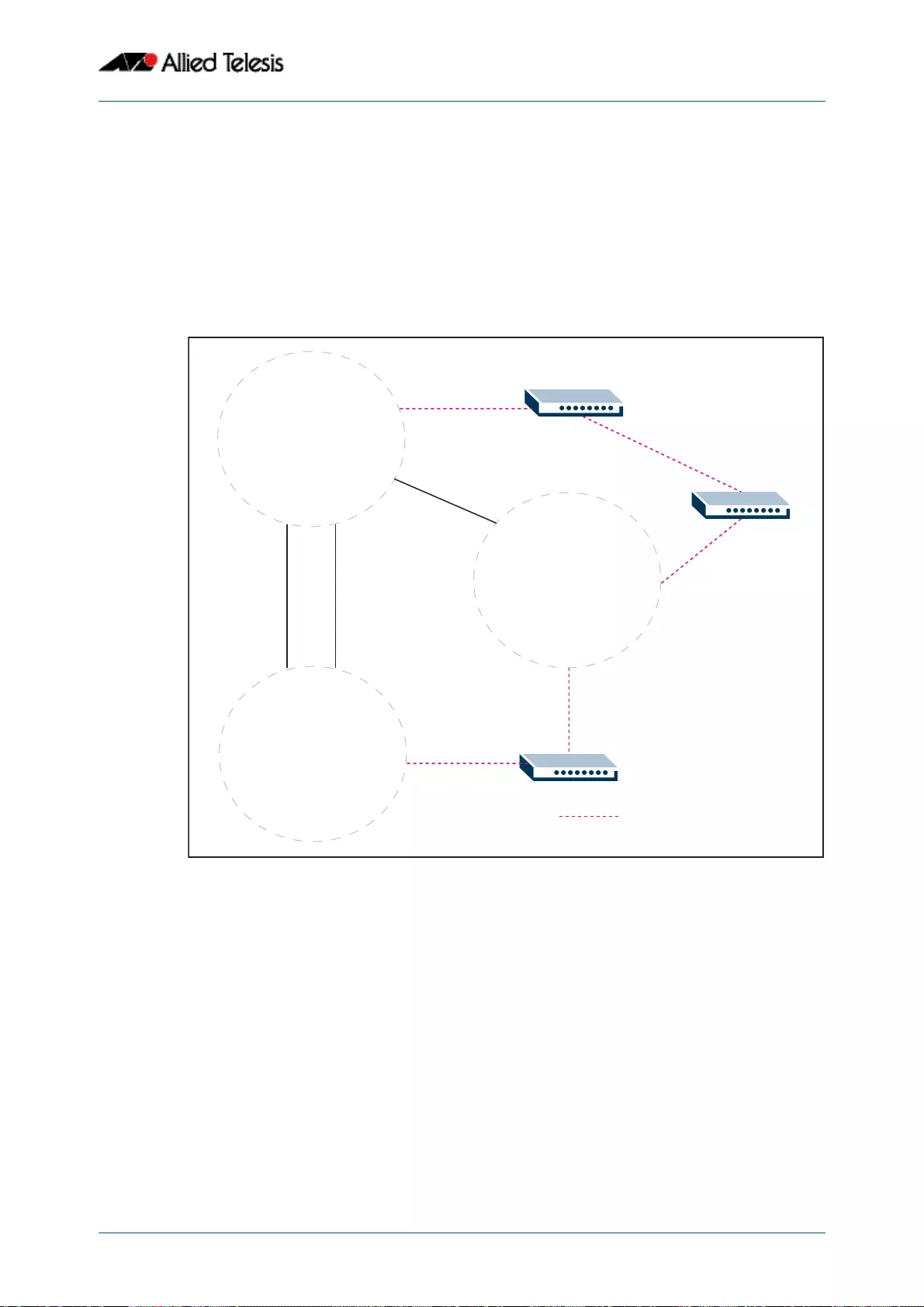
Spanning Tree Introduction: STP, RSTP, and MSTP
Software Reference for GS900MX/MPX Series Switches
C613-50065-01 REV B AlliedWare PlusTM Operating System - Version 5.4.4E-1.x 18.15
Common and Internal Spanning Tree (CIST)
The CIST is the default spanning tree instance of MSTP, i.e. all VLANs that are not members
of particular MSTIs are members of the CIST. Also, an individual MST region can be
regarded as a single virtual bridge by other MST regions. The spanning tree that runs
between regions is the CIST. The CIST is also the spanning tree that runs between MST
regions and Single Spanning Tree (SST) entities. So, in Figure 18-3, the STP that is running
between the regions, and to the SST bridges, is the CIST.
Figure 18-3: The CIST operates on links between regions and to SST devices
Compatibility with
Previous Spanning
Tree Protocols
MSTP provides for compatibility with older spanning tree protocols in several ways. In
addition to the MST region described in the previous section, the protocol provides for
single spanning tree systems by employing a Common and Internal Spanning Tree (CIST).
The CIST applies a common and internal spanning tree protocol to the whole of the
bridged network and is a direct equivalent to the internal spanning tree (IST) protocol of
earlier versions.
In common with legacy spanning tree systems, the CIST protocol first determines its root
bridge from all the bridges on the network. This is the bridge that contains the lowest
bridge identifier. The protocol then selects a regional root bridge for each MSTR. This is the
bridge that provides the best path to the CIST root. After the MSTR root bridges have been
chosen, they then act on the region’s behalf in such a way that the region appears to the
Common Spanning Tree (CST) as a virtual bridge. So in addition to having multiple MSTIs,
each region operates as a bridge in a CST.
RSTP operates on these links
MSTP
Region 1
MSTP
Region 2
MSTP
Region 3
The three switches shown
are non-MSTP capable
MSTP_vs_RSTP

Spanning Tree Introduction: STP, RSTP, and MSTP
Software Reference for GS900MX/MPX Series Switches
18.16 AlliedWare PlusTM Operating System - Version 5.4.4E-1.x C613-50065-01 REV B
CIST In addition to the individual MSTIs within each MSTP region, the MSTP region is a member
of a network-wide spanning tree called the Common and Internal Spanning Tree (CIST).
Conceptually, each region represents a virtual bridge. Internal and external bridge
connectivity are two independent functions.
Frames with VIDs allocated to the CIST are subject to the rules and path costs of the
complete bridged LAN as determined by the CIST’s vectors. Frames other than these are
subject to the CIST when traveling outside their region, and subject to its particular MSTI
inside the region.
The following operational rules apply:
■Each bridge can be a member of only one region.
■A data frame is associated with a single VID.
■Data frames with a given VID are associated with either the CIST or their particular
MSTI, but not both.
The role of the Common Spanning Tree (CST) in a network, and the Common and Internal
Spanning Tree (CIST) configured on each device, is to prevent loops within a wider
network that may span more than one MSTP region and parts of the network running in
legacy STP or RSTP mode.
CIST first allocates root and designated bridges by selecting the bridge with the lowest
identifier as the root. MSTP then deals with any loops between the regions in the CST. It
does this by considering the CIST “vectors” in the following order:
1. CIST External Root Path Cost
2. CIST Regional Root Identifier
3. CIST Internal Root Path Cost
4. CIST Designated Bridge Identifier
5. CIST Designated Port Identifier
6. CIST Receiving Port Identifier

Spanning Tree Introduction: STP, RSTP, and MSTP
Software Reference for GS900MX/MPX Series Switches
C613-50065-01 REV B AlliedWare PlusTM Operating System - Version 5.4.4E-1.x 18.17
MSTP Bridge Protocol Data Units (BPDUs)
The main function of bridge protocol data units is to enable MSTP to select its root bridges
for the CIST (“Common and Internal Spanning Tree (CIST)” on page 18.15) and each
MSTI. MSTP is compatible with earlier spanning tree versions; its Bridge Protocol Data Unit
(BPDU) formats build on earlier versions (“Compatibility with Previous Spanning Tree
Protocols” on page 18.15).
Table 18-7 shows the standardized format for MSTP BPDU messages. The general format
of the BPDUs comprise a common generic portion—octets 1 to 36—that are based on
those defined in IEEE Standard 802.1D, 1998, followed by components that are specific to
CIST—octets 37 to 102. Components specific to each MSTI are added to this BPDU data
block.
)
Table 18-7: MSTP Bridge Protocol Data Units (BPDUs)
Field Name Octets Description
Protocol Identifier 1–2 Protocol being used. The value 0000 0000 0000 0000
identifies the spanning tree algorithm and protocol.
Protocol Version
Identifier 3Identifies the protocol version used.
BPDU Type 4Value 0000 0000 specifies a configuration BPDU.
CIST Flags 5Bit 1 is the topology change flag.
Bit 2 conveys the CIST proposal flag in RST and MST
BPDUs - unused in STP.
Bits 3 & 4 convey the CIST port role in RST, and MST
BPDUs - unused in STP.
Bit 5 conveys the CIST learning flag in RST and MST
BPDUs - unused in STP.
Bit 6 conveys the CIST forwarding flag in RST and MST
BPDUs - unused in STP.
Bit 7 conveys the CIST agreement flag in RST and MST
BPDUs - unused in STP.
Bit 8 conveys the topology change acknowledge flag in
STP configuration BPDUs - unused in RSTP and MSTP
BPDUs.
CIST Root Identifier 6–13 The Bridge identifier of the CIST Root
CIST External Path
Cost
14–17 The path cost between MST regions from the
transmitting bridge to the CIST root.
CIST Regional Root
Identifier
18–25 ID of the current CIST regional root bridge.
CIST Port Identifier 26–27 CIST port identifier of the transmitting bridge port.
Message Age 28–29 Message age timer value.
Max Age 30–31 Timeout value to be used by all bridges in the bridged
network. This value is set by the root. Some
implementations of MSTP may choose not to use this
value.
Hello Time 32–33 Time interval between the generation of configuration
BPDUs by the root bridge.
Forward Delay 34–35 A timeout value used to ensure forward delay timer
consistency when transferring a port to the forwarding
state. It is also used for ageing filtering database
dynamic entries following changes in the active
topology.

Spanning Tree Introduction: STP, RSTP, and MSTP
Software Reference for GS900MX/MPX Series Switches
18.18 AlliedWare PlusTM Operating System - Version 5.4.4E-1.x C613-50065-01 REV B
Version 1 Length 36 Used to convey the Version 1 length. It is always
transmitted as 0.
Version 3 Length 37–38 Used to convey the Version 3 length. It is the number
of octets taken by the parameters that follow in the
BPDU.
MST Configuration
Identifier
39–89 An identifier comprising elements of the following:
Format Selector
Configuration Name
Revision Level
Configuration Digest.
CIST Internal Root
Path Cost
90–93 Path cost to the CIST regional root.
CIST Bridge
Identifier
94–101 CIST bridge identifier of the transmitting bridge.
CIST Remaining
Hops 102 Remaining hops which limits the propagation and
longevity of received spanning tree information for the
CIST.
MSTI Configuration
Messages
(may be absent)
103–39
plus
Version
3
Length
See Table 18-8.
Table 18-8: MSTI configuration messages
Field Name Octets Description
MSTI Flags 1Bits 1 through 8, convey the topology change flag,
proposal flag, port role (two bits), Learning flag,
forwarding flag, agreement flag, and master flag for
this MSTI.
MSTI Regional Root
Identifier
2–9 This includes the value of the MSTID for this
configuration message encoded in bits 4 through 1 of
octet 1, and bits 8 through 1 of octet 2.
MSTI Internal Root
Path Cost 10-13 Internal Root Path Cost.
MSTI Bridge Priority 14 Bits 5 through 8 convey the value of the bridge
identifier priority for this MSTI. Bits 1 through 4 of Octet
14 are transmitted as 0, and ignored on receipt.
MSTI Port Priority 15 Bits 5 through 8 are used to convey the value of the
port identifier priority for this MSTI. Bits 1 through 4 are
transmitted as 0, and ignored on receipt.
MSTI Remaining
Hops
16 Value of remaining hops for this MSTI.
Table 18-7: MSTP Bridge Protocol Data Units (BPDUs) (cont.)
Field Name Octets Description

Spanning Tree Introduction: STP, RSTP, and MSTP
Software Reference for GS900MX/MPX Series Switches
C613-50065-01 REV B AlliedWare PlusTM Operating System - Version 5.4.4E-1.x 18.19
Configuring MSTP
By default, RSTP is enabled with default settings on all switch ports. To configure MSTP, see
the configuration procedure in Table 18-9.
To configure other modes, see “Configuring RSTP” on page 18.9 or “Configuring STP”
on page 18.6.
For detailed configuration examples, see the How To Note How To Configure Basic
Switching Functionality, available from website at alliedtelesis.com.
Configuration
guidelines for
MSTP
■Switches must have the same MST configuration identification elements (region
name, revision level and VLAN to MSTI mapping) to be in the same MST region. When
configuring multiple MST regions for MSTP, MSTIs are locally significant within an MST
region. MSTIs will not span from one region to another region.
■Common and Internal Spanning Tree (CIST) is the default spanning tree instance for
MSTP. This means that all VLANs that are not explicitly configured into another MSTI
are members of the CIST.
■The software supports a single instance of the MSTP Algorithm consisting of the CIST
and up to 15 MSTIs.
■A VLAN can only be mapped to one MSTI or to the CIST. One VLAN mapped to
multiple spanning trees is not allowed. All the VLANs are mapped to the CIST by
default. Once a VLAN is mapped to a specified MSTI, it is removed from the CIST.
■An MSTI is locally significant within an MST region. An MSTI cannot span across
multiple MST regions. The CIST is the spanning tree instance for connecting different
MST regions and single spanning tree entities, such as RSTP and STP switches.
■MSTP is compatible with RSTP and STP. An MST region appears as a virtual bridge
connecting to single spanning tree entities.
■To avoid unnecessary STP processing, a port that attaches to a LAN that is known to
have no other bridges/switches attached can be configured as an edge port.

Spanning Tree Introduction: STP, RSTP, and MSTP
Software Reference for GS900MX/MPX Series Switches
18.20 AlliedWare PlusTM Operating System - Version 5.4.4E-1.x C613-50065-01 REV B
Before configuring
MSTP
Before configuring MSTP, configure VLANs and associate them with switch ports
(Chapter 16, VLAN Introduction and Chapter 17, VLAN Commands), and determine for
your network:
■which MSTP regions, revision level and instances are required
■which VLANs and switch ports will belong to which MSTIs,
■which devices you want to be root bridges for each MSTI
Table 18-9: Configuration procedure for MSTP
Command Description
awplus#
configure terminal Enter Global Configuration mode.
awplus(config)#
spanning-tree mode mstp By default, the device is in RSTP mode. Change to MSTP
mode.
awplus(config)#
spanning-tree enable By default, spanning tree is enabled on all switch ports. If
it has been disabled, enable it for MSTP.
Step 1. Configure MSTP region, revision, and instances
All MSTP devices in this region of the network must have the same region name, revision number, and VLAN to
MSTI mappings.
awplus(config)#
spanning-tree mst configuration Enter MST Configuration mode.
awplus(config-mst)#
region <region-name> Specify the MSTP region. The region-name parameter is
an arbitrary string that specifies the name you want to
assign to the MST region for identification.
awplus(config-mst)#
revision <revision-number> The revision-number parameter specifies the revision of
the current MST configuration. The revision is an
arbitrary number that you assign to an MST region. It can
be used to keep track of the number of times that MST
configuration has been updated for the network.
Specify the MST revision number in the range 0 to 255.
awplus(config-mst)#
instance <msti-id> vlan {<vid>|<vid-list>} To allow MSTP to block traffic for different VLANs in
different places in a loop, create multiple MSTP instances
and associate VLANs with them. Each VLAN can only be
in one instance.
Specify the MST instance ID in the range 1 to 15.

Spanning Tree Introduction: STP, RSTP, and MSTP
Software Reference for GS900MX/MPX Series Switches
C613-50065-01 REV B AlliedWare PlusTM Operating System - Version 5.4.4E-1.x 18.21
Step 2. Advanced configuration
The commands above are the minimum required to configure MSTP. The following commands allow more
advanced configuration.
Step 3. Assign root bridge priorities
MSTP lets you distribute traffic more efficiently across a network by blocking different links for different VLANs.
You do this by making different devices into the root bridge for each MSTP instance, and for the CIST, so that
each instance blocks a different link. By default, all devices have the same root bridge priority, 32768 (8000 in
hexadecimal), so the device with the lowest MAC address becomes the root bridge. If you want the device to be
the root bridge for an instance or for the CIST, set the priority to a lower value (a higher priority) than other
devices for this instance. (If you enter a number that is not a multiple of 4096, the device rounds the number
down.)
awplus(config)#
spanning-tree mst configuration Enter MST Configuration mode.
awplus(config-mst)#
instance <msti-id> priority
<priority>
Set the priority for the device to become the root bridge
for each instance.
Specify the MST instance ID in the range 1 to 15.
Specify the root bridge priority in the range 0 to 61440. If
you enter a number that is not a multiple of 4096, the
switch rounds the number down.
awplus(config-mst)#
exit Return to Global Configuration mode.
awplus(config)#
spanning-tree priority <priority> Set the priority for the device to become the root bridge
for the CIST.
Specify the bridge priority in the range 0 to 61440. If you
enter a number that is not a multiple of 4096, the switch
rounds the number down.
Step 4. Configure edge ports
If some switch ports are connected to devices that cannot generate BPDUs (such as workstations), you can set
particular switch ports as edge ports, or set them to automatically detect whether they are edge ports.
awplus(config)#
interface <port-list> Enter Interface Configuration mode for these switch
ports.
awplus(config-if)#
spanning-tree edgeport (RSTP and
MSTP)
or awplus(config-if)#
spanning-tree autoedge (RSTP and
MSTP)
Set these ports to be edge ports,
or
set these ports to automatically detect whether they are
edge ports.
Table 18-9: Configuration procedure for MSTP (cont.)
Command Description

Spanning Tree Introduction: STP, RSTP, and MSTP
Software Reference for GS900MX/MPX Series Switches
18.22 AlliedWare PlusTM Operating System - Version 5.4.4E-1.x C613-50065-01 REV B
Step 5. Configure Root Guard
awplus(config-if)#
spanning-tree guard root The Root Guard feature makes sure that the port on
which it is enabled is a designated port. If the Root
Guard enabled port receives a superior BPDU, it goes to
a Listening state (for STP) or discarding state (for RSTP
and MSTP). Enable the Guard Root feature if required.
awplus(config-if)#
exit Return to Global Configuration mode.
Step 6. Configure BPDU Guard
awplus(config)#
spanning-tree portfast bpdu-guard If required, enable the BPDU Guard feature.
awplus(config)#
spanning-tree errdisable-timeout
enable
Set a timeout for ports that are disabled due to the BPDU
guard feature.
awplus(config)#
spanning-tree errdisable-timeout
interval <10-1000000>
Specify the time interval after which a port is brought
back up when it has been disabled by the BPDU guard
feature.
Step 7. Check MSTP configuration
awplus(config)#
exit Return to Privileged Exec mode.
awplus#
show spanning-tree mst config Check that the digest is the same on this device as for all
other devices in the same region.
awplus#
show spanning-tree mst Check the MST to VLAN and port mapping.
awplus#
show spanning-tree mst instance
<instance>
Check the detailed information for a particular instance,
and all switch ports associated with that instance.
Specify the MST instance ID in the range 1 to 15.
awplus#
show spanning-tree mst interface
<port>
Check general information about MSTP, and the CIST
settings.
Table 18-9: Configuration procedure for MSTP (cont.)
Command Description

Spanning Tree Introduction: STP, RSTP, and MSTP
Software Reference for GS900MX/MPX Series Switches
C613-50065-01 REV B AlliedWare PlusTM Operating System - Version 5.4.4E-1.x 18.23
Advanced
configuration:
For most networks, the default settings of the following will be suitable. However, you can
also configure them.
■path costs for ports in an MSTI (spanning-tree mst instance path-cost) or for the
CIST (spanning-tree path-cost)
■port priority for ports in an MSTI (spanning-tree mst instance priority) or for the
CIST (spanning-tree priority (port priority))

Spanning Tree Introduction: STP, RSTP, and MSTP
Software Reference for GS900MX/MPX Series Switches
18.24 AlliedWare PlusTM Operating System - Version 5.4.4E-1.x C613-50065-01 REV B

Software Reference for GS900MX/MPX Series Switches
C613-50065-01 REV B AlliedWare PlusTM Operating System - Version 5.4.4E-1.x 19.1
Chapter 19: Spanning Tree Commands
Command List .................................................................................................................................... 19.3
clear spanning-tree statistics ........................................................................................................ 19.3
clear spanning-tree detected protocols (RSTP and MSTP) ................................................ 19.4
debug mstp (RSTP and STP) .......................................................................................................... 19.5
instance priority (MSTP).................................................................................................................. 19.8
instance vlan (MSTP)......................................................................................................................19.10
region (MSTP) ...................................................................................................................................19.11
revision (MSTP).................................................................................................................................19.12
show debugging mstp..................................................................................................................19.13
show spanning-tree .......................................................................................................................19.14
show spanning-tree brief.............................................................................................................19.17
show spanning-tree mst...............................................................................................................19.18
show spanning-tree mst config.................................................................................................19.19
show spanning-tree mst detail ..................................................................................................19.20
show spanning-tree mst detail interface................................................................................19.22
show spanning-tree mst instance.............................................................................................19.24
show spanning-tree mst instance interface..........................................................................19.25
show spanning-tree mst interface............................................................................................19.26
show spanning-tree mst detail interface................................................................................19.27
show spanning-tree statistics.....................................................................................................19.29
show spanning-tree statistics instance ...................................................................................19.30
show spanning-tree statistics instance interface ................................................................19.31
show spanning-tree statistics interface ..................................................................................19.32
show spanning-tree vlan range-index ....................................................................................19.34
spanning-tree autoedge (RSTP and MSTP)............................................................................19.35
spanning-tree bpdu .......................................................................................................................19.36
spanning-tree cisco-interoperability (MSTP) ........................................................................19.38
spanning-tree edgeport (RSTP and MSTP) ............................................................................19.39
spanning-tree enable ....................................................................................................................19.40
spanning-tree errdisable-timeout enable..............................................................................19.42
spanning-tree errdisable-timeout interval ............................................................................19.43
spanning-tree force-version........................................................................................................19.44
spanning-tree forward-time........................................................................................................19.45
spanning-tree guard root.............................................................................................................19.46
spanning-tree hello-time .............................................................................................................19.47
spanning-tree link-type ................................................................................................................19.48
spanning-tree max-age.................................................................................................................19.49
spanning-tree max-hops (MSTP)...............................................................................................19.50
spanning-tree mode ......................................................................................................................19.51
spanning-tree mst configuration ..............................................................................................19.52
spanning-tree mst instance.........................................................................................................19.53
spanning-tree mst instance path-cost ....................................................................................19.54
spanning-tree mst instance priority.........................................................................................19.56
spanning-tree mst instance restricted-role ...........................................................................19.57
spanning-tree mst instance restricted-tcn ............................................................................19.58
spanning-tree path-cost...............................................................................................................19.59
spanning-tree portfast (STP) .......................................................................................................19.60

Spanning Tree Commands
Software Reference for GS900MX/MPX Series Switches
19.2 AlliedWare PlusTM Operating System - Version 5.4.4E-1.x C613-50065-01 REV B
spanning-tree portfast bpdu-filter ...........................................................................................19.62
spanning-tree portfast bpdu-guard.........................................................................................19.64
spanning-tree priority (bridge priority) ..................................................................................19.66
spanning-tree priority (port priority) .......................................................................................19.67
spanning-tree restricted-role......................................................................................................19.68
spanning-tree restricted-tcn.......................................................................................................19.68
spanning-tree transmit-holdcount...........................................................................................19.69
undebug mstp .................................................................................................................................19.69

Spanning Tree Commands
Software Reference for GS900MX/MPX Series Switches
C613-50065-01 REV B AlliedWare PlusTM Operating System - Version 5.4.4E-1.x 19.3
Command List
This chapter provides an alphabetical reference for commands used to configure RSTP, STP
or MSTP. For information about spanning trees, including configuration procedures, see
Chapter 18, Spanning Tree Introduction: STP, RSTP, and MSTP
clear spanning-tree statistics
Use this command to clear all the STP BPDU (Bridge Protocol Data Unit) statistics.
Syntax clear spanning-tree statistics
clear spanning-tree statistics [instance <mstp-instance>]
clear spanning-tree statistics
[interface <port> [instance <mstp-instance>]]
Mode User Exec and Privileged Exec
Usage Use this command with the instance parameter in MSTP mode. Specifying this command
with the interface parameter only not the instance parameter will work in STP and RSTP
mode.
Examples
Parameter Description
<port>The port to clear STP BPDU statistics for. The port may be a switch
port (e.g. port1.0.4), a static channel group (e.g. sa2), or a
dynamic (LACP) channel group (e.g. po2).
<mstp-
instance>
The MSTP instance (MSTI - Multiple Spanning Tree Instance) to clear
MSTP BPDU statistics.
awplus# clear spanning-tree statistics
awplus# clear spanning-tree statistics instance 1
awplus# clear spanning-tree statistics interface port1.0.2
awplus# clear spanning-tree statistics interface port1.0.2
instance 1

Spanning Tree Commands
Software Reference for GS900MX/MPX Series Switches
19.4 AlliedWare PlusTM Operating System - Version 5.4.4E-1.x C613-50065-01 REV B
clear spanning-tree detected protocols (RSTP and
MSTP)
Use this command to clear the detected protocols for a specific port, or all ports.
Use this command in RSTP or MSTP mode only.
Syntax clear spanning-tree detected protocols [interface <port>]
Mode Privileged Exec
Example
Parameter Description
<port>The port to clear detected protocols for. The port may be a switch
port (e.g. port1.0.4), a static channel group (e.g. sa2), or a
dynamic (LACP) channel group (e.g. po2).
awplus# clear spanning-tree detected protocols

Spanning Tree Commands
Software Reference for GS900MX/MPX Series Switches
C613-50065-01 REV B AlliedWare PlusTM Operating System - Version 5.4.4E-1.x 19.5
debug mstp (RSTP and STP)
Use this command to enable debugging for the configured spanning tree mode, and echo
data to the console, at various levels. Note that although this command uses the keyword
mstp it displays debugging output for RSTP and STP protocols as well the MSTP protocol.
Use the no variant of this command to disable spanning tree debugging.
Syntax debug mstp {all|cli|protocol [detail]|timer [detail]}
debug mstp {packet {rx|tx} [decode] [interface <interface>]}
debug mstp {topology-change [interface <interface>]}
no debug mstp {all|cli|protocol [detail]|timer [detail]}
no debug mstp {packet {rx|tx} [decode] [interface <interface>]}
no debug mstp {topology-change [interface <interface>]}
Mode Privileged Exec and Global Configuration mode
Usage 1 Use the debug mstp topology-change interface command to generate debugging
messages when the switch receives an indication of a topology change in a BPDU from
another device. The debugging can be activated on a per-port basis. Although this
command uses the keyword mstp, it displays debugging output for RSTP and STP
protocols as well as the MSTP protocol.
Due to the likely volume of output, these debug messages are best viewed using the
terminal monitor command on page 8.69 before issuing the relevant debug mstp
command. The default terminal monitor filter will select and display these messages.
Alternatively, the messages can be directed to any of the other log outputs by adding a
filter for the MSTP application using log buffered (filter) command on page 10.8:
Parameter Description
all Echoes all spanning tree debugging levels to the console.
cli Echoes spanning tree commands to the console.
packet Echoes spanning tree packets to the console.
rx Received packets.
tx Transmitted packets.
protocol Echoes protocol changes to the console.
timer Echoes timer information to the console.
detail Detailed output.
decode Interprets packet contents
topology-change Interprets topology change messages
interface Keyword before <interface> placeholder to specify an
interface to debug
<interface>Placeholder used to specify the name of the interface to
debug.

Spanning Tree Commands
Software Reference for GS900MX/MPX Series Switches
19.6 AlliedWare PlusTM Operating System - Version 5.4.4E-1.x C613-50065-01 REV B
:
Output 1
Usage 2 Use the debug mstp packet rx|tx decode interface command to generate debugging
messages containing the entire contents of a BPDU displayed in readable text for
transmitted and received xSTP BPDUs. The debugging can be activated on a per-port basis
and transmit and receive debugging is controlled independently. Although this command
uses the keyword mstp, it displays debugging output for RSTP and STP protocols as well
as the MSTP protocol.
Due to the likely volume of output, these debug messages are best viewed using the
terminal monitor command on page 8.69 before issuing the relevant debug mstp
command. The default terminal monitor filter will select and display these messages.
Alternatively, the messages can be directed to any of the other log outputs by adding a
filter for the MSTP application using the log buffered (filter) command on page 10.8:
Output 2 In MSTP mode - an MSTP BPDU with 1 MSTI:
awplus# configure terminal
awplus(config)# log buffered program mstp
awplus#terminal monitor
awplus#debug mstp topology-change interface port1.0.4
10:09:09 awplus MSTP[1409]: Topology change rcvd on port1.0.4 (internal)
10:09:09 awplus MSTP[1409]: Topology change rcvd on MSTI 1 port1.0.4
aawplus#debug mstp topology-change interface port1.0.6
10:09:29 awplus MSTP[1409]: Topology change rcvd on port1.0.6 (external)
10:09:29 awplus MSTP[1409]: Topology change rcvd on MSTI 1 port1.0.6
awplus(config)# log buffered program mstp
awplus#terminal monitor
awplus#debug mstp packet rx decode interface port1.0.4
17:23:42 awplus MSTP[1417]: port1.0.4 xSTP BPDU rx - start
17:23:42 awplus MSTP[1417]: Protocol version: MSTP, BPDU type: RST
17:23:42 awplus MSTP[1417]: CIST Flags: Agree Forward Learn role=Desig
17:23:42 awplus MSTP[1417]: CIST root id : 0000:0000cd1000fe
17:23:42 awplus MSTP[1417]: CIST ext pathcost : 0
17:23:42 awplus MSTP[1417]: CIST reg root id : 0000:0000cd1000fe
17:23:42 awplus MSTP[1417]: CIST port id : 8001 (128:1)
17:23:42 awplus MSTP[1417]: msg age: 0 max age: 20 hellotime: 2 fwd delay: 15
17:23:42 awplus MSTP[1417]: Version 3 length : 80
17:23:42 awplus MSTP[1417]: Format id : 0
17:23:42 awplus MSTP[1417]: Config name : test
17:23:42 awplus MSTP[1417]: Revision level : 0
17:23:42 awplus MSTP[1417]: Config digest : 3ab68794d602fdf43b21c0b37ac3bca8
17:23:42 awplus MSTP[1417]: CIST int pathcost : 0
17:23:42 awplus MSTP[1417]: CIST bridge id : 0000:0000cd1000fe
17:23:42 awplus MSTP[1417]: CIST hops remaining : 20
17:23:42 awplus MSTP[1417]: MSTI flags : Agree Forward Learn role=Desig
17:23:42 awplus MSTP[1417]: MSTI reg root id : 8001:0000cd1000fe
17:23:42 awplus MSTP[1417]: MSTI pathcost : 0
17:23:42 awplus MSTP[1417]: MSTI bridge priority : 32768 port priority : 128
17:23:42 awplus MSTP[1417]: MSTI hops remaining : 20
17:23:42 awplus MSTP[1417]: port1.0.4 xSTP BPDU rx - finish

Spanning Tree Commands
Software Reference for GS900MX/MPX Series Switches
C613-50065-01 REV B AlliedWare PlusTM Operating System - Version 5.4.4E-1.x 19.7
In STP mode transmitting a TCN BPDU:
In STP mode receiving an STP BPDU:
In RSTP mode receiving an RSTP BPDU:
Examples
Related Commands log buffered (filter)
show debugging mstp
terminal monitor
undebug mstp
awplus#terminal monitor
awplus#debug mstp packet tx decode interface port1.0.4
17:28:09 awplus MSTP[1417]: port1.0.4 xSTP BPDU tx - start
17:28:09 awplus MSTP[1417]: Protocol version: STP, BPDU type: TCN
17:28:09 awplus MSTP[1417]: port1.0.4 xSTP BPDU tx - finish
awplus#terminal monitor
awplus#debug mstp packet rx decode interface port1.0.4
17:31:36 awplus MSTP[1417]: port1.0.4 xSTP BPDU rx - start
17:31:36 awplus MSTP[1417]: Protocol version: STP, BPDU type: Config
17:31:36 awplus MSTP[1417]: Flags: role=none
17:31:36 awplus MSTP[1417]: Root id : 8000:0000cd1000fe
17:31:36 awplus MSTP[1417]: Root pathcost : 0
17:31:36 awplus MSTP[1417]: Bridge id : 8000:0000cd1000fe
17:31:36 awplus MSTP[1417]: Port id : 8001 (128:1)
17:31:36 awplus MSTP[1417]: msg age: 0 max age: 20 hellotime: 2 fwd delay: 15
17:31:36 awplus MSTP[1417]: ort1.0.4 xSTP BPDU rx - finish
awplus#terminal monitor
awplus#debug mstp packet rx decode interface port1.0.4
awplus#17:30:17 awplus MSTP[1417]: port1.0.4 xSTP BPDU rx - start
17:30:17 awplus MSTP[1417]: Protocol version: RSTP, BPDU type: RST
17:30:17 awplus MSTP[1417]: CIST Flags: Forward Learn role=Desig
17:30:17 awplus MSTP[1417]: CIST root id : 8000:0000cd1000fe
17:30:17 awplus MSTP[1417]: CIST ext pathcost : 0
17:30:17 awplus MSTP[1417]: CIST reg root id : 8000:0000cd1000fe
17:30:17 awplus MSTP[1417]: CIST port id : 8001 (128:1)
17:30:17 awplus MSTP[1417]: msg age: 0 max age: 20 hellotime: 2 fwd delay: 15
17:30:17 awplus MSTP[1417]: port1.0.4 xSTP BPDU rx - finish
awplus# debug mstp all
awplus# debug mstp cli
awplus# debug mstp packet rx
awplus# debug mstp protocol detail
awplus# debug mstp timer
awplus# debug mstp packet rx decode interface port1.0.2
awplus# debug mstp packet tx decode interface port1.0.6

Spanning Tree Commands
Software Reference for GS900MX/MPX Series Switches
19.8 AlliedWare PlusTM Operating System - Version 5.4.4E-1.x C613-50065-01 REV B
instance priority (MSTP)
Use this command to set the priority for this device to become the root bridge for the
specified MSTI (Multiple Spanning Tree Instance).
Use this command for MSTP only.
Use the no variant of this command to restore the root bridge priority of the device for the
instance to the default.
Syntax instance <msti-id> priority <priority>
no instance <msti-id> priority
Default The default priority value for all instances is 32768.
Mode MST Configuration
Usage MSTP lets you distribute traffic more efficiently across a network by blocking different
links for different VLANs. You do this by making different devices into the root bridge for
each MSTP instance, so that each instance blocks a different link.
If all devices have the same root bridge priority for the instance, MSTP selects the device
with the lowest MAC address to be the root bridge. Give the device a higher priority for
becoming the root bridge for a particular instance by assigning it a lower priority number,
or vice versa.
Examples To set the root bridge priority for MSTP instance 2 to be the highest (0), so that it will be
the root bridge for this instance when available, use the commands:
To reset the root bridge priority for instance 2 to the default (32768), use the commands:
Parameter Description
<msti-id> Specify the The MST instance ID in the range <1-15>.
<priority> Specify the root bridge priority for the device for the MSTI in the
range <0-61440>. Note that a lower priority number indicates a
greater likelihood of the device becoming the root bridge. The
priority values can be set only in increments of 4096. If you specify a
number that is not a multiple of 4096, it will be rounded down. The
default priority is 32768.
awplus# configure terminal
awplus(config)# spanning-tree mst configuration
awplus(config-mst)# instance 2 priority 0
awplus# configure terminal
awplus(config)# spanning-tree mst configuration
awplus(config-mst)# no instance 2 priority

Spanning Tree Commands
Software Reference for GS900MX/MPX Series Switches
19.10 AlliedWare PlusTM Operating System - Version 5.4.4E-1.x C613-50065-01 REV B
instance vlan (MSTP)
Use this command to create an MST Instance (MSTI), and associate the specified VLANs
with it. An MSTI is a spanning tree instance that exists within an MST region (MSTR). An
MSTR can contain up to 15 MSTIs.
When a VLAN is associated with an MSTI the member ports of the VLAN are automatically
configured to send and receive spanning-tree information for the associated MSTI. You
can disable this automatic configuration of member ports of the VLAN to the associated
MSTI by using a no spanning-tree mst instance command to remove the member port
from the MSTI.
Use the instance vlan command for MSTP only.
Use the no variant of this command to remove the specified VLANs from the MSTI.
Syntax instance <msti-id> vlan {<vid>|<vid-list>}
no instance <msti-id> vlan {<vid>|<vid-list>}
Mode MST Configuration
Usage The VLANs must be created before being associated with an MST instance (MSTI). If the
VLAN range is not specified, the MSTI will not be created.
This command removes the specified VLANs from the CIST and adds them to the specified
MSTI. If you use the no variant of this command to remove the VLAN from the MSTI, it
returns it to the CIST. To move a VLAN from one MSTI to another, you must first use the no
variant of this command to return it to the CIST.
Ports in these VLANs will remain in the control of the CIST until you associate the ports
with the MSTI using the spanning-tree mst instance command.
Example
Related Commands region (MSTP)
revision (MSTP)
show spanning-tree mst config
spanning-tree mst instance
vlan
Parameter Description
<msti-id> Specify the MST instance ID <1-15>.
<vid> Specify a VLAN identifier (VID) in the range <1-4094> to be
associated with the MSTI specified.
<vid-list> A hyphen-separated range or a comma-separated list of VLAN IDs
awplus# configure terminal
awplus(config)# spanning-tree mode mstp
awplus(config)# spanning-tree mst configuration
awplus(config-mst)# instance 2 vlan 30

Spanning Tree Commands
Software Reference for GS900MX/MPX Series Switches
C613-50065-01 REV B AlliedWare PlusTM Operating System - Version 5.4.4E-1.x 19.11
region (MSTP)
Use this command to assign a name to the device’s MST Region. MST Instances (MSTI) of a
region form different spanning trees for different VLANs.
Use this command for MSTP only.
Use the no variant of this command to remove this region name and reset it to the default.
Syntax region <region-name>
no region
Default By default, the region name is My Name.
Mode MST Configuration
Usage The region name, the revision number, and the digest of the VLAN to MSTI configuration
table must be the same on all devices that are intended to be in the same MST region.
Example
Related Commands revision (MSTP)
show spanning-tree mst config
Parameter Description
<region-name>Specify the name of the region, up to 32 characters. Valid
characters are upper-case, lower-case, digits, underscore.
awplus# configure terminal
awplus(config)# spanning-tree mst configuration
awplus(config-mst)# region ATL

Spanning Tree Commands
Software Reference for GS900MX/MPX Series Switches
19.12 AlliedWare PlusTM Operating System - Version 5.4.4E-1.x C613-50065-01 REV B
revision (MSTP)
Use this command to specify the MST revision number to be used in the configuration
identifier.
Use this command for MSTP only.
Syntax revision <revision-number>
Default The default of revision number is 0.
Mode MST Configuration
Usage The region name, the revision number, and the digest of the VLAN to MSTI configuration
table must be the same on all devices that are intended to be in the same MST region.
Example
Related Commands region (MSTP)
show spanning-tree mst config
instance vlan (MSTP)
Parameter Description
<revision-number><0-65535> Revision number.
awplus# configure terminal
awplus(config)# spanning-tree mst configuration
awplus(config-mst)# revision 25

Spanning Tree Commands
Software Reference for GS900MX/MPX Series Switches
C613-50065-01 REV B AlliedWare PlusTM Operating System - Version 5.4.4E-1.x 19.13
show debugging mstp
Use this command to show the MSTP debugging options set.
For information on output options, see “Controlling “show” Command Output” on
page 1.35.
Syntax show debugging mstp
Mode User Exec and Privileged Exec mode
Example To display the MSTP debugging options set, enter the command:
Output Figure 19-1: Example output from the show debugging mstp command
Related Commands debug mstp (RSTP and STP)
awplus# show debugging mstp
MSTP debugging status:
MSTP receiving packet debugging is on

Spanning Tree Commands
Software Reference for GS900MX/MPX Series Switches
19.14 AlliedWare PlusTM Operating System - Version 5.4.4E-1.x C613-50065-01 REV B
show spanning-tree
Use this command to display detailed spanning tree information on the specified port or
on all ports. Use this command for RSTP, MSTP or STP.
For information on output options, see “Controlling “show” Command Output” on
page 1.35.
Syntax show spanning-tree [interface <port-list>]
Mode User Exec and Privileged Exec
Usage Note that any list of interfaces specified must not span any interfaces that are not
installed.
A topology change counter has been included for RSTP and MSTP. You can see the
topology change counter for RSTP by using the show spanning-tree command. You can
see the topology change counter for MSTP by using the show spanning-tree mst
instance command.
Example To display spanning tree information about port1.0.3, use the command:
Parameter Description
interface Display information about the following port only.
<port-list>The ports to display information about. A port-list can be:
■a switch port (e.g. port1.0.6) a static channel group (e.g. sa2)
or a dynamic (LACP) channel group (e.g. po2)
■a continuous range of ports separated by a hyphen,
e.g. port1.0.1-1.0.4, or sa1-2, or po1-2
■a comma-separated list of ports and port ranges,
e.g. port1.0.1,port1.0.4-1.0.6. Do not mix switch ports,
static channel groups, and dynamic (LACP) channel groups in the
same list
awplus# show spanning-tree interface port1.0.3

Spanning Tree Commands
Software Reference for GS900MX/MPX Series Switches
C613-50065-01 REV B AlliedWare PlusTM Operating System - Version 5.4.4E-1.x 19.15
Output Figure 19-2: Example output from the show spanning-tree command
% 1: Bridge up - Spanning Tree Enabled
% 1: Root Path Cost 0 - Root Port 0 - Bridge Priority 32768
% 1: Forward Delay 15 - Hello Time 2 - Max Age 20
% 1: Root Id 80000000cd20f093
% 1: Bridge Id 80000000cd20f093
% 1: last topology change Sun Nov 20 12:24:24 1977
% 1: portfast bpdu-filter disabled
% 1: portfast bpdu-guard disabled
% 1: portfast errdisable timeout disabled
% 1: portfast errdisable timeout interval 300 sec
% port1.0.3: Port 5023 - Id 839f - Role Designated - State Forwarding
% port1.0.3: Designated Path Cost 0
% port1.0.3: Configured Path Cost 200000 - Add type Explicit ref count 1
% port1.0.3: Designated Port Id 839f - Priority 128 -
% port1.0.3: Root 80000000cd20f093
% port1.0.3: Designated Bridge 80000000cd20f093
% port1.0.3: Message Age 0 - Max Age 20
% port1.0.3: Hello Time 2 - Forward Delay 15
% port1.0.3: Forward Timer 0 - Msg Age Timer 0 - Hello Timer 1 - topo change
timer 0
% port1.0.3: forward-transitions 32
% port1.0.3: Version Rapid Spanning Tree Protocol - Received None - Send RSTP
% port1.0.3: No portfast configured - Current portfast off
% port1.0.3: portfast bpdu-guard default - Current portfast bpdu-guard off
% port1.0.3: portfast bpdu-filter default - Current portfast bpdu-filter off
% port1.0.3: no root guard configured - Current root guard off
% port1.0.3: Configured Link Type point-to-point - Current point-to-point
.
.

Spanning Tree Commands
Software Reference for GS900MX/MPX Series Switches
19.16 AlliedWare PlusTM Operating System - Version 5.4.4E-1.x C613-50065-01 REV B
Figure 19-3: Example output from the show spanning-tree command in RSTP mode
awplus#show spanning-tree
% 1: Bridge up - Spanning Tree Enabled
% 1: Root Path Cost 0 - Root Port 0 - Bridge Priority 32768
% 1: Forward Delay 15 - Hello Time 2 - Max Age 20
% 1: Root Id 80000000cd24ff2d
% 1: Bridge Id 80000000cd24ff2d
% 1: last topology change Thu Jul 26 02:06:26 2007
% 1: portfast bpdu-filter disabled
% 1: portfast bpdu-guard disabled
% 1: portfast errdisable timeout disabled
% 1: portfast errdisable timeout interval 300 sec
% port1.0.1: Port 5001 - Id 8389 - Role Disabled - State Discarding
% port1.0.1: Designated Path Cost 0
% port1.0.1: Configured Path Cost 20000000 - Add type Explicit ref count 1
% port1.0.1: Designated Port Id 8389 - Priority 128 -
% port1.0.1: Root 80000000cd24ff2d
% port1.0.1: Designated Bridge 80000000cd24ff2d
% port1.0.1: Message Age 0 - Max Age 20
% port1.0.1: Hello Time 2 - Forward Delay 15
% port1.0.1: Forward Timer 0 - Msg Age Timer 0 - Hello Timer 0 - topo change
timer 0
% port1.0.1: forward-transitions 0
% port1.0.1: Version Rapid Spanning Tree Protocol - Received None - Send STP
% port1.0.1: No portfast configured - Current portfast off
% port1.0.1: portfast bpdu-guard default - Current portfast bpdu-guard off
% port1.0.1: portfast bpdu-filter default - Current portfast bpdu-filter off
% port1.0.1: no root guard configured - Current root guard off
% port1.0.1: Configured Link Type point-to-point - Current shared
%
% port1.0.2: Port 5002 - Id 838a - Role Disabled - State Discarding
% port1.0.2: Designated Path Cost 0
% port1.0.2: Configured Path Cost 20000000 - Add type Explicit ref count 1
% port1.0.2: Designated Port Id 838a - Priority 128 -
% port1.0.2: Root 80000000cd24ff2d
% port1.0.2: Designated Bridge 80000000cd24ff2d
% port1.0.2: Message Age 0 - Max Age 20
% port1.0.2: Hello Time 2 - Forward Delay 15
% port1.0.2: Forward Timer 0 - Msg Age Timer 0 - Hello Timer 0 - topo change
timer 0
% port1.0.2: forward-transitions 0
% port1.0.2: Version Rapid Spanning Tree Protocol - Received None - Send STP
% port1.0.2: No portfast configured - Current portfast off
% port1.0.2: portfast bpdu-guard default - Current portfast bpdu-guard off
% port1.0.2: portfast bpdu-filter default - Current portfast bpdu-filter off
% port1.0.2: no root guard configured - Current root guard off
% port1.0.2: Configured Link Type point-to-point - Current shared
%

Spanning Tree Commands
Software Reference for GS900MX/MPX Series Switches
C613-50065-01 REV B AlliedWare PlusTM Operating System - Version 5.4.4E-1.x 19.17
show spanning-tree brief
Use this command to display a summary of spanning tree status information on all ports.
Use this command for RSTP, MSTP or STP.
Syntax show spanning-tree brief
Mode User Exec and Privileged Exec
Usage Note that any list of interfaces specified must not span any interfaces that are not
installed.
A topology change counter has been included for RSTP and MSTP. You can see the
topology change counter for RSTP by using the show spanning-tree command. You can
see the topology change counter for MSTP by using the show spanning-tree mst
instance command.
Example To display a summary of spanning tree status information, use the command:
Output Figure 19-4: Example output from the show spanning-tree brief command
Related Commands show spanning-tree
Parameter Description
brief A brief summary of spanning tree information.
awplus# show spanning-tree brief
Default: Bridge up - Spanning Tree Enabled
Default: Root Path Cost 40000 - Root Port 4501 - Bridge Priority 32768
Default: Root Id 8000:0000cd250001
Default: Bridge Id 8000:0000cd296eb1
Port Designated Bridge Port Id Role State
sa1 8000:001577c9744b 8195 Rootport Forwarding
po1 8000:0000cd296eb1 81f9 Designated Forwarding
port1.0.1 8000:0000cd296eb1 8389 Disabled Discarding
port1.0.2 8000:0000cd296eb1 838a Disabled Discarding
port1.0.3 8000:0000cd296eb1 838b Disabled Discarding
port1.0.4 8000:0000cd296eb1 838c Disabled Discarding
port1.0.5 8000:0000cd296eb1 838d Disabled Discarding
port1.0.6 8000:0000cd296eb1 838e Disabled Discarding

Spanning Tree Commands
Software Reference for GS900MX/MPX Series Switches
19.18 AlliedWare PlusTM Operating System - Version 5.4.4E-1.x C613-50065-01 REV B
show spanning-tree mst
This command displays bridge-level information about the CIST and VLAN to MSTI
mappings.
For information on output options, see “Controlling “show” Command Output” on
page 1.35.
Syntax show spanning-tree mst
Mode User Exec, Privileged Exec and Interface Configuration
Example To display bridge-level information about the CIST and VLAN to MSTI mappings, enter the
command:
Output Figure 19-5: Example output from the show spanning-tree mst command
Related Commands show spanning-tree mst interface
awplus# show spanning-tree mst
% 1: Bridge up - Spanning Tree Enabled
% 1: CIST Root Path Cost 0 - CIST Root Port 0 - CIST Bridge
Priority 32768
% 1: Forward Delay 15 - Hello Time 2 - Max Age 20 - Max-hops 20
% 1: CIST Root Id 8000000475e93ffe
% 1: CIST Reg Root Id 8000000475e93ffe
% 1: CST Bridge Id 8000000475e93ffe
% 1: portfast bpdu-filter disabled
% 1: portfast bpdu-guard disabled
% 1: portfast errdisable timeout disabled
% 1: portfast errdisable timeout interval 300 sec
%
% Instance VLAN
% 0: 1
% 2: 4

Spanning Tree Commands
Software Reference for GS900MX/MPX Series Switches
C613-50065-01 REV B AlliedWare PlusTM Operating System - Version 5.4.4E-1.x 19.19
show spanning-tree mst config
Use this command to display MSTP configuration identifier for the device.
For information on output options, see “Controlling “show” Command Output” on
page 1.35.
Syntax show spanning-tree mst config
Mode User Exec, Privileged Exec and Interface Configuration
Usage The region name, the revision number, and the digest of the VLAN to MSTI configuration
table must be the same on all devices that are intended to be in the same MST region.
Example To display MSTP configuration identifier information, enter the command:
Output Figure 19-6: Example output from the show spanning-tree mst config command
Related Commands instance vlan (MSTP)
region (MSTP)
revision (MSTP)
awplus# show spanning-tree mst config
awplus#show spanning-tree mst config
%
% MSTP Configuration Information:
%------------------------------------------------------
% Format Id : 0
% Name : My Name
% Revision Level : 0
% Digest : 0x80DEE46DA92A98CF21C603291B22880A
%------------------------------------------------------

Spanning Tree Commands
Software Reference for GS900MX/MPX Series Switches
19.20 AlliedWare PlusTM Operating System - Version 5.4.4E-1.x C613-50065-01 REV B
show spanning-tree mst detail
This command displays detailed information about each instance, and all interfaces
associated with that particular instance.
For information on output options, see “Controlling “show” Command Output” on
page 1.35.
Syntax show spanning-tree mst detail
Mode User Exec, Privileged Exec and Interface Configuration
Example To display detailed information about each instance, and all interfaces associated with
them, enter the command:
Output Figure 19-7: Example output from the show spanning-tree mst detail command
awplus# show spanning-tree mst detail

Spanning Tree Commands
Software Reference for GS900MX/MPX Series Switches
C613-50065-01 REV B AlliedWare PlusTM Operating System - Version 5.4.4E-1.x 19.21
% 1: Bridge up - Spanning Tree Enabled
% 1: CIST Root Path Cost 0 - CIST Root Port 0 - CIST Bridge Priority 32768
% 1: Forward Delay 15 - Hello Time 2 - Max Age 20 - Max-hops 20
% 1: CIST Root Id 80000000cd24ff2d
% 1: CIST Reg Root Id 80000000cd24ff2d
% 1: CIST Bridge Id 80000000cd24ff2d
% 1: portfast bpdu-filter disabled
% 1: portfast bpdu-guard disabled
% 1: portfast errdisable timeout disabled
% 1: portfast errdisable timeout interval 300 sec
% port1.0.1: Port 5001 - Id 8389 - Role Disabled - State Discarding
% port1.0.1: Designated External Path Cost 0 -Internal Path Cost 0
% port1.0.1: Configured Path Cost 20000000 - Add type Explicit ref count 1
% port1.0.1: Designated Port Id 8389 - CIST Priority 128 -
% port1.0.1: CIST Root 80000000cd24ff2d
% port1.0.1: Regional Root 80000000cd24ff2d
% port1.0.1: Designated Bridge 80000000cd24ff2d
% port1.0.1: Message Age 0 - Max Age 20
% port1.0.1: CIST Hello Time 2 - Forward Delay 15
% port1.0.1: CIST Forward Timer 0 - Msg Age Timer 0 - Hello Timer 0 - topo
change timer 0
.
.
% port1.0.2: forward-transitions 0
% port1.0.2: Version Multiple Spanning Tree Protocol - Received None - Send STP
% port1.0.2: No portfast configured - Current portfast off
% port1.0.2: portfast bpdu-guard default - Current portfast bpdu-guard off
% port1.0.2: portfast bpdu-filter default - Current portfast bpdu-filter off
% port1.0.2: no root guard configured - Current root guard off
% port1.0.2: Configured Link Type point-to-point - Current shared
%
% port1.0.3: Port 5003 - Id 838b - Role Disabled - State Discarding
% port1.0.3: Designated External Path Cost 0 -Internal Path Cost 0
% port1.0.3: Configured Path Cost 20000000 - Add type Explicit ref count 1
% port1.0.3: Designated Port Id 838b - CIST Priority 128 -
% port1.0.3: CIST Root 80000000cd24ff2d
% port1.0.3: Regional Root 80000000cd24ff2d
% port1.0.3: Designated Bridge 80000000cd24ff2d
% port1.0.3: Message Age 0 - Max Age 20
% port1.0.3: CIST Hello Time 2 - Forward Delay 15
% port1.0.3: CIST Forward Timer 0 - Msg Age Timer 0 - Hello Timer 0 - topo
change timer 0
% port1.0.3: forward-transitions 0
% port1.0.3: Version Multiple Spanning Tree Protocol - Received None - Send STP
% port1.0.3: No portfast configured - Current portfast off
% port1.0.3: portfast bpdu-guard default - Current portfast bpdu-guard off
% port1.0.3: portfast bpdu-filter default - Current portfast bpdu-filter off
% port1.0.3: no root guard configured - Current root guard off
% port1.0.3: Configured Link Type point-to-point - Current shared

Spanning Tree Commands
Software Reference for GS900MX/MPX Series Switches
19.22 AlliedWare PlusTM Operating System - Version 5.4.4E-1.x C613-50065-01 REV B
show spanning-tree mst detail interface
This command prints detailed information about the specified switch port, and the MST
instances associated with it.
For information on output options, see “Controlling “show” Command Output” on
page 1.35.
Syntax show spanning-tree mst detail interface <port>
Mode User Exec, Privileged Exec and Interface Configuration
Example To display detailed information about port1.0.3 and the instances associated with it,
enter the command:
Parameter Description
<port>The port to display information about. The port may be a switch port
(e.g. port1.0.4), a static channel group (e.g. sa2), or a dynamic
(LACP) channel group (e.g. po2).
awplus# show spanning-tree mst detail interface port1.0.3

Spanning Tree Commands
Software Reference for GS900MX/MPX Series Switches
C613-50065-01 REV B AlliedWare PlusTM Operating System - Version 5.4.4E-1.x 19.23
Output Figure 19-8: Example output from the show spanning-tree mst detail interface
command
% 1: Bridge up - Spanning Tree Enabled
% 1: CIST Root Path Cost 0 - CIST Root Port 0 - CIST Bridge Priority 32768
% 1: Forward Delay 15 - Hello Time 2 - Max Age 20 - Max-hops 20
% 1: CIST Root Id 80000000cd24ff2d
% 1: CIST Reg Root Id 80000000cd24ff2d
% 1: CIST Bridge Id 80000000cd24ff2d
% 1: portfast bpdu-filter disabled
% 1: portfast bpdu-guard disabled
% 1: portfast errdisable timeout disabled
% 1: portfast errdisable timeout interval 300 sec
% port1.0.2: Port 5002 - Id 838a - Role Disabled - State Discarding
% port1.0.2: Designated External Path Cost 0 -Internal Path Cost 0
% port1.0.2: Configured Path Cost 20000000 - Add type Explicit ref count 2
% port1.0.2: Designated Port Id 838a - CIST Priority 128 -
% port1.0.2: CIST Root 80000000cd24ff2d
% port1.0.2: Regional Root 80000000cd24ff2d
% port1.0.2: Designated Bridge 80000000cd24ff2d
% port1.0.2: Message Age 0 - Max Age 20
% port1.0.2: CIST Hello Time 2 - Forward Delay 15
% port1.0.2: CIST Forward Timer 0 - Msg Age Timer 0 - Hello Timer 0 - topo
change timer 0
% port1.0.2: forward-transitions 0
% port1.0.2: Version Multiple Spanning Tree Protocol - Received None - Send STP
% port1.0.2: No portfast configured - Current portfast off
% port1.0.2: portfast bpdu-guard default - Current portfast bpdu-guard off
% port1.0.2: portfast bpdu-filter default - Current portfast bpdu-filter off
% port1.0.2: no root guard configured - Current root guard off
% port1.0.2: Configured Link Type point-to-point - Current shared
%
% Instance 2: Vlans: 2
% 1: MSTI Root Path Cost 0 -MSTI Root Port 0 - MSTI Bridge Priority 32768
% 1: MSTI Root Id 80020000cd24ff2d
% 1: MSTI Bridge Id 80020000cd24ff2d
% port1.0.2: Port 5002 - Id 838a - Role Disabled - State Discarding
% port1.0.2: Designated Internal Path Cost 0 - Designated Port Id 838a
% port1.0.2: Configured Internal Path Cost 20000000
% port1.0.2: Configured CST External Path cost 20000000
% port1.0.2: CST Priority 128 - MSTI Priority 128
% port1.0.2: Designated Root 80020000cd24ff2d
% port1.0.2: Designated Bridge 80020000cd24ff2d
% port1.0.2: Message Age 0 - Max Age 0
% port1.0.2: Hello Time 2 - Forward Delay 15
% port1.0.2: Forward Timer 0 - Msg Age Timer 0 - Hello Timer 0

Spanning Tree Commands
Software Reference for GS900MX/MPX Series Switches
19.24 AlliedWare PlusTM Operating System - Version 5.4.4E-1.x C613-50065-01 REV B
show spanning-tree mst instance
This command displays detailed information for the specified instance, and all switch
ports associated with that instance.
A topology change counter has been included for RSTP and MSTP. You can see the
topology change counter for RSTP by using the show spanning-tree command. You can
see the topology change counter for MSTP by using the show spanning-tree mst
instance command.
For information on output options, see “Controlling “show” Command Output” on
page 1.35.
Syntax show spanning-tree mst instance <instance>
Mode User Exec, Privileged Exec, and Interface Configuration
Usage To display detailed information for instance 2, and all switch ports associated with that
instance, use the command:
Output Figure 19-9: Example output from the show spanning-tree mst instance command
Parameter Description
<instance>Specify an MSTP instance in the range <1-15>.
awplus# show spanning-tree mst instance 2
% 1: MSTI Root Path Cost 0 - MSTI Root Port 0 - MSTI Bridge Priority 32768
% 1: MSTI Root Id 80020000cd24ff2d
% 1: MSTI Bridge Id 80020000cd24ff2d
% port1.0.2: Port 5002 - Id 838a - Role Disabled - State Discarding
% port1.0.2: Designated Internal Path Cost 0 - Designated Port Id 838a
% port1.0.2: Configured Internal Path Cost 20000000
% port1.0.2: Configured CST External Path cost 20000000
% port1.0.2: CST Priority 128 - MSTI Priority 128
% port1.0.2: Designated Root 80020000cd24ff2d
% port1.0.2: Designated Bridge 80020000cd24ff2d
% port1.0.2: Message Age 0 - Max Age 0
% port1.0.2: Hello Time 2 - Forward Delay 15
% port1.0.2: Forward Timer 0 - Msg Age Timer 0 - Hello Timer 0
%

Spanning Tree Commands
Software Reference for GS900MX/MPX Series Switches
C613-50065-01 REV B AlliedWare PlusTM Operating System - Version 5.4.4E-1.x 19.25
show spanning-tree mst instance interface
This command displays detailed information for the specified MST (Multiple Spanning
Tree) instance, and the specified switch port associated with that MST instance.
For information on output options, see “Controlling “show” Command Output” on
page 1.35.
Syntax show spanning-tree mst instance <instance> interface <port>
Mode User Exec, Privileged Exec, and Interface Configuration
Example To display detailed information for instance 2, interface port1.0.2, use the
command:
Output Figure 19-10: Example output from the show spanning-tree mst instance command
Parameter Description
<instance>Specify an MSTP instance in the range <1-15>.
<port>The port to display information about. The port may be a switch port
(e.g. port1.0.4), a static channel group (e.g. sa2), or a dynamic
(LACP) channel group (e.g. po2).
awplus# show spanning-tree mst instance 2 interface port1.0.2
% 1: MSTI Root Path Cost 0 - MSTI Root Port 0 - MSTI Bridge Priority 32768
% 1: MSTI Root Id 80020000cd24ff2d
% 1: MSTI Bridge Id 80020000cd24ff2d
% port1.0.2: Port 5002 - Id 838a - Role Disabled - State Discarding
% port1.0.2: Designated Internal Path Cost 0 - Designated Port Id 838a
% port1.0.2: Configured Internal Path Cost 20000000
% port1.0.2: Configured CST External Path cost 20000000
% port1.0.2: CST Priority 128 - MSTI Priority 128
% port1.0.2: Designated Root 80020000cd24ff2d
% port1.0.2: Designated Bridge 80020000cd24ff2d
% port1.0.2: Message Age 0 - Max Age 0
% port1.0.2: Hello Time 2 - Forward Delay 15
% port1.0.2: Forward Timer 0 - Msg Age Timer 0 - Hello Timer 0
%

Spanning Tree Commands
Software Reference for GS900MX/MPX Series Switches
19.26 AlliedWare PlusTM Operating System - Version 5.4.4E-1.x C613-50065-01 REV B
show spanning-tree mst interface
This command displays the number of instances created, and VLANs associated with it for
the specified switch port.
For information on output options, see “Controlling “show” Command Output” on
page 1.35.
Syntax show spanning-tree mst interface <port>
Mode User Exec, Privileged Exec, and Interface Configuration
Example To display detailed information about each instance, and all interfaces associated with
them, for port1.0.4, use the command:
Output Figure 19-11: Example output from the show spanning-tree mst interface command
Parameter Description
<port>The port to display information about. The port may be a switch port
(e.g. port1.0.4), a static channel group (e.g. sa2), or a dynamic
(LACP) channel group (e.g. po2).
awplus# show spanning-tree mst interface port1.0.4
% 1: Bridge up - Spanning Tree Enabled
% 1: CIST Root Path Cost 0 - CIST Root Port 0 - CIST Bridge Priority 32768
% 1: Forward Delay 15 - Hello Time 2 - Max Age 20 - Max-hops 20
% 1: CIST Root Id 80000008c73a2b22
% 1: CIST Reg Root Id 80000008c73a2b22
% 1: CST Bridge Id 80000008c73a2b22
% 1: portfast bpdu-filter disabled
% 1: portfast bpdu-guard disabled
% 1: portfast errdisable timeout disabled
% 1: portfast errdisable timeout interval 1 sec
%
% Instance VLAN
% 0: 1
% 1: 2-3
% 2: 4-5

Spanning Tree Commands
Software Reference for GS900MX/MPX Series Switches
C613-50065-01 REV B AlliedWare PlusTM Operating System - Version 5.4.4E-1.x 19.27
show spanning-tree mst detail interface
This command displays detailed information about the specified switch port, and the MST
instances associated with it.
For information on output options, see “Controlling “show” Command Output” on
page 1.35.
Syntax show spanning-tree mst detail interface <port>
Mode User Exec, Privileged Exec and Interface Configuration
Example To display detailed information about port1.0.3 and the instances associated with it,
enter the command:
Parameter Description
<port>The port to display information about. The port may be a switch port
(e.g. port1.0.4), a static channel group (e.g. sa2), or a dynamic
(LACP) channel group (e.g. po2).
awplus# show spanning-tree mst detail interface port1.0.3

Spanning Tree Commands
Software Reference for GS900MX/MPX Series Switches
19.28 AlliedWare PlusTM Operating System - Version 5.4.4E-1.x C613-50065-01 REV B
Output Figure 19-12: Example output from the show spanning-tree mst detail interface
command
% 1: Bridge up - Spanning Tree Enabled
% 1: CIST Root Path Cost 0 - CIST Root Port 0 - CIST Bridge Priority 32768
% 1: Forward Delay 15 - Hello Time 2 - Max Age 20 - Max-hops 20
% 1: CIST Root Id 80000000cd24ff2d
% 1: CIST Reg Root Id 80000000cd24ff2d
% 1: CIST Bridge Id 80000000cd24ff2d
% 1: portfast bpdu-filter disabled
% 1: portfast bpdu-guard disabled
% 1: portfast errdisable timeout disabled
% 1: portfast errdisable timeout interval 300 sec
% port1.0.2: Port 5002 - Id 838a - Role Disabled - State Discarding
% port1.0.2: Designated External Path Cost 0 -Internal Path Cost 0
% port1.0.2: Configured Path Cost 20000000 - Add type Explicit ref count 2
% port1.0.2: Designated Port Id 838a - CIST Priority 128 -
% port1.0.2: CIST Root 80000000cd24ff2d
% port1.0.2: Regional Root 80000000cd24ff2d
% port1.0.2: Designated Bridge 80000000cd24ff2d
% port1.0.2: Message Age 0 - Max Age 20
% port1.0.2: CIST Hello Time 2 - Forward Delay 15
% port1.0.2: CIST Forward Timer 0 - Msg Age Timer 0 - Hello Timer 0 - topo
change timer 0
% port1.0.2: forward-transitions 0
% port1.0.2: Version Multiple Spanning Tree Protocol - Received None - Send STP
% port1.0.2: No portfast configured - Current portfast off
% port1.0.2: portfast bpdu-guard default - Current portfast bpdu-guard off
% port1.0.2: portfast bpdu-filter default - Current portfast bpdu-filter off
% port1.0.2: no root guard configured - Current root guard off
% port1.0.2: Configured Link Type point-to-point - Current shared
%
% Instance 2: Vlans: 2
% 1: MSTI Root Path Cost 0 -MSTI Root Port 0 - MSTI Bridge Priority 32768
% 1: MSTI Root Id 80020000cd24ff2d
% 1: MSTI Bridge Id 80020000cd24ff2d
% port1.0.2: Port 5002 - Id 838a - Role Disabled - State Discarding
% port1.0.2: Designated Internal Path Cost 0 - Designated Port Id 838a
% port1.0.2: Configured Internal Path Cost 20000000
% port1.0.2: Configured CST External Path cost 20000000
% port1.0.2: CST Priority 128 - MSTI Priority 128
% port1.0.2: Designated Root 80020000cd24ff2d
% port1.0.2: Designated Bridge 80020000cd24ff2d
% port1.0.2: Message Age 0 - Max Age 0
% port1.0.2: Hello Time 2 - Forward Delay 15
% port1.0.2: Forward Timer 0 - Msg Age Timer 0 - Hello Timer 0

Spanning Tree Commands
Software Reference for GS900MX/MPX Series Switches
C613-50065-01 REV B AlliedWare PlusTM Operating System - Version 5.4.4E-1.x 19.29
show spanning-tree statistics
This command displays BPDU (Bridge Protocol Data Unit) statistics for all spanning-tree
instances, and all switch ports associated with all spanning-tree instances. For information
on output options, see “Controlling “show” Command Output” on page 1.35.
Syntax show spanning-tree statistics
Mode Privileged Exec
Usage To display BPDU statistics for all spanning-tree instances, and all switch ports associated
with all spanning-tree instances, use the command:
Output Figure 19-13: Example output from the show spanning-tree statistics command
awplus# show spanning-tree statistics
Port number = 915 Interface = port1.0.6
================================
% BPDU Related Parameters
% -----------------------
% Port Spanning Tree : Disable
% Spanning Tree Type : Rapid Spanning Tree Protocol
% Current Port State : Discarding
% Port ID : 8393
% Port Number : 393
% Path Cost : 20000000
% Message Age : 0
% Designated Root : ec:cd:6d:20:c0:ed
% Designated Cost : 0
% Designated Bridge : ec:cd:6d:20:c0:ed
% Designated Port Id : 8393
% Top Change Ack : FALSE
% Config Pending : FALSE
% PORT Based Information & Statistics
% -----------------------------------
% Config Bpdu's xmitted : 0
% Config Bpdu's received : 0
% TCN Bpdu's xmitted : 0
% TCN Bpdu's received : 0
% Forward Trans Count : 0
% STATUS of Port Timers
% ---------------------
% Hello Time Configured : 2
% Hello timer : INACTIVE
% Hello Time Value : 0
% Forward Delay Timer : INACTIVE
% Forward Delay Timer Value : 0
% Message Age Timer : INACTIVE
% Message Age Timer Value : 0
% Topology Change Timer : INACTIVE
% Topology Change Timer Value : 0
% Hold Timer : INACTIVE
% Hold Timer Value : 0
% Other Port-Specific Info
------------------------
% Max Age Transitions : 1
% Msg Age Expiry : 0
% Similar BPDUS Rcvd : 0
% Src Mac Count : 0
% Total Src Mac Rcvd : 0
% Next State : Learning
% Topology Change Time : 0

Spanning Tree Commands
Software Reference for GS900MX/MPX Series Switches
19.30 AlliedWare PlusTM Operating System - Version 5.4.4E-1.x C613-50065-01 REV B
show spanning-tree statistics instance
This command displays BPDU (Bridge Protocol Data Unit) statistics for the specified MST
(Multiple Spanning Tree) instance, and all switch ports associated with that MST instance.
For information on output options, see “Controlling “show” Command Output” on
page 1.35.
Syntax show spanning-tree statistics instance <instance>
Mode Privileged Exec
Usage To display BPDU statistics information for MST instance 2, and all switch ports associated
with that MST instance, use the command:
Output Figure 19-14: Example output from the show spanning-tree statistics instance
command:
Related Commands show spanning-tree statistics
Parameter Description
<instance>Specify an MSTP instance in the range <1-15>.
awplus# show spanning-tree statistics instance 2
% % INST_PORT port1.0.3 Information & Statistics
% ----------------------------------------
% Config Bpdu's xmitted (port/inst) : (0/0)
% Config Bpdu's received (port/inst) : (0/0)
% TCN Bpdu's xmitted (port/inst) : (0/0)
% TCN Bpdu's received (port/inst) : (0/0)
% Message Age(port/Inst) : (0/0)
% port1.0.3: Forward Transitions : 0
% Next State : Learning
% Topology Change Time : 0
% INST_PORT port1.0.4 Information & Statistics
% ----------------------------------------
% Config Bpdu's xmitted (port/inst) : (0/0)
% Config Bpdu's received (port/inst) : (0/0)
% TCN Bpdu's xmitted (port/inst) : (0/0)
% TCN Bpdu's received (port/inst) : (0/0)
% Message Age(port/Inst) : (0/0)
% port1.0.4: Forward Transitions : 0
% Next State : Learning
% Topology Change Time : 0
% INST_PORT port1.0.5 Information & Statistics
% ----------------------------------------
% Config Bpdu's xmitted (port/inst) : (0/0)
% Config Bpdu's received (port/inst) : (0/0)
% TCN Bpdu's xmitted (port/inst) : (0/0)
% TCN Bpdu's received (port/inst) : (0/0)
% Message Age(port/Inst) : (0/0)
% port1.0.5: Forward Transitions : 0
% Next State : Learning
% Topology Change Time : 0%

Spanning Tree Commands
Software Reference for GS900MX/MPX Series Switches
C613-50065-01 REV B AlliedWare PlusTM Operating System - Version 5.4.4E-1.x 19.31
show spanning-tree statistics instance interface
This command displays BPDU (Bridge Protocol Data Unit) statistics for the specified MST
(Multiple Spanning Tree) instance and the specified switch port associated with that MST
instance.
For information on output options, see “Controlling “show” Command Output” on
page 1.35.
Syntax show spanning-tree statistics instance <instance> interface <port>
Mode Privileged Exec
Example To display BPDU statistics for MST instance 2, interface port1.0.2, use the
command:
Output Figure 19-15: Example output from the show spanning-tree statistics instance
interface command
Related Commands show spanning-tree statistics
Parameter Description
<instance>Specify an MSTP instance in the range <1-15>.
<port>The port to display information about. The port may be a switch port
(e.g. port1.0.4), a static channel group (e.g. sa2), or a dynamic
(LACP) channel group (e.g. po2).
awplus# show spanning-tree statistics instance 2 interface
port1.0.2
awplus#sh spanning-tree statistics interface port1.0.2 instance 1
Spanning Tree Enabled for Instance : 1
==================================
% INST_PORT port1.0.2 Information & Statistics
% ----------------------------------------
% Config Bpdu's xmitted (port/inst) : (0/0)
% Config Bpdu's received (port/inst) : (0/0)
% TCN Bpdu's xmitted (port/inst) : (0/0)
% TCN Bpdu's received (port/inst) : (0/0)
% Message Age(port/Inst) : (0/0)
% port1.0.2: Forward Transitions : 0
% Next State : Learning
% Topology Change Time : 0
% Other Inst/Vlan Information & Statistics
% ----------------------------------------
% Bridge Priority : 0
% Bridge Mac Address : ec:cd:6d:20:c0:ed
% Topology Change Initiator : 5023
% Last Topology Change Occured : Mon Aug 22 05:42:06 2011
% Topology Change : FALSE
% Topology Change Detected : FALSE
% Topology Change Count : 1
% Topology Change Last Recvd from : 00:00:00:00:00:00

Spanning Tree Commands
Software Reference for GS900MX/MPX Series Switches
19.32 AlliedWare PlusTM Operating System - Version 5.4.4E-1.x C613-50065-01 REV B
show spanning-tree statistics interface
This command displays BPDU (Bridge Protocol Data Unit) statistics for the specified switch
port, and all MST instances associated with that switch port.
For information on output options, see “Controlling “show” Command Output” on
page 1.35.
Syntax show spanning-tree statistics interface <port>
Mode Privileged Exec
Example To display BPDU statistics about each MST instance for port1.0.4, use the command:
Parameter Description
<port>The port to display information about. The port may be a switch port
(e.g. port1.0.4), a static channel group (e.g. sa2), or a dynamic
(LACP) channel group (e.g. po2).
awplus# show spanning-tree statistics interface port1.0.4

Spanning Tree Commands
Software Reference for GS900MX/MPX Series Switches
C613-50065-01 REV B AlliedWare PlusTM Operating System - Version 5.4.4E-1.x 19.33
Output Figure 19-16: Example output from the show spanning-tree statistics interface
command
Related Commands show spanning-tree statistics
awplus#show spanning-tree statistics interface port1.0.2
Port number = 906 Interface = port1.0.2
================================
% BPDU Related Parameters
% -----------------------
% Port Spanning Tree : Disable
% Spanning Tree Type : Multiple Spanning Tree Protocol
% Current Port State : Discarding
% Port ID : 838a
% Port Number : 38a
% Path Cost : 20000000
% Message Age : 0
% Designated Root : ec:cd:6d:20:c0:ed
% Designated Cost : 0
% Designated Bridge : ec:cd:6d:20:c0:ed
% Designated Port Id : 838a
% Top Change Ack : FALSE
% Config Pending : FALSE
% PORT Based Information & Statistics
% -----------------------------------
% Config Bpdu's xmitted : 0
% Config Bpdu's received : 0
% TCN Bpdu's xmitted : 0
% TCN Bpdu's received : 0
% Forward Trans Count : 0
% STATUS of Port Timers
% ---------------------
% Hello Time Configured : 2
% Hello timer : INACTIVE
% Hello Time Value : 0
% Forward Delay Timer : INACTIVE
% Forward Delay Timer Value : 0
% Message Age Timer : INACTIVE
% Message Age Timer Value : 0
% Topology Change Timer : INACTIVE
% Topology Change Timer Value : 0
% Hold Timer : INACTIVE
% Hold Timer Value : 0
% Other Port-Specific Info
------------------------
% Max Age Transitions : 1
% Msg Age Expiry : 0
% Similar BPDUS Rcvd : 0
% Src Mac Count : 0
% Total Src Mac Rcvd : 0
% Next State : Learning
% Topology Change Time : 0
% Other Bridge information & Statistics
--------------------------------------
% STP Multicast Address : 01:80:c2:00:00:00
% Bridge Priority : 32768
% Bridge Mac Address : ec:cd:6d:20:c0:ed
% Bridge Hello Time : 2
% Bridge Forward Delay : 15
% Topology Change Initiator : 5023
% Last Topology Change Occured : Mon Aug 22 05:41:20 2011
% Topology Change : FALSE
% Topology Change Detected : TRUE
% Topology Change Count : 1
% Topology Change Last Recvd from : 00:00:00:00:00:00

Spanning Tree Commands
Software Reference for GS900MX/MPX Series Switches
19.34 AlliedWare PlusTM Operating System - Version 5.4.4E-1.x C613-50065-01 REV B
show spanning-tree vlan range-index
Use this command to display information about MST (Multiple Spanning Tree) instances
and the VLANs associated with them including the VLAN range-index value for the switch.
For information on output options, see “Controlling “show” Command Output” on
page 1.35.
Syntax show spanning-tree vlan range-index
Mode Privileged Exec
Example To display information about MST instances and the VLANs associated with them for the
switch, including the VLAN range-index value, use the following command:
Output Figure 19-17: Example output from the show spanning-tree vlan range-index
command
Related Commands show spanning-tree statistics
awplus# show spanning-tree vlan range-index
awplus#show spanning-tree vlan range-index
% MST Instance VLAN RangeIdx
% 1 1 1
%

Spanning Tree Commands
Software Reference for GS900MX/MPX Series Switches
C613-50065-01 REV B AlliedWare PlusTM Operating System - Version 5.4.4E-1.x 19.35
spanning-tree autoedge (RSTP and MSTP)
Use this command to enable the autoedge feature on the port.
The autoedge feature allows the port to automatically detect that it is an edge port. If it
does not receive any BPDUs in the first three seconds after linkup, enabling, or entering
RSTP or MSTP mode, it sets itself to be an edgeport and enters the forwarding state.
Use this command for RSTP or MSTP.
Use the no variant of this command to disable this feature.
Syntax spanning-tree autoedge
no spanning-tree autoedge
Default Disabled
Mode Interface Configuration
Example
Related Commands spanning-tree edgeport (RSTP and MSTP)
awplus# configure terminal
awplus(config)# interface port1.0.3
awplus(config-if)# spanning-tree autoedge

Spanning Tree Commands
Software Reference for GS900MX/MPX Series Switches
19.36 AlliedWare PlusTM Operating System - Version 5.4.4E-1.x C613-50065-01 REV B
spanning-tree bpdu
Use this command in Global Configuration mode to configure BPDU (Bridge Protocol Data
Unit) discarding or forwarding, with STP (Spanning Tree Protocol) disabled on the switch.
See the Usage note about disabling Spanning Tree before using this command, and using
this command to forward unsupported BPDUs unchanged for unsupported STP Protocols.
There is not a no variant for this command. Instead, apply the discard parameter to
reset it back to the default then re-enable STP with spanning-tree enable command.
Syntax spanning-tree bpdu {discard|forward|forward-untagged-vlan|
forward-vlan}
Default The discard parameter is enabled by default.
Mode Global Configuration
Usage You must first disable Spanning Tree with the no spanning-tree {mstp|rstp|stp} enable
command before you can use this command to then configure BPDU discarding or
forwarding.
This command enables the switch to forward unsupported BPDUs with an unsupported
Spanning Tree Protocol, such as proprietary STP protocols with unsupported BPDUs, by
forwarding BDPU (Bridge Protocol Data Unit) frames unchanged through the switch.
When you want to revert to default behavior on the switch, issue a spanning-tree bdpu
discard command and re-enable Spanning Tree with a spanning-tree enable command.
Examples To enable STP BPDU discard in Global Configuration mode with STP disabled, which
discards all ingress STP BPDU frames, enter the commands:
To enable STP BPDU forward in Global Configuration mode with STP disabled, which
Parameter Description
bpdu A port that has BPDU filtering enabled will not transmit any BPDUs
and will ignore any BPDUs received. This port type has one of the
following parameters (in Global Configuration mode):
discard Discards all ingress STP BPDU frames.
forward Forwards any ingress STP BPDU packets to all ports,
regardless of any VLAN membership.
forward-
untagged-
vlan
Forwards any ingress STP BPDU frames to all ports
that are untagged members of the ingress port’s
native VLAN.
forward-
vlan
Forwards any ingress STP BPDU frames to all ports
that are tagged members of the ingress port’s native
VLAN.
awplus# configure terminal
awplus(config)# no spanning-tree stp enable
awplus(config)# spanning-tree bpdu discard

Spanning Tree Commands
Software Reference for GS900MX/MPX Series Switches
C613-50065-01 REV B AlliedWare PlusTM Operating System - Version 5.4.4E-1.x 19.37
forwards any ingress STP BPDU frames to all ports regardless of any VLAN membership,
enter the commands:
To enable STP BPDU forwarding for untagged frames in Global Configuration mode with
STP disabled, which forwards any ingress STP BPDU frames to all ports that are untagged
members of the ingress port’s native VLAN, enter the commands:
To enable STP BPDU forwarding for tagged frames in Global Configuration mode with STP
disabled, which forwards any ingress STP BPDU frames to all ports that are tagged
members of the ingress port’s native VLAN, enter the commands:
To reset STP BPDU back to the default discard parameter and re-enable STP on the
switch, enter the commands:
Related Commands show spanning-tree
spanning-tree enable
awplus# configure terminal
awplus(config)# no spanning-tree stp enable
awplus(config)# spanning-tree bpdu forward
awplus# configure terminal
awplus(config)# no spanning-tree stp enable
awplus(config)# spanning-tree bpdu forward-untagged-vlan
awplus# configure terminal
awplus(config)# no spanning-tree stp enable
awplus(config)# spanning-tree bpdu forward-vlan
awplus# configure terminal
awplus(config)# spanning-tree bpdu discard
awplus(config)# spanning-tree stp enable

Spanning Tree Commands
Software Reference for GS900MX/MPX Series Switches
19.38 AlliedWare PlusTM Operating System - Version 5.4.4E-1.x C613-50065-01 REV B
spanning-tree cisco-interoperability (MSTP)
Use this command to enable/disable Cisco-interoperability for MSTP.
Use this command for MSTP only.
Syntax spanning-tree cisco-interoperability {enable|disable}
Default If this command is not used, Cisco interoperability is disabled.
Mode Global Configuration
Usage For compatibility with certain Cisco devices, all devices in the switched LAN running the
AlliedWare PlusTM Operating System must have Cisco-interoperability enabled. When the
AlliedWare PlusTM Operating System is interoperating with Cisco, the only criteria used to
classify a region are the region name and revision level. VLAN to instance mapping is not
used to classify regions when interoperating with Cisco.
Examples To enable Cisco interoperability on a Layer 2 switch:
To disable Cisco interoperability on a Layer 2 switch:
Parameter Description
enable Enable Cisco interoperability for MSTP.
disable Disable Cisco interoperability for MSTP.
awplus# configure terminal
awplus(config)# spanning-tree cisco-interoperability enable
awplus# configure terminal
awplus(config)# spanning-tree cisco-interoperability disable

Spanning Tree Commands
Software Reference for GS900MX/MPX Series Switches
C613-50065-01 REV B AlliedWare PlusTM Operating System - Version 5.4.4E-1.x 19.39
spanning-tree edgeport (RSTP and MSTP)
Use this command to set a port as an edge-port.
Use this command for RSTP or MSTP.
This command has the same effect as the spanning-tree portfast (STP) command, but
the configuration displays differently in the output of some show commands.
Use the no variant of this command to set a port to its default state (not an edge-port).
Syntax spanning-tree edgeport
no spanning-tree edgeport
Default Not an edge port.
Mode Interface Configuration
Usage Use this command on a switch port connected to a LAN that has no other bridges
attached. If a BPDU is received on the port that indicates that another bridge is connected
to the LAN, then the port is no longer treated as an edge port.
Example
Related Commands spanning-tree autoedge (RSTP and MSTP)
awplus# configure terminal
awplus(config)# interface port1.0.2
awplus(config-if)# spanning-tree edgeport

Spanning Tree Commands
Software Reference for GS900MX/MPX Series Switches
19.40 AlliedWare PlusTM Operating System - Version 5.4.4E-1.x C613-50065-01 REV B
spanning-tree enable
Use this command in Global Configuration mode to enable the specified spanning tree
protocol for all switch ports. Note that this must be the spanning tree protocol that is
configured on the switch by the spanning-tree mode command.
Use the no variant of this command to disable the configured spanning tree protocol. This
places all switch ports in the forwarding state.
Syntax spanning-tree {mstp|rstp|stp} enable
no spanning-tree {mstp|rstp|stp} enable
Default RSTP is enabled by default for all switch ports.
Mode Global Configuration
Usage With no configuration, spanning tree is enabled, and the spanning tree mode is set to
RSTP. To change the mode, see spanning-tree mode command on page 19.51.
Examples To enable STP in Global Configuration mode, enter the below commands:
To disable STP in Global Configuration mode, enter the below commands:
To enable MSTP in Global Configuration mode, enter the below commands:
To disable MSTP in Global Configuration mode, enter the below commands:
To enable RSTP in Global Configuration mode, enter the below commands:
Parameter Description
mstp Enables or disables MSTP (Multiple Spanning Tree Protocol).
rstp Enables or disables RSTP (Rapid Spanning Tree Protocol).
stp Enables or disables STP (Spanning Tree Protocol).
awplus# configure terminal
awplus(config)# spanning-tree stp enable
awplus# configure terminal
awplus(config)# no spanning-tree stp enable
awplus# configure terminal
awplus(config)# spanning-tree mstp enable
awplus# configure terminal
awplus(config)# no spanning-tree mstp enable
awplus# configure terminal
awplus(config)# spanning-tree rstp enable

Spanning Tree Commands
Software Reference for GS900MX/MPX Series Switches
C613-50065-01 REV B AlliedWare PlusTM Operating System - Version 5.4.4E-1.x 19.41
To disable RSTP in Global Configuration mode, enter the below commands:
Related Commands spanning-tree bpdu
spanning-tree mode
awplus# configure terminal
awplus(config)# no spanning-tree rstp enable

Spanning Tree Commands
Software Reference for GS900MX/MPX Series Switches
19.42 AlliedWare PlusTM Operating System - Version 5.4.4E-1.x C613-50065-01 REV B
spanning-tree errdisable-timeout enable
Use this command to enable the errdisable-timeout facility, which sets a timeout for ports
that are disabled due to the BPDU guard feature.
Use this command for RSTP or MSTP.
Use the no variant of this command to disable the errdisable-timeout facility.
Syntax spanning-tree errdisable-timeout enable
no spanning-tree errdisable-timeout enable
Default By default, the errdisable-timeout is disabled.
Mode Global Configuration
Usage The BPDU guard feature shuts down the port on receiving a BPDU on a BPDU-guard
enabled port. This command associates a timer with the feature such that the port is re-
enabled without manual intervention after a set interval. This interval can be configured
by the user using the spanning-tree errdisable-timeout interval command.
Example
Related Commands show spanning-tree
spanning-tree errdisable-timeout interval
spanning-tree portfast bpdu-guard
awplus# configure terminal
awplus(config)# spanning-tree errdisable-timeout enable

Spanning Tree Commands
Software Reference for GS900MX/MPX Series Switches
C613-50065-01 REV B AlliedWare PlusTM Operating System - Version 5.4.4E-1.x 19.43
spanning-tree errdisable-timeout interval
Use this command to specify the time interval after which a port is brought back up when
it has been disabled by the BPDU guard feature.
Use this command for RSTP or MSTP.
Syntax spanning-tree errdisable-timeout interval <10-1000000>
no spanning-tree errdisable-timeout interval
Default By default, the port is re-enabled after 300 seconds.
Mode Global Configuration
Example
Related Commands show spanning-tree
spanning-tree errdisable-timeout enable
spanning-tree portfast bpdu-guard
Parameter Description
<10-1000000> Specify the errdisable-timeout interval in seconds.
awplus# configure terminal
awplus(config)# spanning-tree errdisable-timeout interval 34

Spanning Tree Commands
Software Reference for GS900MX/MPX Series Switches
19.44 AlliedWare PlusTM Operating System - Version 5.4.4E-1.x C613-50065-01 REV B
spanning-tree force-version
Use this command in Interface Configuration mode for a switch port interface only to
force the protocol version for the switch port. Use this command for RSTP or MSTP only.
Syntax spanning-tree force-version <version>
no spanning-tree force-version
Default By default, no version is forced for the port. The port is in the spanning tree mode
configured for the device, or a lower version if it automatically detects one.
Mode Interface Configuration mode for a switch port interface only.
Examples Set the value to enforce the spanning tree protocol (STP):
Set the default protocol version:
Related Commands show spanning-tree
Parameter Description
<version> <0-3> Version identifier.
0Forces the port to operate in STP mode.
1Not supported.
2Forces the port to operate in RSTP mode. If it receives STP
BPDUs, it can automatically revert to STP mode.
3Forces the port to operate in MSTP mode (this option is only
available if MSTP mode is configured). If it receives RSTP or
STP BPDUs, it can automatically revert to RSTP or STP mode.
awplus# configure terminal
awplus(config)# interface port1.0.2
awplus(config-if)# spanning-tree force-version 0
awplus# configure terminal
awplus(config)# interface port1.0.2
awplus(config-if)# no spanning-tree force-version

Spanning Tree Commands
Software Reference for GS900MX/MPX Series Switches
C613-50065-01 REV B AlliedWare PlusTM Operating System - Version 5.4.4E-1.x 19.45
spanning-tree forward-time
Use this command to set the forward delay value. Use the no variant of this command to
reset the forward delay value to the default setting of 15 seconds.
The forward delay sets the time (in seconds) to control how fast a port changes its
spanning tree state when moving towards the forwarding state. If the mode is set to STP,
the value determines how long the port stays in each of the listening and learning states
which precede the forwarding state. If the mode is set to RSTP or MSTP, this value
determines the maximum time taken to transition from discarding to learning and from
learning to forwarding.
This value is used only when the switch is acting as the root bridge. Switches not acting as
the Root Bridge use a dynamic value for the forward delay set by the root bridge. The
forward delay, max-age, and hello time parameters are interrelated.
Syntax spanning-tree forward-time <forward-delay>
no spanning-tree forward-time
Default The default is 15 seconds.
Mode Global Configuration
Usage The allowable range for forward-time is 4-30 seconds.
The forward delay, max-age, and hello time parameters should be set according to the
following formula, as specified in IEEE Standard 802.1d:
2 x (forward delay - 1.0 seconds) >= max-age
max-age >= 2 x (hello time + 1.0 seconds)
Example
Related Commands show spanning-tree
spanning-tree forward-time <forward-delay>
spanning-tree hello-time <hello-time>
spanning-tree mode
Parameter Description
<forward-delay <4-30> The forwarding time delay in seconds.
awplus# configure terminal
awplus(config)# spanning-tree forward-time 6

Spanning Tree Commands
Software Reference for GS900MX/MPX Series Switches
19.46 AlliedWare PlusTM Operating System - Version 5.4.4E-1.x C613-50065-01 REV B
spanning-tree guard root
Use this command in Interface Configuration mode for a switch port only to enable the
Root Guard feature for the switch port. The root guard feature disables reception of
superior BPDUs. You can use this command for RSTP, STP or MSTP.
Use the no variant of this command to disable the root guard feature for the port.
Syntax spanning-tree guard root
no spanning-tree guard root
Mode Interface Configuration mode for a switch port interface only.
Usage The Root Guard feature makes sure that the port on which it is enabled is a designated
port. If the Root Guard enabled port receives a superior BPDU, it goes to a Listening state
(for STP) or discarding state (for RSTP and MSTP).
Example
awplus# configure terminal
awplus(config)# interface port1.0.2
awplus(config-if)# spanning-tree guard root

Spanning Tree Commands
Software Reference for GS900MX/MPX Series Switches
C613-50065-01 REV B AlliedWare PlusTM Operating System - Version 5.4.4E-1.x 19.47
spanning-tree hello-time
Use this command to set the hello-time. This sets the time in seconds between the
transmission of switch spanning tree configuration information when the switch is the
Root Bridge of the spanning tree or is trying to become the Root Bridge.
Use this command for RSTP, STP or MSTP.
Use the no variant of this command to restore the default of the hello time.
Syntax spanning-tree hello-time <hello-time>
no spanning-tree hello-time
Default Default is 2 seconds.
Mode Global Configuration and Interface Configuration for switch ports.
Usage The allowable range of values is 1-10 seconds.
The forward delay, max-age, and hello time parameters should be set according to the
following formula, as specified in IEEE Standard 802.1d:
2 x (forward delay - 1.0 seconds) >= max-age
max-age >= 2 x (hello time + 1.0 seconds)
Example
Related Commands spanning-tree forward-time <forward-delay>
spanning-tree max-age <max-age>
show spanning-tree
Parameter Description
<hello-time><1-10> The hello BPDU interval in seconds.
awplus# configure terminal
awplus(config)# spanning-tree hello-time 3

Spanning Tree Commands
Software Reference for GS900MX/MPX Series Switches
19.48 AlliedWare PlusTM Operating System - Version 5.4.4E-1.x C613-50065-01 REV B
spanning-tree link-type
Use this command in Interface Configuration mode for a switch port interface only to
enable or disable point-to-point or shared link types on the switch port.
Use this command for RSTP or MSTP only.
Use the no variant of this command to return the port to the default link type.
Syntax spanning-tree link-type {point-to-point|shared}
no spanning-tree link-type
Default The default link type is point-to-point.
Mode Interface Configuration mode for a switch port interface only.
Usage You may want to set link type to shared if the port is connected to a hub with multiple
switches connected to it.
Examples
Parameter Description
shared Disable rapid transition.
point-to-point Enable rapid transition.
awplus# configure terminal
awplus(config)# interface port1.0.3
awplus(config-if)# spanning-tree link-type point-to-point

Spanning Tree Commands
Software Reference for GS900MX/MPX Series Switches
C613-50065-01 REV B AlliedWare PlusTM Operating System - Version 5.4.4E-1.x 19.49
spanning-tree max-age
Use this command to set the max-age. This sets the maximum age, in seconds, that
dynamic spanning tree configuration information is stored in the switch before it is
discarded.
Use this command for RSTP, STP or MSTP.
Use the no variant of this command to restore the default of max-age.
Syntax spanning-tree max-age <max-age>
no spanning-tree max-age
Default The default of spanning-tree max-age is 20 seconds.
Mode Global Configuration
Usage Max-age is the maximum time in seconds for which a message is considered valid.
Configure this value sufficiently high, so that a frame generated by the root bridge can be
propagated to the leaf nodes without exceeding the max-age.
The forward delay, max-age, and hello time parameters should be set according to the
following formula, as specified in IEEE Standard 802.1d:
2 x (forward delay - 1.0 seconds) >= max-age
max-age >= 2 x (hello time + 1.0 seconds)
Example
Related Commands show spanning-tree
spanning-tree forward-time <forward-delay>
spanning-tree hello-time <hello-time>
Parameter Description
<max-age><6-40> The maximum time, in seconds.
awplus# configure terminal
awplus(config)# spanning-tree max-age 12

Spanning Tree Commands
Software Reference for GS900MX/MPX Series Switches
19.50 AlliedWare PlusTM Operating System - Version 5.4.4E-1.x C613-50065-01 REV B
spanning-tree max-hops (MSTP)
Use this command to specify the maximum allowed hops for a BPDU in an MST region.
This parameter is used by all the instances of the MST region.
Use the no variant of this command to restore the default.
Use this command for MSTP only.
Syntax spanning-tree max-hops <hop-count>
no spanning-tree max-hops <hop-count>
Default The default max-hops in a MST region is 20.
Mode Global Configuration
Usage Specifying the max hops for a BPDU prevents the messages from looping indefinitely in
the network. The hop count is decremented by each receiving port. When a switch
receives an MST BPDU that has a hop count of zero, it discards the BPDU.
Examples
Parameter Description
<hop-count> Specify the maximum hops the BPDU will be valid for in the range
<1-40>.
awplus# configure terminal
awplus(config)# spanning-tree max-hops 25
awplus# configure terminal
awplus(config)# no spanning-tree max-hops

Spanning Tree Commands
Software Reference for GS900MX/MPX Series Switches
C613-50065-01 REV B AlliedWare PlusTM Operating System - Version 5.4.4E-1.x 19.51
spanning-tree mode
Use this command to change the spanning tree protocol mode on the switch. The
spanning tree protocol mode on the switch can be configured to either STP, RSTP or MSTP.
Syntax spanning-tree mode {stp|rstp|mstp}
Default The default spanning tree protocol mode on the switch is RSTP.
Mode Global Configuration
Usage With no configuration, the switch will have spanning tree enabled, and the spanning tree
mode will be set to RSTP. Use this command to change the spanning tree protocol mode
on the device. MSTP is VLAN aware, but RSTP and STP are not VLAN aware. To enable or
disable spanning tree operation, see the spanning-tree enable command on page 19.40.
Examples To change the spanning tree mode from the default of RSTP to MSTP, use the following
commands:
Related Commands spanning-tree enable
awplus# configure terminal
awplus(config)# spanning-tree mode mstp

Spanning Tree Commands
Software Reference for GS900MX/MPX Series Switches
19.52 AlliedWare PlusTM Operating System - Version 5.4.4E-1.x C613-50065-01 REV B
spanning-tree mst configuration
Use this command to enter the MST Configuration mode to configure the Multiple
Spanning-Tree Protocol.
Syntax spanning-tree mst configuration
Mode Global Configuration
Examples The following example uses this command to enter MST Configuration mode. Note the
change in the command prompt.
awplus# configure terminal
awplus(config)# spanning-tree mst configuration
awplus(config-mst)#

Spanning Tree Commands
Software Reference for GS900MX/MPX Series Switches
C613-50065-01 REV B AlliedWare PlusTM Operating System - Version 5.4.4E-1.x 19.53
spanning-tree mst instance
Use this command in Interface Configuration mode to assign a Multiple Spanning Tree
instance (MSTI) to a switch port or channel group.
Note that ports are automatically configured to send and receive spanning-tree
information for the associated MSTI when VLANs are assigned to MSTIs using the instance
vlan (MSTP) command.
Use the no variant of this command in Interface Configuration mode to remove the MSTI
from the specified switch port or channel group.
Syntax spanning-tree mst instance <instance-id>
no spanning-tree mst instance <instance-id>
Default A port automatically becomes a member of an MSTI when it is assigned to a VLAN.
Mode Interface Configuration mode for a switch port or channel group.
Usage You can disable automatic configuration of member ports of a VLAN to an associated MSTI
by using a no spanning-tree mst instance command to remove the member port from
the MSTI. Use the spanning-tree mst instance command to add a VLAN member port
back to the MSTI.
Examples
Related Commands instance vlan (MSTP)
spanning-tree mst instance path-cost
spanning-tree mst instance priority
spanning-tree mst instance restricted-role
spanning-tree mst instance restricted-tcn
Parameter Description
<instance-id><1-15> Specify the MST instance ID. The MST instance must have
already been created using the instance vlan (MSTP) command.
awplus# configure terminal
awplus(config)# interface port1.0.2
awplus(config-if)# spanning-tree mst instance 3
awplus# configure terminal
awplus(config)# interface port1.0.2
awplus(config-if)# no spanning-tree mst instance 3

Spanning Tree Commands
Software Reference for GS900MX/MPX Series Switches
19.54 AlliedWare PlusTM Operating System - Version 5.4.4E-1.x C613-50065-01 REV B
spanning-tree mst instance path-cost
Use this command in Interface Configuration mode for a switch port interface only to set
the cost of a path associated with a switch port, for the specified MSTI (Multiple Spanning
Tree Instance) identifier.
This specifies the switch port’s contribution to the cost of a path to the MSTI regional root
via that port. This applies when the port is the root port for the MSTI.
Use the no variant of this command to restore the default cost value of the path.
Syntax spanning-tree mst instance <instance-id> path-cost <path-cost>
no spanning-tree mst instance <instance-id> path-cost
Default The default path cost values and the range of recommended path cost values depend on
the port speed, as shown in the following table from the IEEE 802.1q-2003 standard.
Mode Interface Configuration mode for a switch port interface only.
Usage Before you can use this command to set a path-cost in a VLAN configuration, you must
explicitly add an MST instance to a port using the spanning-tree instance
command.
Examples
Parameter Description
<instance-id> Specify the MSTI identifier in the range <1-15>.
<path-cost> Specify the cost of path in the range of <1-200000000>, where
a lower path-cost indicates a greater likelihood of the specific
interface becoming a root.
Port speed Default path cost Recommended path cost range
Less than 100 Kb/s
1Mbps
10Mbps
100 Mbps
1 Gbps
10 Gbps
100 Gbps
1Tbps
10 Tbps
200,000,000
20,000,000
2,000,000
200,000
20,000
2,000
200
20
2
20,000,000-200,000,000
2,000,000-20,000,000
200,000-2,000,000
20,000-200,000
2,000-20,000
200-2, 000
20-200
2-200
2-20
awplus# configure terminal
awplus(config)# interface port1.0.2
awplus(config-if)# spanning-tree mst instance 3 path-cost 1000

Spanning Tree Commands
Software Reference for GS900MX/MPX Series Switches
C613-50065-01 REV B AlliedWare PlusTM Operating System - Version 5.4.4E-1.x 19.55
Related Commands instance vlan (MSTP)
spanning-tree mst instance
spanning-tree mst instance priority
spanning-tree mst instance restricted-role
spanning-tree mst instance restricted-tcn
awplus# configure terminal
awplus(config)# interface port1.0.2
awplus(config-if)# no spanning-tree mst instance 3 path-cost

Spanning Tree Commands
Software Reference for GS900MX/MPX Series Switches
19.56 AlliedWare PlusTM Operating System - Version 5.4.4E-1.x C613-50065-01 REV B
spanning-tree mst instance priority
Use this command in Interface Configuration mode for a switch port interface only to set
the port priority for an MST instance (MSTI).
Use the no variant of this command to restore the default priority value (128).
Syntax spanning-tree mst instance <instance-id> priority <priority>
no spanning-tree mst instance <instance-id> [priority]
Default The default is 128.
Mode Interface Configuration mode for a switch port interface.
Usage This command sets the value of the priority field contained in the port identifier. The MST
algorithm uses the port priority when determining the root port for the switch in the MSTI.
The port with the lowest value is considered to have the highest priority and will be
chosen as root port over a port - equivalent in all other aspects - but with a higher priority
value.
Examples
Related Commands instance vlan (MSTP)
spanning-tree priority (port priority)
spanning-tree mst instance
spanning-tree mst instance path-cost
spanning-tree mst instance restricted-role
spanning-tree mst instance restricted-tcn
Parameter Description
<instance-id> Specify the MSTI identifier in the range <1-15>.
<priority>This must be a multiple of 16 and within the range <0-240>. A
lower priority indicates greater likelihood of the port becoming
the root port.
awplus# configure terminal
awplus(config)# interface port1.0.2
awplus(config-if)# spanning-tree mst instance 3 priority 112
awplus# configure terminal
awplus(config)# interface port1.0.2
awplus(config-if)# no spanning-tree mst instance 3 priority

Spanning Tree Commands
Software Reference for GS900MX/MPX Series Switches
C613-50065-01 REV B AlliedWare PlusTM Operating System - Version 5.4.4E-1.x 19.57
spanning-tree mst instance restricted-role
Use this command in Interface Configuration mode for a switch port interface only to
enable the restricted role for an MSTI (Multiple Spanning Tree Instance) on a switch port.
Configuring the restricted role for an MSTI on a switch port prevents the switch port from
becoming the root port in a spanning tree topology.
Use the no variant of this command to disable the restricted role for an MSTI on a switch
port. Removing the restricted role for an MSTI on a switch port allows the switch port to
become the root port in a spanning tree topology.
Syntax spanning-tree mst instance <instance-id> restricted-role
no spanning-tree mst instance <instance-id> restricted-role
Default The restricted role for an MSTI instance on a switch port is disabled by default.
Mode Interface Configuration mode for a switch port interface only.
Usage The root port is the port providing the best path from the bridge to the root bridge. Use
this command to disable a port from becoming a root port. Use the no variant of this
command to enable a port to become a root port. See Spanning Tree Operation for root
port information.
Examples
Related Commands instance vlan (MSTP)
spanning-tree priority (port priority)
spanning-tree mst instance
spanning-tree mst instance path-cost
spanning-tree mst instance restricted-tcn
Parameter Description
<instance-id><1-15> Specify the MST instance ID. The MST instance must have
already been created using the instance vlan (MSTP) command.
awplus# configure terminal
awplus(config)# interface port1.0.2
awplus(config-if)# spanning-tree mst instance 3
restricted-role
awplus# configure terminal
awplus(config)# interface port1.0.2
awplus(config-if)# no spanning-tree mst instance 3
restricted-role

Spanning Tree Commands
Software Reference for GS900MX/MPX Series Switches
19.58 AlliedWare PlusTM Operating System - Version 5.4.4E-1.x C613-50065-01 REV B
spanning-tree mst instance restricted-tcn
Use this command in Interface Configuration mode for a switch port interface only to set
the restricted TCN (Topology Change Notification) value to TRUE for the specified MSTI
(Multiple Spanning Tree Instance).
Use the no variant of this command in Interface Configuration mode to reset the restricted
TCN for the specified MSTI to the default value of FALSE.
Syntax spanning-tree mst instance <instance-id> restricted-tcn
no spanning-tree mst instance <instance-id> restricted-tcn
Default The default value for restricted TCNs is FALSE, as reset with the no variant of this
command.
Mode Interface Configuration mode for a switch port interface only.
Usage A Topology Change Notification (TCN) is a simple Bridge Protocol Data Unit (BPDU) that a
bridge sends out to its root port to signal a topology change. You can configure restricted
TCN between TRUE and FALSE values with this command and the no variant of this
command.
If you configure restricted TCN to TRUE with this command then this stops the switch port
from propagating received topology change notifications and topology changes to other
switch ports.
If you configure restricted TCN to FALSE with the no variant of this command then this
enables the switch port to propagate received topology change notifications and
topology changes to other switch ports.
Examples
Related Commands instance vlan (MSTP)
spanning-tree priority (port priority)
spanning-tree mst instance
spanning-tree mst instance path-cost
spanning-tree mst instance restricted-role
Parameter Description
<instance-id><1-15> Specify the MST instance ID. The MST instance must have
already been created using the instance vlan (MSTP) command.
awplus# configure terminal
awplus(config)# interface port1.0.2
awplus(config-if)# spanning-tree mst instance 3 restricted-tcn
awplus# configure terminal
awplus(config)# interface port1.0.2
awplus(config-if)# no spanning-tree mst instance 3
restricted-tcn

Spanning Tree Commands
Software Reference for GS900MX/MPX Series Switches
C613-50065-01 REV B AlliedWare PlusTM Operating System - Version 5.4.4E-1.x 19.59
spanning-tree path-cost
Use this command in Interface Configuration mode for a switch port interface only to set
the cost of a path for the specified port. This value then combines with others along the
path to the root bridge in order to determine the total cost path value from the particular
port, to the root bridge. The lower the numeric value, the higher the priority of the path.
This applies when the port is the root port.
Use this command for RSTP, STP or MSTP. When MSTP mode is configured, this will apply
to the port’s path cost for the CIST.
Syntax spanning-tree path-cost <pathcost>
no spanning-tree path-cost
Default The default path cost values and the range of recommended path cost values depend on
the port speed, as shown in the following table from the IEEE 802.1q-2003 and IEEE
802.1d-2004 standards.
Mode Interface Configuration mode for switch port interface only.
Example
Parameter Description
<pathcost><1-200000000> The cost to be assigned to the port.
Port speed Default path cost Recommended path cost range
Less than 100 Kb/s
1Mbps
10Mbps
100 Mbps
1 Gbps
10 Gbps
100 Gbps
1Tbps
10 Tbps
200,000,000
20,000,000
2,000,000
200,000
20,000
2,000
200
20
2
20,000,000-200,000,000
2,000,000-20,000,000
200,000-2,000,000
20,000-200,000
2,000-20,000
200-2, 000
20-200
2-200
2-20
awplus# configure terminal
awplus(config)# interface port1.0.2
awplus(config-if)# spanning-tree path-cost 123

Spanning Tree Commands
Software Reference for GS900MX/MPX Series Switches
19.60 AlliedWare PlusTM Operating System - Version 5.4.4E-1.x C613-50065-01 REV B
spanning-tree portfast (STP)
Use this command in Interface Configuration mode for a switch port interface only to set a
port as an edge-port. The portfast feature enables a port to rapidly move to the
forwarding state, without having first to pass through the intermediate spanning tree
states. This command has the same effect as the spanning-tree edgeport (RSTP and
MSTP) command, but the configuration displays differently in the output of some show
commands.
You can obtain the same effect by running the spanning-tree edgeport (RSTP and
MSTP) command. However, the configuration output may display differently in some
show commands.
Use the no variant of this command to set a port to its default state (not an edge-port).
Syntax spanning-tree portfast
no spanning-tree portfast
Default Not an edge port.
Mode Interface Configuration mode for a switch port interface only.
Usage Portfast makes a port move from a blocking state to a forwarding state, bypassing both
listening and learning states. The portfast feature is meant to be used for ports connected
to end-user devices not switches. Enabling portfast on ports that are connected to a
workstation or server allows devices to connect to the network without waiting for
spanning-tree to converge.
For example, you may need hosts to receive a DHCP address quickly and waiting for STP to
converge would cause the DHCP request to time out. Ensure you do not use portfast on
any ports connected to another switch to avoid creating a spanning-tree loop on the
network.
Use this command on a switch port that connects to a LAN with no other bridges
attached. An edge port should never receive BPDUs. Therefore if an edge port receives a
BPDU, the portfast feature takes one of three actions.
■Cease to act as an edge port and pass BPDUs as a member of a spanning tree network
(spanning-tree portfast (STP) command disabled).
■Filter out the BPDUs and pass only the data and continue to act as a edge port
(spanning-tree portfast bpdu-filter command enabled).
■Block the port to all BPDUs and data (spanning-tree portfast bpdu-guard
command enabled).
Note You can run either of two additional parameters with this command. To
simplify the syntax these are documented as separate commands. See the
following additional portfast commands:
■spanning-tree portfast bpdu-filter command on page 19.62
■spanning-tree portfast bpdu-guard command on page 19.64.

Spanning Tree Commands
Software Reference for GS900MX/MPX Series Switches
C613-50065-01 REV B AlliedWare PlusTM Operating System - Version 5.4.4E-1.x 19.61
Example
Related Commands spanning-tree edgeport (RSTP and MSTP)
show spanning-tree
spanning-tree portfast bpdu-filter
spanning-tree portfast bpdu-guard
awplus# configure terminal
awplus(config)# interface port1.0.2
awplus(config-if)# spanning-tree portfast

Spanning Tree Commands
Software Reference for GS900MX/MPX Series Switches
19.62 AlliedWare PlusTM Operating System - Version 5.4.4E-1.x C613-50065-01 REV B
spanning-tree portfast bpdu-filter
This command sets the bpdu-filter feature and applies a filter to any BPDUs (Bridge
Protocol Data Units) received. Enabling this feature ensures that configured ports will not
transmit any BPDUs and will ignore (filter out) any BPDUs received. BPDU Filter is not
enabled on a port by default.
Using the no variant of this command to turn off the bpdu-filter, but retain the port’s
status as an enabled port. If the port then receives a BPDU it will change its role from an
edge-port to a non edge-port.
Syntax (Global
Configuration)
spanning-tree portfast bpdu-filter
no spanning-tree portfast bpdu-filter
Syntax (Interface
Configuration)
spanning-tree portfast bpdu-filter {default|disable|enable}
no spanning-tree portfast bpdu-filter
Default BPDU Filter is not enabled on any ports by default.
Mode Global Configuration and Interface Configuration
Usage This command filters the BPDUs and passes only data to continue to act as an edge port.
Using this command in Global Configuration mode applies the portfast bpdu-filter feature
to all ports on the switch. Using it in Interface mode applies the feature to a specific port,
or range of ports.The command will operate in both RSTP and MSTP networks.
Use the show spanning-tree command to display status of the bpdu-filter parameter for
the switch ports.
Parameter Description
bpdu-filter A port that has bpdu-filter enabled will not transmit any BPDUs and
will ignore any BPDUs received. This port type has one of the
following parameters (in Interface Configuration mode):
default Takes the setting that has been configured for the whole
switch, i.e. the setting made from the Global
configuration mode.
disable Turns off BPDU filter.
enable Turns on BPDU filter.

Spanning Tree Commands
Software Reference for GS900MX/MPX Series Switches
C613-50065-01 REV B AlliedWare PlusTM Operating System - Version 5.4.4E-1.x 19.63
Example To enable STP BPDU filtering in Global Configuration mode, enter the commands:
To enable STP BPDU filtering in Interface Configuration mode, enter the commands:
Related Commands spanning-tree edgeport (RSTP and MSTP)
show spanning-tree
spanning-tree portfast (STP)
spanning-tree portfast bpdu-guard
awplus# configure terminal
awplus(config)# spanning-tree portfast bpdu-filter
awplus# configure terminal
awplus(config)# interface port1.0.2
awplus(config-if)# spanning-tree portfast bpdu-filter enable

Spanning Tree Commands
Software Reference for GS900MX/MPX Series Switches
19.64 AlliedWare PlusTM Operating System - Version 5.4.4E-1.x C613-50065-01 REV B
spanning-tree portfast bpdu-guard
This command applies a BPDU (Bridge Protocol Data Unit) guard to the port. A port with
the bpdu-guard feature enabled will block all traffic (BPDUs and user data), if it starts
receiving BPDUs.
Use this command in Global Configuration mode to apply BPDU guard to all ports on the
switch. Use this command in Interface mode for an individual interface or a range of
interfaces specified. BPDU Guard is not enabled on a port by default.
Use the no variant of this command to disable the BPDU Guard feature on a switch in
Global Configuration mode or to disable the BPDU Guard feature on a port in Interface
mode.
Syntax (Global
Configuration)
spanning-tree portfast bpdu-guard
no spanning-tree portfast bpdu-guard
Syntax (Interface
Configuration)
spanning-tree portfast bpdu-guard {default|disable|enable}
no spanning-tree portfast bpdu-guard
Default BPDU Guard is not enabled on any ports by default.
Mode Global Configuration or Interface Configuration
Usage This command blocks the port(s) to all BPDUs and data when enabled. BPDU Guard is a
port-security feature that changes how a portfast-enabled port behaves if it receives a
BPDU. When bpdu-guard is set, then the port shuts down if it receives a BPDU. It does not
process the BPDU as it is considered suspicious. When bpdu-guard is not set, then the
port will negotiate spanning-tree with the device sending the BPDUs. By default, bpdu-
guard is not enabled on a port.
You can configure a port disabled by the bpdu-guard to re-enable itself after a specific
time interval. This interval is set with the spanning-tree errdisable-timeout interval
command on page 19.43. If you do not use the errdisable-timeout feature, then you will
need to manually re-enable the port by using the no shutdown command.
Parameter Description
bpdu-guard A port that has bpdu-guard turned on will enter the STP blocking state
if it receives a BPDU. This port type has one of the following
parameters (in Interface Configuration mode):
default Takes the setting that has been configured for the whole
switch, i.e. the setting made from the Global configuration
mode.
disable Turns off BPDU guard.
enable Turns on BPDU guard and will also set the port as an edge
port.

Spanning Tree Commands
Software Reference for GS900MX/MPX Series Switches
C613-50065-01 REV B AlliedWare PlusTM Operating System - Version 5.4.4E-1.x 19.65
Use the show spanning-tree command on page 19.14 to display the switch and port
configurations for the BPDU Guard feature. It shows both the administratively configured
and currently running values of bpdu-guard.
Example To enable STP BPDU guard in Global Configuration mode, enter the below commands:
To enable STP BPDU guard in Interface Configuration mode, enter the below commands:
Related Commands spanning-tree edgeport (RSTP and MSTP)
show spanning-tree
spanning-tree portfast (STP)
spanning-tree portfast bpdu-filter
awplus# configure terminal
awplus(config)# spanning-tree portfast bpdu-guard
awplus# configure terminal
awplus(config)# interface port1.0.2
awplus(config-if)# spanning-tree portfast bpdu-guard enable

Spanning Tree Commands
Software Reference for GS900MX/MPX Series Switches
19.66 AlliedWare PlusTM Operating System - Version 5.4.4E-1.x C613-50065-01 REV B
spanning-tree priority (bridge priority)
Use this command to set the bridge priority for the switch. A lower priority value indicates
a greater likelihood of the switch becoming the root bridge.
Use this command for RSTP, STP or MSTP. When MSTP mode is configured, this will apply
to the CIST.
Use the no variant of this command to reset it to the default.
Syntax spanning-tree priority <priority>
no spanning-tree priority
Default The default priority is 32678.
Mode Global Configuration
Usage To force a particular switch to become the root bridge use a lower value than other
switches in the spanning tree.
Example
Related Commands spanning-tree mst instance priority
show spanning-tree
Parameter Description
<priority><0-61440> The bridge priority, which will be rounded to a multiple of
4096.
awplus# configure terminal
awplus(config)# spanning-tree priority 4096

Spanning Tree Commands
Software Reference for GS900MX/MPX Series Switches
C613-50065-01 REV B AlliedWare PlusTM Operating System - Version 5.4.4E-1.x 19.67
spanning-tree priority (port priority)
Use this command in Interface Configuration mode for a switch port interface only to set
the port priority for port. A lower priority value indicates a greater likelihood of the port
becoming part of the active topology.
Use this command for RSTP, STP, or MSTP. When the device is in MSTP mode, this will apply
to the CIST.
Use the no variant of this command to reset it to the default.
Syntax spanning-tree priority <priority>
no spanning-tree priority
Default The default priority is 128.
Mode Interface Configuration mode for a switch port interface only.
Usage To force a port to be part of the active topology (for instance, become the root port or a
designated port) use a lower value than other ports on the device. (This behavior is
subject to network topology, and more significant factors, such as bridge ID.)
Example
Related Commands spanning-tree mst instance priority
spanning-tree priority (bridge priority)
show spanning-tree
Parameter Description
<priority><0-240>, in increments of 16. The port priority, which will be rounded
down to a multiple of 16.
awplus# configure terminal
awplus(config)# interface port1.0.2
awplus(config-if)# spanning-tree priority 16

Spanning Tree Commands
Software Reference for GS900MX/MPX Series Switches
19.68 AlliedWare PlusTM Operating System - Version 5.4.4E-1.x C613-50065-01 REV B
spanning-tree restricted-role
Use this command in Interface Configuration mode for a switch port interface only to
restrict the port from becoming a root port.
Use the no variant of this command to disable the restricted role functionality.
Syntax spanning-tree restricted-role
no spanning-tree restricted-role
Default The restricted role is disabled.
Mode Interface Configuration mode for a switch port interface only.
Example
spanning-tree restricted-tcn
Use this command in Interface Configuration mode for a switch port interface only to
prevent TCN (Topology Change Notification) BPDUs (Bridge Protocol Data Units) from
being sent on a port. If this command is enabled, after a topology change a bridge is
prevented from sending a TCN to its designated bridge.
Use the no variant of this command to disable the restricted TCN functionality.
Syntax spanning-tree restricted-tcn
no spanning-tree restricted-tcn
Default The restricted TCN is disabled.
Mode Interface Configuration mode for a switch port interface only.
Example
awplus# configure terminal
awplus(config)# interface port1.0.2
awplus(config-if)# spanning-tree restricted-role
awplus# configure terminal
awplus(config)# interface port1.0.2
awplus(config-if)# spanning-tree restricted-tcn

Spanning Tree Commands
Software Reference for GS900MX/MPX Series Switches
C613-50065-01 REV B AlliedWare PlusTM Operating System - Version 5.4.4E-1.x 19.69
spanning-tree transmit-holdcount
Use this command to set the maximum number of BPDU transmissions that are held back.
Use the no variant of this command to restore the default transmit hold-count value.
Syntax spanning-tree transmit-holdcount
no spanning-tree transmit-holdcount
Default Transmit hold-count default is 3.
Mode Global Configuration
Example
undebug mstp
This command applies the functionality of the no debug mstp (RSTP and STP)
command.
awplus# configure terminal
awplus(config)# spanning-tree transmit-holdcount

Spanning Tree Commands
Software Reference for GS900MX/MPX Series Switches
19.70 AlliedWare PlusTM Operating System - Version 5.4.4E-1.x C613-50065-01 REV B

Software Reference for GS900MX/MPX Series Switches
C613-50065-01 REV B AlliedWare PlusTM Operating System - Version 5.4.4E-1.x 20.1
Chapter 20: Link Aggregation Introduction
and Configuration
Introduction and Overview ........................................................................................................... 20.2
Static and Dynamic (LACP) Link Aggregation ........................................................................ 20.3
Static Channel Groups.............................................................................................................. 20.3
Dynamic (LACP) Channel Groups......................................................................................... 20.3
Link Aggregation Control Protocol (LACP)....................................................................... 20.3
Configuring an LACP Channel Group ........................................................................................ 20.5
Minimal LACP Group Configuration ................................................................................... 20.8
Configuring a Static Channel Group .......................................................................................... 20.9

Link Aggregation Introduction and Configuration
Software Reference for GS900MX/MPX Series Switches
20.2 AlliedWare PlusTM Operating System - Version 5.4.4E-1.x C613-50065-01 REV B
Introduction and Overview
This chapter contains two sample Link Aggregation Control Protocol (LACP), or dynamic
channel group, configurations and a sample static channel group configuration.
Link aggregation is the process where two or more ports in an Ethernet switch are
combined together to operate as a single virtual port.
Link aggregation is a key component in resilient network design, since it increases the
available bandwidth between network devices and it provides continuity of connectivity if
one link is broken between network devices.
By aggregating two or more links together, you can increase the bandwidth between
neighboring devices since this is effectively additive, where two links give up to twice the
bandwidth of one link. Having more than one link to a neighboring device provides
connectivity if one of the links break, where a feature of this resiliency is the speed at
which link aggregation reacts to the change of link status in a matter of millisecond.
A link aggregation can only exist between a pair of neighboring switches, where the
switch ports that are aggregated on one switch cannot be connected to switch ports that
are not aggregated on the other switch. A switch can have multiple link aggregations to
different neighbors, even to the same neighbor if the network is loop protected.
To see details about the commands used to configure dynamic (LACP) and static Link
aggregation, see Chapter 21, Link Aggregation Commands.
For a brief overview of static and dynamic link aggregation (LACP), see Static and
Dynamic (LACP) Link Aggregation.

Link Aggregation Introduction and Configuration
Software Reference for GS900MX/MPX Series Switches
C613-50065-01 REV B AlliedWare PlusTM Operating System - Version 5.4.4E-1.x 20.3
Static and Dynamic (LACP) Link
Aggregation
Channels, either static or dynamic LACP, increase reliability by distributing the data path
over more than one physical link. Channels must be configured on both ends of a link or
network loops may result. Ports in a channel group need not be contiguous. A mirror port
cannot be a member of either a static or a dynamic channel group.
Aggregation
criteria
For individual links to be aggregated into a channel group they must:
■originate on the same device or stack
■terminate on the same device or stack
■be members of the same VLANs (vlan command on page 17.33)
■have the same data rate (speed command on page 15.43)
■share the same admin port key (assigned by using the channel-group command on
page 21.3 command)
■be operating in full duplex mode (duplex command on page 15.8)
The hardware must also be capable and have the capacity to handle the number of links
to be aggregated.
Static Channel Groups
A static channel group, also known as a static aggregator, enables a number of ports to be
manually configured to form a single logical connection of higher bandwidth. By using
static channel groups you increase channel reliability by distributing the data path over
more than one physical link. Static channel groups are best used in simpler environments,
usually where neighbor switches are close together, situated within the same rack, so that
you can easily ensure that the correct statically aggregated ports are connected together.
For a static channel group configuration example see the Configuring a Static Channel
Group section in this chapter. For details of static channel group commands, such as the
static-channel-group command, see Chapter 21, Link Aggregation Commands.
Dynamic (LACP) Channel Groups
A LACP channel group, also known as an etherchannel, a LACP aggregator, or a dynamic
channel group, enables a number of ports to be dynamically combined to form a single
higher bandwidth logical connection. LACP channel groups are best used for complex
environments, typically long-distance links, to detect failure between neighbor switches.
For LACP configuration examples see Configuring an LACP Channel Group and Minimal
LACP Group Configuration sections in this chapter. For details of LACP channel group
commands, such as the channel-group command, see Chapter 21, Link Aggregation
Commands.
Link Aggregation Control Protocol (LACP)
LACP is based on the IEEE Standard 802.3ad. It allows bundling of several physical ports to
form a single logical channel providing enhanced performance and resiliency. The
aggregated channel is viewed as a single link by each switch. Spanning tree also views the
channel as one interface and not as multiple interfaces. When there is a failure in one
physical port, the other ports stay up and there is no disruption.

Link Aggregation Introduction and Configuration
Software Reference for GS900MX/MPX Series Switches
20.4 AlliedWare PlusTM Operating System - Version 5.4.4E-1.x C613-50065-01 REV B
LACP operates where systems are connected over multiple communications links. Once
LACP has been initially configured and enabled, it automatically aggregates the ports that
have been assigned to a channel group, if possible. LACP continues to monitor these
groups and dynamically adds or removes links to them as network changes occur.
LACP achieves this by determining:
■which ports are under LACP control (channel-group command on page 21.3)
■whether each port is in LACP active or LACP passive mode (channel-group command
on page 21.3)
■which system has the highest LACP priority (lacp system-priority command on page
21.8)
■the LACP priority of ports (lacp port-priority command on page 21.7)
■whether the LACP timeout is short or long (lacp timeout command on page 21.9)
Channel group
identification
In order to identify particular channel groups, each group is assigned a link aggregation
identifier called a lag ID. The lag ID comprises the following components for both the local
system (called the Actor) followed by their equivalent components for the remote system
(called the Partner):
■system identifier - the MAC address of the system
■port key - An identifier - created by the LACP software
■port priority - set by the lacp port-priority command on page 21.7
■port number - determined by the device connection
The lag ID can be displayed for each aggregated link by entering the show etherchannel
command on page 21.13.
Note AlliedWare PlusTM supports IEEE 802.3ad link aggregation and uses the Link
Aggregation Control Protocol (LACP). LACP does not interoperate with devices
that use Port Aggregation Protocol (PAgP).
Note Link aggregation does not necessarily achieve exact load balancing across the
links. The load sharing algorithm is designed to ensure that any given data flow
always goes down the same link. It also aims to spread data flows across the
links as evenly as possible.
Link aggregation hashes one or more of the source and destination MAC
address, IP address and UDP/TCP ports to select a link on which to send a
packet. So packet flow between a pair of hosts always takes the same link inside
the Link Aggregation Group (LAG). The net effect is that the bandwidth for a
given packet stream is restricted to the speed of one link in the LAG.
For example, for a 2 Gbps LAG that is a combination of two 1 Gbps ports, any
one flow of traffic can only ever reach a maximum throughput of 1 Gbps.
However, the hashing algorithm should spread the flows across the links so
that when many flows are operating, the full 2 Gbps can be utilized.

Link Aggregation Introduction and Configuration
Software Reference for GS900MX/MPX Series Switches
C613-50065-01 REV B AlliedWare PlusTM Operating System - Version 5.4.4E-1.x 20.5
Configuring an LACP Channel Group
The following example shows how to configure three links between two Allied Telesis
managed Layer 3 Switches. The three links are assigned the same administrative key (1),
so that they aggregate to form a single channel (1). They are viewed by the STP as one
interface.
Table 20-1: Switch 1 configuration
awplus#
configure terminal Enter the Global Configuration mode.
awplus(config)#
lacp system-priority 20000 Set the system priority of this switch. This
priority is used to determine which switch in
the system is responsible for resolving
conflicts in the choice of aggregation groups.
A lower numerical value has a higher priority.
Switch 1 has a higher priority than Switch 2 in
this configuration.
awplus(config)#
interface port1.0.1 Enter the Interface Configuration mode to
configure port 1.0.1.
awplus(config-if)#
channel-group 1 mode active Add this interface to a channel group 1 and
enable link aggregation so that it may be
selected for aggregation by the local system.
awplus(config-if)#
exit Exit the Interface Configuration mode and
return to the Global Configure mode.
awplus(config)#
interface port1.0.2 Enter the Interface Configuration mode to
configure port 1.0.2.
awplus(config-if)#
channel-group 1 mode active Add this interface to a channel group 1 and
enable link aggregation so that it may be
selected for aggregation by the local system.
lacp_1
port1.0.1
Switch 2
Switch 1
port1.0.2
port1.0.3
port1.0.3
port1.0.4
port1.0.2
Aggregated
Link

Link Aggregation Introduction and Configuration
Software Reference for GS900MX/MPX Series Switches
20.6 AlliedWare PlusTM Operating System - Version 5.4.4E-1.x C613-50065-01 REV B
awplus(config-if)#
exit Exit the Interface Configuration mode and
return to the Global Configure mode.
awplus(config)#
interface port1.0.3 Enter the Interface Configuration mode to
configure port 1.0.3.
awplus(config-if)#
channel-group 1 mode active Add this interface to a channel group 1 and
enable link aggregation so that it may be
selected for aggregation by the local system.
awplus(config-if)#
interface po1 Select the dynamic aggregator logical
interface created for channel-group 1 named
po1.
Table 20-2: Switch 2 configuration
awplus#
configure terminal Enter the Global Configuration mode.
awplus(config)#
lacp system-priority 3000 Set the system priority of this switch. This
priority is used to determine which switch in
the system is responsible for resolving
conflicts in the choice of aggregation groups.
A lower numerical value has a higher priority.
Switch 2 has a lower priority than Switch 1 in
this configuration.
awplus(config)#
interface port1.0.2 Enter the Interface Configuration mode to
configure port 1.0.2.
awplus(config-if)#
channel-group 1 mode active Add this interface to a channel group 1 and
enable link aggregation so that it may be
selected for aggregation by the local system.
awplus(config-if)#
exit Exit the Interface mode and return to the
Configure mode.
awplus(config)#
interface port1.0.3 Enter the Interface mode to configure port
1.0.3.
awplus(config-if)#
channel-group 1 mode active Add this interface to a channel group 1 and
enable link aggregation so that it may be
selected for aggregation by the local system.
Table 20-1: Switch 1 configuration (cont.)

Link Aggregation Introduction and Configuration
Software Reference for GS900MX/MPX Series Switches
C613-50065-01 REV B AlliedWare PlusTM Operating System - Version 5.4.4E-1.x 20.7
Commands used
lacp system-priority
channel-group
Validation commands
show lacp sys-id
show port etherchannel
show etherchannel
show etherchannel detail
awplus(config-if)#
exit Exit the Interface Configuration mode and
return to the Global Configuration mode.
awplus(config)#
interface port1.0.4 Enter the Interface Configuration mode to
configure port 1.0.4.
awplus(config-if)#
channel-group 1 mode active Add this interface to a channel group 1 and
enable link aggregation so that it may be
selected for aggregation by the local system.
awplus(config-if)#
interface po1 Select the dynamic aggregator logical
interface created for channel-group 1 named
po1.
Table 20-2: Switch 2 configuration

Link Aggregation Introduction and Configuration
Software Reference for GS900MX/MPX Series Switches
20.8 AlliedWare PlusTM Operating System - Version 5.4.4E-1.x C613-50065-01 REV B
Minimal LACP Group Configuration
For details of LACP channel group commands, see Chapter 21, Link Aggregation
Commands.
The following minimal LACP group configuration example creates LACP channel group 2
and enables link aggregation on switch ports 1.0.1 and 1.0.2 within this channel
group. Note that all aggregated ports must belong to the same VLAN.
Commands used
channel-group
Validation commands
show static-channel-group
awplus#
configure terminal Enter Global Configuration mode.
awplus(config)#
interface port1.0.1-port1.0.2 Enter the Interface Configuration mode for
the switch ports to aggregate into the
channel group.
awplus(config-if)#
channel-group 2 mode active Assign the switch ports to channel group 2
in active mode. This creates the channel
group.
awplus(config-if)#
interface po2 Select the dynamic aggregator logical
interface created for channel-group 2
named po2.

Link Aggregation Introduction and Configuration
Software Reference for GS900MX/MPX Series Switches
C613-50065-01 REV B AlliedWare PlusTM Operating System - Version 5.4.4E-1.x 20.9
Configuring a Static Channel Group
For details of LACP channel group commands, see Chapter 21, Link Aggregation
Commands.
The following example creates a static channel group and adds switch ports 1.0.1 and
1.0.2.
Commands used
static-channel-group
Validation commands
show static-channel-group
awplus#
configure terminal Enter the Global Configuration mode.
awplus(config)#
interface port1.0.1 Enter the Interface Configuration mode to configure
port 1.0.1.
awplus(config-if)#
static-channel-group 2 Add port 1.0.1 to static-channel-group 2.
awplus(config-if)#
exit Exit the Interface Configuration mode and return to
the Global Configuration mode.
awplus(config)#
interface port1.0.2 Enter the Interface Configuration mode to configure
port 1.0.2.
awplus(config-if)#
static-channel-group 2 Add port 1.0.2 to static-channel-group 2.
awplus(config-if)#
interface sa2 Select the static aggregator logical interface created
for static-channel-group 2 named sa2.

Link Aggregation Introduction and Configuration
Software Reference for GS900MX/MPX Series Switches
20.10 AlliedWare PlusTM Operating System - Version 5.4.4E-1.x C613-50065-01 REV B

Software Reference for GS900MX/MPX Series Switches
C613-50065-01 REV B AlliedWare PlusTM Operating System - Version 5.4.4E-1.x 21.1
Chapter 21: Link Aggregation Commands
Introduction ........................................................................................................................................ 21.2
Command List .................................................................................................................................... 21.3
channel-group.................................................................................................................................... 21.3
clear lacp counters............................................................................................................................ 21.5
debug lacp........................................................................................................................................... 21.6
lacp port-priority ............................................................................................................................... 21.7
lacp system-priority.......................................................................................................................... 21.8
lacp timeout........................................................................................................................................ 21.9
show debugging lacp....................................................................................................................21.11
show diagnostic channel-group................................................................................................21.12
show etherchannel.........................................................................................................................21.13
show etherchannel detail ............................................................................................................21.14
show etherchannel summary .....................................................................................................21.15
show lacp sys-id...............................................................................................................................21.16
show lacp-counter..........................................................................................................................21.17
show port etherchannel ...............................................................................................................21.18
show static-channel-group .........................................................................................................21.19
static-channel-group .....................................................................................................................21.20
undebug lacp ...................................................................................................................................21.22

Link Aggregation Commands
Software Reference for GS900MX/MPX Series Switches
21.2 AlliedWare PlusTM Operating System - Version 5.4.4E-1.x C613-50065-01 REV B
Introduction
This chapter provides an alphabetical reference of commands used to configure a static
channel group (static aggregator) and dynamic channel group (LACP channel group,
etherchannel or LACP aggregator). Link aggregation is also sometimes referred to as
channeling.
For a description of static and dynamic link aggregation (LACP), see “Configuring an
LACP Channel Group” on page 20.5. For an LACP configuration example, see
Chapter 20, Link Aggregation Introduction and Configuration.
Note AlliedWare PlusTM supports IEEE 802.3ad link aggregation and uses the Link
Aggregation Control Protocol (LACP). LACP does not interoperate with devices
that use Port Aggregation Protocol (PAgP).
Note Link aggregation does not necessarily achieve exact load balancing across the
links. The load sharing algorithm is designed to ensure that any given data flow
always goes down the same link. It also aims to spread data flows across the
links as evenly as possible.
Link aggregation hashes one or more of the source and destination MAC
address, IP address and UDP/TCP ports to select a link on which to send a
packet. So packet flow between a pair of hosts always takes the same link inside
the Link Aggregation Group (LAG). The net effect is that the bandwidth for a
given packet stream is restricted to the speed of one link in the LAG.
For example, for a 2 Gbps LAG that is a combination of two 1 Gbps ports, any
one flow of traffic can only ever reach a maximum throughput of 1 Gbps.
However, the hashing algorithm should spread the flows across the links so
that when many flows are operating, the full 2 Gbps can be utilized.

Link Aggregation Commands
Software Reference for GS900MX/MPX Series Switches
C613-50065-01 REV B AlliedWare PlusTM Operating System - Version 5.4.4E-1.x 21.3
Command List
channel-group
Use this command to add the device port to a dynamic channel group specified by the
dynamic channel group number, and set its mode. This command enables LACP link
aggregation on the device port, so that it may be selected for aggregation by the local
system. Dynamic channel groups are also known as LACP channel groups, LACP
aggregators or etherchannels.
You can create up to 32 dynamic (LACP) channel groups (and up to 96 static channel
groups).
Use the no variant of this command to turn off link aggregation on the device port. You
will be returned to Global Configuration mode from Interface Configuration mode.
Syntax channel-group <dynamic-channel-group-number> mode {active|passive}
no channel-group
Mode Interface Configuration
Usage All the device ports in a channel-group must belong to the same VLANs, have the same
tagging status, and can only be operated on as a group. All device ports within a channel
group must have the same port speed and be in full duplex mode.
Once the LACP channel group has been created, it is treated as a device port, and can be
referred to in most other commands that apply to device ports.
To refer to an LACP channel group in other LACP commands, use the channel group
number. To specify an LACP channel group (LACP aggregator) in other commands, prefix
the channel group number with po. For example, ‘po2’ refers to the LACP channel group
with channel group number 2.
For more on LACP, see “Dynamic (LACP) Channel Groups” on page 20.3 and
Chapter 20, Link Aggregation Introduction and Configuration.
Parameter Description
<dynamic-channel-
group-number>
<1-32> Specify a dynamic channel group number for an
LACP link. You can create up to 32 dynamic (LACP) channel
groups (as well as up to 96 static channel groups).
active Enables initiation of LACP negotiation on a port. The port will
transmit LACP dialogue messages whether or not it receives
them from the partner system.
passive Disables initiation of LACP negotiation on a port. The port
will only transmit LACP dialogue messages if the partner
systems is transmitting them, i.e., the partner is in the active
mode.

Link Aggregation Commands
Software Reference for GS900MX/MPX Series Switches
21.4 AlliedWare PlusTM Operating System - Version 5.4.4E-1.x C613-50065-01 REV B
Examples To add device port1.0.6 to a newly created LACP channel group 2 use the commands
below:
To remove device port1.0.6 from any created LACP channel groups use the command
below:
To reference the pre-defined LACP channel group 2 as an interface, apply commands as
below:
Related Commands show etherchannel
show etherchannel detail
show etherchannel summary
show port etherchannel
awplus# configure terminal
awplus(config)# interface port1.0.6
awplus(config-if)# channel-group 2 mode active
awplus# configure terminal
awplus(config)# interface port1.0.6
awplus(config-if)# no channel-group
awplus(config)#
awplus# configure terminal
awplus(config)# interface port1.0.6
awplus(config-if)# channel-group 2 mode active
awplus(config-if)# exit
awplus(config)# interface port.1.0.6
awplus(config-if)# channel-group 2 mode active
awplus(config-if)# exit
awplus(config)# interface po2
awplus(config-if)#

Link Aggregation Commands
Software Reference for GS900MX/MPX Series Switches
C613-50065-01 REV B AlliedWare PlusTM Operating System - Version 5.4.4E-1.x 21.5
clear lacp counters
Use this command to clear all counters of all present LACP aggregators (channel groups)
or a given LACP aggregator.
Syntax clear lacp [<1-32>] counters
Mode Privileged Exec
Example
Parameter Description
<1-32>Channel-group number.
awplus# clear lacp 2 counters

Link Aggregation Commands
Software Reference for GS900MX/MPX Series Switches
21.6 AlliedWare PlusTM Operating System - Version 5.4.4E-1.x C613-50065-01 REV B
debug lacp
Use this command to enable all LACP troubleshooting functions.
Use the no variant of this command to disable this function.
Syntax debug lacp {all|cli|event|ha|packet|sync|timer[detail]}
no debug lacp {all|cli|event|ha|packet|sync|timer[detail]}
Mode Privileged Exec and Global Configuration
Examples
Related Commands show debugging lacp
undebug lacp
Parameter Description
all Turn on all debugging for LACP.
cli Specifies debugging for CLI messages.
Echoes commands to the console.
event Specifies debugging for LACP events.
Echoes events to the console.
ha Specifies debugging for HA (High Availability) events.
Echoes High Availability events to the console.
packet Specifies debugging for LACP packets.
Echoes packet contents to the console.
sync Specified debugging for LACP synchronization.
Echoes synchronization to the console.
timer Specifies debugging for LACP timer.
Echoes timer expiry to the console.
detail Optional parameter for LACP timer-detail.
Echoes timer start/stop details to the console.
awplus# debug lacp timer detail
awplus# debug lacp all

Link Aggregation Commands
Software Reference for GS900MX/MPX Series Switches
C613-50065-01 REV B AlliedWare PlusTM Operating System - Version 5.4.4E-1.x 21.7
lacp port-priority
Use this command to set the priority of a device port. Ports are selected for aggregation
based on their priority, with the higher priority (numerically lower) ports selected first.
Use the no variant of this command to reset the priority of port to the default.
Syntax lacp port-priority <1-65535>
no lacp port-priority
Default The default is 32768.
Mode Interface Configuration
Example
Parameter Description
<1-65535> Specify the LACP port priority.
awplus# configure terminal
awplus(config)# interface port1.0.5
awplus(config-if)# lacp port-priority 34

Link Aggregation Commands
Software Reference for GS900MX/MPX Series Switches
21.8 AlliedWare PlusTM Operating System - Version 5.4.4E-1.x C613-50065-01 REV B
lacp system-priority
Use this command to set the system priority of a local system. This is used in determining
the system responsible for resolving conflicts in the choice of aggregation groups.
Use the no variant of this command to reset the system priority of the local system to the
default.
Syntax lacp system-priority <1-65535>
no lacp system-priority
Default The default is 32768.
Mode Global Configuration
Example
Parameter Description
<1-65535> LACP system priority. Lower numerical values have higher priorities.
awplus# configure terminal
awplus(config)# lacp system-priority 6700

Link Aggregation Commands
Software Reference for GS900MX/MPX Series Switches
C613-50065-01 REV B AlliedWare PlusTM Operating System - Version 5.4.4E-1.x 21.9
lacp timeout
Use this command to set the short or long timeout on a port. Ports will time out of the
aggregation if three consecutive updates are lost.
Syntax lacp timeout {short|long}
Default The default is long timeout (30 seconds).
Mode Interface Configuration
Usage This command enables the device to indicate the rate at which it expects to receive
LACPDUs from its neighbor.
If the timeout is set to long, then the device expects to receive an update every 30
seconds, and this will time a port out of the aggregation if no updates are seen for 90
seconds (i.e. 3 consecutive updates are lost).
If the timeout is set to short, then the device expects to receive an update every second,
and this will time a port a port out of the aggregation if no updates are seen for 3 seconds
(i.e. 3 consecutive updates are lost).
The device indicates its preference by means of the ‘Timeout’ field in the ‘Actor’
section of its LACPDUs. If the ‘Timeout’ field is set to 1, then the device has set the short
timeout. If the ‘Timeout’ field is set to 0, then the device has set the long timeout.
Setting the short timeout enables the device to be more responsive to communication
failure on a link, and does not add too much processing overhead to the device (1 packet
per second).
Examples The following commands set the LACP long timeout period for 30 seconds on
port1.0.2.
Parameter Description
timeout Number of seconds before invalidating a received LACP data unit
(DU).
short LACP short timeout. The short timeout value is 1 second.
long LACP long timeout. The long timeout value is 30 seconds.
Note It is not possible to configure the rate that the device sends LACPDUs; the
device must send at the rate which the neighbor indicates it expects to receive
LACPDUs.
awplus# configure terminal
awplus(config)# interface port1.0.2
awplus(config-if)# lacp timeout long

Link Aggregation Commands
Software Reference for GS900MX/MPX Series Switches
21.10 AlliedWare PlusTM Operating System - Version 5.4.4E-1.x C613-50065-01 REV B
The following commands set the LACP short timeout for 1 second on port1.0.2.
awplus# configure terminal
awplus(config)# interface port1.0.2
awplus(config-if)# lacp timeout short

Link Aggregation Commands
Software Reference for GS900MX/MPX Series Switches
C613-50065-01 REV B AlliedWare PlusTM Operating System - Version 5.4.4E-1.x 21.11
show debugging lacp
Use this command to display the LACP debugging option set.
For information on output options, see “Controlling “show” Command Output” on
page 1.35.
Syntax show debugging lacp
Mode User Exec and Privileged Exec
Example
Output Figure 21-1: Example output from the show debugging lacp command
Related Commands debug lacp
awplus# show debugging lacp
LACP debugging status:
LACP timer debugging is on
LACP timer-detail debugging is on
LACP cli debugging is on
LACP packet debugging is on
LACP event debugging is on
LACP sync debugging is on

Link Aggregation Commands
Software Reference for GS900MX/MPX Series Switches
21.12 AlliedWare PlusTM Operating System - Version 5.4.4E-1.x C613-50065-01 REV B
show diagnostic channel-group
This command displays dynamic and static channel group interface status information.
The output of this command is useful for Allied Telesis authorized service personnel for
diagnostic purposes.
For information on output options, see “Controlling “show” Command Output” on
page 1.35.
Syntax show diagnostic channel-group
Mode User Exec and Privileged Exec
Example
Output Figure 21-2: Example output from the show diagnostic channel-group command
Related Commands show tech-support
awplus# show diagnostic channel-group
awplus#show diagnostic channel-group
Channel Group Info based on NSM:
Note: Pos - position in hardware table
-------------------------------------------------------------
Dev Interface IfIndex Member port IfIndex Active Pos
-------------------------------------------------------------
sa3 4503 port1.0.15 5015 No
sa3 4503 port1.0.18 5018 No
po1 4601 port1.0.7 5007 No
po1 4601 port1.0.8 5008 No
po1 4601 port1.0.9 5009 No
Channel Group Info based on HSL:
Note: Pos - position in hardware table
-------------------------------------------------------------
Dev Interface IfIndex Member port IfIndex Active Pos
-------------------------------------------------------------
sa3 4503 N/a
po1 4601 N/a
Channel Group Info based on IPIFWD:
Note: Pos - position in hardware table
-------------------------------------------------------------
Dev Interface IfIndex Member port IfIndex Active Pos
-------------------------------------------------------------
sa3 4503 N/a
po1 4601 N/a
Channel Group Info based on HW:
Note: Pos - position in hardware table
Only entries from first device are displayed.
-------------------------------------------------------------
Dev Interface IfIndex Member port IfIndex Active Pos
-------------------------------------------------------------
sa3 4503 N/a
po1 4601 N/a
No error found

Link Aggregation Commands
Software Reference for GS900MX/MPX Series Switches
C613-50065-01 REV B AlliedWare PlusTM Operating System - Version 5.4.4E-1.x 21.13
show etherchannel
Use this command to display information about a LACP channel specified by the channel
group number.
The command output also shows the thrash limiting status. If thrash limiting is detected
and the thrash limiting parameter of the thrash-limiting command on page 15.46 is set
to vlan disable, the output will also show the VLANs on which thrashing is detected.
For information on output options, see “Controlling “show” Command Output” on
page 1.35.
Syntax show etherchannel [<1-32>]
Mode User Exec and Privileged Exec
Example
Output Figure 21-3:
Figure 21-4: Example output from the show etherchannel command for a particular
channel
Parameter Description
<1-32>Channel-group number.
awplus# show etherchannel 2
% Lacp Aggregator: po1
Thrash-limiting
Status Vlan Thrashing Detected, Action vlan-disable 60(s)
Thrashing Vlans 1 2 3 4 5
% Member:
port1.0.4
port1.0.6

Link Aggregation Commands
Software Reference for GS900MX/MPX Series Switches
21.14 AlliedWare PlusTM Operating System - Version 5.4.4E-1.x C613-50065-01 REV B
show etherchannel detail
Use this command to display detailed information about all LACP channels.
For information on output options, see “Controlling “show” Command Output” on
page 1.35.
Syntax show etherchannel detail
Mode User Exec and Privileged Exec
Example
Output Figure 21-5: Example output from the show etherchannel detail command
awplus# show etherchannel detail
Aggregator po1 (IfIndex: 4501)
Mac address: 00:00:cd:24:fd:29
Admin Key: 0001 - Oper Key 0001
Receive link count: 1 - Transmit link count: 0
Individual: 0 - Ready: 1
Partner LAG: 0x8000,00-00-cd-24-da-a7
Link: port1.0.1 (IfIndex: 5001) disabled
Link: port1.0.2 (IfIndex: 5002) sync: 1
Aggregator po2 (IfIndex: 4502)
Mac address: 00:00:cd:24:fd:29
Admin Key: 0002 - Oper Key 0002
Receive link count: 1 - Transmit link count: 0
Individual: 0 - Ready: 1
Partner LAG: 0x8000,00-00-cd-24-da-a7
Link: port1.0.6 (IfIndex: 5007) disabled

Link Aggregation Commands
Software Reference for GS900MX/MPX Series Switches
C613-50065-01 REV B AlliedWare PlusTM Operating System - Version 5.4.4E-1.x 21.15
show etherchannel summary
Use this command to display a summary of all LACP channels.
For information on output options, see “Controlling “show” Command Output” on
page 1.35.
Syntax show etherchannel summary
Mode User Exec and Privileged Exec
Example
Output Figure 21-6: Example output from the show etherchannel summary command
awplus# show etherchannel summary
% Aggregator po1
% Admin Key: 0001 - Oper Key 0001
% Link: port1.0.1 (5001) disabled
% Link: port1.0.2 (5002) sync: 1
% Aggregator po2
% Admin Key: 0002 - Oper Key 0002
% Link: port1.0.6 (5007) disabled

Link Aggregation Commands
Software Reference for GS900MX/MPX Series Switches
21.16 AlliedWare PlusTM Operating System - Version 5.4.4E-1.x C613-50065-01 REV B
show lacp sys-id
Use this command to display the LACP system ID and priority.
For information on output options, see “Controlling “show” Command Output” on
page 1.35.
Syntax show lacp sys-id
Mode User Exec and Privileged Exec
Example
Output Figure 21-7: Example output from the show lacp sys-id command
awplus# show lacp sys-id
System Priority: 0x8000 (32768)
MAC Address: 0200.0034.5684

Link Aggregation Commands
Software Reference for GS900MX/MPX Series Switches
C613-50065-01 REV B AlliedWare PlusTM Operating System - Version 5.4.4E-1.x 21.17
show lacp-counter
Use this command to display the packet traffic on all ports of all present LACP aggregators,
or a given LACP aggregator.
For information on output options, see “Controlling “show” Command Output” on
page 1.35.
Syntax show lacp-counter [<1-32>]
Mode User Exec and Privileged Exec
Example
Output Figure 21-8: Example output from the show lacp-counter command
Parameter Description
<1-32>Channel-group number.
awplus# show lacp-counter 2
% Traffic statistics
Port LACPDUs Marker Pckt err
Sent Recv Sent Recv Sent Recv
% Aggregator po2 (IfIndex: 4604)
port1.0.2 0 0 0 0 0 0

Link Aggregation Commands
Software Reference for GS900MX/MPX Series Switches
21.18 AlliedWare PlusTM Operating System - Version 5.4.4E-1.x C613-50065-01 REV B
show port etherchannel
Use this command to show LACP details of the device port specified.
For information on output options, see “Controlling “show” Command Output” on
page 1.35.
Syntax show port etherchannel <port>
Mode User Exec and Privileged Exec
Example
Output Figure 21-9: Example output from the show port etherchannel command
Parameter Description
<port> Name of the device port to display LACP information about.
awplus# show port etherchannel port1.0.1
Link: port1.0.1 (5001) Aggregator: po1 (4501)
Receive machine state: Current
Periodic Transmission machine state: Fast periodic
Mux machine state: Collecting/Distributing
Actor Information: Partner Information:
Selected ................ Selected Partner Sys Priority ............ 0
Physical Admin Key ............. 1 Partner System .. 00-00-00-00-00-00
Port Key ....................... 5 Port Key ........................ 0
Port Priority .............. 32768 Port Priority ................... 0
Port Number ..,,,,,.......... 5001 Port Number ..................... 0
Mode ...................... Active Mode ...................... Passive
Timeout ..................... Long Timeout ..................... Short
Individual ................... Yes Individual .................... Yes
Synchronised ................. Yes Synchronised .................. Yes
Collecting ................... Yes Collecting .................... Yes
Distributing ................. Yes Distributing .................. Yes
Defaulted .................... Yes Defaulted ..................... Yes
Expired ........................ No Expired ........................ No

Link Aggregation Commands
Software Reference for GS900MX/MPX Series Switches
C613-50065-01 REV B AlliedWare PlusTM Operating System - Version 5.4.4E-1.x 21.19
show static-channel-group
Use this command to display all configured static channel groups and their corresponding
member ports. Note that a static channel group is the same as a static aggregator.
The command output also shows the thrash limiting status. If thrash limiting is detected
and the thrash limiting parameter of the thrash-limiting command on page 15.46 is set
to vlan disable, the output will also show the VLANs on which thrashing is detected.
For information on output options, see “Controlling “show” Command Output” on
page 1.35.
Syntax show static-channel-group
Mode User Exec and Privileged Exec
Example
Output Figure 21-10: Example output from the show static-channel-group command
Related Commands static-channel-group
awplus# show static-channel-group
% LAG Maximum : 128
% LAG Static Maximum: 96
% LAG Dynamic Maximum: 32
% LAG Static Count : 2
% LAG Dynamic Count : 2
% LAG Total Count : 4
% Static Aggregator: sa2
% Member:
port1.0.1
% Static Aggregator: sa3
% Member:
port1.0.2

Link Aggregation Commands
Software Reference for GS900MX/MPX Series Switches
21.20 AlliedWare PlusTM Operating System - Version 5.4.4E-1.x C613-50065-01 REV B
static-channel-group
Use this command to create a static channel group, also known as a static aggregator, or
add a member port to an existing static channel group.
You can create up to 96 static channel groups (and up to 32 dynamic channel groups).
Use the no variant of this command to remove the device port from the static channel
group.
Syntax static-channel-group <static-channel-group-number>
no static-channel-group
Mode Interface Configuration
Usage This command adds the device port to the static channel group with the specified channel
group number. If the channel group does not exist, it is created, and the port is added to it.
The no prefix detaches the port from the static channel group. If the port is the last
member to be removed, the static channel group is deleted.
All the ports in a channel group must have the same VLAN configuration: they must
belong to the same VLANs and have the same tagging status, and can only be operated
on as a group.
Once the static channel group has been created, it is treated as a device port, and can be
referred to in other commands that apply to device ports.
To refer to a static channel group in other static channel group commands, use the
channel group number. To specify a static channel group in other commands, prefix the
channel group number with sa. For example, ‘sa2’ refers to the static channel group with
channel group number 2.
For more on static channel groups, see “Static Channel Groups” on page 20.3 and
Chapter 20, Link Aggregation Introduction and Configuration.
Examples To define a static channel group on a device port, use the commands:
Parameter Description
<static-channel-
group-number>
<1-96> Static channel group number.
awplus# configure terminal
awplus(config)# interface port1.0.6
awplus(config-if)# static-channel-group 2

Link Aggregation Commands
Software Reference for GS900MX/MPX Series Switches
C613-50065-01 REV B AlliedWare PlusTM Operating System - Version 5.4.4E-1.x 21.21
To reference the pre-defined static channel group 2 as an interface apply the example
commands as below:
Related Commands show static-channel-group
awplus# configure terminal
awplus(config)# interface port1.0.6
awplus(config-if)# static-channel-group 2
awplus(config-if)# exit
awplus(config)# interface port.1.0.6
awplus(config-if)# static-channel-group 2
awplus(config-if)# exit
awplus(config)# interface sa2
awplus(config-if)#

Software Reference for GS900MX/MPX Series Switches
C613-50065-01 REV B AlliedWare PlusTM Operating System - Version 5.4.4E-1.x 22.1
Chapter 22: Power over Ethernet Introduction
Introduction ........................................................................................................................................ 22.2
PoE Standards ............................................................................................................................. 22.2
PoE (all standards) ..................................................................................................................... 22.3
PoE (IEEE 802.3af)....................................................................................................................... 22.3
Enhanced PoE.............................................................................................................................. 22.3
PoE+ (IEEE 802.3at).................................................................................................................... 22.3
Differences Between PoE and PoE+.................................................................................... 22.5
LLDP-MED (TIA-1057) with PoE+ (IEEE 802.3at).............................................................. 22.5
PoE and PoE+ Applications .................................................................................................... 22.5
Power Device (PD) Discovery ................................................................................................ 22.5
Power Classes .............................................................................................................................. 22.6
Power through the Cable........................................................................................................ 22.7
Cable Types.................................................................................................................................. 22.8
Static and Automatic Power Allocation............................................................................. 22.8
PoE and PoE+ Implementation.................................................................................................... 22.9
Power Capacity........................................................................................................................... 22.9
PoE Port Allocation and Distribution.................................................................................. 22.9
Power Threshold ........................................................................................................................ 22.9
Negotiating Power Requirements .....................................................................................22.10
PoE Port Management...........................................................................................................22.10
Powered Device (PD) Detection .........................................................................................22.10
Port Prioritization.....................................................................................................................22.10
Software Monitoring...............................................................................................................22.12
PoE and PoE+ Configuration.......................................................................................................22.13
Add a Description for a PoE or PoE+ Port .......................................................................22.13
Configuring Capacity and Priority on a PoE or PoE+ Port.........................................22.14
Remotely Monitoring Power for all Connected PDs ...................................................22.15

Power over Ethernet Introduction
Software Reference for GS900MX/MPX Series Switches
22.2 AlliedWare PlusTM Operating System - Version 5.4.4E-1.x C613-50065-01 REV B
Introduction
This chapter provides an introduction to Power over Ethernet (PoE) technology, the PoE
standards, PoE devices, and how to configure PoE on your switch. The AT-GS924MPX and
AT-GS948MPX models are PoE capable.
For information about the PoE commands available on your switch, see Chapter 23,
Power over Ethernet Commands.
PoE is a method of supplying power to network devices by utilizing the same cabling used
to carry network traffic. PoE is appropriate for devices that have a low power consumption
(termed Powered Devices) such as IP phones and security cameras etc. A number of
standards have been created to define PoE connectivity. Two PoE standards are presently
defined by the Institute of Electrical and Electronics Engineers (IEEE), these are: IEEE
802.3af and IEEE 802.3at.
In addition to the formal PoE methods defined by the IEEE, there are also legacy industry
methods for supplying power over Ethernet cabling. For details of legacy support see the
command, power-inline allow-legacy command on page 23.5.
PoE Standards
PoE is formally defined by the following standards: formal (defined by the IEEE), and de
facto (industry developed):
■IEEE 802.3af Power Ethernet standard
« Approved 2003.
« Supplies 15.94 W of power of which 12.95 W is available to each powered device.
« Superseded by IEEE IEEE802.3at.
« Fully supported on the AT-GS924MPX and AT-GS948MPXswitches
For more information on this standard, refer to “PoE (IEEE 802.3af)” on page 22.3.
■Enhanced PoE
« Industry standard introduced after the IEEE 802.af. It provides more power (20 W)
than defined by IEEE 802.3.af but less than the power (30 W) defined by
IEEE 802.3.at.
« Compliance with this method is provided on the AT-GS924MPX and AT-
GS948MPX switches on a best effort basis.
« For more information on this standard, refer to “Enhanced PoE” on page 22.3.
■IEEE 802.3at Power Ethernet standard (commonly known as PoE+)
« Approved 2009.
« Supplies 30 W of power of which 25.5 W is available to each powered device.
« For more information on this method, refer to “PoE+ (IEEE 802.3at)” on
page 22.3.
« Fully supported on the AT-GS924MPX and AT-GS948MPX switches.

Power over Ethernet Introduction
Software Reference for GS900MX/MPX Series Switches
C613-50065-01 REV B AlliedWare PlusTM Operating System - Version 5.4.4E-1.x 22.3
PoE (all standards)
The general objective that is common to all PoE methods described in this document is to
distribute both data and cable over the same cabling that is used for transmitting Ethernet
based data. This eliminates the need for having one set of cables and outlets for data, and
another set for power. Also, because the voltage and power requirements are much lower
than for mains powered devices, the cabling and installation costs are significantly
reduced.
Power Sourcing Equipment (PSE) such as an Ethernet LAN switch or router, supplies
power to the cable together with the data. Powered Devices (PDs) such as Wireless Access
Points or an IP Phones, receive power and data over this same cabling. The PSE employs
various methods of power classification (depending on the standard) for detecting
compatible PDs from non-compatible devices and will only provide the maximum power
limit to compatible PDs, based on their PoE device class. The PSE continuously monitors
the PDs and stops providing power when it is no longer requested or it detects an
overload or short circuit condition on a port.
PoE (IEEE 802.3af)
The IEEE 802.3at-2003 standard specifies how power is distributed along with data on
twisted pair Ethernet LAN cables. The standard specifies that the PSE is able to supply up
to 15.4 watts (W) of power (at a nominal 48 VDC), with the full 100 m cable length, is then
able to utilize 12.95 W. The difference between these power levels (15.4 -12.98) allows for
power loss within the cabling. This figure is approximate and will vary with the cable
length and quality. The IEEE 802.3af physical layer classification is a static power allocation
based on power bands for power management.
Enhanced PoE
Enhanced was developed prior to IEEE802.3at standard to provide more power the PDs
than was currently offered by the old 802.3af standard. Enhanced PoE supplied between
15.4 W and 20 W per port at 48 VDC. Typically, these PD would be used for applications
such as building security and video surveillance. Note that IEEE 802.3at standard PoE+ PDs
that require 56 VDC cannot use Enhanced PoE PSEs instead of IEEE 802.3at standard PoE+
PSEs. Enhanced PoE PSEs cannot replace IEEE 802.3at standard PSEs when using any PoE+
PDs.
PoE+ (IEEE 802.3at)
The IEEE 802.3at-2009 standard specifies how power is distributed together with data on
twisted pair Ethernet LAN cables. PoE+ supplies the higher power required by a new
generation of network attached devices. These devices, such as, multiple radio IEEE
802.11n wireless access points, powered pan tilt and zoom IP security cameras, thin
clients, door locks, touch screen displays, and video phones frequently require more than
the 12.9 W (at a nominal 54 VDC) available under the IEEE 802.3af standard. The IEEE
802.3at specification provides for up to 30 W of power at the PSE, of which 25.5 W is
available to the PD.

Power over Ethernet Introduction
Software Reference for GS900MX/MPX Series Switches
22.4 AlliedWare PlusTM Operating System - Version 5.4.4E-1.x C613-50065-01 REV B
The standard also requires that PDs support a flexible Layer 2 power classification method
using Link Layer Discovery Protocol Media Endpoint Devices (LLDP-MED). The use of LLDP-
MED for power classification provides PoE power allocation in steps of 1 watt, along with
an ability to reallocate power, for improved power allocation and management between
the PSE and PD. For more information see “LLDP-MED (TIA-1057) with PoE+ (IEEE
802.3at)” on page 22.5. The IEEE 802.3at specification is backwards compatible with the
IEEE 802.3af specification. Devices that support the IEEE 802.3at specification are
optimized to operate with IEEE 802.3at PSEs to support dynamic power management.
PSEs that support the IEEE 802.3af specification can still interoperate with IEEE 802.3at
compliant PDs, providing that the PD can operate using 12.95 W of power. However, these
PDs will operate without the dynamic power allocation and management feature.

Power over Ethernet Introduction
Software Reference for GS900MX/MPX Series Switches
C613-50065-01 REV B AlliedWare PlusTM Operating System - Version 5.4.4E-1.x 22.5
Differences Between PoE and PoE+
The major differences between the IEEE 802.3af (PoE) and the IEEE 802.3at (PoE+)
standards relate to the power that the PDs are allowed to consume, and the ability to
dynamically manage the power supplied to each PD. The following table summarizes the
major differences in terms of their applied voltages and power ratings.
LLDP-MED (TIA-1057) with PoE+ (IEEE 802.3at)
The IEEE 802.1AB standard, Link Layer Discovery Protocol (LLDP) was designed to provide
a multi-vendor solution for the discovery of network devices and accurate physical
topology of how these devices are connected to one another. LLDP allows network
devices to advertise their basic configuration and device capabilities to other network
devices on the same LAN.
The IEEE 802.1AB standard was extended by the Telecommunications Industry Association
(TIA) to fill the need for multi-vendor VoIP deployments. The TIA created the TIA-1057
standard, Link Layer Discovery Protocol Media Endpoint Devices (LLDP-MED), which
allows for Media Endpoint Devices, such as VoIP phones, to exchange configuration
information, including Power over Ethernet management. The TIA-1057 standard and the
IEEE 802.3at standard provide for the following advanced PoE management capabilities:
■Fine grain PoE power allocation (1 watt granularity instead of wider power class
bands)
■Power priority of the PD being supplied power
■Backup power conservation to extend UPS battery life
The IEEE 802.3at standard provides a capability for power re-negotiation with LLDP-MED.
PoE and PoE+ Applications
Products designed to the IEEE 802.3af (PoE) standard and IEEE 802.3at (PoE+) standard
provide the benefits of lower installation costs, installation flexibility, and remote power
monitoring and device management. Products supporting IEEE 802.3at can use higher
power levels, along with dynamic power management when using LLDP-MED to
exchange configuration data.
Power Device (PD) Discovery
The first step for PSE equipment is to determine whether a device plugged into a port is a
valid Powered Device (PD). If it is, it will require power as well as network communication
through the attached LAN cable.
The IEEE 802.3af-2003 and IEEE 802.3at-2009 standards for device detection involves
applying a DC voltage between the transmit and receive wire pairs, and measuring the
received current.
Standard
Voltage DC at
PSE Cabling
Power
Supplied
by PSE
Power
Available
to PD
Nominal
Current
IEEE 802.3af 44 V 2 pairs (CAT 3
or better) 15.4 W 12.95 W 350 mA
IEEE 802.3at (44 to 57) V 2 pairs (CAT 5
or better)
30 W 25.5 W 600 mA

Power over Ethernet Introduction
Software Reference for GS900MX/MPX Series Switches
22.6 AlliedWare PlusTM Operating System - Version 5.4.4E-1.x C613-50065-01 REV B
A PSE will expect to see approximately 25K Ohm resistance and 150nF capacitance
between the transmit and receive wire pairs for the device to be considered a valid PD. A
range around these values is specified in the IEEE 802.3af and IEEE 802.3at Power Ethernet
standards.
The PSE will check for the presence of PDs on connected ports at regular intervals, so that
power can be removed when a PD is no longer connected. Legacy (pre-IEEE 802.3af Power
Ethernet standard) PDs are also detected by the PSE by default. See “power-inline allow-
legacy” on page 23.5.
Power Classes
Once a PD is discovered, PSE initiates a PD classification test by applying a DC voltage to
the port. If the PD supports optional power classification it will apply a load to the line to
indicate to the PSE the classification the device requires.
Since PDs may require differing power ranges, the IEEE 802.3af and IEEE 802.3at Power
Ethernet standards classifies PDs according to their power consumption. By providing the
PSE with its power range, the PD allows the PSE to supply power with greater efficiency.
The power classes as outlined by IEEE 802.3af and IEEE 802.3at are as follows showing the
different PD classes and the PSE power output for each corresponding PD power range:
Once the PSE has detected the PDs IEEE 802.3af or IEEE 802.3at power class, it can manage
the power allocation by subtracting the PDs class maximum value from the overall power
budget. This allows for control and management of power allocation when there is not
enough power available from the PSE to supply maximum power to all ports. Any
unclassified PD is considered to be a class 0 device.
To view the PD class that has been configured for each PoE port, apply the following
command:
PD Class Power Available at PD Power Supplied from PSE
0 0.44 W to 12.95 W 15.4 W
1 0.44 W to 3.84 W 4.0 W
2 3.84 W to 6.49 W 7.0 W
3 6.49 W to 12.95 W 15.4 W
4 12.95 W to 25.5 W 30 W
awplus# show power-inline

Power over Ethernet Introduction
Software Reference for GS900MX/MPX Series Switches
C613-50065-01 REV B AlliedWare PlusTM Operating System - Version 5.4.4E-1.x 22.7
Typical Values for PD Power Consumption
The IEEE 802.3af standard specifies the delivery of up to 15.4 watts (W) per port to PoE
devices. This enables a variety of possible devices to make use of the available power. The
maximum power consumed by a PD, as specified by the IEEE 802.3af standard, is 12.95 W.
The system provides the 'extra' power (up to 15.4 W) to compensate for losses in the cable.
Some common PoE device power requirements are:
The IEEE 802.3at standard supports delivery of up to 30 W per port that may be used to
deliver power to PoE+ devices. This allows a variety of possible devices to make use of the
available power. The maximum power consumed by a PD, as specified by the IEEE 802.3at
standard, is 25.5 W. The system provides the 'extra' power (up to 30 W) to compensate for
line loss. Some common PoE+ device power requirements are:
Refer to the LLDP chapters Chapter 69, LLDP, LLDP-MED and Voice VLAN Introduction
and Configuration and Chapter 70, LLDP Commands for information about power
monitoring at the PD.
Power through the Cable
10/100BASE-TX
Endpoint Mode
The IEEE 802.3af and IEEE 802.3at standards describe two methods for applying PoE over
twisted pair cabling are termed “alternatives A and B”. Alternative A applies power to the
data carrying cable pairs (using pins 1-2 and 3-6). Alternative B applies the power to the
spare cable pairs (using pins 4-5 and 7-8).
The switch uses “alternative A” to apply power to its PDs. An IEEE compliant PD should be
able to receive PoE using either of the two wiring methods.
1000BASE-T
Endpoint Mode
An amendment to the IEEE 802.3at (2008) standard defines PoE cable connections for data
transmission at 1 GHz. Although data is carried over all four cable pairs, the same cable
pinning is used for PoE. i.e. alternative A applies power to the cable using pins 1-2 and 3-6,
and alternative B applies the power to the cable using pins 4-5 and 7-8.
PoE Device PoE Power Requirement
IP phone 3 W-6 W
Wireless access point 4 W-11 W
IP security camera 5 W-12 W
PoE+ Device PoE+ Power Requirement
Wireless Access Point
(with LLDP-MED support)
12 W-24 W
Pan Tilt and Zoom
powered IP security
camera
12 W-24 W

Power over Ethernet Introduction
Software Reference for GS900MX/MPX Series Switches
22.8 AlliedWare PlusTM Operating System - Version 5.4.4E-1.x C613-50065-01 REV B
Cable Types
Although the IEEE standards 802.3af and 802.3at indicate minimum cable types for each
standard version; using cables of a higher rating will reduce the cable resistance, allowing
more power to be provided from the PSE to the PD. Also the power negotiation process
that takes place between the PD and the PSE takes no account of the cable type that
connects them, therefore the cabling used should be rated to meet the highest power
that your PSE is able to supply.
A further factor is that network operation at 1 Gbps places higher demands on the cabling
type used. These demands are increased when power is also carried over these cables.
For more information on twisted-pair cable selection for PoE, see the switch’s Installation
Guide.
Static and Automatic Power Allocation
When configuring PoE on your switch, you can either allow each port to auto-negotiate its
power requirement, based on the power class of its connected PD, or you can statically
allocate fixed power levels to each port.
Where dynamic PoE power assignment is used, the total power drawn from your switch’s
power supply will be the total of the individual power requirements of each port. See
“power-inline max” on page 23.8

Power over Ethernet Introduction
Software Reference for GS900MX/MPX Series Switches
C613-50065-01 REV B AlliedWare PlusTM Operating System - Version 5.4.4E-1.x 22.9
PoE and PoE+ Implementation
The following GS900MX/MPX series switches support PoE:
■GS924MPX
■GS948MPX
This section explains how to implement PoE on this switch.
Power Capacity
The following information is provided as a guide, and we recommend that you consult the
appropriate Installation Guide for your particular switch for more detailed information.
PoE Port Allocation and Distribution
The total power available for PoE is dependent on the capacity of the power supply. How
this power is distributed across the available PoE ports depends on the PoE configuration
applied to the switch, particularly how you set the power-inline priority and power-
inline max commands.
The AT-GS924MPX and AT-GS948MPX switches are both Layer 2 PoE+ Gigabit Ethernet
switches with SFP and SFP+ support.
Power Threshold
The switch can be configured to send a Simple Network Management Protocol (SNMP)
trap to your management workstation and records an entry in the event log whenever the
total power requirements of the powered devices exceed the specified percentage of the
total maximum power available on the switch. With the default setting of 80% applied, the
switch sends an SNMP trap when the PoE devices require more than 80% of the maximum
available power on the switch.
To adjust the threshold, use the command:
For your management workstation to receive traps from your switches, you must
configure SNMP on the switch by specifying the IP address of the workstation. The
management workstation will also record an entry in the event log whenever power
consumption of the switch has returned to a value that is less than the power limit
threshold.
To set the SNMP traps (notifications) for PoE, use the command:
See Chapter 66, SNMP Introduction for information about configuring SNMP traps for
PoE. See Chapter 67, SNMP Commands for command examples to configure SNMP traps
for PoE.
awplus(config)# power-inline usage-threshold <1-99>
awplus(config)# snmp-server enable trap power-inline

Power over Ethernet Introduction
Software Reference for GS900MX/MPX Series Switches
22.10 AlliedWare PlusTM Operating System - Version 5.4.4E-1.x C613-50065-01 REV B
Negotiating Power Requirements
When configuring PoE on your switch, you can either allow each port to auto-negotiate its
power requirement, based on the power class of its connected PD, or you can statically
configure each port to have a fixed power allocation.
Where dynamic PoE power assignment is used, the total power assigned from your
switch’s power supply will be the total of the individual power requirements assigned to
each port.
To enable your PoE ports to dynamically allocate their power, set the “power-inline max”
on page 23.8 to its default by entering, no power-inline max.
PoE Port Management
PoE is enabled by default on all non-SFP (or SFP+) RJ-45 ports. You can connect either a
powered or non-powered device to a PoE-enabled port without having to re-configure
the port. This is because PD detection is carried out before any power is supplied to the
connected device.
PoE can be administratively enabled or disabled on each port using the power-inline
enable command in Interface Configuration mode. To disable PoE on a selected port, use
the command:
Powered Device (PD) Detection
Your switch applies two methods to detect the connection of a PD. The first method
applies the resistance and capacitance methods defined in the IEEE standards, see “Power
Device (PD) Discovery” on page 22.5. The second method is applied to detect the
connection of legacy PDs. This method involves measuring for a large capacitance value.
The IEEE method is tried first, and if this fails to detect a PD, the second method is applied.
By default, legacy PD detection is enabled on all ports. To disable legacy PD detection, use
the command:
The switch applies its PD detection process in real time to all PoE enabled ports. It will not
supply power to any PoE enabled port unless it detects the connection of a valid PD.
Port Prioritization
Port prioritization enables you to assign ports to be one of the following three priority
levels:
■Critical
■High
■Low
Where the power required collectively by the Powered Devices (PDs) is greater than the
PSUs are able to supply, these priority levels will be used to sequentially remove power
from the PDs in an order of their importance.
awplus(config-if)# no power-inline enable
awplus(config)# no power-inline allow-legacy

Power over Ethernet Introduction
Software Reference for GS900MX/MPX Series Switches
C613-50065-01 REV B AlliedWare PlusTM Operating System - Version 5.4.4E-1.x 22.11
Critical The highest priority level. Ports set to this level are guaranteed power before any ports
assigned to the other two priority levels. Ports assigned to the other priority levels receive
power only if all the Critical ports are receiving power. Your most critical powered devices
should be assigned to this level. If there is not enough power to support all the ports set to
the Critical priority level, power is provided to the ports based on port number, in
ascending order.
High The second highest level. Ports set to this level receive power only if all the ports set to the
Critical level are already receiving power. If there is not enough power to support all of the
ports set to the High priority level, power is provided to the ports based on port number,
in ascending order.
Low The lowest priority level. This is the default setting. Ports set to this level only receive
power if all the ports assigned to the other two levels are already receiving power. As with
the other levels, if there is not enough power to support all of the ports set to the Low
priority level, power is provided to the ports based on port number, in ascending order
If power needs to be removed from some of the PoE ports, where for example, one of the
power supplies is disconnected; power will be removed from these ports in the order Low,
High, and Critical. In addition, within each of these priority categories, lower numbered
ports will be given higher priority than higher numbered ports; i.e. the lower the port
number, the higher its PoE priority (within its particular category).
You can set the port priority by using the command:
For more details on using this command see “power-inline priority” on page 23.10.
To ensure continued operation of a PD if the power resources of the switch are exceeded
you should install a PD to a lower numbered PoE port with the Critical priority level
configured.
awplus# power-inline priority
Note Power allocation is dynamic. Ports supplying power may stop powering a PD if
the switch's power capacity has reached maximum usage and new PD's are
connected to ports with a higher priority, which become active.

Power over Ethernet Introduction
Software Reference for GS900MX/MPX Series Switches
22.12 AlliedWare PlusTM Operating System - Version 5.4.4E-1.x C613-50065-01 REV B
Software Monitoring
There are four PoE show commands available that return information about the PoE
settings on your switch.
The show power-inline command displays the power threshold set, a power usage
percentage, and power consumed by each switch port.
The show power-inline counters command displays PoE event counters from the PoE
MIB (RFC 3621).
The show power-inline interface command displays a summary of all PoE information,
including power limit, power consumed, and power class.
The show power-inline interface detail command displays all PoE information, including
power limit, power consumed, and power class.
You can also specify an individual PoE port, a range of PoE ports, or a selection of PoE ports
with the show power-inline interface detail command when using the <port-list>
option, as shown below for a PoE port, a selection of PoE ports, and a range of PoE ports:
awplus# show power-inline
awplus# show power-inline counters
awplus# show power-inline interface
awplus# show power-inline interface detail
awplus# show power-inline interface port1.0.2 detail
awplus# show power-inline interface port1.0.2,port1.0.4
detail
awplus# show power-inline interface port1.0.2-port1.0.4
detail

Power over Ethernet Introduction
Software Reference for GS900MX/MPX Series Switches
C613-50065-01 REV B AlliedWare PlusTM Operating System - Version 5.4.4E-1.x 22.13
PoE and PoE+ Configuration
This section is based around PoE configuration tasks for the Allied Telesis AT-GS924MPX
and AT-GS948MPX switches running the AlliedWare PlusTM Operating System.
Add a Description for a PoE or PoE+ Port
You can add a description (typically the device type) for a PoE port, which the switch will
display in certain Show commands. Knowing the type of PD is useful when inspecting PD
Class power usage. The description entered will appear in the following commands under
Device, or Powered Device Type, for each PoE or PoE+ port:
show power-inline interface command on page 23.20 and,
show power-inline interface detail command on page 23.22.
In the following example a description is added for the PoE port listed as port1.0.2 to
display the words “Desk Phone” in the show output of the commands mentioned above.
Command Description
awplus#
configure terminal Enter Global Configuration mode.
awplus(config)#
configure interface port1.0.2 Specify the PoE or PoE+ port to be configured and enter
Interface mode.
awplus(config-if)#
power-inline description Wireless
Access Point # 1
The description “Desk Phone” will be displayed in all PoE
show command output for port1.0.2.
awplus(config-if)#
exit Return to Global Configuration mode.
awplus(config)#
exit Return to Privileged Exec mode.
awplus#
show power-inline interface
port1.0.2
Display the PoE status for port1.0.2 to confirm that
your PoE configuration on the PSE has been successful. If
a PD is connected to the configured PoE port then
power consumption as well as power allocation values
will display.
awplus#
copy running-config startup-config Save your running-config to the startup-config to keep
your PoE configuration after a switch restart or reboot.

Power over Ethernet Introduction
Software Reference for GS900MX/MPX Series Switches
22.14 AlliedWare PlusTM Operating System - Version 5.4.4E-1.x C613-50065-01 REV B
Configuring Capacity and Priority on a PoE or PoE+
Port
The following commands set a higher priority and a lower maximum power for a PoE or
PoE+ port. This prevents high powered PDs from being connected to a PoE or PoE+ port
reserved for low powered PDs. Follow the configuration table below to configure
port1.0.2.
Command Description
awplus#
configure terminal Enter Global Configuration mode.
awplus(config)#
configure interface port1.0.2 Specify the PoE or PoE+ port to be configured and enter
Interface mode.
awplus(config-if)#
power-inline priority high Specify a higher priority for the PoE or PoE+ port than
the default low setting.
awplus(config-if)#
power-inline max 4000 Specify the lowest available power that the PSE can
supply to the PD: 4000 mW.
awplus(config-if)#
exit Return to Global Configuration mode.
awplus(config)#
exit Return to Privileged Exec mode.
awplus#
show power-inline interface
port1.0.2
Display the PoE status for port1.0.2 to confirm that
your PoE configuration on the PSE has been successful. If
a PD is connected to the configured PoE port then
power consumption as well as power allocation values
will display.
awplus#
copy running-config startup-config Save your running-config to the startup-config to keep
your PoE configuration after a switch restart or reboot.

Power over Ethernet Introduction
Software Reference for GS900MX/MPX Series Switches
C613-50065-01 REV B AlliedWare PlusTM Operating System - Version 5.4.4E-1.x 22.15
Remotely Monitoring Power for all Connected PDs
By using the power-inline usage-threshold command and the snmp-server enable
trap commands together you can remotely monitor PD power requests on the PSE.
Note that you will need to configure SNMP first for this. For more information on
configuring SNMP, see the following chapters in your switch’s software reference:
■Chapter 66, SNMP Introduction
■Chapter 67, SNMP Commands
■Chapter 68, SNMP MIBs
For example, if the PD is a Class 0 (default class) or a Class 3 (15400 mW) PD then the PSE
budgets 15400 mW for the PD regardless of the actual amount of power needed by the
PD.
The following procedure allows you to remotely monitor power usage for all connected
PDs. Follow the configuration table to configure the PSE.
Command Description
awplus#
configure terminal Enter Global Configuration mode.
awplus(config)#
service power-inline Enable PoE globally for the PSE. This will also enable PoE
globally for all PoE ports on all connected stacked
switches.
awplus(config)#
snmp-server enable trap power-
inline
Configure SNMP notification so an SNMP trap is sent
when the power usage threshold is exceeded to trigger
an alarm.
awplus(config)#
power-inline usage-threshold 75 Specify SNMP notifications are generated when the
power supplied exceeds 75% of the nominal PSE power
available.
awplus(config)#
exit Return to Privileged Exec mode.
awplus#
show power-inline Display the PoE status for all PoE ports on the PSE. The
PD Class, power consumption, and power allocated per
PoE port displays for all PoE ports on the PSE.
awplus#
copy running-config startup-config Save your running-config to the startup-config to keep
your PoE configuration after a switch restart or reboot.

Power over Ethernet Introduction
Software Reference for GS900MX/MPX Series Switches
22.16 AlliedWare PlusTM Operating System - Version 5.4.4E-1.x C613-50065-01 REV B

Software Reference for GS900MX/MPX Series Switches
C613-50065-01 REV B AlliedWare PlusTM Operating System - Version 5.4.4E-1.x 23.1
Chapter 23: Power over Ethernet Commands
Introduction ........................................................................................................................................ 23.2
Command List .................................................................................................................................... 23.2
clear power-inline counters interface........................................................................................ 23.3
debug power-inline.......................................................................................................................... 23.4
power-inline allow-legacy ............................................................................................................. 23.5
power-inline description ................................................................................................................ 23.6
power-inline enable ......................................................................................................................... 23.7
power-inline max .............................................................................................................................. 23.8
power-inline priority ......................................................................................................................23.10
power-inline usage-threshold....................................................................................................23.12
service power-inline.......................................................................................................................23.13
show debugging power-inline...................................................................................................23.14
show power-inline..........................................................................................................................23.15
show power-inline counters .......................................................................................................23.18
show power-inline interface .......................................................................................................23.20
show power-inline interface detail...........................................................................................23.22

Power over Ethernet Commands
Software Reference for GS900MX/MPX Series Switches
23.2 AlliedWare PlusTM Operating System - Version 5.4.4E-1.x C613-50065-01 REV B
Introduction
Power over Ethernet (PoE) is a technology allowing devices such as IP phones to receive
power over existing LAN cabling.
PoE is configured using the commands in this chapter. Note the Power Sourcing
Equipment (PSE) referred to throughout this chapter is an Allied Telesis PoE switch
running the AlliedWare PlusTM Operating System, supporting the IEEE 802.3af and IEEE
802.3at Power Ethernet standards. The Powered Device (PD) referred to throughout this
chapter is a PoE or PoE+ powered device, such as an IP phone or a Wireless Access Point
(WAP).
The commands in this chapter are available on the Allied Telesis AT-GS924MPX and AT-
GS948MPX switches. These switches are Layer 2 PoE+ Gigabit Ethernet switches with SFP
and SFP+ support.
Command List
This chapter contains an alphabetical list of commands used to configure Power over
Ethernet (PoE). Each command contains a functional description and shows examples of
configuration and output screens for show commands. These commands are only
supported on PoE capable ports. An error message will display on the console if you enter
a PoE command on a port that does not support PoE. The following chapters offer further
information for configuring PoE on Allied Telesis switches.
■Chapter 22, Power over Ethernet Introduction for introductory information about
PoE and how to configure PoE on Allied Telesis switches.
■Chapter 68, SNMP MIBs for information about which PoE MIB objects are supported.
■Chapter 66, SNMP Introduction for information about SNMP traps.
■Chapter 67, SNMP Commands for SNMP command descriptions used when
configuring SNMP traps for PoE.

Power over Ethernet Commands
Software Reference for GS900MX/MPX Series Switches
C613-50065-01 REV B AlliedWare PlusTM Operating System - Version 5.4.4E-1.x 23.3
clear power-inline counters interface
This command will clear the counters from a specified port, a range of ports, or all ports on
the Power Sourcing Equipment (PSE). If no ports are entered then PoE counters for all
ports are cleared. It will also clear all Power over Ethernet (PoE) counters supported by the
Power Ethernet MIB (RFC 3621).
Syntax clear power-inline counters interface [<port-list>]
Mode Privileged Exec
Usage The PoE counters are displayed with the show power-inline counters command.
Examples To clear the PoE counters for port1.0.2 only, use the following command:
To clear the PoE counters for port1.0.1 through port1.0.10, use the following
command:
To clear the PoE counters for all ports, use the following command:
Validation
Commands
show power-inline counters
Parameter Description
<port-list>Selects the port or ports whose counters are to be cleared.
awplus# clear power-inline counters interface port1.0.2
awplus# clear power-inline counters interface port1.0.1-
port1.0.10
awplus# clear power-inline counters interface

Power over Ethernet Commands
Software Reference for GS900MX/MPX Series Switches
23.4 AlliedWare PlusTM Operating System - Version 5.4.4E-1.x C613-50065-01 REV B
debug power-inline
This command enables debugging display for messages that are specific to Power over
Ethernet (PoE).
Use the no variant of this command to disable the specified PoE debugging messages.
Syntax debug power-inline [all|event|info|power]
no debug power-inline [all|event|info|power]
Default No debug messages are enabled by default.
Mode Privileged Exec
Usage Use the terminal monitor command to display PoE debug messages on the console.
Use the show debugging power-inline command to show the PoE debug configuration.
Examples To enable PoE debugging and start the display of PoE event and info debug messages
on the console, use the following commands:
To enable PoE debugging and start the display of all PoE debugging messages on the
console, use the following commands:
To disable PoE debugging and stop the display of PoE event and info debug messages
on the console, use the following command:
Parameter Description
all Displays all (event, info, nsm, power) debug messages.
event Displays event debug information, showing any error conditions
that may occur during PoE operation.
info Displays informational level debug information, showing high-level
essential debugging, such as information about message types.
power Displays power management debug information.
awplus# terminal monitor
awplus# debug power-inline event info
awplus# terminal monitor
awplus# debug power-inline all
awplus# no debug power-inline event info

Power over Ethernet Commands
Software Reference for GS900MX/MPX Series Switches
C613-50065-01 REV B AlliedWare PlusTM Operating System - Version 5.4.4E-1.x 23.5
To disable all PoE debugging and stop the display of any PoE debugging messages on the
console, use the following command:
Validation
Commands
show debugging power-inline
Related Commands terminal monitor
power-inline allow-legacy
This command enables detection of pre-IEEE 802.3af Power Ethernet standard legacy
Powered Devices (PDs).
The no variant of this command disables detection of pre-IEEE 802.3af Power Ethernet
standard legacy Powered Devices (PDs).
Syntax power-inline allow-legacy
no power-inline allow-legacy
Default Detection of legacy PDs is enabled on all ports on the Power Sourcing Equipment (PSE).
Mode Global Configuration
Examples To disable detection of legacy PDs, use the following commands:
To enable detection of legacy PDs, use the following commands:
Validation
Commands
show power-inline
show running-config power-inline
awplus# no debug power-inline all
awplus# configure terminal
awplus(config)# no power-inline allow-legacy
awplus# configure terminal
awplus(config)# power-inline allow-legacy

Power over Ethernet Commands
Software Reference for GS900MX/MPX Series Switches
23.6 AlliedWare PlusTM Operating System - Version 5.4.4E-1.x C613-50065-01 REV B
power-inline description
This command adds a description for a Powered Device (PD) connected to a PoE port.
The no variant of this command clears a previously entered description for a connected
PD, resetting the PD description to the default (null).
Syntax power-inline description <pd-description>
no power-inline description
Default No description for a connected PD is set by default.
Mode Interface Configuration
Usage Select a PoE port, a list of PoE ports, or a range of PoE ports with the preceding interface
(to configure) command. If you specify a range or list of ports they must all be PoE
capable ports.
Examples To add the description Desk Phone for a connected PD on port1.0.2, use the
following commands:
To clear the description as added above for the connected PD on port1.0.2, use the
following commands:
Validation
Commands
show power-inline interface
show running-config power-inline
Parameter Description
<pd-description> Description of the PD connected to the PoE capable port
(with a maximum 256 character string limit per PD
description).
awplus# configure terminal
awplus(config)# interface port1.0.2
awplus(config-if)# power-inline description Desk Phone
awplus# configure terminal
awplus(config)# interface port1.0.2
awplus(config-if)# no power-inline description

Power over Ethernet Commands
Software Reference for GS900MX/MPX Series Switches
C613-50065-01 REV B AlliedWare PlusTM Operating System - Version 5.4.4E-1.x 23.7
power-inline enable
This command enables Power over Ethernet (PoE) to detect a connected Powered Device
(PD) and supply power from the Power Sourcing Equipment (PSE).
The no variant of this command disables PoE functionality on the selected PoE port(s). No
power is supplied to a connected PD after PoE is disabled on the selected PoE port(s).
Syntax power-inline enable
no power-inline enable
Default PoE is enabled by default on all ports on the PSE.
Mode Interface Configuration
Usage In a stack of switches this command is supported on all PoE capable ports.
Select a PoE port, a list of PoE ports, or a range of PoE ports from the preceding interface
(to configure) command. If you specify a range or list of ports they must all be PoE
capable ports.
No PoE log messages are generated for specified PoE port(s) after PoE is disabled. The
disabled PoE port(s) still provide Ethernet connectivity after PoE is disabled.
Examples To disable PoE on ports port1.0.1 to port1.0.4, use the following commands:
To enable PoE on ports port1.0.1 to port1.0.4, use the following commands:
Validation
Commands
show power-inline
show power-inline interface
show power-inline interface detail
show running-config power-inline
awplus# configure terminal
awplus(config)# interface port1.0.1-port1.0.4
awplus(config-if)# no power-inline enable
awplus# configure terminal
awplus(config)# interface port1.0.1-port1.0.4
awplus(config-if)# power-inline enable
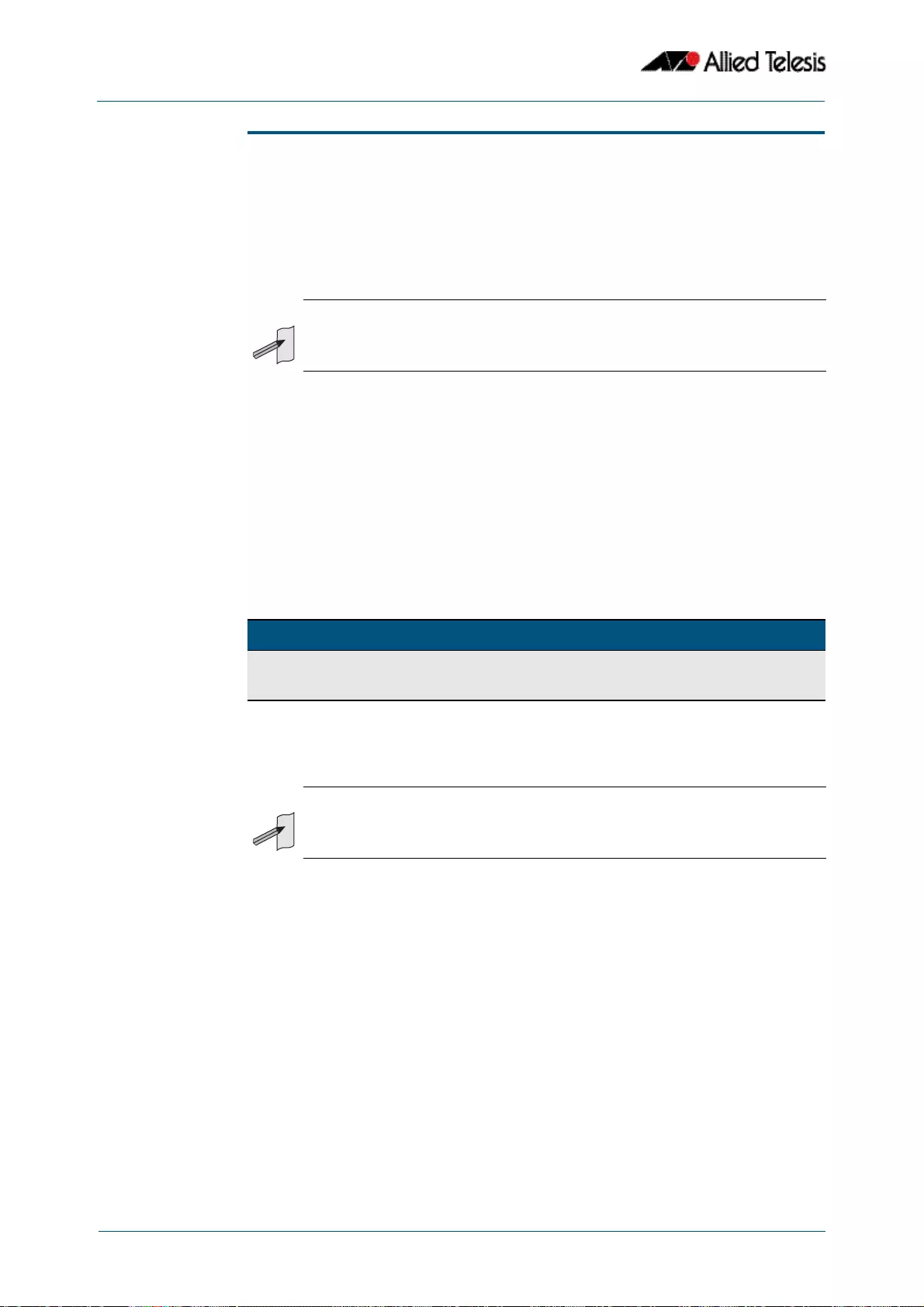
Power over Ethernet Commands
Software Reference for GS900MX/MPX Series Switches
23.8 AlliedWare PlusTM Operating System - Version 5.4.4E-1.x C613-50065-01 REV B
power-inline max
This command sets the “maximum” power allocated to a Power over an Ethernet (PoE and
PoE+) port. The amount of power actually supplied to the port depends on the power
requirements of the connected PD. It is also a function of the total PoE power loading on
the switch and the PoE priority set for the port by the power-inline priority command.
However this command (power-inline max) does apply a “maximum” value to the power
that the port is able to supply.
Note that the value set by this command will be the figure the switch will use when
apportioning the power budget for its ports. For example, if 15.4 W is assigned to a port
whose PD only consumes 5 W, the switch will reserve the full 15.4 W for this port when
determining its total power PoE power requirement.
The no variant of this command sets the maximum power supplied to a PoE port to the
default, which is set to the maximum power limit for the class of the connected Powered
Device (PD).
Syntax power-inline max <4000-30000>
no power-inline max
Default The Power Sourcing Equipment (PSE) supplies the maximum power limit for the class of
the PD connected to the port by default.
Mode Interface Configuration
Usage In a stack of switches this command is supported on all PoE capable ports.
Select a PoE port, a list of PoE ports, or a range of PoE ports with the preceding interface
(to configure) command. If you specify a range or list of ports they must all be PoE
capable ports.
If you select a range of PoE ports in Interface Configuration mode before issuing this
command, then each port in the range selected will have the same maximum power value
configured. If the PoE port attempts to draw more than the maximum power, this is
logged and all power is removed. Note that the value entered is rounded up to the next
value supported by the hardware.
Note Note that the value set by this command will be the figure the switch will use
when apportioning the power budget for its ports. For example, if 15.4 W is
assigned to a port whose PD only consumes 5 W, the switch will reserve the full
15.4 W for this port when determining its total power PoE power requirement.
Parameter Description
<4000-30000>The maximum power allocated to a PoE port in milliwatts
(mW).
Note Power limits for all classes of PDs are listed in “Power Classes” on page 22.6.
See Chapter 22, Power over Ethernet Introduction for further PoE
information.

Power over Ethernet Commands
Software Reference for GS900MX/MPX Series Switches
C613-50065-01 REV B AlliedWare PlusTM Operating System - Version 5.4.4E-1.x 23.9
See the actual value used, as shown after command entry, in the sample console output
below:
Refer to Chapter 69, LLDP, LLDP-MED and Voice VLAN Introduction and
Configuration and Chapter 70, LLDP Commands for information about power
monitoring at the PD.
Note the difference in power supplied from the PSE to the power available at the PD due
to line loss.
The “Power Classes” on page 22.6 shows the difference between the power supplied
from the PSE and the power available at the PD.
Examples To set the maximum power supplied to ports in the range 1.0.2 to 1.0.4 to
6450mW per port, use the following commands:
To set the maximum power supplied to port1.0.2, to 6450 mW, use the following
commands:
To clear the user-configured maximum power supplied to port1.0.2, and revert to
using the default maximum power of 30000 mW, use the following commands:
Validation
Commands
show power-inline interface
show running-config power-inline
awplus#configure terminal
awplus(config)#interface port1.0.1
awplus(config-if)#power-line max 5300
% The maximum power has been rounded to 5450mW in hardware.
awplus# configure terminal
awplus(config)# interface port1.0.2-port1.0.4
awplus(config-if)# power-inline max 6450
awplus# configure terminal
awplus(config)# interface port1.0.2
awplus(config-if)# power-inline max 6450
awplus# configure terminal
awplus(config)# interface port1.0.2
awplus(config-if)# no power-inline max

Power over Ethernet Commands
Software Reference for GS900MX/MPX Series Switches
23.10 AlliedWare PlusTM Operating System - Version 5.4.4E-1.x C613-50065-01 REV B
power-inline priority
This command sets the Power over Ethernet (PoE) priority level of a PoE port to one of
three available priority levels:
■low
■high
■critical
The no variant of this command restores the PoE port priority to the default (low).
Syntax power-inline priority {low|high|critical}
no power-inline priority
Default The default priority is low for all PoE ports on the Power Sourcing Equipment (PSE).
Mode Interface Configuration
Usage This command is supported on all PoE capable ports, whether operating as a stand-alone
switch, or within a VCStack.
Select a PoE port, a list of PoE ports, or a range of PoE ports with the preceding interface
(to configure) command. If you specify a range or list of ports they must all be PoE
capable ports.
PoE ports with higher priorities are given power before PoE ports with lower priorities. If
the priorities for two PoE ports are the same then the lower numbered PoE port is given
power before the higher numbered PoE port.
See “Port Prioritization” on page 22.10 for further information about PoE priority.
Parameter Description
low The lowest priority for a PoE enabled port (default). PoE ports
set to low only receive power if all the PoE ports assigned to
the other two levels are already receiving power.
high The second highest priority for a PoE enabled port. PoE ports
set to high receive power only if all the ports set to
critical are already receiving power.
critical The highest priority for a PoE enabled port. PoE ports set to
critical are guaranteed power before any ports assigned
to the other two priority levels. Ports assigned to the other
priority levels receive power only if all Critical ports are
receiving power.

Power over Ethernet Commands
Software Reference for GS900MX/MPX Series Switches
C613-50065-01 REV B AlliedWare PlusTM Operating System - Version 5.4.4E-1.x 23.11
Examples To set the priority level to high for port1.0.2, use the following commands:
To reset the priority level to the default for port1.0.2, use the following commands:
Validation
Commands
show power-inline
show power-inline interface
show running-config power-inline
Related Commands power-inline usage-threshold
awplus# configure terminal
awplus(config)# interface port1.0.2
awplus(config-if)# power-inline priority high
awplus# configure terminal
awplus(config)# interface port1.0.2
awplus(config-if)# no power-inline priority

Power over Ethernet Commands
Software Reference for GS900MX/MPX Series Switches
23.12 AlliedWare PlusTM Operating System - Version 5.4.4E-1.x C613-50065-01 REV B
power-inline usage-threshold
This command sets the level at which the Power Sourcing Equipment (PSE) will issue a
message that the power supplied to all Powered Devices (PDs) has reached a critical level
of the nominal power rating for the PSE. The level is set as a percentage of total available
power.
The no variant of this command resets the notification usage-threshold to the default
(80% of the nominal power rating of the PSE).
Syntax power-inline usage-threshold <1-99>
no power-inline usage-threshold
Default The default power usage threshold is 80% of the nominal power rating of the PSE.
Mode Global Configuration
Usage Use the snmp-server enable trap command on page 67.18 to configure SNMP
notification. An SNMP notification is sent when the usage-threshold, as configured in the
example, is exceeded.
Examples To generate SNMP notifications when power supplied exceeds 70% of the nominal PSE
power, use the following commands:
To reset the notification threshold to the default (80% of the nominal PSE power rating),
use the following commands:
Validation
Commands
show power-inline interface
show running-config power-inline
Related Commands snmp-server enable trap
Parameter Description
<1-99>The usage-threshold percentage configured with this
command.
awplus# configure terminal
awplus(config)# snmp-server enable trap power-inline
awplus(config)# power-inline usage-threshold 70
awplus# configure terminal
awplus(config)# no power-inline usage-threshold

Power over Ethernet Commands
Software Reference for GS900MX/MPX Series Switches
C613-50065-01 REV B AlliedWare PlusTM Operating System - Version 5.4.4E-1.x 23.13
service power-inline
This command enables Power over Ethernet (PoE) globally on the Power Sourcing
Equipment (PSE) for all PoE ports.
Syntax service power-inline
no service power-inline
Default PoE functionality is enabled by default on the PSE.
Mode Global Configuration
Usage In a stack, issuing this command enables PoE globally for all PoE ports.
In a stack configuration, only stack members containing PoE hardware will have PoE
enabled by default in software.
Examples To disable PoE on the PSE, use the following commands:
To re-enable PoE on the PSE, if PoE has been disabled, use the following commands:
Validation
Commands
show power-inline
show running-config power-inline
awplus# configure terminal
awplus(config)# no service power-inline
awplus# configure terminal
awplus(config)# service power-inline

Power over Ethernet Commands
Software Reference for GS900MX/MPX Series Switches
23.14 AlliedWare PlusTM Operating System - Version 5.4.4E-1.x C613-50065-01 REV B
show debugging power-inline
This command displays Power over Ethernet (PoE) debug settings.
For information on output options, see “Controlling “show” Command Output” on
page 1.35.
Syntax show debugging power-inline
Mode User Exec and Privileged Exec
Example To display PoE debug settings, use the following command:
Output Figure 23-1: Example output from the show debugging power-inline command
Related Commands debug power-inline
terminal monitor
awplus# show debugging power-inline
awplus#show debugging power-inline
PoE Debugging status:
PoE Informational debugging is disabled
PoE Event debugging is disabled
PoE Power Management debugging is disabled
PoE NSM debugging is enabled

Power over Ethernet Commands
Software Reference for GS900MX/MPX Series Switches
C613-50065-01 REV B AlliedWare PlusTM Operating System - Version 5.4.4E-1.x 23.15
show power-inline
This command displays the Power over Ethernet (PoE) status for all ports on the Power
Sourcing Equipment (PSE).
For information on output options, see “Controlling “show” Command Output” on
page 1.35.
Syntax show power-inline
Mode User Exec and Privileged Exec
Example To display the PoE status for all ports on the PSE, use the following command:
Output Figure 23-2: Example output from the show power-inline command
awplus# show power-inline
awplus#show power-inline
PoE Status:
Stack Member 2
Nominal Power: 370W
Power Allocated: 246W
Actual Power Consumption: 151W
Operational Status: On
Power Usage Threshold: 80% (296W)
PoE Interface:
Interface Admin Pri Oper Power Device Class Max(mW)
port2.0.1 Enabled Low Powered 3840 n/a 1 4000 [C]
port2.0.2 Enabled High Powered 6720 n/a 2 7000 [C]
port2.0.3 Enabled Low Powered 14784 n/a 3 15400 [C]
port2.0.4 Enabled Crit Powered 14784 n/a 3 15400 [C]
port2.0.5 Enabled Crit Powered 3840 n/a 1 4000 [C]
port2.0.6 Enabled High Powered 6720 n/a 2 7000 [C]
port2.0.7 Enabled Low Powered 14784 n/a 3 15400 [C]

Power over Ethernet Commands
Software Reference for GS900MX/MPX Series Switches
23.16 AlliedWare PlusTM Operating System - Version 5.4.4E-1.x C613-50065-01 REV B
Table 23-1: Parameters in the show power-inline command output
Parameter Description
Nominal Power The nominal power available on the switch in watts (W).
Power Allocated The current power allocated in watts (W) that is available to
be drawn by any connected Powered Devices (PDs). This is
updated every 5 seconds.
Actual Power
Consumption The current power consumption in watts (W) drawn by all
connected Powered Devices (PDs). This is updated every 5
seconds.
Operational
Status
The operational status of the PSU hardware on the PSE
when this command was issued:
■On if the PSU as installed inside the PSE is switched on.
■Off when the PSU in the PSE is switched off (an RPS may
be connected to the PSE to power PoE instead of the
PSU).
■Fault when there is an issue with the PSE PSU hardware.
Power Usage
Threshold (%) The configured SNMP trap / log threshold for the PSE, as
configured from a power-inline usage-threshold
command.
Interface The PoE port(s) in the format portx.y.z, where x is the
device number, y is the module number within the device,
and z is the PoE port number within the module.
Admin The administrative state of PoE on a PoE port, either
Enabled or Disabled.
Pri The current PoE priorities for PoE ports on the PSE, as
configured from a power-inline priority command:
■Low displays when the low parameter is issued. The
lowest priority for a PoE enabled port (default).
■High displays when the high parameter is issued. The
second highest priority for a PoE enabled port.
■Crit displays when the critical parameter is issued.
The highest priority for a PoE enabled port.
Oper The current PSE PoE port state when this command was
issued:
■Powered displays when there is a PD connected and
power is being supplied from the PSE.
■Disabled displays when supplying power would make the
PSE go over the power budget.
■Off displays when PoE has been disabled for the PoE port.
Fault displays when a PSE goes over its power allocation.
Power The power consumption in milliwatts (mW) for the PoE port
when this command was entered.
Device The description of the connected PD device if a description
has been added with the power-inline description
command. No description is shown for PDs not configured
with the power-inline description command.

Power over Ethernet Commands
Software Reference for GS900MX/MPX Series Switches
C613-50065-01 REV B AlliedWare PlusTM Operating System - Version 5.4.4E-1.x 23.17
Related Commands show power-inline counters
show power-inline interface
Class The class of the connected PD, if power is being supplied to
the PD from the PSE. See the Power over Ethernet
Introduction chapter for further information about PD
classes and the power levels assigned per class.
Max (mW) The power in milliwatts (mW) allocated for the PoE port.
Additionally, note the following as displayed per PoE port:
■[U] if the power limit for a port was user configured (with
the power-inline max command).
■[L] if the power limit for a port was supplied by LLDP.
■[C] if the power limit for a port was supplied by the PD
class.
Table 23-1: Parameters in the show power-inline command output (cont.)
Parameter Description

Power over Ethernet Commands
Software Reference for GS900MX/MPX Series Switches
23.18 AlliedWare PlusTM Operating System - Version 5.4.4E-1.x C613-50065-01 REV B
show power-inline counters
This command displays Power over Ethernet (PoE) event counters for ports on the Power
Sourcing Equipment (PSE). The PoE event counters displayed can also be accessed by
objects in the PoE MIB (RFC 3621). See Chapter 68, SNMP MIBs for information about
which PoE MIB objects are supported.
For information on output options, see “Controlling “show” Command Output” on
page 1.35.
Syntax show power-inline counters [<port-list>]
Mode User Exec and Privileged Exec
Usage To display all PoE event counters for all PoE ports on the PSE, do not enter the optional
interface parameter.
Examples To display all PoE event counters for all PoE ports on the PSE, use the command:
To display the PoE event counters for the port range 1.0.1 to 1.0.3, use the command:
Output Figure 23-3: Example output from the show power-inline counters command
Parameter Description
<port-list> Enter the PoE port(s) to display all PoE event counters for them.
awplus# show power-inline counters
awplus# show power-inline counters interface port1.0.1-1.0.3
awplus#show power-inline counters interface port1.0.4-port1.0.12
PoE Counters:
Interface MPSAbsent Overload Short Invalid Denied
port1.0.4 0 0 0 0 0
port1.0.5 0 0 0 0 0
port1.0.6 0 0 0 0 0
port1.0.7 0 0 0 0 0
port1.0.8 0 0 0 0 0
port1.0.9 0 0 0 0 0
port1.0.10 0 0 0 0 0
port1.0.11 0 0 0 0 0
port1.0.12 0 0 0 0 0

Power over Ethernet Commands
Software Reference for GS900MX/MPX Series Switches
C613-50065-01 REV B AlliedWare PlusTM Operating System - Version 5.4.4E-1.x 23.19
Table 23-2: Parameters in the show power-inline counters command output
Related Commands clear power-inline counters interface
show power-inline
show power-inline interface
Parameter Description
Interface The PoE port(s) in the format portx.y.z, where x is the device
number, y is the module number within the device, and z is the
PoE port number within the module.
MPSAbsent The number of instances when the PoE MPS (Maintain Power
Signature) signal has been lost. The PoE MPS signal is lost when a
PD is disconnected from the PSE. Also increments
pethPsePortMPSAbsentCounter in the PoE MIB.
Overload The number of instances when a PD exceeds its configured power
limit (as configured by the power-inline max command). Also
increments pethPsePortOverLoadCounter in the PoE MIB.
Short The number of short circuits that have happened with a PD. Also
increments pethPsePortShortCounter in the PoE MIB.
Invalid The number of times a PD with an Invalid Signature (where the PD
has an open or short circuit, or is a legacy PD) is detected. Also
increments pethPseInvalidSignatureCounter in the PoE
MIB.
Denied The number of times a PD has been refused power due to power
budget limitations for the PSE. Also increments
pethPsePortPowerDeniedCounter in the PoE MIB.

Power over Ethernet Commands
Software Reference for GS900MX/MPX Series Switches
23.20 AlliedWare PlusTM Operating System - Version 5.4.4E-1.x C613-50065-01 REV B
show power-inline interface
This command displays a summary of Power over Ethernet (PoE) information for specified
ports. If no ports are specified then PoE information is displayed for all ports on the Power
Sourcing Equipment (PSE).
For information on output options, see “Controlling “show” Command Output” on
page 1.35.
Syntax show power-inline interface [<port-list>]
Mode User Exec and Privileged Exec
Usage To display PoE information for all PoE ports on the PSE, do not specify any ports.
Example To display the PoE port specific information for all PoE ports on the switch, use the
following command:
To display the PoE port specific information for the port range 1.0.1 to 1.0.4, use the
following command:
Output Figure 23-4: Example output from the show power-inline interface command
Parameter Description
<port-list> Enter the PoE port(s) to display PoE specific information in the show
output.
awplus# show power-inline interface
awplus# show power-inline interface port1.0.1-port1.0.4
awplus#show power-inline interface port1.0.1-port1.0.4
Interface Admin Pri Oper Power Device Class Max(mW)
port1.0.1 Disabled Low Disabled 0 n/a n/a n/a
port1.0.2 Enabled High Powered 3840 Desk Phone 1 5000 [U]
port1.0.3 Enabled Crit Powered 6720 AccessPoint 2 7000 [C]
port1.0.4 Disabled Low Disabled 0 n/a n/a n/a

Power over Ethernet Commands
Software Reference for GS900MX/MPX Series Switches
C613-50065-01 REV B AlliedWare PlusTM Operating System - Version 5.4.4E-1.x 23.21
Related Commands show power-inline
show power-inline interface detail
Table 23-3: Parameters in the show power-inline interface command output
Parameter Description
Interface The PoE port(s) in the format portx.y.z, where x is the device
number, y is the module number within the device, and z is the
PoE port number within the module.
Admin The administrative state of PoE on a PoE port, either Enabled or
Disabled.
Pri The current PoE priorities for PoE ports on the PSE, as configured
from a power-inline priority command:
■Low displays when the low parameter is issued. The lowest
priority for a PoE enabled port (default).
■High displays when the high parameter is issued. The
second highest priority for a PoE enabled port.
■Crit displays when the critical parameter is issued. The
highest priority for a PoE enabled port.
Oper The current PSE PoE port state when this command was issued:
■Powered displays when there is a PD connected and power is
being supplied from the PSE.
■Denied displays when supplying power would make the PSE
go over the power budget.
■Disabled displays when the PoE port is administratively
disabled.
■Off displays when PoE has been disabled for the port.
■Fault displays when a PSE goes over its power allocation.
Power The power consumption in milliwatts (mW) for the PoE port
when this command was entered.
Device The description of the connected PD device if a description has
been added with the power-inline description command. No
description is shown for PDs not configured with the power-
inline description command.
Class The class of the connected PD, if power is being supplied to the
PD from the PSE.
See “Power Classes” on page 22.6 in Chapter 22, Power over
Ethernet Introduction for further information about PD classes
and the power assigned per class.
Max (mW) The power in milliwatts (mW) allocated for the PoE port.
Additionally, note the following as displayed per PoE port:
■[U] if the power limit for a port was user configured (with the
power-inline max command).
■[L] if the power limit for a port was supplied by LLDP.
■[C] if the power limit for a port was supplied by the PD class.

Power over Ethernet Commands
Software Reference for GS900MX/MPX Series Switches
23.22 AlliedWare PlusTM Operating System - Version 5.4.4E-1.x C613-50065-01 REV B
show power-inline interface detail
This command displays detailed information for specified Power over Ethernet (PoE)
port(s) on the Power Sourcing Equipment (PSE).
For information on output options, see “Controlling “show” Command Output” on
page 1.35.
Syntax show power-inline interface [<port-list>] detail
Mode User Exec and Privileged Exec
Usage To show detailed PoE information for all ports on the PSE, do not specify any ports.
The power allocated to each port is listed in the Power allocated row, and is limited
by the maximum power per Powered Device (PD) class, or a user configured power limit.
Example To display detailed PoE port specific information for the port range 1.0.1 to 1.0.2, use
the following command:
Output Figure 23-5: Example output from the show power-inline interface detail command
Parameter Description
<port-list> Enter the PoE port(s) to display the PoE port specific information.
awplus# show power-inline interface port1.0.1-port1.0.2
detail
awplus#show power-inline interface port1.0.1-1.0.2 detail
Interface port1.0.1
Powered device type: Desk Phone #1
PoE admin enabled
Priority Low
Detection status: Powered
Current power consumption: 4800 mW
Powered device class: 1
Power allocated: 5000 mW (from configuration)
Detection of legacy devices is disabled
Powered pairs: Data
Interface port1.0.2
Powered device type: Access Point #3
PoE admin enabled
Priority High
Detection status: Powered
Current power consumption: 6720 mW
Powered device class: 2
Power allocated: 7000 mW (from powered device class)
Detection of legacy devices is enabled
Powered pairs: Data

Power over Ethernet Commands
Software Reference for GS900MX/MPX Series Switches
C613-50065-01 REV B AlliedWare PlusTM Operating System - Version 5.4.4E-1.x 23.23
Table 23-4: Parameters in show power-inline interface detail command output
Related Commands show power-inline
show power-inline interface
Parameter Description
Interface The PoE port(s) in the format portx.y.z, where x is the device
number, y is the module number within the device, and z is the
PoE port number within the module.
Powered device
type:
The name of the PD, if connected and if power is being supplied
to the PD from the PSE, configured with the power-inline
description command. n/a displays if a description has not been
configured for the PD.
PoE admin The administrative state of PoE on a PoE capable port, either
Enabled or Disabled as configured from the power-inline
enable command or the no power-inline enable command
respectively.
Priority The PoE priority of a port, which is either Low, or High, or Critical,
as configured by the power-inline priority command.
Detection
status:
The current PSE PoE port state when this command was issued:
■Powered displays when there is a PD connected and power is
being supplied from the PSE.
■Denied displays when supplying power would make the PSE
go over the power budget.
■Disabled displays when the PoE port is administratively
disabled.
■Off displays when PoE has been disabled for the port.
■Fault displays when a PSE goes over its power allocation.
Current power
consumption:
The power consumption for the PoE port when this command
was entered. Note that the power consumption may have
changed since the command was entered and the power is
displayed.
Powered device
class:
The class of the connected PD if connected, and if power is being
supplied to the PD from the PSE.
See Chapter 22, Power over Ethernet Introduction chapter for
further information about PD classes and the power assigned per
class.
Power
allocated:
The power in milliwatts (mW) allocated for the PoE port.
Additionally, note the following as displayed per PoE port:
■[U] if the power limit for a port was user configured (with the
power-inline max command).
■[L] if the power limit for a port was supplied by LLDP.
■[C] if the power limit for a port was supplied by the PD class.
Detection of
legacy devices
is
[Enabled|Disabled]
The status of legacy PoE detection on the PoE port, as configured
for the PoE port with the power-inline allow-legacy command.
Powered pairs: [Data|Spare]
The IEEE 802.3af and IEEE 802.3at standards allow for either data
or spare twisted pairs to be used to transfer power to a PD.
The powered pairs status for each port. AlliedWare PlusTM PoE
switches implement IEEE 802.3af and IEEE 802.3at Endpoint PSE
Alternative A (Data).

Power over Ethernet Commands
Software Reference for GS900MX/MPX Series Switches
23.24 AlliedWare PlusTM Operating System - Version 5.4.4E-1.x C613-50065-01 REV B


Software Reference for GS900MX/MPX Series Switches
C613-50065-01 REV B AlliedWare PlusTM Operating System - Version 5.4.4E-1.x 24.1
Chapter 24: Internet Protocol (IP) Addressing
and Protocols
Introduction ........................................................................................................................................ 24.2
Address Resolution Protocol (ARP)............................................................................................. 24.3
Static ARP Entries ....................................................................................................................... 24.3
Timing Out ARP Entries............................................................................................................ 24.3
Deleting ARP Entries................................................................................................................. 24.4
ARP Logging ................................................................................................................................ 24.5
DNS Client............................................................................................................................................ 24.6
Internet Control Message Protocol (ICMP) .............................................................................. 24.8
Checking IP Connections ............................................................................................................... 24.9
Ping ................................................................................................................................................. 24.9
Traceroute .................................................................................................................................... 24.9

Internet Protocol (IP) Addressing and Protocols
Software Reference for GS900MX/MPX Series Switches
24.2 AlliedWare PlusTM Operating System - Version 5.4.4E-1.x C613-50065-01 REV B
Introduction
This chapter describes how to configure IPv4 addressing and the protocols used to help IP
function on your network.
As well as the familiar Internet (with uppercase “I”), the term internet (with lowercase “i”)
can refer to any network (usually a wide area network) that uses the Internet Protocol. This
chapter concentrates on this definition—a generalized network that uses IP as its network
protocol.
Assigning an IP
Address
To configure your device to perform IP routing (for example, to access the Internet) you
need to configure IP. You also need to configure IP if you want to manage your device from
any IP-based management process (such as SSH, Telnet, or SNMP).
Add an IP address to each of the interfaces that you want to process IP traffic.
You can configure an interface on your device with a static IP address, or with a dynamic IP
address assigned using your device’s DHCP client.
Static IP addresses To add a static IP address to an interface, enter interface mode for the interface that you
want to configure, then use the command:
where <ip-address/m> the IP address followed by a slash then the prefix length. Note
that you cannot specify the mask in dotted decimal notation in this command.
For example, to give the interface vlan1 an address of 192.168.10.10, with a class C subnet
mask, use the command:
The secondary parameter allows you to add multiple IP addresses to an interface using
this command. Each interface must have a primary IP address before you can add a
secondary address. Your device treats secondary addresses the same as primary addresses
in most instances, such as responding for ARP requests for the IP address. However, the
only packets generated that have a secondary address as source address are routing
updates. You can define up to 32 secondary addresses on a single interface.
DHCP dynamic
addresses
When you use the DHCP client, it obtains the IP address and subnet mask for the interface,
and other IP configuration parameters, from a DHCP server. To configure an interface to
gain its IP configuration using the DHCP client, use the command:
If an IP interface is configured to get its IP address and subnet mask from DHCP, the
interface does not take part in IP routing until the IP address and subnet mask have been
set by DHCP.
If you need to make a static entry in your DHCP server for the device, you need your
device's MAC address, which you can display by using the command:
See Chapter 64, Dynamic Host Configuration Protocol (DHCP) Introduction for more
information about DHCP.
awplus(config-if)# ip address <ip-addr/prefix-length>
[secondary] [label <label>]
awplus(config-if)# ip address 192.168.10.10/24
awplus(config-if)# ip address dhcp [client-id <interface>]
[hostname <hostname>]
awplus# show interface

Internet Protocol (IP) Addressing and Protocols
Software Reference for GS900MX/MPX Series Switches
C613-50065-01 REV B AlliedWare PlusTM Operating System - Version 5.4.4E-1.x 24.3
Address Resolution Protocol (ARP)
Address Resolution Protocol (ARP) is used by your device to dynamically learn the Layer 2
address of devices in its networks. Most hosts also have a MAC physical address in addition
to the assigned IP address. For Ethernet, this is a 6-byte, globally unique number. ARP
enables your device to learn the physical address of the host that has a given IP address.
When your device needs to forward packets to a destination that it does not know the
Layer 2 address of, it broadcasts an ARP request to determine where to send the packet.
The ARP request is a broadcast packet and includes the target IP address. All stations on
the LAN receive this broadcast but only one host recognizes its own IP address. It replies,
thereby giving your device its physical address.
Your device creates a dynamic ARP entry in its ARP cache, to record the IP address to
physical address mapping (also called a binding). It uses that ARP entry to forward further
packets to that address.
The ARP protocol is described in RFC 826, An Ethernet Address Resolution Protocol—
or—Converting Network Protocol Addresses to 48 bit Ethernet Address for
Transmission on Ethernet Hardware.
Static ARP Entries
If your LAN includes hosts that do not support ARP, you can add a static ARP entry to the
cache. However, it is rarely necessary to add an ARP entry this way. To add a static ARP
entry, use the command:
Timing Out ARP Entries
Your device times out dynamic ARP entries to ensure that the cache does not fill with
entries for hosts that are no longer active. If your device stops receiving traffic for a device
specified in a dynamic ARP entry, it deletes the ARP entry after a configurable timeout
period. Static ARP entries are not aged or automatically deleted.
Increasing the ARP timeout reduces the amount of network traffic. Decreasing the
timeout makes your device more responsive to changes in network topology.
To set a timeout period, enter the interface mode, then use the command:
awplus(config)# arp <ip-addr> <mac-address> [<port-number>]
[alias]
awplus(config-if)# arp-aging-timeout <0-432000>

Internet Protocol (IP) Addressing and Protocols
Software Reference for GS900MX/MPX Series Switches
24.4 AlliedWare PlusTM Operating System - Version 5.4.4E-1.x C613-50065-01 REV B
Deleting ARP Entries
To remove a static ARP entry, use the command:
To clear the ARP cache of dynamic entries, use the command:
This removes the dynamic ARP entries for all interfaces.
To display the entries in the ARP cache, use the command:
The ARP cache will be repopulated by the normal ARP learning mechanism. As long as the
entries are relearned quickly enough, deleting dynamic ARP entries does not affect:
■routes
■the TCP/UDP connection status
awplus(config)# no arp <ip-addr>
awplus# clear arp-cache
awplus)# show arp

Internet Protocol (IP) Addressing and Protocols
Software Reference for GS900MX/MPX Series Switches
C613-50065-01 REV B AlliedWare PlusTM Operating System - Version 5.4.4E-1.x 24.5
ARP Logging
You can enable your device to log static and dynamic ARP entries, and you can select
either default hexadecimal notation (HHHH.HHHH.HHHH) or standard IEEE format
hexadecimal notation (HH-HH-HH-HH-HH-HH) for the MAC addresses displayed in the ARP
log output.
If this feature is enabled, ARP log messages are stored on the device in RAM. If the device is
rebooted the ARP log messages are lost. ARP logging is disabled by default.
To enable ARP logging, use the command:
You can specify whether the MAC address is displayed in the default hexadecimal notation
HHHH.HHHH.HHHH or in the standard IEEE format HH-HH-HH-HH-HH-HH.
To disable ARP logging, use the command:
To display the ARP log messages, use the command:
See the sample ARP log output and descriptions of the fields displayed in the sample ARP
log output in the arp log command on page 25.6.
awplus(config)# arp log [mac-address-format ieee]
awplus(config)# no arp log [mac-address-format ieee]
awplus(config)# show log | include ARP_LOG

Internet Protocol (IP) Addressing and Protocols
Software Reference for GS900MX/MPX Series Switches
24.6 AlliedWare PlusTM Operating System - Version 5.4.4E-1.x C613-50065-01 REV B
DNS Client
Your AlliedWare PlusTM device has a DNS Client that is enabled automatically when you
add a DNS server to your device. This client allows you to use domain names instead of IP
addresses when using commands on your device.
To add a DNS server to the list of servers that the device sends DNS queries to, use the
command:
To check the list of servers that the device sends DNS queries to, use the command:
To add a default domain name used to append to DNS requests, use the command:
For example, to use DNS to match hostnames to your internal network “example.net”, use
the command:
If you then use the command ping host2, your device sends a DNS request for
host2.example.net. To check the domain name configured with this command, use the
command:
Alternatively you can create a list of domain names that your device will try in turn by
using the command:
For example, to use DNS to match incomplete hostnames to the top level domains “.com”,
and “.net”, use the commands:
If you then use the command ping alliedtelesis, your device sends a DNS request for
alliedtelesis.com and if no match was found your device would then try alliedtelesis.net.
To check the entries in the domain list, use the command:
To disable the DNS client on your device, use the command:
awplus(config)# ip name-server <ip-addr>
awplus# show ip name-server
awplus(config)# ip domain-name <domain-name>
awplus(config)# ip domain-name example.net
awplus# show ip domain-name
awplus(config)# ip domain-list <domain-name>
awplus(config)# ip domain-list .com
awplus(config)# ip domain-list .net
awplus# show ip domain-list
awplus(config)# no ip domain-lookup

Internet Protocol (IP) Addressing and Protocols
Software Reference for GS900MX/MPX Series Switches
C613-50065-01 REV B AlliedWare PlusTM Operating System - Version 5.4.4E-1.x 24.7
To check the status of the DNS Client on your device, and the configured servers and
domain names, use the command:
awplus# show hosts

Internet Protocol (IP) Addressing and Protocols
Software Reference for GS900MX/MPX Series Switches
24.8 AlliedWare PlusTM Operating System - Version 5.4.4E-1.x C613-50065-01 REV B
Internet Control Message Protocol (ICMP)
The Internet Control Message Protocol (ICMP) allows networking devices to send
information and control messages to other devices or hosts. Your device implements all
non-obsolete ICMP functions.
The following table lists the ICMP messages implemented by your device.
ICMP messages are enabled on all interfaces by default. You can control the flow of ICMP
messages across different interfaces using the access-list commands. See Chapter 37,
IPv4 Hardware Access Control List (ACL) Commands and Chapter 38, IPv4 Software
Access Control List (ACL) Commands.
ICMP Message Type Device Response
Echo reply (0) This is used to implement the ping command. Your
device sends out an echo reply in response to an echo
request.
Destination unreachable (3) This message is sent when your device drops a packet
because it did not have a route to the destination.
Redirect (5) Your device issues this message to inform a local host that
its target is located on the same LAN (no routing is
required) or when it detects a host using a non-optimal
route (usually because a link has failed or changed its
status).
For example, if your device receives a packet destined to
its own MAC address, but with a destination IP address of
another host in the local subnet, it returns an ICMP
redirect to the originating host.
ICMP redirects are disabled on interfaces on which local
proxy ARP is enabled.
Echo request (8) This is related to echo replies. If your device receives an
echo request, it sends an echo reply. If you enter the ping
command, your device generates echo requests.
Router Advertisements (10) These are Router Discovery Protocol messages. If Router
Discovery is enabled, your device sends these to
announce the IP addresses of the sending interface.
Time to Live Exceeded (11) If the TTL field in a packet falls to zero, your device sends
this message.This occurs when there are too many hops
in the path that a packet is traversing.

Internet Protocol (IP) Addressing and Protocols
Software Reference for GS900MX/MPX Series Switches
C613-50065-01 REV B AlliedWare PlusTM Operating System - Version 5.4.4E-1.x 24.9
Checking IP Connections
To verify connections between networks and network devices, use the ping (Packet
Internet Groper) and trace route functions on your device.
Ping
Ping tests the connectivity between two network devices to determine whether each
network device can “see” the other device. Echo request packets are sent to the
destination addresses and responses are displayed on the console.
If you can ping the end destination, then the physical, Layer 2 and Layer 3 links are
functioning, and any difficulties are in the network or higher layers.
If pinging the end destination fails, use traceroute to discover the point of failure in the
route to the destination.
To ping a device, use the command:
Traceroute
You can use traceroute to discover the route that packets pass between two systems
running the IP protocol. Traceroute sends an initial UDP packets with the Time To Live
(TTL) field in the IP header set starting at 1. The TTL field is increased by one for every
subsequent packet sent until the destination is reached. Each hop along the path
between two systems responds with a TTL exceeded packet (ICMP type 11) and from this
the path is determined.
To use traceroute, use the command:
Enter either the hostname or the IP address of the device you are trying to reach.
awplus# ping {<hostname>|<ipaddr>}
awplus# traceroute {<ip-addr>|<hostname>}

Internet Protocol (IP) Addressing and Protocols
Software Reference for GS900MX/MPX Series Switches
24.10 AlliedWare PlusTM Operating System - Version 5.4.4E-1.x C613-50065-01 REV B

Software Reference for GS900MX/MPX Series Switches
C613-50065-01 REV B AlliedWare PlusTM Operating System - Version 5.4.4E-1.x 25.1
Chapter 25: IP Addressing and Protocol
Commands
Introduction ........................................................................................................................................ 25.2
Command List .................................................................................................................................... 25.3
arp-mac-disparity.............................................................................................................................. 25.3
arp-aging-timeout ............................................................................................................................ 25.4
arp (IP address MAC) ........................................................................................................................ 25.5
arp log ................................................................................................................................................... 25.6
clear arp-cache................................................................................................................................... 25.9
debug ip packet interface.............................................................................................................. 25.9
ip address...........................................................................................................................................25.11
ip domain-list....................................................................................................................................25.13
ip domain-lookup ...........................................................................................................................25.14
ip domain-name..............................................................................................................................25.15
ip gratuitous-arp-link.....................................................................................................................25.16
ip name-server .................................................................................................................................25.17
ping ......................................................................................................................................................25.18
show arp.............................................................................................................................................25.19
show debugging ip packet..........................................................................................................25.20
show hosts.........................................................................................................................................25.21
show ip domain-list........................................................................................................................25.21
show ip domain-name ..................................................................................................................25.22
show ip interface.............................................................................................................................25.23
show ip name-server......................................................................................................................25.24
show ip sockets................................................................................................................................25.25
tcpdump.............................................................................................................................................25.27
traceroute ..........................................................................................................................................25.28

IP Addressing and Protocol Commands
Software Reference for GS900MX/MPX Series Switches
25.2 AlliedWare PlusTM Operating System - Version 5.4.4E-1.x C613-50065-01 REV B
Introduction
This chapter provides an alphabetical reference of commands used to configure the
following protocols:
■Address Resolution Protocol (ARP)
■Domain Name Service (DNS)
For more information see Chapter 24, Internet Protocol (IP) Addressing and Protocols.

IP Addressing and Protocol Commands
Software Reference for GS900MX/MPX Series Switches
C613-50065-01 REV B AlliedWare PlusTM Operating System - Version 5.4.4E-1.x 25.3
Command List
arp-mac-disparity
Use this command in Interface Configuration mode for a VLAN interface to enable the
reception of ARP packets that contain a multicast MAC address in the sender field.
By default, ARP packets that contain a multicast MAC address in the sender field are
dropped. The no variant of this command reverts to the default behavior.
Syntax arp-mac-disparity
no arp-mac-disparity
Default ARP disparity is disabled. ARP packets with a multicast MAC address in the sender field are
dropped.
Mode Interface Configuration for a VLAN interface.
Usage Normally, it is invalid for an ARP request to resolve a multicast MAC address. By default,
ARP replies with a multicast MAC addresses are not learned. This command allows control
over the learning of dynamic ARPs that resolve to a multicast MAC address.
ARP-MAC disparity may need to be enabled to support multicast network load balancing.
The arp-mac-disparity command allows ARP replies quoting multicast MAC addresses to
be accepted and learned. No no arp-mac-disparity command reverts to default behavior.
If the ARP-MAC disparity feature is enabled, then the switch sends traffic to a single port as
specified by the ARP entry.
Examples To enable ARP MAC disparity on interface vlan2, use the following commands:
To disable ARP MAC disparity on interface vlan2, use the following commands:
Related Commands clear arp-cache
show arp
awplus# configure terminal
awplus(config)# interface vlan2
awplus(config-if)# arp-mac-disparity
awplus# configure terminal
awplus(config)# interface vlan2
awplus(config-if)# no arp-mac-disparity

IP Addressing and Protocol Commands
Software Reference for GS900MX/MPX Series Switches
25.4 AlliedWare PlusTM Operating System - Version 5.4.4E-1.x C613-50065-01 REV B
arp-aging-timeout
This command sets a timeout period on dynamic ARP entries associated with a specific
interface. If your device stops receiving traffic for the host specified in a dynamic ARP
entry, it deletes the ARP entry from the ARP cache after this timeout is reached.
Your device times out dynamic ARP entries to ensure that the cache does not fill with
entries for hosts that are no longer active. Static ARP entries are not aged or automatically
deleted.
By default the time limit for dynamic ARP entries is 300 seconds on all interfaces.
The no variant of this command sets the time limit to the default of 300 seconds.
Syntax arp-aging-timeout <0-432000>
no arp-aging timeout
Default 300 seconds (5 minutes)
Mode Interface Configuration for a VLAN interface.
Example To set the ARP entries on interface vlan30 to time out after two minutes, use the
commands:
Related Commands clear arp-cache
show arp
Parameter Description
<0-432000> The timeout period in seconds.
awplus(config)# interface vlan30
awplus(config-if)# arp-aging-timeout 120

IP Addressing and Protocol Commands
Software Reference for GS900MX/MPX Series Switches
C613-50065-01 REV B AlliedWare PlusTM Operating System - Version 5.4.4E-1.x 25.5
arp (IP address MAC)
This command adds a static ARP entry to the ARP cache. This is typically used to add
entries for hosts that do not support ARP or to speed up the address resolution function
for a host. The ARP entry must not already exist. Use the alias parameter to allow your
device to respond to ARP requests for this IP address.
The no variant of this command removes the static ARP entry. Use the clear arp-cache
command on page 25.9 to remove the dynamic ARP entries in the ARP cache.
Syntax arp <ip-addr> <mac-address> [<port-number>] [alias]
no arp <ip-addr>
Mode Global Configuration
Examples To add the IP address 10.10.10.9 with the MAC address 0010.2533.4655 into the ARP cache,
and have your device respond to ARP requests for this address, use the commands:
Related Commands clear arp-cache
show arp
Parameter Description
<ip-addr> IPv4 address of the device you are adding as a static ARP entry.
<mac-address> MAC address of the device you are adding as a static ARP
entry, in hexadecimal notation with the format
HHHH.HHHH.HHHH.
<port-number> The port number associated with the IP address. Specify this
when the IP address is part of a VLAN.
alias Allows your device to respond to ARP requests for the IP
address. Proxy ARP must be enabled on the interface before
using this parameter.
awplus# configure terminal
awplus(config)# arp 10.10.10.9 0010.2355.4566 alias

IP Addressing and Protocol Commands
Software Reference for GS900MX/MPX Series Switches
25.6 AlliedWare PlusTM Operating System - Version 5.4.4E-1.x C613-50065-01 REV B
arp log
This command enables the logging of dynamic and static ARP entries in the ARP cache.
The ARP cache contains mappings of switch ports, VLAN IDs, and IP addresses to physical
MAC addresses for hosts.
This command can display the MAC addresses in the ARP log either using the default
hexadecimal notation (HHHH.HHHH.HHHH), or using the IEEE standard hexadecimal
notation (HH-HH-HH-HH-HH-HH).
Use the no variant of this command to disable the logging of dynamic and static ARP
entries in the ARP cache.
Syntax arp log [mac-address-format ieee]
no arp log [mac-address-format ieee]
Default The ARP logging feature is disabled by default.
Mode Global Configuration
Usage You have the option to change how the MAC address is displayed in the ARP log message,
to use the default hexadecimal notation (HHHH.HHHH.HHHH), or the IEEE format
hexadecimal notation (HH-HH-HH-HH-HH-HH) when you apply the mac-address-format
ieee parameter.
Enter the arp log command without the optional mac-address-format ieee parameter
specified for MAC addresses in the ARP log output to use the default hexadecimal
notation (HHHH.HHHH.HHHH).
Enter the arp log mac-address-format ieee command for MAC addresses in the ARP log
output to use the IEEE standard format hexadecimal notation (HH-HH-HH-HH-HH-HH).
Use the no variant of this command (no arp log) without the optional mac-address-
format ieee parameter specified to disable ARP logging on the switch
Use the no variant of this command with the optional mac-address-format ieee
parameter specified (no arp log mac-address-format ieee) to disable IEEE standard
format hexadecimal notation (HH-HH-HH-HH-HH-HH) and revert to the default
hexadecimal notation (HHHH.HHHH.HHHH) for MAC addresses in the ARP log output.
To display ARP log messages use the show log | include ARP_LOG command.
Parameter Description
mac-address-format ieee Display the MAC address in hexadecimal notation
with the standard IEEE format (HH-HH-HH-HH-HH-
HH), instead of displaying the MAC address with the
default hexadecimal format (HHHH.HHHH.HHHH).

IP Addressing and Protocol Commands
Software Reference for GS900MX/MPX Series Switches
C613-50065-01 REV B AlliedWare PlusTM Operating System - Version 5.4.4E-1.x 25.7
Examples To enable ARP logging and use the default hexadecimal notation (HHHH.HHHH.HHHH),
use the following commands:
To disable ARP logging on the switch of MAC addresses displayed using the default
hexadecimal notation (HHHH.HHHH.HHHH), use the following commands:
To enable ARP logging and to specify that the MAC address in the log message is
displayed in the standard IEEE format hexadecimal notation (HH-HH-HH-HH-HH-HH), use
the following commands:
To disable ARP logging on the switch of MAC addresses displayed using the standard IEEE
format hexadecimal notation (HH-HH-HH-HH-HH-HH), and revert to the use of the default
hexadecimal notation (HHHH.HHHH.HHHH) instead, use the following commands:
To display ARP log messages, use following command:
Output Below is example output from the show log | include ARP_LOG command after enabling
ARP logging displaying default hexadecimal notation MAC addresses
(HHHH.HHHH.HHHH) using the arp log command.
awplus# configure terminal
awplus(config)# arp log
awplus# configure terminal
awplus(config)# no arp log
awplus# configure terminal
awplus(config)# arp log mac-address-format ieee
awplus# configure terminal
awplus(config)# no arp log mac-address-format ieee
awplus# show log | include ARP_LOG
awplus#configure terminal
awplus(config)#arp log
awplus(config)#exit
awplus#show log | include ARP_LOG
2010 Apr 6 06:21:01 user.notice awplus HSL[1007]: ARP_LOG port1.0.6 vlan1 add
0013.4078.3b98 (192.168.2.4)
2010 Apr 6 06:22:30 user.notice awplus HSL[1007]: ARP_LOG port1.0.6 vlan1 del
0013.4078.3b98 (192.168.2.4)
2010 Apr 6 06:23:26 user.notice awplus HSL[1007]: ARP_LOG port1.0.6 vlan1 add
0030.940e.136b (192.168.2.20)
2010 Apr 6 06:23:30 user.notice awplus IMISH[1830]: show log | include ARP_LOG

IP Addressing and Protocol Commands
Software Reference for GS900MX/MPX Series Switches
25.8 AlliedWare PlusTM Operating System - Version 5.4.4E-1.x C613-50065-01 REV B
Below is example output from the show log | include ARP_LOG command after enabling
ARP logging displaying IEEE standard format hexadecimal notation MAC addresses (HH-
HH-HH-HH-HH-HH) using the arp log mac-address format ieee command.
Below are the parameters in output of the show log | include ARP_LOG command with an
ARP log message format of <ARP_LOG> <port number> <VLAN ID> <Operation>
<MAC> <IP> after <date> <time> <severity> <hostname> <program-name>
information.
Table 25-1: Parameters in output of the show log | include ARP_LOG command
Validation
Commands
show running-config
Related Commands show log
Figure 25-1: Example output from the show log | include ARP_LOG command
awplus#configure terminal
awplus(config)#arp log mac-address-format ieee
awplus(config)#exit
awplus#show log | include ARP_LOG
2010 Apr 6 06:25:28 user.notice awplus HSL[1007]: ARP_LOG port1.0.6 vlan1 add 00-
17-9a-b6-03-69 (192.168.2.12)
2010 Apr 6 06:25:30 user.notice awplus HSL[1007]: ARP_LOG port1.0.6 vlan1 add 00-
03-37-6b-a6-a5 (192.168.2.10)
2010 Apr 6 06:26:53 user.notice awplus HSL[1007]: ARP_LOG port1.0.6 vlan1 del 00-
30-94-0e-13-6b (192.168.2.20)
2010 Apr 6 06:27:31 user.notice awplus HSL[1007]: ARP_LOG port1.0.6 vlan1 del 00-
17-9a-b6-03-69 (192.168.2.12)
2010 Apr 6 06:28:09 user.notice awplus HSL[1007]: ARP_LOG port1.0.6 vlan1 del 00-
03-37-6b-a6-a5 (192.168.2.10)
2010 Apr 6 06:28:14 user.notice awplus IMISH[1830]: show log | include ARP_LOG
Parameter Description
<ARP_LOG>Indicates ARP log entry information follows <date> <time>
<severity> <hostname> <program name> log information.
<port number>Indicates switch port number for the ARP log entry.
<VLAN ID>Indicates the VLAN ID for the ARP log entry.
<Operation>Indicates ‘add’ if the ARP log entry displays an ARP addition.
Indicates ‘del’ if the ARP log entry displays an ARP deletion.
<MAC>Indicates the MAC address for the ARP log entry, either in the
default hexadecimal notation (HHHH.HHHH.HHHH) or in the IEEE
standard format hexadecimal notation (HH-HH-HH-HH-HH-HH) as
specified with the arp log or the arp log mac-address-format ieee
command.
<IP>Indicates the IP address for the ARP log entry.

IP Addressing and Protocol Commands
Software Reference for GS900MX/MPX Series Switches
C613-50065-01 REV B AlliedWare PlusTM Operating System - Version 5.4.4E-1.x 25.9
clear arp-cache
This command deletes dynamic ARP entries from the ARP cache. You can optionally
specify the IPv4 address of an ARP entry to be cleared from the ARP cache.
Syntax clear arp-cache [<ip-address>]
Mode Privileged Exec
Usage To display the entries in the ARP cache, use the show arp command. To remove static ARP
entries, use the no variant of the arp (IP address MAC) command on page 25.5.
Example To clear all dynamic ARP entries, use the command:
To clear all dynamic ARP entries associated with the IPv4 address 192.168.1.1, use the
command:
Related Commands arp-mac-disparity
arp (IP address MAC)
show arp
debug ip packet interface
The debug ip packet interface command enables IP packet debug and is controlled by
the terminal monitor command.
If the optional icmp keyword is specified then ICMP packets are shown in the output.
The no variant of this command disables the debug ip interface command.
Syntax debug ip packet interface {<interface-name>|all}
[address <ip-address>|verbose|hex|arp|udp|tcp|icmp]
no debug ip packet interface [<interface-name>]
awplus# clear arp-cache
awplus# clear arp-cache 192.168.1.1
Parameter Description
<interface> Specify a single Layer 3 interface name (not a range of interfaces)
This keyword can be specified as either all or as a single Layer 3
interface to show debugging for either all interfaces or a single
interface.
all Specify all Layer 3 interfaces on the switch.
<ip-address> Specify an IPv4 address.
If this keyword is specified, then only packets with the specified IP
address as specified in the ip-address placeholder are shown in the
output.

IP Addressing and Protocol Commands
Software Reference for GS900MX/MPX Series Switches
25.10 AlliedWare PlusTM Operating System - Version 5.4.4E-1.x C613-50065-01 REV B
Mode Privileged Exec and Global Configuration
Examples To turn on ARP packet debugging on vlan1, use the command:
To turn on all packet debugging on all interfaces on the switch, use the command:
To turn on TCP packet debugging on vlan1 and IP address 192.168.2.4, use the
command:
To turn off IP packet interface debugging on all interfaces, use the command:
To turn off IP packet interface debugging on interface vlan2, use the command:
Related Commands no debug all
tcpdump
terminal monitor
verbose Specify verbose to output more of the IP packet.
If this keyword is specified then more of the packet is shown in the
output.
hex Specify hex to output the IP packet in hexadecimal.
If this keyword is specified, then the output for the packet is shown
in hex.
arp Specify arp to output ARP protocol packets.
If this keyword is specified, then ARP packets are shown in the
output.
udp Specify udp to output UDP protocol packets.
If this keyword is specified then UDP packets are shown in the
output.
tcp Specify tcp to output TCP protocol packets.
If this keyword is specified, then TCP packets are shown in the
output.
icmp Specify icmp to output ICMP protocol packets.
If this keyword is specified, then ICMP packets are shown in the
output.
Parameter Description
awplus# debug ip packet interface vlan1 arp
awplus# debug ip packet interface all
awplus# debug ip packet interface vlan1 address 192.168.2.4
tcp
awplus# no debug ip packet interface
awplus# no debug ip packet interface vlan2

IP Addressing and Protocol Commands
Software Reference for GS900MX/MPX Series Switches
C613-50065-01 REV B AlliedWare PlusTM Operating System - Version 5.4.4E-1.x 25.11
ip address
This command sets a static IP address on an interface. To set the primary IP address on the
interface, specify only ip address <ip-address/m>. This overwrites any configured
primary IP address. To add additional IP addresses on this interface, use the secondary
parameter. You must configure a primary address on the interface before configuring a
secondary address.
The no variant of this command removes the IP address from the interface. You cannot
remove the primary address when a secondary address is present.
Syntax ip address <ip-addr/prefix-length> [secondary] [label <label>]
no ip address <ip-addr/prefix-length> [secondary]
no ip address
Mode Interface Configuration for a VLAN interface or a local loopback interface.
Examples To add the primary IP address 10.10.10.50/24 to the interface vlan3, use the
following commands:
To add the secondary IP address 10.10.11.50/24 to the same interface, use the
following commands:
Note Use show running-config interface not show ip interface brief when you need
to view a secondary address configured on an interface. show ip interface brief
will only show the primary address not a secondary address for an interface.
Parameter Description
<ip-addr/prefix-
length>
The IPv4 address and prefix length you are assigning to the
interface.
secondary Secondary IP address.
label Adds a user-defined description of the secondary IP address.
<label> A user-defined description of the secondary IP address. Valid
characters are any printable character and spaces.
awplus# configure terminal
awplus(config)# interface vlan3
awplus(config-if)# ip address 10.10.10.50/24
awplus# configure terminal
awplus(config)# interface vlan3
awplus(config-if)# ip address 10.10.11.50/24 secondary

IP Addressing and Protocol Commands
Software Reference for GS900MX/MPX Series Switches
25.12 AlliedWare PlusTM Operating System - Version 5.4.4E-1.x C613-50065-01 REV B
To add the IP address 10.10.11.50/24 to the local loopback interface lo, use the
following commands:
Related Commands interface (to configure)
show ip interface
show running-config interface
awplus# configure terminal
awplus(config)# interface lo
awplus(config-if)# ip address 10.10.11.50/24

IP Addressing and Protocol Commands
Software Reference for GS900MX/MPX Series Switches
C613-50065-01 REV B AlliedWare PlusTM Operating System - Version 5.4.4E-1.x 25.13
ip domain-list
This command adds a domain to the DNS list. Domain are appended to incomplete host
names in DNS requests. Each domain in this list is tried in turn in DNS lookups. This list is
ordered so that the first entry you create is checked first.
The no variant of this command deletes a domain from the list.
Syntax ip domain-list <domain-name>
no ip domain-list <domain-name>
Mode Global Configuration
Usage If there are no domains in the DNS list, then your device uses the domain specified with
the ip domain-name command. If any domain exists in the DNS list, then the device does
not use the domain set using the ip domain-name command.
See “DNS Client” on page 24.6 for information about DNS Client configuration
commands.
Example To add the domain example.net to the DNS list, use the following commands:
Related Commands show ip domain-list
Parameter Description
<domain-name> Domain string, for example “company.com”.
awplus# configure terminal
awplus(config)# ip domain-list example.net

IP Addressing and Protocol Commands
Software Reference for GS900MX/MPX Series Switches
25.14 AlliedWare PlusTM Operating System - Version 5.4.4E-1.x C613-50065-01 REV B
ip domain-lookup
This command enables the DNS client on your device. This allows you to use domain
names instead of IP addresses in commands. The DNS client resolves the domain name
into an IP address by sending a DNS inquiry to a DNS server, specified with the ip name-
server command.
The no variant of this command disables the DNS client. The client will not attempt to
resolve domain names. You must use IP addresses to specify hosts in commands.
Syntax ip domain-lookup
no ip domain-lookup
Mode Global Configuration
Usage The client is enabled by default. However, it does not attempt DNS inquiries unless there is
a DNS server configured.
See “DNS Client” on page 24.6 for information about DNS Client configuration
commands.
Examples To enable the DNS client on your device, use the following commands:
To disable the DNS client on your device, use the following commands:
Related Commands ip name-server
show hosts
show ip name-server
awplus# configure terminal
awplus(config)# ip domain-lookup
awplus# configure terminal
awplus(config)# no ip domain-lookup

IP Addressing and Protocol Commands
Software Reference for GS900MX/MPX Series Switches
C613-50065-01 REV B AlliedWare PlusTM Operating System - Version 5.4.4E-1.x 25.15
ip domain-name
This command sets a default domain for the DNS. The DNS client appends this domain to
incomplete host-names in DNS requests.
The no variant of this command removes the domain-name previously set by this
command.
Syntax ip domain-name <domain-name>
no ip domain-name <domain-name>
Mode Global Configuration
Usage If there are no domains in the DNS list (created using the ip domain-list command) then
your device uses the domain specified with this command. If any domain exists in the DNS
list, then the device does not use the domain configured with this command.
See “DNS Client” on page 24.6 for information about DNS Client configuration
commands.
When your device is using its DHCP client for an interface, it can receive Option 15 from
the DHCP server. This option replaces the domain name set with this command. See
Chapter 64, Dynamic Host Configuration Protocol (DHCP) Introduction for more
information about DHCP and DHCP options.
Example To configure the domain name, enter the following commands:
Related Commands show ip domain-list
show ip domain-name
Parameter Description
<domain-name> Domain string, for example “company.com”.
awplus# configure terminal
awplus(config)# ip domain-name company.com

IP Addressing and Protocol Commands
Software Reference for GS900MX/MPX Series Switches
25.16 AlliedWare PlusTM Operating System - Version 5.4.4E-1.x C613-50065-01 REV B
ip gratuitous-arp-link
This command sets the Gratuitous ARP time limit for all switchports. The time limit
restricts the sending of Gratuitous ARP packets to one Gratuitous ARP packet within the
time in seconds.
Syntax ip gratuitous-arp-link <0-300>
no ip gratuitous-arp-link
Default The default Gratuitous ARP time limit for all switchports is 8 seconds.
Mode Global Configuration
Usage Every switchport will send a sequence of 3 Gratuitous ARP packets to each VLAN that the
switchport is a member of, whenever the switchport moves to the forwarding state. The
first Gratuitous ARP packet is sent 1 second after the switchport becomes a forwarding
switchport. The second and third Gratuitous ARP packets are each sent after the time
period specified by the Gratuitous ARP time limit.
Additionally, the Gratuitous ARP time limit specifies the minimum time between the end
of one Gratuitous ARP sequence and the start of another Gratuitous ARP sequence. When
a link is flapping, the switchport’s state is set to forwarding several times. The Gratuitous
ARP time limit is imposed to prevent Gratuitous ARP packets from being sent undesirably
often.
Examples To disable the sending of Gratuitous ARP packets, use the commands:
To restrict the sending of Gratuitous ARP packets to one every 20 seconds, use the
commands:
Validation
Commands
show running-config
Note This command specifies time between sequences of Gratuitous ARP packets,
and time between individual Gratuitous ARP packets occurring in a sequence,
to allow legacy support for older devices and interoperation between other
devices that are not ready to receive and forward data until several seconds
after linkup.
Additionally, jitter has been applied to the delay following linkup, so Gratuitous
ARP packets applicable to a given port are spread over a period of 1 second so
are not all sent at once. Remaining Gratuitous ARP packets in the sequence
occur after a fixed delay from the first one.
Parameter Description
<0-300> Specify the minimum time between sequences of Gratuitous ARPs and
the fixed time between Gratuitous ARPs occurring in a sequence, in
seconds.
0 disables the sending of Gratuitous ARP packets.
The default is 8 seconds.
awplus# configure terminal
awplus(config)# ip gratuitous-arp-link 0
awplus# configure terminal
awplus(config)# ip gratuitous-arp-link 20

IP Addressing and Protocol Commands
Software Reference for GS900MX/MPX Series Switches
C613-50065-01 REV B AlliedWare PlusTM Operating System - Version 5.4.4E-1.x 25.17
ip name-server
This command adds IPv4 DNS server addresses. The DNS client on your device sends DNS
queries to IP addresses in this list when trying to resolve a host name. Host names cannot
be resolved until you have added at least one server to this list. A maximum of three name
servers can be added to this list.
The no variant of this command removes the specified DNS name-server address.
Syntax ip name-server <ip-addr>
no ip name-server <ip-addr>
Mode Global Configuration
Usage When your device is using its DHCP client for an interface, it can receive Option 6
messages from the DHCP server. This option appends the name server list with more DNS
servers.
Examples To allow a device to send DNS queries to a DNS server with the IPv4 address
10.10.10.5, use the commands:
Parameter Description
<ip-addr> The IP address of the DNS server that is being added to the name
server list. The address is entered in the form A.B.C.D.
awplus# configure terminal
awplus(config)# ip name-server 10.10.10.5

IP Addressing and Protocol Commands
Software Reference for GS900MX/MPX Series Switches
25.18 AlliedWare PlusTM Operating System - Version 5.4.4E-1.x C613-50065-01 REV B
ping
This command sends a query to another IPv4 host (send Echo Request messages).
Syntax ping [ip] <host> [broadcast] [df-bit {yes|no}] [interval <0-128>]
[pattern <hex-data-pattern>] [repeat {<1-2147483647>|continuous}]
[size <36-18024>] [source <ip-addr>] [timeout <1-65535>] [tos <0-
255>]
Mode User Exec and Privileged Exec
Example To ping the IP address 10.10.0.5 use the following command:
Parameter Description
<host>The destination IP address or hostname.
broadcast Allow pinging of a broadcast address.
df-bit Enable or disable the do-not-fragment bit in the IP header.
interval <0-128> Specify the time interval in seconds between sending ping
packets. The default is 1.
pattern <hex-
data-pattern>
Specify the hex data pattern.
repeat Specify the number of ping packets to send.
<1-2147483647> Specify repeat count. The default is 5.
continuous Continuous ping
size <36-18024> The number of data bytes to send, excluding the 8 byte ICMP
header. The default is 56 (64 ICMP data bytes).
source <ip-addr> The IP address of a configured IP interface to use as the
source in the IP header of the ping packet.
timeout
<1-65535>
The time in seconds to wait for echo replies if the ARP entry is
present, before reporting that no reply was received. If no
ARP entry is present, it does not wait.
tos <0-255> The value of the type of service in the IP header.
awplus# ping 10.10.0.5

IP Addressing and Protocol Commands
Software Reference for GS900MX/MPX Series Switches
C613-50065-01 REV B AlliedWare PlusTM Operating System - Version 5.4.4E-1.x 25.19
show arp
Use this command to display entries in the ARP routing and forwarding table—the ARP
cache contains mappings of IP addresses to physical addresses for hosts. To have a
dynamic entry in the ARP cache, a host must have used the ARP protocol to access another
host.
For information on output options, see “Controlling “show” Command Output” on
page 1.35.
Syntax show arp [security [interface [<interface-list>]]
show arp [statistics [detail][interface [<interface-list>]]
Mode User Exec and Privileged Exec
Usage Running this command with no additional parameters will display all entries in the ARP
routing and forwarding table.
Example To display all ARP entries in the ARP cache, use the following command:
Output Figure 25-2: Example output from the show arp command
Related Commands arp (IP address MAC)
clear arp-cache
awplus# show arp
awplus#show arp
IP Address MAC Address Interface Port Type
192.168.10.2 0015.77ad.fad8 vlan1 port1.0.1 dynamic
192.168.20.2 0015.77ad.fa48 vlan2 port1.0.2 dynamic
192.168.1.100 00d0.6b04.2a42 vlan2 port1.0.6 static
Table 25-2: Parameters in the output of the show arp command
Parameter Meaning
IP Address IP address of the network device this entry maps to.
MAC Address Hardware address of the network device.
Interface Interface over which the network device is accessed.
Port Physical port that the network device is attached to.
Type Whether the entry is a static or dynamic entry. Static entries
are added using the arp (IP address MAC) command.
Dynamic entries are learned from ARP request/reply
message exchanges.

IP Addressing and Protocol Commands
Software Reference for GS900MX/MPX Series Switches
25.20 AlliedWare PlusTM Operating System - Version 5.4.4E-1.x C613-50065-01 REV B
show debugging ip packet
Use this command to show the IP interface debugging status. IP interface debugging is set
using the debug ip packet interface command.
For information on output options, see “Controlling “show” Command Output” on
page 1.35.
Syntax show debugging ip packet
Mode User Exec and Privileged Exec
Example To display the IP interface debugging status when the terminal monitor off, use the
command:
Output Figure 25-3: Example output from the show debugging ip packet command with
terminal monitor off
Example To display the IP interface debugging status when the terminal monitor is on, use the
command:
Output Figure 25-4: Example output from the show debugging ip packet command with
terminal monitor on
Related Commands debug ip packet interface
terminal monitor
awplus# terminal no monitor
awplus# show debug ip packet
awplus#terminal no monitor
awplus#show debug ip packet
IP debugging status:
interface all tcp (stopped)
interface vlan1 arp verbose (stopped)
awplus# terminal monitor
awplus# show debug ip packet
awplus#terminal monitor
awplus#show debug ip packet
IP debugging status:
interface all tcp (running)
interface vlan1 arp verbose (running)

IP Addressing and Protocol Commands
Software Reference for GS900MX/MPX Series Switches
C613-50065-01 REV B AlliedWare PlusTM Operating System - Version 5.4.4E-1.x 25.21
show hosts
This command shows the default domain, domain list, and name servers configured on
your device.
Syntax show hosts
Mode User Exec and Privileged Exec
Example To display the default domain, use the command:
Output Figure 25-5: Example output from the show hosts command
Related Commands ip domain-list
ip domain-lookup
ip domain-name
ip name-server
show ip domain-list
This command shows the domains configured in the domain list. The DNS client uses the
domains in this list to append incomplete hostnames when sending a DNS inquiry to a
DNS server.
Syntax show ip domain-list
Mode User Exec and Privileged Exec
Example To display the list of domains in the domain list, use the command:
Output Figure 25-6: Example output from the show ip domain-list command
Related Commands ip domain-list
ip domain-lookup
awplus# show hosts
awplus#show hosts
Default domain is mycompany.com
Domain list: company.com
Name/address lookup uses domain service
Name servers are 10.10.0.2 10.10.0.88
awplus# show ip domain-list
awplus#show ip domain-list
alliedtelesis.com
mycompany.com

IP Addressing and Protocol Commands
Software Reference for GS900MX/MPX Series Switches
25.22 AlliedWare PlusTM Operating System - Version 5.4.4E-1.x C613-50065-01 REV B
show ip domain-name
This command shows the default domain configured on your device. When there are no
entries in the DNS list, the DNS client appends this domain to incomplete hostnames
when sending a DNS inquiry to a DNS server.
Syntax show ip domain-name
Mode User Exec and Privileged Exec
Example To display the default domain configured on your device, use the command:
Output Figure 25-7: Example output from the show ip domain-name command
Related Commands ip domain-name
ip domain-lookup
awplus# show ip domain-name
awplus#show ip domain-name
alliedtelesis.com

IP Addressing and Protocol Commands
Software Reference for GS900MX/MPX Series Switches
C613-50065-01 REV B AlliedWare PlusTM Operating System - Version 5.4.4E-1.x 25.23
show ip interface
Use this command to display information about interfaces and the IP addresses assigned
to them. To display information about a specific interface, specify the interface name with
the command.
For information on output options, see “Controlling “show” Command Output” on
page 1.35.
Syntax show ip interface [<interface-list>] [brief]
Mode User Exec and Privileged Exec
Examples To show brief information for the assigned IP address for interface port1.0.2 use the
command:
To show the IP addresses assigned to vlan2 and vlan3, use the command:
Output Figure 25-8: Example output from the show ip interface brief command
Parameter Description
<interface-list> The interfaces to display information about. An interface-list
can be:
■an interface, e.g. vlan2
■a continuous range of interfaces separated by a hyphen,
e.g. vlan2-8 or vlan2-vlan5
■a comma-separated list of interfaces or interface ranges,
e.g. vlan2,vlan5,vlan8-10
The specified interfaces must exist.
awplus# show ip interface port1.0.2 brief
awplus# show ip interface vlan2-3 brief
Interface IP-Address Status Protocol
port1.0.2 unassigned admin up down
vlan1 192.168.1.1 admin up running
vlan2 192.168.2.1 admin up running
vlan3 192.168.3.1 admin up running
vlan8 unassigned admin up down

IP Addressing and Protocol Commands
Software Reference for GS900MX/MPX Series Switches
25.24 AlliedWare PlusTM Operating System - Version 5.4.4E-1.x C613-50065-01 REV B
show ip name-server
This command displays a list of IPv4 DNS server addresses that your device will send DNS
requests to. This is a static list configured using the ip name-server command.
Syntax show ip name-server
Mode User Exec and Privileged Exec
Example To display the list of DNS servers that your device sends DNS requests to, use the
command:
Output Figure 25-9: Example output from the show ip name-server command
Related Commands ip domain-lookup
ip name-server
awplus# show ip name-server
awplus# show ip name-server
10.10.0.123
10.10.0.124
2001:0db8:010d::1

IP Addressing and Protocol Commands
Software Reference for GS900MX/MPX Series Switches
C613-50065-01 REV B AlliedWare PlusTM Operating System - Version 5.4.4E-1.x 25.25
show ip sockets
Use this command to display information about the IP or TCP sockets that are present on
the device. It includes TCP, UDP listen sockets, displaying associated IP address and port.
The information displayed for established TCP sessions includes the remote IP address,
port, and session state. Raw IP protocol listen socket information is also displayed for
protocols such as ICMP6, which are configured to receive IP packets with the associated
protocol number.
For information on output options, see “Controlling “show” Command Output” on
page 1.35.
Syntax show ip sockets
Mode Privileged Exec
Usage Use this command to verify that the socket being used is opening correctly. If there is a
local and remote endpoint, a connection is established with the ports indicated.
Note that this command does not display sockets that are used internally for exchanging
data between the various processes that exist on the device and are involved in its
operation and management. It only displays sockets that are present for the purposes of
communicating with other external devices.
Example To display ip sockets currently present on the device, use the command:
Output Figure 25-10: Example output from the show ip sockets command
awplus# show ip sockets
Socket information
Not showing 40 local connections
Not showing 7 local listening ports
Typ Local Address Remote Address State
tcp 0.0.0.0:111 0.0.0.0:* LISTEN
tcp 0.0.0.0:80 0.0.0.0:* LISTEN
tcp 0.0.0.0:23 0.0.0.0:* LISTEN
tcp 0.0.0.0:443 0.0.0.0:* LISTEN
tcp 0.0.0.0:4743 0.0.0.0:* LISTEN
tcp 0.0.0.0:873 0.0.0.0:* LISTEN
tcp :::23 :::* LISTEN
udp 0.0.0.0:111 0.0.0.0:*
udp 226.94.1.1:5405 0.0.0.0:*
udp 0.0.0.0:161 0.0.0.0:*
udp :::161 :::*
raw 0.0.0.0:112 0.0.0.0:* 112
raw :::58 :::* 58
raw :::112 :::* 112

IP Addressing and Protocol Commands
Software Reference for GS900MX/MPX Series Switches
25.26 AlliedWare PlusTM Operating System - Version 5.4.4E-1.x C613-50065-01 REV B
Table 25-3: Parameters in the output of the show ip sockets command
Parameter Description
Not showing
<number>
local
connections
This field refers to established sessions between processes internal
to the device, that are used in its operation and management. These
sessions are not displayed as they are not useful to the user.
<number> is some positive integer.
Not showing
<number>
local
listening
ports
This field refers to listening sockets belonging to processes internal
to the device, that are used in its operation and management. They
are not available to receive data from other devices. These sessions
are not displayed as they are not useful to the user. <number> is
some positive integer.
Typ This column displays the type of the socket. Possible values for this
column are:
tcp : IP Protocol 6
udp : IP Protocol 17
raw : Indicates that socket is for a non port-orientated protocol (i.e. a
protocol other than TCP or UDP) where all packets of a specified IP
protocol type are accepted. For raw socket entries the protocol type
is indicated in subsequent columns.
Local
Address For TCP and UDP listening sockets this shows the destination IP
address and destination TCP or UDP port number for which the
socket will receive packets. The address and port are separated by ’:’.
If the socket will accept packets addressed to any of the device’s IP
addresses, the IP address will be 0.0.0.0 for IPv4 or :: for IPv6. For
active TCP sessions the IP address will display which of the devices
addresses the session was established with. For raw sockets this
displays the IP address and IP protocol for which the socket will
accept IP packets. The address and protocol are separated by ’:’. If
the socket will accept packets addressed to any of the device’s IP
addresses, the IP address will be 0.0.0.0 for IPv4 and :: for IPv6. IP
Protocol assignments are described at: www.iana.org/
assignments/protocol-numbers
Remote
Address
For TCP and UDP listening sockets this shows the source IP address
(either IPv4 or IPv6) and source TCP or UDP port number for which
the socket will accept packets. The address and port are separated
by ’:’. If the socket will accept packets addressed from any IP address,
the IP address will be 0.0.0.0 for IPv4. This is the usual case for a
listening socket. Normally for a listen socket any source port will be
accepted. This is indicated by “. For active TCP sessions the IP
address will display the remote address and port the session was
established with. For raw sockets the entry in this column will be
0.0.0.0: for IPv4.
State This column shows the state of the socket. For TCP sockets this
shows the state of the TCP state machine. For UDP sockets this
column is blank. For raw sockets it contains the IP protocol number.
The possible TCP states are:
LISTEN
SYN-SENT
SYN-RECEIVED
ESTABLISHED
FIN-WAIT-1
FIN-WAIT-2
CLOSE-WAIT
CLOSING
LAST-ACK
TIME-WAIT
CLOSED
RFC793 contains the TCP state machine diagram with Section 3.2
describing each of the states.

IP Addressing and Protocol Commands
Software Reference for GS900MX/MPX Series Switches
C613-50065-01 REV B AlliedWare PlusTM Operating System - Version 5.4.4E-1.x 25.27
tcpdump
Use this command to start a tcpdump, which gives the same output as the Unix-like
tcpdump command to display TCP/IP traffic. Press <ctrl> + c to stop a running
tcpdump.
Syntax tcpdump <line>
Mode Privileged Exec
Example To start a tcpdump running to capture IP packets, enter the command:
Output Figure 25-11: Example output from the tcpdump command
Related Commands debug ip packet interface
Parameter Description
<line>Specify the dump options. For more information on the
options for this placeholder see URL www.tcpdump.org/
tcpdump_man.html
awplus# tcpdump ip
03:40:33.221337 IP 192.168.1.1 > 224.0.0.13: PIMv2, Hello,
length: 34
1 packets captured
2 packets received by filter
0 packets dropped by kernel

IP Addressing and Protocol Commands
Software Reference for GS900MX/MPX Series Switches
25.28 AlliedWare PlusTM Operating System - Version 5.4.4E-1.x C613-50065-01 REV B
traceroute
Use this command to trace the route to the specified IPv4 host.
Syntax traceroute {<ip-addr>|<hostname>}
Mode User Exec and Privileged Exec
Example
This command applies the functionality of the no debug ip packet interface command
on page 25.9.
Parameter Description
<ip-addr> The destination IPv4 address. The IPv4 address uses the
format A.B.C.D.
<hostname>The destination hostname.
awplus# traceroute 10.10.0.5

Software Reference for GS900MX/MPX Series Switches
C613-50065-01 REV B AlliedWare PlusTM Operating System - Version 5.4.4E-1.x 26.1
Chapter 26: IPv6 Introduction
Introduction ........................................................................................................................................ 26.2
Overview .............................................................................................................................................. 26.2
IPv6 Addresses and Prefixes.......................................................................................................... 26.3
Address Types ............................................................................................................................. 26.3
IPv6 Headers ................................................................................................................................ 26.4
The Internet Control Message Protocol (ICMPv6).......................................................... 26.7
IPv6 Routing...............................................................................................................................26.10
Integration of IPv4 and IPv6.................................................................................................26.10
IPv6 on your Switch........................................................................................................................26.11
Enabling IPv6.............................................................................................................................26.11
IPv6 Stateless Address Autoconfiguration (SLAAC) ....................................................26.11
IPv6 EUI-64 Addressing..........................................................................................................26.11
IPv6 Link-local Addresses......................................................................................................26.12

IPv6 Introduction
Software Reference for GS900MX/MPX Series Switches
26.2 AlliedWare PlusTM Operating System - Version 5.4.4E-1.x C613-50065-01 REV B
Introduction
This chapter describes the main features of IPv6, the switch’s implementation of IPv6 and
how to configure and operate IPv6 on the switch.
This chapter describes the following IPv6 features:
■linking together networks that run IPv6.
■allowing address autoconfiguration of hosts connected to the switch.
Overview
IPv6 is the next generation of the Internet Protocol (IP). It has primarily been developed to
solve the problem of the eventual exhaustion of the IPv4 address space, but also offers
other enhancements. IPv6 addresses are 16 bytes long, in contrast to IPv4’s 4 byte
addresses. Other features of IPv6 include:
■Address structure improvements:
« globally unique addresses with more levels of addressing hierarchy to reduce the
size of routing tables
« autoconfiguration of addresses by hosts
« improved scalability of multicast routing by adding a “scope” field to multicast
addresses
« a new type of address, the “anycast address”, which sends packets to any one of a
group of devices
■Removes the need for packet fragmentation en-route, by dynamic determination of
the largest packet size that is supported by every link in the path. A link’s MTU
(Maximum Transmission Unit) must be at least 1280 bytes, compared with 576 bytes
for IPv4.
■Includes a Traffic Class that allow packets to be labeled with an appropriate priority. If
the network becomes congested, the lowest priority packets are dropped.
■Includes Flow labels that indicate to intermediate switches and routers that packets
are part of a flow, and that a particular flow requires a particular type of service. This
feature enables, for example, real-time processing of data streams. It also increases
routing speed because the forwarding router or switch needs only to check the flow
label, not the rest of the header. The handling indicated by the flow label can be done
by the IPv6 Hop-by-Hop header, or by a separate protocol such as RSVP.
■Mandatory authentication and data integrity protocols through IPsec. IPsec is
optional in IPv4.

IPv6 Introduction
Software Reference for GS900MX/MPX Series Switches
C613-50065-01 REV B AlliedWare PlusTM Operating System - Version 5.4.4E-1.x 26.3
IPv6 Addresses and Prefixes
IPv6 addresses have a hexadecimal format that is made up of eight pairs of octets
separated by colons. An example of a valid address is
2001:0db8:0000:0000:0260:0000:97ff:64aa. In the interests of brevity, addresses can be
abbreviated in two ways:
■Leading zeros can be omitted, so this address can be written as
2001:db8:0:0:260:0:97ff:64aa.
■Consecutive zeros can be replaced with a double colon, so this address can be written
as 2001:db8::260:0:97ff:64a. Note that a double colon can replace any number of
consecutive zeros, but an address can contain only one double colon.
Like IPv4 addresses, a proportion of the leftmost bits of the IPv6 address can be used to
indicate the subnet, rather than a single node. This part of the address is called the prefix.
Prefixes provide the equivalent functionality to a subnet mask in IPv4, allowing a subnet
to be addressed, rather than a single node. If a prefix is specified, the IPv6 address is
followed by a slash and the number of bits that represent the prefix. For example, 2001::/
16 indicates that the first 16 bits (2001) of the address 2001:0:0:0:0:0:0:0 represent the
prefix. Note that your switch does not allow prefixes greater than 64 bits.
Like IPv4 addresses, IPv6 addresses are attached to interfaces.
Address Types
IPv6 supports the following address types:
■Unicast
■Multicast
■Anycast
Unicast addresses
A unicast address is attached to a single interface and delivers packets only to that
interface. The following special addresses have been defined:
■IPv4-compatible and IPv4-mapped addresses. IPv4-compatible addresses are used to
tunnel IPv6 packets across an IPv4 network. IPv4-mapped addresses are used by an
IPv6 host to communicate with an IPv4 host. The IPv6 host addresses the packet to
the mapped address.
■Link-local addresses can be used on the local network on which the interface is
attached. The link-local prefix is fe80::/10. Different interfaces on a device may have
the same link-local address. The switch will automatically generate a link-local address
for all interfaces that are using IPv6. Commands entered to configure link-local
addresses that match any automatically generated link-local addresses by the switch
will not be executed.
Enter the show ipv6 interface command to display automatically generated link-
local addresses not shown in the running-config. Automatically generated link-local
addresses contain the last six hexadecimal numbers of the MAC address for a given
interface.
■The Loopback address, consisting of ::1, which is the equivalent of the IPv4 loopback
address and allows a host to send packets to itself.
■The Unspecified address, consisting of ::, which is the equivalent of the IPv4
unspecified address and is used as a source address by hosts during the
autoconfiguration process.

IPv6 Introduction
Software Reference for GS900MX/MPX Series Switches
26.4 AlliedWare PlusTM Operating System - Version 5.4.4E-1.x C613-50065-01 REV B
Anycast addresses
An anycast address is a unicast address that is attached to more than one interface. If a
packet is sent to an anycast address it is delivered to the nearest interface with that
address, with the definition of “nearest” depending on the protocol used for
routing.Anycast addresses can be assigned to routers only, and packets cannot originate
from an anycast address. A router must be configured to know that it is using an anycast
address because the address format cannot be distinguished from that of a unicast
address.
Only one anycast address has been predefined: the subnet-router address. The subnet-
router address sends messages to the nearest router on a subnet and consists of the
subnet’s prefix followed by zeros.
IPv6 Headers
The basic unit of data sent through an internet is called a packet in IPv6. A packet consists
of a header followed by the data. The following figure shows the IPv6 packet.
Figure 26-1: IPv6 packet
1234567890
1
Diff Serv
Payload Length Next Header
128-bit source IP address
128-bit destination IP address
User data
1234567890
21234567890
310
IPv61
Ver
Optional extension headers
Flow Label
Hop Limit

IPv6 Introduction
Software Reference for GS900MX/MPX Series Switches
C613-50065-01 REV B AlliedWare PlusTM Operating System - Version 5.4.4E-1.x 26.5
.
Table 26-1: IPv6 packet - Field Description
Field Function
Ver Version of the IP protocol that created the packet. For IPv6,
this field has a value of 6.
Differentiated Services 8-bit value that contains the 6-bit DSCP and is used to
prioritize traffic as part of a Quality of Service system. For
more information, see “Differentiated Services
Architecture” on page 40.4. Additional information can
be found in RFC 2474, Definition of the Differentiated
Services Field (DS Field) in the IPv4 and IPv6 Headers.
Flow Label 20-bit value that indicates the data flow to which this
packet belongs.This flow may be handled in a particular
way.
Payload Length Length of the user data portion of the packet. If the data
payload is larger than 64 kB, the length is given in the
optional “Jumbo Payload” header and the Payload Length
header is given a value of zero.
Next Header Number that indicates the type of header that immediately
follows the basic IP header. This header type may be an
optional IPv6 extension header, a relevant IPv4 option
header, or another protocol, such as TCP or ICMPv6.
The IPv6 extension header values are:
0 (Hop-by-Hop Options Header)
43 (IPv6 Routing Header)
44 (IPv6 Fragment Header)
50 (Encapsulating Security Payload)
51 (IPv6 Authentication Header)
59 (No Next Header)
60 (Destination Options Header)
Hop Limit Field that is the equivalent of the IPv4 Time To Live field,
measured in hops.
Source IP address 128-bit IPv6 address of the sender.
Destination IP address 128-bit IPv6 address of the recipient.
Optional extension
headers Headers for less-frequently used information.
User data Payload.

IPv6 Introduction
Software Reference for GS900MX/MPX Series Switches
26.6 AlliedWare PlusTM Operating System - Version 5.4.4E-1.x C613-50065-01 REV B
Basic IPv6 header structure
The headers contain information necessary to move the packet across the Internet. They
must be able to cope with missing and duplicated packets as well as possible
fragmentation (and reassembly) of the original packet.
IPv6 headers are twice as long as IPv4 headers (40 bytes instead of 20 bytes) and contain
four times the address space size (128 bits instead of 32 bits).
They no longer contain the header length, identification, flags, fragment offset, and
header checksum fields. Some of these options are placed in extension headers. The Time
To Live field is replaced with a hop limit, and the IPv4 Type of Service field is replaced with
a Differentiated Services field. The Differentiated Services field contains the DSCP bits,
used in a Quality of Service (QoS) regime. The following table explains IPv4 header fields
that changed in IPv6.
Extension headers IPv6 implements many of the less commonly used fields in the IPv4 header (or their
equivalents) as extension headers, which are placed after the basic IPv6 header. The
length of each header must be a multiple of 8 bytes.
The first extension header is identified by the Next Header field in the basic IPv6 header.
Any subsequent extension headers are identified by an 8-bit “Next Header” value at the
beginning of the preceding extension header.
IPv6 nodes that originate packets are required to place extension headers in a specific
order:
1. The basic IPv6 header. This must come immediately before the extension headers.
2. The Hop-by-Hop header. This specifies options that must be examined by every node
in the routing path.
3. A Destination Options header. This is used to specify options to be processed by the
first destination or final destination. The destination options header is the only
extension header that may be present more than once in the IPv6 packet.
4. The Routing header. This enables a static path to be specified for the packet, if the
dynamically-determined path is undesirable.
5. The Fragment header. This indicates that the source node has fragmented the packet,
and contains information about the fragmentation.
Changed Field Description
Type of Service The type of service that a connection should receive is
indicated in IPv6 by the Flow Label field in the IPv6 header.
Fragmentation
information (the
Identification field, the
Flags field and the
Fragment Offset field)
In most cases fragmentation does not occur in IPv6. If it
does, packets are fragmented at their source and not en
route. Therefore, the fragmentation information is
contained in an extension header to reduce the size of the
basic IPv6 header.
Header Checksum This option has not been provided in IPv6. This is because
transport protocols implement checksums and because of
the availability of the IPsec authentication header (AH) in
IPv6.
Options Extension headers handle all the optional values associated
with IPv6 packets. The biggest advantage of this scheme is
that the size of the basic IP header is a constant.

IPv6 Introduction
Software Reference for GS900MX/MPX Series Switches
C613-50065-01 REV B AlliedWare PlusTM Operating System - Version 5.4.4E-1.x 26.7
6. The Authentication header (AH). This verifies the integrity of the packet and its
headers.
7. The Encapsulating Security Payload (ESP) header. This encrypts a packet and verifies
the integrity of its contents.
8. The Upper Layer Protocol header. This indicates which protocol a higher layer (such as
the transport layer) is to process the packet with (for example, TCP).
The Internet Control Message Protocol (ICMPv6)
The Internet Control Message Protocol, ICMPv6, provides a mechanism for error reporting
and route discovery and diagnostics. It also conveys information about multicast group
membership, a function that is carried out by the Internet Group Management Protocol
(IGMP) in IPv4, and performs address resolution, which the Address Resolution Protocol
(ARP) performs in IPv4.
Significant aspects of ICMPv6 include neighbor discovery, which enables one device in a
network to find out about other nearby devices; and stateless address autoconfiguration,
which allows a device to dynamically determine its own IPv6 address.
ICMPv6 is also used to support the Ping v6 (Packet Internet Groper) and Trace route v6
functions that are used to verify the connections between networks and network devices.
Ping is used to test the connectivity between two network devices to determine whether
each network device can “see” the other device. Trace route is used to discover the route
used to pass packets between two systems running the IP protocol.
Both of these functions operate almost identically in IPv4 and IPv6. For more information,
see “Ping” on page 24.9.
Neighbor discovery
Neighbor discovery is an ICMPv6 function that enables a router or a host to identify other
devices on its links. This information is then used in address autoconfiguration, to redirect
a node to use a more appropriate router if necessary, and to maintain reachability
information with its neighbors.
The IPv6 Neighbor Discovery protocol is similar to a combination of the IPv4 protocols
ARP, ICMP Router Discovery and ICMP Redirect.
The following table describes packet types involved with neighbor discovery.
Packet Type Description
router solicitation Packet in which a host sends out a request for routers to
generate advertisements.
router advertisement Allows routers to advertise their presence and other network
parameters. A router sends an advertisement packet in
response to a solicitation packet from a host.
neighbor solicitation Packet in which a node sends a packet to determine the link
layer address of a neighbor or to verify that a neighbor is still
active.
neighbor advertisement A response to a neighbor solicitation packet. These packets
are also used to notify neighbors of link layer address
changes.
redirect Informs hosts of a better first hop.

IPv6 Introduction
Software Reference for GS900MX/MPX Series Switches
26.8 AlliedWare PlusTM Operating System - Version 5.4.4E-1.x C613-50065-01 REV B
To comply with Section 6.2.1 of RFC 2461, IPv6 Neighbor Discovery, the router does not
generate router advertisements by default.
The following table explains packet types and services.
Packet Type Description
address resolution A method for carrying out address autoconfiguration, and
is achieved using the Neighbor Solicitation Message and
the Neighbor Advertisement Message.
router and prefix
discovery
On connection to a link, a node needs to know the address
of a router that the node can use to reach the rest of the
world. The node also needs to know the prefix (or prefixes)
that define the range of IP addresses on its link that it can
reach without going through a router.
Routers use ICMP to convey this information to hosts, by
means of router advertisements. The message may have an
option attached (the source link address option), which
enables the receiving node to respond directly to the
router, without performing a neighbor solicitation.
immediate information The configuration of a router includes a defined frequency
at which unsolicited advertisements are sent. If a node
wants to obtain information about the nearest router
immediately, rather than waiting for the next unsolicited
advertisement, the node can send a router solicitation
message.
Each router that receives the solicitation message sends a
router advertisement specifically to the node that sent the
solicitation.
redirection If a node is aware of more than one router that it can use to
connect to wider networks, the router to which it sends
packets by default does not always represent the most
desirable route. ICMPv6 uses the redirect packet to
communicate a more effective path to the node.
Neighbor Unreachability
Detection (NUD)
A node may issue solicitation requests to determine
whether a path is still viable, or may listen in on
acknowledgement packets of higher layer protocols, such
as TCP. If the node determines that a path is no longer
viable, it attempts to establish a new link to the neighbor,
or to re-establish the previous link. NUD can be used
between any two devices in the network, independent of
whether the devices are acting as hosts or routers.

IPv6 Introduction
Software Reference for GS900MX/MPX Series Switches
C613-50065-01 REV B AlliedWare PlusTM Operating System - Version 5.4.4E-1.x 26.9
Stateless address autoconfiguration
Stateless address autoconfiguration allows an IPv6-aware device to be plugged into a
network without manual configuration with an IP address. This plug and play functionality
results in networks that are easier to set up and modify, and simplifies the process of
shifting to use a new Internet Service Provider (ISP).
Stateless address autoconfiguration is achieved in a series of steps. Routers and hosts
perform the first three steps, which autoconfigure a link-local address. A global address is
autoconfigured in the last three steps, which only hosts perform.
On the router or
host
1. During system start-up, the node begins autoconfiguration by generating a link-local
address for the interface. A link-local address is formed by adding the interface ID to
the link-local prefix fe80::/10 (reference RFC 3513).
2. The node then transmits a neighbor solicitation message to this address. If the
address is already in use, the node that the address belongs to replies with a neighbor
advertisement message. The autoconfiguration process stops and manual
configuration of the node is then required.
3. If no neighbor advertisement is received, the node concludes that the address is
available and assigns it to the chosen interface.
On the host 1. The node then sends one or more router solicitations to detect if any routers are
present. Any routers present responds with a router advertisement.
If no router advertisement is received, the node tries to use DHCP to obtain an
address and other configuration information. If no DHCP server responds, the node
continues using the link-level address
If a router advertisement is received, this message informs the node how to proceed
with the auto configuration process. The prefix from the router advertisement, if
received, is added to the link-level address to form the global unicast IP address.
2. This address is then assigned to the network interface.
If routers are present, the node continues to receive router advertisements. The node
updates its configuration when there are changes in the router advertisements.
Note Different interfaces on a device may have the same link-local address. The
switch will automatically generate a link-local address for all interfaces that are
using IPv6. Commands entered to configure link-local addresses that match
any automatically generated link-local addresses by the switch will not be
executed. Enter the show ipv6 interface command to display automatically
generated link-local addresses not shown in the running-config. Automatically
generated link-local addresses contain the last six hexadecimal numbers of the
MAC address for a given interface.

IPv6 Introduction
Software Reference for GS900MX/MPX Series Switches
26.10 AlliedWare PlusTM Operating System - Version 5.4.4E-1.x C613-50065-01 REV B
IPv6 Routing
Routing in IPv6 is almost identical to IPv4 routing under CIDR, except that the addresses
are 128-bit IPv6 addresses instead of 32-bit IPv4 addresses.
Integration of IPv4 and IPv6
IPv6 has been designed in such a way that a smooth transition from IPv4 is possible. The
most effective way to ensure this is to use a dual IP stack. A node configured as a dual stack
system has both a 128-bit IPv6 address and a 32-bit IPv4 address, and so can communicate
with nodes running IPv4 and those running IPv6.
Another aspect of the transition is to tunnel IPv6 packets through an IPv4 network. IPv6
packets are tunneled simply by encapsulating the IPv6 packet within an IPv4 datagram,
and identifying that this datagram is an encapsulated IPv6 packet by giving the datagram
a protocol value of 41.

IPv6 Introduction
Software Reference for GS900MX/MPX Series Switches
C613-50065-01 REV B AlliedWare PlusTM Operating System - Version 5.4.4E-1.x 26.11
IPv6 on your Switch
This section describes the switch’s support for IPv6, and how to configure IPv6 on the
switch.
Enabling IPv6
The switch’s implementation of IPv6 is disabled by default. To enable IPv6 forwarding, use
the ipv6 forwarding command on page 27.8.
To display information about IPv6 settings, use the show ipv6 interface brief command
on page 27.24.
Because the switch implements IPv6 as a dual stack, implementing IPv6 does not affect
IPv4 functionality.
IPv6 Stateless Address Autoconfiguration (SLAAC)
The switch’s implementation of IPv6 supports SLAAC on an interface. To enable IPv6
SLAAC on an interface, use the ipv6 address autoconfig command on page 27.5. SLAAC
automatically applies the MAC address of the interface to an IPv6 address for the interface
specified.
ipv6 address autoconfig enables automatic configuration of IPv6 addresses on an
interface using stateless autoconfiguration, and enables IPv6 processing on an interface.
IPv6 EUI-64 Addressing
The switch’s implementation of IPv6 supports EUI-64 addressing. EUI-64 applies an IPv6
address that is based on the MAC address of the interface. The EUI-64 identifiers from the
MAC address are used as the least significant 64 bits of a unicast address.
To enable IPv6 EUI-64, use the ipv6 address command on page 27.3 specifying the
optional eui64 parameter for an interface.
When configuring SLAAC you must ensure that you set the prefix length to 64 bits on the
switch that is advertising the RAs used for address configuration via SLAAC.
Prefix information received in an RA (Router Advertisement) will not be applied to form an
IPv6 address via SLAAC unless the prefix length is 64. Since the EUI is 64 bits long, the IPv6
prefix of the advertising device must also be 64 bits. This prefix length setting and
behavior is in accordance with RFC 4864, section 5.5.3.

IPv6 Introduction
Software Reference for GS900MX/MPX Series Switches
26.12 AlliedWare PlusTM Operating System - Version 5.4.4E-1.x C613-50065-01 REV B
IPv6 Link-local Addresses
The switch’s implementation of IPv6 supports IPv6 link-local addresses without global
addresses for communications within the local subnetwork. Switches do not forward
packets to link-local addresses. To enable IPv6 link-local addresses, use the ipv6 enable
command on page 27.7. ipv6 enable automatically configures an IPv6 link-local address
on the interface and enables IPv6 processing on the interface.
Note that link-local addresses are retained in the system until they are negated by using
the no variant of the command that established them. See the Link-local addresses
glossary entry, and the ipv6 enable command for more information. Also note that the
link-local address is retained in the system if the global address is removed using another
command, which was not used to establish the link-local address. For example, if a link
local address is established with the ipv6 enable command then it will not be removed
using a no ipv6 address command.

Software Reference for GS900MX/MPX Series Switches
C613-50065-01 REV B AlliedWare PlusTM Operating System - Version 5.4.4E-1.x 27.1
Chapter 27: IPv6 Commands
Command List .................................................................................................................................... 27.2
clear ipv6 neighbors......................................................................................................................... 27.2
ipv6 address ........................................................................................................................................ 27.3
ipv6 address autoconfig ................................................................................................................. 27.5
ipv6 enable .......................................................................................................................................... 27.7
ipv6 forwarding ................................................................................................................................. 27.8
ipv6 nd managed-config-flag....................................................................................................... 27.9
ipv6 nd minimum-ra-interval......................................................................................................27.10
ipv6 nd other-config-flag .............................................................................................................27.11
ipv6 nd prefix....................................................................................................................................27.12
ipv6 nd ra-interval...........................................................................................................................27.14
ipv6 nd ra-lifetime...........................................................................................................................27.15
ipv6 nd reachable-time.................................................................................................................27.16
ipv6 nd retransmission-time .......................................................................................................27.17
ipv6 nd suppress-ra ........................................................................................................................27.18
ipv6 neighbor ...................................................................................................................................27.19
ipv6 opportunistic-nd....................................................................................................................27.20
ipv6 route...........................................................................................................................................27.21
ping ipv6 ............................................................................................................................................27.22
show ipv6 forwarding....................................................................................................................27.23
show ipv6 interface brief..............................................................................................................27.24
show ipv6 neighbors .....................................................................................................................27.25
show ipv6 route...............................................................................................................................27.26
show ipv6 route summary ...........................................................................................................27.28
traceroute ipv6.................................................................................................................................27.29

IPv6 Commands
Software Reference for GS900MX/MPX Series Switches
27.2 AlliedWare PlusTM Operating System - Version 5.4.4E-1.x C613-50065-01 REV B
Command List
This chapter provides an alphabetical reference of commands used to configure IPv6. For
more information, see Chapter 26, IPv6 Introduction.
clear ipv6 neighbors
Use this command to clear all dynamic IPv6 neighbor entries.
Syntax clear ipv6 neighbors
Mode Privileged Exec
Example
awplus# clear ipv6 neighbors

IPv6 Commands
Software Reference for GS900MX/MPX Series Switches
C613-50065-01 REV B AlliedWare PlusTM Operating System - Version 5.4.4E-1.x 27.3
ipv6 address
Use this command to set the IPv6 address of a VLAN interface and enable IPv6.
Use the optional eui64 parameter to derive the interface identifier of the IPv6 address
from the MAC address of the interface. Note that the MAC address of the default VLAN is
applied if the interface does not have a MAC address of its own when specifying the eui64
parameter.
Use the no variant of this command to remove the IPv6 address assigned and disable IPv6.
Note that if no global addresses are left after removing the IPv6 address then IPv6 is
disabled.
Syntax ipv6 address <ipv6-addr/prefix-length> [eui64]
no ipv6 address <ipv6-addr/prefix-length> [eui64]
Mode Interface Configuration for a VLAN interface.
Usage If the eui64 parameter is specified then the lower 64 bits of the IPv6 address are appended
with the same address that would be acquired through stateless address
autoconfiguration (SLAAC) if the device received an RA (Router Advertisement) specifying
this prefix. See ipv6 address autoconfig for a detailed command description and
examples to enable and disable SLAAC. See also the IPv6 EUI-64 Addressing section in
Chapter 26, IPv6 Introduction for further EUI-64 implementation information.
Note that link-local addresses are retained in the system until they are negated by using
the no variant of the command that established them. See the Link-local addresses
glossary entry, and the ipv6 enable command for more information.
Parameter Description
<ipv6-addr/prefix-
length>
Specifies the IPv6 address to be set. The IPv6
address uses the format X:X::X:X/Prefix-Length. The
prefix-length is usually set between 0 and 64.
Note that your switch will not accept prefix lengths
greater than 64.
eui64 A method of automatically deriving the lower 64
bits of an IPv6 address, based on the switch’s MAC
address. See the Usage section for more
information.

IPv6 Commands
Software Reference for GS900MX/MPX Series Switches
27.4 AlliedWare PlusTM Operating System - Version 5.4.4E-1.x C613-50065-01 REV B
Also note that the link-local address is retained in the system if the global address is
removed using another command, which was not used to establish the link-local address.
For example, if a link local address is established with the ipv6 enable command then it
will not be removed using a no ipv6 address command.
Examples To assign the IPv6 address 2001:0db8::a2/64 to the VLAN interface vlan2, use the
following commands:
To remove the IPv6 address 2001:0db8::a2/64 from the VLAN interface vlan2, use
the following commands:
To assign the eui64 derived address in the prefix 2001:db8::/48 to VLAN interface
vlan2, use the following commands:
To remove the eui64 derived address in the prefix 2001:db8::/48 from VLAN interface
vlan2, use the following commands:
Validation
Commands
show running-config
show ipv6 interface brief
show ipv6 route
Related Commands ipv6 address autoconfig
awplus# configure terminal
awplus(config)# interface vlan2
awplus(config-if)# ipv6 address 2001:0db8::a2/64
awplus# configure terminal
awplus(config)# interface vlan2
awplus(config-if)# no ipv6 address 2001:0db8::a2/64
awplus# configure terminal
awplus(config)# interface vlan2
awplus(config-fr-subif)# ipv6 address 2001:0db8::/48 eui64
awplus# configure terminal
awplus(config)# interface vlan2
awplus(config-fr-subif)# no ipv6 address 2001:0db8::/48 eui64

IPv6 Commands
Software Reference for GS900MX/MPX Series Switches
C613-50065-01 REV B AlliedWare PlusTM Operating System - Version 5.4.4E-1.x 27.5
ipv6 address autoconfig
Use this command to enable IPv6 stateless address autoconfiguration (SLAAC) for an
interface. This configures an IPv6 address on an interface derived from the MAC address
on the interface.
Use the no variant of this command to disable IPv6 SLAAC on an interface. Note that if no
global addresses are left after removing all IPv6 autoconfigured addresses then IPv6 is
disabled.
Syntax ipv6 address autoconfig
no ipv6 address autoconfig
Mode Interface Configuration for a VLAN interface.
Usage The ipv6 address autoconfig command enables automatic configuration of IPv6
addresses using stateless autoconfiguration on an interface and enables IPv6, but does
not enable IPv6 forwarding. See ipv6 forwarding command on page 27.8 for further
description and examples.
IPv6 hosts can configure themselves when connected to an IPv6 network using ICMPv6
(Internet Control Message Protocol version 6) router discovery messages. Configured
routers respond with a Router Advertisement (RA) containing configuration parameters
for IPv6 hosts.
The SLAAC process derives the interface identifier of the IPv6 address from the MAC
address of the interface. When applying SLAAC to an interface, note that the MAC address
of the default VLAN is applied to the interface if the interface does not have its own MAC
address.
Note that link-local addresses are retained in the system until they are negated by using
the no variant of the command that established them. See the Link-local addresses
glossary entry, and the ipv6 enable command for more information.
Also note that the link-local address is retained in the system if the global address is
removed using another command, which was not used to establish the link-local address.
For example, if a link local address is established with the ipv6 enable command then it
will not be removed using a no ipv6 address command.

IPv6 Commands
Software Reference for GS900MX/MPX Series Switches
27.6 AlliedWare PlusTM Operating System - Version 5.4.4E-1.x C613-50065-01 REV B
Examples To enable SLAAC on the VLAN interface vlan2, use the following commands:
To disable SLAAC on the VLAN interface vlan2, use the following commands:
Validation
Commands
show running-config
show ipv6 interface brief
show ipv6 route
Related Commands ipv6 address
ipv6 enable
awplus# configure terminal
awplus(config)# interface vlan2
awplus(config-if)# ipv6 address autoconfig
awplus# configure terminal
awplus(config)# interface vlan2
awplus(config-if)# no ipv6 address autoconfig

IPv6 Commands
Software Reference for GS900MX/MPX Series Switches
C613-50065-01 REV B AlliedWare PlusTM Operating System - Version 5.4.4E-1.x 27.7
ipv6 enable
Use this command to enable IPv6 on an interface without an IPv6 global address for the
interface. This enables IPv6 with a IPv6 link-local address, not an IPv6 global address.
Use the no variant of this command to disable IPv6 on an interface without a global
address. Note the no variant of this command does not operate on an interface with an
IPv6 global address or an interface configured for IPv6 stateless address autoconfiguration
(SLAAC),
Syntax ipv6 enable
no ipv6 enable
Mode Interface Configuration for a VLAN interface.
Usage The ipv6 enable command automatically configures an IPv6 link-local address on the
interface and enables the interface for IPv6 processing. Note that link-local addresses are
retained in the system until they are negated by using the no variant of the command that
established them. See the Link-local addresses glossary entry for more information.
Also note that the link-local address is retained in the system if the global address is
removed using another command, which was not used to establish the link-local address.
For example, if a link local address is established with the ipv6 enable command then it
will not be removed using a no ipv6 address command.
Examples To enable IPv6 with only a link-local IPv6 address on the VLAN interface vlan2, use the
following commands:
To disable IPv6 with only a link-local IPv6 address on the VLAN interface vlan2, use the
following commands:
Validation
Commands
show running-config
show ipv6 interface brief
show ipv6 route
Related Commands ipv6 address
ipv6 address autoconfig
awplus# configure terminal
awplus(config)# interface vlan2
awplus(config-if)# ipv6 enable
awplus# configure terminal
awplus(config)# interface vlan2
awplus(config-if)# no ipv6 enable

IPv6 Commands
Software Reference for GS900MX/MPX Series Switches
27.8 AlliedWare PlusTM Operating System - Version 5.4.4E-1.x C613-50065-01 REV B
ipv6 forwarding
Use this command to turn on IPv6 unicast routing for IPv6 packet forwarding. Execute this
command globally on your device prior to issuing ipv6 enable on individual interfaces.
Use this no variant of this command to turn off IPv6 unicast routing for IPv6 packet
forwarding. Note IPv6 unicast routing for IPv6 packet forwarding is disabled by default.
Syntax ipv6 forwarding
no ipv6 forwarding
Mode Global Configuration
Default IPv6 unicast forwarding is disabled by default.
Usage Enable IPv6 unicast forwarding globally for all interface on your device with this
command. Use the no variant of this command to disable IPv6 unicast forwarding globally
for all interfaces on your device.
IPv6 unicast forwarding allows devices to communicate with devices that are more than
one hop away, providing that there is a route to the destination address. If IPv6 forwarding
is not enabled then pings to addresses on devices that are more than one hop away will
fail, even if there is a route to the destination address.
Examples To enable IPv6 unicast routing, use this command as shown below:
To disable IPv6 unicast routing, use the no variant of this command as shown below:
Related Commands ipv6 enable
awplus# configure terminal
awplus(config)# ipv6 forwarding
awplus# configure terminal
awplus(config)# no ipv6 forwarding

IPv6 Commands
Software Reference for GS900MX/MPX Series Switches
C613-50065-01 REV B AlliedWare PlusTM Operating System - Version 5.4.4E-1.x 27.9
ipv6 nd managed-config-flag
Use this command to set the managed address configuration flag, contained within the
router advertisement field.
Setting this flag indicates the operation of a stateful autoconfiguration protocol such as
DHCPv6 for address autoconfiguration, and that address information (i.e. the network
prefix) and other (non-address) information can be requested from the device.
An unset flag enables hosts receiving the advertisements to use a stateless
autoconfiguration mechanism to establish their IPv6 addresses. The default is flag unset.
Use the no variant of this command to reset this command to its default of, flag unset.
Syntax ipv6 nd managed-config-flag
no ipv6 nd managed-config-flag
Default Unset
Mode Interface Configuration for a VLAN interface.
Usage Advertisement flags will not be transmitted unless you have applied the no ipv6 nd
suppress-ra command on page 27.18. This step is included in the example below.
Example To set the managed address configuration flag on the VLAN interface vlan2, use the
following commands:
Related Commands ipv6 nd suppress-ra
ipv6 nd prefix
ipv6 nd other-config-flag
awplus# configure terminal
awplus(config)# interface vlan2
awplus(config-if)# ipv6 nd managed-config-flag
awplus(config-if)# no ipv6 nd suppress-ra

IPv6 Commands
Software Reference for GS900MX/MPX Series Switches
27.10 AlliedWare PlusTM Operating System - Version 5.4.4E-1.x C613-50065-01 REV B
ipv6 nd minimum-ra-interval
Use this command in Interface Configuration mode to set a minimum Router
Advertisement (RA) interval for a VLAN interface.
Use the no variant of this command in Interface Configuration mode to remove the
minimum RA interval for a VLAN interface.
Syntax ipv6 nd minimum-ra-interval <seconds>
no ipv6 nd minimum-ra-interval [<seconds>]
Default The RA interval for a VLAN interface is unset by default.
Mode Interface Configuration for a VLAN interface.
Examples To set the minimum RA interval for the VLAN interface vlan2, use the following
commands:
To remove the minimum RA interval for the VLAN interface vlan2, use the following
commands:
Related Commands ipv6 nd ra-interval
ipv6 nd suppress-ra
ipv6 nd prefix
ipv6 nd other-config-flag
Parameter Description
<seconds>Specifies the number of seconds between IPv6 Router
Advertisements (RAs). Valid values are from 3 to 1350
seconds.
awplus# configure terminal
awplus(config)# interface vlan2
awplus(config-if)# ipv6 nd minimum-ra-interval 60
awplus# configure terminal
awplus(config)# interface vlan2
awplus(config-if)# no ipv6 nd minimum-ra-interval 60

IPv6 Commands
Software Reference for GS900MX/MPX Series Switches
C613-50065-01 REV B AlliedWare PlusTM Operating System - Version 5.4.4E-1.x 27.11
ipv6 nd other-config-flag
Use this command to set the other stateful configuration flag (contained within the router
advertisement field) to be used for IPv6 address auto-configuration. This flag is used to
request the router to provide information in addition to providing addresses.
Use no variant of this command to reset the value to the default.
Syntax ipv6 nd other-config-flag
no ipv6 nd other-config-flag
Default Unset
Mode Interface Configuration for a VLAN interface.
Usage Advertisement flags will not be transmitted unless you have applied the no ipv6 nd
suppress-ra command on page 27.18. This step is included in the example below.
Example To set the IPv6 other-config-flag on the VLAN interface vlan4, use the following
commands:
Related Commands ipv6 nd suppress-ra
ipv6 nd prefix
ipv6 nd managed-config-flag
Note Setting the ipv6 nd managed-config-flag command on page 27.9 implies that
the ipv6 nd other-config-flag will also be set.
awplus# configure terminal
awplus(config)# interface vlan4
awplus(config-if)# ipv6 nd other-config-flag
awplus(config-if)# no ipv6 nd suppress-ra

IPv6 Commands
Software Reference for GS900MX/MPX Series Switches
27.12 AlliedWare PlusTM Operating System - Version 5.4.4E-1.x C613-50065-01 REV B
ipv6 nd prefix
Use this command in Interface Configuration mode for a VLAN interface to specify the
IPv6 prefix information that is advertised by the router advertisement for IPv6 address
auto-configuration.
Use the no parameter with this command to reset the IPv6 prefix for a VLAN interface in
Interface Configuration mode.
Syntax ipv6 nd prefix <ipv6-prefix/length>
ipv6 nd prefix <ipv6-prefix/length> [<valid-lifetime>]
ipv6 nd prefix <ipv6-prefix/length> <valid-lifetime>
<preferred-lifetime> [no-autoconfig]
ipv6 nd prefix <ipv6-prefix/length> <valid-lifetime>
<preferred-lifetime> off-link [no-autoconfig]
no ipv6 nd prefix [<ipv6-addr/prefix-length>|all]
Default Valid-lifetime default is 2592000 seconds (30 days). Preferred-lifetime default is 604800
seconds (7 days).
Usage This command specifies the IPv6 prefix flags that are advertised by the router
advertisement message.
Parameter Description
<ipv6-prefix/
length>
The prefix to be advertised by the router advertisement
message.
The IPv6 address prefix uses the format X:X::/prefix-length.
The prefix-length is usually set between 0 and 64.The
default is X:X::/64.
<valid-lifetime> The the period during which the specified IPv6 address
prefix is valid. This can be set to a value between 0 and
4294967295 seconds. The default is 2592000 (30 days).
Note that this period should be set to a value greater than
that set for the prefix preferred-lifetime.
<preferred-
lifetime>
Specifies theIPv6 prefix preferred lifetime. This is the period
during which the IPv6 address prefix is considered a current
(undeprecated) value. After this period, the command is still
valid but should not be used in new communications. Set to
a value between 0 and 4294967295 seconds. The default is
604800 seconds (7 days).
Note that this period should be set to a value less than that
set for the prefix valid-lifetime.
off-link Specify the IPv6 prefix off-link flag. The default is flag set.
no-autoconfig Specify the IPv6 prefix no autoconfiguration flag. Setting
this flag indicates that the prefix is not to be used for
autoconfiguration. The default is flag set.
all Specify all IPv6 prefixes associated with the VLAN interface.

IPv6 Commands
Software Reference for GS900MX/MPX Series Switches
C613-50065-01 REV B AlliedWare PlusTM Operating System - Version 5.4.4E-1.x 27.13
Examples The following example configures the device to issue router advertisements on the VLAN
interface vlan4, and advertises the address prefix of 2001:0db8::/64.
The following example configures the device to issue router advertisements on the VLAN
interface vlan4, and advertises the address prefix of 2001:0db8::/64 with a valid
lifetime of 10 days and a preferred lifetime of 5 days.
The following example configures the device to issue router advertisements on the VLAN
interface vlan4, and advertises the address prefix of 2001:0db8::/64 with a valid
lifetime of 10 days, a preferred lifetime of 5 days and no prefix used for autoconfiguration.
The following example resets router advertisements on the VLAN interface vlan4, so the
address prefix of 2001:0db8::/64 is not advertised from the device.
The following example resets all router advertisements on the VLAN interface vlan4:
Related Commands ipv6 nd suppress-ra
awplus# configure terminal
awplus(config)# interface vlan4
awplus(config-if)# ipv6 nd prefix 2001:0db8::/64
awplus# configure terminal
awplus(config)# interface vlan4
awplus(config-if)# ipv6 nd prefix 2001:0db8::/64 864000 432000
awplus# configure terminal
awplus(config)# interface vlan4
awplus(config-if)# ipv6 nd prefix 2001:0db8::/64 864000 43200
no-autoconfig
awplus# configure terminal
awplus(config)# interface vlan4
awplus(config-if)# no ipv6 nd prefix 2001:0db8::/64
awplus# configure terminal
awplus(config)# interface vlan4
awplus(config-if)# no ipv6 nd prefix all

IPv6 Commands
Software Reference for GS900MX/MPX Series Switches
27.14 AlliedWare PlusTM Operating System - Version 5.4.4E-1.x C613-50065-01 REV B
ipv6 nd ra-interval
Use this command to specify the interval between IPv6 Router Advertisements (RA)
transmissions.
Use no parameter with this command to reset the value to the default value (600
seconds).
Syntax ipv6 nd ra-interval <seconds>
no ipv6 nd ra-interval
Default 600 seconds.
Mode Interface Configuration for a VLAN interface.
Usage Advertisement flags will not be transmitted unless you have applied the no ipv6 nd
suppress-ra command on page 27.18 as shown in the example below.
Example To set the advertisements interval on the VLAN interface vlan4 to be 60 seconds, use the
following commands:
Related Commands ipv6 nd minimum-ra-interval
ipv6 nd suppress-ra
ipv6 nd prefix
Parameter Description
<seconds>Specifies the number of seconds between IPv6 Router
Advertisements (RAs). Valid values are from 4 to 1800 seconds.
awplus# configure terminal
awplus(config)# interface vlan4
awplus(config-if)# ipv6 nd ra-interval 60
awplus(config-if)# no ipv6 nd suppress-ra

IPv6 Commands
Software Reference for GS900MX/MPX Series Switches
C613-50065-01 REV B AlliedWare PlusTM Operating System - Version 5.4.4E-1.x 27.15
ipv6 nd ra-lifetime
Use this command to specify the time period that this router can usefully act as a default
gateway for the network. Each router advertisement resets this time period.
Use no parameter with this command to reset the value to default.
Syntax ipv6 nd ra-lifetime <seconds>
no ipv6 nd ra-lifetime
Default 1800 seconds
Mode Interface Configuration for a VLAN interface.
Usage This command specifies the lifetime of the current router to be announced in IPv6 Router
Advertisements.
Advertisement flags will not be transmitted unless you have applied the no ipv6 nd
suppress-ra command. This instruction is included in the example shown below.
Examples To set the advertisement lifetime of 8000 seconds on the VLAN interface vlan4, use the
following commands:
Related Commands ipv6 nd suppress-ra
ipv6 nd prefix
Parameter Description
<seconds>Time period in seconds. Valid values are from 0 to 9000.
Note that you should set this time period to a value greater than the
value you have set using the ipv6 nd ra-interval command.
awplus# configure terminal
awplus(config)# interface vlan4
awplus(config-if)# ipv6 nd ra-lifetime 8000
awplus(config-if)# no ipv6 nd suppress-ra

IPv6 Commands
Software Reference for GS900MX/MPX Series Switches
27.16 AlliedWare PlusTM Operating System - Version 5.4.4E-1.x C613-50065-01 REV B
ipv6 nd reachable-time
Use this command to specify the reachable time in the router advertisement to be used
for detecting reachability of the IPv6 neighbor.
Use the no variant of this command to reset the value to default.
Syntax ipv6 nd reachable-time <milliseconds>
no ipv6 nd reachable-time
Default 0 milliseconds
Mode Interface Configuration for a VLAN interface.
Usage This command specifies the reachable time of the current router to be announced in IPv6
Router Advertisements.
Advertisement flags will not be transmitted unless you have applied the no ipv6 nd
suppress-ra command. This instruction is included in the example shown below.
Example To set the reachable-time in router advertisements on the VLAN interface vlan4 to be
1800000 milliseconds, enter the following commands:
To reset the reachable-time in router advertisements on the VLAN interface vlan4 to an
unspecified reachable-time (0 milliseconds), enter the following commands:
Related Commands ipv6 nd suppress-ra
ipv6 nd prefix
Parameter Description
<milliseconds>Time period in milliseconds. Valid values are from 1000 to
3600000.
Setting this value to 0 indicates an unspecified reachable-time.
awplus# configure terminal
awplus(config)# interface vlan4
awplus(config-if)# ipv6 nd reachable-time 1800000
awplus(config-if)# no ipv6 nd suppress-ra
awplus# configure terminal
awplus(config)# interface vlan4
awplus(config-if)# no ipv6 nd reachable-time

IPv6 Commands
Software Reference for GS900MX/MPX Series Switches
C613-50065-01 REV B AlliedWare PlusTM Operating System - Version 5.4.4E-1.x 27.17
ipv6 nd retransmission-time
Use this command to specify the advertised retransmission interval for Neighbor
Solicitation in milliseconds between IPv6 Routers.
Use the no variant of this command to reset the retransmission time to the default (1
second).
Syntax ipv6 nd retransmission-time <milliseconds>
no ipv6 nd retransmission-time [<milliseconds>]
Default 1000 milliseconds (1 second)
Mode Interface Configuration for a VLAN interface.
Examples To set the retransmission-time of Neighbor Solicitation on the VLAN interface vlan2 to
be 800000 milliseconds, enter the following commands:
To reset the retransmission-time of Neighbor Solicitation on the VLAN interface vlan2 to
the default 1000 milliseconds (1 second), enter the following commands:
Related Commands ipv6 nd suppress-ra
ipv6 nd prefix
Parameter Description
<milliseconds>Time period in milliseconds. Valid values are from 1000 to
3600000.
awplus# configure terminal
awplus(config)# interface vlan2
awplus(config-if)# ipv6 nd retransmission-time 800000
awplus# configure terminal
awplus(config)# interface vlan2
awplus(config-if)# no ipv6 nd retransmission-time

IPv6 Commands
Software Reference for GS900MX/MPX Series Switches
27.18 AlliedWare PlusTM Operating System - Version 5.4.4E-1.x C613-50065-01 REV B
ipv6 nd suppress-ra
Use this command to inhibit IPv6 Router Advertisement (RA) transmission for the current
interface. Router advertisements are used when applying IPv6 stateless auto-
configuration.
Use no parameter with this command to enable Router Advertisement transmission.
Syntax ipv6 nd suppress-ra
no ipv6 nd suppress-ra
Default Router Advertisement (RA) transmission is suppressed by default.
Mode Interface Configuration for a VLAN interface.
Example To enable the transmission of router advertisements from the VLAN interface vlan4 on
the device, use the following commands:
Related Commands ipv6 nd ra-interval
ipv6 nd prefix
awplus# configure terminal
awplus(config)# interface vlan4
awplus(config-if)# no ipv6 nd suppress-ra

IPv6 Commands
Software Reference for GS900MX/MPX Series Switches
C613-50065-01 REV B AlliedWare PlusTM Operating System - Version 5.4.4E-1.x 27.19
ipv6 neighbor
Use this command to add a static IPv6 neighbor entry.
Use the no variant of this command to remove a specific IPv6 neighbor entry.
Syntax ipv6 neighbor <ipv6-address> <vlan-name> <mac-address> <port-list>
no ipv6 neighbor <ipv6-address> <vlan-name> <port-list>
Mode Global Configuration
Usage Use this command to clear a specific IPv6 neighbor entry. To clear all dynamic address
entries, use the clear ipv6 neighbors command.
Example To create a static neighbor entry for IPv6 address 2001:0db8::a2, on vlan 4,
MAC address 0000.cd28.0880, on port1.0.6, use the command:
Related Commands clear ipv6 neighbors
Parameter Description
<ipv6-address> Specify the neighbor’s IPv6 address in format X:X::X:X.
<vlan-name> Specify the neighbor’s VLAN name.
<mac-address> Specify the MAC hardware address in hexadecimal notation with
the format HHHH.HHHH.HHHH.
<port-list> Specify the port number, or port range.
awplus# configure terminal
awplus(config)# ipv6 neighbor 2001:0db8::a2 vlan4
0000.cd28.0880 port1.0.6

IPv6 Commands
Software Reference for GS900MX/MPX Series Switches
27.20 AlliedWare PlusTM Operating System - Version 5.4.4E-1.x C613-50065-01 REV B
ipv6 opportunistic-nd
Use this command to enable opportunistic neighbor discovery for the global IPv6 ND
cache. Opportunistic neighbor discovery changes the behavior for unsolicited ICMPv6 ND
packet forwarding on the device.
Use the no variant of this command to disable opportunistic neighbor discovery for the
global IPv6 ND cache.
Syntax ipv6 opportunistic-nd
no ipv6 opportunistic-nd
Default Opportunistic neighbor discovery is disabled by default.
Mode Global Configuration
Usage When opportunistic neighbor discovery is enabled, the device will reply to any received
unsolicited ICMPv6 ND packets. The source MAC address for the unsolicited ICMPv6 ND
packet is added to the IPv6 ND cache, so the device forwards the ICMPv6 ND packet. When
opportunistic neighbor discovery is disabled, the source MAC address for the ICMPv6
packet is not added to the IPv6 ND cache, so the ICMPv6 ND packet is not forwarded by
the device.
Examples To enable opportunistic neighbor discovery for the IPv6 ND cache, enter:
To disable opportunistic neighbor discovery for the IPv6 ND cache, enter:
Related Commands show ipv6 neighbors
Validation
Commands
show running-config interface
awplus# configure terminal
awplus(config)# ipv6 opportunistic-nd
awplus# configure terminal
awplus(config)# no ipv6 opportunistic-nd

IPv6 Commands
Software Reference for GS900MX/MPX Series Switches
C613-50065-01 REV B AlliedWare PlusTM Operating System - Version 5.4.4E-1.x 27.21
ipv6 route
Use this command to establish the distance for static routes of a network prefix.
Use the no variant of this command to disable the distance for static routes of the network
prefix.
Syntax ipv6 route <dest-prefix> <dest-prefix/length> {<gateway-ip>|
<gateway-name>} [<distvalue>]
no ipv6 route <dest-prefix> <dest-prefix/length> {<gateway-ip>|
<gateway-name>} [<distvalue>]
Mode Global Configuration
Example
Validation
Commands
show running-config
show ipv6 route
Parameter Description
<dest-prefix/
length>
Specifies the IP destination prefix.
The IPv6 address prefix uses the format X:X::/prefix-length.
The prefix-length is usually set between 0 and 64.
<gateway-ip>Specifies the IP gateway (or next hop) address. The IPv6
address uses the format X:X::X:X/Prefix-Length. The prefix-
length is usually set between 0 and 64.
<distvalue> Specifies the administrative distance for the route. Valid
values are from 1 to 255.
<gateway-name>Specifies the name of the gateway (or next hop) interface.
awplus# configure terminal
awplus(config)# ipv6 route 2001:0db8::1/128 myintname 32

IPv6 Commands
Software Reference for GS900MX/MPX Series Switches
27.22 AlliedWare PlusTM Operating System - Version 5.4.4E-1.x C613-50065-01 REV B
ping ipv6
This command sends a query to another IPv6 host (send Echo Request messages).
Syntax ping ipv6 {<host>|<ipv6-address>} [repeat {<1-2147483647>|
continuous}] [size <10-1452>] [interface <interface-list>]
[timeout <1-65535>]
Mode User Exec and Privileged Exec
Example
Related Commands traceroute ipv6
Note Use of the interface parameter keyword, plus an interface or an interface
range, with this command is only valid when pinging an IPv6 link local address.
Parameter Description
<ipv6-addr> The destination IPv6 address. The IPv6 address uses the
format X:X::X:X.
<hostname>The destination hostname.
repeat Specify the number of ping packets to send.
<1-2147483647> Specify repeat count. The default is 5.
size <10-1452> The number of data bytes to send, excluding the 8 byte ICMP
header. The default is 56 (64 ICMP data bytes).
interface
<interface-list>
The interface or range of configured IP interfaces to use as the
source in the IP header of the ping packet.
timeout
<1-65535>
The time in seconds to wait for echo replies if the ARP entry is
present, before reporting that no reply was received. If no ARP
entry is present, it does not wait.
repeat Specify the number of ping packets to send.
<1-2147483647> Specify repeat count. The default is 5.
continuous Continuous ping.
size <10-1452> The number of data bytes to send, excluding the 8 byte ICMP
header. The default is 56 (64 ICMP data bytes).
timeout
<1-65535>
The time in seconds to wait for echo replies if the ARP entry is
present, before reporting that no reply was received. If no ARP
entry is present, it does not wait.
awplus# ping ipv6 2001:0db8::a2

IPv6 Commands
Software Reference for GS900MX/MPX Series Switches
C613-50065-01 REV B AlliedWare PlusTM Operating System - Version 5.4.4E-1.x 27.23
show ipv6 forwarding
Use this command to display IPv6 forwarding status.
For information on output options, see “Controlling “show” Command Output” on
page 1.35.
Syntax show ipv6 forwarding
Mode User Exec and Privileged Exec
Example
Output Figure 27-1: Example output from the show ipv6 forwarding command
awplus# show ipv6 forwarding
ipv6 forwarding is on

IPv6 Commands
Software Reference for GS900MX/MPX Series Switches
27.24 AlliedWare PlusTM Operating System - Version 5.4.4E-1.x C613-50065-01 REV B
show ipv6 interface brief
Use this command to display brief information about interfaces and the IPv6 address
assigned to them.
For information on output options, see “Controlling “show” Command Output” on
page 1.35.
Syntax show ipv6 interface [brief]
Mode User Exec and Privileged Exec
Examples
Output Figure 27-2: Example output from the show ipv6 interface brief command
Related Commands show interface brief
Parameter Description
brief Specify this optional parameter to display brief IPv6 interface
information.
awplus# show ipv6 interface brief
awplus#show ipv6 interface brief
Interface IPv6-Address Status Protocol
lo unassigned admin up running
vlan1 2001:db8::1/48 admin up down
fe80::215:77ff:fee9:5c50/64

IPv6 Commands
Software Reference for GS900MX/MPX Series Switches
C613-50065-01 REV B AlliedWare PlusTM Operating System - Version 5.4.4E-1.x 27.25
show ipv6 neighbors
Use this command to display all IPv6 neighbors.
For information on output options, see “Controlling “show” Command Output” on
page 1.35.
Syntax show ipv6 neighbors
Mode User Exec and Privileged Exec

IPv6 Commands
Software Reference for GS900MX/MPX Series Switches
27.26 AlliedWare PlusTM Operating System - Version 5.4.4E-1.x C613-50065-01 REV B
show ipv6 route
Use this command to display the IPv6 routing table for a protocol or from a particular
table.
For information on output options, see “Controlling “show” Command Output” on
page 1.35.
Syntax show ipv6 route [connected|database|static|summary|<ipv6-address>|
<ipv6-addr/prefix-length>)]
Mode User Exec and Privileged Exec
Example 1 To display an IP route with all parameters turned on, use the following command:
Output Figure 27-3: Example output of the show ipv6 route command
Parameter Description
connected Displays only the routes learned from connected
interfaces.
database Displays only the IPv6 routing information extracted
from the database.
static Displays only the IPv6 static routes you have configured.
summary Displays summary information from the IPv6 routing
table.
<ipv6-address> Displays the routes for the specified address in the IP
routing table. The IPv6 address uses the format X:X::X:X/
Prefix-Length. The prefix-length is usually set between 0
and 64.
<ipv6-prefix/length> Displays only the routes for the specified IP prefix.
awplus# show ipv6 route
IPv6 Routing Table
Codes: C - connected, S - static
S ::/0 [1/0] via 2001::a:0:0:c0a8:a6, vlan10
C 2001:db8::a:0:0:0:0/64 via ::, vlan10
C 2001:db8::14:0:0:0:0/64 via ::, vlan20
C 2001:db8::0:0:0:0/64 via ::, vlan30
C 2001:db8::28:0:0:0:0/64 via ::, vlan40
C 2001:db8::fa:0:0:0:0/64 via ::, vlan250
C 2001:db8::/64 via ::, vlan250
C 2001:db8::/64 via ::, vlan40
C 2001:db8::/64 via ::, vlan20
C 2001:db8::/64 via ::, vlan10

IPv6 Commands
Software Reference for GS900MX/MPX Series Switches
C613-50065-01 REV B AlliedWare PlusTM Operating System - Version 5.4.4E-1.x 27.27
Example 2 To display all database entries for an IP route, use the following command:
Output Figure 27-4: Example output of the show ipv6 route database command
awplus# show ipv6 route database
IPv6 Routing Table
Codes: C - connected, S - static
> - selected route, * - FIB route, p - stale info
Timers: Uptime
S ::/0 [1/0] via 2001::a:0:0:c0a8:a01 inactive, 6d22h12m
[1/0] via 2001::fa:0:0:c0a8:fa01 inactive, 6d22h12m

IPv6 Commands
Software Reference for GS900MX/MPX Series Switches
27.28 AlliedWare PlusTM Operating System - Version 5.4.4E-1.x C613-50065-01 REV B
show ipv6 route summary
Use this command to display the summary of the current NSM RIB entries.
For information on output options, see “Controlling “show” Command Output” on
page 1.35.
Syntax show ipv6 route summary
Mode User Exec and Privileged Exec
Example To display IP route summary, use the following command:
Output Figure 27-5: Example output from the show ipv6 route summary command
Related Commands show ip route
show ip route database
awplus# show ipv6 route summary
IPv6 routing table name is Default-IPv6-Routing-Table(0)
IPv6 routing table maximum-paths is 4
RouteSource Networks
connected 4
FIB 5

IPv6 Commands
Software Reference for GS900MX/MPX Series Switches
C613-50065-01 REV B AlliedWare PlusTM Operating System - Version 5.4.4E-1.x 27.29
traceroute ipv6
Use this command to trace the route to the specified IPv6 host.
Syntax traceroute ipv6 {<ipv6-addr>|<hostname>}
Mode User Exec and Privileged Exec
Example To run a traceroute for the IPv6 address 2001:0db8::a2, use the following command:
Related Commands ping ipv6
Parameter Description
<ipv6-addr> The destination IPv6 address. The IPv6 address uses the format
X:X::X:X.
<hostname>The destination hostname.
awplus# traceroute ipv6 2001:0db8::a2

IPv6 Commands
Software Reference for GS900MX/MPX Series Switches
27.30 AlliedWare PlusTM Operating System - Version 5.4.4E-1.x C613-50065-01 REV B

Software Reference for GS900MX/MPX Series Switches
C613-50065-01 REV B AlliedWare PlusTM Operating System - Version 5.4.4E-1.x 28.1
Chapter 28: Route Selection
Introduction ........................................................................................................................................ 28.2
Types of Routes.................................................................................................................................. 28.2
Interface Routes.......................................................................................................................... 28.2
Static Routes ................................................................................................................................ 28.2
RIP Routes..................................................................................................................................... 28.3
RIB and FIB Routing Tables ............................................................................................................ 28.4
Understanding the Routing Information Base (RIB)...................................................... 28.4
Administrative Distance .......................................................................................................... 28.5
Metric ............................................................................................................................................. 28.6
Equal Cost Multipath Routing ............................................................................................... 28.7
How AlliedWare Plus Deletes Routes.................................................................................. 28.7
How AlliedWare Plus Adds Routes ...................................................................................... 28.8
Troubleshooting Routes not Installed in the RIB............................................................ 28.9
Troubleshooting Routes not Installed in the FIB............................................................ 28.9

Route Selection
Software Reference for GS900MX/MPX Series Switches
28.2 AlliedWare PlusTM Operating System - Version 5.4.4E-1.x C613-50065-01 REV B
Introduction
This chapter describes the route selection process used by the AlliedWare PlusTM
Operating System. Understanding the route selection process helps in analyzing and
troubleshooting route-related problems.
The process of routing packets consists of selectively forwarding data packets from one
network to another. Your device must determine which network to send each packet to,
and over which interface to send the packet in order to reach the desired network. This
information is contained in your device routes. For each packet, your device chooses the
best route it has for that packet and uses that route to forward the packet. In addition, you
can define filters to restrict the way packets are sent.
Types of Routes
Your device learns routes from static information entered as part of the configuration
process and by listening to any configured routing protocols. The following types of
routes are available on your device:
Interface Routes
Your device creates an interface route when you create the interface. This route tells your
device to send packets over that interface when the packets are addressed to the
interface’s subnet.
Static Routes
You can manually enter routes, which are then called static routes. You can use static
routes to:
■specify the default route (to 0.0.0.0). If your device does not have a route to the
packet’s destination, it sends it out the default route. The default route normally
points to an external network such as the Internet.
■set up multiple networks or subnets. In this case you define multiple routes for a
particular interface, usually a LAN port. This is a method of supporting multiple
subnets on a single physical media.
To create a static route, use the command:
awplus(config)# ip route <subnet&mask> {<gateway-ip>|
<interface>} [<distance>]

Route Selection
Software Reference for GS900MX/MPX Series Switches
C613-50065-01 REV B AlliedWare PlusTM Operating System - Version 5.4.4E-1.x 28.3
RIP Routes
Your device learns dynamic routes from RIP (Routing Information Protocol). RIP updates
these routes as the network topology changes.
In all but the most simple networks, we recommend that you configure RIP. This enables
your device to learn routes from other routers and switches on the network, and to
respond automatically to changes in network topology.
RIP is a simple distance vector IPv4 routing protocol. It determines the number of hops
between the destination and your device, where one hop is one link. Given a choice of
routes, RIP uses the route that takes the lowest number of hops. If multiple routes have the
same hop count, RIP chooses the first route it finds.
See Chapter 30, RIP Configuration for further information about RIP Configuration.

Route Selection
Software Reference for GS900MX/MPX Series Switches
28.4 AlliedWare PlusTM Operating System - Version 5.4.4E-1.x C613-50065-01 REV B
RIB and FIB Routing Tables
Your device maintains its routing information in routing tables that tell your device how to
find a remote network or host. Each route is uniquely identified in a table by its IP address,
network mask, next hop, interface, protocol, and policy. There are two routing tables
populated by your device: the Routing Information Base (RIB) and the Forwarding
Information Base (FIB).
Routing
Information Base
The RIB records all the routes that your device has learned. Your device uses the RIB to
advertise routes to its neighbor devices and to populate the FIB. It adds routes to this table
when:
■you add a static route using the ip route command
■one or more routing protocols, such as RIP or OSPF, exchange routing information
with other routers or hosts
■your device receives route information from a connected interface
■your device gathers route information from an ICMP redirect message or DHCP
message
Understanding the Routing Information Base (RIB)
Use the show ipv6 route database command to view the IPv6 RIB.
Use the show ip route database command to view the IPv4 RIB.
The RIB in AlliedWare Plus displays all the routes sent to the RIB by the routing protocols,
plus all the static and connected routes.
The angle bracket > character in show output indicates which route has been selected as
the best route. The best routes are installed in the Forwarding Information Base (FIB).
Routes which have been installed in the software FIB are marked with a star * symbol in
show output.
The Administrative Distance and the Metric are seen in the square brackets with AD on the
left of the backslash and Metric to the right of AD, so this is shown as: [AD / Metric]
See the below list of other information displayed in the RIB:
■Route type
■Prefix and Prefix Length
■Administrative Distance
■Metric
■Next-Hop
■Exit interface
■Uptime
Note Routes in the FIB are used locally but are not advertised to neighbors if they are
not also in the RIB.

Route Selection
Software Reference for GS900MX/MPX Series Switches
C613-50065-01 REV B AlliedWare PlusTM Operating System - Version 5.4.4E-1.x 28.5
Forwarding
Information Base
The RIB populates the Forwarding Information Base (FIB) with the best route to each
destination. When your device receives an IP packet, and no filters are active that would
exclude the packet, it uses the FIB to find the most specific route to the destination. If your
device does not find a direct route to the destination, and no default route exists, it
discards the packet and sends an ICMP message to that effect back to the source.
A route is only deleted in the FIB if the corresponding prefix is removed from the RIB.
Changes to the software FIB are propagated to the hardware FIB, so the software and
hardware FIB tables mirror each other.
The number of FIB table entries also mirror the best selected routes in the RIB.
Viewing table
entries
To view the routes in the RIB, use the commands:
To view the routes in the FIB, use the command:
Administrative Distance
When multiple routes are available for the same prefix, the AlliedWare PlusTM Operating
System adds the routes with the lowest administrative distance to the FIB. The
administrative distance is a rank given to a route based on the protocol that the route was
received from. The lower the administrative distance, the higher the route preference.
The following table lists the default administrative distances for routing protocols.
For static routes, specify the distance when adding the route, use the command:
For RIP routes, enter the Router Configuration mode, and use the command:
This sets the administrative distance for all RIP routes.
awplus# show ip route database [connected|rip|static]
awplus# show ip route [connected|rip|static|<ip-addr>|<ip-
addr/prefix-length>]
Protocols Distance Preference
Connected
Routes directly connected to an interface.
-1 (highest)
Static
Routes added using the ip route command or learned
through DHCP options on interfaces using DHCP to
obtain an IP address.
1 2
RIP
Routes learned from RIP.
120 5
Unknown
No traffic will be passed to neighbors via this route.
255 (route is not
advertised to
neighbors)
awplus(config)# ip route <subnet&mask> [<gateway-ip>]
[<interface>] [<distance>]
awplus(config-router)# distance <1-255> [<ip-addr/prefix-
length>]

Route Selection
Software Reference for GS900MX/MPX Series Switches
28.6 AlliedWare PlusTM Operating System - Version 5.4.4E-1.x C613-50065-01 REV B
You cannot set an administrative distance for connected routes.
Output Figure 28-1: Static route with an administrative distance of 255 that is added to the
RIB
Figure 28-2: Static route with an administrative distance of 255 that is not added to
the FIB
Metric
The Metric is used to find the best route from one routing source. In the routing table it is
used as the next tie breaker if the Administrative Distance (AD) is equal for the routes in it.
Metrics used by AlliedWare Plus routing protocols
The following metrics are used by AlliedWare IPv4 and IPv6 routing protocols:
Note AlliedWare PlusTM does not populate routes with an administrative distance of
255 in the FIB (Forwarding Information Base). But AlliedWare PlusTM does
populate routes with an administrative distance of 255 in the RIB (Routing
Information Base).
See the below examples showing the behavior of a static route with an
administrative distance of 255, which is only added to the RIB, as seen from the
below show output.
awplus(config)#ip route 100.0.0.0/24 192.168.1.100 255
awplus(config)#end
awplus#show ip route database
Codes: C - connected, S - static, R - RIP, B - BGP
O - OSPF, IA - OSPF inter area
N1 - OSPF NSSA external type 1, N2 - OSPF NSSA external type 2
E1 - OSPF external type 1, E2 - OSPF external type 2
> - selected route, * - FIB route, p - stale info
S 100.0.0.0/24 [255/0] via 192.168.1.100, vlan1
C *> 192.168.1.0/24 is directly connected, vlan1
awplus(config)#ip route 100.0.0.0/24 192.168.1.100 255
awplus(config)#end
awplus#show ip route
Codes: C - connected, S - static, R - RIP
O - OSPF, IA - OSPF inter area
N1 - OSPF NSSA external type 1, N2 - OSPF NSSA external type 2
E1 - OSPF external type 1, E2 - OSPF external type 2
* - candidate default
C 192.168.1.0/24 is directly connected, vlan1
IPv4 and IPv6 Routing Protocol Metric
RIP for IPv4 / RIPng for IPv6 Hop-Count
OSPFv2 for IPv4 / OSPFv3 for IPv6 Cost
BGP for IPv4 / BGP4+ for IPv6 MULTI_EXIT-DISC / IGMP metric to Next-Hop

Route Selection
Software Reference for GS900MX/MPX Series Switches
C613-50065-01 REV B AlliedWare PlusTM Operating System - Version 5.4.4E-1.x 28.7
Equal Cost Multipath Routing
When multiple routes are available for the same prefix within the FIB, then your device
uses Equal Cost Multipath Routing (ECMP) to determine how to forward packets.
ECMP allows the AlliedWare PlusTM Operating System to distribute traffic over multiple
equal-cost routes to a destination. The software determines that two or more routes are
equal cost if they have the same destination IP address and mask. When the software
learns such multiple routes, it puts them in an ECMP route group. When it sends traffic to
that destination, it distributes the traffic across all routes in the group.
The AlliedWare PlusTM Operating System distributes traffic over the routes one flow at a
time, so all packets in a session take the same route. Each equal-cost route group can
contain up to eight individual routes. ECMP is only used to select between routes already
in the FIB.
By default, each equal-cost route group can contain four routes. You can change this
setting by using the command:
The maximum path setting determines how many routes with the same prefix value and
the same administrative distance that the FIB can contain. Once an equal-cost route group
has the maximum number of routes, then the RIB cannot add any further routes to the
route group. The device only adds to the group if a route is deleted from the FIB.
To disable ECMP, set the maximum paths value to one.
How AlliedWare Plus Deletes Routes
When the AlliedWare PlusTM Operating System receives a route delete request from a
routing protocol, it first deletes the specified route from its RIB. Then it checks if the
specified route is in the FIB.
If the route is in the FIB, it deletes it from the FIB and checks if another route is available in
its database for the same prefix.
If there is another route in the database, the software installs this route in the FIB. When
multiple such routes exist, the software uses the route selection mechanism to choose the
best route before adding it to the FIB.
awplus(config)# maximum-paths <1-8>

Route Selection
Software Reference for GS900MX/MPX Series Switches
28.8 AlliedWare PlusTM Operating System - Version 5.4.4E-1.x C613-50065-01 REV B
How AlliedWare Plus Adds Routes
The following flow chart shows how the software adds a route to the FIB.
Figure 28-3: How AlliedWare PlusTM adds a route to the FIB
Deletes the old route
or equal-cost route
group from the FIB
Adds this new
route to the FIB
Has the
route reached the
maximum allowed
equal-cost
routes?
Does not add
route to FIB
route_2.eps
End of the Route
Selection Process
Is the
distance for the
new route the same
as the existing
route’s?
Is the
distance for the
new route lower
than the existing
route’s?
Does the
route for this
prefix already
exists in the
FIB?
Adds route to
its RIB
Start:
The AlliedWare
Plus OS receives
a route from
a routing
protocol
TM
Deletes the old route
or equal-cost route
group from the FIB
Yes
No
Yes
No
No
Deletes the old route
or equal-cost route
group from the FIB
Is the
metric for the
new route the same
as the existing
route’s?
Is the
metric for the
new route lower than
the existing
route’s?
No
No
Is the
new route
older than the
existing
route?
Is the
new route the
same type as the
existing
route?
No
Yes
No
No
Yes
Yes Yes
Yes
Yes

Route Selection
Software Reference for GS900MX/MPX Series Switches
C613-50065-01 REV B AlliedWare PlusTM Operating System - Version 5.4.4E-1.x 28.9
Troubleshooting Routes not Installed in the RIB
Possible reasons why a route is not installed in the RIB are:
■The layer 3 interface is not in the Up state.
■Route oscillation (route flap) is occurring with the route being added and removed
frequently.
■ The routing process from which the route is learned, has deleted the route.
See the max-static-routes command in the System Configuration and Monitoring
Commands chapter for detailed command description and command example
information, where static routes are applied before adding routes to the RIB.
Troubleshooting Routes not Installed in the FIB
Possible reasons why a route is not installed in the FIB are:
■The maximum-paths limit may have been reached (currently supports up to eight
equal cost paths being installed).
■The maximum-paths command may be set to a lower value preventing more paths
being selected as best.
■The desired route type has a higher AD over another route entry in the RIB, so is not
preferred.
■The max-fib-routes command is configured and the maximum number of installed
software FIB routes has been reached.
See the max-fib-routes command in the System Configuration and Monitoring
Commands chapter for detailed command description and command example
information to control the maximum number of FIB routes configured.

Route Selection
Software Reference for GS900MX/MPX Series Switches
28.10 AlliedWare PlusTM Operating System - Version 5.4.4E-1.x C613-50065-01 REV B

Software Reference for GS900MX/MPX Series Switches
C613-50065-01 REV B AlliedWare PlusTM Operating System - Version 5.4.4E-1.x 29.1
Chapter 29: Routing Commands
Introduction ........................................................................................................................................ 29.2
Command List .................................................................................................................................... 29.3
ip route.................................................................................................................................................. 29.3
maximum-paths ................................................................................................................................ 29.5
show ip route...................................................................................................................................... 29.6
show ip route database .................................................................................................................. 29.8
show ip route summary.................................................................................................................. 29.9

Routing Commands
Software Reference for GS900MX/MPX Series Switches
29.2 AlliedWare PlusTM Operating System - Version 5.4.4E-1.x C613-50065-01 REV B
Introduction
This chapter provides an alphabetical reference of routing commands that are common
across the routing IP protocols.
For more information see Chapter 28, Route Selection.

Routing Commands
Software Reference for GS900MX/MPX Series Switches
C613-50065-01 REV B AlliedWare PlusTM Operating System - Version 5.4.4E-1.x 29.3
Command List
ip route
This command adds a static route to the Routing Information Base (RIB). If this route is the
best route for the destination, then your device adds it to the Forwarding Information
Base (FIB). Your device uses the FIB to advertise routes to neighbors and forward packets.
The no variant of this command removes the static route from the RIB and FIB.
Syntax ip route <subnet&mask> {<gateway-ip>|<interface>} [<distance>]
no ip route <subnet&mask> {<gateway-ip>|<interface>} [<distance>]
Mode Global Configuration
Default The default administrative distance for a static route is 1 for priority over non-static routes.
Usage Administrative distance can be modified so static routes do not take priority over other
routes.
Examples To add the destination 192.168.3.0 with the mask 255.255.255.0 as a static route available
through the device at “10.10.0.2” with the default administrative distance, use the
commands:
Parameter Description
<subnet&mask>The IPv4 address of the destination subnet defined using either a
prefix length or a separate mask specified in one of the following
formats:
The IPv4 subnet address in dotted decimal notation followed by
the subnet mask, also in dotted decimal notation.
The IPv4 subnet address in dotted decimal notation, followed by a
forward slash, then the prefix length.
<gateway-ip>The IPv4 address of the gateway device.
<interface>The interface that connects your device to the network. Enter the
name of the VLAN or its VID.
The gateway IP address or the interface is required.
<distance>The administrative distance for the static route in the range
<1-255>. Static routes by default have an administrative distance
of 1.
awplus# configure terminal
awplus(config)# ip route 192.168.3.0 255.255.255.0 10.10.0.2

Routing Commands
Software Reference for GS900MX/MPX Series Switches
29.4 AlliedWare PlusTM Operating System - Version 5.4.4E-1.x C613-50065-01 REV B
To remove the destination 192.168.3.0 with the mask 255.255.255.0 as a static route
available through the device at “10.10.0.2” with the default administrative distance, use
the commands:
To add the destination 192.168.3.0 with the mask 255.255.255.0 as a static route available
through the device at “10.10.0.2” with an administrative distance of 128, use the
commands:
Related Commands show ip route
show ip route database
awplus# configure terminal
awplus(config)# no ip route 192.168.3.0 255.255.255.0 10.10.0.2
awplus# configure terminal
awplus(config)# ip route 192.168.3.0 255.255.255.0 10.10.0.2 128

Routing Commands
Software Reference for GS900MX/MPX Series Switches
C613-50065-01 REV B AlliedWare PlusTM Operating System - Version 5.4.4E-1.x 29.5
maximum-paths
This command enables ECMP on your device, and sets the maximum number of paths that
each route has in the Forwarding Information Base (FIB). ECMP is enabled by default.
The no variant of this command sets the maximum paths to the default of 4.
Syntax maximum-paths <1-8>
no maximum-paths
Default By default the maximum number of paths is 4.
Mode Global Configuration
Examples To set the maximum number of paths for each route in the FIB to 5, use the command:
To set the maximum paths for a route to the default of 4, use the command:
Parameter Description
<1-8> The maximum number of paths that a route can have in the FIB.
awplus# configure terminal
awplus(config)# maximum-paths 5
awplus# configure terminal
awplus(config)# no maximum-paths

Routing Commands
Software Reference for GS900MX/MPX Series Switches
29.6 AlliedWare PlusTM Operating System - Version 5.4.4E-1.x C613-50065-01 REV B
show ip route
Use this command to display routing entries in the FIB (Forwarding Information Base). The
FIB contains the best routes to a destination, and your device uses these routes when
forwarding traffic. You can display a subset of the entries in the FIB based on protocol.
To modify the lines displayed, use the | (output modifier token); to save the output to a
file, use the > output redirection token.
Syntax show ip route [connected|rip|static|<ip-addr>|<ip-addr/prefix-
length>]
Mode User Exec and Privileged Exec
Example To display the static routes in the FIB, use the command:
Output Each entry in the output from this command has a code preceding it, indicating the source
of the routing entry. The first few lines of the output list the possible codes that may be
seen with the route entries.
Typically, route entries are composed of the following elements:
■code
■a second label indicating the sub-type of the route
■network or host ip address
■administrative distance and metric
■next hop ip address
■outgoing interface name
■time since route entry was added
Parameter Description
connected Displays only the routes learned from connected
interfaces.
static Displays only the static routes you have configured.
<ip-addr> Displays the routes for the specified address. Enter
an IPv4 address.
<ip-addr/prefix-length> Displays the routes for the specified network. Enter
an IPv4 address and prefix length.
awplus# show ip route static

Routing Commands
Software Reference for GS900MX/MPX Series Switches
C613-50065-01 REV B AlliedWare PlusTM Operating System - Version 5.4.4E-1.x 29.7
Figure 29-1: Example output from the show ip route command
C 10.10.31.0/24 is directly connected, vlan2
This route entry denotes:
■Route entries for network 10.10.31.0/24 are derived from the IP address of local
interface vlan2.
■These routes are marked as Connected routes (C) and always preferred over routes
for the same network learned from other routing protocols.
Related Commands show ip route database
Codes: C - connected, S - static, R - RIP
O - OSPF, IA - OSPF inter area
N1 - OSPF NSSA external type 1, N2 - OSPF NSSA external type 2
E1 - OSPF external type 1, E2 - OSPF external type 2
* - candidate default
C 3.3.3.0/24 is directly connected, vlan1
C 10.10.31.0/24 is directly connected, vlan2
C 10.70.0.0/24 is directly connected, vlan4
C 33.33.33.33/32 is directly connected, lo

Routing Commands
Software Reference for GS900MX/MPX Series Switches
29.8 AlliedWare PlusTM Operating System - Version 5.4.4E-1.x C613-50065-01 REV B
show ip route database
This command displays the routing entries in the RIB (Routing Information Base).
When multiple entries are available for the same prefix, RIB uses the routes’ administrative
distances to choose the best route. All best routes are entered into the FIB (Forwarding
Information Base). To view the routes in the FIB, use the show ip route command.
To modify the lines displayed, use the | (output modifier token); to save the output to a
file, use the > output redirection token.
Syntax show ip route database [connected|rip|static]
Mode User Exec and Privileged Exec
Example To display the static routes in the RIB, use the command:
Output Figure 29-2: Example output from the show ip route database command
The routes added to the FIB are marked with a *. When multiple routes are available for
the same prefix, the best route is indicated with the > symbol. All unselected routes have
neither the * nor the > symbol.
Related Commands show ip route
Parameter Description
connected Displays only the routes learned from connected interfaces.
static Displays only the static routes you have configured.
awplus# show ip route database static
Codes: C - connected, S - static, R - RIP
O - OSPF, IA - OSPF inter area
N1 - OSPF NSSA external type 1, N2 - OSPF NSSA external type 2
E1 - OSPF external type 1, E2 - OSPF external type 2
> - selected route, * - FIB route, p - stale info
C *> 10.10.31.0/24 is directly connected, vlan2
S *> 10.10.34.0/24 [1/0] via 10.10.31.16, vlan2
C *> 10.30.0.0/24 is directly connected, vlan6
S *> 11.22.11.0/24 [1/0] via 10.10.31.16, vlan2
S *> 16.16.16.16/32 [1/0] via 10.10.31.16, vlan2
C *> 45.45.45.45/32 is directly connected, lo
C *> 127.0.0.0/8 is directly connected, lo

Routing Commands
Software Reference for GS900MX/MPX Series Switches
C613-50065-01 REV B AlliedWare PlusTM Operating System - Version 5.4.4E-1.x 29.9
show ip route summary
This command displays a summary of the current RIB (Routing Information Base) entries.
To modify the lines displayed, use the | (output modifier token); to save the output to a
file, use the > output redirection token.
Syntax show ip route summary
Mode User Exec and Privileged Exec
Example To display a summary of the current RIB entries, use the command:
Output Figure 29-3: Example output from the show ip route summary command
Related Commands show ip route
show ip route database
awplus# show ip route summary
IP routing table name is Default-IP-Routing-Table(0)
IP routing table maximum-paths is 4
Route Source Networks
connected 5
Total 8

Routing Commands
Software Reference for GS900MX/MPX Series Switches
29.10 AlliedWare PlusTM Operating System - Version 5.4.4E-1.x C613-50065-01 REV B

Software Reference for GS900MX/MPX Series Switches
C613-50065-01 REV B AlliedWare PlusTM Operating System - Version 5.4.4E-1.x 30.1
Chapter 30: RIP Configuration
Introduction ........................................................................................................................................ 30.2
Enabling RIP ........................................................................................................................................ 30.2
Specifying the RIP Version ............................................................................................................. 30.4
RIPv2 Authentication (Single Key) .............................................................................................. 30.6
RIPv2 Text Authentication (Multiple Keys)............................................................................... 30.8
RIPv2 md5 authentication (Multiple Keys).............................................................................30.12

RIP Configuration
Software Reference for GS900MX/MPX Series Switches
30.2 AlliedWare PlusTM Operating System - Version 5.4.4E-1.x C613-50065-01 REV B
Introduction
This chapter contains basic RIP configuration examples. To see details on the RIP
commands used in these examples, or to see the outputs of the validation commands,
refer to Chapter 31, RIP Commands.
Enabling RIP
This example shows the minimum configuration required for enabling two devices to
exchange routing information using RIP. The routing devices in this example are Allied
Telesis managed Layer 3 Switches. Switch 1 and Switch 2 are two neighbors
connecting to network 10.10.11.0/24. Switch 1 and Switch 2 are also connected to
networks 10.10.10.0/24 and 10.10.12.0/24 respectively. This example assumes that the
devices have already been configured with IP interfaces in those subnets.
To enable RIP, first define the RIP routing process then associate a network with the
routing process.
Switch 1
awplus#
configure terminal Enter the Global Configuration mode.
awplus(config)#
router rip Define a RIP routing process and enter the Router
Configuration mode.
awplus(config-router)#
network 10.10.10.0/24 Associate network 10.10.10.0/24 with the RIP process.
awplus#
network 10.10.11.0/24 Associate network 10.10.11.0/24 with the RIP process.
rip_1
Switch 2Switch 1
10.10.11.0/24 10.10.11.0/24 10.10.12.0/2410.10.10.0/24

RIP Configuration
Software Reference for GS900MX/MPX Series Switches
C613-50065-01 REV B AlliedWare PlusTM Operating System - Version 5.4.4E-1.x 30.3
Names of commands used
router rip
network (RIP)
Validation commands
show ip rip
show running-config
show ip protocols rip
show ip rip interface
show ip route
Switch 2
awplus#
configure terminal Enter the Global Configuration mode.
awplus(config)#
router rip Define a RIP routing process and enter the Router
Configuration mode.
awplus(config-router)#
network 10.10.11.0/24 Associate networks with the RIP process
awplus(config-router)#
network 10.10.12.0/24 Associate networks with the RIP process

RIP Configuration
Software Reference for GS900MX/MPX Series Switches
30.4 AlliedWare PlusTM Operating System - Version 5.4.4E-1.x C613-50065-01 REV B
Specifying the RIP Version
Configure a router to receive and send specific versions of RIP packets on a VLAN interface.
The routing devices in this example are Allied Telesis managed Layer 3 Switches. In this
example, Switch 2 is configured to receive and send RIP version 1 and version 2
information on both vlan2 and vlan3 interfaces.
Switch 2
awplus#
configure terminal Enter the Global Configuration mode.
awplus(config)#
router rip Enable the RIP routing process.
awplus(config-router)#
exit Return to the Global Configuration mode
awplus(config)#
interface vlan2 Specify vlan2 as an interface you want to
configure.
awplus(config-if)#
ip rip send version 1 2 Allow sending RIP version 1 and version 2
packets out of this interface.
awplus(config-if)#
ip rip receive version 1 2 Allow receiving of RIP version 1 and version 2
packets from the vlan2 interface.
awplus(config-if)#
exit Exit the Interface mode and return to Global
Configuration mode to configure the next
interface.
awplus(config)#
interface vlan3 Specify interface vlan3 as the interface you want
to configure.
awplus(config-if)#
ip rip send version 1 2 Allow sending RIP version 1 and version 2
packets out of this interface.
awplus(config-if)#
ip rip receive version 1 2 Allow receiving of RIP version 1 and version 2
packets from the vlan3 interface.
rip_2
Switch 2Switch 1
vlan2vlan2 vlan3
Switch 3
vlan3

RIP Configuration
Software Reference for GS900MX/MPX Series Switches
C613-50065-01 REV B AlliedWare PlusTM Operating System - Version 5.4.4E-1.x 30.5
Names of commands used
ip rip send version
ip rip receive version
Validation commands
show ip rip
show running-config
show ip protocols rip
show ip rip interface
show ip route

RIP Configuration
Software Reference for GS900MX/MPX Series Switches
30.6 AlliedWare PlusTM Operating System - Version 5.4.4E-1.x C613-50065-01 REV B
RIPv2 Authentication (Single Key)
AlliedWare PlusTM RIP implementation provides the choice of configuring authentication
for a single key or for multiple keys. This example illustrates authentication of the routing
information exchange process for RIP using a single key. The routing devices in this
example are Allied Telesis managed Layer 3 Switches. Switch 1 and Switch 2 are running
RIP and exchange routing updates. To configure single key authentication on Switch 1,
specify an interface and then define a key or password for that interface. Next, specify an
authentication mode. Any receiving RIP packet on this specified interface should have the
same string as password. For an exchange of updates between Switch 1 and Switch 2,
define the same password and authentication mode on Switch 2.
Switch 1
awplus#
configure terminal Enter the Configure mode.
awplus(config)#
router rip Define a RIP routing process and enter the
Router Configuration mode.
awplus(config-router)#
network 10.10.10.0/24 Associate network 10.10.10.0/24 with the
RIP process.
awplus(config-router)#
redistribute connected Enable redistributing from connected
routes.
awplus(config-router)#
exit Exit the Router Configuration mode and
return to the Configure mode.
awplus(config)#
interface vlan2 Specify the VLAN interface (vlan2) for
authentication.
awplus(config-if)#
ip rip authentication string
Secret
Specify the authentication string (Secret)
for this interface.
awplus(config-if)#
ip rip authentication mode md5 Specify the authentication mode to be
MD5.
rip_3
Switch 2Switch 1
vlan2vlan2
10.10.10.0/24 10.10.10.0/24

RIP Configuration
Software Reference for GS900MX/MPX Series Switches
C613-50065-01 REV B AlliedWare PlusTM Operating System - Version 5.4.4E-1.x 30.7
Names of commands used
ip rip authentication string
ip rip authentication mode
redistribute (RIP)
network (RIP)
Validation commands
show ip rip
show running-config
show ip protocols rip
show ip rip interface
show ip route
Switch 2
awplus#
configure terminal Enter the Global Configuration mode.
awplus(config)#
router rip Define a RIP routing process and enter the
Router Configuration mode.
awplus(config-router)#
network 10.10.10.0/24 Associate network 10.10.10.0/24 with the
RIP process.
awplus(config-router)#
redistribute connected Enable redistributing from connected
routes.
awplus(config-router)#
exit Exit the Router Configuration mode and
return to the Global Configuration mode.
awplus(config)#
interface vlan2 Specify the VLAN interface (vlan2) for
authentication.
awplus(config-if)#
ip rip authentication string
Secret
Specify the authentication string (Secret)
on this interface.
awplus(config-if)#
ip rip authentication mode md5 Specify the authentication mode to be
MD5.

RIP Configuration
Software Reference for GS900MX/MPX Series Switches
30.8 AlliedWare PlusTM Operating System - Version 5.4.4E-1.x C613-50065-01 REV B
RIPv2 Text Authentication (Multiple Keys)
This example illustrates text authentication of the routing information exchange process
for RIP using multiple keys. The routing devices in this example are Allied Telesis managed
Layer 3 Switches. Switch 1 and Switch 2 are running RIP and exchanging routing updates.
To configure authentication on Switch 1, define a key chain, specify keys in the key chain
and then define the authentication string or passwords to be used by the keys. Set the
time period during which it is valid to receive or send the authentication key by specifying
the accept and send lifetimes. After defining the key string, specify the key chain (or the
set of keys) that will be used for authentication on each interface and also the
authentication mode to be used.
Switch 1 accepts all packets that contain any key string that matches one of the key strings
included in the specified key chain (within the accept lifetime) on that interface. The key
ID is not considered for matching. For additional security, the accept lifetime and send
lifetime are configured such that every fifth day the key ID and key string changes. To
maintain continuity, the accept lifetimes should be configured to overlap. This will
accommodate different time-setup on machines. However, the send lifetime does not
need to overlap and we recommend not configuring overlapping send lifetimes.
rip_4
Switch 2Switch 1
vlan2vlan2
10.10.10.0/24 10.10.10.0/24
Switch 1
awplus#
configure terminal Enter the Global Configuration mode.
awplus(config)#
router rip Define a RIP routing process and enter the Router
Configuration mode.
awplus(config-router)#
network 10.10.10.0/24 Associate network 10.10.10.0/24 with the RIP process.
awplus(config-router)#
redistribute connected Enable redistributing of connected routes.
awplus(config-router)#
exit Exit the Router Configuration mode and return to the
Global Configuration mode.
awplus(config)#
key chain SUN Enter the key chain management mode to add keys to the
key chain SUN.
awplus(config-keychain)#
key 10 Add authentication key ID (10) to the key chain SUN.
awplus(config-keychain-key)#
key-string Secret Specify a password (Secret) to be used by the specified
key.

RIP Configuration
Software Reference for GS900MX/MPX Series Switches
C613-50065-01 REV B AlliedWare PlusTM Operating System - Version 5.4.4E-1.x 30.9
awplus(config-keychain-key)#
accept-lifetime 12:00:00 Mar 2 2007
14:00:00 Mar 7 2007
Specify the time period during which authentication key
string Secret can be received. In this case, key string
Secret can be received from noon of March 2 to 2 pm
March 7, 2007.
awplus(config-keychain-key)#
send-lifetime 12:00:00 Mar 2 2007
12:00:00 Mar 7 2007
Specify the time period during which authentication key
string Secret can be send. In this case, key string
Secret can be received from noon of March 2 to noon of
March 7, 2007.
awplus(config-keychain-key)#
exit Exit the keychain-key mode and return to keychain mode.
awplus(config-keychain)#
key 20 Add another authentication key (20) to the key chain SUN.
awplus(config-keychain-key)#
key-string Earth Specify a password (Earth) to be used by the specified
key.
awplus(config-keychain-key)#
accept-lifetime 12:00:00 Mar 7 2007
14:00:00 Mar 12 2007
Specify the time period during which authentication key
string Earth can be received. In this case, key string
Earth can be received from noon of March 7 to 2 pm
March 12, 2007.
awplus(config-keychain-key)#
send-lifetime 12:00:00 Mar 7 2007
12:00:00 Mar 12 2007
Specify the time period during which authentication key
string Earth can be sent. In this case, key string Secret
can be received from noon of March 7 to noon of March
12, 2007.
awplus(config-keychain-key)#
end Enter Privileged Exec mode.
awplus#
configure terminal Enter the Global Configuration mode.
awplus(config)#
interface vlan2 Specify VLAN interface (vlan2) as the interface you want to
configure on Switch 1.
awplus(config-if)#
ip rip authentication key-chain SUN Enable RIPv2 authentication on the vlan2 interface and
specify the key chain SUN to be used for authentication.
awplus(config-if)#
ip rip authentication mode text Specify text authentication mode to be used for RIP
packets. This step is optional, as text is the default mode.
Switch 1(cont.)

RIP Configuration
Software Reference for GS900MX/MPX Series Switches
30.10 AlliedWare PlusTM Operating System - Version 5.4.4E-1.x C613-50065-01 REV B
Switch 2
awplus#
configure terminal Enter the Global Configuration mode.
awplus(config)#
router rip Define a RIP routing process and enter the Router
Configuration mode.
awplus(config-router)#
network 10.10.10.0/24 Associate network 10.10.10.0/24 with the RIP process.
awplus(config-router)#
redistribute connected Enable redistributing from connected routes.
awplus(config-router)#
exit Exit the Router Configuration mode and return to the
Global Configuration mode.
awplus(config)#
key chain MOON Enter the key chain management mode to add keys to
the key chain MOON.
awplus(config-keychain)#
key 30 Add authentication key ID (30) to the key chain MOON.
awplus(config-keychain-key)#
key-string Secret Specify a password (Secret) to be used by the specified
key.
awplus(config-keychain-key)#
accept-lifetime 12:00:00 Mar 2 2007
14:00:00 Mar 7 2007
Specify the time period during which authentication key
string Secret can be received. In this case, key string
Secret can be received from noon of March 2 to 2 pm
March 7, 2007.
awplus(config-keychain-key)#
send-lifetime 12:00:00 Mar 2 2007
12:00:00 Mar 7 2007
Specify the time period during which authentication key
string Secret can be send. In this case, key string
Secret can be received from noon of March 2 to noon
of March 7, 2007.
awplus(config-keychain)#
key 40 Add another authentication key (40) to the key chain
MOON.
awplus(config-keychain-key)#
key-string Earth Specify a password (Earth) to be used by the specified
key.
awplus(config-keychain-key)#
accept-lifetime 12:00:00 Mar 7 2007
14:00:00 Mar 12 2007
Specify the time period during which authentication key
string Earth can be received. In this case, key string
Earth can be received from noon of March 7 to 2 pm
March 12, 2007.

RIP Configuration
Software Reference for GS900MX/MPX Series Switches
C613-50065-01 REV B AlliedWare PlusTM Operating System - Version 5.4.4E-1.x 30.11
Names of commands used
key chain, key-string
accept-lifetime
send-lifetime
ip rip authentication key-chain
ip rip authentication mode
Validation commands
show ip rip
show running-config
show ip protocols rip
show ip rip interface
show ip route
awplus(config-keychain-key)#
send-lifetime 12:00:00 Mar 7 2007
12:00:00 Mar 12 2007
Specify the time period during which authentication key
string Earth can be sent. In this case, key string Secret
can be received from noon of March 7 to noon of March
12, 2007.
awplus(config-keychain-key)#
end Enter Privileged Exec mode.
awplus#
configure terminal Enter the Global Configuration mode.
awplus(config)#
interface vlan2 Specify the VLAN interface that you want to configure on
Switch 2.
awplus(config-if)#
ip rip authentication key-chain MOON Enable RIPv2 authentication on the vlan2 interface, and
specify the key chain MOON to be used for
authentication.
awplus(config-if)#
ip rip authentication mode text Specify authentication mode to be used for RIP packets.
This step is optional, as text is the default mode.
Switch 2(cont.)

RIP Configuration
Software Reference for GS900MX/MPX Series Switches
30.12 AlliedWare PlusTM Operating System - Version 5.4.4E-1.x C613-50065-01 REV B
RIPv2 md5 authentication (Multiple Keys)
This example illustrates the md5 authentication of the routing information exchange
process for RIP using multiple keys. The routing devices in this example are Allied Telesis
managed Layer 3 Switches. Switch 1 and Switch 2 are running RIP and exchange routing
updates. To configure authentication on Switch 1, define a key chain, specify keys in the
key chain and then define the authentication string or passwords to be used by the keys.
Then set the time period during which it is valid to receive or send the authentication key
by specifying the accept and send lifetimes. After defining the key string, specify the key
chain (or the set of keys) that will be used for authentication on the interface and the
authentication mode to be used. Configure Switch 2 and Switch 3 to have the same key ID
and key string as Switch 1 for the time that updates need to be exchanged.
In md5 authentication, both the key ID and key string are matched for authentication.
Switch 1 will receive only packets that match both the key ID and the key string in the
specified key chain (within the accept lifetime) on that interface. In the following example,
Switch 2 has the same key ID and key string as Switch 1. For additional security, the accept
lifetime and send lifetime are configured such that every fifth day the key ID and key string
changes. To maintain continuity, the accept lifetimes should be configured to overlap;
however, the send lifetime should not be overlapping.
rip_5
Switch 2Switch 1
vlan2vlan2
10.10.10.0/24 10.10.10.0/24
Switch 1
awplus#
configure terminal Enter the Global Configuration mode.
awplus(config)#
router rip Define a RIP routing process and enter the Router
Configuration mode.
awplus(config-router)#
network 10.10.10.0/24 Associate network 10.10.10.0/24 with the RIP process.
awplus(config-router)#
redistribute connected Enable redistributing from connected routes.
awplus(config-router)#
exit Exit the Router Configuration mode and return to the Global
Configuration mode.
awplus(config)#
key chain SUN Enter the key chain management mode to add keys to the
key chain SUN.
awplus(config-keychain)#
key 1 Add authentication key ID (1) to the key chain SUN.

RIP Configuration
Software Reference for GS900MX/MPX Series Switches
C613-50065-01 REV B AlliedWare PlusTM Operating System - Version 5.4.4E-1.x 30.13
awplus(config-keychain-key)#
key-string Secret Specify a password (Secret) to be used by the specified
key.
awplus(config-keychain-key)#
accept-lifetime 12:00:00 Mar 2
2007 14:00:00 Mar 7 2007
Specify the time period during which authentication key
string Secret can be received. In this case, key string
Secret can be received from noon of March 2 to 2 pm
March 7, 2007.
awplus(config-keychain-key)#
send-lifetime 12:00:00 Mar 2 2007
12:00:00 Mar 7 2007
Specify the time period during which authentication key
string Secret can be send. In this case, key string Secret
can be received from noon of March 2 to noon of March 7,
2007.
awplus(config-keychain-key)#
exit Exit the keychain-key mode and return to keychain
mode.
awplus(config-keychain)#
key 2 Add another authentication key (2) to the key chain SUN.
awplus(config-keychain-key)#
key-string Earth Specify a password (Earth) to be used by the specified key.
awplus(config-keychain-key)#
accept-lifetime 12:00:00 Mar 7
2007 14:00:00 Mar 12 2007
Specify the time period during which authentication key
string Earth can be received. In this case, key string Earth
can be received from noon of March 7 to 2 pm March 12,
2007.
awplus(config-keychain-key)#
send-lifetime 12:00:00 Mar 7 2007
12:00:00 Mar 12 2007
Specify the time period during which authentication key
string Earth can be send. In this case, key string Secret
can be received from noon of March 7 to noon of March 12,
2007.
awplus(config-keychain-key)#
end Enter Privileged Exec mode.
awplus#
configure terminal Enter the Global Configuration mode.
awplus(config)#
interface vlan2 Specify interface vlan2 as the VLAN interface you want to
configure on Switch 1.
awplus(config-if)#
ip rip authentication key-chain
SUN
Enable RIPv2 authentication on the vlan2 interface and
specify the key chain SUN to be used for authentication.
awplus(config-if)#
ip rip authentication mode md5 Specify the md5 authentication mode to be used for RIP
packets.
Switch 1(cont.)

RIP Configuration
Software Reference for GS900MX/MPX Series Switches
30.14 AlliedWare PlusTM Operating System - Version 5.4.4E-1.x C613-50065-01 REV B
Switch 2
awplus#
configure terminal Enter the Global Configuration mode.
awplus(config)#
router rip Define a RIP routing process and enter the Router
Configuration mode.
awplus(config-router)#
network 10.10.10.0/24 Associate network 10.10.10.0/24 with the RIP process.
awplus(config-router)#
redistribute connected Enable redistributing from connected routes.
awplus(config-router)#
exit Exit the Router Configuration mode and return to the Global
Configuration mode.
awplus(config)#
key chain MOON Enter the key chain management mode to add keys to the
key chain MOON.
awplus(config-keychain)#
key 1 Add authentication key ID (1) to the key chain MOON.
awplus(config-keychain-key)#
key-string Secret Specify a password (Secret) to be used by the specified
key.
awplus(config-keychain-key)#
accept-lifetime 12:00:00 Mar 2
2007 14:00:00 Mar 7 2007
Specify the time period during which authentication key
string Secret can be received. In this case, key string
Secret can be received from noon of March 2 to 2 pm
March 7, 2007.
awplus(config-keychain-key)#
send-lifetime 12:00:00 Mar 2 2007
12:00:00 Mar 7 2007
Specify the time period during which authentication key
string Secret can be send. In this case, key string Secret
can be received from noon of March 2 to noon of March 7,
2007.
awplus(config-keychain)#
key 2 Add another authentication key (2) to the key chain MOON.
awplus(config-keychain-key)#
key-string Earth Specify a password (Earth) to be used by the specified key.
awplus(config-keychain-key)#
accept-lifetime 12:00:00 Mar 7
2007 14:00:00 Mar 12 2007
Specify the time period during which authentication key
string Earth can be received. In this case, key string Earth
can be received from noon of March 7 to 2 pm March 12,
2007.

RIP Configuration
Software Reference for GS900MX/MPX Series Switches
C613-50065-01 REV B AlliedWare PlusTM Operating System - Version 5.4.4E-1.x 30.15
Names of commands used
key chain
key-string
accept-lifetime
send-lifetime
ip rip authentication key-chain
ip rip authentication mode
Validation commands
show ip rip
show running-config
show ip protocols rip
show ip rip interface
awplus(config-keychain-key)#
send-lifetime 12:00:00 Mar 7 2007
12:00:00 Mar 12 2007
Specify the time period during which authentication key
string Earth can be send. In this case, key string Secret
can be received from noon of March 7 to noon of March 12,
2007.
awplus(config-keychain-key)#
end Enter Privileged Exec mode.
awplus#
configure terminal Enter the Global Configuration mode.
awplus(config)#
interface vlan2 Specify vlan2 as the VLAN interface you want to configure on
Switch 2.
awplus(config-if)#
ip rip authentication key-chain
MOON
Enable RIPv2 authentication on the vlan2 interface and
specify the key chain MOON to be used for authentication.
awplus(config-if)#
ip rip authentication mode md5 Specify the md5 authentication mode to be used for RIP
packets.
Switch 2(cont.)

RIP Configuration
Software Reference for GS900MX/MPX Series Switches
30.16 AlliedWare PlusTM Operating System - Version 5.4.4E-1.x C613-50065-01 REV B

Software Reference for GS900MX/MPX Series Switches
C613-50065-01 REV B AlliedWare PlusTM Operating System - Version 5.4.4E-1.x 31.1
Chapter 31: RIP Commands
Introduction ........................................................................................................................................ 31.2
Command List .................................................................................................................................... 31.3
accept-lifetime ................................................................................................................................... 31.3
alliedware-behavior ......................................................................................................................... 31.5
cisco-metric-behavior (RIP)............................................................................................................ 31.7
clear ip rip route ................................................................................................................................ 31.8
debug rip.............................................................................................................................................. 31.9
default-information originate (RIP) ..........................................................................................31.10
default-metric (RIP).........................................................................................................................31.11
distance (RIP) ....................................................................................................................................31.12
distribute-list (RIP)...........................................................................................................................31.13
fullupdate (RIP).................................................................................................................................31.14
ip rip authentication key-chain..................................................................................................31.15
ip rip authentication mode..........................................................................................................31.18
ip rip authentication string..........................................................................................................31.22
ip rip receive-packet.......................................................................................................................31.24
ip rip receive version......................................................................................................................31.25
ip rip send-packet ...........................................................................................................................31.26
ip rip send version...........................................................................................................................31.27
ip rip send version 1-compatible...............................................................................................31.29
ip rip split-horizon...........................................................................................................................31.30
key ........................................................................................................................................................31.31
key chain ............................................................................................................................................31.32
key-string ...........................................................................................................................................31.33
maximum-prefix..............................................................................................................................31.34
neighbor (RIP)...................................................................................................................................31.35
network (RIP).....................................................................................................................................31.36
offset-list (RIP)...................................................................................................................................31.37
passive-interface (RIP) ...................................................................................................................31.38
recv-buffer-size (RIP) ......................................................................................................................31.39
redistribute (RIP)..............................................................................................................................31.40
restart rip graceful...........................................................................................................................31.41
rip restart grace-period .................................................................................................................31.42
route (RIP) ..........................................................................................................................................31.43
router rip ............................................................................................................................................31.44
send-lifetime .....................................................................................................................................31.45
show debugging rip.......................................................................................................................31.47
show ip protocols rip .....................................................................................................................31.47
show ip rip .........................................................................................................................................31.48
show ip rip database......................................................................................................................31.49
show ip rip interface.......................................................................................................................31.49
timers (RIP).........................................................................................................................................31.50
undebug rip ......................................................................................................................................31.51
version.................................................................................................................................................31.52

RIP Commands
Software Reference for GS900MX/MPX Series Switches
C613-50065-01 REV B AlliedWare PlusTM Operating System - Version 5.4.4E-1.x 31.3
Command List
accept-lifetime
Use this command to specify the time period during which the authentication key on a
key chain is received as valid.
Use the no variant of this command to remove a specified time period for an
authentication key on a key chain as set previously with the accept-lifetime command.
Syntax accept-lifetime <start-date>{<end-date>|duration <seconds>|infinite}
no accept-lifetime
Mode Keychain-key Configuration
Parameter Description
<start-date> Specifies the start period - time and date in
the format DD MMM YYYY or MMM DD YYYY:
<hh:mm:ss> {<day> <month> <year> | <month>
<day> <year>}
<hh:mm:ss> Time of the day when accept-lifetime starts, in
hours, minutes and seconds
<day> <1-31> Specifies the day of the month to start.
<month> Specifies the month of the year to start (the first
three letters of the month, for example, Jan).
<year> <1993-2035> Specifies the year to start.
<end-date> Specifies the end period - time and date in the
format DD MMM YYYY or MMM DD YYYY:
<hh:mm:ss> {<day> <month> <year> | <month>
<day> <year>}
<hh:mm:ss> Time of the day when lifetime expires, in hours,
minutes and seconds.
<day> <1-31> Specifies the day of the month to expire.
<month> Specifies the month of the year to expire (the first
three letters of the month, for example, Feb).
<year> <1993-2035> Specifies the year to expire.
<seconds> <1-2147483646> Duration of the key in seconds.
infinite Never expires.

RIP Commands
Software Reference for GS900MX/MPX Series Switches
31.4 AlliedWare PlusTM Operating System - Version 5.4.4E-1.x C613-50065-01 REV B
Examples The following examples show the setting of accept-lifetime for key1 on the key chain
named mychain.
or:
Related Commands key
key-string
key chain
send-lifetime
awplus# configure terminal
awplus(config)# key chain mychain
awplus(config-keychain)# key 1
awplus(config-keychain-key)# accept-lifetime 03:03:01 Dec 3
2007 04:04:02 Oct 6 2008
awplus# configure terminal
awplus(config)# key chain mychain
awplus(config-keychain)# key 1
awplus(config-keychain-key)# accept-lifetime 03:03:01 3 Dec
2007 04:04:02 6 Oct 2008

RIP Commands
Software Reference for GS900MX/MPX Series Switches
C613-50065-01 REV B AlliedWare PlusTM Operating System - Version 5.4.4E-1.x 31.5
alliedware-behavior
This command configures your device to exhibit AlliedWare behavior when sending RIPv1
response/update messages. Configuring for this behavior may be necessary if you are
replacing an AlliedWare device with an AlliedWare Plus device and wish to ensure
consistent RIPv1 behavior.
Use the no variant of this command to implement AlliedWare Plus behavior.
This command has no impact on devices running RIPv2. Reception and transmission can
be independently altered to conform to AlliedWare standard.
Syntax alliedware-behavior {rip1-send|rip1-recv}
no alliedware-behavior {rip1-send|rip1-recv}
Default By default when sending out RIPv1 updates on an interface, if the prefix (learned through
RIPv2 or otherwise redistributed into RIP) being advertised does not match the subnetting
used on the outgoing RIPv1 interface it will be filtered. The alliedware-behavior
command returns your router’s RIPv1 behavior to the AlliedWare format, where the prefix
will be advertised as-is.
For example, if a RIPv1 update is being sent over interface 192.168.1.4/26, by default the
prefix 192.168.1.64/26 will be advertised, but the prefix 192.168.1.144/28 will be filtered
because the mask /28 does not match the interface's mask of /26. If alliedware-behavior
rip1-send is configured, the prefix 192.168.1.144 would be sent as-is.
Mode Router Configuration
Examples To configure your device for alliedware-behavior when sending and receiving RIPv1
update messages, enter the commands:
To return your device to AlliedWare Plus-like behavior when sending and receiving RIPv1
update messages, enter the commands:
Parameter Description
rip1-send Configures the router to behave in AlliedWare mode when sending
update messages.
rip1-recv Configures the router to behave in AlliedWare mode when receiving
update messages.
awplus# configure terminal
awplus(config)# router rip
awplus(config-router)# alliedware-behavior rip1-send
awplus(config-router)# alliedware-behavior rip1-recv
awplus# configure terminal
awplus(config)# router rip
awplus(config-router)# no alliedware-behavior rip1-send
awplus(config-router)# no alliedware-behavior rip1-recv

RIP Commands
Software Reference for GS900MX/MPX Series Switches
C613-50065-01 REV B AlliedWare PlusTM Operating System - Version 5.4.4E-1.x 31.7
cisco-metric-behavior (RIP)
Use this command to enable or disable the RIP routing metric update to conform to Cisco’s
implementation. This command is provided to allow inter-operation with older Cisco
devices that do not conform to the RFC standard for RIP route metrics.
Use the no variant of this command to disable this feature.
Syntax cisco-metric-behavior {enable|disable}
no cisco-metric-behavior
Default By default, the Cisco metric-behavior is disabled.
Mode Router Configuration
Examples To enable the routing metric update to behave as per the Cisco implementation, enter the
commands:
To disable the routing metric update to behave as per the default setting, enter the
commands:
Validation
Commands
show running-config
Parameter Description
enable Enables updating the metric consistent with Cisco.
disable Disables updating the metric consistent with Cisco.
awplus# configure terminal
awplus(config)# router rip
awplus(config-router)# cisco-metric-behavior enable
awplus# configure terminal
awplus(config)# router rip
awplus(config-router)# no cisco-metric-behavior

RIP Commands
Software Reference for GS900MX/MPX Series Switches
31.8 AlliedWare PlusTM Operating System - Version 5.4.4E-1.x C613-50065-01 REV B
clear ip rip route
Use this command to clear specific data from the RIP routing table.
Syntax clear ip rip route {<ip-dest-network/prefix-length>|static|connected|
rip|all}
Mode Privileged Exec
Usage Using this command with the all parameter, clears the RIP table of all the routes.
Examples To clear the route 10.0.0.0/8 from the RIP routing table, use the following command:
Parameter Description
<ip-dest-network/
prefix-length>
Removes entries which exactly match this destination
address from RIP routing table. Enter the IP address and
prefix length of the destination network.
static Removes static entries from the RIP routing table.
connected Removes entries for connected routes from the RIP routing
table.
rip Removes only RIP routes from the RIP routing table.
all Clears the entire RIP routing table.
awplus# clear ip rip route 10.0.0.0/8

RIP Commands
Software Reference for GS900MX/MPX Series Switches
C613-50065-01 REV B AlliedWare PlusTM Operating System - Version 5.4.4E-1.x 31.9
debug rip
Use this command to specify the options for the displayed debugging information for RIP
events and RIP packets.
Use the no variant of this command to disable the specified debug option.
Syntax debug rip {events|nsm|<packet>|all}
no debug rip {events|nsm|<packet>|all}
Default Disabled
Mode Privileged Exec and Global Configuration
Example The following example displays information about the RIP packets that are received and
sent out from the device.
Related Commands undebug rip
Parameter Description
events RIP events debug information is displayed.
nsm RIP and NSM communication is displayed.
<packet>packet [recv|send] [detail] Specifies RIP packets only.
recv Specifies that information for received packets be displayed.
send Specifies that information for sent packets be displayed.
detail Displays detailed information for the sent or received packet.
all Displays all RIP debug information.
awplus# debug rip packet

RIP Commands
Software Reference for GS900MX/MPX Series Switches
31.10 AlliedWare PlusTM Operating System - Version 5.4.4E-1.x C613-50065-01 REV B
default-information originate (RIP)
Use this command to generate a default route into the Routing Information Protocol (RIP).
Use the no variant of this command to disable this feature.
Syntax default-information originate
no default-information originate
Default Disabled
Mode Router Configuration
Usage If routes are being redistributed into RIP and the router’s route table contains a default
route, within one of the route categories that are being redistributed, the RIP protocol will
advertise this default route, irrespective of whether the default-information originate
command has been configured or not. However, if the router has not redistributed any
default route into RIP, but you want RIP to advertise a default route anyway, then use this
command.
This will cause RIP to create a default route entry in the RIP database. The entry will be of
type RS (Rip Static). Unless actively filtered out, this default route will be advertised out
every interface that is sending RIP. Split horizon does not apply to this route, as it is
internally generated. This operates quite similarly to the OSPF default-information
originate always command.
Example
awplus# configure terminal
awplus(config)# router rip
awplus(config-router)# default-information originate

RIP Commands
Software Reference for GS900MX/MPX Series Switches
C613-50065-01 REV B AlliedWare PlusTM Operating System - Version 5.4.4E-1.x 31.11
default-metric (RIP)
Use this command to specify the metrics to be assigned to redistributed RIP routes.
Use the no variant of this command to reset the RIP metric back to its default (1).
Syntax default-metric <metric>
no default-metric [<metric>]
Default By default, the RIP metric value is set to 1.
Mode RIP Router Configuration
Usage This command is used with the redistribute (RIP) command to make the routing protocol
use the specified metric value for all redistributed routes, regardless of the original
protocol that the route has been redistributed from.
Examples This example assigns the cost of 10 to the routes that are redistributed into RIP.
Related Commands redistribute (RIP)
Parameter Description
<metric> <1-16> Specifies the value of the default metric.
awplus# configure terminal
awplus(config)# router rip
awplus(config-router)# default-metric 10
awplus(config-router)# redistribute connected

RIP Commands
Software Reference for GS900MX/MPX Series Switches
31.12 AlliedWare PlusTM Operating System - Version 5.4.4E-1.x C613-50065-01 REV B
distance (RIP)
This command sets the administrative distance for RIP routes. Your device uses this value
to select between two or more routes to the same destination obtained from two different
routing protocols. The route with the smallest administrative distance value is added to
the Forwarding Information Base (FIB). See “Administrative Distance” on page 28.5 for
more information.
The no variant of this command sets the administrative distance for the RIP route to the
default of 120.
Syntax distance <1-255> [<ip-addr/prefix-length>]
no distance [<1-255>] [<ip-addr/prefix-length>]
Mode RIP Router Configuration
Examples To set the administrative distance to 8 for the RIP routes within the 10.0.0.0/8 network
that match the access-list mylist, use the commands:
To set the administrative distance to the default of 120 for the RIP routes within the
10.0.0.0/8 network that match the access-list mylist, use the commands:
Parameter Description
<1-255> The administrative distance value you are setting for this RIP
route.
<ip-addr/
prefix-length>
The network IP address and prefix-length that you are changing
the administrative distance for.
awplus# configure terminal
awplus(config)# router rip
awplus(config-router)# distance 8 10.0.0.0/8 mylist
awplus# configure terminal
awplus (config)# router rip
awplus(config-router)# no distance 8 10.0.0.0/8 mylist

RIP Commands
Software Reference for GS900MX/MPX Series Switches
C613-50065-01 REV B AlliedWare PlusTM Operating System - Version 5.4.4E-1.x 31.13
distribute-list (RIP)
Use this command to filter incoming or outgoing route updates using the access-list or
the prefix-list.
Use the no variant of this command to disable this feature.
Syntax distribute-list {prefix <access-list>} {in|out} [<interface>]
no distribute-list {prefix <access-list>} {in|out} [<interface>]
Default Disabled
Mode RIP Router Configuration
Usage Filter out incoming or outgoing route updates using an access-list. If you do not specify
the name of the interface, the filter will be applied to all interfaces.
Examples In this example the following commands are used to apply an access list called myfilter to
filter incoming routing updates in vlan2
Related Commands access-list extended (named)
Parameter Description
prefix Filter prefixes in routing updates.
<access-list> Specifies the name of the access-list to use.
in Filter incoming routing updates.
out Filter outgoing routing updates.
<interface>The interface on which distribute-list applies. For instance: vlan2
awplus# configure terminal
awplus(config)# router rip
awplus(config-router)# distribute-list prefix myfilter in
vlan2

RIP Commands
Software Reference for GS900MX/MPX Series Switches
31.14 AlliedWare PlusTM Operating System - Version 5.4.4E-1.x C613-50065-01 REV B
fullupdate (RIP)
Use this command to specify which routes RIP should advertise when performing a
triggered update. By default, when a triggered update is sent, RIP will only advertise those
routes that have changed since the last update. When fullupdate is configured, the switch
advertises the full RIP route table in outgoing triggered updates, including routes that
have not changed. This enables faster convergence times, or allow inter-operation with
legacy network equipment, but at the expense of larger update messages.
Use the no variant of this command to disable this feature.
Syntax fullupdate
no fullupdate
Default By default this feature is disabled.
Mode RIP Router Configuration
Example Use the following commands to enable the fullupdate (RIP) function:
awplus# configure terminal
awplus(config)# router rip
awplus(config-router)# fullupdate

RIP Commands
Software Reference for GS900MX/MPX Series Switches
C613-50065-01 REV B AlliedWare PlusTM Operating System - Version 5.4.4E-1.x 31.15
ip rip authentication key-chain
Use this command to enable RIPv2 authentication on an interface and specify the name of
the key chain to be used.
Use the no variant of this command to disable this function.
Syntax ip rip authentication key-chain <key-chain-name>
no ip rip authentication key-chain
Mode Interface Configuration for a VLAN interface.
Usage Use this command to perform authentication on the interface. Not configuring the key
chain results in no authentication at all.
The AlliedWare PlusTM implementation provides the choice of configuring authentication
for single key or multiple keys at different times. Use the ip rip authentication string
command for single key authentication. Use the ip rip authentication key-chain
command for multiple keys authentication. See Chapter 30, RIP Configuration for
illustrated RIP configuration examples.
For multiple key authentication, use the following steps to configure a route to enable
RIPv2 authentication using multiple keys at different times:
Step 1: Define a key chain:
In the Configure mode, identify a key chain with a key chain name using the following
command:
where <key-chain-name> is the name of the chain to manage, and should not include
spaces.
Step 2: Define the key or keys:
In the Keychain mode, specify a key on this key chain using the following command:
where <keyid> (a decimal number in the range 1 to 2147483647) is the Key Identifier
number.
Parameter Description
<key-chain-name>Specify the name of the key chain. This is an alpha-numeric
string, but it cannot include spaces.
awplus# configure terminal
awplus(config)# key chain <key-chain-name>
awplus(config-keychain)# key <keyid>

RIP Commands
Software Reference for GS900MX/MPX Series Switches
31.16 AlliedWare PlusTM Operating System - Version 5.4.4E-1.x C613-50065-01 REV B
Step 3: Define the authentication string or password:
In the Keychain-key mode, define the password used by a key, using the following
command:
where <key-password> is a string of characters that can contain spaces, to be used as a
password by the key.
Step 4: Set key management options:
This step can be performed at this stage or later when multiple keys are used. The options
are configured in the keychain-key command mode.
Set the time period during which the authentication key on a key chain is received as
valid, using the accept-lifetime command:
where <START> and <END> are the beginning and end of the time period.
Set the time period during which the authentication key on a key chain can be sent, using
the send-lifetime command:
where <START> and <END> are the beginning and end of the time period.
Step 5: Enable authentication on an interface:
In the Interface Configuration mode, enable authentication on the VLAN interface vlan3
and specify the key chain to be used, using the following commands:
where <key-chain-name> is a set of valid authentication keys.
Step 6: Specify the mode of authentication for the given interface:
In the Interface Configuration mode for a VLAN interface, specify whether the interface
uses text or MD5 authentication using:
awplus(config-keychain-key)# key-string <key-password>
awplus(config-keychain-key)# accept-lifetime <START> <END>
awplus(config-keychain-key)# send-lifetime <START> <END>
awplusawpluls# configure terminal
awplus(config)# interface vlan3
awplus(config-if)# ip rip authentication key-chain <key-
chain-name>
awplus(config-if)# ip rip authentication mode {md5|text}

RIP Commands
Software Reference for GS900MX/MPX Series Switches
C613-50065-01 REV B AlliedWare PlusTM Operating System - Version 5.4.4E-1.x 31.17
Example In the following sample multiple keys authentication RIP configuration, a password
toyota is set for key 1 in key chain cars. Authentication is enabled on vlan2 and the
authentication mode is set to MD5:
Example In the following example, the VLAN interface vlan23 is configured to use key-chain
authentication with the keychain mykey. See the key command for a description of how a
key chain is created.
Related Commands accept-lifetime
send-lifetime
ip rip authentication mode
ip rip authentication string
key
key chain
awplus# configure terminal
awplus(config)# key chain cars
awplus(config-keychain)# key 1
awplus(config-keychain-key)# key-string toyota
awplus(config-keychain-key)# accept-lifetime 10:00:00 Apr 08
2008 duration 43200
awplus(config-keychain-key)# send-lifetime 10:00:00 Apr 08
2008 duration 43200
awplus(config-keychain-key)# exit
awplus(config-keychain)# exit
awplus(config)# interface vlan2
awplus(config-if)# ip rip authentication key-chain
cars
awplus(config-if)# ip rip authentication mode md5
awplus(confi-if)# exit
awplus(config)# exit
awplus#
awplus# configure terminal
awplus(config)# interface vlan23
awplus(config-if)# ip rip authentication key-chain mykey

RIP Commands
Software Reference for GS900MX/MPX Series Switches
31.18 AlliedWare PlusTM Operating System - Version 5.4.4E-1.x C613-50065-01 REV B
ip rip authentication mode
Use this command to specify the type of authentication mode used for RIP v2 packets.
Use the no variant of this command to restore clear text authentication.
Syntax ip rip authentication mode {md5|text}
no ip rip authentication mode
Default Text authentication is enabled
Mode Interface Configuration for a VLAN interface.
Usage The AlliedWare PlusTM implementation provides the choice of configuring authentication
for single key or multiple keys at different times. Use the ip rip authentication string
command for single key authentication. Use the ip rip authentication key-chain
command for multiple keys authentication. See Chapter 30, RIP Configuration for
illustrated RIP configuration examples.
Use the following steps to configure a route to enable RIPv2 authentication using a single
key or password:
Step 1: Define the authentication string or password
In the Interface Configuration mode for the VLAN interface vlan2, specify the
authentication string or password used by the key, using the following command:
where <auth-string> is the authentication string or password and it can include
spaces.
Step 2: Specify the mode of authentication for the given interface:
In the Interface Configuration mode for VLAN interface vlan2, specify if the interface will
use text or MD5 authentication, using the following commands:
See the sample below to specify mykey as the authentication string with MD5
Parameter Description
md5 Uses the keyed MD5 authentication algorithm.
text Specifies clear text or simple password authentication.
awplus# configure terminal
awplus(config)# interface vlan2
awplus(config-if)# ip rip authentication string <auth-string>
awplus# configure terminal
awplus(config)# interface vlan2
awplus(config-if)# ip rip authentication mode {md5|text}

RIP Commands
Software Reference for GS900MX/MPX Series Switches
C613-50065-01 REV B AlliedWare PlusTM Operating System - Version 5.4.4E-1.x 31.19
authentication, for the VLAN interface vlan2:
For multiple keys authentication, use the following steps to configure a route to enable
RIPv2 authentication using multiple keys at different times:
Step 1: Define a key chain:
In the Global Configuration mode, identify a key chain with a key chain name using the
following command:
where <key-chain-name> is the name of the chain to manage, a text string with no
spaces.
Step 2: Define the key or keys:
In the Keychain Configuration mode, specify a key on this key chain using the following
command:
where <keyid> (a decimal number in the range 1 to 2147483647) is the Key Identifier
number.
Step 3: Define the authentication string or password:
In the Keychain-key Configuration mode, define the password used by a key, using the
following command:
where <key-password> is a string of characters that can include spaces, to be used as a
password by the key.
Step 4: Set key management options:
This step can be performed at this stage or later when multiple keys are used. The options
are configured in the Keychain-key Configuration mode.
Set the time period during which the authentication key on a key chain is received as
valid, using the accept-lifetime command:
where <start> and <end> are the beginning and end of the time period.
Set the time period during which the authentication key on a key chain can be sent, using
awplus# configure terminal
awplus(config)# interface vlan2
awplus(config-if)# ip rip authentication string mykey
awplus(config-if)# ip rip authentication mode md5
awplus# configure terminal
awplus(config)# key chain <key-chain-name>
awplus(config-keychain)# key <keyid>
awplus(config-keychain-key)# key-string <key-password>
awplus(config-keychain-key)# accept-lifetime <start> <end>

RIP Commands
Software Reference for GS900MX/MPX Series Switches
31.20 AlliedWare PlusTM Operating System - Version 5.4.4E-1.x C613-50065-01 REV B
the send-lifetime command:
where <start> and <end> are the beginning and end of the time period.
Step 5: Enable authentication on an interface:
In the Interface Configuration mode, enable authentication on an interface and specify
the key chain to be used, using the following command:
where <key-chain-name> is a set of valid authentication keys, as defined in Step 1.
Step 6: Specify the mode of authentication for the given interface:
In the Interface Configuration mode, specify whether the interface uses text or MD5
authentication using:
Example 1 In the following sample multiple keys authentication RIP configuration, a password
toyota is set for key 1 in key chain cars. Authentication is enabled on vlan2 and the
authentication mode is set to MD5:
awplus(config-keychain-key)# send-lifetime <start> <end>
awplus(config-if)# ip rip authentication key-chain <key-
chain-name>
awplus(config-if)# ip rip authentication mode {md5|text}
awplus# configure terminal
awplus(config)# key chain cars
awplus(config-keychain)# key 1
awplus(config-keychain-key)# key-string toyota
awplus(config-keychain-key)# accept-lifetime 10:00:00 Apr 08
2008 duration 43200
awplus(config-keychain-key)# send-lifetime 10:00:00 Apr 08 2008
duration 43200
awplus(config-keychain-key)# exit
awplus(config-keychain)# exit
awplus(config)# interface vlan2
awplus(config-if)# ip rip authentication key-chain
cars
awplus(config-if)# ip rip authentication mode md5
awplus(confi-if)# exit
awplus(config)# exit
awplus#

RIP Commands
Software Reference for GS900MX/MPX Series Switches
C613-50065-01 REV B AlliedWare PlusTM Operating System - Version 5.4.4E-1.x 31.21
Example 2 The following example shows md5 authentication configured on VLAN interface vlan2,
ensuring authentication of rip packets received on this interface.
Related Commands ip rip authentication string
ip rip authentication key-chain
awplus# configure terminal
awplus(config)# interface vlan2
awplus(config-if)# ip rip authentication mode md5

RIP Commands
Software Reference for GS900MX/MPX Series Switches
31.22 AlliedWare PlusTM Operating System - Version 5.4.4E-1.x C613-50065-01 REV B
ip rip authentication string
Use this command to specify the authentication string or password used by a key.
Use the no variant of this command to remove the authentication string.
Syntax ip rip authentication string <auth-string>
no ip rip authentication string
Mode Interface Configuration for a VLAN interface.
Usage The AlliedWare PlusTM implementation provides the choice of configuring authentication
for single key or multiple keys at different times. Use this command to specify the
password for a single key on an interface. Use the ip rip authentication key-chain
command for multiple keys authentication. See Chapter 30, RIP Configuration for
further RIP configuration examples.
Use the following steps to configure a route to enable RIPv2 authentication using a single
key or password:
Step 1: Define the authentication string or password:
In the Interface Configuration mode, specify the authentication string or password used
by the key, using the following commands to configure the authentication string on the
VLAN interface vlan3:
where <auth-string> is the authentication string or password.
Step 2: Specify the mode of authentication for the given interface:
In the Interface Configuration mode for a VLAN, specify if the interface will use text or MD5
authentication, using the following command:
Example See the example below to specify mykey as the authentication string with MD5
authentication for the VLAN interface vlan2:
Parameter Description
<auth-string> The authentication string or password used by a key. It is an alpha-
numeric string and can include spaces.
awplus# configure terminal
awplus(config)# interface vlan3
awplus(config-if)# ip rip authentication string <auth-string>
awplus(config-if)# ip rip authentication mode {md5|text}
awplus# configure terminal
awplus(config)# interface vlan2
awplus(config-if)# ip rip authentication string mykey
awplus(config-if)# ip rip authentication mode md5

RIP Commands
Software Reference for GS900MX/MPX Series Switches
C613-50065-01 REV B AlliedWare PlusTM Operating System - Version 5.4.4E-1.x 31.23
Example In the following example, the VLAN interface vlan2 is configured to have an
authentication string as guest. Any received RIP packet in that interface should have the
same string as password.
Related commands ip rip authentication key-chain
ip rip authentication mode
awplus# configure terminal
awplus(config)# interface vlan2
awplus(config-if)# ip rip authentication string guest

RIP Commands
Software Reference for GS900MX/MPX Series Switches
31.24 AlliedWare PlusTM Operating System - Version 5.4.4E-1.x C613-50065-01 REV B
ip rip receive-packet
Use this command to configure the interface to enable the reception of RIP packets.
Use the no variant of this command to disable this feature.
Syntax ip rip receive-packet
no ip rip receive-packet
Default Receive-packet is enabled
Mode Interface Configuration for a VLAN interface.
Example This example shows packet receiving being turned on for the VLAN interface vlan3:
Related Commands ip rip send-packet
awplus# configure terminal
awplus(config)# interface vlan3
awplus(config-if)# ip rip receive-packet

RIP Commands
Software Reference for GS900MX/MPX Series Switches
C613-50065-01 REV B AlliedWare PlusTM Operating System - Version 5.4.4E-1.x 31.25
ip rip receive version
Use this command to specify the version of RIP packets accepted on an interface and
override the setting of the version command.
Use the no variant of this command to use the setting specified by the version command
on page 31.52.
Syntax ip rip receive version {[1][2]}
no ip rip receive version
Default Version 2
Mode Interface Configuration for a VLAN interface.
Usage This command applies to a specific VLAN interface and overrides any the version specified
by the version command.
RIP can be run in version 1 or version 2 mode. Version 2 has more features than version 1;
in particular RIP version 2 supports authentication and classless routing. Once the RIP
version is set, RIP packets of that version will be received and sent on all the RIP-enabled
interfaces.
Example In the following example, the VLAN interface vlan3 is configured to receive both RIP
version 1 and 2 packets:
Related Commands version
Parameter Description
1Specifies acceptance of RIP version 1 packets on the interface.
2Specifies acceptance of RIP version 2 packets on the interface.
awplus# configure terminal
awplus(config)# interface vlan3
awplus(config-if)# ip rip receive version 1 2

RIP Commands
Software Reference for GS900MX/MPX Series Switches
31.26 AlliedWare PlusTM Operating System - Version 5.4.4E-1.x C613-50065-01 REV B
ip rip send-packet
Use this command to enable sending RIP packets through the current interface.
Use the no variant of this command to disable this feature.
Syntax ip rip send-packet
no ip rip send-packet
Default Send packet is enabled
Mode Interface Configuration for a VLAN interface.
Example This example shows packet sending being turned on for the VLAN interface vlan4:
Related Commands ip rip receive-packet
awplus# configure terminal
awplus(config)# interface vlan4
awplus(config-if)# ip rip send-packet

RIP Commands
Software Reference for GS900MX/MPX Series Switches
C613-50065-01 REV B AlliedWare PlusTM Operating System - Version 5.4.4E-1.x 31.27
ip rip send version
Use this command in Interface Configuration mode to specify the version of RIP packets
sent on an interface and override the setting of the version command. This mechanism
causes RIP version 2 interfaces to send multicast packets instead of broadcasting packets.
Use the no variant of this command to use the setting specified by the version command.
Syntax ip rip send version {1|2|1 2|2 1}
no ip rip send version
Default RIP version 2 is enabled by default.
Mode Interface Configuration for a VLAN interface.
Usage This command applies to a specific interface and overrides the version specified by the
version command.
RIP can be run in version 1 or version 2 mode. Version 2 has more features than version 1;
in particular RIP version 2 supports authentication and classless routing. Once the RIP
version is set, RIP packets of that version will be received and sent on all the RIP-enabled
interfaces. Selecting version parameters 1 2 or 2 1 sends RIP version 1 and 2 packets.
Use the ip rip send version 1-compatible command in an environment where you
cannot send multicast packets. For example, in environments where multicast is not
enabled and where hosts do not listen to multicast.
Examples In the following example, the VLAN interface vlan4 is configured to send both RIP
version 1 and 2 packets.
In the following example, the VLAN interface vlan4 is configured to send both RIP
version 2 and 1 packets.
Parameter Description
1Specifies the sending of RIP version 1 packets out of an interface.
2Specifies the sending of RIP version 2 packets out of an interface.
1 2 Specifies the sending of both RIP version 1 and RIP version 2
packets out of an interface.
2 1 Specifies the sending of both RIP version 2 and RIP version 1
packets out of an interface.
awplus# configure terminal
awplus(config)# interface vlan4
awplus(config-if)# ip rip send version 1 2
awplus# configure terminal
awplus(config)# interface vlan4
awplus(config-if)# ip rip send version 2 1

RIP Commands
Software Reference for GS900MX/MPX Series Switches
31.28 AlliedWare PlusTM Operating System - Version 5.4.4E-1.x C613-50065-01 REV B
In the following example, the VLAN interface vlan4 is configured to send RIP version 1
packets only.
In the following example, the VLAN interface vlan4 is configured to send RIP version 2
packets only.
In the following example, the VLAN interface vlan3 is configured to use the RIP version
specified by the version command.
Related Commands ip rip send version 1-compatible
version
awplus# configure terminal
awplus(config)# interface vlan4
awplus(config-if)# ip rip send version 1
awplus# configure terminal
awplus(config)# interface vlan4
awplus(config-if)# ip rip send version 2
awplus# configure terminal
awplus(config)# interface vlan3
awplus(config-if)# no ip rip send version

RIP Commands
Software Reference for GS900MX/MPX Series Switches
C613-50065-01 REV B AlliedWare PlusTM Operating System - Version 5.4.4E-1.x 31.29
ip rip send version 1-compatible
Use this command in Interface Configuration mode to send RIP version 1 compatible
packets from a RIP version 2 interfaces to other RIP Interfaces. This mechanism causes RIP
version 2 interfaces to send broadcast packets instead of multicasting packets, and is used
in environments where multicast is not enabled or where hosts do not listen to multicast.
Use the no variant of this command to use the setting specified by the version command,
and disable the broadcast of RIP version 2 packets that are sent as broadcast packets.
Syntax ip rip send version 1-compatible
no ip rip send version
Default RIP version 2 is enabled by default.
Mode Interface Configuration for a VLAN interface.
Usage This command applies to a specific interface and overrides the version specified by the
version command.
RIP can be run in version 1 compatible mode. Version 2 has more features than version 1;
in particular RIP version 2 supports authentication and classless routing. Once the RIP
version is set, RIP packets of that version will be received and sent on all the RIP-enabled
interfaces.
Use the ip rip send version command in an environment where you can send multicast
packets. For example, in environments where multicast is enabled and where hosts listen
to multicast.
Examples In the following example, the VLAN interface vlan2 is configured to send RIP version 1-
compatible packets.
In the following example, the VLAN interface vlan3 is configured to use the RIP version
specified by the version command.
Related Commands ip rip send version
version
Parameter Description
1-compatible Specify this parameter to send RIP version 1 compatible packets
from a version 2 RIP interface to other RIP interfaces.
This mechanism causes version 2 RIP interfaces to broadcast
packets instead of multicasting packets.
awplus# configure terminal
awplus(config)# interface vlan2
awplus(config-if)# ip rip send version 1-compatible
awplus# configure terminal
awplus(config)# interface vlan3
awplus(config-if)# no ip rip send version

RIP Commands
Software Reference for GS900MX/MPX Series Switches
31.30 AlliedWare PlusTM Operating System - Version 5.4.4E-1.x C613-50065-01 REV B
ip rip split-horizon
Use this command to perform the split-horizon action on the interface. The default is split-
horizon poisoned.
Use the no variant of this command to disable this function.
Syntax ip rip split-horizon [poisoned]
no ip rip split-horizon
Default Split horizon poisoned is the default.
Mode Interface Configuration for a VLAN interface.
Usage Use this command to avoid including routes in updates sent to the same gateway from
which they were learned. Using the split horizon command omits routes learned from
one neighbor, in updates sent to that neighbor. Using the poisoned parameter with this
command includes such routes in updates, but sets their metrics to infinity. Thus,
advertising that these routes are not reachable.
Example To perform the split-horizon action on, use the following command:
Parameter Description
poisoned Performs split-horizon with poisoned reverse.
awplus# configure terminal
awplus(config)# interface vlan2
awplus(config-if)# ip rip split-horizon poisoned

RIP Commands
Software Reference for GS900MX/MPX Series Switches
C613-50065-01 REV B AlliedWare PlusTM Operating System - Version 5.4.4E-1.x 31.31
key
Use this command to manage, add and delete authentication keys in a key-chain.
Use the no variant of this command to delete the authentication key.
Syntax key <keyid>
no key <keyid>
Mode Keychain Configuration
Usage This command allows you to enter the keychain-key mode where a password can be set
for the key.
Example The following example configures a key number 1 and shows the change into a keychain-
key command mode prompt.
Related Commands key chain
key-string
accept-lifetime
send-lifetime
Parameter Description
<keyid> <0-2147483647> Key identifier number.
awplus# configure terminal
awplus(config)# key chain mychain
awplus(config-keychain)# key 1
awplus(config-keychain-key)#

RIP Commands
Software Reference for GS900MX/MPX Series Switches
31.32 AlliedWare PlusTM Operating System - Version 5.4.4E-1.x C613-50065-01 REV B
key chain
Use this command to enter the key chain management mode and to configure a key chain
with a key chain name.
Use the no variant of this command to remove the key chain and all configured keys.
Syntax key chain <key-chain-name>
no key chain <key-chain-name>
Mode Global Configuration
Usage This command allows you to enter the keychain mode from which you can specify keys on
this key chain.
Example The following example shows the creation of a key chain named mychain and the
change into keychain mode prompt.
Related Commands key
key-string
accept-lifetime
send-lifetime
Parameter Description
<key-chain-name> Specify the name of the key chain to manage.
awplus# configure terminal
awplus(config)# key chain mychain
awplus(config-keychain)#

RIP Commands
Software Reference for GS900MX/MPX Series Switches
C613-50065-01 REV B AlliedWare PlusTM Operating System - Version 5.4.4E-1.x 31.33
key-string
Use this command to define the password to be used by a key.
Use the no variant of this command to remove a password.
Syntax key-string <key-password>
no key-string
Mode Keychain-key Configuration
Usage Use this command to specify passwords for different keys.
Examples In the following example, the password for key1 in the key chain named mychain is set
to password prime:
In the following example, the password for key1 in the key chain named mychain is
removed:
Related Commands key
key chain
accept-lifetime
send-lifetime
Parameter Description
<key-password> A string of characters to be used as a password by the key.
awplus# configure terminal
awplus(config)# key chain mychain
awplus(config-keychain)# key 1
awplus(config-keychain-key)# key-string prime
awplus# configure terminal
awplus(config)# key chain mychain
awplus(config-keychain)# key 1
awplus(config-keychain-key)# no key-string

RIP Commands
Software Reference for GS900MX/MPX Series Switches
31.34 AlliedWare PlusTM Operating System - Version 5.4.4E-1.x C613-50065-01 REV B
maximum-prefix
Use this command to configure the maximum number of RIP routes stored in the routing
table.
Use the no variant of this command to disable all limiting of the number of RIP routes
stored in the routing table.
Syntax maximum-prefix <maxprefix> [<threshold>]
no maximum-prefix
Mode Router Configuration
Example To configure the maximum number of RIP routes to 150, use the following command:
Parameter Description
<maxprefix> <1-65535> The maximum number of RIP routes allowed.
<threshold> <1-100> Percentage of maximum routes to generate a warning.
The default threshold is 75%.
awplus# configure terminal
awplus(config)# router rip
awplus(config-router)# maximum-prefix 150

RIP Commands
Software Reference for GS900MX/MPX Series Switches
C613-50065-01 REV B AlliedWare PlusTM Operating System - Version 5.4.4E-1.x 31.35
neighbor (RIP)
Use this command to specify a neighbor router. It is used for each router to which you
wish to send unicast RIP updates.
Use the no variant of this command to stop sending unicast updates to the specific router.
Syntax neighbor <ip-address>
no neighbor <ip-address>
Default Disabled
Mode Router Configuration
Usage Use this command to exchange nonbroadcast routing information. It can be used multiple
times for additional neighbors.
The passive-interface (RIP) command disables sending routing updates on an interface.
Use the neighbor command in conjunction with the passive-interface (RIP) to send
routing updates to specific neighbors.
Example To specify the neighbor router to 1.1.1.1, use the following command:
Related Commands passive-interface (RIP)
Parameter Description
<ip-address> The IP address of a neighboring router with which the routing
information will be exchanged.
awplus# configure terminal
awplus(config)# router rip
awplus(config-router)# passive-interface vlan1
awplus(config-router)# neighbor 1.1.1.1

RIP Commands
Software Reference for GS900MX/MPX Series Switches
31.36 AlliedWare PlusTM Operating System - Version 5.4.4E-1.x C613-50065-01 REV B
network (RIP)
Use this command to activate the transmission of RIP routing information on the defined
network.
Use the no variant of this command to remove the specified network or VLAN as one that
runs RIP.
Syntax network {<network-address>[/<subnet-prefix-length>]|<vlan-name>}
no network {<network-address>[/<subnet-mask>]|<vlan-name>}
Default Disabled
Mode RIP Router Configuration
Usage Use this command to specify networks, or VLANs, to which routing updates will be sent
and received. The connected routes corresponding to the specified network, or VLANs,
will be automatically advertised in RIP updates. RIP updates will be sent and received
within the specified network or VLAN.
Example Use the following commands to activate RIP routing updates on network 172.16.20.0/24:
Related Commands show ip rip
show running-config
clear ip rip route
Parameter Description
<network-address>
[/<subnet-prefix-length>]
Specifies the network address to run RIP. Entering
a subnet mask (or prefix length) for the network
address is optional.
Where no mask is entered, the switch will attempt
to apply a mask that is appropriate to the class
(A,B,orC) of the address entered, i.e. an IP
address of 10.0.0.0 will have a prefix length of 8
applied to it.
<vlan-name> Specify a VLAN name with up to 32 alphanumeric
characters to run RIP.
awplus# configure terminal
awplus(config)# router rip
awplus(config-router)# network 172.16.20.0/24

RIP Commands
Software Reference for GS900MX/MPX Series Switches
C613-50065-01 REV B AlliedWare PlusTM Operating System - Version 5.4.4E-1.x 31.37
offset-list (RIP)
Use this command to add an offset to the in and out metrics of routes learned through RIP.
Use the no variant of this command to remove the offset list.
Syntax offset-list <access-list> {in|out} <offset> [<interface>]
no offset-list <access-list> {in|out} <offset> [<interface>]
Default The default offset value is the metric value of the interface over which the updates
are being exchanged.
Mode RIP Router Configuration
Usage Use this command to specify the offset value that is added to the routing metric. When the
networks match the access list the offset is applied to the metrics. No change occurs if the
offset value is zero.
Examples In this example the router examines the RIP updates being sent out from interface vlan2
and adds 5 hops to the routes matching the ip addresses specified in the access list 8.
Related Commands access-list (extended numbered)
Parameter Description
<access-list>Specifies the access-list number or names to apply.
in Indicates the access list will be used for metrics of incoming
advertised routes.
out Indicates the access list will be used for metrics of outgoing
advertised routes.
<offset> <0-16> Specifies that the offset is used for metrics of networks
matching the access list.
<interface>An alphanumeric string that specifies the interface to match.
awplus# configure terminal
awplus(config)# router rip
awplus(config-router)# offset-list 8 in 5 vlan2

RIP Commands
Software Reference for GS900MX/MPX Series Switches
31.38 AlliedWare PlusTM Operating System - Version 5.4.4E-1.x C613-50065-01 REV B
passive-interface (RIP)
Use this command to block RIP broadcasts on the VLAN interface.
Use the no variant of this command to disable this function.
Syntax passive-interface <interface>
no passive-interface <interface>
Default Disabled
Mode RIP Router Configuration
Usage This command can only be configured for VLAN interfaces.
Examples Use the following commands to block RIP broadcasts on vlan20:
Related Commands show ip rip
Parameter Description
<interface> Specifies the interface name.
awplus# configure terminal
awplus(config)# router rip
awplus(config-router)# passive-interface vlan20

RIP Commands
Software Reference for GS900MX/MPX Series Switches
C613-50065-01 REV B AlliedWare PlusTM Operating System - Version 5.4.4E-1.x 31.39
recv-buffer-size (RIP)
Use this command to run-time configure the RIP UDP (User Datagram Protocol)
receive-buffer size to improve UDP reliability by avoiding UDP receive buffer overrun.
Use the no variant of this command to reset the configured RIP UDP receive-buffer size to
the system default (196608 bits).
Syntax recv-buffer-size <8192-2147483647>
no recv-buffer-size [<8192-2147483647>]
Default 196608 bits is the system default when reset using the no variant of this command.
Mode Router Configuration
Examples To run-time configure the RIP UDP, use the following commands:
Parameter Description
<8192-2147483647> Specify the RIP UDP (User Datagram Protocol) buffer size
value in bits.
awplus# configure terminal
awplus(config)# router rip
awplus(config-router)# recv-buffer-size 23456789
awplus# configure terminal
awplus(config)# router rip
awplus(config-router)# no recv-buffer-size 23456789

RIP Commands
Software Reference for GS900MX/MPX Series Switches
31.40 AlliedWare PlusTM Operating System - Version 5.4.4E-1.x C613-50065-01 REV B
redistribute (RIP)
Use this command to redistribute information from other routing protocols into RIP.
Use the no variant of this command to disable the specified redistribution. The parameter
metric may be used on this command, but has no effect.
Syntax redistribute {connected|static} [metric <0-16>]
no redistribute {connected|static} [metric]
Default By default, the RIP metric value is set to 1.
Mode RIP Router Configuration
Example To apply the metric value 15 to static routes being redistributed into RIP, use the
commands:
Related Commands default-metric (RIP)
Parameter Description
connected Redistribute from connected routes.
static Redistribute from static routes.
metric <0-16>Optional. Sets the value of the metric that will be applied to routes
redistributed into RIP from other protocols. If a value is not
specified, and no value is specified using the default-metric (RIP)
command, the default is one.
awplus# configure terminal
awplus(config)# router rip
awplus(config-router)# redistribute static metric 15

RIP Commands
Software Reference for GS900MX/MPX Series Switches
C613-50065-01 REV B AlliedWare PlusTM Operating System - Version 5.4.4E-1.x 31.41
restart rip graceful
Use this command to force the RIP process to restart, and optionally set the grace-period.
Syntax restart rip graceful [grace-period <1-65535>]
Mode Privileged Exec
Default The default RIP grace-period is 60 seconds.
Usage After this command is executed, the RIP process immediately shuts down. It notifies the
system that RIP has performed a graceful shutdown. Routes that have been installed into
the route table by RIP are preserved until the specified grace-period expires.
When a restart rip graceful command is issued, the RIP configuration is reloaded from the
last saved configuration. Ensure you first enter the command copy running-config
startup-config.
When a master failover happens on a VCStack, the RIP grace-period will apply the larger
value of either, the setting's configured value, or its default of 60 seconds.
Example To apply a restart rip graceful setting, grace-period to 100 seconds use the following
commands:
awplus# copy running-config startup-config
awplus# restart rip graceful grace-period 100

RIP Commands
Software Reference for GS900MX/MPX Series Switches
31.42 AlliedWare PlusTM Operating System - Version 5.4.4E-1.x C613-50065-01 REV B
rip restart grace-period
Use this command to change the grace period of RIP graceful restart.
Use the no variant of this command to disable this function.
Syntax rip restart grace-period <1-65535>
no rip restart grace-period <1-65535>
Mode Global Configuration
Default The default RIP grace-period is 60 seconds.
Usage Use this command to enable the Graceful Restart feature on the RIP process. Entering this
command configures a grace period for RIP.
When a master failover happens on a VCStack, the RIP grace-period will be the longest
period between the default value (60 seconds is the default RIP grace-period) and the
configured RIP grace-period value from this command. So the configured RIP grace-
period value will not be used for a VCStack master failover if it is shorter than the default
RIP grace-period value.
Example
awplus# configure terminal
awplus(config)# rip restart grace-period 200

RIP Commands
Software Reference for GS900MX/MPX Series Switches
C613-50065-01 REV B AlliedWare PlusTM Operating System - Version 5.4.4E-1.x 31.43
route (RIP)
Use this command to configure static RIP routes.
Use the no variant of this command to disable this function.
Syntax route <ip-addr/prefix-length>
no route <ip-addr/prefix-length>
Default No static RIP route is added by default.
Mode RIP Router Configuration
Usage Use this command to add a static RIP route. After adding the RIP route, the route can be
checked in the RIP routing table.
Example To create a static RIP route to IP subnet 192.168.1.0/24, use the following commands:
Related Commands show ip rip
clear ip rip route
Parameter Description
<ip-addr/prefix-length> The IPv4 address and prefix length.
awplus# configure terminal
awplus(config)# router rip
awplus(config-router)# route 192.168.1.0/24

RIP Commands
Software Reference for GS900MX/MPX Series Switches
31.44 AlliedWare PlusTM Operating System - Version 5.4.4E-1.x C613-50065-01 REV B
router rip
Use this global command to enter Router Configuration mode to enable the RIP routing
process.
Use the no variant of this command to disable the RIP routing process.
Syntax router rip
no router rip
Mode Global Configuration
Example This command is used to begin the RIP routing process:
Related Commands network (RIP)
version
awplus# configure terminal
awplus(config)# router rip
awplus(config-router)# version 1
awplus(config-router)# network 10.10.10.0/24
awplus(config-router)# network 10.10.11.0/24
awplus(config-router)# neighbor 10.10.10.10

RIP Commands
Software Reference for GS900MX/MPX Series Switches
C613-50065-01 REV B AlliedWare PlusTM Operating System - Version 5.4.4E-1.x 31.45
send-lifetime
Use this command to specify the time period during which the authentication key on a
key chain can be sent.
Syntax send-lifetime <start-date>{<end-date>|duration <seconds>|infinite}
no send-lifetime
Mode Keychain-key Configuration
Example The following example shows the setting of send-lifetime for key1 on the key chain
named mychain.
Parameter Description
<start-date> Specifies the start period - time and date in the format DD MMM
YYYY or MMM DD YYYY:
<hh:mm:ss> {<day> <month> <year> | <month> <day> <year>}
<hh:mm:ss> Time of the day when send-lifetime starts, in
hours, minutes and seconds
<day> <1-31> Specifies the day of the month to start.
<month> Specifies the month of the year to start (the first
three letters of the month, for example, Jan).
<year> <1993-2035> Specifies the year to start.
<end-date> Specifies the end period - time and date in the format DD MMM
YYYY or MMM DD YYYY:
<hh:mm:ss> {<day> <month> <year> | <month> <day> <year>}
<hh:mm:ss> Time of the day when lifetime expires, in hours,
minutes and seconds.
<day> <1-31> Specifies the day of the month to
expire.
<month> Specifies the month of the year to expire (the
first three letters of the month, for example,
Feb).
<year> <1993-2035> Specifies the year to expire.
<seconds> <1-2147483646> Duration of the key in seconds.
infinite Never expires.
awplus# configure terminal
awplus(config)# key chain mychain
awplus(config-keychain)# key 1
awplus(config-keychain-key)# send-lifetime 03:03:01 Jan 3 2004
04:04:02 Dec 6 2006

RIP Commands
Software Reference for GS900MX/MPX Series Switches
C613-50065-01 REV B AlliedWare PlusTM Operating System - Version 5.4.4E-1.x 31.47
show debugging rip
Use this command to display the RIP debugging status for these debugging options: nsm
debugging, RIP event debugging, RIP packet debugging and RIP nsm debugging.
For information on output options, see “Controlling “show” Command Output” on
page 1.35.
Syntax show debugging rip
Mode User Exec and Privileged Exec
Usage Use this command to display the debug status of RIP.
Example
show ip protocols rip
Use this command to display RIP process parameters and statistics.
For information on output options, see “Controlling “show” Command Output” on
page 1.35.
Syntax show ip protocols rip
Mode User Exec and Privileged Exec
Example
Output Figure 31-1: Example output from the show ip protocols rip command
awplus# show debugging rip
awplus# show ip protocols rip
Routing Protocol is "rip"
Sending updates every 30 seconds with +/-50%, next due in 12
seconds
Timeout after 180 seconds, garbage collect after 120 seconds
Outgoing update filter list for all interface is not set
Incoming update filter list for all interface is not set
Default redistribution metric is 1
Redistributing: connected static
Default version control: send version 2, receive version 2
Interface Send Recv Key-chain
vlan25 2 2
Routing for Networks:
10.10.0.0/24
Routing Information Sources:
Gateway BadPackets BadRoutes Distance Last Update
Distance: (default is 120

RIP Commands
Software Reference for GS900MX/MPX Series Switches
31.48 AlliedWare PlusTM Operating System - Version 5.4.4E-1.x C613-50065-01 REV B
show ip rip
Use this command to show RIP routes.
For information on output options, see “Controlling “show” Command Output” on
page 1.35.
Syntax show ip rip
Mode User Exec and Privileged Exec
Example
Output Figure 31-2: Example output from the show up rip command
Related Commands route (RIP)
network (RIP)
clear ip rip route
awplus# show ip rip
awplus#show ip rip
Codes: R - RIP, Rc - RIP connected, Rs - RIP static
C - Connected, S - Static, O - OSPF, B - BGP
Network Next Hop Metric From If Time
C 10.0.1.0/24 1 vlan20
S 10.10.10.0/24 1 vlan20
C 10.10.11.0/24 1 vlan20
S 192.168.101.0/24 1 vlan20
R 192.192.192.0/24 1 --

RIP Commands
Software Reference for GS900MX/MPX Series Switches
C613-50065-01 REV B AlliedWare PlusTM Operating System - Version 5.4.4E-1.x 31.49
show ip rip database
Use this command to display information about the RIP database.
For information on output options, see “Controlling “show” Command Output” on
page 1.35.
Syntax show ip rip database [full]
Mode User Exec and Privileged Exec
Example
Related Commands show ip rip
show ip rip interface
Use this command to display information about the RIP interfaces. You can specify an
interface name to display information about a specific interface.
Syntax show ip rip interface [<interface>]
Mode User Exec and Privileged Exec
Example
Parameter Description
full Specify the full RIP database including sub-optimal RIP routes.
awplus# show ip rip database
awplus# show ip rip database full
Parameter Description
<interface>The interface to display information about. For instance: vlan2.
awplus# show ip rip interface

RIP Commands
Software Reference for GS900MX/MPX Series Switches
31.50 AlliedWare PlusTM Operating System - Version 5.4.4E-1.x C613-50065-01 REV B
timers (RIP)
Use this command to adjust routing network timers.
Use the no variant of this command to restore the defaults.
Syntax timers basic <update> <timeout> <garbage>
no timers basic
Default Enabled
Mode RIP Router Configuration
Usage This command adjusts the RIP timing parameters.
The update timer is the time between sending out updates, that contain the complete
routing table, to every neighboring router.
If an update for a given route has not been seen for the time specified by the timeout
parameter, that route is no longer valid. However, it is retained in the routing table for a
short time, with metric 16, so that neighbors are notified that the route has been dropped.
When the time specified by the garbage parameter expires the metric 16 route is finally
removed from the routing table. Until the garbage time expires, the route is included in all
updates sent by the router.
All the routers in the network must have the same timers to ensure the smooth operation
of RIP throughout the network.
Examples To adjust router network timers to 30 180 120, use the following command:
Parameter Description
<update> <5-2147483647>
Specifies the period at which RIP route update packets are
transmitted. The default is 30 seconds.
<timeout> <5-2147483647>
Specifies the routing information timeout timer in seconds. The
default is 180 seconds. After this interval has elapsed and no updates
for a route are received, the route is declared invalid.
<garbage> <5-2147483647>
Specifies the routing garbage collection timer in seconds. The default
is 120 seconds.
awplus# configure terminal
awplus(config)# router rip
awplus(config-router)# timers basic 30 180 120

RIP Commands
Software Reference for GS900MX/MPX Series Switches
C613-50065-01 REV B AlliedWare PlusTM Operating System - Version 5.4.4E-1.x 31.51
undebug rip
Use this command to disable the options set for debugging information of RIP events,
packets and communication between RIP and NSM.
This command has the same effect as the no debug rip command.
Syntax undebug rip {all|events|nsm|<packet>}
Mode Privileged Exec
Example To disable the options set for debugging RIP information events, use the following
command:
Related Commands debug rip
Parameter Description
all Disables all RIP debugging.
events Disables the logging of RIP events.
nsm Disables the logging of RIP and NSM communication.
<packet> packet [recv|send] [detail]
Disables the debugging of RIP packets.
recv Disables the logging of received packet information.
send Disables the logging of sent packet information.
detail Disables the logging of sent or received RIP packets.
awplus# undebug rip packet

RIP Commands
Software Reference for GS900MX/MPX Series Switches
31.52 AlliedWare PlusTM Operating System - Version 5.4.4E-1.x C613-50065-01 REV B
version
Use this command to specify a RIP version used globally by the router.
Use the no variant of this command to restore the default version.
Syntax version {1|2}
no version
Default Version 2
Mode RIP Router Configuration
Usage RIP can be run in version 1 or version 2 mode. Version 2 has more features than version 1;
in particular RIP version 2 supports authentication and classless routing. Once the RIP
version is set, RIP packets of that version will be received and sent on all the RIP-enabled
interfaces.
Setting the version command has no impact on receiving updates, only on sending them.
The ip rip send version command overrides the value set by the version command on an
interface-specific basis. The ip rip receive version command allows you to configure a
specific interface to accept only packets of the specified RIP version. The ip rip receive
version command and the ip rip send version command override the value set by this
command.
Examples To specify a RIP version, use the following commands:
Validation
Commands
show running-config
Related Commands ip rip receive version
ip rip send version
Parameter Description
1|2 Specifies the version of RIP processing.
awplus# configure terminal
awplus(config)# router rip
awplus(config-router)# version 1
awplus#show running-config
!
router rip
version 1
!


Software Reference for GS900MX/MPX Series Switches
C613-50065-01 REV B AlliedWare PlusTM Operating System - Version 5.4.4E-1.x 32.1
Chapter 32: IGMP Snooping Introduction
Introduction ........................................................................................................................................ 32.2
IGMP....................................................................................................................................................... 32.3
Joining a Multicast Group (Membership Report)........................................................... 32.4
Staying in the Multicast Group (Query Message)........................................................... 32.4
Leaving the Multicast Group (Leave Message) ............................................................... 32.4
IGMP Snooping.................................................................................................................................. 32.5
How IGMP Snooping Operates ............................................................................................. 32.5
IGMP Snooping and Querier Configuration Example................................................... 32.6
Query Solicitation.............................................................................................................................. 32.9
How Query Solicitation Works .............................................................................................. 32.9
Query Solicitation Operation................................................................................................. 32.9
Speeding up IGMP Convergence in a Non-Looped Topology................................32.12
Enabling Query Solicitation on Multiple Switches in a Looped Topology..........32.12

IGMP Snooping Introduction
Software Reference for GS900MX/MPX Series Switches
32.2 AlliedWare PlusTM Operating System - Version 5.4.4E-1.x C613-50065-01 REV B
Introduction
This chapter provides information about Internet Group Management Protocol (IGMP)
Snooping, and an introduction to the Query Solicitation feature when used with IGMP
Snooping. To see details on the commands used in this example, or to see the outputs of
the validation commands, refer to Chapter 33, IGMP Snooping Commands.
Your switch does not support IGMP but does support IGMP Snooping.
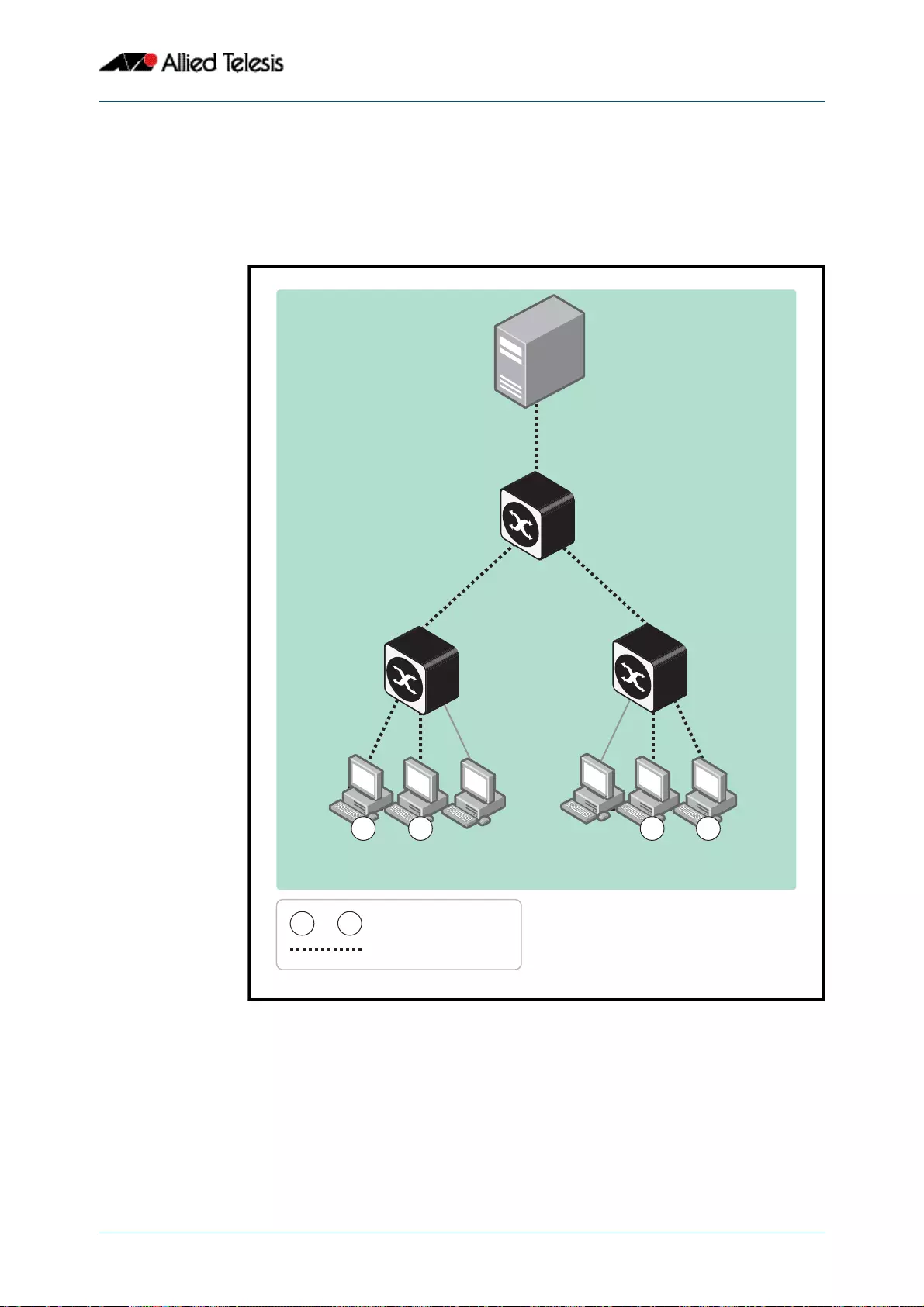
IGMP Snooping Introduction
Software Reference for GS900MX/MPX Series Switches
C613-50065-01 REV B AlliedWare PlusTM Operating System - Version 5.4.4E-1.x 32.3
IGMP
Internet Group Management Protocol (IGMP) is the protocol that hosts use to indicate that
they are interested in receiving a particular multicast stream. An example of a multicast
system within a single Layer 2 LAN is shown in Figure 32-1.
Figure 32-1: Multicast system within a single LAN
1234
Path of multicast tree
14
to Multicast hosts/clients
Multicast
source
LAN
IGMP Querier
(also known as
a multicast router)
Layer 2 switches
perform IGMP
snooping
Querier sends IGMP queries
to discover which hosts are
still joined
multicast_2
Multicast hosts send IGMP requests to join and leave groups

IGMP Snooping Introduction
Software Reference for GS900MX/MPX Series Switches
32.4 AlliedWare PlusTM Operating System - Version 5.4.4E-1.x C613-50065-01 REV B
Joining a Multicast Group (Membership Report)
When a host wants to receive a stream, referred to as “joining a group”, it sends out an
IGMP packet containing the address of the group it wants to join. This packet is called an
IGMP Membership report, often referred to as a “join packet”. This packet is forwarded
through the LAN to the local IGMP querier, which is typically a router. Once the querier has
received an IGMP join message, it knows to forward the multicast stream to the host. If it is
not already receiving the stream, it must tell the devices between itself and the multicast
source, which may be some hops away from the querier, that it wishes to receive the
stream. This might involve a process of using Layer 3 multicast protocols to signal across a
WAN, or it might be as simple as receiving a stream from a locally connected multicast
server.
Your switch does not support IGMP but does support IGMP Snooping.
Staying in the Multicast Group (Query Message)
The Query message is used by a querier to determine whether hosts are still interested in
an IGMP group. At certain time intervals (the default is 125 seconds), the querier sends an
IGMP query message onto the local LAN. The destination address of the query message is
a special “all multicast groups” address. The purpose of this query is to ask “Are there any
hosts on the LAN that wish to remain members of multicast groups?” After receiving an
IGMP query, any host that wants to remain in a multicast group must send a new join
packet for that group. If a host is a member of more than one group, then it sends a join
message for each group it wants to remain a member of. The querier looks at the
responses it receives to its query, and compares these to the list of multicast streams that
it is currently registered to forward. If there are any items in that list for which it has not
received query responses, it will stop forwarding those streams. Additionally, if it is
receiving those streams through a Layer 3 network, it will send a Layer 3 routing protocol
message upstream, asking to no longer receive that stream.
Leaving the Multicast Group (Leave Message)
How a host leaves a group depends on the IGMP version that it is using. Under IGMP
version 1, when a host has finished with a data stream, the local querier continues to send
the stream to the host until it sends out the next query message and receives no reply
back from the host. IGMP version 2 introduced the Leave message. This allows a host to
explicitly inform its querier that it wants to leave a particular multicast group. When the
querier receives the Leave message, it sends out a group specific query asking whether
any hosts still want to remain members of that specific group. If no hosts respond with join
messages for that group, then the querier knows that there are no hosts on its LAN that
are still members of that group. This means that for that specific group, it can ask to be
pruned from the multicast tree. IGMP version 3 removed the Leave message. Instead a
host leaves a group by sending a join message with no source specified.

IGMP Snooping Introduction
Software Reference for GS900MX/MPX Series Switches
C613-50065-01 REV B AlliedWare PlusTM Operating System - Version 5.4.4E-1.x 32.5
IGMP Snooping
IGMP Snooping is a way for Layer 2 switches to reduce the amount of multicast traffic on a
LAN. The AlliedWare Plus implementation of IGMP Snooping is compatible with networks
running all IGMP versions.
Without IGMP Snooping, Layer 2 switches handle IP multicast traffic in the same manner
as broadcast traffic and forward multicast frames received on one port to all other ports in
the same VLAN. IGMP Snooping allows switches to monitor network traffic, and determine
hosts to receive multicast traffic, by looking into IGMP packets to learn which attached
hosts need to receive which multicast groups. This allows the switch to forward multicast
traffic only out the appropriate ports. If it sees multiple reports sent for one group, it will
forward only one of them.
How IGMP Snooping Operates
IGMP Snooping operates similarly to the multicast protocols. When a switch hears an
IGMP report from a host for a given multicast group, the switch adds the host's port
number to the list of ports that are listening to the multicast group. When the switch hears
an IGMP leave, it removes the host's port from the list, after the completion of the leave
process as described in “Leaving the Multicast Group (Leave Message)” on page 32.4.
When there are no hosts listening to a group, the switch informs the local querier to stop
sending that group’s multicast stream.
IGMP Snooping allows query messages to be forwarded to all ports. The hosts that still
require the stream respond to the queries by sending reports. The switch intercepts these.
Depending on configuration settings, the switch may just forward the reports directly on
to the querier, or it may proxy report on behalf of the group, only forwarding on one
consolidated report for each group.
By default, IGMP Snooping is enabled both globally and on all VLANs.
Note IGMP Snooping cannot be disabled on an interface if IGMP Snooping has
already been disabled globally. IGMP Snooping can be disabled on both an
interface and globally if disabled on the interface first and then disabled
globally.
To disable IGMP Snooping either
1. awplus#
configure terminal Enter Global Configuration mode.
2. awplus(config)#
no ip igmp snooping Disable IGMP Snooping globally.
or
1. awplus#
configure terminal Enter Global Configuration mode.
2. awplus(config)#
interface <vlan-name> Enter Interface Configuration mode for a specific VLAN.
3. awplus(config-if)#
no ip igmp snooping Disable IGMP Snooping for a specific VLAN.
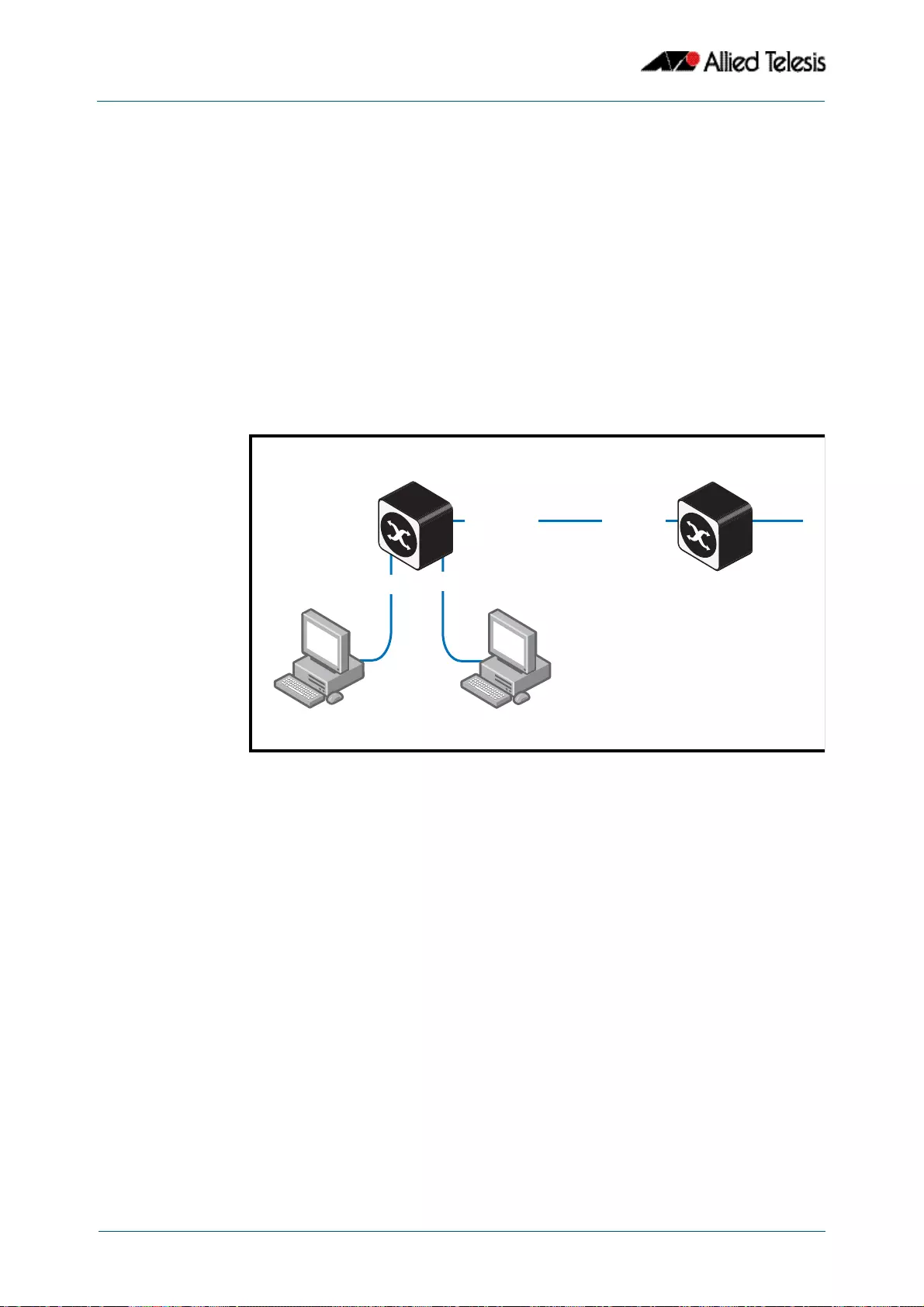
IGMP Snooping Introduction
Software Reference for GS900MX/MPX Series Switches
32.6 AlliedWare PlusTM Operating System - Version 5.4.4E-1.x C613-50065-01 REV B
IGMP Snooping and Querier Configuration
Example
This example describes the configuration of IGMP Snooping on a switch (Switch 1). Host A
and Host B are both members of the same multicast group. In this network, Switch 2 is an
IGMP Querier and is an x-series switch, such as an x510. Its configuration is not given here.
To enable IGMP Snooping on an interface:
■Enable IGMP Snooping globally, if necessary. IGMP Snooping is enabled by default.
■Enable IGMP Snooping on the desired interfaces, if necessary. IGMP Snooping is
enabled on all interfaces by default.
■Statically configure ports that are connected to routers if necessary.
Figure 32-2: IGMP Snooping configuration example
As a result of this configuration:
■Membership reports are generated by hosts. The IGMP Snooping switch will forward
the membership reports to its router port. Queries received by the IGMP Snooping
switch from the IGMP Querier on port1.0.6 are forwarded by the IGMP Snooping
switch.
■Because Host A and Host B are members of the same multicast group, the switch does
not notify the IP IGMP routing device (IGMP Querier) when Host A leaves the group,
because the group still has another member Host B remaining. When Host B also
leaves the group, the switch forwards the leave message to the IP IGMP Querier.
■The addition of a static mrouter port is only required when there is no upstream IGMP
querier or an upstream router does not send topology discovery or maintenance
messages (like IGMP General Queries or OSPF Hello packets).
■In this example, the configuration of a static mrouter port on port1.0.6 is provided to
illustrate the ip igmp snooping mrouter command. However, this command would
probably not be necessary, since the switch should dynamically set port1.0.6 to be an
mrouter port as it receives IGMP Queries arriving from the IGMP Querier attached to
port1.0.6.
■In this example, it is not necessary to explicitly configure the switch to work with
IGMPv2 or IGMPv3. When the IGMP version is not configured then the switch will
work with both versions of IGMP.
igmpsnoop_1
Switch 1
Switch 2
port1.0.1
IGMP QuerierIGMP Snooping Switch
port1.0.1
port1.0.6
port1.0.2
Host A Host B

IGMP Snooping Introduction
Software Reference for GS900MX/MPX Series Switches
C613-50065-01 REV B AlliedWare PlusTM Operating System - Version 5.4.4E-1.x 32.7
Table 32-1: Configuring IGMP Snooping on Switch 1 and IGMP Querier on Switch 2
Step 1. Configure IGMP Snooping (Switch 1)
1. awplus#
configure terminal Enter Global Configuration mode.
2. awplus(config)#
ip igmp snooping Enable IGMP Snooping globally. Snooping is
enabled by default. Use this command only if
you have previously disabled it.
3. awplus(config)#
interface vlan1 Enter Interface Configuration mode for VLAN 1.
4. awplus(config-if)#
ip igmp snooping mrouter interface
port1.0.6
Configure port1.0.6 as a multicast router port to
the IGMP Querier.
5. awplus(config-if)#
exit Return to Global Configuration mode.
Step 2. Validate the configuration
6. awplus#
exit Return to Privileged Exec mode.
7. awplus#
show ip igmp interface vlan1 Display the state of IGMP Snooping for VLAN 1.
8. awplus#
show ip igmp groups Display the multicast groups with receivers
directly connected to the router.
9. awplus#
show ip igmp snooping mrouter
interface vlan1
Display the multicast router ports, both static
and dynamic, in VLAN 1.
Step 3. Configure IGMP Querier (Switch 2)
1. awplus#
configure terminal Enter Global Configuration mode.
2. awplus(config)#
interface vlan1 Enter Interface Configuration mode for VLAN 1.
3. awplus(config-if)#
ip igmp Enable IGMP on VLAN 1 and configure the
switch as an IGMP Querier.
Step 4. Validate the configuration
4. awplus#
exit Return to Privileged Exec mode.
5. awplus#
show ip igmp interface vlan1 Display the state of IGMP Querier for VLAN 1.

IGMP Snooping Introduction
Software Reference for GS900MX/MPX Series Switches
32.8 AlliedWare PlusTM Operating System - Version 5.4.4E-1.x C613-50065-01 REV B
6. awplus#
show running-config Display the current dynamic configuration of
Switch 2.
Table 32-1: Configuring IGMP Snooping on Switch 1 and IGMP Querier on Switch 2 (cont.)

IGMP Snooping Introduction
Software Reference for GS900MX/MPX Series Switches
C613-50065-01 REV B AlliedWare PlusTM Operating System - Version 5.4.4E-1.x 32.9
Query Solicitation
Query Solicitation minimizes the loss of multicast data after a topology change on
networks that use EPSR or spanning tree (STP, RSTP, or MSTP) for loop protection. Without
Query Solicitation, when the underlying link layer topology changes, multicast data flow
can stop for up to several minutes, depending on which port goes down and how much of
the IGMP query interval remained at the time of the topology change. Query Solicitation
greatly reduces this disruption.
Query Solicitation operates without configuration in AlliedWare PlusTM switches running
STP, RSTP, MSTP or EPSR. However, you may find it useful to manually enable Query
Solicitation in loop-free networks running IGMP (see Speeding up IGMP Convergence in
a Non-Looped Topology) and networks where not all switches support Query
Solicitation (see Enabling Query Solicitation on Multiple Switches in a Looped
Topology).
How Query Solicitation Works
Query Solicitation monitors STP, RSTP, MSTP and EPSR messages for topology changes.
When it detects a change, it generates a special IGMP Leave message called a Query
Solicit. The switch floods the Query Solicit message to all ports in every VLAN that Query
Solicitation is enabled on. When the Querier receives the Query Solicit message, it sends
out a General Query and waits for clients to respond with Membership Reports. These
Reports update the snooping information throughout the network.
Query Solicit messages have a group address of 0.0.0.0.
Query Solicitation works by default (without you enabling it) on all VLANs on the root
bridge in an STP instance and on all data VLANs on the master node in an EPSR instance.
By default, the root bridge or master node always sends a Query Solicit message when any
of the following events occur:
■an STP BPDU packet with the Topology Change (TC) flag arrives at the root bridge
■an STP port on a switch goes from a Discarding to Forwarding state
■the FDB gets flushed by EPSR
Query Solicitation Operation
When IGMP Snooping is enabled and EPSR or Spanning Tree changes the underlying link
layer topology, this can interrupt multicast data flow for a significant length of time. This is
because there is no way for switches in a network with interested clients to know where
the traffic is available, due to the change in network topology. This change in network
topology may take up to two IGMP Query intervals from the IGMP Querier, until the
switches will know where to forward membership reports received by client hosts. During
this time, those hosts will not receive multicast traffic.
Query solicitation prevents this by monitoring for any topology changes. When it detects
a change, it generates a special IGMP Leave message known as a Query Solicit, and floods
the Query Solicit message to all ports in every VLAN that query solicitation is enabled on.
When the IGMP Querier receives the message, it responds by sending a General Query,
which all IGMP listeners respond to. This refreshes snooped group membership
information in the network.

IGMP Snooping Introduction
Software Reference for GS900MX/MPX Series Switches
32.10 AlliedWare PlusTM Operating System - Version 5.4.4E-1.x C613-50065-01 REV B
Query solicitation reduces downtime to a negligible amount by triggering on topology
changes. The generation of query solicitation messages in the network causes the IGMP
Querier to send an IGMP Query immediately following a topology change. This enables
the switches to know where to look for the traffic and thus to send reports to the correct
switch upstream. This allows the multicast data traffic to be recovered instantly.
Query solicitation functions by default (without you enabling it) on all VLANs on the root
bridge in an STP instance and on all data VLANs on the master node in an EPSR instance.
By default, the root bridge or master node always sends a Query Solicit message when the
topology changes.
If you have multiple STP or EPSR instances, query solicitation only sends Query Solicit
messages on VLANs in the instance that experienced a topology change.
In switches other than the STP root bridge or EPSR master node, query solicitation is
disabled by default, but you can enable it by using the ip igmp snooping tcn query
solicit command.
If you enable query solicitation on a switch other than the STP root bridge or EPSR master
node, both that switch and the root or master send a Query Solicit message.
Once the Querier receives the Query Solicit message, it sends out a General Query and
waits for responses, which update the snooping information throughout the network.
On switches other than the STP root bridge or the EPSR master node, you can disable
query solicitation by using the no variant of the ip igmp snooping tcn query solicit
command. In addition, on all switches, you can disable query solicitation on a per-vlan
basis using the no variant of the ip igmp snooping tcn query solicit command in
Interface Configuration mode, after specifying a VLAN first in Interface Configuration
mode.
To see whether query solicitation is on or off, check the Query Solicitation field in output
of the show ip igmp interface command. You can view running and startup
configurations with show running-config and show startup-config commands to see if
Query Solicitation is enabled.
The following figure shows how Query Solicitation works when a port goes down.
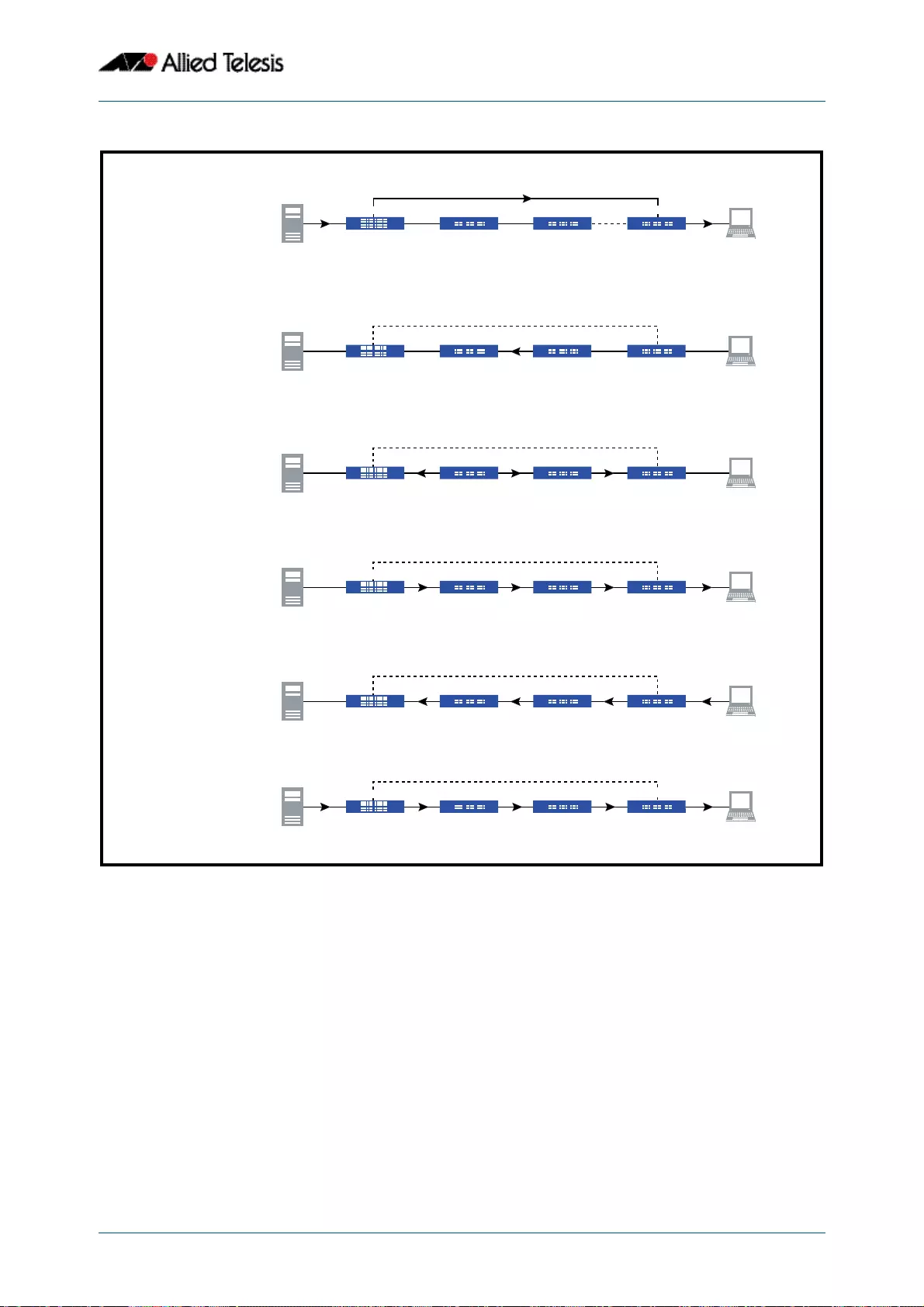
IGMP Snooping Introduction
Software Reference for GS900MX/MPX Series Switches
C613-50065-01 REV B AlliedWare PlusTM Operating System - Version 5.4.4E-1.x 32.11
Figure 32-3: Query Solicitation when a port goes down
TC
1. Link to Switch 4
goes down.
Switch 3 stops
blocking and
sends topology
change (TC)
Switch 3
Switch 2: STP root
QSQS
2. Switch 2 receives
TC and sends
Query Solicit (QS)
Switch 2: STP root
QS
GQGQ
3. Switch 1 receives
QS and sends
General Query (GQ)
GQ
Switch 1: Querier
GQ
ReportReport
4. Host receives GQ
and responds with
Membership Report
Report Report
Switch 1: Querier Switch 3
Switch 2: STP root Switch 4
Initial state:
Port on Switch 3
is blocking.
Multicasts flow
from server to
client via Switches
1 and 4
Multicast
Multicast
Multicast
Multicast
Multicast
Switch 1: Querier Switch 3
Switch 2: STP root Switch 4
Final state:
Multicasts flow
from server to
client via Switches
1, 2, 3, and 4
Multicast Multicast
Multicast
igmp_qs

IGMP Snooping Introduction
Software Reference for GS900MX/MPX Series Switches
32.12 AlliedWare PlusTM Operating System - Version 5.4.4E-1.x C613-50065-01 REV B
Speeding up IGMP Convergence in a Non-Looped
Topology
For loop-free networks running IGMP, where it may take up to two minutes for
multicasting to recover in a non-looped topology after a port comes back up, you can
speed up convergence by enabling RSTP using the spanning-tree mode and spanning-
tree enable commands.
RSTP enables the network to use Query Solicitation by default, and means that
multicasting should resume within seconds, not minutes, of the link coming up.
Enabling Query Solicitation on Multiple Switches
in a Looped Topology
On networks that use spanning tree or EPSR, Query Solicitation is not normally required
on switches other than the STP root bridge or EPSR master node. Therefore, it is only
enabled by default on the root bridge and the master node.
However, in some networks you may need to turn on Query Solicitation on all switches -
for example, if the network includes other switches that do not support Query Solicitation
and therefore the STP root bridge may be a switch that does not send Query Solicit
messages. To enable Query Solicitation, use the ip igmp snooping tcn query solicit
command.
Every switch that has Query Solicitation enabled sends a Query Solicit message when it
detects a topology change. Enabling it on multiple switches means you get multiple
messages, but has no other disadvantage.
The following figure shows the packet flow for a four-switch network with Query
Solicitation enabled on all the switches.

IGMP Snooping Introduction
Software Reference for GS900MX/MPX Series Switches
C613-50065-01 REV B AlliedWare PlusTM Operating System - Version 5.4.4E-1.x 32.13
Figure 32-4: Packet flow for a four switch network with Query Solicitation enabled
Switch 1: Querier Switch 3
Switch 2: STP root
Initial state:
Port on switch 3
is blocking.
Multicasts flow
from server to
client via switches
1 and 4
Multicast
Multicast
Multicast
MulticastMulticast
Switch 1: Querier Switch 3
Switch 2: STP root Switch 4
Final state:
Multicasts flow
from server to
client via Switches
1, 2, 3, and 4
Multicast Multicast
Multicast
QS from 3
1. Link to switch 4
goes down.
Switch 3 stops
blocking and
sends Topology
Change (TC) and
Query Solicit (QS).
Switch 2 forwards
QS to switch 1.
Switch 1 sends
General Query (GQ)
Switch 3
Switch 2: STP root Switch 4
TC from 3
QS from 3
GQ from 1 GQ from 1 GQ from 1 GQ from 1
TC from 3
Switch 1: Querier
2. Switch 2 receives TC
from switch 3.
Switch 2 sends QS.
to switch 1.
Switch 1 sends GQ
Switch 3
Switch 2: STP root Switch 4
QS from 2
GQ from 1 GQ from 1 GQ from 1 GQ from 1
Switch 1: Querier
QS from 4
3. Switch 4 receives TC
from switch 3.
Switch 4 sends QS.
towards switch 1.
Switch 1 sends GQ
Switch 3
Switch 2: STP root Switch 4
QS from 4
GQ from 1 GQ from 1 GQ from 1 GQ from 1
Switch 1: Querier
QS from 4
4. Client replies to each
GQ by sending
Membership Reports
Switch 3
Switch 2: STP root Switch 4
Switch 1: Querier
ReportReport Report Report
ReportReport Report Report
ReportReport Report Report
igmp_qs_multiple

IGMP Snooping Introduction
Software Reference for GS900MX/MPX Series Switches
32.14 AlliedWare PlusTM Operating System - Version 5.4.4E-1.x C613-50065-01 REV B

Software Reference for GS900MX/MPX Series Switches
C613-50065-01 REV B AlliedWare PlusTM Operating System - Version 5.4.4E-1.x 33.1
Chapter 33: IGMP Snooping Commands
Introduction ........................................................................................................................................ 33.2
Command List .................................................................................................................................... 33.2
clear ip igmp ....................................................................................................................................... 33.2
clear ip igmp group.......................................................................................................................... 33.3
clear ip igmp interface..................................................................................................................... 33.4
debug igmp......................................................................................................................................... 33.5
ip igmp snooping.............................................................................................................................. 33.6
ip igmp snooping fast-leave ......................................................................................................... 33.7
ip igmp snooping querier .............................................................................................................. 33.8
ip igmp snooping report-suppression ...................................................................................... 33.9
ip igmp snooping tcn query solicit...........................................................................................33.10
ip igmp static-group ......................................................................................................................33.12
ip igmp version ................................................................................................................................33.13
show debugging igmp..................................................................................................................33.14
show ip igmp groups.....................................................................................................................33.15
show ip igmp interface .................................................................................................................33.16
show ip igmp snooping statistics..............................................................................................33.19
undebug igmp .................................................................................................................................33.20

IGMP Snooping Commands
Software Reference for GS900MX/MPX Series Switches
33.2 AlliedWare PlusTM Operating System - Version 5.4.4E-1.x C613-50065-01 REV B
Introduction
The Internet Group Management Protocol (IGMP) module includes IGMP Snooping
functionality. Some of the following commands may have commonalities and restrictions.
These are described under the Usage section for each command.
Command List
This chapter provides an alphabetical reference of configure, clear, and show commands
related to IGMP Snooping.
clear ip igmp
Use this command to clear all IGMP group membership records on all VLAN interfaces.
Syntax clear ip igmp
Mode Privileged Exec
Usage This command applies to VLAN interfaces configured for IGMP Snooping.
Example
Validation
Commands
show ip igmp interface
show running-config
Related Commands clear ip igmp group
clear ip igmp interface
awplus# clear ip igmp

IGMP Snooping Commands
Software Reference for GS900MX/MPX Series Switches
C613-50065-01 REV B AlliedWare PlusTM Operating System - Version 5.4.4E-1.x 33.3
clear ip igmp group
Use this command to clear IGMP group membership records for a specific group on either
all VLAN interfaces, a single VLAN interface, or for a range of VLAN interfaces.
Syntax clear ip igmp group *
clear ip igmp group <ip-address> <interface>
Mode Privileged Exec
Usage This command applies to groups learned by IGMP Snooping.
In addition to the group a VLAN interface can be specified. Specifying this will mean that
only entries with the group learned on the interface will be deleted.
Examples
Validation
Commands
show ip igmp interface
show running-config
Related Commands clear ip igmp
clear ip igmp interface
Parameter Description
*Clears all groups on all VLAN interfaces. This is an alias to the
clear ip igmp command.
<ip-address> Specifies the group whose membership records will be cleared
from all VLAN interfaces, entered in the form A.B.C.D.
<interface>Specifies the name of the VLAN interface; all groups learned on
this VLAN interface are deleted.
awplus# clear ip igmp group *
awplus# clear ip igmp group 224.1.1.1 vlan1

IGMP Snooping Commands
Software Reference for GS900MX/MPX Series Switches
33.4 AlliedWare PlusTM Operating System - Version 5.4.4E-1.x C613-50065-01 REV B
clear ip igmp interface
Use this command to clear IGMP group membership records on a particular VLAN
interface.
Syntax clear ip igmp interface <interface>
Mode Privileged Exec
Usage This command applies to interfaces configured for IGMP Snooping.
Example
Validation
Commands
show ip igmp interface
show running-config
Related Commands clear ip igmp
clear ip igmp group
Parameter Description
<interface>Specifies the name of the VLAN interface. All groups learned on this
VLAN interface are deleted.
awplus# clear ip igmp interface vlan1

IGMP Snooping Commands
Software Reference for GS900MX/MPX Series Switches
C613-50065-01 REV B AlliedWare PlusTM Operating System - Version 5.4.4E-1.x 33.5
debug igmp
Use this command to enable debugging of either all IGMP or a specific component of
IGMP.
Use the no variant of this command to disable all IGMP debugging, or debugging of a
specific component of IGMP.
Syntax debug igmp {all|decode|encode|events|fsm|tib}
no debug igmp {all|decode|encode|events|fsm|tib}
Modes Privileged Exec and Global Configuration
Usage This command applies to interfaces configured for IGMP Snooping.
Example
Related Commands show debugging igmp
undebug igmp
Parameter Description
all Enable or disable all debug options for IGMP
decode Debug of IGMP packets that have been received
encode Debug of IGMP packets that have been sent
events Debug IGMP events
fsm Debug IGMP Finite State Machine (FSM)
tib Debug IGMP Tree Information Base (TIB)
awplus# configure terminal
awplus(config)# debug igmp all

IGMP Snooping Commands
Software Reference for GS900MX/MPX Series Switches
33.6 AlliedWare PlusTM Operating System - Version 5.4.4E-1.x C613-50065-01 REV B
ip igmp snooping
Use this command to enable IGMP Snooping. When this command is used in the Global
Configuration mode, IGMP Snooping is enabled at the switch level. When this command is
used in Interface Configuration mode, IGMP Snooping is enabled for the specified VLANs.
Use the no variant of this command to either globally disable IGMP Snooping, or disable
IGMP Snooping on a specified interface.
Syntax ip igmp snooping
no ip igmp snooping
Default By default, IGMP Snooping is enabled both globally and on all VLANs.
Mode Global Configuration and Interface Configuration for a VLAN interface.
Usage For IGMP snooping to operate on particular VLAN interfaces, it must be enabled both
globally by using this command in Global Configuration mode, and on individual VLAN
interfaces by using this command in Interface Configuration mode (both are enabled by
default.)
Both IGMP snooping and MLD snooping must be enabled globally on the switch for IGMP
snooping to operate. MLD snooping is also enabled by default. To enable it if it has been
disabled, use the ipv6 mld snooping command on page 35.8 in Global Configuration
mode.
Ensure your VLAN is configured first: see Chapter 16, Configuring VLANs.
Examples
Related Commands ipv6 mld snooping
show ip igmp interface
show running-config
Note IGMP snooping cannot be disabled on an interface if IGMP snooping has
already been disabled globally. IGMP snooping can be disabled on both an
interface and globally if disabled on the interface first and then disabled
globally.
awplus# configure terminal
awplus(config)# ip igmp snooping
awplus# configure terminal
awplus(config)# interface vlan2
awplus(config-if)# ip igmp snooping

IGMP Snooping Commands
Software Reference for GS900MX/MPX Series Switches
C613-50065-01 REV B AlliedWare PlusTM Operating System - Version 5.4.4E-1.x 33.7
ip igmp snooping fast-leave
Use this command to enable IGMP Snooping fast-leave processing. Fast-leave processing
is analogous to immediate-leave processing. The IGMP group-membership entry is
removed as soon as an IGMP leave group message is received, without sending out a
group-specific query.
Use the no variant of this command to disable fast-leave processing.
Syntax ip igmp snooping fast-leave
no ip igmp snooping fast-leave
Default IGMP Snooping fast-leave processing is disabled.
Mode Interface Configuration for a VLAN interface.
Usage This IGMP Snooping command can only be configured on VLAN interfaces.
Ensure your VLAN is configured first: see Chapter 16, Configuring VLANs.
Example This example shows how to enable fast-leave processing on the VLAN interface vlan2:
Validation
Commands
show ip igmp interface
show running-config
awplus# configure terminal
awplus(config)# interface vlan2
awplus(config-if)# ip igmp snooping fast-leave

IGMP Snooping Commands
Software Reference for GS900MX/MPX Series Switches
33.8 AlliedWare PlusTM Operating System - Version 5.4.4E-1.x C613-50065-01 REV B
ip igmp snooping querier
Use this command to enable IGMP querier operation when no multicast routing protocol
is configured. When enabled, the IGMP Snooping querier sends out periodic IGMP queries
for all interfaces. This command applies to interfaces configured for IGMP Snooping.
Use the no variant of this command to disable IGMP querier configuration.
Syntax ip igmp snooping querier
no ip igmp snooping querier
Mode Interface Configuration for a VLAN interface.
Usage The IGMP Snooping querier uses the 0.0.0.0 Source IP address because it only
masquerades as a proxy IGMP querier for faster network convergence.
It does not start, or automatically cease, the IGMP Querier operation if it detects query
message(s) from a multicast router.
If an IP address is assigned to a VLAN, which has IGMP querier enabled on it, then the IGMP
Snooping querier uses the VLAN’s IP address as the Source IP Address in IGMP queries.
The IGMP Snooping Querier will not stop sending IGMP Queries if there is another IGMP
Snooping Querier in the network with a lower Source IP Address.
Ensure your VLAN is configured first: see Chapter 16, Configuring VLANs.
Example
Validation
Commands
show ip igmp interface
show running-config
Note Do not enable the IGMP Snooping Querier feature on a Layer 2 switch when
there is an operational IGMP Querier in the network.
awplus# configure terminal
awplus(config)# interface vlan2
awplus(config-if)# ip igmp snooping querier

IGMP Snooping Commands
Software Reference for GS900MX/MPX Series Switches
C613-50065-01 REV B AlliedWare PlusTM Operating System - Version 5.4.4E-1.x 33.9
ip igmp snooping report-suppression
Use this command to enable report suppression for IGMP versions 1 and 2. This command
applies to interfaces configured for IGMP Snooping.
Report suppression stops reports being sent to an upstream multicast router port when
there are already downstream ports for this group on this interface.
Use the no variant of this command to disable report suppression.
Syntax ip igmp snooping report-suppression
no ip igmp snooping report-suppression
Default Report suppression does not apply to IGMPv3, and is turned on by default for IGMPv1 and
IGMPv2 reports.
Mode Interface Configuration for a VLAN interface.
Usage Ensure your VLAN is configured first: see Chapter 16, Configuring VLANs.
Example This example shows how to enable report suppression for IGMPv2 reports for the VLAN
interface vlan2:
Validation
Commands
show ip igmp interface
show running-config
awplus# configure terminal
awplus(config)# interface vlan2
awplus(config-if)# ip igmp version 2
awplus(config-if)# ip igmp snooping report-suppression

IGMP Snooping Commands
Software Reference for GS900MX/MPX Series Switches
33.10 AlliedWare PlusTM Operating System - Version 5.4.4E-1.x C613-50065-01 REV B
ip igmp snooping tcn query solicit
Use this command to enable IGMP (Internet Group Management Protocol) Snooping TCN
(Topology Change Notification) Query Solicitation feature. When this command is used in
the Global Configuration mode, Query Solicitation is enabled.
Use the no variant of this command to disable IGMP Snooping TCN Query Solicitation.
When the no variant of this command is used in Interface Configuration mode, this
overrides the Global Configuration mode setting and Query Solicitation is disabled.
Syntax ip igmp snooping tcn query solicit
no ip igmp snooping tcn query solicit
Default IGMP Snooping TCN Query Solicitation is disabled by default on the switch, unless the
switch is the Master Node in an EPSR ring, or is the Root Bridge in a Spanning Tree.
When the switch is the Master Node in an EPSR ring, or the switch is the Root Bridge in a
Spanning Tree, then IGMP Snooping TCN Query Solicitation is enabled by default and
cannot be disabled using the Global Configuration mode command. However, Query
Solicitation can be disabled for specified VLANs using this command from the Interface
Configuration mode. Select the VLAN you want to disable in Interface Configuration mode
then issue the no variant of this command to disable the specified VLAN without disabling
this feature for other VLANs.
Mode Global Configuration and Interface Configuration for a VLAN interface.
Usage Once enabled, if the switch is not an IGMP Querier, on detecting a topology change, the
switch generates IGMP Query Solicit messages that are sent to all the ports of the vlan
configured for IGMP Snooping on the switch.
On a switch that is not the Master Node in an EPSR ring or the Root Bridge in a Spanning
Tree, Query Solicitation can be disabled using the no variant of this command after being
enabled.
If the switch that detects a topology change is an IGMP Querier then the switch will
generate an IGMP Query message.
Note that the no variant of this command when issued in Global Configuration mode has
no effect on a switch that is the Master Node in an EPSR ring or on a switch that is a Root
Bridge in a Spanning Tree. Query Solicitation is not disabled for the switch these instances.
However, Query Solicitation can be disabled on a per-vlan basis from the Interface
Configuration mode.
See the below state table that shows when Query Solicit messages are sent in these
instances:
See “Query Solicitation” on page 32.9 for introductory information about the Query
Solicitation feature.
Command issued
from Global
Configuration
Switch is STP Root
Bridge or the EPSR
Master Node
Command issued
from Interface
Configuration
IGMP Query Solicit
message sent on VLAN
No Yes Yes Yes
Yes Yes No No
Yes Yes Yes Yes

IGMP Snooping Commands
Software Reference for GS900MX/MPX Series Switches
C613-50065-01 REV B AlliedWare PlusTM Operating System - Version 5.4.4E-1.x 33.11
To ensure your VLAN is configured first: see Chapter 16, Configuring VLANs.
Examples This example shows how to enable IGMP Snooping TCN Query Solicitation on a switch:
This example shows how to disable IGMP Snooping TCN Query Solicitation on a switch:
This example shows how to enable IGMP Snooping TCN Query Solicitation for the VLAN
interface vlan2:
This example shows how to disable IGMP Snooping TCN Query Solicitation for the VLAN
interface vlan2:
Validation
Commands
show ip igmp interface
show running-config
awplus# configure terminal
awplus(config)# ip igmp snooping tcn query solicit
awplus# configure terminal
awplus(config)# no ip igmp snooping tcn query solicit
awplus# configure terminal
awplus(config)# interface vlan2
awplus(config-if)# ip igmp snooping tcn query solicit
awplus# configure terminal
awplus(config)# interface vlan2
awplus(config-if)# no ip igmp snooping tcn query solicit

IGMP Snooping Commands
Software Reference for GS900MX/MPX Series Switches
33.12 AlliedWare PlusTM Operating System - Version 5.4.4E-1.x C613-50065-01 REV B
ip igmp static-group
Use this command to statically configure multicast group membership entries on a VLAN
interface, or to statically forward a multicast channel out a particular port or port range.
To statically add only a group membership, do not specify any parameters.
To statically add a (*,g) entry to forward a channel out of a port, specify only the multicast
group address and the switch port range.
To statically add an (s,g) entry to forward a channel out of a port, specify the multicast
group address, the source IP address, and the switch port range.
Use the no variant of this command to delete static group membership entries.
Syntax ip igmp static-group <ip-address> [source {<ip-source-addr>}]
[interface <port>]
no ip igmp static-group <ip-address> [source {<ip-source-addr>}]
[interface <port>]
Mode Interface Configuration for a VLAN interface.
Usage This command applies to IGMP Snooping on a VLAN interface, to statically add group and/
or source records.
To ensure your VLAN is configured first, see Chapter 16, Configuring VLANs.
Example The following example show how to statically add group and source records for IGMP on
the VLAN interface vlan3:
Parameter Description
<ip-address> Standard IP Multicast group address, entered in the form
A.B.C.D, to be configured as a static group member.
source Optional.
<ip-source-addr> Standard IP source address, entered in the form A.B.C.D, to be
configured as a static source from where multicast packets
originate.
interface Use this parameter to specify a specific switch port or switch
port range to statically forward the multicast group out of. If
not used, static configuration is applied on all ports in the
VLAN.
<port>The port or port range to statically forward the group out of.
The port may be a switch port (e.g. port1.0.4), a static
channel group (e.g. sa2), or a dynamic (LACP) channel group
(e.g. po2).
awplus# configure terminal
awplus(config)# interface vlan3
awplus(config-if)# ip igmp
awplus(config-if)# ip igmp static-group 226.1.2.4 source
10.2.3.4

IGMP Snooping Commands
Software Reference for GS900MX/MPX Series Switches
C613-50065-01 REV B AlliedWare PlusTM Operating System - Version 5.4.4E-1.x 33.13
ip igmp version
Use this command to set the current IGMP version (IGMP version 1, 2 or 3) on an interface.
Use the no variant of this command to return to the default version.
Syntax ip igmp version <1-3>
no ip igmp version
Default The default IGMP protocol version number is 3.
Mode Interface Configuration for a VLAN interface.
Usage This command applies to VLAN interfaces configured for IGMP.
Ensure your VLAN is configured first: see Chapter 16, Configuring VLANs.
Example
Validation
Commands
show ip igmp interface
Parameter Description
<1-3>IGMP protocol version number
awplus# configure terminal
awplus(config)# interface vlan5
awplus(config-if)# ip igmp version 2

IGMP Snooping Commands
Software Reference for GS900MX/MPX Series Switches
33.14 AlliedWare PlusTM Operating System - Version 5.4.4E-1.x C613-50065-01 REV B
show debugging igmp
Use this command to display the IGMP debugging options set.
For information on output options, see “Controlling “show” Command Output” on
page 1.35.
Syntax show debugging igmp
Mode User Exec and Privileged Exec
Example To display the IGMP debugging options set, enter the command:
Output Figure 33-1: Example output from the show debugging igmp command
Related Commands debug igmp
awplus# show debugging igmp
IGMP Debugging status:
IGMP Decoder debugging is on
IGMP Encoder debugging is on
IGMP Events debugging is on
IGMP FSM debugging is on
IGMP Tree-Info-Base (TIB) debugging is on

IGMP Snooping Commands
Software Reference for GS900MX/MPX Series Switches
C613-50065-01 REV B AlliedWare PlusTM Operating System - Version 5.4.4E-1.x 33.15
show ip igmp groups
Use this command to display the multicast groups with receivers directly connected to the
router, and learned through IGMP.
For information on output options, see “Controlling “show” Command Output” on
page 1.35.
Syntax show ip igmp groups [<ip-address>|<interface> detail]
Mode User Exec and Privileged Exec
Example The following command displays local-membership information for all ports in all
interfaces:
Output Figure 33-2: Example output from the show ip igmp groups command
Table 33-1: Parameters in the output of the show ip igmp groups command
Parameter Description
<ip-address> Address of the multicast group, entered in the form A.B.C.D.
<interface> Interface name for which to display local information.
awplus# show ip igmp groups
IGMP Connected Group Membership
Group Address Interface Uptime Expires Last
Reporter
224.0.1.1 port1.0.1 00:00:09 00:04:17 10.10.0.82
224.0.1.24 port1.0.2 00:00:06 00:04:14 10.10.0.84
224.0.1.40 port1.0.3 00:00:09 00:04:15 10.10.0.91
224.0.1.60 port1.0.3 00:00:05 00:04:15 10.10.0.7
224.100.100.100 port1.0.1 00:00:11 00:04:13 10.10.0.91
228.5.16.8 port1.0.3 00:00:11 00:04:16 10.10.0.91
228.81.16.8 port1.0.7 00:00:05 00:04:15 10.10.0.91
228.249.13.8 port1.0.3 00:00:08 00:04:17 10.10.0.91
235.80.68.83 port1.0.11 00:00:12 00:04:15 10.10.0.40
239.255.255.250 port1.0.3 00:00:12 00:04:15 10.10.0.228
239.255.255.254 port1.0.12 00:00:08 00:04:13 10.10.0.84
Parameter Description
Group Address Address of the multicast group.
Interface Port through which the group is reachable.
Uptime The time in weeks, days, hours, minutes, and seconds that this
multicast group has been known to the device.
Expires Time (in hours, minutes, and seconds) until the entry expires.
Last Reporter Last host to report being a member of the multicast group.

IGMP Snooping Commands
Software Reference for GS900MX/MPX Series Switches
33.16 AlliedWare PlusTM Operating System - Version 5.4.4E-1.x C613-50065-01 REV B
show ip igmp interface
Use this command to display the state of IGMP Snooping for a specified VLAN, or all
VLANs. IGMP is shown as Active or Disabled in the show output.
For information on output options, see “Controlling “show” Command Output” on
page 1.35.
Syntax show ip igmp interface [<interface>]
Mode User Exec and Privileged Exec
Examples The following output shows IGMP interface status for vlan2 (with IGMP Snooping
enabled):
Parameter Description
<interface>The name of the VLAN interface.
awplus#configure terminal
Enter configuration commands, one per line. End with CNTL/Z.
awplus(config)#interface vlan2
awplus(config-if)#ip igmp snooping
awplus(config-if)#exit
awplus(config)#exit
awplus#show ip igmp interface vlan2
Interface vlan2 (Index 202)
IGMP Disabled, Inactive, Version 3 (default)
IGMP interface has 0 group-record states
IGMP activity: 0 joins, 0 leaves
IGMP robustness variable is 2
IGMP last member query count is 2
IGMP query interval is 125 seconds
IGMP query holdtime is 500 milliseconds
IGMP querier timeout is 255 seconds
IGMP max query response time is 10 seconds
Last member query response interval is 1000 milliseconds
Group Membership interval is 260 seconds
Strict IGMPv3 ToS checking is disabled on this interface
Source Address checking is enabled
IGMP Snooping is globally enabled
IGMP Snooping query solicitation is globally disabled
Num. query-solicit packets: 57 sent, 0 recvd
IGMP Snooping is enabled on this interface
IGMP Snooping fast-leave is not enabled
IGMP Snooping querier is not enabled
IGMP Snooping report suppression is enabled
awplus#

IGMP Snooping Commands
Software Reference for GS900MX/MPX Series Switches
C613-50065-01 REV B AlliedWare PlusTM Operating System - Version 5.4.4E-1.x 33.17
The following output shows IGMP interface status for vlan2 (with IGMP Snooping
disabled):
The following command displays the IGMP interface status and Query Solicitation for
vlan3:
awplus#configure terminal
Enter configuration commands, one per line. End with CNTL/Z.
awplus(config)#interface vlan2
awplus(config-if)#no ip igmp snooping
awplus(config-if)#exit
awplus(config)#exit
awplus#show ip igmp interface vlan2
Interface vlan2 (Index 202)
IGMP Disabled, Inactive, Version 3 (default)
IGMP interface has 0 group-record states
IGMP activity: 0 joins, 0 leaves
IGMP robustness variable is 2
IGMP last member query count is 2
IGMP query interval is 125 seconds
IGMP query holdtime is 500 milliseconds
IGMP querier timeout is 255 seconds
IGMP max query response time is 10 seconds
Last member query response interval is 1000 milliseconds
Group Membership interval is 260 seconds
Strict IGMPv3 ToS checking is disabled on this interface
Source Address checking is enabled
IGMP Snooping is globally enabled
IGMP Snooping query solicitation is globally disabled
Num. query-solicit packets: 57 sent, 0 recvd
IGMP Snooping is not enabled on this interface
IGMP Snooping fast-leave is not enabled
IGMP Snooping querier is not enabled
IGMP Snooping report suppression is enabled
awplus#
awplus#show ip igmp interface vlan3
Interface vlan3 (Index 203)
IGMP Enabled, Active, Querier, Version 3 (default)
Internet address is 192.168.9.1
IGMP interface has 256 group-record states
IGMP activity: 51840 joins, 0 leaves
IGMP robustness variable is 2
IGMP last member query count is 2
IGMP query interval is 125 seconds
IGMP query holdtime is 500 milliseconds
IGMP querier timeout is 250 seconds
IGMP max query response time is 1 seconds
Last member query response interval is 1000 milliseconds
Group Membership interval is 251 seconds
Strict IGMPv3 ToS checking is disabled on this interface
IGMP Snooping is globally enabled
IGMP Snooping query solicitation is globally enabled
Num. query-solicit packets: 1 sent, 10 recvd
IGMP Snooping is enabled on this interface
IGMP Snooping fast-leave is not enabled
IGMP Snooping querier is not enabled
IGMP Snooping report suppression is enabled
awplus#

IGMP Snooping Commands
Software Reference for GS900MX/MPX Series Switches
33.18 AlliedWare PlusTM Operating System - Version 5.4.4E-1.x C613-50065-01 REV B
Related Commands clear ip igmp
clear ip igmp group
clear ip igmp interface
ip igmp snooping
ip igmp snooping fast-leave
ip igmp snooping querier
ip igmp snooping report-suppression
ip igmp snooping tcn query solicit
ip igmp version
Note Query Solicitation status information is highlighted in bold in the above
output.
Use the show ip igmp interface command to validate that Query Solicitation is
enabled and to show the number of query-solicit message packets sent and
received on a VLAN.

IGMP Snooping Commands
Software Reference for GS900MX/MPX Series Switches
C613-50065-01 REV B AlliedWare PlusTM Operating System - Version 5.4.4E-1.x 33.19
show ip igmp snooping statistics
Use this command to display IGMP Snooping statistics data.
For information on output options, see “Controlling “show” Command Output” on
page 1.35.
Syntax show ip igmp snooping statistics interface <interface-range>
[group [<ip-address>]]
Mode User Exec and Privileged Exec
Example To display IGMP statistical information for vlan1 and vlan2, use the command:
Output Figure 33-3: Example output from the show ip igmp snooping statistics command
Parameter Description
<ip-address> Optionally specify the address of the multicast group, entered in
the form A.B.C.D.
<interface> Specify the name of the VLAN interface or interface range.
awplus# show ip igmp snooping statistics interface
vlan1-vlan2
IGMP Snooping statistics for vlan1
Interface: port1.0.3
Group: 224.1.1.1
Uptime: 00:00:09
Group mode: Exclude (Expires: 00:04:10)
Last reporter: 10.4.4.5
Source list is empty
IGMP Snooping statistics for vlan2
Interface: port1.0.4
Group: 224.1.1.2
Uptime: 00:00:19
Group mode: Exclude (Expires: 00:05:10)
Last reporter: 10.4.4.6
Source list is empty

Software Reference for GS900MX/MPX Series Switches
C613-50065-01 REV B AlliedWare PlusTM Operating System - Version 5.4.4E-1.x 34.1
Chapter 34: MLD Snooping Introduction and
Configuration
Introduction ........................................................................................................................................ 34.2
MLD Snooping ............................................................................................................................ 34.2

MLD Snooping Introduction and Configuration
Software Reference for GS900MX/MPX Series Switches
34.2 AlliedWare PlusTM Operating System - Version 5.4.4E-1.x C613-50065-01 REV B
Introduction
Multicast Listener Discovery (MLD) is used to exchange membership status information
between IPv6 routers that support multicasting and members of multicast groups on a
network segment. Host membership in a multicast group is reported by individual
member hosts, and membership status is periodically polled by multicast routers.
MLD Snooping
MLD Snooping is a feature whereby a Layer 2 device listens to or “snoops” the MLD
messages passing through the device or from member hosts and multicast routers. The
purpose of MLD Snooping is to provide efficient Layer 2 multicast forwarding, by sending
only to hosts that have expressed an interest in receiving the multicast data.
Hosts express an interest in receiving multicast data for a given multicast group by
sending an MLD join message. Without MLD Snooping, if one host expresses an interest in
getting multicast data for a given group, by sending an MLD join for the multicast group,
then all hosts connected to the same VLAN will also receive the multicast data. This wastes
bandwidth on the device ports connected to the host that are not interested in receiving
the multicast data. Snooping takes note of exactly which ports have received joins for a
given group, and send that group only to those ports.
MLD Snooping is enabled by default globally for the device. It can be enabled and
disabled on a per-VLAN basis.
MLD Snooping makes a distinction between Member ports, which are ports connected to
members hosts, and Router ports, which are ports connected to, or directed towards, a
Layer 3 router or a Layer 3 device.
Figure 34-1: Sample running-config showing an MLD Snooping Querier set on vlan2
For detailed information about the commands used to configure MLD Snooping, see
Chapter 34, MLD Snooping Introduction and Configuration.
The following examples configure MLD Snooping:
■Enabling MLD Snooping globally and on an interface
■Configuring a Multicast Router statically on an interface
■Enabling MLD Snooping Fast-Leave Processing on an interface
■Configuring MLD Snooping Report Suppression on an interface
■Enabling the MLD Snooping Querier on an interface
!
ipv6 mld snooping
!
interface vlan2
ipv6 mld snooping querier
!

MLD Snooping Introduction and Configuration
Software Reference for GS900MX/MPX Series Switches
C613-50065-01 REV B AlliedWare PlusTM Operating System - Version 5.4.4E-1.x 34.3
Enabling MLD Snooping globally and on an interface
To globally enable and show MLD Snooping on the device, enter the commands:
Note that entering show ipv6 mld interface without an optional interface
parameter displays MLD information for all configured interfaces globally on the device.
To enable and show MLD Snooping on VLAN interface vlan2, enter the commands:
Note that entering show ipv6 mld interface vlan2 with the optional interface
parameter displays MLD information for that specified configured interface on the device.
Configuring a Multicast Router statically on an interface
To configure and show a static connection to a Multicast Router for VLAN interface
vlan2, enter the commands:
Note the VLAN interface to the Multicast Router must be administratively up and the line
protocol must be up to configure a static connection to a Multicast Router on the VLAN.
awplus# configure terminal
awplus(config)# ipv6 mld snooping
awplus(config)# exit
awplus# show ipv6 mld interface
awplus# configure terminal
awplus(config)# interface vlan2
awplus(config-if)# ipv6 mld snooping
awplus(config-if)# exit
awplus(config)# exit
awplus# show ipv6 mld interface vlan2
awplus# configure terminal
awplus(config)# interface vlan2
awplus(config-if)# ipv6 mld snooping mrouter interface
port1.0.2
awplus(config-if)# exit
awplus(config)# exit
awplus# show ipv6 mld interface vlan2

MLD Snooping Introduction and Configuration
Software Reference for GS900MX/MPX Series Switches
34.4 AlliedWare PlusTM Operating System - Version 5.4.4E-1.x C613-50065-01 REV B
Enabling MLD Snooping Fast-Leave Processing on an
interface
To enable and show MLD Snooping Fast-Leave Processing on VLAN interface vlan2,
enter the commands:
Configuring MLD Snooping Report Suppression on an
interface
To enable and show MLD Snooping Report Suppression on VLAN interface vlan2, enter
the commands:
Enabling the MLD Snooping Querier on an interface
Use the MLD Snooping Querier to support MLD Snooping in a VLAN where PIM-SMv6 and
MLD are not configured and whenever you do not need to route IPv6 multicast traffic.
You can configure the device to generate MLD queries on a VLAN interface if multicast
routing is not enabled. For each VLAN that is connected to devicees that use MLD
Snooping to report multicast traffic, configure one device as the MLD Snooping Querier.
To enable and show MLD Snooping Querier on VLAN interface vlan2, enter the
commands:
Note that the MLD Snooping Querier is configured in Interface Configuration mode only.
You cannot configure MLD Snooping Querier globally for all VLAN interfaces on a device.
awplus# configure terminal
awplus(config)# interface vlan2
awplus(config-if)# ipv6 mld snooping fast-leave
awplus(config-if)# exit
awplus(config)# exit
awplus# show ipv6 mld interface vlan2
awplus# configure terminal
awplus(config)# interface vlan2
awplus(config-if)# ipv6 mld snooping report-suppression
awplus(config-if)# exit
awplus(config)# exit
awplus# show ipv6 mld interface vlan2
awplus# configure terminal
awplus(config)# interface vlan2
awplus(config-if)# ipv6 mld snooping querier
awplus(config-if)# exit
awplus(config)# exit
awplus# show ipv6 mld interface vlan2

Software Reference for GS900MX/MPX Series Switches
C613-50065-01 REV B AlliedWare PlusTM Operating System - Version 5.4.4E-1.x 35.1
Chapter 35: MLD Snooping Commands
Command List .................................................................................................................................... 35.2
clear ipv6 mld ..................................................................................................................................... 35.2
clear ipv6 mld group........................................................................................................................ 35.3
clear ipv6 mld interface .................................................................................................................. 35.3
debug mld ........................................................................................................................................... 35.4
ipv6 mld access-group .................................................................................................................... 35.5
ipv6 mld limit...................................................................................................................................... 35.6
ipv6 mld snooping............................................................................................................................ 35.8
ipv6 mld snooping fast-leave .....................................................................................................35.10
ipv6 mld snooping mrouter ........................................................................................................35.11
ipv6 mld snooping querier ..........................................................................................................35.13
ipv6 mld snooping report-suppression ..................................................................................35.14
ipv6 mld static-group ....................................................................................................................35.16
show debugging mld ....................................................................................................................35.19
show ipv6 mld groups...................................................................................................................35.20
show ipv6 mld interface ...............................................................................................................35.21
show ipv6 mld snooping mrouter ............................................................................................35.22
show ipv6 mld snooping statistics............................................................................................35.23

MLD Snooping Commands
Software Reference for GS900MX/MPX Series Switches
35.2 AlliedWare PlusTM Operating System - Version 5.4.4E-1.x C613-50065-01 REV B
Command List
This chapter provides an alphabetical reference of configuration, clear, and show
commands related to MLD Snooping.
clear ipv6 mld
Use this command to clear all MLD local memberships on all interfaces.
Syntax clear ipv6 mld
Mode Privileged Exec
Example
Related Commands clear ipv6 mld group
clear ipv6 mld interface
awplus# clear ipv6 mld

MLD Snooping Commands
Software Reference for GS900MX/MPX Series Switches
C613-50065-01 REV B AlliedWare PlusTM Operating System - Version 5.4.4E-1.x 35.3
clear ipv6 mld group
Use this command to clear MLD specific local-membership(s) on all interfaces, for a
particular group.
Syntax clear ipv6 mld group {*|<ipv6-address>}
Mode Privileged Exec
Example
Related Commands clear ipv6 mld
clear ipv6 mld interface
clear ipv6 mld interface
Use this command to clear MLD interface entries.
Syntax clear ipv6 mld interface <interface>
Mode Privileged Exec
Example
Related Commands clear ipv6 mld
clear ipv6 mld group
Parameter Description
* Clears all groups on all interfaces. This is an alias to the clear
ipv6 mld command.
<ipv6-address>Specify the group address for which MLD local-memberships
are to be cleared from all interfaces.
Specify the IPv6 multicast group address in the format in the
format X:X::X:X.
awplus# clear ipv6 mld group *
Parameter Description
<interface> Specifies name of the interface; all groups learned from this interface
are deleted.
awplus# clear ipv6 mld interface vlan2

MLD Snooping Commands
Software Reference for GS900MX/MPX Series Switches
35.4 AlliedWare PlusTM Operating System - Version 5.4.4E-1.x C613-50065-01 REV B
debug mld
Use this command to enable all MLD debugging modes, or a specific MLD debugging
mode.
Use the no variant of this command to disable all MLD debugging modes, or a specific
MLD debugging mode.
Syntax debug mld {all|decode|encode|events|fsm|tib}
no debug mld {all|decode|encode|events|fsm|tib}
Mode Privileged Exec and Global Configuration
Examples
Related Commands show debugging mld
Parameter Description
all Debug all MLD.
decode Debug MLD decoding.
encode Debug MLD encoding.
events Debug MLD events.
fsm Debug MLD Finite State Machine (FSM).
tib Debug MLD Tree Information Base (TIB).
awplus# configure terminal
awplus(config)# debug mld all
awplus# configure terminal
awplus(config)# debug mld decode
awplus# configure terminal
awplus(config)# debug mld encode
awplus# configure terminal
awplus(config)# debug mld events

MLD Snooping Commands
Software Reference for GS900MX/MPX Series Switches
C613-50065-01 REV B AlliedWare PlusTM Operating System - Version 5.4.4E-1.x 35.5
ipv6 mld access-group
Use this command to control the multicast local-membership groups learned on an
interface.
Use the no variant of this command to disable this access control.
Syntax ipv6 mld access-group <IPv6-access-list-name>
no ipv6 mld access-group
Default No access list is configured by default.
Mode Interface Configuration for a specified VLAN interface or a range of VLAN interfaces.
Examples In the following example, the VLAN interface vlan2 will only accept MLD joins for
groups in the range ff1e:0db8:0001::/64:
In the following example, the VLAN interfaces vlan2-vlan4 will only accept MLD joins
for groups in the range ff1e:0db8:0001::/64:
Parameter Description
<IPv6-access-list-
name>
Specify a Standard or an Extended software IPv6 access-list
name. See Chapter 39, IPv6 Software Access Control
List (ACL) Commands for supported IPv6 ACLs.
awplus# configure terminal
awplus(config)# ipv6 forwarding
awplus(config)# ipv6 multicast-routing
awplus(config)# ipv6 access-list standard group1 permit
ff1e:0db8:0001::/64
awplus(config)# interface vlan2
awplus(config-if)# ipv6 enable
awplus(config-if)# ipv6 mld access-group group1
awplus# configure terminal
awplus(config)# ipv6 forwarding
awplus(config)# ipv6 multicast-routing
awplus(config)# ipv6 access-list standard group1 permit
ff1e:0db8:0001::/64
awplus(config)# interface vlan2-vlan4
awplus(config-if)# ipv6 enable
awplus(config-if)# ipv6 mld access-group group1

MLD Snooping Commands
Software Reference for GS900MX/MPX Series Switches
35.6 AlliedWare PlusTM Operating System - Version 5.4.4E-1.x C613-50065-01 REV B
ipv6 mld limit
Use this command to configure a limit on the maximum number of group memberships
that may be learned. The limit may be set for the device as a whole, or for a specific
interface.
Once the specified group membership limit is reached, all further local-memberships will
be ignored.
Optionally, an exception access-list can be configured to specify the group-address(es)
that are exempted from being subject to the limit.
Use the no variant of this command to unset the limit and any specified exception
access-list.
Syntax ipv6 mld limit <limitvalue> [except <IPv6-access-list-name>]
no ipv6 mld limit
Default The default limit, which is reset by the no variant of this command, is the same as
maximum number of group membership entries that can be learned with the ipv6 mld
limit command.
The default limit of group membership entries that can be learned is 512 entries.
Mode Global Configuration and Interface Configuration for a specified VLAN interface or a
range of VLAN interfaces.
Examples The following example configures an MLD limit of 100 group-memberships across all
VLAN interfaces on which MLD is enabled, and excludes groups in the range
ff1e:0db8:0001::/64 from this limitation:
Parameter Description
<limitvalue> <2-512> Maximum number of group membership states.
<IPv6-access-list-
name>
Specify a Standard or an Extended software IPv6 access-list
name that defines multicast groups, which are exempted
from being subject to the configured limit.
See Chapter 39, IPv6 Software Access Control List (ACL)
Commands for supported IPv6 ACLs.
awplus# configure terminal
awplus(config)# ipv6 forwarding
awplus(config)# ipv6 multicast-routing
awplus(config)# ipv6 access-list standard v6grp permit
ff1e:0db8:0001::/64
awplus(config)# ipv6 mld limit 100 except v6grp

MLD Snooping Commands
Software Reference for GS900MX/MPX Series Switches
C613-50065-01 REV B AlliedWare PlusTM Operating System - Version 5.4.4E-1.x 35.7
The following example configures an MLD limit of 100 group-membership states on the
VLAN interface vlan2:
The following example configures an MLD limit of 100 group-membership states on the
VLAN interfaces vlan2-vlan4:
Related Commands show ipv6 mld groups
awplus# configure terminal
awplus(config)# ipv6 forwarding
awplus(config)# ipv6 multicast-routing
awplus(config)# interface vlan2
awplus(config-if)# ipv6 enable
awplus(config-if)# ipv6 mld limit 100
awplus# configure terminal
awplus(config)# ipv6 forwarding
awplus(config)# ipv6 multicast-routing
awplus(config)# interface vlan2-vlan4
awplus(config-if)# ipv6 enable
awplus(config-if)# ipv6 mld limit 100

MLD Snooping Commands
Software Reference for GS900MX/MPX Series Switches
35.8 AlliedWare PlusTM Operating System - Version 5.4.4E-1.x C613-50065-01 REV B
ipv6 mld snooping
Use this command to enable MLD Snooping. When this command is issued in the Global
Configuration mode, MLD Snooping is enabled globally for the device. When this
command is issued in Interface mode for a VLAN then MLD Snooping is enabled for the
specified VLAN. Note that MLD Snooping is enabled on the VLAN only if it is enabled
globally and on the VLAN.
Use the no variant of this command to globally disable MLD Snooping in Global
Configuration mode, or for the specified VLAN interface in Interface mode.
Syntax ipv6 mld snooping
no ipv6 mld snooping
Default By default, MLD Snooping is enabled both globally and on all VLANs.
Mode Global Configuration and Interface Configuration for a specified VLAN interface or a
range of VLAN interfaces.
Usage For MLD Snooping to operate on particular VLAN interfaces, it must be enabled both
globally by using this command in Global Configuration mode, and on individual VLAN
interfaces by using this command in Interface Configuration mode (both are enabled by
default).
MLD requires memory for storing data structures, as well as the hardware tables to
implement hardware routing. As the number of ports, VLANs, static and dynamic groups
increases then more memory is consumed. You can track the memory used for MLD with
the command:
Static and dynamic groups (LACP), ports and VLANs are not limited for MLD. For VLANs,
this allows you to configure MLD across more VLANs with fewer ports per VLAN, or fewer
VLANs with more ports per VLAN. For LACPs, you can configure MLD across more LACP
groups with fewer ports per LACP, or fewer LACP groups with more ports per LACP.
Examples To configure MLD Snooping on the VLAN interface vlan2, enter the following
commands:
To configure MLD Snooping on the VLAN interfaces vlan2-vlan4, enter the following
commands:
awplus# show memory pools nsm | grep MLD
awplus# configure terminal
awplus(config)# interface vlan2
awplus(config-if)# ipv6 mld snooping
awplus# configure terminal
awplus(config)# interface vlan2-vlan4
awplus(config-if)# ipv6 mld snooping

MLD Snooping Commands
Software Reference for GS900MX/MPX Series Switches
C613-50065-01 REV B AlliedWare PlusTM Operating System - Version 5.4.4E-1.x 35.9
To disable MLD Snooping for the VLAN interface vlan2, enter the following commands:
To disable MLD Snooping for the VLAN interfaces vlan2-vlan4, enter the following
commands:
To configure MLD Snooping globally for the device, enter the following commands:
To disable MLD Snooping globally for the device, enter the following commands:
awplus# configure terminal
awplus(config)# interface vlan2
awplus(config)# no ipv6 mld snooping
awplus# configure terminal
awplus(config)# interface vlan2-vlan4
awplus(config)# no ipv6 mld snooping
awplus# configure terminal
awplus(config)# ipv6 mld snooping
awplus# configure terminal
awplus(config)# no ipv6 mld snooping

MLD Snooping Commands
Software Reference for GS900MX/MPX Series Switches
35.10 AlliedWare PlusTM Operating System - Version 5.4.4E-1.x C613-50065-01 REV B
ipv6 mld snooping fast-leave
Use this command to enable MLD Snooping fast-leave processing. Fast-leave processing
is analogous to immediate-leave processing; the MLD group-membership is removed as
soon as an MLD leave group message is received, without sending out a group-specific
query.
Use the no variant of this command to disable fast-leave processing.
Syntax ipv6 mld snooping fast-leave
no ipv6 mld snooping fast-leave
Default MLD Snooping fast-leave processing is disabled.
Mode Interface Configuration for a specified VLAN interface or a range of VLAN interfaces.
Usage This MLD Snooping command can only be configured on VLAN interfaces.
Examples This example shows how to enable fast-leave processing on the VLAN interface vlan2.
This example shows how to enable fast-leave processing on the VLAN interface vlan2-
vlan4.
awplus# configure terminal
awplus(config)# interface vlan2
awplus(config-if)# ipv6 mld snooping fast-leave
awplus# configure terminal
awplus(config)# interface vlan2-vlan4
awplus(config-if)# ipv6 mld snooping fast-leave

MLD Snooping Commands
Software Reference for GS900MX/MPX Series Switches
C613-50065-01 REV B AlliedWare PlusTM Operating System - Version 5.4.4E-1.x 35.11
ipv6 mld snooping mrouter
Use this command to statically configure the specified port as a Multicast Router
interface for MLD Snooping within the specified VLAN.
See detailed usage notes below to configure static multicast router ports when using
static IPv6 multicast routes with EPSR, and the destination VLAN is an EPSR data VLAN.
Use the no variant of this command to remove the static configuration of the interface as
a Multicast Router interface.
Syntax ipv6 mld snooping mrouter interface <port>
no ipv6 mld snooping mrouter interface <port>
Mode Interface Configuration for a specified VLAN interface or a range of VLAN interfaces.
Usage This MLD Snooping command statically configures a device port as a Multicast Router
interface.
Note that if static IPv6 multicast routing is being used with EPSR and the destination
VLAN is an EPSR data VLAN, then multicast router (mrouter) ports must be statically
configured. This minimizes disruption for multicast traffic in the event of ring failure or
restoration.
When configuring the EPSR data VLAN, statically configure mrouter ports so that the
multicast router can be reached in either direction around the EPSR ring.
For example, if port1.0.1 and port1.0.6 are ports on an EPSR data VLAN vlan101,
which is the destination for a static IPv6 multicast route, then configure both ports as
multicast router (mrouter) ports as shown in the example commands listed below:
Output Figure 35-1: Example ipv6 mld snooping mrouter commands when static IPv6
multicast routing is being used and the destination VLAN is an ESPR data VLAN:
Parameter Description
<port> Specify the name of the port.
awplus>enable
awplus#configure terminal
awplus(config)#interface vlan101
awplus(config-if)#ipv6 mld snooping mrouter interface port1.0.1
awplus(config-if)#ipv6 mld snooping mrouter interface port1.0.6

MLD Snooping Commands
Software Reference for GS900MX/MPX Series Switches
35.12 AlliedWare PlusTM Operating System - Version 5.4.4E-1.x C613-50065-01 REV B
Examples This example shows how to specify the next-hop interface to the multicast router for
VLAN interface vlan2:
This example shows how to specify the next-hop interface to the multicast router for
VLAN interfaces vlan2-vlan4:
awplus# configure terminal
awplus(config)# interface vlan2
awplus(config-if)# ipv6 mld snooping mrouter interface
port1.0.5
awplus# configure terminal
awplus(config)# interface vlan2-vlan4
awplus(config-if)# ipv6 mld snooping mrouter interface
port1.0.5

MLD Snooping Commands
Software Reference for GS900MX/MPX Series Switches
C613-50065-01 REV B AlliedWare PlusTM Operating System - Version 5.4.4E-1.x 35.13
ipv6 mld snooping querier
Use this command to enable MLD querier operation on a subnet (VLAN) when no
multicast routing protocol is configured in the subnet (VLAN). When enabled, the MLD
Snooping querier sends out periodic MLD queries for all interfaces on that VLAN.
Use the no variant of this command to disable MLD querier configuration.
Syntax ipv6 mld snooping querier
no ipv6 mld snooping querier
Mode Interface Configuration for a specified VLAN interface.
Usage This command can only be configured on a single VLAN interface - not on multiple
VLANs.
The MLD Snooping querier uses the 0.0.0.0 Source IP address because it only
masquerades as an MLD querier for faster network convergence.
The MLD Snooping querier does not start, or automatically cease, the MLD Querier
operation if it detects query message(s) from a multicast router. It restarts as an MLD
Snooping querier if no queries are seen within the other querier interval.
Example
awplus# configure terminal
awplus(config)# interface vlan2
awplus(config-if)# ipv6 mld snooping querier

MLD Snooping Commands
Software Reference for GS900MX/MPX Series Switches
35.14 AlliedWare PlusTM Operating System - Version 5.4.4E-1.x C613-50065-01 REV B
ipv6 mld snooping report-suppression
Use this command to enable report suppression from hosts for Multicast Listener
Discovery version 1 (MLDv1) on a VLAN in Interface Configuration mode.
Use the no variant of this command to disable report suppression on a VLAN in Interface
Configuration mode.
Syntax ipv6 mld snooping report-suppression
no ipv6 mld snooping report-suppression
Default Report suppression does not apply to MLDv2, and is turned on by default for MLDv1
reports.
Mode Interface Configuration for a specified VLAN interface or a range of VLAN interfaces.
Usage This MLD Snooping command can only be configured on VLAN interfaces.
MLDv1 Snooping maybe configured to suppress reports from hosts. When a querier
sends a query, only the first report for particular set of group(s) from a host will be
forwarded to the querier by the MLD Snooping device. Similar reports (to the same set of
groups) from other hosts, which would not change group memberships in the querier,
will be suppressed by the MLD Snooping device to prevent 'flooding' of query responses.
Examples This example shows how to enable report suppression for MLD reports on VLAN
interface vlan2:
This example shows how to disable report suppression for MLD reports on VLAN
interface vlan2:
This example shows how to enable report suppression for MLD reports on VLAN
interfaces vlan2-vlan4:
awplus# configure terminal
awplus(config)# interface vlan2
awplus(config-if)# ipv6 mld snooping report-suppression
awplus# configure terminal
awplus(config)# interface vlan2
awplus(config-if)# no ipv6 mld snooping report-suppression
awplus# configure terminal
awplus(config)# interface vlan2-vlan4
awplus(config-if)# ipv6 mld snooping report-suppression

MLD Snooping Commands
Software Reference for GS900MX/MPX Series Switches
C613-50065-01 REV B AlliedWare PlusTM Operating System - Version 5.4.4E-1.x 35.15
This example shows how to disable report suppression for MLD reports on VLAN
interfaces vlan2-vlan4:
awplus# configure terminal
awplus(config)# interface vlan2-vlan4
awplus(config-if)# no ipv6 mld snooping report-suppression

MLD Snooping Commands
Software Reference for GS900MX/MPX Series Switches
35.16 AlliedWare PlusTM Operating System - Version 5.4.4E-1.x C613-50065-01 REV B
ipv6 mld static-group
Use this command to statically configure IPv6 group membership entries on an interface.
To statically add only a group membership, do not specify any parameters.
Use the no variant of this command to delete static group membership entries.
Syntax ipv6 mld static-group <ipv6-group-address>
[source <ipv6-source-address>|ssm-map] [interface <port>]
no ipv6 mld static-group <ipv6-group-address>
[source <ipv6-source-address>|ssm-map] [interface <port>]
Mode Interface Configuration for a VLAN interface.
Usage This command applies to MLD Snooping on a VLAN interface to statically add groups
and/or source records.
Examples The following examples show how to statically add group and/or source records for
MLD:
Parameter Description
<ipv6-group-
address>
Specify a standard IPv6 Multicast group address to be
configured as a static group member.
The IPv6 address uses the format X:X::X:X.
<ipv6-source-
address>
Optional. Specify a standard IPv6 source address to be
configured as a static source from where multicast
packets originate.
The IPv6 address uses the format X:X::X:X.
ssm-map Mode of defining SSM mapping. SSM mapping statically
assigns sources to MLDv1 groups to translate these (*,G)
groups' memberships to (S,G) memberships for use with
PIM-SSM.
<port>Optional. Physical interface. This parameter specifies a
physical port. If this parameter is used, the static
configuration is applied to just to that physical interface.
If this parameter is not used, the static configuration is
applied on all ports in the VLAN.
awplus# configure terminal
awplus(config)# interface vlan2
awplus(config-if)# ipv6 mld static-group ff1e::10
awplus # configure terminal
awplus(config)# interface vlan2
awplus(config-if)# ipv6 mld static-group ff1e::10 source
fe80::2fd:6cff:fe1c:b

MLD Snooping Commands
Software Reference for GS900MX/MPX Series Switches
C613-50065-01 REV B AlliedWare PlusTM Operating System - Version 5.4.4E-1.x 35.17
The following examples show how to statically add group and/or source records for MLD
Snooping on VLAN interface vlan2:
awplus# configure terminal
awplus(config)# interface vlan2
awplus(config-if)# ipv6 mld static-group ff1e::10 source
ssm-map
awplus# configure terminal
awplus(config)# interface vlan2
awplus(config-if)# ipv6 mld static-group ff1e::10
awplus# configure terminal
awplus(config)# interface vlan2
awplus(config-if)# ipv6 mld static-group ff1e::10 source
fe80::2fd:6cff:fe1c:b
awplus# configure terminal
awplus(config)# interface vlan2
awplus(config-if)# ipv6 mld static-group ff1e::10 source
ssm-map
awplus# configure terminal
awplus(config)# interface vlan2
awplus(config-if)# ipv6 mld static-group ff1e::10 interface
port1.0.4
awplus# configure terminal
awplus(config)# interface vlan2
awplus(config-if)# ipv6 mld static-group ff1e::10 source
fe80::2fd:6cff:fe1c:b interface port1.0.4

MLD Snooping Commands
Software Reference for GS900MX/MPX Series Switches
35.18 AlliedWare PlusTM Operating System - Version 5.4.4E-1.x C613-50065-01 REV B
awplus# configure terminal
awplus(config)# interface vlan2
awplus(config-if)# ipv6 mld static-group ff1e::10 source
ssm-map interface port1.0.4

MLD Snooping Commands
Software Reference for GS900MX/MPX Series Switches
C613-50065-01 REV B AlliedWare PlusTM Operating System - Version 5.4.4E-1.x 35.19
show debugging mld
Use this command to display the MLD debugging modes enabled with the debug mld
command.
For information on output options, see “Controlling “show” Command Output” on
page 1.35.
Syntax show debugging mld
Mode Privileged Exec
Example
Output
Related Commands debug mld
awplus# show debugging mld
show debugging mld
MLD Debugging status:
MLD Decoder debugging is on
MLD Encoder debugging is on
MLD Events debugging is on
MLD FSM debugging is on
MLD Tree-Info-Base (TIB) debugging is on

MLD Snooping Commands
Software Reference for GS900MX/MPX Series Switches
35.20 AlliedWare PlusTM Operating System - Version 5.4.4E-1.x C613-50065-01 REV B
show ipv6 mld groups
Use this command to display the multicast groups with receivers directly connected to
the router, and learned through MLD.
For information on output options, see “Controlling “show” Command Output” on
page 1.35.
Syntax show ipv6 mld groups [<ipv6-address> |<interface>] [detail]
Mode User Exec and Privileged Exec
Examples The following command displays local-membership information for all interfaces:
Output
The following command displays local-membership information for all interfaces:
Output
Parameter Description
<ipv6-address> Optional. Specify Address of the multicast group in format
X:X::X:X.
<interface>Optional. Specify the Interface name for which to display local
information.
awplus# show ipv6 mld groups
MLD Connected Group Membership
Group Address Interface Uptime Expires Last Reporter
ff08::1 port1.0.1 00:00:24 stopped fe80::eecd:6dff:fe6b:4783
awplus# show ipv6 mld groups detail
MLD Connected Group Membership Details for port1.0.1
Interface: port1.0.1
Group: ff08::1
Uptime: 00:00:13
Group mode: Include ()
Last reporter: fe80::eecd:6dff:fe6b:4783
Group source list: (R - Remote, M - SSM Mapping, S - Static )
Source Address Uptime v2 Exp Fwd Flags
2001:db8::1 00:00:13 00:04:07 Yes R
2002:db8::3 00:00:13 00:04:07 Yes R

MLD Snooping Commands
Software Reference for GS900MX/MPX Series Switches
C613-50065-01 REV B AlliedWare PlusTM Operating System - Version 5.4.4E-1.x 35.21
show ipv6 mld interface
Use this command to display the state of MLD and MLD Snooping for a specified
interface, or all interfaces.
For information on output options, see “Controlling “show” Command Output” on
page 1.35.
Syntax show ipv6 mld interface [<interface>]
Mode User Exec and Privileged Exec
Example The following command displays MLD interface status on all interfaces enabled for MLD:
Output
Parameter Description
<interface> Interface name.
awplus# show ipv6 mld interface
awplus#show ipv6 mld interface
Interface vlan1 (Index 301)
MLD Enabled, Active, Querier, Version 2 (default)
Internet address is fe80::215:77ff:fec9:7468
MLD interface has 0 group-record states
MLD activity: 0 joins, 0 leaves
MLD robustness variable is 2
MLD last member query count is 2
MLD query interval is 125 seconds
MLD querier timeout is 255 seconds
MLD max query response time is 10 seconds
Last member query response interval is 1000 milliseconds
Group Membership interval is 260 seconds
MLD Snooping is globally enabled
MLD Snooping is enabled on this interface
MLD Snooping fast-leave is not enabled
MLD Snooping querier is enabled
MLD Snooping report suppression is enabled

MLD Snooping Commands
Software Reference for GS900MX/MPX Series Switches
35.22 AlliedWare PlusTM Operating System - Version 5.4.4E-1.x C613-50065-01 REV B
show ipv6 mld snooping mrouter
Use this command to display the multicast router interfaces, both configured and
learned, in a VLAN. If you do not specify a VLAN interface then all the VLAN interfaces are
displayed.
For information on output options, see “Controlling “show” Command Output” on
page 1.35.
Syntax show ipv6 mld snooping mrouter [<interface>]
Mode User Exec and Privileged Exec
Examples The following command displays the multicast router interfaces in vlan2:
Output
The following command displays the multicast router interfaces for all VLAN interfaces:
Output
Parameter Description
<interface>Optional. Specify the name of the VLAN interface. Note: If you do not
specify a single VLAN interface, then all VLAN interfaces are shown.
awplus# show ipv6 mld snooping mrouter vlan2
awplus#show ipv6 mld snooping mrouter vlan2
VLAN Interface Static/Dynamic
2 port1.0.2 Dynamically Learned
2 port1.0.3 Dynamically Learned
awplus# show ipv6 mld snooping mrouter
awplus#show ipv6 mld snooping mrouter
VLAN Interface Static/Dynamic
2 port1.0.2 Dynamically Learned
2 port1.0.3 Dynamically Learned
3 port1.0.4 Statically Assigned
3 port1.0.5 Statically Assigned

MLD Snooping Commands
Software Reference for GS900MX/MPX Series Switches
C613-50065-01 REV B AlliedWare PlusTM Operating System - Version 5.4.4E-1.x 35.23
show ipv6 mld snooping statistics
Use this command to display MLD Snooping statistics data.
For information on output options, see “Controlling “show” Command Output” on
page 1.35.
Syntax show ipv6 mld snooping statistics interface <interface>
Mode User Exec and Privileged Exec
Example The following command displays MLDv2 statistical information for vlan1:
Output
Parameter Description
<interface> The name of the VLAN interface.
awplus# show ipv6 mld snooping statistics interface vlan1
awplus#show ipv6 mld snooping statistics interface vlan1
MLD Snooping statistics for vlan1
Interface: port1.0.1
Group: ff08::1
Uptime: 00:02:18
Group mode: Include ()
Last reporter: fe80::eecd:6dff:fe6b:4783
Group source list: (R - Remote, M - SSM Mapping, S - Static )
Source Address Uptime v2 Exp Fwd Flags
2001:db8::1 00:02:18 00:02:02 Yes R
2001:db8::3 00:02:18 00:02:02 Yes R

MLD Snooping Commands
Software Reference for GS900MX/MPX Series Switches
35.24 AlliedWare PlusTM Operating System - Version 5.4.4E-1.x C613-50065-01 REV B

Part 5: Access and Security
■Chapter 36 Access Control Lists Introduction
■Chapter 37 IPv4 Hardware Access Control List (ACL)
Commands
■Chapter 38 IPv4 Software Access Control List (ACL)
Commands
■Chapter 39 IPv6 Software Access Control List (ACL)
Commands
■Chapter 40 Quality of Service (QoS) Introduction
■Chapter 41 QoS Commands
■Chapter 42 Authentication Introduction and Configuration
■Chapter 43 Authentication Commands
■Chapter 44 AAA Introduction and Configuration
■Chapter 45 AAA Commands
■Chapter 46 802.1X Introduction and Configuration
■Chapter 47 802.1X Commands
■Chapter 48 RADIUS Introduction and Configuration
■Chapter 49 RADIUS Commands
■Chapter 50 TACACS+ Introduction and Configuration
■Chapter 51 TACACS+ Commands
■Chapter 52 Secure Shell (SSH) Introduction
■Chapter 53 Secure Shell (SSH) Configuration
■Chapter 54 Secure Shell (SSH) Commands

Software Reference for GS900MX/MPX Series Switches
C613-50065-01 REV B AlliedWare PlusTM Operating System - Version 5.4.4E-1.x 36.1
Chapter 36: Access Control Lists Introduction
Introduction ........................................................................................................................................ 36.2
Overview ....................................................................................................................................... 36.2
ACL Rules ...................................................................................................................................... 36.3
ACL Source and Destination Addresses............................................................................. 36.3
ACL Reverse Masking................................................................................................................ 36.3
Hardware and Software ACL Types ............................................................................................ 36.4
Defining Hardware MAC ACLs............................................................................................... 36.5
Defining Hardware IP ACLs .................................................................................................... 36.6
Actions for Hardware ACLs..................................................................................................... 36.7
Attaching Hardware ACLs to Interfaces............................................................................. 36.7
Hardware ACLs and QoS Classifications ................................................................................... 36.8
Classifying Your Traffic............................................................................................................. 36.8
Security ACLs ............................................................................................................................... 36.8
QoS ACLs....................................................................................................................................... 36.9
Attaching Hardware ACLs Using QoS................................................................................. 36.9
Filtering Hardware ACLs with QoS ....................................................................................36.11
Using QoS Match Commands with TCP Flags ...............................................................36.11
ACL Filter Sequence Numbers....................................................................................................36.14
ACL Filter Sequence Number Behavior............................................................................36.14
ACL Filter Sequence Number Applicability ....................................................................36.14
ACL Filter Sequence Number Types..................................................................................36.15
ACL Filter Sequence Configuration ..........................................................................................36.18
Creating ACLs in Global Configuration Mode ...............................................................36.20
Display the ACL configuration details..............................................................................36.22

Access Control Lists Introduction
Software Reference for GS900MX/MPX Series Switches
36.2 AlliedWare PlusTM Operating System - Version 5.4.4E-1.x C613-50065-01 REV B
Introduction
This chapter describes Access Control Lists (ACLs), and general ACL configuration
information.
See Chapter 38, IPv4 Software Access Control List (ACL) Commands and Chapter 39,
IPv6 Software Access Control List (ACL) Commands for detailed command information
and command examples about IPv4 and IPv6 software ACLs as applied to Routing and
Multicasting.
See all relevant Routing commands and configurations in “IP and IPv6” and all relevant
Multicast commands and configurations in “Multicast Applications”.
Overview
An Access Control List (ACL) is one filter, or a sequence of filters, that are applied to an
interface to either block or pass (or when using QoS, apply priority to) packets that match
the filter definitions. ACLs are used to restrict network access by hosts and devices and to
limit network traffic.
An ACL contains an ordered list of filters. Each filter specifies either permit or deny and a
set of conditions the packet must satisfy in order to match the filter. The meaning of
permit or deny entries depends on the context in which the ACL is used - either on an
inbound or an outbound interface.
When a packet is received on an interface, the switch compares fields in the packet against
filters in the ACL to check whether the packet has permission to be forwarded, based on
the filter properties. The first match determines whether the switch accepts or rejects the
packets. If no entries match, the switch rejects the packets. If there are no restrictions, the
switch forwards the packets.
Because filters in an ACL are applied sequentially and their action stops at the first match,
it is very important that you apply the filters in the correct order. For example you might
want to pass all traffic from VLAN 4 except for that arriving from two selected addresses A
and B. Setting up a filter that first passes all traffic from VLAN 4 then denies traffic from
addresses A and B will not filter out traffic from A and B if they are members VLAN 4. To
ensure that the traffic from A and B is always blocked you should first apply the filter to
block traffic from A and B, then apply the filter to allow all traffic from VLAN 4.
You can assign sequence numbers to filters. See “ACL Filter Sequence Numbers” on
page 36.14 for more information.

Access Control Lists Introduction
Software Reference for GS900MX/MPX Series Switches
C613-50065-01 REV B AlliedWare PlusTM Operating System - Version 5.4.4E-1.x 36.3
ACL Rules
■The source or destination address or the protocol of each packet being filtered are
tested against the filters in the ACL, one condition at a time (for a permit or a deny
filter).
■If a packet does not match a filter then the packet is checked against the next filter in
the ACL.
■If a packet and a filter match, the subsequent filters in the ACL are not checked and
the packet is permitted or denied as specified in the matched filter.
■The first filter that the packet matches determines whether the packet is permitted or
denied. After the first match, no subsequent filters are considered.
■If the ACL denies the address or protocol then the software discards the packet.
■For software ACLs, if no filters match then the packet is dropped.
■For hardware ACLs, if no filters match then the packet is forwarded.
■Checking stops after the first match, so the order of the filters in the ACL is critical. The
same permit or deny filter specified in a different order could result in a packet being
passed in one situation and denied in another situation.
■One ACL per interface, per protocol, per direction is allowed. However, each ACL
assigned per interface, per protocol, per direction may also have multiple filters.
■For inbound ACLs, a permit filter continues to process the packet after receiving it on
an inbound interface, and a deny filter discards the packet.
ACL Source and Destination Addresses
Configure source addresses in ACL filters to filter packets coming from specified
networking devices or hosts. Configure destination addresses in ACL filters to filter
packets going to specified networking devices or hosts.
ACL Reverse Masking
ACLs uses reverse masking, also referred to as wildcard masking, to indicate to the switch
whether to check or ignore corresponding IP address bits when comparing the address
bits in an ACL filter to a packet being submitted to the ACL.
Reverse masking for IP address bits specify how the switch treats the corresponding IP
address bits. A reverse mask is also called an inverted mask because a 1 and 0 mean the
opposite of what they mean in a subnet or a network mask.
■A reverse mask bit 0 means check the corresponding bit value.
■A reverse mask bit 1 means ignore the corresponding bit value.

Access Control Lists Introduction
Software Reference for GS900MX/MPX Series Switches
36.4 AlliedWare PlusTM Operating System - Version 5.4.4E-1.x C613-50065-01 REV B
Hardware and Software ACL Types
Access Control Lists (ACLs) used in AlliedWare PlusTM are separated into two different
types, software ACLs and hardware ACLs. You can define both types as either named or
numbered.
Numbered ACLs (for hardware and software ACLs)
Numbered ACLs are assigned an ACL number within the range 1 to 4699. ACL numbers are
grouped into ranges, where each range denotes a specific functionality. The following
table shows the number ranges and functionality that your switch supports.
Table 36-1: ACL numeric ranges and functionality
1. Software ACLs that use either the ranges 1-99, 100-199, 1300-1999, 2000-2699, or are
named ACLs (that use the standard or extended keyword followed by a text string), are
used in features such as SNMP.
Hardware ACLs
These ACL types are applied directly to an interface, or are used for QoS classifications.
They use the following ranges:
■3000-3699 for Hardware IP ACLs
■4000-4699 for Hardware MAC ACLs
■named hardware IPv4 ACLs
Note The filtering principles applied to software ACLs (those in the range 1 to 2699)
are different to those applied to hardware ACLs (those in the range 3000 to
4699).
Software ACLs will deny access unless explicitly permitted by an ACL action.
Hardware ACLs will permit access unless explicitly denied by an ACL action.
ACL Number Range Function
1 to 99 IP standard ACL 1
100 to 199 IP extended ACL 1
1300 to 1999 IP standard expanded ACL 1
2000 to 2699 IP extended expanded ACL 1
3000 to 3699 Hardware IP ACL
4000 to 4699 Hardware MAC ACL

Access Control Lists Introduction
Software Reference for GS900MX/MPX Series Switches
C613-50065-01 REV B AlliedWare PlusTM Operating System - Version 5.4.4E-1.x 36.5
Software ACLs
These ACLs types can be either named ACLs, using the standard or extended keyword
followed by a text string, or they can use the following ranges:
■1-99 (IP standard ACL range)
■100-199 (IP extended ACL range)
■1300-1999 (IP standard expanded ACL range)
■2000-2699 (IP extended expanded ACL range)
■named standard IPv4 ACLs
■named extended IPv4 ACLs
■named standard IPv6 ACLs
■named extended IPv6 ACLs
Software ACLs are used in features such as SNMP.
See Chapter 38, IPv4 Software Access Control List (ACL) Commands and Chapter 39,
IPv6 Software Access Control List (ACL) Commands for detailed command information
and command examples about IPv4 and IPv6 software ACLs as applied to routing and
multicasting. See all relevant Routing commands and configurations in “IP and IPv6” and
all relevant multicast commands and configurations in “Multicast Applications”.
Defining Hardware MAC ACLs
These are used to filter traffic based on specific source or destination MAC addresses
contained within the data frames. They can be applied to ports in the form of access
groups.
A MAC access list requires the following components:
■an ACL number in the range 4000-4699
■an action, permit, or deny. See “Actions for Hardware ACLs” on page 36.7
■a source MAC address. You can use the format, HHHH.HHHH.HHHH to filter on a
specific MAC address (where H is a hexadecimal number), or you can filter on any
source MAC address by entering the word “any”.
■a source MAC mask. This mask determines which portion of the source MAC address
header will be compared with that found in the incoming packets. The mask is
configured in the format <HHHH.HHHH.HHHH> where each H is a hexadecimal
number. In practice each hex number will normally be either 0 (to represent a match)
or F (to represent a don’t care condition). A mask is not required if the source address
is specified as “any”.
■a destination MAC address. You can use the format, HHHH.HHHH.HHHH to filter on a
specific MAC address (where H is a hexadecimal number), or you can filter on any
destination MAC address by entering the word “any”.
■a destination MAC mask. This mask determines which portion of the destination MAC
address header will be compared with that found in the incoming packets. The mask
is configured in the format <HHHH.HHHH.HHHH> where each H is a hexadecimal
number. In practice each hex number will normally be either 0 (to represent a match)
or F (to represent a don’t care condition). A mask is not required if the source address
is specified as “any”.

Access Control Lists Introduction
Software Reference for GS900MX/MPX Series Switches
36.6 AlliedWare PlusTM Operating System - Version 5.4.4E-1.x C613-50065-01 REV B
Example To permit packets coming from a specific MAC address of 0030.841A.1234 and with any
destination address:
Defining Hardware IP ACLs
Hardware IP ACLs are used to filter traffic based on specific source or destination IP
addresses contained within the data frames. They can be applied to ports in the form of
access groups.
An IP access list requires the following components:
■an ACL number in the range 3000-3699
■an action, see “Actions for Hardware ACLs” on page 36.7
■a packet type:
« IP: This matches any type of IP packet. A source and destination address must be
specified, although they can be “any”.
« ICMP: This matches ICMP packets. A source and destination address must be
specified, although they can be “any”. An ICMP type can optionally be specified
after the destination address.
« TCP: This matches TCP packets. A source and destination address must be
specified, although they can be “any”. After the source address, a source port can
optionally be specified and after the destination address a destination port can
optionally be specified. The port matching can be done using eq (equal to), gt
(greater than), lt (less than), ne (not equal to), or range (for a range of ports, which
requires a start port and an end port).
« UDP: This matches UDP packets and has the same options as TCP.
« proto: This allows any IP protocol type to be specified. A source and destination
address must be also specified, although they can be “any”.
For example, to match (and permit) any type of IP packet containing a destination address
of 192.168.1.1
To match (and permit) an ICMP packet with a source address of 192.168.x.x and an ICMP
code of 4
To match a TCP packet with a source address of 192.168.x.x, source port of 80 and a
destination port from 100 to 150:
awplus# configure terminal
awplus(config)# access-list 4000 permit 0030.841A.1234
0000.0000.0000 any
awplus(config)# access-list 3000 permit ip any 192.168.1.1/32
awplus(config)# access-list 3001 permit icmp 192.168.0.0/16
any icmp-type 4
awplus(config)# access-list 3002 permit tcp 192.168.0.0/16 eq
80 any range 100 150

Access Control Lists Introduction
Software Reference for GS900MX/MPX Series Switches
C613-50065-01 REV B AlliedWare PlusTM Operating System - Version 5.4.4E-1.x 36.7
To match a UDP packet with a source address of 192.168.x.x, a destination address of
192.168.1.x, and a destination port greater than 80:
Note that an IP address mask can be specified using either of the following notations:
■ “A.B.C.D/M”: This is the most common; e.g. 192.168.1.0/24
■ “A.B.C.D A.B.C.D”: 192.168.1.1 0.0.0.0 is the same as 192.168.1.1/32 and 192.168.1.1
255.255.255.255 is the same as “any”
■ “host A.B.C.D”: This is the same as A.B.C.D/32
Actions for Hardware ACLs
The following actions are available for Hardware ACLs:
Attaching Hardware ACLs to Interfaces
A hardware ACL is attached directly to a switchport using the access-group command.
For example, to permit traffic from 192.168.1.x, but discard from 192.168.x.x:
awplus(config)# access-list 3003 permit udp 192.168.0.0/16
192.168.1.0/24 gt 80
Parameter Action
deny Discard the packet
permit Allow the packet
copy-to-cpu Send a copy of the packet to the CPU and forward
it as well. This is the same as copy, forward in AW
hardware filters.
send-to-cpu Send the packet to the CPU and do not forward it.
This is the same as copy, discard in AlliedWare
hardware filters.
send-to-mirror Send the packet to the mirror port so packets are
not switched.
copy-to-mirror Send a copy of the packet to the mirror port and
forward it as well.
awplus# configure terminal
awplus(config)# access-list 3000 permit ip 192.168.1.0/24
any
awplus(config)# access-list 3001 deny ip 192.168.0.0/24 any
awplus(config)# interface port1.0.1
awplus(config-if)# access-group 3000
awplus(config-if)# access-group 3001

Access Control Lists Introduction
Software Reference for GS900MX/MPX Series Switches
36.8 AlliedWare PlusTM Operating System - Version 5.4.4E-1.x C613-50065-01 REV B
Hardware ACLs and QoS Classifications
Interface ACLs and QoS policies can both be attached to the same port. Where this is
done, packets received on the port will be matched against the ACLs first.
The interface ACLs and QoS classifications are implemented by taking the first matching
filter and applying the action defined for that filter. All subsequent matches in the table
are then ignored. Thus, because ACLs are also matched first, if the matching ACL has a
permit action, the packet is forwarded due to that rule's action and any subsequent QoS
rules are bypassed.
You can also apply permit rules using QoS.
For example, you might want to permit a source IP address of 192.168.1.x, but block
everything else on 192.168.x.x.
In this case you could create both the permit and deny rules using QoS.
Classifying Your Traffic
Classification is the process of filtering and marking. Filtering involves sorting your data
into appropriate traffic types. Marking involves tagging the data so that downstream ports
and routers can apply appropriate service policy rules.
There are two reasons to classify data:
1. To provide network security (Security ACLs)
2. To apply service quality criteria QoS.
Security ACLs
The main application of security ACLs is to block undesired traffic. Other applications
include:
■copy-to-cpu
■copy-to-mirror
■send-to-cpu
■send-to-mirror

Access Control Lists Introduction
Software Reference for GS900MX/MPX Series Switches
C613-50065-01 REV B AlliedWare PlusTM Operating System - Version 5.4.4E-1.x 36.9
For more information on these applications see “Actions for Hardware ACLs” on
page 36.7
QoS ACLs
When using ACLs though QoS, the same classification and action abilities are available,
but QoS has some additional fields that it can match on (see Match Commands) and also
provides the ability to perform metering, marking and remarking on packets that match
the filter definitions.
The action used by a QoS class-map is determined by the ACL that is attached to it. If no
ACL is attached, it uses the permit action. If an ACL is not required by the class-map (for
example, only matching on the VLAN) and a deny action is required, a MAC ACL should be
added with any for source address and any for destination address.
The following example creates a class-map with will deny all traffic on VLAN 2:
The default class-map matches to all traffic and so cannot have any match or ACL
commands applied to it. The action for this class-map is set via the default-action
command and is permit by default. It can be changed to deny by using the following
commands:
For more information on applying QoS filtering, see “Classifying Your Data” on
page 40.7.
Attaching Hardware ACLs Using QoS
The same functionality can be achieved using QoS, by attaching the ACL to a class-map,
attaching the class-map to a policy-map and attaching the policy-map to a port:
Step 1: Enable QoS on the switch
Step 2: Create access lists
Create ACL 3000 to permit all packets from the 192.168.1 subnet:
Create ACL 3001 to deny all packets from the 192.168.0 subnet.:
awplus(config)# access-list 4000 deny any any
awplus(config)# class-map cmap1
awplus(config-cmap)# match access-group 4000
awplus(config-cmap)# match vlan 2
awplus(config)# policy-map pmap1
awplus(config-pmap)# default-action deny
awplus(config)# mls qos enable
awplus(config)# access-list 3000 permit ip 192.168.1.0/24 any
awplus(config)# access-list 3001 deny ip 192.168.0.0/24 any

Access Control Lists Introduction
Software Reference for GS900MX/MPX Series Switches
36.10 AlliedWare PlusTM Operating System - Version 5.4.4E-1.x C613-50065-01 REV B
Step 3: Attach access-groups to class-maps
Attach ACL 3000 to the class-map cmap1:
Attach ACL 3001 to the same class-map (cmap2):
Step 4: Attach class-maps to policy-maps
Attach the class-map cmap1 to policy-map pmap1:
Add the class-map cmap2 to the policy-map pmap1:
Return to Global Configuration mode:
Step 5: Add policy-maps to ports
Add policy-map pmap1 to port1.0.1:
Note that multiple interface ACLs can be attached to the same port, or either type and can
be interleaved. The order of matching is based on the order in which the ACLs were
attached to the port. Only one ACL can be attached to a class-map, but multiple class-
maps can be attached to a policy-map. Interface ACLs can be attached to the same port as
a QoS policy, with the interface ACLs being matched first as described at the beginning of
the Classification section.
awplus(config)# class-map cmap1
awplus(config-cmap)# match access-group 3000
awplus(config-cmap)# exit
awplus(config-cmap)# match access-group 3001
awplus(config-cmap)# exit
awplus(config)# policy-map pmap1
awplus(config-pmap)# class cmap1
awplus(config-pmap-c)# exit
awplus(config-pmap)# class cmap2
awplus(config-pmap-c)# exit
awplus(config-pmap)# exit
awplus(config)# interface port1.0.1
awplus(config-if)# service-policy input pmap1

Access Control Lists Introduction
Software Reference for GS900MX/MPX Series Switches
C613-50065-01 REV B AlliedWare PlusTM Operating System - Version 5.4.4E-1.x 36.11
Filtering Hardware ACLs with QoS
Another reason for using QoS rather than interface ACLs is that QoS provides a lot more
fields on which to match. These are accessed through the match commands in config-
cmap mode.
Config-cmap mode describes the fields that can be matched on. Only one of each type
can be matched, with the exception of tcp-flags (see below for classification). If multiple
matches are specified, they are ANDed together.
The following example shows how you can match a packet on VLAN 2, that has a source IP
address of 192.168.x.x and a DSCP of 12:
Create ACL 3000 to permit all packets from the 192.168 subnet.:
Apply ACL 3000 to the class-map cmap1 and add the matching criteria of VLAN 2 and
DSCP 12:
Using QoS Match Commands with TCP Flags
Usually, if multiple matches of the same type are specified, the matching process will
apply to the last match that you specified. For TCP flags however, the arguments are
ANDed together. For example, the following series of commands will match on a packet
that has ack, syn and fin set:
The following commands will achieve the same result:
awplus# configure terminal
awplus(config)# access-list 3000 permit ip 192.168.0.0/16 any
awplus(config)# class-map cmap1
awplus(config-cmap)# match access-group 3000
awplus(config-cmap)# match vlan 2
awplus(config-cmap)# match dscp 12
awplus(config-cmap)# exit
awplus# configure terminal
awplus(config)# class-map cmap1
awplus(config-cmap)# match tcp-flags ack
awplus(config-cmap)# match tcp-flags syn
awplus(config-cmap)# match tcp-flags fin
awplus(config-cmap)# exit
awplus# configure terminal
awplus(config)# class-map cmap1
awplus(config-cmap)# match tcp-flags ack syn fin
awplus(config-cmap)# exit

Access Control Lists Introduction
Software Reference for GS900MX/MPX Series Switches
36.12 AlliedWare PlusTM Operating System - Version 5.4.4E-1.x C613-50065-01 REV B
Note that the matching is looking to see whether “any” of the specified flags are set. There
is no checking for whether any of these flags are unset. Therefore the following
commands will match on a packet in any of the following combinations of syn and ack
status flags as shown in the following table:
:
If you want to drop packets with syn only, but not with ack and syn, the following two
class-maps can be used (note that ACL 4000 is used to apply a drop action as described in
“Actions for Hardware ACLs” on page 36.7):
Step 1: Create access lists
Create ACL 4000 to deny all packets with any source or destination address:
Step 2: Create class-maps
Create the class-map cmap1 and configure it to match on the TCP flags, ack and syn:
Create the class-map cmap2 and configure it to match on the TCP flag, syn:
Step 3: Apply access-groups to class-maps
Apply ACL 4000 to this class-map (i.e. to cmap2):
awplus# configure terminal
awplus(config)# class-map cmap1
awplus(config-cmap)# match tcp-flags syn
awplus(config-cmap)# exit
Syn Ack Match on Packet
Set Set Yes
Set Unset Yes
Unset Set No
Unset Unset No
awplus# configure terminal
awplus(config)# access-list 4000 deny any any
awplus(config)# class-map cmap1
awplus(config-cmap)# match tcp-flags ack syn
awplus(config-cmap)# exit
awplus(config)# class-map cmap2
awplus(config-cmap)# match tcp-flags syn
awplus(config-cmap)# match access-group 4000
awplus(config-cmap)# exit

Access Control Lists Introduction
Software Reference for GS900MX/MPX Series Switches
C613-50065-01 REV B AlliedWare PlusTM Operating System - Version 5.4.4E-1.x 36.13
Step 4: Create policy-maps
Create the policy-map pmap1 and associate it with cmap1:
Step 5: Associate class-maps with policy-maps
Associate cmap2 with this policy-map (pmap1):
awplus(config)# policy-map pmap1
awplus(config-pmap)# class cmap1
awplus(config-pmap-c)# exit
awplus(config-pmap)# class cmap2
awplus(config-pmap-c)# exit

Access Control Lists Introduction
Software Reference for GS900MX/MPX Series Switches
36.14 AlliedWare PlusTM Operating System - Version 5.4.4E-1.x C613-50065-01 REV B
ACL Filter Sequence Numbers
To help you manage ACLs you can apply sequence numbers to filters. This allows you to
remove filters from named and numbered ACLs without having to reconfigure an ACL.
The ability to add sequence numbers to filters simplifies updates through the ability to
position a filter within an ACL. When you add a new filter, you can specify a sequence
number to position the filter in the ACL and you can also remove a current filter in an ACL
by specifying a sequence number.
ACL Filter Sequence Number Behavior
■If filters with no sequence numbers are applied then the first filter is assigned a
sequence number of 10, and successive filters are incremented by 10. Sequence
numbers are generated automatically if they are not specified at entry.
■The maximum filter sequence number is 65535. If the sequence number exceeds this
maximum, the command will not be recognized and will show the error message:
% Unrecognized command
■If you enter a filter without a sequence number it is assigned a sequence number that
is 10 greater than the last sequence number and is placed at the end of the ACL.
■If you enter a filter that matches an already existing filter then the first filter is
overwritten with the subsequent filter.
■ACL sequence numbers determine the order of execution of filters in an ACL. Filters in
a ACL with a lower value sequence number are executed before filters with a higher
value.
■Output from show running-config displays ACL entries without filter sequence
numbers. Output from relevant show commands displays ACL entries with their
sequence numbers.
■ACL sequence numbers are re-numbered upon switch restart following a reload
command, or after powering off and powering on the switch. ACL sequence numbers
are renumbered starting from 10 and increment by 10 for each filter. See the sample
output in the configuration section that follows for an illustration of this behavior. No
ACL sequence number re-number command is available to perform this action.
■The ACL sequence number feature works with numbered and named standard and
extended IPv4 and IPv6 access lists, plus named hardware IPv4 access lists
■The name of an access list can be designated as a number. Number in named ACLs
must not exist within the range of designated numbered ACLs. (where <1-99> and
<1300-1999> are standard numbered ACLs, <100-199> and <2000-2699> are
extended numbered ACLs, <3000-3699> and <4000-4699> are hardware numbered
ACLs).
ACL Filter Sequence Number Applicability
The ACL sequence number support feature is available with numbered and named
standard and extended IPv4 and IPv6 ACLs, and the named hardware IPv4 ACLs.
Numbered standard ACLs are available in the range <1-99> and <1300-1999>, which
permit or deny source addresses to control packets coming from network devices or hosts,
in software.

Access Control Lists Introduction
Software Reference for GS900MX/MPX Series Switches
C613-50065-01 REV B AlliedWare PlusTM Operating System - Version 5.4.4E-1.x 36.15
Numbered extended ACLs are available in the range <100-199> and <2000-2699>,
which permit or deny source addresses and destination addresses (plus ICMP, TCP, UDP
messages) to control packets coming from and going to network devices or hosts.
Named hardware IPv4 ACLs are available which permit or deny IP and MAC source and
destination addresses plus VLAN IDs to control packets coming from and going to
network device and hosts. Named hardware IPv4 ACLs use the ACL sequence number
support feature for ACL revision.
The ACL sequence number support feature is available for use with named hardware IPv4
ACLs, but this feature is not available for use with the numbered hardware IPv4 ACLs.
Numbered hardware ACLs are available in the range <3000-3699>, which permit or
deny IP source addresses, IP destination addresses, and VLAN IDs to control packets
coming from and going to network devices and hosts, in hardware.
Numbered hardware ACLs are available in the range <4000-4699>, which permit or
deny MAC source addresses, MAC destination addresses, and VLAN IDs to control packets
coming from and going to network devices and hosts, in hardware.
ACL Filter Sequence Number Types
There are ACL filter sequence numbers available for the following types of ACLs:
Note that ACL sequence number support for these ACL commands is optional not
required. An ACL sequence number will be added automatically, starting at 10 and
incrementing by 10.
ACL commands without ACL filter sequence numbers
ACL filter sequence numbers are not available for numbered hardware ACL commands:
access-list <3000-3699>
access-list <4000-4699>
ACL Type ACL Command Syntax
IPv4 Standard Numbered ACLs access-list <1-99>
access-list <1300-1999>
IPv4 Extended Numbered ACLs access-list <100-199>
access-list <2000-2699>
IPv4 Standard Named ACLs access-list standard <name>
IPv4 Extended Named ACLs access-list extended <name>
IPv4 Hardware Named ACLs access-list hardware <name>
IPv6 Standard Named ACLs ipv6 access-list standard <name>
IPv6 Extended Named ACLs ipv6 access-list extended <name>

Access Control Lists Introduction
Software Reference for GS900MX/MPX Series Switches
36.16 AlliedWare PlusTM Operating System - Version 5.4.4E-1.x C613-50065-01 REV B
ACL filter sequence number entry examples
See the below CLI entry examples for prompt sub-modes for ACL filters after ACL
commands:
■To create an IPv4 Standard ACL and then define ACL filters at the IPv4 Standard ACL
Configuration mode prompt awplus(config-ip-std-acl)#, enter the following
commands:
■To create an IPv4 Extended ACL and then define ACL filters at the IPv4 Extended ACL
Configuration mode prompt awplus(config-ip-ext-acl)#, enter the following
commands:
■To create an IPv4 Hardware ACL and then define ACL filters at the IPv4 Hardware ACL
Configuration mode prompt awplus(config-ip-hw-acl)#, enter the following
commands:
■To create an IPv6 Standard ACL and then define ACL filters at the IPv6 Standard ACL
Configuration mode prompt awplus(config-ipv6-std-acl)#, enter the following
commands:
awplus(config)# access-list 1
awplus(config-ip-std-acl)# permit 192.168.1.0 0.0.0.255
awplus(config)# access-list standard std_name
awplus(config-ip-std-acl)# permit 192.168.1.0/24
awplus(config)# access-list 100
awplus(config-ip-ext-acl)# permit ip 192.168.1.0 0.0.0.255
192.168.2.0 0.0.0.255
awplus(config)# access-list extended ext_name
awplus(config-ip-ext-acl)# permit ip 192.168.1.0 0.0.0.255
192.168.2.0 0.0.0.255
awplus(config)# access-list hardware hw_name
awplus(config-ip-hw-acl)# permit ip 192.168.1.0 0.0.0.255
192.168.2.0 0.0.0.255
awplus(config)# ipv6 access-list standard ipv6_st-
d_name
awplus(config-ipv6-std-acl)# permit 2001:db8::/64

Access Control Lists Introduction
Software Reference for GS900MX/MPX Series Switches
C613-50065-01 REV B AlliedWare PlusTM Operating System - Version 5.4.4E-1.x 36.17
■To create an IPv6 Extended ACL and then define ACL filters at the IPv6 Extended
Configuration mode prompt awplus(config-ipv6-ext-acl)#, enter the following
commands:
awplus(config)# ipv6 access-list extended ipv6_ex-
t_name
awplus(config-ipv6-ext-acl)# permit ip 2001:db8::/64
2001:db9::/64

Access Control Lists Introduction
Software Reference for GS900MX/MPX Series Switches
36.18 AlliedWare PlusTM Operating System - Version 5.4.4E-1.x C613-50065-01 REV B
ACL Filter Sequence Configuration
First create a named or numbered ACL to enter ACL filters in the ACL sub-modes available:
Step 1: Create a new ACL and add a new filter
Create ACL 10 and then add a new filter to the access-list to permit all packets from the
192.168.1 subnet:
Step 2: Add another filter to the ACL
Append to, or add at the end of, ACL 10 a new filter to deny all packets from the
192.168.2 subnet:
Note that if you add a filter to an ACL without specifying a sequence number the new filter
is automatically assigned a sequence number. Sequence numbers are assigned in
multiples of ten from the sequence number of the last filter.
awplus# configure terminal
awplus(config)# access-list 10
awplus(config-ip-std-acl)# permit 192.168.1.0 0.0.0.255
awplus(config-ip-std-acl)# end
awplus# show access-list 10
Standard IP access list 10
10 permit 192.168.1.0, wildcard bits 0.0.0.255
awplus# configure terminal
awplus(config)# access-list 10
awplus(config-ip-std-acl)# deny 192.168.2.0 0.0.0.255
awplus(config-ip-std-acl)# end
awplus# show access-list 10
Standard IP access list 10
10 permit 192.168.1.0, wildcard bits 0.0.0.255
20 deny 192.168.2.0, wildcard bits 0.0.0.255

Access Control Lists Introduction
Software Reference for GS900MX/MPX Series Switches
C613-50065-01 REV B AlliedWare PlusTM Operating System - Version 5.4.4E-1.x 36.19
Step 3: Insert a filter into the ACL
Insert a new filter with the sequence number 15 into ACL 10 to permit packets from the
192.168.3 subnet:
The new filter has precedence over the filter with the sequence number 20.
Step 4: Remove a filter from the ACL by specifying a filter pattern
Remove the filter with the IP address 192.168.2 from ACL 10:
Step 5: Remove a filter from the ACL by specifying a sequence number
Remove the filter with the sequence number 10 from ACL 10:
awplus# configure terminal
awplus(config)# access-list 10
awplus(config-ip-std-acl)# 15 permit 192.168.3.0 0.0.0.255
awplus(config-ip-std-acl)# end
awplus# show access-list 10
Standard IP access list 10
10 permit 192.168.1.0, wildcard bits 0.0.0.255
15 permit 192.168.3.0, wildcard bits 0.0.0.255
20 deny 192.168.2.0, wildcard bits 0.0.0.255
awplus# configure terminal
awplus(config)# access-list 10
awplus(config-ip-std-acl)# no deny 192.168.2.0 0.0.0.255
awplus(config-ip-std-acl)# end
awplus# show access-list 10
Standard IP access list 10
10 permit 192.168.1.0, wildcard bits 0.0.0.255
15 permit 192.168.3.0, wildcard bits 0.0.0.255
awplus# configure terminal
awplus(config)# access-list 10
awplus(config-ip-std-acl)# no 10
awplus(config-ip-std-acl)# end
awplus# show access-list
Standard IP access list 10
15 permit 192.168.3.0, wildcard bits 0.0.0.255

Access Control Lists Introduction
Software Reference for GS900MX/MPX Series Switches
36.20 AlliedWare PlusTM Operating System - Version 5.4.4E-1.x C613-50065-01 REV B
Creating ACLs in Global Configuration Mode
You can add new filters in Global Configuration mode with the access-list (standard
numbered) command on page 38.29. In this mode the filters are assigned a sequence
number corresponding to the order in which they are entered, i.e. the first filter entered
has higher precedence in the ACL.
Step 1: Add filters with the access-list command
Add filters to ACL 10 using the access-list command:
You can then enter the IPv4 Standard ACL Configuration mode and use the (access-list
standard numbered filter) command on page 38.33 to specify sequence numbers to
reorder the filters.
Step 2: Reorder the filters
Reorder the filters in ACL 10 by specifying a sequence number for each filter. The specified
sequence number will overwrite the previous sequence number assigned to the filter:
awplus# configure terminal
awplus(config)# access-list 10 permit 192.168.1.0 0.0.0.255
awplus(config)# access-list 10 deny 192.168.2.0 0.0.0.255
awplus(config)# end
awplus# show access-list 10
Standard IP access list 10
15 permit 192.168.3.0, wildcard bits 0.0.0.255
20 permit 192.168.1.0, wildcard bits 0.0.0.255
30 deny 192.168.2.0, wildcard bits 0.0.0.255
awplus# configure terminal
awplus(config)# access-list 10
awplus(config-ip-std-acl)# 1021 permit 192.168.1.0 0.0.0.255
awplus(config-ip-std-acl)# 3333 permit 192.168.3.0 0.0.0.255
awplus(config-ip-std-acl)# 2772 deny 192.168.2.0 0.0.0.255
awplus(config-ip-std-acl)# end
awplus# show access-list 10
Standard IP access list 10
1021 permit 192.168.1.0, wildcard bits 0.0.0.255
2772 deny 192.168.2.0, wildcard bits 0.0.0.255
3333 permit 192.168.3.0, wildcard bits 0.0.0.255

Access Control Lists Introduction
Software Reference for GS900MX/MPX Series Switches
C613-50065-01 REV B AlliedWare PlusTM Operating System - Version 5.4.4E-1.x 36.21
Step 3: Copy the running-config file into the startup-config file
Copy the running-config into the file set as the current startup-config file and then reload
the device. Before the reload occurs, you will receive a confirmation request saying:
“reboot system? (y/n):”.
When the device has reboot you can then enter Global Configuration mode and use the
show access-list (IPv4 Software ACLs) command to display ACL 10:
After the device has reboot the sequence numbers of the filters in the ACL have been
reassigned incrementing from 10.
awplus(config)# exit
awplus# copy running-config startup-config
awplus# reload
awplus# show access-list 10
Standard IP access list 10
10 permit 192.168.1.0, wildcard bits 0.0.0.255
20 deny 192.168.2.0, wildcard bits 0.0.0.255
30 permit 192.168.3.0, wildcard bits 0.0.0.255

Access Control Lists Introduction
Software Reference for GS900MX/MPX Series Switches
36.22 AlliedWare PlusTM Operating System - Version 5.4.4E-1.x C613-50065-01 REV B
Display the ACL configuration details
Display the running system status and configuration details for ACLs:
For more information see show running-config access-list command on page 7.40.
awplus# show running-config access-list
!
access-list 1 deny 10.1.1.0 0.0.0.255
access-list 1 permit any
access-list 2
access-list 5
access-list 10 permit 192.168.1.0 0.0.0.255
access-list 10 deny 192.168.2.0 0.0.0.255
access-list 10 permit 192.168.3.0 0.0.0.255
access-list 20
access-list 25 permit 10.1.2.0 0.0.0.255
access-list 25 deny 192.168.1.0 0.0.0.255
access-list 50
access-list 95 permit any
access-list 100
access-list 1300
access-list 2000
access-list extended acl
access-list extended my-list
access-list extended name
access-list extended name1
access-list standard name3
ipv6 access-list extended ipv6_acl
ipv6 access-list standard ipv6_acl2
ipv6 access-list extended my-ipv6-list
ipv6 access-list extended my-list
ipv6 access-list standard my-new-list
ipv6 access-list standard name
ipv6 access-list standard name1 deny any
ipv6 access-list extended name5
ipv6 access-list standard name6
access-list hw_acl
access-list icmp
access-list my-hw-list
access-list name2
access-list name4
!

Software Reference for GS900MX/MPX Series Switches
C613-50065-01 REV B AlliedWare PlusTM Operating System - Version 5.4.4E-1.x 37.1
Chapter 37: IPv4 Hardware Access Control List
(ACL) Commands
Introduction ........................................................................................................................................ 37.2
IPv4 Hardware Access List Commands and Prompts........................................................... 37.3
Command List .................................................................................................................................... 37.4
access-group....................................................................................................................................... 37.4
access-list (hardware IP numbered) ........................................................................................... 37.6
access-list (hardware MAC numbered) ...................................................................................37.15
access-list hardware (named) .....................................................................................................37.18
(access-list hardware ICMP filter)...............................................................................................37.20
(access-list hardware IP protocol filter) ...................................................................................37.23
(access-list hardware MAC filter) ...............................................................................................37.29
(access-list hardware TCP UDP filter) .......................................................................................37.32
commit (IPv4)....................................................................................................................................37.35
show access-list (IPv4 Hardware ACLs) ...................................................................................37.36
show interface access-group ......................................................................................................37.38

IPv4 Hardware Access Control List (ACL) Commands
Software Reference for GS900MX/MPX Series Switches
37.2 AlliedWare PlusTM Operating System - Version 5.4.4E-1.x C613-50065-01 REV B
Introduction
This chapter provides an alphabetical reference of IPv4 Hardware Access Control List (ACL)
commands. It contains detailed command information and command examples about
IPv4 hardware ACLs, which are applied directly to interfaces using the access-group
command
To apply ACLs to an LACP channel group, apply it to all the individual switch ports in the
channel group. To apply ACLs to a static channel group, apply it to the static channel
group itself.
References For descriptions of ACLs, and further information about rules when applying them, see the
“ACL Rules” on page 36.3.
For more information about ACL Filters, see the following references:
■“ACL Filter Sequence Numbers” on page 36.14
■“ACL Filter Sequence Number Behavior” on page 36.14
■“Access Control Lists Introduction” on page 36.1
For more information on link aggregation see the following references:
■Chapter 20, Link Aggregation Introduction and Configuration
■Chapter 21, Link Aggregation Commands
Notes ■Text in parenthesis in command names indicates usage not keyword entry. For
example, access-list hardware (named) indicates named IPv4 hardware ACLs
entered as access-list hardware <name> where <name> is a placeholder
not a keyword.
■Parenthesis surrounding ACL filters indicates the type of ACL filter not the keyword
entry in the CLI, such as (access-list standard numbered filter) represents
command entry in the format shown in the syntax [<sequence-number>]
{deny|permit} {<source>|host <host-address>|any}.
■Software ACLs will deny access unless explicitly permitted by an ACL action.

IPv4 Hardware Access Control List (ACL) Commands
Software Reference for GS900MX/MPX Series Switches
C613-50065-01 REV B AlliedWare PlusTM Operating System - Version 5.4.4E-1.x 37.3
IPv4 Hardware Access List Commands and
Prompts
Many of the ACL commands operate from sub-modes that are specific to particular ACL
types. The table “IPv4 Hardware Access List Commands and Prompts” shows the CLI
prompts at which ACL commands are entered.
Ta b l e 3 7 - 1 : IPv4 Hardware Access List Commands and Prompts
Command Name Command Mode Prompt
show interface access-group Privileged Exec awplus#
show access-list (IPv4 Hardware
ACLs)
Privileged Exec awplus#
show interface access-group Privileged Exec awplus#
access-group Global Configuration awplus(config)#
access-list (hardware IP numbered) Global Configuration awplus(config)#
access-list (hardware MAC
numbered)
Global Configuration awplus(config)#
access-list hardware (named) Global Configuration awplus(config)#
access-group Interface Configuration awplus(config-if)#
(access-list hardware ICMP filter) IPv4 Hardware ACL Configuration awplus(config-ip-hw-acl)#
(access-list hardware IP protocol
filter)
IPv4 Hardware ACL Configuration awplus(config-ip-hw-acl)#
(access-list hardware MAC filter) IPv4 Hardware ACL Configuration awplus(config-ip-hw-acl)#
(access-list hardware TCP UDP filter) IPv4 Hardware ACL Configuration awplus(config-ip-hw-acl)#
commit (IPv4) IPv4 Hardware ACL Configuration awplus(config-ip-hw-acl)#

IPv4 Hardware Access Control List (ACL) Commands
Software Reference for GS900MX/MPX Series Switches
37.4 AlliedWare PlusTM Operating System - Version 5.4.4E-1.x C613-50065-01 REV B
Command List
access-group
This command adds or removes a hardware-based access-list to or from a switch port
interface. The number of hardware numbered and named access-lists that can be added
to a switch port interface is determined by the available memory in hardware-based
packet classification tables.
This command works in Interface Configuration mode to apply hardware access-lists to
selected switch port interfaces.
The no variant of this command removes the selected access-list from an interface.
Syntax access-group [<3000-3699>|<4000-4699>|<hardware-access-list-name>]
no access-group [<3000-3699>|4000-4699|<hardware-access-list-name>]
Mode Interface Configuration for a switch port interface
Default Any traffic on an interface controlled by a hardware ACL that does not explicitly match a
filter is permitted.
Usage First create an IP access-list that applies the appropriate permit/deny requirements with
the access-list (hardware IP numbered) command on page 37.6, the access-list
(hardware MAC numbered) command on page 37.15 or the access-list hardware
(named) command on page 37.18. Then use this command to apply this hardware access-
list to a specific port or port range. Note that this command will apply the access-list only
to incoming data packets.
To apply ACLs to an LACP aggregated link, apply it to all the individual switch ports in the
aggregated group. To apply ACLs to a static channel group, apply it to the static channel
group itself. An ACL can even be applied to a static aggregated link that spans more than
one switch instance (Chapter 21, Link Aggregation Commands).
Note that you cannot apply software standard and extended numbered ACLs to switch
port interfaces with the access-group command. This command will only apply hardware
ACLs.
Parameter Description
<3000-3699> Hardware IP access-list.
<4000-4699>Hardware MAC access-list.
<hardware-access-list-name>The hardware access-list name.
Note Hardware ACLs will permit access unless explicitly denied by an ACL action.

IPv4 Hardware Access Control List (ACL) Commands
Software Reference for GS900MX/MPX Series Switches
C613-50065-01 REV B AlliedWare PlusTM Operating System - Version 5.4.4E-1.x 37.5
Examples To add the numbered hardware access-list 3005 to switch port interface port1.0.1,
enter the following commands:
To add the named hardware access-list hw-acl to switch port interface port1.0.2,
enter the following commands:
To apply an ACL to static channel group 2 containing switch port1.0.5 and
port1.0.6, use the commands:
Related Commands access-list hardware (named)
access-list (hardware IP numbered)
access-list (hardware MAC numbered)
show interface access-group
awplus# configure terminal
awplus(config)# interface port1.0.1
awplus(config-if)# access-group 3005
awplus# configure terminal
awplus(config)# interface port1.0.2
awplus(config-if)# access-group hw-acl
awplus# configure terminal
awplus(config)# interface port1.0.5-1.0.6
awplus(config-if)# static-channel-group 2
awplus(config)# interface sa2
awplus(config-if)# access-group 3000

IPv4 Hardware Access Control List (ACL) Commands
Software Reference for GS900MX/MPX Series Switches
37.6 AlliedWare PlusTM Operating System - Version 5.4.4E-1.x C613-50065-01 REV B
access-list (hardware IP numbered)
This command creates an access-list for use with hardware classification, such as QoS. The
access-list will match on either TCP or UDP type packets that have the specified source and
destination IP addresses and Layer 4 port values or ranges. The parameter any may be
specified if an address does not matter and the port values are optional.
The no variant of this command removes the previously specified IP hardware access-list.
Syntax [ip] access-list <3000-3699> {deny|permit|copy-to-cpu|copy-to-mirror|
send-to-mirror|send-to-cpu} ip <source><destination>
Syntax [icmp] access-list <3000-3699> {deny|permit|copy-to-cpu|copy-to-mirror|
send-to-mirror|send-to-cpu} icmp <source><destination>
[icmp-type <type-number>]
no access-list <3000-3699>
Table 37-2: Parameters in the access-list (hardware IP numbered) command - ip|icmp
Parameter Description
<3000-3699>Hardware IP access-list number.
deny Access-list rejects packets that match the source and destination
filtering specified with this command.
permit Access-list permits packets that match the source and
destination filtering specified with this command.
copy-to-cpu Specify packets to copy to the CPU.
copy-to-mirror Specify packets to copy to the mirror port.
send-to-mirror Specify packets to send to the mirror port.
send-to-cpu Specify packets to send to the CPU.
icmp ICMP packet.
ip IP packet.
<source> The source address of the packets. You can specify a single host, a
subnet, or all sources. The following are the valid formats for
specifying the source:
any Matches any source IP address.
host <ip-addr> Matches a single source host with the IP
address given by <ip-addr> in dotted
decimal notation.
<ip-addr>/
<prefix>
An IPv4 address, followed by a forward
slash, then the prefix length. This
matches any source IP address within the
specified subnet.
<ip-addr>
<reverse-mask>
Alternatively, you can enter a reverse
mask in dotted decimal format. For
example, entering 192.168.1.1
0.0.0.255 is the same as entering
192.168.1.1/24.

IPv4 Hardware Access Control List (ACL) Commands
Software Reference for GS900MX/MPX Series Switches
C613-50065-01 REV B AlliedWare PlusTM Operating System - Version 5.4.4E-1.x 37.7
<destination>The destination address of the packets. You can specify a single
host, a subnet, or all destinations. The following are the valid
formats for specifying the destination:
any Matches any destination IP address.
host <ip-addr> Matches a single destination host with
the IP address given by <ip-addr> in
dotted decimal notation.
<ip-addr>/
<prefix>
An IPv4 address, followed by a forward
slash, then the prefix length. This
matches any destination IP address
within the specified subnet.
<ip-addr>
<reverse-mask>
Alternatively, you can enter a reverse
mask in dotted decimal format. For
example, entering 192.168.1.1
0.0.0.255 is the same as entering
192.168.1.1/24.
icmp-type Matches only a specified type of ICMP messages. This is valid only
when the filtering is set to match ICMP packets.
<type-number>The ICMP type, as defined in RFC792 and RFC950. Specify one of
the following integers to create a filter for the ICMP message
type:
0Echo replies.
3Destination unreachable messages.
4Source quench messages.
5Redirect (change route) messages.
8Echo requests.
11 Time exceeded messages.
12 Parameter problem messages.
13 Timestamp requests.
14 Timestamp replies.
15 Information requests.
16 Information replies.
17 Address mask requests.
18 Address mask replies.
Table 37-2: Parameters in the access-list (hardware IP numbered) command - ip|icmp
Parameter (cont.) Description (cont.)

IPv4 Hardware Access Control List (ACL) Commands
Software Reference for GS900MX/MPX Series Switches
37.8 AlliedWare PlusTM Operating System - Version 5.4.4E-1.x C613-50065-01 REV B
Syntax [tcp|udp] access-list <3000-3699> {copy-to-cpu|copy-to-mirror|send-to-mirror|
deny|permit|send-to-cpu} {tcp|udp} <source> {eq <sourceport>|
lt <sourceport>|gt <sourceport>|ne <sourceport>|
[range <start-range> <end-range>} <destination> [eq <destport>|
lt <destport>|gt <destport>|ne <destport>]|
[range <start-range><end-range>]
no access-list <3000-3699>
Table 37-3: Parameters in the access-list (hardware IP numbered) command - tcp|udp
Parameter Description
<3000-3699>Hardware IP access-list.
copy-to-cpu Specify packets to copy to the CPU.
copy-to-mirror Specify packets to copy to the mirror port.
send-to-mirror Specify packets to send to the mirror port.
deny The access-list rejects packets that match the type, source, and
destination filtering specified with this command.
permit The access-list permits packets that match the type, source, and
destination filtering specified with this command.
send-to-cpu Specify packets to send to the CPU.
tcp The access-list matches only TCP packets.
udp The access-list matches only UDP packets.
<source> The source address of the packets. You can specify a single host, a
subnet, or all sources. The following are the valid formats for
specifying the source:
any Matches any source IP address.
host <ip-addr> Matches a single source host with
the IP address given by <ip-
addr> in dotted decimal
notation.
<ip-addr>/<prefix>An IPv4 address, followed by a
forward slash, then the prefix
length. This matches any source
IP address within the specified
subnet.
<ip-addr>
<reverse-mask>
Alternatively, you can enter a
reverse mask in dotted decimal
format. For example, entering
192.168.1.1 0.0.0.255 is
the same as entering
192.168.1.1/24.

IPv4 Hardware Access Control List (ACL) Commands
Software Reference for GS900MX/MPX Series Switches
C613-50065-01 REV B AlliedWare PlusTM Operating System - Version 5.4.4E-1.x 37.9
<destination>The destination address of the packets. You can specify a single
host, a subnet, or all destinations. The following are the valid
formats for specifying the destination:
any Matches any destination IP
address.
host <ip-addr> Matches a single destination host
with the IP address given by
<ip-addr> in dotted decimal
notation.
<ip-addr>/<prefix>An IPv4 address, followed by a
forward slash, then the prefix
length. This matches any
destination IP address within the
specified subnet.
<ip-addr>
<reverse-mask>
Alternatively, you can enter a
reverse mask in dotted decimal
format. For example, entering
192.168.1.1 0.0.0.255 is
the same as entering
192.168.1.1/24.
<sourceport>The source (TCP or UDP) port number, specified as an integer
between 0 and 65535.
range Range of port numbers.
<start-range>Port number at start of range <0-65535>.
<end-range>Port number at end of range <0-65535>.
<destport>The destination (TCP or UDP) port number, specified as an integer
between 0 and 65535.
eq Matches port numbers that are equal to the port number
specified immediately after this parameter.
lt Matches port numbers that are less than the port number
specified immediately after this parameter.
gt Matches port numbers that are greater than the port number
specified immediately after this parameter.
ne Matches port numbers that are not equal to the port number
specified immediately after this parameter.
Table 37-3: Parameters in the access-list (hardware IP numbered) command - tcp|udp
Parameter (cont.) Description (cont.)

IPv4 Hardware Access Control List (ACL) Commands
Software Reference for GS900MX/MPX Series Switches
37.10 AlliedWare PlusTM Operating System - Version 5.4.4E-1.x C613-50065-01 REV B
Syntax [proto] access-list <3000-3699> {copy-to-cpu|copy-to-mirror|send-to-mirror|
deny|permit|send-to-cpu}
proto <ip-protocol> <source> <destination>
no access-list <3000-3699>
Table 37-4: Parameters in the access-list (hardware IP numbered) command - proto
Parameter Description
<3000-3699>Hardware IP access-list.
copy-to-cpu Specify packets to copy to the CPU.
copy-to-mirror Specify packets to copy to the mirror port.
send-to-mirror Specify packets to send to the mirror port
deny Access-list rejects packets that match the source and destination
filtering specified with this command.
permit Access-list permits packets that match the source and
destination filtering specified with this command.
send-to-cpu Specify packets to send to the CPU.
<source> The source address of the packets. You can specify a single host, a
subnet, or all sources. The following are the valid formats for
specifying the source:
any Matches any source IP address.
host <ip-addr> Matches a single source host with the IP
address given by <ip-addr> in dotted
decimal notation.
<ip-addr>/
<prefix>
An IPv4 address, followed by a forward
slash, then the prefix length. This
matches any source IP address within the
specified subnet.
<ip-addr>
<reverse-mask>
Alternatively, you can enter a reverse
mask in dotted decimal format. For
example, entering 192.168.1.1
0.0.0.255 is the same as entering
192.168.1.1/24.

IPv4 Hardware Access Control List (ACL) Commands
Software Reference for GS900MX/MPX Series Switches
C613-50065-01 REV B AlliedWare PlusTM Operating System - Version 5.4.4E-1.x 37.11
<destination>The destination address of the packets. You can specify a single
host, a subnet, or all destinations. The following are the valid
formats for specifying the destination:
any Matches any destination IP address.
host <ip-addr> Matches a single destination host with
the IP address given by <ip-addr> in
dotted decimal notation.
<ip-addr>/
<prefix>
An IPv4 address, followed by a forward
slash, then the prefix length. This
matches any destination IP address
within the specified subnet.
<ip-addr>
<reverse-mask>
Alternatively, you can enter a reverse
mask in dotted decimal format. For
example, entering 192.168.1.1
0.0.0.255 is the same as entering
192.168.1.1/24.
proto Matches only a specified type of IP Protocol <1-255>.
<ip-protocol>The IP protocol number, as defined by IANA (Internet Assigned
Numbers Authority www.iana.org/assignments/protocol-
numbers)
Protocol Number Protocol Description [RFC Reference]
1Internet Control Message [RFC792]
2Internet Group Management [RFC1112]
3Gateway-to-Gateway [RFC823]
4IP in IP [RFC2003]
5Stream [RFC1190] [RFC1819]
6TCP (Transmission Control Protocol)
[RFC793]
8EGP (Exterior Gateway Protocol) [RFC888]
9IGP (Interior Gateway Protocol) [IANA]
11 Network Voice Protocol [RFC741]
17 UDP (User Datagram Protocol) [RFC768]
20 Host monitoring [RFC869]
27 RDP (Reliable Data Protocol) [RFC908]
28 IRTP (Internet Reliable Transaction
Protocol) [RFC938]
29 ISO-TP4 (ISO Transport Protocol Class 4)
[RFC905]
Table 37-4: Parameters in the access-list (hardware IP numbered) command - proto
Parameter (cont.) Description (cont.)

IPv4 Hardware Access Control List (ACL) Commands
Software Reference for GS900MX/MPX Series Switches
37.12 AlliedWare PlusTM Operating System - Version 5.4.4E-1.x C613-50065-01 REV B
Mode Global Configuration
Default Any traffic on an interface controlled by a hardware ACL that does not explicitly match a
filter is permitted.
<ip-protocol>
(cont.)
30 Bulk Data Transfer Protocol [RFC969]
33 DCCP (Datagram Congestion Control
Protocol) [RFC4340]
48 DSR (Dynamic Source Routing Protocol)
[RFC4728]
50 ESP (Encap Security Payload) [RFC2406]
51 AH (Authentication Header) [RFC2402]
54 NARP (NBMA Address Resolution
Protocol) [RFC1735]
88 EIGRP (Enhanced Interior Gateway
Routing Protocol)
89 OSPFIGP [RFC1583]
97 Ethernet-within-IP Encapsulation /
RFC3378
98 Encapsulation Header / RFC1241
108 IP Payload Compression Protocol /
RFC2393
112 Virtual Router Redundancy Protocol /
RFC3768
134 RSVP-E2E-IGNORE / RFC3175
135 Mobility Header / RFC3775
136 UDPLite / RFC3828
137 MPLS-in-IP / RFC4023
138 MANET Protocols / RFC-ietf-manet-iana-
07.txt
139-252 Unassigned / IANA
253 Use for experimentation and testing /
RFC3692
254 Use for experimentation and testing /
RFC3692
255 Reserved / IANA
Table 37-4: Parameters in the access-list (hardware IP numbered) command - proto
Parameter (cont.) Description (cont.)

IPv4 Hardware Access Control List (ACL) Commands
Software Reference for GS900MX/MPX Series Switches
C613-50065-01 REV B AlliedWare PlusTM Operating System - Version 5.4.4E-1.x 37.13
Usage This command creates an access-list for use with hardware classification, such as when
applying QoS. This command can be used to match ICMP packets, IP protocols, or TCP/
UDP packets.
For ICMP packets, the <3000-3699> range IP hardware access-list will match any ICMP
packet that has the specified source and destination IP addresses and ICMP type.
You may apply the any parameter if the source or destination IP address is not important.
The ICMP type is an optional parameter.
Examples Follow the below example commands to configure access-lists for ICMP, IP protocol and
TCP.
ICMP Example To create an access-list that will permit ICMP packets with a source address of
192.168.1.0/24 with any destination address and an ICMP type of 5 enter the below
commands:
To destroy the access-list with an access-list identity of 3000 enter the below commands:
IP Example To create an access-list that will permit any type of IP packet with a source address of
192.168.1.1 and any destination address, enter the commands:
To create an access-list that will deny all IGMP packets (IP protocol 2) from the
192.168.0.0 network, enter the commands:
TCP Example To create an access-list that will permit TCP packets with a destination address of
192.168.1.1, a destination port of 80 and any source address and source port, enter
the commands:
Note Hardware ACLs will permit access unless explicitly denied by an ACL action.
awplus# configure terminal
awplus(config)# access-list 3000 permit icmp 192.168.1.0/24
any icmp-type 5
awplus# configure terminal
awplus(config)# no access-list 3000
awplus# configure terminal
awplus(config)# access-list 3000 permit ip 192.168.1.1/32 any
awplus# configure terminal
awplus(config)# access-list 3000 deny proto 2 192.168.0.0/16
any
awplus# configure terminal
awplus(config)# access-list 3000 permit tcp any 192.168.1.1/32
eq 80

IPv4 Hardware Access Control List (ACL) Commands
Software Reference for GS900MX/MPX Series Switches
37.14 AlliedWare PlusTM Operating System - Version 5.4.4E-1.x C613-50065-01 REV B
copy-to-mirror
Example
To create an access-list that will copy-to-mirror TCP packets with a destination address of
192.168.1.1, a destination port of 80 and any source address and source port for use
with the mirror interface command, enter the commands:
Related Commands access-group
mirror interface
show running-config
show access-list (IPv4 Hardware ACLs)
awplus# configure terminal
awplus(config)# access-list 3000 copy-to-mirror tcp any
192.168.1.1/32 eq 80

IPv4 Hardware Access Control List (ACL) Commands
Software Reference for GS900MX/MPX Series Switches
C613-50065-01 REV B AlliedWare PlusTM Operating System - Version 5.4.4E-1.x 37.15
access-list (hardware MAC numbered)
This command creates an access-list for use with hardware classification, such as QOS. The
access-list will match on packets that have the specified source and destination MAC
addresses. The parameter any may be specified if an address does not matter.
The no variant of this command removes the specified MAC hardware filter access-list.
Syntax access-list <4000-4699> {copy-to-cpu|copy-to-mirror|deny|permit|
send-to-cpu} {<source-mac-address> <source-mac-mask>|
any}{<destination-mac-address> <destination-mac-mask>|any}
no access-list <4000-4699>
Parameter Description
<4000-4699>Hardware MAC access-list.
copy-to-cpu Specify packets to copy to the CPU.
copy-to-mirror Specify packets to copy to the mirror port.
deny Access-list rejects packets that match the source and
destination filtering.
permit Access-list permits packets that match the source and
destination filtering.
send-to-cpu Specify packets to send to the CPU.
<source-mac-address> The source MAC address of the packets.
Enter this in the format <HHHH.HHHH.HHHH>
where each H is a hexadecimal number that represents
a 4 bit binary number.
<source-mac-mask The mask that will be applied to the source MAC
addresses.
Enter this in the format <HHHH.HHHH.HHHH>
where each H is a hexadecimal number that represents
a 4 bit binary number. For a mask, each value will be
either 0 or F. Where Hex FF = Ignore, and Hex 00 =
Match.
any Any source MAC address.
<destination-mac-
address>
The destination MAC address of the packets.
Enter this in the format <HHHH.HHHH.HHHH>
where each H is a hexadecimal number that represents
a 4 bit binary number.
<destination-mac-
mask>
The mask that will be applied to the destination MAC
addresses.
Enter this in the format <HHHH.HHHH.HHHH>
where each H is a hexadecimal number that represents
a 4 bit binary number. For a mask, each value will be
either 0 or F. Where Hex FF = Ignore, and Hex 00 =
Match.
any Any destination MAC address.
vlan Specifies that the ACL will match on the ID in the
packet’s VLAN tag.
<1-4094>The VLAN VID.

IPv4 Hardware Access Control List (ACL) Commands
Software Reference for GS900MX/MPX Series Switches
37.16 AlliedWare PlusTM Operating System - Version 5.4.4E-1.x C613-50065-01 REV B
Mode Global Configuration
Default Any traffic on an interface controlled by a hardware ACL that does not explicitly match a
filter is permitted.
Usage This command creates an access-list for use with hardware classification, such as when
applying QoS. The <4000-4699> range MAC hardware access-list will match on packets
that have the specified source and destination MAC addresses. You may apply the any
parameter if the source or destination MAC host address is not important.
Examples To create an access-list that will permit packets with a MAC address of 0000.00ab.1234
and any destination address enter the commands:
To create an access-list that will permit packets with an initial MAC address component of
0000.00ab and any destination address, enter the commands:
To create an access-list that will copy-to-mirror packets with an initial MAC address
component of 0000.00ab and any destination address for use with the mirror interface
command, enter the commands:
To destroy the access-list with an access-list identity of 4000 enter the commands:
inner-vlan This parameter is used within double-tagged VLANs. It
is the inner VLAN tag (VID); sometimes referred to as
the C-TAG (Customer VLAN TAG), where the vlan VID
tag is referred to as the S-TAG (Service VLAN TAG).
<1-4094>The inner VLAN VID.
Parameter (cont.) Description (cont.)
Note Hardware ACLs will permit access unless explicitly denied by an ACL action.
awplus# configure terminal
awplus(config)# access-list 4000 permit 0000.00ab.1234
0000.0000.0000 any
awplus# configure terminal
awplus(config)# access-list 4001 permit 0000.00ab.1234
0000.0000.FFFF any
awplus# configure terminal
awplus(config)# access-list 4001 copy-to-mirror 0000.00ab.1234
0000.0000.FFFF any
awplus# configure terminal
awplus(config)# no access-list 4000

IPv4 Hardware Access Control List (ACL) Commands
Software Reference for GS900MX/MPX Series Switches
37.18 AlliedWare PlusTM Operating System - Version 5.4.4E-1.x C613-50065-01 REV B
access-list hardware (named)
This command creates a named hardware access-list that can be applied to a switch port
interface. ACL filters for a named hardware ACL are created in the IPv4 Hardware ACL
Configuration mode.
The no variant of this command removes the specified named hardware ACL.
Syntax access-list hardware <hardware-access-list-name>
no access-list hardware <hardware-access-list-name>
Mode Global Configuration
Default Any traffic on an interface controlled by a hardware ACL that does not explicitly match a
filter is permitted.
Usage Use this command to name a hardware ACL and enter the IPv4 Hardware ACL
Configuration mode. If the named hardware ACL doesn't exist, it will be created after
entry. If the named hardware ACL does exist, then you can enter IPv4 Hardware ACL
Configuration mode for that existing ACL.
Entering this command with the hardware ACL name moves you to the (config-ip-
hw-acl) prompt for the IPv4 Hardware ACL Configuration mode so you can enter ACL
filters with sequence numbers. From this prompt, configure the filters for the ACL. See
Chapter 36, Access Control Lists Introduction for complete examples of configured
sequenced numbered ACLs.
See also the table “IPv4 Hardware Access List Commands and Prompts” on page 37.3
in this chapter. This table shows the relevant prompts at which ACL commands and ACL
filters are entered for sequenced ACLs.
Examples To create the hardware access-list named ACL-1 and enter the IPv4 Hardware ACL
Configuration mode to specify the ACL filter entry, use the commands:
To remove the hardware access-list named ACL-1, use the commands:
Parameter Description
<hardware-access-
list-name>
Specify the hardware ACL name to then define ACL filters
for in the subsequent IPv4 Hardware ACL Configuration
mode.
Note Hardware ACLs will permit access unless explicitly denied by an ACL action.
awplus# configure terminal
awplus(config)# access-list hardware ACL-1
awplus(config-ip-hw-acl)#
awplus# configure terminal
awplus(config)# no access-list hardware ACL-1

IPv4 Hardware Access Control List (ACL) Commands
Software Reference for GS900MX/MPX Series Switches
C613-50065-01 REV B AlliedWare PlusTM Operating System - Version 5.4.4E-1.x 37.19
Related Commands access-group
(access-list hardware ICMP filter)
(access-list hardware IP protocol filter)
(access-list hardware TCP UDP filter)
(access-list standard named filter)
show access-list (IPv4 Hardware ACLs)

IPv4 Hardware Access Control List (ACL) Commands
Software Reference for GS900MX/MPX Series Switches
37.20 AlliedWare PlusTM Operating System - Version 5.4.4E-1.x C613-50065-01 REV B
(access-list hardware ICMP filter)
Use this ACL filter to add a new ICMP filter entry to the current hardware access-list. The
filter will match on any ICMP packet that has the specified source and destination IP
addresses and ICMP type. The parameter any may be specified if an address does not
matter and the ICMP type is an optional parameter. If a sequence number is specified, the
new filter is inserted at the specified location. Otherwise, the new filter is added at the end
of the access-list.
The no variant of this command removes an ICMP filter entry from the current hardware
access-list. You can specify the ICMP filter entry for removal by entering either its sequence
number (e.g. no 10), or by entering its ICMP filter profile without specifying its sequence
number.
Note that the sequence number can be found by running the command, the show
access-list (IPv4 Hardware ACLs) command on page 37.36.
Syntax [icmp] [<sequence-number>] {deny|permit|send-to-cpu|copy-to-cpu|
copy-to-mirror} icmp <source> <destination> [icmp <icmp-value>]
no {deny|permit|send-to-cpu|copy-to-cpu|copy-to-mirror} icmp <source>
<destination> [icmp <icmp-value>]
no <sequence-number>
Parameter Description
<sequence-
number>
<1-65535>
The sequence number for the filter entry of the selected access
control list.
deny Access-list rejects packets that match the source and destination
filtering specified with this command.
permit Access-list permits packets that match the source and destination
filtering specified with this command.
send-to-cpu Specify packets to send to the CPU.
copy-to-cpu Specify packets to copy to the CPU.
copy-to-
mirror
Specify packets to copy to the mirror port.
icmp ICMP packet type.

IPv4 Hardware Access Control List (ACL) Commands
Software Reference for GS900MX/MPX Series Switches
C613-50065-01 REV B AlliedWare PlusTM Operating System - Version 5.4.4E-1.x 37.21
Mode IPv4 Hardware ACL Configuration
Default Any traffic on an interface controlled by a hardware ACL that does not explicitly match a
filter is permitted.
<source>The source address of the packets. You can specify a single host, a
subnet, or all sources. The following are the valid formats for
specifying the source:
<ip-addr>/
<prefix>
An IPv4 address, followed by a
forward slash, then the prefix length.
This matches any source IP address
within the specified subnet.
<ip-addr>
<reverse-mask>
Alternatively, you can enter a reverse
mask in dotted decimal format. For
example, entering 192.168.1.1
0.0.0.255 is the same as entering
192.168.1.1/24.
host <ip-addr> Matches a single source host with the
IP address given by <ip-addr> in
dotted decimal notation.
any Matches any source IP address.
<destination>The destination address of the packets. You can specify a single
host, a subnet, or all destinations. The following are the valid
formats for specifying the destination:
<ip-addr>/
<prefix>
An IPv4 address, followed by a
forward slash, then the prefix length.
This matches any destination IP
address within the specified subnet.
<ip-addr>
<reverse-mask>
Alternatively, you can enter a reverse
mask in dotted decimal format. For
example, entering 192.168.1.1
0.0.0.255 is the same as entering
192.168.1.1/24.
host <ip-addr> Matches a single destination host
with the IP address given by <ip-
addr> in dotted decimal notation.
any Matches any destination IP address.
icmp-type The ICMP type.
<icmp-value>The value of the ICMP
type.
Parameter (cont.) Description (cont.)

IPv4 Hardware Access Control List (ACL) Commands
Software Reference for GS900MX/MPX Series Switches
37.22 AlliedWare PlusTM Operating System - Version 5.4.4E-1.x C613-50065-01 REV B
Usage First create a named hardware access-list that applies the appropriate permit/deny
requirements. Then use the access-group command on page 37.4 to apply this access-list
to a specific port or range. Note that this command will apply the access-list only to
incoming data packets.
An ACL can be configured with multiple ACL filters using sequence numbers. If the
sequence number is omitted, the next available multiple of 10 will be used as the
sequence number for the new filter. A new ACL filter can be inserted into the middle of an
existing list by specifying the appropriate sequence number.
Examples To add an access-list filter entry with a sequence number of 100 to the access-list named
my-list that will permit ICMP packets with a source address of 192.168.1.0/24, any
destination address and an icmp type of 5, use the commands:
To remove an access-list filter entry with a sequence number of 100 in the access-list
named my-list, use the commands:
Related Commands access-list hardware (named)
show running-config
show access-list (IPv4 Hardware ACLs)
Note You must reach the prompt awplus(config-ip-hw-acl)# by running the
access-list hardware (named) command on page 37.18, and entering an
appropriate access-list name.
Note Hardware ACLs will permit access unless explicitly denied by an ACL action.
awplus# configure terminal
awplus(config)# access-list hardware my-list
awplus(config-ip-hw-acl)# 100 permit icmp 192.168.1.0/24 any
icmp-type 5
awplus# configure terminal
awplus(config)# access-list hardware my-list
awplus(config-ip-hw-acl)# no 100

IPv4 Hardware Access Control List (ACL) Commands
Software Reference for GS900MX/MPX Series Switches
C613-50065-01 REV B AlliedWare PlusTM Operating System - Version 5.4.4E-1.x 37.23
(access-list hardware IP protocol filter)
Use this ACL filter to add an IP protocol type filter entry to the current hardware access-list.
The filter will match on any IP packet that has the specified source and destination IP
addresses and IP protocol type, or has the optionally specified source and destination
MAC addresses. The parameter any may be specified if an address does not matter. If a
sequence number is specified, the new filter is inserted at the specified location.
Otherwise, the new filter is added at the end of the access-list.
The no variant of this command removes an IP protocol type filter entry from the current
hardware access-list. You can specify the IP protocol type filter entry for removal by
entering either its sequence number (e.g. no 10), or by entering its IP protocol type filter
profile without specifying its sequence number.
Note that the sequence number can be found by running the show access-list (IPv4
Hardware ACLs) command on page 37.36.
Syntax [any|ip|
proto]
[<sequence-number>] {deny|permit|send-to-cpu|copy-to-cpu|
copy-to-mirror} {any|ip|proto <ip-protocol>} {<source>|
dhcpsnooping|any} {<destination>|any} [mac {<mac-source-address>
<mac-source-mask>|any] {<mac-destination-address>
<mac-destination-mask>|any}
no {deny|permit|send-to-cpu|copy-to-cpu|copy-to-mirror} {any|ip|proto
<ip-protocol>} {<source>|dhcpsnooping} {<destination>|any}
[mac {<mac-source-address> <mac-source-mask>|any]
{<mac-destination-address> <mac-destination-mask>|any}
no <sequence-number>
Parameter Description
<sequence-number><1-65535>
The sequence number for the filter entry of the selected
access control list.
deny Access-list rejects packets of the type specified.
permit Access-list allows packets of the type specified
send to cpu Specify packets to send to the CPU.
copy to cpu Specify packets to copy to the CPU.
copy to mirror Specify packets to copy to the mirror port.
ip IP packets.
any Any packet.
proto <ip-protocol>The IP Protocol type specified by it protocol number
<1-255>.

IPv4 Hardware Access Control List (ACL) Commands
Software Reference for GS900MX/MPX Series Switches
37.24 AlliedWare PlusTM Operating System - Version 5.4.4E-1.x C613-50065-01 REV B
<ip-protocol>The IP protocol number, as defined by IANA (Internet
Assigned Numbers Authority www.iana.org/
assignments/protocol-numbers)
Protocol Number
Protocol Description [RFC
Reference]
1Internet Control Message
[RFC792]
2Internet Group Management
[RFC1112]
3Gateway-to-Gateway [RFC823]
4IP in IP [RFC2003]
5Stream [RFC1190] [RFC1819]
6TCP (Transmission Control
Protocol) [RFC793]
8EGP (Exterior Gateway Protocol)
[RFC888]
9IGP (Interior Gateway Protocol)
[IANA]
11 Network Voice Protocol [RFC741]
17 UDP (User Datagram Protocol)
[RFC768]
20 Host monitoring [RFC869]
27 RDP (Reliable Data Protocol)
[RFC908]
28 IRTP (Internet Reliable
Transaction Protocol) [RFC938]
29 ISO-TP4 (ISO Transport Protocol
Class 4) [RFC905]
30 Bulk Data Transfer Protocol
[RFC969]
33 DCCP (Datagram Congestion
Control Protocol) [RFC4340]
48 DSR (Dynamic Source Routing
Protocol) [RFC4728]
50 ESP (Encap Security Payload)
[RFC2406]
51 AH (Authentication Header)
[RFC2402]
Parameter (cont.) Description (cont.)

IPv4 Hardware Access Control List (ACL) Commands
Software Reference for GS900MX/MPX Series Switches
C613-50065-01 REV B AlliedWare PlusTM Operating System - Version 5.4.4E-1.x 37.25
<ip-protocol>
(cont.)
54 NARP (NBMA Address Resolution
Protocol) [RFC1735]
58 ICMP for IPv6 [RFC1883]
59 No Next Header for IPv6
[RFC1883]
60 Destination Options for IPv6
[RFC1883]
88 EIGRP (Enhanced Interior
Gateway Routing Protocol)
89 OSPFIGP [RFC1583]
97 Ethernet-within-IP Encapsulation
/ RFC3378
98 Encapsulation Header / RFC1241
108 IP Payload Compression Protocol
/ RFC2393
112 Virtual Router Redundancy
Protocol / RFC3768
134 RSVP-E2E-IGNORE / RFC3175
135 Mobility Header / RFC3775
136 UDPLite / RFC3828
137 MPLS-in-IP / RFC4023
138 MANET Protocols / RFC-ietf-
manet-iana-07.txt
139-252 Unassigned / IANA
253 Use for experimentation and
testing / RFC3692
254 Use for experimentation and
testing / RFC3692
255 Reserved / IANA
dhcpsnooping The source address learned from the DHCP Snooping
binding database.
Parameter (cont.) Description (cont.)

IPv4 Hardware Access Control List (ACL) Commands
Software Reference for GS900MX/MPX Series Switches
37.26 AlliedWare PlusTM Operating System - Version 5.4.4E-1.x C613-50065-01 REV B
<source> The source address of the packets. You can specify a
single host, a subnet, or all sources. The following are the
valid formats for specifying the source:
any Matches any source IP address.
host <ip-addr> Matches a single source host with
the IP address given by <ip-
addr> in dotted decimal
notation.
<ip-addr>/
<prefix>
An IPv4 address, followed by a
forward slash, then the prefix
length. This matches any source
IP address within the specified
subnet.
<ip-addr>
<reverse-mask>
Alternatively, you can enter a
reverse mask in dotted decimal
format. For example, entering
192.168.1.1 0.0.0.255 is
the same as entering
192.168.1.1/24.
<destination>The destination address of the packets. You can specify a
single host, a subnet, or all destinations. The following are
the valid formats for specifying the destination:
any Matches any destination IP
address.
host <ip-addr> Matches a single destination host
with the IP address given by
<ip-addr> in dotted decimal
notation.
<ip-addr>/
<prefix>
An IPv4 address, followed by a
forward slash, then the prefix
length. This matches any
destination IP address within the
specified subnet.
<ip-addr>
<reverse-mask>
Alternatively, you can enter a
reverse mask in dotted decimal
format. For example, entering
192.168.1.1 0.0.0.255 is
the same as entering
192.168.1.1/24.
mac Signifies a MAC and based hardware access-list.
<mac-source-
address>
The source host’s MAC address, entered in
HHHH.HHHH.HHHH format.
<mac-source-mask>The source host’s MAC wildcard mask entered in
HHHH.HHHH.HHHH format.
where Hex FF = Ignore, and Hex 00 = Match.
Parameter (cont.) Description (cont.)
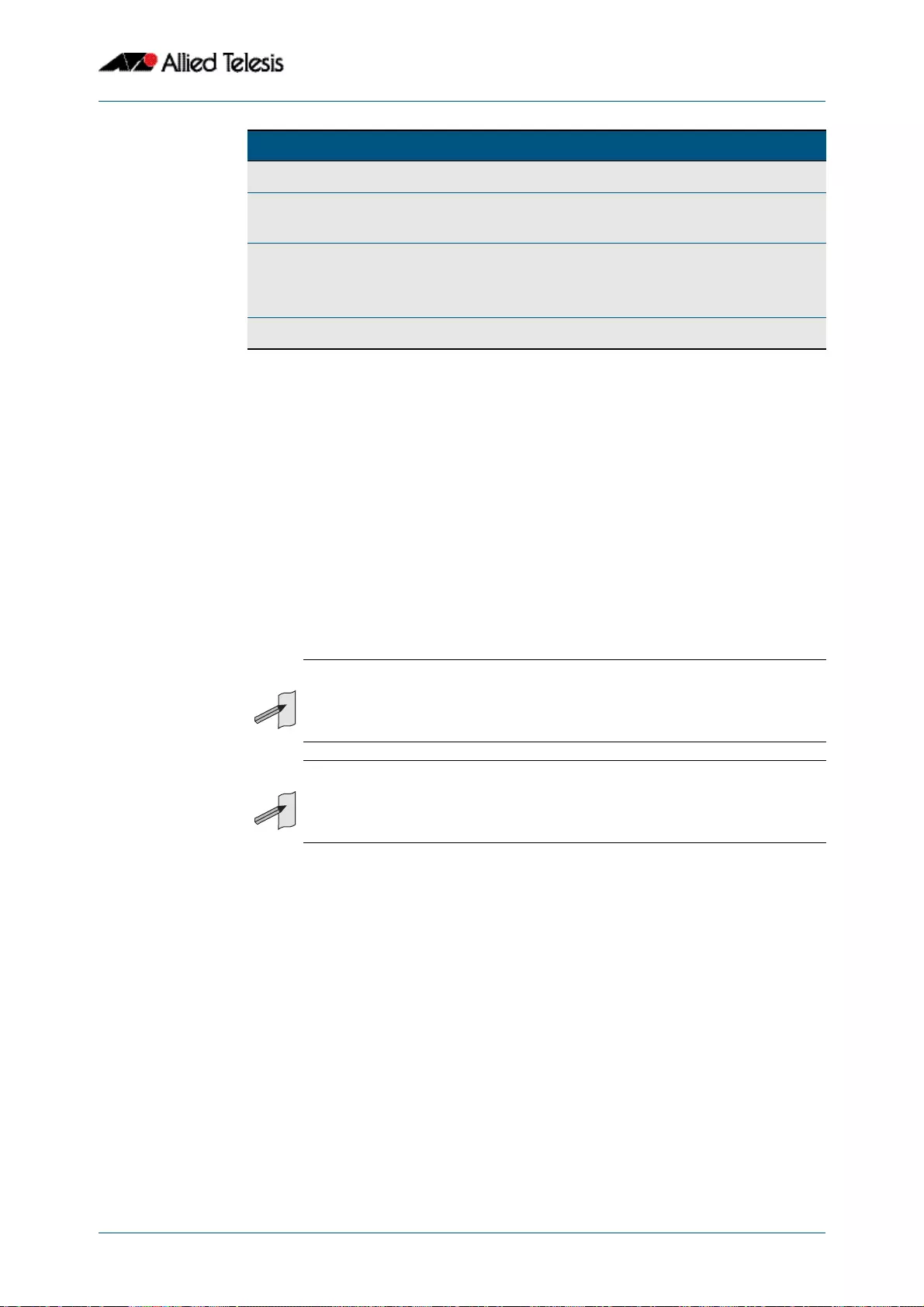
IPv4 Hardware Access Control List (ACL) Commands
Software Reference for GS900MX/MPX Series Switches
C613-50065-01 REV B AlliedWare PlusTM Operating System - Version 5.4.4E-1.x 37.27
Mode IPv4 Hardware ACL Configuration
Default Any traffic on an interface controlled by a hardware ACL that does not explicitly match a
filter is permitted.
Usage First create a named hardware access-list that applies the appropriate permit/deny
requirements. Then use the access-group command on page 37.4 to apply this access-list
to a specific port or range. Note that this command will apply the access-list only to
incoming data packets.
An ACL can be configured with multiple ACL filters using sequence numbers. If the
sequence number is omitted, the next available multiple of 10 will be used as the
sequence number for the new filter. A new ACL filter can be inserted into the middle of an
existing list by specifying the appropriate sequence number.
Examples To add an access-list filter entry to the access-list named my-list that will permit any
type of IP packet with a source address of 192.168.1.1 and any destination address,
use the commands:
any Matches any source MAC address.
<mac-destination-
address>
The destination host’s MAC address, entered in
HHHH.HHHH.HHHH format.
<mac-destination-
mask>
The destination host’s wildcard mask entered in
HHHH.HHHH.HHHH format.
where Hex FF = Ignore, and Hex 00 = Match.
any Matches any destination MAC address.
Parameter (cont.) Description (cont.)
Note The access control list being configured is selected by running the access-list
hardware (named) command on page 37.18. with the required access control
list number, or name, but with no further parameters selected.
Note Hardware ACLs will permit access unless explicitly denied by an ACL action.
awplus# configure terminal
awplus(config)# access-list hardware my-list
awplus(config-ip-hw-acl)# permit ip 192.168.1.1/32 any

IPv4 Hardware Access Control List (ACL) Commands
Software Reference for GS900MX/MPX Series Switches
37.28 AlliedWare PlusTM Operating System - Version 5.4.4E-1.x C613-50065-01 REV B
To add an access-list filter entry to the access-list named my-list that will permit any
type of IP packet with a source address of 192.168.1.1 and a MAC source address of
ffee.ddcc.bbaa with any IP and MAC destination address, use the commands:
To add an access-list filter entry to the access-list named my-list a filter that will deny all
IGMP packets (protocol 2) from the 192.168.0.0 network with sequence number 50 in
access-list, use the commands:
Related Commands access-list hardware (named)
show running-config
show access-list (IPv4 Hardware ACLs)
awplus# configure terminal
awplus(config)# access-list hardware my-list
awplus(config-ip-hw-acl)# permit ip 192.168.1.1/32 any mac
ffee.ddcc.bbaa any
awplus# configure terminal
awplus(config)# access-list hardware my-list
awplus(config-ip-hw-acl)# 50 deny proto 2 192.168.0.0/16 any

IPv4 Hardware Access Control List (ACL) Commands
Software Reference for GS900MX/MPX Series Switches
C613-50065-01 REV B AlliedWare PlusTM Operating System - Version 5.4.4E-1.x 37.29
(access-list hardware MAC filter)
Use this ACL filter to add a MAC filter entry to the current hardware access-list. The filter
will match on any IP packet that has the specified source and destination MAC addresses.
The parameter any may be specified if an address does not matter. If a sequence number
is specified, the new filter is inserted at the specified location. Otherwise, the new filter is
added at the end of the access-list.
The no variant of this command removes a MAC filter entry from the current hardware
access-list. You can specify the MAC filter entry for removal by entering either its sequence
number (e.g. no 10), or by entering its MAC filter profile without specifying its sequence
number.
Note that the sequence number can be found by running the show access-list (IPv4
Hardware ACLs) command on page 37.36.
Syntax [mac] [<sequence-number>] {deny|permit|send-to-cpu|copy-to-cpu|
copy-to-mirror} mac {<source-mac-address> <source-mac-mask>|any}
{<destination-mac-address> <destination-mac-mask>|any}
no {deny|permit|send-to-cpu|copy-to-cpu|copy-to-mirror}
mac {<source-mac-address> <source-mac-mask>|any}
{<destination-mac-address> <destination-mac-mask>|any}
no <sequence-number>
Parameter Description
<sequence-number><1-65535>
The sequence number for the filter entry of the
selected access control list.
deny Specify packets to reject.
permit Specify packets to accept.
send-to-cpu
copy-to-cpu Specify packets to copy to the CPU.
copy-to-mirror Specify packets to copy to the CPU.
mac MAC address.
<source-mac-address> The source MAC address of the packets.
Enter this in the format <HHHH.HHHH.HHHH>
where each H is a hexadecimal number that
represents a 4 bit binary number.
<source-mac-mask> The mask that will be applied to the source MAC
addresses.
Enter this in the format <HHHH.HHHH.HHHH>
where each H is a hexadecimal number that
represents a 4 bit binary number. For a mask, each
value will be either 0 or F.
Where Hex FF = Ignore, and Hex 00 = Match.
any Any source MAC host.
<destination-mac-
address>
The destination MAC address of the packets.
Enter this in the format <HHHH.HHHH.HHHH>
where each H is a hexadecimal number that
represents a 4 bit binary number.

IPv4 Hardware Access Control List (ACL) Commands
Software Reference for GS900MX/MPX Series Switches
37.30 AlliedWare PlusTM Operating System - Version 5.4.4E-1.x C613-50065-01 REV B
Mode IPv4 Hardware ACL Configuration
Default Any traffic on an interface controlled by a hardware ACL that does not explicitly match a
filter is permitted.
Usage First create a named hardware access-list that applies the appropriate permit/deny
requirements. Then use the access-group command on page 37.4 to apply this access-list
to a specific port or range. Note that this command will apply the access-list only to
incoming data packets.
An ACL can be configured with multiple ACL filters using sequence numbers. If the
sequence number is omitted, the next available multiple of 10 will be used as the
sequence number for the new filter. A new ACL filter can be inserted into the middle of an
existing list by specifying the appropriate sequence number
Examples To add an access-list filter entry to the access-list named my-list that will permit
packets with a source MAC address of 0000.00ab.1234 and any destination MAC
address, use the commands:
To remove an access-list filter entry that permit packets with a source MAC address of
0000.00ab.1234 and any destination MAC address, use the commands:
<destination-mac-mask> The mask that will be applied to the destination
MAC addresses.
Enter this in the format <HHHH.HHHH.HHHH>
where each H is a hexadecimal number that
represents a 4 bit binary number. For a mask, each
value will be either 0 or F.
Where Hex FF = Ignore, and Hex 00 = Match.
any Any destination MAC host.
Parameter(cont.) Description(cont.)
Note The access control list being configured is selected by running the access-list
hardware (named) command on page 37.18. with the required access control
list number, or name, but with no further parameters selected.
Note Hardware ACLs will permit access unless explicitly denied by an ACL action.
awplus# configure terminal
awplus(config)# access-list hardware my-list
awplus(config-ip-hw-acl)# permit mac 0000.00ab.1234
0000.0000.0000 any
awplus# configure terminal
awplus(config)# access-list hardware my-list
awplus(config-ip-hw-acl)# no permit mac 0000.00ab.1234
0000.0000.0000 any

IPv4 Hardware Access Control List (ACL) Commands
Software Reference for GS900MX/MPX Series Switches
37.32 AlliedWare PlusTM Operating System - Version 5.4.4E-1.x C613-50065-01 REV B
(access-list hardware TCP UDP filter)
Use this ACL filter to add a TCP or UDP filter entry to the current hardware access-list. The
filter will match on any TCP or UDP type packet that has the specified source and
destination IP addresses. The parameter any may be specified if an address does not
matter. If a sequence number is specified, the new filter is inserted at the specified
location. Otherwise, the new filter is added at the end of the access-list.
The no variant of this command removes a TCP or UDP filter entry from the current
hardware access-list. You can specify the TCP or UDP filter entry for removal by entering
either its sequence number (e.g. no 10), or by entering its TCP or UDP filter profile
without specifying its sequence number.
Note that the sequence number can be found by running the show access-list (IPv4
Hardware ACLs) command on page 37.36.
Syntax [tcp|udp] [<sequence-number>] {deny|permit|send-to-cpu|copy-to-cpu|
copy-to-mirror} {tcp|udp} [<source>|eq <sourceport>|
gt <sourceport>|lt <sourceport>|ne <sourceport>|
range <start-range> <end-range>] [<destination>|eq <destport>|
gt <destport>|lt <destport>|ne <destport>|
range <start-range><end-range>]
no {deny|permit|send-to-cpu|copy-to-cpu|copy-to-mirror} {tcp|udp}
[<source>|eq <sourceport>|gt <sourceport>|lt <sourceport>|
ne <sourceport>|range <start-range> <end-range>] [<destination>|
eq <destport>|gt <destport>|lt <destport>|ne <destport>|
range <start-range><end-range>]
no <sequence-number>
Parameter Description
<sequence-number><1-65535>
The sequence number for the filter entry of the
selected access control list.
deny Access-list rejects packets that match the source and
destination filtering specified with this command.
permit Access-list permits packets that match the source and
destination filtering specified with this command.
send-to-cpu Specify packets to send to the CPU.
copy-to-cpu Specify packets to copy to the CPU.
copy-to-mirror Specify packets to copy to the mirror port.
tcp TCP packets.
udp UDP packets.

IPv4 Hardware Access Control List (ACL) Commands
Software Reference for GS900MX/MPX Series Switches
C613-50065-01 REV B AlliedWare PlusTM Operating System - Version 5.4.4E-1.x 37.33
<source> The source address of the packets. You can specify a
single host, a subnet, or all sources. The following are
the valid formats for specifying the source:
any Matches any source IP address.
host <ip-addr> Matches a single source host
with the IP address given by
<ip-addr> in dotted decimal
notation.
<ip-addr>/
<prefix>
An IPv4 address, followed by a
forward slash, then the prefix
length. This matches any source
IP address within the specified
subnet.
<ip-addr>
<reverse-mask>
Alternatively, you can enter a
reverse mask in dotted decimal
format. For example, entering
192.168.1.1 0.0.0.255
is the same as entering
192.168.1.1/24.
<sourceport>The source TCP or UDP port number, specified as an
integer between 0 and 65535.
<destination>The destination address of the packets. You can specify
a single host, a subnet, or all destinations. The
following are the valid formats for specifying the
destination:
any Matches any destination IP
address.
host <ip-addr> Matches a single destination
host with the IP address given
by <ip-addr> in dotted
decimal notation.
<ip-addr>/
<prefix>
An IPv4 address, followed by a
forward slash, then the prefix
length. This matches any
destination IP address within
the specified subnet.
<ip-addr>
<reverse-mask>
Alternatively, you can enter a
reverse mask in dotted decimal
format. For example, entering
192.168.1.1 0.0.0.255
is the same as entering
192.168.1.1/24.
eq Equal to.
lt Less than.
gt Greater than.
Parameter(cont.) Description(cont.)

IPv4 Hardware Access Control List (ACL) Commands
Software Reference for GS900MX/MPX Series Switches
37.34 AlliedWare PlusTM Operating System - Version 5.4.4E-1.x C613-50065-01 REV B
Mode IPv4 Hardware ACL Configuration
Default Any traffic on an interface controlled by a hardware ACL that does not explicitly match a
filter is permitted.
Usage First create a named hardware access-list that applies the appropriate permit/deny
requirements. Then use the access-group command on page 37.4 to apply this access-list
to a specific port or range. Note that this command will apply the access-list only to
incoming data packets.
An ACL can be configured with multiple ACL filters using sequence numbers. If the
sequence number is omitted, the next available multiple of 10 will be used as the
sequence number for the new filter. A new ACL filter can be inserted into the middle of an
existing list by specifying the appropriate sequence number.
Example To add an access-list filter entry to access-list named my-hw-list that will permit TCP
packets with a destination address of 192.168.1.1, a destination port of 80, and any
source address, and source port, use the commands:
Related Commands access-list hardware (named)
show running-config
show access-list (IPv4 Hardware ACLs)
ne Not equal to.
<destport>The source TCP or UDP port number, specified as an
integer between 0 and 65535.
range Specify the range of port numbers between 0 and
65535.
<start-range>The source or destination port number at the start of
the range <0-65535>.
<end-range>The source or destination port number at the end of
the range <0-65535>.
Parameter(cont.) Description(cont.)
Note The access control list being configured is selected by running the access-list
hardware (named) command on page 37.18. with the required access control
list number, or name, but with no further parameters selected.
Note Hardware ACLs will permit access unless explicitly denied by an ACL action.
awplus# configure terminal
awplus(config)# access-list hardware my-hw-list
awplus(config-ip-hw-acl)# permit tcp any 192.168.1.1/32 eq 80

IPv4 Hardware Access Control List (ACL) Commands
Software Reference for GS900MX/MPX Series Switches
C613-50065-01 REV B AlliedWare PlusTM Operating System - Version 5.4.4E-1.x 37.35
commit (IPv4)
Use this command to commit the IPv4 ACL filter configuration entered at the console to
the hardware immediately without exiting the IPv4 Hardware ACL Configuration mode.
This command forces the associated hardware and software IPv4 ACLs to synchronize.
Syntax commit
Mode IPv4 Hardware ACL Configuration
Usage Normally, when an IPv4 hardware ACL is edited, the new configuration state of the IPv4
ACL is not written to hardware until you exit IPv4 Hardware ACL Configuration mode. By
entering this command you can ensure that the current state of a hardware access-list that
is being edited is written to hardware immediately.
Scripts typically do not include the exit command to exit configuration modes, potentially
leading to IPv4 ACL filters in hardware not being correctly updated. Using this commit
command in a configuration script after specifying an IPv4 hardware ACL filter ensures
that it is updated in the hardware immediately.
Example To update the hardware with the IPv4 ACL filter configuration, use the command:
Related Commands access-list hardware (named)
awplus# configure terminal
awplus(config)# access-list hardware my-hw-list
awplus(config-ip-hw-acl)# commit

IPv4 Hardware Access Control List (ACL) Commands
Software Reference for GS900MX/MPX Series Switches
37.36 AlliedWare PlusTM Operating System - Version 5.4.4E-1.x C613-50065-01 REV B
show access-list (IPv4 Hardware ACLs)
Use this command to display the specified access-list, or all access-lists if none have been
specified. Note that only defined access-lists are displayed. An error message is displayed
for an undefined access-list.
Syntax show access-list [<1-99>|<100-199>|<1300-1999>|<2000-2699>|
<3000-3699>|<4000-4499>|<access-list-name>]
Mode User Exec and Privileged Exec
Examples To show all access-lists configured on the switch:
To show the access-list with an ID of 20:
Parameter Description
<1-99> IP standard access-list.
<100-199> IP extended access-list.
<1300-1999> IP standard access-list (standard - expanded range).
<2000-2699> IP extended access-list (extended - expanded range).
<3000-3699> Hardware IP access-list.
<4000-4499> Hardware MAC access-list.
<access-list-name>IP named access-list.
awplus# show access-list
Standard IP access list 1
deny 172.16.2.0, wildcard bits 0.0.0.255
Standard IP access list 20
deny 192.168.10.0, wildcard bits 0.0.0.255
deny 192.168.12.0, wildcard bits 0.0.0.255
Hardware IP access list 3001
permit ip 192.168.20.0 255.255.255.0 any
Hardware IP access list 3020
permit tcp any 192.0.2.0/24
awplus#show access-list 20
awplus# show access-list 20
Standard IP access-list 20
deny 192.168.10.0, wildcard bits 0.0.0.255
deny 192.168.12.0, wildcard bits 0.0.0.255

IPv4 Hardware Access Control List (ACL) Commands
Software Reference for GS900MX/MPX Series Switches
C613-50065-01 REV B AlliedWare PlusTM Operating System - Version 5.4.4E-1.x 37.37
Note the below error message if you attempt to show an undefined access-list:
Related Commands access-list extended (named)
access-list (hardware MAC numbered)
access-list hardware (named)
awplus# show access-list 2
% Can't find access-list 2

IPv4 Hardware Access Control List (ACL) Commands
Software Reference for GS900MX/MPX Series Switches
37.38 AlliedWare PlusTM Operating System - Version 5.4.4E-1.x C613-50065-01 REV B
show interface access-group
Use this command to display the access groups attached to a port. If an access group is
specified, then the output only includes the ports that the specified access group is
attached to. If no access group is specified then this command displays all access groups
that are attached to the ports that are specified with <port-list>.
Note that access group is the term given for an access-list when it is applied to an
interface.
Syntax show interface <port-list> access-group [<3000-3699>|<4000-4699>]
Mode User Exec and Privileged Exec
Example To show all access-lists attached to port1.0.1, use the command:
Output Figure 37-1: Example output from the show interface access-group command
Related Commands access-group
Note This command will function on your switch in stand-alone mode. but is not
supported when the device forms part of a VCStack.
Parameter Description
<port-list> Specify the ports to display information. A port-list can be
either:
■a switch port (e.g. port1.0.6) a static channel group (e.g.
sa2) or a dynamic (LACP) channel group (e.g. po2)
■a continuous range of ports separated by a hyphen,
e.g. port1.0.1-1.0.6 or port1.0.1-port1.0.6 or po1-po2
■a comma-separated list of ports and port ranges,
e.g. port1.0.1,port1.0.3-1.0.6. Do not mix switch ports,
static channel groups, and LACP channel groups in the
same list.
access group Select the access group whose details you want to show.
<3000-3699> Specifies the Hardware IP access-list.
<4000-4699> Specifies the Hardware MAC access-list.
awplus# show interface port1.0.1 access-group
Interface port1.0.1
access-group 3000
access-group 3002
access-group 3001

Software Reference for GS900MX/MPX Series Switches
C613-50065-01 REV B AlliedWare PlusTM Operating System - Version 5.4.4E-1.x 38.1
Chapter 38: IPv4 Software Access Control List
(ACL) Commands
Introduction ........................................................................................................................................ 38.2
IPv4 Software Access List Commands and Prompts ............................................................ 38.3
Command List .................................................................................................................................... 38.4
access-list extended (named) ....................................................................................................... 38.4
access-list (extended numbered)..............................................................................................38.12
(access-list extended ICMP filter)...............................................................................................38.15
(access-list extended IP filter) .....................................................................................................38.17
(access-list extended IP protocol filter) ...................................................................................38.20
(access-list extended TCP UDP filter) .......................................................................................38.24
access-list standard (named) ......................................................................................................38.27
access-list (standard numbered) ...............................................................................................38.29
(access-list standard named filter) ............................................................................................38.31
(access-list standard numbered filter) .....................................................................................38.33
clear ip prefix-list .............................................................................................................................38.35
maximum-access-list .....................................................................................................................38.36
show access-list (IPv4 Software ACLs) .....................................................................................38.37
show ip access-list...........................................................................................................................38.39

IPv4 Software Access Control List (ACL) Commands
Software Reference for GS900MX/MPX Series Switches
38.2 AlliedWare PlusTM Operating System - Version 5.4.4E-1.x C613-50065-01 REV B
Introduction
This chapter provides an alphabetical reference for the IPv4 Software Access Control List
(ACL) commands, and contains detailed command information and command examples
about IPv4 software ACLs as applied to Routing and Multicasting, which are not applied to
interfaces.
See all relevant Routing commands and configurations in “IPv4 Software Access Control
List (ACL) Commands” and all relevant Multicast commands and configurations in
“Multicast Applications”.
To apply ACLs to an LACP channel group, apply it to all the individual switch ports in the
channel group. To apply ACLs to a static channel group, apply it to the static channel
group itself. For more information on link aggregation see Chapter 20, Link Aggregation
Introduction and Configuration, and Chapter 21, Link Aggregation Commands.
Note See Chapter 36, Access Control Lists Introduction for descriptions of ACLs,
and for further information about rules when applying ACLs see the ACL Rules
section.
See ACL Filter Sequence Numbers and ACL Filter Sequence Number
Behavior sections in Chapter 36, Access Control Lists Introduction about
ACL Filters.
Note Text in parenthesis in command names indicates usage not keyword entry. For
example, access-list hardware (named) indicates named IPv4 hardware ACLs
entered as access-list hardware <name> where <name> is a
placeholder not a keyword.
Note Parenthesis surrounding ACL filters indicates the type of ACL filter not the
keyword entry in the CLI, such as (access-list standard numbered filter)
represents command entry in the format shown in the syntax [<sequence-
number>] {deny|permit} {<source>|host <host-address>|
any}.
Note Software ACLs will deny access unless explicitly permitted by an ACL action.

IPv4 Software Access Control List (ACL) Commands
Software Reference for GS900MX/MPX Series Switches
C613-50065-01 REV B AlliedWare PlusTM Operating System - Version 5.4.4E-1.x 38.3
IPv4 Software Access List Commands and
Prompts
Many of the ACL commands operate from sub-modes that are specific to particular ACL
types. The following table shows the CLI prompts at which ACL commands are entered.
Ta b l e 3 8 - 1 : IPv4 Software Access List Commands and Prompts
Command Name Command Mode Prompt
show ip access-list Privileged Exec awplus#
access-group Global Configuration awplus(config)#
access-list (extended numbered) Global Configuration awplus(config)#
access-list standard (named) Global Configuration awplus(config)#
access-list (standard numbered) Global Configuration awplus(config)#
maximum-access-list Global Configuration awplus(config)#
(access-list extended ICMP filter) IPv4 Extended ACL
Configuration awplus(config-ip-ext-acl)#
(access-list extended IP filter) IPv4 Extended ACL
Configuration awplus(config-ip-ext-acl)#
(access-list extended IP protocol
filter) IPv4 Extended ACL
Configuration awplus(config-ip-ext-acl)#
(access-list extended TCP UDP
filter)
IPv4 Extended ACL
Configuration awplus(config-ip-ext-acl)#
(access-list standard named filter) IPv4 Standard ACL Configuration awplus(config-ip-std-acl)#
(access-list standard numbered
filter)
IPv4 Standard ACL Configuration awplus(config-ip-std-acl)#

IPv4 Software Access Control List (ACL) Commands
Software Reference for GS900MX/MPX Series Switches
38.4 AlliedWare PlusTM Operating System - Version 5.4.4E-1.x C613-50065-01 REV B
Command List
access-list extended (named)
This command configures an extended named access-list that permits or denies packets
from specific source and destination IP addresses. You can either create an extended
named ACL together with an ACL filter entry in the Global Configuration mode, or you can
use the IPv4 Extended ACL Configuration mode for sequenced ACL filter entry after
entering a list name.
The no variant of this command removes a specified extended named access-list.
Syntax [list-name] access-list extended <list-name>
no access-list extended <list-name>
Syntax [icmp] access-list extended <list-name>{deny|permit}
icmp <source><destination> [icmp-type <type-number>] [log]
no access-list extended <list-name>{deny|permit}
icmp <source><destination> [icmp-type <type-number>] [log]
Parameter Description
<list-name>A user-defined name for the access-list
Table 38-2: Parameters in the access-list extended (named) command - icmp
Parameter Description
<list-name>A user-defined name for the access-list.
deny The access-list rejects packets that match the type, source, and
destination filtering specified with this command.
permit The access-list permits packets that match the type, source, and
destination filtering specified with this command.
icmp The access-list matches only ICMP packets.
icmp-type Matches only a specified type of ICMP messages. This is valid only
when the filtering is set to match ICMP packets.

IPv4 Software Access Control List (ACL) Commands
Software Reference for GS900MX/MPX Series Switches
C613-50065-01 REV B AlliedWare PlusTM Operating System - Version 5.4.4E-1.x 38.5
<source> The source address of the packets. You can specify a single host, a
subnet, or all sources. The following are the valid formats for
specifying the source:
any Matches any source IP address.
host <ip-addr> Matches a single source host with the
IP address given by <ip-addr> in
dotted decimal notation.
<ip-addr>/
<prefix>
An IPv4 address, followed by a forward
slash, then the prefix length. This
matches any source IP address within
the specified subnet.
<ip-addr>
<reverse-mask>
Alternatively, you can enter a reverse
mask in dotted decimal format. For
example, entering 192.168.1.1
0.0.0.255 is the same as entering
192.168.1.1/24.
<destination>The destination address of the packets. You can specify a single
host, a subnet, or all destinations. The following are the valid
formats for specifying the destination:
any Matches any destination IP address.
host <ip-addr> Matches a single destination host with
the IP address given by <ip-addr> in
dotted decimal notation.
<ip-addr>/
<prefix>
An IPv4 address, followed by a forward
slash, then the prefix length. This
matches any destination IP address
within the specified subnet.
<ip-addr>
<reverse-mask>
Alternatively, you can enter a reverse
mask in dotted decimal format. For
example, entering 192.168.1.1
0.0.0.255 is the same as entering
192.168.1.1/24.
Table 38-2: Parameters in the access-list extended (named) command - icmp (cont.)
Parameter(cont.) Description(cont.)

IPv4 Software Access Control List (ACL) Commands
Software Reference for GS900MX/MPX Series Switches
38.6 AlliedWare PlusTM Operating System - Version 5.4.4E-1.x C613-50065-01 REV B
Syntax [tcp|udp] access-list extended <list-name> {deny|permit} {tcp|udp} <source>
[eq <sourceport>|lt <sourceport>|gt <sourceport>|ne <sourceport>]
<destination> [eq <destport>|lt <destport>|gt <destport>|
ne <destport>] [log]
no access-list extended <list-name> {deny|permit} {tcp|udp} <source>
[eq <sourceport>|lt <sourceport>|gt <sourceport>|ne <sourceport>]
<destination> [eq <destport> |lt <destport>|gt <destport>|ne
<destport>][log]
<type-number>The ICMP type, as defined in RFC792 and RFC950. Specify one of
the following integers to create a filter for the ICMP message type:
0Echo replies.
3Destination unreachable messages.
4Source quench messages.
5Redirect (change route) messages.
8Echo requests.
11 Time exceeded messages.
12 Parameter problem messages.
13 Timestamp requests.
14 Timestamp replies.
15 Information requests.
16 Information replies.
17 Address mask requests.
18 Address mask replies.
log Logs the results.
Table 38-2: Parameters in the access-list extended (named) command - icmp (cont.)
Parameter(cont.) Description(cont.)
Table 38-3: Parameters in the access-list extended (named) command - tcp|udp
Parameter Description
<list-name>A user-defined name for the access-list.
deny The access-list rejects packets that match the type, source, and
destination filtering specified with this command.
permit The access-list permits packets that match the type, source, and
destination filtering specified with this command.
tcp The access-list matches only TCP packets.
udp The access-list matches only UDP packets.

IPv4 Software Access Control List (ACL) Commands
Software Reference for GS900MX/MPX Series Switches
C613-50065-01 REV B AlliedWare PlusTM Operating System - Version 5.4.4E-1.x 38.7
<source> The source address of the packets. You can specify a single host, a
subnet, or all sources. The following are the valid formats for
specifying the source:
any Matches any source IP address.
host <ip-addr> Matches a single source host with the
IP address given by <ip-addr> in
dotted decimal notation.
<ip-addr>/
<prefix>
An IPv4 address, followed by a forward
slash, then the prefix length. This
matches any source IP address within
the specified subnet.
<ip-addr>
<reverse-mask>
Alternatively, you can enter a reverse
mask in dotted decimal format. For
example, entering 192.168.1.1
0.0.0.255 is the same as entering
192.168.1.1/24.
<destination>The destination address of the packets. You can specify a single
host, a subnet, or all destinations. The following are the valid
formats for specifying the destination:
any Matches any destination IP address.
host <ip-addr> Matches a single destination host with
the IP address given by <ip-addr> in
dotted decimal notation.
<ip-addr>/
<prefix>
An IPv4 address, followed by a forward
slash, then the prefix length. This
matches any destination IP address
within the specified subnet.
<ip-addr>
<reverse-mask>
Alternatively, you can enter a reverse
mask in dotted decimal format. For
example, entering 192.168.1.1
0.0.0.255 is the same as entering
192.168.1.1/24.
<sourceport>The source port number, specified as an integer between 0 and
65535.
<destport>The destination port number, specified as an integer between 0
and 65535.
eq Matches port numbers equal to the port number specified
immediately after this parameter.
lt Matches port numbers less than the port number specified
immediately after this parameter.
gt Matches port numbers greater than the port number specified
immediately after this parameter.
Table 38-3: Parameters in the access-list extended (named) command - tcp|udp
Parameter(cont.) Description(cont.)

IPv4 Software Access Control List (ACL) Commands
Software Reference for GS900MX/MPX Series Switches
38.8 AlliedWare PlusTM Operating System - Version 5.4.4E-1.x C613-50065-01 REV B
Syntax [proto|any|
ip]
access-list extended <list-name> {deny|permit} {proto <ip-protocol>|
any|ip} {<source>} {<destination>} [log]
no access-list extended <list-name>{deny|permit}
{proto <ip-protocol>|any|ip}{<source>}{<destination>}[log]
ne Matches port numbers not equal to the port number specified
immediately after this parameter.
log Log the results.
Table 38-3: Parameters in the access-list extended (named) command - tcp|udp
Parameter(cont.) Description(cont.)
Table 38-4: Parameters in the access-list extended (named) command - proto|ip|any
Parameter Description
<list-name>A user-defined name for the access-list.
deny The access-list rejects packets that match the type, source, and
destination filtering specified with this command.
permit The access-list permits packets that match the type, source, and
destination filtering specified with this command.
proto Matches only a specified type of IP Protocol.
any The access-list matches any type of IP packet.
ip The access-list matches only IP packets.
<source> The source address of the packets. You can specify a single host, a
subnet, or all sources. The following are the valid formats for
specifying the source:
any Matches any source IP address.
host <ip-addr> Matches a single source host with the IP
address given by <ip-addr> in dotted
decimal notation.
<ip-addr>/
<prefix>
An IPv4 address, followed by a forward
slash, then the prefix length. This matches
any source IP address within the specified
subnet.
<ip-addr>
<reverse-mask>
Alternatively, you can enter a reverse mask
in dotted decimal format. For example,
entering 192.168.1.1 0.0.0.255 is
the same as entering 192.168.1.1/24.

IPv4 Software Access Control List (ACL) Commands
Software Reference for GS900MX/MPX Series Switches
C613-50065-01 REV B AlliedWare PlusTM Operating System - Version 5.4.4E-1.x 38.9
<destination>The destination address of the packets. You can specify a single
host, a subnet, or all destinations. The following are the valid
formats for specifying the destination:
any Matches any destination IP address.
host <ip-addr> Matches a single destination host with the
IP address given by <ip-addr> in dotted
decimal notation.
<ip-addr>/
<prefix>
An IPv4 address, followed by a forward
slash, then the prefix length. This matches
any destination IP address within the
specified subnet.
<ip-addr>
<reverse-mask>
Alternatively, you can enter a reverse mask
in dotted decimal format. For example,
entering 192.168.1.1 0.0.0.255 is
the same as entering 192.168.1.1/24.
log Logs the results.
<ip-protocol> The IP protocol number, as defined by IANA (Internet Assigned
Numbers Authority www.iana.org/assignments/protocol-
numbers)
Protocol Number Protocol Description [RFC Reference]
1Internet Control Message [RFC792]
2Internet Group Management [RFC1112]
3Gateway-to-Gateway [RFC823]
4IP in IP [RFC2003]
5Stream [RFC1190] [RFC1819]
6TCP (Transmission Control Protocol)
[RFC793]
8EGP (Exterior Gateway Protocol) [RFC888]
9IGP (Interior Gateway Protocol) [IANA]
11 Network Voice Protocol [RFC741]
17 UDP (User Datagram Protocol) [RFC768]
20 Host monitoring [RFC869]
27 RDP (Reliable Data Protocol) [RFC908]
28 IRTP (Internet Reliable Transaction Protocol)
[RFC938]
29 ISO-TP4 (ISO Transport Protocol Class 4)
[RFC905]
30 Bulk Data Transfer Protocol [RFC969]
Table 38-4: Parameters in the access-list extended (named) command - proto|ip|any
Parameter (cont.) Description (cont.)

IPv4 Software Access Control List (ACL) Commands
Software Reference for GS900MX/MPX Series Switches
38.10 AlliedWare PlusTM Operating System - Version 5.4.4E-1.x C613-50065-01 REV B
Mode Global Configuration
Default Any traffic controlled by a software ACL that does not explicitly match a filter is denied.
<ip-protocol>
(cont.)
Protocol Number Protocol Description [RFC Reference]
33 Datagram Congestion Control Protocol
[RFC4340]
48 DSR (Dynamic Source Routing Protocol)
[RFC4728]
50 ESP (Encap Security Payload) [RFC2406]
51 AH (Authentication Header) [RFC2402]
54 NARP (NBMA Address Resolution Protocol)
[RFC1735]
88 EIGRP (Enhanced Interior Gateway Routing
Protocol)
89 OSPFIGP [RFC1583]
97 Ethernet-within-IP Encapsulation / RFC3378
98 Encapsulation Header / RFC1241
108 IP Payload Compression Protocol / RFC2393
112 Virtual Router Redundancy Protocol /
RFC3768
134 RSVP-E2E-IGNORE / RFC3175
135 Mobility Header / RFC3775
136 UDPLite / RFC3828
137 MPLS-in-IP / RFC4023
138 MANET Protocols / RFC-ietf-manet-iana-
07.txt
139-252 Unassigned / IANA
253 Use for experimentation and testing /
RFC3692
254 Use for experimentation and testing /
RFC3692
255 Reserved / IANA
Table 38-4: Parameters in the access-list extended (named) command - proto|ip|any
Parameter (cont.) Description (cont.)

IPv4 Software Access Control List (ACL) Commands
Software Reference for GS900MX/MPX Series Switches
C613-50065-01 REV B AlliedWare PlusTM Operating System - Version 5.4.4E-1.x 38.11
Usage Use this command when configuring access-list for filtering IP software packets. To enable
backwards compatibility you can either create access-lists from within this command, or
you can enter access-list followed by only the number. This latter method moves you to
the IPv4 Extended ACL Configuration mode for the selected access-list number, and from
here you can configure your access-lists by using the commands (access-list extended
ICMP filter), (access-list extended IP filter), and (access-list extended IP protocol
filter).
The table “IPv4 Software Access List Commands and Prompts” on page 38.3 shows
the prompts at which ACL commands are entered. See the relevant links shown for the
Related Commands.
Note that packets must match both the source and the destination details.
Examples You can enter the extended named ACL in the Global Configuration mode together with
the ACL filter entry on the same line, as shown below:
Alternatively, you can enter the extended named ACL in Global Configuration mode
before specifying the ACL filter entry in the IPv4 Extended ACL Configuration mode, as
shown below:
Related Commands (access-list extended ICMP filter)
(access-list extended IP filter)
(access-list extended TCP UDP filter)
show running-config
show ip access-list
Note Software ACLs will deny access unless explicitly permitted by an ACL action.
awplus# configure terminal
awplus(config)# access-list extended TK deny tcp 2.2.2.3/24 eq
14 3.3.3.4/24 eq 12 log
awplus# configure terminal
awplus(config)# access-list extended TK
awplus(config-ip-ext-acl)# deny tcp 2.2.2.3/24 eq 14 3.3.3.4/24
eq 12 log

IPv4 Software Access Control List (ACL) Commands
Software Reference for GS900MX/MPX Series Switches
38.12 AlliedWare PlusTM Operating System - Version 5.4.4E-1.x C613-50065-01 REV B
access-list (extended numbered)
This command configures an extended numbered access-list that permits or denies
packets from specific source and destination IP addresses. You can either create an
extended numbered ACL together with an ACL filter entry in the Global Configuration
mode, or you can use the IPv4 Extended ACL Configuration mode for sequenced ACL filter
entry after entering a list number.
The no variant of this command removes a specified extended named access-list.
Syntax [list-number] access-list {<100-199>|<2000-2699>}
no access-list {<100-199>|<2000-2699>}
Syntax [deny|
permit]
access-list {<100-199>|<2000-2699>} {deny|permit} ip <source>
<destination>
no access-list {<100-199>|<2000-2699>}{deny|permit} ip <source>
<destination>
Parameter Description
<100-199>IP extended access-list.
<2000-2699>IP extended access-list (expanded range).
Parameter Description
<100-199>IP extended access-list.
<2000-2699>IP extended access-list (expanded range).
deny Access-list rejects packets that match the source and destination
filtering specified with this command.
permit Access-list permits packets that match the source and destination
filtering specified with this command.
<source>The source address of the packets. You can specify a single host, a
subnet, or all sources. The following are the valid formats for
specifying the source:
any Matches any source IP address.
host <ip-addr> Matches a single source host with the IP
address given by <ip-addr> in dotted
decimal notation.
<ip-addr>
<reverse-mask>
An IPv4 address, followed by a reverse
mask in dotted decimal format. For
example, entering 192.168.1.1
0.0.0.255 is the same as entering
192.168.1.1/24. This matches any
source IP address within the specified
subnet.
<destination>The destination address of the packets. You can specify a single
host, a subnet, or all destinations. The following are the valid
formats for specifying the destination:

IPv4 Software Access Control List (ACL) Commands
Software Reference for GS900MX/MPX Series Switches
C613-50065-01 REV B AlliedWare PlusTM Operating System - Version 5.4.4E-1.x 38.13
Mode Global Configuration
Default Any traffic controlled by a software ACL that does not explicitly match a filter is denied.
Usage Use this command when configuring access-list for filtering IP software packets. To enable
backwards compatibility you can either create access-lists from within this command, or
you can enter access-list followed by only the number. This latter method moves you to
the IPv4 Extended ACL Configuration mode for the selected access-list number, and from
here you can configure your access-lists by using the commands (access-list extended
ICMP filter), (access-list extended IP filter), and (access-list extended IP protocol
filter).
The table “IPv4 Software Access List Commands and Prompts” on page 38.3 shows
the prompts at which ACL commands are entered. See the relevant links shown for the
Related Commands.
Note that packets must match both the source and the destination details.
Examples You can enter the extended named ACL in the Global Configuration mode together with
the ACL filter entry on the same line, as in previous software releases as shown below:
Alternatively, you can enter the extended named ACL in Global Configuration mode
before specifying the ACL filter entry in the IPv4 Extended ACL Configuration mode, as
shown below:
any Matches any destination IP address.
host <ip-addr> Matches a single destination host with the
IP address given by <ip-addr> in dotted
decimal notation.
<ip-addr>
<reverse-mask>
An IPv4 address, followed by a reverse
mask in dotted decimal format. For
example, entering 192.168.1.1
0.0.0.255 is the same as entering
192.168.1.1/24. This matches any
destination IP address within the specified
subnet.
Parameter (cont.) Description (cont.)
Note Software ACLs will deny access unless explicitly permitted by an ACL action.
awplus# configure terminal
awplus(config)# access-list 101 deny ip 172.16.10.0 0.0.0.255
any
awplus# configure terminal
awplus(config)# access-list 101
awplus(config-ip-ext-acl)# deny ip 172.16.10.0 0.0.0.255 any

IPv4 Software Access Control List (ACL) Commands
Software Reference for GS900MX/MPX Series Switches
38.14 AlliedWare PlusTM Operating System - Version 5.4.4E-1.x C613-50065-01 REV B
Related Commands (access-list extended ICMP filter)
(access-list extended IP filter)
(access-list extended TCP UDP filter)
show running-config
show ip access-list

IPv4 Software Access Control List (ACL) Commands
Software Reference for GS900MX/MPX Series Switches
C613-50065-01 REV B AlliedWare PlusTM Operating System - Version 5.4.4E-1.x 38.15
(access-list extended ICMP filter)
Use this ACL filter to add a new ICMP filter entry to the current extended access-list. If the
sequence number is specified, the new filter is inserted at the specified location.
Otherwise, the new filter is added at the end of the access-list.
The no variant of this command removes an ICMP filter entry from the current extended
access-list. You can specify the ICMP filter entry for removal by entering either its sequence
number (e.g. no 10), or by entering its ICMP filter profile without specifying its sequence
number.
Note that the sequence number can be found by running the show access-list (IPv4
Software ACLs) command.
Syntax [icmp] [<sequence-number>] {deny|permit} icmp <source> <destination>
[icmp-type <icmp-value>] [log]
no {deny|permit} icmp <source> <destination>[icmp-type <icmp-value>]
[log]
no <sequence-number>
Parameter Description
<sequence-
number>
<1-65535>
The sequence number for the filter entry of the selected access
control list.
deny Access-list rejects packets that match the source and destination
filtering specified with this command.
permit Access-list permits packets that match the source and destination
filtering specified with this command.
icmp ICMP packet type.
<source>The source address of the packets. You can specify a single host, a
subnet, or all sources. The following are the valid formats for
specifying the source:
<ip-addr>/
<prefix>
An IPv4 address, followed by a
forward slash, then the prefix length.
This matches any source IP address
within the specified subnet.
any Matches any source IP address.
<destination>The destination address of the packets. You can specify a single
host, a subnet, or all destinations. The following are the valid
formats for specifying the destination:
<ip-addr>/
<prefix>
An IPv4 address, followed by a
forward slash, then the prefix length.
This matches any destination IP
address within the specified subnet.
any Matches any destination IP address.
icmp-type The ICMP type.

IPv4 Software Access Control List (ACL) Commands
Software Reference for GS900MX/MPX Series Switches
38.16 AlliedWare PlusTM Operating System - Version 5.4.4E-1.x C613-50065-01 REV B
Mode IPv4 Extended ACL Configuration
Default Any traffic controlled by a software ACL that does not explicitly match a filter is denied.
Usage An ACL can be configured with multiple ACL filters using sequence numbers. If the
sequence number is omitted, the next available multiple of 10 will be used as the
sequence number for the new filter. A new ACL filter can be inserted into the middle of an
existing list by specifying the appropriate sequence number.
Examples To add a new entry in access-list called my-list that will reject ICMP packets from
10.0.0.1 to 192.168.1.1, use the commands:
Use the following commands to add a new filter at sequence number 5 position of the
access-list called my-list. The filter will accept the ICMP type 8 packets from
10.1.1.0/24 network, to 192.168.1.0 network:
Related Commands access-group
show running-config
show ip access-list
<icmp-value>The value of the ICMP
type.
log Log the results.
Parameter (cont.) Description (cont.)
Note The access control list being configured is selected by running the access-list
(extended numbered) command or the access-list extended (named)
command, with the required access control list number, or name - but with no
further parameters selected.
Note Software ACLs will deny access unless explicitly permitted by an ACL action.
awplus# configure terminal
awplus(config)# access-list extended my-list
awplus(config-ip-ext-acl)# deny icmp 10.0.0.1/32 192.168.1.1/32
awplus# configure terminal
awplus(config)# access-list extended my-list
awplus(config-ip-ext-acl)# 5 permit icmp 10.1.1.0/24
192.168.1.0/24 icmp-type 8

IPv4 Software Access Control List (ACL) Commands
Software Reference for GS900MX/MPX Series Switches
C613-50065-01 REV B AlliedWare PlusTM Operating System - Version 5.4.4E-1.x 38.17
(access-list extended IP filter)
Use this ACL filter to add a new IP filter entry to the current extended access-list. If the
sequence number is specified, the new filter is inserted at the specified location.
Otherwise, the new filter is added at the end of the access-list.
The no variant of this command removes an IP filter entry from the current extended
access-list. You can specify the IP filter entry for removal by entering either its sequence
number (e.g. no 10), or by entering its IP filter profile without specifying its sequence
number.
Note that the sequence number can be found by running the show access-list (IPv4
Software ACLs) command.
Syntax [ip] [<sequence-number>] {deny|permit} ip <source> <destination>
no {deny|permit} ip <source> <destination>
no <sequence-number>
Parameter Description
<sequence-
number>
<1-65535>
The sequence number for the filter entry of the selected access
control list.
deny Access-list rejects packets that match the source and destination
filtering specified with this command.
permit Access-list permits packets that match the source and destination
filtering specified with this command.
<source> The source address of the packets. You can specify a single host, a
subnet, or all sources. The following are the valid formats for
specifying the source:
any Matches any source IP address.
host <ip-addr> Matches a single source host with the IP
address given by <ip-addr> in dotted
decimal notation.
<ip-addr>
<reverse-mask>
Alternatively, enter an IPv4 address
followed by a reverse mask in dotted
decimal format. For example, enter
192.168.1.1 0.0.0.255.
<destination>The destination address of the packets. You can specify a single
host, a subnet, or all destinations. The following are the valid
formats for specifying the destination:
any Matches any destination IP address.
host <ip-addr> Matches a single destination host with the
IP address given by <ip-addr> in dotted
decimal notation.
<ip-addr>
<reverse-mask>
Alternatively, enter an IPv4 address
followed by a reverse mask in dotted
decimal format. For example, enter
192.168.1.1 0.0.0.255.

IPv4 Software Access Control List (ACL) Commands
Software Reference for GS900MX/MPX Series Switches
38.18 AlliedWare PlusTM Operating System - Version 5.4.4E-1.x C613-50065-01 REV B
Mode Extended ACL Configuration
Default Any traffic controlled by a software ACL that does not explicitly match a filter is denied.
Usage An ACL can be configured with multiple ACL filters using sequence numbers. If the
sequence number is omitted, the next available multiple of 10 will be used as the
sequence number for the new filter. A new ACL filter can be inserted into the middle of an
existing list by specifying the appropriate sequence number.
Example 1
[list-number]
First use the following commands to enter the IPv4 Extended ACL Configuration mode
and define a numbered extended access-list 101:
Then use the following commands to add a new entry to the numbered extended access-
list 101 that will reject packets from 10.0.0.1 to 192.168.1.1:
Example 2
[list-name]
First use the following commands to enter the IPv4 Extended ACL Configuration mode
and define a named access-list called my-acl:
Then use the following commands to add a new entry to the named access-list my-acl
that will reject packets from 10.0.0.1 to 192.168.1.1:
Note The access control list being configured is selected by running the access-list
(extended numbered) command or the access-list extended (named)
command, with the required access control list number, or name - but with no
further parameters selected.
Note Software ACLs will deny access unless explicitly permitted by an ACL action.
awplus# configure terminal
awplus(config)# access-list 101
awplus(config-ip-ext-acl)#
awplus(config-ip-ext-acl)# deny ip host 10.0.0.1 host
192.168.1.1
awplus(config-ip-ext-acl)# 20 permit ip any any
awplus# configure terminal
awplus(config)# access-list extended my-acl
awplus(config-ip-ext-acl)#
awplus(config-ip-ext-acl)# deny ip host 10.0.0.1 host
192.168.1.1
awplus(config-ip-ext-acl)# 20 permit ip any any

IPv4 Software Access Control List (ACL) Commands
Software Reference for GS900MX/MPX Series Switches
C613-50065-01 REV B AlliedWare PlusTM Operating System - Version 5.4.4E-1.x 38.19
Example 3
[list-number]
Use the following commands to remove the access-list filter entry with sequence number
20 from extended numbered access-list 101.
Example 4
[list-name]
Use the following commands to remove the access-list filter entry with sequence number
20 from extended named access-list my-acl:
Related Commands access-list extended (named)
access-list (extended numbered)
show running-config
show ip access-list
awplus# configure terminal
awplus(config)# access-list 101
awplus(config-ip-ext-acl)# no 20
awplus# configure terminal
awplus(config)# access-list extended my-acl
awplus(config-ip-ext-acl)# no 20

IPv4 Software Access Control List (ACL) Commands
Software Reference for GS900MX/MPX Series Switches
38.20 AlliedWare PlusTM Operating System - Version 5.4.4E-1.x C613-50065-01 REV B
(access-list extended IP protocol filter)
Use this ACL filter to add a new IP protocol type filter entry to the current extended access-
list. If the sequence number is specified, the new filter is inserted at the specified location.
Otherwise, the new filter is added at the end of the access-list.
The no variant of this command removes an IP protocol filter entry from the current
extended access-list. You can specify the IP filter entry for removal by entering either its
sequence number (e.g. no 10), or by entering its IP filter profile without specifying its
sequence number.
Note that the sequence number can be found by running the show access-list (IPv4
Software ACLs) command.
Syntax [proto] [<sequence-number>] {deny|permit} proto <ip-protocol> <source>
<destination> [log]
no {deny|permit} proto <ip-protocol> <source> <destination> [log]
no <sequence-number>
Parameter Description
<sequence-
number>
<1-65535>
The sequence number for the filter entry of the selected access
control list.
deny Access-list rejects packets that match the source and destination
filtering specified with this command.
permit Access-list permits packets that match the source and destination
filtering specified with this command.
proto
<ip-protocol>
The IP Protocol type specified by its protocol number <1-255>.
<ip-protocol>The IP protocol number, as defined by IANA (Internet Assigned
Numbers Authority www.iana.org/assignments/protocol-
numbers).
Protocol Number Protocol Description [RFC Reference]
1Internet Control Message [RFC792]
2Internet Group Management [RFC1112]
3Gateway-to-Gateway [RFC823]
4IP in IP [RFC2003]
5Stream [RFC1190] [RFC1819]
6TCP (Transmission Control Protocol)
[RFC793]
8EGP (Exterior Gateway Protocol) [RFC888]
9IGP (Interior Gateway Protocol) [IANA]
11 Network Voice Protocol [RFC741]

IPv4 Software Access Control List (ACL) Commands
Software Reference for GS900MX/MPX Series Switches
C613-50065-01 REV B AlliedWare PlusTM Operating System - Version 5.4.4E-1.x 38.21
<ip-protocol>
(cont.)
17 UDP (User Datagram Protocol) [RFC768]
20 Host monitoring [RFC869]
27 RDP (Reliable Data Protocol) [RFC908]
28 IRTP (Internet Reliable Transaction
Protocol) [RFC938]
29 ISO-TP4 (ISO Transport Protocol Class 4)
[RFC905]
30 Bulk Data Transfer Protocol [RFC969]
33 DCCP (Datagram Congestion Control
Protocol) [RFC4340]
48 DSR (Dynamic Source Routing Protocol)
[RFC4728]
50 ESP (Encap Security Payload) [RFC2406]
51 AH (Authentication Header) [RFC2402]
54 NARP (NBMA Address Resolution Protocol)
[RFC1735]
88 EIGRP (Enhanced Interior Gateway Routing
Protocol)
89 OSPFIGP [RFC1583]
97 Ethernet-within-IP Encapsulation /
RFC3378
98 Encapsulation Header / RFC1241
108 IP Payload Compression Protocol /
RFC2393
112 Virtual Router Redundancy Protocol /
RFC3768
134 RSVP-E2E-IGNORE / RFC3175
135 Mobility Header / RFC3775
136 UDPLite / RFC3828
137 MPLS-in-IP / RFC4023
138 MANET Protocols / RFC-ietf-manet-iana-
07.txt
139-252 Unassigned / IANA
253 Use for experimentation and testing /
RFC3692
254 Use for experimentation and testing /
RFC3692
255 Reserved / IANA
Parameter (cont.) Description (cont.)

IPv4 Software Access Control List (ACL) Commands
Software Reference for GS900MX/MPX Series Switches
38.22 AlliedWare PlusTM Operating System - Version 5.4.4E-1.x C613-50065-01 REV B
Mode IPv4 Extended ACL Configuration
Default Any traffic controlled by a software ACL that does not explicitly match a filter is denied.
Usage An ACL can be configured with multiple ACL filters using sequence numbers. If the
sequence number is omitted, the next available multiple of 10 will be used as the
sequence number for the new filter. A new ACL filter can be inserted into the middle of an
existing list by specifying the appropriate sequence number.
Example 1
[creating a list]
Use the following commands to add a new access-list filter entry to the access-list named
my-list that will reject IP packets from source address 10.10.1.1/32 to destination
address 192.68.1.1/32:
<source>The source address of the packets. You can specify a single host, a
subnet, or all sources. The following are the valid formats for
specifying the source:
<ip-addr>/
<prefix>
An IPv4 address, followed by a forward
slash, then the prefix length. This matches
any source IP address within the specified
subnet.
any Matches any source IP address.
<destination>The destination address of the packets. You can specify a single
host, a subnet, or all destinations. The following are the valid
formats for specifying the destination:
<ip-addr>/
<prefix>
An IPv4 address, followed by a forward
slash, then the prefix length. This matches
any destination IP address within the
specified subnet.
any Matches any destination IP address.
log Log the results.
Parameter (cont.) Description (cont.)
Note The access control list being configured is selected by running the access-list
(extended numbered) command or the access-list extended (named)
command, with the required access control list number, or name - but with no
further parameters selected.
Note Software ACLs will deny access unless explicitly permitted by an ACL action.
awplus# configure terminal
awplus(config)# access-list extended my-list
awplus(config-ip-ext-acl)# deny ip 10.10.1.1/32 192.168.1.1/32

IPv4 Software Access Control List (ACL) Commands
Software Reference for GS900MX/MPX Series Switches
C613-50065-01 REV B AlliedWare PlusTM Operating System - Version 5.4.4E-1.x 38.23
Example 2
[adding to a list]
Use the following commands to add a new access-list filter entry at sequence position 5 in
the access-list named my-list that will accept packets from source address
10.10.1.1/24 to destination address 192.68.1.1/24:
Related Commands access-list extended (named)
access-list (extended numbered)
show running-config
show ip access-list
awplus# configure terminal
awplus(config)# access-list extended my-list
awplus(config-ip-ext-acl)# 5 permit ip 10.10.1.1/24 192.168.1.1/
24

IPv4 Software Access Control List (ACL) Commands
Software Reference for GS900MX/MPX Series Switches
38.24 AlliedWare PlusTM Operating System - Version 5.4.4E-1.x C613-50065-01 REV B
(access-list extended TCP UDP filter)
Use this ACL filter to add a new TCP or UDP filter entry to the current extended access-list.
If the sequence number is specified, the new filter is inserted at the specified location.
Otherwise, the new filter is added at the end of the access-list.
The no variant of this command removes a TCP or UDP filter entry from the current
extended access-list. You can specify the TCP or UDP filter entry for removal by entering
either its sequence number (e.g. no 10), or by entering its TCP or UDP filter profile
without specifying its sequence number.
Note that the sequence number can be found by running the show access-list (IPv4
Software ACLs) command.
Syntax [tcp|udp] [<sequence-number>] {deny|permit} {tcp|udp} <source> {eq <sourceport>
|lt <sourceport>|gt <sourceport>|ne <sourceport>} <destination>
[eq <destport>|lt <destport>|gt <destport>|ne <destport>] [log]
no [<sequence-number>]{deny|permit} {tcp|udp} <source> {eq
<sourceport> |lt <sourceport>|gt <sourceport>|ne
<sourceport>}<destination> [eq <destport>|lt <destport>|gt
<destport>|ne <destport>] [log]
no <sequence-number>
Parameter Description
<sequence-
number>
<1-65535>
The sequence number for the filter entry of the selected access
control list.
deny Access-list rejects packets that match the source and destination
filtering specified with this command.
permit Access-list permits packets that match the source and destination
filtering specified with this command.
tcp The access-list matches only TCP packets.
udp The access-list matches only UDP packets.
<source>The source address of the packets. You can specify a single host, a
subnet, or all sources. The following are the valid formats for
specifying the source:
<ip-addr>/
<prefix>
An IPv4 address, followed by a
forward slash, then the prefix length.
This matches any source IP address
within the specified subnet.
any Matches any source IP address.
<sourceport>The source port number, specified as an integer between 0 and
65535.

IPv4 Software Access Control List (ACL) Commands
Software Reference for GS900MX/MPX Series Switches
C613-50065-01 REV B AlliedWare PlusTM Operating System - Version 5.4.4E-1.x 38.25
Mode IPv4 Extended ACL Configuration
Default Any traffic controlled by a software ACL that does not explicitly match a filter is denied.
Usage An ACL can be configured with multiple ACL filters using sequence numbers. If the
sequence number is omitted, the next available multiple of 10 will be used as the
sequence number for the new filter. A new ACL filter can be inserted into the middle of an
existing list by specifying the appropriate sequence number.
Example 1
[creating a list]
To add a new entry to the access-list named my-list that will reject TCP packets from
10.0.0.1 on TCP port 10 to 192.168.1.1 on TCP port 20, use the commands:
<destination>The destination address of the packets. You can specify a single
host, a subnet, or all destinations. The following are the valid
formats for specifying the destination:
<ip-addr>/
<prefix>
An IPv4 address, followed by a
forward slash, then the prefix length.
This matches any destination IP
address within the specified subnet.
any Matches any destination IP address.
<destport>The destination port number, specified as an integer between 0
and 65535.
eq Matches port numbers equal to the port number specified
immediately after this parameter.
lt Matches port numbers less than the port number specified
immediately after this parameter.
gt Matches port numbers greater than the port number specified
immediately after this parameter.
ne Matches port numbers not equal to the port number specified
immediately after this parameter.
log Log the results.
Parameter (cont.) Description (cont.)
Note The access control list being configured is selected by running the access-list
(extended numbered) command or the access-list extended (named)
command, with the required access control list number, or name - but with no
further parameters selected.
Note Software ACLs will deny access unless explicitly permitted by an ACL action.
awplus# configure terminal
awplus(config)# access-list extended my-list
awplus(config-ip-ext-acl)# deny tcp 10.0.0.1/32 eq 10
192.168.1.1/32 eq 20

IPv4 Software Access Control List (ACL) Commands
Software Reference for GS900MX/MPX Series Switches
38.26 AlliedWare PlusTM Operating System - Version 5.4.4E-1.x C613-50065-01 REV B
Example 2
[adding to a list]
To insert a new entry with sequence number 5 of the access-list named my-list that will
accept UDP packets from 10.1.1.0/24 network to 192.168.1.0/24 network on
UDP port 80, use the commands:
Related Commands access-list extended (named)
access-list (extended numbered)
show running-config
show ip access-list
awplus# configure terminal
awplus(config)# access-list extended my-list
awplus(config-ip-ext-acl)# 5 permit udp 10.1.1.0/24
192.168.1.0/24 eq 80

IPv4 Software Access Control List (ACL) Commands
Software Reference for GS900MX/MPX Series Switches
C613-50065-01 REV B AlliedWare PlusTM Operating System - Version 5.4.4E-1.x 38.27
access-list standard (named)
This command configures a standard named access-list that permits or denies packets
from a specific source IP address. You can either create a standard named ACL together
with an ACL filter entry in the Global Configuration mode, or you can use the IPv4
Standard ACL Configuration mode for sequenced ACL filter entry after first entering an
access-list name.
The no variant of this command removes a specified standard named access-list.
Syntax [list-name] access-list standard <standard-access-list-name>
no access-list standard <standard-access-list-name>
Syntax [deny|
permit]
access-list standard <standard-access-list-name> {deny|permit}
<source>
no access-list standard <standard-access-list-name> {deny|permit}
<source>
Mode Global Configuration
Default Any traffic controlled by a software ACL that does not explicitly match a filter is denied.
Usage Use this command when configuring a standard named access-list for filtering IP software
packets. For backwards compatibility you can either create the access-list from within this
command, or you can enter this command followed by only the standard access-list name
then enter. This latter method moves you to the IPv4 Standard ACL Configuration mode
for the selected standard named access-list, and from here you can configure the deny or
permit filters for this selected standard named access-list.
Parameter Description
<standard-access-list-name>Specify a name for the standard access-list.
Parameter Description
<standard-
access-list-
name>
Specify a name for the standard access-list.
deny The access-list rejects packets that match the source filtering
specified with this command.
permit The access-list permits packets that match the source filtering
specified with this command.
<source>The source address of the packets. You can specify a single host, a
subnet, or all sources. The following are the valid formats for
specifying the source:
<ip-addr>/<prefix>An IPv4 address, followed by a
forward slash, then the prefix
length. This matches any source
IP address within the specified
subnet.
any Matches any source IP address.

IPv4 Software Access Control List (ACL) Commands
Software Reference for GS900MX/MPX Series Switches
38.28 AlliedWare PlusTM Operating System - Version 5.4.4E-1.x C613-50065-01 REV B
See the table “IPv4 Software Access List Commands and Prompts” on page 38.3 in this
chapter which shows the prompts at which ACL commands are entered. See the relevant
links shown for the Related Commands.
Examples To define a standard access-list named my-list and deny any packets from any source,
use the commands:
Alternatively, to define a standard access-list named my-list and enter the IPv4
Standard ACL Configuration mode to deny any packets from any source, use the
commands:
Related Commands (access-list standard named filter)
show running-config
show ip access-list
Note Software ACLs will deny access unless explicitly permitted by an ACL action.
awplus# configure terminal
awplus(config)# access-list standard my-list deny any
awplus# configure terminal
awplus(config)# access-list standard my-list
awplus(config-ip-std-acl)# 5 deny any

IPv4 Software Access Control List (ACL) Commands
Software Reference for GS900MX/MPX Series Switches
C613-50065-01 REV B AlliedWare PlusTM Operating System - Version 5.4.4E-1.x 38.29
access-list (standard numbered)
This command configures a standard numbered access-list that permits or denies packets
from a specific source IP address. You can either create a standard numbered ACL together
with an ACL filter entry in the Global Configuration mode, or you can use the IPv4
Standard ACL Configuration mode for sequenced ACL filter entry after first entering an
access-list number.
The no variant of this command removes a specified standard numbered access-list.
Syntax [list-number] access-list {<1-99>|<1300-1999>}
no access-list {<1-99>|<1300-1999>}
Syntax [deny|
permit]
access-list {<1-99>|<1300-1999>} {deny|permit} <source>
no access-list {<1-99>|<1300-1999>} {deny|permit} <source>
Mode Global Configuration
Default Any traffic controlled by a software ACL that does not explicitly match a filter is denied.
Usage Use this command when configuring a standard numbered access-list for filtering IP
software packets. For backwards compatibility you can either create the access-list from
within this command, or you can enter this command followed by only the standard
access-list name. This moves you to the IPv4 Standard ACL Configuration mode for the
selected standard numbered access-list, and from here you can configure the deny or
permit filters for this selected standard numbered access-list.
Parameter Description
<1-99>IP standard access-list.
<1300-1999>IP standard access-list (expanded range).
Parameter Description
<1-99>IP standard access-list.
<1300-1999>IP standard access-list (expanded range).
deny Access-list rejects packets from the specified source.
permit Access-list accepts packets from the specified source.
<source>The source address of the packets. You can specify a single host, a
subnet, or all sources. The following are the valid formats for
specifying the source:
<ip-addr>
<reverse-mask>
Enter an IPv4 address followed by a reverse
mask in dotted decimal format. For example,
entering 192.168.1.1 0.0.0.255 is the
same as entering 192.168.1.1/24.
any Matches any source IP address.

IPv4 Software Access Control List (ACL) Commands
Software Reference for GS900MX/MPX Series Switches
38.30 AlliedWare PlusTM Operating System - Version 5.4.4E-1.x C613-50065-01 REV B
See the table “IPv4 Software Access List Commands and Prompts” on page 38.3 in this
chapter which shows the prompts at which ACL commands are entered. See the relevant
links shown for the Related Commands.
Examples To create ACL number 67 that will deny packets from subnet 172.16.10, use the
commands:
Alternatively, to enter the IPv4 Standard ACL Configuration mode to create the ACL filter
and deny packets from subnet 172.16.10.0 for the standard numbered access-list 67,
use the commands:
Related Commands (access-list standard named filter)
show running-config
show ip access-list
Note Software ACLs will deny access unless explicitly permitted by an ACL action.
awplus# configure terminal
awplus(config)# access-list 67 deny 172.16.10.0 0.0.0.255
awplus# configure terminal
awplus(config)# access-list 67
awplus(config-ip-std-acl)# deny 172.16.10.0 0.0.0.255

IPv4 Software Access Control List (ACL) Commands
Software Reference for GS900MX/MPX Series Switches
C613-50065-01 REV B AlliedWare PlusTM Operating System - Version 5.4.4E-1.x 38.31
(access-list standard named filter)
This ACL filter adds a source IP address filter entry to a current named standard access-list.
If the sequence number is specified, the new filter entry is inserted at the specified
location. Otherwise, the new entry is added at the end of the access-list.
The no variant of this command removes a source IP address filter entry from the current
named standard access-list. You can specify the source IP address filter entry for removal
by entering either its sequence number (e.g. no 10), or by entering its source IP address
filter profile without specifying its sequence number.
Note that the sequence number can be found by running the show access-list (IPv4
Software ACLs) command.
Syntax [<sequence-number>] {deny|permit} {<source> [exact-match]|any}
no {deny|permit} {<source> [exact-match]|any}
no <sequence-number>
Mode IPv4 Standard ACL Configuration
Default Any traffic controlled by a software ACL that does not explicitly match a filter is denied.
Parameter Description
<sequence-number><1-65535>
The sequence number for the filter entry of the
selected access control list.
deny Access-list rejects packets of the source filtering
specified.
permit Access-list allows packets of the source filtering
specified
<source>The source address of the packets. You can specify
either a subnet or all sources. The following are the
valid formats for specifying the source:
<ip-addr>/
<prefix>
An IPv4 address, followed by a
forward slash, then the prefix
length. This matches any
destination IP address within
the specified subnet.
<ip-addr> An IPv4 address in a.b.c.d
format.
exact-match Specify an exact IP prefix to match on.
any Matches any source IP address.

IPv4 Software Access Control List (ACL) Commands
Software Reference for GS900MX/MPX Series Switches
38.32 AlliedWare PlusTM Operating System - Version 5.4.4E-1.x C613-50065-01 REV B
Usage An ACL can be configured with multiple ACL filters using sequence numbers. If the
sequence number is omitted, the next available multiple of 10 will be used as the
sequence number for the new filter. A new ACL filter can be inserted into the middle of an
existing list by specifying the appropriate sequence number.
Examples Use the following commands to add a new filter entry to access-list my-list that will
reject IP address 10.1.1.1:
Use the following commands to insert a new filter entry into access-list my-list at
sequence position number 15 that will accept IP network 10.1.2.0:
Related Commands access-list standard (named)
show running-config
show ip access-list
Note The access control list being configured is selected by running the access-list
standard (named) command with the required access control list number, or
name, but with no further parameters selected.
Note Software ACLs will deny access unless explicitly permitted by an ACL action.
awplus# configure terminal
awplus(config)# access-list standard my-list
awplus(config-ip-std-acl)# deny 10.1.1.1/32
awplus# configure terminal
awplus(config)# access-list standard my-list
awplus(config-ip-std-acl)# 15 permit 10.1.2.0/24

IPv4 Software Access Control List (ACL) Commands
Software Reference for GS900MX/MPX Series Switches
C613-50065-01 REV B AlliedWare PlusTM Operating System - Version 5.4.4E-1.x 38.33
(access-list standard numbered filter)
This ACL filter adds a source IP address filter entry to a current standard numbered access-
list. If a sequence number is specified, the new filter entry is inserted at the specified
location. Otherwise, the new filter entry is added at the end of the access-list.
The no variant of this command removes a source IP address filter entry from the current
standard numbered access-list. You can specify the source IP address filter entry for
removal by entering either its sequence number (e.g. no 10), or by entering its source IP
address filter profile without specifying its sequence number.
Note that the sequence number can be found by running the show access-list (IPv4
Software ACLs) command.
Syntax [<sequence-number>] {deny|permit} {<source>|host <host-address>|any}
no {deny|permit} {<source>|host <host-address>|any}
no <sequence-number>
Mode IPv4 Standard ACL Configuration
Default Any traffic controlled by a software ACL that does not explicitly match a filter is denied.
Parameter Description
<sequence-number><1-65535>
The sequence number for the filter entry of the
selected access control list.
deny Access-list rejects packets of the type specified.
permit Access-list allows packets of the type specified
<source>The source address of the packets. You can specify
either a subnet or all sources. The following are the
valid formats for specifying the source:
<ip-addr>
<reverse-mask>
Enter a reverse mask for the
source address in dotted
decimal format. For example,
entering 192.168.1.1
0.0.0.255 is the same as
entering 192.168.1.1/24.
<ip-addr> An IPv4 address in a.b.c.d
format.
host A single source host.
<host-address>Single source host address.
any Matches any source IP address.

IPv4 Software Access Control List (ACL) Commands
Software Reference for GS900MX/MPX Series Switches
38.34 AlliedWare PlusTM Operating System - Version 5.4.4E-1.x C613-50065-01 REV B
Usage An ACL can be configured with multiple ACL filters using sequence numbers. If the
sequence number is omitted, the next available multiple of 10 will be used as the
sequence number for the new filter. A new ACL filter can be inserted into the middle of an
existing list by specifying the appropriate sequence number.
Example To add a new entry accepting the IP network 10.1.1.0/24 at the sequence number 15
position, use the commands:
Related Commands access-list (standard numbered)
show running-config
show ip access-list
Note The access control list being configured is selected by running the access-list
standard (named) command with the required access control list number, or
name, but with no further parameters selected.
Note Software ACLs will deny access unless explicitly permitted by an ACL action.
awplus# configure terminal
awplus(config)# access-list 99
awplus(config-ip-std-acl)# 15 permit 10.1.2.0 0.0.0.255

IPv4 Software Access Control List (ACL) Commands
Software Reference for GS900MX/MPX Series Switches
C613-50065-01 REV B AlliedWare PlusTM Operating System - Version 5.4.4E-1.x 38.35
clear ip prefix-list
Use this command to reset the hit count to zero in the prefix-list entries.
Syntax clear ip prefix-list [<list-name>] [<ip-address>/<mask>]
Mode Privileged Exec
Example To clear a prefix-list named List1:
Parameter Description
<list-name> The name of the prefix-list.
<ip-address>/<mask> The IP prefix and length.
awplus# clear ip prefix-list List1

IPv4 Software Access Control List (ACL) Commands
Software Reference for GS900MX/MPX Series Switches
38.36 AlliedWare PlusTM Operating System - Version 5.4.4E-1.x C613-50065-01 REV B
maximum-access-list
Sets the maximum number of filters that can be added to any access-list. These are access-
lists within the ranges <1-199>, <1300-1999> and <2000-2699> and named standard and
extended access-lists.
The no variant of this command removes the limit on the number of filters that can be
added to a software access-list
Syntax maximum-access-list <1-4294967294>
no maximum-access-list
Mode Global Configuration
Example To set the maximum number of software filters to 200:
Parameter Description
<1-4294967294>Filter range.
awplus# configure terminal
awplus(config)# maximum-access-list 200

IPv4 Software Access Control List (ACL) Commands
Software Reference for GS900MX/MPX Series Switches
C613-50065-01 REV B AlliedWare PlusTM Operating System - Version 5.4.4E-1.x 38.37
show access-list (IPv4 Software ACLs)
Use this command to display the specified access-list, or all access-lists if none have been
specified. Note that only defined access-lists are displayed. An error message is displayed
for an undefined access-list
Syntax show access-list [<1-99>|<100-199>|<1300-1999>|<2000-2699>|
<3000-3699>|<4000-4499>|<access-list-name>]
Mode User Exec and Privileged Exec
Examples To show all access-lists configured on the switch:
To show the access-list with an ID of 20:
Parameter Description
<1-99> IP standard access-list.
<100-199> IP extended access-list.
<1300-1999> IP standard access-list (standard - expanded range).
<2000-2699> IP extended access-list (extended - expanded range).
<3000-3699> Hardware IP access-list.
<4000-4499> Hardware MAC access-list.
<access-list-name>IP named access-list.
awplus# show access-list
Standard IP access list 1
deny 172.16.2.0, wildcard bits 0.0.0.255
Standard IP access list 20
deny 192.168.10.0, wildcard bits 0.0.0.255
deny 192.168.12.0, wildcard bits 0.0.0.255
Hardware IP access list 3001
permit ip 192.168.20.0 255.255.255.0 any
Hardware IP access list 3020
permit tcp any 192.0.2.0/24
awplus#show access-list 20
awplus# show access-list 20
Standard IP access-list 20
deny 192.168.10.0, wildcard bits 0.0.0.255
deny 192.168.12.0, wildcard bits 0.0.0.255

IPv4 Software Access Control List (ACL) Commands
Software Reference for GS900MX/MPX Series Switches
38.38 AlliedWare PlusTM Operating System - Version 5.4.4E-1.x C613-50065-01 REV B
Note the below error message if you attempt to show an undefined access-list:
Related Commands access-list standard (named)
access-list (standard numbered)
access-list (extended numbered)
awplus# show access-list 2
% Can't find access-list 2

IPv4 Software Access Control List (ACL) Commands
Software Reference for GS900MX/MPX Series Switches
C613-50065-01 REV B AlliedWare PlusTM Operating System - Version 5.4.4E-1.x 38.39
show ip access-list
Use this command to display IP access-lists.
Syntax show ip access-list [<1-99>|<100-199>|<1300-1999>|<2000-2699>|
<access-list-name>]
Mode User Exec and Privileged Exec
Example
Output Figure 38-1: Example output from the show ip access-list command
Parameter Description
<1-99> IP standard access-list.
<100-199> IP extended access-list.
<1300-1999> IP standard access-list (expanded range).
<2000-2699> IP extended access-list (expanded range).
<access-list-name>IP named access-list.
awplus# show ip access-list
Standard IP access-list 1
permit 172.168.6.0, wildcard bits 0.0.0.255
permit 192.168.6.0, wildcard bits 0.0.0.255

IPv4 Software Access Control List (ACL) Commands
Software Reference for GS900MX/MPX Series Switches
38.40 AlliedWare PlusTM Operating System - Version 5.4.4E-1.x C613-50065-01 REV B

Software Reference for GS900MX/MPX Series Switches
C613-50065-01 REV B AlliedWare PlusTM Operating System - Version 5.4.4E-1.x 39.1
Chapter 39: IPv6 Software Access Control List
(ACL) Commands
Introduction ........................................................................................................................................ 39.2
IPv6 Software Access List Commands and Prompts ............................................................ 39.3
Command List .................................................................................................................................... 39.4
ipv6 access-list extended (named) ............................................................................................. 39.4
ipv6 access-list extended proto ................................................................................................... 39.8
(ipv6 access-list extended IP protocol filter) .........................................................................39.11
(ipv6 access-list extended TCP UDP filter)..............................................................................39.14
ipv6 access-list standard (named).............................................................................................39.16
(ipv6 access-list standard filter)..................................................................................................39.18
show ipv6 access-list (IPv6 Software ACLs)............................................................................39.20

IPv6 Software Access Control List (ACL) Commands
Software Reference for GS900MX/MPX Series Switches
39.2 AlliedWare PlusTM Operating System - Version 5.4.4E-1.x C613-50065-01 REV B
Introduction
This chapter provides an alphabetical reference for the IPv6 Software Access Control List
(ACL) commands, and contains detailed command information and command examples
about IPv6 software ACLs as applied to Routing and Multicasting, which are not applied to
interfaces.
See all relevant Routing commands and configurations in “IP and IPv6” and all relevant
Multicast commands and configurations in “Multicast Applications”.
To apply ACLs to an LACP channel group, apply it to all the individual switch ports in the
channel group. To apply ACLs to a static channel group, apply it to the static channel
group itself. For more information on link aggregation see Chapter 20, Link Aggregation
Introduction and Configuration, and Chapter 21, Link Aggregation Commands.
Note that text in parenthesis in command names indicates usage not keyword entry. For
example, ipv6-access-list (named) indicates named IPv6 ACLs entered as ipv6-
access-list <name> where <name> is a placeholder not a keyword.
Note also that parenthesis surrounding ACL filters indicates the type of ACL filter not the
keyword entry in the CLI. For example, (ipv6 access-list standard IPv6 filter) represents
command entry in the format:
[<sequence-number>] {deny|permit} {<IPv6-source-address/
prefix-length>|any}.
Note See Chapter 36, Access Control Lists Introduction for descriptions of ACLs,
and for further information about rules when applying ACLs see the ACL Rules
section.
See ACL Filter Sequence Numbers and ACL Filter Sequence Number
Behavior sections in Chapter 36, Access Control Lists Introduction about
ACL Filters.
Note Software ACLs will deny access unless explicitly permitted by an ACL action.

IPv6 Software Access Control List (ACL) Commands
Software Reference for GS900MX/MPX Series Switches
C613-50065-01 REV B AlliedWare PlusTM Operating System - Version 5.4.4E-1.x 39.3
IPv6 Software Access List Commands and
Prompts
Many of the ACL commands operate from sub-modes that are specific to particular ACL
types. The table “IPv6 Software Access List Commands and Prompts” shows the CLI
prompts at which ACL commands are entered.
Ta b l e 3 9 - 1 : IPv6 Software Access List Commands and Prompts
Command Name Command Mode Prompt
show ipv6 access-list (IPv6
Software ACLs)
Privileged Exec awplus#
ipv6 access-list extended (named) Global Configuration awplus(config)#
ipv6 access-list standard (named) Global Configuration awplus(config)#
(ipv6 access-list extended IP
protocol filter) IPv6 Extended ACL
Configuration awplus(config-ipv6-ext-acl)#
(ipv6 access-list extended TCP UDP
filter)
IPv6 Extended ACL
Configuration awplus(config-ipv6-ext-acl)#
(ipv6 access-list standard filter) IPv6 Standard ACL
Configuration awplus(config-ipv6-std-acl)#

IPv6 Software Access Control List (ACL) Commands
Software Reference for GS900MX/MPX Series Switches
39.4 AlliedWare PlusTM Operating System - Version 5.4.4E-1.x C613-50065-01 REV B
Command List
ipv6 access-list extended (named)
Use this command when configuring an IPv6 extended access-list for filtering frames that
permit or deny IP, ICMP, TCP, UDP packets or ICMP packets with a specific value based on
the source or destination.
The no variant of this command removes a specified IPv6 extended access-list.
Syntax [list-name] ipv6 access-list extended <list-name>
no ipv6 access-list extended <list-name>
Syntax [any|icmp|ip] ipv6 access-list extended <list-name> {deny|permit} {any|icmp|ip}
{<ipv6-source-address/prefix-length>|any}
{<ipv6-destination-address/prefix-length>|any}
[<icmp-type <icmp-type>][log]
no ipv6 access-list extended <list-name> {deny|permit} {any|icmp|ip}
{<ipv6-source-address/prefix-length>|any}
{<ipv6-destination-address/prefix-length>|any}
[<icmp-type <icmp-type>][log]
Syntax [tcp|udp] ipv6 access-list extended <list-name> {deny|permit} {tcp|udp}
{<ipv6-source-address/prefix-length>|any} {eq <sourceport>|
lt <sourceport>|gt <sourceport>|
ne <sourceport>}{<ipv6-destination-address/prefix-length>|any}
{eq <destport>|lt <destport>|gt <destport>|ne <destport>} [log]
no ipv6 access-list extended <list-name> {deny|permit} {tcp|udp}
{<ipv6-source-address/prefix-length>|any} {eq <sourceport>|
lt <sourceport>|gt <sourceport>|
ne <sourceport>}{<ipv6-destination-addr/prefix-length>|any}
{eq <destport>|lt <destport>|gt <destport>|ne <destport>} [log]
Parameter Description
<list-name>A user-defined name for the IPv6 software extended access-
list.
Parameter Description
<list-name>A user-defined name for the IPv6 software extended
access-list.
deny The IPv6 software extended access-list rejects packets
that match the type, source, and destination filtering
specified with this command.
permit The IPv6 software extended access-list permits packets
that match the type, source, and destination filtering
specified with this command.
any For ICMP|IP
The IPv6 software extended access-list matches any
type of packet.

IPv6 Software Access Control List (ACL) Commands
Software Reference for GS900MX/MPX Series Switches
C613-50065-01 REV B AlliedWare PlusTM Operating System - Version 5.4.4E-1.x 39.5
ip For ICMP|IP
The IPv6 software extended access-list matches only IP
packets.
icmp For ICMP|IP
The IPv6 software extended access-list matches only
ICMP packets.
tcp For TCP/UDP
The IPv6 software extended access-list matches only
TCP packets.
udp For TCP/UDP
The IPv6 software extended access-list matches only
UDP packets.
<ipv6-source-
address/prefix-
length>
Specifies a source address and prefix length.
The IPv6 address prefix uses the format X:X::/prefix-
length. The prefix-length is usually set between 0 and
64.
<ipv6-destination-
address/prefix-
length>
Specifies a destination address and prefix length.
The IPv6 address uses the format X:X::X:X/Prefix-
Length. The prefix-length is usually set between 0 and
64.
any Matches any IPv6 address.
<sourceport>For TCP/UDP
The source port number, specified as an integer
between 0 and 65535.
<destport>For TCP/UDP
The destination port number, specified as an integer
between 0 and 65535.
icmp-type For ICMP|IP
Matches only a specified type of ICMP messages. This is
valid only when the filtering is set to match ICMP pack-
ets.
eq For TCP/UDP
Matches port numbers equal to the port number speci-
fied immediately after this parameter.
lt For TCP/UDP
Matches port numbers less than the port number spec-
ified immediately after this parameter.
gt For TCP/UDP
Matches port numbers greater than the port number
specified immediately after this parameter.
Parameter (cont.) Description (cont.)

IPv6 Software Access Control List (ACL) Commands
Software Reference for GS900MX/MPX Series Switches
39.6 AlliedWare PlusTM Operating System - Version 5.4.4E-1.x C613-50065-01 REV B
Mode Global Configuration
Default Any traffic controlled by a software ACL that does not explicitly match a filter is denied.
Usage Use IPv6 extended access-lists to control the transmission of IPv6 packets on an interface,
and restrict the content of routing updates. The switch stops checking the IPv6 extended
access-list when a match is encountered.
For backwards compatibility you can either create IPv6 extended access-lists from within
this command, or you can enter ipv6 access-list extended followed by only the
IPv6 extended access-list name. This latter (and preferred) method moves you to the
(config-ipv6-ext-acl) prompt for the selected IPv6 extended access-list number,
and from here you can configure the filters for this selected access-list.
ne For TCP/UDP
Matches port numbers not equal to the port number
specified immediately after this parameter.
<icmp-type>For ICMP|IP
The ICMP type, as defined in RFC792 and RFC950. Spec-
ify one of the following integers to create a filter for the
ICMP message type:
0Echo replies.
3Destination unreachable mes-
sages.
4Source quench messages.
5Redirect (change route) mes-
sages.
8Echo requests.
11 Time exceeded messages.
12 Parameter problem messages.
13 Timestamp requests.
14 Timestamp replies.
15 Information requests.
16 Information replies.
17 Address mask requests.
18 Address mask replies.
log Logs the results.
Parameter (cont.) Description (cont.)
Note Software ACLs will deny access unless explicitly permitted by an ACL action.

IPv6 Software Access Control List (ACL) Commands
Software Reference for GS900MX/MPX Series Switches
C613-50065-01 REV B AlliedWare PlusTM Operating System - Version 5.4.4E-1.x 39.7
Example 1
[creating a list]
To add a new filter to the access-list named my-list that will reject incoming ICMP
packets from 2001:0db8::0/64 to 2001:0db8::f/64, use the commands:
Example 2
[adding to a list]
To insert a new filter at sequence number 5 of the access-list named my-list that will
accept ICMP type 8 packets from the 2001:0db8::0/64 network to the
2001:0db8::f/64 network, use the commands:
Example 3 [list
with filter]
To create the access-list named TK to deny TCP protocols, use the commands:
Related Commands ipv6 access-list extended proto
(ipv6 access-list extended IP protocol filter)
(ipv6 access-list extended TCP UDP filter)
show ipv6 access-list (IPv6 Software ACLs)
show running-config
awplus# configure terminal
awplus(config)# ipv6 access-list extended my-list
awplus(config-ipv6-ext-acl)# icmp 2001:0db8::0/64 2001:0db8::f/64
awplus# configure terminal
awplus(config)# ipv6 access-list extended my-list
awplus(config-ipv6-ext-acl)# 5 icmp 2001:0db8::0/64
2001:0db8::f/64
awplus# configure terminal
awplus(config)# ipv6 access-list extended TK deny tcp any eq
14 any lt 12 log

IPv6 Software Access Control List (ACL) Commands
Software Reference for GS900MX/MPX Series Switches
39.8 AlliedWare PlusTM Operating System - Version 5.4.4E-1.x C613-50065-01 REV B
ipv6 access-list extended proto
Use this command when configuring an IPv6 extended access-list for filtering frames that
permit or deny packets with a specific value based on the IP protocol number specified.
The no variant of this command removes a specified IPv6 extended access-list with an IP
protocol number.
Syntax ipv6 access-list extended <list-name> {deny|permit}
proto <ip-protocol>} {<ipv6-source-address/prefix>|any}
{<ipv6-destination-address/prefix>|any} [log]
no ipv6 access-list extended <list-name> {deny|permit}
proto <ip-protocol>{<ipv6-source-address/prefix>|any}
{<ipv6-destination-address/prefix>|any} [log]
Parameter Description
<list-name>A user-defined name for the IPv6 software extended access-
list.
deny Specifies the packets to reject.
permit Specifies the packets to accept.
proto The IP Protocol type specified by it protocol number <1-
255>.
<ip-protocol> The IP protocol number, as defined by IANA (Internet
Assigned Numbers Authority www.iana.org/assignments/
protocol-numbers).
Protocol Number
1
2
3
4
5
6
8

IPv6 Software Access Control List (ACL) Commands
Software Reference for GS900MX/MPX Series Switches
C613-50065-01 REV B AlliedWare PlusTM Operating System - Version 5.4.4E-1.x 39.9
<ip-protocol>
(cont.)
Protocol Number
9
11
17
20
27
28
29
30
33
48
50
51
54
58
59
60
88
89
97
98
108
112
134
135
136
137
138
139-252
253
254
255
<ipv6-source-
address/prefix>
IPv6 source address, or local address.
The IPv6 address uses the format X:X::X:X/Prefix-Length. The
prefix-length is usually set between 0 and 64.
any Any source address or local address.
Parameter (cont.) Description (cont.)

IPv6 Software Access Control List (ACL) Commands
Software Reference for GS900MX/MPX Series Switches
39.10 AlliedWare PlusTM Operating System - Version 5.4.4E-1.x C613-50065-01 REV B
Mode Global Configuration
Default Any traffic controlled by a software ACL that does not explicitly match a filter is denied.
Usage Use IPv6 extended access-lists to control the transmission of IPv6 packets on an interface,
and restrict the content of routing updates. The switch stops checking the IPv6 extended
access-list when a match is encountered.
The filter entry will match on any IP protocol type packet that has the specified source and
destination IPv6 addresses and the specified IP protocol type. The parameter any may be
specified if an address does not matter.
Examples To create the IPv6 access-list named ACL-1 to deny IP protocol 9 packets from
2001:0db8:1::1/128 to 2001:0db8:f::1/128, use the commands:
To remove the IPv6 access-list named ACL-1 to deny IP protocol 9 packets from
2001:0db8:1::1/128 to 2001:0db8:f::1/128, use the commands:
Related Commands ipv6 access-list extended (named)
(ipv6 access-list extended IP protocol filter)
show ipv6 access-list (IPv6 Software ACLs)
show running-config
<ipv6-
destination-
address/prefix>
IPv6 destination address, or local address.
The IPv6 address uses the format X:X::X:X/Prefix-Length. The
prefix-length is usually set between 0 and 64.
any Any destination address or remote address.
log Log the results.
Parameter (cont.) Description (cont.)
Note Software ACLs will deny access unless explicitly permitted by an ACL action.
awplus# configure terminal
awplus(config)# ipv6 access-list extended ACL-1 deny proto 9
2001:0db8:1::1/128 2001:0db8:f::1/128
awplus# configure terminal
awplus(config)# no ipv6 access-list extended ACL-1 deny proto
10 2001:0db8:1::1/128 2001:0db8:f::1/128

IPv6 Software Access Control List (ACL) Commands
Software Reference for GS900MX/MPX Series Switches
C613-50065-01 REV B AlliedWare PlusTM Operating System - Version 5.4.4E-1.x 39.11
(ipv6 access-list extended IP protocol filter)
Use this ACL filter to add a filter entry for an IPv6 source and destination address and
prefix, with or without an IP protocol specified, to the current extended IPv6 access-list. If a
sequence is specified, the new entry is inserted at the specified location. Otherwise, the
new entry is added at the end of the access-list.
The no variant of this command removes a filter entry for an IPv6 source and destination
address and prefix, with or without an IP protocol filter entry, from the current extended
IPv6 access-list. You can specify the ACL filter entry by entering either its sequence
number, or its filter entry profile.
Syntax [ip|proto] [<sequence-number>] {deny|permit} {ip|any|proto <ip-protocol>}
{<ipv6-source-address/prefix>|any} {<ipv6-destination-address/
prefix>|any} [log]
no {deny|permit} {ip|any|proto <ip-protocol>} {<ipv6-source-address/
prefix>|any} {<ipv6-destination-address/prefix>|any} [log]
no [<sequence-number>]
Parameter Description
<sequence-number><1-65535>
The sequence number for the filter entry of the selected
access control list.
deny Specifies the packets to reject.
permit Specifies the packets to accept.
ip IP packet.
any Any packet.
proto
<ip-protocol>
The IP Protocol type specified by it protocol number <1-
255>.
<ip-protocol> The IP protocol number, as defined by IANA (Internet
Assigned Numbers Authority www.iana.org/assignments/
protocol-numbers).
Protocol Number
1
2
3
4
5
6
8

IPv6 Software Access Control List (ACL) Commands
Software Reference for GS900MX/MPX Series Switches
39.12 AlliedWare PlusTM Operating System - Version 5.4.4E-1.x C613-50065-01 REV B
<ip-protocol>
(cont.)
Protocol Number
9
11
17
20
27
28
29
30
33
48
50
51
54
58
59
60
88
89
97
98
108
112
134
135
136
137
138
139-252
253
254
255
<ipv6-source-
address/prefix>
IPv6 source address, or local address.
The IPv6 address uses the format X:X::X:X/Prefix-Length. The
prefix-length is usually set between 0 and 64.
any Any source address or local address.
Parameter(cont.) Description(cont.)

IPv6 Software Access Control List (ACL) Commands
Software Reference for GS900MX/MPX Series Switches
C613-50065-01 REV B AlliedWare PlusTM Operating System - Version 5.4.4E-1.x 39.13
Mode IPv6 Extended ACL Configuration
Default Any traffic controlled by a software ACL that does not explicitly match a filter is denied.
Usage The filter entry will match on any IP protocol type packet that has the specified source and
destination IPv6 addresses and the specified IP protocol type. The parameter any may be
specified if an address does not matter.
Examples To add a new ACL filter entry to the extended IPv6 access-list named my-list with
sequence number 5 rejecting the IPv6 packet from 2001:db8:1:1 to 2001:db8:f:1,
use the commands:
To remove the ACL filter entry to the extended IPv6 access-list named my-list with
sequence number 5, use the commands:
Related Commands ipv6 access-list extended (named)
show ipv6 access-list (IPv6 Software ACLs)
show running-config
<ipv6-
destination-
address/prefix>
IPv6 destination address, or local address.
The IPv6 address uses the format X:X::X:X/Prefix-Length. The
prefix-length is usually set between 0 and 64.
any Any destination address or remote address.
log Log the results.
Parameter(cont.) Description(cont.)
Note Software ACLs will deny access unless explicitly permitted by an ACL action.
awplus# configure terminal
awplus(config)# ipv6 access-list extended my-list
awplus(config-ipv6-ext-acl)# 5 deny ip 2001:db8:1::1/128
2001:db8:f::1/128
awplus# configure terminal
awplus(config)# ipv6 access-list extended my-list
awplus(config-ipv6-ext-acl)# no 5

IPv6 Software Access Control List (ACL) Commands
Software Reference for GS900MX/MPX Series Switches
39.14 AlliedWare PlusTM Operating System - Version 5.4.4E-1.x C613-50065-01 REV B
(ipv6 access-list extended TCP UDP filter)
Use this ACL filter to add a filter entry for an IPv6 source and destination address and
prefix, with a TCP (Transmission Control Protocol) or UDP (User Datagram Protocol) source
and destination port specified, to the current extended IPv6 access-list. If a sequence
number is specified, the new entry is inserted at the specified location. Otherwise, the
new entry is added at the end of the access-list.
The no variant of this command removes a filter entry for an IPv6 source and destination
address and prefix, with a TCP or UDP source and destination port specified, from the
current extended IPv6 access-list. You can specify the filter entry for removal by entering
either its sequence number, or its filter entry profile.
Syntax [tcp|udp] [<sequence-number>] {deny|permit} {tcp|udp} {<ipv6-source-address/
prefix>|any} {eq <sourceport>|lt <sourceport>|gt <sourceport>|
ne <sourceport>} {<IPv6-destination-address/prefix>|any}
{eq <destport>|lt <destport>|gt <destport>|ne <destport>} [log]
no {deny|permit} {tcp|udp} {<ipv6-source-address/prefix>|any}
{eq <sourceport>|lt <sourceport>|gt <sourceport>|
ne <sourceport>}} {<IPv6-destination-address/prefix>|any}
{eq <destport>|lt <destport>|gt <destport>|ne <destport>} [log]
no <sequence-number>
Parameter Description
<sequence-number><1-65535>
The sequence number for the filter entry of the selected
access control list.
deny Specifies the packets to reject.
permit Specifies the packets to accept.
tcp TCP packet.
udp UDP packet.
<ipv6-source-
address/prefix>
IPv6 source address, or local address.
The IPv6 address uses the format X:X::X:X/Prefix-Length. The
prefix-length is usually set between 0 and 64.
any Any source address or local address.
eq Equal to.
lt Less than.
gt Greater than.
ne Not equal to.
<sourceport>The source port number, specified as an integer between 0
and 65535.
<ipv6-
destination-
address/prefix>
IPv6 destination address, or local address.
The IPv6 address uses the format X:X::X:X/Prefix-Length. The
prefix-length is usually set between 0 and 64.

IPv6 Software Access Control List (ACL) Commands
Software Reference for GS900MX/MPX Series Switches
C613-50065-01 REV B AlliedWare PlusTM Operating System - Version 5.4.4E-1.x 39.15
Mode IPv6 Extended ACL Configuration
Default Any traffic controlled by a software ACL that does not explicitly match a filter is denied.
Usage The filter entry will match on any packet that has the specified source and destination IPv6
addresses and the specified TCP or UDP source and destination port. The parameter any
may be specified if an address does not matter.
Examples To add a new filter entry with sequence number 5 to the access-list named my-list to
reject TCP packets from 2001:0db8::0/64 port 10 to 2001:0db8::f/64 port 20,
use the following commands:
To add a new filter entry with sequence number 5 to the extended IPv6 access-list named
my-list to reject UDP packets from 2001:0db8::0/64 port 10 to 2001:0db8::f/
64 port 20, use the following commands:
To remove the filter entry with sequence number 5 to the extended IPv6 access-list
named my-list, use the commands:
Related Commands ipv6 access-list extended (named)
show ipv6 access-list (IPv6 Software ACLs)
show running-config
<destport>The destination port number, specified as an integer
between 0 and 65535.
log Log the results.
Parameter(cont.) Description(cont.)
Note Software ACLs will deny access unless explicitly permitted by an ACL action.
awplus# configure terminal
awplus(config)# ipv6 access-list extended my-list
awplus(config-ipv6-ext-acl)# 5 deny tcp 2001:0db8::0/64 eq 10
2001:0db8::f/64 eq 20
awplus# configure terminal
awplus(config)# ipv6 access-list extended my-list
awplus(config-ipv6-ext-acl)# 5 deny udp 2001:0db8::0/64 eq 10
2001:0db8::f/64 eq 20
awplus# configure terminal
awplus(config)# ipv6 access-list extended my-list
awplus(config-ipv6-ext-acl)# no 5

IPv6 Software Access Control List (ACL) Commands
Software Reference for GS900MX/MPX Series Switches
39.16 AlliedWare PlusTM Operating System - Version 5.4.4E-1.x C613-50065-01 REV B
ipv6 access-list standard (named)
This command configures an IPv6 standard access-list for filtering frames that permit or
deny IPv6 packets from a specific source IPv6 address.
The no variant of this command removes a specified IPv6 standard access-list.
Syntax [list-name] ipv6 access-list standard <ipv6-acl-list-name>
no ipv6 access-list standard <ipv6-acl-list-name>
Syntax [deny|
permit]
ipv6 access-list standard <ipv6-acl-list-name> [{deny|permit}
{<ipv6-source-address/prefix-length>|any} [exact-match]]
no ipv6 access-list standard <ipv6-acl-list-name> [{deny|permit}
{<ipv6-source-address/prefix-length>|any} [exact-match]]
Mode Global Configuration
Default Any traffic controlled by a software ACL that does not explicitly match a filter is denied.
Usage Use IPv6 standard access-lists to control the transmission of IPv6 packets on an interface,
and restrict the content of routing updates. The switch stops checking the IPv6 standard
access-list when a match is encountered.
Parameter Description
<ipv6-acl-list-name>A user-defined name for the IPv6 software standard
access-list.
Parameter Description
<ipv6-acl-list-name>A user-defined name for the IPv6 software standard
access-list.
deny The IPv6 software standard access-list rejects
packets that match the type, source, and destination
filtering specified with this command.
permit The IPv6 software standard access-list permits
packets that match the type, source, and destination
filtering specified with this command.
<ipv6-source-address/
prefix-length>
Specifies a source address and prefix length.
The IPv6 address prefix uses the format X:X::/prefix-
length. The prefix-length is usually set between 0
and 64.
any Matches any source IPv6 address.
exact-match Exact match of the prefixes.

IPv6 Software Access Control List (ACL) Commands
Software Reference for GS900MX/MPX Series Switches
C613-50065-01 REV B AlliedWare PlusTM Operating System - Version 5.4.4E-1.x 39.17
For backwards compatibility you can either create IPv6 standard access-lists from within
this command, or you can enter ipv6 access-list standard followed by only the
IPv6 standard access-list name. This latter (and preferred) method moves you to the
(config-ipv6-std-acl) prompt for the selected IPv6 standard access-list, and from
here you can configure the filters for this selected IPv6 standard access-list.
Example To enter the IPv6 Standard ACL Configuration mode for the access-list named my-list,
use the commands:
Related Commands (ipv6 access-list standard filter)
show ipv6 access-list (IPv6 Software ACLs)
show running-config
Note Software ACLs will deny access unless explicitly permitted by an ACL action.
awplus# configure terminal
awplus(config)# ipv6 access-list standard my-list
awplus(config-ipv6-std-acl)#

IPv6 Software Access Control List (ACL) Commands
Software Reference for GS900MX/MPX Series Switches
39.18 AlliedWare PlusTM Operating System - Version 5.4.4E-1.x C613-50065-01 REV B
(ipv6 access-list standard filter)
Use this ACL filter to add a filter entry for an IPv6 source address and prefix length to the
current standard IPv6 access-list. If a sequence number is specified, the new entry is
inserted at the specified location. Otherwise, the new entry is added at the end of the
access-list.
The no variant of this command removes a filter entry for an IPv6 source address and
prefix from the current standard IPv6 access-list. You can specify the filter entry for
removal by entering either its sequence number, or its filter entry profile.
Syntax [icmp] [<sequence-number>] {deny|permit} {<ipv6-source-address/
prefix-length>|any}
no {deny|permit} {<ipv6-source-address/prefix-length>|any}
no <sequence-number>
Mode IPv6 Standard ACL Configuration
Default Any traffic controlled by a software ACL that does not explicitly match a filter is denied.
Usage The filter entry will match on any IPv6 packet that has the specified IPv6 source address
and prefix length. The parameter any may be specified if an address does not matter.
Examples To add an ACL filter entry with sequence number 5 that will deny any IPv6 packets to the
standard IPv6 access-list named my-list, enter the commands:
Parameter Description
<sequence-number><1-65535>
The sequence number for the filter entry of the selected
access control list.
deny Specifies the packets to reject.
permit Specifies the packets to accept.
<ipv6-source-
address/prefix-
length>
IPv6 source address and prefix-length in the form X:X::X:X/P.
any Any IPv6 source host address.
Note Software ACLs will deny access unless explicitly permitted by an ACL action.
awplus# configure terminal
awplus(config)# ipv6 access-list standard my-list
awplus(config-ipv6-std-acl)# 5 deny any

IPv6 Software Access Control List (ACL) Commands
Software Reference for GS900MX/MPX Series Switches
C613-50065-01 REV B AlliedWare PlusTM Operating System - Version 5.4.4E-1.x 39.19
To remove the ACL filter entry that will deny any IPv6 packets from the standard IPv6
access-list named my-list, enter the commands:
Alternately, to remove the ACL filter entry with sequence number 5 to the standard IPv6
access-list named my-list, enter the commands:
Related Commands ipv6 access-list standard (named)
show ipv6 access-list (IPv6 Software ACLs)
show running-config
awplus# configure terminal
awplus(config)# ipv6 access-list standard my-list
awplus(config-ipv6-std-acl)# no deny any
awplus# configure terminal
awplus(config)# ipv6 access-list standard my-list
awplus(config-ipv6-std-acl)# no 5

IPv6 Software Access Control List (ACL) Commands
Software Reference for GS900MX/MPX Series Switches
39.20 AlliedWare PlusTM Operating System - Version 5.4.4E-1.x C613-50065-01 REV B
show ipv6 access-list (IPv6 Software ACLs)
Use the show ipv6 access-list standard command to display a specified standard named
IPv6 access-list that has been defined using the ipv6 access-list standard (named)
command.
Syntax show ipv6 access-list standard <access-list-name>
Mode User Exec and Privileged Exec
Example To show the ipv6 access-list specified with the name acl_name use the following
command:
Output Figure 39-1: Example output from the show ipv6 access-list standard command
Related Commands ipv6 access-list extended (named)
(ipv6 access-list extended IP protocol filter)
ipv6 access-list standard (named)
(ipv6 access-list extended TCP UDP filter)
(ipv6 access-list standard filter)
Parameter Description
standard Named standard access-list.
<access-list-name> Specify an IPv6 access-list name.
awplus# show ipv6 access-list standard acl_name
Named Standard IPv6 access-list name
deny any

Software Reference for GS900MX/MPX Series Switches
C613-50065-01 REV B AlliedWare PlusTM Operating System - Version 5.4.4E-1.x 40.1
Chapter 40: Quality of Service (QoS)
Introduction
Introduction ........................................................................................................................................ 40.2
QoS Operations .......................................................................................................................... 40.2
QoS Packet Information.................................................................................................................. 40.3
Link Layer QoS............................................................................................................................. 40.3
Differentiated Services Architecture................................................................................... 40.4
The Differential Services Field ............................................................................................... 40.5
Processing Pre-Marked Packets............................................................................................ 40.6
Applying QoS on Your Switch ...................................................................................................... 40.7
Classifying Your Data....................................................................................................................... 40.7
Class Maps .................................................................................................................................... 40.7
Policy Maps ................................................................................................................................40.10
Premarking and Remarking Your Traffic.................................................................................40.11
CoS to Egress Queue Premarking ......................................................................................40.11
DSCP to Egress Queue Premarking ...................................................................................40.13
Policing (Metering) Your Data ....................................................................................................40.15
Single-Rate Three-Color Policing .......................................................................................40.15
Two-Rate Three-Color Policing ...........................................................................................40.16
Configuring and Applying a Policer..................................................................................40.17
Remarking Your Data.....................................................................................................................40.18
Configuring the Egress Queues .................................................................................................40.19
Egress Queues and QoS markers........................................................................................40.19
Egress Queue Commands Hierarchy ................................................................................40.19
Egress Queue Shaping ..................................................................................................................40.21
Scheduling..................................................................................................................................40.21
Drop Mode .................................................................................................................................40.22
Storm Protection .............................................................................................................................40.24

Quality of Service (QoS) Introduction
Software Reference for GS900MX/MPX Series Switches
40.2 AlliedWare PlusTM Operating System - Version 5.4.4E-1.x C613-50065-01 REV B
Introduction
This chapter introduces the concept of Quality of Service (QoS) with particular reference to
Allied Telesis switches running the AlliedWare PlusTM Operating System.
The concept of QoS is a departure from the original networking concept of treating all
network traffic in the same way. Without QoS, all traffic types are equally likely to be
dropped when a link becomes oversubscribed. With QoS, certain traffic types can be given
preferential treatment. QoS is therefore a very useful tool both to control congestion and
to meter or cap data in order to apply pre-agreed service levels.
Operationally, QoS is applied within the link and network layers. Functionally it provides
the capability to intelligently transport your network traffic in order to provide stable and
predictable end-to-end network performance.
Business benefits Quality of Service mechanisms enable:
■network service providers to sell different levels of service to customers, based on
what their customers require, and be confident in their ability to guarantee the
reliable delivery of these services
■enterprise and educational organizations to actively manage and provide many
services across one network, for example live video streaming and standard data
services, with preferential treatment being given to mission-critical traffic
■network administrators to manage network congestion as network traffic levels
increase and time-critical applications, such as streaming media, become more
widely in demand by customers and organizations
QoS Operations
Quality of Service is typically based on how the switch performs the following functions:
■assigns priority to incoming frames (that do not already carry priority information)
■correlates prioritized frames with traffic classes, or maps frames to traffic classes
based on other criteria
■correlates traffic classes with egress queues, or maps prioritized frames to egress
queues
■provides minimum and maximum bandwidths for traffic classes, egress queues, and/
or ports
■schedules frames in egress queues for transmission (for example, empty queues in
strict priority or sample each queue)
■re-labels the priority of outgoing frames
■determines which frames to drop or re-queue if the network becomes congested
■reserves memory for switching/routing or QoS operation (for example, reserving
buffers for egress queues or buffers to store packets with particular characteristics)

Quality of Service (QoS) Introduction
Software Reference for GS900MX/MPX Series Switches
C613-50065-01 REV B AlliedWare PlusTM Operating System - Version 5.4.4E-1.x 40.3
QoS Packet Information
Provision for QoS information to be embedded within the data fields exists within both
the data link and network layer protocols. This information can then be used to assess the
priority of the data and the resource preferences that need to be applied. The process of
applying these service quality tags to your data is known as marking.
Link Layer QoS
Link layer frames entering a port may either be tagged or untagged. VLAN tagged frames
contain the additional 802.1Q tag fields shown in Figure 40-1 below. Located within the
TCI is a three bit User Priority field. This field is specifically provided to attach QoS based
priority information, often referred to as the Class of Service (CoS) field.
Figure 40-1: IEEE 802.1Q tagging
Appendix G of the IEEE Standard 802.1D provides some useful guidelines on applying
priorities to 7 traffic types. These are summarized in the Table 40-1 below.
Table 40-1: CoS traffic mapping guidelines
On the switch you can use the match cos command to select frames that match a
particular User Priority value and assign them to a particular class-map. You can then map
these incoming frames to an egress queue. This facility enables you to accept frames that
are already carrying meaningful priority information and automatically assign them to an
appropriate egress queue. For example, you could decide to send frames with a User
Priority value of 2 to queue 0. The process of assigning queues based on CoS tags is
commonly known as “Pre-marking”.
User Priority Traffic Types
1Background
2Spare
0Best Effort
3Excellent Effort
4Controlled Load
5Video <100 ms latency and jitter
6Voice <10 ms latency and jitter
7Network Control
Note You configure the pre-marking steps on an ingress port. This process marks the
data packets so that when they reach the egress port the decisions made
during pre-marking can be applied in accordance with the configuration of the
egress port.
VLAN_UPriority
C
F
I
VLAN I D
User
Priority

Quality of Service (QoS) Introduction
Software Reference for GS900MX/MPX Series Switches
40.4 AlliedWare PlusTM Operating System - Version 5.4.4E-1.x C613-50065-01 REV B
Differentiated Services Architecture
Whilst a full description of the differential services model is outside the scope of this
software reference, a brief introduction is provided. For further information, RFC 2475
provides an in depth definition of the architecture.
The basic differential services model envisages a multi router network within which
common service qualities are applied. At the network boundary, QoS Edge Routers inspect
the traffic and classify it into common service quality groups called Per Hop Behaviors
(PHBs). A specific marker value called a Differential Services Code Point (DSCP) is added to
the IP header of each packet, which allocates it to a PHB. QoS Core Routers within the
network can then use the DSCP to decide on an appropriate service quality level to apply.
When a network contains a consistently applied differential services code points DSCP it is
referred as a Differential Services Domain (often shortened to DiffServe Domain).
Figure 40-2 shows a simple Differential Services Domain.
Figure 40-2: Differentiated Services Domain
DiffServe-Domain
QoS
Boundary
Switch
Unmarked
Packets
QoS
Boundary
Switch
Classify by DSCP=40
Limit bandwidth
QoS
Core
Switches
QoS
Core
Switches
Differential Services
Domain
Classify by source IP
address
Mark with DSCP=40
Limit bandwidth
Classify by DSCP=40
Limit bandwidth
Classify by DSCP=40
Limit bandwidth
Remark to a new DSCP value
Classify by DSCP=40
Limit bandwidth

Quality of Service (QoS) Introduction
Software Reference for GS900MX/MPX Series Switches
C613-50065-01 REV B AlliedWare PlusTM Operating System - Version 5.4.4E-1.x 40.5
The Differential Services Field
Figure 40-3 shows an IP header containing a Differentiated Services field. The format of
this redefined field is explained in RFC 2474; the main difference being that the old ToS
field has been replaced by a 6 byte Differentiated Services Code Point (DSCP) field, which
now provides for up to 64 defined values.
By applying this model only the QoS edge routers need to fully interrogate the incoming
data packets; the QoS core routers are then relieved of this processing task and need only
to inspect the DCSP before applying its appropriate forwarding, queuing, and shaping
rules.
Figure 40-3: The DSCP bits of the DS field in the IPv4 header
On the switch you can use the match dscp command to select frames containing a
particular DSCP value, and associate them with a particular class-map and policy-map.
Because the model offers considerable flexibility, and the mapping of traffic types to
DCSPs is individual for each network, this locally applied definition is known as a
Differential Services Domain. The previous section introduced the concept of a Per Hop
(service quality) Behaviors or PHBs. RFC 2597 defines a specific PHB group called Assured
Forwarding (AF). The AF PHB group provides delivery of IP packets in four independently
forwarded AF classes. Within each AF class, an IP packet can be assigned one of three
different levels of drop precedence. Table 40-2 shows a list of recommended AF code
points.
Table 40-2: Recommended DSCP code points
(Lowest
Priority)
Class 1
(001xxxx)
Class 2
(010xxxx)
Class 3
(011xxxx)
(Highest
Priority)
Class 4
(100xxxx)
Low Drop Precedence 001010
AF11
Decimal 10
010010
AF21
Decimal 18
011010
AF31
Decimal 26
100010
AF41
Decimal 34
Medium Drop
Precedence 001100
AF12
Decimal 12
010100
AF22
Decimal 20
011100
AF32
Decimal 28
100100
AF42
Decimal 36
High Drop Precedence 001110
AF13
Decimal 14
010110
AF23
Decimal 22
011110
AF33
Decimal 30
100110
AF43
Decimal 38
DSCP value
ver IHL DiffServ total length identification flags fragment
offset TTL protocol
3715 79
031 47 51 63 71 95
header
checksum
1234 5607
Precedence Type of
Service MBZ
Type of Service field
01
DSCP

Quality of Service (QoS) Introduction
Software Reference for GS900MX/MPX Series Switches
40.6 AlliedWare PlusTM Operating System - Version 5.4.4E-1.x C613-50065-01 REV B
Processing Pre-Marked Packets
A logical question to ask at this point is: how does the QoS switch deal with data that
arrives with a pre-existing service level tag such as a DSCP? As previously touched on, the
differentiated services model envisages a network that comprises QoS boundary routers
at its edge and QoS core routers in its core network.
At the network edge the QoS boundary routers filter the incoming data based on specific
packet components. Based on this filtering each packet is assigned a DSCP value. This
value will determine the service level (priority and queuing, for example) that will be
applied.
Within the network core, the packet filtering required is reduced to simply reading the
DSCP within each incoming packet, and applying the appropriate set of service levels. This
relieves the core routers of the processing overhead of applying complex filtering to its
high speed data streams.
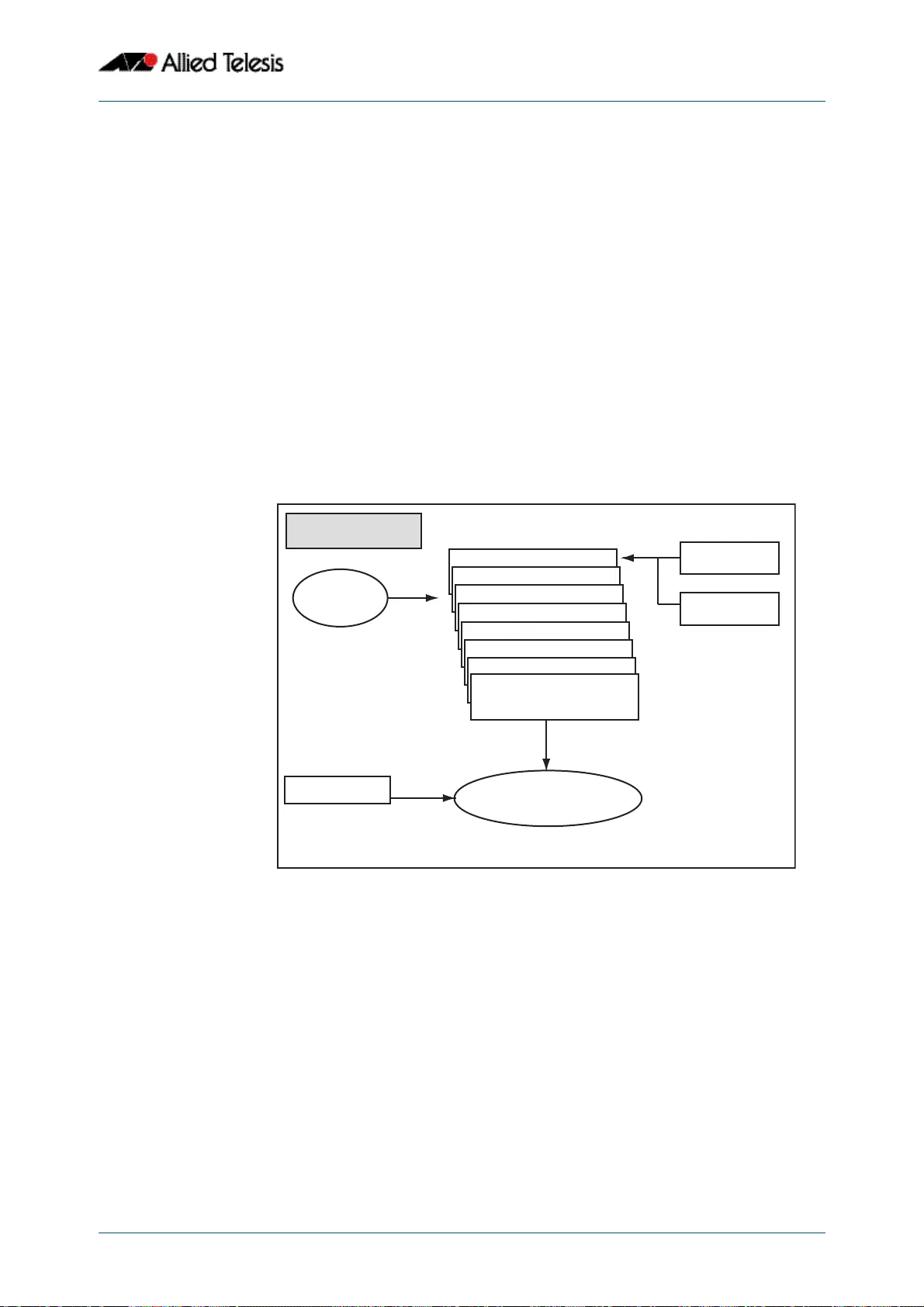
Quality of Service (QoS) Introduction
Software Reference for GS900MX/MPX Series Switches
C613-50065-01 REV B AlliedWare PlusTM Operating System - Version 5.4.4E-1.x 40.7
Applying QoS on Your Switch
This section steps you through the various stages of QoS set-up and introduces the QoS
commands and how to apply them.
Before you configure any QoS functions on your switch, first enable QoS by using the mls
qos enable command.
Classifying Your Data
One of the early steps in setting up QoS on a network is planning and applying your
classification rules. Classification is the process of Filtering and Marking. Filtering involves
sorting your data into appropriate traffic types. Marking involves tagging the data so that
downstream ports and routers can apply appropriate service policy rules. Figure 40-4
illustrates the classifying process, and will be referred to in the examples that follow.
Figure 40-4: QoS classification process
At the premarking stage you can assign your data a particular priority level by giving it a
link level user priority, see “Link Layer QoS” on page 40.3, or a network level DSCP
“Differentiated Services Architecture” on page 40.4. You can also assign the data to a
particular output (or egress) queue.
Class Maps
Class Maps are among the pivotal QoS components. They provide the means that
associate the classified traffic with its appropriate QoS actions. They are the linking
elements for the following functions:
■classification
■policy-mapping
■pre-marking
QoS Classification_GS900MX.eps
mls qos enable
Enables qos on the switch
match <access group>
Assigns vlan matching to one or
more a class maps
match <cos>
Assigns vlan matching to one or
more a class maps
match <dscp>
Assigns vlan matching to one or
more a class maps
match <ip-precedence>
Assigns vlan matching to one or
more a class maps
match <mac-type>
Assigns vlan matching to one or
more a class maps
match <protocol>
Assigns vlan matching to one or
more a class maps
match <tcp-flags>
Assigns vlan matching to one or
more a class maps
ip access-group
<3000-3699>
mac access-group
<4000-4699>
Apply Access
Matching Criteria
match <vlan>
Assigns vlan matching to one or
more class maps
class-map <name>
Creates a class map class-map
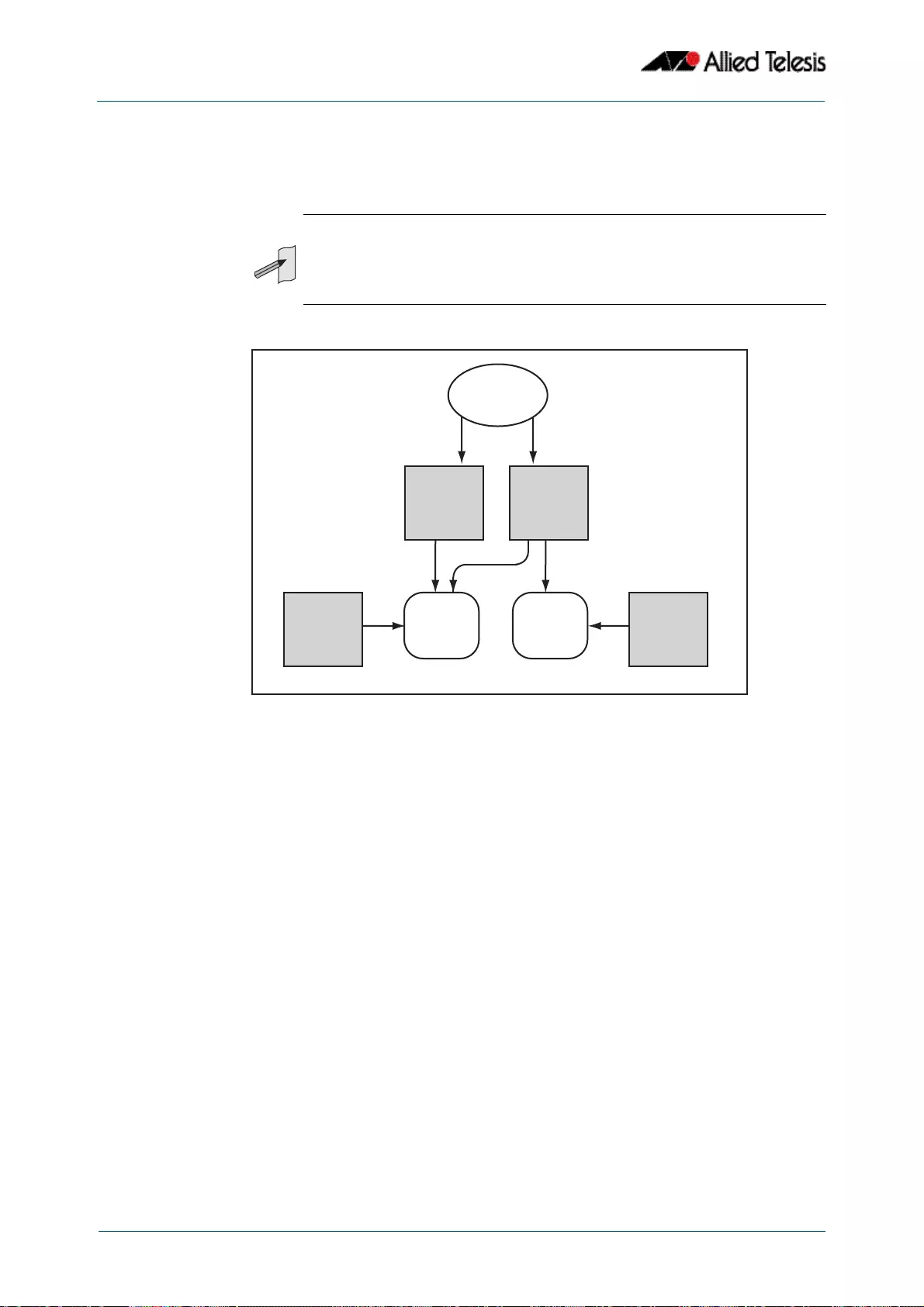
Quality of Service (QoS) Introduction
Software Reference for GS900MX/MPX Series Switches
40.8 AlliedWare PlusTM Operating System - Version 5.4.4E-1.x C613-50065-01 REV B
Figure 40-5 shows the relationship between a class-map and its associated functions.
Note that the relationship between a class-map and a policy-map can be one-to-one or
many-to-one. For information on policy-maps see the section, “Policy Maps” on
page 40.10.
Figure 40-5: Relationship between a class-map and its associated functions
Creating a class-map
To create a class-map, use the class-map command on page 41.3.
This example creates a class-map called video-traffic and another called data-traffic:
Creating and configuring default class-maps
These (automatically created) default class-maps serve as the means to specify the action
that will apply to all unclassified data, i.e. all data within a policy-map that is not captured
by any of the applied match commands that are applied to the policy-map by its class-
maps.
Each time a new policy-map is created a new class-map called “default” is also
automatically created and assigned to the new policy-map. You can configure any of the
default class-maps by using the default-action command on page 41.5
Note If a conflict occurs between the settings in two class-maps, priority will be
applied to the class-map that was created first.
An example of such a conflict is the arrival of a packet that meets the
classification requirements of two class-maps each configured to the same
policy-map and set to apply different priority settings to the packet.
awplus# configure terminal
awplus(config)# class-map video-traffic
awplus(config-cmap)# exit
awplus(config)# class-map data-traffic
awplus(config-cmap)#
QoS -Class-Maps
Policy
Map Policy
Map
Packet
Matching
Class
Map Class
Map
Default
Class
Map
Default
Class
Map

Quality of Service (QoS) Introduction
Software Reference for GS900MX/MPX Series Switches
C613-50065-01 REV B AlliedWare PlusTM Operating System - Version 5.4.4E-1.x 40.9
To set the default class-map for the policy-map p-map1 to have the action of deny:
Applying a match command to a class-map
To apply a matching filter to a class-map use one of the match commands.
This example creates a filter to select VLAN 5 traffic and applies this filter to the class-map
named video-traffic.
Associating a class-map with a policy-map
To associate a class-map with a policy-map, use the class command on page 41.2.
The following example creates a policy-map called policy-one, and associates it with the
class-maps named video-traffic, and database-traffic:
awplus# config
awplus(config)# policy-map p-map1
awplus(config-pmap)# default-action deny
awplus# config terminal
awplus(config)# class-map video-traffic
awplus(config-cmap)# match vlan 5
Note A maximum of 128 class-maps may be attached to each policy-map.
awplus# configure terminal
awplus(config)# policy-map policy-one
awplus(config-pmap)# class video-traffic
awplus(config-pmap-c)# exit
awplus(config-pmap)# class database-traffic
awplus(config-pmap-c)#

Quality of Service (QoS) Introduction
Software Reference for GS900MX/MPX Series Switches
40.10 AlliedWare PlusTM Operating System - Version 5.4.4E-1.x C613-50065-01 REV B
Policy Maps
Policy maps are the means by which you apply your class-map properties to physical
switch ports. Figure 40-6 on page 40.10 illustrates this concept. Note that a policy-map
can be assigned to several ports, but a port cannot have more than one policy-map
assigned to it.
Figure 40-6: Policy maps and related entities
To create and name a new policy-map you use the policy-map command on page 41.28.
To create a policy-map called pmap1 use the commands:
Having created the policy-map pmap1 we can use the class command on page 41.2 to
assign it to one or more class-maps. Since we created the class-maps video-traffic
and office-traffic earlier in this chapter, we can now attach the policy-map pmap1
to both class-maps.
Use the class command to assign the policy-map pmap1 to the class-maps video-
traffic and office-traffic:
awplus# configure terminal
awplus(config)# policy-map pmap1
awplus# configure terminal
awplus(config)# policy-map pmap1
awplus(config-pmap)# class video-traffic
awplus(config-pmap-c)# exit
awplus(config-pmap)# class office-traffic
awplus(config-pmap-c)#
QoS_PolicyMap
class-mapclass-map class-map
premarking
remarking
switch
port
switch
port
switch
port switch
port
service policy input command
policy-map
default
class-map

Quality of Service (QoS) Introduction
Software Reference for GS900MX/MPX Series Switches
C613-50065-01 REV B AlliedWare PlusTM Operating System - Version 5.4.4E-1.x 40.11
Premarking and Remarking Your Traffic
Premarking relates to adding QoS markers to your incoming data traffic before it is
metered (policed). Remarking is the same process when applied after metering. Network
switches will often be configured with two different premarking profiles, one for the QoS
edge switches and another for the QoS core switches. This situation would apply if you are
operating DSCP domains.
QoS markers can be applied at both the link layer (within the CoS field), and at the
network layer (within the DSCP field). For more information on this topic see “QoS Packet
Information” on page 40.3.
For boundary QoS
switches
Traffic entering QoS boundary switches is unlikely to contain pre-existing QoS tagging. In
this case, you can:
■Assign a CoS tag to data associated with a particular class-map.
■Use the trust dscp command to enable the mls qos map premark DSCP map. This
map enables you to change the DSCP tag and also map the tag to an egress port
queue, a CoS value, or both. At the premarking stage you can set this mapping using
the command mls qos map premark-dscp to. After policing, you can then use the
remark-map command to change the DCSP based on the packet’s bandwidth class,
or remap the existing bandwidth class, to a new value.
For an untagged packet, if no other mapping is applied and the packet is untagged, (i.e. in
the absence of any other queue selection) traffic will be sent to queue 2.
For core
QoS switches
Traffic entering ports within the QoS core network will almost certainly contain some
pre-existing QoS tagging. Where this is the case, you can:
■Map the CoS tag to an egress queue. You can do this either for the whole switch or for
specific ports via their assigned policy-maps. See “CoS to Egress Queue
Premarking” on page 40.11.
■Map the DSCP tag to an output queue. You can do this either for the whole switch or
for specific ports via their assigned policy-maps.
■Remap incoming data DSCP or CoS tags to values that are more appropriate for a
particular switch or network.
■Assign bandwidth classes for your packets, based on the incoming DSCP. See “DSCP
to egress queue premarking commands” on page 40.13.
CoS to Egress Queue Premarking
If you are using CoS tagging for your QoS functions, your traffic is likely to be either
entering the switch with a pre-existing CoS tag, or will have appropriate tags attached via
your class-maps and policy-maps. You can now mark the data for a particular egress
queue, which will take effect when the data reaches its output port. There are two
fundamental methods of applying CoS tagged packets to egress queues:
1. Apply a global mapping of CoS tags to egress queues for all ports.
2. Apply a CoS to egress queue mapping for the class-map / policy-map. This mapping -
which forms part of the policy-map - is applied at an input port, but will take effect at
the packet’s destination output port. Note that this procedure takes priority over that
described in method (1) above.

Quality of Service (QoS) Introduction
Software Reference for GS900MX/MPX Series Switches
40.12 AlliedWare PlusTM Operating System - Version 5.4.4E-1.x C613-50065-01 REV B
These methods and their related commands will be now be described in greater detail.
Mapping CoS tags to traffic types
The command mls qos map cos-queue to enables you to create a switch-wide mapping
of CoS values to egress queues. The default mappings for this command are:
COS : 0 1 2 3 4 5 6 7
--------------------------------
QUEUE: 2 0 1 3 4 5 6 7
These mappings match the CoS guidelines documented in Annex H.2 of ANSI/IEEE 802.1D
1988 Edition. Table H-15 on page 355 of the standard shows a table of user priorities for
specific traffic types. Table 40-3 shows an adapted version of the ANSI/IEEE table.
CoS settings for VCStack stack operation
In general you can apply the same principles when configuring QoS on a VCStack as you
would for single switch; however there are a few specific changes that you will need to
make.
Switches within a VCStack exchange their stack management information and user data
over their high speed inter-stacking links. The stack management information is pre-
assigned to the egress queue 7. This is the highest value queue, and (in a stacked
configuration) its traffic should not be shared with any user data. However, any CoS
tagging of 7 applied to the incoming data will automatically be assigned to queue 7 as it
crosses the internal stacking links. You will therefore need to reconfigure your CoS to
Queue settings to ensure that no user data is sent to queue 7.
Note Where a packet contains both a CoS and a DSCP field, and each field maps to a
different class-map; the switch will apply a priority that is based on the date
that the class-map was added to the policy-map; the earlier the date, the higher
the priority.
Table 40-3: Traffic type guidelines
User Priority
(egress queue)
CoS Value Acronym Traffic type Internal Traffic
Queue Defaults
0 (lowest) 1BK Background
1 2 - Spare
2 0 BE Best Effort Default
3 3 EE Excellent Effort
4 4 CL Controlled Load
5 5 VI “Video,” <100 ms
latency and jitter
6 6 VO “Voice,” <10 ms
latency and jitter
EPSR-Management
BPDU
ARP-Requests
7 (highest) 7NC Network Control Stack Management

Quality of Service (QoS) Introduction
Software Reference for GS900MX/MPX Series Switches
C613-50065-01 REV B AlliedWare PlusTM Operating System - Version 5.4.4E-1.x 40.13
To prevent this from happening, we recommend that you make appropriate changes to
your queue settings (mappings) to reflect the stacking requirement previously described.
For more information on this topic, see “Mapping CoS tags to traffic types” on
page 40.12.
This process should include (but not be limited to) running the following command to
ensure that any remaining user still carrying a CoS 7 tag will be mapped to egress queue 6.
To remap priority CoS traffic to egress queue 6, run the following command.
DSCP to Egress Queue Premarking
If you are using DSCP tagging for your QoS functions, your traffic is likely to be entering
the switch either with a pre-existing DSCP tag, or will have appropriate DSCP tags
attached via your class-maps and policy-maps. You can now mark the data for a particular
egress queue, which will take effect when the data reaches its output port.
If your switch forms part of a DSCP domain, you can adapt the steps in this section to
apply the mappings and settings to match the standards you have selected for the
domain. This mapping - which forms part of the policy-map - is applied at an input port,
but will take effect at the packet’s destination output port.
DSCP to egress queue premarking commands
A number of commands can be used for mapping DSCP tags. Where these conflict, the
switch applies a pre-defined set of priorities. Table 40-4 lists these priorities in order
(lowest priority first).
Where a packet that contains both CoS and a DSCP fields and each field maps to a
different class-map / policy-map, the switch will apply a priority based on the creation
date of class-maps - the earlier the creation date, the higher the priority priorities.
awplus# config terminal
awplus(config)# mls qos map cos-queue 7 to 6
Table 40-4: DSCP mapping commands in hierarchical order
Command Function
trust dscp Setting the trust dscp enables the
mls qos map premark-dscp to command to apply. See
“Setting the Trust DSCP map” on page 40.14.
mls qos map premark-
dscp to
With the trust dscp set, this command applies a
remapping table whose values include the dscp and
egress queues.

Quality of Service (QoS) Introduction
Software Reference for GS900MX/MPX Series Switches
40.14 AlliedWare PlusTM Operating System - Version 5.4.4E-1.x C613-50065-01 REV B
Setting the Trust DSCP map
The Trust DSCP mapping table assigns a new set of QoS values for a DSCP value supplied
as table input. To configure this table you use the mls qos map premark-dscp to
command.
The Trust DSCP map provides the highest priority of all the pre-marking controls. To apply
this table you must first apply the trust setting by using the trust dscp command.
Table 40-5: Drop probability table
Table Input ----------------------------------------- Table Output --------------------------
Existing DSCP New DSCP Value New CoS Value New Queue No New BW Class
green
yellow
red

Quality of Service (QoS) Introduction
Software Reference for GS900MX/MPX Series Switches
C613-50065-01 REV B AlliedWare PlusTM Operating System - Version 5.4.4E-1.x 40.15
Policing (Metering) Your Data
Once you have set-up your classification and created your class-maps, you can start
conditioning your traffic flows. One tool used for traffic conditioning is the policer (or
meter). The principle of policing is to measure the data flow that matches the definitions
for a particular class-map; then, by selecting appropriate data rates, allocate the flows into
one of three categories: Red, Yellow, or Green. You then decide what action to apply to the
colored data.
Single-Rate Three-Color Policing
This policing method is based on that defined in RFC 2697. The principle of single-rate
three-color policing is shown in Figure 40-7. For a given class-map, a meter monitors both
the token count in the buckets, and the input data flow.
Figure 40-7: Single-rate three-color policing
Each byte entering the meter is paired with a token in one of the buckets, and a token is
removed as each byte is accepted. If the input data rate is the same as the CIR then the
data passes through the port at the same rate as its bucket fills. Hence the bucket level
remains constant. In this model, the data buffer is represented by two data buckets. You
can specify the CIR using the police single-rate action command.
M
e
t
e
r
Te = Tokens in
Excess Bucket
Tc = Tokens
in Committed
Bucket
Green tokens
enter the
Committed Bucket
Yellow tokens
enter the
Excess Bucket
SR-TC_bucket_meter
CBS
(minburstsize)
EBS
(maxburstsize)
Data packets (at data rate > CIR)
packet size < Tc
packet size >Te
Packets marked after metering
Used green and yellow
tokens are replaced at the
Committed Information
Rate (CIR)
greengreen
green, yellow or red
yellow
red (no token top-up)
Bucket
Excess
Committed
Bucket
yellow
red
yellow
red
Single-Rate Three-Color Policing (color aware mode)
green
yellow
red red
Tc <packet size <Te
Note that although the data is metered in bytes, coloring is applied per packet.
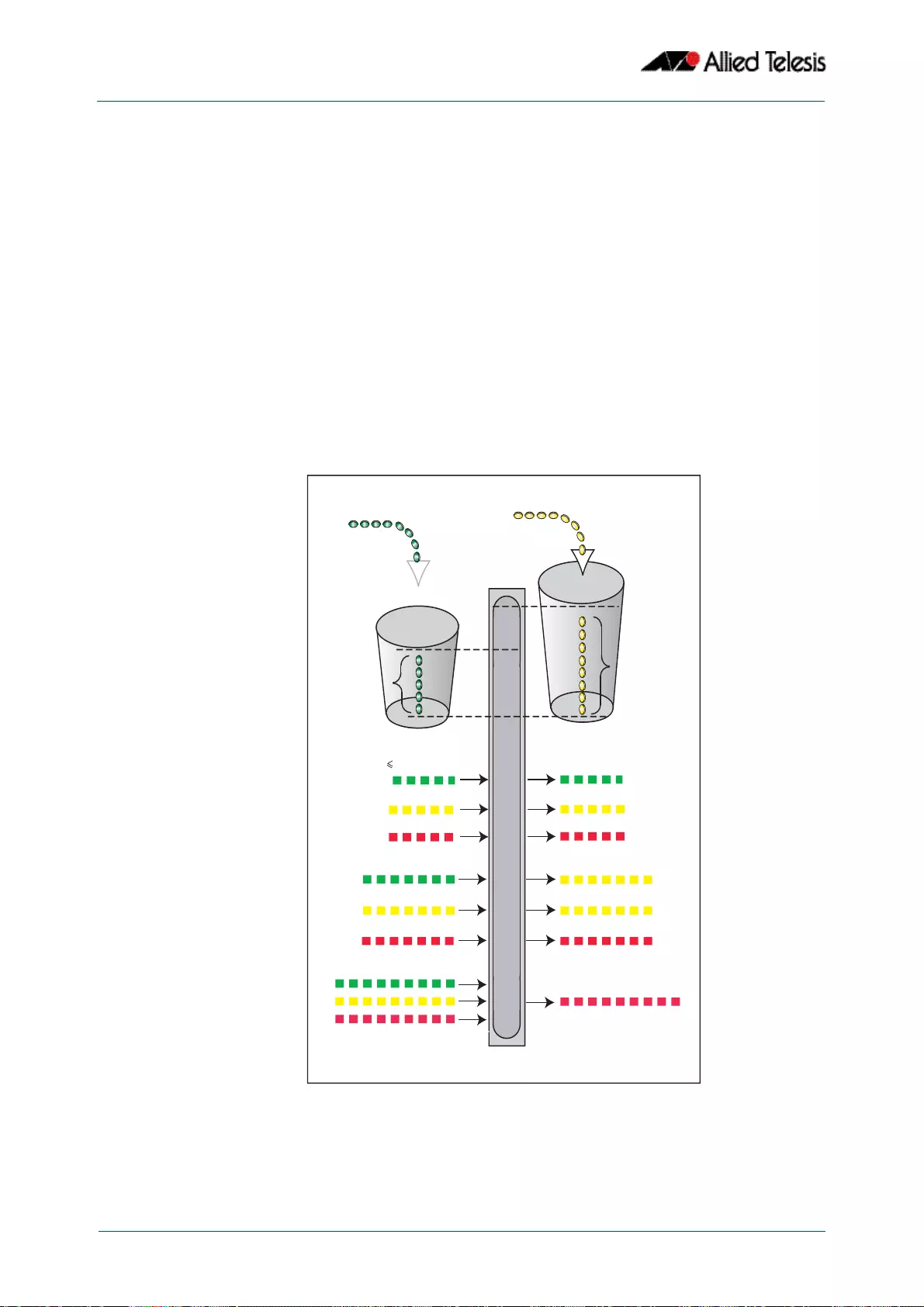
Quality of Service (QoS) Introduction
Software Reference for GS900MX/MPX Series Switches
40.16 AlliedWare PlusTM Operating System - Version 5.4.4E-1.x C613-50065-01 REV B
Initially both buckets have their full token count. A surge of data exceeding the CIR will
begin to empty the bucket. As the data and tokens are paired, data bytes that match
tokens below the CBS level are marked green, those that are between CBS and EBS will be
marked yellow, and those that are above EBS are marked red.
Note that although the data is metered per byte, the color marking process is applied per
packet. This means that if there were only sufficient tokens available to match part of a
packet, then the whole packet would be marked red. Then, depending on the action
parameter of the police single-rate action command, the whole packet will be either
dropped or forwarded. In either situation, the red-marked packet will leave the bucket
counts unchanged.
Two-Rate Three-Color Policing
This policing method is based on that defined in RFC 2698. The principle of two-rate
three-color policing is shown in Figure 40-8.
Figure 40-8: Two-rate three-color policing
For a given class-map, the meter monitors the token count in both buckets, and the input
data flow. Initially tokens enter both buckets until full. As the data enters a port, the meter
pairs each byte to a token in one of the buckets, then removes a token from the
appropriate bucket. Bucket C is topped up with tokens at the Committed Information Rate
(CIR), and bucket P is topped up at the Peak Information Rate (PIR).
M
e
t
e
r
Bucket P
Tc = Tokens
in Committed
Bucket
Green tokens
enter the
Committed Bucket
CBS
(minburstsize)
Bucket C
Two-Rate Three-Color Policing (color aware mode)
TR-TC_bucket_meter
Data packets (at data rate > CIR)
Tc <packet size < Tp
packet size > Tp
Packets marked after metering
Tokens replace used
(yellow) tokens at the
Peak Information
Rate (PIR)
green (bucket C topped up)
yellow (bucket P topped up)
red (no token top-up))
red (no token top-up))
PBS
(maxburstsize)
= Tp for full
bucket
yellow (bucket P topped up)
red (no token top-up)
green, yellow or red
packet size Tc
yellow (bucket P topped up)
yellow
green
red
green
yellow
red
Tokens in
Bucket P = Tp
Note that although the data is metered in bytes, coloring is applied per packet.

Quality of Service (QoS) Introduction
Software Reference for GS900MX/MPX Series Switches
C613-50065-01 REV B AlliedWare PlusTM Operating System - Version 5.4.4E-1.x 40.17
When data enters the port at the CIR, the bucket fills at the same rate as the incoming
data, thus the token count in bucket C remains constant. Similarly, if data enters the port
at the PIR, then the token count in bucket P remains constant. You can specify the CIR and
the PIR by using the police twin-rate action command. The function of this command is
explained in the section “Configuring and Applying a Policer” on page 40.17.
A surge of data exceeding the CIR will begin to empty bucket C. If bucket C empties to a
point where it has insufficient tokens to match to an incoming data packet, then the data
packet will be marked yellow. The data will now be measured against the level in bucket P
and tokens will be removed from this bucket to match the incoming data. If the incoming
data rate drops to less than the CIR then the data will continue to be marked yellow until
the level in bucket C has had a chance to fill, whereupon it will be marked green.
If the incoming data is greater than the PIR, then bucket P begins to empty. If bucket P
empties to a point where it has insufficient tokens to match to an incoming data packet,
then the data packet will be marked red. In this situation no tokens are removed from
either bucket.
Note that although the data is metered per byte, the color marking process is applied per
packet. This means that if there were only sufficient tokens available to match part of a
packet, then the whole packet would be marked red. Then, depending on the action
parameter of the police twin-rate action command, the whole packet will be either
dropped, or marked and forwarded. In either situation, the red marked packet will leave
the bucket counts unchanged.
Configuring and Applying a Policer
The previous section showed how the policer works and how to select either the single
rate or twin rate action. To apply a policy to class-maps:
■Select your policy-map and class-map from the command prompt, then enter either
the police single-rate action command or the police twin-rate action command
whilst selecting the appropriate command parameters.
This will apply the command to the selected class-map. By running this command several
times, each for a different class-map, you can apply separate meter settings to each class-
map.

Quality of Service (QoS) Introduction
Software Reference for GS900MX/MPX Series Switches
40.18 AlliedWare PlusTM Operating System - Version 5.4.4E-1.x C613-50065-01 REV B
Remarking Your Data
The remarking process enables you to change the QoS tagging and queue assignments
from data that has already been marked by the policer. To do this you fill entries in the
remarking table by using the remark-map command on page 41.30. In order to remark
your data ensure that the action parameter of either the police single-rate action or the
police twin-rate action is set to remark-transmit.
The following table shows the remarking options.
Example Traffic presently marked Yellow is to be assigned a new DSCP value of 20:
To configure this setting, you would enter the following commands:
Further remarking can be achieved by using the remark new-cos command on page
41.32. This command enables you to configure and remark either or both the CoS flag in
the data packet, and the input into the CoS to queue map thus changing the destination
egress queue.
Table 40-6: Remarking table
BANDWIDTH
CLASS
Green New DSCP New bandwidth class
(Red, Yellow, or Green)
Ye l l o w New DSCP New bandwidth class
(Red, Yellow, or Green)
Red New DSCP New bandwidth class
(Red, Yellow, or Green)
Table 40-7: Remarking table example
BANDWIDTH
CLASS
Ye l l o w New DSCP = 20 Bandwidth class unchanged
awplus# configure terminal
awplus(config)# policy-map pmap1
awplus(config-pmap)# class cmap1
awplus(config-pmap-c)# remark-map bandwidth-class yellow to
new-dscp 20

Quality of Service (QoS) Introduction
Software Reference for GS900MX/MPX Series Switches
C613-50065-01 REV B AlliedWare PlusTM Operating System - Version 5.4.4E-1.x 40.19
Configuring the Egress Queues
Previous sections have explained the ingress functions. These include how the incoming
data can be classified and marked according to its priority and allocated to an egress
queue, then finally how metering and remarking is applied. At this point the data then
flows across the switch to its destination egress port where its transit to the egress queues
is controlled.
The means by which data is applied to the egress queues is dependent on three functions:
■Egress queue and QoS markers that are set within each data packet
■Egress controls that are applied to the whole switch
■Egress controls that are applied to each individual switch port
Egress Queues and QoS markers
Once the data packets have been appropriately filtered, classified, policed, and remarked,
they travel across the switch’s internal paths carrying their assigned QoS tag markers such
as their priority, class and destination queues. For more details on ingress data marking,
refer to the earlier sections of this chapter. At the egress port these markers are read and
used to determine which queues each data packet will be forwarded to, and the priorities
that will be applied.
There are eight egress queues allocated to each egress port. The egress queue that a
particular packet passes through is determined by either the configuration of the switch,
or by the markers contained within the packet itself.
Figure 40-9: Default egress queue
Egress Queue Commands Hierarchy
The destination queue that any one packet will take depends on the markers within the
packet, and the way the queuing commands have been set. Also, some queuing
commands will override others. Here is how the switch prioritizes its queuing commands.
Imagine a packet entering an ingress port then traveling through the switch fabric to
reach its appropriate egress port. In this situation the following hierarchy will apply:
QoS_EgressDefaultQueue
Incoming Data
mls qos cos <0-7>
This command is applied to an ingress port
and assigns a CoS value to untagged
packets that enter the port. The switch
determines the queue for the packet by
looking up that CoS value in the
mls qos map cos-queue to map.
This example shows the mls qos cos
command and map both set to 6.
If this command is not set, then unmarked
packets arriving at an egress port will be
sent to queue 2.
Ingress
port
default queue
Outgoing Data
Egress
port
queue 6
egress
queues

Quality of Service (QoS) Introduction
Software Reference for GS900MX/MPX Series Switches
40.20 AlliedWare PlusTM Operating System - Version 5.4.4E-1.x C613-50065-01 REV B
1. If the packet enters an egress port carrying no QoS markers and no QoS queuing
commands have been set on the switch, then the packet will exit the port via queue
number 2.
2. This default situation can be overridden by the mls qos cos command, which assigns
a CoS value to untagged packets that enter a port. The switch determines the queue
for the packet by looking up that CoS value in the mls qos map cos-queue to map.
3. If the packet contains a CoS value and arrives at an egress port with no other
configuration applying, the switch determines the queue for the packet by looking up
that CoS value in the mls qos map cos-queue to map.
4. The above CoS and queue settings can be overridden by the remark new-cos
command. This command lets you change the CoS value for packets that match a
given class-map, and therefore lets you change the queue for those packets.

Quality of Service (QoS) Introduction
Software Reference for GS900MX/MPX Series Switches
C613-50065-01 REV B AlliedWare PlusTM Operating System - Version 5.4.4E-1.x 40.21
Egress Queue Shaping
This section is concerned with how the egress queues are cleared.
Scheduling
The scheduler determines how packets in the egress port queues are serviced. Two
servicing methods can be applied:
■strict priority
■weighted round robin (WRR)
Strict priority servicing
By default, all queues on all ports are serviced in a strict priority order. This means that the
highest numbered priority queue (queue 7) is emptied first; then when it is completely
empty, the next highest priority queue is processed, and so on. Thus, for a strict priority
queue to be processed, all higher priority queues must be empty.
Strict priority servicing is the default setting; however if your system is configured for
weighted round robin (WRR), you can return it to priority queuing by using the commands
shown in the following example.
To return queue 2 of port1.0.1 from WRR servicing to strict priority queuing, use the
commands:
awplus# configure terminal
awplus(config)# interface port1.0.1
awplus(config-if)# priority-queue 2

Quality of Service (QoS) Introduction
Software Reference for GS900MX/MPX Series Switches
40.22 AlliedWare PlusTM Operating System - Version 5.4.4E-1.x C613-50065-01 REV B
Weighted round robin servicing
The following examples show how to configure round robin servicing.
Example To configure a wrr-queue by applying a weighting value of 6 to queues 0 and1:
Example In this example port 1.0.1 has queues configured as follows:
■queues 6 and 7 are configured strict priority
■queues 3 and 4 are configured as WRR with weighting values of 6
■queue 5 is configured as WRR with weighting values of 12
■queues 0, 1 and 2 are configured as WRR with weighting values of 4
:I
In this example, the queues are processed as follows:
1. Queue 7 is processed first.
2. If queue 7 is empty, Queue 6 is processed next.
3. If queues 6 and 7 are empty, queue 5 is processed next.
4. If queue 5 is empty, queues 3 and 4 are processed with equal weighting.
Drop Mode
The drop mode sets the limits for packets in the egress queues and determines how
packets will be dropped if the queues become congested. The switch supports the tail
drop mode and is pre-configured with the following settings:
Data packets will be dropped per color at the following buffer usage:
Red at 60%, Yellow at 80%, and Green at 100%.
These settings cannot be reconfigured.
awplus# configure terminal
awplus(config)# interface port1.0.1
awplus(config-if)# wrr-queue weight 6 queues 0 1
awplus# configure terminal
awplus(config)# interface port1.0.1
awplus(config-if)# priority-queue 6 7
awplus(config-if)# wrr-queue weight 6 queues 3 4
awplus(config-if)# wrr-queue weight 12 queues 5
awplus(config-if)# wrr-queue weight 4 queues 0 1 2

Quality of Service (QoS) Introduction
Software Reference for GS900MX/MPX Series Switches
C613-50065-01 REV B AlliedWare PlusTM Operating System - Version 5.4.4E-1.x 40.23
Tail drop
In this drop mode each egress queue is configured with a maximum threshold value. This
value represents the point where the egress buffer queues are full and the egress port
must start dropping data. The port does this by dropping data packets destined for the
full queue on a “last in first dropped” basis. This enables the port to clear its data already
queued for egress.
If a reliable transport protocol, such as TCP is used, this data should be retransmitted, but
at a slower rate due to lack of returning “acknowledgments”.

Quality of Service (QoS) Introduction
Software Reference for GS900MX/MPX Series Switches
40.24 AlliedWare PlusTM Operating System - Version 5.4.4E-1.x C613-50065-01 REV B
Storm Protection
Storm protection uses QoS mechanisms to classify on traffic likely to cause a packet storm
(broadcast and multicast). Unless you are running an enhanced storm protection feature
such as Loop Protection, the per-port storm protection mechanism simply discards any
traffic over the configured limit. However, with QoS storm protection, several actions are
possible when a storm is detected:
■You can disable the port physically.
■You can disable the port logically.
■You can disable the port for a particular VLAN.
To enable the policy-based storm protection, use the storm-protection command on
page 41.47.
Storm protection is activated as soon as a port is enabled, before the port forwards frames.
When a storm is detected on a port, a message is automatically recorded in the log, and
you can configure an SNMP trap to signal that a port has been disabled. When a storm is
detected on a trunk or port group, the entire trunk or port group is disabled.
The following table explains the basic concepts involved with storm protection.
To set the action to take when triggered by QoS Storm Protection (QSP), use the storm-
action command on page 41.45.
To set the time to re-enable the port once disabled by QSP, use the storm-downtime
command on page 41.46.
Concept Description
Window The frequency at which traffic is measured to determine whether storm
protection should be activated.
Rate The amount of traffic per second that must be exceeded before the switch
takes the configured action.
Action What the switch does when it detects a storm on a port.
Timeout The length of time the port remains disabled after a port has been disabled
due to a packet storm.

Software Reference for GS900MX/MPX Series Switches
C613-50065-01 REV B AlliedWare PlusTM Operating System - Version 5.4.4E-1.x 41.1
Chapter 41: QoS Commands
Command List .................................................................................................................................... 41.2
class........................................................................................................................................................ 41.2
class-map ............................................................................................................................................. 41.3
clear mls qos interface policer-counters................................................................................... 41.4
default-action ..................................................................................................................................... 41.5
description (QoS policy-map)....................................................................................................... 41.6
egress-rate-limit................................................................................................................................. 41.7
match access-group......................................................................................................................... 41.8
match cos............................................................................................................................................. 41.9
match dscp ........................................................................................................................................41.10
match eth-format protocol..........................................................................................................41.11
match ip-precedence.....................................................................................................................41.14
match mac-type...............................................................................................................................41.15
match tcp-flags ................................................................................................................................41.16
match vlan .........................................................................................................................................41.17
mls qos cos ........................................................................................................................................41.18
mls qos enable .................................................................................................................................41.19
mls qos map cos-queue to...........................................................................................................41.20
mls qos map premark-dscp to....................................................................................................41.21
no police.............................................................................................................................................41.23
police single-rate action ...............................................................................................................41.24
police twin-rate action ..................................................................................................................41.26
policy-map.........................................................................................................................................41.28
priority-queue ..................................................................................................................................41.29
remark-map.......................................................................................................................................41.30
remark new-cos ...............................................................................................................................41.32
service-policy input ........................................................................................................................41.34
show class-map................................................................................................................................41.35
show mls qos ....................................................................................................................................41.36
show mls qos interface .................................................................................................................41.37
show mls qos interface policer-counters ...............................................................................41.39
show mls qos interface queue-counters ................................................................................41.40
show mls qos interface storm-status .......................................................................................41.41
show mls qos maps cos-queue ..................................................................................................41.42
show mls qos maps premark-dscp ...........................................................................................41.43
show policy-map.............................................................................................................................41.44
storm-action......................................................................................................................................41.45
storm-downtime .............................................................................................................................41.46
storm-protection.............................................................................................................................41.47
storm-rate ..........................................................................................................................................41.48
storm-window..................................................................................................................................41.49
trust dscp............................................................................................................................................41.50
wrr-queue disable queues ...........................................................................................................41.51
wrr-queue weight queues ...........................................................................................................41.52

QoS Commands
Software Reference for GS900MX/MPX Series Switches
41.2 AlliedWare PlusTM Operating System - Version 5.4.4E-1.x C613-50065-01 REV B
Command List
This chapter provides an alphabetical reference for Quality of Service commands. For
more information, see Chapter 40, Quality of Service (QoS) Introduction and
Chapter 36, Access Control Lists Introduction.
class
Use this command to associate an existing class-map to a policy or policy-map (traffic
classification), and to enter Policy Map Class Configuration mode to configure the class-
map.
Use the no variant of this command to delete an existing class-map.
For more information on class-maps and policy-maps, see the following sections:“Class
Maps” on page 40.7 and “Policy Maps” on page 40.10.
Note that if your class-map does not exist, you can create it by using the class-map
command.
Syntax class {<name>|default}
no class <name>
Mode Policy Map Configuration
Example The following example creates the policy-map pmap1(using the policy-map command),
then associates this to an already existing class-map named cmap1, use the commands:
Related Commands class-map
policy-map
Parameter Description
<name> Name of the (already existing) class-map.
default Specify the default class-map.
awplus# configure terminal
awplus(config)# policy-map pmap1
awplus(config-pmap)# class cmap1
awplus(config-pmap-c)#

QoS Commands
Software Reference for GS900MX/MPX Series Switches
C613-50065-01 REV B AlliedWare PlusTM Operating System - Version 5.4.4E-1.x 41.3
class-map
Use this command to create a class-map.
Use the no variant of this command to delete the named class-map.
Syntax class-map <name>
no class-map <name>
Mode Global Configuration
Example This example creates a class-map called cmap1, use the commands:
Parameter Description
<name>Name of the class-map to be created.
awplus# configure terminal
awplus(config)# class-map cmap1
awplus(config-cmap)#

QoS Commands
Software Reference for GS900MX/MPX Series Switches
41.4 AlliedWare PlusTM Operating System - Version 5.4.4E-1.x C613-50065-01 REV B
clear mls qos interface policer-counters
Resets an interface’s policer counters to zero. This can either be for a specific class-map or
for all class-maps.
Syntax clear mls qos interface <port> policer-counters
[class-map <class-map>]
Mode Privileged Exec
Example To reset the policy counters to zero for all class-maps for port1.0.1, use the command:
Related Commands show mls qos interface policer-counters
Parameter Description
<port>The port may be a switch port (e.g. port1.0.4), a static
channel group (e.g. sa3), or a dynamic (LACP) channel group
(e.g. po4).
class-map Select a class-map.
<class-map> Class-map name.
awplus# clear mls qos interface port1.0.1 policer-counters

QoS Commands
Software Reference for GS900MX/MPX Series Switches
C613-50065-01 REV B AlliedWare PlusTM Operating System - Version 5.4.4E-1.x 41.5
default-action
Sets the action for the default class-map belonging to a particular policy-map. The action
for a non-default class-map depends on the action of any ACL that is applied to the policy-
map.
The default action can therefore be thought of as specifying the action that will be applied
to any data that does not meet the criteria specified by the applied matching commands.
Use the no variant of this command to reset to the default action of ‘permit’.
Syntax default-action [permit|deny|send-to-cpu|copy-to-cpu|copy-to-mirror|
send-to-mirror]
no default-action
Default The default is ‘permit’.
Mode Policy Map Configuration
Examples To set the action for the default class-map to deny, use the command:
To set the action for the default class-map to copy-to-mirror for use with the mirror
interface command, use the command:
Related Commands mirror interface
Parameter Description
permit Packets to permit.
deny Packets to deny.
send-to-cpu Specify packets to send to the CPU.
copy-to-cpu Specify packets to copy to the CPU.
copy-to-mirror Specify packets to copy to the mirror port.
send-to-mirror Specify packets to send to the mirror port.
awplus(config-pmap)# default-action deny
awplus(config-pmap)# default-action copy-to-mirror

QoS Commands
Software Reference for GS900MX/MPX Series Switches
41.6 AlliedWare PlusTM Operating System - Version 5.4.4E-1.x C613-50065-01 REV B
description (QoS policy-map)
Adds a textual description of the policy-map. This can be up to 80 characters long.
Use the no variant of this command to remove the current description from the policy-
map.
Syntax description <line>
no description
Mode Policy Map Configuration
Example To add the description, VOIP traffic, use the commands:
Parameter Description
<line>Up to 80 character long line description.
awplus(config-pmap)# description VOIP traffic

QoS Commands
Software Reference for GS900MX/MPX Series Switches
C613-50065-01 REV B AlliedWare PlusTM Operating System - Version 5.4.4E-1.x 41.7
egress-rate-limit
Sets a limit on the amount of traffic that can be transmitted per second from this port.
Use the no variant of this command to disable the limiting of traffic egressing on the
interface.
Syntax egress-rate-limit <bandwidth>
no egress-rate-limit
Mode Interface Configuration
Examples To enable egress rate limiting on a port, use the commands:
To disable egress rate limiting on a port, use the commands:
Parameter Description
<bandwidth>Bandwidth <1-10000000 units per second> (usable units: k, m, g).
The egress rate limit can be configured in multiples of 64kbps. If
you configure a value that is not an exact multiple of 64kbps, then
the value will be rounded up to the nearest higher exact multiple
of 64kbps. The minimum is 64 Kb.
The default unit is Kb (k), but Mb (m) or Gb (g) can also be specified.
The command syntax is not case sensitive, so a value such as 20m
or 20M will be taken to mean 20 megabits.
awplus# configure terminal
awplus(config)# interface port1.0.1
awplus(config-if)# egress-rate-limit 64k
%Egress rate limit has been set to 64 Kb
awplus# configure terminal
awplus(config)# interface port1.0.1
awplus(config-if)# no egress-rate-limit

QoS Commands
Software Reference for GS900MX/MPX Series Switches
41.8 AlliedWare PlusTM Operating System - Version 5.4.4E-1.x C613-50065-01 REV B
match access-group
Use this command to define match criterion for a class-map.
Syntax match access-group {<hw-IP-ACL>|<hw-MAC-ACL>|<hw-named-ACL>}
no match access-group {<hw-IP-ACL>|<hw-MAC-ACL>|<hw-named-ACL>}
Mode Class Map Configuration
Usage First create an access-list that applies the appropriate permit/deny requirements. Then use
the match access-group command to apply this access-list for matching to a class-map.
Note that this command will apply the access-list matching only to incoming data packets.
Examples To configure a class-map named cmap1 with one match criterion: access-list 3001,
which allows IP traffic from any source to any destination, use the commands:
To configure a class-map named cmap2 with one match criterion: access-list 3001,
which allows MAC traffic from any source to any destination, use the commands:
To configure a class-map named cmap3 with one match criterion: access-list
hw_acl, which allows IP traffic from any source to any destination, use the commands:
Related Commands class-map
Parameter Description
<hw-IP-ACL>Specify a hardware IP ACL number in the range <3000-3699>.
<hw-MAC-ACL>Specify a hardware MAC ACL number in the range <4000-4699>.
<hw-named-ACL>Specify the hardware named ACL.
awplus# configure terminal
awplus(config)# access-list 3001 permit ip any any
awplus(config)# class-map cmap1
awplus(config-cmap)# match access-group 3001
awplus# configure terminal
awplus(config)# access-list 4001 permit any any
awplus(config)# class-map cmap2
awplus(config-cmap)# match access-group 4001
awplus# configure terminal
awplus(config)# access-list hardware hw_acl
awplus(config-ip-hw-acl)# permit ip any any
awplus(config)# class-map cmap3
awplus(config-cmap)# match access-group hw_acl

QoS Commands
Software Reference for GS900MX/MPX Series Switches
C613-50065-01 REV B AlliedWare PlusTM Operating System - Version 5.4.4E-1.x 41.9
match cos
Sets the CoS for a class-map to match on.
Use the no variant of this command to remove CoS.
Syntax match cos <0-7>
no match cos
Mode Class Map Configuration
Examples To set the class-map’s CoS to 4, use the commands:
To remove CoS from a class-map, use the commands:
Parameter Description
<0-7>Specify the CoS value.
awplus# configure terminal
awplus(config)# class-map cmap1
awplus(config-cmap)# match cos 4
awplus# configure terminal
awplus(config)# class-map cmap1
awplus(config-cmap)# no match cos

QoS Commands
Software Reference for GS900MX/MPX Series Switches
41.10 AlliedWare PlusTM Operating System - Version 5.4.4E-1.x C613-50065-01 REV B
match dscp
Use this command to define the DSCP to match against incoming packets.
Use the no variant of this command to remove a previously defined DSCP.
Syntax match dscp <0-63>
no match dscp
Mode Class Map Configuration
Usage Use the match dscp command to define the match criterion after creating a class-map.
Examples To configure a class-map named cmap1 with criterion that matches IP DSCP 56, use the
commands:
To remove a previously defined DSCP from a class-map named cmap1, use the commands:
Related Commands class-map
Parameter Description
<0-63> Specify DSCP value (only one value can be selected).
awplus# configure terminal
awplus(config)# class-map cmap1
awplus(config-cmap)# match dscp 56
awplus# configure terminal
awplus(config)# class-map cmap1
awplus(config-cmap)# no match dscp

QoS Commands
Software Reference for GS900MX/MPX Series Switches
C613-50065-01 REV B AlliedWare PlusTM Operating System - Version 5.4.4E-1.x 41.11
match eth-format protocol
This command sets the Ethernet format and the protocol for a class-map to match on.
Select one Layer 2 format and one Layer 3 protocol when you issue this command.
Use the no variant of this command to remove the configured Ethernet format and
protocol from a class-map.
Syntax match eth-format <layer-two-format> protocol <layer-three-protocol>
no match eth-format protocol
Parameter Description
<layer-two-formats>
802dot2-tagged 802.2 Tagged Packets (enter the parameter name).
802dot2-untagged 802.2 Untagged Packets (enter the parameter name).
ethii-tagged EthII Tagged Packets (enter the parameter name).
ethii-untagged EthII Untagged Packets (enter the parameter name).
netwareraw-
tagged
Netware Raw Tagged Packets (enter the parameter
name).
netwareraw-
untagged
Netware Raw Untagged Packets (enter the parameter
name).
snap-tagged SNAP Tagged Packets (enter the parameter name).
snap-untagged SNAP Untagged Packets (enter the parameter name).
<layer-three-protocols>
<word> A Valid Protocol Number in hexidecimal.
any Note that the parameter “any” is only valid when used
with the netwarerawtagged and netwarerawuntagged
protocol options.
sna-path-control Protocol Number 04 (enter the parameter name or its
number).
proway-lan Protocol Number 0E (enter the parameter name or its
number).
eia-rs Protocol Number 4E (enter the parameter name or its number).
proway Protocol Number 8E (enter the parameter name or its number).
ipx-802dot2 Protocol Number E0 (enter the parameter name or its
number).
netbeui Protocol Number F0 (enter the parameter name or its
number).
iso-clns-is Protocol Number FE (enter the parameter name or its
number).

QoS Commands
Software Reference for GS900MX/MPX Series Switches
41.12 AlliedWare PlusTM Operating System - Version 5.4.4E-1.x C613-50065-01 REV B
xdot75-internet Protocol Number 0801(enter the parameter name or its
number).
nbs-internet Protocol Number 0802 (enter the parameter name or its
number).
ecma-internet Protocol Number 0803 (enter the parameter name or its
number).
chaosnet Protocol Number 0804 (enter the parameter name or its
number).
xdot25-level-3 Protocol Number 0805 (enter the parameter name or its
number).
arp Protocol Number 0806 (enter the parameter name or its
number).
xns-compat Protocol Number 0807 (enter the parameter name or its
number).
banyan-systems Protocol Number 0BAD (enter the parameter name or
its number).
bbn-simnet Protocol Number 5208 (enter the parameter name or its
number).
dec-mop-dump-ld Protocol Number 6001 (enter the parameter name or its
number).
dec-mop-rem-
cdons
Protocol Number 6002 (enter the parameter name or its
number).
dec-decnet Protocol Number 6003 (enter the parameter name or its
number).
dec-lat Protocol Number 6004 (enter the parameter name or its
number).
dec-diagnostic Protocol Number 6005 (enter the parameter name or its
number).
dec-customer Protocol Number 6006 (enter the parameter name or its
number).
dec-lavc Protocol Number 6007 (enter the parameter name or its
number).
rarp Protocol Number 8035 (enter the parameter name or its
number).
dec-lanbridge Protocol Number 8038 (enter the parameter name or its
number).
dec-encryption Protocol Number 803D (enter the parameter name or its
number).
appletalk Protocol Number 809B (enter the parameter name or its
number).
Parameter(cont.) Description(cont.)

QoS Commands
Software Reference for GS900MX/MPX Series Switches
C613-50065-01 REV B AlliedWare PlusTM Operating System - Version 5.4.4E-1.x 41.13
Mode Class Map Configuration
Examples To remove the eth-format and the protocol from the class-map cmap1, use the
commands:
To set the eth-format to ethii-tagged and the protocol to 0800 (IP) for class-map
cmap1, use the commands:
ibm-sna Protocol Number 80D5 (enter the parameter name or its
number).
appletalk-aarp Protocol Number 80F3 (enter the parameter name or its
number).
snmp Protocol Number 814Cv.
ethertalk-2 Protocol Number 809B (enter the parameter name or its
number).
ethertalk-2-aarp Protocol Number 80F3 (enter the parameter name or its
number).
ipx-snap Protocol Number 8137 (enter the parameter name or its
number).
ipx-802dot3 Protocol Number FFFF (enter the parameter name or its
number).
ip Protocol Number 0800 (enter the parameter name or its
number).
ipx Protocol Number 8137 (enter the parameter name or its
number).
ipv6 Protocol Number 86DD (enter the parameter name or
its number).
Parameter(cont.) Description(cont.)
awplus# configure terminal
awplus(config)# class-map cmap1
awplus(config-cmap)# no match eth-format protocol
awplus# configure terminal
awplus(config)# class-map cmap1
awplus(config-cmap)# match eth-format ethii-tagged protocol
0800
or
awplus(config-cmap)# match eth-format ethii-tagged protocol ip

QoS Commands
Software Reference for GS900MX/MPX Series Switches
41.14 AlliedWare PlusTM Operating System - Version 5.4.4E-1.x C613-50065-01 REV B
match ip-precedence
Use this command to identify IP precedence values as match criteria.
Use the no variant of this command to remove IP precedence values from a class-map.
Syntax match ip-precedence <0-7>
no match ip-precedence
Mode Class Map Configuration
Example To configure a class-map named cmap1 to evaluate all IPv4 packets for a precedence
value of 5, use the commands:
Parameter Description
<0-7> The precedence value to be matched.
awplus# configure terminal
awplus(config)# class-map cmap1
awplus(config-cmap)# match ip-precedence 5

QoS Commands
Software Reference for GS900MX/MPX Series Switches
C613-50065-01 REV B AlliedWare PlusTM Operating System - Version 5.4.4E-1.x 41.15
match mac-type
Use this command to set the MAC type for a class-map to match on.
Use no variant of this command to remove the MAC type match entry.
Syntax match mac-type {l2bcast|l2mcast|l2ucast}
no match mac-type
Mode Class Map Configuration
Examples To set the class-map’s MAC type to Layer 2 multicast, use the commands:
To remove the class-map’s MAC type entry, use the commands:
Parameter Description
l2bcast Layer 2 Broadcast traffic.
l2mcast Layer 2 Multicast traffic.
l2ucast Layer 2 Unicast traffic.
awplus# configure terminal
awplus(config)# class-map cmap1
awplus(config-cmap)# match mac-type l2mcast
awplus# configure terminal
awplus(config)# class-map cmap1
awplus(config-cmap)# no match mac-type

QoS Commands
Software Reference for GS900MX/MPX Series Switches
41.16 AlliedWare PlusTM Operating System - Version 5.4.4E-1.x C613-50065-01 REV B
match tcp-flags
Sets one or more TCP flags (control bits) for a class-map to match on.
Use the no variant of this command to remove one or more TCP flags for a class-map to
match on.
Syntax match tcp-flags {[ack][fin][rst][syn][urg]}
no match tcp-flags {[ack][fin][rst][syn][urg]}
Mode Class Map Configuration
Examples To set the class-map’s TCP flags to ack and syn, use the commands:
To remove the TCP flags ack and rst, use the commands:
Parameter Description
ack Acknowledge.
fin Finish.
rst Reset.
syn Synchronize.
urg Urgent.
awplus# configure terminal
awplus(config)# class-map
awplus(config-cmap)# match tcp-flags ack syn
awplus# configure terminal
awplus(config)# class-map
awplus(config-cmap)# no match tcp-flags ack rst

QoS Commands
Software Reference for GS900MX/MPX Series Switches
C613-50065-01 REV B AlliedWare PlusTM Operating System - Version 5.4.4E-1.x 41.17
match vlan
Use this command to define the VLAN ID used as match criteria to classify a traffic class.
Use the no variant of this command to disable the VLAN ID used as match criteria.
Syntax match vlan <1-4094>
no match vlan
Mode Class Map Configuration
Examples To configure a class-map named cmap1 to include traffic from VLAN 3, use the
commands:
To disable the configured VLAN ID as a match criteria for the class-map named cmap1, use
the commands:
Parameter Description
<1-4094>The VLAN number.
awplus# configure terminal
awplus(config)# class-map cmap1
awplus(config-cmap)# match vlan 3
awplus# configure terminal
awplus(config)# class-map cmap1
awplus(config-cmap)# no match vlan

QoS Commands
Software Reference for GS900MX/MPX Series Switches
41.18 AlliedWare PlusTM Operating System - Version 5.4.4E-1.x C613-50065-01 REV B
mls qos cos
This command assigns a CoS (Class of Service) user-priority value to untagged frames
entering a specified interface. By default, all untagged frames are assigned a CoS value of
0.
Use the no variant of this command to return the interface to the default CoS setting for
untagged frames entering the interface.
Syntax mls qos cos <0-7>
no mls qos cos
Default By default, all untagged frames are assigned a CoS value of 0. Note that for tagged frames,
the default behavior is not to alter the CoS value.
Mode Interface Configuration
Example To assign a CoS user priority value of 2 to all untagged packets entering ports 1.0.1 to
1.0.6, use the commands:
Parameter Description
<0-7>The Class of Service, user-priority value.
awplus# configure terminal
awplus(config)# interface port1.0.1-port1.0.6
awplus(config-if)# mls qos cos 2

QoS Commands
Software Reference for GS900MX/MPX Series Switches
C613-50065-01 REV B AlliedWare PlusTM Operating System - Version 5.4.4E-1.x 41.19
mls qos enable
Use this command to globally enable QoS on the switch or stack.
Use the no variant of this command to globally disable QoS and remove all QoS
configuration. The no variant of this command removes all class-maps, policy-maps,
policers, and queue-sets that have been created. Running the no mls qos command will
therefore remove all pre-existing QoS configurations on the switch.
Mode Global Configuration
Syntax mls qos enable
no mls qos
Example To enable QoS on the switch, use the commands:
awplus# configure terminal
awplus(config)# mls qos enable

QoS Commands
Software Reference for GS900MX/MPX Series Switches
41.20 AlliedWare PlusTM Operating System - Version 5.4.4E-1.x C613-50065-01 REV B
mls qos map cos-queue to
Use this command to set the default CoS to egress queue mapping. This is the default
queue mapping for packets that do not get assigned an egress queue via any other QoS
functionality.
Use the no variant of this command to reset the cos-queue map back to its default setting.
The default mappings for this command are:
For more information see “Mapping CoS tags to traffic types” on page 40.12.
Syntax mls qos map cos-queue <cos-priority> to <queue-number>
no mls qos map cos-queue
Mode Global Configuration
Examples To set the cos-queue map back to its defaults, use the command:
To map CoS 2 to queue 0, use the command:
Related Commands show mls qos interface
CoS Priority : 0 1 2 3 4 5 6 7
--------------------------------
CoS QUEUE: 2 0 1 3 4 5 6 7
Parameter Description
<cos-priority> CoS priority value. Can take a value 0 to 7.
<queue-number>Queue number. Can take a value 0 to 7.
awplus# configure terminal
awplus(config)# no mls qos map cos-queue
awplus# configure terminal
awplus(config)# mls qos map cos-queue 2 to 0

QoS Commands
Software Reference for GS900MX/MPX Series Switches
C613-50065-01 REV B AlliedWare PlusTM Operating System - Version 5.4.4E-1.x 41.21
mls qos map premark-dscp to
This command configures the premark-dscp map. It is used when traffic is classified by a
class-map that has trust dscp configured. Based on a lookup DSCP, the map determines a
new DSCP, CoS, queue and bandwidth class for the traffic.
The no variant of this command resets the premark-dscp map to its defaults. If no DSCP is
specified then all DSCP entries will be reset to their defaults.
Syntax mls qos map premark-dscp <0-63> to {[new-dscp <0-63>][new-cos <0-7>]
[new-bandwidth-class {green|yellow|red}]}
no mls qos map premark-dscp [<0-63>]
Mode Global Configuration
Usage With the trust dscp command set, this command (mls qos map premark-dscp) enables
you to make the following changes:
■remap the DSCP (leaving the other settings unchanged)
■remap any or all of CoS, output queue, or bandwidth class values (leaving the DSCP
unchanged)
Parameter Description
premark-dscp <0-63>The DSCP value on ingress.
new-dscp <0-63>The DSCP value that the packet will have on egress.
If unspecified, this value will remain the DSCP ingress
value.
new-cos <0-7>The CoS value that the packet will have on egress.
If unspecified, this value will retain its value on ingress.
new-bandwidth-class Modify Egress Bandwidth-class.
If unspecified, this value will be set to green.
green Egress Bandwidth-class green (marked down
Bandwidth-class).
yellow Egress Bandwidth-class yellow (marked down
Bandwidth-class).
red Egress Bandwidth-class red (marked down Bandwidth-
class).
Note If you attempt to remap both the DSCP and another setting, only the DSCP
remap will take effect.

QoS Commands
Software Reference for GS900MX/MPX Series Switches
41.22 AlliedWare PlusTM Operating System - Version 5.4.4E-1.x C613-50065-01 REV B
Example To set the entry for DSCP 1 to use a new DSCP of 2, a new CoS of 3, a new queue of 4 and
a new bandwidth class of yellow, use the commands:
Example To set the entry for DSCP 1 to use a new DSCP of 2, a new CoS of 3, and a new bandwidth
class of yellow, use the command:
Example To reset the entry for DSCP 1 use the command:
Related Commands show mls qos maps premark-dscp
trust dscp
awplus# configure terminal
awplus(config)# mls qos map premark-dscp 1 to new-dscp 2
awplus(config)# mls qos map premark-dscp 2 to new-cos 3
awplus(config)# mls qos map premark-dscp 2 to new-queue 4
awplus(config)# mls qos map premark-dscp 2 to new-bandwidth-
class yellow
awplus# configure terminal
awplus(config)# mls qos map premark-dscp 1 to new-dscp 2
new-cos 3 new-bandwidth-class yellow
awplus# configure terminal
awplus(config)# no mls qos map premark-dscp 1

QoS Commands
Software Reference for GS900MX/MPX Series Switches
C613-50065-01 REV B AlliedWare PlusTM Operating System - Version 5.4.4E-1.x 41.23
no police
Use this command to disable any policer previously configured on the class-map.
Syntax no police
Mode Policy Map Class Configuration
Usage This command disables any policer previously configured on the class-map.
Example To disable policing on a class-map use the command:
Related Commands police single-rate action
police twin-rate action
awplus# configure terminal
awplus(config)# policy-map name
awplus(config-pmap)# class classname
awplus(config-pmap-c)# no police

QoS Commands
Software Reference for GS900MX/MPX Series Switches
41.24 AlliedWare PlusTM Operating System - Version 5.4.4E-1.x C613-50065-01 REV B
police single-rate action
Configures a single-rate policer for a class-map.
Syntax police single-rate <cir> <cbs> <ebs> action {drop-red|
remark-transmit}
Mode Policy Map Class Configuration
Usage You can use a policer to meter the traffic classified by the class-map and assign it to one of
three bandwidth classes.
The bandwidth classes are green (conforming), yellow (partially-conforming), and red
(non-conforming). A single-rate policer is based on three values. These are the average
rate, minimum burst and maximum burst.
Using an action of drop-red means that any packets classed as red are discarded.
Parameter Description
<cir>Specify the Committed Information Rate (CIR) (1-16000000 kbps).
<cbs>Specify the Committed Burst Size (CBS) (0-16777216 bytes).
<ebs>Specify a Excess Burst Size (EBS) (0-16777216 bytes).
action Specify the action if the rate is exceeded.
drop-red Drop the red packets.
remark-
transmit
Modify the packets using the remark map,
then transmit. You can configure the remark
map using the remark-map command on
page 41.30.
Color Definition
green The traffic rate is less than the average rate and minimum burst.
yellow The traffic rate is between the minimum burst and the maximum
burst.
red The traffic rate exceeds the average rate and the maximum burst.
Note This command will not take effect when applied to a class-map that attaches to
a channel group whose ports span processor instances.

QoS Commands
Software Reference for GS900MX/MPX Series Switches
C613-50065-01 REV B AlliedWare PlusTM Operating System - Version 5.4.4E-1.x 41.25
Note that the remark-map does not only apply to red traffic. If a remark-map is
configured on the same class-map as the policer, then the remark-map will apply to green-
colored and yellow-colored traffic irrespective of the value configured on the action
parameter for the policer. So, even if action is configured to drop-red, the remark-map will
be applied to green and yellow traffic. So, the action parameter only applies to the fate of
red-colored traffic. If action is set to drop-red, then red traffic is dropped; if action is set to
remark-transmit, then the red traffic has the action of the remark map applied to it, and is
then transmitted.
Example To configure a single rate meter measuring traffic of 10 Mbps that drops a sustained burst
of traffic over this rate, use the commands:
Related Commands no police
police twin-rate action
remark-map
awplus# configure terminal
awplus(config)# policy-map name
awplus(config-pmap)# class classname
awplus(config-pmap-c)# police single-rate 10000 1875000 1875000
action drop-red

QoS Commands
Software Reference for GS900MX/MPX Series Switches
41.26 AlliedWare PlusTM Operating System - Version 5.4.4E-1.x C613-50065-01 REV B
police twin-rate action
Configures a twin-rate policer for a class-map.
Syntax police twin-rate <cir> <pir> <cbs> <pbs> action {drop-red|
remark-transmit}
Mode Policy Map Class Configuration
Usage A policer can be used to meter the traffic classified by the class-map and as a result will be
given one of three bandwidth classes. These are green (conforming), yellow (partially-
conforming), and red (non-conforming).
A twin-rate policer is based on four values. These are the minimum rate, minimum burst
size, maximum rate, and maximum burst size.
Using an action of drop-red means that any packets classed as red will be discarded.
When using an action of remark-transmit the packet will be remarked with the values
configured in the policed-dscp map. The index into this map is determined by the DSCP in
the packet.
Parameter Description
<cir>Specify the Committed Information Rate (CIR) (1-16000000 kbps).
<pir>Specify the Peak Information Rate (PIR) (kbps).
<pbs>Specify the Peak Burst Size (PBS) (0-16777216 bytes).
action Specify the action if rate is exceeded.
drop-red Drop the red packets.
remark-transmit Modify the packets using the remark map, then
transmit. You can configure the remark map
using the remark-map command on page
41.30.
Bandwidth
Class
Definition
green The sum of the number of existing (buffered) bytes plus those arriving
at the port per unit time results in a value that is less than that set for
the CBS.
yellow The sum of the number of existing (buffered) bytes plus those arriving
at the port per unit time results in a value that is between those set for
the CBS and the PBS.
red The sum of the number of existing (buffered) bytes plus those arriving
at the port per unit time, result in a value that exceeds that set for the
PBS.

QoS Commands
Software Reference for GS900MX/MPX Series Switches
C613-50065-01 REV B AlliedWare PlusTM Operating System - Version 5.4.4E-1.x 41.27
Note that the remark-map does not only apply to red traffic. If a remark-map is
configured on the same class-map as the policer, then the remark-map will apply to green-
colored and yellow-colored traffic irrespective of the value configured on the action
parameter fo the policer. So, even if action is configured to drop-red, the remark-map will
be applied to green and yellow traffic. So, the action parameter only applies to the fate of
red-colored traffic. If action is set to drop-red, then red traffic is dropped; if action is set to
remark-transmit, then the red traffic has the action of the remark map applied to it, and is
then transmitted.
Example To configure a twin rate meter measuring a minimum rate of 10 Mbps and a maximum
rate of 20 Mbps that uses the premark map to remark any non-conforming traffic, use the
commands:
Related Commands no police
police twin-rate action
awplus# configure terminal
awplus(config)# policy-map name
awplus(config-pmap)# class classname
awplus(config-pmap-c)# police twin-rate 10000 20000 1875000
3750000 action remark-transmit

QoS Commands
Software Reference for GS900MX/MPX Series Switches
41.28 AlliedWare PlusTM Operating System - Version 5.4.4E-1.x C613-50065-01 REV B
policy-map
Use this command to create a policy-map and to enter Policy Map Configuration mode to
configure the specified policy-map.
Use the no variant of this command to delete an existing policy-map.
Syntax policy-map <name>
no policy-map <name>
Mode Global Configuration
Example To create a policy-map called pmap1, use the commands:
Related Commands class-map
Parameter Description
<name> Name of the policy-map.
awplus# configure terminal
awplus(config)# policy-map pmap1
awplus(config-pmap)#

QoS Commands
Software Reference for GS900MX/MPX Series Switches
C613-50065-01 REV B AlliedWare PlusTM Operating System - Version 5.4.4E-1.x 41.29
priority-queue
Configures strict priority based scheduling on the specified egress queues. You must
specify at least one queue.
Syntax priority-queue [0][1][2][3][4][5][6][7]
Mode Interface Configuration.
Usage By default, the queues on all ports are set for priority queuing. You can change the queue
emptying sequence to weighted round robin, by using the wrr-queue weight queues
command on page 41.52. You can then use the priority-queue command to reset the
selected queues to priority queuing.
Note that the emptying sequence for priority queuing is always highest queue number to
lowest queue number.
Example To apply priority based scheduling to egress queues 1 and 2, use the commands:
Related
Commands
show mls qos interface
show mls qos interface queue-counters
wrr-queue weight queues
Parameter Description
[0][1]...[7] Specify the queues that will use strict priority scheduling. With
strict priority scheduling, the switch will completely empty the
highest numbered queue first, then start processing the next
lowest numbered queue.
awplus# configure terminal
awplus(config)# interface port1.0.1
awplus(config-if)# priority-queue 1 2

QoS Commands
Software Reference for GS900MX/MPX Series Switches
41.30 AlliedWare PlusTM Operating System - Version 5.4.4E-1.x C613-50065-01 REV B
remark-map
Use this command to configure the remark map. If a re-mark map is applied to a class, and
a policer is also applied to the same class, then:
■green and yellow traffic will all be acted upon by the remark-map, and
■red traffic will be either dropped or acted upon by the remark-map, depending on
whether the policer action is set to drop-red or remark-transmit.
The no variant of this command resets the remark map to its defaults. Specifying the
bandwidth class is optional. If no bandwidth class is specified, then all bandwidth classes
are reset to their defaults.
Syntax remark-map [bandwidth-class {green|yellow|red}] to {[new-dscp <0-63>]
[new-bandwidth-class {green|yellow|red}]}
no remark-map [bandwidth-class {green|yellow|red}] to {[new-dscp
<0-63>] [new-bandwidth-class {green|yellow|red}]}
Mode Policy Map Class Configuration
Examples To remark the policed green traffic to a new DSCP of 2 and a new bandwidth class of
yellow, use the commands:
Parameter Description
bandwidth-class Specify the bandwidth class of packets to remark.
green Remark green packets.
yellow Remark yellow packets.
red Remark red packets.
new-dscp Specify the new DSCP value.
<0-63>The DSCP value.
new-bandwidth-class Specify the new bandwidth class.
green Remark the packet green.
yellow Remark the packet yellow.
red Remark the packet red.
awplus# configure terminal
awplus(config)# policy-map pmap1
awplus(config-pmap)# class cmap1
awplus(config-pmap-c)# remark-map bandwidth-class green to
new-dscp 2 new-bandwidth-class yellow

QoS Commands
Software Reference for GS900MX/MPX Series Switches
C613-50065-01 REV B AlliedWare PlusTM Operating System - Version 5.4.4E-1.x 41.31
To remark the policed green traffic to a new DSCP of 2, use the commands:
To reset the DSCP for all bandwidth classes, use the commands:
Related Commands police single-rate action
police twin-rate action
awplus# configure terminal
awplus(config)# policy-map pmap1
awplus(config-pmap)# class cmap1
awplus(config-pmap-c)# remark-map bandwidth-class green to
new-dscp 2
awplus# configure terminal
awplus(config)# policy-map pmap1
awplus(config-pmap)# class cmap1
awplus(config-pmap-c)# no remark-map to new-dscp

QoS Commands
Software Reference for GS900MX/MPX Series Switches
41.32 AlliedWare PlusTM Operating System - Version 5.4.4E-1.x C613-50065-01 REV B
remark new-cos
This command enables you to configure and remark either or both of:
■the CoS flag in the data packet
■the input into the CoS to queue map, thus changing the destination egress queue.
Syntax remark new-cos <0-7> [internal|external|both]
no remark new-cos [internal|external|both]
Mode Policy Map Class Configuration
Usage The default CoS to Queue mappings are shown in the following table:
The relationship between this command and the CoS to queue map is shown in
Figure 41-1.
Figure 41-1: Remarking and the CoS to Q map
Parameter Description
<0-7>The new value for the CoS flag and/or the input into the CoS to queue
map.
external Remarks the CoS flag in the packet.
internal Remarks the new-CoS input into the CoS to queue map.
both Remarks (with the same value) both the CoS flag in the packet and the
input to the CoS to queue map.
CoS Value 01234567
Egress Queue No 20134567
The above mapping is set by the command, mls qos map cos-queue to, and displayed by the command,
show mls qos maps cos-queue. With the remark new-cos command unset, or set to external, the queue mapping
takes its input from the Existing CoS value. With the remark new-cos command set to internal or both, the
queue mapping takes its input from the value set by the command, remark new-cos. Note that although the
CoS to Queue map applies to the whole switch, the remark new-cos command applies per individual class-map.
Existing CoS value
New-CoS internal
Egress queue
value
CoS Value
Egress Queue
02135674
2103 5674
QoS_2_Q_Map_B
Cos to Queue
Mapping
Remark new-cos <0-7> external
CoS Flag in Packet
Remark new-cos <0-7> both
Remark new-cos <0-7> internal

QoS Commands
Software Reference for GS900MX/MPX Series Switches
C613-50065-01 REV B AlliedWare PlusTM Operating System - Version 5.4.4E-1.x 41.33
Example For policy-map pmap3 and class-map cmap1, set the CoS value to 2 and also set the input
to the CoS to queue map so that the traffic is assigned to egress queue 1:
Related Commands mls qos map cos-queue to
show mls qos maps cos-queue
Table 41-1: CoS to egress queue remarking function
Input Command Output
CoS field = 1 Remark new-cos (not
configured)
CoS value = 1
Packet sent to egress queue 0
CoS field = 1 Remark new-cos 2 external CoS value = 2
Packet sent to egress queue 0
CoS set to 1 Remark new-cos 2 internal CoS value = 1
Packet sent to egress queue 1
CoS set to 1 Remark new-cos 2 both CoS value = 2
Packet sent to egress queue 1
Note: This table assumes that the CoS to Queue map is set to its default values.
awplus# configure terminal
awplus(config)# policy-map pmap3
awplus(config-pmap)# class cmap1
awplus(config-pmap-c)# remark new-cos 2 both

QoS Commands
Software Reference for GS900MX/MPX Series Switches
41.34 AlliedWare PlusTM Operating System - Version 5.4.4E-1.x C613-50065-01 REV B
service-policy input
Use this command to apply a policy-map to the input of an interface.
Use the no variant of this command to remove a policy-map and interface association.
Syntax service-policy input <policy-map>
no service-policy input <policy-map>
Mode Interface Configuration
Usage This command can be applied to switch ports or static channel groups, but not to dynamic
(LACP) channel groups.
Example To apply a policy-map named pmap1 to interface port1.0.2, use the commands:
Parameter Description
<policy-map> Policy map name that the input will applied to.
awplus# configure terminal
awplus(config)# interface port1.0.2
awplus(config-if)# service-policy input pmap1

QoS Commands
Software Reference for GS900MX/MPX Series Switches
C613-50065-01 REV B AlliedWare PlusTM Operating System - Version 5.4.4E-1.x 41.35
show class-map
Use this command to display the QoS class-maps to define the match criteria to classify
traffic.
Syntax show class-map <class-map name>
Mode User Exec and Privileged Exec
Example To display the QoS class-maps to define the match criteria to classify traffic, use the
command:
Output Figure 41-2: Example output from the show class-map command
Related Commands class-map
Parameter Description
<class-map name> Name of the class-map.
awplus# show class-map cmap1
CLASS-MAP-NAME: cmap1
Set IP DSCP: 56
Match IP DSCP: 7

QoS Commands
Software Reference for GS900MX/MPX Series Switches
41.36 AlliedWare PlusTM Operating System - Version 5.4.4E-1.x C613-50065-01 REV B
show mls qos
Use this command to display whether QoS is enabled or disabled on the switch.
Syntax show mls qos
Mode User Exec and Privileged Exec
Example To display whether QoS is enabled or disabled, use the command:
Output Figure 41-3: Example output from the show mls qos command
Related Commands mls qos enable
awplus# show mls qos
awplus#show mls qos
Enable

QoS Commands
Software Reference for GS900MX/MPX Series Switches
C613-50065-01 REV B AlliedWare PlusTM Operating System - Version 5.4.4E-1.x 41.37
show mls qos interface
Displays the current settings for the interface. This includes its default CoS and queue,
scheduling used for each queue, and any policies/maps that are attached.
Syntax show mls qos interface [<port>]
Mode User Exec and Privileged Exec
Example To display current CoS and queue settings for interface port1.0.1, use the command:
Output Figure 41-4: Example output from the show mls qos interface command
Parameter Description
<port> Switch port.
awplus# show mls qos interface port1.0.1
Default CoS: 7
Default Queue: 7
Number of egress queues: 8
Queue Set: 1
Egress Queue: 0
Status: Enabled
Scheduler: Strict Priority
Queue Limit: 12%
Egress Rate Limit: 0 Kb
Egress Queue: 1
Status: Enabled
Scheduler: Strict Priority
Queue Limit: 12%
Egress Rate Limit: 0 Kb
Egress Queue: 2
Status: Enabled
Scheduler: Strict Priority
Queue Limit: 12%
Egress Rate Limit: 0 Kb
Egress Queue: 3
Status: Enabled
Scheduler: Wrr Group 2
Weight: 10
Queue Limit: 12%
Egress Rate Limit: 0 Kb
Egress Queue: 4
Status: Enabled
Scheduler: Wrr Group 1
Weight: 10
Queue Limit: 12%
Egress Rate Limit: 0 Kb
Egress Queue: 5
Status: Enabled
Scheduler: Strict Priority
Queue Limit: 12%
Egress Rate Limit: 0 Kb
Egress Queue: 6
Status: Enabled
Scheduler: Strict Priority
Queue Limit: 12%
Egress Rate Limit: 0 Kb
Egress Queue: 7
Status: Enabled
Scheduler: Strict Priority
Queue Limit: 12%
Egress Rate Limit: 0 Kb

QoS Commands
Software Reference for GS900MX/MPX Series Switches
41.38 AlliedWare PlusTM Operating System - Version 5.4.4E-1.x C613-50065-01 REV B
Table 41-2: Parameters in the output of the show mls qos interface command
Parameter Description
Default CoS The default CoS priority that will be applied to all packets
arriving on this interface.
Default Queue The default queue that will be applied to all packets arriving
on this interface.
Number of egress
queues
The total number of egress queues available on this
interface.
Queue Set Drop queue set that has been applied to the port. This
could either be operating in threshold or random-detect
mode.
Egress Queue X Number of this egress queue.
Status Queue can either be enabled or disabled.
Scheduler The scheduling mode being used for servicing the
transmission of packets on this port.
Queue Limit The percentage of the port’s buffers that have been
allocated to this queue.
Egress Rate Limit The amount of traffic that can be transmitted via this queue
per second. 0 Kb means there is currently no rate-limiting
enabled.

QoS Commands
Software Reference for GS900MX/MPX Series Switches
C613-50065-01 REV B AlliedWare PlusTM Operating System - Version 5.4.4E-1.x 41.39
show mls qos interface policer-counters
This command displays an interface’s policer counters. This can either be for a specific
class-map or for all class-maps attached to the interface. If no class-map is specified then
all class-map policer counters attached to the interface are displayed.
Note that these counters are based on metering performed on the specified class-map.
Therefore, the ‘Dropped Bytes’ counter is the number of bytes dropped due to metering.
This is different from packets dropped via a ‘deny’ action in the ACL. If a policer is
configured to perform re-marking, bytes can be marked Red but are not dropped, and is
shown with a value of 0 for the Dropped field and a non-0 value for the ‘Red Bytes’ field.
Syntax show mls qos interface <port> policer-counters
[class-map <class-map>]
Mode User Exec and Privileged Exec
Usage Note that the hardware does not record distinct counters for the number of Green or
Yellow bytes, so the field marked Green/Yellow is the summation of bytes that have been
marked Green or Yellow by the meter.
Example To show the counters for all class-maps attached to port1.0.1, use the command:
Output Figure 41-5: Example output from show mls qos interface policer-counters
This output shows a policer configured with remarking through ‘action remark-
transmit’, so although bytes are marked as Red, none are dropped. Therefore, the
‘Non-dropped Bytes’ field shows a summation of Green/Yellow and Red bytes.
Parameter Description
<port> Switch port.
class-map Select a class-map.
<class-map> Class-map name.
awplus# show mls qos interface port1.0.1 policer-counters
awplus#show mls qos int port1.0.1 policer-counters
Interface: port1.0.1
Class-map: default
Green/Yellow Bytes: 0
Red Bytes: 0
Dropped Bytes: 0
Non-dropped Bytes: 0
Class-map: cmap1
Green/Yellow Bytes: 1629056
Red Bytes: 7003200
Dropped Bytes: 0
Non-dropped Bytes: 8632256

QoS Commands
Software Reference for GS900MX/MPX Series Switches
41.40 AlliedWare PlusTM Operating System - Version 5.4.4E-1.x C613-50065-01 REV B
show mls qos interface queue-counters
This command displays an interface’s egress queue counters. This can either be for a
specific queue or for all queues on the interface. If no queue is specified all queue counters
on the interface will be displayed.
The counters show the number of frames currently in the queue and the maximum
number of frames allowed in the queue, for individual egress queues and the port’s queue
(which will be a sum of all egress queues).
Syntax show mls qos interface <port> queue-counters [queue <0-7>]
Mode User Exec and Privileged Exec
Example To show the counters for all queues on port1.0.1, use the command:
Output Figure 41-6: Example output from the show mls qos interface queue-counters
command
Table 41-3: Parameters in the output of the show mls qos interface queue-counters
command
Parameter Description
<port>Switch port.
<0-7> Queue.
awplus# show mls qos interface port1.0.1 queue-counters
Interface port1.0.4 Queue Counters:
Port queue length 1169
Egress Queue length:
Queue 0 0
Queue 1 0
Queue 2 1169
Queue 3 0
Queue 4 0
Queue 5 0
Queue 6 0
Queue 7 0
Parameter Description
Interface Port we are showing the counters for.
Port queue length Number of frames in the port’s queue. This will be the
sum of all egress queues on the port.
Egress Queue length Number of frames in a specific egress queue.

QoS Commands
Software Reference for GS900MX/MPX Series Switches
C613-50065-01 REV B AlliedWare PlusTM Operating System - Version 5.4.4E-1.x 41.41
show mls qos interface storm-status
Show the current configuration and status of the QoS Storm Protection (QSP) on the given
port.
Syntax show mls qos interface <port> storm-status
Mode User Exec and Privileged Exec
Example To see the QSP status on port1.0.1, use command:
Output Figure 41-7: Example output from the show mls qos interface storm-status
command
Related Commands storm-action
storm-downtime
storm-protection
storm-rate
storm-window
Parameter Description
<port>Switch port.
awplus# show mls qos interface port1.0.1 storm-status
Interface: port1.0.1
Storm-Protection: Enabled
Port-status: Enabled
Storm Action: vlandisable
Storm Window: 5000 ms
Storm Downtime: 0 s
Timeout Remaining: 0 s
Last read data-rate: 0 kbps
Storm Rate: 1000 kbps

QoS Commands
Software Reference for GS900MX/MPX Series Switches
41.42 AlliedWare PlusTM Operating System - Version 5.4.4E-1.x C613-50065-01 REV B
show mls qos maps cos-queue
Show the current configuration of the cos-queue map.
Syntax show mls qos maps cos-queue
Mode User Exec and Privileged Exec
Example To display the current configuration of the cos-queue map, use the command:
Output Figure 41-8: Example output from the show mls qos maps cos-queue command
Related Commands mls qos map cos-queue to
awplus# show mls qos maps cos-queue
COS-TO-QUEUE-MAP:
COS : 0 1 2 3 4 5 6 7
--------------------------------
QUEUE: 0 7 1 3 4 5 6 7

QoS Commands
Software Reference for GS900MX/MPX Series Switches
C613-50065-01 REV B AlliedWare PlusTM Operating System - Version 5.4.4E-1.x 41.43
show mls qos maps premark-dscp
This command displays the premark-dscp map. This map is used when the trust dscp
command has been specified for a policy-map’s class-map to replace the DSCP, CoS,
queue, and bandwidth class of a packet matching the class-map based on a lookup DSCP
value.
Syntax show mls qos maps premark-dscp [<0-63>]
Mode User Exec and Privileged Exec
Example To display the premark-dscp map for DSCP 1, use the command:
Output Figure 41-9: Example output from the show mls qos maps premark-dscp command
Related Commands mls qos map premark-dscp to
trust dscp
Parameter Description
<0-63> DSCP table entry.
awplus# show mls qos maps premark-dscp 1
PREMARK-DSCP-MAP:
DSCP 1
Bandwidth Class Green Yellow Red
-------------------------------------------------
New DSCP 1 - -
New CoS 0 - -
New Queue 0 - -
New Bandwidth Class green - -

QoS Commands
Software Reference for GS900MX/MPX Series Switches
41.44 AlliedWare PlusTM Operating System - Version 5.4.4E-1.x C613-50065-01 REV B
show policy-map
Displays the policy-maps configured on the switch. The output also shows whether or not
they are connected to a port (attached / detached) and shows their associated class-maps.
Syntax show policy-map [<name>]
Mode User Exec and Privileged Exec
Example To display a listing of the policy-maps configured on the switch, use the command:
Output Figure 41-10: Example output from the show policy-map command
Related Commands service-policy input
Parameter Description
<name>The name of a specific policy-map.
awplus# show policy-map
POLICY-MAP-NAME: general-traffic
State: attached
Default class-map action: permit
CLASS-MAP-NAME: default
CLASS-MAP-NAME: database-traffic

QoS Commands
Software Reference for GS900MX/MPX Series Switches
C613-50065-01 REV B AlliedWare PlusTM Operating System - Version 5.4.4E-1.x 41.45
storm-action
Sets the action to take when triggered by QoS Storm Protection (QSP). There are three
available options:
■portdisable will disable the port in software.
■vlandisable will disable the port from the VLAN matched by the class-map in class-
map.
■linkdown will physically bring the port down. The vlandisable requires the match
vlan class-map to be present in the class-map.
The no variant of this command will negate the action set by the storm-action command.
Syntax storm-action {portdisable|vlandisable|linkdown}
no storm-action
Mode Policy Map Class Configuration
Examples To apply the storm protection of vlandisable to the policy-map named pmap2, and
the class-map named cmap1, use the following commands:
To negate the storm protection set on the policy-map named pmap2, and the class-map
named cmap1, use the following commands:
Related Commands storm-downtime
storm-protection
storm-rate
storm-window
Parameter Description
portdisable Disable the port in software.
vlandisable Disable the VLAN.
linkdown Shutdown the port physically.
awplus# configure terminal
awplus(config)# policy-map pmap2
awplus(config-pmap)# class cmap1
awplus(config-pmap-c# storm-action vlandisable
awplus# configure terminal
awplus(config)# policy-map pmap2
awplus(config-pmap)# class cmap1
awplus(config-pmap-c# no storm-action

QoS Commands
Software Reference for GS900MX/MPX Series Switches
41.46 AlliedWare PlusTM Operating System - Version 5.4.4E-1.x C613-50065-01 REV B
storm-downtime
Sets the time to re-enable the port once disabled by QoS Storm Protection (QSP). The time
is given in seconds, from a minimum of one second to maximum of 86400 seconds (i.e.
one day).
The no variant of this command resets the time to the default value of 10 seconds.
Syntax storm-downtime <1-86400>
no storm-downtime
Default 10 seconds
Mode Policy Map Class Configuration
Examples To re-enable the port in 1 minute, use the following commands:
To re-set the port to the default (10 seconds), use the following commands:
Related Commands storm-action
storm-protection
storm-rate
storm-window
Parameter Description
<1-86400> Seconds.
awplus# configure terminal
awplus(config)# policy-map pmap2
awplus(config-pmap)# class cmap1
awplus(config-pmap-c)# storm-downtime 60
awplus# configure terminal
awplus(config)# policy-map pmap2
awplus(config-pmap)# class cmap1
awplus(config-pmap-c)# no storm-downtime

QoS Commands
Software Reference for GS900MX/MPX Series Switches
C613-50065-01 REV B AlliedWare PlusTM Operating System - Version 5.4.4E-1.x 41.47
storm-protection
Use this command to enable the Policy Based Storm Protection (such as QSP - QoS Storm
Protection). Storm protection is activated as soon as a port is enabled.
The no variant of this command disables Policy Based Storm Protection.
Syntax storm-protection
no storm-protection
Default By default, storm protection is disabled.
Mode Policy Map Class Configuration
Examples To enable QSP on cmap2 in pmap2, use the following commands:
To disable QSP on cmap2 in pmap2, use the following commands:
Related Commands storm-action
storm-downtime
storm-rate
storm-window
awplus# configure terminal
awplus(config)# policy-map pmap2
awplus(config-pmap)# class cmap2
awplus(config-pmap-c)# storm-protection
awplus# policy-map pmap2
awplus(config-pmap)# class cmap2
awplus(config-pmap-c)# no storm-protection

QoS Commands
Software Reference for GS900MX/MPX Series Switches
41.48 AlliedWare PlusTM Operating System - Version 5.4.4E-1.x C613-50065-01 REV B
storm-rate
Sets the data rate that triggers the storm-action. The rate is in kbps and the range is from
1kbps to 10Gbps.
Note that this setting is made in conjunction with the storm window command.
Use the no variant of this command to negate the storm-rate command.
Syntax storm-rate <1-10000000>
no storm-rate
Default No default
Mode Policy Map Class Configuration
Usage This setting is made in conjunction with the storm-window command on page 41.49.
Examples To the limit to 1Mbps, use the following commands:
To negate the limit set previously, use the following commands:
Related Commands storm-action
storm-downtime
storm-protection
storm-window
Parameter Description
<1-10000000>The range of the storm-rate.
awplus# configure terminal
awplus(config)# policy-map pmap2
awplus(config-pmap)# class cmap2
awplus(config-pmap-c)# storm-rate 1000
awplus# configure terminal
awplus(config)# policy-map pmap2
awplus(config-pmap)# class cmap2
awplus(config-pmap-c)# storm-rate 1000

QoS Commands
Software Reference for GS900MX/MPX Series Switches
C613-50065-01 REV B AlliedWare PlusTM Operating System - Version 5.4.4E-1.x 41.49
storm-window
Sets the window size of QoS Storm Protection (QSP). This sets the time to poll the data-
rate every given milliseconds. Minimum window size of 100 ms and the maximum is 60
sec.
Use the no variant of this command to negate the storm-window command.
Syntax storm-window <100-60000>
no storm-window
Default No default
Mode Policy Map Class Configuration
Usage This command should be set in conjunction with the storm-rate command on page
41.48.
Examples To set the QSP window size to 5000 ms, use the following commands:
To negate the QSP window size set previously, use the following commands:
Related Commands storm-action
storm-downtime
storm-protection
storm-rate
Parameter Description
<100-60000> The window size, measured in milliseconds.
awplus# configure terminal
awplus(config)# policy-map pmap2
awplus(config-pmap)# class cmap2
awplus(config-pmap-c)# storm-window 5000
awplus# configure terminal
awplus(config)# policy-map pmap2
awplus(config-pmap)# class cmap2
awplus(config-pmap-c)# storm-window 5000

QoS Commands
Software Reference for GS900MX/MPX Series Switches
41.50 AlliedWare PlusTM Operating System - Version 5.4.4E-1.x C613-50065-01 REV B
trust dscp
This command enables the premark-dscp map to replace the bandwidth-class, CoS, DSCP,
and queue of classified traffic based on a lookup DSCP value.
With the no variant of this command, no premark-dscp mapping function will be applied
for the selected class-map. QoS components of the packet existing either at ingress, or
applied by the class-map, will pass unchanged.
Syntax trust dscp
no trust
Mode Policy-Map Configuration. Because policy-maps are applied to ports, you can think of
trust dscp as a per-port setting.
Examples To enable the premark-dscp map lookup for policy-map pmap1, use the commands:
To disable the premark-dscp map lookup for policy-map pmap1, use the commands:
Related Commands mls qos map premark-dscp to
awplus# configure terminal
awplus(config)# policy-map pmap1
awplus(config-pmap)# trust dscp
awplus# configure terminal
awplus(config)# policy-map pmap1
awplus(config-pmap)# no trust

QoS Commands
Software Reference for GS900MX/MPX Series Switches
C613-50065-01 REV B AlliedWare PlusTM Operating System - Version 5.4.4E-1.x 41.51
wrr-queue disable queues
Use this command to disable an egress queue from transmitting traffic.
The no variant of this command enables an egress queue to transmit traffic.
Syntax wrr-queue disable queues [0][1][2][3][4][5][6][7]
no wrr-queue disable queues [0][1][2][3][4][5][6][7]
Mode Interface Configuration
Examples To enable queue 1 to transmit traffic, use the commands:
To disable queue 1 from transmitting traffic, use the commands:
Related Commands show mls qos interface
Parameter Description
[0][2]...[7] Selects one or more queues numbered 0 to 7.
awplus# configure terminal
awplus(config)# interface port1.0.1
awplus(config-if)# no wrr-queue disable queues 1
awplus# configure terminal
awplus(config)# interface port1.0.1
awplus(config-if)# wrr-queue disable queues 1

QoS Commands
Software Reference for GS900MX/MPX Series Switches
41.52 AlliedWare PlusTM Operating System - Version 5.4.4E-1.x C613-50065-01 REV B
wrr-queue weight queues
This command configures weighted round-robin based scheduling on the specified
egress queues on switch port interfaces only. The weights are specified as ratios relative to
each other. It does not matter which numbers you use, only their ratio.
Syntax wrr-queue weight <1-15> queues [0][1][2][3][4][5][6][7]
Mode Interface Configuration for switch port interfaces only (not for static aggregated
interfaces).
Usage Only apply weighted round-robin based scheduling to switch port interfaces (for example,
awplus(config)#interface port1.0.2).
You cannot apply weighted round-robin based scheduling to static aggregated interfaces
(for example, awplus(config)#interface sa2 ). Attempting to apply weighted
round-robin based scheduling on aggregated interfaces will display the console error
shown below:
Example To apply a WRR weight of 6 to queues 0 and 1 on port1.0.1, use the commands:
Related Commands priority-queue
show mls qos interface
Parameter Description
<1-15> Weight (the higher the number the greater will be the queue
servicing).
[0][1]...[7] Enter egress queue numbers 0-7, to assign the specified
queues the specified weight.
awplus# configure terminal
awplus(config)# interface sa2
awplus(config-if)# wrr-queue weight
% Invalid input detected at ^ marker
awplus# configure terminal
awplus(config)# interface port1.0.1
awplus(config-if)# wrr-queue weight 6 queues 0 1

Software Reference for GS900MX/MPX Series Switches
C613-50065-01 REV B AlliedWare PlusTM Operating System - Version 5.4.4E-1.x 42.1
Chapter 42: Authentication Introduction and
Configuration
Authentication Introduction......................................................................................................... 42.2
Configuring a Guest VLAN...................................................................................................... 42.2
802.1X-Authentication .................................................................................................................... 42.3
Web-Authentication ........................................................................................................................ 42.4
What is Web-Authentication? ............................................................................................... 42.4
Web-Authentication Basics .................................................................................................... 42.4
Configuring Web-Authentication........................................................................................ 42.6
Starting a Web-Authentication Session............................................................................. 42.8
Configuring an External Login Page .................................................................................42.10
Customizing Web-Authentication Login Page .............................................................42.13
Support for Protocols Underlying Web-Authentication............................................42.15
Web-Authentication Timeout Connect ...........................................................................42.20
Web Authorization Proxy......................................................................................................42.21
MAC-Authentication ......................................................................................................................42.22
Why is MAC-Authentication Required? ...........................................................................42.22
How Does MAC-Authentication Work?............................................................................42.22
Configuring MAC-Authentication......................................................................................42.23
Tri-Authentication...........................................................................................................................42.24
Tri-Authentication Configuration..............................................................................................42.25
Two-Step Authentication.............................................................................................................42.27
Ensuring Authentication Methods Require Different Usernames and Passwords..42.28
Roaming Authentication ..............................................................................................................42.29
Roaming Authentication Overview...................................................................................42.30
Roaming Authentication Feature Interactions .............................................................42.31
Unauthenticated Supplicant Traffic .........................................................................................42.32
Deciding When a Supplicant Fails Authentication......................................................42.34
Failed Authentication VLAN.................................................................................................42.35
Limitations on Allowed Feature Combinations............................................................42.35

Authentication Introduction and Configuration
Software Reference for GS900MX/MPX Series Switches
42.2 AlliedWare PlusTM Operating System - Version 5.4.4E-1.x C613-50065-01 REV B
Authentication Introduction
Authentication commands enable you to specify three different types of device
authentication: 802.1X-Authentication, Web-Authentication, and MAC-Authentication.
802.1X is an IEEE standard providing a mechanism for authenticating devices attached to a
LAN port or wireless device. Web-Authentication is applicable to devices that have a
human user who opens the web browser and types in a user name and password when
requested. MAC-Authentication is used to authenticate devices that have neither a human
user nor implement 802.1X supplicant when making a network connection request.
Configuring a Guest VLAN
In a secure network, the default behavior is to deny any access to supplicants that cannot
be authenticated. However, it is often convenient to allow unauthenticated users to have
limited access. A popular solution is to define a limited-access VLAN, called the Guest
VLAN, and assign unauthenticated users into that VLAN. Unauthenticated supplicants are
either supplicants who have attempted and failed authentication or haven’t performed
any authentication.
See the auth guest-vlan command on page 43.9 for command information about Guest
VLAN.
By default, traffic from unauthenticated supplicants in the Guest VLAN will only be L2
switched within the Guest VLAN. But, if the routing parameter for the auth guest vlan
command is configured, then the switch will route unauthenticated supplicants’ traffic to
other VLANs if required, and will relay their DHCP requests to servers in other VLANs if
required.
You can configure 802.1X to accept a Dynamic VLAN assignment, or fall back to a Guest
VLAN upon failure.
To configure a switch to perform 802.1X-Authentication, and assign VLAN IDs to ports
where devices authentication successfully, and put non-authenticated users into a Guest
VLAN, proceed as follows:
awplus# configure terminal
awplus(config)# radius-server host <ip-address> key
<key-string>
awplus(config)# aaa authentication dot1x default group
radius
awplus(config)# interface <interface-range>
awplus(config-if)# switchport mode access
awplus(config-if)# dot1x port-control auto
awplus(config-if)# auth dynamic-vlan-creation
awplus(config-if)# auth guest-vlan 100

Authentication Introduction and Configuration
Software Reference for GS900MX/MPX Series Switches
C613-50065-01 REV B AlliedWare PlusTM Operating System - Version 5.4.4E-1.x 42.3
802.1X-Authentication
802.1X is an IEEE standard providing a mechanism for authenticating devices attached to a
LAN port or wireless device. Devices wishing to access services behind a port must
authenticate themselves before any Ethernet packets are allowed to pass through. The
protocol is referred to as 802.1X because it was initially defined in the IEEE standard
802.1X, published in 2001 and revised in 2004 and again as the current 802.1X 2010
standard.
For more information about 802.1X, see Chapter 46, 802.1X Introduction and
Configuration.
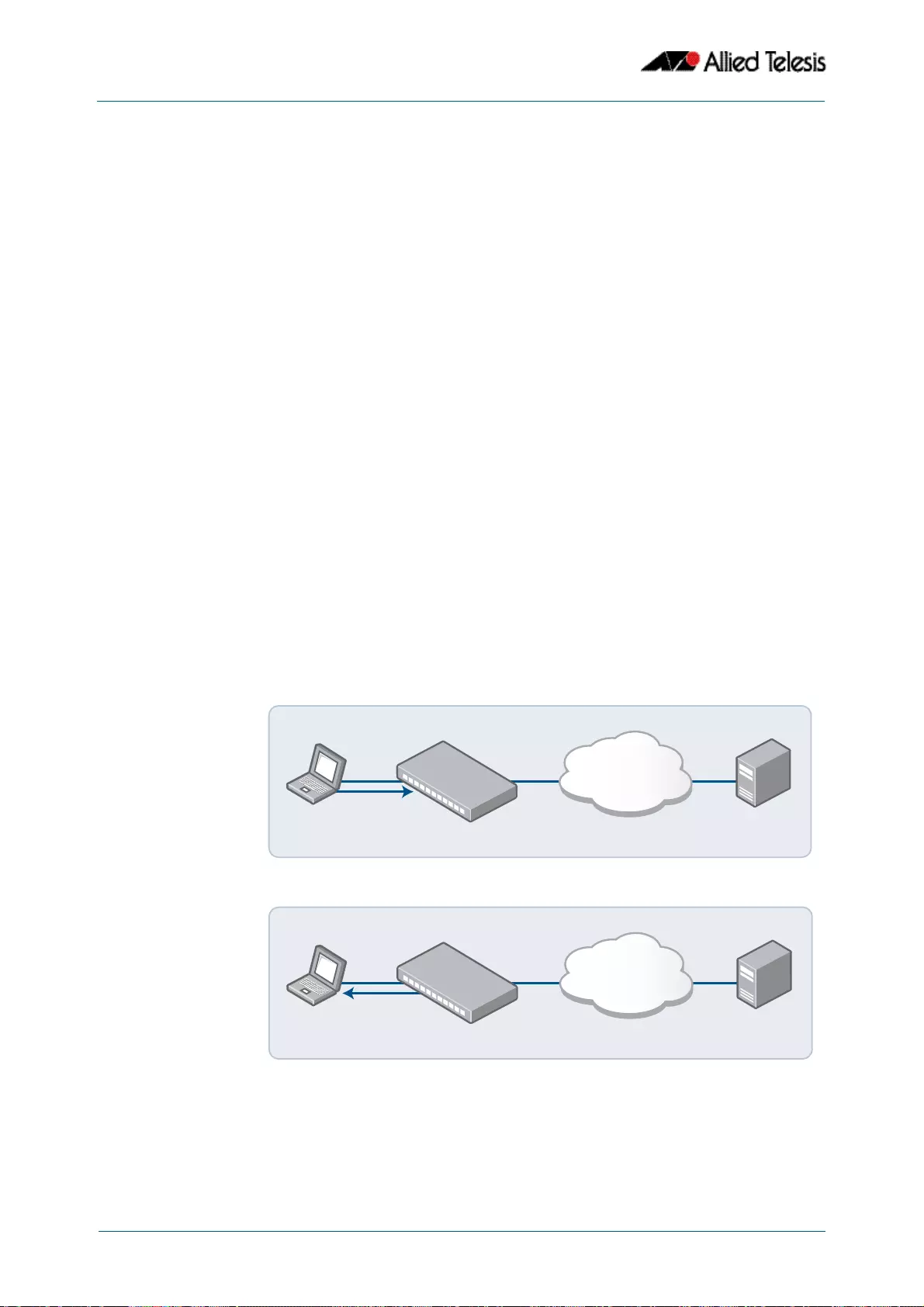
Authentication Introduction and Configuration
Software Reference for GS900MX/MPX Series Switches
42.4 AlliedWare PlusTM Operating System - Version 5.4.4E-1.x C613-50065-01 REV B
Web-Authentication
What is Web-Authentication?
Web-Authentication is a convenient alternative to 802.1X-Authentication. It’s commonly
used to authenticate users in educational institutions, where regular users’ workstations
are not managed by the network administrator. Web-Authentication enables the switch to
detect an unauthenticated workstation web browsing into the network, then redirect the
user’s web browser to its own authentication web page.
Web-Authentication works like this:
■The user enters their username and password into the web page, which the switch
then sends to a RADIUS server for checking.
■If the RADIUS server accepts the user’s credentials, the switch then allows their traffic
into the network.
The Web-authenticating switch interacts with a RADIUS server in the same way as an
802.1X authenticator. The two methods can be used together in the same network, using
the same RADIUS server.
Web-Authentication Basics
The operation of Web-Authentication is explained as below:
1. The authenticating switch receives HTTP or HTTPS traffic from an unauthenticated
supplicant. It intercepts the supplicant’s web session and redirects it to its own
internal web server.
Authenticator
RADIUS Server
Network
Supplicant
Supplicant initiates a
web session to a site
the user wishes to
access
Authenticator
RADIUS Server
Network
Supplicant
Authenticator intercepts the web
session, and redirects it to its own
authentication page
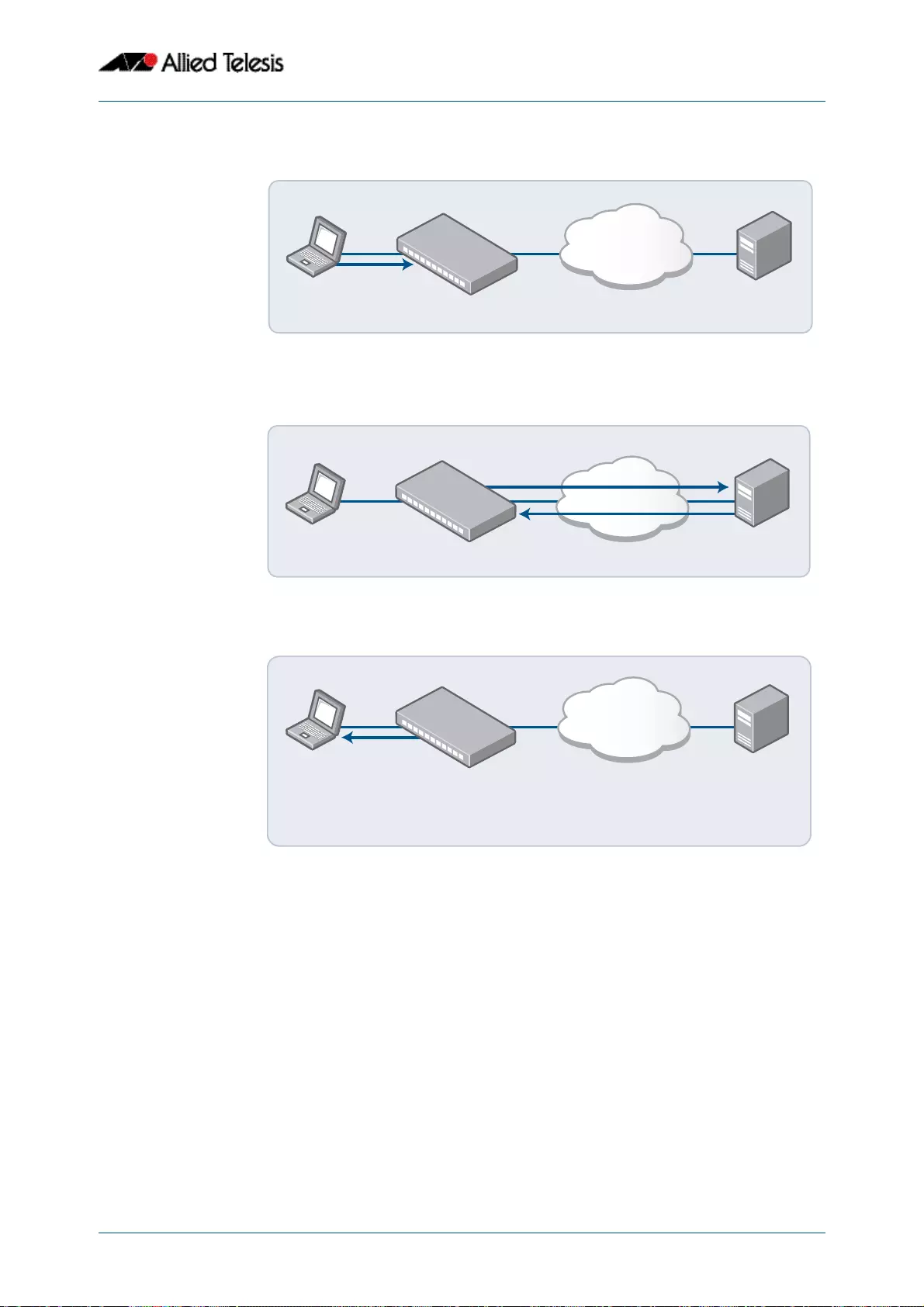
Authentication Introduction and Configuration
Software Reference for GS900MX/MPX Series Switches
C613-50065-01 REV B AlliedWare PlusTM Operating System - Version 5.4.4E-1.x 42.5
2. The web server serves up an authentication page on which the user enters their
username and password.
3. The username and password are sent to a RADIUS server, which informs the
authenticating switch whether or not the supplicant is authenticated.
4. The user is then informed of the RADIUS server’s verdict.
Authenticator
RADIUS Server
Network
Supplicant
User enters username and
password into authentication
webpage, and they are passed to
the switch
Authenticator RADIUS Server
Network
Supplicant
Switch forwards user’s
credentials to RADIUS
server
RADIUS server replies with
an accept ot reject message
Authenticator
RADIUS Server
Network
Supplicant
Depending on the reply from the
RADIUS server, the switch sends a
Success or Failure webpage to the
supplicant. If the authentication was
successful, the switch will allow the
supplicant trafc and forward it into the
network

Authentication Introduction and Configuration
Software Reference for GS900MX/MPX Series Switches
42.6 AlliedWare PlusTM Operating System - Version 5.4.4E-1.x C613-50065-01 REV B
5. If the supplicant has been successfully authenticated, the authenticating switch will
give the supplicant workstation access to the network.
Configuring Web-Authentication
Web-Authentication can be configured on a switch in the following steps:
1. Configure a RADIUS server.
2. Instruct Web-Authentication to use the configured RADIUS server.
3. Define the IP address through which the Web-Authentication service will be accessed.
4. Configure ports for Web-Authentication.
Choosing the Web-Authentication server address
When you come to configure Web-Authentication, you need to answer some questions:
Questions What IP address should I specify as the Web-Authentication server address? Is it okay to
use just any IP address that is configured on one of the switch’s VLANs, or is the choice
more constrained than that?
Answer You must use the IP address that is configured on the VLAN that the supplicant’s packets
will arrive on.
The logic that the switch uses in deciding which VLAN to associate non-authenticated
supplicants’ packets with is:
■If guest VLAN has been configured on the port where the packet arrives, then
associate the packet with the guest VLAN.
■Otherwise associate the packet with the port’s native VLAN.
awplus(config)# radius-server host <server-ip-address> key
<shared-secret>
awplus(config)# aaa authentication auth-web default group
radius
awplus(config)# auth-web-server ipaddress <ip-address>
awplus# interface port1.0.1-1.0.6
awplus(config)# auth-web enable
Authenticator
Network
Supplicant
Trafc from supplicant is
now allowed into the
network

Authentication Introduction and Configuration
Software Reference for GS900MX/MPX Series Switches
C613-50065-01 REV B AlliedWare PlusTM Operating System - Version 5.4.4E-1.x 42.7
If you configure the supplicant-connected ports with guest VLAN, then use the IP address
on the guest VLAN as the IP address of the Web-Authentication server. Otherwise use the
IP address on the supplicant-connected ports’ native VLAN.
The diagram below illustrates how to decide which IP address to use as the Web-auth-
server address:
Configuration Example 1: Using a guest VLAN
VLAN database
VLAN 20 name guest
VLAN 10 name edge
VLAN 30 name core
radius-server host 192.168.30.129 key verysecret
aaa authentication auth-Web default group RADIUS
auth-Web-server ipaddress 192.168.20.1
int vlan10
ip address 192.168.10.1/24
int vlan20
ip address 192.168.20.1/24
int vlan30
ip address 192.168.30.1/24
int port1.0.1-1.0.3
switchport access vlan 10
auth-Web enable
auth guest-vlan 20
int port1.0.4-1.0.6
switchport access vlan 30
Set the web-auth-server address
to be the IP address on the
authenticating ports’ native
VLAN
Which IP address to use as
web-auth-server address?
Has guest VLAN
been congured on the
authenticating ports?
NO
YES
Set the web-auth-server
address to be the IP address on
the guest VLAN

Authentication Introduction and Configuration
Software Reference for GS900MX/MPX Series Switches
42.8 AlliedWare PlusTM Operating System - Version 5.4.4E-1.x C613-50065-01 REV B
Configuration Example 2: Not using a guest VLAN
Starting a Web-Authentication Session
This section explains what the user actually sees in a Web-Authentication session:
1. The user starts their Web browser, and browses to a page they wish to view. Shortly
thereafter, the address in the browser’s address bar automatically changes to the
address of the authenticating switch’s authentication page.
2. In the switch’s authentication page, the user enters their user name and password,
and clicks login. The maximum length of the user name and password is 64
characters. The local RADIUS server has a password length limit of 31 characters.
VLAN database
VLAN 10 name edge
VLAN 30 name core
radius-server host 192.168.30.129 key verysecret
aaa authentication auth-web default group radius
auth-web-server ipaddress 192.168.10.1
int vlan10
ip address 192.168.10.1/24
int vlan30
ip address 192.168.30.1/24
int port1.0.1-1.0.3
switchport access vlan 10
auth-Web enable
int port1.0.4-1.0.6
switchport access vlan 30

Authentication Introduction and Configuration
Software Reference for GS900MX/MPX Series Switches
C613-50065-01 REV B AlliedWare PlusTM Operating System - Version 5.4.4E-1.x 42.9
3. The switch displays a page that informs them that authentication is in progress.
4. Once authentication is complete, the authentication result is displayed.
If the user enters a username/password combination that is not accepted by the RADIUS
server, the switch presents an invitation to check the username and password.

Authentication Introduction and Configuration
Software Reference for GS900MX/MPX Series Switches
42.10 AlliedWare PlusTM Operating System - Version 5.4.4E-1.x C613-50065-01 REV B
If the user enters incorrect usernames/passwords several times, the authentication fails.
The number of times a user can try to login is configurable but it is set to 10 by default.
Configuring an External Login Page
This section explains how to configure an external login page for Web-Authentication
rather than using the built-in AlliedWare Plus login page.
In this configuration example, a remote DHCP server is used to allocate IP addresses to the
supplicants. You can also configure Authenticator as a local DHCP server.
Note that routing in the network must be set up so that packets can be routed directly
between the supplicant and the external web server.
1. Configure the IP address for vlan1 to be used to reach remote DHCP/DNS/RADIUS
server.
awplus(config)# int vlan1
awplus(config-if)# ip address 192.168.1.2/24
Authenticator
External
Web Server
Network
Network
Supplicant
DHCP/DNS/RADIUS Server

Authentication Introduction and Configuration
Software Reference for GS900MX/MPX Series Switches
C613-50065-01 REV B AlliedWare PlusTM Operating System - Version 5.4.4E-1.x 42.11
2. Configure the remote DNS server on Authenticator.
3. Configure auth-web on Authenticator
4. Configure the remote RADIUS server on Authenticator. You can also configure
Authenticator as a local RADIUS server.
5. Configure the external login page by using the auth-web-server login-url command.
You can use the domain name or the IP address for the external web server. In this
example, the IP address of the external web server is 192.168.1.1. You also need to
allow HTTP packets to the external login server to be forwarded by using the auth-
web forward command. If the external web server is using another TCP port other
than 80, you need to change 80 to the corresponding port number.
Supplicant Login
This section explains what the user actually sees in an external Web-Authentication
session.
1. When a supplicant tries to access any website, the supplicant will be redirected to the
external login page for authentication.
2. On the device’s authentication page, the user enters their user name and password,
and clicks login.
awplus(config)# ip name-server x.x.x.x
awplus(config)# ip dns forwarding
awplus(config)# aaa authentication auth-web default group
radius
awplus(config)# int port1.0.1
awplus(config-if)# auth-web enable
awplus(config)# radius-server host 192.168.1.254 key 123
awplus(config)# auth-web-server login-url http://
192.168.1.1/login.html
awplus(config-if)# auth-web forward 192.168.1.1 tcp 80

Authentication Introduction and Configuration
Software Reference for GS900MX/MPX Series Switches
42.12 AlliedWare PlusTM Operating System - Version 5.4.4E-1.x C613-50065-01 REV B
3. The device displays a page that informs them that authentication is in progress.
4. Once authentication is complete, the authentication result is displayed.
If the user enters a username/password combination that is not accepted by the RADIUS
server, the device presents an invitation to check the username and password.

Authentication Introduction and Configuration
Software Reference for GS900MX/MPX Series Switches
C613-50065-01 REV B AlliedWare PlusTM Operating System - Version 5.4.4E-1.x 42.13
External Supplicant Login Page Support
A file named login.html must be present on the external web server. The file must contain
the following elements:
Note that Authenticator and the external web server don’t communicate with each other.
The role of the external web server is just to serve a custom login page.
Also note that the external login server feature and the auth-web dhcp server feature are
mutually exclusive. You cannot configure auth-web-server login-url and auth-web-server
dhcp ipaddress at the same time.
Customizing Web-Authentication Login Page
You can customize the Web-Authentication page by changing the web page logo image,
success message, welcome message, web page title and sub-title. For more information
about the commands used to customize the page, see Chapter 43, Authentication
<!DOCTYPE html>
<html>
<head>
<meta charset="utf-8" />
<title>HTML 5 complete</title>
</head>
<body>
<form action="http://<Authenticator IP address>/index.cgi"
autocomplete="off" target="_self" name="AUTH" method="POST">
<div>User name</div>
<div><input size="30" type="text" maxlength="64"
name="USERNAME"></div>
<div>Password</div>
<div><input size="30" type="password" maxlength="64"
name="PASSWORD"></div>
<div>
<input type="submit" name="ACTION" value="login">
<input type="reset" name="RESET" value="Reset">
</div>
</form>
<body>
</html>

Authentication Introduction and Configuration
Software Reference for GS900MX/MPX Series Switches
42.14 AlliedWare PlusTM Operating System - Version 5.4.4E-1.x C613-50065-01 REV B
Commands. The elements that can be customized are shown below:
■To set the custom sub-title and title on the Web-Authentication page, use the
commands below:
auth-web-server page sub-title {hidden|text <sub-title>}
auth-web-server page title {hidden|text <title>}
■To set the success and welcome message appearing on the Web-Authentication page,
use the commands below:
auth-web-server page welcome-message text <welcome-message>
auth-web-server page success-message text <success-message>
To set the type of logo appearing on the Web-Authentication page, use the commands
below:
auth-web-server page logo {auto|default|hidden}
To display the custom logo if installed, use the auto parameter.
To display the default Allied Telesis globe logo, use the default parameter.
To hide the logo, use the hidden parameter.
You need to upload the custom logo to the flash of the device from an external storage
media such as SD card, USB device or TFTP server. For example, to upload a custom logo
from a TFTP server to the flash of the device, use the commands below:
copy tftp://<tftp server address>/my_logo.gif flash:/logo.gif
The logo file name must be logo.gif and the file format must be gif. The recommended
dimension for the file is 185 X 90 pixels. The file must be stored in flash:/logo.gif on the
device. An example logo is shown below:

Authentication Introduction and Configuration
Software Reference for GS900MX/MPX Series Switches
C613-50065-01 REV B AlliedWare PlusTM Operating System - Version 5.4.4E-1.x 42.15
Use the following commands to customize the login page.
auth-web-server page sub-title text Example Sub-title Text
auth-web-server page title Example Title
auth-web-server page welcome-message text Example Welcome Message
auth-web-server page success-message text Example success Message
The custom Web-Authentication login page is displayed below:
Support for Protocols Underlying
Web-Authentication
Web-Authentication does not use a dedicated protocol like 802.1X, with a standards-
defined set of messages for authentication conversation. Instead, the switch overlays the
Web-Authentication process on top of the web browser communication process. The
browser communication process was not designed for authentication and is itself reliant
on IP addressing, ARP, and DNS.
The authentication needs to occur in a seamless manner for all users, irrespective of their
IP and DNS setting, and before they have full access to the network.

Authentication Introduction and Configuration
Software Reference for GS900MX/MPX Series Switches
42.16 AlliedWare PlusTM Operating System - Version 5.4.4E-1.x C613-50065-01 REV B
To make this possible, the switch needs to provide facilities that enable the user’s PC to
access the authentication web page.
Following features of Web-Authentication work together to achieve this.
■DHCP server for Web-Authentication
■Interception of clients’ ARPs
■Proxy DNS response
DHCP server for Web-Authentication
To initiate a web browsing session, the supplicant needs an IP address. If the supplicant
has been configured to obtain its IP address by DHCP, then the authenticating switch
needs to ensure that the supplicant will be served an IP address.
The simplest way to achieve this, is to have the Web-Authentication process itself act as a
DHCP server. This avoids forwarding the supplicant’s DHCP request to any other DHCP
server. Therefore, there is a DHCP server built in to Web-Authentication.
This DHCP server is dedicated to serving IP addresses to be used by Web-Authentication
clients.
This DHCP service is configured by the command:
See the auth-web-server dhcp ipaddress command on page 43.41 and the auth-web-
server dhcp lease command on page 43.42 for details about configuring the Web-
Authentication DHCP Server.
How can we force the supplicant to request a new DHCP lease after the completion of the
authentication process? There is no mechanism by which the supplicant’s web browser
signals down to the DHCP client process to say “I’ve just completed an authentication
session, so you need to request a new DHCP lease”.
awplus(config)# auth-web-server dhcp ipaddress <ip-address/
prefix-length>
Authenticator
VLAN236
DHCP Server
Network
Supplicant
Supplicant makes an
initial DHCP request
Authenticator
Network
Supplicant
Lease allocated by Web
Authentication server
IP=192.168.1.34
leasetime=30sec
VLAN236
DHCP Server

Authentication Introduction and Configuration
Software Reference for GS900MX/MPX Series Switches
C613-50065-01 REV B AlliedWare PlusTM Operating System - Version 5.4.4E-1.x 42.17
The solution is to ensure that the lease allocated by the dedicated Web-Authentication
DHCP service is of a very short duration. This way the lease will expire within a short time
from the completion of the authentication process, resulting in the supplicant requesting
a new lease.
This new request will now be serviced by the DHCP server on the supplicant’s new VLAN.
Interception of clients’ ARPs
If the supplicant has been configured with a static IP address, then it is more than likely
that the supplicant’s IP configuration bears no relation to the Web-Authentication server
address. A computer’s IP communications will always be preceded by sending out ARP
requests for host addresses in its local subnet, or for its gateway address.
If the IP address and gateway address have been statically configured on the computer,
and the subnet used in this static configuration is different to that on the authenticating
switch, then the ARP requests will receive no reply, and the PC will not begin IP
communication.
Authenticator
VLAN236
DHCP Server
Network
Supplicant
Initial lease has expired,
so supplicant requests a
new lease
Authenticator
Network
Supplicant
DHCP request is forwarded to
DHCP server on supplicant’s new
VLAN
VLAN236
DHCP Server
After authentication, supplicant’s
port moves to VLAN236
Authenticator
VLAN236
DHCP Server
Network
Supplicant
New lease is for subnet
on VLAN236
IP=10.32.17.89
leasetime=1 day
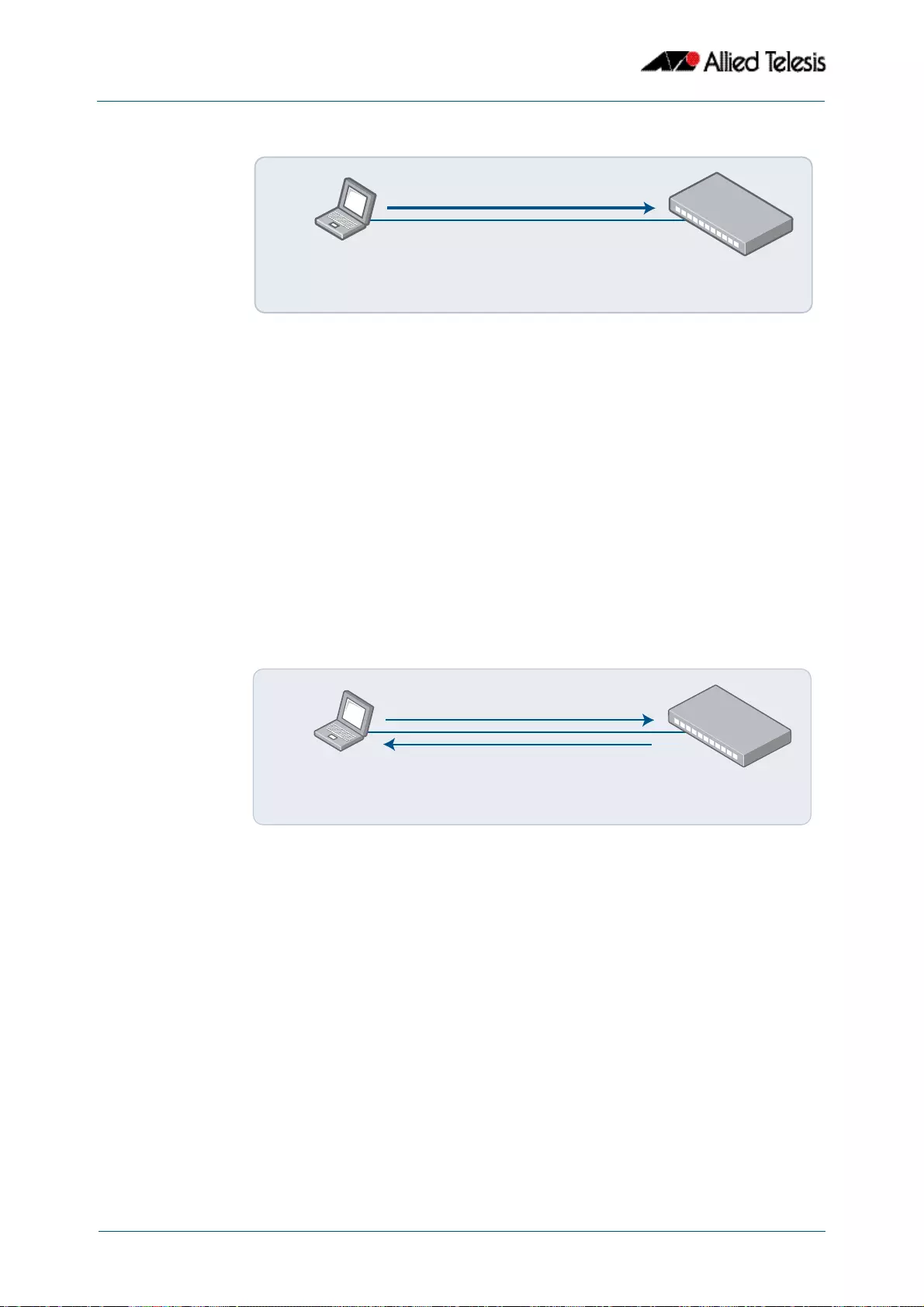
Authentication Introduction and Configuration
Software Reference for GS900MX/MPX Series Switches
42.18 AlliedWare PlusTM Operating System - Version 5.4.4E-1.x C613-50065-01 REV B
To deal with any arbitrary IP configuration on the supplicants, Web-Authentication needs
a method for replying to arbitrary ARP requests. This is the ARP interception feature.
ARP interception can operate in three modes.
1. Intercept – will respond to ARP requests for any IP address that is in the same subnet
as the switch’s own IP address. Will provide its own MAC address in the ARP reply,
irrespective of what IP address (within its own subnet) was being requested.
2. None – will only respond to ARP requests for its own IP address.
3. Promiscuous – will respond to any ARP request. Will provide its own MAC address in
the ARP reply, irrespective of what IP address was being requested. When this mode is
configured, the Web-Authentication server can interoperate with any static IP
configuration on a supplicant.
See the auth-web-server mode (deleted) command on page 43.50 for command
information about setting the Web-Authentication mode.
Proxy DNS response
Typically, an HTTP session from a web browser is preceded by a DNS request for the IP
address of the web site the user wishes to browse to. If the DNS request receives no reply,
the web browser will never progress on to connecting an HTTP session.
The Web-Authentication server needs a mechanism to reply to DNS requests, so that the
Web-Authentication session can begin.
ARP request. Who has 23.67.0.1?
IP = 23.67.2.9/16
Gateway = 23.67.0.1
The ARP request for 23.67.0.1 will get no reply, as the switch is
congured in a different subnet
ARP request. Who has 23.67.0.1?
Supplicant congured with
IP address 23.67.2.9 and
Gateway IP 23.67.0.1
Authenticator with MAC
address 0000.a349.1c71
ARP reply. 23.67.0.1 is at 0000.a349.1c71
10.17.56.2
In promiscuous mode, the switch will send its own MAC address in response to an ARP request
for ANY address, no matter whether the requested address bears any relation to the switch’s own
IP address on the interface where the ARP is received.

Authentication Introduction and Configuration
Software Reference for GS900MX/MPX Series Switches
C613-50065-01 REV B AlliedWare PlusTM Operating System - Version 5.4.4E-1.x 42.19
The three modes listed also control the operation of the proxy DNS replies.
1. Intercept – responds to DNS requests whose source IP address is within the same
subnet as the IP address on the switch. The IP address provided as the resolution of
the DNS lookup is the switch’s own IP address, so that the subsequent HTTP traffic will
be directed to the switch.
2. None – the default. Does not respond to DNS requests.
3. Promiscuous – responds to DNS requests from any source IP address. The IP address
provided as the resolution of the DNS lookup is the switch’s own IP address, so that
the subsequent HTTP traffic will be directed to the switch.
See the auth-web-server mode (deleted) command on page 43.50 for command
information about setting the Web-Authentication mode.
You can use the parameter <ip-address> of the auth-web forward command to
specify a server for the switch to send packets from the supplicant to, for example DNS
packets. For more information and an example, see the “Forwarding DNS packets using
Auth-web forward command” section in the Alliedware Plus Technical Tips and Tricks.
Authenticator
Network
Supplicant
A web browser must request a DNS Server for the IP address corresponding to a URL. But the
switch will not forward the request if the supplicant is not yet authenticated
DNS Server
129.93.23.213
IP = 23.67.7.9
DNS = 129.93.23.213
DNS request. What is
IP for
www.mysite.com?
DNS request to 129.93.23.213 - what is the IP address
of www.mysite.com?
Supplicant congured
with IP address 23.67.2.9
and DNS server address
129.93.23.213
Authenticator
DNS reply - the IP address of www.mysite.com
is 10.17.56.2
10.17.56.2
In promiscuous mode, the switch will reply to ANY DNS request from an authenticated supplicant, regardless of
whether the destination IP address of the DNS server bears any relation to the switch’s own IP address. The DNS
reply from the switch will always specify its own IP address as the URL that was being requested.

Authentication Introduction and Configuration
Software Reference for GS900MX/MPX Series Switches
42.20 AlliedWare PlusTM Operating System - Version 5.4.4E-1.x C613-50065-01 REV B
Web-Authentication Timeout Connect
The command auth timeout connect-timeout allows you to increase the connection
period for a supplicant’s interface port.
The default timeout period is 30 seconds, but this command allows the timeout period to
be set from 1 second to 65535 seconds. When auth-web-server session-keep or auth
two-step enable is enabled, it is recommended to configure a longer connect-timeout
period.

Authentication Introduction and Configuration
Software Reference for GS900MX/MPX Series Switches
C613-50065-01 REV B AlliedWare PlusTM Operating System - Version 5.4.4E-1.x 42.21
Web Authorization Proxy
Without this feature, AlliedWare Plus Web-Authentication intercepts a supplicant’s initial
TCP port 80 connection to a web page and sends it to the Web-Authentication Login page.
However, if the supplicant is configured to use a web proxy, then it will usually be using
TCP port 8080 (or another user configured port number). In this case Web-Authentication
cannot intercept the connection.
To overcome this limitation, use the command auth-web-server intercept-port.
When a supplicant is configured to use WPAD (Web Proxy Auto-Discovery) the
supplicant’s web browser will use TCP port 80 as usual, and so it can be intercepted by
Web-Authentication as normal, and the Web-Authentication Login page is sent. However,
after authentication, it does not know where to get the WPAD file (usually named
proxy.pac) that tells it what its web proxy is and so cannot access external web pages.
You can use the auth-web-server dhcp-wpad-option command to tell the supplicant
where to find the proxy.pac file. This proxy.pac file contains the URL and/or IP address of
the web proxy server that it should use.
For more information and examples, see the “Web Auth Proxy” section in the Alliedware
Plus Technical Tips and Tricks.

Authentication Introduction and Configuration
Software Reference for GS900MX/MPX Series Switches
42.22 AlliedWare PlusTM Operating System - Version 5.4.4E-1.x C613-50065-01 REV B
MAC-Authentication
Why is MAC-Authentication Required?
The authentication mechanisms provided by 802.1X and Web-Authentication are
powerful and effective. But, they are not universally applicable. Web-Authentication is
only applicable to devices that have a human user who opens the web browser and types
in a username and password when requested. 802.1X-Authentication is only possible from
devices whose software implements an 802.1X supplicant.
There are plenty of network-connected devices, like printers, scanners, fire-alarm monitors
and so on, that have neither a human user nor implement an 802.1X supplicant. In a
network that ensures all access is authenticated, there needs to be a mechanism for
authenticating these devices.
Fortunately, all Ethernet transceivers have a unique identifier—their MAC address. Hence,
even without user input of a username and password, any Ethernet device will
automatically identify itself simply by virtue of the source MAC address in the packets it
sends. The method that has been developed for authenticating these devices uses the
MAC address as the identifier, and so is called MAC-based authentication.
How Does MAC-Authentication Work?
In essence, MAC-authentication works little differently from 802.1X or Web-based
authentication.
Here are the main steps:
1. The supplicant is connected to the switch.
2. The switch (acting as the authenticator) receives an ID from the supplicant.
3. The switch passes the supplicant's ID to a RADIUS server in an Access-Request packet
4. The RADIUS server returns an Access-Accept or an Access-Deny. The Access-Accept
can be accompanied with other attributes, for dynamic VLAN assignment.
The unique aspects of MAC-Authentication are in steps 2 and 3.
MAC-Authentication does not involve a process whereby the switch sends an ID request to
the supplicant. The switch receives the ID from the supplicant by simply looking at the
source MAC in the packets being sent from the supplicant.
The MAC address of the supplicant is a single identifier. But a RADIUS access-request
requires both a username and a password. The workaround employed by MAC-
Authentication is simply to use the MAC address as both username and password.

Authentication Introduction and Configuration
Software Reference for GS900MX/MPX Series Switches
C613-50065-01 REV B AlliedWare PlusTM Operating System - Version 5.4.4E-1.x 42.23
The switch extracts the source MAC address from the supplicant's packets and puts it into
a string of the form xx-xx-xx-xx-xx-xx, using lower-case letters for any hex digits in the
range a-f. This string is then used as both the username and the password in the RADIUS
access-request packet. The supplicant MAC address is also sent in the attribute 31 “calling-
station-id” as usual.
Configuring MAC-Authentication
Under AlliedWare Plus, there are two steps to setting up MAC-Authentication.
1. Define the authentication method list that is used for MAC-Authentication.
There is only one method list that can be created for MAC-Authentication—the default
method list. Moreover, the only authentication server type that can be used is RADIUS.
The command for defining the method list is:
2. Enable MAC-Authentication on the ports that are to perform this authentication:
On the RADIUS server, it is necessary to create user entries where both the username and
password are the MAC address of the supplicant, in the form xx-xx-xx-xx-xx-xx.
For example, on the AlliedWare Plus local RADIUS server, the configuration is:
The supplicant requires no configuration, as the whole purpose of MAC-Authentication is
to authenticate devices that cannot be configured for authentication.
It is also possible to configure the authentication protocol that the switch uses in its
interaction with the RADIUS server. There are two choices of protocol: EAP-MD5 and PAP.
The default method is PAP, and can be changed by using the command:
awplus(config)# aaa authentication auth-mac default group
radius
awplus(config)# interface port1.0.2
awplus(config)# auth-mac enable
awplus(config)# spanning-tree edgeport
awplus(config)# radius-server local
awplus(config-radsrv)# user xx-xx-xx-xx-xx-xx
password xx-xx-xx-xx-xx-xx
awplus(config-if)# auth-mac method [eap-md5|pap]

Authentication Introduction and Configuration
Software Reference for GS900MX/MPX Series Switches
42.24 AlliedWare PlusTM Operating System - Version 5.4.4E-1.x C613-50065-01 REV B
Tri-Authentication
The switch supports three types of authentication for devices that connect to switch ports.
■802.1X-Authentication of devices connecting to switch ports
■MAC-Authentication of devices connecting to switch ports
■Web-Authentication of devices connecting to switch ports
All three types can be configured to run simultaneously on a switch port. The
simultaneous configuration and authentication of all three types on a port is called tri-
authentication.

Authentication Introduction and Configuration
Software Reference for GS900MX/MPX Series Switches
C613-50065-01 REV B AlliedWare PlusTM Operating System - Version 5.4.4E-1.x 42.25
Tri-Authentication Configuration
Follow the below three steps to configure tri-authentication across a range of switch
ports:
Step 1: Define the RADIUS Server:
Define the RADIUS Server where the switch will send authentication requests by
using the below commands:
These commands adds the RADIUS Server address and set parameters to the
RADIUS server. The key parameter specifies the secret key for the server.
Step 2: Define the default authentication server lists:
Define the default authentication server lists for 802.1X-Authentication, Web-
Authentication, and MAC-Authentication:
awplus# configure terminal
awplus(config)# radius-server host <ip-address> key
<key-string>
awplus# configure terminal
awplus(config)# aaa authentication dot1x default group radius
awplus(config)# aaa authentication auth-web default group
radius
awplus(config)# aaa authentication auth-mac default group
radius

Authentication Introduction and Configuration
Software Reference for GS900MX/MPX Series Switches
42.26 AlliedWare PlusTM Operating System - Version 5.4.4E-1.x C613-50065-01 REV B
Step 3: Enable 802.1X-Authentication, Web-Authentication, and MAC-
Authentication:
Follow the instructions below to enable 802.1X-Authentication, Web-
Authentication, and MAC-Authentication on switch ports to attach supplicant
devices. This authenticates the supplicant if any of the three methods that the
supplicant tries work, depending on the auth-fail VLAN settings. After enabling
the authentication, refer to earlier chapters to configure VLAN, IP address and
other authentication configurations for the authentication type you want.
awplus# configure terminal
awplus(config)# interface <interface-range>
awplus(config-if)# switchport mode access
awplus(config-if)# switchport access vlan 1
awplus(config-if)# auth-web enable
awplus(config-if)# auth-mac enable
awplus(config-if)# dot1x port-control auto
awplus(config-if)# auth dynamic-vlan-creation

Authentication Introduction and Configuration
Software Reference for GS900MX/MPX Series Switches
C613-50065-01 REV B AlliedWare PlusTM Operating System - Version 5.4.4E-1.x 42.27
Two-Step Authentication
The single step authentication methods (either user or device authentication) have a
potential security risk:
■an unauthorized user can access the network with an authorized device
■an authorized user can access the network with an unauthorized device
Two-step authentication solves this problem by authenticating both the user and the
device. The supplicant will only become authenticated if both these steps are successful. If
the first authentication step fails, then the second step is not started.
The following authentication sequences are supported for two-step authentication:
MAC-Authentication followed by 802.1X-Authentication
MAC-Authentication followed by Web-Authentication
802.1X-Authentication followed by Web-Authentication.
To configure two-step authentication:
1. Configure the first authentication method.
2. Configure the second authentication method.
3. Specify the command auth two-step enable.
4. Make sure that both authentication steps require different authentication credentials.
See “Ensuring Authentication Methods Require Different Usernames and
Passwords” on page 42.28.
For more information and examples, see the “Two-step authentication” section in the
Alliedware Plus Technical Tips and Tricks.

Authentication Introduction and Configuration
Software Reference for GS900MX/MPX Series Switches
42.28 AlliedWare PlusTM Operating System - Version 5.4.4E-1.x C613-50065-01 REV B
Ensuring Authentication Methods Require
Different Usernames and Passwords
If you configure a user or device to use multiple authentication methods, you need to set
up your system to avoid a potential vulnerability.
The vulnerability occurs because there is no way for a RADIUS server to determine what
authentication method you are using. Authentication simply queries a RADIUS server to
see whether a username/password pair is valid.
This means that if you use the same RADIUS server for multiple authentication methods, a
user can enter the same username/password pair for each of these authentication
methods. If that username/password pair is valid for one of the methods, it will work for all
of them.
This vulnerability is particularly significant for MAC-Authentication, because the default
username and password is the MAC address of the supplicant device, which is easy to
discover.
For example, if you set up two-step authentication of MAC-Authentication and
802.1X-Authentication, and both use the same RADIUS server, then an attacker does not
need to know the 801.1x username and password. Instead, they can pass the
802.1X-Authentication step by entering the device’s MAC address into the 802.1X
username and password fields.
To avoid this vulnerability:
■Use different RADIUS servers for each authentication method, and/or
■Change the default password for MAC-Authentication, by using the auth-mac
password command on page 43.33.

Authentication Introduction and Configuration
Software Reference for GS900MX/MPX Series Switches
C613-50065-01 REV B AlliedWare PlusTM Operating System - Version 5.4.4E-1.x 42.29
Roaming Authentication
When network security is required, the usability of network security must be considered.
The Roaming Authentication feature improves the usability of network security by
enabling users to move within the network without requiring them to re-authenticate
each time they move.
If a supplicant (client device) moves from one wireless access point to another wireless
access point, and the wireless access points are connected to different ports, then the
switch (authenticator) recognizes that the supplicant has been authenticated and accepts
the supplicant without requiring re-authentication.
Figure 42-1: Diagram showing Roaming Authentication running on a standalone
switch
Web-Authentication and MAC-Authentication are the authentication methods in a
Wireless LAN environment, and 802.1X is the authentication method used for supplicants
attached to edge switches.
Roaming Authentication is normally enabled using the auth roaming enable command
on page 43.19 command. However, Roaming Authentication has been extended (with the
auth roaming disconnected command on page 43.17) to work where an interface is link
down. This allows you to enable supplicants to move from authenticated interfaces that
are link down, without requiring re-authentication.
Roaming Authentication is available for use with the VCStack feature, and is available on
static and dynamic (LACP) channel group interfaces.
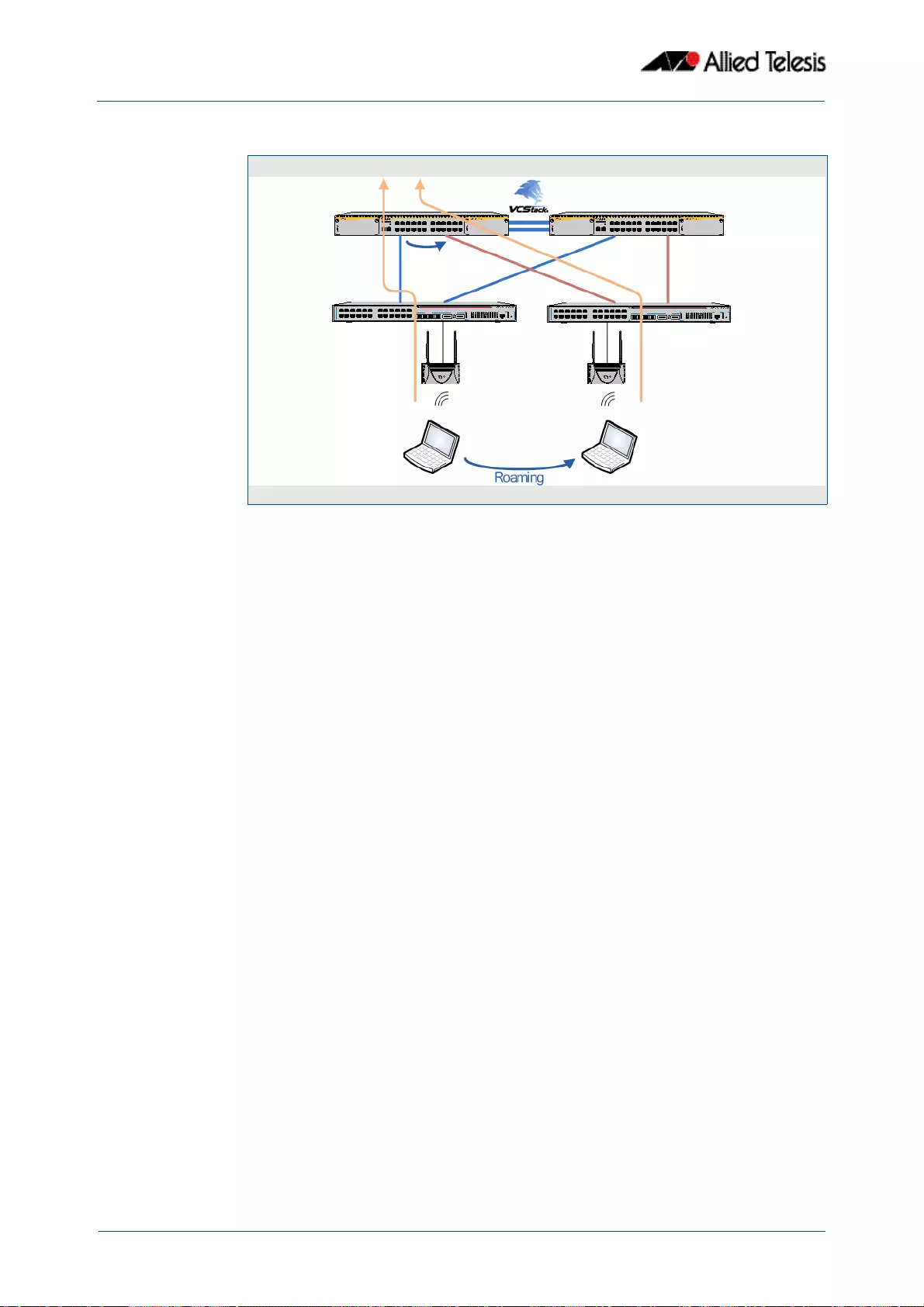
Authentication Introduction and Configuration
Software Reference for GS900MX/MPX Series Switches
42.30 AlliedWare PlusTM Operating System - Version 5.4.4E-1.x C613-50065-01 REV B
Figure 42-2: Diagram showing Roaming Authentication running with VCStack
Roaming Authentication Overview
If the Roaming Authentication feature is disabled and a supplicant moves from one
switchport to another, the supplicant’s authenticated status, authentication, and assigned
VLAN are deleted. The supplicant is re-authenticated at the new switchport so that the
network can be accessed. While the supplicant is being re-authenticated, all traffic from
the supplicant is dropped.
When the Roaming Authentication feature is enabled, a new switch port inherits the
status of a supplicant from the switch port that the supplicant moved from. If the Roaming
Authentication feature is enabled on a switch, then once a supplicant (client device) is
authenticated on the switch it does not have to be re-authenticated if it moves between
the ports of that switch. Supplicant traffic is not dropped because there is no delay for re-
authentication, during which the supplicant would be unable to access the network.
For example, when the Roaming Authentication feature is used in a wireless LAN
environment with wireless access points, the wireless clients can roam between wireless
access points connected to different switch ports without re-authentication.
The Roaming Authentication feature also supports VCStack operation and works on
defined static channel group (static aggregators) and dynamic channel group (LACP)
interfaces. When VCStack and Roaming Authentication features are used together, the
status of a supplicant is inherited from one aggregated interface to another aggregated
interface over the stack.
See the auth roaming disconnected command on page 43.17 and the auth roaming
enable command on page 43.19 for further information about configuring Roaming
Authentication.

Authentication Introduction and Configuration
Software Reference for GS900MX/MPX Series Switches
C613-50065-01 REV B AlliedWare PlusTM Operating System - Version 5.4.4E-1.x 42.31
Roaming Authentication Feature Interactions
When the Roaming Authentication feature is disabled, a supplicant must be re-
authenticated on the destination interface when it roams. When the Roaming
Authentication is enabled, the following supplicant authentication status and information
is inherited from the source interface:
■Authentication status
■Authentication method
■Supplicant MAC address
■Supplicant IP address
(if an authenticated interface is configured for Web-Authentication)
■Supplicant name
■Authorized dynamic VLAN ID
■Authorized RADIUS server
■Reauthentication timer
(if configured using the auth timeout reauth-period command on page 43.25)
Roaming Authentication is only supported between interfaces with the same
authentication configuration. If source and destination interfaces have different
authentication configuration then the supplicant will be re-authenticated at the
destination interface.
When the host mode is set with the auth host-mode command on page 43.11, a
supplicant is not authenticated on a destination interface, and the authentication status is
deleted on the source interface.
When a supplicant moves from an interface with authentication configured to an interface
without authentication configured, the supplicant’s authentication status is deleted.
A supplicant is re-authenticated when it moves to a destination interface that is
configured on a different VLAN than the VLAN that is configured for the source interface.
See the following Roaming Authentication feature interactions:
■Multiple Dynamic VLANs are supported when configured with the auth dynamic-
vlan-creation command on page 43.6 using the multi parameter. Multiple Dynamic
VLANs are disabled by default.
■Supplicants are re-authenticated on the destination interface if the VLAN ID changes
when Single Dynamic VLANs are configured with the auth dynamic-vlan-creation
command on page 43.6 the using the single parameter. Single Dynamic VLANs are
disabled by default.
■The Roaming Authentication feature is supported on Guest VLANs configured by the
auth guest-vlan command on page 43.9.
When the Roaming Authentication feature is configured for use on a stack with the
VCStack feature, note that supplicants are initialized and re-authenticated if a VCStack
failover occurs.

Authentication Introduction and Configuration
Software Reference for GS900MX/MPX Series Switches
42.32 AlliedWare PlusTM Operating System - Version 5.4.4E-1.x C613-50065-01 REV B
Unauthenticated Supplicant Traffic
When any authentication is configured on a switch port, the question arises as to what the
switch does with packets that arrive into the switch port from unauthenticated
supplicants.
Unauthenticated supplicants fall into three categories listed below:
■Newly attached supplicants, which are still in the process of their first authentication
attempt
■Supplicants that have made an authentication attempt, but have failed
authentication
■Supplicants that have been attached, but have not made an authentication attempt.
For example, on a port that has only 802.1X-Authentication enabled, any supplicant
that has no 802.1X client software will not be able to attempt 802.1X-Authentication.
In switches that are running the AlliedWare PlusTM Operating System, packets from all
these three categories of unathenticated supplicants are treated equally; no distinction is
made between these three categories. The treatment of the traffic from unauthenticated
supplicants does, however, depend on two factors:
■Whether a Guest VLAN has been configured on the switch port to which the
supplicant is attached
■Whether Web-Authentication has been configured on the switch port to which the
supplicant is attached
The rules governing the treatment of packets from unauthenticated supplicants are laid
out in the table below:

Authentication Introduction and Configuration
Software Reference for GS900MX/MPX Series Switches
C613-50065-01 REV B AlliedWare PlusTM Operating System - Version 5.4.4E-1.x 42.33
Table 42-1: Treatment of packets from unauthenticated supplicants
Switch port
configuration No Guest VLAN configured
No Guest VLAN
configured, auth-fail
VLAN configured Guest VLAN configured
Web-
Authentication
configured
Packets from unauthenticated
supplicants are associated with
the Native VLAN of the port.
Packets from unauthenticated
supplicants are processed
according these rules:
■Packets destined to the
WebAuth server IP address/
TCP port are forwarded to
the server (which may well
be the switch itself).
■DHCP packets are sent to
the CPU, to be processed by
a local DHCP server, or
relayed to another DHCP
server, depending on the
configuration of the switch.
■DNS packets are forwarded
to the CPU, and then sent on
to a DNS server, if the switch
is configured with a DNS
server address.
■ARP packets are forwarded
to the CPU, and an ARP
entry for the supplicant is
learned.
■If web-auth forwarding is
enabled for particular types
of packets, then those
packets will be forwarded
within the Native VLAN
■All other packets are
dropped.
Packets from
unauthenticated
supplicants are
associated with the
Native VLAN of the
port. If newly
connected supplicants
attempt 802.1X port
authentication or Web-
Authentication and fail,
then they are moved to
the auth-fail VLAN.
Packets from unauthenticated
supplicants are associated with
the Guest VLAN of the port.
Packets from unauthenticated
supplicants are processed
according to these rules:
■Packets destined to the
WebAuth server IP address/
TCP port are forwarded to
the server (which may well
be the switch itself).
■DHCP packets are sent to the
CPU, to be processed by a
local DHCP server, or relayed
to another DHCP server,
depending on the
configuration of the switch.
■DNS packets are forwarded
to the CPU, and then sent on
to a DNS server, if the switch
is configured with a DNS
server address.
■ARP packets are forwarded
to the CPU, and an ARP entry
for the supplicant is learned.
■Drop all other packets
destined to the IP address of
the Guest VLAN.
■Layer 2 forward packets
destined to other addresses
within the Guest VLAN.
■All other packets are
dropped.
No Web-
Authentication
configured
All non-eap packets from
unauthenticated supplicants
are dropped.
All non-eap packets
from unauthenticated
supplicants are
dropped.
Packets from unauthenticated
supplicants are associated with
the Guest VLAN of the port. The
packets are processed according
to these rules:
■Drop packets destined to the
IP address of the Guest
VLAN.
■Layer 2 forward packets
destined to other addresses
within the Guest VLAN.
■Drop all other packets.

Authentication Introduction and Configuration
Software Reference for GS900MX/MPX Series Switches
42.34 AlliedWare PlusTM Operating System - Version 5.4.4E-1.x C613-50065-01 REV B
Deciding When a Supplicant Fails Authentication
Although the treatment of packets from unauthenticated supplicants does not
differentiate between the three categories of supplicant, it is still useful to know for sure
when the switch decides that a supplicant has failed authentication.
The rules for deciding that a supplicant has failed authentication are listed below for each
type of authentication available:
Deciding when a supplicant fails 802.1X-Authentication
If the supplicant responds to EAP authentication requests, and the supplicant’s
authentication information is sent to the RADIUS server, and the RADIUS server replies
with an Authentication-Reject, then the supplicant is immediately deemed to have failed
authentication.
If the supplicant does not respond to EAP authentication requests, then the switch will
resend the authentication requests up to a maximum number of attempts set by the
command dot1x max-reauth-req (the default is 2). The interval between the attempts is
set by the command dot1x timeout tx-period (the default is 30 seconds). If the
supplicant still has not responded after this, it is deemed to have not attempted
authentication.
See Chapter 47, 802.1X Commands for 802.1X-Authentication command information.
Deciding when a supplicant fails Web-Authentication
As soon as the supplicant attempts any web-browsing, the switch will intercept the web
session, and present the supplicant with an authentication request page. If the user enters
a username and password, and clicks the login button, then the switch will send the
username and password to the RADIUS server. If the RADIUS server replies with an
Authentication-Reject, then the supplicant is immediately deemed to have failed
authentication.
Until the supplicant has attempted any web-browsing, or has received the authentication
request page, but not yet clicked the login button, the supplicant is deemed to be not yet
authenticated (as against not able to authenticate).
See Chapter 43, Authentication Commands for Web-Authentication command
information.
Deciding when a supplicant fails MAC-Authentication
As soon as the supplicant sends any packet, the source MAC address from the packet will
be sent to the RADIUS server for authentication. If the RADIUS server replies with an
Authentication-Reject, then the supplicant is immediately deemed to have failed
authentication.
With MAC-Authentication there really is no concept of not-yet-attempted authentication,
because authentication is attempted as soon as a supplicant sends a packet.
See Chapter 43, Authentication Commands for MAC-Authentication command
information.

Authentication Introduction and Configuration
Software Reference for GS900MX/MPX Series Switches
C613-50065-01 REV B AlliedWare PlusTM Operating System - Version 5.4.4E-1.x 42.35
Failed Authentication VLAN
The auth-fail VLAN feature allows the network administrator to separate the supplicants
who attempted authentication, but failed, from the supplicants who did not attempt
authentication.
This feature enables the network administrator to enact a security policy in which the
supplicants who fail authentication are given extremely limited access, or are given access
to remedial applications.
If the Guest VLAN and auth-fail VLAN are both configured on a switch, then a newly
connected supplicant initially belongs to the Guest VLAN. If newly connected supplicants
attempt 802.1X port authentication or Web-Authentication and fail, then they are moved
from the Guest VLAN to the auth-fail VLAN.
The criteria for how many failed authentication attempts are allowed before the
supplicant is moved to the auth-fail VLAN differs, depending on the authentication
method used.
If Web-Authentication is used, then the supplicant is moved to the auth-fail VLAN after the
first failed attempt. If 802.1X port authentication is used, then the supplicant is moved to
the auth-fail VLAN after the number of failed attempts is equal to the value configured by
the dot1x max-auth-fail command (by default, three failed 802.1X-Authentication
attempts are allowed).
The MAC-Authentication feature does not support the max-auth-fail option. If auth-fail
VLAN feature is used in conjunction with MAC-Authentication only one attempt is allowed
for a MAC-Authentication supplicant. If the attempt fails, then the supplicant will be
treated as “Authenticated” and the interface will be added to the configured auth-fail
VLAN.
Limitations on Allowed Feature Combinations
Note that the Web-Authentication feature cannot be used with the Guest VLAN or auth-
fail VLAN features. For further limitation information see the below tables:
Table 42-2: Interoperation of authentication types with guest VLAN and auth-fail
VLAN
Authentication
Type
Guest VLAN
(without routing mode)
Guest VLAN (with
routing mode) Failed Authentication VLAN
802.1X-
Authentication Layer 2 forward packets
destined to other
addresses within the Guest
VLAN.
Unauthorized supplicant can
access Guest VLAN. Use ACL
for security on the interface.
Failed authentication
supplicant can access auth-fail
VLAN. See limitations table
below for ACL usage limitation.
MAC-
Authentication Layer 2 forward packets
destined to other
addresses within the Guest
VLAN.
Unauthorized supplicant can
access Guest VLAN. Use ACL
for security on the interface.
Failed authentication
supplicant can access auth-fail
VLAN. See limitations table
below for ACL usage limitation.
Web-
Authentication
(without
intercept mode)
Layer 2 forward packets
destined to other
addresses within the Guest
VLAN.
Unauthorized supplicant can
access Guest VLAN. Use ACL
for security on the interface.
Failed authentication
supplicant can access auth-fail
VLAN. See limitations table
below for ACL usage limitation.
Web-
Authentication
(with intercept
mode)
(Not Available) (Not Available) (Not Available)

Authentication Introduction and Configuration
Software Reference for GS900MX/MPX Series Switches
42.36 AlliedWare PlusTM Operating System - Version 5.4.4E-1.x C613-50065-01 REV B
Table 42-3: Interactions between guest VLAN and auth-fail VLAN
Authentication
Feature
Guest VLAN
(without routing mode)
Guest VLAN (with
routing mode) Failed Authentication VLAN
Guest VLAN
(without
routing mode)
(Not Available) (Not Available) Cannot configure ACLs on the
Guest VLAN when it is not in
routing mode.
The Guest VLAN without
routing mode has reserved
ACLs already attached to it.
Guest VLAN
(with routing
mode)
(Not Available) (Not Available) Configuration of ACLs for
additional interface security is
recommended.
Failed
Authentication
VLAN
Cannot configure ACLs on
the Guest VLAN when it is
not in routing mode.
The Guest VLAN without
routing mode has reserved
ACLs already attached to it.
Configuration of ACLs for
additional interface security
is recommended.
Failed authentication
supplicant can access auth-fail
VLAN. See limitations table
below for ACL usage limitation.

Software Reference for GS900MX/MPX Series Switches
C613-50065-01 REV B AlliedWare PlusTM Operating System - Version 5.4.4E-1.x 43.1
Chapter 43: Authentication Commands
Command List .................................................................................................................................... 43.3
auth auth-fail vlan............................................................................................................................. 43.3
auth critical.......................................................................................................................................... 43.5
auth dynamic-vlan-creation.......................................................................................................... 43.6
auth guest-vlan.................................................................................................................................. 43.9
auth host-mode ...............................................................................................................................43.11
auth log...............................................................................................................................................43.13
auth max-supplicant......................................................................................................................43.15
auth reauthentication....................................................................................................................43.16
auth roaming disconnected........................................................................................................43.17
auth roaming enable .....................................................................................................................43.19
auth supplicant-mac ......................................................................................................................43.21
auth timeout connect-timeout ..................................................................................................43.23
auth timeout quiet-period...........................................................................................................43.24
auth timeout reauth-period........................................................................................................43.25
auth timeout server-timeout ......................................................................................................43.26
auth timeout supp-timeout ........................................................................................................43.27
auth two-step enable ....................................................................................................................43.28
auth-mac enable .............................................................................................................................43.31
auth-mac method ...........................................................................................................................43.32
auth-mac password........................................................................................................................43.33
auth-mac reauth-relearning........................................................................................................43.34
auth-web enable .............................................................................................................................43.35
auth-web forward ...........................................................................................................................43.36
auth-web max-auth-fail ................................................................................................................43.38
auth-web method...........................................................................................................................43.39
auth-web-server blocking-mode ..............................................................................................43.40
auth-web-server dhcp ipaddress ..............................................................................................43.41
auth-web-server dhcp lease........................................................................................................43.42
auth-web-server dhcp-wpad-option .......................................................................................43.43
auth-web-server gateway (deleted).........................................................................................43.44
auth-web-server host-name .......................................................................................................43.45
auth-web-server http-redirect (deleted) ................................................................................43.46
auth-web-server intercept-port.................................................................................................43.47
auth-web-server ipaddress..........................................................................................................43.48
auth-web-server login-url ............................................................................................................43.49
auth-web-server mode (deleted) ..............................................................................................43.50
auth-web-server page logo.........................................................................................................43.51
auth-web-server page sub-title .................................................................................................43.52
auth-web-server page success-message................................................................................43.53
auth-web-server page title ..........................................................................................................43.54
auth-web-server page welcome-message ............................................................................43.55
auth-web-server ping-poll enable ............................................................................................43.56
auth-web-server ping-poll failcount ........................................................................................43.57
auth-web-server ping-poll interval...........................................................................................43.58
auth-web-server ping-poll reauth-timer-refresh.................................................................43.59
auth-web-server ping-poll timeout..........................................................................................43.60

Authentication Commands
Software Reference for GS900MX/MPX Series Switches
43.2 AlliedWare PlusTM Operating System - Version 5.4.4E-1.x C613-50065-01 REV B
auth-web-server port.....................................................................................................................43.61
auth-web-server redirect-delay-time ......................................................................................43.62
auth-web-server redirect-url.......................................................................................................43.63
auth-web-server session-keep ...................................................................................................43.64
auth-web-server ssl ........................................................................................................................43.65
auth-web-server sslport (deleted) ............................................................................................43.66
auth-web-server ssl intercept-port...........................................................................................43.67
copy proxy-autoconfig-file..........................................................................................................43.68
copy web-auth-https-file .............................................................................................................43.68
erase proxy-autoconfig-file .........................................................................................................43.69
erase web-auth-https-file.............................................................................................................43.69
show auth two-step supplicant brief.......................................................................................43.70
show auth-mac ................................................................................................................................43.71
show auth-mac diagnostics ........................................................................................................43.72
show auth-mac interface .............................................................................................................43.73
show auth-mac sessionstatistics ...............................................................................................43.76
show auth-mac statistics interface ...........................................................................................43.77
show auth-mac supplicant ..........................................................................................................43.78
show auth-mac supplicant interface .......................................................................................43.80
show auth-web................................................................................................................................43.81
show auth-web diagnostics ........................................................................................................43.83
show auth-web interface .............................................................................................................43.84
show auth-web sessionstatistics ...............................................................................................43.87
show auth-web statistics interface...........................................................................................43.88
show auth-web supplicant..........................................................................................................43.89
show auth-web supplicant interface .......................................................................................43.90
show auth-web-server ..................................................................................................................43.91
show auth-web-server page .......................................................................................................43.92
show proxy-autoconfig-file .........................................................................................................43.93

Authentication Commands
Software Reference for GS900MX/MPX Series Switches
C613-50065-01 REV B AlliedWare PlusTM Operating System - Version 5.4.4E-1.x 43.3
Command List
This chapter provides an alphabetical reference for authentication commands.
auth auth-fail vlan
Use this command to enable the auth-fail vlan feature on the specified vlan interface. This
feature assigns supplicants (client devices), which have failed port authentication, to the
specified VLAN interface.
Use the no variant of this command to disable the auth-fail vlan feature for a specified
VLAN interface.
Syntax auth auth-fail vlan <1-4094>
no auth auth-fail vlan
Default The auth-fail vlan feature is disabled by default.
Mode Interface Configuration for a static channel, a dynamic (LACP) channel group, or a switch
port.
Usage Use the auth-fail vlan feature when using Web-Authentication instead of the Guest VLAN
feature, when you need to separate networks where one supplicant (client device)
requires authentication and another supplicant does not require authentication from the
same interface.
This is because the DHCP lease time using the Web-Authentication feature is shorter, and
the auth fail vlan feature enables assignment to a different VLAN if a supplicant fails
authentication.
To enable the auth-fail vlan feature with Web Authentication, you need to set Web
Authentication Server virtual IP address by using the auth-web-server ipaddress
command on page 43.48 or the auth-web-server dhcp ipaddress command on page
43.41.
When using 802.1X port authentication, use a dot1x max-auth-fail command to set the
maximum number of login attempts. Three login attempts are allowed by default for
802.1X port authentication before supplicants trying to authenticate are moved from the
Guest VLAN to the auth-fail VLAN. See the “dot1x max-auth-fail” on page 47.9 for
command information.
See the section “Failed Authentication VLAN” on page 42.35 in Chapter 42,
Authentication Introduction and Configuration for further overview information about
the auth-fail VLAN feature, which allows the Network Administrator to separate the
supplicants who attempted authentication, but failed, from the supplicants who did not
attempt authentication.
Parameter Description
<1-4094>Assigns the VLAN ID to any supplicants that have failed port
authentication.

Authentication Commands
Software Reference for GS900MX/MPX Series Switches
43.4 AlliedWare PlusTM Operating System - Version 5.4.4E-1.x C613-50065-01 REV B
See the section “Limitations on Allowed Feature Combinations” on page 42.35 for
information about restrictions regarding combinations of authentication enhancements
working together.
Use appropriate ACLs (Access Control Lists) on interfaces for extra security if a supplicant
allocated to the designated auth-fail vlan can access the same network as a supplicant on
the Guest VLAN. For more information about ACL concepts, and configuring ACLs see
Chapter 36, Access Control Lists Introduction. For more information about ACL
commands see:
■Chapter 37, IPv4 Hardware Access Control List (ACL) Commands
■Chapter 38, IPv4 Software Access Control List (ACL) Commands
■Chapter 39, IPv6 Software Access Control List (ACL) Commands
Examples To enable auth-fail vlan for port1.0.2 and assign VLAN 100, use the following
commands:
To disable the auth-fail vlan feature for port1.0.2, use the following commands:
Validation
Commands
show running-config
Related Commands dot1x max-auth-fail
show dot1x
show dot1x interface
awplus# configure terminal
awplus(config)# interface port1.0.2
awplus(config-if)# auth auth-fail vlan 100
awplus# configure terminal
awplus(config)# interface port1.0.2
awplus(config-if)# no auth auth-fail vlan

Authentication Commands
Software Reference for GS900MX/MPX Series Switches
C613-50065-01 REV B AlliedWare PlusTM Operating System - Version 5.4.4E-1.x 43.5
auth critical
This command enables the critical port feature on the interface. When the critical port
feature is enabled on an interface, and all the RADIUS servers are unavailable, then the
interface becomes authorized.
The no variant of this command disables critical port feature on the interface.
Syntax auth critical
no auth critical
Default The critical port of port authentication is disabled.
Mode Interface Configuration for a static channel, a dynamic (LACP) channel group, or a switch
port.
Examples To enable the critical port feature on interface port1.0.2, use the following commands:
To disable the critical port feature on interface port1.0.2, use the following commands:
Validation
Commands
show auth-web-server
show dot1x
show dot1x interface
show running-config
awplus# configure terminal
awplus(config)# interface port1.0.2
awplus(config-if)# auth critical
awplus# configure terminal
awplus(config)# interface port1.0.2
awplus(config-if)# no auth critical

Authentication Commands
Software Reference for GS900MX/MPX Series Switches
43.6 AlliedWare PlusTM Operating System - Version 5.4.4E-1.x C613-50065-01 REV B
auth dynamic-vlan-creation
This command enables and disables the Dynamic VLAN assignment feature.
The Dynamic VLAN assignment feature allows a supplicant (client device) to be placed
into a specific VLAN based on information returned from the RADIUS server during
authentication, on a given interface.
Use the no variant of this command to disable the Dynamic VLAN assignment feature.
Syntax auth dynamic-vlan-creation [rule {deny|permit}] [type {multi|single}]
no auth dynamic-vlan-creation
Default By default, the Dynamic VLAN assignment feature is disabled.
Mode Interface Configuration for a static channel, a dynamic (LACP) channel group, or a switch
port.
Usage If the Dynamic VLAN assignment feature is enabled (disabled by default), VLAN
assignment is dynamic. If the Dynamic VLAN assignment feature is disabled then RADIUS
attributes are ignored and configured VLANs are assigned to ports. Dynamic VLANs may
be associated with authenticated MAC addresses if the type parameter is applied with the
rule parameter.
The rule parameter deals with the case where there are multiple supplicants attached to a
port, and the type parameter has been set to single-vlan. The parameter specifies how the
switch should act if different VLAN IDs end up being assigned to different supplicants. The
keyword value deny means that once a given VID has been assigned to the first
supplicant, then if any subsequent supplicant is assigned a different VID, that supplicant is
rejected. The keyword value permit means that once a given VID has been assigned to the
first supplicant, then if any subsequent supplicant is assigned a different VID, that
supplicant is accepted, but it is actually assigned the same VID as the first supplicant.
If you issue an auth dynamic-vlan-creation command without an optional rule parameter
and a required deny or permit keyword value then a second supplicant with a different
VLAN ID is rejected. It is not assigned to the first supplicant’s VLAN. Issuing an auth
dynamic-vlan-creation command without an optional rule parameter has the same effect
as issuing an auth dynamic-vlan-creation rule deny command rejecting supplicants with
differing VIDs.
The type parameter specifies whether multiple different VLANs can be assigned to
supplicants attached to the port, or whether only a single VLAN can be assigned to
Parameter Description
rule VLAN assignment rule.
deny Deny a differently assigned VLAN ID. This is the default rule.
permit Permit a differently assigned VLAN ID.
type Specifies whether multiple different VLANs can be assigned to
supplicants (client devices) attached to the port, or whether only a
single VLAN can be assigned to supplicants on the port.
multi Multiple Dynamic VLAN.
single Single Dynamic VLAN.

Authentication Commands
Software Reference for GS900MX/MPX Series Switches
C613-50065-01 REV B AlliedWare PlusTM Operating System - Version 5.4.4E-1.x 43.7
supplicants on the port. The type parameter can select the port base VLAN or the MAC
base VLAN from the RADIUS VLAN ID. This can be used when the host-mode is set to
multi-supplicant. For single-host ports, the VLAN ID will be assigned to the port. It is not
supported with the Guest VLAN feature. Display the ID assigned using a show vlan
command. For multi-host ports, the VLAN ID will be assigned to the MAC address of the
authenticated supplicant. The VLAN ID assigned for the MAC Base VLAN is displayed using
the show platform table vlan command.
To configure Dynamic Vlan with Web Authentication, you need to set Web Authentication
Server virtual IP address by using the auth-web-server ipaddress command on page
43.48 or the auth-web-server dhcp ipaddress command on page 43.41. You also need to
create a hardware access-list that can be applied to the switch port interface.
You need to configure an IPv4 address for the VLAN interface on which Web
Authentication is running.
Examples To enable the Dynamic VLAN assignment feature on interface port1.0.2, use the
commands:
To enable the Dynamic VLAN assignment feature with Web Authentication on interface
port1.0.2 when Web Authentication is needed, use the commands:
awplus# configure terminal
awplus(config)# interface port1.0.2
awplus(config-if)# switchport access vlan 10
awplus(config-if)# auth-web enable
awplus(config-if)# auth dynamic-vlan-creation
awplus(config-if)# interface vlan10
awplus(config-if)# ip address 10.1.1.1/24
awplus# configure terminal
awplus(config)# auth-web-server ipaddress 1.2.3.4
awplus(config)# access-list hardware acl-web send-
to-cpu ip any 1.2.3.4
awplus(config)# interface port1.0.2
awplus(config-if)# auth-web enable
awplus(config-if)# auth dynamic-vlan-creation
awplus(config-if)# access-group acl-web
awplus(config-if)# interface vlan1
awplus(config-if)# ip address 10.1.1.1/24

Authentication Commands
Software Reference for GS900MX/MPX Series Switches
43.8 AlliedWare PlusTM Operating System - Version 5.4.4E-1.x C613-50065-01 REV B
To disable the Dynamic VLAN assignment feature on interface port1.0.2, use the
commands:
Validation
Commands
show dot1x
show dot1x interface
show running-config
Related Commands auth host-mode
awplus# configure terminal
awplus(config)# interface port1.0.2
awplus(config-if)# no auth dynamic-vlan-creation

Authentication Commands
Software Reference for GS900MX/MPX Series Switches
C613-50065-01 REV B AlliedWare PlusTM Operating System - Version 5.4.4E-1.x 43.9
auth guest-vlan
This command enables and configures the Guest VLAN feature on the interface specified
by associating a Guest VLAN with an interface. This command does not start
authentication. The supplicant's (client device’s) traffic is associated with the native VLAN
of the interface if its not already associated with another VLAN. The routing option
enables routing from the Guest VLAN to another VLAN, so the switch can lease DHCP
addresses and accept access to a limited network.
The no variant of this command disables the guest vlan feature on the interface specified.
Syntax auth guest-vlan <1-4094> [routing]
no auth guest-vlan [routing]
Default The Guest VLAN authentication feature is disabled by default.
Mode Interface Configuration for a static channel, a dynamic (LACP) channel group, or a switch
port.
Usage The Guest VLAN feature may be used by supplicants (client devices) that have not
attempted authentication, or have failed the authentication process. Note that if a port is
in multi-supplicant mode with per-port dynamic VLAN configuration, after the first
successful authentication, subsequent hosts cannot use the guest VLAN due to the
change in VLAN ID. This may be avoided by using per-user dynamic VLAN assignment.
When using the Guest VLAN feature with the multi-host mode, a number of supplicants
can communicate via a guest VLAN before authentication. A supplicant’s traffic is
associated with the native VLAN of the specified switch port. The supplicant must belong
to a VLAN before traffic from the supplicant can be associated.
Note that you must first define the VLAN with the vlan command that you will assign as a
guest VLAN using this command. Also note that 802.1X must first be enabled on the port.
Guest VLAN authentication cannot be enabled if DHCP snooping is enabled (service
dhcp-snooping command on page 56.24), and vice versa.
The Guest VLAN feature in previous releases had some limitations that have been
removed. Until this release the Guest VLAN feature could not lease the IP address to the
supplicant using DHCP Server or DHCP Relay features unless Web-Authentication was also
applied. When using NAP authentication, the supplicant should have been able to log on
to a domain controller to gain certification, but the Guest VLAN would not accept access
to another VLAN.
The Guest VLAN routing mode in this release overcomes these issues. With the Guest
VLAN routing mode, the switch can lease DHCP addresses and accept access to a limited
network.
Note that Guest VLAN can use only untagged ports and tagged ports cannot be used for
Guest VLAN.
See the section “Configuring a Guest VLAN” on page 42.2 for information about the
Guest VLAN feature.
Parameter Description
<1-4094>VLAN ID (VID).
routing Enables routing from the Guest VLAN to other VLANs.

Authentication Commands
Software Reference for GS900MX/MPX Series Switches
43.10 AlliedWare PlusTM Operating System - Version 5.4.4E-1.x C613-50065-01 REV B
See the section “Limitations on Allowed Feature Combinations” on page 42.35 for
information about restrictions regarding combinations of authentication enhancements
working together.
Examples To define vlan100 and assign the guest VLAN feature to vlan100 on interface
port1.0.2, and enable routing from the guest vlan to other VLANs, use the following
commands:
To disable the guest vlan feature on interface port1.0.2, use the following commands:
Validation
Commands
show dot1x
show dot1x interface
show running-config
Related Commands dot1x port-control
vlan
awplus# configure terminal
awplus(config)# vlan database
awplus(config-vlan)# vlan 100
awplus(config-vlan)# exit
awplus(config)# interface port1.0.2
awplus(config-if)# dot1x port-control auto
awplus(config-if)# auth guest-vlan 100 routing
awplus# configure terminal
awplus(config)# interface port1.0.2
awplus(config-if)# no auth guest-vlan

Authentication Commands
Software Reference for GS900MX/MPX Series Switches
C613-50065-01 REV B AlliedWare PlusTM Operating System - Version 5.4.4E-1.x 43.11
auth host-mode
This command selects host mode on the interface. Multi-host is an extension to
IEEE802.1X.
Use the no variant of this command to set host mode to the default setting (single host).
Syntax auth host-mode {single-host|multi-host|multi-supplicant}
no auth host-mode
Default The default host mode for port authentication is for a single host.
Mode Interface Configuration for a static channel, a dynamic (LACP) channel group, or a switch
port.
Usage Ports residing in the unauthorized state for host(s) or supplicant(s), change to an
authorized state when the host or supplicant has successfully authenticated with the
Authentication Server.
When multi-host mode is used or auth critical feature is used, all hosts do not need to be
authenticated.
Examples To set the host mode to multi-supplicant on interface port1.0.2, use the following
commands:
To set the host mode to default (single host) on interface port1.0.2, use the following
Parameter Description
single-host Single host mode. In this mode, only one host may be
authorized with the port. If other hosts out the interface
attempt to authenticate, the authenticator blocks the
attempt.
multi-host Multi host mode. In this mode, multiple hosts may be
authorized with the port; however only one host must be
successfully authenticated at the Authentication Server for
all hosts to be authorized with the port. Upon one host being
successfully authenticated (state Authenticated), the other
hosts will be automatically authorized at the port (state
ForceAuthorized). If no host is successfully authenticated,
then all hosts are not authorized with the port.
multi-supplicant Multi supplicant (client device) mode. In this mode, multiple
hosts may be authorized with the port, but each host must
be individually authenticated with the Authentication Server
to be authorized with the port. Supplicants which are not
authenticated are not authorized with the port, while
supplicants which are successfully authenticated are
authorized with the port.
awplus# configure terminal
awplus(config)# interface port1.0.2
awplus(config-if)# auth host-mode multi-supplicant

Authentication Commands
Software Reference for GS900MX/MPX Series Switches
43.12 AlliedWare PlusTM Operating System - Version 5.4.4E-1.x C613-50065-01 REV B
commands:
Validation
Commands
show dot1x
show dot1x interface
show running-config
awplus# configure terminal
awplus(config)# interface port1.0.2
awplus(config-if)# no auth host-mode

Authentication Commands
Software Reference for GS900MX/MPX Series Switches
C613-50065-01 REV B AlliedWare PlusTM Operating System - Version 5.4.4E-1.x 43.13
auth log
Use this command to configure the types of authentication feature log messages that are
output to the log file.
Use the no variant of this command to remove either specified types or all types of
authentication feature log messages that are output to the log file.
Syntax auth log {dot1x|auth-mac|auth-web} {success|failure|logoff|all}
no auth log {do1x|auth-mac|auth-web} {success|failure|logoff|all}
Default All types of authentication log messages are output to the log file by default.
Mode Interface Configuration
Examples To configure the logging of MAC-Authentication failures to the log file for supplicants
(client devices) connected to interface port1.0.2, use the following commands:
Parameter Description
dot1x Specify only 802.1X-Authentication log messages are output to the log
file.
auth-mac Specify only MAC-Authentication log messages are output to the log
file.
auth-web Specify only Web-Authentication log messages are output to the log
file.
success Specify only successful authentication log messages are output to the
log file.
failure Specify only authentication failure log messages are output to the log
file.
logoff Specify only authentication log-off messages are output to the log file.
Note that link down, age out and expired ping polling messages will be
included.
all Specify all types of authentication log messages are output to the log
file Note that this is the default behavior for the authentication logging
feature.
awplus# configure terminal
awplus(config)# interface port1.0.2
awplus(config-if)# auth log auth-mac failure

Authentication Commands
Software Reference for GS900MX/MPX Series Switches
43.14 AlliedWare PlusTM Operating System - Version 5.4.4E-1.x C613-50065-01 REV B
To configure the logging of all types of authentication log messages to the log file for
supplicants (client devices) connected to interface port1.0.2, use the following
commands:
Validation
Commands
show running-config
awplus# configure terminal
awplus(config)# interface port1.0.2
awplus(config-if)# no auth log all

Authentication Commands
Software Reference for GS900MX/MPX Series Switches
C613-50065-01 REV B AlliedWare PlusTM Operating System - Version 5.4.4E-1.x 43.15
auth max-supplicant
This command sets the maximum number of supplicants (client devices) on the interface
that can be authenticated. After this value is exceeded supplicants are not authenticated.
The no variant of this command resets the maximum supplicant number to the default
(1024).
Syntax auth max-supplicant <2-1024>
no auth max-supplicant
Default The max supplicant of port authentication is 1024.
Mode Interface Configuration for a static channel, a dynamic (LACP) channel group, or a switch
port.
Examples To set the maximum number of supplicants to 10 on interface port1.0.2, use the
following commands:
To reset the maximum number of supplicant to default on interface port1.0.2, use the
following commands:
Validation
Commands
show dot1x
show dot1x interface
show running-config
Parameter Description
<2-1024>Limit number.
awplus# configure terminal
awplus(config)# interface port1.0.2
awplus(config-if)# auth max-supplicant 10
awplus# configure terminal
awplus(config)# interface port1.0.2
awplus(config-if)# no auth max-supplicant

Authentication Commands
Software Reference for GS900MX/MPX Series Switches
43.16 AlliedWare PlusTM Operating System - Version 5.4.4E-1.x C613-50065-01 REV B
auth reauthentication
This command enables re-authentication on the interface specified in the Interface mode,
which may be a static channel group (or static aggregator) or a dynamic (or LACP) channel
group or a switch port.
Use the no variant of this command to disables reauthentication on the interface.
Syntax auth reauthentication
no auth reauthentication
Default Reauthentication of port authentication is disabled by default.
Mode Interface Configuration for a static channel, a dynamic (LACP) channel group, or a switch
port.
Examples To enable reauthentication on interface port1.0.2, use the following commands:
Validation
Commands
show dot1x
show dot1x interface
show running-config
awplus# configure terminal
awplus(config)# interface port1.0.2
awplus(config-if)# auth reauthentication

Authentication Commands
Software Reference for GS900MX/MPX Series Switches
C613-50065-01 REV B AlliedWare PlusTM Operating System - Version 5.4.4E-1.x 43.17
auth roaming disconnected
This command enables the Roaming Authentication feature on an authenticated interface
that is link down. A supplicant (a client device) is not reauthenticated when moved
between authenticated interfaces, providing both interfaces have the Roaming
Authentication feature enabled before the supplicant is moved.
Use the auth roaming enable command before using this command. The auth roaming
disconnected command on its own will have no effect on the operation of the switch.
This command will only come into effect once the base Roaming Authentication feature is
enabled, using the auth roaming enable command.
The no variant of this command disables the Roaming Authentication feature on an
interface, and forces a supplicant to be reauthenticated when moving between interfaces.
See “Web-Authentication” on page 42.4 for further information about this feature.
Syntax auth roaming disconnected
no auth roaming disconnected
Default The Roaming Authentication disconnected feature is disabled by default on an
interface. Authentication status for a roaming supplicant is deleted by default when an
interface goes down.
Mode Interface Configuration for a static channel, a dynamic (LACP) channel group, or a switch
port.
Usage This command allows a supplicant to move to another authenticating interface without
reauthentication, if the link is down for the interface that the supplicant is moved from.
Note that 802.1X port authentication, or MAC-Authentication, or Web-Authentication
must first be enabled on an interface to use this feature. The port that the supplicant is
moving to must have the same authentication configuration as the port the supplicant is
moving from.
Configure auth roaming enable on an interface before configuring auth roaming
disconnected if you require auth roaming disconnected configured on an interface for a
roaming supplicant.
Roaming Authentication cannot be enabled if DHCP snooping is enabled (service dhcp-
snooping command on page 56.24), and vice versa.
Examples To enable Roaming Authentication disconnected feature for port1.0.2, after
enabling 802.1X-Authentication and enabling Roaming Authentication enable, use the
commands:
awplus# configure terminal
awplus(config)# interface port1.0.2
awplus(config-if)# dot1x port-control auto
awplus(config-if)# auth roaming enable
awplus(config-if)# auth roaming disconnected

Authentication Commands
Software Reference for GS900MX/MPX Series Switches
43.18 AlliedWare PlusTM Operating System - Version 5.4.4E-1.x C613-50065-01 REV B
To disable Roaming Authentication disconnected feature for port1.0.2, use the
commands:
Validation
Commands
show running-config
Related Commands auth-mac enable
auth roaming enable
auth-web enable
dot1x port-control
show auth-mac interface
show auth-web interface
show dot1x interface
awplus# configure terminal
awplus(config)# interface port1.0.2
awplus(config-if)# no auth roaming disconnected

Authentication Commands
Software Reference for GS900MX/MPX Series Switches
C613-50065-01 REV B AlliedWare PlusTM Operating System - Version 5.4.4E-1.x 43.19
auth roaming enable
This command enables the Roaming Authentication feature on an authenticated interface
that is link up. A supplicant (a client device) is not reauthenticated when moved between
authenticated interfaces, providing both interfaces have the Roaming Authentication
feature enabled before the supplicant is moved.
Use the auth roaming enable command before using auth roaming disconnected
command. The auth roaming disconnected command on its own will have no effect on
the operation of the switch. This command will only come into effect once the base
Roaming Authentication feature is enabled, using the auth roaming enable command.
The no variant of this command disables the Roaming Authentication feature on an
interface, and forces a supplicant to be reauthenticated when moving between interfaces.
See “Web-Authentication” on page 42.4 for further information about this feature.
Syntax auth roaming enable
no auth roaming enable
Default The Roaming Authentication enable feature is disabled by default on an interface.
Authentication status for a roaming supplicant is deleted by default when an interface
goes down.
Mode Interface Configuration for a static channel, a dynamic (LACP) channel group, or a switch
port.
Usage This command allows a supplicant to move to another authenticating interface without
reauthentication, providing the link is up for the interface that the supplicant is moved
from.
Note that 802.1X port authentication, or MAC-Authentication, or Web-Authentication
must first be enabled on an interface to use this feature. The port that the supplicant is
moving to must have the same authentication configuration as the port the supplicant is
moving from.
Configure auth roaming enable on an interface before configuring auth roaming
disconnected if you require auth roaming disconnected configured on an interface for a
roaming supplicant.
Roaming Authentication cannot be enabled if DHCP snooping is enabled (service dhcp-
snooping command on page 56.24), and vice versa.
Examples To enable the Roaming Authentication enable feature for interface port1.0.4, after
enabling 802.1X-Authentication, since an authentication method is required, use the
following commands:
awplus# configure terminal
awplus(config)# interface port1.0.4
awplus(config-if)# dot1x port-control auto
awplus(config-if)# auth roaming enable

Authentication Commands
Software Reference for GS900MX/MPX Series Switches
43.20 AlliedWare PlusTM Operating System - Version 5.4.4E-1.x C613-50065-01 REV B
To disable Roaming Authentication enable for port1.0.4, use the following commands:
Validation
Commands
show running-config
Related Commands auth-mac enable
auth roaming disconnected
auth-web enable
dot1x port-control
show auth-mac interface
show auth-web interface
show dot1x interface
awplus# configure terminal
awplus(config)# interface port1.0.4
awplus(config-if)# no auth roaming enable

Authentication Commands
Software Reference for GS900MX/MPX Series Switches
C613-50065-01 REV B AlliedWare PlusTM Operating System - Version 5.4.4E-1.x 43.21
auth supplicant-mac
This command adds a supplicant (client device) MAC address on a given interface with the
parameters as specified in the table below.
Use the no variant of this command to delete the supplicant MAC address added by the
auth supplicant-mac command, and resets to the default for the supplicant parameter.
Syntax auth supplicant <mac-addr> [max-reauth-req <1-10>] [port-control
{auto | force-authorized | force-unauthorized | skip-second-auth}]
[quiet-period <1-65535>] [reauth-period <1-4294967295>]
[supp-timeout <1-65535>]
[server-timeout <1-65535>][reauthentication]
no auth supplicant-mac <macadd> [reauthentication]
Parameter Description
<mac-addr>MAC (hardware) address of the Supplicant entry in
HHHH.HHHH.HHHH MAC address hexadecimal format.
port-control Port control commands.
auto Allow port client to negotiate authentication.
force-authorized Force port state to authorized.
force-unauthorized Force port state to unauthorized.
skip-second-auth Skip the second authentication.
quiet-period Quiet period in the HELD state (default 60 seconds).
<1-65535>Seconds for quiet period.
reauth-period Seconds between reauthorization attempts (default 3600
seconds).
<1-4294967295>Seconds for reauthorization attempts (reauth-period).
supp-timeout Supplicant response timeout (default 30 seconds).
<1-65535>Seconds for supplicant response timeout.
server-timeout Authentication server response timeout (default 30
seconds).
<1-65535>Seconds for authentication server response timeout.
reauthentication Enable reauthentication on a port.
max-reauth-req No of reauthentication attempts before becoming
unauthorized (default 2).
<1-10>Count of reauthentication attempts.

Authentication Commands
Software Reference for GS900MX/MPX Series Switches
43.22 AlliedWare PlusTM Operating System - Version 5.4.4E-1.x C613-50065-01 REV B
Default No supplicant MAC address for port authentication exists by default until first created with
the auth supplicant-mac command. The defaults for parameters applied are as shown in
the table.
Mode Interface Configuration for a static channel, a dynamic (LACP) channel group, or a switch
port.
Examples To add the supplicant MAC address 0009.41A4.5943 to force authorized port control
for interface port1.0.2, use the following commands:
To delete the supplicant MAC address 0009.41A4.5943 for interface port1.0.2, use
the following commands:
To reset reauthentication to disable for the supplicant MAC address 0009.41A4.5943,
for interface port1.0.2 use the following commands:
Validation
Commands
show dot1x
show dot1x interface
show running-config
awplus# configure terminal
awplus(config)# interface port1.0.2
awplus(config-if)# auth supplicant-mac 0009.41A4.5943 port-
control force-authorized
awplus# configure terminal
awplus(config)# interface port1.0.2
awplus(config-if)# no auth supplicant-mac 0009.41A4.5943
awplus# configure terminal
awplus(config)# interface port1.0.2
awplus(config-if)# no auth supplicant-mac 0009.41A4.5943
reauthentication

Authentication Commands
Software Reference for GS900MX/MPX Series Switches
C613-50065-01 REV B AlliedWare PlusTM Operating System - Version 5.4.4E-1.x 43.23
auth timeout connect-timeout
This command sets the connect-timeout period for the interface.
Use the no variant of this command to reset the connect-timeout period to the default (30
seconds).
Syntax auth timeout connect-timeout <1-65535>
no auth timeout connect-timeout
Default The connect-timeout default is 30 seconds.
Mode Interface Configuration for a static channel, a dynamic (LACP) channel group, or a switch
port.
Usage This command is used for MAC- and Web-Authentication. If the connect-timeout has
lapsed and the supplicant has the state connecting, then the supplicant is deleted. When
auth-web-server session-keep or auth two-step enable is enabled it is recommended
to configure a longer connect-timeout period.
Examples To set the connect-timeout period to 3600 for interface port1.0.2, use the following
commands:
To reset the connect-timeout period to the default (30 seconds) for interface port1.0.2,
use the following commands:
Validation
Commands
show dot1x
show dot1x interface
Parameter Description
<1-65535>Seconds.
awplus# configure terminal
awplus(config)# interface port1.0.2
awplus(config-if)# auth timeout connect-timeout 3600
awplus# configure terminal
awplus(config)# interface port1.0.2
awplus(config-if)# no auth timeout connect-timeout

Authentication Commands
Software Reference for GS900MX/MPX Series Switches
43.24 AlliedWare PlusTM Operating System - Version 5.4.4E-1.x C613-50065-01 REV B
auth timeout quiet-period
This command sets the time period for which the authentication request is not accepted
on a given interface, after the authentication request has failed an authentication.
Use the no variant of this command to reset quiet period to the default (60 seconds).
Syntax auth timeout quiet-period <1-65535>
no auth timeout quiet-period
Default The quiet period of port authentication is 60 seconds.
Mode Interface Configuration for a static channel, a dynamic (LACP) channel group, or a switch
port.
Examples To set the quiet period to 10 for interface port1.0.2, use the following commands:
To reset the quiet period to the default (60 seconds) for interface port1.0.2, use the
following commands:
Parameter Description
<1-65535>Seconds.
awplus# configure terminal
awplus(config)# interface port1.0.2
awplus(config-if)# auth timeout quiet-period 10
awplus# configure terminal
awplus(config)# interface port1.0.2
awplus(config-if)# no auth timeout quiet-period

Authentication Commands
Software Reference for GS900MX/MPX Series Switches
C613-50065-01 REV B AlliedWare PlusTM Operating System - Version 5.4.4E-1.x 43.25
auth timeout reauth-period
This command sets the timer for reauthentication on a given interface. The re-
authentication for the supplicant (client device) is executed at this timeout. The timeout is
only applied if the auth reauthentication command is applied.
Use the no variant of this command to reset the reauth-period parameter to the default
(3600 seconds).
Syntax auth timeout reauth-period <1-4294967295>
no auth timeout reauth-period
Default The default reauthentication period for port authentication is 3600 seconds, when
reauthentication is enabled on the port.
Mode Interface Configuration for a static channel, a dynamic (LACP) channel group, or a switch
port.
Examples To set the reauthentication period to 1 day for interface port1.0.2, use the following
commands:
To reset the reauthentication period to the default (3600 seconds) for interface
port1.0.2, use the following commands:
Validation
Commands
show dot1x
show dot1x interface
show running-config
Related Commands auth reauthentication
Parameter Description
<1-4294967295>Seconds.
awplus# configure terminal
awplus(config)# interface port1.0.2
awplus(config-if)# auth timeout reauth-period 86400
awplus# configure terminal
awplus(config)# interface port1.0.2
awplus(config-if)# no auth timeout reauth-period

Authentication Commands
Software Reference for GS900MX/MPX Series Switches
43.26 AlliedWare PlusTM Operating System - Version 5.4.4E-1.x C613-50065-01 REV B
auth timeout server-timeout
This command sets the timeout for the waiting response from the RADIUS server on a
given interface.
The no variant of this command resets the server-timeout to the default (30 seconds).
Syntax auth timeout server-timeout <1-65535>
no auth timeout server-timeout
Default The server timeout for port authentication is 30 seconds.
Mode Interface Configuration for a static channel, a dynamic (LACP) channel group, or a switch
port.
Examples To set the server timeout to 120 seconds for interface port1.0.2, use the following
commands:
To set the server timeout to the default (30 seconds) for interface port1.0.2, use the
following commands:
Validation
Commands
show dot1x
show dot1x interface
show running-config
Parameter Description
<1-65535>Seconds.
awplus# configure terminal
awplus(config)# interface port1.0.2
awplus(config-if)# auth timeout server-timeout 120
awplus# configure terminal
awplus(config)# interface port1.0.2
awplus(config-if)# no auth timeout server-timeout

Authentication Commands
Software Reference for GS900MX/MPX Series Switches
C613-50065-01 REV B AlliedWare PlusTM Operating System - Version 5.4.4E-1.x 43.27
auth timeout supp-timeout
This command sets the timeout of the waiting response from the supplicant (client
device) on a given interface.
The no variant of this command resets the supplicant timeout to the default (30 seconds).
Syntax auth timeout supp-timeout <1-65535>
no auth timeout supp-timeout
Default The supplicant timeout of port authentication is 30 seconds.
Mode Interface Configuration for a static channel, a dynamic (LACP) channel group, or a switch
port.
Examples To set the server timeout to 2 seconds for interface port1.0.2, use the following
commands:
To reset the server timeout to the default (30 seconds) for interface port1.0.2, use the
following commands:
Validation
Commands
show dot1x
show dot1x interface
show running-config
Parameter Description
<1-65535>Seconds.
awplus# configure terminal
awplus(config)# interface port1.0.2
awplus(config-if)# auth timeout supp-timeout 2
awplus# configure terminal
awplus(config)# interface port1.0.2
awplus(config-if)# no auth timeout supp-timeout

Authentication Commands
Software Reference for GS900MX/MPX Series Switches
43.28 AlliedWare PlusTM Operating System - Version 5.4.4E-1.x C613-50065-01 REV B
auth two-step enable
This command enables a two-step authentication feature on an interface. When this
feature is enabled, the supplicant is authorized in a two-step process. If authentication
succeeds, the supplicant becomes authenticated. This command will apply the two-step
authentication method based on 802.1X-, MAC- or Web-Authentication.
The no variant of this command disables the two-step authentication feature.
Syntax auth two-step enable
no auth two-step enable
Default Default.
Mode Interface Configuration for a port.
Usage The single step authentication methods (either user or device authentication) have a
potential security risk:
■an unauthorized user can access the network with an authorized device, or
■an authorized user can access the network with an unauthorized device.
Two-step authentication solves this problem by authenticating both the user and the
device. The supplicant will only become authenticated if both these steps are successful. If
the first authentication step fails, then the second step is not started.
Examples To enable the two step authentication feature, use the following commands:
To disable the two step authentication feature, use the following commands:
awplus# configure terminal
awplus(config)# interface port1.0.2
awplus(config-if)# auth two-step enable
awplus# configure terminal
awplus(config)# interface port1.0.2
awplus(config-if)# no auth two-step enable

Authentication Commands
Software Reference for GS900MX/MPX Series Switches
C613-50065-01 REV B AlliedWare PlusTM Operating System - Version 5.4.4E-1.x 43.29
To enable MAC-Authentication followed by 802.1X-Authentication, use the following
commands:
To enable MAC-Authentication followed by Web-Authentication, use the following
commands:
To enable 802.1X-Authentication followed by Web-Authentication, use the following
commands:
Validation
Commands
show startup-config
show auth-mac supplicant
show dot1x supplicant
awplus# configure terminal
awplus(config)# interface port1.0.2
awplus(config-if)# switchport mode access
awplus(config-if)# auth-mac enable
awplus(config-if)# dot1x port-control auto
awplus(config-if)# auth dynamic-vlan-creation
awplus(config-if)# auth two-step enable
awplus# configure terminal
awplus(config)# interface port1.0.2
awplus(config-if)# switchport mode access
awplus(config-if)# auth-mac enable
awplus(config-if)# auth-web enable
awplus(config-if)# auth dynamic-vlan-creation
awplus(config-if)# auth two-step enable
awplus# configure terminal
awplus(config)# interface port1.0.2
awplus(config-if)# switchport mode access
awplus(config-if)# auth-web enable
awplus(config-if)# dot1x port-control auto
awplus(config-if)# auth dynamic-vlan-creation
awplus(config-if)# auth two-step enable

Authentication Commands
Software Reference for GS900MX/MPX Series Switches
43.30 AlliedWare PlusTM Operating System - Version 5.4.4E-1.x C613-50065-01 REV B
Related Commands show auth two-step supplicant brief
show auth-mac
show auth-mac interface
show auth-mac supplicant
show auth-web
show auth-web interface
show auth-web supplicant
show dot1x
show dot1x interface
show dot1x supplicant

Authentication Commands
Software Reference for GS900MX/MPX Series Switches
C613-50065-01 REV B AlliedWare PlusTM Operating System - Version 5.4.4E-1.x 43.31
auth-mac enable
This command enables MAC-based authentication on the interface specified in the
Interface command mode.
Use the no variant of this command to disable MAC-based authentication on an interface.
Syntax auth-mac enable
no auth-mac enable
Default MAC-Authentication is disabled by default.
Mode Interface Configuration for a static channel, a dynamic (LACP) channel group, or a switch
port.
Usage Enabling spanning-tree edgeport on ports after enabling MAC-based authentication
avoids unnecessary re-authentication when the port state changes, which does not
happen when spanning tree edgeport is enabled. Note that re-authentication is correct
behavior without spanning-tree edgeport enabled.
Applying switchport mode access on ports is also good practice to set the ports to access
mode with ingress filtering turned on, whenever ports for MAC-Authentication are in a
VLAN.
Examples To enable MAC-Authentication on interface port1.0.2 and enable spanning tree
edgeport to avoid unnecessary re-authentication, use the following commands:
To disable MAC-Authentication on interface port1.0.2, use the following commands:
Validation
Commands
show auth-mac
show auth-mac interface
show running-config
Related Commands aaa accounting auth-mac default
aaa authentication auth-mac
spanning-tree edgeport (RSTP and MSTP)
switchport mode access
awplus# configure terminal
awplus(config)# interface port1.0.2
awplus(config-if)# auth-mac enable
awplus(config-if)# spanning-tree edgeport
awplus(config-if)# switchport mode access
awplus# configure terminal
awplus(config)# interface port1.0.2
awplus(config-if)# no auth-mac enable

Authentication Commands
Software Reference for GS900MX/MPX Series Switches
43.32 AlliedWare PlusTM Operating System - Version 5.4.4E-1.x C613-50065-01 REV B
auth-mac method
This command sets the type of authentication method for MAC-Authentication that is
used with RADIUS on the interface specified in the Interface command mode.
The no variant of this command resets the authentication method used to the default
method (PAP) as the RADIUS authentication method used by the MAC-Authentication.
Syntax auth-mac method [eap-md5|pap]
no auth-mac method
Default The MAC-Authentication method is PAP.
Mode Interface Configuration for a static channel, a dynamic (LACP) channel group, or a switch
port.
Examples To set the MAC-Authentication method to pap on interface port1.0.2, use the
following commands:
To set the MAC-Authentication method to the default on interface port1.0.2, use the
following commands:
Validation
Commands
show auth-mac
show auth-mac interface
show running-config
Parameter Description
eap-md5 Enable EAP-MD5 of authentication method.
pap Enable PAP of authentication method.
awplus# configure terminal
awplus(config)# interface port1.0.2
awplus(config-if)# auth-mac method pap
awplus# configure terminal
awplus(config)# interface port1.0.2
awplus(config-if)# no auth-mac method

Authentication Commands
Software Reference for GS900MX/MPX Series Switches
C613-50065-01 REV B AlliedWare PlusTM Operating System - Version 5.4.4E-1.x 43.33
auth-mac password
This command changes the password for MAC-based authentication.
Use the no variant of this command to return the password to its default.
Syntax auth-mac [encrypted] password <password>
no auth-mac password
Default By default, the password is the MAC address of the supplicant
Mode Global Configuration
Usage Changing the password increases the security of MAC-based authentication, because the
default password is easy for an attacker to discover. This is particularly important if:
■some MAC-based supplicants on the network are intelligent devices, such as
computers, and/or
■you are using two-step authentication (see “Ensuring Authentication Methods
Require Different Usernames and Passwords” on page 42.28)
Examples To change the password to verySecurePassword, use the commands:
Validation
Command
show running-config
Related Commands auth two-step enable
show auth-mac
Parameter Description
auth-mac MAC-based authentication
encrypted Specify an encrypted password
password Configure the password
<password>The new password. Passwords can be up to 64 characters in length
and can contain any printable characters except
■?
■" (double quotes)
■space
awplus# configure terminal
awplus(config)# auth-mac password verySecurePassword

Authentication Commands
Software Reference for GS900MX/MPX Series Switches
43.34 AlliedWare PlusTM Operating System - Version 5.4.4E-1.x C613-50065-01 REV B
auth-mac reauth-relearning
This command sets the MAC address learning of the supplicant (client device) to re-
learning for re-authentication on the interface specified in the Interface command mode.
Use the no variant of this command to disable the auth-mac re-learning option.
Syntax auth-mac reauth-relearning
no auth-mac reauth-relearning
Default Re-learning for port authentication is disabled by default.
Mode Interface Configuration for a static channel, a dynamic (LACP) channel group, or a switch
port.
Examples To enable the re-authentication re-learning feature on interface port1.0.2, use the
following commands:
To disable the re-authentication re-learning feature on interface port1.0.2, use the
following commands:
Validation
Commands
show auth-mac
show auth-mac interface
show running-config
awplus# configure terminal
awplus(config)# interface port1.0.2
awplus(config-if)# auth-mac reauth-relearning
awplus# configure terminal
awplus(config)# interface port1.0.2
awplus(config-if)# no auth-mac reauth-relearning

Authentication Commands
Software Reference for GS900MX/MPX Series Switches
C613-50065-01 REV B AlliedWare PlusTM Operating System - Version 5.4.4E-1.x 43.35
auth-web enable
This command enables Web-based authentication in Interface mode on the interface
specified.
Use the no variant of this command to disable Web-based authentication on an interface.
Syntax auth-web enable
no auth-web enable
Default Web-Authentication is disabled by default.
Mode Interface Configuration for a static channel or a switch port.
Usage Web-based authentication cannot be enabled if DHCP snooping is enabled (service
dhcp-snooping command on page 56.24), and vice versa. You need to configure an IPv4
address for the VLAN interface on which Web Authentication is running.
Examples To enable Web-Authentication on static-channel-group 2, use the following commands:
To disable Web-Authentication on static-channel-group 2, use the following commands:
Validation
Commands
show auth-web
show auth-web interface
show running-config
Related Commands aaa accounting auth-web default
aaa authentication auth-web
awplus# configure terminal
awplus(config)# interface port1.0.2
awplus(config-if)# static-channel-group 2
awplus(config-if)# exit
awplus(config)# interface sa2
awplus(config-if)# auth-web enable
awplus# configure terminal
awplus(config)# interface port1.0.2
awplus(config-if)# static-channel-group 2
awplus(config-if)# exit
awplus(config)# interface sa2
awplus(config-if)# no auth-web enable

Authentication Commands
Software Reference for GS900MX/MPX Series Switches
43.36 AlliedWare PlusTM Operating System - Version 5.4.4E-1.x C613-50065-01 REV B
auth-web forward
This command enables the Web-Authentication packet forwarding feature on the
interface specified. This command also enables ARP forwarding, and adds forwarded
packets to the tcp or udp port number specified.
The no variant of this command disables or deletes the packet forwarding feature on the
interface.
Syntax auth-web forward [<ip-address>] {arp|dhcp|dns|tcp <1-65535>|udp <1-
65535>}
no auth-web forward [<ip-address>] {arp|dhcp|dns|tcp <1-65535>|udp
<1-65535>}
Default Packet forwarding for port authentication is disabled by default.
Mode Interface Configuration for a static channel, a dynamic (LACP) channel group, or a switch
port.
Usage For more information about the <ip-address> parameter, and an example, see the “auth-
web forward” section in the Alliedware Plus Technical Tips and Tricks.
Examples To enable the ARP forwarding feature on interface port1.0.2, use the following
commands:
To add the TCP forwarding port 137 on interface port1.0.2, use the following
commands:
Parameter Description
<ip-address>Enable forwarding to the destination IPv4 address.
arp Enable forwarding of ARP.
dhcp Enable forwarding of DHCP (67/udp).
dns Enable forwarding of DNS (53/udp).
tcp Enable forwarding of TCP specified port number.
<1-65535>TCP Port number.
udp Enable forwarding of UDP specified port number.
<1-65535>UDP Port number.
awplus# configure terminal
awplus(config)# interface port1.0.2
awplus(config-if)# auth-web forward arp
awplus# configure terminal
awplus(config)# interface port1.0.2
awplus(config-if)# auth-web forward tcp 137

Authentication Commands
Software Reference for GS900MX/MPX Series Switches
C613-50065-01 REV B AlliedWare PlusTM Operating System - Version 5.4.4E-1.x 43.37
To add the DNS Server IP address 192.168.1.10 on interface port1.0.2, use the
following commands:
To disable the ARP forwarding feature on interface port1.0.2, use the following
commands:
To delete the TCP forwarding port 137 on interface port1.0.2, use the following
commands:
To delete the all of TCP forwarding on interface port1.0.2, use the following
commands:
Validation
Commands
show auth-web
show auth-web interface
show running-config
awplus# configure terminal
awplus(config)# interface port1.0.2
awplus(config-if)# switchport mode access
awplus(config-if)# auth-web enable
awplus(config-if)# auth dynamic-vlan-creation
awplus(config-if)# auth-web forward 192.168.1.10 dns
awplus# configure terminal
awplus(config)# interface port1.0.2
awplus(config-if)# no auth-web forward arp
awplus# configure terminal
awplus(config)# interface port1.0.2
awplus(config-if)# no auth-web forward tcp 137
awplus# configure terminal
awplus(config)# interface port1.0.2
awplus(config-if)# no auth-web forward tcp

Authentication Commands
Software Reference for GS900MX/MPX Series Switches
43.38 AlliedWare PlusTM Operating System - Version 5.4.4E-1.x C613-50065-01 REV B
auth-web max-auth-fail
This command sets the number of authentication failures allowed before rejecting further
authentication requests. When the supplicant (client device) fails more than has been set
to the maximum number of authentication failures then login requests are refused during
the quiet period.
The no variant of this command resets the maximum number of authentication failures to
the default (three authentication failures).
Syntax auth-web max-auth-fail <0-10>
no auth-web max-auth-fail
Default The max-auth-fail lock counter is set to three authentication failures by default.
Mode Interface Configuration for a static channel, a dynamic (LACP) channel group, or a switch
port.
Examples To set the lock count to 5 on interface port1.0.2, use the following commands:
To set the lock count to the default on interface port1.0.2, use the following
commands:
Validation
Commands
show auth-web
show auth-web interface
show running-config
Related Commands auth timeout quiet-period
Parameter Description
<0-10>Lock count specified.
awplus# configure terminal
awplus(config)# interface port1.0.2
awplus(config-if)# auth-web max-auth-fail 5
awplus# configure terminal
awplus(config)# interface port1.0.2
awplus(config-if)# no auth-web max-auth-fail

Authentication Commands
Software Reference for GS900MX/MPX Series Switches
C613-50065-01 REV B AlliedWare PlusTM Operating System - Version 5.4.4E-1.x 43.39
auth-web method
This command sets the authentication method of Web-Authentication that is used with
RADIUS on the interface specified.
The no variant of this command sets the authentication method to PAP for the interface
specified when Web-Authentication is also used with the RADIUS authentication method.
Syntax auth-web method {eap-md5|pap}
no auth-web method
Default The Web-Authentication method is set to PAP by default.
Mode Interface Configuration for a static channel, a dynamic (LACP) channel group, or a switch
port.
Example To set the Web-Authentication method to eap-md5 on interface port1.0.2, use the
following commands:
Validation
Commands
show auth-web
show auth-web interface
show running-config
Parameter Description
eap-md5 Enable EAP-MD5 as the authentication method.
pap Enable PAP as the authentication method.
awplus# configure terminal
awplus(config)# interface port1.0.2
awplus(config-if)# auth-web method eap-md5

Authentication Commands
Software Reference for GS900MX/MPX Series Switches
43.40 AlliedWare PlusTM Operating System - Version 5.4.4E-1.x C613-50065-01 REV B
auth-web-server blocking-mode
Use this command to enable blocking mode for the Web-Authentication server. The
blocking mode displays an authentication success or failure screen immediately from the
response result from a RADIUS server.
Use the no variant of this command to disable blocking mode for the Web-Authentication
server.
Syntax auth-web-server blocking-mode
no auth-web-server blocking-mode
Default By default, blocking mode is disabled for the Web-Authentication server.
Mode Global Configuration
Example To enable blocking mode for the Web-Authentication server, use the following
commands:
To disable blocking mode for the Web-Authentication server, use the following
commands:
Validation
Commands
show running-config
Related Commands show auth-web-server
auth-web-server mode (deleted)
auth-web-server redirect-delay-time
Parameter Description
blocking-mode Use blocking authentication server process.
no Disable blocking mode.
awplus# configure terminal
awplus(config)# auth-web-server blocking-mode
awplus# configure terminal
awplus(config)# no auth-web-server blocking-mode

Authentication Commands
Software Reference for GS900MX/MPX Series Switches
C613-50065-01 REV B AlliedWare PlusTM Operating System - Version 5.4.4E-1.x 43.41
auth-web-server dhcp ipaddress
Use this command to assign an IP address and enable the DHCP service on the Web-
Authentication server for supplicants (client devices).
Use the no variant of this command to remove an IP address and disable the DHCP service
on the Web-Authentication server for supplicants.
Syntax auth-web-server dhcp ipaddress <ip-address/prefix-length>
no auth-web-server dhcp ipaddress
Default No IP address for the Web-Authentication server is set by default.
Mode Global Configuration
Usage See the section “DHCP server for Web-Authentication” on page 42.16 in Chapter 42,
Authentication Introduction and Configuration for further overview information about
the Web-Authentication enhancements, allowing Web-Authentication to work as
seamlessly as 802.1X-Authentication.
See the section “Limitations on Allowed Feature Combinations” on page 42.35 for
information about restrictions regarding combinations of authentication enhancements
working together.
Examples To assign the IP address 10.0.0.1 to the Web-Authentication server, use the following
commands:
To remove an IP address on the Web-Authentication server, use the following commands:
Validation
Commands
show running-config
Related Commands show auth-web-server
auth-web-server dhcp lease
Parameter Description
<ip-addr/
prefix-length>
The IPv4 address and prefix length assigned for the DHCP
service on the Web-Authentication server for supplicants.
awplus# configure terminal
awplus(config)# auth-web-server dhcp ipaddress 10.0.0.1/8
awplus# configure terminal
awplus(config)# no auth-web-server dhcp ipaddress

Authentication Commands
Software Reference for GS900MX/MPX Series Switches
43.42 AlliedWare PlusTM Operating System - Version 5.4.4E-1.x C613-50065-01 REV B
auth-web-server dhcp lease
Use this command to set the DHCP lease time for supplicants (client devices) using the
DHCP service on the Web-Authentication server.
Use the no variant of this command to reset to the default DHCP lease time for supplicants
using the DHCP service on the Web-Authentication server.
Syntax auth-web-server dhcp lease <20-60>
no auth-web-server dhcp lease
Default The default DHCP lease time for supplicants using the DHCP service on the Web-
Authentication server is set to 30 seconds.
Mode Global Configuration
Usage See the section “DHCP server for Web-Authentication” on page 42.16 in Chapter 42,
Authentication Introduction and Configuration for further overview information about
the Web-Authentication enhancements, allowing Web-Authentication to work as
seamlessly as 802.1X-Authentication.
See the section “Limitations on Allowed Feature Combinations” on page 42.35 for
information about restrictions regarding combinations of authentication enhancements
working together.
Examples To set the DHCP lease time to 1 minute for supplicants using the DHCP service on the
Web-Authentication server, use the following commands:
To reset the DHCP lease time to the default setting (30 seconds) for supplicants using the
DHCP service on the Web-Authentication server, use the following commands:
Validation
Commands
show running-config
Related Commands show auth-web-server
auth-web-server dhcp ipaddress
Parameter Description
<20-60>DHCP lease time for supplicants using the DHCP service on the Web-
Authentication server in seconds.
awplus# configure terminal
awplus(config)# auth-web-server dhcp lease 60
awplus# configure terminal
awplus(config)# no auth-web-server dhcp lease

Authentication Commands
Software Reference for GS900MX/MPX Series Switches
C613-50065-01 REV B AlliedWare PlusTM Operating System - Version 5.4.4E-1.x 43.43
auth-web-server dhcp-wpad-option
This command sets the DHCP WPAD (Web Proxy Auto-Discovery) option for the Web-
Authentication temporary DHCP service.
For more information and examples, see the “Web Auth Proxy” section in the Alliedware
Plus Technical Tips and Tricks.
Use the no variant of this command to disable the DHCP WPAD function.
Syntax auth-web-server dhcp wpad-option <url>
no auth-web-server dhcp wpad-option
Default The Web-Authentication server DHCP WPAD option is not set.
Mode Global Configuration
Usage If the supplicant is configured to use WPAD, the supplicant’s web browser will use TCP port
80 as usual. Therefore, the packet can be intercepted by Web-Authentication as normal,
and the Web-Authentication Login page can be sent. However, after authentication, the
browser does not know where to get the WPAD file and so cannot access external web
pages. The WPAD file is usually named proxy.pac file and tells the browser what web proxy
to use.
Use this command to tell the supplicant where it can get this file from. The switch itself
can be specified as the source for this file, and it can deliver it to the supplicant on request.
Example To specify that the proxy.pac file is found on the server at 192.168.1.100, use the following
commands:
Related Commands show auth-web-server
Parameter Description
<url>URL to the server which gets a .pac file.
awplus# configure terminal
awplus(config)# auth-web-server dhcp wpad-option
http://192.168.1.100/proxy/
proxy.pac

Authentication Commands
Software Reference for GS900MX/MPX Series Switches
43.44 AlliedWare PlusTM Operating System - Version 5.4.4E-1.x C613-50065-01 REV B
auth-web-server gateway (deleted)
This command has been deleted.

Authentication Commands
Software Reference for GS900MX/MPX Series Switches
C613-50065-01 REV B AlliedWare PlusTM Operating System - Version 5.4.4E-1.x 43.45
auth-web-server host-name
This command assigns a hostname to the web authentication server.
Use the no variant of this command to remove the hostname from the web authentication
server.
Syntax auth-web-server host-name <hostname>
no auth-web-server host-name
Default The web authentication server has no hostname.
Mode Global Configuration
Usage When the web authentication server uses HTTPS protocol, the web browser will validate
the certificate. If the certificate is invalid, the web page gives a warning message before
displaying server content. However, the web page will not give warning message if the
server has a hostname same as the one stored in the installed certificate.
Examples To set the auth.example.com as the hostname of the web authentication server, use the
commands:
To remove hostname auth.example.com from the web authentication server, use the
commands:
Related Commands aaa authentication auth-web
auth-web enable
Parameter Description
<hostname>URL string of the hostname
awplus# configure terminal
awplus(config)# auth-web-server host-name auth.example.com
awplus# configure terminal
awplus(config)# no auth-web-server host-name

Authentication Commands
Software Reference for GS900MX/MPX Series Switches
43.46 AlliedWare PlusTM Operating System - Version 5.4.4E-1.x C613-50065-01 REV B
auth-web-server http-redirect (deleted)
This command has been deleted.

Authentication Commands
Software Reference for GS900MX/MPX Series Switches
C613-50065-01 REV B AlliedWare PlusTM Operating System - Version 5.4.4E-1.x 43.47
auth-web-server intercept-port
This command specifies any additional TCP port numbers that the Web-Authentication
server is to intercept.
Use the no variant of this command to stop intercepting the TCP port numbers.
Syntax auth-web-server intercept-port <1-65535>
no auth-web-server intercept-port <1-65535>
Default No additional TCP port numbers are intercepted by default.
Mode Global Configuration
Usage If this command is not specified, AlliedWare Plus Web-Authentication intercepts the
supplicant’s initial TCP port 80 connection to a web page and sends it the Web-
Authentication Login page. However, if the supplicant is configured to use a web proxy,
then it will usually be using TCP port 8080 (or another user configured port number). In
this case Web-Authentication cannot intercept the connection.
To overcome this limitation you can now use this command to tell the switch which
additional port it should intercept, and then send the Web-Authentication Login page to
the supplicant.
When you use this command in conjunction with a proxy server configured in the web
browser, you must add the proxy server’s network as a ‘No Proxy’ network. You can specify
‘No Proxy’ networks in the proxy settings in your web browser. For more information, see
the “Web Auth Proxy” section in the Alliedware Plus Technical Tips and Tricks.
Example To additionally intercept port number 3128, use the following commands:
Related Commands show auth-web-server
Parameter Description
<1-65535>TCP port number.
awplus# configure terminal
awplus(config)# auth-web-server intercept-port 3128

Authentication Commands
Software Reference for GS900MX/MPX Series Switches
43.48 AlliedWare PlusTM Operating System - Version 5.4.4E-1.x C613-50065-01 REV B
auth-web-server ipaddress
This command sets the IP address for the Web-Authentication server.
Use the no variant of this command to delete the IP address for the Web-Authentication
server.
Syntax auth-web-server ipaddress <ip-address>
no auth-web-server ipaddress
Default The Web-Authentication server address on the system is not set by default.
Mode Global Configuration
Examples To set the IP address 10.0.0.1 to the Web-Authentication server, use the following
commands:
To delete the IP address from the Web-Authentication server, use the following
commands:
Validation
Commands
show auth-web
show auth-web-server
show running-config
Parameter Description
<ip-address>Web-Authentication server dotted decimal IP address in
A.B.C.D format.
awplus# configure terminal
awplus(config)# auth-web-server ipaddress 10.0.0.1
awplus# configure terminal
awplus(config)# no auth-web-server ipaddress

Authentication Commands
Software Reference for GS900MX/MPX Series Switches
C613-50065-01 REV B AlliedWare PlusTM Operating System - Version 5.4.4E-1.x 43.49
auth-web-server login-url
This command sets the web-authentication login page URL.
Use the no variant of this command to delete the set URL.
Syntax auth-web-server login-url <URL>
no auth-web-server login-url
Default The built-in login page is set by default.
Mode Global Configuration
Examples To set http://example.com/login.html as the login page, use the commands:
To unset the login page URL, use the commands:
Validation
Commands
show running-config
Parameter Description
<URL>Set login page URL
awplus# configure terminal
awplus(config)# auth-web-server login-url http://
example.com/login.html
awplus# configure terminal
awplus(config)# no auth-web-server login-url

Authentication Commands
Software Reference for GS900MX/MPX Series Switches
43.50 AlliedWare PlusTM Operating System - Version 5.4.4E-1.x C613-50065-01 REV B
auth-web-server mode (deleted)
This command has been deleted.

Authentication Commands
Software Reference for GS900MX/MPX Series Switches
C613-50065-01 REV B AlliedWare PlusTM Operating System - Version 5.4.4E-1.x 43.51
auth-web-server page logo
This command sets the type of logo that will be displayed on the web authentication
page.
Use the no variant of this command to set the logo type to auto.
Syntax auth-web-server page logo {auto|default|hidden}
no auth-web-server page logo
Default Logo type is auto by default.
Mode Global Configuration
Examples To display the default logo with ignoring installed custom logo, use the commands:
To set back to the default logo type auto, use the commands:
Validation
Commands
show auth-web-server page
Parameter Description
auto Display the custom logo if installed; otherwise display the
default logo
default Display the default logo
hidden Hide the logo
awplus# configure terminal
awplus(config)# auth-web-server page logo default
awplus# configure terminal
awplus(config)# no auth-web-server page logo

Authentication Commands
Software Reference for GS900MX/MPX Series Switches
43.52 AlliedWare PlusTM Operating System - Version 5.4.4E-1.x C613-50065-01 REV B
auth-web-server page sub-title
This command sets the custom sub-title on the web authentication page.
Use the no variant of this command to reset the sub-title to its default.
Syntax auth-web-server page sub-title {hidden|text <sub-title>}
no auth-web-server page sub-title
Default “Allied-Telesis” is displayed by default.
Mode Global Configuration
Examples To set the custom sub-title, use the commands:
To hide the sub-title, use the commands:
To change back to the default title, use the commands:
Validation
Commands
show auth-web-server page
Parameter Description
hidden Hide the sub-title
<sub-title> Text string of the sub-title
awplus# configure terminal
awplus(config)# auth-web-server page sub-title text Web
Authentication
awplus# configure terminal
awplus(config)# auth-web-server page sub-title hidden
awplus# configure terminal
awplus(config)# no auth-web-server page sub-title

Authentication Commands
Software Reference for GS900MX/MPX Series Switches
C613-50065-01 REV B AlliedWare PlusTM Operating System - Version 5.4.4E-1.x 43.53
auth-web-server page success-message
This command sets the success message on the web-authentication page.
Use the no variant of this command to remove the success message.
Syntax auth-web-server page success-message text <success-message>
no auth-web-server page success-message
Default No success message is set by default.
Mode Global Configuration
Examples To set the success message on the web-authentication page, use the commands:
To unset the success message on the web-authentication page, use the commands:
Validation
Commands
show auth-web-server page
Parameter Description
<success-message> Text string of the success message
awplus# configure terminal
awplus(config)# auth-web-server page success-message text
Your success message
awplus# configure terminal
awplus(config)# no auth-web-server page success-message

Authentication Commands
Software Reference for GS900MX/MPX Series Switches
43.54 AlliedWare PlusTM Operating System - Version 5.4.4E-1.x C613-50065-01 REV B
auth-web-server page title
This command sets the custom title on the web authentication page.
Use the no variant of this command to remove the custom title.
Syntax auth-web-server page title {hidden|text <title>}
no auth-web-server page title
Default “Web Access Authentication Gateway” is displayed by default.
Mode Global Configuration
Examples To set the custom title on the web authentication page, use the commands:
To hide the title on the web authentication page, use the commands:
To unset the custom title on the web authentication page, use the commands:
Validation
Commands
show auth-web-server page
Parameter Description
hidden Hide the title
<title> Text string of the title
awplus# configure terminal
awplus(config)# auth-web-server page title text Login
awplus# configure terminal
awplus(config)# auth-web-server page title hidden
awplus# configure terminal
awplus(config)# no auth-web-server page title

Authentication Commands
Software Reference for GS900MX/MPX Series Switches
C613-50065-01 REV B AlliedWare PlusTM Operating System - Version 5.4.4E-1.x 43.55
auth-web-server page welcome-message
This command sets the welcome message on the web-authentication page.
Use the no variant of this command to remove the welcome message.
Syntax auth-web-server page welcome-message text <welcome-message>
no auth-web-server page welcome-message
Default No welcome message is set by default.
Mode Global Configuration
Examples To set the welcome message on the web-authentication page, use the commands:
To remove the welcome message on the web-authentication page, use the commands:
Validation
Commands
show auth-web-server page
Parameter Description
<welcome-message> Text string of the welcome message
awplus# configure terminal
awplus(config)# auth-web-server page welcome-message text
Your welcome message
awplus# configure terminal
awplus(config)# no auth-web-server page welcome-message

Authentication Commands
Software Reference for GS900MX/MPX Series Switches
43.56 AlliedWare PlusTM Operating System - Version 5.4.4E-1.x C613-50065-01 REV B
auth-web-server ping-poll enable
This command enables the ping polling to the supplicant (client device) that is
authenticated by Web-Authentication.
The no variant of this command disables the ping polling to the supplicant that is
authenticated by Web-Authentication.
Syntax auth-web-server ping-poll enable
no auth-web-server ping-poll enable
Default The ping polling feature for Web-Authentication is disabled by default.
Mode Global Configuration
Examples To enable the ping polling feature for Web-Authentication, use the following commands:
To disable the ping polling feature for Web-Authentication, use the following commands:
Validation
Commands
show auth-web
show auth-web-server
show running-config
awplus# configure terminal
awplus(config)# auth-web-server ping-poll enable
awplus# configure terminal
awplus(config)# no auth-web-server ping-poll enable

Authentication Commands
Software Reference for GS900MX/MPX Series Switches
C613-50065-01 REV B AlliedWare PlusTM Operating System - Version 5.4.4E-1.x 43.57
auth-web-server ping-poll failcount
This command sets a fail count for the ping polling feature when used with Web-
Authentication. The failcount parameter specifies the number of unanswered pings. A
supplicant (client device) is logged off when the number of unanswered pings are greater
than the failcount set with this command.
Use the no variant of this command to resets the fail count for the ping polling feature to
the default (5 pings).
Syntax auth-web-server ping-poll failcount <1-100>
no auth-web-server ping-poll failcount
Default The default failcount for ping polling is 5 pings.
Mode Global Configuration
Examples To set the failcount of ping polling to 10 pings, use the following commands:
To set the failcount of ping polling to default, use the following commands:
Validation
Commands
show auth-web
show auth-web-server
show running-config
Parameter Description
<1-100>Count.
awplus# configure terminal
awplus(config)# auth-web-server ping-poll failcount 10
awplus# configure terminal
awplus(config)# no auth-web-server ping-poll failcount

Authentication Commands
Software Reference for GS900MX/MPX Series Switches
43.58 AlliedWare PlusTM Operating System - Version 5.4.4E-1.x C613-50065-01 REV B
auth-web-server ping-poll interval
This command is used to change the ping poll interval. The interval specifies the time
period between pings when the supplicant (client device) is reachable.
Use the no variant of this command to reset to the default period for ping polling (30
seconds).
Syntax auth-web-server ping-poll interval <1-65535>
no auth-web-server ping-poll interval
Default The interval for ping polling is 30 seconds by default.
Mode Global Configuration
Examples To set the interval of ping polling to 60 seconds, use the following commands:
To set the interval of ping polling to the default (30 seconds), use the following
commands:
Validation
Commands
show auth-web
show auth-web-server
show running-config
Parameter Description
<1-65535>Seconds.
awplus# configure terminal
awplus(config)# auth-web-server ping-poll interval 60
awplus# configure terminal
awplus(config)# no auth-web-server ping-poll interval

Authentication Commands
Software Reference for GS900MX/MPX Series Switches
C613-50065-01 REV B AlliedWare PlusTM Operating System - Version 5.4.4E-1.x 43.59
auth-web-server ping-poll reauth-timer-refresh
This command modifies the reauth-timer-refresh parameter for the Web-Authentication
feature. The reauth-timer-refresh parameter specifies whether a re-authentication timer
is reset and when the response from a supplicant (a client device) is received.
Use the no variant of this command to reset the reauth-timer-refresh parameter to the
default setting (disabled).
Syntax auth-web-server ping-poll reauth-timer-refresh
no auth-web-server ping-poll reauth-timer-refresh
Default The reauth-timer-refresh parameter is disabled by default.
Mode Global Configuration
Examples To enable the reauth-timer-refresh timer, use the following commands:
To disable the reauth-timer-refresh timer, use the following commands:
Validation
Commands
show auth-web
show auth-web-server
show running-config
awplus# configure terminal
awplus(config)# auth-web-server ping-poll reauth-timer-refresh
awplus# configure terminal
awplus(config)# no auth-web-server ping-poll reauth-timer-
refresh

Authentication Commands
Software Reference for GS900MX/MPX Series Switches
43.60 AlliedWare PlusTM Operating System - Version 5.4.4E-1.x C613-50065-01 REV B
auth-web-server ping-poll timeout
This command modifies the ping poll timeout parameter for the Web-Authentication
feature. The timeout parameter specifies the time in seconds to wait for a response to a
ping packet.
Use the no variant of this command to reset the timeout of ping polling to the default (1
second).
Syntax auth-web-server ping-poll timeout <1-30>
no auth-web-server ping-poll timeout
Default The default timeout for ping polling is 1 second.
Mode Global Configuration
Examples To set the timeout of ping polling to 2 seconds, use the command:
To set the timeout of ping polling to the default (1 second), use the command:
Validation
Commands
show auth-web
show auth-web-server
show running-config
Parameter Description
<1-30>Seconds.
awplus# configure terminal
awplus(config)# auth-web-server ping-poll timeout 2
awplus# configure terminal
awplus(config)# no auth-web-server ping-poll timeout

Authentication Commands
Software Reference for GS900MX/MPX Series Switches
C613-50065-01 REV B AlliedWare PlusTM Operating System - Version 5.4.4E-1.x 43.61
auth-web-server port
This command sets the HTTP port number for the Web-Authentication server.
Use the no variant of this command to reset the HTTP port number to the default (80).
Syntax auth-web-server port <port-number>
no auth-web-server port
Default The Web-Authentication server HTTP port number is set to 80 by default.
Mode Global Configuration
Examples To set the HTTP port number 8080 for the Web-Authentication server, use the following
commands:
To reset to the default HTTP port number 80 for the Web-Authentication server, use the
following commands:
Validation
Commands
show auth-web
show auth-web-server
show running-config
Parameter Description
<port-number>Set the local Web-Authentication server port within the TCP
port number range 1 to 65535.
awplus# configure terminal
awplus(config)# auth-web-server port 8080
awplus# configure terminal
awplus(config)# no auth-web-server port

Authentication Commands
Software Reference for GS900MX/MPX Series Switches
43.62 AlliedWare PlusTM Operating System - Version 5.4.4E-1.x C613-50065-01 REV B
auth-web-server redirect-delay-time
Use this command to set the delay time in seconds before redirecting the supplicant to a
specified URL when the supplicant is authorized.
Use the variant no to reset the delay time set previously.
Syntax auth-web-server redirect-delay-time <5-60>
no auth-web-server redirect-delay-time
Default The default redirect delay time is 5 seconds.
Mode Global Configuration
Examples To set the delay time to 60 seconds for the Web-Authentication server, use the following
commands:
To reset the delay time, use the following commands:
Validation
Command
show auth-web-server
show running-config
Related Commands auth-web-server redirect-url
show auth-web-server
Parameter Description
redirect-delay-time Set the delay time before jumping to a specified
URL after the supplicant is authorized.
<5-60>The time in seconds.
awplus# configure terminal
awplus(config)# auth-web-server redirect-delay-time 60
awplus# configure terminal
awplus(config)# no auth-web-server redirect-delay-time

Authentication Commands
Software Reference for GS900MX/MPX Series Switches
C613-50065-01 REV B AlliedWare PlusTM Operating System - Version 5.4.4E-1.x 43.63
auth-web-server redirect-url
This command sets a URL for supplicant (client device) authentication. When a supplicant
is authorized it will be automatically redirected to the specified URL. Note that if the http
redirect feature is used then this command is ignored.
Use the no variant of this command to delete the URL string set previously.
Syntax auth-web-server redirect-url <url>
no auth-web-server redirect-url
Default The redirect URL for the Web-Authentication server feature is not set by default (null).
Mode Global Configuration
Examples To enable and set redirect a URL string www.alliedtelesis.com for the Web-
Authentication server, use the following commands:
To delete a redirect URL string, use the following commands:
Validation
Commands
show auth-web
show auth-web-server
show running-config
Related Commands auth-web-server http-redirect (deleted)
auth-web-server redirect-delay-time
Parameter Description
<url>URL (hostname or dotted IP notation).
awplus# configure terminal
awplus(config)# auth-web-server redirect-url
http://www.alliedtelesis.com
awplus# configure terminal
awplus(config)# no auth-web-server redirect-url

Authentication Commands
Software Reference for GS900MX/MPX Series Switches
43.64 AlliedWare PlusTM Operating System - Version 5.4.4E-1.x C613-50065-01 REV B
auth-web-server session-keep
This command enables the session-keep feature to jump to the original URL after being
authorized by Web-Authentication.
Use the no variant of this command to disable the session keep feature.
Syntax auth-web-server session-keep
no auth-web-server session-keep
Default The session-keep feature is disabled by default.
Mode Global Configuration
Usage This function doesn't ensure to keep session information in all cases. Authenticated
supplicant may be redirected to unexpected page when session-keep is enabled. This
issue occurred by supplicant sending HTTP packets automatically after authentication
page is displayed and the URL is written.
Examples To enable the session-keep feature, use the following commands:
To disable the session-keep feature, use the following commands:
Validation
Commands
show auth-web
show auth-web-server
show running-config
awplus# configure terminal
awplus(config)# auth-web-server session-keep
awplus# configure terminal
awplus(config)# no auth-web-server session-keep

Authentication Commands
Software Reference for GS900MX/MPX Series Switches
C613-50065-01 REV B AlliedWare PlusTM Operating System - Version 5.4.4E-1.x 43.65
auth-web-server ssl
This command enables HTTPS functionality for the Web-Authentication server feature.
Use the no variant of this command to disable HTTPS functionality for the Web-
Authentication server.
Syntax auth-web-server ssl
no auth-web-server ssl
Default HTTPS functionality for the Web-Authentication server feature is disabled by default.
Mode Global Configuration
Examples To enable HTTPS functionality for the Web-Authentication server feature, use the
following commands:
To disable HTTPS functionality for the Web-Authentication server feature, use the
following commands:
Validation
Commands
show auth-web
show auth-web-server
show running-config
awplus# configure terminal
awplus(config)# auth-web-server ssl
awplus# configure terminal
awplus(config)# no auth-web-server ssl

Authentication Commands
Software Reference for GS900MX/MPX Series Switches
43.66 AlliedWare PlusTM Operating System - Version 5.4.4E-1.x C613-50065-01 REV B
auth-web-server sslport (deleted)
This command has been deleted.

Authentication Commands
Software Reference for GS900MX/MPX Series Switches
C613-50065-01 REV B AlliedWare PlusTM Operating System - Version 5.4.4E-1.x 43.67
auth-web-server ssl intercept-port
Use this command to register HTTPS intercept port numbers when the HTTPS server uses
custom port number (not TCP port number 443).
Note that you need to use the auth-web-server intercept-port command to register HTTP
intercept port numbers.
Use the no variant of this command to delete registered port number.
Syntax auth-web-server ssl intercept-port <1-65535>
no auth-web-server ssl intercept-port <1-65535>
Default 443/TCP is registered by default.
Mode Global Configuration
Examples To register HTTPS port number 3128, use the commands:
To delete HTTPS port number 3128, use the commands:
Validation
Commands
show auth-web-server
Related Commands auth-web-server intercept-port
Parameter Description
<1-65535>TCP port number in the range from 1 through 65535
awplus# configure terminal
awplus(config)# auth-web-server ssl intercept-port 3128
awplus# configure terminal
awplus(config)# no auth-web-server ssl intercept-port 3128

Authentication Commands
Software Reference for GS900MX/MPX Series Switches
43.68 AlliedWare PlusTM Operating System - Version 5.4.4E-1.x C613-50065-01 REV B
copy proxy-autoconfig-file
Use this command to download the proxy auto configuration (PAC) file to your switch. The
Web-Authentication supplicant can get the downloaded file from the system web server.
Syntax copy <filename> proxy-autoconfig-file
Mode Privileged Exec
Example To download the PAC file to this device, use the command:
Related Commands show proxy-autoconfig-file
erase proxy-autoconfig-file
copy web-auth-https-file
Use this command to download the SSL server certificate for web-based authentication.
The file must be in PEM (Privacy Enhanced Mail) format, and contain the private key and
the server certificate.
Syntax copy <filename> web-auth-https-file
Mode Privileged Exec
Example To download the server certificate file veriSign_cert.pem from the TFTP server
directory server, use the command:
Related Commands auth-web-server ssl
erase web-auth-https-file
show auth-web-server
Parameter Description
<filename>The URL of the PAC file.
awplus# copy tftp://server/proxy.pac proxy-autoconfig-file
Parameter Description
<filename>The URL of the server certificate file.
awplus# copy tftp://server/veriSign_cert.pem web-auth-https-
file

Authentication Commands
Software Reference for GS900MX/MPX Series Switches
C613-50065-01 REV B AlliedWare PlusTM Operating System - Version 5.4.4E-1.x 43.69
erase proxy-autoconfig-file
Use this command to remove the proxy auto configuration file.
Syntax erase proxy-autoconfig-file
Mode Privileged Exec
Example To remove the proxy auto configuration file, use the command:
Related Commands show proxy-autoconfig-file
copy proxy-autoconfig-file
erase web-auth-https-file
Use this command to remove the SSL server certificate for web-based authentication.
Syntax erase web-auth-https-file
Mode Privileged Exec
Example To remove the SSL server certificate file for web-based authentication use the command:
Related Commands auth-web-server ssl
copy web-auth-https-file
show auth-web-server
awplus# erase proxy-autoconfig-file
awplus# erase web-auth-https-file

Authentication Commands
Software Reference for GS900MX/MPX Series Switches
43.70 AlliedWare PlusTM Operating System - Version 5.4.4E-1.x C613-50065-01 REV B
show auth two-step supplicant brief
This command displays the supplicant state of the two-step authentication feature on the
interface.
Syntax show auth two-step supplicant [interface <ifrange>] brief
Mode Privileged Exec
Usage Do not mix interface types in a list. The specified interfaces must exist.
Example To display the supplicant state of the two-step authentication feature, enter the
command:
Output Figure 43-1: Example output from the show auth two-step supplicant brief
command
Related Commands auth two-step enable
Parameter Description
interface The interface selected for display.
<ifrange>The interface which can be specified as <ifrange>
- Switch port (e.g. port1.0.12)
- Static channel group (e.g. sa3)
- Dynamic (LACP) channel group (e.g. po4)
awplus# show two-step supplicant interface
port1.0.12 brief
interface port1.0.12
authenticationMethod: dot1x/mac
Two-Step Authentication:
firstMethod:mac
secondMethod:dot1x
totalSupplicantNum: 1
authorizedSupplicantNum: 1
macBasedAuthenticationSupplicantNum: 0
dot1xAuthenticationSupplicantNum: 1
webBasedAuthenticationSupplicantNum: 0
otherAuthenticationSupplicantNum: 0
Interface VID Mode MAC Address Status FirstStep SecondStep
========== === ==== =========== ====== ========= ==========
port1.0.12 1 D 000b..db67.00f7 Authenticated Pass Pass

Authentication Commands
Software Reference for GS900MX/MPX Series Switches
C613-50065-01 REV B AlliedWare PlusTM Operating System - Version 5.4.4E-1.x 43.71
show auth-mac
This command shows authentication information for MAC-based authentication.
Syntax show auth-mac [all]
Mode Privileged Exec
Example To display all MAC-based authentication information, enter the command:
Output Figure 43-2: Example output from the show auth-mac command
Related Commands show dot1x
show auth-web
Parameter Description
all Display all authentication information for each interface available on
the switch.
awplus# show auth-mac all
802.1X Port-Based Authentication Disabled
MAC-based Port Authentication Enabled
WEB-based Port Authentication Disabled

Authentication Commands
Software Reference for GS900MX/MPX Series Switches
43.72 AlliedWare PlusTM Operating System - Version 5.4.4E-1.x C613-50065-01 REV B
show auth-mac diagnostics
This command shows MAC-Authentication diagnostics, optionally for the specified
interface, which may be a static channel (or static aggregator) or a dynamic (or LACP)
channel group or a switch port.
If no interface is specified then authentication diagnostics are shown for all interfaces.
Syntax show auth-mac diagnostics [interface <interface-list>]
Mode Privileged Exec
Example To display authentication diagnostics for port1.0.6, enter the command:
Output Figure 43-3: Example output from the show auth-mac diagnostics command
Parameter Description
interface Specify an interface to show
<interface-list> The interfaces or ports to configure. An interface-list can be:
■an interface (e.g. vlan2), a switch port (e.g. port1.0.6),
a static channel group (e.g. sa2) or a dynamic (LACP)
channel group (e.g. po2)
■a continuous range of interfaces, ports, static channel
groups or dynamic (LACP) channel groups separated by a
hyphen;
e.g. vlan2-8,orport1.0.1-1.0.4,orsa1-2, or
po1-2
■a comma-separated list of the above;
e.g. port1.0.1,port1.0.4-1.0.6. Do not mix
interface types in a list
The specified interfaces must exist.
awplus# show auth-mac diagnostics interface port1.0.6
Authentication Diagnostics for interface port1.0.6
Supplicant address: 00d0.59ab.7037
authEnterConnecting: 2
authEaplogoffWhileConnecting: 1
authEnterAuthenticating: 2
authSuccessWhileAuthenticating: 1
authTimeoutWhileAuthenticating: 1
authFailWhileAuthenticating: 0
authEapstartWhileAuthenticating: 0
authEaplogoggWhileAuthenticating: 0
authReauthsWhileAuthenticated: 0
authEapstartWhileAuthenticated: 0
authEaplogoffWhileAuthenticated: 0
BackendResponses: 2
BackendAccessChallenges: 1
BackendOtherrequestToSupplicant: 3
BackendAuthSuccess: 1

Authentication Commands
Software Reference for GS900MX/MPX Series Switches
C613-50065-01 REV B AlliedWare PlusTM Operating System - Version 5.4.4E-1.x 43.73
show auth-mac interface
This command shows the status for MAC-based authentication on the specified interface,
which may be a static channel (or static aggregator) or a dynamic (or LACP) channel group
or a switch port.
Use the optional diagnostics parameter to show authentication diagnostics for the
specified interface. Use the optional sessionstatistics parameter to show authentication
session statistics for the specified interface. Use the optional statistics parameter to show
authentication diagnostics for the specified interface. Use the optional supplicant (client
device) parameter to show the supplicant state for the specified interface.
Syntax show auth-mac interface <interface-list> [diagnostics|
sessionstatistics|statistics|supplicant [brief]]
Mode Privileged Exec
Parameter Description
<interface-list> The interfaces or ports to configure. An interface-list can be:
■an interface (e.g. vlan2), a switch port (e.g.
port1.0.6), a static channel group (e.g. sa2) or a
dynamic (LACP) channel group (e.g. po2)
■a continuous range of interfaces, ports, static channel
groups or dynamic (LACP) channel groups separated by a
hyphen;
e.g. vlan2-8,orport1.0.1-1.0.4,orsa1-2, or
po1-2
■a comma-separated list of the above;
e.g. port1.0.1,port1.0.4-1.0.6. Do not mix
interface types in a list
The specified interfaces must exist.
diagnostics Diagnostics.
sessionstatistics Session statistics.
statistics Statistics.
supplicant Supplicant (client device).
brief Brief summary of supplicant state.

Authentication Commands
Software Reference for GS900MX/MPX Series Switches
43.74 AlliedWare PlusTM Operating System - Version 5.4.4E-1.x C613-50065-01 REV B
Examples To display MAC-based authentication status for port1.0.2, enter the command:
To display MAC-Authentication diagnostics for port1.0.2, enter the command:
To display authentication session statistics for port1.0.6, enter the command:
To display MAC-Authentication statistics for port1.0.6 enter the command:
awplus# show auth-mac interface port1.0.2
% Port-Control not configured on port1.0.2
awplus# show auth-mac interface port1.0.2 diagnostics
Authentication Diagnostics for interface port1.0.2
Supplicant address: 00d0.59ab.7037
authEnterConnecting: 2
authEaplogoffWhileConnecting: 1
authEnterAuthenticating: 2
authSuccessWhileAuthenticating: 1
authTimeoutWhileAuthenticating: 1
authFailWhileAuthenticating: 0
authEapstartWhileAuthenticating: 0
authEaplogoggWhileAuthenticating: 0
authReauthsWhileAuthenticated: 0
authEapstartWhileAuthenticated: 0
authEaplogoffWhileAuthenticated: 0
BackendResponses: 2
BackendAccessChallenges: 1
BackendOtherrequestToSupplicant: 3
BackendAuthSuccess: 1
awplus# show auth-mac interface port1.0.6 sessionstatistics
Authentication session statistics for interface port1.0.6
session user name: manager
session authentication method: Remote server
session time: 19440 secs
session terminat cause: Not terminated yet
awplus# show auth-mac interface port1.0.6 statistics

Authentication Commands
Software Reference for GS900MX/MPX Series Switches
C613-50065-01 REV B AlliedWare PlusTM Operating System - Version 5.4.4E-1.x 43.75
To display the MAC authenticated supplicant on interface port1.0.6, enter the
command:
Related Commands show auth-web diagnostics
show dot1x sessionstatistics
show dot1x statistics interface
show dot1x supplicant interface
awplus# show auth-mac interface port1.0.6 supplicant

Authentication Commands
Software Reference for GS900MX/MPX Series Switches
43.76 AlliedWare PlusTM Operating System - Version 5.4.4E-1.x C613-50065-01 REV B
show auth-mac sessionstatistics
This command shows authentication session statistics for the specified interface, which
may be a static channel (or static aggregator) or a dynamic (or LACP) channel group or a
switch port.
Syntax show auth-mac sessionstatistics [interface <interface-list>]
Mode Privileged Exec
Example To display output displaying MAC-Authentication session statistics for port1.0.2, enter
the command:
Output Figure 43-4: Example output from the show auth-mac sessionstatistics command
Parameter Description
interface Specify an interface to show.
<interface-list> The interfaces or ports to configure. An interface-list can be:
■an interface (e.g. vlan2), a switch port (e.g.
port1.0.6), a static channel group (e.g. sa2) or a
dynamic (LACP) channel group (e.g. po2)
■a continuous range of interfaces, ports, static channel
groups or dynamic (LACP) channel groups separated by a
hyphen;
e.g. vlan2-8,orport1.0.1-1.0.4,orsa1-2, or
po1-2
■a comma-separated list of the above;
e.g. port1.0.1,port1.0.4-1.0.6. Do not mix
interface types in a list
The specified interfaces must exist.
awplus# show auth-mac sessionstatistics interface port1.0.2
Authentication session statistics for interface port1.0.2
session user name: manager
session authentication method: Remote server
session time: 19440 secs
session terminat cause: Not terminated yet

Authentication Commands
Software Reference for GS900MX/MPX Series Switches
C613-50065-01 REV B AlliedWare PlusTM Operating System - Version 5.4.4E-1.x 43.77
show auth-mac statistics interface
This command shows the authentication statistics for the specified interface, which may
be a static channel (or static aggregator) or a dynamic (or LACP) channel group or a switch
port.
Syntax show auth-mac statistics [interface <interface-list>]
Mode Privileged Exec
Example To display MAC-Authentication statistics for port1.0.2, enter the command:
Related Commands show dot1x interface
Parameter Description
interface Specify ports to show.
<interface-list> The interfaces or ports to configure. An interface-list can be:
■an interface (e.g. vlan2), a switch port (e.g. port1.0.6),
a static channel group (e.g. sa2) or a dynamic (LACP)
channel group (e.g. po2)
■a continuous range of interfaces, ports, static channel
groups or dynamic (LACP) channel groups separated by a
hyphen;
e.g. vlan2-8,orport1.0.1-1.0.4,orsa1-2, or
po1-2
■a comma-separated list of the above;
e.g. port1.0.1,port1.0.4-1.0.6. Do not mix
interface types in a list
The specified interfaces must exist.
awplus# show auth-mac statistics interface port1.0.2

Authentication Commands
Software Reference for GS900MX/MPX Series Switches
43.78 AlliedWare PlusTM Operating System - Version 5.4.4E-1.x C613-50065-01 REV B
show auth-mac supplicant
This command shows the supplicant (client device) state when MAC-Authentication is
configured for the switch. This command shows a summary when the optional brief
parameter is used.
Syntax show auth-mac supplicant [<macadd>] [brief]
Mode Privileged Exec
Example To display the MAC authenticated supplicant for MAC address 00d0.59ab.7037, enter
the command:
Example To display a brief summary output for a MAC authenticated supplicant, enter the
command:
Parameter Description
<macadd>Mac (hardware) address of the Supplicant.
Entry format is HHHH.HHHH.HHHH (hexadecimal).
brief Brief summary of the Supplicant state.
awplus# show auth-mac supplicant 00d0.59ab.7037
Web authentication server
Server status: enabled
Server address: -
HTTP Port No: 80
Security: enabled
Certification: default
SSL Port No: 443
Redirect URL:
Redirect Delay Time: 30
HTTP Redirect: disabled
Session keep: disabled
PingPolling: disable
PingInterval: 30
Timeout: 1
FailCount: 5
ReauthFresh: disabled
awplus# show auth-mac supplicant brief

Authentication Commands
Software Reference for GS900MX/MPX Series Switches
C613-50065-01 REV B AlliedWare PlusTM Operating System - Version 5.4.4E-1.x 43.79
For example, if two-step authentication is configured with MAC-Authentication as the first
method and 802.1X-Authentication as the second method then the output is as follows:
For example, if two-step authentication is configured with MAC-Authentication as the first
method and Web-Authentication as the second method then the output is as follows:
Interface port1.0.6
authenticationMethod: dot1x/mac
Two-Step Authentication
firstMethod: mac
secondMethod: dot1x
totalSupplicantNum: 1
authorizedSupplicantNum: 1
macBasedAuthenticationSupplicantNum: 0
dot1xAuthenticationSupplicantNum: 1
webBasedAuthenticationSupplicantNum: 0
otherAuthenticationSupplicantNum: 0
Interface VID Mode MAC Address Status IP Address Username
=========== ==== ==== ============== ================= ============== =========
port1.0.6 5 D 0008.0d5e.c216 Authenticated -- dot1x
Interface port1.0.7
authenticationMethod: mac/web
Two-Step Authentication
firstMethod: mac
secondMethod: web
totalSupplicantNum: 1
authorizedSupplicantNum: 1
macBasedAuthenticationSupplicantNum: 0
dot1xAuthenticationSupplicantNum: 0
webBasedAuthenticationSupplicantNum: 1
otherAuthenticationSupplicantNum: 0
Interface VID Mode MAC Address Status IP Address Username
=========== ==== ==== ============== ================= =============== =========
port1.0.7 5 W 0008.0d5e.c216 Authenticated 192.168.1.200 web

Authentication Commands
Software Reference for GS900MX/MPX Series Switches
43.80 AlliedWare PlusTM Operating System - Version 5.4.4E-1.x C613-50065-01 REV B
show auth-mac supplicant interface
This command shows the supplicant (client device) state for the MAC authenticated
interface, which may be a static channel (or static aggregator) or a dynamic (or LACP)
channel group or a switch port. This command shows a summary when the optional brief
parameter is used.
Syntax show auth-mac supplicant [interface <interface-list>] [brief]
Mode Privileged Exec
Examples To display the MAC authenticated supplicant on the interface port1.0.2, enter the
command:
Parameter Description
interface Specify ports to show.
<interface-list> The interfaces or ports to configure. An interface-list can be:
■an interface (e.g. vlan2), a switch port (e.g. port1.0.6),
a static channel group (e.g. sa2) or a dynamic (LACP)
channel group (e.g. po2)
■a continuous range of interfaces, ports, static channel
groups or dynamic (LACP) channel groups separated by a
hyphen;
e.g. vlan2-8,orport1.0.1-1.0.4,orsa1-2, or
po1-2
■a comma-separated list of the above;
e.g. port1.0.1,port1.0.4-1.0.6. Do not mix
interface types in a list
The specified interfaces must exist.
brief Brief summary of the supplicant state.
awplus# show auth-mac supplicant interface port1.0.2

Authentication Commands
Software Reference for GS900MX/MPX Series Switches
C613-50065-01 REV B AlliedWare PlusTM Operating System - Version 5.4.4E-1.x 43.81
show auth-web
This command shows authentication information for Web-based authentication.
Syntax show auth-web [all]
Mode Privileged Exec
Example To display all Web-Authentication information, enter the command:
Parameter Description
all Display all authentication information for each authenticated
interface. This can be a static channel (or static aggregator), or a
dynamic (or LACP) channel group, or a switch port.
awplus# show auth-web all

Authentication Commands
Software Reference for GS900MX/MPX Series Switches
43.82 AlliedWare PlusTM Operating System - Version 5.4.4E-1.x C613-50065-01 REV B
Output Figure 43-5: Example output from the show auth-web command
Related Commands show dot1x
show auth-mac
awplus# show auth-web all
802.1X Port-Based Authentication Enabled
MAC-based Port Authentication Disabled
WEB-based Port Authentication Enabled
RADIUS server address (auth): 150.87.17.192:1812
Last radius message id: 4
Authentication Info for interface port1.0.1
portEnabled: true - portControl: Auto
portStatus: Authorized
reAuthenticate: disabled
reAuthPeriod: 3600
PAE: quietPeriod: 60 - maxReauthReq: 2 - txPeriod: 30
BE: suppTimeout: 30 - serverTimeout: 30
CD: adminControlledDirections: in
KT: keyTxEnabled: false
critical: disabled
guestVlan: disabled
authFailVlan: disabled
dynamicVlanCreation: disabled
hostMode: single-host
dot1x: enabled
protocolVersion: 1
authMac: disabled
authWeb: enabled
method: PAP
maxAuthFail: 3
packetForwarding:
10.0.0.1 80/tcp
dns
dhcp
twoStepAuthentication:
configured: enabled
actual: enabled
supplicantMac: none
Supplicant name: oha
Supplicant address: 000d.6013.5398
authenticationMethod: WEB-based Authentication
Two-Step Authentication:
firstAuthentication: Pass - Method: dot1x
secondAuthentication: Pass - Method: web
portStatus: Authorized - currentId: 3
abort:F fail:F start:F timeout:F success:T
PAE: state: Authenticated - portMode: Auto
PAE: reAuthCount: 0 - rxRespId: 0
PAE: quietPeriod: 60 - maxReauthReq: 2
BE: state: Idle - reqCount: 0 - idFromServer: 2
CD: adminControlledDirections: in - operControlledDirections: in
CD: bridgeDetected: false
KR: rxKey: false
KT: keyAvailable: false - keyTxEnabled: false

Authentication Commands
Software Reference for GS900MX/MPX Series Switches
C613-50065-01 REV B AlliedWare PlusTM Operating System - Version 5.4.4E-1.x 43.83
show auth-web diagnostics
This command shows Web-Authentication diagnostics, optionally for the specified
interface, which may be a static channel (or static aggregator) or a dynamic (or LACP)
channel group or a switch port.
If no interface is specified then authentication diagnostics are shown for all interfaces.
Syntax show auth-web diagnostics [interface <interface-list>]
Mode Privileged Exec
Example To display authentication diagnostics for port1.0.6, enter the command:
Output Figure 43-6: Example output from the show auth-web diagnostics command
Related Commands show dot1x interface
Parameter Description
interface Specify ports to show.
<interface-list> The interfaces or ports to configure. An interface-list can be:
■an interface (e.g. vlan2), a switch port (e.g. port1.0.6),
a static channel group (e.g. sa2) or a dynamic (LACP)
channel group (e.g. po2)
■a continuous range of interfaces, ports, static channel
groups or dynamic (LACP) channel groups separated by a
hyphen;
e.g. vlan2-8,orport1.0.1-1.0.4,orsa1-2, or
po1-2
■a comma-separated list of the above;
e.g. port1.0.1,port1.0.4-1.0.6. Do not mix
interface types in a list
The specified interfaces must exist.
awplus# show auth-web diagnostics interface port1.0.6
Authentication Diagnostics for interface port1.0.6
Supplicant address: 00d0.59ab.7037
authEnterConnecting: 2
authEaplogoffWhileConnecting: 1
authEnterAuthenticating: 2
authSuccessWhileAuthenticating: 1
authTimeoutWhileAuthenticating: 1
authFailWhileAuthenticating: 0
authEapstartWhileAuthenticating: 0
authEaplogoggWhileAuthenticating: 0
authReauthsWhileAuthenticated: 0
authEapstartWhileAuthenticated: 0
authEaplogoffWhileAuthenticated: 0
BackendResponses: 2
BackendAccessChallenges: 1
BackendOtherrequestToSupplicant: 3
BackendAuthSuccess: 1

Authentication Commands
Software Reference for GS900MX/MPX Series Switches
43.84 AlliedWare PlusTM Operating System - Version 5.4.4E-1.x C613-50065-01 REV B
show auth-web interface
This command shows the status for Web based authentication on the specified interface,
which may be a static channel (or static aggregator) or a dynamic (or LACP) channel group
or a switch port.
Use the optional diagnostics parameter to show authentication diagnostics for the
specified interface. Use the optional sessionstatistics parameter to show authentication
session statistics for the specified interface. Use the optional statistics parameter to show
authentication diagnostics for the specified interface. Use the optional supplicant (client
device) parameter to show the supplicant state for the specified interface.
Syntax show auth-web interface <interface-list> [diagnostics|
sessionstatistics|statistics|supplicant [brief]]
Mode Privileged Exec
Example To display the Web based authentication status for port1.0.6, enter the command:
To display the Web based authentication status for port1.0.1, enter the command:
Parameter Description
<interface-list> The interfaces or ports to configure. An interface-list can be:
■an interface (e.g. vlan2), a switch port (e.g.
port1.0.6), a static channel group (e.g. sa2) or a
dynamic (LACP) channel group (e.g. po2)
■a continuous range of interfaces, ports, static channel
groups or dynamic (LACP) channel groups separated by a
hyphen;
e.g. vlan2-8,orport1.0.1-1.0.4,orsa1-2, or
po1-2
■a comma-separated list of the above;
e.g. port1.0.1,port1.0.4-1.0.6. Do not mix
interface types in a list
The specified interfaces must exist.
diagnostics Diagnostics.
sessionstatistics Session statistics.
statistics Statistics.
supplicant Supplicant (client device).
brief Brief summary of supplicant state.
awplus# show auth-web interface port1.0.6
awplus# show auth-web interface port1.0.1

Authentication Commands
Software Reference for GS900MX/MPX Series Switches
C613-50065-01 REV B AlliedWare PlusTM Operating System - Version 5.4.4E-1.x 43.85
To display Web-Authentication diagnostics for port1.0.6, enter the command:
To display Web-Authentication session statistics for port1.0.6, enter the command:
awplus# show auth-web interface port1.0.1
Authentication Info for interface port1.0.1
portEnabled: true - portControl: Auto
portStatus: Authorized
reAuthenticate: disabled
reAuthPeriod: 3600
PAE: quietPeriod: 60 - maxReauthReq: 2 - txPeriod: 30
BE: suppTimeout: 30 - serverTimeout: 30
CD: adminControlledDirections: in
KT: keyTxEnabled: false
critical: disabled
guestVlan: disabled
authFailVlan: disabled
dynamicVlanCreation: disabled
hostMode: single-host
dot1x: enabled
protocolVersion: 1
authMac: disabled
authWeb: enabled
method: PAP
maxAuthFail: 3
packetForwarding:
10.0.0.1 80/tcp
dns
dhcp
twoStepAuthentication:
configured: enabled
actual: enabled
supplicantMac: none
awplus# show auth-web interface port1.0.6 diagnostics
Authentication Diagnostics for interface port1.0.6
Supplicant address: 00d0.59ab.7037
authEnterConnecting: 2
authEaplogoffWhileConnecting: 1
authEnterAuthenticating: 2
authSuccessWhileAuthenticating: 1
authTimeoutWhileAuthenticating: 1
authFailWhileAuthenticating: 0
authEapstartWhileAuthenticating: 0
authEaplogoggWhileAuthenticating: 0
authReauthsWhileAuthenticated: 0
authEapstartWhileAuthenticated: 0
authEaplogoffWhileAuthenticated: 0
BackendResponses: 2
BackendAccessChallenges: 1
BackendOtherrequestToSupplicant: 3
BackendAuthSuccess: 1
awplus# show auth-web interface port1.0.6 sessionstatistics

Authentication Commands
Software Reference for GS900MX/MPX Series Switches
43.86 AlliedWare PlusTM Operating System - Version 5.4.4E-1.x C613-50065-01 REV B
To display Web-Authentication statistics for port1.0.6, enter the command:
To display the Web-Authenticated supplicant on interface port1.0.6, enter the
command:
Related Commands show auth-web diagnostics
show dot1x sessionstatistics
show dot1x statistics interface
show dot1x supplicant interface
Authentication session statistics for interface port1.0.6
session user name: manager
session authentication method: Remote server
session time: 19440 secs
session terminat cause: Not terminated yet
awplus# show auth-web statistics interface port1.0.6
awplus# show auth-web interface port1.0.6 supplicant

Authentication Commands
Software Reference for GS900MX/MPX Series Switches
C613-50065-01 REV B AlliedWare PlusTM Operating System - Version 5.4.4E-1.x 43.87
show auth-web sessionstatistics
This command shows authentication session statistics for the specified interface, which
may be a static channel (or static aggregator) or a dynamic (or LACP) channel group or a
switch port.
Syntax show auth-web sessionstatistics [interface <interface-list>]
Mode Privileged Exec
Example To display authentication statistics for port1.0.6, enter the command:
Output Figure 43-7: Example output from the show auth-web sessionstatistics command
Parameter Description
interface Specify ports to show.
<interface-list> The interfaces or ports to configure. An interface-list can be:
■an interface (e.g. vlan2), a switch port (e.g.
port1.0.6), a static channel group (e.g. sa2) or a
dynamic (LACP) channel group (e.g. po2)
■a continuous range of interfaces, ports, static channel
groups or dynamic (LACP) channel groups separated by
a hyphen;
e.g. vlan2-8,orport1.0.1-1.0.4,orsa1-2, or
po1-2
■a comma-separated list of the above;
e.g. port1.0.1,port1.0.4-1.0.6. Do not mix
interface types in a list
The specified interfaces must exist.
awplus# show auth-web sessionstatistics interface port1.0.6
Authentication session statistics for interface port1.0.6
session user name: manager
session authentication method: Remote server
session time: 19440 secs
session terminat cause: Not terminated yet

Authentication Commands
Software Reference for GS900MX/MPX Series Switches
43.88 AlliedWare PlusTM Operating System - Version 5.4.4E-1.x C613-50065-01 REV B
show auth-web statistics interface
This command shows the authentication statistics for the specified interface, which may
be a static channel (or static aggregator) or a dynamic (or LACP) channel group or a switch
port.
Syntax show auth-web statistics interface <interface-list>
Mode Privileged Exec
Example To display Web-Authentication statistics for port1.0.4, enter the command:
Related Commands show dot1x interface
Parameter Description
<interface-list> The interfaces or ports to configure. An interface-list can be:
■an interface (e.g. vlan2), a switch port (e.g. port1.0.6),
a static channel group (e.g. sa2) or a dynamic (LACP)
channel group (e.g. po2)
■a continuous range of interfaces, ports, static channel
groups or dynamic (LACP) channel groups separated by a
hyphen;
e.g. vlan2-8,orport1.0.1-1.0.4,orsa1-2, or
po1-2
■a comma-separated list of the above;
e.g. port1.0.1,port1.0.4-1.0.6. Do not mix
interface types in a list
The specified interfaces must exist.
awplus# show dot1x statistics interface port1.0.4

Authentication Commands
Software Reference for GS900MX/MPX Series Switches
C613-50065-01 REV B AlliedWare PlusTM Operating System - Version 5.4.4E-1.x 43.89
show auth-web supplicant
This command shows the supplicant (client device) state when Web-Authentication is
configured for the switch. This command shows a summary when the optional brief
parameter is used.
Syntax show auth-web supplicant [<macadd>] [brief]
Mode Privileged Exec
Examples To display Web authenticated supplicant information on the switch, enter the command:
Parameter Description
<macadd>Mac (hardware) address of the supplicant.
Entry format is HHHH.HHHH.HHHH (hexadecimal).
brief Brief summary of the supplicant state.
awplus# show auth-web supplicant

Authentication Commands
Software Reference for GS900MX/MPX Series Switches
43.90 AlliedWare PlusTM Operating System - Version 5.4.4E-1.x C613-50065-01 REV B
show auth-web supplicant interface
This command shows the supplicant (client device) state for the Web authenticated
interface, which may be a static channel (or static aggregator) or a dynamic (or LACP)
channel group or a switch port. This command shows a summary when the optional brief
parameter is used.
Syntax show auth-web supplicant interface <interface-list> [brief]
Mode Privileged Exec
Examples To display the Web authenticated supplicant on the interface port1.0.3, enter the
command:
To display brief summary output for the Web authenticated supplicant, enter the
command:
Parameter Description
<interface-list> The interfaces or ports to configure. An interface-list can be:
■an interface (e.g. vlan2), a switch port (e.g. port1.0.6),
a static channel group (e.g. sa2) or a dynamic (LACP)
channel group (e.g. po2)
■a continuous range of interfaces, ports, static channel
groups or dynamic (LACP) channel groups separated by a
hyphen;
e.g. vlan2-8,orport1.0.1-1.0.4,orsa1-2, or
po1-2
■a comma-separated list of the above;
e.g. port1.0.1,port1.0.4-1.0.6. Do not mix
interface types in a list
The specified interfaces must exist.
brief Brief summary of the supplicant state.
awplus# show auth-web supplicant interface port1.0.3
awplus# show auth-web supplicant brief

Authentication Commands
Software Reference for GS900MX/MPX Series Switches
C613-50065-01 REV B AlliedWare PlusTM Operating System - Version 5.4.4E-1.x 43.91
show auth-web-server
This command shows the Web-Authentication server configuration and status on the
switch.
Syntax show auth-web-server
Mode Privileged Exec
Example To display Web-Authentication server configuration and status, enter the command:
Output Figure 43-8: Example output from the show auth-web-server command
Related Commands auth-web-server gateway (deleted)
auth-web-server http-redirect (deleted)
auth-web-server ipaddress
auth-web-server port
auth-web-server redirect-delay-time
auth-web-server redirect-url
auth-web-server session-keep
auth-web-server ssl
auth-web-server sslport (deleted)
awplus# show auth-web-server
Web authentication server
Server status: enabled
Server mode: none
Server address: 192.168.1.1/24
DHCP server enabled
DHCP lease time: 20
DHCP WPAD Option URL: http://192.168.1.1/proxy.pac
HTTP Port No: 80
Security: disabled
Certification: default
SSL Port No: 443
Redirect URL: --
Redirect Delay Time: 5
HTTP Redirect: enabled
Session keep: disabled
PingPolling: disabled
PingInterval: 30
Timeout: 1
FailCount: 5
ReauthTimerReFresh: disabled

Authentication Commands
Software Reference for GS900MX/MPX Series Switches
43.92 AlliedWare PlusTM Operating System - Version 5.4.4E-1.x C613-50065-01 REV B
show auth-web-server page
his command displays the web-authentication page configuration and status.
Syntax show auth-web-server page
Mode Privileged Exec
Examples To show the web-authentication page information, use the command:
Related Commands auth-web forward
auth-web-server page logo
auth-web-server page sub-title
auth-web-server page success-message
auth-web-server page title
auth-web-server page welcome-message
awplus# show auth-web-server page
Figure 44: Example output from the show auth-web-server page command on the
console.
awplus#show auth-web-server page
Web authentication page
Logo: auto
Title: default
Sub-Title: Web Authentication
Welcome message: Your welcome message
Success message: Your success message

Authentication Commands
Software Reference for GS900MX/MPX Series Switches
C613-50065-01 REV B AlliedWare PlusTM Operating System - Version 5.4.4E-1.x 43.93
show proxy-autoconfig-file
This command displays the contents of the proxy auto configuration (PAC) file.
Syntax show proxy-autoconfig-file
Mode Privileged Exec
Example To display the contents of the proxy auto configuration (PAC) file, enter the command:
Output Figure 43-9: Example output from the show proxy-autoconfig-file
Related Commands copy proxy-autoconfig-file
erase proxy-autoconfig-file
awplus# show auth proxy-autoconfig-file
function FindProxyForURL(url,host)
{
if (isPlainHostName(host) ||
isInNet(host, “192.168.1.0”,”255.255.255.0”)) {
return “DIRECT”;
}
else {
return “PROXY 192.168.110.1:8080”;
}
}

Authentication Commands
Software Reference for GS900MX/MPX Series Switches
43.94 AlliedWare PlusTM Operating System - Version 5.4.4E-1.x C613-50065-01 REV B

Software Reference for GS900MX/MPX Series Switches
C613-50065-01 REV B AlliedWare PlusTM Operating System - Version 5.4.4E-1.x 44.1
Chapter 44: AAA Introduction and
Configuration
AAA Introduction .............................................................................................................................. 44.2
Available Functions and Server Types................................................................................ 44.2
Server Groups and Method Lists .......................................................................................... 44.3
Configuring AAA Login Authentication.................................................................................... 44.5
AAA Configuration Tasks ........................................................................................................ 44.5
Sample Authentication Configurations .................................................................................... 44.7
Sample 802.1X-Authentication Configuration................................................................ 44.7
Sample MAC-Authentication Configuration.................................................................... 44.8
Sample Web-Authentication Configuration .................................................................... 44.9
Sample Tri-Authentication Configuration ......................................................................44.10

AAA Introduction and Configuration
Software Reference for GS900MX/MPX Series Switches
44.2 AlliedWare PlusTM Operating System - Version 5.4.4E-1.x C613-50065-01 REV B
AAA Introduction
AAA is the collective title for the three related functions of Authentication, Authorization
and Accounting. These function can be applied in a variety of methods with a variety of
servers. The purpose of the AAA commands is to map instances of the AAA functions to
sets of servers.
The Authentication function can be performed in multiple contexts, such as
authentication of users logging in at a console, or 802.1X-Authentication of devices
connecting to Ethernet ports.
For each of these contexts, you may want to use different sets of servers for examining the
proffered authentication credentials and deciding if they are valid. AAA Authentication
commands enable you to specify which servers will be used for different types of
authentication.
Available Functions and Server Types
Authentication, Authorization and Accounting functions are available.
Authentication is performed in the following contexts:
■Login authentication of user shell sessions on the console port, and via telnet/SSH
■Enable password authentication for user shell sessions on the console port, and via
telnet/SSH (TACACS+ only)
■802.1X-Authentication of devices connecting to switch ports
■MAC-Authentication of devices connecting to switch ports
■Web-based authentication of devices connecting to switch ports
Authorization is performed in the following context:
■TACACS+ login authentication. Note that with the AlliedWare Plus TACACS+
implementation:
« authorization cannot be performed independently of the login authentication
process
« authorization will not be attempted if enable password authentication is
configured
« there are no authorization commands available
Accounting is performed in the following contexts:
■Accounting of console, telnet, and SSH login sessions
■Accounting of commands executed within user shell sessions (TACACS+ only)
■Accounting of 802.1X-Authenticated connections
■Accounting of MAC-Authenticated connections
■Accounting of Web-Authenticated connections
The three types of servers that can be used are:
■Local user database
■RADIUS servers
■TACACS+ servers

AAA Introduction and Configuration
Software Reference for GS900MX/MPX Series Switches
C613-50065-01 REV B AlliedWare PlusTM Operating System - Version 5.4.4E-1.x 44.3
Server Groups and Method Lists
There are two constructs that underlie the structure of the AAA commands:
■Server groups are lists of RADIUS servers
■Method Lists are lists of server types
Server groups
A server group is defined by the command aaa group server. This command puts you
into Server Group configuration mode.
Any number of servers can be added to a group. Typically, you will add servers which have
already been configured by the command radius-server host. If you add a server that has
not yet been configured by the command radius-server host, you will receive a warning
that the server has not yet been configured, but the command will be accepted.
There is one server group that is always present on the switch by default that cannot be
removed. It is the group simply named radius that comprises all servers that have been
configured using the command radius-server host. As soon as a server is configured by
the command radius-server host, it is automatically a member of the server group radius
and cannot be removed from it.
Method lists
A method list defines the set of server types that you want to be used for authenticating a
user/device, and the order in which you want the server types to be used.
■You may want the usernames proffered for logging in at the console to be checked for
in the local user database. You can create a server list that specifies local.
■You may want to check the TACACS+ servers first, and resort to the local user database
if none of the TACACS+ servers respond. You can create a server list that specifies
group tacacs+ first, followed by local.
■You may want to check the RADIUS servers first, and resort to the local user database
if none of the RADIUS servers respond. You can create a server list that specifies group
radius first, followed by local.
A method list defines the servers where authentication requests are sent. The first server
listed is used to authenticate users; if that server fails then the next authentication server
type in the method list is selected. This process continues until there is a successful
authentication or until all server types fail.
When a user attempts to log in, the switch sends an authentication request to the first
authentication server in the method list. If the first server in the list is reachable and it
contains a username and password matching the authentication request, the user is
authenticated and the login succeeds. If the authentication server denies the
authentication request because of an incorrect username or password, the user login fails.
If the first server in the method list is unreachable, the switch sends the request to the next
server in the list, and so on.
For example, if the method list specifies group tacacs+ local, and a user attempts
to log in with a password that does not match a user entry in the first TACACS+ server, if
this TACACS+ server denies the authentication request, then the switch does not try any
other TACACS+ servers not the local user database; the user login fails.

AAA Introduction and Configuration
Software Reference for GS900MX/MPX Series Switches
44.4 AlliedWare PlusTM Operating System - Version 5.4.4E-1.x C613-50065-01 REV B
Default method lists
For every authentication or accounting type, it is always possible to define a method list
called default. For most of the authentication and accounting types, the only method list
that can be defined is default.
As soon as the default method list is defined for a given authentication or accounting
type, it is automatically applied as the method list to be used for any instance of that type
of authentication or accounting, except for instances to which another named method list
has been specifically applied.

AAA Introduction and Configuration
Software Reference for GS900MX/MPX Series Switches
C613-50065-01 REV B AlliedWare PlusTM Operating System - Version 5.4.4E-1.x 44.5
Configuring AAA Login Authentication
To configure AAA authentication, create default or a named method list for different
authentication types. In the case of login authentication, the named method lists are then
applied to consoles or VTY lines.
AAA Configuration Tasks
To define how a given accounting or authentication type will be applied to a given port or
line:
■either create a server group using the aaa group server command (RADIUS only),
■or create a method list for the authentication or accounting type as required,
■then apply that method list to the port or line as required.
Step 1: Define a group of RADIUS servers
Create a server group using the aaa group server command.
To create a RADIUS server group named GROUP1 with hosts 192.168.1.1,
192.168.2.1 and 192.168.3.1, use the commands:
Step 2: Specify the login authentication or accounting method list
Create a method list for the authentication (aaa authentication login) or accounting (aaa
accounting login) type as required.
To configure a user login authentication method list called USERS to use first all available
RADIUS servers for user login authentication and then the local user database, use the
following commands:
To configure RADIUS accounting for login shell sessions, use the following commands:
awplus(config)# aaa group server radius GROUP1
awplus(config-sg)# server 192.168.1.1 auth-port 1812 acct-
port 1813
awplus(config-sg)# server 192.168.2.1 auth-port 1812 acct-
port 1813
awplus(config-sg)# server 192.168.3.1 auth-port 1812 acct-
port 1813
awplus# configure terminal
awplus(config)# aaa authentication login default group radius
local
awplus# configure terminal
awplus(config)# aaa accounting login default start-stop group
radius

AAA Introduction and Configuration
Software Reference for GS900MX/MPX Series Switches
44.6 AlliedWare PlusTM Operating System - Version 5.4.4E-1.x C613-50065-01 REV B
To configure a user login authentication method list called USERS to use first the
TACACS+ servers for user login authentication and then the local user database, use the
following commands:
Step 3: Apply method list to interface port or line
Apply that method list to the port or line as required.
For most Authentication and Accounting types, the only possible server list is default, and
the only server that can be put into it is radius. You will typically use all RADIUS servers, so
group radius can be used, rather than having to create a specific user group. Often the
configuration of a given Authentication or Accounting type will consist of a single
command, the command that defines the default server list, which contains just one
server.
AAA 802.1X-Authentication configuration
AAA 802.1X-Authentication will typically be configured with the following commands.
To enable 802.1X-Authentication globally for all RADIUS servers, use the following
commands:
awplus# configure terminal
awplus(config)# aaa authentication login USERS group tacacs+
local
awplus# configure terminal
awplus(config)# line console 0
awplus(config-line)# login authentication USERS
awplus# configure terminal
awplus(config)# aaa authentication dot1x default group radius

AAA Introduction and Configuration
Software Reference for GS900MX/MPX Series Switches
C613-50065-01 REV B AlliedWare PlusTM Operating System - Version 5.4.4E-1.x 44.7
Sample Authentication Configurations
Sample 802.1X-Authentication Configuration
See the below sample configuration script for a sample 802.1X-Authentication
configuration. Copy and paste then edit the sample 802.1X-Authentication configuration
in your config file. See the edit command in the Chapter 7, File Management
Commands for further information.
Output
The 802.1X-Authentication feature needs the aaa authentication dot1x command and
the dot1x port-control command configured on an interface. See Chapter 45, AAA
Commands and Chapter 47, 802.1X Commands for command information to edit this
configuration.
This sample configuration enables 802.1X-Authentication on interface vlan1 with IP
address 192.168.1.120. Change the VLAN ID and IP address as required for your
configuration.
Figure 44-1: Sample 802.1X-Authentication configuration
!
radius-server host 192.168.1.2 key secret-key-radius-server
!
aaa authentication dot1x default group radius
!
no spanning-tree rstp enable
!
interface port1.0.1
switchport
switchport mode access
dot1x port-control auto
!
interface vlan1
ip address 192.168.1.120/24
!

AAA Introduction and Configuration
Software Reference for GS900MX/MPX Series Switches
44.8 AlliedWare PlusTM Operating System - Version 5.4.4E-1.x C613-50065-01 REV B
Sample MAC-Authentication Configuration
See the below sample configuration script for a sample MAC-Authentication
configuration. Copy, paste, and edit the sample MAC-Authentication configuration in the
config file.
See the edit command in the Chapter 7, File Management Commands for further
information.
Output
The MAC-Authentication feature needs the aaa authentication auth-mac and the auth-
mac enable commands configured on an interface. See Chapter 45, AAA Commands
and Chapter 43, Authentication Commands for command information to edit this
configuration.
This configuration enables MAC-Authentication on vlan1 with IP address
192.168.1.120. Change the interface VLAN ID, MAC, and IP addresses as needed in
your configuration.
Figure 44-2: Sample MAC-Authentication configuration
!
radius-server host 192.168.1.2 key secret-key-radius-server
!
aaa authentication auth-mac default group radius
!
no spanning-tree rstp enable
!
interface port1.0.1
switchport
switchport mode access
auth-mac enable
!
interface vlan1
ip address 192.168.1.120/24
!

AAA Introduction and Configuration
Software Reference for GS900MX/MPX Series Switches
C613-50065-01 REV B AlliedWare PlusTM Operating System - Version 5.4.4E-1.x 44.9
Sample Web-Authentication Configuration
See the below sample configuration script for a sample Web-Authentication
configuration. Copy, paste, and edit the sample Web-Authentication configuration for
your config file.
See the edit command in the Chapter 7, File Management Commands for further
information.
Output
The Web-Authentication feature needs the aaa authentication auth-web and the auth-
web enable commands configured on an interface. See Chapter 45, AAA Commands
and Chapter 43, Authentication Commands for command information to edit this
configuration.
The above sample Web-Authentication configuration requires the user name ‘guest’
with password ‘guest!’ on IP address 192.168.1.120 from interface port1.0.1.
Figure 44-3: Sample Web-Authentication configuration
!
radius-server host 192.168.1.2 key secret-key-radius-server
!
aaa authentication auth-web default group radius
!
no spanning-tree rstp enable
!
interface port1.0.1
switchport
switchport mode access
auth-web enable
!
interface vlan1
ip address 192.168.1.120/24
!

AAA Introduction and Configuration
Software Reference for GS900MX/MPX Series Switches
44.10 AlliedWare PlusTM Operating System - Version 5.4.4E-1.x C613-50065-01 REV B
Sample Tri-Authentication Configuration
See the below sample configuration script for a sample tri-authentication configuration
that configures 802.1X-Authentication, MAC-Authentication, and Web-Authentication on
the same interface. Copy, paste, and edit the sample tri-authentication configuration for
your config file. See the edit command in the Chapter 7, File Management Commands
for further information.
Output
The 802.1X-Authentication feature needs the aaa authentication dot1x command and
the dot1x port-control command configured on an interface. See Chapter 45, AAA
Commands and Chapter 47, 802.1X Commands for command information to edit this
configuration.
The MAC-Authentication feature needs the aaa authentication auth-mac and the auth-
mac enable commands configured on an interface. See Chapter 45, AAA Commands
and Chapter 43, Authentication Commands for command information to edit this
configuration.
The Web-Authentication feature needs the aaa authentication auth-web and the auth-
web enable commands configured on an interface. See Chapter 45, AAA Commands
and Chapter 43, Authentication Commands for command information to edit this
configuration.
This sample tri-authentication configuration requires a user name ‘guest’ with password
‘guest!’ on IP address 192.168.1.120 from port1.0.1. Note this sample also
configures 802.1X- and MAC-Authentication on vlan1 with IP address
192.168.1.120. Change the interface VLAN ID, MAC and IP address as needed for your
configuration.
Note that when tri-authentication is applied to the same interface then the order of
execution is MAC-Authentication first, then 802.1X- or Web-Authentication, if MAC-
Authentication fails.
Figure 44-4: Sample tri-authentication configuration
!
radius-server host 192.168.1.2 key secret-key-radius-server
!
aaa authentication dot1x default group radius
aaa authentication auth-mac default group radius
aaa authentication auth-web default group radius
!
no spanning-tree rstp enable
!
interface port1.0.1
switchport
switchport mode access
dot1x port-control auto
auth-mac enable
auth-web enable
!
interface vlan1
ip address 192.168.1.120/24
!

Software Reference for GS900MX/MPX Series Switches
C613-50065-01 REV B AlliedWare PlusTM Operating System - Version 5.4.4E-1.x 45.1
Chapter 45: AAA Commands
Command List .................................................................................................................................... 45.2
aaa accounting auth-mac default ............................................................................................... 45.2
aaa accounting auth-web default............................................................................................... 45.4
aaa accounting wireless.................................................................................................................. 45.6
aaa accounting commands ........................................................................................................... 45.8
aaa accounting dot1x....................................................................................................................45.10
aaa accounting login .....................................................................................................................45.12
aaa accounting update .................................................................................................................45.14
aaa authentication auth-mac .....................................................................................................45.15
aaa authentication auth-web .....................................................................................................45.16
aaa authentication dot1x .............................................................................................................45.17
aaa authentication enable default group tacacs+..............................................................45.18
aaa authentication enable default local .................................................................................45.20
aaa authentication login ..............................................................................................................45.21
aaa group server..............................................................................................................................45.24
aaa local authentication attempts lockout-time .................................................................45.25
aaa local authentication attempts max-fail...........................................................................45.26
accounting login .............................................................................................................................45.27
clear aaa local user lockout..........................................................................................................45.28
debug aaa ..........................................................................................................................................45.29
login authentication ......................................................................................................................45.30
show aaa local user locked ..........................................................................................................45.31
show debugging aaa .....................................................................................................................45.32
undebug aaa.....................................................................................................................................45.32

AAA Commands
Software Reference for GS900MX/MPX Series Switches
45.2 AlliedWare PlusTM Operating System - Version 5.4.4E-1.x C613-50065-01 REV B
Command List
This chapter provides an alphabetical reference for AAA commands for Authentication,
Authorization and Accounting. For more information, see Chapter 44, AAA Introduction
and Configuration.
aaa accounting auth-mac default
This command configures a default accounting method list for MAC-based
Authentication. The default accounting method list specifies what type of accounting
messages are sent and specifies which RADIUS Servers the accounting messages are sent
to. The default accounting method list is automatically applied to interfaces with MAC-
based Authentication enabled.
Use the no variant of this command to disable AAA accounting for MAC-based
Authentication globally.
Syntax aaa accounting auth-mac default {start-stop|stop-only|none}
group {<group-name>|radius}
no aaa accounting auth-mac default
Default RADIUS accounting for MAC-based Authentication is disabled by default
Mode Global Configuration
Usage There are two ways to define servers where RADIUS accounting messages are sent:
■group radius : use all RADIUS servers configured by radius-server host command
■group <group-name> : use the specified RADIUS server group configured with the
aaa group server command
The accounting event to send to the RADIUS server is configured with the following
options:
■start-stop : sends a start accounting message at the beginning of a session and a
stop accounting message at the end of the session.
■stop-only : sends a stop accounting message at the end of a session.
■none : disables accounting.
Use the no variant of this command to disable AAA accounting for MAC-based
Authentication globally.
Parameter Description
start-stop Start and stop records to be sent.
stop-only Stop records to be sent.
none No accounting record to be sent.
<group-name>Server group name.
radius Use all RADIUS servers

AAA Commands
Software Reference for GS900MX/MPX Series Switches
C613-50065-01 REV B AlliedWare PlusTM Operating System - Version 5.4.4E-1.x 45.3
Examples To enable RADIUS accounting for MAC-based Authentication, and use all available RADIUS
Servers, use the commands:
To disable RADIUS accounting for MAC-based Authentication, use the commands:
Related Commands aaa authentication auth-mac
awplus# configure terminal
awplus(config)# aaa accounting auth-mac default start-stop
group radius
awplus# configure terminal
awplus(config)# no aaa accounting auth-mac default

AAA Commands
Software Reference for GS900MX/MPX Series Switches
45.4 AlliedWare PlusTM Operating System - Version 5.4.4E-1.x C613-50065-01 REV B
aaa accounting auth-web default
This command configures a default accounting method list for Web-based Port
Authentication. The default accounting method list specifies what type of accounting
messages are sent and specifies which RADIUS Servers the accounting messages are sent
to. The default accounting method list is automatically applied to interfaces with Web-
based Authentication enabled.
Use the no variant of this command to disable AAA accounting for Web-based Port
Authentication globally.
Syntax aaa accounting auth-web default {start-stop|stop-only|none}
group {<group-name>|radius}
no aaa accounting auth-web default
Default RADIUS accounting for Web-based Port Authentication is disabled by default.
Mode Global Configuration
Usage There are two ways to define servers where RADIUS accounting messages are sent:
■group radius : use all RADIUS servers configured by radius-server host command
■group <group-name> : use the specified RADIUS server group configured with the
aaa group server command
Configure the accounting event to be sent to the RADIUS server with the following
options:
■start-stop : sends a start accounting message at the beginning of a session and a
stop accounting message at the end of the session.
■stop-only : sends a stop accounting message at the end of a session.
■none : disables accounting.
Examples To enable RADIUS accounting for Web-based Authentication, and use all available RADIUS
Servers, use the commands:
Parameter Description
start-stop Start and stop records to be sent.
stop-only Stop records to be sent.
none No accounting record to be sent.
<group-name>Server group name.
radius Use all RADIUS servers.
awplus# configure terminal
awplus(config)# aaa accounting auth-web default start-stop
group radius

AAA Commands
Software Reference for GS900MX/MPX Series Switches
C613-50065-01 REV B AlliedWare PlusTM Operating System - Version 5.4.4E-1.x 45.5
To disable RADIUS accounting for Web-based Authentication, use the commands:
Related Commands aaa authentication auth-web
awplus# configure terminal
awplus(config)# no aaa accounting auth-web default

AAA Commands
Software Reference for GS900MX/MPX Series Switches
45.6 AlliedWare PlusTM Operating System - Version 5.4.4E-1.x C613-50065-01 REV B
aaa accounting wireless
This command configures a default accounting method list for wireless clients under APs
managed by Wireless Manager. The default accounting method list specifies what type of
accounting messages are sent and which RADIUS Servers the accounting messages are
sent to. The default accounting method list is automatically applied to Wireless Manager.
There are two ways to define servers where RADIUS accounting messages will be sent:
■group radius: use a RADIUS server configured by the command “radius-server host”
on page 49.6.
■group <group-name>: use the specified RADIUS server group
The accounting event to be sent to the RADIUS server with the following options:
■start-stop: sends a start accounting message at the beginning of a session and a stop
accounting message at the end of the session.
■none: disables accounting.
The no variant of this command disables RADIUS accounting for wireless clients globally.
Syntax aaa accounting wireless default (start-stop | none) group {radius |
<group-name>}
no aaa accounting wireless default
Default This command is disabled by default.
Example To enable RADIUS accounting for wireless clients under APs managed by Wireless
Manager, and use an available RADIUS Server, use the commands:
Note You can only configure one accounting server for a wireless client. If an
accounting server is currently configured, you must first use the no form of the
command to remove it from the configuration. The specified group can only
contain one server.
Parameter Description
default The default accounting method list
start-stop Start and stop records are to be sent
none No accounting records are to be sent
group Use a server group
radius Use a RADIUS server configured by the radius-server host
command
<group-name>The server group name
awplus# configure terminal
awplus(config)# aaa accounting wireless default
start-stop group radius

AAA Commands
Software Reference for GS900MX/MPX Series Switches
C613-50065-01 REV B AlliedWare PlusTM Operating System - Version 5.4.4E-1.x 45.7
To disable RADIUS accounting for wireless clients under APs managed by Wireless
Manager, use the commands:
Related Commands aaa accounting wireless
aaa group server
radius-server host
awplus# configure terminal
awplus(config)# no aaa accounting wireless
default

AAA Commands
Software Reference for GS900MX/MPX Series Switches
45.8 AlliedWare PlusTM Operating System - Version 5.4.4E-1.x C613-50065-01 REV B
aaa accounting commands
Use this command to configure and enable TACACS+ command accounting. When
command accounting is enabled, information about a command entered at a specified
privilege level on a device is sent to a TACACS+ server. To account for all commands
entered on a device you need to configure command accounting for each discrete
privilege level. A command accounting record includes the command as entered for the
specified privilege level, the date and time each command execution finished, and the
username of the user who executed the command.
This command creates a default method list that is applied to every console and vty line.
The stop-only parameter indicates that an accounting message is sent to the TACACS+
server when a command has stopped executing.
Note that up to four TACACS+ servers can be configured for accounting. The servers are
checked for reachability in the order they are configured and only the first reachable
server is used. If no server is found the accounting message is dropped.
Use the no variant of this command to disable command accounting.
Syntax aaa accounting commands <1-15> default stop-only group tacacs+
no aaa accounting commands <1-15> default
Default TACACS+ command accounting is disabled by default.
Mode Global Configuration
Usage When command accounting is enabled, the command as entered is included in the
accounting packets sent to the TACACS+ accounting server.
You cannot enable command accounting if a trigger is configured. An error message is
displayed if you attempt to enable command accounting and a trigger is configured.
The show tech-support command runs a number of commands and each command is
accounted separately.
When the copy <filename> running-config command is executed all the commands of a
configuration file copied into the running-config are accounted separately.
Examples To configure command accounting for privilege level 15 commands, use the following
commands:
To disable command accounting for privilege level 15 commands, use the following
commands:
Parameter Description
<1-15>The privilege level, in the range 1 to 15.
awplus# configure terminal
awplus(config)# aaa accounting commands 15 default stop-only
group tacacs+
awplus# configure terminal
awplus(config)# no aaa accounting commands 15 default

AAA Commands
Software Reference for GS900MX/MPX Series Switches
45.10 AlliedWare PlusTM Operating System - Version 5.4.4E-1.x C613-50065-01 REV B
aaa accounting dot1x
This command configures the default accounting method list for IEEE 802.1X-based
Authentication. The default accounting method list specifies what type of accounting
messages are sent and specifies which RADIUS Servers the accounting messages are sent
to. The default accounting method list is automatically applied to interfaces with IEEE
802.1X-based Authentication enabled.
Use the no variant of this command to disable AAA accounting for 802.1X-based Port
Authentication globally.
Syntax aaa accounting dot1x default {start-stop|stop-only|none}
group {<group-name>|radius}
no aaa accounting dot1x default
Default RADIUS accounting for 802.1X-based Port Authentication is disabled by default (there is
no default server set by default).
Mode Global Configuration
Usage There are two ways to define servers where RADIUS accounting messages will be sent:
■group radius : use all RADIUS servers configured by radius-server host command.
■group <group-name> : use the specified RADIUS server group configured with the
aaa group server command.
The accounting event to send to the RADIUS server is configured by the following options:
■start-stop : sends a start accounting message at the beginning of a session and a
stop accounting message at the end of the session.
■stop-only : sends a stop accounting message at the end of a session.
■none : disables accounting.
Examples To enable RADIUS accounting for 802.1X-based Authentication, and use all available
RADIUS Servers, use the commands:
Parameter Description
start-stop Start and stop records to be sent.
stop-only Stop records to be sent.
none No accounting record to be sent.
<group-name>Server group name.
radius Use all RADIUS servers.
awplus# configure terminal
awplus(config)# aaa accounting dot1x default start-stop group
radius

AAA Commands
Software Reference for GS900MX/MPX Series Switches
C613-50065-01 REV B AlliedWare PlusTM Operating System - Version 5.4.4E-1.x 45.11
To disable RADIUS accounting for 802.1X-based Authentication, use the commands:
Related Commands aaa accounting update
aaa authentication dot1x
aaa group server
dot1x port-control
radius-server host
awplus# configure terminal
awplus(config)# no aaa accounting dot1x default

AAA Commands
Software Reference for GS900MX/MPX Series Switches
45.12 AlliedWare PlusTM Operating System - Version 5.4.4E-1.x C613-50065-01 REV B
aaa accounting login
This command configures RADIUS and TACACS+ accounting for login shell sessions. The
specified method list name can be used by the accounting login command in the Line
Configuration mode. If the default parameter is specified, then this creates a default
method list that is applied to every console and vty line, unless another accounting
method list is applied on that line.
Note that unlimited RADIUS servers and up to four TACACS+ servers can be configured
and consulted for accounting. The first server configured is regarded as the primary server
and if the primary server fails then the backup servers are consulted in turn. A backup
server is consulted if the primary server fails, i.e. is unreachable.
Use the no variant of this command to remove an accounting method list for login shell
sessions configured by an aaa accounting login command. If the method list being
deleted is already applied to a console or vty line, accounting on that line will be disabled.
If the default method list name is removed by this command, it will disable accounting on
every line that has the default accounting configuration.
Syntax aaa accounting login {default|<list-name>}{start-stop|stop-only|none}
{group {radius|tacacs+|<group-name>}}
no aaa accounting login {default|<list-name>}
Default Accounting for login shell sessions is disabled by default.
Mode Global Configuration
Usage This command enables you to define a named accounting method list. The items that you
define in the accounting options are:
■the types of accounting packets that will be sent
■the set of servers to which the accounting packets will be sent
Parameter Description
default Default accounting method list.
<list-name>Named accounting method list.
start-stop Start and stop records to be sent.
stop-only Stop records to be sent.
none No accounting record to be sent.
group Specify the servers or server group where accounting packets are
sent.
radius Use all RADIUS servers configured by the radius-server host com-
mand on page 49.6.
tacacs+ Use all TACACS+ servers configured by the tacacs-server host
command.
<group-name>Use the specified RADIUS server group, as configured by the aaa
group server command.

AAA Commands
Software Reference for GS900MX/MPX Series Switches
C613-50065-01 REV B AlliedWare PlusTM Operating System - Version 5.4.4E-1.x 45.13
You can define a default method list with the name default and any number of other
named method lists. The <list-name> for any method list that you define can then be
used as the <list-name> parameter in the accounting login command available from
Line Configuration mode.
If the method list name already exists, the command will replace the existing
configuration with the new one.
There are two ways to define servers where RADIUS accounting messages are sent:
■group radius : use all RADIUS servers configured by radius-server host command
■group <group-name> : use the specified RADIUS server group configured with the
aaa group server command
There is one way to define servers where TACACS+ accounting messages are sent:
■group tacacs+ : use all TACACS+ servers configured by tacacs-server host command
The accounting event to send to the RADIUS or TACACS+ server is configured with the
following options:
■start-stop : sends a start accounting message at the beginning of a session and a
stop accounting message at the end of the session.
■stop-only : sends a stop accounting message at the end of a session.
■none : disables accounting.
Examples To configure RADIUS accounting for login shell sessions, use the following commands:
To configure TACACS+ accounting for login shell sessions, use the following commands:
To reset the configuration of the default accounting list, use the following commands:
Related Commands aaa accounting commands
aaa authentication login
aaa accounting login
aaa accounting update
accounting login
radius-server host
tacacs-server host
awplus# configure terminal
awplus(config)# aaa accounting login default start-stop group
radius
awplus# configure terminal
awplus(config)# aaa accounting login default start-stop group
tacacs+
awplus# configure terminal
awplus(config)# no aaa accounting login default

AAA Commands
Software Reference for GS900MX/MPX Series Switches
45.14 AlliedWare PlusTM Operating System - Version 5.4.4E-1.x C613-50065-01 REV B
aaa accounting update
This command enables periodic accounting reporting to either the RADIUS or TACACS+
accounting server(s) wherever login accounting has been configured.
Note that unlimited RADIUS servers and up to four TACACS+ servers can be configured
and consulted for accounting. The first server configured is regarded as the primary server
and if the primary server fails then the backup servers are consulted in turn. A backup
server is consulted if the primary server fails, i.e. is unreachable.
Use the no variant of this command to disable periodic accounting reporting to the
accounting server(s).
Syntax aaa accounting update [periodic <1-65535>]
no aaa accounting update
Default Periodic accounting update is disabled by default.
Mode Global Configuration
Usage Use this command to enable the device to send periodic AAA login accounting reports to
the accounting server. When periodic accounting report is enabled, interim accounting
records are sent according to the interval specified by the periodic parameter. The
accounting updates are start messages.
If the no variant of this command is used to disable periodic accounting reporting, any
interval specified by the periodic parameter is reset to the default of 30 minutes when
accounting reporting is reenabled, unless this interval is specified.
Examples To configure the switch to send period accounting updates every 30 minutes, the default
period, use the following commands:
To configure the switch to send period accounting updates every 10 minutes, use the
following commands:
To disable periodic accounting update wherever accounting has been configured, use the
following commands:
Parameter Description
periodic Send accounting records periodically.
<1-65535>The interval to send accounting updates (in minutes). The default is
30 minutes.
awplus# configure terminal
awplus(config)# aaa accounting update
awplus# configure terminal
awplus(config)# aaa accounting update periodic 10
awplus# configure terminal
awplus(config)# no aaa accounting update

AAA Commands
Software Reference for GS900MX/MPX Series Switches
C613-50065-01 REV B AlliedWare PlusTM Operating System - Version 5.4.4E-1.x 45.15
Related Commands aaa accounting auth-mac default
aaa accounting auth-web default
aaa accounting dot1x
aaa accounting login
aaa authentication auth-mac
This command enables MAC-based Port Authentication globally and allows you to specify
an authentication method list. It is automatically applied to every interface running MAC-
based Port Authentication.
Use the no variant of this command to globally disable MAC-based Port Authentication.
Syntax aaa authentication auth-mac default group {<group-name>|radius}
no aaa authentication auth-mac default
Default MAC-based Port Authentication is disabled by default.
Mode Global Configuration
Usage There are two ways to define servers where RADIUS accounting messages are sent:
■group radius : use all RADIUS servers configured by radius-server host command
■group <group-name> : use the specified RADIUS server group configured with the
aaa group server command
All configured RADIUS Servers are automatically members of the server group radius. If a
server is added to a named group <group-name>, it also remains a member of the group
radius.
Examples To enable MAC-based Port Authentication globally for all RADIUS servers, and use all
available RADIUS servers, use the commands:
To disable MAC-based Port Authentication, use the commands:
Related Commands aaa accounting auth-mac default
auth-mac enable
Parameter Description
<group-name>Server group name.
radius Use all RADIUS servers.
awplus# configure terminal
awplus(config)# aaa authentication auth-mac default group
radius
awplus# configure terminal
awplus(config)# no aaa authentication auth-mac default

AAA Commands
Software Reference for GS900MX/MPX Series Switches
45.16 AlliedWare PlusTM Operating System - Version 5.4.4E-1.x C613-50065-01 REV B
aaa authentication auth-web
This command enables Web-based Port Authentication globally and allows you to enable
an authentication method list (in this case, a list of RADIUS Servers). It is automatically
applied to every interface running Web-based Port Authentication.
Use the no variant of this command to globally disable Web-based Port Authentication.
Syntax aaa authentication auth-web default group {<group-name>|radius}
no aaa authentication auth-web default
Default Web-based Port Authentication is disabled by default.
Mode Global Configuration
Usage There are two ways to define servers where RADIUS accounting messages are sent:
■group radius : use all RADIUS servers configured by radius-server host command
■group <group-name> : use the specified RADIUS server group configured with the
aaa group server command
Note that you need to configure an IPv4 address for the VLAN interface on which We
Authentication is running.
Examples To enable Web-based Port Authentication globally for all RADIUS servers, and use all
available RADIUS servers, use the commands:
To disable Web-based Port Authentication, use the commands:
Related Commands aaa accounting auth-web default
auth-mac enable
Parameter Description
<group-name>Server group name.
radius Use all RADIUS servers.
awplus# configure terminal
awplus(config)# aaa authentication auth-web default group
radius
awplus# configure terminal
awplus(config)# no aaa authentication auth-web default

AAA Commands
Software Reference for GS900MX/MPX Series Switches
C613-50065-01 REV B AlliedWare PlusTM Operating System - Version 5.4.4E-1.x 45.17
aaa authentication dot1x
This command enables 802.1X-based Port Authentication globally and allows you to
enable an authentication method list. It is automatically applied to every interface
running 802.1X-based Port Authentication.
Use the no variant of this command to globally disable 802.1X-based Port Authentication.
Syntax aaa authentication dot1x default group {<group-name>|radius}
no aaa authentication dot1x default
Default 802.1X-based Port Authentication is disabled by default.
Mode Global Configuration
Usage Use this command to specify the default method list to use for authentication on all switch
ports with 802.1X enabled. Use the no variant of this command to reset the authentication
method list for 802.1X to its default (i.e. to use the group radius, containing all RADIUS
servers configured by the radius-server host command).
There are two ways to define servers where RADIUS accounting messages are sent:
■group radius : use all RADIUS servers configured by radius-server host command
■group <group-name> : use the specified RADIUS server group configured with the
aaa group server command
Examples To enable 802.1X-based Port Authentication globally with all RADIUS servers, and use all
available RADIUS servers, use the command:
To disable 802.1X-based Port Authentication, use the command:
Related Commands aaa accounting dot1x
aaa group server
dot1x port-control
radius-server host
Parameter Description
radius Use all RADIUS servers.
<group-name>Server group name.
awplus# configure terminal
awplus(config)# aaa authentication dot1x default group radius
awplus# configure terminal
awplus(config)# no aaa authentication dot1x default

AAA Commands
Software Reference for GS900MX/MPX Series Switches
45.18 AlliedWare PlusTM Operating System - Version 5.4.4E-1.x C613-50065-01 REV B
aaa authentication enable default group tacacs+
This command enables AAA authentication to determine the privilege level a user can
access for passwords authenticated against the TACACS+ server.
Use the no variant of this command to disable privilege level authentication.
Syntax aaa authentication enable default group tacacs+ [local] [none]
no aaa authentication enable default
Default Local privilege level authentication is enabled by default (aaa authentication enable
default local command).
Mode Global Configuration
Usage A user is configured on a TACACS+ server with a maximum privilege level. When they
enter the enable (Privileged Exec mode) command they are prompted for an enable
password which is authenticated against the TACACS+ server. If the password is correct
and the specified privilege level is equal to or less than the users maximum privilege level,
then they are granted access to that level. If the user attempts to access a privilege level
that is higher than their maximum configured privilege level, then the authentication
session will fail and they will remain at their current privilege level.
If the TACACS+ server goes offline, or is not reachable during enable password
authentication, and command level authentication is configured as:
■aaa authentication enable default group tacacs+
then the user is never granted access to Privileged Exec mode.
■aaa authentication enable default group tacacs+ local
then the user is authenticated using the locally configured enable password, which if
entered correctly grants the user access to Privileged Exec mode. If no enable
password is locally configured (enable password command), then the enable
authentication will fail until the TACACS+ server becomes available again.
■aaa authentication enable default group tacacs+ none
then the user is granted access to Privileged Exec mode with no authentication. This is
true even if a locally configured enable password is configured.
■aaa authentication enable default group tacacs+ local none
then the user is authenticated using the locally configured enable password. If no
enable password is locally configured, then the enable authentication will grant
access to Privileged Exec mode with no authentication.
Parameter Description
local Use the locally configured enable password (enable password
command) for authentication.
none No authentication.
Note If both local and none are specified, you must always specify local first.

AAA Commands
Software Reference for GS900MX/MPX Series Switches
C613-50065-01 REV B AlliedWare PlusTM Operating System - Version 5.4.4E-1.x 45.19
If the password for the user is not successfully authenticated by the server, then the user is
again prompted for an enable password when they enter enable via the CLI.
Examples To enable a privilege level authentication method that will not allow the user to access
Privileged Exec mode if the TACACS+ server goes offline, or is not reachable during enable
password authentication, use the following commands:
To enable a privilege level authentication method that will allow the user to access
Privileged Exec mode if the TACACS+ server goes offline, or is not reachable during enable
password authentication, and a locally configured enable password is configured, use the
following commands:
To disable privilege level authentication, use the following commands:
Related Commands aaa authentication login
aaa authentication enable default local
enable (Privileged Exec mode)
enable password
enable secret
tacacs-server host
awplus# configure terminal
awplus(config)# aaa authentication enable default group tacacs+
awplus# configure terminal
awplus(config)# aaa authentication enable default group tacacs+
local
awplus# configure terminal
awplus(config)# no aaa authentication enable default

AAA Commands
Software Reference for GS900MX/MPX Series Switches
45.20 AlliedWare PlusTM Operating System - Version 5.4.4E-1.x C613-50065-01 REV B
aaa authentication enable default local
This command enables AAA authentication to determine the privilege level a user can
access for passwords authenticated locally.
Syntax aaa authentication enable default local
Default Local privilege level authentication is enabled by default.
Mode Global Configuration
Usage The privilege level configured for a particular user in the local user database is the
privilege threshold above which the user is prompted for an enable (Privileged Exec
mode) command.
Examples To enable local privilege level authentication command, use the following commands:
To disable privilege level authentication, use the following commands:
Related Commands aaa authentication enable default group tacacs+
aaa authentication login
enable (Privileged Exec mode)
enable password
enable secret
tacacs-server host
awplus# configure terminal
awplus(config)# aaa authentication enable default local
awplus# configure terminal
awplus(config)# no aaa authentication enable default

AAA Commands
Software Reference for GS900MX/MPX Series Switches
C613-50065-01 REV B AlliedWare PlusTM Operating System - Version 5.4.4E-1.x 45.21
aaa authentication login
Use this command to create an ordered list of methods to use to authenticate user login,
or to replace an existing method list with the same name. Specify one or more of the
options local or group, in the order you want them to be applied. If the default method
list name is specified, it is applied to every console and VTY line immediately unless
another method list is applied to that line by the login authentication command. To
apply a non-default method list, you must also use the login authentication command.
Use the no variant of this command to remove an authentication method list for user
login. The specified method list name is deleted from the configuration. If the method list
name has been applied to any console or VTY line, user login authentication on that line
will fail.
Note that the no aaa authentication login default command does not remove the default
method list. This will return the default method list to its default state (local is the default).
Syntax aaa authentication login {default|<list-name>}
{[local] [group {radius|tacacs+|<group-name>}]}
no aaa authentication login {default|<list-name>}
Default If the default server is not configured using this command, user login authentication uses
the local user database only.
If the default method list name is specified, it is applied to every console and VTY line
immediately unless a named method list server is applied to that line by the login
authentication command.
Parameter Description
default Set the default authentication server for user login.
<list-name> Name of authentication server.
local Use the local username database.
group Use server group.
radius Use all RADIUS servers configured by the radius-server
host command on page 49.6.
tacacs+ Use all TACACS+ servers configured by the tacacs-server
host command.
<group-name>Use the specified RADIUS server group, as configured by
the aaa group server command.

AAA Commands
Software Reference for GS900MX/MPX Series Switches
45.22 AlliedWare PlusTM Operating System - Version 5.4.4E-1.x C613-50065-01 REV B
local is the default state for the default method list unless a named method list is applied
to that line by the login authentication command. Reset to the default method list using
the no aaa authentication login default command.
Mode Global Configuration
Usage When a user attempts to log in, the switch sends an authentication request to the first
authentication server in the method list. If the first server in the list is reachable and it
contains a username and password matching the authentication request, the user is
authenticated and the login succeeds. If the authentication server denies the
authentication request because of an incorrect username or password, the user login fails.
If the first server in the method list is unreachable, the switch sends the request to the next
server in the list, and so on.
For example, if the method list specifies group tacacs+ local, and a user attempts to log in
with a password that does not match a user entry in the first TACACS+ server, if this
TACACS+ server denies the authentication request, then the switch does not try any other
TACACS+ servers not the local user database; the user login fails.
Examples To configure the default authentication method list for user login to use first all available
RADIUS servers for user login authentication and then the local user database, use the
following commands:
To configure a user login authentication method list called USERS to use first the RADIUS
server group RAD_GROUP1 for user login authentication and then the local user database,
use the following commands:
To configure a user login authentication method list called USERS to use first the
TACACS+ servers for user login authentication and then the local user database, use the
following commands:
To return to the default method list (local is the default server), use the following
commands:
awplus# configure terminal
awplus(config)# aaa authentication login default group radius
local
awplus# configure terminal
awplus(config)# aaa authentication login USERS group
RAD_GROUP1 local
awplus# configure terminal
awplus(config)# aaa authentication login USERS group tacacs+
local
awplus# configure terminal
awplus(config)# no aaa authentication login default

AAA Commands
Software Reference for GS900MX/MPX Series Switches
C613-50065-01 REV B AlliedWare PlusTM Operating System - Version 5.4.4E-1.x 45.23
To delete an existing authentication method list USERS created for user login
authentication, use the following commands:
Related Commands aaa accounting commands
aaa authentication enable default group tacacs+
login authentication
awplus# configure terminal
awplus(config)# no aaa authentication login USERS

AAA Commands
Software Reference for GS900MX/MPX Series Switches
45.24 AlliedWare PlusTM Operating System - Version 5.4.4E-1.x C613-50065-01 REV B
aaa group server
This command configures a RADIUS server group. A server group can be used to specify a
subset of RADIUS servers in aaa commands. The group name radius is predefined, which
includes all RADIUS servers configured by the radius-server host command.
RADIUS servers are added to a server group using the server command. Each RADIUS
server should be configured using the radius-server host command.
Use the no variant of this command to remove an existing RADIUS server group.
Syntax aaa group server radius <group-name>
no aaa group server radius <group-name>
Mode Global Configuration
Usage Use this command to create an AAA group of RADIUS servers, and to enter Server Group
Configuration mode, in which you can add servers to the group. Use a server group to
specify a subset of RADIUS servers in AAA commands. Each RADIUS server must be
configured by the radius-server host command. To add RADIUS servers to a server group,
use the server command.
Examples To create a RADIUS server group named GROUP1 with hosts 192.168.1.1,
192.168.2.1 and 192.168.3.1, use the commands:
To remove a RADIUS server group named GROUP1 from the configuration, use the
command:
Related Commands aaa accounting auth-mac default
aaa accounting auth-web default
aaa accounting dot1x
aaa accounting login
aaa authentication auth-mac
aaa authentication auth-web
aaa authentication dot1x
aaa authentication login
radius-server host
server (Server Group)
Parameter Description
<group-name>Server group name.
awplus(config)# aaa group server radius GROUP1
awplus(config-sg)# server 192.168.1.1 auth-port 1812 acct-
port 1813
awplus(config-sg)# server 192.168.2.1 auth-port 1812 acct-
port 1813
awplus(config-sg)# server 192.168.3.1 auth-port 1812 acct-
port 1813
awplus(config)# no aaa group server radius GROUP1

AAA Commands
Software Reference for GS900MX/MPX Series Switches
C613-50065-01 REV B AlliedWare PlusTM Operating System - Version 5.4.4E-1.x 45.25
aaa local authentication attempts lockout-time
This command configures the duration of the user lockout period.
Use the no variant of this command to restore the duration of the user lockout period to
its default of 300 seconds (5 minutes).
Syntax aaa local authentication attempts lockout-time <lockout-tiime>
no aaa local authentication attempts lockout-time
Mode Global Configuration
Default The default for the lockout-time is 300 seconds (5 minutes).
Usage While locked out all attempts to login with the locked account will fail. The lockout can be
manually cleared by another privileged account using the clear aaa local user lockout
command.
Examples To configure the lockout period to 10 minutes (600 seconds), use the commands:
To restore the default lockout period of 5 minutes (300 seconds), use the commands:
Related Commands aaa local authentication attempts max-fail
Parameter Description
<lockout-time><0-10000>. Time in seconds to lockout the user.
awplus# configure terminal
awplus(config)# aaa local authentication attempts lockout-time
600
awplus# configure terminal
awplus(config)# no aaa local authentication attempts
lockout-time

AAA Commands
Software Reference for GS900MX/MPX Series Switches
45.26 AlliedWare PlusTM Operating System - Version 5.4.4E-1.x C613-50065-01 REV B
aaa local authentication attempts max-fail
This command configures the maximum number of failed login attempts before a user
account is locked out. Every time a login attempt fails the failed login counter is
incremented.
Use the no variant of this command to restore the maximum number of failed login
attempts to the default setting (five failed login attempts).
Syntax aaa local authentication attempts max-fail <failed-logins>
no aaa local authentication attempts max-fail
Mode Global Configuration
Default The default for the maximum number of failed login attempts is five failed login attempts.
Usage When the failed login counter reaches the limit configured by this command that user
account is locked out for a specified duration configured by the aaa local authentication
attempts lockout-time command.
When a successful login occurs the failed login counter is reset to 0. When a user account
is locked out all attempts to login using that user account will fail.
Examples To configure the number of login failures that will lock out a user account to two login
attempts, use the commands:
To restore the number of login failures that will lock out a user account to the default
number of login attempts (five login attempts), use the commands:
Related Commands aaa local authentication attempts lockout-time
clear aaa local user lockout
Parameter Description
<failed-logins><1-32>. Number of login failures allowed before locking out a
user.
awplus# configure terminal
awplus(config)# aaa local authentication attempts max-fail 2
awplus# configure terminal
awplus(config)# no aaa local authentication attempts max-fail

AAA Commands
Software Reference for GS900MX/MPX Series Switches
C613-50065-01 REV B AlliedWare PlusTM Operating System - Version 5.4.4E-1.x 45.27
accounting login
This command applies a login accounting method list to console or vty lines for user login.
When login accounting is enabled using this command, logging events generate an
accounting record to the accounting server.
The accounting method list must be configured first using this command. If an accounting
method list is specified that has not been created by this command then accounting will
be disabled on the specified lines.
The no variant of this command resets AAA (Authentication, Authorization, Accounting)
Accounting applied to console or vty lines for local or remote login. default login
accounting is applied after issuing the no accounting login command. Accounting is
disabled with default.
Syntax accounting login {default|<list-name>}
no accounting login
Default By default login accounting is disabled in the default accounting server. No accounting
will be performed until accounting is enabled using this command beforehand.
Mode Line Configuration
Examples To apply the accounting server USERS to all vty lines use the following commands:
Related Commands aaa accounting commands
aaa accounting login
Parameter Description
default Default accounting method list.
<list-name>Named accounting method list.
awplus# configure terminal
awplus(config)# line vty 0 32
awplus(config-line)# accounting login USERS

AAA Commands
Software Reference for GS900MX/MPX Series Switches
45.28 AlliedWare PlusTM Operating System - Version 5.4.4E-1.x C613-50065-01 REV B
clear aaa local user lockout
Use this command to clear the lockout on a specific user account or all user accounts.
Syntax clear aaa local user lockout {username <username>|all}
Mode Privileged Exec
Examples To unlock the user account ‘bob’ use the following command:
To unlock all user accounts use the following command:
Related Commands aaa local authentication attempts lockout-time
Parameter Description
username Clear lockout for the specified user.
<username> Specifies the user account.
all Clear lockout for all user accounts.
awplus# clear aaa local user lockout username bob
awplus# clear aaa local user lockout all

AAA Commands
Software Reference for GS900MX/MPX Series Switches
C613-50065-01 REV B AlliedWare PlusTM Operating System - Version 5.4.4E-1.x 45.29
debug aaa
This command enables AAA debugging.
Use the no variant of this command to disable AAA debugging.
Syntax debug aaa [accounting|all|authentication|authorization]
no debug aaa [accounting|all|authentication|authorization]
Default AAA debugging is disabled by default.
Mode Privileged Exec
Examples To enable authentication debugging for AAA, use the command:
To disable authentication debugging for AAA, use the command:
Related Commands show debugging aaa
undebug aaa
Parameter Description
accounting Accounting debugging.
all All debugging options are enabled.
authentication Authentication debugging.
authorization Authorization debugging.
awplus# debug aaa authentication
awplus# no debug aaa authentication

AAA Commands
Software Reference for GS900MX/MPX Series Switches
45.30 AlliedWare PlusTM Operating System - Version 5.4.4E-1.x C613-50065-01 REV B
login authentication
Use this command to apply an AAA server for authenticating user login attempts from a
console or remote logins on these console or VTY lines. The authentication method list
must be specified by the aaa authentication login command. If the method list has not
been configured by the aaa authentication login command, login authentication will fail
on these lines.
Use the no variant of this command to reset AAA Authentication configuration to use the
default method list for login authentication on these console or VTY lines.
Command Syntax login authentication {default|<list-name>}
no login authentication
Default The default login authentication method list, as specified by the aaa authentication
login command, is used to authenticate user login. If this has not been specified, the
default is to use the local user database.
Mode Line Configuration
Examples To reset user authentication configuration on all VTY lines, use the following commands:
Related Commands aaa authentication login
line
Parameter Description
default The default authentication method list. If the default method
list has not been configured by the aaa authentication login
command, the local user database is used for user login
authentication.
<list-name> Named authentication server.
awplus# configure terminal
awplus(config)# line vty 0 32
awplus(config-line)# no login authentication

AAA Commands
Software Reference for GS900MX/MPX Series Switches
C613-50065-01 REV B AlliedWare PlusTM Operating System - Version 5.4.4E-1.x 45.31
show aaa local user locked
This command displays the current number of failed attempts, last failure time and
location against each user account attempting to log into the device.
Note that once the lockout count has been manually cleared by another privileged
account using the clear aaa local user lockout command on page 45.28 or a locked
account successfully logs into the system after waiting for the lockout time, this command
will display nothing for that particular account.
Syntax show aaa local user locked
Mode User Exec and Privileged Exec
Example To display the current failed attempts for local users, use the command:
Output Figure 45-1: Example output from the show aaa local user locked command
Related Commands aaa local authentication attempts lockout-time
aaa local authentication attempts max-fail
clear aaa local user lockout
awplus# show aaa local user locked
awplus# show aaa local user locked
Login Failures Latest failure From
bob 3 05/23/14 16:21:37 ttyS0
manager 5 05/23/14 16:31:44 192.168.1.200

AAA Commands
Software Reference for GS900MX/MPX Series Switches
45.32 AlliedWare PlusTM Operating System - Version 5.4.4E-1.x C613-50065-01 REV B
show debugging aaa
This command displays the current debugging status for AAA (Authentication,
Authorization, Accounting).
Syntax show debugging aaa
Mode User Exec and Privileged Exec
Example To display the current debugging status of AAA, use the command:
Output Figure 45-2: Example output from the show debug aaa command
undebug aaa
This command applies the functionality of the no debug aaa command on page 45.29.
awplus# show debug aaa
AAA debugging status:
Authentication debugging is on
Accounting debugging is off

Software Reference for GS900MX/MPX Series Switches
C613-50065-01 REV B AlliedWare PlusTM Operating System - Version 5.4.4E-1.x 46.1
Chapter 46: 802.1X Introduction and
Configuration
Introduction ........................................................................................................................................ 46.2
802.1X System Components.................................................................................................. 46.2
The 802.1X Implementation.......................................................................................................... 46.5
Configuring 802.1X........................................................................................................................... 46.6

802.1X Introduction and Configuration
Software Reference for GS900MX/MPX Series Switches
46.2 AlliedWare PlusTM Operating System - Version 5.4.4E-1.x C613-50065-01 REV B
Introduction
802.1X is an IEEE standard providing a mechanism for authenticating devices attached to a
LAN port or wireless device. Devices wishing to access services behind a port must
authenticate themselves before any Ethernet packets are allowed to pass through. The
protocol is referred to as 802.1X because it was initially defined in the IEEE standard
802.1X, published in 2001 and revised in 2004 and again as the current 802.1X 2010
standard.
Networks have two important requirements:
■Security: Authentication and Authorization
■Flexibility: The ability for users to roam
Networks need a device authentication method that is highly secure, but not tied to a
port’s physical location. Network resources presented to a given user need to be
determined from their authentication credentials.
802.1X user authentication satisfies these requirements. It is relatively uncomplicated and
has little impact on network performance. It is a protocol that is medium-independent —
being equally as effective on wireless connections (802.11i) and wired connections.
802.1X user authentication is rapidly becoming an expected component on networks.
802.1X System Components
There are three main components to a system using 802.1X port authentication control:
■Authenticator: The device that wishes to enforce authentication before allowing
access to services that are accessible behind it. An example of this is a switch that has
802.1X port authentication control enabled.
■Supplicant: The client that wishes to access services offered by the authenticator’s
system. An example of this is a Windows XP Professional PC with an 802.1X client.
■Authentication server: The device that uses the authentication credentials supplied
by the supplicant, to determine if the authenticator should grant access to its services.
The AlliedWare Plus implementation of 802.1X supports the use of a RADIUS.
authentication server using Extensible Authentication Protocol (EAP) in conjunction
with RADIUS.
Switch
RADIUS
Server
Supplicants
Authenticator
Authentication Serve
r

802.1X Introduction and Configuration
Software Reference for GS900MX/MPX Series Switches
C613-50065-01 REV B AlliedWare PlusTM Operating System - Version 5.4.4E-1.x 46.3
802.1X component protocols
There are two protocols involved in the authentication conversation:
■EAPoL exchanged between the supplicant and authenticator.
« EAPoL—Extensible Authentication Protocol over LAN— is the protocol defined in
IEEE802.1X.
■ RADIUS exchanged between the authenticator and authentication server.
« RADIUS has received specific extensions to interoperate with EAPoL.
The diagram below illustrates where EAPoL and RADIUS protocols are used in the
authentication conversation:
Switch
RADIUS
Server
Supplicants
Authenticator
Authentication Server
RADIUS
EAPoL
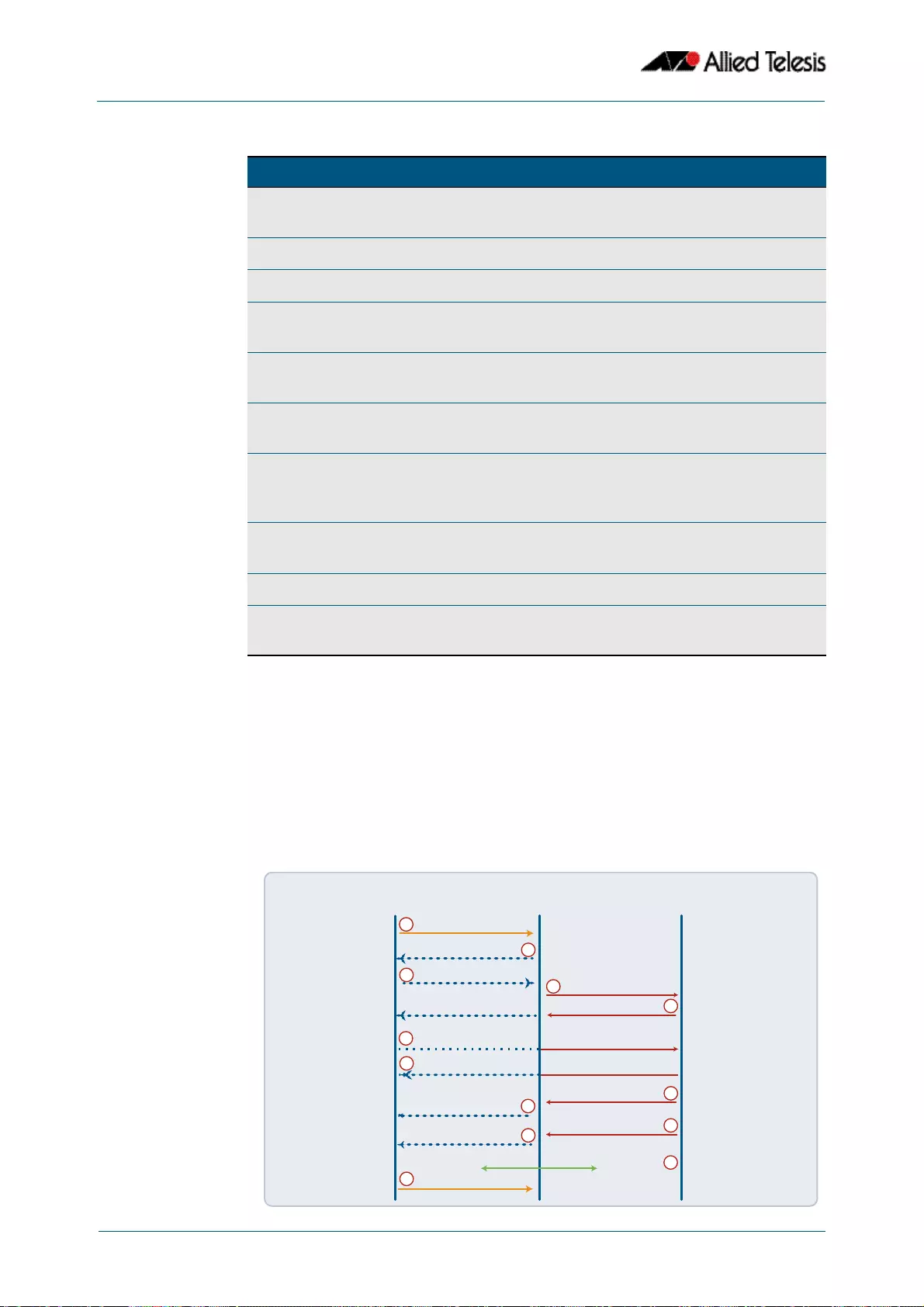
802.1X Introduction and Configuration
Software Reference for GS900MX/MPX Series Switches
46.4 AlliedWare PlusTM Operating System - Version 5.4.4E-1.x C613-50065-01 REV B
Basic steps in an 802.1X conversation
Example message sequence
The diagram below illustrates an exchange using the EAP-MD5 authentication method,
which is the simplest authentication method supported by 802.1X. The EAPoL log-off
message, of course, is not sent immediately after the other messages in the diagram, but is
sent later on, at the end of the supplicant’s data session, when it wishes to disconnect
from the network.The EAPoL log-off message, of course, is not sent immediately after the
other messages in the diagram, but is sent later on, at the end of the supplicant’s data
session, when it wishes to disconnect from the network.
Step Action
1The supplicant informs the authenticator that it wants to
initiate the conversation.
2The authenticator requests the supplicant's credentials.
3The supplicant sends username/password or X.509 certificate.
4The authenticator wraps the supplicant's reply into a RADIUS
packet and sends it to the RADIUS server.
5The RADIUS server chooses an authentication method, and
sends an appropriate request to the supplicant as a ‘challenge’.
6The RADIUS server and supplicant exchange some messages,
ferried by the authenticator.
7The RADIUS server eventually decides if the supplicant is
allowed access and the RADIUS server sends an Access-Accept
or Access-Reject message to the Authenticator.
8The authenticator sends an EAPoL-Success or EAPoL-Fail to the
supplicant.
9The supplicant has a session using the network (if accepted).
10 When the session is over, the supplicant sends a log-off
message.
EAP-Request
6Radius-Access-Challenge
EAPOL-Start
EAP-Response/Identity (MyID)
EAP-Request/Identity
EAP-Request-Challenge (MD5)
EAP-Response-Challenge (MD5)
EAP-Response-Challenge (MD5)
EAP-Success
EAP-Fail
EAPOL-Logoff
Radius-Access-Request
Radius-Access-Challenge
Radius-Access-Accept
Radius-Access-Reject
Authentication
fail
Authentication
success
Authentication
terminated
Port unauthorized
Port authorized
Port unauthorized
Authentication Server
(RADIUS server)
Authenticator
Supplicant
EAPOL conversation
between supplicant
and switch.
RADIUS conversation
between switch and
RADIUS server.
1
5
4
7
2
10
3
8
6
8
7
Radius-Access-Request
Data Session 9

802.1X Introduction and Configuration
Software Reference for GS900MX/MPX Series Switches
C613-50065-01 REV B AlliedWare PlusTM Operating System - Version 5.4.4E-1.x 46.5
The 802.1X Implementation
802.1X port access control is achieved by making devices attached to a controlled port
authenticate themselves via communication with an authentication server before these
devices are allowed to access the network behind the controlled port.
Authentication is required on a per-port basis. The main components of an 802.1X
implementation are:
■the authenticator - the port on this device that wishes to enforce authentication
before allowing access to services that are accessible behind it.
■the supplicant - the port that wishes to access services offered by the authenticator’s
system. The supplicant may be a port on a PC or other device connected to this
device.
■the authentication server - a device that uses the authentication credentials supplied
by the supplicant, via the authenticator, to determine if the authenticator should
grant access to its services.
To configure the switch operating as authenticator, follow the instructions below:
1. Configure a RADIUS server for the switch to send requests to
2. Instruct 802.1X to use the configured RADIUS server
3. Configure port1.0.5 for 802.1X authentication
awplus(config)# radius-server host 192.168.1.250 key
<secret-key>
awplus(config)# aaa authentication dot1x default group radius
awplus(config)# interface port1.0.5
awplus(config-if)# dot1x port-control auto
awplus(config-if)# spanning-tree portfast
Switch
RADIUS
Server
Supplicant
Authenticator
Authentication Server
192.168.1.250
192.168.1.45
port1.0.5

802.1X Introduction and Configuration
Software Reference for GS900MX/MPX Series Switches
46.6 AlliedWare PlusTM Operating System - Version 5.4.4E-1.x C613-50065-01 REV B
Configuring 802.1X
The following example explains how to configure 802.1X. In this example, the RADIUS
Server keeps the Client information, validating the identity of the Client and updating the
switch about the authentication status of the client. The switch is the physical access
between the two clients and the server. It requests information from the client, relays
information to the server and then back to the client.
To configure 802.1X authentication, first enable authentication on port1.0.1 and
port1.0.2 and then specify the RADIUS Server IP address and port.
802-1x_1
Client B
Client A
192.126.12.1
port1.0.1
Radius
Server
port1.0.2
vlan 4
Table 46-1: 802.1X configuration on the switch
awplus#
configure terminal Enter the Global Configuration mode.
awplus(config)#
aaa authentication dot1x default
group radius
Enable authentication globally.
awplus(config)#
interface port1.0.1 Specify the interface (port1.0.1) to be configured and
enter the Interface mode.
awplus(config-if)#
dot1x port-control auto Enable authentication (via RADIUS) on port1.0.1.
awplus(config-if)#
dot1x control-direction both Block traffic in both directions, other than authentication
packets, until authentication is complete.
awplus(config-if)#
exit Exit the Interface Configuration mode and enter the
Global Configuration mode.
awplus(config)#
interface port1.0.2 Specify the interface (port1.0.2) you are configuring and
enter the Interface mode.
awplus(config-if)#
dot1x port-control auto Enable authentication (via RADIUS) on port1.0.2.

802.1X Introduction and Configuration
Software Reference for GS900MX/MPX Series Switches
C613-50065-01 REV B AlliedWare PlusTM Operating System - Version 5.4.4E-1.x 46.7
Names of commands
used
dot1x port-control
radius-server host
radius-server key
Validation
Commands
show dot1x
show dot1x interface
awplus(config-if)#
exit Exit the Interface Configuration mode and enter the
Global Configuration mode.
awplus(config)#
radius-server host 192.126.12.1
auth-port 1812
Specify the RADIUS Server address (192.126.12.1) and
authentication port.
awplus(config)#
radius-server key secret Specify the shared key secret between the RADIUS server
and the client.
awplus(config)#
interface vlan4 Specify the vlan (vlan4) to be configured and enter the
Interface mode.
awplus(config-if)#
ip address 192.126.12.2/24 Set the IP address on vlan4.
Table 46-1: 802.1X configuration on the switch (cont.)

802.1X Introduction and Configuration
Software Reference for GS900MX/MPX Series Switches
46.8 AlliedWare PlusTM Operating System - Version 5.4.4E-1.x C613-50065-01 REV B

Software Reference for GS900MX/MPX Series Switches
C613-50065-01 REV B AlliedWare PlusTM Operating System - Version 5.4.4E-1.x 47.1
Chapter 47: 802.1X Commands
Command List .................................................................................................................................... 47.2
debug dot1x ....................................................................................................................................... 47.2
dot1x control-direction................................................................................................................... 47.3
dot1x eap ............................................................................................................................................. 47.4
dot1x eapol-version ......................................................................................................................... 47.5
dot1x initialize interface ................................................................................................................. 47.6
dot1x initialize supplicant.............................................................................................................. 47.7
dot1x keytransmit............................................................................................................................. 47.8
dot1x max-auth-fail.......................................................................................................................... 47.9
dot1x max-reauth-req ...................................................................................................................47.11
dot1x port-control ..........................................................................................................................47.12
dot1x timeout tx-period ...............................................................................................................47.14
show debugging dot1x ................................................................................................................47.15
show dot1x........................................................................................................................................47.16
show dot1x diagnostics ................................................................................................................47.18
show dot1x interface .....................................................................................................................47.19
show dot1x sessionstatistics.......................................................................................................47.24
show dot1x statistics interface...................................................................................................47.25
show dot1x supplicant..................................................................................................................47.26
show dot1x supplicant interface ...............................................................................................47.28
undebug dot1x ................................................................................................................................47.31

802.1X Commands
Software Reference for GS900MX/MPX Series Switches
47.2 AlliedWare PlusTM Operating System - Version 5.4.4E-1.x C613-50065-01 REV B
Command List
This chapter provides an alphabetical reference of commands used to configure 802.1X
port access control.
debug dot1x
Use this command to enable 802.1X IEEE Port-Based Network Access Control
troubleshooting functions.
Use the no variant of this command to disable this function.
Syntax debug dot1x [all|auth-web|event|nsm|packet|timer]
no debug all dot1x
no debug dot1x [all|auth-web|event|nsm|packet|timer]
Mode Privileged Exec and Global Configuration
Usage This command without any parameters turns on normal 802.1X debug information.
Examples
Related Commands show debugging dot1x
undebug dot1x
Parameter Description
all Used with the no variant of this command exclusively; turns off all
debugging for 802.1X.
auth-web Specifies debugging for 802.1X auth-web information.
events Specifies debugging for 802.1X events.
nsm Specifies debugging for NSM messages.
packet Specifies debugging for 802.1X packets.
timer Specifies debugging for 802.1X timers.
awplus# debug dot1x
awplus# show debugging dot1x
802.1X debugging status:
802.1X events debugging is
802.1X timer debugging is on
802.1X packets debugging is on
802.1X NSM debugging is on
awplus# debug dot1x
awplus# debug dot1x all

802.1X Commands
Software Reference for GS900MX/MPX Series Switches
C613-50065-01 REV B AlliedWare PlusTM Operating System - Version 5.4.4E-1.x 47.3
dot1x control-direction
This command sets the direction of the filter for the unauthorized interface.
If the optional in parameter is specified with this command then packets entering the
specified port are discarded. The in parameter discards the ingress packets received from
the supplicant.
If the optional both parameter is specified with this command then packets entering
(ingress) and leaving (egress) the specified port are discarded. The both parameter
discards the packets received from the supplicant and sent to the supplicant.
The no variant of this command sets the direction of the filter to both. The port will then
discard both ingress and egress traffic.
Syntax dot1x control-direction {in|both}
no dot1x control-direction
Default The authentication port direction is set to both by default.
Mode Interface Configuration for a static channel, a dynamic (LACP) channel group, or a switch
port.
Example s To set the port direction to the default (both) for port1.0.2, use the commands:
To set the port direction to in for port1.0.2, use the commands:
Validation
Commands
show dot1x
show dot1x interface
show auth-mac interface
show auth-web interface
Parameter Description
in Discard received packets from the supplicant (ingress
packets).
both Discard received packets from the supplicant (ingress
packets) and transmitted packets to the supplicant (egress
packets).
awplus# configure terminal
awplus(config)# interface port1.0.2
awplus(config-if)# no dot1x control-direction
awplus# configure terminal
awplus(config)# interface port1.0.2
awplus(config-if)# dot1x control-direction in

802.1X Commands
Software Reference for GS900MX/MPX Series Switches
47.4 AlliedWare PlusTM Operating System - Version 5.4.4E-1.x C613-50065-01 REV B
dot1x eap
This command selects the transmit mode for the EAP packet. If the authentication feature
is not enabled then EAP transmit mode is not enabled. The default setting discards EAP
packets.
Syntax dot1x eap {discard|forward|forward-untagged-vlan|forward-vlan}
Default The transmit mode is set to discard EAP packets by default.
Mode Global Configuration
Examples To set the transmit mode of EAP packet to forward to forward EAP packets to all ports
on the switch, use the commands:
To set the transmit mode of EAP packet to discard to discard EAP packets, use the
commands:
To set the transmit mode of EAP packet to forward-untagged-vlan to forward EAP
packets to ports with the same untagged vlan, use the commands:
To set the transmit mode of EAP packet to forward-vlan to forward EAP packets to
ports with the same vlan, use the commands:
Parameter Description
discard Discard.
forward Forward to all ports on the switch.
forward-untagged-vlan Forward to ports with the same untagged VLAN.
forward-vlan Forward to ports with the same VLAN.
awplus# configure terminal
awplus(config)# dot1x eap forward
awplus# configure terminal
awplus(config)# dot1x eap discard
awplus# configure terminal
awplus(config)# dot1x eap forward-untagged-vlan
awplus# configure terminal
awplus(config)# dot1x eap forward-vlan

802.1X Commands
Software Reference for GS900MX/MPX Series Switches
C613-50065-01 REV B AlliedWare PlusTM Operating System - Version 5.4.4E-1.x 47.5
dot1x eapol-version
This command sets the EAPOL protocol version for EAP packets when 802.1X port
authentication is applied.
Use the no variant of this command to set the EAPOL protocol version to 1.
The default EAPOL protocol version is version 1.
Syntax dot1x eapol-version {1|2}
no dot1x eapol-version
Default The EAP version for 802.1X authentication is set to 1 by default.
Mode Interface Configuration for a static channel, a dynamic (LACP) channel group, or a switch
port.
Examples To set the EAPOL protocol version to 2 for port1.0.2, use the commands:
To set the EAPOL protocol version to the default version (1) for interface port1.0.2, use
the commands:
Validation
Commands
show dot1x
show dot1x interface
Parameter Description
1EAPOL version.
2EAPOL version.
awplus# configure terminal
awplus(config)# interface port1.0.2
awplus(config-if)# dot1x eapol-version 2
awplus# configure terminal
awplus(config)# interface port1.0.2
awplus(config-if)# no dot1x eapol-version

802.1X Commands
Software Reference for GS900MX/MPX Series Switches
47.6 AlliedWare PlusTM Operating System - Version 5.4.4E-1.x C613-50065-01 REV B
dot1x initialize interface
This command removes authorization for a connected interface with the specified
<interface-list>. The connection will attempt to re-authorize when the specified
port attempts to make use of the network connection.
Syntax dot1x initialize interface <interface-list>
Mode Privileged Exec
Examples To initialize 802.1X port authentication on the interface port1.0.2, use the command:
To unauthorize switch port1.0.1 and attempt reauthentication on switch port1.0.1,
use the command:
To unauthorize all switch ports for a 24-port device and attempt reauthentication, use the
command:
Validation
Commands
show dot1x
show dot1x interface
Related Commands dot1x initialize supplicant
Note Reauthentication could be a long time after the use of this command because
the reauthorization attempt is not triggered by this command. The attempt is
triggered by the first packet from the interface trying to access the network
resources.
Parameter Description
<interface-list> The interfaces or ports to configure. An interface-list can be:
■an interface (e.g. vlan2), a switch port (e.g. port1.0.6),
a static channel group (e.g. sa2) or a dynamic (LACP)
channel group (e.g. po2)
■a continuous range of interfaces, ports, static channel
groups or dynamic (LACP) channel groups separated by a
hyphen;
e.g. vlan2-8,orport1.0.1-1.0.6,orsa1-2, or
po1-2
■a comma-separated list of the above;
e.g. port1.0.1,port1.0.2-1.0.4. Do not mix
interface types in a list
The specified interfaces must exist.
awplus# dot1x initialize interface port1.0.2
awplus# dot1x initialize interface port1.0.1
awplus# dot1x initialize interface port1.0.1-port1.0.24

802.1X Commands
Software Reference for GS900MX/MPX Series Switches
C613-50065-01 REV B AlliedWare PlusTM Operating System - Version 5.4.4E-1.x 47.7
dot1x initialize supplicant
This command removes authorization for a connected supplicant with the specified
MAC address or username. The connection will attempt to re-authorize when the
specified supplicant attempts to make use of the network connection.
Syntax dot1x initialize supplicant {<macadd>|username}
Mode Privileged Exec
Example To initialize the supplicant authentication, use the commands
Validation
Commands
show dot1x
show dot1x supplicant
Related Commands dot1x initialize interface
Note Reauthentication could be a long time after the use of this command because
the reauthorization attempt is not triggered by this command. The attempt is
triggered by the first packet from the supplicant trying to access the network
resources.
Parameter Description
dot1x IEEE 802.1X Port-Based Access Control.
initialize Initialize the port to attempt reauthentication.
supplicant Specify the supplicant to initialize.
<macadd>MAC (hardware address of the supplicant.
username The name of the supplicant entry.
awplus# configure terminal
awplus(config)# dot1x initialize supplicant
0090.99ab.a020
awplus(config)# dot1x initialize supplicant guest

802.1X Commands
Software Reference for GS900MX/MPX Series Switches
47.8 AlliedWare PlusTM Operating System - Version 5.4.4E-1.x C613-50065-01 REV B
dot1x keytransmit
This command enables key transmission on the interface specified previously in Interface
mode.
The no variant of this command disables key transmission on the interface specified.
Syntax dot1x keytransmit
no dot1x keytransmit
Default Key transmission for port authentication is enabled by default.
Mode Interface Configuration for a static channel, a dynamic (LACP) channel group, or a switch
port.
Usage Use this command to enable key transmission over an Extensible Authentication Protocol
(EAP) packet between the authenticator and supplicant. Use the no variant of this
command to disable key transmission.
Examples To enable the key transmit feature on interface port1.0.2, after it has been disabled by
negation, use the commands:
To disable the key transmit feature from the default startup configuration on interface
port1.0.2, use the commands:
Validation
Commands
show dot1x
show dot1x interface
awplus# configure terminal
awplus(config)# interface port1.0.2
awplus(config-if)# dot1x keytransmit
awplus# configure terminal
awplus(config)# interface port1.0.2
awplus(config-if)# no dot1x keytransmit

802.1X Commands
Software Reference for GS900MX/MPX Series Switches
C613-50065-01 REV B AlliedWare PlusTM Operating System - Version 5.4.4E-1.x 47.9
dot1x max-auth-fail
Use this command to configure the maximum number of login attempts for a supplicant
(client device) using the auth-fail vlan feature, when using 802.1X port authentication on
an interface.
The no variant of this command resets the maximum login attempts for a supplicant
(client device) using the auth-fail vlan feature, to the default configuration of 3 login
attempts.
Syntax dot1x max-auth-fail <0-10>
no dot1x max-auth-fail
Default The default maximum number of login attempts for a supplicant on an interface using
802.1X port authentication is three (3) login attempts.
Mode Interface Configuration for a static channel, a dynamic (LACP) channel group, or a switch
port.
Usage This command sets the maximum number of login attempts for supplicants on an
interface. The supplicant is moved to the auth-fail VLAN from the Guest VLAN after the
number of failed login attempts using 802.1X authentication is equal to the number set
with this command.
See the related auth auth-fail vlan command on page 43.3. See also the section “Failed
Authentication VLAN” on page 42.35 for information about the auth-fail VLAN feature.
See the section “Limitations on Allowed Feature Combinations” on page 42.35 for
information about restrictions regarding combinations of authentication enhancements
working together.
Examples To configure the maximum number of login attempts for a supplicant on interface
port1.0.2 to a single (1) login attempt, use the commands:
To configure the maximum number of login attempts for a supplicant on interface
port1.0.2 to the default number of three (3) login attempts, use the commands:
Validation
Commands
show running-config
Parameter Description
<0-10>Specify the maximum number of login attempts for supplicants
on an interface using 802.1X port authentication.
awplus# configure terminal
awplus(config)# interface port1.0.2
awplus(config-if)# dot1x max-auth-fail 1
awplus# configure terminal
awplus(config)# interface port1.0.2
awplus(config-if)# no dot1x max-auth-fail

802.1X Commands
Software Reference for GS900MX/MPX Series Switches
C613-50065-01 REV B AlliedWare PlusTM Operating System - Version 5.4.4E-1.x 47.11
dot1x max-reauth-req
This command sets the number of reauthentication attempts before an interface is
unauthorized.
The no variant of this command resets the reauthentication delay to the default.
Syntax dot1x max-reauth-req <1-10>
no dot1x max-reauth-req
Default The default maximum reauthentication attempts for interfaces using 802.1X port
authentication is two (2) reauthentication attempts, before an interface is unauthorized.
Mode Interface Configuration for a static channel, a dynamic (LACP) channel group, or a switch
port.
Usage Use this command to set the maximum reauthentication attempts after failure.
Examples To configure the maximum number of reauthentication attempts for interface
port1.0.2 to a single (1) reauthentication request, use the commands:
To configure the maximum number of reauthentication attempts for interface
port1.0.2 to the default maximum number of two (2) reauthentication attempts, use
the commands:
Validation
Commands
show running-config
Related Commands dot1x max-auth-fail
show dot1x interface
Parameter Description
<1-10>Specify the maximum number of reauthentication attempts for
supplicants on an interface using 802.1X port authentication.
awplus# configure terminal
awplus(config)# interface port1.0.2
awplus(config-if)# dot1x max-reauth-req 1
awplus# configure terminal
awplus(config)# interface port1.0.2
awplus(config-if)# no dot1x max-reauth-req

802.1X Commands
Software Reference for GS900MX/MPX Series Switches
47.12 AlliedWare PlusTM Operating System - Version 5.4.4E-1.x C613-50065-01 REV B
dot1x port-control
This command enables 802.1X port authentication on the interface specified, and sets the
control of the authentication port. When port-control is set to auto, the 802.1X
authentication feature is executed on the interface, but only if the aaa authentication
dot1x command has been issued.
The no variant of this command disables the port authentication on the interface
specified.
Syntax dot1x port-control {force-unauthorized|force-authorized|auto}
no dot1x port-control
Default 802.1X port control is disabled by default.
Mode Interface Configuration for a static channel, a dynamic (LACP) channel group, or a switch
port.
Usage Use this command to force a port state. Note that all dot1x commands can only be
applied to switch ports. They cannot be applied to dynamic (LACP) or static channel
groups.
Examples To enable port authentication on the interface port1.0.2, use the commands:
To enable port authentication force authorized on the interface port1.0.2, use the
commands:
Parameter Description
force-unauthorized Force port state to unauthorized.
Specify to force a port to always be in an unauthorized
state.
force-authorized Force port state to authorized.
Specify to force a port to always be in an authorized state.
auto Allow port client to negotiate authentication.
Specify to enable authentication on port.
awplus# configure terminal
awplus(config)# interface port1.0.2
awplus(config-if)# dot1x port-control auto
awplus# configure terminal
awplus(config)# interface port1.0.2
awplus(config-if)# dot1x port-control force-authorized

802.1X Commands
Software Reference for GS900MX/MPX Series Switches
C613-50065-01 REV B AlliedWare PlusTM Operating System - Version 5.4.4E-1.x 47.13
To disable port authentication on the interface port1.0.2, use the commands:
Validation
Commands
show dot1x interface
Related Commands aaa authentication dot1x
awplus# configure terminal
awplus(config)# interface port1.0.2
awplus(config-if)# no dot1x port-control

802.1X Commands
Software Reference for GS900MX/MPX Series Switches
47.14 AlliedWare PlusTM Operating System - Version 5.4.4E-1.x C613-50065-01 REV B
dot1x timeout tx-period
This command sets the transmit timeout for the authentication request on the specified
interface.
The no variant of this command resets the transmit timeout period to the default (30
seconds).
Syntax dot1x timeout tx-period <1-65535>
no dot1x timeout tx-period
Default The default transmit period for port authentication is 30 seconds.
Mode Interface Configuration for a static channel, a dynamic (LACP) channel group, or a switch
port.
Usage Use this command to set the interval between successive attempts to request an ID.
Examples To set the transmit timeout period to 5 seconds on interface port1.0.2, use the
commands:
To reset transmit timeout period to the default (30 seconds) on interface port1.0.2, use
the commands:
Validation
Commands
show dot1x
show dot1x interface
Parameter Description
<1-65535>Seconds.
awplus# configure terminal
awplus(config)# interface port1.0.2
awplus(config-if)# dot1x timeout tx-period 5
awplus# configure terminal
awplus(config)# interface port1.0.2
awplus(config-if)# no dot1x timeout tx-period

802.1X Commands
Software Reference for GS900MX/MPX Series Switches
C613-50065-01 REV B AlliedWare PlusTM Operating System - Version 5.4.4E-1.x 47.15
show debugging dot1x
Use this command to display the 802.1X debugging option set.
For information on output options, see “Controlling “show” Command Output” on
page 1.35.
Syntax show debugging dot1x
Mode User Exec and Privileged Exec
Usage This is a sample output from the show debugging dot1x command.
Example
Related Commands debug dot1x
awplus# debug dot1x
awplus# show debugging dot1x
802.1X debugging status:
802.1X events debugging is on
802.1X timer debugging is on
802.1X packets debugging is on
802.1X NSM debugging is on
awplus# show debugging dot1x

802.1X Commands
Software Reference for GS900MX/MPX Series Switches
47.16 AlliedWare PlusTM Operating System - Version 5.4.4E-1.x C613-50065-01 REV B
show dot1x
This command shows authentication information for dot1x (802.1X) port authentication.
If you specify the optional all parameter then this command also displays all
authentication information for each port available on the switch.
For information on output options, see “Controlling “show” Command Output” on
page 1.35.
Syntax show dot1x [all]
Mode Privileged Exec
Example
Parameter Description
all Displays all authentication information for each port available on the
switch.
awplus# show dot1x all
Figure 47-1: Example output from the show dot1x command
awplus# show dot1x all
802.1X Port-Based Authentication Enabled
RADIUS server address: 150.87.18.89:1812
Next radius message id: 5
RADIUS client address: not configured
Authentication info for interface port1.0.6
portEnabled: true - portControl: Auto
portStatus: Authorized
reAuthenticate: disabled
reAuthPeriod: 3600
PAE: quietPeriod: 60 - maxReauthReq: 2 - txPeriod: 30
PAE: connectTimeout: 30
BE: suppTimeout: 30 - serverTimeout: 30
CD: adminControlledDirections: in
KT: keyTxEnabled: false
critical: disabled
guestVlan: disabled
dynamicVlanCreation: single-dynamic-vlan
assignFailActionRule: deny
hostMode: multi-supplicant
maxSupplicant: 1024
dot1x: enabled
protocolVersion: 1
authMac: enabled
method: PAP
reauthRelearning: disabled
authWeb: enabled
method: PAP
lockCount: 3
packetForwarding: disabled
twoStepAuthentication:
configured: enabled
actual: enabled
SupplicantMac: none

802.1X Commands
Software Reference for GS900MX/MPX Series Switches
C613-50065-01 REV B AlliedWare PlusTM Operating System - Version 5.4.4E-1.x 47.17
supplicantMac: none
Supplicant name: manager
Supplicant address: 00d0.59ab.7037
authenticationMethod: 802.1X Authentication
portStatus: Authorized - currentId: 1
abort:F fail:F start:F timeout:F success:T
PAE: state: Authenticated - portMode: Auto
PAE: reAuthCount: 0 - rxRespId: 0
PAE: quietPeriod: 60 - maxReauthReq: 2 - txPeriod: 30
BE: state: Idle - reqCount: 0 - idFromServer: 0
CD: adminControlledDirections: in - operControlledDirections: in
CD: bridgeDetected: false
KR: rxKey: false
KT: keyAvailable: false - keyTxEnabled: false
criticalState: off
dynamicVlanId: 2
802.1X statistics for interface port1.0.6
EAPOL Frames Rx: 5 - EAPOL Frames Tx: 16
EAPOL Start Frames Rx: 0 - EAPOL Logoff Frames Rx: 0
EAP Rsp/Id Frames Rx: 3 - EAP Response Frames Rx: 2
EAP Req/Id Frames Tx: 8 - EAP Request Frames Tx: 2
Invalid EAPOL Frames Rx: 0 - EAP Length Error Frames Rx: 0
EAPOL Last Frame Version Rx: 1 - EAPOL Last Frame Src: 00d0.59ab.7037
Authentication session statistics for interface port1.0.6
session user name: manager
session authentication method: Remote server
session time: 19440 secs
session terminate cause: Not terminated yet
Authentication Diagnostics for interface port1.0.6
Supplicant address: 00d0.59ab.7037
authEnterConnecting: 2
authEaplogoffWhileConnecting: 1
authEnterAuthenticating: 2
authSuccessWhileAuthenticating: 1
authTimeoutWhileAuthenticating: 1
authFailWhileAuthenticating: 0
authEapstartWhileAuthenticating: 0
authEaplogoggWhileAuthenticating: 0
authReauthsWhileAuthenticated: 0
authEapstartWhileAuthenticated: 0
authEaplogoffWhileAuthenticated: 0
BackendResponses: 2
BackendAccessChallenges: 1
BackendOtherrequestToSupplicant: 3
BackendAuthSuccess: 1
BackendAuthFails: 0
Figure 47-1: Example output from the show dot1x command (cont.)

802.1X Commands
Software Reference for GS900MX/MPX Series Switches
47.18 AlliedWare PlusTM Operating System - Version 5.4.4E-1.x C613-50065-01 REV B
show dot1x diagnostics
This command shows 802.1X authentication diagnostics for the specified interface
(optional), which may be a static channel (or static aggregator) or a dynamic (or LACP)
channel group or a switch port.
If no interface is specified then authentication diagnostics are shown for all interfaces.
For information on output options, see “Controlling “show” Command Output” on
page 1.35.
Syntax show dot1x diagnostics [interface <interface-list>]
Mode Privileged Exec
Example See the sample output below showing 802.1X authentication diagnostics for
port1.0.5:
Output Figure 47-2: Example output from the show dot1x diagnostics command
Parameter Description
interface Specify a port to show.
<interface-list> The interfaces or ports to configure. An interface-list can be:
■an interface (e.g. vlan2), a switch port (e.g. port1.0.6),
a static channel group (e.g. sa2) or a dynamic (LACP)
channel group (e.g. po2)
■a continuous range of interfaces, ports, static channel
groups or dynamic (LACP) channel groups separated by a
hyphen;
e.g. vlan2-8,orport1.0.1-1.0.4,orsa1-2, or
po1-2
■a comma-separated list of the above;
e.g. port1.0.1,port1.0.2-1.0.4. Do not mix
interface types in a list
The specified interfaces must exist.
awplus# show dot1x diagnostics interface port1.0.5
Authentication Diagnostics for interface port1.0.5
Supplicant address: 00d0.59ab.7037
authEnterConnecting: 2
authEaplogoffWhileConnecting: 1
authEnterAuthenticating: 2
authSuccessWhileAuthenticating: 1
authTimeoutWhileAuthenticating: 1
authFailWhileAuthenticating: 0
authEapstartWhileAuthenticating: 0
authEaplogoggWhileAuthenticating: 0
authReauthsWhileAuthenticated: 0
authEapstartWhileAuthenticated: 0
authEaplogoffWhileAuthenticated: 0
BackendResponses: 2
BackendAccessChallenges: 1
BackendOtherrequestToSupplicant: 3
BackendAuthSuccess: 1

802.1X Commands
Software Reference for GS900MX/MPX Series Switches
C613-50065-01 REV B AlliedWare PlusTM Operating System - Version 5.4.4E-1.x 47.19
show dot1x interface
This command shows the status of 802.1X port-based authentication on the specified
interface, which may be a static channel (or static aggregator) or a dynamic (or LACP)
channel group or a switch port.
Use the optional diagnostics parameter to show authentication diagnostics for the
specified interfaces. Use the optional sessionstatistics parameter to show authentication
session statistics for the specified interfaces. Use the optional statistics parameter to show
authentication diagnostics for the specified interfaces. Use the optional supplicant
parameter to show the supplicant state for the specified interfaces.
For information on output options, see “Controlling “show” Command Output” on
page 1.35.
Syntax show dot1x interface <interface-list> [diagnostics|sessionstatistics|
statistics|supplicant [brief]]
Mode Privileged Exec
Examples See the sample output below showing 802.1X authentication status for port1.0.6:
Parameter Description
<interface-list> The interfaces or ports to configure. An interface-list can be:
■an interface (e.g. vlan2), a switch port (e.g.
port1.0.6), a static channel group (e.g. sa2) or a
dynamic (LACP) channel group (e.g. po2)
■a continuous range of interfaces, ports, static channel
groups or dynamic (LACP) channel groups separated by
a hyphen;
e.g. vlan2-8,orport1.0.1-1.0.4,orsa1-2, or
po1-2
■a comma-separated list of the above;
e.g. port1.0.1,port1.0.3-1.0.5. Do not mix
interface types in a list
The specified interfaces must exist.
diagnostics Diagnostics.
sessionstatistics Session Statistics.
statistics Statistics.
supplicant Supplicant.
brief Brief summary of supplicant state.
awplus# show dot1x interface port1.0.6

802.1X Commands
Software Reference for GS900MX/MPX Series Switches
47.20 AlliedWare PlusTM Operating System - Version 5.4.4E-1.x C613-50065-01 REV B
See the sample output below showing 802.1X authentication sessionstatistics for
port1.0.6:
Figure 47-3: Example output from the show dot1x interface command for a port
awplus#show dot1x interface port1.0.6
Authentication info for interface port1.0.6
portEnabled: true - portControl: Auto
portStatus: Authorized
reAuthenticate: disabled
reAuthPeriod: 3600
PAE: quietPeriod: 60 - maxReauthReq: 2 - txPeriod: 30
PAE: connectTimeout: 30
BE: suppTimeout: 30 - serverTimeout: 30
CD: adminControlledDirections: in
KT: keyTxEnabled: false
critical: disabled
guestVlan: disabled
dynamicVlanCreation: single-dynamic-vlan
assignFailActionRule: deny
hostMode: multi-supplicant
maxSupplicant: 1024
dot1x: enabled
protocolVersion: 1
authMac: enabled
method: PAP
reauthRelearning: disabled
authWeb: enabled
method: PAP
lockCount: 3
packetForwarding: disabled
twoStepAuthentication:
configured: enabled
actual: enabled
supplicantMac: none
awplus# show dot1x interface port1.0.6 sessionstatistics
awplus#show dot1x interface port1.0.6 sessionstatistics
Authentication session statistics for interface port1.0.6
session user name: manager
session authentication method: Remote server
session time: 19440 secs
session terminat cause: Not terminated yet

802.1X Commands
Software Reference for GS900MX/MPX Series Switches
C613-50065-01 REV B AlliedWare PlusTM Operating System - Version 5.4.4E-1.x 47.21
See sample output below showing 802.1X authentication diagnostics for
port1.0.6:
See sample output below showing the supplicant on the interface port1.0.6:
awplus# show dot1x interface port1.0.6 diagnostics
awplus#show dot1x interface port1.0.6 diagnostics
Authentication Diagnostics for interface port1.0.6
Supplicant address: 00d0.59ab.7037
authEnterConnecting: 2
authEaplogoffWhileConnecting: 1
authEnterAuthenticating: 2
authSuccessWhileAuthenticating: 1
authTimeoutWhileAuthenticating: 1
authFailWhileAuthenticating: 0
authEapstartWhileAuthenticating: 0
authEaplogoggWhileAuthenticating: 0
authReauthsWhileAuthenticated: 0
authEapstartWhileAuthenticated: 0
authEaplogoffWhileAuthenticated: 0
BackendResponses: 2
BackendAccessChallenges: 1
BackendOtherrequestToSupplicant: 3
BackendAuthSuccess: 1
awplus# show dot1x interface port1.0.6 supplicant
awplus#show dot1x interface port1.0.6 supplicant
authenticationMethod: dot1x
totalSupplicantNum: 1
authorizedSupplicantNum: 1
macBasedAuthenticationSupplicantNum: 0
dot1xAuthenticationSupplicantNum: 1
webBasedAuthenticationSupplicantNum: 0
Supplicant name: manager
Supplicant address: 00d0.59ab.7037
authenticationMethod: dot1x
portStatus: Authorized - currentId: 4
abort:F fail:F start:F timeout:F success:T
PAE: state: Authenticated - portMode: Auto
PAE: reAuthCount: 0 - rxRespId: 0
PAE: quietPeriod: 60 - maxReauthReq: 2 - txPeriod: 30
BE: state: Idle - reqCount: 0 - idFromServer: 3
BE: suppTimeout: 30 - serverTimeout: 30
CD: adminControlledDirections: in - operControlledDirections:
in CD: bridgeDetected: false
KR: rxKey: false
KT: keyAvailable: false - keyTxEnabled: false

802.1X Commands
Software Reference for GS900MX/MPX Series Switches
47.22 AlliedWare PlusTM Operating System - Version 5.4.4E-1.x C613-50065-01 REV B
See sample output below showing 802.1X (dot1x) authentication statistics for
port1.0.6:
awplus# show dot1x statistics interface port1.0.6
awplus#show dot1x statistics interface port1.0.6
802.1X statistics for interface port1.0.6
EAPOL Frames Rx: 5 - EAPOL Frames Tx: 16
EAPOL Start Frames Rx: 0 - EAPOL Logoff Frames Rx: 0
EAP Rsp/Id Frames Rx: 3 - EAP Response Frames Rx: 2
EAP Req/Id Frames Tx: 8 - EAP Request Frames Tx: 2
Invalid EAPOL Frames Rx: 0 - EAP Length Error Frames Rx: 0
EAPOL Last Frame Version Rx: 1 - EAPOL Last Frame
Src:00d0.59ab.7037
Table 47-1: Parameters in the output of the show dot1x interface command
Parameter Description
portEnabled Interface operational status (Up-true/down-false).
portControl Current control status of the port for 802.1X control.
portStatus 802.1X status of the port (authorized/unauthorized).
reAuthenticate Reauthentication enabled/disabled status on port.
reAuthPeriod Value holds meaning only if reauthentication is enabled.
abort Indicates that authentication should be aborted when set
to true.
fail Indicates failed authentication attempt when set to false.
start Indicates authentication should be started when set to true.
timeout Indicates authentication attempt timed out when set to
true.
success Indicates authentication successful when set to true.
state Current 802.1X operational state of interface.
mode Configured 802.1X mode.
reAuthCount Reauthentication count.
quietperiod Time between reauthentication attempts.
reAuthMax Maximum reauthentication attempts.
BE Backend authentication state machine variables and
constants.
state State of the state machine.
reqCount Count of requests sent to server.
suppTimeout Supplicant timeout.
serverTimeout Server timeout.
maxReq Maximum requests to be sent.
CD Controlled Directions State machine.
adminControlledDir
ections
Administrative value (Both/In).

802.1X Commands
Software Reference for GS900MX/MPX Series Switches
C613-50065-01 REV B AlliedWare PlusTM Operating System - Version 5.4.4E-1.x 47.23
Related Commands show auth-web diagnostics
show dot1x sessionstatistics
show dot1x statistics interface
show dot1x supplicant interface
operControlledDire
ctions
Operational Value (Both/In).
KR Key receive state machine.
rxKey True when EAPOL-Key message is received by supplicant or
authenticator. false when key is transmitted.
KT Ket Transmit State machine.
keyAvailable False when key has been transmitted by authenticator, true
when new key is available for key exchange.
keyTxEnabled Key transmission enabled/disabled status.
Table 47-1: Parameters in the output of the show dot1x interface command (cont.)
Parameter Description

802.1X Commands
Software Reference for GS900MX/MPX Series Switches
47.24 AlliedWare PlusTM Operating System - Version 5.4.4E-1.x C613-50065-01 REV B
show dot1x sessionstatistics
This command shows authentication session statistics for the specified interface, which
may be a static channel (or static aggregator) or a dynamic (or LACP) channel group or a
switch port.
For information on output options, see “Controlling “show” Command Output” on
page 1.35.
Syntax show dot1x sessionstatistics [interface <interface-list>]
Mode Privileged Exec
Example See sample output below showing 802.1X (dot1x) authentication session statistics for
port1.0.6:
Parameter Description
interface Specify a port to show.
<interface-list> The interfaces or ports to configure. An interface-list can be:
■an interface (e.g. vlan2), a switch port (e.g.
port1.0.6), a static channel group (e.g. sa2) or a
dynamic (LACP) channel group (e.g. po2)
■a continuous range of interfaces, ports, static channel
groups or dynamic (LACP) channel groups separated by a
hyphen;
e.g. vlan2-8,orport1.0.1-1.0.4,orsa1-2, or
po1-2
■a comma-separated list of the above;
e.g. port1.0.1,port1.0.4-1.0.6. Do not mix
interface types in a list
The specified interfaces must exist.
awplus# show dot1x sessionstatistics interface port1.0.6
Authentication session statistics for interface port1.0.6
session user name: manager
session authentication method: Remote server
session time: 19440 secs
session terminat cause: Not terminated yet

802.1X Commands
Software Reference for GS900MX/MPX Series Switches
C613-50065-01 REV B AlliedWare PlusTM Operating System - Version 5.4.4E-1.x 47.25
show dot1x statistics interface
This command shows the authentication statistics for the specified interface, which may
be a static channel (or static aggregator) or a dynamic (or LACP) channel group or a switch
port.
For information on output options, see “Controlling “show” Command Output” on
page 1.35.
Syntax show dot1x statistics interface <interface-list>
Mode Privileged Exec
Example See sample output below showing 802.1X authentication statistics for port1.0.6:
Parameter Description
<interface-list> The interfaces or ports to configure. An interface-list can be:
■an interface (e.g. vlan2), a switch port (e.g. port1.0.6),
a static channel group (e.g. sa2) or a dynamic (LACP)
channel group (e.g. po2)
■a continuous range of interfaces, ports, static channel
groups or dynamic (LACP) channel groups separated by a
hyphen;
e.g. vlan2-8,orport1.0.1-1.0.4,orsa1-2, or
po1-2
■a comma-separated list of the above;
e.g. port1.0.1,port1.0.4-1.0.6. Do not mix
interface types in a list
The specified interfaces must exist.
awplus# show dot1x statistics interface port1.0.6
802.1X statistics for interface
EAPOL Frames Rx: 5 - EAPOL Frames Tx: 16
EAPOL Start Frames Rx: 0 - EAPOL Logoff Frames Rx: 0
EAP Rsp/Id Frames Rx: 3 - EAP Response Frames Rx: 2
EAP Req/Id Frames Tx: 8 - EAP Request Frames Tx: 2
Invalid EAPOL Frames Rx: 0 - EAP Length Error Frames Rx: 0
EAPOL Last Frame Version Rx: 1 - EAPOL Last Frame
Src:00d0.59ab.7037

802.1X Commands
Software Reference for GS900MX/MPX Series Switches
47.26 AlliedWare PlusTM Operating System - Version 5.4.4E-1.x C613-50065-01 REV B
show dot1x supplicant
This command shows the supplicant state of the authentication mode set for the switch.
This command shows a summary when the optional brief parameter is used.
For information on output options, see “Controlling “show” Command Output” on
page 1.35.
Syntax show dot1x supplicant [<macadd>] [brief]
Mode Privileged Exec
Example See sample output below showing the 802.1X authenticated supplicant on the switch:
Parameter Description
<macadd>MAC (hardware) address of the Supplicant.
brief Brief summary of the Supplicant state.
awplus# show dot1x supplicant
authenticationMethod: dot1x
totalSupplicantNum: 1
authorizedSupplicantNum: 1
macBasedAuthenticationSupplicantNum: 0
dot1xAuthenticationSupplicantNum: 1
webBasedAuthenticationSupplicantNum: 0
Supplicant name: manager
Supplicant address: 00d0.59ab.7037
authenticationMethod: dot1x
Two-Step Authentication:
firstAuthentication: Pass - Method: mac
secondAuthentication: Pass - Method: dot1x
portStatus: Authorized - currentId: 4
abort:F fail:F start:F timeout:F success:T
PAE: state: Authenticated - portMode: Auto
PAE: reAuthCount: 0 - rxRespId: 0
PAE: quietPeriod: 60 - maxReauthReq: 2 - txPeriod: 30
BE: state: Idle - reqCount: 0 - idFromServer: 3
BE: suppTimeout: 30 - serverTimeout: 30
CD: adminControlledDirections: in - operControlledDirections: in
CD: bridgeDetected: false
KR: rxKey: false
KT: keyAvailable: false - keyTxEnabled: false

802.1X Commands
Software Reference for GS900MX/MPX Series Switches
C613-50065-01 REV B AlliedWare PlusTM Operating System - Version 5.4.4E-1.x 47.27
See sample output below showing the supplicant on the switch using the brief
parameter:
See sample output below showing the supplicant on the switch using the brief
parameter:
For example, if two-step authentication is configured with 802.1X authentication as the
first method and web authentication as the second method then the output is as follows:
Related Commands show dot1x supplicant interface
awplus# show dot1x supplicant 00d0.59ab.7037 brief
Interface port1.0.6
authenticationMethod: dot1x
totalSupplicantNum: 1
authorizedSupplicantNum: 1
macBasedAuthenticationSupplicantNum: 0
dot1xAuthenticationSupplicantNum: 1
webBasedAuthenticationSupplicantNum: 0
Interface VID Mode MAC Address Status IP Address Username
========= === ==== =========== ====== ========== ========
port1.0.6 2 D 00d0.59ab.7037 Authenticated 192.168.2.201 manager
awplus# show dot1x supplicant brief
Interface port1.0.6
authenticationMethod: dot1x/web
Two-Step Authentication
firstMethod: dot1x
secondMethod: web
totalSupplicantNum: 1
authorizedSupplicantNum: 1
macBasedAuthenticationSupplicantNum: 0
dot1xAuthenticationSupplicantNum: 0
webBasedAuthenticationSupplicantNum: 1
otherAuthenticationSupplicantNum: 0
Interface VID Mode MAC Address Status IP Address Username
=========== ==== ==== ============== ================= =============== ========
port1.0.6 5 W 0008.0d5e.c216 Authenticated 192.168.1.200 web

802.1X Commands
Software Reference for GS900MX/MPX Series Switches
47.28 AlliedWare PlusTM Operating System - Version 5.4.4E-1.x C613-50065-01 REV B
show dot1x supplicant interface
This command shows the supplicant state of the authentication mode set for the
interface, which may be a static channel (or static aggregator) or a dynamic (or LACP)
channel group or a switch port.
This command shows a summary when the optional brief parameter is used.
For information on output options, see “Controlling “show” Command Output” on
page 1.35.
Syntax show dot1x supplicant interface <interface-list> [brief]
Mode Privileged Exec
Examples See sample output below showing the supplicant on the interface port1.0.6:
Parameter Description
<interface-list> The interfaces or ports to configure. An interface-list can be:
■an interface (e.g. vlan2), a switch port (e.g. port1.0.6),
a static channel group (e.g. sa2) or a dynamic (LACP)
channel group (e.g. po2)
■a continuous range of interfaces, ports, static channel
groups or dynamic (LACP) channel groups separated by a
hyphen;
e.g. vlan2-8,orport1.0.1-1.0.4,orsa1-2, or
po1-2
■a comma-separated list of the above;
e.g. port1.0.1,port1.0.4-1.0.6. Do not mix
interface types in a list
The specified interfaces must exist.
brief Brief summary of the Supplicant state.
awplus# show dot1x interface port1.0.6

802.1X Commands
Software Reference for GS900MX/MPX Series Switches
C613-50065-01 REV B AlliedWare PlusTM Operating System - Version 5.4.4E-1.x 47.29
See sample output below showing the supplicant on the switch using the brief
parameter:
Interface port1.0.6
authenticationMethod: dot1x
totalSupplicantNum: 1
authorizedSupplicantNum: 1
macBasedAuthenticationSupplicantNum: 0
dot1xAuthenticationSupplicantNum: 1
webBasedAuthenticationSupplicantNum: 0
otherAuthenticationSupplicantNum: 0
Supplicant name: VCSPCVLAN10
Supplicant address: 0000.cd07.7b60
authenticationMethod: 802.1X
Two-Step Authentication:
firstAuthentication: Pass - Method: mac
secondAuthentication: Pass - Method: dot1x
portStatus: Authorized - currentId: 3
abort:F fail:F start:F timeout:F success:T
PAE: state: Authenticated - portMode: Auto
PAE: reAuthCount: 0 - rxRespId: 0
PAE: quietPeriod: 60 - maxReauthReq: 2
BE: state: Idle - reqCount: 0 - idFromServer: 2
CD: adminControlledDirections:in -
operControlledDirections:in
CD: bridgeDetected: false
KR: rxKey: false
KT: keyAvailable: false - keyTxEnabled: false
awplus# show dot1x supplicant interface brief
Interface port1.0.6
authenticationMethod: dot1x
Two-Step Authentication:
firstMethod: mac
secondMethod: dot1x
totalSupplicantNum: 1
authorizedSupplicantNum: 1
macBasedAuthenticationSupplicantNum: 0
dot1xAuthenticationSupplicantNum: 1
webBasedAuthenticationSupplicantNum: 0
Interface VID Mode MAC Address Status IP Address Username
========= === ==== =========== ====== ========== ========
port1.0.6 2 D 00d0.59ab.7037 Authenticated 192.168.2.201 manager

802.1X Commands
Software Reference for GS900MX/MPX Series Switches
47.30 AlliedWare PlusTM Operating System - Version 5.4.4E-1.x C613-50065-01 REV B
See the sample output below for static channel group (static aggregator) interface sa1:
Related Commands show dot1x supplicant
awplus# show dot1x interface sa1 supplicant brief
awplus#show dot1x interface sa1 supplicant brief
Interface sa1
authenticationMethod: dot1x
Two-Step Authentication:
firstMethod: mac
secondMethod: dot1x
totalSupplicantNum: 1
authorizedSupplicantNum: 1
macBasedAuthenticationSupplicantNum: 0
dot1xAuthenticationSupplicantNum: 1
webBasedAuthenticationSupplicantNum: 0
otherAuthenticationSupplicantNum: 0
Interface VID Mode MAC Address Status IP Address Username
========= ==== ==== ============== ================= =============== ========
sa1 1 D 00d0.59ab.7037 Authenticated -- test1

802.1X Commands
Software Reference for GS900MX/MPX Series Switches
47.32 AlliedWare PlusTM Operating System - Version 5.4.4E-1.x C613-50065-01 REV B

Software Reference for GS900MX/MPX Series Switches
C613-50065-01 REV B AlliedWare PlusTM Operating System - Version 5.4.4E-1.x 48.1
Chapter 48: RADIUS Introduction and
Configuration
Introduction ........................................................................................................................................ 48.2
RADIUS Packets .......................................................................................................................... 48.3
RADIUS Attributes...................................................................................................................... 48.4
RADIUS Security.......................................................................................................................... 48.5
RADIUS Proxy .............................................................................................................................. 48.6
RADIUS Accounting .................................................................................................................. 48.7
RADIUS Configuration..................................................................................................................... 48.9
Switch Configuration Tasks.................................................................................................... 48.9
Switch to RADIUS Server Communication......................................................................48.10
AAA Server Groups Configuration.....................................................................................48.12
RADIUS Configuration Examples...............................................................................................48.15
RADIUS Authentication .........................................................................................................48.15
Single RADIUS Server Configuration.................................................................................48.16
Multiple RADIUS Server Configuration ............................................................................48.17
RADIUS Server Group Configuration ................................................................................48.17
RADIUS Server Configuration using Server Groups ....................................................48.18

RADIUS Introduction and Configuration
Software Reference for GS900MX/MPX Series Switches
48.2 AlliedWare PlusTM Operating System - Version 5.4.4E-1.x C613-50065-01 REV B
Introduction
The main purpose of RADIUS (Remote Authentication Dial In User Service) is to enable the
authentication of network users stored in a database on a server known as a RADIUS
Server.
When users connect to the network, the switch the users connect to can challenge the
users for authentication, and pass on the authentication to the RADIUS server to check.
Based on the result of the check against the database, the RADIUS Server informs the
switch whether or not to allow the connected user access to the network.
A RADIUS Server can do more than allow or deny access to the network. A RADIUS Server
can send back parameters to the connected users, such as an IP address for the user, or a
VLAN for the user, or a privilege level for a session. RADIUS also provides an accounting
service. Switches can inform the RADIUS Server how long a user has been connected to
the network, and how much traffic the user has sent and received while connected to the
network.
The original use for RADIUS was for the authentication of users dialing into an ISP (Internet
Service Provider). A PPP (Point-to-Point Protocol) connection would be established
between the remote client and the ISP's access switch. The ISP's access switch would
receive the client's username and password using PAP (Password Authentication Protocol)
or using CHAP (Challenge Handshake Authentication Protocol) and pass on the client's
username and password to the RADIUS server to authenticate the client. The RADIUS
Server's response to the authentication request would be sent back to the client as a PAP
or CHAP allow or deny.
RADIUS has been adapted to network access authentication applications. Network access
authentication using RADIUS follows a similar method to the PPP dial-up application for
ISPs. For general network access authentication there is the RADIUS Server where the
database of user authentication data is stored and a NAS (Network Access Server), which is
the switch that user connects to first. The RADIUS Server and the NAS communicate with
each other through exchanging attributes. Usernames and passwords are treated as
attributes in RADIUS packets to and from a RADIUS Server and a NAS. The RADIUS Server is
configured with a list of valid NASs that are allowed to send authentication requests to the
RADIUS Server.
The RADIUS Server will not accept authentication requests from a NAS that is not on the
list of valid NASs. Each NAS has a shared secret, which is a shared key with the RADIUS
Server that is used to authenticate requests. The RADIUS Server has access to a list of user
authentication data, stored within the RADIUS Server or accessed from another server.
Communication between the NAS and RADIUS Server uses the RADIUS protocol. The
RADIUS protocol uses UDP packets. There are two UDP ports used as the destination port
for RADIUS authentication packets (ports 1645 and 1812). Note that port 1812 is in more
common use than port 1645 for authentication packets. UDP ports (ports 1646 and 1813)
are used for RADIUS accounting separately from the ports used for RADIUS authentication.

RADIUS Introduction and Configuration
Software Reference for GS900MX/MPX Series Switches
C613-50065-01 REV B AlliedWare PlusTM Operating System - Version 5.4.4E-1.x 48.3
Figure 48-1: Example showing a user to a NAS to a RADIUS server network
connection
RADIUS Packets
The RADIUS RFCs define the RADIUS packet types and attributes. RADIUS authentication is
defined by RFC2058, RFC2138, RFC2865, and RFC2868. RADIUS accounting is defined by
RFC2059, RFC2139, RFC2866, and RFC2867. These RADIUS RFCs define over fifty attributes
and six packets types (Access-Request, Access-Accept, Access-Reject,
Accounting-Request, Accounting-Response, Access-Challenge).
A RADIUS exchange is initiated by the NAS when a user requests access to the NAS. The
NAS obtains the user authentication data adds them into a RADIUS Access-Request
packet type and sends the RADIUS Access-Request packet to the RADIUS Server.
■If a RADIUS Server has not been configured for authentication request from a NAS
then it will silently discard an Access-Request packet from it.
■If the RADIUS Server accepts the request from the NAS it considers the authentication
date provided in the Access-Request packet. The RADIUS Server may verify the
user from its own database or it may connect to other servers to verify.
■If the RADIUS Server decides that the user is not allowed access to the NAS it responds
to the NAS with an Access-Reject packet and the NAS will block the user.
■If the RADIUS Server decides that the user is valid but needs more information to
verify that the user is not an impostor, it may send an Access-Challenge packet
to the NAS that the NAS forwards to the user. The NAS forwards the user response to
the Access-Challenge packet in an Access-Request packet to the RADIUS
Server to accept or reject to allow or deny NAS user access.
■If the RADIUS Server rejects the user it sends an Access-Reject packet to the NAS.
■If the RADIUS Server accepts the user it sends an Accept-Accept packet to the
NAS. The Accept-Accept packet to the NAS contains attributes that the NAS can
apply.
RADIUS server
Network
NAS
(Authenticator)
User

RADIUS Introduction and Configuration
Software Reference for GS900MX/MPX Series Switches
48.4 AlliedWare PlusTM Operating System - Version 5.4.4E-1.x C613-50065-01 REV B
Figure 48-2: Example showing an exchange from a requestor to a NAS to a RADIUS
server
RADIUS Attributes
Each attribute is identified by its RFC-defined name, followed by its attribute ID in
parenthesis.
■User-name(1)
User-names are strings of at least three characters and have a maximum of 253
characters, which is the upper limit on all RADIUS attributes.
■User-password(2)
User-passwords are encrypted using an MD5 hash of the password, the NAS's shared
secret with the RADIUS Server, and a request authenticator value. User-passwords can
either be used at the initial authentication attempt or in response to an Access-
Challenge packet type from the RADIUS Server to the NAS.
■CHAP-password(3)
CHAP-passwords are used if the NAS is using CHAP to authenticate the user, and
doesn't receive the use the user's password but sends the CHAP response to the
RADIUS Server instead. The CHAP password is an encrypted string that is an MD5 hash
of the password and challenge value sent by the user.
■Framed-IP-Address(8)
Used for dial-in user making PPP connections to the NAS who are dynamically
allocated an IP address that they can use for the duration of their connect. The
RADIUS Server sends the Framed-IP-Address to the NAS to allocate.
■Service-Type(6)
Used when the NAS is authenticating a user who wants to open a management
session on the NAS, and is sent by the RADIUS Server back to the NAS in an Access-
Accept type packet to indicate the level of access the NAS gives a user. Service-Type(6)
is mapped to a Privileged management session for AlliedWare Plus.
■NAS-Port-Type(61)
Authentication credentials -
username/password, and
possibly other information
Access-request containing the challenge
response in the password field
Access-Challenge
Access-Request
Access-Accept
Access-Reject
Pass on challenge data
Response to challenge
Requestor NAS Server
Repeated 0 or
more times
Decides user is invalid
OR
Decises user is valid

RADIUS Introduction and Configuration
Software Reference for GS900MX/MPX Series Switches
C613-50065-01 REV B AlliedWare PlusTM Operating System - Version 5.4.4E-1.x 48.5
Identifies the type of port on which the user is accessing the NAS. The NAS-Port-
Type(61) attribute is sent by the NAS to the RADIUS Server in Access-Request type
packet, so the RADIUS Server may use it to choose access type. For 802.1X sessions,
the NAS-Port-Type sent by the NAS is Ethernet (15).
■802.1X VLAN assignment uses:
Tunnel-Type(64), Tunnel-Medium-Type(65), Tunnel-Private-Group-ID(81),
Egress-VLANID(56), and Egress-VLAN-Name(58) attributes (specified in RFC4675 used
to specify 802.1Q tagged and untagged VLAN assignments with LLDP-MED/Voice-
VLAN).
Attributes are carried within RADIUS packets in the form of TLVs (Type Length Values).
Every attribute has an attribute ID number in the Type field of the TLV. The Length field
holds a one-byte number that represents then length of the TLV. The Value field holds the
value of the attribute.
Figure 48-3: Example showing TLVs in a RADIUS packet from a NAS to a RADIUS
server
RADIUS Security
RADIUS is used for network security and carries user authentication information, so can be
a target for security attacks. To counter threats there are three elements to RADIUS
security:
■Shared secret
■Authenticator
■Password Encryption
Shared secret
Every NAS and server are configured with a pre-shared key, called the “shared secret”,
which is a key string, with no particular format of at least 16 characters.
The protocol has no method for choosing and sharing the secret between the NAS and
the server. The secret must be manually generated and separately configured on the NAS
and on the server.
The shared secret itself never appears in any RADIUS packets. It is used as an input to the
algorithms used for creating encrypted values that are carried in the packets.
RADIUS server
NAS
Header
Username
TLV
Other
TLV
Password
TLV
RADIUS Packet

RADIUS Introduction and Configuration
Software Reference for GS900MX/MPX Series Switches
48.6 AlliedWare PlusTM Operating System - Version 5.4.4E-1.x C613-50065-01 REV B
Authenticator
The authenticator is a random 16-byte value generated by the NAS. The NAS creates a new
authenticator value for each Access-Request that it sends.
The response packets that come back from the server contain a value called the Response
Authenticator. This is a value that is created by performing an MD5 hash on a string that is
created by concatenating the packet type identifier, Session ID, Authenticator sent in the
request packet, Attribute fields in the packet, Shared secret that the server shares with the
NAS to which it is responding.
When the NAS receives the response packet, it performs the same hash on the same
values, and verifies that it comes up with the same result. If not, then it must assume that
the response packet has been spoofed, and silently discards it.
Password encryption
The value placed in the user-password TLV of an Access-Request packet is not simply
an exact copy of the password sent from the requestor to the NAS.
The NAS concatenates together the shared secret and the authenticator that it has
randomly generated for this request and then performs manipulations (MD5, XOR) on that
concatenation, and the password to create the value to go into password TLV.
When the server validates the Access-Request, it retrieves the user’s password from
the user credentials database, and performs the same manipulation upon that password.
If the result matches the value in the user-password field of the Access-Request, then
the password sent by the requestor is deemed to be correct.
RADIUS Proxy
The user database, which user credentials sent to a RADIUS server are looked up in, may
not reside on the RADIUS server itself. The external user database may reside on another
RADIUS server, and the communication to that server uses RADIUS. In the case where a
RADIUS server communicates with a NAS, but also acts as a client to another RADIUS
server, is said to be acting as a RADIUS proxy.
There are a variety of situations where RADIUS proxy is useful. Multiple RADIUS servers
could have been set up, holding user databases for different purposes such as
Authentication, Switch management sessions, Authenticating VPN connections, and
Authenticating 802.1X sessions.
But it is convenient for there to be just one address that all the NASs in the network use as
their RADIUS server. That one RADIUS server that the NASs send their requests to, can act
as a proxy for all the servers holding the different user databases.

RADIUS Introduction and Configuration
Software Reference for GS900MX/MPX Series Switches
C613-50065-01 REV B AlliedWare PlusTM Operating System - Version 5.4.4E-1.x 48.7
Figure 48-4: Example showing RADIUS proxy
RADIUS Accounting
There are only two types of RADIUS accounting packet: Accounting-Request and
Accounting-Response.
The Accounting-Request packets are always sent from the NAS to the server. The
Accounting-Response packets are always sent from the server to the NAS, and are
effectively ACKs of the Accounting-Request packets.
The Accounting-Request packets always carry the attribute Acct-Status-Type.
The most commonly used values of this attribute are:
■Start – which denotes a packet marking that a session is beginning
■Stop – which denotes a packet marking that a session is ending
■Interim update – packets sent periodically during the session to give update reports
on the statistics that are being collected.
The statistics that can be exchanged in the session are:
■Input Octets
■Input Packets
■Output Octets
■Output Packets
■Session Duration
There is no requirement to exchange all these statistics – NAS implementations are at
liberty to choose which statistics they will send. Each of these statistics has a
corresponding attribute type. The attributes are sent in Interim-Update and Stop
accounting request packets.
RADIUS proxy
Internet
LAN switch LAN switch
RADIUS server
holding VPN
user database
RADIUS server
holding 802.1x
user database
RADIUS server
holding device
management user
database
NetAdmin requesting
management access
Remote VPN clients
802.1x supplicants
VPN access
concentrator

RADIUS Introduction and Configuration
Software Reference for GS900MX/MPX Series Switches
48.8 AlliedWare PlusTM Operating System - Version 5.4.4E-1.x C613-50065-01 REV B
Each accounting session has a unique session ID, which is chosen by the NAS. The session
ID is carried in an Acct-Session-Id attribute, that should be present in every packet
involved in the session. The accounting packets typically do not use the same UDP port as
the authentication packets. The default port for RADIUS accounting is 1813.
Figure 48-5: Example showing RADIUS accounting between a NAS and a RADIUS
server
Repeated multiple times
during the session
NAS RADIUS Server
RADIUS: Accounting-Request
(acct_status_type=start)
RADIUS: Accounting-Reponse
RADIUS: Accounting-Request
(acct_status_type=interim update)
RADIUS: Accounting-Request
(acct_status_type=stop)
RADIUS: Accounting-Reponse
RADIUS: Accounting-Reponse

RADIUS Introduction and Configuration
Software Reference for GS900MX/MPX Series Switches
C613-50065-01 REV B AlliedWare PlusTM Operating System - Version 5.4.4E-1.x 48.9
RADIUS Configuration
This section describes how to configure RADIUS with the available AAA commands. For a
description of AAA commands, refer to the AAA Commands chapter. For a description of
the RADIUS commands used, refer to the RADIUS Commands chapter.
RADIUS is often used in a variety of networks that need high security while maintaining
access for remote users. RADIUS is suitable for the following networks that require access
security:
■Networks with multiple-vendor access servers, each supporting RADIUS. For example,
access servers from several vendors use a single RADIUS server-based security
database.
■Networks in which a user may access a single service. Using RADIUS, you can control
user access to a single host, or to a single utility such as Telnet.
■Networks that require accounting. You can use RADIUS accounting independent of
RADIUS authentication. The RADIUS accounting functions allow data to be sent at the
start and end of services, indicating the amount of resources (time, packets, bytes)
used.
Switch Configuration Tasks
To configure RADIUS on your switch or access server, you must perform the following
tasks:
■Use the aaa authentication command to define method lists for RADIUS
authentication. For information about this command, refer to the AAA Commands
chapter.
■Use authentication commands to enable the defined method lists to be used. For
more information, refer to the Authentication Commands chapter.
The following configuration tasks are optional:
■You can use the aaa group server command to group selected RADIUS hosts for
specific services. For detailed information about this command, refer to the AAA
Server Groups Configuration section in this chapter and refer to the AAA
Commands chapter.
■You can use the aaa accounting login command to enable accounting for RADIUS
connections. For information about this command, refer to the AAA Commands
chapter.
This section describes how to set up RADIUS for authentication and accounting on your
network, and includes the following sections:
■Switch to RADIUS Server Communication (Required)
■Configuring AAA Server Groups (Optional)
■Configuring AAA Server Groups with Deadtime (Optional)
■Specifying RADIUS Authentication
■Specifying RADIUS Accounting (Optional)
For RADIUS configuration examples using the commands in this chapter, refer to the
section RADIUS Configuration Examples at the end of this chapter.

RADIUS Introduction and Configuration
Software Reference for GS900MX/MPX Series Switches
48.10 AlliedWare PlusTM Operating System - Version 5.4.4E-1.x C613-50065-01 REV B
Switch to RADIUS Server Communication
The RADIUS host is normally a multiuser system running RADIUS server software from a
software provider. Switch to RADIUS server communication has several components:
■Host name or IP address
■Authentication destination port
■Accounting destination port
■Timeout period
■Retransmission value
■Key string
RADIUS security servers are identified on the basis of their host name or IP address, host
name and specific UDP port numbers, or IP address and specific UDP port numbers. The
combination of the IP address and UDP port number creates a unique identifier, allowing
different ports to be individually defined as RADIUS hosts providing a specific AAA service.
This unique identifier enables RADIUS requests to be sent to multiple UDP ports on a
server at the same IP address.
A RADIUS server and a switch use a shared secret text string to encrypt passwords and
exchange responses. To configure RADIUS using the AAA security commands, you must
specify the host running the RADIUS server daemon and a secret text string that it shares
with the switch, which you can specify using the key parameter in the radius-server host
command.
The timeout, retransmission, and encryption key values are configurable globally for all
RADIUS servers, on a per-server basis, or in some combination of global and per-server
settings. To apply these settings globally to all RADIUS servers communicating with the
switch, use the three global commands: radius-server timeout, radius-server
retransmit, and radius-server key. To apply these values on a specific RADIUS server, use
the radius-server host command.
Note You can configure both global and per-server timeout, retransmission, and key
value commands simultaneously on the same Network Access Server.
If both global and per-server functions are configured on a switch, the per-
server timer, retransmission, and key value commands override global timer,
retransmission, and key value commands.

RADIUS Introduction and Configuration
Software Reference for GS900MX/MPX Series Switches
C613-50065-01 REV B AlliedWare PlusTM Operating System - Version 5.4.4E-1.x 48.11
To configure per-server RADIUS server communication, use the following command in the
Global Configuration mode:
To configure global communication settings between the switch and a RADIUS server, use
the following radius-server commands in the Global Configuration mode:
Mode and Command Command Purpose
awplus(config)#
radius-server host
{<hostname>|
<ip-address>}
[auth-port <port-number>]
[acct-port <port-number>]
[timeout <seconds>]
[retransmit <retries>]
[key <string>]
Specifies the IP address or host name of the
remote RADIUS server host and assigns
authentication and accounting destination UDP
port numbers.
Use the auth-port <port-number> option to
configure a specific UDP port on this RADIUS
server to be used solely for authentication.
Use the acct-port <port-number> option to
configure a specific UDP port on this RADIUS
server to be used solely for accounting.
To configure the network access server to
recognize more than one host entry associated
with a single IP address, simply repeat this
command as many times as necessary, making
sure that each UDP port number is different.
Set the timeout, retransmit, and encryption key
values to use with the specific RADIUS host. If no
timeout is set, the global value is used; otherwise,
enter a value in the range 1 to 1000.
If no retransmit value is set, the global value is
used; otherwise enter a value in the range 1 to
1000. If no key string is specified, the global value
is used.
Mode and Command Command Purpose
awplus(config)#
radius-server key <key>Specifies the shared secret text string used
between the switch and a RADIUS server (no
default is set).
awplus(config)#
radius-server retransmit
<retries>
Specifies how many times the switch transmits
each RADIUS request to the RADIUS server before
giving up (the default is 3).
awplus(config)#
radius-server timeout
<seconds>
Specifies for how many seconds a switch waits for
a reply to a RADIUS request before retransmitting
the request.
awplus(config)#
radius-server deadtime
<minutes>
Specifies for how many minutes a RADIUS server
that is not responding to authentication requests
is passed over by requests for RADIUS
authentication.

RADIUS Introduction and Configuration
Software Reference for GS900MX/MPX Series Switches
48.12 AlliedWare PlusTM Operating System - Version 5.4.4E-1.x C613-50065-01 REV B
AAA Server Groups Configuration
Configuring the switch to use AAA server groups provides a way to group existing server
hosts. This allows you to select a subset of the configured server hosts and use them for a
particular service. A server group is used in conjunction with a global server-host list. The
server group lists the IP addresses of the selected server hosts.
Server groups also can include multiple host entries for the same server, as long as each
entry has a unique identifier. The combination of an IP address and a UDP port number
creates a unique identifier, allowing different ports to be individually defined as RADIUS
hosts providing a specific AAA service.
To define a server host with a server group name, enter the following commands in the
Global Configuration mode. The listed RADIUS server must exist in the Global
Configuration mode:
Mode and Command Command Purpose
awplus(config)#
radius-server
host {<hostname>|
<ip-address>}
[auth-port <port-number>]
[acct-port <port-number>]
[timeout <seconds>]
[retransmit <retries>]
[key <string>]
Specifies and defines the IP address of the server
host before configuring the AAA server-group.
Refer to the section Switch to RADIUS Server
Communication of this chapter for more
information on the radius-server host command.
awplus(config-if)#
aaa group server
<group-name>
Defines the AAA server group with a group name.
This command puts the switch in server group
sub configuration mode.
awplus(config-sg)#
server
{<hostname>|<ip-address>}
[auth-port <port-number>]
[acct-port <port-number>]
Associates a particular RADIUS server with the
defined server group. Each security server is
identified by its IP address and UDP port number.
Repeat this step for each RADIUS server in the
AAA server group.
Each server in the group must be defined
previously using the radius-server host command.

RADIUS Introduction and Configuration
Software Reference for GS900MX/MPX Series Switches
C613-50065-01 REV B AlliedWare PlusTM Operating System - Version 5.4.4E-1.x 48.13
Configuring AAA server groups with deadtime
After you have configured a server host with a server name, you can use the deadtime
(RADIUS server group) command to configure each server per server group. Configuring
deadtime within a server group allows you to direct AAA traffic to separate groups of
servers that have different operational characteristics.
Configuring deadtime is no longer limited to a global configuration. A separate timer has
been attached to each server host in every server group. When a server is found to be
unresponsive after numerous retransmissions and time-outs, the server is assumed to be
dead. The timers attached to each server host in all server groups are triggered. In essence,
the timers are checked and subsequent requests to a server, once it is assumed to be dead,
are directed to alternate servers, if configured. When the network access server receives a
reply from the server, it checks and stops all configured timers, if running, for that server in
all server groups.
If the timer has expired, only the server to which the timer is attached is assumed to be
alive. This becomes the only server that can be tried for later AAA requests using the
server groups to which the timer belongs.
The size of the server group will be increased because of the addition of new timers and
the deadtime attribute. The overall impact of the structure depends on the number and
size of the server groups and how the servers are shared among server groups in a specific
configuration.
To configure deadtime within a server group, use the following commands beginning in
the Global Configuration mode:
Note Since one server has different timers and may have different deadtime values
configured in the server groups, the same server may in the future have
different states, dead and alive, at the same time. To change the state of a
server, you must start and stop all configured timers in all server groups.
Mode and Command Command Purpose
awplus(config)#
aaa group server radius
group1
Defines a RADIUS type server group.
awplus(config-sg)#
deadtime 1 Configures and defines a deadtime value in
minutes.
awplus(config-sg)#
exit Exits server group configuration mode.

RADIUS Introduction and Configuration
Software Reference for GS900MX/MPX Series Switches
48.14 AlliedWare PlusTM Operating System - Version 5.4.4E-1.x C613-50065-01 REV B
Specifying RADIUS authentication
After you have identified the RADIUS server and defined the RADIUS authentication key,
you must define method lists for RADIUS authentication. Because RADIUS authentication
is facilitated through AAA, you must enter the aaa authentication login command,
specifying RADIUS as the authentication method. For detailed aaa authentication login
command information, refer to the AAA Commands chapter.
Specifying RADIUS accounting
The AAA accounting feature enables you to track the services users are accessing as well
as the amount of network resources they are consuming. Because RADIUS accounting is
facilitated through AAA, you must issue the aaa accounting login command, specifying
RADIUS as the accounting method. For detailed aaa accounting login command
information, refer to the AAA Commands chapter.
Monitoring and maintaining RADIUS
To monitor and maintain RADIUS, use the following commands in Privileged Exec mode:
Mode and Command Command Purpose
awplus#
debug radius Displays information associated with
RADIUS.
For detailed debug radius command
information, refer to the RADIUS
Commands chapter.
awplus#
show radius statistics Displays the RADIUS statistics for
accounting and authentication packets.
For detailed show radius statistics
command information, refer to the
RADIUS Commands chapter.

RADIUS Introduction and Configuration
Software Reference for GS900MX/MPX Series Switches
C613-50065-01 REV B AlliedWare PlusTM Operating System - Version 5.4.4E-1.x 48.15
RADIUS Configuration Examples
The following sections provide RADIUS configuration examples:
■RADIUS Authentication
■Single RADIUS Server Configuration
■Multiple RADIUS Server Configuration
■RADIUS Server Group Configuration
■RADIUS Server Configuration using Server Groups
RADIUS Authentication
Example The following example shows how to configure the switch to authenticate using RADIUS.
The lines in this example RADIUS authentication and accounting configuration are
defined as follows:
■The radius-server host command defines the IP address of the RADIUS server host.
■The radius-server key command defines the shared secret text string between the
network access server and the RADIUS server host.
■The aaa authentication login command defines a method list named admin for
login authentication.
Example The following example shows how to configure the switch to authenticate logins using
RADIUS.
This sample RADIUS authentication configuration is defined as follows:
■The aaa authentication login radius-login group radius command configures the
switch to use RADIUS for authentication at the login prompt.
Figure 48-6: Sample RADIUS authentication to configure the switch to authenticate
users
!
radius-server host 172.10.10.1
radius-server key radiuspass
username newuser password newpass
aaa authentication login admin
!
Figure 48-7: Sample RADIUS authentication to authenticate logins
!
aaa authentication login radius-login group radius
!

RADIUS Introduction and Configuration
Software Reference for GS900MX/MPX Series Switches
48.16 AlliedWare PlusTM Operating System - Version 5.4.4E-1.x C613-50065-01 REV B
Example The following example shows how to configure the authentication method to verify a
username and password at login. In this example, if a username is entered at the
username prompt, that username is used for authentication.
The lines in this sample RADIUS authentication configuration are defined as follows:
■The aaa authentication login default group radius command specifies that the
username and password are verified by RADIUS.
■The radius-server host 172.10.10.1 auth-port 1812 acct-port 1813 command
specifies the IP address of the RADIUS server host, the UDP destination port for
authentication requests, and the UDP destination port for accounting requests.
Single RADIUS Server Configuration
Example The following example shows how to configure server-specific timeout, retransmit, and
key values for the RADIUS server with IP address 172.2.2.2.
Figure 48-9: Single RADIUS server sample configuration
Figure 48-8: Sample RADIUS authentication to verify a username and password
!
aaa authentication login default group radius
radius-server host 172.10.10.1 auth-port 1812 acct-port 1813
!
!
radius-server host 172.2.2.2 timeout 5 retransmit 5 key 10
!

RADIUS Introduction and Configuration
Software Reference for GS900MX/MPX Series Switches
C613-50065-01 REV B AlliedWare PlusTM Operating System - Version 5.4.4E-1.x 48.17
Multiple RADIUS Server Configuration
Example The following example shows how to configure two RADIUS servers with specific timeout,
retransmit, and key values. The radius-server retransmit command changes the global
retransmission value to 4 for all RADIUS servers. The radius-server host command
configures specific timeout, retransmission, and key values for the RADIUS server hosts
with IP addresses 172.2.2.2 and 172.1.1.1
Figure 48-10: Multiple RADIUS server sample configuration
RADIUS Server Group Configuration
Example The following example shows how to create server group group2 with three RADIUS
server members, each with the same IP address but with unique authentication and
accounting ports.
Figure 48-11: RADIUS server group sample configuration using the same IP address
!
! Enable and configure radius authentication and accounting
! services on the switch:
!
aaa authentication login default group radius
aaa accounting default start-stop group radius
!
! Change the retransmission value for all RADIUS servers:
!
radius-server retransmit 4
!
! Configure per-server specific timeout, retransmission, and
! key values. Change the default auth-port and acct-port
! values.
!
radius-server host 172.2.2.2 auth-port 1645 acct-port 1646
timeout 3 retransmit 3 key radkey
!
! Configure per-server specific timeout and key values. This
! server uses the global retransmission value.
!
radius-server host 172.1.1.1 timeout 6 key rad123
!
!
aaa group server radius group2
server 172.1.1.1 auth-port 1645 acct-port 1646
server 172.1.1.1 auth-port 1812 acct-port 1813
server 172.1.1.1 auth-port 2000 acct-port 2001
!

RADIUS Introduction and Configuration
Software Reference for GS900MX/MPX Series Switches
48.18 AlliedWare PlusTM Operating System - Version 5.4.4E-1.x C613-50065-01 REV B
RADIUS Server Configuration using Server Groups
The following example shows how to configure the network access server to recognize
two different RADIUS server groups.
One of these groups, group1, has two different host entries on the same RADIUS server
configured for the same services. The second host entry configured acts as fail over
backup to the first one. Each group is individually configured for deadtime; deadtime
for group1 is one minute, and deadtime for group2 is two minutes.
Figure 48-12: Multiple RADIUS servers using server groups sample configuration
!
! The following command configures default RADIUS parameters:
!
aaa authentication login default group group1
!
! The following commands define the group1 RADIUS server group
! and associate servers with it and configures a deadtime of
! one minute:
!
aaa group server radius group1
server 172.1.1.1 auth-port 1645 acct-port 1646
server 172.2.2.2 auth-port 1812 acct-port 1813
deadtime 1
!
! The following commands define the group2 RADIUS server group
! and associate servers with it and configures a deadtime of
! two minutes:
!
aaa group server radius group2
server 172.2.2.2 auth-port 1812 acct-port 1813
server 172.3.3.3 auth-port 2000 acct-port 2001
deadtime 2
!
! The following commands configure the RADIUS attributes
! for each host entry associated with one of the defined
! server groups:
!
radius-server host 172.1.1.1 auth-port 1645 acct-port 1646
radius-server host 172.2.2.2 auth-port 1812 acct-port 1813
radius-server host 172.3.3.3 auth-port 2000 acct-port 2001
!

Software Reference for GS900MX/MPX Series Switches
C613-50065-01 REV B AlliedWare PlusTM Operating System - Version 5.4.4E-1.x 49.1
Chapter 49: RADIUS Commands
Command List .................................................................................................................................... 49.2
deadtime (RADIUS server group) ................................................................................................ 49.2
debug radius....................................................................................................................................... 49.3
ip radius source-interface............................................................................................................... 49.4
radius-server deadtime................................................................................................................... 49.5
radius-server host.............................................................................................................................. 49.6
radius-server key .............................................................................................................................49.10
radius-server retransmit................................................................................................................49.11
radius-server timeout ....................................................................................................................49.12
server (Server Group) .....................................................................................................................49.14
show debugging radius................................................................................................................49.16
show radius .......................................................................................................................................49.17
show radius statistics .....................................................................................................................49.19
undebug radius ...............................................................................................................................49.19

RADIUS Commands
Software Reference for GS900MX/MPX Series Switches
49.2 AlliedWare PlusTM Operating System - Version 5.4.4E-1.x C613-50065-01 REV B
Command List
This chapter provides an alphabetical reference for commands used to configure the
device to use RADIUS servers.
deadtime (RADIUS server group)
Use this command to configure the deadtime parameter for the RADIUS server group.
This command overrides the global dead-time configured by the radius-server deadtime
command on page 49.5. The configured deadtime is the time period in minutes to skip a
RADIUS server for authentication or accounting requests if the server is “dead”. Note that a
RADIUS server is considered “dead” if there is no response from the server within a defined
time period.
Use the no variant of this command to reset the deadtime configured for the RADIUS
server group. If the global deadtime for RADIUS server is configured the value will be used
for the servers in the group. The global deadtime for the RADIUS server is set to 0 minutes
by default.
Syntax deadtime <0-1440>
no deadtime
Default The deadtime is set to 0 minutes by default.
Mode Server Group Configuration
Usage If the RADIUS server does not respond to a request packet, the packet is retransmitted the
number of times configured for the retransmit parameter (after waiting for a timeout
period to expire). The server is then marked “dead”, and the time is recorded. The
deadtime parameter configures the amount of time to skip a dead server; if a server is
dead, no request message is sent to the server for the deadtime period.
Examples To configure the deadtime for 5 minutes for the RADIUS server group “GROUP1”, use the
command:
To remove the deadtime configured for the RADIUS server group “GROUP1”, use the
command:
Related Commands aaa group server
radius-server deadtime
Parameter Description
<0-1440>Amount of time in minutes.
awplus(config)# aaa group server radius GROUP1
awplus(config-sg)# server 192.168.1.1
awplus(config-sg)# deadtime 5
awplus(config)# aaa group server radius GROUP1
awplus(config-sg)# no deadtime

RADIUS Commands
Software Reference for GS900MX/MPX Series Switches
C613-50065-01 REV B AlliedWare PlusTM Operating System - Version 5.4.4E-1.x 49.3
debug radius
This command enables RADIUS debugging. If no option is specified, all debugging
options are enabled.
Use the no variant of this command to disable RADIUS debugging. If no option is
specified, all debugging options are disabled.
Syntax debug radius [packet|event|all]
no debug radius [packet|event|all]
Default RADIUS debugging is disabled by default.
Mode Privileged Exec
Examples To enable debugging for RADIUS packets, use the command:
To enable debugging for RADIUS events, use the command:
To disable debugging for RADIUS packets, use the command:
To disable debugging for RADIUS events, use the command:
Related Commands show debugging radius
undebug radius
Parameter Description
packet Debugging for RADIUS packets is enabled or disabled.
event Debugging for RADIUS events is enabled or disabled.
all Enable or disable all debugging options.
awplus# debug radius packet
awplus# debug radius event
awplus# no debug radius packet
awplus# no debug radius event

RADIUS Commands
Software Reference for GS900MX/MPX Series Switches
49.4 AlliedWare PlusTM Operating System - Version 5.4.4E-1.x C613-50065-01 REV B
ip radius source-interface
This command configures the source IP address of every outgoing RADIUS packet to use a
specific IP address or the IP address of a specific interface. If the specified interface is down
or there is no IP address on the interface, then the source IP address of outgoing RADIUS
packets depends on the interface the packets leave.
Use the no variant of this command to remove the source interface configuration. The
source IP address in outgoing RADIUS packets will be the IP address of the interface from
which the packets are sent.
Syntax ip radius source-interface {<interface>|<ip-address>}
no ip radius source-interface
Default Source IP address of outgoing RADIUS packets depends on the interface the packets
leave.
Mode Global Configuration
Examples To configure all outgoing RADIUS packets to use the IP address of the interface “vlan1” for
the source IP address, use the following commands:
To configure the source IP address of all outgoing RADIUS packets to use 192.168.1.10, use
the following commands:
To reset the source interface configuration for all outgoing RADIUS packets, use the
following commands:
Related Commands radius-server host
show radius statistics
Parameter Description
<interface> Interface name.
<ip-address> IP address in the dotted decimal format A.B.C.D.
awplus# configure terminal
awplus(config)# ip radius source-interface vlan1
awplus# configure terminal
awplus(config)# ip radius source-interface 192.168.1.10
awplus# configure terminal
awplus(config)# no ip radius source-interface

RADIUS Commands
Software Reference for GS900MX/MPX Series Switches
C613-50065-01 REV B AlliedWare PlusTM Operating System - Version 5.4.4E-1.x 49.5
radius-server deadtime
Use this command to specify the global deadtime for all RADIUS servers. If a RADIUS
server is considered dead, it is skipped for the specified deadtime. This command specifies
for how many minutes a RADIUS server that is not responding to authentication requests
is passed over by requests for RADIUS authentication.
Use the no variant of this command to reset the global deadtime to the default of 0
seconds, so that RADIUS servers are not skipped even if they are dead.
Syntax radius-server deadtime <minutes>
no radius-server deadtime
Default The default RADIUS deadtime configured on the system is 0 seconds.
Mode Global Configuration
Usage The RADIUS client considers a RADIUS server to be dead if it fails to respond to a request
after it has been retransmitted as often as specified globally by the radius-server
retransmit command or for the server by the radius-server host command. To improve
RADIUS response times when some servers may be unavailable, set a deadtime to skip
dead servers.
Examples To set the dead time of the RADIUS server to 60 minutes, use the following commands:
To disable the dead time of the RADIUS server, use the following commands:
Related Commands deadtime (RADIUS server group)
radius-server host
radius-server retransmit
show radius statistics
Parameter Description
<minutes> RADIUS server deadtime in minutes in the range 0 to 1440 (24 hours).
awplus# configure terminal
awplus(config)# radius-server deadtime 60
awplus# configure terminal
awplus(config)# no radius-server deadtime

RADIUS Commands
Software Reference for GS900MX/MPX Series Switches
49.6 AlliedWare PlusTM Operating System - Version 5.4.4E-1.x C613-50065-01 REV B
radius-server host
Use this command to specify a remote RADIUS server host for authentication or
accounting, and to set server-specific parameters. The parameters specified with this
command override the corresponding global parameters for RADIUS servers. This
command specifies the IP address or host name of the remote RADIUS server host and
assigns authentication and accounting destination UDP port numbers.
This command adds the RADIUS server address and sets parameters to the RADIUS server.
The RADIUS server is added to the running configuration after you issue this command. If
parameters are not set using this command then common system settings are applied.
Use the no variant of this command to remove the specified server host as a RADIUS
authentication and/or accounting server and set the destination port to the default
RADIUS server port number (1812).
Syntax radius-server host {<host-name>|<ip-address>} [acct-port <0-65535>]
[auth-port <0-65535>] [key <key-string>] [retransmit <0-100>]
[timeout <1-1000>]
no radius-server host {<host-name>|<ip-address>}
[acct-port <0-65535>] [auth-port <0-65535>]
Parameter Description
<host-name> Server host name. The DNS name of the RADIUS server host.
<ip-address> The IP address of the RADIUS server host.
acct-port Accounting port. Specifies the UDP destination port for RADIUS
accounting requests. If 0 is specified, the server is not used for
accounting. The default UDP port for accounting is 1813.
<0-65535>UDP port number
(Accounting port number is set to 1813 by default)
Specifies the UDP destination port for RADIUS accounting
requests. If 0 is specified, the host is not used for accounting.
auth-port Authentication port. Specifies the UDP destination port for
RADIUS authentication requests. If 0 is specified, the server is not
used for authentication. The default UDP port for authentication
is 1812.
<0-65535>UDP port number
(Authentication port number is set to 1812 by default)
Specifies the UDP destination port for RADIUS authentication
requests. If 0 is specified, the host is not used for authentication.

RADIUS Commands
Software Reference for GS900MX/MPX Series Switches
C613-50065-01 REV B AlliedWare PlusTM Operating System - Version 5.4.4E-1.x 49.7
Default The RADIUS client address is not configured (null) by default. No RADIUS server is
configured.
Mode Global Configuration
Usage Multiple radius-server host commands can be used to specify multiple hosts. The
software searches for hosts in the order they are specified. If no host-specific timeout,
retransmit, or key values are specified, the global values apply to that host. If there are
multiple RADIUS servers for this client, use this command multiple times—once to specify
each server.
timeout Specifies the amount of time to wait for a response from the
server. If this parameter is not specified the global value
configured by the radius-server timeout command is used.
<1-1000>Time in seconds to wait for a server reply
(timeout is set to 5 seconds by default)
The time interval (in seconds) to wait for the RADIUS server to
reply before retransmitting a request or considering the server
dead. This setting overrides the global value set by the radius-
server timeout command.
If no timeout value is specified for this server, the global value is
used.
retransmit Specifies the number of retries before skip to the next server. If
this parameter is not specified the global value configured by the
radius-server retransmit command is used.
<0-100>Maximum number of retries
(maximum number of retries is set to 3 by default)
The maximum number of times to resend a RADIUS request to
the server, if it does not respond within the timeout interval,
before considering it dead and skipping to the next RADIUS
server. This setting overrides the global setting of the radius-
server retransmit command.
If no retransmit value is specified, the global value is used.
key Set shared secret key with RADIUS servers
<key-string> Shared key string applied
Specifies the shared secret authentication or encryption key for
all RADIUS communications between this device and the RADIUS
server. This key must match the encryption used on the RADIUS
daemon. All leading spaces are ignored, but spaces within and at
the end of the string are used. If spaces are used in the string, do
not enclose the string in quotation marks unless the quotation
marks themselves are part of the key. This setting overrides the
global setting of the radius-server key command. If no key value
is specified, the global value is used.
Parameter(cont.) Description(cont.)

RADIUS Commands
Software Reference for GS900MX/MPX Series Switches
49.8 AlliedWare PlusTM Operating System - Version 5.4.4E-1.x C613-50065-01 REV B
If you specify a host without specifying the auth port or the acct port, it will by default be
configured for both authentication and accounting, using the default UDP ports. To set a
host to be a RADIUS server for authentication requests only, set the acct-port parameter
to 0; to set the host to be a RADIUS server for accounting requests only, set the auth-port
parameter to 0.
A RADIUS server is identified by IP address, authentication port and accounting port. A
single host can be configured multiple times with different authentication or accounting
ports. All the RADIUS servers configured with this command are included in the
predefined RADIUS server group radius, which may be used by AAA authentication,
authorization and accounting commands. The client transmits (and retransmits, according
to the retransmit and timeout parameters) RADIUS authentication or accounting requests
to the servers in the order you specify them, until it gets a response.
Examples To add the RADIUS server 10.0.0.20, use the following commands:
To set the secret key to allied on the RADIUS server 10.0.0.20, use the following
commands:
To delete the RADIUS server 10.0.0.20, use the following commands:
To configure rad1.company.com for authentication only, use the following commands:
To remove the RADIUS server rad1.company.com configured for authentication only,
use the following commands:
To configure rad2.company.com for accounting only, use the following commands:
awplus# configure terminal
awplus(config)# radius-server host 10.0.0.20
awplus# configure terminal
awplus(config)# radius-server host 10.0.0.20 key allied
awplus# configure terminal
awplus(config)# no radius-server host 10.0.0.20
awplus# configure terminal
awplus(config)# radius-server host rad1.company.com
acct-port 0
awplus# configure terminal
awplus(config)# no radius-server host rad1.company.com
acct-port 0
awplus# configure terminal
awplus(config)# radius-server host rad2.company.com
auth-port 0

RADIUS Commands
Software Reference for GS900MX/MPX Series Switches
C613-50065-01 REV B AlliedWare PlusTM Operating System - Version 5.4.4E-1.x 49.9
To configure 192.168.1.1 with authentication port 1000, accounting port 1001 and
retransmit count 5, use the following commands:
Related Commands aaa group server
radius-server key
radius-server retransmit
radius-server timeout
show radius statistics
awplus# configure terminal
awplus(config)# radius-server host 192.168.1.1 auth-port 1000
acct-port 1001 retransmit 5

RADIUS Commands
Software Reference for GS900MX/MPX Series Switches
49.10 AlliedWare PlusTM Operating System - Version 5.4.4E-1.x C613-50065-01 REV B
radius-server key
This command sets a global secret key for RADIUS authentication on the switch. The
shared secret text string is used for RADIUS authentication between the switch and a
RADIUS server.
Note that if no secret key is explicitly specified for a RADIUS server, the global secret key
will be used for the shared secret for the server.
Use the no variant of this command to reset the secret key to the default (null).
Syntax radius-server key <key>
no radius-server key
Default The RADIUS server secret key on the system is not set by default (null).
Mode Global Configuration
Usage Use this command to set the global secret key shared between this client and its RADIUS
servers. If no secret key is specified for a particular RADIUS server using the radius-server
host command, this global key is used.
After enabling AAA authentication with the aaa authentication login command, set the
authentication and encryption key using the radius-server key command so the key
entered matches the key used on the RADIUS server.
Examples To set the global secret key to allied for RADIUS server, use the following commands:
To set the global secret key to secret for RADIUS server, use the following commands:
To delete the global secret key for RADIUS server, use the following commands:
Related Commands radius-server host
show radius statistics
Parameter Description
<key>Shared secret among radius server and 802.1X client.
awplus# configure terminal
awplus(config)# radius-server key allied
awplus# configure terminal
awplus(config)# radius-server key secret
awplus# configure terminal
awplus(config)# no radius-server key

RADIUS Commands
Software Reference for GS900MX/MPX Series Switches
C613-50065-01 REV B AlliedWare PlusTM Operating System - Version 5.4.4E-1.x 49.11
radius-server retransmit
This command sets the retransmit counter to use RADIUS authentication on the switch.
This command specifies how many times the switch transmits each RADIUS request to the
RADIUS server before giving up.
This command configures the retransmit parameter for RADIUS servers globally. If the
retransmit parameter is not specified for a RADIUS server by the radius-server host
command then the global configuration set by this command is used for the server
instead.
Use the no variant of this command to reset the re-transmit counter to the default (3).
Syntax radius-server retransmit <retries>
no radius-server retransmit
Default The default RADIUS retransmit count on the switch is 3.
Mode Global Configuration
Examples To set the RADIUS retransmit count to 1, use the following commands:
To set the RADIUS retransmit count to the default (3), use the following commands:
To configure the RADIUS retransmit count globally with 5, use the following commands:
To disable retransmission of requests to a RADIUS server, use the following commands:
Related Commands radius-server deadtime
radius-server host
show radius statistics
Parameter Description
<retries> RADIUS server retries in the range <0-100>.
The number of times a request is resent to a RADIUS server that
does not respond, before the server is considered dead and the
next server is tried. If no retransmit value is specified for a
particular RADIUS server using the radius-server host command,
this global value is used.
awplus# configure terminal
awplus(config)# radius-server retransmit 1
awplus# configure terminal
awplus(config)# no radius-server retransmit
awplus# configure terminal
awplus(config)# radius-server retransmit 5
awplus# configure terminal
awplus(config)# radius-server retransmit 0

RADIUS Commands
Software Reference for GS900MX/MPX Series Switches
49.12 AlliedWare PlusTM Operating System - Version 5.4.4E-1.x C613-50065-01 REV B
radius-server timeout
Use this command to specify the RADIUS global timeout value. This is how long the device
waits for a reply to a RADIUS request before retransmitting the request, or considering the
server to be dead. If no timeout is specified for the particular RADIUS server by the radius-
server host command, it uses this global timeout value.
Note that this command configures the timeout parameter for RADIUS servers globally.
The no variant of this command resets the transmit timeout to the default (5 seconds).
Syntax radius-server timeout <seconds>
no radius-server timeout
Default The default RADIUS transmit timeout on the system is 5 seconds.
Mode Global Configuration
Examples To globally set the device to wait 20 seconds before retransmitting a RADIUS request to
unresponsive RADIUS servers, use the following commands:
To set the RADIUS timeout parameter to 1 second, use the following commands:
To set the RADIUS timeout parameter to the default (5 seconds), use the following
commands:
To configure the RADIUS server timeout period globally with 3 seconds, use the following
commands:
Parameter Description
<seconds> RADIUS server timeout in seconds in the range 1 to 1000.
The global time in seconds to wait for a RADIUS server to reply to
a request before retransmitting the request, or considering the
server to be dead (depending on the radius-server retransmit
command).
awplus# configure terminal
awplus(config)# radius-server timeout 20
awplus# configure terminal
awplus(config)# radius-server timeout 1
awplus# configure terminal
awplus(config)# no radius-server timeout
awplus# configure terminal
awplus(config)# radius-server timeout 3

RADIUS Commands
Software Reference for GS900MX/MPX Series Switches
C613-50065-01 REV B AlliedWare PlusTM Operating System - Version 5.4.4E-1.x 49.13
To reset the global timeout period for RADIUS servers to the default, use the following
command:
Related Commands radius-server deadtime
radius-server host
radius-server retransmit
show radius statistics
awplus# configure terminal
awplus(config)# no radius-server timeout

RADIUS Commands
Software Reference for GS900MX/MPX Series Switches
49.14 AlliedWare PlusTM Operating System - Version 5.4.4E-1.x C613-50065-01 REV B
server (Server Group)
This command adds a RADIUS server to a server group in Server-Group Configuration
mode. The RADIUS server should be configured by the radius-server host command.
The server is appended to the server list of the group and the order of configuration
determines the precedence of servers. If the server exists in the server group already, it will
be removed before added as a new server.
The server is identified by IP address and authentication and accounting UDP port
numbers. So a RADIUS server can have multiple entries in a group with different
authentication and/or accounting UDP ports. The auth-port specifies the UDP destination
port for authentication requests to the server. To disable authentication for the server, set
auth-port to 0. If the authentication port is missing, the default port number is 1812.
The acct-port specifies the UDP destination port for accounting requests to the server. To
disable accounting for the server, set acct-port to 0. If the accounting port is missing,
the default port number is 1812.
Use the no variant of this command to remove a RADIUS server from the server group.
Syntax server {<hostname>|<ip-address>}
[auth-port <0-65535>][acct-port <0-65535>]
no server {<hostname>|<ip-address>}
[auth-port <0-65535>][acct-port <0-65535>]
Default The default Authentication port number is 1812 and the default Accounting port number
is 1813.
Mode Server Group Configuration
Parameter Description
<hostname> Server host name
<ip-address> Server IP address
The server is identified by IP address, authentication and
accounting UDP port numbers. So a RADIUS server can have
multiple entries in a group with different authentication and/or
accounting UDP ports.
auth-port Authentication port
The auth-port specifies the UDP destination port for
authentication requests to the server. To disable authentication
for the server, set auth-port to 0. If the authentication port is
missing, the default port number is 1812.
<0-65535>UDP port number (default: 1812)
acct-port Accounting port
The acct-port specifies the UDP destination port for accounting
requests to the server. To disable accounting for the server, set
acct-port to 0. If the accounting port is missing, the default port
number is 1813.
<0-65535>UDP port number (default: 1813)

RADIUS Commands
Software Reference for GS900MX/MPX Series Switches
C613-50065-01 REV B AlliedWare PlusTM Operating System - Version 5.4.4E-1.x 49.15
Usage The RADIUS server to be added must be configured by the radius-server host command.
In order to add or remove a server, the auth-port and acct-port parameters in this
command must be the same as the corresponding parameters in the radius-server host
command.
Examples To create a RADIUS server group RAD_AUTH1 for authentication, use the following
commands:
To create a RADIUS server group RAD_ACCT1 for accounting, use the following
commands:
To remove server 192.168.3.1 from the existing server group GROUP1, use the following
commands:
Related Commands aaa accounting auth-mac default
aaa accounting auth-web default
aaa accounting dot1x
aaa accounting login
aaa authentication auth-mac
aaa authentication auth-web
aaa authentication login
aaa group server
radius-server host
awplus# configure terminal
awplus(config)# aaa group server radius RAD_AUTH1
awplus(config-sg)# server 192.168.1.1 acct-port 0
awplus(config-sg)# server 192.168.2.1 auth-port 1000
acct-port 0
awplus# configure terminal
awplus(config)# aaa group server radius RAD_ACCT1
awplus(config-sg)# server 192.168.2.1 auth-port 0
acct-port 1001
awplus(config-sg)# server 192.168.3.1 auth-port 0
awplus# configure terminal
awplus(config)# aaa group server radius GROUP1
awplus(config-sg)# no server 192.168.3.1

RADIUS Commands
Software Reference for GS900MX/MPX Series Switches
49.16 AlliedWare PlusTM Operating System - Version 5.4.4E-1.x C613-50065-01 REV B
show debugging radius
This command displays the current debugging status for the RADIUS servers.
Syntax show debugging radius
Mode User Exec and Privileged Exec
Example To display the current debugging status of RADIUS servers, use the command:
Output Figure 49-1: Example output from the show debugging radius command
awplus# show debugging radius
RADIUS debugging status:
RADIUS event debugging is off
RADIUS packet debugging is off

RADIUS Commands
Software Reference for GS900MX/MPX Series Switches
C613-50065-01 REV B AlliedWare PlusTM Operating System - Version 5.4.4E-1.x 49.17
show radius
This command displays the current RADIUS server configuration and status.
Syntax show radius
Mode User Exec and Privileged Exec
Example To display the current status of RADIUS servers, use the command:
Output Figure 49-2: Example output from the show radius command showing RADIUS
servers
Example See the sample output below showing RADIUS client status and RADIUS configuration:
Output Figure 49-3: Example output from the show radius command showing RADIUS client
status
awplus# show radius
RADIUS Global Configuration
Source Interface : not configured
Secret Key : secret
Timeout : 5 sec
Retransmit Count : 3
Deadtime : 20 min
Server Host : 192.168.1.10
Authentication Port : 1812
Accounting Port : 1813
Secret Key : secret
Timeout : 3 sec
Retransmit Count : 2
Server Host : 192.168.1.11
Authentication Port : 1812
Accounting Port : not configured
Server Name/Auth Acct Auth Acct
IP Address Port Port Status Status
------------------------------------------------------------
192.168.1.10 1812 1813 Alive Alive
192.168.1.11 1812 N/A Alive N/A
awplus# show radius
RADIUS global interface name: awplus
Secret key:
Timeout: 5
Retransmit count: 3
Deadtime: 0
Server Address: 150.87.18.89
Auth destination port: 1812
Accounting port: 1813
Secret key: swg
Timeout: 5
Retransmit count: 3
Deadtime: 0show radius local-server group

RADIUS Commands
Software Reference for GS900MX/MPX Series Switches
49.18 AlliedWare PlusTM Operating System - Version 5.4.4E-1.x C613-50065-01 REV B
Output Parameter Meaning
Source
Interface
The interface name or IP address to be used for the source
address of all outgoing RADIUS packets.
Secret Key A shared secret key to a radius server.
Timeout A time interval in seconds.
Retransmit
Count
The number of retry count if a RADIUS server does not
response.
Deadtime A time interval in minutes to mark a RADIUS server as “dead”.
Interim-Update A time interval in minutes to send Interim-Update Accounting
report.
Group Deadtime The deadtime configured for RADIUS servers within a server
group.
Server Host The RADIUS server hostname or IP address.
Authentication
Port
The destination UDP port for RADIUS authentication requests.
Accounting Port The destination UDP port for RADIUS accounting requests.
Auth Status The status of the authentication port.
The status (“dead”, “error”, or “alive”) of the RADIUS authentica-
tion server and, if dead, how long it has been dead for.
Alive The server is alive.
Error The server is not responding.
Dead The server is detected as dead and it will not be
used for deadtime period. The time displayed in
the output shows the server is in dead status for
that amount of time.
Unknown The server is never used or the status is unknown.
Acct Status The status of the accounting port.
The status (“dead”, “error”, or “alive”) of the RADIUS accounting
server and, if dead, how long it has been dead for.

RADIUS Commands
Software Reference for GS900MX/MPX Series Switches
C613-50065-01 REV B AlliedWare PlusTM Operating System - Version 5.4.4E-1.x 49.19
show radius statistics
This command shows the RADIUS client statistics for the switch.
Syntax show radius statistics
Mode User Exec and Privileged Exec
Example See the sample output below showing RADIUS client statistics and RADIUS configuration:
Output Figure 49-4: Example output from the show radius statistics command:
undebug radius
This command applies the functionality of the no debug radius command on page 49.3.
awplus# show radius statistics
RADIUS statistics for Server: 150.87.18.89
Access-Request Tx : 5 - Retransmit : 0
Access-Accept Rx : 1 - Access-Reject Rx : 2
Access-Challenge Rx : 2
Unknown Type : 0 - Bad Authenticator: 0
Malformed Access-Resp: 0 - Wrong Identifier: 0
Bad Attribute : 0 - Packet Dropped : 0
TimeOut : 0 - Dead count : 0
Pending Request: 0

RADIUS Commands
Software Reference for GS900MX/MPX Series Switches
49.20 AlliedWare PlusTM Operating System - Version 5.4.4E-1.x C613-50065-01 REV B

Software Reference for GS900MX/MPX Series Switches
C613-50065-01 REV B AlliedWare PlusTM Operating System - Version 5.4.4E-1.x 50.1
Chapter 50: TACACS+ Introduction and
Configuration
Introduction ........................................................................................................................................ 50.2
TACACS+ Overview .......................................................................................................................... 50.2
The AlliedWare Plus TACACS+ Implementation............................................................. 50.2
Authentication............................................................................................................................ 50.3
Authorization .............................................................................................................................. 50.3
Accounting................................................................................................................................... 50.4
Configuration ..................................................................................................................................... 50.5
Configure TACACS+.................................................................................................................. 50.5
TACACS+ Configuration Example........................................................................................ 50.7

TACACS+ Introduction and Configuration
Software Reference for GS900MX/MPX Series Switches
50.2 AlliedWare PlusTM Operating System - Version 5.4.4E-1.x C613-50065-01 REV B
Introduction
This chapter provides information about the AlliedWare Plus implementation of TACACS+
and how to configure it on this switch. For detailed descriptions of the commands used to
configure TACACS+, see Chapter 51, TACACS+ Commands. For information about
Authentication, Authorization and Accounting (AAA), see Chapter 44, AAA Introduction
and Configuration and Chapter 45, AAA Commands.
TACACS+ Overview
TACACS+ (Terminal Access Controller Access-Control System Plus) provides a method for
securely managing multiple network access points from a single management service.
TACACS+ is a TCP-based access control protocol, utilizing TCP port 49, that allows a device
to forward a user's username and password to an authentication server to determine
whether access can be allowed. In addition to this authentication service, TACACS+ can
also provide authorization and accounting services.
One of the features of TACACS+ is the ability to separate authentication, authorization and
accounting so that these functions can be provided independently on separate servers.
Authentication involves identifying a user, typically by requiring the user to supply a valid
username and password before access is granted. Following authentication, the user must
gain authorization to perform tasks. For example, after logging into a switch, a user may
try to issue configuration commands. The authorization process determines whether the
user has the authority to issue these commands. Authorization is always preceded by
authentication.
The AlliedWare Plus TACACS+ Implementation
The AlliedWare Plus TACACS+ implementation provides authentication, authorization,
and accounting. Note that:
■Authorization cannot be performed independently of the authentication process.
There are no authorization commands available.
■Authentication and authorization must be configured on the same server.
■Authorization is only applicable if enable password authentication has not been
configured with the aaa authentication enable default group tacacs+ command.
With the AlliedWare Plus TACACS+ implementation, all traffic that passes between the
TACACS+ client and the TACACS+ servers on the network is encrypted. TACACS+ encrypts
the entire payload of packets, which means that it encrypts the user's password between
the client and the server.
A TACACS+ client is available on your switch. You need a system running TACACS+ server
software from a software provider to use the TACACS+ functionality on your switch.

TACACS+ Introduction and Configuration
Software Reference for GS900MX/MPX Series Switches
C613-50065-01 REV B AlliedWare PlusTM Operating System - Version 5.4.4E-1.x 50.3
Authentication
The TACACS+ protocol can forward many types of username and password information.
The AlliedWare Plus TACACS+ implementation supports username and password login
authentication, as well as enable password authentication. This information is encrypted
over the network with MD5 (Message Digest 5).
When TACACS+ login authentication is enabled on the switch with the aaa
authentication login command and at least one TACACS+ server is configured and
reachable, all user login authentications are authenticated against the TACACS+ server. No
local login or other means of authentication is allowed or accepted by the switch unless
the switch has been configured to use another authentication method as a backup, and
the TACACS+ server is not reachable.
When TACACS+ enable password authentication is enabled on the switch with the aaa
authentication enable default group tacacs+ command and at least one TACACS+
server is configured and reachable, all user attempts to access a higher privilege level
using the enable (Privileged Exec mode) command are authenticated against the
TACACS+ server. If TACACS+ enable password authentication is enabled and the TACACS+
server is not reachable, then the user is only granted access to the desired privilege level if
a backup authentication method is also configured.
Authorization
In the AlliedWare Plus TACACS+ implementation, authorization cannot be performed
independently of the authentication process. Authorization is concerned with what users
are allowed to do once they have gained access to the managed device. This involves the
passing of Attribute Value pairs (AV pairs) from the TACACS+ server to the managed
device. An AV pair is made up of two pieces of information: the attribute that identifies the
parameter to be set, and the value that specifies the value to assign to that parameter.
These AV pairs are configured on a per-user or per-group basis on the TACACS+ server. The
AV pairs that are supported by the AlliedWare Plus TACACS+ implementation are:
■Privilege Level
Privilege levels range from 1 to 15, with 15 being the highest. For information about
privilege levels see “How to Add and Remove Users” on page 1.27 and the
username command on page 5.37.
■Timeout
The value assigned to this attribute specifies the length of time that the session can
exist. After this value has expired, the session will either be disconnected, or have the
privilege of the user reduced. The valid range of timeout values is 0 to 65535
(minutes).
■Idletime
If no input or output traffic is received or sent in the period specified by the value for
this attribute, the session is disconnected. The valid idletime range is 0 to 65535
(minutes).
Note If TACACS+ login authentication is enabled on the switch, and enable password
authentication is configured as default with the aaa authentication enable
default local command, then a local enable password must be configured for
each privilege level that needs to be accessible to users.

TACACS+ Introduction and Configuration
Software Reference for GS900MX/MPX Series Switches
50.4 AlliedWare PlusTM Operating System - Version 5.4.4E-1.x C613-50065-01 REV B
Accounting
TACACS+ accounting usually takes place after authentication and authorization. However,
because TACACS+ separates these three functions, neither authentication nor
authorization are required for accounting to function. TACACS+ accounting provides the
following two distinct functions:
■a record of services used for billing purposes
■an audit trail for user exec sessions
The AlliedWare Plus TACACS+ accounting implementation supports an audit trail for user
exec sessions only. This includes the ability to configure accounting for user logins and
logouts, and accounting of any commands executed by the user while they are logged
into the switch.
TACACS+ accounting includes three different types of accounting records:
■start records that indicate a service is about to start
■stop records that indicate a service has just ended
■update records that indicate a service is still in progress
Note In the AlliedWare Plus TACACS+ implementation, authorization for privilege
level, timeout, and idletime AV pairs is only attempted if enable password
authentication (aaa authentication enable default group tacacs+ command)
is not configured. If enable password authentication is configured then the
privilege level a user is granted access to is determined during the enable
password authentication session.

TACACS+ Introduction and Configuration
Software Reference for GS900MX/MPX Series Switches
C613-50065-01 REV B AlliedWare PlusTM Operating System - Version 5.4.4E-1.x 50.5
Configuration
This section describes how to set up TACACS+ for login authentication, enable password
authentication, and accounting.
The TACACS+ server is normally a multiuser system running TACACS+ server software
from a software provider. TACACS+ servers are identified on the basis of their host name or
IP address. A TACACS+ server and a switch use a shared secret text string to encrypt
passwords and exchange responses. To configure TACACS+, you must specify the host
running the TACACS+ server software and a secret text string that it shares with the
switch.
Configure TACACS+
Table 50-1: General configuration procedure for TACACS+ authentication and accounting
Step 1. Specify a remote TACACS+ server and the shared secret key
awplus#
configure terminal Enter Global Configuration mode.
awplus(config)#
tacacs-server host {<host-name>|
<ip-address>}
[key [8]<key-string>]
Specify the IP address or host name of the remote TACACS+
server host and the shared secret key to use with the specified
TACACS+ server.
Specify 8 if you are entering a password as a string that has
already been encrypted instead of entering a plain text
password.
As many as four TACACS+ servers can be configured and
consulted for authentication and accounting. The first server
configured is regarded as the primary server and if the
primary server fails then the backup servers are consulted in
turn.
awplus(config)#
tacacs-server key [8]
<key-string>
Specify the global shared secret text string used between the
switch and all TACACS+ servers.
Specify 8 if you are entering a password as a string that has
already been encrypted instead of entering a plain text
password.
If no secret key is explicitly specified for a TACACS+ server with
the tacacs-server host command, the global secret key will
be used.
Step 2. Specify the timeout value
awplus(config)#
tacacs-server timeout <seconds>Specify for how many seconds a switch waits for a reply to a
TACACS+ request before considering the TACACS+ server
dead.

TACACS+ Introduction and Configuration
Software Reference for GS900MX/MPX Series Switches
50.6 AlliedWare PlusTM Operating System - Version 5.4.4E-1.x C613-50065-01 REV B
Step 3. Define the method list for TACACS+ login authentication
awplus(config)#
aaa authentication login
{default|<list-name>} {[local]
[group {radius|tacacs+|
<group-name>}]}
This method list defines the AAA server type used for login
authentication. The server types are always used in the order
specified with this command. If the first server in the method
list is unreachable, the switch sends the request to the next
server in the list. If the authentication server denies the
authentication request because of an incorrect username or
password then the user login fails.
Step 4. Define the method list for TACACS+ enable password authentication
awplus(config)#
aaa authentication enable
default group tacacs+ [local]
[none]
This method list defines the authentication method used to
determine the privilege command level a user can access.
Specify local to use the locally configured enable password
and none to grant access to Privileged Exec mode with no
authentication, if the TACACS+ server goes offline, or is not
reachable during enable password authentication.
Step 5. Define the method for TACACS+ login accounting
awplus(config)#
aaa accounting login {default|
<list-name>} {start-stop|
stop-only|none} {group {radius|
tacacs+|<group-name>}}
You can only define one method for login accounting, either
RADIUS or TACACS+. Specify start-stop to send both start and
stop login accounting records, stop-only to send only stop
login accounting records, or none to disable the sending of
login accounting records.
Step 6. Configure TACACS+ command accounting
awplus(config)#
aaa accounting commands <1-15>
default stop-only group tacacs+
TACACS+ command accounting is configured per privilege
level and only commands of the specified privilege level are
accounted. Therefore, if you require that all commands are
accounted to the TACACS+ server, you must configure
command accounting for each privilege level separately.
Commands are accounted to the TACACS+ server after they
have successfully executed.
Step 7. Troubleshooting TACACS+
awplus(config)#
show tacacs+ Display the current TACACS+ server configuration and status.
awplus#
debug aaa authentication Enable debug output for TACACS+ authentication.
awplus#
debug aaa authorization Enable debug output for TACACS+ authorization.
awplus#
debug aaa accounting Enable debug output for TACACS+ accounting.
Table 50-1: General configuration procedure for TACACS+ authentication and accounting(cont.)

TACACS+ Introduction and Configuration
Software Reference for GS900MX/MPX Series Switches
C613-50065-01 REV B AlliedWare PlusTM Operating System - Version 5.4.4E-1.x 50.7
TACACS+ Configuration Example
Example The following example shows how to configure the switch to authenticate and account
using TACACS+.
The lines in this example TACACS+ authentication and accounting configuration are
defined as follows:
■The tacacs-server host command defines the IP address of the TACACS+ server host.
■The tacacs-server key command defines the global shared secret text string
between the network access server and the TACACS+ server host.
■The aaa authentication login command defines a method list named admin to use
first the TACACS+ servers and then the local user database for user login
authentication.
■The aaa authentication enable default group tacacs+ command defines a method
list to use first the TACACS+ servers and then the local enable passwords, set with the
enable password command, for user enable password authentication.
■The aaa accounting login command defines a method named admin to use
TACACS+ servers for login accounting.
■The aaa accounting commands command specifies the privilege level of the
commands that will be accounted.
■The login authentication command specifies that this method list will be used for
authenticating users logging in on the asynchronous console port.
■The accounting login command specifies that this method list will be used for
accounting users logging in on the asynchronous console port.
Figure 50-1: Sample TACACS+ authentication and accounting to configure the switch
to authenticate and account user exec sessions
!
tacacs-server host 172.10.10.1
tacacs-server key tacacspass
aaa authentication login admin group tacacs+ local
aaa authentication enable default group tacacs+ local
aaa accounting login admin start-stop group tacacs+
aaa accounting commands 1 default stop-only group tacacs+
aaa accounting commands 7 default stop-only group tacacs+
aaa accounting commands 15 default stop-only group tacacs+
line console 0
login authentication admin
accounting login admin
!

TACACS+ Introduction and Configuration
Software Reference for GS900MX/MPX Series Switches
50.8 AlliedWare PlusTM Operating System - Version 5.4.4E-1.x C613-50065-01 REV B

Software Reference for GS900MX/MPX Series Switches
C613-50065-01 REV B AlliedWare PlusTM Operating System - Version 5.4.4E-1.x 51.1
Chapter 51: TACACS+ Commands
Command List .................................................................................................................................... 51.2
show tacacs+ ...................................................................................................................................... 51.3
tacacs-server host ............................................................................................................................. 51.4
tacacs-server key ............................................................................................................................... 51.7
tacacs-server timeout ...................................................................................................................... 51.8

TACACS+ Commands
Software Reference for GS900MX/MPX Series Switches
51.2 AlliedWare PlusTM Operating System - Version 5.4.4E-1.x C613-50065-01 REV B
Command List
This chapter provides an alphabetical reference for commands used to configure the
device to use TACACS+ servers. For more information about TACAC+, see Chapter 50,
TACACS+ Introduction and Configuration.

TACACS+ Commands
Software Reference for GS900MX/MPX Series Switches
C613-50065-01 REV B AlliedWare PlusTM Operating System - Version 5.4.4E-1.x 51.3
show tacacs+
This command displays the current TACACS+ server configuration and status.
Syntax show tacacs+
Mode User Exec and Privileged Exec
Example To display the current status of TACACS+ servers, use the command:
Output Figure 51-1: Example output from the show tacacs+ command
awplus# show tacacs+
TACACS+ Global Configuration
Timeout : 5 sec
Server Host/ Server
IP Address Status
------------------------------------------------------------
192.168.1.10 Alive
192.168.1.11 Unknown

TACACS+ Commands
Software Reference for GS900MX/MPX Series Switches
51.4 AlliedWare PlusTM Operating System - Version 5.4.4E-1.x C613-50065-01 REV B
Table 51-1: Parameters in the output of the show tacacs+ command
tacacs-server host
Use this command to specify a remote TACACS+ server host for authentication,
authorization and accounting, and to set the shared secret key to use with the TACACS+
server. The parameters specified with this command override the corresponding global
parameters for TACACS+ servers.
Use the no variant of this command to remove the specified server host as a TACACS+
authentication and authorization server.
Syntax tacacs-server host {<host-name>|<ip-address>} [key [8]<key-string>]
no tacacs-server host {<host-name>|<ip-address>}
Output Parameter Meaning
Timeout A time interval in seconds.
Server Host/IP Address TACACS+ server hostname or IP address.
Server Status The status of the authentication port.
Alive The server is alive.
Dead The server has timed out.
Error The server is not responding or
there is an error in the key string
entered.
Unknown The server is never used or the
status is unkown.
Unreachable The server is unreachable.
Unresolved The server name can not be
resolved.
Parameter Description
<host-name>Server host name. The DNS name of the TACACS+ server host.
<ip-address>The IP address of the TACACS+ server host, in dotted decimal
notation A.B.C.D.
key Set shared secret key with TACACS+ servers.

TACACS+ Commands
Software Reference for GS900MX/MPX Series Switches
C613-50065-01 REV B AlliedWare PlusTM Operating System - Version 5.4.4E-1.x 51.5
Default No TACACS+ server is configured by default.
Mode Global Configuration
Usage A TACACS+ server host cannot be configured multiple times like a RADIUS server.
As many as four TACACS+ servers can be configured and consulted for login
authentication, enable password authentication and accounting. The first server
configured is regarded as the primary server and if the primary server fails then the
backup servers are consulted in turn. A backup server is consulted if the primary server
fails, not if a login authentication attempt is rejected. The reasons a server would fail are:
■it is not network reachable
■it is not currently TACACS+ capable
■it cannot communicate with the switch properly due to the switch and the server
having different secret keys
Examples To add the server tac1.company.com as the TACACS+ server host, use the following
commands:
To set the secret key to secret on the TACACS+ server 192.168.1.1, use the following
commands:
8Specifies that you are entering a password as a string that has
already been encrypted instead of entering a plain text password.
The running config displays the new password as an encrypted
string even if password encryption is turned off.
<key-string>Shared key string applied, a value in the range 1 to 64 characters.
Specifies the shared secret authentication or encryption key for all
TACACS+ communications between this device and the TACACS+
server. This key must match the encryption used on the TACACS+
server. This setting overrides the global setting of the tacacs-
server key command. If no key value is specified, the global value
is used.
Parameter(cont.) Description(cont.)
awplus# configure terminal
awplus(config)# tacacs-server host tac1.company.com
awplus# configure terminal
awplus(config)# tacacs-server host 192.168.1.1 key secret

TACACS+ Commands
Software Reference for GS900MX/MPX Series Switches
51.6 AlliedWare PlusTM Operating System - Version 5.4.4E-1.x C613-50065-01 REV B
To remove the TACACS+ server tac1.company.com, use the following commands:
Related Commands aaa accounting commands
aaa authentication login
tacacs-server key
tacacs-server timeout
show tacacs+
awplus# configure terminal
awplus(config)# no tacacs-server host tac1.company.com

TACACS+ Commands
Software Reference for GS900MX/MPX Series Switches
C613-50065-01 REV B AlliedWare PlusTM Operating System - Version 5.4.4E-1.x 51.7
tacacs-server key
This command sets a global secret key for TACACS+ authentication, authorization and
accounting. The shared secret text string is used for TACACS+ communications between
the switch and all TACACS+ servers.
Note that if no secret key is explicitly specified for a TACACS+ server with the tacacs-
server host command, the global secret key will be used for the shared secret for the
server.
Use the no variant of this command to remove the global secret key.
Syntax tacacs-server key [8] <key-string>
no tacacs-server key
Mode Global Configuration
Usage Use this command to set the global secret key shared between this client and its TACACS+
servers. If no secret key is specified for a particular TACACS+ server using the tacacs-
server host command, this global key is used.
Examples To set the global secret key to secret for TACACS+ server, use the following commands:
To delete the global secret key for TACACS+ server, use the following commands:
Related Commands tacacs-server host
show tacacs+
Parameter Description
8Specifies a string in an encrypted format instead of plain text.
The running config will display the new password as an
encrypted string even if password encryption is turned off.
<key-string>Shared key string applied, a value in the range 1 to 64 characters.
Specifies the shared secret authentication or encryption key for
all TACACS+ communications between this device and all
TACACS+ servers. This key must match the encryption used on
the TACACS+ server.
awplus# configure terminal
awplus(config)# tacacs-server key secret
awplus# configure terminal
awplus(config)# no tacacs-server key

TACACS+ Commands
Software Reference for GS900MX/MPX Series Switches
51.8 AlliedWare PlusTM Operating System - Version 5.4.4E-1.x C613-50065-01 REV B
tacacs-server timeout
Use this command to specify the TACACS+ global timeout value. The timeout value is how
long the device waits for a reply to a TACACS+ request before considering the server to be
dead.
Note that this command configures the timeout parameter for TACACS+ servers globally.
The no variant of this command resets the transmit timeout to the default (5 seconds).
Syntax tacacs-server timeout <seconds>
no tacacs-server timeout
Default The default timeout value is 5 seconds.
Mode Global Configuration
Examples To set the timeout value to 3 seconds, use the following commands:
To reset the timeout period for TACACS+ servers to the default, use the following
commands:
Related Commands tacacs-server host
show tacacs+
Parameter Description
<seconds>TACACS+ server timeout in seconds, in the range 1 to 1000.
awplus# configure terminal
awplus(config)# tacacs-server timeout 3
awplus# configure terminal
awplus(config)# no tacacs-server timeout

Software Reference for GS900MX/MPX Series Switches
C613-50065-01 REV B AlliedWare PlusTM Operating System - Version 5.4.4E-1.x 52.1
Chapter 52: Secure Shell (SSH) Introduction
Introduction ........................................................................................................................................ 52.2
Secure Shell on the AlliedWare Plus OS............................................................................. 52.2
Configuring the SSH Server........................................................................................................... 52.4
Creating a Host Key................................................................................................................... 52.4
Enabling the Server................................................................................................................... 52.4
Modifying the Server ................................................................................................................ 52.5
Validating the Server Configuration ................................................................................... 52.6
Adding SSH Users ...................................................................................................................... 52.6
Authenticating SSH Users....................................................................................................... 52.7
Adding a Login Banner ............................................................................................................ 52.7
Monitoring the Server and Managing Sessions.............................................................. 52.8
Debugging the Server.............................................................................................................. 52.8
Configuring the SSH Client............................................................................................................ 52.9
Modifying the Client ................................................................................................................. 52.9
Adding SSH Servers.................................................................................................................52.10
Authenticating with a Server...............................................................................................52.10
Connecting to a Server and Running Commands .......................................................52.11
Copying files to and from the Server................................................................................52.11
Debugging the Client.............................................................................................................52.11

Secure Shell (SSH) Introduction
Software Reference for GS900MX/MPX Series Switches
52.2 AlliedWare PlusTM Operating System - Version 5.4.4E-1.x C613-50065-01 REV B
Introduction
This chapter describes how the Secure Shell protocol is implemented in the
AlliedWare PlusTM Operating System. It covers:
■Support for Secure Shell.
■Configuring your device as a Secure Shell server and client.
■Using Secure Shell to manage your device.
The AlliedWare PlusTM OS supports SSH version 2 and SSH version 1.5, making it
backwards compatible with SSH version 1.
Secure management is important in modern networks, as the ability to easily and
effectively manage switches and routers, and the requirement for security, are two almost
universal requirements. Protocols such as Telnet and rlogin allow you to manage devices
remotely, but can have serious security problems, such as relying on reusable plaintext
passwords that are vulnerable to wiretapping or password guessing. The Secure Shell
(SSH) protocol is superior to these protocols by providing encrypted and strongly
authenticated remote login sessions.
SSH provides sessions between a host running a SSH server and a machine with a SSH
client. The AlliedWare PlusTM OS includes both a SSH server and a SSH client to enable you
to securely—with the benefit of cryptographic authentication and encryption—manage
your devices over an insecure network:
■SSH replaces Telnet for remote terminal sessions; SSH is strongly authenticated and
encrypted.
■Remote command execution allows you to send commands to a device securely and
conveniently, without requiring a terminal session on the device.
■SSH allows you to connect to another host from your switch or router.
The AlliedWare PlusTM OS supports Secure Copy (SCP) and SSH File Transfer Protocol
(SFTP). Both these protocols allow you to securely copy files between your device and
remote machines. SFTP provides additional features from SCP, such as allowing you to
manipulate the remote files, and halt or resume file transfers without closing the session.
Secure Shell on the AlliedWare Plus OS
The AlliedWare PlusTM OS implementation of SSH is compatible with the following RFCs
and Internet Drafts:
■The Secure Shell (SSH) Protocol Architecture (RFC 4251)
■The Secure Shell (SSH) Authentication Protocol (RFC 4252)
■The Secure Shell (SSH) Transport Layer Protocol (RFC 4253)
■The Secure Shell (SSH) Connection Protocol (RFC 4254)
■The SSH (Secure Shell) Remote Login Protocol (draft-ylonen-ssh-protocol-00.txt)
■SSH File Transfer Protocol (draft-ietf-secsh-filexfer-13.txt)

Secure Shell (SSH) Introduction
Software Reference for GS900MX/MPX Series Switches
C613-50065-01 REV B AlliedWare PlusTM Operating System - Version 5.4.4E-1.x 52.3
Secure Shell supports the following features for both SSH version 2 and SSH version 1.5:
■Inbound SSH connections (server mode) and outbound SSH connections (client
mode).
■File loading to and from remote machines using Secure Copy, using either the SSH
client or SSH server mode.
■RSA public keys with lengths of 768–32768 bits, and DSA keys with lengths of 1024
bits. Keys are stored in a format compatible with other SSH implementations, and
mechanisms are provided to copy keys to and from your device.
■Secure encryption, such as Triple DES and Blowfish.
■Remote non-interactive shell that allows arbitrary commands to be sent securely to
your device, possibly automatically.
■Compression of Secure Shell traffic.
■Tunneling of TCP/IP traffic.
Secure Shell supports the following features for SSH version 2 only:
■File loading from remote machines using SSH File Transfer Protocol (SFTP).
■A login banner on the SSH server, that displays when SSHv2 clients connect to the
server.

Secure Shell (SSH) Introduction
Software Reference for GS900MX/MPX Series Switches
52.4 AlliedWare PlusTM Operating System - Version 5.4.4E-1.x C613-50065-01 REV B
Configuring the SSH Server
This section provides instructions on:
■Creating a Host Key
■Enabling the Server
■Modifying the Server
■Validating the Server Configuration
■Adding SSH Users
■Authenticating SSH Users
■Adding a Login Banner
■Monitoring the Server and Managing Sessions
■Debugging the Server
Creating a Host Key
The SSH server uses either an RSA or DSA host key to authenticate itself with SSH clients.
This key must be configured before the SSH server can operate. If no host key exists, you
cannot start the SSH server.
Once created, the host key is stored securely on the device. To generate a host key for the
SSH server, use the command:
This command has two parameters for creating RSA keys. The rsa parameter creates a host
key for SSH version 2 sessions only. To create a host key for SSH version 1 sessions, use the
rsa1 parameter.
To destroy a host key, use the command:
To display a host key stored on your device, use the command:
Enabling the Server
You must enable the SSH server before connections from SSH, SCP, and SFTP clients are
accepted. When the SSH server is disabled it rejects connections from SSH clients. The SSH
server is disabled by default on your device.
To enable the SSH server, use the command:
To disable the SSH server, use the command:
awplus(config)# crypto key generate hostkey {dsa|rsa|rsa1}
[<768-32768>]
awplus(config)# crypto key destroy hostkey {dsa|rsa|rsa1}
awplus(config)# show crypto key hostkey [dsa|rsa|rsa1]
awplus(config)# service ssh [ip|ipv6]
awplus(config)# no service ssh [ip|ipv6]

Secure Shell (SSH) Introduction
Software Reference for GS900MX/MPX Series Switches
C613-50065-01 REV B AlliedWare PlusTM Operating System - Version 5.4.4E-1.x 52.5
When enabled, the SSH server allows SCP and SFTP sessions by default. To disable these
services, use the commands:
This allows you to reject SCP or SFTP file transfer requests, while still allowing Secure Shell
connections. To re-enable SCP and SFTP services, use the command:
Modifying the Server
To modify the SSH version that the server supports, or the TCP port that the server listens
to for incoming sessions, use the command:
The server listens on port 22 for incoming sessions, and supports both SSH version 2 and
SSH version 1, by default.
To modify session and login timeouts on the SSH server, and the number of
unauthenticated connections the server allows, use the command:
The SSH server waits 60 seconds for a client to authenticate itself, by default. You can alter
this waiting time by using the login-timeout parameter. If the client is still not
authenticated after the set timeout, then the SSH server disconnects the session.
The SSH server only allows only 10 unauthenticated SSH sessions at any point in time, by
default. You can modify the number of unauthenticated sessions it allows, by using the
max-startups parameter.
Once a client has authenticated, the SSH session does not time out, by default. Use the
session-timeout parameter to set a maximum time period the server waits before
deciding that a session is inactive and terminating it
For example, to set the session timeout to 600 seconds, the login timeout to 30 seconds,
and the maximum number of concurrent unauthenticated sessions to 5, use the
command:
To remove the configured session timeout, login timeout, or maximum startups, use the
command:
awplus(config)# no ssh server scp
awplus(config)# no ssh server sftp
awplus(config)# ssh server scp
awplus(config)# ssh server sftp
awplus(config)# ssh server {[v1v2|v2only]|<1-65535>}
awplus(config)# ssh server {[session-timeout <0-3600>]
[login-timeout <1-600>]
[max-startups <1-128>]}
awplus(config)# ssh server session-timeout 600 login-timeout
30 max-startups 5
awplus(config)# no ssh server session-timeout login-timeout
max-startups

Secure Shell (SSH) Introduction
Software Reference for GS900MX/MPX Series Switches
52.6 AlliedWare PlusTM Operating System - Version 5.4.4E-1.x C613-50065-01 REV B
Validating the Server Configuration
To validate the SSH server configuration, use the command:
Adding SSH Users
The SSH server requires you to register SSH users. Users that are not registered cannot
access the SSH server. Ensure first that you have defined the user in the Authorized User
Database of your device. To add a new user, use the command:
To register a user with the SSH server, use the command:
Registered entries can contain just the username, or the username with some host details,
such as an IP address range. Additionally you can specify a range of users or hostname
details by using an asterisk to match any string of characters. For example, to allow any
user from the IP range 192.168.1.1 to 192.168.1.255, use the command:
To display the list of allowed users, use the command:
To delete an entry from the list of allowed users, use the command:
The SSH server also contains a list of denied users. The server checks all incoming sessions
against this list and denies any matching session, regardless of whether the session
matches an entry in the allowed users list. To add an entry to the list of denied users, use
the command:
This allows you to deny specific users from a range of allowed users. For example, to deny
a user with the IP address 192.168.1.12, use the command:
To display the database of denied users, use the command:
awplus(config)# show running-config ssh
awplus(config)# username USERNAME (privilege 1-15) password
PASSWORD
awplus(config)# ssh server allow-users <username-pattern>
[<hostname-pattern>]
awplus(config)# ssh server allow-users * 192.168.1.*
awplus# show ssh server allow-users
awplus(config)# no ssh server allow-users <username-pattern>
[<hostname-pattern>]
awplus(config)# ssh server deny-users <username-pattern>
[<hostname-pattern>]
awplus(config)# ssh server deny-users * 192.168.1.12
awplus# show ssh server deny-users

Secure Shell (SSH) Introduction
Software Reference for GS900MX/MPX Series Switches
C613-50065-01 REV B AlliedWare PlusTM Operating System - Version 5.4.4E-1.x 52.7
To delete a client from the database of denied users, use the command:
Authenticating SSH Users
SSH users can use either their password or public key authentication to authenticate
themselves with the SSH server. To use public key authentication, copy the user’s public
key file from their client device to the SSH server. To associate the key with a user, use the
command:
For example, to associate the file key.pub with the user “langley”, use the command:
To add a key as text into the terminal for user “geoff”, first enter the command:
then paste or type the key in as text.
You can add multiple keys for the same user. To display the list of public keys associated
with a user, use the command:
The <1-65535> parameter allows you to display an individual key.
To delete a key associated with a user from your device, use the command:
Adding a Login Banner
You can add a login banner to the SSH server for sessions with SSH version 2 clients. The
server displays the banner to clients before the login prompt. To set the login banner’s
message, use the command:
then enter your message and use Ctrl+D to finish.
To view the configured login banner, use the command:
awplus(config)# no ssh server deny-users <username-pattern>
[<hostname-pattern>]
awplus(config)# crypto key pubkey-chain userkey <username>
[<filename>]
awplus(config)# crypto key pubkey-chain userkey langley
key.pub
awplus(config)# crypto key pubkey-chain userkey geoff
awplus(config)# show crypto key pubkey-chain userkey
<username> [<1-65535>]
awplus(config)# no crypto key pubkey-chain userkey
<username> <1-65535>
awplus(config)# banner login
awplus# show banner login

Secure Shell (SSH) Introduction
Software Reference for GS900MX/MPX Series Switches
52.8 AlliedWare PlusTM Operating System - Version 5.4.4E-1.x C613-50065-01 REV B
To remove the configured message for the login banner, use the command:
Monitoring the Server and Managing Sessions
To display the current status of the SSH server, use the command:
To display the current status of SSH sessions on your device, use the command:
Note that this displays both SSH server and SSH client sessions that your Allied Telesis
device is running. Use this command to view the unique identification number assigned
to each incoming or outgoing SSH session. You need the ID number when terminating a
specific session from your device.
To terminate a session, or all sessions, use the command:
Debugging the Server
Information which may be useful for troubleshooting the SSH server is available using the
SSH debugging function. You can enable server debugging while the SSH server is
functioning. Use the command:
To disable SSH server debugging, use the command:
awplus(config)# no banner login
awplus# show ssh server
awplus# show ssh
awplus# clear ssh {<1-65535>|all}
awplus# debug ssh server [brief|full]
awplus# no debug ssh server

Secure Shell (SSH) Introduction
Software Reference for GS900MX/MPX Series Switches
C613-50065-01 REV B AlliedWare PlusTM Operating System - Version 5.4.4E-1.x 52.9
Configuring the SSH Client
This section provides instructions on:
■Modifying the Client
■Adding SSH Servers
■Authenticating with a Server
■Connecting to a Server and Running Commands
■Copying files to and from the Server
■Debugging the Client
Modifying the Client
You can configure a selection of variables when using the SSH client. Note that the
following configuration commands apply only to client sessions initiated after the
command. The configured settings are not saved; after you have logged out from the SSH
client, the client returns to using the default settings. Use the command:
The SSH client uses TCP port 22, by default. You can change the TCP port for the remote
SSH server by using the port parameter.
The client supports both SSH version 1 and version 2 sessions, by default. To change the
SSH client to only use a specific SSH version for sessions, for example SSH version 1, use
the version parameter.
The client terminates sessions that are not established after 30 seconds, by default. You
can change this time period by using the session-timeout parameter.
Once the client has authenticated with a server, the client does not time out the SSH
session, by default. Use the session-timeout parameter to set a maximum time period the
client waits before deciding that a session is inactive and terminating the session.
To modify the SSH client so that it uses port 2000 for sessions, and supports only SSH
version 1 connections, use the command:
To modify the SSH client so that unestablished sessions time out after 60 seconds, and
inactive sessions time out after 100 seconds, use the command:
To remove the configured port, SSH version, session timeout, and connection timeout
settings, use the command:
awplus(config)# ssh client {port <1-65535>|version {1|2}|
session-timeout <0-3600>|connect-timeout
<1-600>}
awplus(config# ssh client port 2000 version 1
awplus(config)# ssh client session-timeout 100 connect-timeout
100
awplus(config)# no ssh client port version session-timeout
connect-timeout

Secure Shell (SSH) Introduction
Software Reference for GS900MX/MPX Series Switches
52.10 AlliedWare PlusTM Operating System - Version 5.4.4E-1.x C613-50065-01 REV B
Adding SSH Servers
SSH servers identify themselves using a host key (see “Creating a Host Key” on
page 52.4). Before the SSH client establishes a session with a SSH server, it confirms that
the host key sent by the server matches its database entry for the server. If the database
does not contains a host key for the server, then the SSH client requires you to confirm
that the host key sent from the server is correct.
To add an SSH server to the client’s database, use the command:
To display the SSH servers in the client’s database, use the command:
To remove an entry in the database, use the command:
Authenticating with a Server
You can authenticate your session with a server by either using a password, or using RSA
or DSA public key authentication. To use public key authentication, you must generate a
pair of keys, one private and one public, and copy the public key onto the SSH server.
To generate an RSA or DSA set of private and public keys for an SSH user, use the
command:
You can generate one key of each encryption type per user on your client. When
authenticating with an SSH server that supports SSH version 1 only, you must use a key
generated by the rsa1 parameter.
To copy the public key onto the SSH server, you must display the key onscreen. To display
the public key associated with a user, use the command:
To display the public keys set for other users, you must specify their username. Only users
with the highest privilege setting can use this command to view the keys of other users.
To delete a public and private pair of keys associated with a user, use the command:
awplus# crypto key pubkey-chain knownhosts [ip|ipv6]
<hostname> [rsa|dsa|rsa1]
awplus# show crypto key pubkey-chain knownhosts
[<1-65535>]
awplus# no crypto key pubkey-chain knownhosts <1-65535>
awplus(config)# crypto key generate userkey <username> {dsa|
rsa|rsa1} [<768-32768>]
awplus# show crypto key userkey <username> [dsa|rsa|
rsa1]
awplus(config)# crypto key destroy userkey <username> {dsa|rsa|
rsa1}

Secure Shell (SSH) Introduction
Software Reference for GS900MX/MPX Series Switches
C613-50065-01 REV B AlliedWare PlusTM Operating System - Version 5.4.4E-1.x 52.11
Connecting to a Server and Running Commands
To connect to a remote SSH server and execute a command, use the command:
By default, the SSH client attempts to use SSH version 2 with the SSH server. If this fails, the
client uses SSH version 1.
For example, to connect to the SSH server at 192.168.1.2 as user “john”, and execute the
command “show sys”, use the command:
Copying files to and from the Server
You can use either the SCP or SFTP client to transfer files from a remote SSH server. Use the
command:
For example, to use SFTP to load a file from the SSH server 192.168.1.2, onto the flash
memory of your device, use the command:
To upload files to the SSH server, you must use SCP. For example, to upload the file
bobskey.pub as the user “bob”, use the command:
For more information see Chapter 6, Creating and Managing Files.
Debugging the Client
Information which may be useful for troubleshooting the SSH client is available using the
SSH debugging function. You can enable client debugging while the SSH client is
functioning. Use the command:
To disable SSH client debugging, use the command:
awplus# ssh [ip|ipv6][{[user <username>]|[port
<1-65535>]|[version {1|2]}}] <hostname>
[<line>]
awplus# ssh user john 192.168.1.2 “show sys”
awplus# copy <source-url> <destination-url>
awplus# copy sftp://192.168.1.2/key.pub flash
awplus# copy flash:/bobskey.pub scp://bob@192.168.1.2
awplus# debug ssh client [brief|full]
awplus# no debug ssh client

Secure Shell (SSH) Introduction
Software Reference for GS900MX/MPX Series Switches
52.12 AlliedWare PlusTM Operating System - Version 5.4.4E-1.x C613-50065-01 REV B

Software Reference for GS900MX/MPX Series Switches
C613-50065-01 REV B AlliedWare PlusTM Operating System - Version 5.4.4E-1.x 53.1
Chapter 53: Secure Shell (SSH) Configuration
SSH Server Configuration Example ............................................................................................ 53.2

Secure Shell (SSH) Configuration
Software Reference for GS900MX/MPX Series Switches
53.2 AlliedWare PlusTM Operating System - Version 5.4.4E-1.x C613-50065-01 REV B
SSH Server Configuration Example
This chapter provides a Secure Shell server configuration example. For more information
about the SSH server, see Chapter 52, Secure Shell (SSH) Introduction. For detailed
information about the commands used to configure the SSH server, see Chapter 54,
Secure Shell (SSH) Commands.
The following example configures a SSH server where:
■the SSH server uses RSA encryption
■the SSH server is compatible with both SSH version 1 and version 2 clients
■three SSH users are configured: Manager, John, and Asuka. “manager” can connect
from only a defined range of hosts, while “john” and “asuka” can SSH from all hosts
■the SSH users use RSA private and public key authentication
This example shows how to create RSA encryption keys, configure the Secure Shell server,
and register users to make Secure Shell connections to your device.
Step 1: Login as a highest Privileged User.
To create the keys and add users, you must login as a privileged user.
Step 2: Create encryption keys.
Two RSA private keys are required before enabling the Secure Shell server for each type of
SSH version. Use the commands:
To verify the key creation, use the command:
Step 3: Enable the Secure Shell server.
Enable Secure Shell on the device using the commands:
Modify the SSH server settings as desired. For example, to set the login-timeout to 60, and
the session-timeout to 3600, use the commands:
To verify the server configuration, use the command:
awplus# configure terminal
awplus(config)# crypto key generate hostkey rsa
awplus(config)# crypto key generate hostkey rsa1
awplus(config)# exit
awplus# show crypto key hostkey
awplus# configure terminal
awplus(config)# service ssh
awplus(config)# ssh server session-timeout 3600 login-timeout
60
awplus# show ssh

Secure Shell (SSH) Configuration
Software Reference for GS900MX/MPX Series Switches
C613-50065-01 REV B AlliedWare PlusTM Operating System - Version 5.4.4E-1.x 53.3
Step 4: Create SSH users.
In order to connect and execute commands, you must register users in the SSH user
database, and in the User Authentication Database of the device.
To create the users john and asuka in the User Authentication Database, use the
commands:
To register john and asuka as SSH clients, use the commands:
To register “manager” as an SSH client so that can only connect from the IP address
192.168.1.1, use the command:
Step 5: Set up authentication.
SSH users cannot connect unless the server can authenticate them. There are two ways to
authenticate an SSH session: password authentication, and RSA or DSA private/public key
authentication. When using password authentication, the user must supply their User
Authentication Database password.
To use private/public key authentication, copy the public keys for each user onto the
device. To copy the files onto flash from the key directory of an attached TFTP server, use
the command:
To associate the key file with each user, use the command:
awplus# configure terminal
awplus(config)# username john privilege 15 password secret
awplus(config)# username asuka privilege 15 password
very secret
awplus(config)# ssh server allow-users john
awplus(config)# ssh server allow-users asuka
awplus(config)# ssh server allow-users manager 192.168.1.1
awplus# copy tftp://key/john.pub flash:/john.pub
awplus# copy tftp://key/asuka.pub flash:/asuka.pub
awplus# configure terminal
awplus(config)# crypto key pubkey-chain userkey john john.pub
awplus(config)# crypto key pubkey-chain userkey asuka
asuka.pub
awplus(config)# crypto key pubkey-chain userkey manager
manager.pub

Secure Shell (SSH) Configuration
Software Reference for GS900MX/MPX Series Switches
53.4 AlliedWare PlusTM Operating System - Version 5.4.4E-1.x C613-50065-01 REV B

Software Reference for GS900MX/MPX Series Switches
C613-50065-01 REV B AlliedWare PlusTM Operating System - Version 5.4.4E-1.x 54.1
Chapter 54: Secure Shell (SSH) Commands
Introduction ........................................................................................................................................ 54.2
Command List .................................................................................................................................... 54.2
banner login (SSH)............................................................................................................................ 54.2
clear ssh ................................................................................................................................................ 54.3
crypto key destroy hostkey ........................................................................................................... 54.4
crypto key destroy userkey............................................................................................................ 54.5
crypto key generate hostkey ........................................................................................................ 54.6
crypto key generate userkey......................................................................................................... 54.7
crypto key pubkey-chain knownhosts ...................................................................................... 54.8
crypto key pubkey-chain userkey .............................................................................................54.10
debug ssh client...............................................................................................................................54.12
debug ssh server .............................................................................................................................54.13
service ssh..........................................................................................................................................54.14
show banner login..........................................................................................................................54.16
show crypto key hostkey..............................................................................................................54.17
show crypto key pubkey-chain knownhosts ........................................................................54.18
show crypto key pubkey-chain userkey .................................................................................54.19
show crypto key userkey..............................................................................................................54.20
show running-config ssh..............................................................................................................54.21
show ssh .............................................................................................................................................54.22
show ssh client.................................................................................................................................54.23
show ssh server................................................................................................................................54.24
show ssh server allow-users ........................................................................................................54.25
show ssh server deny-users.........................................................................................................54.26
ssh.........................................................................................................................................................54.27
ssh client.............................................................................................................................................54.29
ssh server............................................................................................................................................54.31
ssh server allow-users....................................................................................................................54.33
ssh server authentication.............................................................................................................54.35
ssh server deny-users.....................................................................................................................54.37
ssh server resolve-host..................................................................................................................54.38
ssh server scp....................................................................................................................................54.39
ssh server sftp ...................................................................................................................................54.40
undebug ssh client .........................................................................................................................54.41
undebug ssh server........................................................................................................................54.41

Secure Shell (SSH) Commands
Software Reference for GS900MX/MPX Series Switches
54.2 AlliedWare PlusTM Operating System - Version 5.4.4E-1.x C613-50065-01 REV B
Introduction
This chapter provides an alphabetical reference for commands used to configure Secure
Shell (SSH). For more information, see Chapter 52, Secure Shell (SSH) Introduction, and
Chapter 53, Secure Shell (SSH) Configuration.
Command List
banner login (SSH)
This command configures a login banner on the SSH server. This displays a message on
the remote terminal of the SSH client before the login prompt. SSH client version 1 does
not support this banner.
To add a banner, first enter the command banner login, and hit [Enter]. Write your
message. You can use any character and spaces. Use Ctrl+D at the end of your message to
save the text and re-enter the normal command line mode.
The banner message is preserved if the device restarts.
The no variant of this command deletes the login banner from the device.
Syntax banner login
no banner login
Default No banner is defined by default.
Mode Global Configuration
Examples To set a login banner message, use the commands:
Type CNTL/D to finish.
... banner message comes here ...
^D
awplus(config)#
and enter the message. Use Ctrl+D to finish.
To remove the login banner message, use the commands:
Related Commands show banner login
awplus# configure terminal
awplus(config)# banner login
awplus# configure terminal
awplus(config)# no banner login

Secure Shell (SSH) Commands
Software Reference for GS900MX/MPX Series Switches
C613-50065-01 REV B AlliedWare PlusTM Operating System - Version 5.4.4E-1.x 54.3
clear ssh
This command deletes Secure Shell sessions currently active on the device. This includes
both incoming and outgoing sessions. The deleted sessions are closed. You can only
delete an SSH session if you are a system manager or the user who initiated the session. If
all is specified then all active SSH sessions are deleted.
Syntax clear ssh {<1-65535>|all}
Mode Privileged Exec
Examples To stop the current SSH session 123, use the command:
To stop all SSH sessions active on the device, use the command:
Related Commands service ssh
ssh
Parameters Description
<1-65535> Specify a session ID in the range 1 to 65535 to delete a specific session.
all Delete all SSH sessions.
awplus# clear ssh 123
awplus# clear ssh all

Secure Shell (SSH) Commands
Software Reference for GS900MX/MPX Series Switches
54.4 AlliedWare PlusTM Operating System - Version 5.4.4E-1.x C613-50065-01 REV B
crypto key destroy hostkey
This command deletes the existing public and private keys of the SSH server. Note that for
an SSH server to operate it needs at least one set of hostkeys configured before an SSH
server is started.
Syntax crypto key destroy hostkey {dsa|rsa|rsa1}
Mode Global Configuration
Example To destroy the RSA host key used for SSH version 2 connections, use the commands:
Related Commands crypto key generate hostkey
service ssh
Parameters Description
dsa Deletes the existing DSA public and private keys.
rsa Deletes the existing RSA public and private keys configured for SSH
version 2 connections.
rsa1 Deletes the existing RSA public and private keys configured for SSH
version 1 connections.
awplus# configure terminal
awplus(config)# crypto key destroy hostkey rsa

Secure Shell (SSH) Commands
Software Reference for GS900MX/MPX Series Switches
C613-50065-01 REV B AlliedWare PlusTM Operating System - Version 5.4.4E-1.x 54.5
crypto key destroy userkey
This command destroys the existing public and private keys of an SSH user configured on
the device.
Syntax crypto key destroy userkey <username> {dsa|rsa|rsa1}
Mode Global Configuration
Example To destroy the RSA user key for the SSH user remoteuser, use the commands:
Related Commands crypto key generate hostkey
show ssh
show crypto key hostkey
Parameters Description
<username>Name of the user whose userkey you are destroying. The username
must begin with a letter. Valid characters are all numbers, letters, and
the underscore, hyphen and full stop symbols.
dsa Deletes the existing DSA userkey.
rsa Deletes the existing RSA userkey configured for SSH version 2
connections.
rsa1 Deletes the existing RSA userkey for SSH version 1 connections.
awplus# configure terminal
awplus(config)# crypto key destroy userkey remoteuser rsa

Secure Shell (SSH) Commands
Software Reference for GS900MX/MPX Series Switches
54.6 AlliedWare PlusTM Operating System - Version 5.4.4E-1.x C613-50065-01 REV B
crypto key generate hostkey
This command generates public and private keys for the SSH server using either an RSA or
DSA cryptography algorithm. You must define a host key before enabling the SSH server.
Start SSH server using the service ssh command. If a host key exists with the same
cryptography algorithm, this command replaces the old host key with the new key.
This command is not saved in the device configuration. However, the device saves the
keys generated by this command in the non-volatile memory.
Syntax crypto key generate hostkey {dsa|rsa|rsa1} [<768-32768>]
Default 1024 bits is the default key length. The DSA algorithm supports 1024 bits.
Mode Global Configuration
Examples To generate an RSA host key for SSH version 2 connections that is 2048 bits in length, use
the commands:
To generate a DSA host key, use the commands:
Related Commands crypto key destroy hostkey
service ssh
show crypto key hostkey
Parameters Description
dsa Creates a DSA hostkey. Both SSH version 1 and 2 connections can
use the DSA hostkey.
rsa Creates an RSA hostkey for SSH version 2 connections.
rsa1 Creates an RSA hostkey for SSH version 1 connections.
<768-32768>The length in bits of the generated key. The default is 1024 bits.
awplus# configure terminal
awplus(config)# crypto key generate hostkey rsa 2048
awplus# configure terminal
awplus(config)# crypto key generate dsa

Secure Shell (SSH) Commands
Software Reference for GS900MX/MPX Series Switches
C613-50065-01 REV B AlliedWare PlusTM Operating System - Version 5.4.4E-1.x 54.7
crypto key generate userkey
This command generates public and private keys for an SSH user using either an RSA or
DSA cryptography algorithm. To use public key authentication, copy the public key of the
user onto the remote SSH server.
This command is not saved in the device configuration. However, the device saves the
keys generated by this command in the non-volatile memory.
Syntax crypto key generate userkey <username> {dsa|rsa|rsa1} [<768-32768>]
Mode Global Configuration
Examples To generate a 2048-bits RSA user key for SSH version 2 connections for the user bob, use
the commands:
To generate a DSA user key for the user lapo, use the commands:
Related Commands crypto key destroy userkey
show crypto key userkey
Parameters Description
<username>Name of the user that the user key is generated for. The username
must begin with a letter. Valid characters are all numbers, letters, and
the underscore, hyphen and full stop symbols.
dsa Creates a DSA userkey. Both SSH version 1 and 2 connections can use
a key created with this command.
rsa Creates an RSA userkey for SSH version 2 connections.
rsa1 Creates an RSA userkey for SSH version 1 connections.
<768-32768>The length in bits of the generated key. The DSA algorithm supports
only 1024 bits.
Default: 1024.
awplus# configure terminal
awplus(config)# crypto key generate userkey bob rsa 2048
awplus# configure terminal
awplus(config)# crypto key generate userkey lapo dsa

Secure Shell (SSH) Commands
Software Reference for GS900MX/MPX Series Switches
54.8 AlliedWare PlusTM Operating System - Version 5.4.4E-1.x C613-50065-01 REV B
crypto key pubkey-chain knownhosts
This command adds a public key of the specified SSH server to the known host database
on your device. The SSH client on your device uses this public key to verify the remote SSH
server.
The key is retrieved from the server. Before adding a key to this database, check that the
key sent to you is correct.
If the server’s key changes, or if your SSH client does not have the public key of the remote
SSH server, then your SSH client will inform you that the public key of the server is
unknown or altered.
The no variant of this command deletes the public key of the specified SSH server from
the known host database on your device.
Syntax crypto key pubkey-chain knownhosts [ip|ipv6] <hostname> [rsa|dsa|
rsa1]
no crypto key pubkey-chain knownhosts <1-65535>
Default If no cryptography algorithm is specified, then rsa is used as the default cryptography
algorithm.
Mode Privilege Exec
Usage This command adds a public key of the specified SSH server to the known host database
on the device. The key is retrieved from the server. The remote SSH server is verified by
using this public key. The user is requested to check the key is correct before adding it to
the database.
Parameter Description
ip Keyword used prior to specifying an IPv4 address
ipv6 Keyword used prior to specifying an IPv6 address
<hostname> IPv4/IPv6 address or hostname of a remote server in the format
a.b.c.d for an IPv4 address, or in the format x:x::x:x for
an IPv6 address.
rsa Specify the RSA public key of the server to be added to the
known host database.
dsa Specify the DSA public key of the server to be added to the
known host database.
rsa1 Specify the SSHv1 public key of the server to be added to the
know host database.
<1-65535>Specify a key identifier when removing a key using the no
parameter.

Secure Shell (SSH) Commands
Software Reference for GS900MX/MPX Series Switches
C613-50065-01 REV B AlliedWare PlusTM Operating System - Version 5.4.4E-1.x 54.9
If the remote server’s host key is changed, or if the device does not have the public key of
the remote server, then SSH clients will inform the user that the public key of the server is
altered or unknown.
Examples To add the RSA host key of the remote SSH host IPv4 address 192.0.2.11 to the known
host database, use the command:
To delete the second entry in the known host database, use the command:
Validation
Commands
show crypto key pubkey-chain knownhosts
awplus# crypto key pubkey-chain knownhosts 192.0.2.11
awplus# no crypto key pubkey-chain knownhosts 2

Secure Shell (SSH) Commands
Software Reference for GS900MX/MPX Series Switches
54.10 AlliedWare PlusTM Operating System - Version 5.4.4E-1.x C613-50065-01 REV B
crypto key pubkey-chain userkey
This command adds a public key for an SSH user on the SSH server. This allows the SSH
server to support public key authentication for the SSH user. When configured, the SSH
user can access the SSH server without providing a password from the remote host.
The no variant of this command removes a public key for the specified SSH user that has
been added to the public key chain. When a SSH user’s public key is removed, the SSH user
can no longer login using public key authentication.
Syntax crypto key pubkey-chain userkey <username> [<filename>]
no crypto key pubkey-chain userkey <username> <1-65535>
Mode Global Configuration
Usage You should import the public key file from the client node. The device can read the data
from a file on the flash or user terminal.
Or you can add a key as text into the terminal. To add a key as text into the terminal, first
enter the command crypto key pubkey-chain userkey <username>, and hit [Enter]. Enter
the key as text. Note that the key you enter as text must be a valid SSH RSA key, not
random ASCII text. Use [Ctrl]+D after entering it to save the text and re-enter the normal
command line mode.
Note you can generate a valid SSH RSA key on the device first using the crypto key
generate host rsa command. View the SSH RSA key generated on the device using the
show crypto hostkey rsa command. Copy and paste the displayed SSH RSA key after
entering the crypto key pubkey-chain userkey <username> command. Use [Ctrl]+D after
entering it to save it.
Parameters Description
<username> Name of the user that the SSH server associates the key with. The
username must begin with a letter. Valid characters are all numbers,
letters, and the underscore, hyphen and full stop symbols.
Default: no default
<filename> Filename of a key saved in flash. Valid characters are any printable
character. You can add a key as a hexadecimal string directly into the
terminal if you do not specify a filename.
<1-65535>The key ID number of the user’s key. Specify the key ID to delete a
key.

Secure Shell (SSH) Commands
Software Reference for GS900MX/MPX Series Switches
C613-50065-01 REV B AlliedWare PlusTM Operating System - Version 5.4.4E-1.x 54.11
Examples To generate a valid SSH RSA key on the device and add the key, use the following
commands:
To add a public key for the user graydon from the file key.pub, use the commands:
To add a public key for the user tamara from the terminal, use the commands:
and enter the key. Use Ctrl+D to finish.
To remove the first key entry from the public key chain of the user john, use the
commands:
Related Commands show crypto key pubkey-chain userkey
awplus# configure terminal
awplus(config)# crypto key generate host rsa
awplus(config)# exit
awplus# show crypto key hostkey rsa
AAAAB3NzaC1yc2EAAAABIwAAAIEAr1s7SokW5aW2fcOw1TStpb9J
20bWluhnUC768EoWhyPW6FZ2t5360O5M29EpKBmGqlkQaz5V0mU9
IQe66+5YyD4UxOKSDtTI+7jtjDcoGWHb2u4sFwRpXwJZcgYrXW16
+6NvNbk+h+c/pqGDijj4SvfZZfeITzvvyZW4/I4pbN8=
awplus# configure terminal
awplus(config)# crypto key pubkey-chain userkey joe
Type CNTL/D to finish:
AAAAB3NzaC1yc2EAAAABIwAAAIEAr1s7SokW5aW2fcOw1TStpb9J
20bWluhnUC768EoWhyPW6FZ2t5360O5M29EpKBmGqlkQaz5V0mU9
IQe66+5YyD4UxOKSDtTI+7jtjDcoGWHb2u4sFwRpXwJZcgYrXW16
+6NvNbk+h+c/pqGDijj4SvfZZfeITzvvyZW4/I4pbN8=
control-D
awplus(config)#
awplus# configure terminal
awplus(config)# crypto key pubkey-chain userkey graydon key.pub
awplus# configure terminal
awplus(config)# crypto key pubkey-chain userkey tamara
awplus# configure terminal
awplus(config)# no crypto key pubkey-chain userkey john 1

Secure Shell (SSH) Commands
Software Reference for GS900MX/MPX Series Switches
54.12 AlliedWare PlusTM Operating System - Version 5.4.4E-1.x C613-50065-01 REV B
debug ssh client
This command enables the SSH client debugging facility. When enabled, any SSH, SCP and
SFTP client sessions send diagnostic messages to the login terminal.
The no variant of this command disables the SSH client debugging facility. This stops the
SSH client from generating diagnostic debugging message.
Syntax debug ssh client [brief|full]
no debug ssh client
Default SSH client debugging is disabled by default.
Mode Privileged Exec and Global Configuration
Examples To start SSH client debugging, use the command:
To start SSH client debugging with extended output, use the command:
To disable SSH client debugging, use the command:
Related Commands debug ssh server
show ssh client
undebug ssh client
Parameter Description
brief Enables brief debug mode.
full Enables full debug mode.
awplus# debug ssh client
awplus# debug ssh client full
awplus# no debug ssh client

Secure Shell (SSH) Commands
Software Reference for GS900MX/MPX Series Switches
C613-50065-01 REV B AlliedWare PlusTM Operating System - Version 5.4.4E-1.x 54.13
debug ssh server
This command enables the SSH server debugging facility. When enabled, the SSH server
sends diagnostic messages to the system log. To display the debugging messages on the
terminal, use the terminal monitor command.
The no variant of this command disables the SSH server debugging facility. This stops the
SSH server from generating diagnostic debugging messages.
Syntax debug ssh server [brief|full]
no debug ssh server
Default SSH server debugging is disabled by default.
Mode Privileged Exec and Global Configuration
Examples To start SSH server debugging, use the command:
To start SSH server debugging with extended output, use the command:
To disable SSH server debugging, use the command:
Related Commands debug ssh client
show ssh server
undebug ssh server
Parameter Description
brief Enables brief debug mode.
full Enables full debug mode.
awplus# debug ssh server
awplus# debug ssh server full
awplus# no debug ssh server

Secure Shell (SSH) Commands
Software Reference for GS900MX/MPX Series Switches
54.14 AlliedWare PlusTM Operating System - Version 5.4.4E-1.x C613-50065-01 REV B
service ssh
This command enables the Secure Shell server on the device. Once enabled, connections
coming from SSH clients are accepted.
SSH server needs a host key before it starts. If an SSHv2 host key does not exist, then this
command fails. If SSHv1 is enabled but a host key for SSHv1 does not exist, then SSH
service is unavailable for version 1.
The no variant of this command disables the Secure Shell server. When the Secure Shell
server is disabled, connections from SSH, SCP, and SFTP clients are not accepted. This
command does not affect existing SSH sessions. To terminate existing sessions, use the
clear ssh command.
Syntax service ssh [ip|ipv6]
no service ssh [ip|ipv6]
Default The Secure Shell server is disabled by default. Both IPv4 and IPv6 Secure Shell server are
enabled when you issue service ssh without specifying the optional ip or ipv6
parameters.
Mode Global Configuration
Examples To enable both the IPv4 and the IPv6 Secure Shell server, use the commands:
To enable the IPv4 Secure Shell server only, use the commands:
To enable the IPv6 Secure Shell server only, use the commands:
To disable both the IPv4 and the IPv6 Secure Shell server, use the commands:
To disable the IPv4 Secure Shell server only, use the commands:
awplus# configure terminal
awplus(config)# service ssh
awplus# configure terminal
awplus(config)# service ssh ip
awplus# configure terminal
awplus(config)# service ssh ipv6
awplus# configure terminal
awplus(config)# no service ssh
awplus# configure terminal
awplus(config)# no service ssh ip

Secure Shell (SSH) Commands
Software Reference for GS900MX/MPX Series Switches
C613-50065-01 REV B AlliedWare PlusTM Operating System - Version 5.4.4E-1.x 54.15
To disable the IPv6 Secure Shell server only, use the commands:
Related Commands crypto key generate hostkey
show running-config ssh
show ssh server
ssh server allow-users
ssh server deny-users
awplus# configure terminal
awplus(config)# no service ssh ipv6

Secure Shell (SSH) Commands
Software Reference for GS900MX/MPX Series Switches
54.16 AlliedWare PlusTM Operating System - Version 5.4.4E-1.x C613-50065-01 REV B
show banner login
This command displays the banner message configured on the device. The banner
message is displayed to the remote user before user authentication starts.
Syntax show banner login
Mode User Exec, Privileged Exec, Global Configuration, Interface Configuration, Line
Configuration
Example To display the current login banner message, use the command:
Related Commands banner login (SSH)
awplus# show banner login

Secure Shell (SSH) Commands
Software Reference for GS900MX/MPX Series Switches
C613-50065-01 REV B AlliedWare PlusTM Operating System - Version 5.4.4E-1.x 54.17
show crypto key hostkey
This command displays the SSH host keys generated by RSA and DSA algorithm.
A host key pair (public and private keys) is needed to enable SSH server. The private key
remains on the device secretly. The public key is copied to SSH clients to identify the
server
Syntax show crypto key hostkey [dsa|rsa|rsa1]
Mode User Exec, Privileged Exec and Global Configuration
Examples To show the public keys generated on the device for SSH server, use the command:
To display the RSA public key of the SSH server, use the command:
Output Figure 54-1: Example output from the show crypto key hostkey command
Related Commands crypto key destroy hostkey
crypto key generate hostkey
Parameter Description
dsa Displays the DSA algorithm public key.
rsa Displays the RSA algorithm public key for SSH version 2 connections.
rsa1 Displays the RSA algorithm public key for SSH version 1 connections.
awplus# show crypto key hostkey
awplus# show crypto key hostkey rsa
Type Bits Fingerprint
-----------------------------------------------------------
rsa 2058 4e:7d:1d:00:75:79:c5:cb:c8:58:2e:f9:29:9c:1f:48
dsa 1024 fa:72:3d:78:35:14:cb:9a:1d:ca:1c:83:2c:7d:08:43
rsa1 1024 e2:1c:c8:8b:d8:6e:19:c8:f4:ec:00:a2:71:4e:85:8b
Table 54-1: Parameters in output of the show crypto key hostkey command
Parameter Description
Type Algorithm used to generate the key.
Bits Length in bits of the key.
Fingerprint Checksum value for the public key.

Secure Shell (SSH) Commands
Software Reference for GS900MX/MPX Series Switches
54.18 AlliedWare PlusTM Operating System - Version 5.4.4E-1.x C613-50065-01 REV B
show crypto key pubkey-chain knownhosts
This command displays the list of public keys maintained in the known host database on
the device.
Syntax show crypto key pubkey-chain knownhosts [<1-65535>]
Default Display all keys.
Mode User Exec, Privileged Exec and Global Configuration
Examples To display public keys of known SSH servers, use the command:
To display the key data of the first entry in the known host data, use the command:
Output Figure 54-2: Example output from the show crypto key public-chain knownhosts
command
Related Commands crypto key pubkey-chain knownhosts
Parameter Description
<1-65535>Key identifier for a specific key. Displays the public key of the entry if
specified.
awplus# show crypto key pubkey-chain knownhosts
awplus# show crypto key pubkey-chain knownhosts 1
No Hostname Type Fingerprint
-------------------------------------------------------------------------
1 172.16.23.1 rsa c8:33:b1:fe:6f:d3:8c:81:4e:f7:2a:aa:a5:be:df:18
2 172.16.23.10 rsa c4:79:86:65:ee:a0:1d:a5:6a:e8:fd:1d:d3:4e:37:bd
3 5ffe:1053:ac21:ff00:0101:bcdf:ffff:0001
rsa1 af:4e:b4:a2:26:24:6d:65:20:32:d9:6f:32:06:ba:57
Table 54-2: Parameters in the output of the show crypto key public-chain
knownhosts command
Parameter Description
No Number ID of the key.
Hostname Host name of the known SSH server.
Type The algorithm used to generate the key.
Fingerprint Checksum value for the public key.

Secure Shell (SSH) Commands
Software Reference for GS900MX/MPX Series Switches
C613-50065-01 REV B AlliedWare PlusTM Operating System - Version 5.4.4E-1.x 54.19
show crypto key pubkey-chain userkey
This command displays the public keys registered with the SSH server for SSH users. These
keys allow remote users to access the device using public key authentication. By using
public key authentication, users can access the SSH server without providing password.
Syntax show crypto key pubkey-chain userkey <username> [<1-65535>]
Default Display all keys.
Mode User Exec, Privileged Exec and Global Configuration
Example To display the public keys for the user manager that are registered with the SSH server,
use the command:
Output Figure 54-3: Example output from the show crypto key public-chain userkey
command
Related Commands crypto key pubkey-chain userkey
Parameter Description
<username> User name of the remote SSH user whose keys you wish to display.
The username must begin with a letter. Valid characters are all
numbers, letters, and the underscore, hyphen and full stop symbols.
<1-65535>Key identifier for a specific key.
awplus# show crypto key pubkey-chain userkey manager
No Type Bits Fingerprint
----------------------------------------------------------------
1 dsa 1024 2b:cc:df:a8:f8:2e:8f:a4:a5:4f:32:ea:67:29:78:fd
2 rsa 2048 6a:ba:22:84:c1:26:42:57:2c:d7:85:c8:06:32:49:0e
Table 54-3: Parameters in the output of the show crypto key userkey command
Parameter Description
No Number ID of the key.
Type The algorithm used to generate the key.
Bits Length in bits of the key.
Fingerprint Checksum value for the key.

Secure Shell (SSH) Commands
Software Reference for GS900MX/MPX Series Switches
54.20 AlliedWare PlusTM Operating System - Version 5.4.4E-1.x C613-50065-01 REV B
show crypto key userkey
This command displays the public keys created on this device for the specified SSH user.
Syntax show crypto key userkey <username> [dsa|rsa|rsa1]
Mode User Exec, Privileged Exec and Global Configuration
Examples To show the public key generated for the user, use the command:
To store the RSA public key generated for the user manager to the file “user.pub”, use the
command:
Output Figure 54-4: Example output from the show crypto key userkey command
Related Commands crypto key generate userkey
Parameter Description
<username>User name of the local SSH user whose keys you wish to display. The
username must begin with a letter. Valid characters are all numbers,
letters, and the underscore, hyphen and full stop symbols.
dsa Displays the DSA public key.
rsa Displays the RSA public key used for SSH version 2 connections.
rsa1 Displays the RSA key used for SSH version 1 connections.
awplus# show crypto key userkey manager
awplus# show crypto key userkey manager rsa > manager-rsa.pub
Type Bits Fingerprint
-------------------------------------------------------------
rsa 2048 e8:d6:1b:c0:f4:b6:e6:7d:02:2e:a9:d4:a1:ca:3b:11
rsa1 1024 12:25:60:95:64:08:8e:a1:8c:3c:45:1b:44:b9:33:9b
Table 54-4: Parameters in the output of the show crypto key userkey command
Parameter Description
Type The algorithm used to generate the key.
Bits Length in bits of the key.
Fingerprint Checksum value for the key.

Secure Shell (SSH) Commands
Software Reference for GS900MX/MPX Series Switches
C613-50065-01 REV B AlliedWare PlusTM Operating System - Version 5.4.4E-1.x 54.21
show running-config ssh
This command displays the current running configuration of Secure Shell (SSH).
Syntax show running-config ssh
Mode Privileged Exec and Global Configuration
Example To display the current configuration of SSH, use the command:
Output Figure 54-5: Example output from the show running-config ssh command
Related Commands service ssh
show ssh server
awplus# show running-config ssh
!
ssh server session-timeout 600
ssh server login-timeout 30
ssh server allow-users manager 192.168.1.*
ssh server allow-users john
ssh server deny-user john*.a-company.com
ssh server
Table 54-5: Parameters in the output of the show running-config ssh command
Parameter Description
ssh server SSH server is enabled.
ssh server v2 SSH server is enabled and only support SSHv2.
ssh server <port> SSH server is enabled and listening on the
specified TCP port.
no ssh server scp SCP service is disabled.
no ssh server sftp SFTP service is disabled.
ssh server session-timeout Configure the server session timeout.
ssh server login-timeout Configure the server login timeout.
ssh server max-startups Configure the maximum number of concurrent
sessions waiting authentication.
no ssh server
authentication password
Password authentication is disabled.
no ssh server
authentication publickey Public key authentication is disabled.
ssh server allow-users Add the user (and hostname) to the allow list.
ssh server deny-users Add the user (and hostname) to the deny list.

Secure Shell (SSH) Commands
Software Reference for GS900MX/MPX Series Switches
54.22 AlliedWare PlusTM Operating System - Version 5.4.4E-1.x C613-50065-01 REV B
show ssh
This command displays the active SSH sessions on the device, both incoming and
outgoing.
Syntax show ssh
Mode User Exec, Privileged Exec and Global Configuration
Example To display the current SSH sessions on the device, use the command:
Output Figure 54-6: Example output from the show ssh command
Related Commands clear ssh
awplus# show ssh
Secure Shell Sessions:
ID Type Mode Peer Host Username State Filename
----------------------------------------------------------------
414 ssh server 172.16.23.1 root open
456 ssh client 172.16.23.10 manager user-auth
459 scp client 172.16.23.12 root download 550dev_.awd
463 ssh client 5ffe:33fe:5632:ffbb:bc35:ddee:0101:ac51
manager user-auth
Table 54-6: Parameters in the output of the show ssh command
Parameter Description
ID Unique identifier for each SSH session.
Type Session type; either SSH, SCP, or SFTP.
Mode Whether the device is acting as an SSH client (client) or SSH server
(server) for the specified session.
Peer Host The hostname or IP address of the remote server or client.
Username Login user name of the server.
State The current state of the SSH session. One of:
connecting The device is looking for a remote server.
connected The device is connected to the remote server.
accepted The device has accepted a new session.
host-auth host-to-host authentication is in progress.
user-auth User authentication is in progress.
authenticated User authentication is complete.
open The session is in progress.
download The user is downloading a file from the device.
upload The user is uploading a file from the device.
closing The user is terminating the session.
closed The session is closed.
Filename Local filename of the file that the user is downloading or uploading.

Secure Shell (SSH) Commands
Software Reference for GS900MX/MPX Series Switches
C613-50065-01 REV B AlliedWare PlusTM Operating System - Version 5.4.4E-1.x 54.23
show ssh client
This command displays the current configuration of the Secure Shell client.
Syntax show ssh client
Mode User Exec, Privileged Exec and Global Configuration
Example To display the current configuration for SSH clients on the login shell, use the command:
Output Figure 54-7: Example output from the show ssh client command
Related Commands show ssh server
awplus# show ssh client
Secure Shell Client Configuration
----------------------------------------------------------------
Port : 22
Version : 2,1
Connect Timeout : 30 seconds
Session Timeout : 0 (off)
Debug : NONE
Table 54-7: Parameters in the output of the show ssh client command
Parameter Description
Port SSH server TCP port where the SSH client connects to. The default is
port 22.
Version SSH server version; either “1”, “2” or “2,1”.
Connect
Timeout
Time in seconds that the SSH client waits for an SSH session to
establish. If the value is 0, the connection is terminated when it
reaches the TCP timeout.
Debug Whether debugging is active on the client.

Secure Shell (SSH) Commands
Software Reference for GS900MX/MPX Series Switches
54.24 AlliedWare PlusTM Operating System - Version 5.4.4E-1.x C613-50065-01 REV B
show ssh server
This command displays the current configuration of the Secure Shell server.
Note that changes to the SSH configuration affects only new SSH sessions coming from
remote hosts, and does not affect existing sessions.
Syntax show ssh server
Mode User Exec, Privileged Exec and Global Configuration
Example To display the current configuration of the Secure Shell server, use the command:
Output Figure 54-8: Example output from the show ssh server command
Related Commands show ssh
show ssh client
awplus# show ssh server
Secure Shell Server Configuration
----------------------------------------------------------------
SSH Server : Enabled
Port : 22
Version : 2
Services : scp, sftp
User Authentication : publickey, password
Idle Timeout : 60 seconds
Maximum Startups : 10
Debug : NONE
Table 54-8: Parameters in the output of the show ssh server command
Parameter Description
SSH Server Whether the Secure Shell server is enabled or disabled.
Port TCP port where the Secure Shell server listens for connections.
The default is port 22.
Version SSH server version; either “1”, “2” or “2,1”.
Services List of the available Secure Shell service; one or more of
SHELL, SCP or SFTP.
Authentication List of available authentication methods.
Login Timeout Time (in seconds) that the SSH server will wait the SSH session
to establish. If the value is 0, the client login will be terminated
when TCP timeout reaches.
Idle Timeout Time (in seconds) that the SSH server will wait to receive data
from the SSH client. The server disconnects if this timer limit is
reached. If set at 0, the idle timer remains off.
Maximum Startups The maximum number of concurrent connections that are
waiting authentication. The default is 10.
Debug Whether debugging is active on the server.

Secure Shell (SSH) Commands
Software Reference for GS900MX/MPX Series Switches
C613-50065-01 REV B AlliedWare PlusTM Operating System - Version 5.4.4E-1.x 54.25
show ssh server allow-users
This command displays the user entries in the allow list of the SSH server.
Syntax show ssh server allow-users
Mode User Exec, Privileged Exec and Global Configuration
Example To display the user entries in the allow list of the SSH server, use the command:
Output Figure 54-9: Example output from the show ssh server allow-users command
Related Commands ssh server allow-users
ssh server deny-users
awplus# show ssh server allow-users
Username Remote Hostname (pattern)
----------------- --------------------------------
awplus 192.168.*
john
manager *.alliedtelesis.com
Table 54-9: Parameters in the output of the show ssh server allow-users command
Parameter Description
Username User name that is allowed to access the SSH server.
Remote Hostname
(pattern) IP address or hostname pattern of the remote client. The user
is allowed requests from a host that matches this pattern. If no
hostname is specified, the user is allowed from all hosts.

Secure Shell (SSH) Commands
Software Reference for GS900MX/MPX Series Switches
54.26 AlliedWare PlusTM Operating System - Version 5.4.4E-1.x C613-50065-01 REV B
show ssh server deny-users
This command displays the user entries in the deny list of the SSH server. The user in the
deny list is rejected to access the SSH server. If a user is not included in the access list of the
SSH server, the user is also rejected.
Syntax show ssh server deny-users
Mode User Exec, Privileged Exec and Global Configuration
Example To display the user entries in the deny list of the SSH server, use the command:
Output Figure 54-10: Example output from the show ssh server deny-user command
Related Commands ssh server allow-users
ssh server deny-users
awplus# show ssh server deny-users
Username Remote Hostname (pattern)
----------------- --------------------------------
john *.b-company.com
manager 192.168.2.*
Table 54-10: Parameters in the output of the show ssh server deny-user command
Parameter Description
Username The user that this rule applies to.
Remote
Hostname
(pattern)
IP address or hostname pattern of the remote client. The user is
denied requests from a host that matches this pattern. If no
hostname is specified, the user is denied from all hosts.

Secure Shell (SSH) Commands
Software Reference for GS900MX/MPX Series Switches
C613-50065-01 REV B AlliedWare PlusTM Operating System - Version 5.4.4E-1.x 54.27
ssh
This command initiates a Secure Shell connection to a remote SSH server.
If the server requests a password for the user login, the user needs to type in the correct
password on “Password:” prompt.
SSH client identifies the remote SSH server by its public key registered on the client device.
If the server identification is changed, server verification fails. If the public key of the server
has been changed, the public key of the server must be explicitly added to the known
host database.
Syntax ssh [ip|ipv6][{[user <username>]|[port <1-65535>]|[version {1|2]}}]
<hostname> [<line>]
Note Note that any hostname specified with ssh cannot begin with a hyphen (-)
character.
Parameter Description
ip Specify IPv4 SSH.
ipv6 Specify IPv6 SSH.
user Login user. If user is specified, the username is used for login to the
remote SSH server when user authentication is required. Otherwise
the current user name is used.
<username>User name to login on the remote server.
port SSH server port. If port is specified, the SSH client connects to the
remote SSH server with the specified TCP port. Other- wise, the
client port configured by “ssh client” command or the default TCP
port (22) is used.
<1-65535>TCP port.
version SSH client version. If version is specified, the SSH client supports
only the specified SSH version. By default, SSH client uses SSHv2
first. If the server does not support SSHv2, it will try SSHv1. The
default version can be configured by “ssh client” command.
1Use SSH version 1.
2Use SSH version 2.
<hostname>IPv4/IPv6 address or hostname of a remote server in the format
a.b.c.d for an IPv4 address, or in the format x:x::x:x for an
IPv6 address corresponding to the ip or ipv6 optional keywords
used. Note that any hostname specified with ssh cannot begin with
a hyphen (-) character.
<line> Command to execute on the remote server. If a
command is specified, the command is executed
on the remote SSH server and the session is
disconnected when the remote command
finishes.

Secure Shell (SSH) Commands
Software Reference for GS900MX/MPX Series Switches
54.28 AlliedWare PlusTM Operating System - Version 5.4.4E-1.x C613-50065-01 REV B
Mode User Exec and Privileged Exec
Examples To login to the remote SSH server at 192.0.2.5, use the command:
To login to the remote SSH server at 192.0.2.5 as user manager, use the command:
To login to the remote SSH server at 192.0.2.5 that is listening TCP port 2000, use the
command:
To login to the remote SSH server with example_host using IPv6 session, use the
command:
To run the cmd command on the remote SSH server at 192.0.2.5, use the command:
Related Commands crypto key generate userkey
crypto key pubkey-chain knownhosts
debug ssh client
ssh client
awplus# ssh ip 192.0.2.5
awplus# ssh ip user manager 192.0.2.5
awplus# ssh port 2000 192.0.2.5
awplus# ssh ipv6 example_host
awplus# ssh ip 192.0.2.5 cmd

Secure Shell (SSH) Commands
Software Reference for GS900MX/MPX Series Switches
C613-50065-01 REV B AlliedWare PlusTM Operating System - Version 5.4.4E-1.x 54.29
ssh client
This command modifies the default configuration parameters of the Secure Shell (SSH)
client. The configuration is used for any SSH client on the device to connect to remote SSH
servers. Any parameters specified on SSH client explicitly override the default
configuration parameters.
The change affects the current user shell only. When the user exits the login session, the
configuration does not persist. This command does not affect existing SSH sessions.
The no variant of this command resets configuration parameters of the Secure Shell (SSH)
client changed by the ssh client command, and restores the defaults.
This command does not affect the existing SSH sessions.
Syntax ssh client {port <1-65535>|version {1|2}|session-timeout <0-3600>|
connect-timeout <1-600>}
no ssh client {port|version|session-timeout|connect-timeout}
Mode Privileged Exec
Parameter Description
port The default TCP port of the remote SSH server. If an SSH client
specifies an explicit port of the server, it overrides the default TCP
port.
Default: 22
<1-65535>TCP port number.
version The SSH version used by the client for SSH sessions.
The SSH client supports both version 2 and version 1
Default: version 2
Note: SSH version 2 is the default SSH version. SSH client supports
SSH version 1 if SSH version 2 is not configured using a ssh version
command.
1SSH clients on the device supports SSH version 1
only.
2SSH clients on the device supports SSH version 2 only
session-
timeout
The global session timeout for SSH sessions. If the session timer
lapses since the last time an SSH client received data from the remote
server, the session is terminated. If the value is 0, then the client does
not terminate the session. Instead, the connection is terminated
when it reaches the TCP timeout.
Default: 0 (session timer remains off)
<0-3600>Timeout in seconds.
connect-
timeout
The maximum time period that an SSH session can take to become
established. The SSH client terminates the SSH session if this timeout
expires and the session is still not established.
Default: 30
<1-600>Timeout in seconds.

Secure Shell (SSH) Commands
Software Reference for GS900MX/MPX Series Switches
54.30 AlliedWare PlusTM Operating System - Version 5.4.4E-1.x C613-50065-01 REV B
Examples To configure the default TCP port for SSH clients to 2200, and the session timer to 10
minutes, use the command:
To configure the connect timeout of SSH client to 10 seconds, use the command:
To restore the connect timeout to its default, use the command:
Related Commands show ssh client
ssh
awplus# ssh client port 2200 session-timeout 600
awplus# ssh client connect-timeout 10
awplus# no ssh client connect-timeout

Secure Shell (SSH) Commands
Software Reference for GS900MX/MPX Series Switches
C613-50065-01 REV B AlliedWare PlusTM Operating System - Version 5.4.4E-1.x 54.31
ssh server
This command modifies the configuration of the SSH server. Changing these parameters
affects new SSH sessions connecting to the device.
The no variant of this command restores the configuration of a specified parameter to its
default. The change affects the SSH server immediately if the server is running. Otherwise,
the configuration is used when the server starts.
To enable the SSH server, use the service ssh command.
Syntax ssh server {[v1v2|v2only]|<1-65535>}
ssh server {[session-timeout <0-3600>] [login-timeout <1-600>]
[max-startups <1-128>]}
no ssh server {[session-timeout] [login-timeout] [max-startups]}
Mode Global Configuration
Parameter Description
v1v2 Supports both SSHv2 and SSHv1client connections.
Default: v1v2
v2only Supports SSHv2 client connections only.
<1-65535>The TCP port number that the server listens to for incoming SSH
sessions.
Default: 22
session-
timeout
There is a maximum time period that the server waits before deciding
that a session is inactive and should be terminated. The server
considers the session inactive when it has not received any data from
the client, and when the client does not respond to keep alive
messages.
Default: 0 (session timer remains off).
<0-3600> Timeout in seconds.
login-
timeout
The maximum time period the server waits before disconnecting an
unauthenticated client.
Default: 60
<1-600> Timeout in seconds.
max-
startups
The maximum number of concurrent unauthenticated connections
the server accepts. When the number of SSH connections awaiting
authentication reaches the limit, the server drops any additional
connections until authentication succeeds or the login timer expires
for a connection.
Default: 10
<1-128>Number of sessions.

Secure Shell (SSH) Commands
Software Reference for GS900MX/MPX Series Switches
54.32 AlliedWare PlusTM Operating System - Version 5.4.4E-1.x C613-50065-01 REV B
Examples To configure the session timer of SSH server to 10 minutes (600 seconds), use the
commands:
To configure the login timeout of SSH server to 30 seconds, use the commands:
To limit the number of SSH client connections waiting authentication from SSH server to 3,
use the commands:
To set max-startups parameters of SSH server to the default configuration, use the
commands:
To support the Secure Shell server with TCP port 2200, use the commands:
To force the Secure Shell server to support SSHv2 only, use the commands:
To support both SSHv2 and SSHv1, use the commands:
Related Commands show ssh server
ssh client
awplus# configure terminal
awplus(config)# ssh server login-timeout 600
awplus# configure terminal
awplus(config)# ssh server login-timeout 30
awplus# configure terminal
awplus(config)# ssh server max-startups
awplus# configure terminal
awplus(config)# no ssh server max-startups
awplus# configure terminal
awplus(config)# ssh server 2200
awplus# configure terminal
awplus(config)# ssh server v2only
awplus# configure terminal
awplus(config)# ssh server v1v2

Secure Shell (SSH) Commands
Software Reference for GS900MX/MPX Series Switches
C613-50065-01 REV B AlliedWare PlusTM Operating System - Version 5.4.4E-1.x 54.33
ssh server allow-users
This command adds a username pattern to the allow list of the SSH server. If the user of an
incoming SSH session matches the pattern, the session is accepted.
When there are no registered users in the server’s database of allowed users, the SSH
server does not accept SSH sessions even when enabled.
SSH server also maintains the deny list. The server checks the user in the deny list first. If a
user is listed in the deny list, then the user access is denied even if the user is listed in the
allow list.
The no variant of this command deletes a username pattern from the allow list of the SSH
server. To delete an entry from the allow list, the username and hostname pattern should
match exactly with the existing entry.
Syntax ssh server allow-users <username-pattern> [<hostname-pattern>]
no ssh server allow-users <username-pattern> [<hostname-pattern>]
Mode Global Configuration
Examples To allow the user john to create an SSH session from any host, use the commands:
To allow the user john to create an SSH session from a range of IP address (from
192.168.1.1 to 192.168.1.255), use the commands:
To allow the user john to create a SSH session from a-company.com domain, use the
commands:
Parameter Description
<username-pattern> The username pattern that users can match to. An asterisk
acts as a wildcard character that matches any string of
characters.
<hostname-pattern>The host name pattern that hosts can match to. If specified,
the server allows the user to connect only from hosts
matching the pattern. An asterisk acts as a wildcard
character that matches any string of characters.
awplus# configure terminal
awplus(config)# ssh server allow-users john
awplus# configure terminal
awplus(config)# ssh server allow-users john 192.168.1.*
awplus# configure terminal
awplus(config)# ssh server allow-users john *.a-company.com

Secure Shell (SSH) Commands
Software Reference for GS900MX/MPX Series Switches
54.34 AlliedWare PlusTM Operating System - Version 5.4.4E-1.x C613-50065-01 REV B
To delete the existing user entry john 192.168.1.* in the allow list, use the
commands:
Related Commands show running-config ssh
show ssh server allow-users
ssh server deny-users
awplus# configure terminal
awplus(config)# no ssh server allow-users john 192.168.1.*

Secure Shell (SSH) Commands
Software Reference for GS900MX/MPX Series Switches
C613-50065-01 REV B AlliedWare PlusTM Operating System - Version 5.4.4E-1.x 54.35
ssh server authentication
This command enables RSA public-key or password user authentication for SSH Server.
Apply the password keyword with the ssh server authentication command to enable
password authentication for users. Apply the publickey keyword with the ssh server
authentication command to enable RSA public-key authentication for users.
Use the no variant of this command to disable RSA public-key or password user
authentication for SSH Server. Apply the password keyword with the no ssh
authentication command to disable password authentication for users. Apply the
required publickey keyword with the no ssh authentication command to disable RSA
public-key authentication for users.
Syntax ssh server authentication {password|publickey}
no ssh server authentication {password|publickey}
Default Both RSA public-key authentication and password authentication are enabled by default.
Mode Global Configuration
Usage For password authentication to authenticate a user, password authentication for a user
must be registered in the local user database or on an external RADIUS server, before
using the ssh server authentication password command.
For RSA public-key authentication to authenticate a user, a public key must be added for
the user, before using the ssh server authentication publickey command.
Examples To enable password authentication for users connecting through SSH, use the
commands:
To enable publickey authentication for users connecting through SSH, use the
commands:
To disable password authentication for users connecting through SSH, use the
commands:
Parameter Description
password Specifies user password authentication for SSH server.
publickey Specifies user publickey authentication for SSH server.
awplus# configure terminal
awplus(config)# ssh server authentication password
awplus# configure terminal
awplus(config)# ssh server authentication publickey
awplus# configure terminal
awplus(config)# no ssh server authentication password

Secure Shell (SSH) Commands
Software Reference for GS900MX/MPX Series Switches
54.36 AlliedWare PlusTM Operating System - Version 5.4.4E-1.x C613-50065-01 REV B
To disable publickey authentication for users connecting through SSH, use the
commands:
Related Commands crypto key pubkey-chain userkey
service ssh
show ssh server
awplus# configure terminal
awplus(config)# no ssh server authentication publickey

Secure Shell (SSH) Commands
Software Reference for GS900MX/MPX Series Switches
C613-50065-01 REV B AlliedWare PlusTM Operating System - Version 5.4.4E-1.x 54.37
ssh server deny-users
This command adds a username pattern to the deny list of the SSH server. If the user of an
incoming SSH session matches the pattern, the session is rejected.
SSH server also maintains the allow list. The server checks the user in the deny list first. If a
user is listed in the deny list, then the user access is denied even if the user is listed in the
allow list.
If a hostname pattern is specified, the user is denied from the hosts matching the pattern.
The no variant of this command deletes a username pattern from the deny list of the SSH
server. To delete an entry from the deny list, the username and hostname pattern should
match exactly with the existing entry.
Syntax ssh server deny-users <username-pattern> [<hostname-pattern>]
no ssh server deny-users <username-pattern> [<hostname-pattern>]
Mode Global Configuration
Examples To deny the user john to access SSH login from any host, use the commands:
To deny the user john to access SSH login from a range of IP address (from 192.168.2.1 to
192.168.2.255), use the commands:
To deny the user john to access SSH login from b-company.com domain, use the
commands:
Parameter Description
<username-pattern> The username pattern that users can match to. The
username must begin with a letter. Valid characters are all
numbers, letters, and the underscore, hyphen, full stop and
asterisk symbols. An asterisk acts as a wildcard character
that matches any string of characters.
<hostname-pattern> The host name pattern that hosts can match to. If specified,
the server denies the user only when they connect from
hosts matching the pattern. An asterisk acts as a wildcard
character that matches any string of characters.
awplus# configure terminal
awplus(config)# ssh server deny-users john
awplus# configure terminal
awplus(config)# ssh server deny-users john 192.168.2.*
awplus# configure terminal
awplus(config)# ssh server deny-users john*.b-company.com

Secure Shell (SSH) Commands
Software Reference for GS900MX/MPX Series Switches
54.38 AlliedWare PlusTM Operating System - Version 5.4.4E-1.x C613-50065-01 REV B
To delete the existing user entry john 192.168.2.* in the deny list, use the
commands:
Related Commands show running-config ssh
show ssh server deny-users
ssh server allow-users
ssh server resolve-host
This command enables resolving an IP address from a host name using a DNS server for
client host authentication.
The no variant of this command disables this feature.
Syntax ssh server resolve-hosts
no ssh server resolve-hosts
Default This feature is disabled by default.
Mode Global Configuration
Usage Your device has a DNS Client that is enabled automatically when you add a DNS server to
your device. To add a DNS server to the list of servers that the device sends DNS queries to
use the ip name-server command on page 25.17.
For information about configuring DNS see “DNS Client” on page 24.6.
Example To resolve a host name using a DNS server, use the commands:
Related Commands ip name-server
show ssh server
ssh server allow-users
ssh server deny-users
awplus# configure terminal
awplus(config)# no ssh server deny-users john 192.168.2.*
awplus# configure terminal
awplus(config)# ssh server resolve-hosts

Secure Shell (SSH) Commands
Software Reference for GS900MX/MPX Series Switches
C613-50065-01 REV B AlliedWare PlusTM Operating System - Version 5.4.4E-1.x 54.39
ssh server scp
This command enables the Secure Copy (SCP) service on the SSH server. Once enabled,
the server accepts SCP requests from remote clients.
You must enable the SSH server as well as this service before the device accepts SCP
connections. The SCP service is enabled by default as soon as the SSH server is enabled.
The no variant of this command disables the SCP service on the SSH server. Once disabled,
SCP requests from remote clients are rejected.
Syntax ssh server scp
no ssh server scp
Mode Global Configuration
Examples To enable the SCP service, use the commands:
To disable the SCP service, use the commands:
Related Commands show running-config ssh
show ssh server
awplus# configure terminal
awplus(config)# ssh server scp
awplus# configure terminal
awplus(config)# no ssh server scp

Secure Shell (SSH) Commands
Software Reference for GS900MX/MPX Series Switches
54.40 AlliedWare PlusTM Operating System - Version 5.4.4E-1.x C613-50065-01 REV B
ssh server sftp
This command enables the Secure FTP (SFTP) service on the SSH server. Once enabled, the
server accepts SFTP requests from remote clients.
You must enable the SSH server as well as this service before the device accepts SFTP
connections. The SFTP service is enabled by default as soon as the SSH server is enabled. If
the SSH server is disabled, SFTP service is unavailable.
The no variant of this command disables SFTP service on the SSH server. Once disabled,
SFTP requests from remote clients are rejected.
Syntax ssh server sftp
no ssh server sftp
Mode Global Configuration
Examples To enable the SFTP service, use the commands:
To disable the SFTP service, use the commands:
Related Commands show running-config ssh
show ssh server
awplus# configure terminal
awplus(config)# ssh server sftp
awplus# configure terminal
awplus(config)# no ssh server sftp

Secure Shell (SSH) Commands
Software Reference for GS900MX/MPX Series Switches
C613-50065-01 REV B AlliedWare PlusTM Operating System - Version 5.4.4E-1.x 54.41
undebug ssh client
This command applies the functionality of the no debug ssh client command.
undebug ssh server
This command applies the functionality of the no debug ssh server command.

Secure Shell (SSH) Commands
Software Reference for GS900MX/MPX Series Switches
54.42 AlliedWare PlusTM Operating System - Version 5.4.4E-1.x C613-50065-01 REV B

Software Reference for GS900MX/MPX Series Switches
C613-50065-01 REV B AlliedWare PlusTM Operating System - Version 5.4.4E-1.x 55.1
Chapter 55: DHCP Snooping Introduction and
Configuration
Introduction ........................................................................................................................................ 55.2
DHCP Snooping................................................................................................................................. 55.2
DHCP Snooping Database...................................................................................................... 55.3
DHCP Relay Agent Option 82 ................................................................................................ 55.4
Traffic Filtering with DHCP Snooping................................................................................. 55.6
ARP Security................................................................................................................................. 55.8
MAC Address Verification ....................................................................................................... 55.8
DHCP Snooping Violations..................................................................................................... 55.8
Interactions with Other Features................................................................................................. 55.9
Configuration ...................................................................................................................................55.10
Configure DHCP Snooping...................................................................................................55.10
Disabling DHCP Snooping....................................................................................................55.16
Related Features.......................................................................................................................55.16

DHCP Snooping Introduction and Configuration
Software Reference for GS900MX/MPX Series Switches
55.2 AlliedWare PlusTM Operating System - Version 5.4.4E-1.x C613-50065-01 REV B
Introduction
This chapter provides information about DHCP snooping, support for it on this switch, and
how to configure it.
For detailed descriptions of the commands used to configure DHCP snooping, see
Chapter 56, DHCP Snooping Commands; for related ACL commands, see Chapter 37,
IPv4 Hardware Access Control List (ACL) Commands.
For information about Dynamic Host Configuration protocol and how to configure it, see
Chapter 64, Dynamic Host Configuration Protocol (DHCP) Introduction and
Chapter 65, Dynamic Host Configuration Protocol (DHCP) Commands.
DHCP Snooping
DHCP snooping provides an extra layer of security on the switch via dynamic IP source
filtering. DHCP snooping filters out traffic received from unknown, or ‘untrusted’ ports,
and builds and maintains a DHCP snooping database.
Dynamic Host Configuration Protocol (DHCP) dynamically assigns IP addresses to client
devices. The use of dynamically assigned addresses requires traceability, so that a service
provider can determine which clients own a particular IP address at a certain time.
With DHCP snooping, IP sources are dynamically verified, and filtered accordingly. IP
packets that are not sourced from recognized IP addresses can be filtered out. This ensures
the required traceability.
With DHCP snooping, an administrator can control port-to-IP connectivity by:
■permitting port access to specified IP addresses only
■permitting port access to DHCP issued IP addresses only
■dictating the number of IP clients on any given port
■passing location information about an IP client to the DHCP server
■permitting only known IP clients to ARP
Ports on the switch are classified as either trusted or untrusted:
■Trusted ports receive only messages from within your network.
■Untrusted ports receive messages from outside your network.
DHCP snooping blocks unauthorized IP traffic from untrusted ports, and prevents it from
entering the trusted network. It validates DHCP client packets from untrusted ports and
forwards them to trusted ports in the VLAN.
On this switch, DHCP snooping is disabled by default, and can be enabled on per-VLAN
basis to operate over switch ports and over static and dynamic (LACP) link aggregators
(channel groups).

DHCP Snooping Introduction and Configuration
Software Reference for GS900MX/MPX Series Switches
C613-50065-01 REV B AlliedWare PlusTM Operating System - Version 5.4.4E-1.x 55.3
DHCP Snooping Database
When you enable DHCP snooping, the switch intercepts all DHCP packets it receives, and
sends them to the Central Processing Unit (CPU), where they are verified. The DHCP
snooping database stores and maintains this information. The database contains entries
for:
■current IP address leases dynamically allocated by a DHCP server
■static or dynamic entries added from the command line—typically used to add a
DHCP snooping entry for a client that has a preconfigured IP address on an untrusted
port
Database backup The switch periodically saves the dynamic entries in the DHCP snooping database to a
hidden file (.dhcp.dsn.gz) in Non-Volatile Storage (NVS), or can be configured to save
them to Flash memory or to a USB memory device.
If such a database file exists, it is loaded when the switch starts up with DHCP snooping
enabled, or when DHCP snooping is subsequently enabled.
Lease entries Each entry in the database corresponds to a DHCP IP address lease.
For dynamic entries added automatically by DHCP snooping, each entry contains the
following information:
■the IP address that was allocated to that client
■the MAC address of the client device
■the time until expiry
■the VLAN to which the client is attached
■the port to which the client is attached
■the IP address of the DHCP server
For static entries added from the command line, each entry contains the following subset
of information:
■the IP address allocated to the client
■the MAC address of the client device (optional)
■the VLAN to which the client is attached
■the port to which the client is attached
Each entry also shows its source: Dynamic or Static.
On this switch, the maximum number of lease entries that can be stored in the DHCP
snooping database for each port can be configured—the default is 1.
Expired entries For dynamic entries, the switch receives expiry information with the client lease
information in DHCP packets. Entries expire when the time left to expiry is 0 seconds.
Expired entries are automatically deleted from the database. Static entries have no expiry
information, and are not checked. All dynamic entries in the database are written to the
backup file. Whenever DHCP snooping is enabled, the DHCP snooping database is
repopulated from the backup file and any static entries in the start-up configuration file.
Any entries present in the backup file that have expired are ignored.

DHCP Snooping Introduction and Configuration
Software Reference for GS900MX/MPX Series Switches
55.4 AlliedWare PlusTM Operating System - Version 5.4.4E-1.x C613-50065-01 REV B
DHCP Relay Agent Option 82
If the switch is at the edge of the network, it can be configured to insert DHCP Relay Agent
Option 82 information into client-originated BOOTP/DHCP packets that it is forwarding to
a DHCP server. The switch also removes DHCP Relay Agent Option 82 information from
BOOTP reply packets destined for an untrusted port if the DHCP client hardware is directly
attached to a port on the switch.
DHCP servers that are configured to recognize DHCP Relay Agent Option 82 may use the
information to implement IP address or other parameter assignment policies, based on
the network location of the client device.
When DHCP Relay Agent Option 82 information for DHCP snooping is enabled, the switch
inserts DHCP Relay Agent Option 82 information into BOOTP request packets received
from an untrusted port. The switch inserts the following DHCP Relay Agent Option 82
information:
■Remote ID: this identifies the host. By default, this is the MAC address of the switch
(sub-option1).
■Circuit ID: this specifies the switch port and VLAN ID that the client-originated DHCP
packet was received on (sub-option2). By default, this is the VLAN ID and the Ifindex
(interface number).
■Subscriber ID (optional): this is a string of up to 50 characters that differentiates or
groups client ports on the switch (sub-option 6).
Support on this
switch
This switch inserts DHCP Relay Agent Option 82 (agent option) information into DHCP
packets received through untrusted ports, and removes it from DHCP packets transmitted
through untrusted ports. This is enabled by default, and can be disabled if required.
You can specify values for the Remote ID and Circuit ID sub-options of the DHCP Relay
Agent Option 82 field. The Remote ID can be specified as an alphanumeric (ASCII) string, 1
to 63 characters in length. The Circuit ID can be specified as the VLAN ID and port number.
Subscriber IDs can be configured for ports, and if they have been configured, they are
inserted in DHCP packets as part of the DHCP Relay Agent Option 82 information.
Regardless of whether DHCP Relay Agent Option 82 is enabled for DHCP snooping, if the
switch receives a BOOTP/DHCP request packet on a trusted port, and the packet contains
DHCP Relay Agent Option 82 information, it does not update the DHCP Relay Agent
Option 82 information for the receiver port. By default, if it receives a DHCP request packet
containing DHCP Relay Agent Option 82 information on an untrusted port, it drops the
packet. However, if the switch is connected via untrusted ports to edge switches that
insert DHCP Relay Agent Option 82 information into DHCP packets, you may need to allow
these DHCP packets through the untrusted ports—the switch can be configured to
forward these packets.

DHCP Snooping Introduction and Configuration
Software Reference for GS900MX/MPX Series Switches
C613-50065-01 REV B AlliedWare PlusTM Operating System - Version 5.4.4E-1.x 55.5
Operation Figure 55-1 shows DHCP packet flow between DHCP clients and server, where:
■Switch A has DHCP snooping enabled. The DHCP server is connected to a trusted port
on Switch A; DHCP clients and Switch B are connected to untrusted ports.
■Switch A is configured to add and remove DHCP Relay Agent Option 82 information
(ip dhcp snooping agent-option command on page 56.10).
■Switch A is configured to forward DHCP packets that already contain DHCP Relay
Agent Option 82 information without changing it (ip dhcp snooping agent-option
allow-untrusted command on page 56.11).
■Switch B is Layer 2 switching traffic from downstream DHCP clients, and adds and
removes DHCP Relay Agent Option 82 information.
Figure 55-1: DHCP packet flow with DHCP snooping and DHCP Relay Agent Option 82 (agent option)
For more information about DHCP Relay Agent Option 82, see RFC 3046, DHCP Relay
Agent Information Option.
DHCP
server
DHCP clients
Switch A
Switch B
Untrusted ports
Trusted port
DHCP server: Receives DHCP requests and sends replies with IP address leases assigned based on
Option 82 info. Reply includes Option 82 info.
dhcpsn_opt82
Switch A:
Adds Option 82
info.
Forwards
DHCP request
DHCP client:
Sends DHCP
request.
Switch A:
Ignores
Option 82 info.
Forwards
DHCP request.
Switch B:
Adds
Option 82 info.
Forwards
DHCP request.
DHCP client:
Sends DHCP
request.
Switch A:
Ignores
Option 82 info.
Forwards
DHCP reply.
Records lease
entry in DHCP
snooping
database.
Switch B:
Removes
Option 82 info
Forwards
DHCP reply
DHCP client:
Receives
DHCP reply.
Switch A:
Removes
Option 82 info.
Forwards
DHCP reply.
Records lease
entry in DHCP
snooping database.
DHCP client:
Receives
DHCP reply.

DHCP Snooping Introduction and Configuration
Software Reference for GS900MX/MPX Series Switches
55.6 AlliedWare PlusTM Operating System - Version 5.4.4E-1.x C613-50065-01 REV B
Traffic Filtering with DHCP Snooping
DHCP filtering prevents IP addresses from being falsified or ‘spoofed’. This guarantees that
users cannot avoid detection by spoofing IP addresses that are not actually allocated to
them. With DHCP filtering, the switch permits packets to enter over a specific port if their
source IP address is currently allocated to a client connected to that port.
Support on this
switch
On this switch, Access Control Lists (ACLs) based on DHCP snooping can be used with
access groups to filter IP packets. For instance, IP traffic on untrusted ports can be limited
to packets matching valid DHCP lease information stored in the DHCP snooping database.
Quality of Service (QoS) configuration can also be applied to these ACLs.
The DHCP snooping feature is enabled or disabled per VLAN, and several of the related
configuration settings are applied per port. If there are multiple VLANs on a port, all the
VLANs will be subject to the same per-port settings.
Operation Table 55-1 on page 55.7 shows the filtering that is applied by DHCP snooping on a
switch with the following DHCP filtering configuration for untrusted ports:
■DHCP snooping is enabled on all VLANs (service dhcp-snooping command on page
56.24, ip dhcp snooping command on page 56.9)
■ARP security (arp security command on page 56.2) is enabled on all VLANs
■MAC address verification is enabled on the switch (ip dhcp snooping verify mac-
address command on page 56.21; enabled by default), and all DHCP clients are
directly connected to the switch.
■Access Control Lists allow IP packets that match the source IP address and MAC
address of a valid lease entry in the DHCP snooping database, and deny other IP
packets (access-list commands in Chapter 37, IPv4 Hardware Access Control List
(ACL) Commands).
■DHCP requests containing DHCP Relay Agent Option 82 info are not allowed (ip dhcp
snooping agent-option allow-untrusted command on page 56.11).
■Log messages and SNMP notifications are enabled for DHCP snooping and ARP
security violations (ip dhcp snooping violation command on page 56.22, arp
security violation command on page 56.3, snmp-server enable trap command on
page 67.18).

DHCP Snooping Introduction and Configuration
Software Reference for GS900MX/MPX Series Switches
C613-50065-01 REV B AlliedWare PlusTM Operating System - Version 5.4.4E-1.x 55.7
Table 55-1: DHCP filtering on the switch
When the switch ... and ... then the switch ...
DHCP packets
Receives a DHCP
BOOTP packet on a
trusted port
Forwards the DHCP packet.
The packet contains a valid IP address lease
for a client, and the maximum number of
leases for the client port has not been
reached.
Adds or updates a lease entry in the
DHCP snooping database.
The maximum number of leases for the client
port has been reached. Drops the DHCP packet, generates a
log message for the violation,
generates an SNMP notification
(trap), and does not add a lease entry
to the database.
A lease entry in the
DHCP snooping
database expires
Removes the expired entry from the
database.
Receives a DHCP
BOOTP request packet
on an untrusted port
The source MAC address and client hardware
address do not match. Drops the packet, generates a log
message for the violation, and sends
an SNMP notification (trap).
Receives a DHCP
BOOTP request packet
on an untrusted port
The packet contains DHCP Relay Agent
Option 82 info.
Drops the DHCP packet, generates a
log message for the violation, and
sends an SNMP notification (trap).
Receives a DHCP
BOOTP reply packet on
an untrusted port
Drops the DHCP packet, generates a
log message for the violation, and
sends an SNMP notification (trap).
IP packets
Receives an IP packet
on a trusted port
Forwards the IP packet.
Receives an IP packet
on an untrusted port Its source MAC address, IP address, and
receiving port match a valid lease entry in the
DHCP snooping database.
Forwards the IP packet.
Receives an IP packet
on an untrusted port
Its source MAC address, IP address, and
receiving port do not match a valid lease
entry in the DHCP snooping database.
Drops the packet.
Does not generate a log message or
an SNMP notification.
ARP packets
Receives an ARP
request on a trusted
port
Forwards the ARP packet.
Receives an ARP
request on an
untrusted port
Its source MAC address, IP address, and
receiving port match a valid entry in the DHCP
snooping database
Forwards the ARP packet.
Receives an ARP
request on an
untrusted port
Its source MAC address, IP address, and
receiving port do not match an entry in the
DHCP snooping database
Drops the packet, generates a log
message for the violation, and sends
an SNMP notification (trap).

DHCP Snooping Introduction and Configuration
Software Reference for GS900MX/MPX Series Switches
55.8 AlliedWare PlusTM Operating System - Version 5.4.4E-1.x C613-50065-01 REV B
ARP Security
ARP security prevents ARP spoofing. ARP spoofing occurs when devices send fake, or
'spoofed', ARP messages to an Ethernet LAN. This makes it possible for an unauthorized
host to claim to be an authorized host. The unauthorized host can then intercept traffic
intended for the authorized host, and can access the wider network.
Spoofed ARP messages contain the IP address of an authorized host, with a MAC address
which does not match the real MAC address of the host. When ARP security is enabled for
DHCP snooping, the switch checks ARP packets sourced from untrusted ports against the
entries in the DHCP snooping binding database. If it finds a matching entry, it forwards the
ARP packet as normal. If it does not find a matching entry, it drops the ARP packet. This
ensures that only trusted clients (with a recognized IP address and MAC address) can
generate ARP packets into the network. ARP security is not applied to packets received on
trusted ports.
ARP security is disabled by default, and can be enabled on VLANs to ensure that on
untrusted ports, only trusted clients (with a recognized IP address and MAC address) can
generate ARP packets into the network. ARP security is applied to both dynamic and static
DHCP snooping entries. For static DHCP entries without a MAC address defined, ARP
security compares only the IP address details.
MAC Address Verification
When MAC address verification is enabled, the switch forwards DHCP packets received on
untrusted ports only if the source MAC address and client hardware address match. MAC
address verification is enabled by default.
DHCP Snooping Violations
Packets violating DHCP snooping or ARP security checks (if these are enabled) are
automatically dropped. The switch can also be configured to send SNMP notifications
(atDhcpsnTrap and atArpsecTrap), to generate log messages, or to shut down the link on
which the packet was received.
If the switch is configured to send notifications for DHCP snooping or ARP security
violations, the rate is limited to one notification per second. If there are any further
violations within a second, no notifications are sent for them. After one second, the switch
only sends further notifications if the source MAC address and/or the violation reason are
different from previous notifications. (If log messages are also generated for ARP security
and DHCP snooping violations, you can see a record of all violations in the log, even if
notifications were not sent for all of them.)

DHCP Snooping Introduction and Configuration
Software Reference for GS900MX/MPX Series Switches
C613-50065-01 REV B AlliedWare PlusTM Operating System - Version 5.4.4E-1.x 55.9
Interactions with Other Features
DHCP snooping interacts with other switch features as follows:
■Ports in trunk mode
The DHCP snooping feature is enabled or disabled per VLAN, and several of the
related configuration settings are applied to ports. If there are multiple VLANs on a
port, all the VLANs will be subject to the same per-port settings.
■DHCP snooping can be configured with port provisioning.
■Authentication
DHCP snooping cannot be enabled on a switch that is configured for web
authentication (auth-web enable command on page 43.35), roaming authentication
(auth roaming enable command on page 43.19, auth roaming disconnected
command on page 43.17), or guest VLAN authentication (auth guest-vlan command
on page 43.9), or vice versa.
■Stacking
If DHCP snooping is enabled in a stack, the DHCP snooping database and its backup
file are automatically synchronized across all stack members, so that a new stack
master can reinstate this database.
■Link aggregators
DHCP snooping can operate over switch ports, and over static and dynamic (LACP)
link aggregators (channel groups). If a switch port is added to an aggregator, DHCP
snooping configuration is applied to the aggregator; configuration of the original
switch port is not preserved. If the switch port is then removed from the aggregator, it
returns to default DHCP snooping settings.
■Private VLANs
Private VLANs are not supported for DHCP snooping.

DHCP Snooping Introduction and Configuration
Software Reference for GS900MX/MPX Series Switches
55.10 AlliedWare PlusTM Operating System - Version 5.4.4E-1.x C613-50065-01 REV B
Configuration
This section provides a general configuration procedure for DHCP snooping.
Configure DHCP Snooping
Note that if a port in trunk mode has multiple VLANs attached, then the DHCP snooping
configuration settings for the port apply to all the VLANs.
Table 55-2: General configuration procedure for DHCP snooping
Step 1. Enable DHCP snooping
1. awplus#
configure terminal Enter Global Configuration mode.
2. awplus(config)#
service dhcp-snooping Enable DHCP snooping on the switch.
Default: disabled
3. awplus(config)#
interface <vid-list>Enter Interface Configuration mode for the
VLANs to enable DHCP snooping on.
4. awplus(config-if)#
ip dhcp snooping Enable DHCP snooping on these VLANs.
Default: disabled
5. awplus(config-if)#
exit Return to Global Configuration mode.
6. awplus(config-if)#
interface <port-list>Enter Interface Configuration mode for ports
connected to the trusted network. The port(s)
connected to the DHCP server(s) must be
configured as trusted ports.
7. awplus(config-if)#
ip dhcp snooping trust Set these ports to be trusted ports.
Default: untrusted
8. awplus(config-if)#
exit Return to Global Configuration mode.
9. awplus(config)#
interface <port-list>If you want to allow more than one DHCP lease
for any ports, enter Interface Configuration
mode for the required ports. The default is likely
to be suitable for edge ports; on an aggregation
switch, you may need to increase the maximum
number of leases for ports connected to other
switches and/or for multiple VLANs. Note that
you cannot change this setting once DHCP
snooping ACLs are attached to these interfaces.

DHCP Snooping Introduction and Configuration
Software Reference for GS900MX/MPX Series Switches
C613-50065-01 REV B AlliedWare PlusTM Operating System - Version 5.4.4E-1.x 55.11
10. awplus(config-if)#
ip dhcp snooping max-bindings <0-520> Change the maximum number of leases for
these ports.
Default: 1
11. awplus(config-if)#
exit Return to Global Configuration mode.
Step 2. Configure DHCP filtering
12. awplus(config)#
access-list hardware <name>Create a hardware access list, and enter
Hardware Access List Configuration mode to
configure it.
See the access-list hardware (named)
command on page 37.18.
13. awplus(config-ip-hw-acl)#
[<seqnum>] permit ip dhcpsnooping any
[<seqnum>] deny ip any any
awplus(config-ip-hw-acl)#
[<seqnum>] permit mac dhcpsnooping any
[<seqnum>] deny mac any any
Configure the hardware access list to permit
traffic with source IP address matching valid
entries in the DHCP snooping database, and to
deny other traffic. (The last filter applied to the
ports by any access list must be the filter that
denies all other traffic.)
OR
Configure the hardware access list to permit
traffic with source MAC address matching valid
entries in the DHCP snooping database, and to
deny other traffic. (The last filter applied to the
ports by any access list must be the filter that
denies all other traffic.)
See the (access-list hardware IP protocol
filter) command on page 37.23.
14. awplus(config-ip-hw-acl)#
exit Return to Global Configuration mode.
15. awplus(config)#
interface <port-list>Enter Interface Configuration mode for the ports
to add the DHCP snooping access list to.
Typically this would be all untrusted ports.
16. awplus(config-if)#
access-group <name> Add the hardware-based access list(s) to these
ports. The name in this command is the name of
the access list specified in Step 12.
17. awplus(config-if)#
exit Return to Global Configuration mode.
Table 55-2: General configuration procedure for DHCP snooping(cont.)

DHCP Snooping Introduction and Configuration
Software Reference for GS900MX/MPX Series Switches
55.12 AlliedWare PlusTM Operating System - Version 5.4.4E-1.x C613-50065-01 REV B
Step 3. Configure ARP security
18. awplus(config)#
interface <vid-list>Enter Interface Configuration mode for the
VLANs to enable ARP security on.
Default: disabled
19. awplus(config-if)#
arp security Enable ARP security on particular VLANs if
required. On untrusted ports, ARP security
forwards ARP packets that have a source IP
address and MAC address matching a dynamic
entry in the DHCP snooping database, or an IP
address matching a static entry. It drops other
ARP packets, and treats them as ARP security
violations.
Default: disabled
20. awplus(config-if)#
exit Return to Global Configuration mode.
Step 4. Configure DHCP Relay Agent Option 82
21. awplus(config)#
no ip dhcp snooping agent-option If you do not want the switch to insert DHCP
Relay Agent Option 82 information into DHCP
packets received on untrusted ports, or to
remove this information from DHCP packets
transmitted on untrusted ports, disable the
DHCP Relay Agent Option 82 agent option.
Default: enabled if DHCP snooping is enabled.
22. awplus(config)#
ip dhcp snooping agent-option allow-
untrusted
If there are edge switches that add the DHCP
Relay Agent Option 82 information to DHCP
packets, and that are connected to untrusted
ports on this switch, you may wish to enable this
switch to forward these packets, and the
associated DHCP reply packets, without
changing the DHCP Relay Agent Option 82
information in them.
Default: disabled.
23. awplus(config)#
interface <port-list>Enter Interface Configuration mode for one or
more ports to add a Subscriber ID for.
24. awplus(config-if)#
ip dhcp snooping subscriber-id [<sub-
id>]
Add the Subscriber ID for these ports. The
Subscriber ID is included in DHCP Relay Agent
Option 82 information.
Default: no Subscriber ID.
Table 55-2: General configuration procedure for DHCP snooping(cont.)

DHCP Snooping Introduction and Configuration
Software Reference for GS900MX/MPX Series Switches
C613-50065-01 REV B AlliedWare PlusTM Operating System - Version 5.4.4E-1.x 55.13
25. awplus(config)#
interface <interface-list>Enter Interface Configuration mode for one or
more VLANs to add a Circuit ID for.
26. awplus(config-if)#
ip dhcp snooping agent-option circuit-
id vlantriplet
Specify the Circuit ID for the VLAN or group of
VLANs as the VLAN ID and port number.
Default: VLAN ID and Ifindex number.
27. awplus(config)#
interface <interface-list>Enter Interface Configuration mode for one or
more VLANs to add a Remote ID for.
28. awplus(config-if)#
ip dhcp snooping agent-option remote-
id <remote-id>
Specify the Remote ID for the VLAN or group of
VLANs as an alphanumeric (ASCII) string, 1 to 63
characters in length.
Default: the switch’s MAC address.
29. awplus(config-if)#
exit Return to Global Configuration mode.
Step 5. Configure MAC address verification
30. awplus(config)#
no ip dhcp snooping verify mac-address If not required, disable MAC address verification.
Default: enabled
Step 6. Configure the DHCP snooping database
31. awplus(config)#
ip dhcp snooping database {nvs|flash} If required, change the location of the file to
which the switch writes the dynamic entries
from the DHCP snooping database.
Default: nvs (non-volatile storage)
32. awplus(config)#
no ip dhcp snooping delete-by-client By default, the switch deletes DHCP lease entries
from the DHCP snooping database when it
receives matching DHCP release messages.
Disable these deletions if required, so that lease
entries remain in the database until they expire.
Default: enabled—entries are deleted when
leases are released.
33. awplus(config)#
ip dhcp snooping delete-by-linkdown If required, set the switch to delete dynamic
entries from the DHCP snooping database when
their ports go down.
Default: disabled—entries remain if links go
down.
Table 55-2: General configuration procedure for DHCP snooping(cont.)

DHCP Snooping Introduction and Configuration
Software Reference for GS900MX/MPX Series Switches
55.14 AlliedWare PlusTM Operating System - Version 5.4.4E-1.x C613-50065-01 REV B
34. awplus(config)#
ip source binding <ipaddr> [<macaddr>]
vlan <vid> interface <port>
You can actively add, modify, or remove static
entries from the DHCP snooping database.
35. awplus#
ip dhcp snooping binding <ipaddr>
[<macaddr>] vlan <vid> interface
<port> expiry <expiry-time>
You can actively add or remove dynamic entries
from the DHCP snooping database. These
changes affect the current database and backup
file, but are not stored in the running
configuration.
Step 7. Configure violation actions
36. awplus(config)#
interface <port-list>Enter Interface Configuration mode for the ports
for which you want to configure actions in
response to DHCP snooping or ARP security
violations.
37. awplus(config-if)#
ip dhcp snooping violation {log|trap|
link-down} ...
arp security violation {log|trap|link-
down} ...
If required, set the switch to generate an SNMP
notification (trap), to generate a log message,
and/or to block traffic on the port on which a
DHCP snooping and/or ARP security violation is
detected.
Default: By default, if a packet does not match
the DHCP snooping and ARP security
restrictions, the packet is dropped, but no other
action is taken.
38. awplus(config-if)#
exit Return to Global Configuration mode.
39. awplus(config)#
snmp-server enable trap dhcpsnooping In order to send SNMP notifications:
■set the action for violations to trap (Step 37)
■configure SNMP—see Chapter 67, SNMP
Commands
■set the SNMP server to enable DHCP
snooping notifications (by default
notifications are disabled on the SNMP
server).
The port connecting the switch to the SNMP
manager should be set as a trusted port (Step 7
on page 55.10).
40. awplus(config)#
exit Return to Privileged Exec mode.
Table 55-2: General configuration procedure for DHCP snooping(cont.)

DHCP Snooping Introduction and Configuration
Software Reference for GS900MX/MPX Series Switches
C613-50065-01 REV B AlliedWare PlusTM Operating System - Version 5.4.4E-1.x 55.15
Step 8. Check the configuration
41. awplus#
show ip dhcp snooping
show ip dhcp snooping interface
[<port-list>]
show ip dhcp snooping acl
show arp security
show arp security interface [<port-
list>]
show running-config dhcp
Check the DHCP snooping configuration.
Step 9. Troubleshooting DHCP snooping
42. awplus#
show ip dhcp snooping binding Check all entries in the DHCP snooping
database.
43. awplus#
show ip source binding Check the static entries in the DHCP snooping
database.
44. awplus#
show ip dhcp snooping statistics
[detail] [interface <interface-list>]
clear ip dhcp snooping statistics
[interface <port-list>]
Check DHCP snooping statistics.
45. awplus#
show arp security statistics [detail]
[interface <port-list>]
clear arp security statistics
[interface <port-list>]
Check ARP security statistics.
46. awplus#
debug ip dhcp snooping {all|acl|db|
packet [detail]}
show debugging ip dhcp snooping
debug arp security
show debugging arp security
Enable debug output for DHCP snooping and/or
ARP security.
47. If you have not already set the switch to log
DHCP snooping and ARP security violations, you
can do this for troubleshooting purposes. See
Step 37 on page 55.14.
48. awplus#
show log Display the contents of the buffered log,
including any DHCP snooping log and debug
messages. (See also Chapter 10, Logging
Commands.)
Table 55-2: General configuration procedure for DHCP snooping(cont.)

DHCP Snooping Introduction and Configuration
Software Reference for GS900MX/MPX Series Switches
55.16 AlliedWare PlusTM Operating System - Version 5.4.4E-1.x C613-50065-01 REV B
Disabling DHCP Snooping
If you disable DHCP snooping on the whole switch (no service dhcp-snooping command
on page 56.24), all the DHCP snooping configuration is removed, except for the Access
Control Lists (ACL). Any ACLs on a port that permit traffic matching DHCP snooping entries
and block other traffic, will block all traffic if DHCP snooping is disabled on the port. If you
disable DHCP snooping either on the whole switch or on particular VLANs (no ip dhcp
snooping command on page 56.9), you must also remove any DHCP snooping ACLs from
the ports to maintain connectivity (no access-group command on page 37.4).
Related Features
In addition to configuring DHCP snooping as described in Table 55-2, consider whether
you also need to configure the following:
■VLANs—see Chapter 16, VLAN Introduction and Chapter 17, VLAN Commands
■Additional ACL filters—see Chapter 36, Access Control Lists Introduction and
Chapter 38, IPv4 Software Access Control List (ACL) Commands
■QoS—see Chapter 40, Quality of Service (QoS) Introduction and Chapter 41, QoS
Commands
■SNMP—Chapter 66, SNMP Introduction and Chapter 67, SNMP Commands

Software Reference for GS900MX/MPX Series Switches
C613-50065-01 REV B AlliedWare PlusTM Operating System - Version 5.4.4E-1.x 56.1
Chapter 56: DHCP Snooping Commands
Command List .................................................................................................................................... 56.2
arp security .......................................................................................................................................... 56.2
arp security violation ....................................................................................................................... 56.3
clear arp security statistics............................................................................................................. 56.4
clear ip dhcp snooping binding................................................................................................... 56.5
clear ip dhcp snooping statistics................................................................................................. 56.6
debug arp security............................................................................................................................ 56.7
debug ip dhcp snooping................................................................................................................ 56.8
ip dhcp snooping .............................................................................................................................. 56.9
ip dhcp snooping agent-option ................................................................................................56.10
ip dhcp snooping agent-option allow-untrusted ...............................................................56.11
ip dhcp snooping agent-option circuit-id vlantriplet........................................................56.12
ip dhcp snooping agent-option remote-id ...........................................................................56.13
ip dhcp snooping binding ...........................................................................................................56.14
ip dhcp snooping database.........................................................................................................56.15
ip dhcp snooping delete-by-client ...........................................................................................56.16
ip dhcp snooping delete-by-linkdown ...................................................................................56.17
ip dhcp snooping max-bindings ...............................................................................................56.18
ip dhcp snooping subscriber-id.................................................................................................56.19
ip dhcp snooping trust..................................................................................................................56.20
ip dhcp snooping verify mac-address .....................................................................................56.21
ip dhcp snooping violation .........................................................................................................56.22
ip source binding ............................................................................................................................56.23
service dhcp-snooping..................................................................................................................56.24
show arp security ............................................................................................................................56.26
show arp security interface .........................................................................................................56.27
show arp security statistics..........................................................................................................56.28
show debugging arp security.....................................................................................................56.30
show debugging ip dhcp snooping.........................................................................................56.31
show ip dhcp snooping ................................................................................................................56.32
show ip dhcp snooping acl..........................................................................................................56.33
show ip dhcp snooping agent-option.....................................................................................56.35
show ip dhcp snooping binding ...............................................................................................56.36
show ip dhcp snooping interface .............................................................................................56.37
show ip dhcp snooping statistics..............................................................................................56.39
show ip source binding.................................................................................................................56.42

DHCP Snooping Commands
Software Reference for GS900MX/MPX Series Switches
56.2 AlliedWare PlusTM Operating System - Version 5.4.4E-1.x C613-50065-01 REV B
Command List
This chapter gives detailed information about the commands used to configure DHCP
snooping. For detailed descriptions of related ACL commands, see Chapter 37, IPv4
Hardware Access Control List (ACL) Commands. For more information about DHCP
snooping, see Chapter 55, DHCP Snooping Introduction and Configuration.
DHCP snooping can operate on static link aggregators (e.g. sa2) and dynamic link
aggregators (e.g. po2), as well as on switch ports (e.g. port1.0.2).
arp security
Use this command to enable ARP security on untrusted ports in the VLANs, so that the
switch only responds to/forwards ARP packets if they have recognized IP and MAC source
addresses.
Use the no variant of this command to disable ARP security on the VLANs.
Syntax arp security
no arp security
Default Disabled
Mode Interface Configuration (VLANs)
Usage Enable ARP security to provide protection against ARP spoofing. DHCP snooping must
also be enabled on the switch (service dhcp-snooping command on page 56.24), and on
the VLANs (ip dhcp snooping command on page 56.9).
Example To enable ARP security on VLANs 2 to 4, use the commands:
Related Commands arp security violation
show arp security
show arp security interface
show arp security statistics
awplus# configure terminal
awplus(config)# interface vlan2-vlan4
awplus(config-if)# arp security

DHCP Snooping Commands
Software Reference for GS900MX/MPX Series Switches
C613-50065-01 REV B AlliedWare PlusTM Operating System - Version 5.4.4E-1.x 56.3
arp security violation
Use this command to specify an additional action to perform if an ARP security violation is
detected on the ports. ARP security must also be enabled (arp security command on
page 56.2).
Use the no variant of this command to remove the specified action, or all actions. Traffic
violating ARP security will be dropped, but no other action will be taken.
Syntax arp security violation {log|trap|link-down} ...
no arp security violation [log|trap|link-down] ...
Default When the switch detects an ARP security violation, it drops the packet. By default, it does
not perform any other violation actions.
Mode Interface Configuration (switch ports, static or dynamic aggregated links)
Usage When the switch detects an ARP security violation on an untrusted port in a VLAN that has
ARP security enabled, it drops the packet. This command sets the switch to perform
additional actions in response to ARP violations.
If a port has been shut down in response to a violation, to bring it back up again after any
issues have been resolved, use the no shutdown command on page 12.15.
Example To send SNMP notifications for ARP security violations on ports 1.0.1 to 1.0.6, use the
commands:
Parameter Description
log Generate a log message. To display these messages, use the show log
command on page 10.37.
trap Generate an SNMP notification (trap). To send SNMP notifications,
SNMP must also be configured, and DHCP snooping notifications must
be enabled using the snmp-server enable trap command on page
67.18.
Notifications are limited to one per second and to one per source MAC
and violation reason. Additional violations within a second of a
notification being sent will not result in further notifications.
Default: disabled.
link-down Shut down the port that received the packet.
Default: disabled.
awplus# configure terminal
awplus(config)# snmp-server enable trap dhcpsnooping
awplus(config)# interface port1.0.1-port1.0.6
awplus(config-if)# arp security violation trap

DHCP Snooping Commands
Software Reference for GS900MX/MPX Series Switches
56.4 AlliedWare PlusTM Operating System - Version 5.4.4E-1.x C613-50065-01 REV B
Related Commands arp security
show arp security interface
show arp security statistics
show log
snmp-server enable trap
clear arp security statistics
Use this command to clear ARP security statistics for the specified ports, or for all ports.
Syntax clear arp security statistics [interface <port-list>]
Mode Privileged Exec
Example To clear statistics for ARP security on interface port1.0.1, use the command:
Related Commands arp security violation
show arp security
show arp security statistics
Parameter Description
<port-list>The ports to clear statistics for. If no ports are specified, statistics are
cleared for all ports. The ports may be switch ports, or static or
dynamic link aggregators.
awplus# clear arp security statistics interface port1.0.1

DHCP Snooping Commands
Software Reference for GS900MX/MPX Series Switches
C613-50065-01 REV B AlliedWare PlusTM Operating System - Version 5.4.4E-1.x 56.5
clear ip dhcp snooping binding
Use this command to remove one or more DHCP Snooping dynamic entries from the
DHCP Snooping binding database. If no options are specified, all entries are removed from
the database.
Syntax clear ip dhcp snooping binding [<ipaddr>] [interface <port-list>]
[vlan <vid-list>]
Mode Privileged Exec
Usage This command removes dynamic entries from the database. Note that dynamic entries
can also be deleted by using the no variant of the ip dhcp snooping binding command
on page 56.14.
Dynamic entries can individually restored by using the ip dhcp snooping binding
command.
To remove static entries, use the no variant of the ip source binding command on page
56.23.
Example To remove a dynamic lease entry from the DHCP snooping database for a client with the IP
address 192.168.1.2, use the command:
Related Commands ip dhcp snooping binding
ip source binding
show ip dhcp snooping binding
Caution If you remove entries from the database for current clients, they will lose IP
connectivity until they request and receive a new DHCP lease. If you clear
all entries, all clients connected to untrusted ports will lose connectivity.
Parameter Description
<ipaddr>Remove the entry for this client IP address.
<port-list> Remove all entries for these ports. The port list may contain
switch ports, and static or dynamic link aggregators (channel
groups).
<vid-list> Remove all entries associated with these VLANs.
awplus# clear ip dhcp snooping binding 192.168.1.2

DHCP Snooping Commands
Software Reference for GS900MX/MPX Series Switches
56.6 AlliedWare PlusTM Operating System - Version 5.4.4E-1.x C613-50065-01 REV B
clear ip dhcp snooping statistics
Use this command to clear DHCP snooping statistics for the specified ports, or for all ports.
Syntax clear ip dhcp snooping statistics [interface <port-list>]
Mode Privileged Exec
Example To clear statistics for the DHCP snooping on interface port1.0.1, use the command:
Related Commands clear arp security statistics
show ip dhcp snooping
show ip dhcp snooping statistics
Parameter Description
<port-list> The ports to clear statistics for. If no ports are specified, statistics are
cleared for all ports. The port list can contain switch ports, or static or
dynamic link aggregators.
awplus# clear ip dhcp snooping statistics interface port1.0.1

DHCP Snooping Commands
Software Reference for GS900MX/MPX Series Switches
C613-50065-01 REV B AlliedWare PlusTM Operating System - Version 5.4.4E-1.x 56.7
debug arp security
Use this command to enable ARP security debugging.
Use the no variant of this command to disable debugging for ARP security.
Syntax debug arp security
no debug arp security
Default Disabled
Mode Privileged Exec
Example To enable ARP security debugging, use the commands:
Related Commands show debugging arp security
show log
terminal monitor
awplus# debug arp security

DHCP Snooping Commands
Software Reference for GS900MX/MPX Series Switches
56.8 AlliedWare PlusTM Operating System - Version 5.4.4E-1.x C613-50065-01 REV B
debug ip dhcp snooping
Use this command to enable the specified types of debugging for DHCP snooping.
Use the no variant of this command to disable the specified types of debugging.
Syntax debug ip dhcp snooping {all|acl|db|packet [detail]}
no debug ip dhcp snooping {all|acl|db|packet [detail]}
Default Disabled
Mode Privileged Exec
Example To enable access list debugging for DHCP snooping, use the commands:
Related Commands debug arp security
show debugging ip dhcp snooping
show log
terminal monitor
Parameter Description
all All DHCP snooping debug.
acl DHCP snooping access list debug.
db DHCP snooping binding database debug.
packet DHCP snooping packet debug. For the no variant of this command,
this option also disables detailed packet debug, if it was enabled.
detail Detailed packet debug.
awplus# debug ip dhcp snooping acl

DHCP Snooping Commands
Software Reference for GS900MX/MPX Series Switches
C613-50065-01 REV B AlliedWare PlusTM Operating System - Version 5.4.4E-1.x 56.9
ip dhcp snooping
Use this command to enable DHCP snooping on one or more VLANs.
Use the no variant of this command to disable DHCP snooping on the VLANs.
Syntax ip dhcp snooping
no ip dhcp snooping
Default DHCP snooping is disabled on VLANs by default.
Mode Interface Configuration (VLANs)
Usage For DHCP snooping to operate on a VLAN, it must:
■be enabled on the particular VLAN by using this command
■be enabled globally on the switch by using the service dhcp-snooping command on
page 56.24
■have at least one port connected to a DHCP server configured as a trusted port by
using the ip dhcp snooping trust command on page 56.20
Any ACLs on a port that permit traffic matching DHCP snooping entries and block other
traffic, will block all traffic if DHCP snooping is disabled on the port. If you disable DHCP
snooping on particular VLANs using this command, you must also remove any DHCP
snooping ACLs from the ports to maintain connectivity (no access-group command on
page 37.4).
Examples To enable DHCP snooping on VLANs 2 to 4, use the commands:
To disable DHCP snooping on the switch, use the command:
Related Commands ip dhcp snooping trust
service dhcp-snooping
show ip dhcp snooping
awplus# configure terminal
awplus(config)# interface vlan2-vlan4
awplus(config-if)# ip dhcp snooping
awplus# configure terminal
awplus(config)# interface vlan2-vlan4
awplus(config-if)# no ip dhcp snooping

DHCP Snooping Commands
Software Reference for GS900MX/MPX Series Switches
56.10 AlliedWare PlusTM Operating System - Version 5.4.4E-1.x C613-50065-01 REV B
ip dhcp snooping agent-option
Use this command to enable DHCP Relay Agent Option 82 information insertion on the
switch. When this is enabled, the switch:
■inserts DHCP Relay Agent Option 82 information into DHCP packets that it receives on
untrusted ports
■removes DHCP Relay Agent Option 82 information from DHCP packets that it sends to
untrusted ports.
Use the no variant of this command to disable DHCP Relay Agent Option 82 insertion.
Syntax ip dhcp snooping agent-option
no ip dhcp snooping agent-option
Default DHCP Relay Agent Option 82 insertion is enabled by default when DHCP snooping is
enabled.
Mode Global Configuration
Usage DHCP snooping must also be enabled on the switch (service dhcp-snooping command
on page 56.24), and on the VLANs (ip dhcp snooping command on page 56.9).
If a subscriber ID is configured for the port (ip dhcp snooping subscriber-id command
on page 56.19), the switch includes this in the DHCP Relay Agent Option 82 information it
inserts into DHCP packets received on the port.
Example To disable DHCP Relay Agent Option 82 on the switch, use the commands:
Related Commands ip dhcp snooping
ip dhcp snooping agent-option allow-untrusted
ip dhcp snooping subscriber-id
service dhcp-snooping
show ip dhcp snooping
awplus# configure terminal
awplus(config)# no ip dhcp snooping agent-option

DHCP Snooping Commands
Software Reference for GS900MX/MPX Series Switches
C613-50065-01 REV B AlliedWare PlusTM Operating System - Version 5.4.4E-1.x 56.11
ip dhcp snooping agent-option allow-untrusted
Use this command to enable DHCP Relay Agent Option 82 information reception on
untrusted ports. When this is enabled, the switch accepts incoming DHCP packets that
contain DHCP Relay Agent Option 82 information on untrusted ports.
Use the no variant of this command to disable DHCP Relay Agent Option 82 information
reception on untrusted ports.
Syntax ip dhcp snooping agent-option allow-untrusted
no ip dhcp snooping agent-option allow-untrusted
Default Disabled
Mode Global Configuration
Usage If the switch is connected via untrusted ports to edge switches that insert DHCP Relay
Agent Option 82 information into DHCP packets, you may need to allow these DHCP
packets through the untrusted ports, by using this command.
When this is disabled (default), the switch treats incoming DHCP packets on untrusted
ports that contain DHCP Relay Agent Option 82 information as DHCP snooping violations:
it drops them and applies any violation action specified by the ip dhcp snooping
violation command on page 56.22. The switch stores statistics for packets dropped; to
display these statistics, use the show ip dhcp snooping statistics command on page
56.39.
Example To enable DHCP snooping Option 82 information reception on untrusted ports, use the
commands:
Related Commands ip dhcp snooping agent-option
ip dhcp snooping violation
show ip dhcp snooping
show ip dhcp snooping statistics
awplus# configure terminal
awplus(config)# ip dhcp snooping agent-option allow-untrusted

DHCP Snooping Commands
Software Reference for GS900MX/MPX Series Switches
56.12 AlliedWare PlusTM Operating System - Version 5.4.4E-1.x C613-50065-01 REV B
ip dhcp snooping agent-option circuit-id vlantriplet
Use this command to specify the Circuit ID sub-option of the DHCP Relay Agent Option 82
field as the VLAN ID and port number. The Circuit ID specifies the switch port and VLAN ID
that the client-originated DHCP packet was received on.
Use the no variant of this command to set the Circuit ID to the default, the VLAN ID and
Ifindex (interface number).
Syntax ip dhcp snooping agent-option circuit-id vlantriplet
no ip dhcp snooping agent-option circuit-id
Default By default, the Circuit ID is the VLAN ID and Ifindex (interface number).
Mode Interface Configuration for a VLAN interface.
Usage The Circuit ID sub-option is included in the DHCP Relay Agent Option 82 field of
forwarded client DHCP packets:
■DHCP snooping Option 82 information insertion is enabled (ip dhcp snooping
agent-option command on page 56.10; enabled by default), and
■DHCP snooping is enabled on the switch (service dhcp-snooping) and on the VLAN
to which the port belongs (ip dhcp snooping)
Examples To set the Circuit ID to vlantriplet for client DHCP packets received on vlan1, use
the commands:
To return the Circuit ID format to the default for vlan1, use the commands:
Related Commands ip dhcp snooping agent-option
ip dhcp snooping agent-option remote-id
show ip dhcp snooping
show ip dhcp snooping agent-option
awplus# configure terminal
awplus(config)# interface vlan1
awplus(config-if)# ip dhcp snooping agent-option circuit-id
vlantriplet
awplus# configure terminal
awplus(config)# interface vlan1
awplus(config-if)# no ip dhcp snooping agent-option circuit-id

DHCP Snooping Commands
Software Reference for GS900MX/MPX Series Switches
C613-50065-01 REV B AlliedWare PlusTM Operating System - Version 5.4.4E-1.x 56.13
ip dhcp snooping agent-option remote-id
Use this command to specify the Remote ID sub-option of the DHCP Relay Agent Option
82 field. The Remote ID identifies the device that inserted the Option 82 information. If a
Remote ID is not specified, the Remote ID sub-option is set to the switch’s MAC address.
Use the no variant of this command to set the Remote ID to the default, the switch’s MAC
address.
Syntax ip dhcp snooping agent-option remote-id <remote-id>
no ip dhcp snooping agent-option remote-id
Default The Remote ID is set to the switch’s MAC address by default.
Mode Interface Configuration for a VLAN interface.
Usage The Remote ID sub-option is included in the DHCP Relay Agent Option 82 field of
forwarded client DHCP packets:
■DHCP snooping Option 82 information insertion is enabled (ip dhcp snooping
agent-option command on page 56.10; enabled by default), and
■DHCP snooping is enabled on the switch (service dhcp-snooping) and on the VLAN
to which the port belongs (ip dhcp snooping)
Examples To set the Remote ID to myid for client DHCP packets received on vlan1, use the
commands:
To return the Remote ID format to the default for vlan1, use the commands:
Related Commands ip dhcp snooping agent-option
ip dhcp snooping agent-option circuit-id vlantriplet
show ip dhcp snooping
show ip dhcp snooping agent-option
Parameter Description
<remote-id>An alphanumeric (ASCII) string, 1 to 63 characters in length. If
the Remote ID contains spaces, it must be enclosed in double
quotes. Wildcards are not allowed.
awplus# configure terminal
awplus(config)# interface vlan1
awplus(config-if)# ip dhcp snooping agent-option remote-id
myid
awplus# configure terminal
awplus(config)# interface vlan1
awplus(config-if)# no ip dhcp snooping agent-option remote-id

DHCP Snooping Commands
Software Reference for GS900MX/MPX Series Switches
56.14 AlliedWare PlusTM Operating System - Version 5.4.4E-1.x C613-50065-01 REV B
ip dhcp snooping binding
Use this command to manually add a dynamic-like entry (with an expiry time) to the DHCP
snooping database. Once added to the database, this entry is treated as a dynamic entry,
and is stored in the DHCP snooping database backup file. This command is not stored in
the switch’s running configuration.
Use the no variant of this command to delete a dynamic entry for an IP address from the
DHCP snooping database, or to delete all dynamic entries from the database.
Syntax ip dhcp snooping binding <ipaddr> [<macaddr>] vlan <vid> interface
<port> expiry <expiry-time>
no ip dhcp snooping binding [<ipaddr>]
Mode Privileged Exec
Usage Note that dynamic entries can also be deleted from the DHCP snooping database by using
the clear ip dhcp snooping binding command on page 56.5.
To add or remove static entries from the database, use the ip source binding command
on page 56.23.
Example To restore an entry in the DHCP snooping database for a DHCP client with the IP address
192.168.1.2, MAC address 0001.0002.0003, on port1.0.6 of vlan6, and with an expiry time
of 1 hour, use the commands:
Related Commands clear ip dhcp snooping binding
ip source binding
show ip dhcp snooping binding
Caution If you remove entries from the database for current clients, they will lose IP
connectivity until they request and receive a new DHCP lease. If you clear
all entries, all clients connected to untrusted ports will lose connectivity.
Parameter Description
<ipaddr> Client’s IP address.
<macaddr> Client’s MAC address in HHHH.HHHH.HHHH format.
<vid>The VLAN ID for the entry, in the range 1 to 4094.
<port> The port the client is connected to. The port can be a switch port,
or a static or dynamic link aggregation (channel group).
<expiry-time>The expiry time for the entry, in the range 5 to 2147483647
seconds.
awplus# ip dhcp snooping binding 192.168.1.2 0001.0002.0003
vlan 6 interface port1.0.6 expiry 3600

DHCP Snooping Commands
Software Reference for GS900MX/MPX Series Switches
C613-50065-01 REV B AlliedWare PlusTM Operating System - Version 5.4.4E-1.x 56.15
ip dhcp snooping database
Use this command to set the location of the file to which the dynamic entries in the DHCP
snooping database are written. This file provides a backup for the DHCP snooping
database.
Use the no variant of this command to set the database location back to the default, nvs.
Syntax ip dhcp snooping database {nvs|flash}
no ip dhcp snooping database
Default NVS
Mode Global Configuration
Usage If the location of the backup file is changed by using this command, a new file is created in
the new location, and the old version of the file remains in the old location. This can be
removed if necessary (hidden file: .dhcp.dsn.gz).
Example To set the location of the DHCP snooping database to non-volatile storage on the switch,
use the commands:
Related Commands show ip dhcp snooping
Parameter Description
nvs The switch checks the database and writes the file to non-volatile
storage (NVS) on the switch at 2 second intervals if it has changed.
flash The switch checks the database and writes the file to Flash memory on
the switch at 60 second intervals if it has changed.
awplus# configure terminal
awplus(config)# ip dhcp snooping database nvs

DHCP Snooping Commands
Software Reference for GS900MX/MPX Series Switches
56.16 AlliedWare PlusTM Operating System - Version 5.4.4E-1.x C613-50065-01 REV B
ip dhcp snooping delete-by-client
Use this command to set the switch to remove a dynamic entry from the DHCP snooping
database when it receives a valid DHCP release message with matching IP address, VLAN
ID, and client hardware address on an untrusted port, and to discard release messages
that do not match an entry in the database.
Use the no variant of this command to set the switch to forward DHCP release messages
received on untrusted ports without removing any entries from the database.
Syntax ip dhcp snooping delete-by-client
no ip dhcp snooping delete-by-client
Default Enabled: by default, DHCP lease entries are deleted from the DHCP snooping database
when matching DHCP release messages are received.
Mode Global Configuration
Usage DHCP clients send a release message when they no longer wish to use the IP address they
have been allocated by a DHCP server. Use this command to enable DHCP snooping to use
the information in these messages to remove entries from its database immediately. Use
the no variant of this command to ignore these release messages. Lease entries
corresponding to ignored DHCP release messages eventually time out when the lease
expires.
Examples To set the switch to delete DHCP snooping lease entries from the DHCP snooping
database when a matching release message is received, use the commands:
To set the switch to forward and ignore the content of any DHCP release messages it
receives, use the commands:
Related Commands show ip dhcp snooping
awplus# configure terminal
awplus(config)# ip dhcp snooping delete-by-client
awplus# configure terminal
awplus(config)# no ip dhcp snooping delete-by-client

DHCP Snooping Commands
Software Reference for GS900MX/MPX Series Switches
C613-50065-01 REV B AlliedWare PlusTM Operating System - Version 5.4.4E-1.x 56.17
ip dhcp snooping delete-by-linkdown
Use this command to set the switch to remove a dynamic entry from the DHCP snooping
database when its port goes down. If the port is part of an aggregated link, the entries in
the database are only deleted if all the ports in the aggregated link are down.
Use the no variant of this command to set the switch not to delete entries when ports go
down.
Syntax ip dhcp snooping delete-by-linkdown
no ip dhcp snooping delete-by-linkdown
Default Disabled: by default DHCP Snooping bindings are not deleted when an interface goes
down.
Mode Global Configuration
Usage If this command is enabled in a stack, and the master goes down and is replaced by a new
master, entries in the DHCP snooping database for ports on the master are removed,
unless they are part of link aggregators that are still up.
Examples To set the switch to delete DHCP snooping lease entries from the DHCP snooping
database when links go down, use the commands:
To set the switch not to delete DHCP snooping lease entries from the DHCP snooping
database when links go down, use the commands:
Related Commands show ip dhcp snooping
awplus# configure terminal
awplus(config)# ip dhcp snooping delete-by-linkdown
awplus# configure terminal
awplus(config)# no ip dhcp snooping delete-by-linkdown

DHCP Snooping Commands
Software Reference for GS900MX/MPX Series Switches
56.18 AlliedWare PlusTM Operating System - Version 5.4.4E-1.x C613-50065-01 REV B
ip dhcp snooping max-bindings
Use this command to set the maximum number of DHCP lease entries that can be stored
in the DHCP snooping database for each of the ports. Once this limit has been reached, no
further DHCP lease allocations made to devices on the port are stored in the database.
Use the no variant of this command to reset the maximum to the default, 1.
Syntax ip dhcp snooping max-bindings <0-520>
no ip dhcp snooping max-bindings
Default The default for maximum bindings is 1.
Mode Interface Configuration (port)
Usage The maximum number of leases cannot be changed for a port while there are DHCP
snooping Access Control Lists (ACL) associated with the port. Before using this command,
remove any DHCP snooping ACLs associated with the ports. To display ACLs used for
DHCP snooping, use the show ip dhcp snooping acl command on page 56.33.
In general, the default (1) will work well on an edge port with a single directly connected
DHCP client. If the port is on an aggregation switch that is connected to an edge switch
with multiple DHCP clients connected through it, then use this command to increase the
number of lease entries for the port.
If there are multiple VLANs configured on the port, the limit is shared between all the
VLANs on this port. For example, the default only allows one lease to be stored for one
VLAN. To allow connectivity for the other VLANs, use this command to increase the
number of lease entries for the port.
Example To set the maximum number of bindings to be stored in the DHCP snooping database to
10 per port for ports 1.0.1 to 1.0.6, use the commands:
Related Commands access-group
show ip dhcp snooping acl
show ip dhcp snooping interface
Parameter Description
<0-520>The maximum number of bindings that will be stored for the port in
the DHCP snooping binding database. If 0 is specified, no entries will
be stored in the database for the port.
awplus# configure terminal
awplus(config)# interface port1.0.1-port1.0.6
awplus(config-if)# ip dhcp snooping max-bindings 10

DHCP Snooping Commands
Software Reference for GS900MX/MPX Series Switches
C613-50065-01 REV B AlliedWare PlusTM Operating System - Version 5.4.4E-1.x 56.19
ip dhcp snooping subscriber-id
Use this command to set a Subscriber ID for the ports.
Use the no variant of this command to remove Subscriber IDs from the ports.
Syntax ip dhcp snooping subscriber-id [<sub-id>]
no ip dhcp snooping subscriber-id
Default No Subscriber ID.
Mode Interface Configuration (port)
Usage The Subscriber ID sub-option is included in the DHCP Relay Agent Option 82 field of client
DHCP packets forwarded from a port if:
■a Subscriber ID is specified for the port using this command, and
■DHCP snooping Option 82 information insertion is enabled (ip dhcp snooping
agent-option command on page 56.10; enabled by default), and
■DHCP snooping is enabled on the switch (service dhcp-snooping) and on the VLAN
to which the port belongs (ip dhcp snooping)
Examples To set the Subscriber ID for port 1.0.3 to room_534, use the commands:
Related Commands ip dhcp snooping agent-option
show ip dhcp snooping interface
Parameter Description
<sub-id>The Subscriber ID; an alphanumeric (ASCII) string 1 to 50 characters in
length. If the Subscriber ID contains spaces, it must be enclosed in
double quotes. Wildcards are not allowed.
awplus# configure terminal
awplus(config)# interface port1.0.3
awplus(config-if)# ip dhcp snooping subscriber-id room_534

DHCP Snooping Commands
Software Reference for GS900MX/MPX Series Switches
56.20 AlliedWare PlusTM Operating System - Version 5.4.4E-1.x C613-50065-01 REV B
ip dhcp snooping trust
Use this command to set the ports to be DHCP snooping trusted ports.
Use the no variant of this command to return the ports to their default as untrusted ports.
Syntax ip dhcp snooping trust
no ip dhcp snooping trust
Default All ports are untrusted by default.
Mode Interface Configuration (port)
Usage Typically, ports connecting the switch to trusted elements in the network (towards the
core) are set as trusted ports, while ports connecting untrusted network elements are set
as untrusted. Configure ports connected to DHCP servers as trusted ports.
Example To set switch ports 1.0.1 and 1.0.2 to be trusted ports, use the commands:
Related Commands show ip dhcp snooping interface
awplus# configure terminal
awplus(config)# interface port1.0.1-port1.0.2
awplus(config-if)# ip dhcp snooping trust

DHCP Snooping Commands
Software Reference for GS900MX/MPX Series Switches
C613-50065-01 REV B AlliedWare PlusTM Operating System - Version 5.4.4E-1.x 56.21
ip dhcp snooping verify mac-address
Use this command to verify that the source MAC address and client hardware address
match in DHCP packets received on untrusted ports.
Use the no variant of this command to disable MAC address verification.
Syntax ip dhcp snooping verify mac-address
no ip dhcp snooping verify mac-address
Default Enabled—source MAC addresses are verified by default.
Mode Global Configuration
Usage When MAC address verification is enabled, the switch treats DHCP packets with source
MAC address and client hardware address that do not match as DHCP snooping violations:
it drops them and applies any other violation action specified by the ip dhcp snooping
violation command on page 56.22. To bring the port back up again after any issues have
been resolved, use the no shutdown command on page 12.15.
Example To disable MAC address verification on the switch, use the commands:
Related Commands ip dhcp snooping violation
show ip dhcp snooping
show ip dhcp snooping statistics
awplus# configure terminal
awplus(config)# no ip dhcp snooping verify mac-address

DHCP Snooping Commands
Software Reference for GS900MX/MPX Series Switches
56.22 AlliedWare PlusTM Operating System - Version 5.4.4E-1.x C613-50065-01 REV B
ip dhcp snooping violation
Use this command to specify the action the switch will take when it detects a DHCP
snooping violation by a DHCP packet on the ports.
Use the no variant of this command to disable the specified violation actions, or all
violation actions.
Syntax ip dhcp snooping violation {log|trap|link-down} ...
no ip dhcp snooping violation [{log|trap|link-down} ...]
Default By default, DHCP packets that violate DHCP snooping are dropped, but no other violation
action is taken.
Mode Interface Configuration (port)
Usage If a port has been shut down in response to a violation, to bring it back up again after any
issues have been resolved, use the no shutdown command on page 12.15.
IP packets dropped by DHCP snooping filters do not result in other DHCP snooping
violation actions.
Example To set the switch to send an SNMP notification and set the link status to link-down if it
detects a DHCP snooping violation on switch ports 1.0.1 to 1.0.4, use the commands:
Related Commands show ip dhcp snooping interface
show log
snmp-server enable trap
Parameter Description
log Generate a log message. To display these messages, use the show log
command on page 10.37.
Default: disabled.
trap Generate an SNMP notification (trap). To send SNMP notifications,
SNMP must also be configured, and DHCP snooping notifications
must be enabled using the snmp-server enable trap command on
page 67.18.
Notifications are limited to one per second and to one per source
MAC and violation reason.
Default: disabled.
link-down Set the port status to link-down.
Default: disabled.
awplus# configure terminal
awplus(config)# snmp-server enable trap dhcpsnooping
awplus(config)# interface port1.0.1-port1.0.4
awplus(config-if)# ip dhcp snooping violation trap link-down

DHCP Snooping Commands
Software Reference for GS900MX/MPX Series Switches
C613-50065-01 REV B AlliedWare PlusTM Operating System - Version 5.4.4E-1.x 56.23
ip source binding
Use this command to add or replace a static entry in the DHCP snooping database.
Use the no variant of this command to delete the specified static entry or all static entries
from the database.
Syntax ip source binding <ipaddr> [<macaddr>] vlan <vid> interface <port>
no ip source binding [<ipaddr>]
Mode Global Configuration
Usage This command removes static entries from the database.
To remove dynamic entries, use the clear ip dhcp snooping binding command on page
56.5 or the no variant of the ip dhcp snooping binding command on page 56.14.
Examples To add a static entry to the DHCP snooping database for a client with the IP address
192.168.1.2, MAC address 0001.0002.0003, on port1.0.6 of vlan6, use the command:
To remove the static entry for IP address 192.168.1.2 from the database, use the
commands:
To remove all static entries from the database, use the commands:
Related Commands clear ip dhcp snooping binding
ip dhcp snooping binding
show ip dhcp snooping binding
show ip source binding
Parameter Description
<ipaddr>Client’s IP address. If there is already an entry in the DHCP
snooping database for this IP address, then this command
replaces it with the new entry.
<macaddr>Client’s MAC address in HHHH.HHHH.HHHH format.
<vid>The VLAN ID associated with the entry.
<port>The port the client is connected to.
awplus# configure terminal
awplus(config)# ip source binding 192.168.1.2 0001.0002.0003
vlan 6 interface port1.0.6
awplus# configure terminal
awplus(config)# no ip source binding 192.168.1.2
awplus# configure terminal
awplus(config)# no ip source binding

DHCP Snooping Commands
Software Reference for GS900MX/MPX Series Switches
56.24 AlliedWare PlusTM Operating System - Version 5.4.4E-1.x C613-50065-01 REV B
service dhcp-snooping
Use this command to enable the DHCP snooping service globally on the switch. This must
be enabled before other DHCP snooping configuration commands can be entered.
Use the no variant of this command to disable the DHCP snooping service on the switch.
This removes all DHCP snooping configuration from the running configuration, except for
any DHCP snooping maximum bindings settings (ip dhcp snooping max-bindings
command on page 56.18), and any DHCP snooping-based Access Control Lists (ACLs),
which are retained when the service is disabled.
Syntax service dhcp-snooping
no service dhcp-snooping
Default DHCP snooping is disabled on the switch by default.
Mode Global Configuration
Usage For DHCP snooping to operate on a VLAN, it must be enabled on the switch by using this
command, and also enabled on the particular VLAN by using the ip dhcp snooping
command on page 56.9.
For DHCP snooping to operate on a VLAN, it must:
■be enabled globally on the switch by using this command
■be enabled on the particular VLAN by using the ip dhcp snooping command on
page 56.9
■have at least one port connected to a DHCP server configured as a trusted port by
using the ip dhcp snooping trust command on page 56.20
If you disable the DHCP snooping service by using the no variant of this command, all
DHCP snooping configuration (including ARP security, but excluding maximum bindings
and ACLs) is removed from the running configuration, and the DHCP snooping database is
deleted from active memory. If you re-enable the service, the switch repopulates the
DHCP snooping database from the dynamic lease entries in the database backup file (in
NVS by default—see the ip dhcp snooping database command on page 56.15). The
lease expiry times are updated.
The DHCP snooping service cannot be enabled on a switch that is configured with any of
the following features, or vice versa:
■web authentication (auth-web enable command on page 43.35)
■roaming authentication (auth roaming enable command on page 43.19, auth
roaming disconnected command on page 43.17)
■guest VLAN authentication (auth guest-vlan command on page 43.9).
Any ACLs on a port that permit traffic matching DHCP snooping entries and block other
traffic, will block all traffic if DHCP snooping is disabled on the port. If you disable DHCP
snooping on the switch using this command, you must also remove any DHCP snooping
ACLs from the ports to maintain connectivity (no access-group command on page 37.4).
Examples To enable DHCP snooping on the switch, use the command:
awplus# configure terminal
awplus(config)# service dhcp-snooping

DHCP Snooping Commands
Software Reference for GS900MX/MPX Series Switches
C613-50065-01 REV B AlliedWare PlusTM Operating System - Version 5.4.4E-1.x 56.25
To disable DHCP snooping on the switch, use the command:
Related Commands ip dhcp snooping
ip dhcp snooping database
ip dhcp snooping max-bindings
show ip dhcp snooping
awplus# configure terminal
awplus(config)# no service dhcp-snooping

DHCP Snooping Commands
Software Reference for GS900MX/MPX Series Switches
56.26 AlliedWare PlusTM Operating System - Version 5.4.4E-1.x C613-50065-01 REV B
show arp security
Use this command to display ARP security configuration.
Syntax show arp security
Mode User Exec and Privileged Exec
Example To display ARP security configuration on the switch use the command:
Related Commands arp security
show arp security interface
show arp security statistics
awplus# show arp security
Figure 56-1: Example output from the show arp security command
awplus# show arp security
ARP Security Information:
Total VLANs enabled ............. 2
Total VLANs disabled ............ 11
vlan1 .............. Disabled
vlan2 .............. Disabled
vlan3 .............. Disabled
vlan4 .............. Disabled
vlan5 .............. Disabled
vlan100 ............ Disabled
vlan101 ............ Disabled
vlan102 ............ Disabled
vlan103 ............ Disabled
vlan104 ............ Disabled
vlan105 ............ Enabled
vlan1000 ........... Disabled
vlan1001 ........... Enabled
Table 56-1: Parameters in the output from the show arp security command
Parameter Description
Total VLANs enabled The number of VLANs that have ARP security enabled.
Total VLANs disabled The number of VLANs that have ARP security disabled.

DHCP Snooping Commands
Software Reference for GS900MX/MPX Series Switches
C613-50065-01 REV B AlliedWare PlusTM Operating System - Version 5.4.4E-1.x 56.27
show arp security interface
Use this command to display ARP security configuration for the specified ports or all ports.
Syntax show arp security interface [<port-list>]
Mode User Exec and Privileged Exec
Example To display ARP security configuration for ports, use the command:
Related Commands arp security violation
show arp security
show arp security statistics
show log
snmp-server enable trap
Parameter Description
<port-list>The ports to display ARP security information about. The port list can
include switch ports, and static or dynamic aggregated links.
awplus# show arp security interface
Figure 56-2: Example output from the show arp security interface command
awplus#show arp security interface
Arp Security Port Status and Configuration:
Port: Provisioned ports marked with brackets, e.g. (portx.y.z)
KEY: LG = Log
TR = Trap
LD = Link down
Port Action
-------------------------------
port1.0.1 -- -- --
port1.0.2 -- -- --
port1.0.3 LG TR LD
port1.0.4 LG -- --
port1.0.5 LG -- --
port1.0.6 LG TR --
port1.0.7 LG -- LD
...
Table 56-2: Parameters in the output from the show arp security interface command
Parameter Description
Action The action the switch takes when it detects an ARP security violation
on the port.
Port The port. Parentheses indicate that ports are configured for
provisioning.
LG, Log Generate a log message
TR, Trap Generate an SNMP notification (trap).
LD, Link
down
Shut down the link.

DHCP Snooping Commands
Software Reference for GS900MX/MPX Series Switches
56.28 AlliedWare PlusTM Operating System - Version 5.4.4E-1.x C613-50065-01 REV B
show arp security statistics
Use this command to display ARP security statistics for the specified ports or all ports.
Syntax show arp security statistics [detail] [interface <port-list>]
Mode User Exec and Privileged Exec
Example To display the brief statistics for the ARP security, use the command:
Parameter Description
detail Display detailed statistics.
interface <port-list>Display statistics for the specified ports.
awplus# show arp security statistics
Figure 56-3: Example output from the show arp security statistics command
awplus# show arp security statistics
DHCP Snooping ARP Security Statistics:
In In
Interface Packets Discards
---------------------------------
port1.0.3 20 20
port1.0.4 30 30
port1.0.12 120 0
Table 56-3: Parameters in the output from the show arp security statistics command
Parameter Description
Interface A port name. Parentheses indicate that ports are configured for
provisioning.
In Packets The total number of incoming ARP packets that are processed by
DHCP Snooping ARP Security
In
Discards
The total number of ARP packets that are dropped by DHCP Snooping
ARP Security.

DHCP Snooping Commands
Software Reference for GS900MX/MPX Series Switches
C613-50065-01 REV B AlliedWare PlusTM Operating System - Version 5.4.4E-1.x 56.29
Related Commands arp security
arp security violation
clear arp security statistics
show arp security
show arp security interface
show log
Figure 56-4: Example output from the show arp security statistics detail command
awplus#show arp security statistics detail
DHCP Snooping ARP Security Statistics:
Interface ...................... port1.0.3
In Packets ................... 20
In Discards .................. 20
No Lease ................... 20
Bad Vlan ................... 0
Bad Port ................... 0
Source Ip Not Allocated .... 0
Interface ...................... port1.0.4
In Packets ................... 30
In Discards .................. 30
No Lease ................... 30
Bad Vlan ................... 0
Bad Port ................... 0
Source Ip Not Allocated .... 0
Interface ...................... port1.0.12
In Packets ................... 120
In Discards .................. 0
No Lease ................... 0
Bad Vlan ................... 0
Bad Port ................... 0
Source Ip Not Allocated .... 0

DHCP Snooping Commands
Software Reference for GS900MX/MPX Series Switches
56.30 AlliedWare PlusTM Operating System - Version 5.4.4E-1.x C613-50065-01 REV B
show debugging arp security
Use this command to display the ARP security debugging configuration.
Syntax show debugging arp security
Mode User and Privileged Exec
Example To display the debugging settings for ARP security on the switch, use the command:
Related Commands arp security violation
debug arp security
awplus# show debugging arp security
Figure 56-5: Example output from the show debugging arp security command
awplus# show debugging arp security
ARP Security debugging status:
ARP Security debugging is off

DHCP Snooping Commands
Software Reference for GS900MX/MPX Series Switches
C613-50065-01 REV B AlliedWare PlusTM Operating System - Version 5.4.4E-1.x 56.31
show debugging ip dhcp snooping
Use this command to display the DHCP snooping debugging configuration.
Syntax show debugging ip dhcp snooping
Mode User Exec and Privileged Exec
Example To display the DHCP snooping debugging configuration, use the command:
Related Commands debug ip dhcp snooping
show log
awplus# show debugging ip dhcp snooping
Figure 56-6: Example output from the show debugging ip dhcp snooping command
awplus# show debugging ip dhcp snooping
DHCP snooping debugging status:
DHCP snooping debugging is off
DHCP snooping all debugging is off
DHCP snooping acl debugging is off
DHCP snooping binding DB debugging is off
DHCP snooping packet debugging is off
DHCP snooping detailed packet debugging is off

DHCP Snooping Commands
Software Reference for GS900MX/MPX Series Switches
56.32 AlliedWare PlusTM Operating System - Version 5.4.4E-1.x C613-50065-01 REV B
show ip dhcp snooping
Use this command to display DHCP snooping global configuration on the switch.
Syntax show ip dhcp snooping
Mode User Exec and Privileged Exec
Example To display global DHCP snooping configuration on the switch, use the command:
Related Commands service dhcp-snooping
show arp security
show ip dhcp snooping acl
show ip dhcp snooping agent-option
show ip dhcp snooping binding
show ip dhcp snooping interface
awplus# show ip dhcp snooping
Figure 56-7: Example output from the show ip dhcp snooping command
DHCP Snooping Information:
DHCP Snooping service ............. Enabled
Option 82 insertion ............... Enabled
Option 82 on untrusted ports ...... Not allowed
Binding delete by client .......... Disabled
Binding delete by link down ....... Disabled
Verify MAC address ................ Disabled
SNMP DHCP Snooping trap ........... Disabled
DHCP Snooping database:
Database location ................. nvs
Number of entries in database ..... 2
DHCP Snooping VLANs:
Total VLANs enabled ............... 1
Total VLANs disabled .............. 9
vlan1 .............. Enabled
vlan2 .............. Disabled
vlan3 .............. Disabled
vlan4 .............. Disabled
vlan5 .............. Disabled
vlan100 ............ Disabled
vlan101 ............ Disabled
vlan105 ............ Disabled
vlan1000 ........... Disabled
vlan1001 ........... Disabled

DHCP Snooping Commands
Software Reference for GS900MX/MPX Series Switches
C613-50065-01 REV B AlliedWare PlusTM Operating System - Version 5.4.4E-1.x 56.33
show ip dhcp snooping acl
Use this command to display information about the Access Control Lists (ACL) that are
using the DHCP snooping database.
Syntax show ip dhcp snooping acl
show ip dhcp snooping acl [detail|hardware] [interface
[<interface-list>]]
Mode User Exec and Privileged Exec
Example To display DHCP snooping ACL information, use the command:
To display DHCP snooping hardware ACL information, use the command:
Parameter Description
detail Detailed DHCP Snooping ACL information.
hardware DHCP Snooping hardware ACL information.
interface ACL Interface information.
<interface-list> The interfaces to display information about.
awplus# show ip dhcp snooping acl
Figure 56-8: Example output from the show ip dhcp snooping acl command
awplus#show ip dhcp snooping acl
DHCP Snooping Based Filters Summary:
Maximum Template Attached
Interface Bindings Bindings Filters Hardware Filters
----------------------------------------------------------------
port1.0.1 1 520 0 0
port1.0.2 1 3 2 6
port1.0.3 1 2 4 8
port1.0.4 1 2 7 14
port1.0.5 0 2 6 12
port1.0.6 0 1 0 0
port1.0.7 0 1 0 0
port1.0.8 0 1 0 0
port1.0.9 0 1 0 0
port1.0.10 0 1 0 0
port1.0.11 0 1 0 0
port1.0.12 0 1 0 0
(port2.0.1 ) 0 520 0 0
(port2.0.2 ) 0 1 0 0
awplus# show ip dhcp snooping acl hardware

DHCP Snooping Commands
Software Reference for GS900MX/MPX Series Switches
56.34 AlliedWare PlusTM Operating System - Version 5.4.4E-1.x C613-50065-01 REV B
To display detailed DHCP snooping ACL information for port 1.0.4, use the command:
Related Commands access-list hardware (named)
show access-list (IPv4 Hardware ACLs)
Figure 56-9: Example output from the show ip dhcp snooping acl hardware command
awplus#show ip dhcp snooping acl hardware
DHCP Snooping Based Filters in Hardware:
Interface Access-list(/ClassMap) Source IP Source MAC
-----------------------------------------------------------------------------
port1.0.2 dhcpsn1 10.10.10.10 aaaa.bbbb.cccc
port1.0.2 dhcpsn1 20.20.20.20 0000.aaaa.bbbb
port1.0.2 dhcpsn1 0.0.0.0 0000.0000.0000
port1.0.2 dhcpsn1 0.0.0.0 0000.0000.0000
port1.0.2 dhcpsn1 0.0.0.0 0000.0000.0000
port1.0.2 dhcpsn1 0.0.0.0 0000.0000.0000
port1.0.3 dhcpsn2/cmap1 30.30.30.30 aaaa.bbbb.dddd
port1.0.3 dhcpsn2/cmap1 40.40.40.40 0000.aaaa.cccc
port1.0.3 dhcpsn2/cmap1 50.50.50.50 0000.aaaa.dddd
port1.0.3 dhcpsn2/cmap1 60.60.60.60 0000.aaaa.eeee
port1.0.3 dhcpsn2/cmap1 0.0.0.0 0000.0000.0000
port1.0.3 dhcpsn2/cmap1 0.0.0.0 0000.0000.0000
port1.0.3 dhcpsn2/cmap1 0.0.0.0 0000.0000.0000
port1.0.3 dhcpsn2/cmap1 0.0.0.0 0000.0000.0000
port1.0.4 dhcpsn3/cmap2 70.70.70.70
port1.0.4 dhcpsn3/cmap2 80.80.80.80
port1.0.4 dhcpsn2/cmap1 70.70.70.70
port1.0.4 dhcpsn2/cmap1 80.80.80.80
port1.0.4 dhcpsn1 70.70.70.70
port1.0.4 dhcpsn1 80.80.80.80
awplus# show ip dhcp snooping acl detail interface port1.0.4
Figure 56-10: Example output from the show ip dhcp snooping acl detail interface command
awplus#show ip dhcp snooping acl detail interface port1.0.4
DHCP Snooping Based Filters Information:
port1.0.4 : Maximum Bindings ........... 2
port1.0.4 : Template filters ........... 7
port1.0.4 : Attached hardware filters .. 14
port1.0.4 : Current bindings ........... 1, 1 free
port1.0.4 Client 1 ................ 120.120.120.120
port1.0.4 : Templates: cheese (via class-map: cmap2)
port1.0.4 : 10 permit ip dhcpsnooping 100.0.0.0/8
port1.0.4 : Template: dhcpsn2 (via class-map: cmap1)
port1.0.4 : 10 permit ip dhcpsnooping any
port1.0.4 : 20 permit ip dhcpsnooping 10.0.0.0/8
port1.0.4 : 30 permit ip dhcpsnooping 20.0.0.0/8
port1.0.4 : 40 permit ip dhcpsnooping 30.0.0.0/8
port1.0.4 : Template: dhcpsn1 (via access-group)
port1.0.4 : 10 permit ip dhcpsnooping any mac dhcpsnooping abcd.0000.0000 00
00.ffff.ffff
port1.0.4 : 20 permit ip dhcpsnooping any

DHCP Snooping Commands
Software Reference for GS900MX/MPX Series Switches
C613-50065-01 REV B AlliedWare PlusTM Operating System - Version 5.4.4E-1.x 56.35
show ip dhcp snooping agent-option
Use this command to display DHCP snooping Option 82 information for all interfaces, a
specific interface or a range of interfaces.
Syntax show ip dhcp snooping agent-option [interface <interface-list>]
Mode User Exec and Privileged Exec
Examples To display DHCP snooping Option 82 information for all interfaces, use the command:
To display DHCP snooping Option 82 information for vlan1, use the command:
Output Figure 56-11: Example output from the show ip dhcp snooping agent-option
command
Related Commands ip dhcp snooping agent-option
ip dhcp snooping agent-option circuit-id vlantriplet
ip dhcp snooping agent-option remote-id
ip dhcp snooping subscriber-id
show ip dhcp snooping
show ip dhcp snooping interface
Parameter Description
interface Specify the interface.
<interface-list>The name of the interface or interface range.
awplus# show ip dhcp snooping agent-option
awplus# show ip dhcp snooping agent-option interface vlan1
awplus#show ip dhcp snooping agent-option
DHCP Snooping Option 82 Configuration:
Key: C Id = Circuit Id Format
R Id = Remote Id
S Id = Subscriber Id
Option 82 insertion ............... Enabled
Option 82 on untrusted ports ...... Not allowed
----------------------------------------------------------------
vlan1 C Id = vlanifindex
R Id = Access-Island-01-M1
vlan2 C Id = vlantriplet
R Id = Access-Island-01-M1
vlan3 C Id = vlantriplet
R Id = Access-Island-01-M3
vlan4 C Id = vlantriplet
R Id = 0000.cd28.074c
vlan5 C Id = vlantriplet
R Id = 0000.cd28.074c
vlan6 C Id = vlantriplet
R Id = 0000.cd28.074c
port1.0.1 S Id =
port1.0.2 S Id =
port1.0.3 S Id = phone_1
port1.0.4 S Id =
port1.0.5 S Id = PC_1
port1.0.6 S Id = phone_2

DHCP Snooping Commands
Software Reference for GS900MX/MPX Series Switches
56.36 AlliedWare PlusTM Operating System - Version 5.4.4E-1.x C613-50065-01 REV B
show ip dhcp snooping binding
Use this command to display all dynamic and static entries in the DHCP snooping binding
database.
Syntax show ip dhcp snooping binding
Mode User Exec and Privileged Exec
Example To display entries in the DHCP snooping database, use the command:
Related Commands ip dhcp snooping binding
ip dhcp snooping max-bindings
show ip source binding
awplus# show ip dhcp snooping binding
Figure 56-12: Example output from the show ip dhcp snooping binding command
awplus# show ip dhcp snooping binding
DHCP Snooping Bindings:
Client MAC Server Expires
IP Address Address IP Address VLAN Port (sec) Type
-------------------------------------------------------------------------------
1.2.3.4 aaaa.bbbb.cccc -- 7 1.0.6 Infinite Stat
1.2.3.6 any -- 4077 1.0.6 Infinite Stat
1.3.4.5 any -- 1 sa1 Infinite Stat
111.111.100.101 0000.0000.0001 111.112.1.1 1 1.0.6 4076 Dyna
111.111.101.108 0000.0000.0108 111.112.1.1 1 1.0.6 4084 Dyna
111.111.101.109 0000.0000.0109 111.112.1.1 1 1.0.6 4085 Dyna
111.211.100.101 -- -- 1 1.0.2 2147483325 Dyna
111.211.100.109 00b0.0000.0009 111.112.111.111 1 1.0.2 21 Dyna
111.211.101.101 00b0.0000.0101 111.112.111.111 1 1.0.2 214 Dyna
Total number of bindings in database: 9
Table 56-4: Parameters in the output from the show ip dhcp snooping binding
command
Parameter Description
Client IP The IP address of the DHCP client.
MAC Address The MAC address of the DHCP client.
Server IP The IP address of the DHCP server.
VLAN The VLAN associated with this entry.
Port The port the client is connected to.
Expires (sec) The time in seconds until the lease expires.
Type The source of the entry:
■Dyna: dynamically entered by snooping DHCP traffic,
configured by the ip dhcp snooping binding
command, or loaded from the database backup file.
■Stat: added statically by the ip source binding
command
Total number of
bindings in database The total number of dynamic and static lease entries in
the DHCP snooping database.

DHCP Snooping Commands
Software Reference for GS900MX/MPX Series Switches
C613-50065-01 REV B AlliedWare PlusTM Operating System - Version 5.4.4E-1.x 56.37
show ip dhcp snooping interface
Use this command to display information about DHCP snooping configuration and leases
for the specified ports, or all ports.
Syntax show ip dhcp snooping interface [<port-list>]
Mode User Exec and Privileged Exec
Example To display DHCP snooping information for all ports, use the command:
Parameter Description
<port-list>The ports to display DHCP snooping configuration information
for. If no ports are specified, information for all ports is displayed.
awplus# show ip dhcp snooping interface
Figure 56-13: Example output from the show ip dhcp snooping interface command
awplus#show ip dhcp snooping interface
DHCP Snooping Port Status and Configuration:
Port: Provisioned ports marked with brackets, e.g. (portx.y.z)
Action: LG = Log
TR = Trap
LD = Link down
Full Max
Port Status Leases Leases Action Subscriber-ID
--------------------------------------------------------------------------------
port1.0.1 Untrusted 1 1 LG -- --
port1.0.2 Untrusted 0 50 LG TR LD Building 1 Level 1
port1.0.3 Untrusted 0 50 LG -- --
port1.0.4 Untrusted 0 50 LG -- -- Building 1 Level 2
port1.0.5 Untrusted 0 50 LG -- LD Building 2 Level 1
port1.0.6 Untrusted 0 1 LG -- --
port1.0.7 Untrusted 0 1 LG -- --
port1.0.8 Untrusted 0 1 LG -- --
port1.0.9 Untrusted 0 1 -- TR --
port1.0.10 Untrusted 0 1 -- -- LD
port1.0.11 Trusted 0 1 -- -- --
port1.0.12 Trusted 0 1 -- -- --

DHCP Snooping Commands
Software Reference for GS900MX/MPX Series Switches
56.38 AlliedWare PlusTM Operating System - Version 5.4.4E-1.x C613-50065-01 REV B
Related Commands show ip dhcp snooping
show ip dhcp snooping statistics
show running-config dhcp
Table 56-5: Parameters in the output from the show ip dhcp snooping interface
command
Parameter Description
Port The port interface name.
Status The port status: untrusted (default) or trusted.
Full
Leases
The number of entries in the DHCP snooping database for the port.
Max Leases The maximum number of entries that can be stored in the database for
the port.
Action The DHCP snooping violation actions for the port.
Subscriber
ID The subscriber ID for the port. If the subscriber ID is longer than 34
characters, only the first 34 characters are displayed. To display the
whole subscriber ID, use the show running-config dhcp command on
page 7.42.

DHCP Snooping Commands
Software Reference for GS900MX/MPX Series Switches
C613-50065-01 REV B AlliedWare PlusTM Operating System - Version 5.4.4E-1.x 56.39
show ip dhcp snooping statistics
Use this command to display DHCP snooping statistics.
Syntax show ip dhcp snooping statistics [detail] [interface
<interface-list>]
Mode User Exec and Privileged Exec
Example To show the current DHCP snooping statistics for all interfaces, use the command:
Parameter Description
detail Display detailed statistics.
interface
<interface-list>
Display statistics for the specified interfaces. The interface list
can contain switch ports, static or dynamic link aggregators
(channel groups), or VLANs.
awplus# show ip dhcp snooping statistics
Figure 56-14: Example output from the show ip dhcp snooping statistics command
awplus# show ip dhcp snooping statistics
DHCP Snooping Statistics:
In In BOOTP In BOOTP In
Interface Packets Requests Replies Discards
----------------------------------------------------------------
vlan1 444 386 58 223
port1.0.1 386 386 0 223
port1.0.2 0 0 0 0
port1.0.3 0 0 0 0
port1.0.4 0 0 0 0
port1.0.5 0 0 0 0
port1.0.6 58 0 58 0

DHCP Snooping Commands
Software Reference for GS900MX/MPX Series Switches
56.40 AlliedWare PlusTM Operating System - Version 5.4.4E-1.x C613-50065-01 REV B
Figure 56-15: Example output from the show ip dhcp snooping statistics detail command
awplus# show ip dhcp snooping statistics detail
DHCP Snooping Statistics:
Interface ........................................ port1.0.1, All counters 0
Interface ........................................ port1.0.2, All counters 0
Interface ........................................ port1.0.3, All counters 0
Interface ........................................ port1.0.4
In Packets ..................................... 50
In BOOTP Requests ............................ 25
In BOOTP Replies ............................. 25
In Discards .................................... 1
Invalid BOOTP Information .................... 0
Invalid DHCP ACK ............................. 0
Invalid DHCP Release or Decline .............. 0
Invalid IP/UDP Header ........................ 0
Max Bindings Exceeded ........................ 1
Option 82 Insert Error ....................... 0
Option 82 Received Invalid ................... 0
Option 82 Received On Untrusted Port ......... 0
Option 82 Transmit On Untrusted Port ......... 0
Reply Received On Untrusted Port ............. 0
Source MAC/CHADDR Mismatch ................... 0
Static Entry Already Exists .................. 0
Interface ........................................ port1.0.5, All counters 0
Interface ........................................ port1.0.6, All counters 0
Table 56-6: Parameters in the output from the show ip dhcp snooping statistics
command
Parameter Description
Interface The interface name.
In Packets The total number of incoming packets that are processed
by DHCP Snooping.
In BOOTP Requests The total number of incoming BOOTP Requests.
In BOOTP Replies The total number of incoming BOOTP Replies.
In Discards The total number of incoming packets that have been
discarded.
Invalid BOOTP
Information Packet contained invalid BOOTP information, such as an
invalid BOOTP.OPCode.
Invalid DHCP ACK A DHCP ACK message was discarded, for reasons such as
missing Server Option or Lease Option.
Invalid DHCP
Release or Decline
A DHCP Release or Decline message was discarded, for
reasons such as mismatch between received interface
and current binding information.
Invalid IP/UDP
Header
A problem was detected in the IP or UDP header of the
packet.
Max Bindings
Exceeded
Accepting the packet would cause the maximum number
of bindings on a port to be exceeded.
Option 82 Insert
Error An error occurred while trying to insert DHCP Relay Agent
Option 82 information.
Option 82 Received
Invalid
The DHCP Relay Agent Option 82 information received
did not match the information inserted by DHCP
Snooping.

DHCP Snooping Commands
Software Reference for GS900MX/MPX Series Switches
C613-50065-01 REV B AlliedWare PlusTM Operating System - Version 5.4.4E-1.x 56.41
Related Commands clear ip dhcp snooping statistics
ip dhcp snooping
ip dhcp snooping violation
Option 82 Received
On Untrusted Port
A packet containing DHCP Relay Agent Option 82
information was received on an untrusted port.
Option 82 Transmit
On Untrusted Port
A packet containing DHCP Relay Agent Option 82
information was to be sent on an untrusted port.
Reply Received On
Untrusted Port A BOOTP reply was received on an untrusted port.
Source MAC/CHADDR
Mismatch
The L2 Source MAC address of the packet did not match
the client hardware address field (BOOTP.CHADDR).
Static Entry
Already Exists
An entry could not be added as a static entry already
exists.
Table 56-6: Parameters in the output from the show ip dhcp snooping statistics
command(cont.)
Parameter Description

DHCP Snooping Commands
Software Reference for GS900MX/MPX Series Switches
56.42 AlliedWare PlusTM Operating System - Version 5.4.4E-1.x C613-50065-01 REV B
show ip source binding
Use this command to display static entries in the DHCP snooping database. These are the
entries that have been added by using the ip source binding command on page 56.23.
Syntax show ip source binding
Mode User Exec and Privileged Exec
Example To display static entries in the DHCP snooping database information, use the command:
Related Commands ip source binding
show ip dhcp snooping binding
awplus# show ip source binding
Figure 56-16: Example output from the show ip source binding command
awplus# show ip source binding
IP Source Bindings:
Client MAC Expires
IP Address Address VLAN Port (sec) Type
----------------------------------------------------------------
1.1.1.1 0000.1111.2222 1 port1.0.1 Infinite Static
Table 56-7: Parameters in the output from the show ip source binding command
Parameter Description
Client IP Address The IP address of the DHCP client.
MAC Address The MAC address of the DHCP client.
VLAN The VLAN ID the packet is received on.
Port The Layer 2 port name the packet is received on.
Expires (sec) Always infinite for static bindings, or when the leave time in
the DHCP message was 0xffffffff (infinite).
Type DHCP Snooping binding type: Static


Software Reference for GS900MX/MPX Series Switches
C613-50065-01 REV B AlliedWare PlusTM Operating System - Version 5.4.4E-1.x 57.1
Chapter 57: EPSR Introduction and
Configuration
Introduction ........................................................................................................................................ 57.2
Ring Components and Operation............................................................................................... 57.2
Fault Detection and Recovery ...................................................................................................... 57.4
Fault Recovery............................................................................................................................. 57.4
Restoring Normal Operation.................................................................................................. 57.5
Managing Rings with Two Breaks........................................................................................ 57.6
Recovery When One Break is Restored .............................................................................. 57.8
Configuration Examples ...............................................................................................................57.10
Single Domain, Single Ring Network................................................................................57.10
Single Ring, Dual Domain Network...................................................................................57.16
Interconnected Rings ....................................................................................................................57.17
Superloop Protection .............................................................................................................57.18
EPSR Superloop Prevention .................................................................................................57.19
Configuring a Basic Superloop Protected Two Ring EPSR Network......................57.22
Sample Show Output .............................................................................................................57.37
Adding a New Data VLAN to a Functioning Superloop Topology.........................57.41
EPSR and Spanning Tree Operation..................................................................................57.44
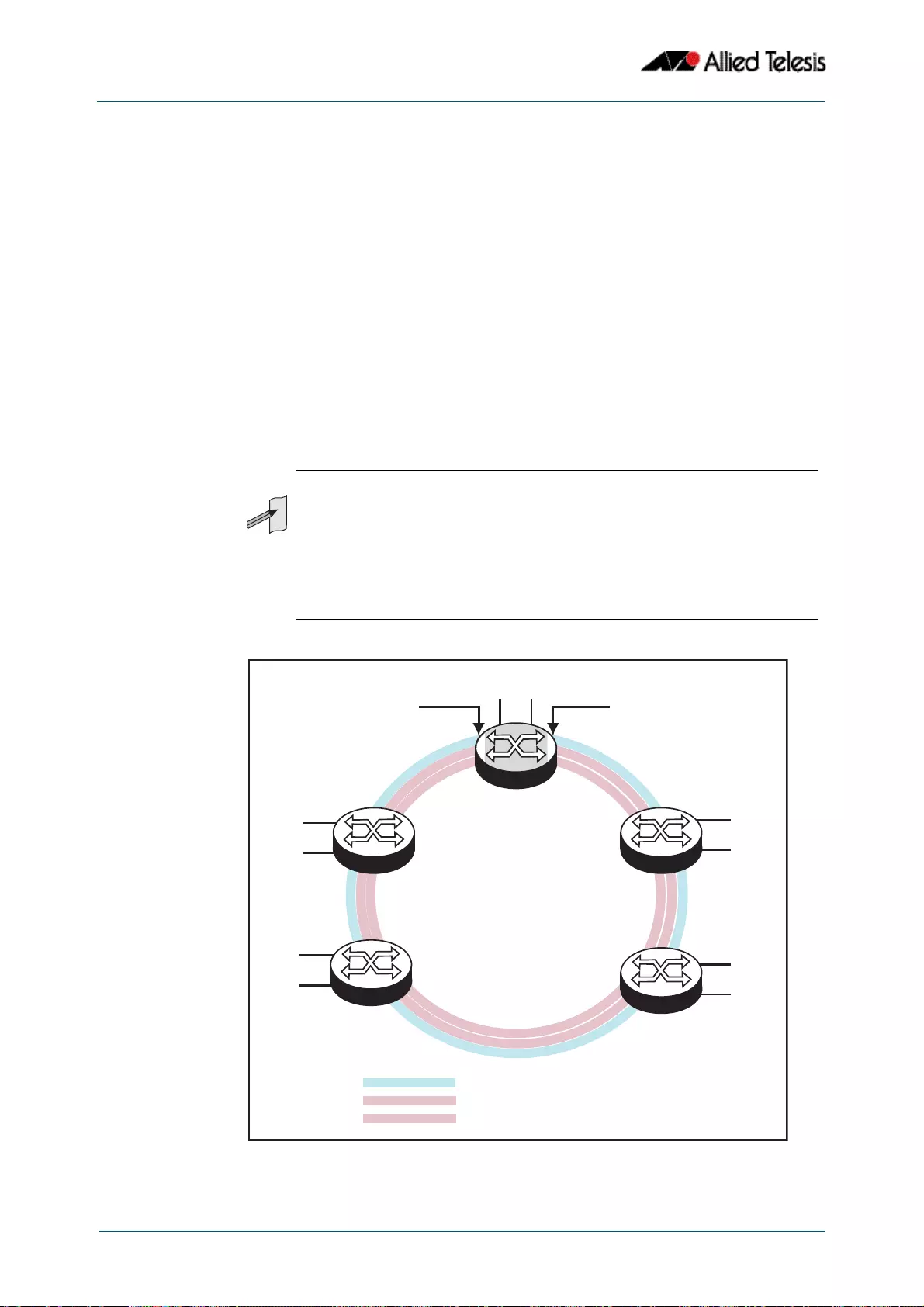
EPSR Introduction and Configuration
Software Reference for GS900MX/MPX Series Switches
57.2 AlliedWare PlusTM Operating System - Version 5.4.4E-1.x C613-50065-01 REV B
Introduction
Ethernet Protection Switching Ring (EPSR) is a protection system that prevents loops
within Ethernet ring based topologies. EPSR offers a rapid detection and recovery time (in
the order of 50 ms, depending on configuration) if a link or node fails. This rapid recovery
time makes EPSR a more effective alternative to spanning tree options when using ring-
based topologies to create high speed resilient Layer 2 networks.
Ring Components and Operation
EPSR operates only on ring-based topologies. An EPSR ring comprises a series of nodes
(Ethernet bridges) connected end to end. The figure below shows a basic ring
configuration. A ring comprises one master node and a number of transit nodes. Each
node connects to the ring via two ports. On the master node one port is configured to be
the primary port and the other, the secondary port.
Figure 57-1: Simple EPSR ring configuration
Note Within an EPSRing your switch can only operate as transit node. To form an
EPSR ring using switches of this type, you will need to use an alternative Allied
Telesis switch, such as an x610 Series switch or an x510 Series switch (with a
Premium License), to function as the master node.
In the configuration examples shown later in this chapter, master node
configuration is included for completeness; however, the commands shown
will need to be applied to the switch selected to be the master node.
D
a
t
a
V
L
A
N
_
2
D
a
t
a
V
L
A
N
_
1
C
o
n
t
r
o
l
V
L
A
N
Master
Node
Transit
Node
4
Data VLAN_1
Control VLAN
Primary Port
Transit
Node
3
Control VLAN
Data VLAN_2
P
S
Secondary Port
Control VLAN “forwarding”
Data VLAN “forwarding”
End User Ports
Transit
Node
2
End User Ports
End User Ports
End User Ports
Data VLAN_2
Transit
Node
1
End User Ports
Control VLAN “forwarding”
Data VLAN“blocked”
P
S
Data VLAN_1

EPSR Introduction and Configuration
Software Reference for GS900MX/MPX Series Switches
C613-50065-01 REV B AlliedWare PlusTM Operating System - Version 5.4.4E-1.x 57.3
EPSR instances
and domains
Each physical EPSR ring contains one or more EPSR domains. An EPSR instance can be
thought of as a component of an EPSR ring domain that exists on a single node. A set of
instances across the whole ring is called a “domain.” Therefore a ring whose individual
nodes each have two instances results in a two domain ring. Each instance contains a
control VLAN and a number of data VLANs.
The EPSR control VLAN and its associated data VLANs form a Ring Domain. Although a
physical ring can have more than one domain, each domain must operate as a separate
logical group of VLANs and must have its own master node. This means that several
domains may share the same physical network, but must operate as logically separate
VLAN groups.
Control VLAN The function of the control VLAN is to monitor the ring domain and maintain its
operational functions. To do this it transmits and monitors operational healthcheck
messages using EPSR healthcheck control frames. The control VLAN carries no user data.
Data VLAN The data VLAN carries the user data around the ring. Several data VLANs can share a
common control VLAN.
Master node The master node controls the ring operation. It issues healthcheck messages at regular
intervals from its primary port and monitors their arrival back at its secondary port - after
they have circled the ring. Under normal operating conditions the master node’s
secondary port is always in the blocking state to all data VLAN traffic. This is to prevent
data loops forming within the ring. This port however, operates in the forwarding state for
the traffic on the control VLAN. Loops do not occur on the control VLAN because the
control messages stop at the secondary port, having completed their path around the
ring.
Transit nodes The transit nodes operate as conventional Ethernet bridges, but with the additional
capability of running the EPSR protocol. This protocol requires the transit nodes to
forward the healthcheck messages from the master node, and respond appropriately
when a ring fault is detected. The fault condition procedure is explained in “Fault
Detection and Recovery” on page 57.4.
Note Within an EPSRing your switch can only operate as transit node. To form an
EPSR ring using switches of this type, you will need to use an alternative Allied
Telesis switch, such as an x610 Series switch or an x510 Series switch (with a
Premium License), to function as the master node.
In the configuration examples shown later in this chapter, master node
configuration is included for completeness; however, the commands shown
will need to be applied to the switch selected to be the master node.

EPSR Introduction and Configuration
Software Reference for GS900MX/MPX Series Switches
57.4 AlliedWare PlusTM Operating System - Version 5.4.4E-1.x C613-50065-01 REV B
Fault Detection and Recovery
EPSR uses the following methods to detect outages in a node or a link in the ring:
■Master node polling fault detection
■Transit node unsolicited fault detection
Master node
polling
The master node issues healthcheck messages from its primary port as a means of
checking the condition of the EPSR network ring. These messages are sent at regular
periods, controlled by the hellotime parameter of the epsr command on page 58.4. A
failover timer is set each time a healthcheck message leaves the master node’s primary
port. The timeout value for this timer is set by the failover parameter of the epsr
command on page 58.4. If the failover timer expires before the transmitted healthcheck
message is received by the master node’s secondary port, the master node assumes that
there is a fault in the ring, and implements its fault recovery procedures. Because this
method relies on a timer expiry, its operation is inherently slower than the “transit node
unsolicited detection method” described next.
Transit node
unsolicited
Transit node unsolicited fault detection relies on transit nodes detecting faults at their
interfaces, and immediately notifying master nodes about the break. When a transit node
detects a connectivity loss, it sends a “links down” message over its good link. Because a
link spans two nodes, both nodes send the “links down” message back to the master node.
These nodes also change their state from “links up” to “links down,” and change the state
of the port connecting to the broken link, from “forwarding” to “blocking.”
Fault Recovery
When the master node detects an outage in the ring by using its detection methods, it
does the following:
1. Declares the ring to be in a “failed” state.
2. Unblocks its secondary port to enable the data VLAN traffic to pass between its
primary and secondary ports.
3. Flushes its own forwarding database (FDB) for (only) the two ring ports.
4. Sends an EPSR Ring-Down-Flush-FDB control message to all the transit nodes, via
both its primary and secondary ports.
Transit nodes respond to the Ring-Down-Flush-FDB message by flushing their forward
databases for each of their ring ports. As the data starts to flow in the ring’s new
configuration, each of the nodes (master and transit) re-learn their Layer 2 addresses.
During this period, the master node continues to send health check messages over the
control VLAN. This situation continues until the faulty link or node is repaired. For a multi-
domain ring, this process occurs separately for each domain within the ring.
The following figure shows the flow of control frames under fault conditions.
Note When VCStack is used with EPSR, the EPSR failovertime must be set to at least 5
seconds to avoid any broadcast storms during failover. Broadcast storms may
occur if the switch cannot failover quickly enough before the EPSR failovertime
expires.
See the epsr command for further information about the EPSR failovertime.
See the reboot rolling command for further information about VCStack
failover.
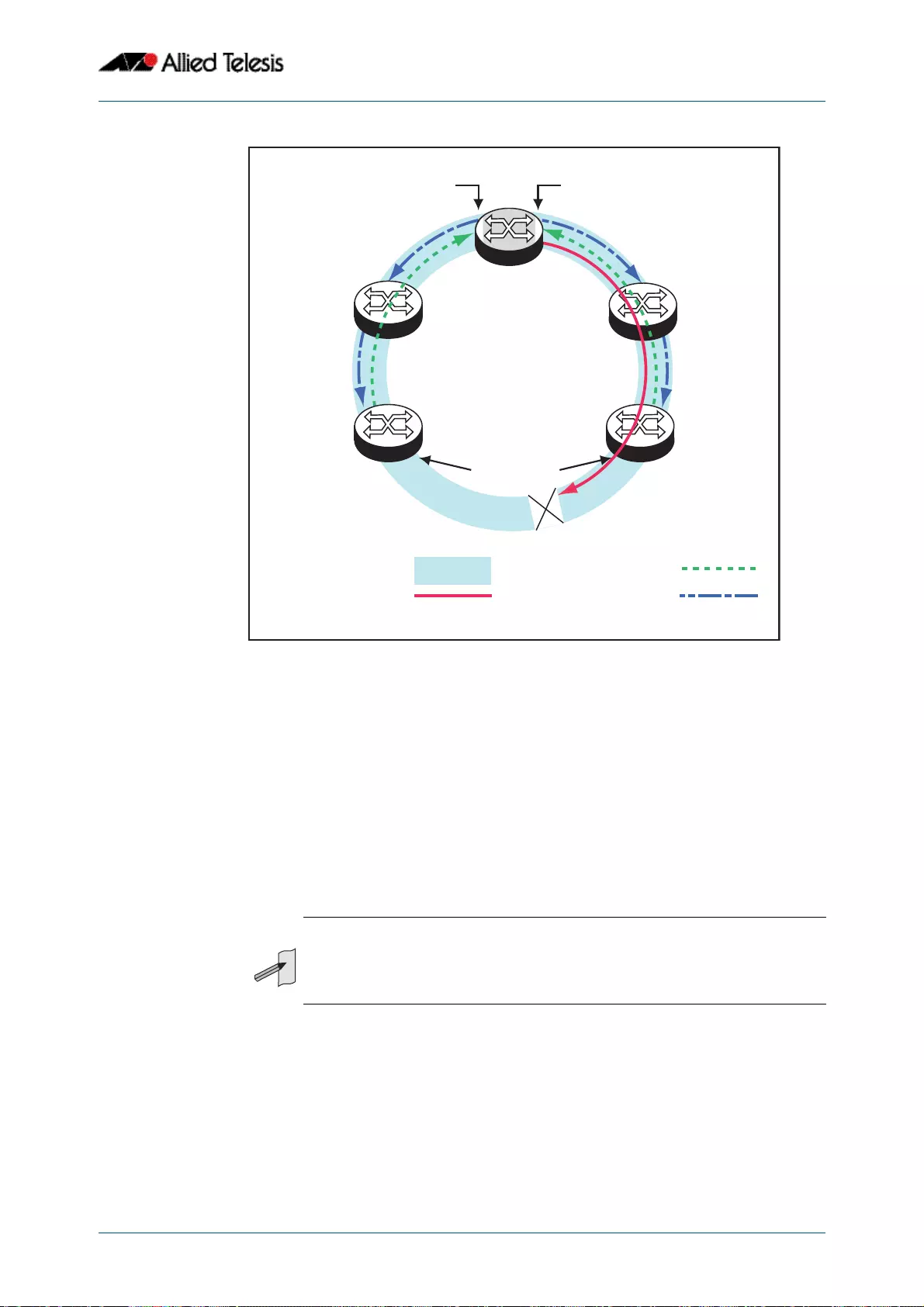
EPSR Introduction and Configuration
Software Reference for GS900MX/MPX Series Switches
C613-50065-01 REV B AlliedWare PlusTM Operating System - Version 5.4.4E-1.x 57.5
Figure 57-2: EPSR fault detection messages
Restoring Normal Operation
Transit nodes Once a fault in the ring or node has been rectified, the transit nodes that span the
previously faulty link section detect that link connectivity has returned. They then move
their appropriate ring port state, from Links-Down to Pre-Forwarding, and await the Ring-
Up-Flush control message from the master node.
Once these transit nodes receive the Ring-Up-Flush message, they:
■flush their forward databases for both their ring ports.
■change the state of their ports from blocking to forwarding, which allows data to flow
through their previously blocked ring ports.
Master node With the link restored, the healthcheck messages that are sent from the primary port of
the master node now complete the loop and arrive at the master node’s secondary port.
The master node restores normal conditions as follows:
1. Declares the ring to be in a “complete” state.
2. Blocks its secondary port for data (non-control) traffic.
3. Flushes its forwarding database for its two ring ports.
Master
Node Transit
Node
1
Transit
Node
4
Transit
Node
2
Master Node Hello Message
Control VLAN
Ring-Down-Flush-FDB Message
Transit
Node
3
Control Vlan “forwarding”
Data VLANs “forwarding”
Control VLAN “forwarding”
Data VLANs
“move from blocking to forwarding”
Data Ports move from
fowarding to blocking
Transit Node Links Down Message
P
S
(1)
(2)
(3)
Note The transit nodes do not enter the forward state until they have received the
Ring-Up-Flush message. This prevents the possibility of a loop condition
occurring caused by the transit nodes moving into the forwarding state before
the master node secondary port can return to the blocking state. During such a
period, the ring would have no ports blocked.

EPSR Introduction and Configuration
Software Reference for GS900MX/MPX Series Switches
57.6 AlliedWare PlusTM Operating System - Version 5.4.4E-1.x C613-50065-01 REV B
4. Sends a Ring-Up-Flush-FDB message from its primary port, to all transit nodes.
Managing Rings with Two Breaks
To restore a link with two breaks you need to run the EPSR Enhanced Recovery feature.
Consider the network shown below:
Figure 57-3: EPSR ring with two breaks
In this situation the ring will attempt to recover as previously described in “Fault
Recovery” on page 57.4. This will result in the split-ring operation shown in Figure 57-4.
Master
Node
Transit
Node
A
Transit
Node
E
Transit
Node
B
Transit
Node
C
Master Node Hello Message
Control VLAN
Transit
Node
D
(1)
PS
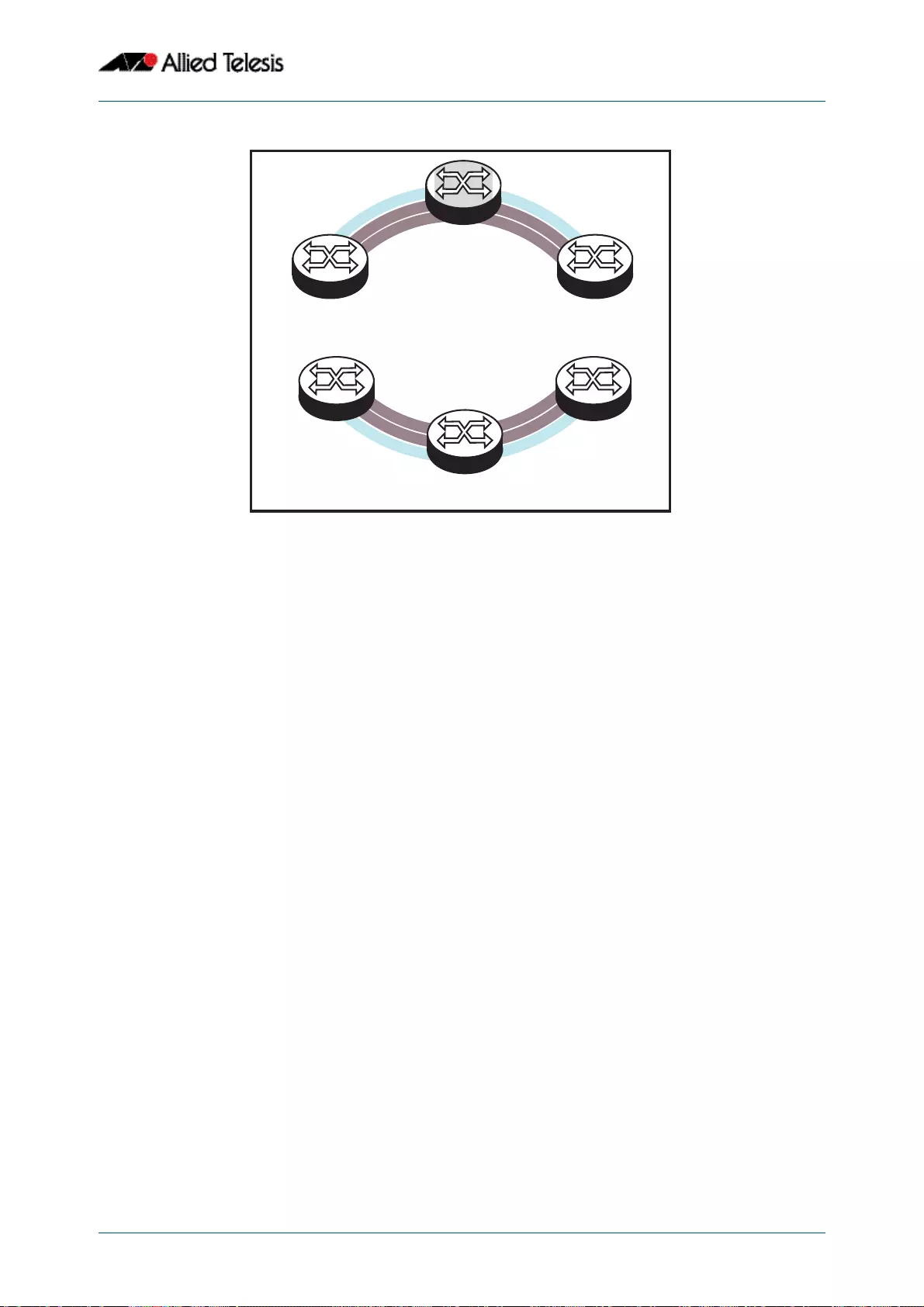
EPSR Introduction and Configuration
Software Reference for GS900MX/MPX Series Switches
C613-50065-01 REV B AlliedWare PlusTM Operating System - Version 5.4.4E-1.x 57.7
Figure 57-4: EPSR split ring
In this operational mode each portion of the ring operates as an independent link layer
broadcast domain each containing the original data VLANs and control VLAN.
D
a
t
a
V
L
A
N
_
2
D
a
t
a
V
L
A
N
_
1
C
o
n
t
r
o
l
V
L
A
N
Master
Node
Transit
Node
A
Transit
Node
E
PS
Transit
Node
B
Transit
Node
C
Transit
Node
D

EPSR Introduction and Configuration
Software Reference for GS900MX/MPX Series Switches
57.8 AlliedWare PlusTM Operating System - Version 5.4.4E-1.x C613-50065-01 REV B
Recovery When One Break is Restored
Figure 57-5 on page 57.8 shows a ring with the link between nodes A and B restored. At
this point the ring’s behavior will depend on whether the epsr enhancedrecovery enable
command on page 58.7 has been set.
Figure 57-5: EPSR ring with one link restored
Enhanced recovery disabled
With the enhanced recovery feature disabled, the Hello messages will now reach the
remaining ring break; however from a user’s perspective, the ring will remain as shown in
the split state shown in Figure 57-4.
Enhanced recovery enabled
With the enhanced recovery feature enabled, switch nodes A and B are able to detect the
restored link, and will place all their ring ports in the forwarding state. Although the ring
will remain in the “failed” state because of the remaining break; communication between
the nodes is restored. The network then operates as shown in Figure 57-6.
D
a
t
a
V
L
A
N
_
2
D
a
t
a
V
L
A
N
_
1
C
o
n
t
r
o
l
V
L
A
N
Master
Node Transit
Node
A
Transit
Node
E
Transit
Node
B
Transit
Node
C
Master Node Hello Message
Control VLAN
Transit
Node
D
PS
The data VLAN ports are in
the pre-forwarding mode
and still blocked.
Data VLANs

EPSR Introduction and Configuration
Software Reference for GS900MX/MPX Series Switches
C613-50065-01 REV B AlliedWare PlusTM Operating System - Version 5.4.4E-1.x 57.9
Figure 57-6: EPSR operation in partially recovered state
C
o
n
t
r
o
l
V
L
A
N
D
a
t
a
V
L
A
N
_
2
D
a
t
a
V
L
A
N
_
1
Master
Node Transit
Node
A
Transit
Node
E
Transit
Node
B
Transit
Node
C
Master Node Hello Message
Control VLAN
Transit
Node
D
PS
Data VLANs

EPSR Introduction and Configuration
Software Reference for GS900MX/MPX Series Switches
57.10 AlliedWare PlusTM Operating System - Version 5.4.4E-1.x C613-50065-01 REV B
Configuration Examples
This section describes how to configure EPSR in following ways:
■Single Domain, Single Ring Network
■Single Ring, Dual Domain Network
■EPSR and Spanning Tree Operation
Single Domain, Single Ring Network
This example shows a simple single ring, single domain configuration with no connecting
lobes.
Figure 57-7: EPSR single domain, single ring network
Master
Node
Other
Ports
Other
Ports
Other
Ports
Transit
Node 3
Transit
Node 1
Transit
Node 2
PS
Other
Ports
Port 1.0.1
Primary
Port 1.0.1
Port 1.0.1
Port 1.0.2
Port 1.0.1
Port 1.0.2
Port 1.0.2
Port 1.0.2
Secondary
C
o
n
t
r
o
l
V
L
A
N
D
a
t
a
V
L
A
N
C
o
n
t
r
o
l
V
L
A
N
D
a
t
a
V
L
A
N
Control VLAN (control_ring)
Data VLAN (data_ring)
VID = 5
VID = 40

EPSR Introduction and Configuration
Software Reference for GS900MX/MPX Series Switches
C613-50065-01 REV B AlliedWare PlusTM Operating System - Version 5.4.4E-1.x 57.11
Configure the Master Node
Step 1: Create the control and data VLANs on the Master Node
Step 2: Add port1.0.1 to these VLANs
Note Within an EPSRing your switch can only operate as transit node. To form an
EPSR ring using switches of this type, you will need to use an alternative Allied
Telesis switch, such as an x610 Series switch or an x510 Series switch (with a
Premium License), to function as the master node.
In the configuration examples shown later in this chapter, master node
configuration is included for completeness; however, the commands shown
will need to be applied to the switch selected to be the master node.
awplus#
configure terminal Enter the Global Configuration mode.
awplus(config)#
vlan database Enter the VLAN Configuration mode.
awplus(config-vlan)#
vlan 5 name control_vlan state enable Enable VLAN 5 called control_vlan on the Master
Node. Specifying the enable state allows forwarding of
frames on the VLAN-aware node.
awplus(config-vlan)#
vlan 40 name data_vlan state enable Enable VLAN 40 called data_vlan on the Master
Node. Specifying the enable state allows forwarding of
frames on the VLAN-aware node.
awplus(config-vlan)#
exit Exit the VLAN Configuration mode and enter the Global
Configuration mode.
awplus(config)#
interface port1.0.1 Specify the interface (port1.0.1) that you are
configuring and enter the Interface Configuration
mode.
awplus(config-if)#
switchport mode trunk Set the switching characteristics of this port to Trunk
mode.
awplus(config-if)#
switchport trunk allowed vlan add 5 Enable VLAN 5 on this port.
awplus(config-if)#
switchport trunk allowed vlan add 40 Enable VLAN 40 on this port.
awplus(config-if)#
exit Exit the Interface mode and enter the Global
Configuration mode.

EPSR Introduction and Configuration
Software Reference for GS900MX/MPX Series Switches
57.12 AlliedWare PlusTM Operating System - Version 5.4.4E-1.x C613-50065-01 REV B
Step 3: Add port1.0.2 to these VLANs
awplus(config)#
interface port1.0.2 Specify the interface (port1.0.2) that you are
configuring and enter the Interface Configuration
mode.
awplus(config-if)#
switchport mode trunk Set the switching characteristics of this port to Trunk
mode.
awplus(config-if)#
switchport trunk allowed vlan add 5 Enable VLAN 5 on this port.
awplus(config-if)#
switchport trunk allowed vlan add 40 Enable VLAN 40 on this port.
awplus(config-if)#
exit Exit the Interface Configuration mode and enter the
Global Configuration mode.

EPSR Introduction and Configuration
Software Reference for GS900MX/MPX Series Switches
C613-50065-01 REV B AlliedWare PlusTM Operating System - Version 5.4.4E-1.x 57.13
Step 4: Create the EPSR instance called “blue” on the master node; make VLAN 5 the
control VLAN and port 1.0.1 the primary port
Step 5: Add a data VLAN to the EPSR instance called “blue” on the Master Node
Step 6: Enable the EPSR instance called “blue” on the Master Node
Now you can configure the transit nodes.
awplus(config)#
epsr configuration Enter the EPSR Configuration mode.
awplus(config-epsr)#
epsr blue mode master controlvlan 5
primaryport port1.0.1
Create an EPSR instance called blue on vlan5.
Make vlan5 the control VLAN.
Make port 1.0.1 the primary port.
Make this node the master.
Note that you can only run this command on switches
that have EPSR Master capability.
awplus(config-epsr)#
epsr blue datavlan 40 On epsr instance called blue make vlan40 the data
VLAN.
Note that you can only run this command on switches
that have EPSR Master capability.
awplus(config-epsr)#
epsr blue state enable Enable the EPSR instance named blue.
Note that you can only run this command on switches
that have EPSR Master capability.
awplus(config-epsr)#
exit Exit the EPSR Configuration mode.

EPSR Introduction and Configuration
Software Reference for GS900MX/MPX Series Switches
57.14 AlliedWare PlusTM Operating System - Version 5.4.4E-1.x C613-50065-01 REV B
Step 7: Create the control and data VLANs on a transit node
Step 8: Add port1.0.1 to the VLANs
awplus#
configure terminal Enter the Global Configuration mode.
awplus(config)#
vlan database Enter the VLAN Configuration mode.
awplus(config-vlan)#
vlan 5 name control_vlan state enable Enable VLAN 5 called control_vlan on the transit
node. Specifying the enable state allows forwarding of
frames on the VLAN-aware node.
awplus(config-vlan)#
vlan 40 name data_vlan state enable Enable VLAN 40 called data_vlan on the transit
node. Specifying the enable state allows forwarding of
frames on the VLAN-aware node.
awplus(config-vlan)#
exit Exit the VLAN Configuration mode and enter the
Global Configuration mode.
awplus(config)#
interface port1.0.1 Specify the interface (port1.0.1) that you are
configuring and enter the Interface Configuration
mode.
awplus(config-if)#
switchport mode trunk Set the switching characteristics of this port to Trunk
mode.
awplus(config-if)#
switchport trunk allowed vlan add 5 Enable VLAN 5 on this port.
awplus(config-if)#
switchport trunk allowed vlan add 40 Enable VLAN 40 on this port.
awplus(config-if)#
exit Exit the Interface Configuration mode and enter the
Global Configuration mode.

EPSR Introduction and Configuration
Software Reference for GS900MX/MPX Series Switches
C613-50065-01 REV B AlliedWare PlusTM Operating System - Version 5.4.4E-1.x 57.15
Step 9: Add port1.0.2 to the VLANs
Step 10: Create the EPSR instance called “blue” on a transit node, make VLAN 5 the
control VLAN
Step 11: Add a data VLAN to the EPSR instance called “blue” on the transit node
Step 12: Enable the EPSR instance called “blue” on the transit node
Now you can use the same procedure to configure the remaining transit nodes.
awplus(config)#
interface port1.0.2 Specify the interface (port1.0.2) that you are
configuring and enter the Interface Configuration
mode.
awplus(config-if)#
switchport mode trunk Set the switching characteristics of this port to Trunk
mode.
awplus(config-if)#
switchport trunk allowed vlan add 5 Enable VLAN 5 on this port.
awplus(config-if)#
switchport trunk allowed vlan add 40 Enable VLAN 40 on this port.
awplus(config-if)#
exit Exit the Interface Configuration mode and enter the
Global Configuration mode.
awplus(config)#
epsr configuration Enter the EPSR Configuration mode.
awplus(config-epsr)#
epsr blue mode transit controlvlan 5 Create an EPSR instance called blue on vlan5.
Make vlan5 the control VLAN.
Make this node a transit node.
awplus(config-epsr)#
epsr blue datavlan 40 On the EPSR instance called blue make vlan40 the
data VLAN.
awplus(config-epsr)#
epsr blue state enable Enable the EPSR instance named blue.
awplus(config-epsr)#
exit Exit the EPSR Configuration mode.

EPSR Introduction and Configuration
Software Reference for GS900MX/MPX Series Switches
57.16 AlliedWare PlusTM Operating System - Version 5.4.4E-1.x C613-50065-01 REV B
Single Ring, Dual Domain Network
This example shows an EPSR configuration where two EPSR domains share the same
physical ring. This configuration enables two sets of users to run totally separate Layer 2
networks. Better load distribution around the ring can be achieved by configuring
different nodes to be the master for each ring.
Figure 57-8: EPSR single ring network, two domain network
Control VLAN (control_ring) Ring_A
Transit Node
Ring_A
Transit Node
Ring_A
Transit Node
Ring_B
Master Node
Ring_B
Master Node
Ring_A
Transit Node
Ring_B
Transit Node
Ring_B
Transit Node
Ring_A
Data VLAN (data_ring) Ring_A
Control VLAN (control_ring) Ring_B
EPSR Ring
Data VLAN (data_ring) Ring_B
Port 1.0.3
Primary
Ring_B
Port 4
Port 1.0.4
Port 1.0.4
Port 3
Port 1.0.3
Port 1.0.3
Port 1.0.4
Secondary
Ring_B
Port 1.0.2
Secondary
Ring_A
Port 1.0.2Port 1.0.1
Port 1.0.1Port 1.0.2
Port 1.0.2Port 1.0.1
Port 1.0.1
Primary
Ring_A
Node 1
Node 4
Node 3
Node 2
C
o
n
t
r
o
l
V
L
A
N
R
i
n
g
_
A
D
a
t
a
V
L
A
N
R
i
n
g
_
A
D
a
t
a
V
L
A
N
R
i
n
g
_
B
C
o
n
t
r
o
l
V
L
A
N
R
i
n
g
_
B

EPSR Introduction and Configuration
Software Reference for GS900MX/MPX Series Switches
C613-50065-01 REV B AlliedWare PlusTM Operating System - Version 5.4.4E-1.x 57.17
Interconnected Rings
This example shows an EPSR configuration where two rings share a common segment.
This configuration will operate as two independent rings, providing that there is no data
VLAN sharing between the two rings. If a break occurs in either ring then, each ring will
implement its own independent recovery procedures. If a break occurs in the common
segment, then each Master node will unblock its secondary port using the normal fault
recovery procedure.
Where data VLANS are shared between the rings a fault condition know as “SuperLoop”
can occur. The next section deals with superloops and how to manage them.
Figure 57-9: Interconnected EPSR Rings with no data VLAN sharing
Transit
Node
Transit
Node
Transit
Node
Transit
Node
Primary
Port
Secondary
Port
Transit
Node
Master
Node
Master
Node
Transit
Node
Blocked
Blocked
Data VLAN
Control VLAN
Data VLAN
Control VLAN
Primary
Port
Secondary
Port
Control VLAN (Ring One)
Data VLAN (Ring One)
Ring One
Ring Two
Control VLAN (Ring Two)
Data VLAN (Ring Two)
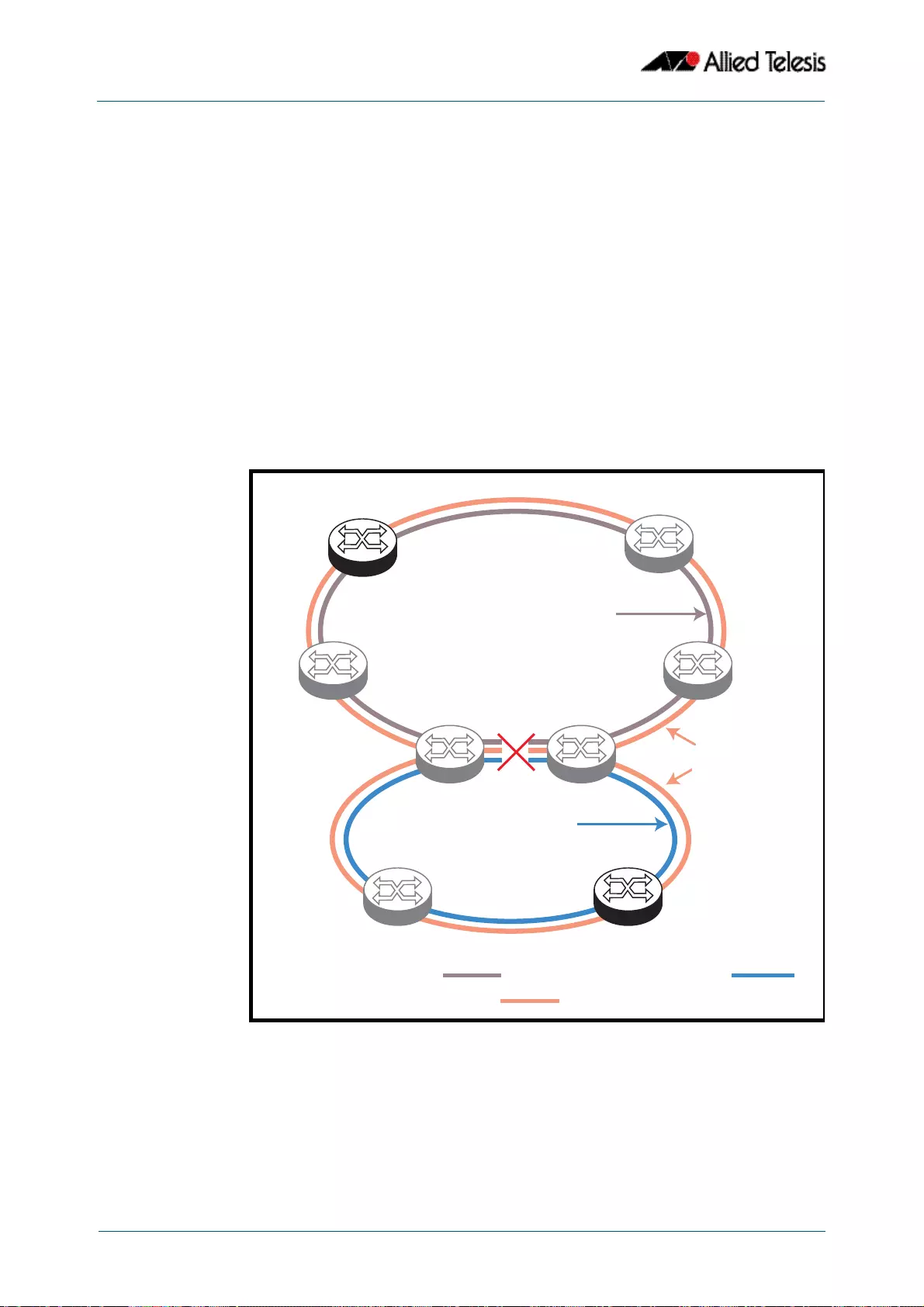
EPSR Introduction and Configuration
Software Reference for GS900MX/MPX Series Switches
57.18 AlliedWare PlusTM Operating System - Version 5.4.4E-1.x C613-50065-01 REV B
Superloop Protection
Careful attention must be paid when creating EPSR networks with interconnecting links,
to avoid an error condition known as superloops. This sections explains what superloops
are and how to prevent them.
What is a an EPSR superloop?
An EPSR superloop is a data loop whose path traverses more than a single EPSR ring. This
fault condition usually occurs when there is a break in a physical segment that is shared by
the two rings. For a superloop condition to occur, the two physical rings must share some
of their data VLANS. Figure 57-10 on page 57.18shows an EPSR ring with a superloop
condition caused by a break in the common ring segment. Figure 57-11 on page 57.19
shows the Superloop data path ring caused by the broken common ring segment. The
superloop condition occurs because both rings detect the ring segment break and as a
result both master nodes unblock their secondary ports.
Figure 57-10: Interconnected EPSR rings with data VLAN sharing
Transit
Node
Transit
Node
Transit
Node E
Transit
Node
Primary
Port
Secondary
Port
Transit
Node Master
Node
Master
Node
Transit
Node D
Port
Unblocks
Same Data VLAN
Control VLAN
Control VLAN
Primary
Port
Secondary
Port
Common
Segment
(Broken)
Port
Unblocks
Ring One
Ring Two
Control VLAN (Ring One)
Data VLAN (Ring One and Ring Two)
Control VLAN (Ring Two)

EPSR Introduction and Configuration
Software Reference for GS900MX/MPX Series Switches
C613-50065-01 REV B AlliedWare PlusTM Operating System - Version 5.4.4E-1.x 57.19
Figure 57-11: EPSR superloop data path caused by a broken common ring segment
EPSR Superloop Prevention
Alliedware Plus version 5.4.2 onwards contains mechanisms to prevent superloops
forming. The Superloop prevention facility enables rings to be assigned priority level
between 0 and 127, with 1 representing the lowest priority and 127 the highest. Level 0
(the default setting) applies the functionality of no Superloop prevention. Enabling
superloop prevention changes the way the EPSR nodes respond under fault conditions.
Superloop prevention is enabled for an EPSR ring instance by setting the epsr priority
command on page 58.10. Setting a priority value greater than 0 applies superloop
prevention to that particular instance. How the superloop function is applied will depend
on the role of the node within the ring, i.e. whether it is a master node or a transit node,
and its physical location within the ring. Here is how the functions of Superloop
prevention modify the nodal behavior for a particular ring instance:
■A master node with its epsr priority set to zero will consider the superloop function to
be turned off.
■A master node with its epsr priority set within the range 1-127 will consider the
superloop function to be enabled, and will change its behavior in the following ways.
« It will not unblock its secondary port following the expiry of the Master Node
Hello message timer. However, a ring-down-flush message will still be sent.
« It will only unblock its secondary port when it receives a Links Down message
from a transit node.
■A transit node that is not connect to a shared link will be unaffected by having its epsr
priority set for any of its instances.
■A transit node that is connected to a shared link will change its behavior in the
following ways:
« It will compare its priority settings applied to each of the instances sharing the
common link. So for the network of Figure 57-10 on page 57.18 Transit Node D
Data Path
Superloop
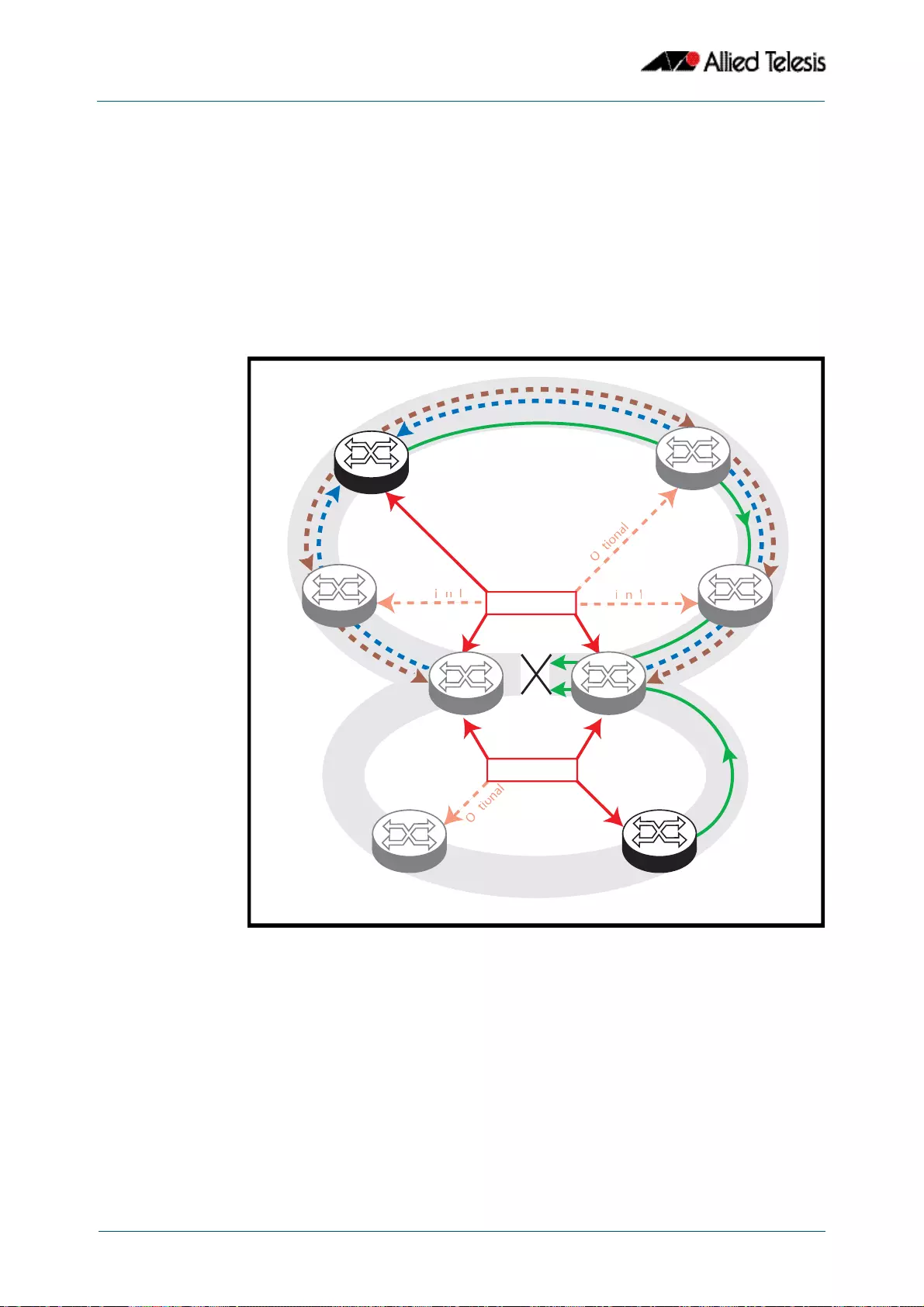
EPSR Introduction and Configuration
Software Reference for GS900MX/MPX Series Switches
57.20 AlliedWare PlusTM Operating System - Version 5.4.4E-1.x C613-50065-01 REV B
will compare the priority setting for Ring One, with the priority setting for Ring
Two.
If the shared link fails, the transit node will only issue a Transit Node Links Down
message on the ring that is configured with the highest priority.
The result of these behavior changes is that when the shared link fails, only the master
node located on the higher priority ring will unblock its secondary port; because this is the
only master node that will receive the Transit Node Links Down message. Note also that
the master node will receive these messages from the transit nodes at either end of the
broken shared link (Nodes D and E). This concept is illustrated in the following figure.
Figure 57-12: EPSR behavior under fault conditions with superloop enabled
For this process to work certain configuration rules must be obeyed.
L
i
n
k
s
D
o
w
n
M
e
s
s
a
g
e
-
O
n
l
y
s
e
n
t
t
o
h
i
g
h
p
r
i
o
r
i
t
y
m
a
s
t
e
r
R
i
n
g
D
o
w
n
F
l
u
s
h
M
e
s
s
a
g
e
-
O
n
l
y
s
e
n
t
f
r
o
m
h
i
g
h
p
r
i
o
r
i
t
y
m
a
s
t
e
r
H
e
a
l
t
h
c
h
e
c
k
M
e
s
s
a
g
e
s
-
T
i
m
e
o
u
t
E
x
c
e
e
d
e
d
O
p
t
i
o
n
a
l
Priority 60
Priority 120
O
p
t
i
o
n
a
l
O
p
t
i
o
n
a
l
O
p
t
i
o
n
a
l
H
e
a
l
t
h
c
h
e
c
k
M
e
s
s
a
g
e
s
-
T
i
m
e
o
u
t
Primary
Port
Secondary
Port
Master
Node-L1
Port
Unblocks
Master
Node-L2
Primary
Port
Secondary
Port
Remains
Blocked
Transit
Node D
Transit
Node E
Common
Segment
(broken)

EPSR Introduction and Configuration
Software Reference for GS900MX/MPX Series Switches
C613-50065-01 REV B AlliedWare PlusTM Operating System - Version 5.4.4E-1.x 57.21
Configuration rules for superloop protected EPSR rings
The following configuration rules are advised when configuring EPSR rings that share one
or more common segments.
■Allocate a priority order to each of the interconnected rings, with 127 being the
highest priority and 1 the lowest.
■A higher priority ring can have its master node located in any position; although,
where possible, avoid connecting a common segment to the secondary port of a
master node.
■Do not locate the master node on a segment that is shared with a higher priority ring,
but you “can” locate it on a common segment that is shared with a lower priority ring.
In this situation however, the port that connects to the common segment must be
configured as the primary port.
For example, in Figure 57-12, the upper portion of Node D could be configured as a
Master Node of the upper ring (having a priority of 120), but its lower portion must be
configured as a transit node (having the lower priority of 60).
■On the transit nodes that connect to shared links, allocate the ring’s priority to the
ports that connect to each ring. Note that both of these nodes “must” be set to the
same priority value.
Note For good practice, we advise that you set all nodes within a ring to the priority
assigned to that ring. So, for the network of Figure 57-12 each of the nodes
that form part of the upper ring would be configured with a priority of 120, and
each of the nodes that form the lower ring would all be configured with a
priority of 60.

EPSR Introduction and Configuration
Software Reference for GS900MX/MPX Series Switches
57.22 AlliedWare PlusTM Operating System - Version 5.4.4E-1.x C613-50065-01 REV B
Configuring a Basic Superloop Protected Two Ring
EPSR Network
Configuration example
This section shows how to configure a basic EPSR network such as that shown in the figure
below.
Figure 57-13: EPSR two shared ring example
The configuration suggested comprises the following basic steps:
■“On Ring 1- configure the Master Node R-1” on page 57.23
■“On Ring 1 - configure the transit nodes A to C” on page 57.25
■“On Ring 2 - configure the Master Node R-2” on page 57.27
■“On Rings 1 and 2 - configure the Transit Nodes D and E” on page 57.29
■“On Ring 2 - configure the Transit Node F” on page 57.34
E
P
S
R
I
n
s
t
a
n
c
e
B
l
u
e
Priority 60
Priority 120
Primary
Port 1.0.1
Secondary
Port 1.0.2
Master
Node R-1
Primary
Port
Secondary
Port
Transit
Node D-R1
Transit
Node E-R1
Transit
Node A-R1
Transit
Node B-R1
Transit
Node C-R1
Ring 1
Ring 2
Transit
Node D-R2 Transit
Node E-R2
Transit
Node F-R2 Master
Node R-2
Loop 1 comprises:
Control VLAN 5 (ctrl-blue)
Data VLAN 40 (data-a)
Loop 2 comprises:
Control VLAN 6 (ctrl-green)
Data VLAN 40 (data-a)
Common
Segment
E
P
S
R
I
n
s
t
a
n
c
e
G
r
e
e
n
Port 1.0.1
Port 1.0.2 Port 1.0.2
Port 1.0.2 Port 1.0.2
Port 1.0.1
Port 1.0.1
Port 1.0.2 Port 1.0.2
Port 1.0.3
Port 1.0.1
Port 1.0.3

EPSR Introduction and Configuration
Software Reference for GS900MX/MPX Series Switches
C613-50065-01 REV B AlliedWare PlusTM Operating System - Version 5.4.4E-1.x 57.23
On Ring 1- configure the Master Node R-1
Step 1: Create the control and data VLANs (configure on the Master Node R-1)
Step 2: Add the control VLAN (ctrl-blue) to the ring ports
Note Within an EPSRing your switch can only operate as transit node. To form an
EPSR ring using switches of this type, you will need to use an alternative Allied
Telesis switch, such as an x610 Series switch or an x510 Series switch (with a
Premium License), to function as the master node.
In the configuration examples shown later in this chapter, master node
configuration is included for completeness; however, the commands shown
will need to be applied to the switch selected to be the master node.
awplus#
configure terminal Enter the Global Configuration mode.
awplus(config)#
vlan database Enter the VLAN Configuration mode.
awplus(config-vlan)#
vlan 5 name ctrl-blue state enable Enable VLAN 5 called ctrl-blue on the Master Node R-1.
Specifying the enable state allows forwarding of frames
on the VLAN-aware node.
awplus(config-vlan)#
vlan 40 name data-a state enable Enable VLAN 40 called data-a on the Master Node R-1.
Specifying the enable state allows forwarding of frames
on the VLAN-aware node.
awplus(config-vlan)#
exit Exit the VLAN Configuration mode and enter the Global
Configuration mode.
awplus(config)#
interface port1.0.1,port1.0.2 Specify the two ring ports (port1.0.1 and
port1.0.2) that you are configuring and enter the
Interface Configuration mode.
awplus(config-if)#
switchport mode trunk Set the switching characteristics of these ports to
Trunk mode.
awplus(config-if)#
switchport trunk allowed vlan add 5 Enable VLAN 5 on these ports.
awplus(config-if)#
switchport trunk native vlan none Remove the native VLAN from these ring ports.

EPSR Introduction and Configuration
Software Reference for GS900MX/MPX Series Switches
57.24 AlliedWare PlusTM Operating System - Version 5.4.4E-1.x C613-50065-01 REV B
Step 3: Create the EPSR instance called “blue”, make VLAN 5 the control VLAN and port
1.0.1 the primary port (configure on the Master Node R-1)
Step 4: Add a data VLAN to the EPSR instance called “blue” (Configure on the Master Node R-1)
Step 5: Assign a priority to the ring instance (Configure on the Master Node R-1)
Step 6: Enable the EPSR instance called “blue” (configure on the Master Node R-1)
Step 7: Add to these VLANs (configure on the Master Node R-1)
awplus(config-epsr)#
epsr blue mode master controlvlan 5
primaryport port1.0.1
Create an EPSR instance called blue on vlan 5.
Make vlan 5 the control VLAN.
Make port 1.0.1 the primary port.
Make this node the master.
awplus(config-epsr)#
epsr blue datavlan 40 On epsr instance called blue data-a the data VLAN.
awplus(config-epsr)#
epsr blue priority 120 Set the ring instance priority to the value selected for
the ring. The priority value selected is 120.
awplus(config-epsr)#
exit Exit the EPSR Configuration mode.
awplus(config-epsr)#
epsr blue state enable Enable the EPSR instance named blue.
awplus(config-epsr)#
exit Exit the EPSR Configuration mode.
awplus(config-if)#
switchport trunk allowed vlan add 40 Enable VLAN 40 on this port.
awplus(config-if)#
exit Exit the Interface mode and enter the Global
Configuration mode.

EPSR Introduction and Configuration
Software Reference for GS900MX/MPX Series Switches
C613-50065-01 REV B AlliedWare PlusTM Operating System - Version 5.4.4E-1.x 57.25
On Ring 1 - configure the transit nodes A to C
Step 1: Create the control and data VLANs (on Transit Nodes A to C)
Step 2: Add the EPSR control vlan (ctrl-blue) to EPSR ring ports
awplus#
configure terminal Enter the Global Configuration mode.
awplus(config)#
vlan database Enter the VLAN Configuration mode.
awplus(config-vlan)#
vlan 5 name ctrl-blue state enable Enable VLAN 5 called ctrl-blue on the transit node.
Specifying the enable state allows forwarding of frames
on the VLAN-aware node.
awplus(config-vlan)#
vlan 40 name data-a state enable Enable VLAN 40 called data-a on the transit node.
Specifying the enable state allows forwarding of frames
on the VLAN-aware node.
awplus(config-vlan)#
exit Exit the VLAN Configuration mode and enter the Global
Configuration mode.
awplus(config)#
interface port1.0.1,port1.0.2 Specify the two ring ports (port1.0.1 and
port1.0.2) that you are configuring and enter the
Interface Configuration mode.
awplus(config-if)#
switchport mode trunk Set the switching characteristics of this port to Trunk
mode.
awplus(config-if)#
switchport trunk allowed vlan add 5 Enable VLAN 5 on these ports.
awplus(config-if)#
switchport trunk native vlan none Remove the native VLAN from the ring ports.

EPSR Introduction and Configuration
Software Reference for GS900MX/MPX Series Switches
57.26 AlliedWare PlusTM Operating System - Version 5.4.4E-1.x C613-50065-01 REV B
Step 3: Create the EPSR instance called “blue”, make VLAN 5 the control VLAN (on Transit
Nodes A to C)
Step 4: Add a data VLAN to the EPSR instance called “blue” (on Transit Nodes A to C)
Step 5: Assign a priority to the ring instance (on Transit Nodes A to C)
Step 6: Enable the EPSR instance called “blue” (on Transit Nodes A to C)
Step 7: Add the physical ports 1.0.1 and 1.0.2 to VLAN 40 (on Transit Nodes A to C)
awplus(config)#
epsr configuration Enter the EPSR Configuration mode.
awplus(config-epsr)#
epsr blue mode transit controlvlan 5 Create an EPSR instance called blue on vlan 5.
Make vlan 5 the control VLAN.
Make this node a transit node.
awplus(config-epsr)#
epsr blue datavlan 40 On the EPSR instance called blue make vlan 40 the
data VLAN.
This step is mandatory on transit nodes that connect to a common segment, and good practice on other
transit nodes.
awplus(config-epsr)#
epsr blue priority 120 Set the ring instance priority to the priority selected
for the ring 120.
awplus(config-epsr)#
epsr blue state enable Enable the EPSR instance named blue.
awplus(config-epsr)#
exit Exit the EPSR Configuration mode.
awplus(config)#
interface port1.0.1,port1.0.2 Specify the physical ring ports (ports1.0.1 and
ports 1.0.2) that you are configuring and enter the
Interface Configuration mode.
awplus(config-if)#
switchport trunk allowed vlan add 40 Enable VLAN 40 on these ports.
awplus(config-if)#
exit Exit the Interface mode and enter the Global
Configuration mode.

EPSR Introduction and Configuration
Software Reference for GS900MX/MPX Series Switches
C613-50065-01 REV B AlliedWare PlusTM Operating System - Version 5.4.4E-1.x 57.27
On Ring 2 - configure the Master Node R-2
Step 1: Create the control and data VLANs (configure on the Master Node R-2)
Step 2: Add the control VLAN (ctrl-green) to the ring ports
awplus#
configure terminal Enter the Global Configuration mode.
awplus(config)#
vlan database Enter the VLAN Configuration mode.
awplus(config-vlan)#
vlan 6 name ctrl-green state enable Enable vlan 6 called ctrl-green on the Master Node R-2.
Specifying the enable state allows forwarding of frames
on the VLAN-aware node.
awplus(config-vlan)#
vlan 40 name data-a state enable Enable VLAN 40 called data-a on the Master Node R-2.
Specifying the enable state allows forwarding of frames
on the VLAN-aware node.
awplus(config-vlan)#
exit Exit the VLAN Configuration mode and enter the Global
Configuration mode.
awplus(config)#
interface port1.0.1,port1.0.2 Specify the ports (port1.0.1 and port1.0.2)
that you are configuring, and enter the Interface
Configuration mode.
awplus(config-if)#
switchport trunk allowed vlan add 6 Enable vlan 6 on these ports.
awplus(config-if)#
switchport trunk native vlan none Remove the native VLAN from these ring ports.

EPSR Introduction and Configuration
Software Reference for GS900MX/MPX Series Switches
57.28 AlliedWare PlusTM Operating System - Version 5.4.4E-1.x C613-50065-01 REV B
Step 3: Create the EPSR instance called “green”, make VLAN 6 the control VLAN and
port1.0.1 the primary port (configure on the Master Node R-2)
Step 4: Add a data VLAN to the EPSR instance “green” (configure on the Master Node R-2)
Step 5: Assign a priority to the ring instance (configure on the Master Node R-2)
Step 6: Enable the EPSR instance called “green” (configure on the Master Node R-2)
awplus(config)#
epsr configuration Enter the EPSR Configuration mode.
awplus(config-epsr)#
epsr green mode master controlvlan 6
primaryport port1.0.1
Create an EPSR instance called ctrl-green on
vlan 6.
Make vlan 6 the control VLAN.
Make port 1.0.1 the primary port.
Make this node the master.
awplus(config-epsr)#
epsr green datavlan 40 On epsr instance called green make vlan 40 the
data VLAN.
This step is mandatory on transit nodes that connect to a common segment, and good practice on other
transit nodes.
awplus(config-epsr)#
epsr green priority 60 Set the ring instance priority to the value selected for
the ring. The priority value selected is 60.
awplus(config-epsr)#
epsr green state enable Enable the EPSR instance named green.
awplus(config-epsr)#
exit Exit the EPSR Configuration mode.

EPSR Introduction and Configuration
Software Reference for GS900MX/MPX Series Switches
C613-50065-01 REV B AlliedWare PlusTM Operating System - Version 5.4.4E-1.x 57.29
Step 7: Add ports 1.0.1 and 1.0.2 to these VLANs (configure on the Master Node R-2)
On Rings 1 and 2 - configure the Transit Nodes D and E
Step 1: Create the control and data VLANs (on Transit Nodes D and E)
awplus(config)#
interface port1.0.1,port1.0.2 Specify the ports (port1.0.1 and port1.0.2)
that you are configuring and enter the Interface
Configuration mode.
awplus(config-if)#
switchport mode trunk Set the switching characteristics of these ports to
Trunk mode.
awplus(config-if)#
switchport trunk allowed vlan add 40 Enable VLAN 40 on this port
awplus(config-if)#
exit Exit the Interface mode and enter the Global
Configuration mode.
awplus#
configure terminal Enter the Global Configuration mode.
awplus(config)#
vlan database Enter the VLAN Configuration mode.
awplus(config-vlan)#
vlan 5 name ctrl-blue state enable Enable VLAN 5 called ctrl-blue on the transit
node. Specifying the enable state allows
forwarding of frames on the VLAN-aware node.
awplus(config-vlan)#
vlan 40 name data-a state enable Enable VLAN 40 called data-a on the transit
node. Specifying the enable state allows
forwarding of frames on the VLAN-aware node.
awplus(config-vlan)#
vlan 6 name ctrl-green state enable Enable VLAN 6 called ctrl-green on the transit
node. Specifying the enable state allows
forwarding of frames on the VLAN-aware node.
awplus(config-vlan)#
exit Exit the VLAN Configuration mode and enter the
Global Configuration mode.

EPSR Introduction and Configuration
Software Reference for GS900MX/MPX Series Switches
57.30 AlliedWare PlusTM Operating System - Version 5.4.4E-1.x C613-50065-01 REV B
Step 2: Add physical port1.0.1 to these VLANs (on Transit Nodes D and E)
Step 3: Add physical port1.0.2 to these VLANs (on Transit Nodes D and E)
awplus(config)#
interface port1.0.1 Specify the physical interface (port1.0.1)
that you are configuring and enter the Interface
Configuration mode.
awplus(config-if)#
switchport mode trunk Set the switching characteristics of this port to Trunk
mode.
awplus(config-if)#
switchport trunk allowed vlan add 5 Enable VLAN 5 on this port.
awplus(config-if)#
switchport trunk native vlan none Remove the native VLAN.
awplus(config-if)#
exit Exit the Interface mode and enter the Global
Configuration mode.
awplus(config)#
interface port1.0.2 Specify the physical interface (port1.0.2)
that you are configuring and enter the Interface
Configuration mode.
awplus(config-if)#
switchport mode trunk Set the switching characteristics of this port to Trunk
mode.
awplus(config-if)#
switchport trunk allowed vlan add 5 Enable VLAN 5 (ctrl-blue) on this port.
awplus(config-if)#
switchport trunk allowed vlan add 6 Enable VLAN 6 (ctrl-green) on this port.
awplus(config-if)#
switchport trunk native vlan none Remove the native VLAN.
awplus(config-if)#
exit Exit the Interface mode and enter the Global
Configuration mode.

EPSR Introduction and Configuration
Software Reference for GS900MX/MPX Series Switches
C613-50065-01 REV B AlliedWare PlusTM Operating System - Version 5.4.4E-1.x 57.31
Step 4: Add physical port1.0.3 to these VLANs (on Transit Nodes D and E)
Step 5: Create the EPSR instance called “blue” on a transit node, make VLAN 5 the control
VLAN (on Transit Nodes D and E)
Step 6: Add a data VLAN to the EPSR instance called “blue” (on Transit Nodes D and E)
Step 7: Assign a priority to the ring instance (on Transit Nodes D and E)
awplus(config)#
interface port1.0.3 Specify the physical interface (port1.0.3)
that you are configuring and enter the Interface
Configuration mode.
awplus(config-if)#
switchport mode trunk Set the switching characteristics of this port to Trunk
mode.
awplus(config-if)#
switchport trunk allowed vlan add 6 Enable VLAN 6 on this port.
awplus(config-if)#
switchport trunk native vlan none Remove the native VLAN.
awplus(config-if)#
exit Exit the Interface mode and enter the Global
Configuration mode.
awplus(config)#
epsr configuration Enter the EPSR Configuration mode.
awplus(config-epsr)#
epsr blue mode transit controlvlan 5 Create an EPSR instance called blue on vlan 5.
Make vlan 5 the control VLAN.
Make this node a transit node.
awplus(config-epsr)#
epsr blue datavlan 40 On the EPSR instance called blue make vlan 40 the
data VLAN.
This step is mandatory on transit nodes that connect to a common segment, and good practice on other
transit nodes.
awplus(config-epsr)#
epsr blue priority 120 Set the ring instance priority to 120 - the value
selected for the ring.
awplus(config-epsr)#
exit Exit the EPSR Configuration mode.

EPSR Introduction and Configuration
Software Reference for GS900MX/MPX Series Switches
57.32 AlliedWare PlusTM Operating System - Version 5.4.4E-1.x C613-50065-01 REV B
Step 8: Enable the EPSR instance called “blue” (on Transit Nodes D and E)
Step 9: Create the EPSR instance called “green” on a transit node, make VLAN 6 the
control VLAN (on Transit Nodes D and E)
Step 10: Add a data VLAN to the EPSR instance called “green” (on Transit Nodes D and E)
Step 11: Assign a priority to the ring instances (on Transit Nodes D and E)
Step 12: Enable the EPSR instance called “green” (on Transit Nodes D and E)
awplus(config-epsr)#
epsr blue state enable Enable the EPSR instance named blue.
awplus(config-epsr)#
epsr green mode transit controlvlan 6 Create an EPSR instance called green on
vlan 6.
Make vlan 6 the control VLAN.
Make this node a transit node.
awplus(config-epsr)#
epsr green datavlan 40 On the EPSR instance called green make
vlan 40 the data VLAN.
This step is mandatory on transit nodes that connect to a common segment, and good practice on other
transit nodes.
awplus(config-epsr)#
epsr green priority 60 Set the ring instance priority to 60 - this being the
priority selected for the ring.
awplus(config-epsr)#
exit Exit the EPSR Configuration mode.
awplus(config-epsr)#
epsr green state enable Enable the EPSR instance named green.
awplus(config-epsr)#
exit Exit the EPSR Configuration mode.

EPSR Introduction and Configuration
Software Reference for GS900MX/MPX Series Switches
C613-50065-01 REV B AlliedWare PlusTM Operating System - Version 5.4.4E-1.x 57.33
Step 13: Add the physical port 1.0.1 to these VLANs (on Transit Nodes D and E)
Step 14: Add the physical port1.0.2 to these VLANs (on Transit Nodes D and E)
Step 15: Add the physical port1.0.3 to these VLANs (on Transit Nodes D and E)
awplus(config)#
interface port1.0.1 Specify the physical interface (port1.0.1) that you
are configuring, and enter the Interface Configuration
mode.
awplus(config-if)#
switchport mode trunk Set the switching characteristics of this port to Trunk
mode.
awplus(config-if)#
switchport trunk allowed vlan add 40 Enable VLAN 40 on this port.
awplus(config-if)#
exit Exit the Interface Configuration mode and enter the
Global Configuration mode.
awplus(config)#
interface port1.0.2 Specify the physical interface (port1.0.2) that you
are configuring and enter the Interface Configuration
mode.
awplus(config-if)#
switchport mode trunk Set the switching characteristics of this port to Trunk
mode.
awplus(config-if)#
switchport trunk allowed vlan add 40 Enable VLAN 40 on this port.
awplus(config-if)#
exit Exit the Interface Configuration mode and enter the
Global Configuration mode.
awplus(config-if)#
switchport mode trunk Set the switching characteristics of this port to Trunk
mode.
awplus(config-if)#
switchport trunk allowed vlan add 40 Enable VLAN 40 on this port.
awplus(config-if)#
exit Exit the Interface Configuration mode and enter the
Global Configuration mode.

EPSR Introduction and Configuration
Software Reference for GS900MX/MPX Series Switches
57.34 AlliedWare PlusTM Operating System - Version 5.4.4E-1.x C613-50065-01 REV B
On Ring 2 - configure the Transit Node F
Step 1: Create the control and data VLANs (on Transit Node F)
Step 2: Create the EPSR instance called “green” on a transit node, make VLAN 6 the
control VLAN (on Transit Node F)
Step 3: Add a data VLAN to the EPSR instance called “green” (on Transit Node F)
Step 4: Enable the EPSR instance called “green” (on Transit Node F)
awplus#
configure terminal Enter the Global Configuration mode.
awplus(config)#
vlan database Enter the VLAN Configuration mode.
awplus(config-vlan)#
vlan 6 name ctrl-green state enable Enable VLAN 6 called ctrl-green on the transit
node. Specifying the enable state allows forwarding of
frames on the VLAN-aware node.
awplus(config-vlan)#
vlan 40 name data-a state enable Enable VLAN 40 called data-a on the transit node.
Specifying the enable state allows forwarding of frames
on the VLAN-aware node.
awplus(config-vlan)#
exit Exit the VLAN Configuration mode and enter the Global
Configuration mode.
awplus(config)#
epsr configuration Enter the EPSR Configuration mode.
awplus(config-epsr)#
epsr green mode transit controlvlan 6 Create an EPSR instance called green on vlan 6.
Make vlan 6 the control VLAN.
Make this node a transit node.
awplus(config-epsr)#
epsr green datavlan 40 On the EPSR instance called green make vlan 40
the data VLAN.
awplus(config-epsr)#
epsr green state enable Enable the EPSR instance named green.

EPSR Introduction and Configuration
Software Reference for GS900MX/MPX Series Switches
C613-50065-01 REV B AlliedWare PlusTM Operating System - Version 5.4.4E-1.x 57.35
Step 5: Assign a priority to the ring instance (on Transit Node F)
Step 6: Add the physical port1.0.1 to VLANs 6 and 40 (on Transit Node F)
This step is mandatory on transit nodes that connect to a common segment, and good practice on other
transit nodes.
awplus(config-epsr)#
epsr green priority 120 Set the ring instance priority to the priority selected
for the ring 120.
awplus(config-epsr)#
exit Exit the EPSR Configuration mode.
awplus(config)#
interface port1.0.1 Specify the physical interface (port1.0.1) that you
are configuring and enter the Interface Configuration
mode.
awplus(config-if)#
switchport mode trunk Set the switching characteristics of this port to Trunk
mode.
awplus(config-if)#
switchport trunk allowed vlan add 6 Enable VLAN 6 on this port.
awplus(config-if)#
switchport trunk allowed vlan add 40 Enable VLAN 40 on this port.
awplus(config-if)#
switchport trunk native vlan none Remove the native VLAN
awplus(config-if)#
exit Exit the Interface mode and enter the Global
Configuration mode.

EPSR Introduction and Configuration
Software Reference for GS900MX/MPX Series Switches
57.36 AlliedWare PlusTM Operating System - Version 5.4.4E-1.x C613-50065-01 REV B
Step 7: Add the physical port1.0.2 to VLANs 6 and 40 (on Transit Node F)
awplus(config)#
interface port1.0.2 Specify the interface (port1.0.2) that you are
configuring and enter the Interface Configuration
mode.
awplus(config-if)#
switchport mode trunk Set the switching characteristics of this port to Trunk
mode.
awplus(config-if)#
switchport trunk allowed vlan add 6 Enable VLAN 6 on this port.
awplus(config-if)#
switchport trunk allowed vlan add 40 Enable VLAN 40 on this port.
awplus(config-if)#
switchport trunk native vlan none Remove the native VLAN
awplus(config-if)#
exit Exit the Interface Configuration mode and enter the
Global Configuration mode.

EPSR Introduction and Configuration
Software Reference for GS900MX/MPX Series Switches
C613-50065-01 REV B AlliedWare PlusTM Operating System - Version 5.4.4E-1.x 57.37
Sample Show Output
For the above network configuration, running the command show epsr on node R1 will
display the following output when operating normally. Note the blocked state of its
secondary port.
If a fault occurs somewhere within the blue network ring the Master Node-R1 would
respond by placing its secondary port into the forwarding state. Figure Figure 57-15
displays its resultant state. Note that the state of its secondary port has now moved from
Blocked, Forwarding.
Figure 57-14: Output from the show epsr command run on Master Node R1 - with
Ring 1 - EPSR instance blue operating normally
EPSR Information
----------------------------------------------------------------
Name ......................blue
Mode ........................Master
Status ......................Enabled
State .......................Complete
Control Vlan ................5
Data VLAN(s) ................40
Interface Mode ..............Ports Only
Primary Port ................port1.0.1
Status ....................Forwarding
Is On Common Segment ......No
Blocking Control ..........Physical
Secondary Port ..............port1.0.2
Status ....................Blocked
Is On Common Segment ......No
Blocking Control ..........Physical
Hello Time ..................1 s
Failover Time ...............2 s
Ring Flap Time ..............0 s
Trap ........................Enabled
Enhanced Recovery ...........Disabled
Priority ....................120
----------------------------------------------------------------

EPSR Introduction and Configuration
Software Reference for GS900MX/MPX Series Switches
57.38 AlliedWare PlusTM Operating System - Version 5.4.4E-1.x C613-50065-01 REV B
Figure 57-15: Output from the show epsr command run on Master Node R2, where a
break exists within the Ring 1 - EPSR instance blue
EPSR Information
----------------------------------------------------------------
Name ......................blue
Mode ........................Master
Status ......................Enabled
State .......................Failed
Control Vlan ................6
Data VLAN(s) ................40
Interface Mode ..............Ports Only
Primary Port ................port1.0.1
Status ....................Forwarding
Is On Common Segment ......No
Blocking Control ..........Physical
Secondary Port ..............port1.0.2
Status ....................Forwarding
Is On Common Segment ......No
Blocking Control ..........Physical
Hello Time ..................1 s
Failover Time ...............2 s
Ring Flap Time ..............0 s
Trap ........................Enabled
Enhanced Recovery ...........Disabled
Priority ....................60
----------------------------------------------------------------

EPSR Introduction and Configuration
Software Reference for GS900MX/MPX Series Switches
C613-50065-01 REV B AlliedWare PlusTM Operating System - Version 5.4.4E-1.x 57.39
If a fault occurs in the common segment of the ring then the Master Node-R2 being on the
lower priority ring would detect a timeout of its transmitted Healthcheck Message. It
would also detect the absence of the expected Ring Down Flush message, see
Figure 57-16. The Master node then assumes that there is a break somewhere in the
Common Segment, and will display the status shown in Figure 57-17.
Figure 57-16: EPSR behavior with a faulty common segment and superloop enabled
Note that the secondary port on Master Node-L2 remains in the blocked state; its state
now appears in show output as being as blocked (for superloop prevention). See
Figure 57-17.
L
i
n
k
s
D
o
w
n
M
e
s
s
a
g
e
-
O
n
l
y
s
e
n
t
t
o
h
i
g
h
p
r
i
o
r
i
t
y
m
a
s
t
e
r
R
i
n
g
D
o
w
n
F
l
u
s
h
M
e
s
s
a
g
e
-
O
n
l
y
s
e
n
t
f
r
o
m
h
i
g
h
p
r
i
o
r
i
t
y
m
a
s
t
e
r
H
e
a
l
t
h
c
h
e
c
k
M
e
s
s
a
g
e
s
-
T
i
m
e
o
u
t
E
x
c
e
e
d
e
d
O
p
t
i
o
n
a
l
Priority 60
Priority 120
O
p
t
i
o
n
a
l
O
p
t
i
o
n
a
l
O
p
t
i
o
n
a
l
H
e
a
l
t
h
c
h
e
c
k
M
e
s
s
a
g
e
s
-
T
i
m
e
o
u
t
Primary
Port
Secondary
Port
Master
Node-L1
Port
Unblocks
Master
Node-L2
Primary
Port
Secondary
Port
Remains
Blocked
Transit
Node D
Transit
Node E
Common
Segment
(broken)

EPSR Introduction and Configuration
Software Reference for GS900MX/MPX Series Switches
57.40 AlliedWare PlusTM Operating System - Version 5.4.4E-1.x C613-50065-01 REV B
The Master-L1 on the blue ring will also detect a timeout in the healthcheck message, but
because ring 1 has the higher priority (of 120), it will receive a Links Down message from
each of the transit nodes (D and E) that connect to the common segment. As a result, the
state of the Master Node will be as shown in Figure 57-17; note particularly the change in
its Secondary Port status.
Figure 57-17: Output from the show epsr command run on Master Node L2 (green)
EPSR Information
----------------------------------------------------------------
Name ......................green
Mode ........................Master
Status ......................Enabled
State .......................Failed
Control Vlan ................6
Data VLAN(s) ................40
Interface Mode ..............Ports Only
Primary Port ................port1.0.1
Status ....................Forwarding
Is On Common Segment ......No
Blocking Control ..........Physical
Secondary Port ..............port1.0.2
Status ....................Blocked (for superloop prevention)
Is On Common Segment ......No
Blocking Control ..........Physical
Hello Time ..................1 s
Failover Time ...............2 s
Ring Flap Time ..............0 s
Trap ........................Enabled
Enhanced Recovery ...........Disabled
Priority ....................60
----------------------------------------------------------------
Figure 57-18: Output from the show epsr command run on Master Node L1 (blue)
EPSR Information
----------------------------------------------------------------
Name ......................blue
Mode ........................Master
Status ......................Enabled
State .......................Failed
Control Vlan ................6
Data VLAN(s) ................40
Interface Mode ..............Ports Only
Primary Port ................port1.0.1
Status ....................Forwarding
Is On Common Segment ......No
Blocking Control ..........Physical
Secondary Port ..............port1.0.2
Status ....................Forwarding
Is On Common Segment ......No
Blocking Control ..........Physical
Hello Time ..................1 s
Failover Time ...............2 s
Ring Flap Time ..............0 s
Trap ........................Enabled
Enhanced Recovery ...........Disabled
Priority ....................60
----------------------------------------------------------------

EPSR Introduction and Configuration
Software Reference for GS900MX/MPX Series Switches
C613-50065-01 REV B AlliedWare PlusTM Operating System - Version 5.4.4E-1.x 57.41
Adding a New Data VLAN to a Functioning
Superloop Topology
This example shows how to add another data VLAN called data-b to the superloop
topology. We recommend that you apply the configuration steps in the order shown.
1. Add VLAN to the common segment (for both instances)
2. Add VLAN to blue master
3. Add VLAN to other blue transits
4. Add VLAN to green master
5. Add VLAN to other green transits

EPSR Introduction and Configuration
Software Reference for GS900MX/MPX Series Switches
57.42 AlliedWare PlusTM Operating System - Version 5.4.4E-1.x C613-50065-01 REV B
On Ring 1 EPSR instance blue - configure each of the transit nodes that
connect to the common segment
Select one of the transit nodes that connects to the common segment, and carry out the following steps:
Step 1: Add VLAN 50 to the VLAN database and set its state to enable
Step 2: Add the VLAN 50 to the EPSR Instances called “blue” and “green” on the transit
nodes
Step 3: Add the common physical port (port1.0.2 in this example) to VLAN 50
awplus#
configure terminal Enter terminal config mode
awplus(config)#
vlan database Enter the EPSR Configuration mode.
awplus(config-epsr)#
vlan 50 name data-b enable Create VLAN 50, name it data-b and enable it.
awplus(config)#
epsr configuration Enter the EPSR Configuration mode.
awplus(config-epsr)#
epsr blue datavlan 50 On the EPSR instance called blue add vlan 50 as a
data VLAN.
awplus(config-epsr)#
epsr green datavlan 50 On the EPSR instance called green add vlan 50 as a
data VLAN.
awplus(config)#
interface port1.0.2 Specify the physical interface (port1.0.2) that you
are configuring and enter the Interface Configuration
mode.
awplus(config-if)#
switchport trunk allowed vlan add 50 Enable VLAN 50 on this port.
awplus(config-if)#
exit Exit the Interface mode and enter the Global
Configuration mode.

EPSR Introduction and Configuration
Software Reference for GS900MX/MPX Series Switches
C613-50065-01 REV B AlliedWare PlusTM Operating System - Version 5.4.4E-1.x 57.43
Step 4: to VLAN 50
Step 5: Add physical port1.0.3 to VLAN 50
Select the next transit node that connects to the common segment, and repeat the above
steps:
On Ring 1 EPSR instance blue - Add VLAN 50 to the Master
Node
Carry out this process using the same basic procedure shown in Steps 1 to 5
On Ring 1 EPSR instance blue - Add VLAN 50 to the transit
nodes
Carry out this process using the same basic procedure shown in Steps 1 to 5
On Ring 2 EPSR instance green - Add VLAN 50 to the Master
Node
Carry out this process using the same basic procedure shown in Steps 1 to 5
On Ring 2 EPSR instance green - Add VLAN 50 to the
remaining transit node
Carry out this process using the same basic procedure shown in Steps 1 to 5
awplus(config)#
interface port1.0.1 Specify the interface (port1.0.1) that you are
configuring and enter the Interface Configuration
mode.
awplus(config-if)#
switchport trunk allowed vlan add 50 Enable VLAN 50 on this port.
awplus(config-if)#
exit Exit the Interface Configuration mode and enter the
Global Configuration mode.
awplus(config)#
interface port1.0.3 Specify the interface (port1.0.3) that you are
configuring and enter the Interface Configuration
mode.
awplus(config-if)#
switchport trunk allowed vlan add 50 Enable VLAN 50 on this port.
awplus(config-if)#
exit Exit the Interface Configuration mode and enter the
Global Configuration mode.

EPSR Introduction and Configuration
Software Reference for GS900MX/MPX Series Switches
57.44 AlliedWare PlusTM Operating System - Version 5.4.4E-1.x C613-50065-01 REV B
EPSR and Spanning Tree Operation
EPSR and the Spanning Tree Protocol (STP) address data loop prevention, although they
do it differently. EPSR is manually configured to explicitly identify which links are broken in
the defined ring, whereas STP/RSTP calculates where to break links based on user-
provided values (metrics) that are compared to determine the “best” (or lowest cost) paths
for data traffic.
At the practical level you can use these two techniques to create complementary hybrid
EPSR /STP configurations. This configuration might have a high speed fiber loop topology
backbone-controlled and managed using EPSR. Lobes could extend out from each loop
node into a user mesh network. Any loops in this mesh network would be controlled and
managed using STP/RSTP. Note that EPSR and STP cannot share the same ports.
The following figure shows a basic combined EPSR / STP network.
Figure 57-19: EPSR and spanning tree operation
Data VLAN
Data VLAN
Data VLAN
Master
Node
Other
Ports
Other
Ports
Other
Ports
Other
Ports
Other
Ports
Control VLAN (control_ring)
Transit
Node
Transit
Node
Transit
Node
Data VLAN
Port 1.0.1
Primary
Port 1.0.2
Secondary
Port 1.0.1
Port 1.0.1Port 1.0.1
Port 2Port 2
PS
Node 1
Node 2
Node 3
Node 4
Port 1.0.2
Port 1.0.4 Port 1.0.3
C
o
n
t
r
o
l
V
L
A
N
D
a
t
a
V
L
A
N
C
o
n
t
r
o
l
V
L
A
N
D
a
t
a
V
L
A
N
EPSR Ring
STP/RSTP
Network

Software Reference for GS900MX/MPX Series Switches
C613-50065-01 REV B AlliedWare PlusTM Operating System - Version 5.4.4E-1.x 58.1
Chapter 58: EPSR Commands
Command List .................................................................................................................................... 58.2
debug epsr........................................................................................................................................... 58.3
epsr......................................................................................................................................................... 58.4
epsr configuration ............................................................................................................................ 58.5
epsr datavlan ...................................................................................................................................... 58.6
epsr enhancedrecovery enable ................................................................................................... 58.7
epsr mode master controlvlan primary port........................................................................... 58.8
epsr mode transit controlvlan ...................................................................................................... 58.9
epsr priority .......................................................................................................................................58.10
epsr state............................................................................................................................................58.11
epsr trap..............................................................................................................................................58.12
show debugging epsr ...................................................................................................................58.12
show epsr...........................................................................................................................................58.13
show epsr common segments ...................................................................................................58.16
show epsr config-check................................................................................................................58.17
show epsr <epsr-instance> .........................................................................................................58.18
show epsr <epsr-instance> counters ......................................................................................58.18
show epsr counters ........................................................................................................................58.19
show epsr summary .......................................................................................................................58.20
undebug epsr ...................................................................................................................................58.20

EPSR Commands
Software Reference for GS900MX/MPX Series Switches
58.2 AlliedWare PlusTM Operating System - Version 5.4.4E-1.x C613-50065-01 REV B
Command List
This chapter provides an alphabetical reference for commands used to configure EPSR. For
more information, see Chapter 57, EPSR Introduction and Configuration.
For information about modifying or redirecting the output from show commands to a file,
see “Controlling “show” Command Output” on page 1.35.

EPSR Commands
Software Reference for GS900MX/MPX Series Switches
C613-50065-01 REV B AlliedWare PlusTM Operating System - Version 5.4.4E-1.x 58.3
debug epsr
This command enables EPSR debugging.
The no variant of this command disables EPSR debugging.
Syntax debug epsr {info|msg|pkt|state|timer|all}
no debug epsr {info|msg|pkt|state|timer|all}
Mode Privileged Exec and Global Configuration
Examples To enable state transition debugging, use the command:
To disable EPSR packet debugging, use the command:
Related Commands undebug epsr
Parameter Description
info Send general EPSR information to the console.
Using this parameter with the no debug epsr command will explicitly
exclude the above information from being sent to the console.
msg Send the decoded received and transmitted EPSR packets to the console.
Using this parameter with the no debug epsr command will explicitly
exclude the above packets from being sent to the console.
pkt Send the received and transmitted EPSR packets as raw ASCII text to the
console.
Using this parameter with the no debug epsr command will explicitly
exclude the above packets from being sent to the console.
state Send EPSR state transitions to the console.
Using this parameter with the no debug epsr command will explicitly
exclude state transitions from being sent to the console.
timer Send EPSR timer information to the console.
Using this parameter with the no debug epsr command will explicitly
exclude timer information from being sent to the console.
all Send all EPSR debugging information to the console.
Using this parameter with the no debug epsr command will explicitly
exclude any debugging information from being sent to the console.
awplus# debug epsr state
awplus# no debug epsr pkt
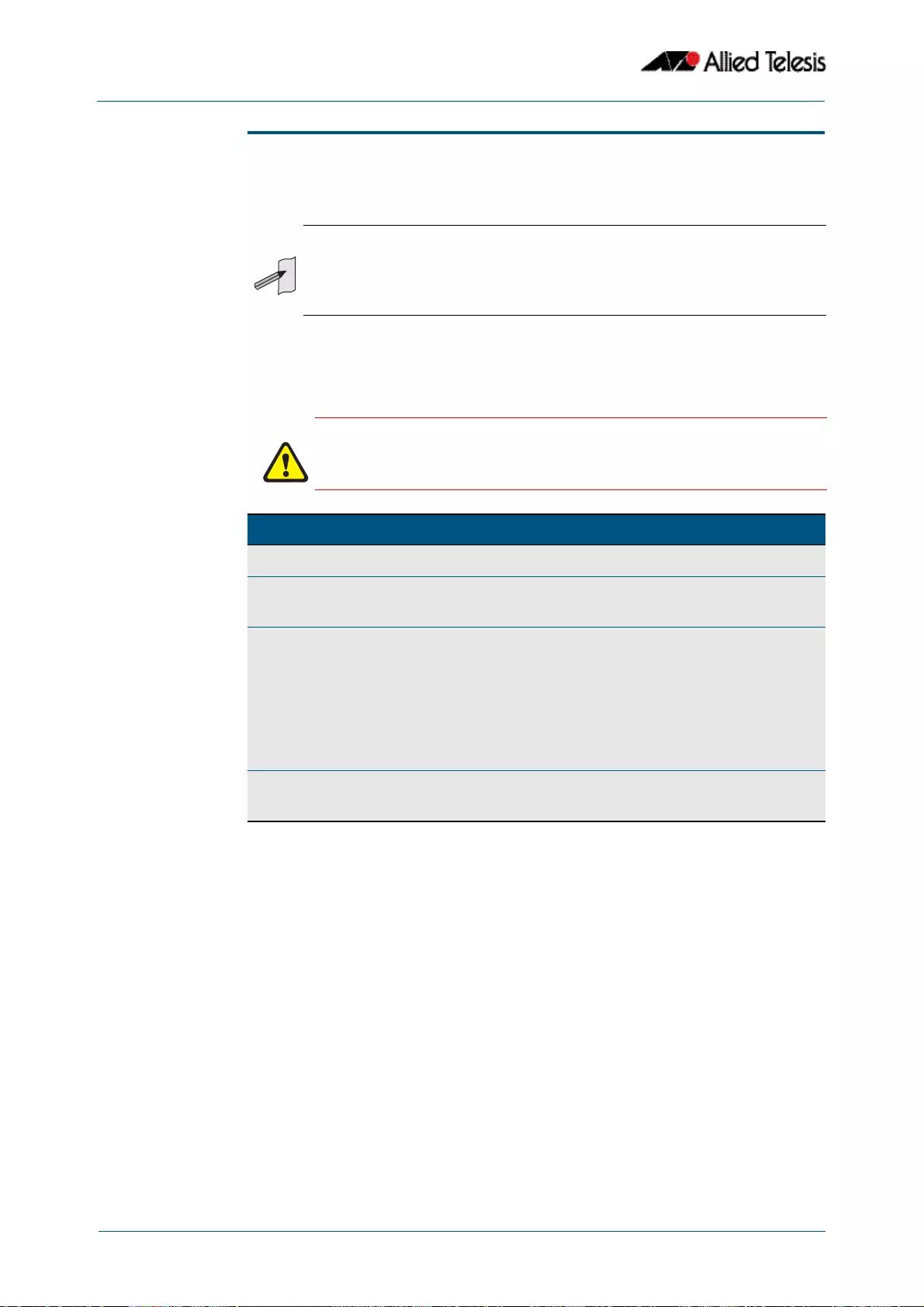
EPSR Commands
Software Reference for GS900MX/MPX Series Switches
58.4 AlliedWare PlusTM Operating System - Version 5.4.4E-1.x C613-50065-01 REV B
epsr
This command sets the timer values for an EPSR instance. These are only valid for master
nodes.
Syntax epsr <epsr-instance> {hellotime <1-32767>|failovertime <2-65535>
ringflaptime <0-65535>}
no epsr <epsr-instance>
Mode EPSR Configuration
Examples To set the hellotimer to 5 seconds for the EPSR instance called blue, use the command:
To delete the EPSR instance called blue, use the command:
Related Commands epsr mode master controlvlan primary port
epsr mode transit controlvlan
epsr configuration
epsr datavlan
epsr state
epsr trap
show epsr
Note This command will only run on switches that are capable of running as an EPSR
master node. However, even if your switch cannot function as an EPSR master
node; you will still need to configure this command on whatever switch is the
master within your EPSR network.
Refer to the manual of your master node’s switch.
Caution Using the “no” variant of this command will remove the specified EPSR
instance.
Parameter Description
<epsr-instance> Name of the EPSR instance.
hellotime <1-32767>The number of seconds between the transmission of
health check messages.
failovertime <2-65535>The number of seconds that a master waits for a
returning health check message before entering the
failed state. The failover time should be greater
than twice the hellotime. This is to force the master
node to wait until it detects the absence of two
sequential healthcheck messages before entering
the failed state.
ringflaptime <0-65535>The minimum number of seconds that a master must
remain in the failed state.
awplus(config-epsr)# epsr blue hellotime 5
awplus(config-epsr)# no epsr blue

EPSR Commands
Software Reference for GS900MX/MPX Series Switches
C613-50065-01 REV B AlliedWare PlusTM Operating System - Version 5.4.4E-1.x 58.5
epsr configuration
Use this command to enter EPSR Configuration mode so that EPSR can be configured.
Syntax epsr configuration
Mode Global Configuration
Example To change to EPSR mode, use the command:
Related Commands epsr mode master controlvlan primary port
epsr
show epsr
awplus(config)# epsr configuration

EPSR Commands
Software Reference for GS900MX/MPX Series Switches
58.6 AlliedWare PlusTM Operating System - Version 5.4.4E-1.x C613-50065-01 REV B
epsr datavlan
This command adds a data VLAN or a range of VLAN identifiers to a specified EPSR
instance.
The no variant of this command removes a data vlan or data vlan range from an EPSR
instance.
Syntax epsr <epsr-instance> datavlan {<vlanid>|<vlanid-range>}
no epsr <epsr-instance> datavlan {<vlanid>|<vlanid-range>}
Mode EPSR Configuration
Usage We suggest setting the epsr controlvlan to vlan2 using the epsr mode master
controlvlan primary port and epsr mode transit controlvlan commands, then setting
the EPSR data VLAN between to be a value 3 and 4094 using the epsr datavlan command.
Examples To add vlan3 to the EPSR instance called blue, use the command:
To add vlan2 and vlan3 to the EPSR instance called blue, use the command:
To remove vlan3 from the EPSR instance called blue, use the command:
To remove vlan2 and vlan3 from the EPSR instance called blue, use the command:
Related Commands epsr mode master controlvlan primary port
epsr mode transit controlvlan
show epsr
Parameter Description
<epsr-instance> Name of the EPSR instance.
datavlan Adds a data VLAN to be protected by the EPSR instance.
<vlanid>The VLAN’s VID - a number between 1 and 4094 excluding
the number selected for the control VLAN.
<vlanid-range>Specify a range of VLAN identifiers using a hyphen to
separate identifiers.
awplus(config-epsr)# epsr blue datavlan vlan3
awplus(config-epsr)# epsr blue datavlan vlan2-vlan3
awplus(config-epsr)# no epsr blue datavlan vlan3
awplus(config-epsr)# no epsr blue datavlan vlan2-vlan3

EPSR Commands
Software Reference for GS900MX/MPX Series Switches
C613-50065-01 REV B AlliedWare PlusTM Operating System - Version 5.4.4E-1.x 58.7
epsr enhancedrecovery enable
This command enables EPSR’s enhanced recovery mode. Enhanced recovery mode
enables a ring to apply additional recovery procedures when a ring with more than one
break, partially mends. For more information see “Managing Rings with Two Breaks” on
page 57.6.
The no variant of this command disables the enhancedrecovery mode.
Syntax epsr <epsr-instance> enhancedrecovery enable
no epsr <epsr-instance> enhancedrecovery enable
Default Default is enhancedrecovery mode disabled.
Mode EPSR Configuration
Example To apply enhanced recovery on the EPSR instance called blue, use the command:
Related Commands show epsr
Parameter Description
<epsr-instance> Name of the EPSR instance.
awplus(config-epsr)# epsr blue enhancedrecovery enable

EPSR Commands
Software Reference for GS900MX/MPX Series Switches
58.8 AlliedWare PlusTM Operating System - Version 5.4.4E-1.x C613-50065-01 REV B
epsr mode master controlvlan primary port
This command creates a master EPSR instance. Your switch is unable to run this command
because it cannot function as an EPSR master node. To include these switches in an EPSR
ring you will need to use an alternative Allied Telesis switch, such as an x610 Series switch,
as the master node. For more information on this command, refer to the manual of your
master EPSR node’s switch.
Syntax epsr <epsr-instance> mode master controlvlan <2-4094> primaryport
<port>
Mode EPSR Configuration
Example To create a master EPSR instance called blue with vlan2 as the control VLAN and
port1.0.1 as the primary port, use the command:
Related Commands epsr mode transit controlvlan
show epsr
Parameter Description
<epsr-
instance>
Name of the EPSR instance.
mode Determines the node is acting as a master.
master Sets switch to be the master node for the named EPSR ring.
controlvlan The VLAN that will transmit EPSR control frames.
<2-4094>VLAN id.
primaryport Primary port for the EPSR instance.
<port>The primary port. The port may be a switch port (e.g.
port1.0.4) or a static channel group (e.g. sa2). It cannot be a
dynamic (LACP) channel group.
awplus(config-epsr)# epsr blue mode master controlvlan vlan2
primaryport port1.0.1

EPSR Commands
Software Reference for GS900MX/MPX Series Switches
C613-50065-01 REV B AlliedWare PlusTM Operating System - Version 5.4.4E-1.x 58.9
epsr mode transit controlvlan
This command creates a transit EPSR instance.
Syntax epsr <epsr-instance> mode transit controlvlan <2-4094>
Mode EPSR Configuration
Example To create a transit EPSR instance called blue with vlan2 as the control VLAN, use the
command:
Related Commands epsr mode master controlvlan primary port
epsr mode transit controlvlan
show epsr
Parameter Description
<epsr-instance> Name of the EPSR instance.
mode Determines the node is acting as a transit node.
transit Sets switch to be the transit node for the named EPSR ring.
controlvlan The VLAN that will transmit EPSR control frames.
<2-4094>VLAN id.
Note The software allows you to configure more than two ports or static channel
groups to the control VLAN within a single switch or stacked node. However,
we advise against this because in certain situations it can produce
unpredictable results.
If the control VLAN contains more than two ports (or static channels) an
algorithm selects the two ports or channels with the lowest number to be the
ring ports. However if the switch has only one channel group is defined to the
control vlan, EPSR will not operate on the secondary port.
EPSR does not support Dynamic link aggregation (LACP).
awplus(config-epsr)# epsr blue mode transit controlvlan vlan2

EPSR Commands
Software Reference for GS900MX/MPX Series Switches
58.10 AlliedWare PlusTM Operating System - Version 5.4.4E-1.x C613-50065-01 REV B
epsr priority
This command sets the priority of an EPSR instance on an EPSR node. Priority is used to
prevent “superloops” forming under fault conditions with particular ring configurations.
Setting a node to have a priority greater than one, also has the effect of turning on
superloop protection.
The no variant of this command returns the priority of the EPSR instance back to its default
value of 0, which also disables EPSR Superloop prevention.
Syntax epsr <epsr-instance> priority <0-127>
no <epsr-instance> priority
Default The default priority of an EPSR instance on an EPSR node is 0. The negated form of this
command resets the priority of an EPSR instance on an EPSR node to the default value.
Mode EPSR Configuration
Example To set the priority of the EPSR instance called blue to the highest priority (127), use the
command:
To reset the priority of the EPSR instance called blue to the default (0), use the command:
Related Commands epsr configuration
Parameter Description
<epsr-instance> Name of the EPSR instance.
priority The priority of the ring instance selected by the epsr-name
parameter.
<0-127>The priority to be applied (0 is the lowest priority and
represents no superloop protection).
awplus(config-epsr)# epsr blue priority 127
awplus(config-epsr)# no epsr blue priority

EPSR Commands
Software Reference for GS900MX/MPX Series Switches
C613-50065-01 REV B AlliedWare PlusTM Operating System - Version 5.4.4E-1.x 58.11
epsr state
This command enables or disables an EPSR instance.
Syntax epsr <epsr-instance> state {enabled|disabled}
Mode EPSR Configuration
Example To enable the EPSR instance called blue, use the command:
Related Commands epsr mode master controlvlan primary port
epsr mode transit controlvlan
Parameter Description
<epsr-instance> The name of the EPSR instance.
state The operational state of the ring.
enabled EPSR instance is enabled.
disabled EPSR instance is disabled.
awplus(config-epsr)# epsr blue state enabled

EPSR Commands
Software Reference for GS900MX/MPX Series Switches
58.12 AlliedWare PlusTM Operating System - Version 5.4.4E-1.x C613-50065-01 REV B
epsr trap
This command enables SNMP traps for an EPSR instance. The traps will be sent when the
EPSR instance changes state.
The no variant of this command disables SNMP traps for an EPSR instance. The traps will
no longer be sent when the EPSR instance changes state.
Syntax epsr <epsr-instance> trap
no epsr <epsr-instance> trap
Mode EPSR Configuration
Example To enable traps for the EPSR instance called blue, use the command:
To disable traps for the EPSR instance called blue, use the command:
Related Commands epsr mode master controlvlan primary port
epsr mode transit controlvlan
show epsr
show debugging epsr
This command shows the debugging modes enabled for EPSR.
Syntax show debugging epsr
Mode User Exec and Privileged Exec
Example To show the enabled debugging modes, use the command:
Related Commands debug epsr
Parameter Description
<epsr-
instance>
Name of the EPSR instance.
trap SNMP trap for the EPSR instance.
awplus(config-epsr)# epsr blue trap
awplus(config-epsr)# no epsr blue trap
awplus# show debugging epsr

EPSR Commands
Software Reference for GS900MX/MPX Series Switches
C613-50065-01 REV B AlliedWare PlusTM Operating System - Version 5.4.4E-1.x 58.13
show epsr
This command displays information about all EPSR instances.
Syntax show epsr
Mode User Exec and Privileged Exec
Example To show the current settings of all EPSR instances, use the command:
Output The following examples show the output display for a non superloop topology network.
The following example shows the output display for superloop topology network.
awplus# show epsr
Figure 58-1: Example output from the show epsr command run on a transit node
EPSR Information
---------------------------------------------------------------
Name .......................... test2
Mode .......................... Transit
Status ........................ Enabled
State ......................... Links-Up
Control Vlan .................. 2
Data VLAN(s) .................. 10
Interface Mode ................ Ports Only
First Port .................... port1.0.1
First Port Status ............. Down
First Port Direction .......... Unknown
Second Port ................... port1.0.2
Second Port Status ............ Down
Second Port Direction ......... Unknown
Trap .......................... Enabled
Master Node ................... Unknown
Enhanced Recovery ............. Disabled
---------------------------------------------------------------

EPSR Commands
Software Reference for GS900MX/MPX Series Switches
58.14 AlliedWare PlusTM Operating System - Version 5.4.4E-1.x C613-50065-01 REV B
Figure 58-2: Example output from the show epsr command run on a Transit Node
EPSR Information
---------------------------------------------------------------
Name .......................... test4
Mode .......................... Transit
Status ........................ Enabled
State ......................... Complete
Control Vlan .................. 4
Data VLAN(s) .................. 20
Interface Mode ................ Ports Only
Primary Port .................. port1.0.3
Status ...................... Forwarding (logically blocking)
Is On Common Segment ........ No
Blocking Control ............ Physical
Secondary Port ................ port1.0.4
Status ...................... Blocked
Is On Common Segment ........ No
Blocking Control ............ Physical
Hello Time .................... 1 s
Failover Time ................. 2 s
Ring Flap Time ................ 0 s
Trap .......................... Enabled
Enhanced Recovery ............. Disabled
SLP Priority .................. 12
---------------------------------------------------------------
Table 58-1: Parameters displayed in the output of the show epsr command
Parameter on
Master Node
Parameter on
Transit Node Description
Name Name The name of the EPSR instance.
Mode Mode The mode in which the EPSR instance is configured - either Master or
Transit
Status Status Indicates whether the EPSR instance is enabled or disabled
State State Indicates state of the EPSR instance's state machine. Master states are:
Idle, Complete, and Failed. Transit states are Links-Up, Links-Down,
and Pre-Forwarding.
Control Vlan Control Vlan Displays the VID of the EPSR instance's control VLAN.
Data VLAN(s) Data VLAN(s) The VID(s) of the instance's data VLANs.
Interface
Mode
Interface
Mode
Whether the EPSR instance's ring ports are both physical ports (Ports
Only) or are both static aggregators (Channel Groups Only).
Primary Port First Port The EPSR instance's primary ring port.
- Status - Status Whether the ring port is forwarding (Forwarding) or blocking
(Blocked), or has link down (Down), and if forwarding or blocking,
“(logical)” indicates the instance has only logically set the blocking
state of the port because it does not have physical control of it.
- Direction The ring port on which the last EPSR control packet was received is
indicated by “Upstream”. The other ring port is then “Downstream”
- Is On
Common
Segment
- Is On
Common
Segment
Whether the ring port is on a shared common segment link to another
node, and if so, “(highest rank)” indicates it is the highest priority
instance on that common segment.

EPSR Commands
Software Reference for GS900MX/MPX Series Switches
C613-50065-01 REV B AlliedWare PlusTM Operating System - Version 5.4.4E-1.x 58.15
Related Commands epsr mode master controlvlan primary port
epsr mode transit controlvlan
show epsr counters
- Blocking
Control
- Blocking
Control
Whether the instance has “physical” or “logical” control of the ring
port's blocking in the instance's data VLANs.
Secondary
Port
Second Port The EPSR instance's secondary port.
- Status - Status Whether the ring port is forwarding (Forwarding) or blocking
(Blocked), or has link down (Down), and if forwarding or blocking,
“(logical)” indicates the instance has only logically set the blocking
state of the port, because it does not have physical control of it. Note
that on a master configured for SuperLoop Prevention (non-zero
priority) its secondary ring port can be physically forwarding, but
logically blocking. This situation arises when it is not the highest
priority node in the topology (and so does not receive LINKS-DOWN
messages upon common segment breaks) and a break on a common
segment in its ring is preventing reception of its own health
messages.
- Direction The ring port on which the last EPSR control packet was received is
indicated by “Upstream”. The other ring port is then “Downstream”
- Is On
Common
Segment
- Is On
Common
Segment
Whether the ring port is on a shared common segment link to another
node, and if so, “(highest rank)” indicates it is the highest priority
instance on that common segment
- Blocking
Control
- Blocking
Control
Whether the instance has “physical” or “logical” control of the ring
port's blocking in the instance's data VLANs
Hello Time The EPSR instance's setting for the interval between transmissions of
health check messages (in seconds)
Failover
Time
The time (in seconds) the EPSR instance waits to receive a health
check message before it decides the ring is down
Ring Flap
Time
The minimum time the EPSR instance must remain in the failed state
Trap Trap Whether the EPSR instance has EPSR SNMP traps enabled
Enhanced
Recovery
Enhanced
Recovery
Whether the EPSR instance has enhanced recovery mode enabled
SLP Priority SLP Priority The EPSR instance's priority (for SuperLoop Prevention)
Table 58-1: Parameters displayed in the output of the show epsr command (cont.)
Parameter on
Master
Parameter on
Transit Description(cont.)

EPSR Commands
Software Reference for GS900MX/MPX Series Switches
58.16 AlliedWare PlusTM Operating System - Version 5.4.4E-1.x C613-50065-01 REV B
show epsr common segments
This command displays information about all the superloop common segment ports on
the switch
Syntax show epsr common segments
Example To display information about all the superloop common segment ports on the switch, use
the command:
Related Commands show epsr
show epsr summary
show epsr counters
awplus# show epsr common segments
Figure 58-3: Example output from the show epsr common segments command
EPSR Common Segments
Common Seg EPSR Port Phys Ctrl Ring
Ring Port Instance Mode Prio Type of Port? Port Status
--------------------------------------------------------------------------------
port1.0.24 test_inst_Red Transit 127 Second Yes Fwding
test_inst_Blue Transit 126 Second No Fwding (logical)
test_inst_Green Transit 125 First No Fwding (logical)
sa4 testA Master 15 Primary Yes Blocking
testB Transit 14 Second No Fwding (logical)
sa5 test_55 Transit 8 First Yes Down
test_77 Transit 7 First No Down
--------------------------------------------------------------------------------

EPSR Commands
Software Reference for GS900MX/MPX Series Switches
C613-50065-01 REV B AlliedWare PlusTM Operating System - Version 5.4.4E-1.x 58.17
show epsr config-check
This command checks the configuration of a specified EPSR instance, or all EPSR instances.
If an instance is enabled, this command will check for the following errors or warnings:
■The control VLAN has the wrong number of ports.
■There are no data VLANs.
■Some of the data VLANs are not assigned to the ring ports.
■The failover time is less than 5 seconds, for a stacked device.
■The instance is a master that shares a common segment with a higher priority
instance.
■The instance is a master that shares a common segment with another master.
■The instance is a master with its secondary port on a common segment.
Syntax show epsr [<instance>] config-check
Mode User Exec and Privileged Exec
Example To check the configuration of all EPSR instances and display the results, use the command:
Related Commands show epsr
Parameter Description
<instance>Name of the EPSR instance to check on.
awplus# show epsr config-check
Figure 58-4: Example output from the show epsr config-check command
EPSR Status Description
Instance
--------------------------------------------------------------------------------
red Warning Failover time is 2s but should be 5s because device.
is stacked
white OK.
blue Warning Primary port is not in data VLANs 29-99.
orange OK.
Don't forget to check that this node's configuration is consistant with all
other nodes in the ring.
--------------------------------------------------------------------------------

EPSR Commands
Software Reference for GS900MX/MPX Series Switches
58.18 AlliedWare PlusTM Operating System - Version 5.4.4E-1.x C613-50065-01 REV B
show epsr <epsr-instance>
This command displays information about the specified EPSR instance.
Syntax show epsr <epsr-instance>
Mode User Exec and Privileged Exec
Example To show the current settings of the EPSR instance called blue, use the command:
Related Commands epsr mode master controlvlan primary port
epsr mode transit controlvlan
show epsr counters
show epsr <epsr-instance> counters
This command displays counter information about the specified EPSR instance.
Syntax show epsr <epsr-instance> counters
Mode User Exec and Privileged Exec
Example To show the counters of the EPSR instance called blue, use the command:
Related Commands epsr mode master controlvlan primary port
epsr mode transit controlvlan
show epsr
Parameter Description
<epsr-instance> Name of the EPSR instance.
awplus# show epsr blue
Parameter Description
<epsr-instance>Name of the EPSR instance.
awplus# show epsr blue counters

EPSR Commands
Software Reference for GS900MX/MPX Series Switches
C613-50065-01 REV B AlliedWare PlusTM Operating System - Version 5.4.4E-1.x 58.19
show epsr counters
This command displays counter information about all EPSR instances.
Syntax show epsr counters
Mode User Exec and Privileged Exec
Example To show the counters of all EPSR instances, use the command:
Related Commands epsr mode master controlvlan primary port
epsr mode transit controlvlan
show epsr
awplus# show epsr counters

EPSR Commands
Software Reference for GS900MX/MPX Series Switches
58.20 AlliedWare PlusTM Operating System - Version 5.4.4E-1.x C613-50065-01 REV B
show epsr summary
This command displays summary information about all EPSR instances on the switch
Syntax show epsr summary
Mode User Exec and Privileged Exec
Example To display epsr summary information, use the command:
Example To display EPSR summary information, use the command:
undebug epsr
This command applies the functionality of the no debug epsr command on page 58.3.
awplus# show epsr summary
awplus# show epsr summary
Figure 58-5: Example output from the show epsr summary command
EPSR Summary Information
Abbreviations:
M = Master node
T = Transit node
C = is on a common segment with other instances
P = instance on a common segment has physical control of the shared port's
data VLAN blocking
LB = ring port is Logically Blocking - applicable to master only
EPSR Ctrl Primary/1st Secondary/2nd
Instance Mode Status State VLAN Prio Port Status Port Status
--------------------------------------------------------------------------------
test-12345 T Enabled Links-Down 6 127 Blocking (C,P) Blocking (C,P)
test1 M Enabled Complete 5 12 Fwding Fwding (LB)
test2 T Enabled Pre-Fwding 4 126 Fwding (C) Blocking (C)
localB T Disabled Idle 40 0 Unknown Unknown
localC T Disabled Idle 41 0 Unknown Unknown
--------------------------------------------------------------------------------

Software Reference for GS900MX/MPX Series Switches
C613-50065-01 REV B AlliedWare PlusTM Operating System - Version 5.4.4E-1.x 59.1
Chapter 59: RRP Snooping Introduction and
Commands
RRP Snooping Introduction........................................................................................................... 59.2
Command List .................................................................................................................................... 59.3
ip rrp snooping .................................................................................................................................. 59.3
show ip rrp snooping....................................................................................................................... 59.4

RRP Snooping Introduction and Commands
Software Reference for GS900MX/MPX Series Switches
59.2 AlliedWare PlusTM Operating System - Version 5.4.4E-1.x C613-50065-01 REV B
RRP Snooping Introduction
This chapter describes the Router Redundancy Protocol (RRP) Snooping feature provided
by the switch. For detailed RRP command descriptions, examples and output, see
“Command List” on page 59.3.
The Router Redundancy Protocol (RRP) allows multiple routers to share the same virtual IP
address and MAC address. In network topologies where redundant router paths or links
exist, the protocol enables routers, through an election process, to designate one as the
master router. This router functions as the provider of the primary path between LAN
segments. Backup routers function as backup paths in the event that the master router or
primary path fails.
Because the master and backup routers are able to share the same virtual IP address and
MAC address, a change in data paths need not necessitate an adjustment to the default
gateways on the network nodes that employ the routers. When a backup router
transitions to master, it uses the same IP address as the previous master router, making the
transition transparent to the network end nodes. In large networks, these transparent
transitions can save the time and effort of having to manually reconfigure default gateway
addresses on large numbers of network nodes when a router pathway fails.
RRP snooping on the switch facilitates the transition to a new master router by minimizing
the loss of traffic, and so reduces the impact the transition could have on your network
traffic.
RRP snooping monitors ingress RRP packets, determined by their source MAC address. The
switch looks for packets with a source MAC address of 00:E0:2B:00:00:80-9F (ESRP).
A port receiving an RRP packet is deemed by the switch as the master RRP port. The virtual
MAC address of the router is entered as a dynamic address on the port. If the switch starts
to receive RRP packets on another port, it assumes that a backup router has made the
transition to the role of the new master router.
The switch responds by deleting all dynamic MAC addresses from the MAC address table.
As the switch relearns the addresses, the virtual MAC address of the new master router is
learned on the new master RRP port, rather than the old port. Any packets received by the
switch and destined for the router are forwarded to the new master router.
You cannot use RRP Snooping at the same time as the following features:
■STP, RSTP, or MSTP, except for edge ports. RSTP is enabled by default. To disable it, use
the command “no spanning-tree {mstp|rstp|stp} enable” on page 19.40.
■Port security (the command switchport port-security)
■Port authentication
■EPSR
■Port mirroring
Commands Used ip rrp snooping
show ip rrp snooping

RRP Snooping Introduction and Commands
Software Reference for GS900MX/MPX Series Switches
C613-50065-01 REV B AlliedWare PlusTM Operating System - Version 5.4.4E-1.x 59.3
Command List
This section provides an alphabetical reference for commands used to configure the
Router Redundancy Protocol (RRP).
ip rrp snooping
Use this command to enable RRP snooping.
Use the no variant of this command to disable RRP Snooping.
Syntax ip rrp snooping
no ip rrp snooping
Default The default is disabled.
Mode Global Configuration
Usage Use this command to enable the RRP Snooping feature. You cannot use RRP Snooping at
the same time as the following features:
■STP, RSTP, or MSTP, except for edge ports. RSTP is enabled by default. To disable it, use
the command “no spanning-tree {mstp|rstp|stp} enable” on page 19.40.
■Port security (the command switchport port-security)
■Port authentication
■EPSR
■Port mirroring
Examples The example below shows you how to enable RRP Snooping.
Related Commands show ip rrp snooping
awplus# configure terminal
awplus(config)# ip rrp snooping

RRP Snooping Introduction and Commands
Software Reference for GS900MX/MPX Series Switches
59.4 AlliedWare PlusTM Operating System - Version 5.4.4E-1.x C613-50065-01 REV B
show ip rrp snooping
Use this command to display Router Redundancy Protocol snooping global settings and
status.
Syntax show ip rrp snooping
Mode Privileged Exec
Output The following example show the output display for the show ip rrp snooping command
The following table shows the output display for the show ip rrp snooping command
Related Commands ip rrp snooping
awplus#show ip rrp snooping
Status : Enabled
Vlan Master Virtual MAC Address UpTime
------------ ---------- ----------------------- ----------------
vlan1 Port1.0.1 00e0.2b00.0085 00:00:39
----------------------------------------------------------------
Parameter Description
Status Displays if RRP Snooping is enabled or disabled
Vlan Displays the VLAN ID
Master Displays the port ID connected to the master router or the network of
the master router
Virtual MAC
Address
Displays the virtual MAC address of the router
UpTime Displays the time that the current master router has been the master
router

Part 7: Network Management
■Chapter 60 AMF Introduction and Configuration
■Chapter 61 AMF Commands
■Chapter 62 NTP Introduction and Configuration
■Chapter 63 NTP Commands
■Chapter 64 Dynamic Host Configuration Protocol (DHCP)
Introduction
■Chapter 65 Dynamic Host Configuration Protocol (DHCP)
Commands
■Chapter 66 SNMP Introduction
■Chapter 67 SNMP Commands
■Chapter 68 SNMP MIBs
■Chapter 69 LLDP, LLDP-MED and Voice VLAN Introduction
and Configuration
■Chapter 70 LLDP Commands
■Chapter 71 SMTP Commands
■Chapter 72 RMON Introduction and Configuration
■Chapter 73 RMON Commands
■Chapter 74 Triggers Introduction
■Chapter 75 Triggers Configuration
■Chapter 76 Trigger Commands
■Chapter 77 Cable Fault Locator Introduction
■Chapter 78 Cable Fault Locator Commands

Software Reference for GS900MX/MPX Series Switches
C613-50065-01 REV B AlliedWare PlusTM Operating System - Version 5.4.4E-1.x 60.1
Chapter 60: AMF Introduction and
Configuration
Introduction to AMF......................................................................................................................... 60.2
AMF on GS900MX/MPX Series Switches: AMF Edge ............................................................ 60.2
AMF Supported Products and Software Versions ................................................................. 60.2
Key Benefits of AMF.......................................................................................................................... 60.4
Unified Command-Line ........................................................................................................... 60.4
Configuration Backup and Recovery .................................................................................. 60.4
Rolling-Reboot Upgrade ......................................................................................................... 60.4
Node Provisioning..................................................................................................................... 60.5
AMF Terminology and Introduction........................................................................................... 60.6
AMF Network............................................................................................................................... 60.6
AMF Nodes ................................................................................................................................... 60.6
Node Licensing ........................................................................................................................... 60.6
Node Interconnection.............................................................................................................. 60.7
AMF Domains .............................................................................................................................. 60.7
AMF Network Operational Concepts ......................................................................................... 60.9
Retention and Use of the ‘Manager’ Username.............................................................. 60.9
Working-Set ................................................................................................................................. 60.9
AMF Restricted Login .............................................................................................................60.10
Loop-Free Data Plane.............................................................................................................60.10
Aggregators ...............................................................................................................................60.10
VCStacks ......................................................................................................................................60.10
AMF External Removable Media ........................................................................................60.10
AMF Interaction with QoS and ACLs.................................................................................60.11
NTP and AMF.............................................................................................................................60.11
Configuring AMF .............................................................................................................................60.13
Verifying the AMF Network .........................................................................................................60.19
Configuring Multiple Nodes at the Same Time: the Unified CLI ....................................60.21
Working-Set Groups................................................................................................................60.22
Executing Commands on Working-Sets..........................................................................60.23
Interactive Commands...........................................................................................................60.26
AMF Backups.....................................................................................................................................60.27
Using External Media Storage.............................................................................................60.27
Performing a Manual Backup ..............................................................................................60.28
Backing up to Remote Servers ............................................................................................60.29
Node Recovery.................................................................................................................................60.31
Automatic Node Recovery....................................................................................................60.31
Restoring a Node to a “Clean” State..................................................................................60.32
Manual Node Recovery..........................................................................................................60.33
Node Recovery on VCStacks ................................................................................................60.34
AMF Safe Configuration................................................................................................................60.35
Detecting AMF Safe Configuration Operation..............................................................60.35
AMF Safe Configuration Procedures.................................................................................60.35
Undoing an AMF Safe Configuration................................................................................60.36
Rolling-Reboot Firmware Upgrade...........................................................................................60.38
Performing a Rolling-Reboot Upgrade ............................................................................60.40
Node Provisioning ..........................................................................................................................60.42

AMF Introduction and Configuration
Software Reference for GS900MX/MPX Series Switches
60.2 AlliedWare PlusTM Operating System - Version 5.4.4E-1.x C613-50065-01 REV B
Introduction to AMF
The Allied Telesis Management Framework (AMF) is a suite of features that combine to
simplify network management across all supported network switches from the core to the
edge.
AMF also provides simplified switch recovery and firmware upgrade management. The
primary function of AMF is to reduce the management and maintenance overhead on a
network, while improving on responsiveness and handling of switch failures within the
network.
This chapter provides a conceptual introduction to AMF together with its benefits,
together with configuration guidelines showing how to use AMF in practical networks. For
more information on the commands used in this chapter, see “AMF Commands” on
page 61.1.
AMF on GS900MX/MPX Series Switches:
AMF Edge
The GS900MX/MPX Series are edge switches, and can only join the edge of an AMF
network.
GS900MX/MPX switches cannot act as AMF master nodes.
Each GS900MX/MPX switch can only have a single link to the rest of the AMF network,
which must be an uplink to a switch that is closer to the AMF master. They cannot act as
intermediate nodes, and they cannot link to other nodes at the same level of the heirarchy
as themselves.
This functionality is known as “AMF Edge”.
AMF Supported Products and Software
Versions
The following list shows which Allied Telesis switches are capable of running AMF and
indicates those capable of operating as Master Nodes.
An AMF-Master feature license is required for each AMF master node in the AMF network.
Table 60-1: AMF Nodal Capability by Switch Type
Switch Type AMF Nodal Capability
SwitchBlade™ x8100 master or member
SwitchBlade™ x908 master or member
x930 series switches master or member
x900 series switches member only
x610 series switches member only

AMF Introduction and Configuration
Software Reference for GS900MX/MPX Series Switches
C613-50065-01 REV B AlliedWare PlusTM Operating System - Version 5.4.4E-1.x 60.3
x510 series switches member only
IX5-28GPX switches member only
x310 series switches member only
x230 series switches member only
x210 series switches member only
DC2552XS/L3 switches member only
GS900MX/MPX switches AMF edge member only
Switch Type AMF Nodal Capability

AMF Introduction and Configuration
Software Reference for GS900MX/MPX Series Switches
60.4 AlliedWare PlusTM Operating System - Version 5.4.4E-1.x C613-50065-01 REV B
Key Benefits of AMF
The key benefits of AMF include its unified command-line, simple configuration backup
and recovery process, and time-saving rolling firmware upgrade.
Unified Command-Line
The conventional means of configuring and controlling AlliedWare Plus (AW+) switches is
to use their text-based command-line interface (CLI). In existing networks, the CLI is
available via a serial console port and also to remote login sessions such as SSH.
AMF extends this capability from managing either a single switch to managing a whole
network by using a single (unified) CLI session. Using the unified CLI, a network
administrator can nominate all nodes or a subset of nodes within the AMF network to
comprise an entity known as a “working-set”. Commands can then be executed
concurrently across all switching nodes within the defined working-set as if they were a
single unit. Any existing configuration or diagnostic actions can thus be applied to
multiple devices using a single command sequence, thus reducing maintenance costs and
configuration complexity, while still retaining complete flexibility in network design and
control.
Multiple AMF networks can exist side by side across a single physical network. Note that
AMF treats a Virtual Chassis Stack (VCStack) as a single node.
Configuration Backup and Recovery
The master nodes use external storage to automatically backup the complete
configuration information for all their member nodes, including boot configuration,
firmware, licenses, and user scripts.
If an AMF member node should fail, the AMF process will automatically recognize and
reconfigure an unconfigured replacement (standby) unit, completely recreating the
stored configuration of the failed unit into the replacement unit. The new unit will then
reboot and resume service, without any need for user intervention beyond physical
hardware replacement and cable connection. In this way AMF provides a complete zero-
touch recovery solution. For more information, see “AMF Backups” on page 60.27.
Rolling-Reboot Upgrade
Installing Firmware upgrades on a production network is typically an infrequent but
sensitive and labor-intensive process. AMF is able to roll-out upgrades to a user-selected
subset of nodes. All that needs to be entered is the target group of nodes, and the location
where the new firmware is stored; AMF will then take care of the rest. Nodes are upgraded
in a serial fashion, with each node tested before continuing the upgrade on the next node.
If an upgrade fails on a particular node, the upgrade process is automatically terminated
and that node will revert to its previous firmware version. In this way firmware updates are
almost completely hands-free, whilst also providing confidence that a bad update will not
result in loss of service. For more information, see “Performing a Rolling-Reboot
Upgrade” on page 60.40.

AMF Introduction and Configuration
Software Reference for GS900MX/MPX Series Switches
C613-50065-01 REV B AlliedWare PlusTM Operating System - Version 5.4.4E-1.x 60.5
Node Provisioning
It is generally undesirable to have unconfigured devices connected to the network. Node
provisioning enables you to preconfigure a port ready to accept and automatically
configure a “clean” (as new) device for connection at a later date. This is achieved by
storing the future node's configuration in the master node's backup files ready to be
loaded to the new device when connected.

AMF Introduction and Configuration
Software Reference for GS900MX/MPX Series Switches
60.6 AlliedWare PlusTM Operating System - Version 5.4.4E-1.x C613-50065-01 REV B
AMF Terminology and Introduction
This section contains a glossary of terminology used to describe AMF networking.
AMF Network
Conceptually an AMF network is a collection of interconnected network switch nodes. This
interconnection in turn comprises a hierarchy of network domains. These terms are
explained in more detail later in this chapter.
Network name Because networks are able to interconnect, an AMF network name is necessary to identify
the AMF network to which any given node belongs. It follows therefore, that all nodes
within a single AMF network must be configured with the same AMF network name.
AMF Nodes
Two types of nodes exist within an AMF network, Master Nodes and Member Nodes.
Either type can comprise either a single switch, or a VCStack.
Master Nodes Master nodes are user defined by configuration. They then form the core domain of the
AMF network. Aspects of master node functionality include:
■performing file system backups of all nodes in the AMF network.
■providing an essential component for the formation of an AMF network. That is, an
AMF network cannot exist without the existence of at least one master node.
■at least one master node must be present for an AMF network to exist.
When more than one AMF master node exists in an AMF network, their operation is
completely independent and unsynchronized.
Member Nodes AMF member nodes are referred to simply as nodes.
Node Licensing
Master node
License
AMF master nodes are supported on selected switch platforms: an AMF license is required
for each master. For a list of node capability against specific switch types, see Table 60-1
on page 60.2
A VCStack needs to have consistent licensing on all stack members. If an AT-SBx8100 with
dual CFCs is configured as an AMF master a license is only required on the CFC master, as the license
with be synchronized across CFCs. If an AT-SBx908 or AT-x930 Series switch is configured as an AMF
master, a license is required to be installed on all stack members.
When more than one AMF master node exists in an AMF network, it is important to know
that these operate completely independently of each other, and there is no
synchronization between AMF master nodes.
For redundancy, an AMF network can have multiple master nodes, each acting as a master
for the network. However, there is no synchronization of status or data files between the
masters. The behavior of a master node is not changed at all by the presence of other
master nodes.
Core distance This is the distance (hop count) between a particular domain and its Core domain. The
Core domain has a Core distance of 0, and the maximum recommended Core distance in
an AMF network is 8.

AMF Introduction and Configuration
Software Reference for GS900MX/MPX Series Switches
C613-50065-01 REV B AlliedWare PlusTM Operating System - Version 5.4.4E-1.x 60.7
Node Interconnection
In general, AMF nodes can connect either horizontally using crosslinks, or vertically using
Uplinks/Downlinks. However, GS900MX/MPX Series switches only support uplinks,
because they are edge switches, and can only join the edge of an AMF network.
The different link types are shown in the illustration below:
Figure 60-1: AMF Uplinks, Downlinks, and Crosslinks
AMF links, of either type, are used to pass AMF management traffic between nodes;
however, they can also carry other network traffic. Configuring an interface as an AMF-link
will automatically put the port into trunk mode. An AMF link can be either a single link or a
static aggregator. For more information on trunk mode see “Configuring VLANs” on
page 16.3.
Crosslinks AMF crosslinks are used to connect AMF nodes to other AMF nodes within what is termed
an AMF Domain. Configuring an interface as an AMF-crosslink will automatically put its
port into trunk mode. A crosslink can be either a single link or a static aggregator.
AMF master nodes must be connected using AMF crosslinks to ensure they are part of the
uppermost domain level.
Up/Down Links Uplinks/Downlinks interconnect domains in what is a vertical hierarchy, the highest
domain being the core domain.
AMF Domains
Every AMF node belongs to an AMF domain. Domains can comprise of a single node or
multiple nodes. AMF master nodes are included in highest domain level, sometimes called
the core domain, and all other domains are rooted in this domain.
As previously mentioned, AMF domains are determined by AMF crosslinks, (see
“Working-Set” on page 60.9). All nodes connected via AMF crosslinks form part of the
same domain, and nodes connected via regular AMF links will be part of either higher of
lower level domains.
AMF link (Downlink)
AMF
Member node
AMF crosslink
AMF link (Uplink)
Core Domain
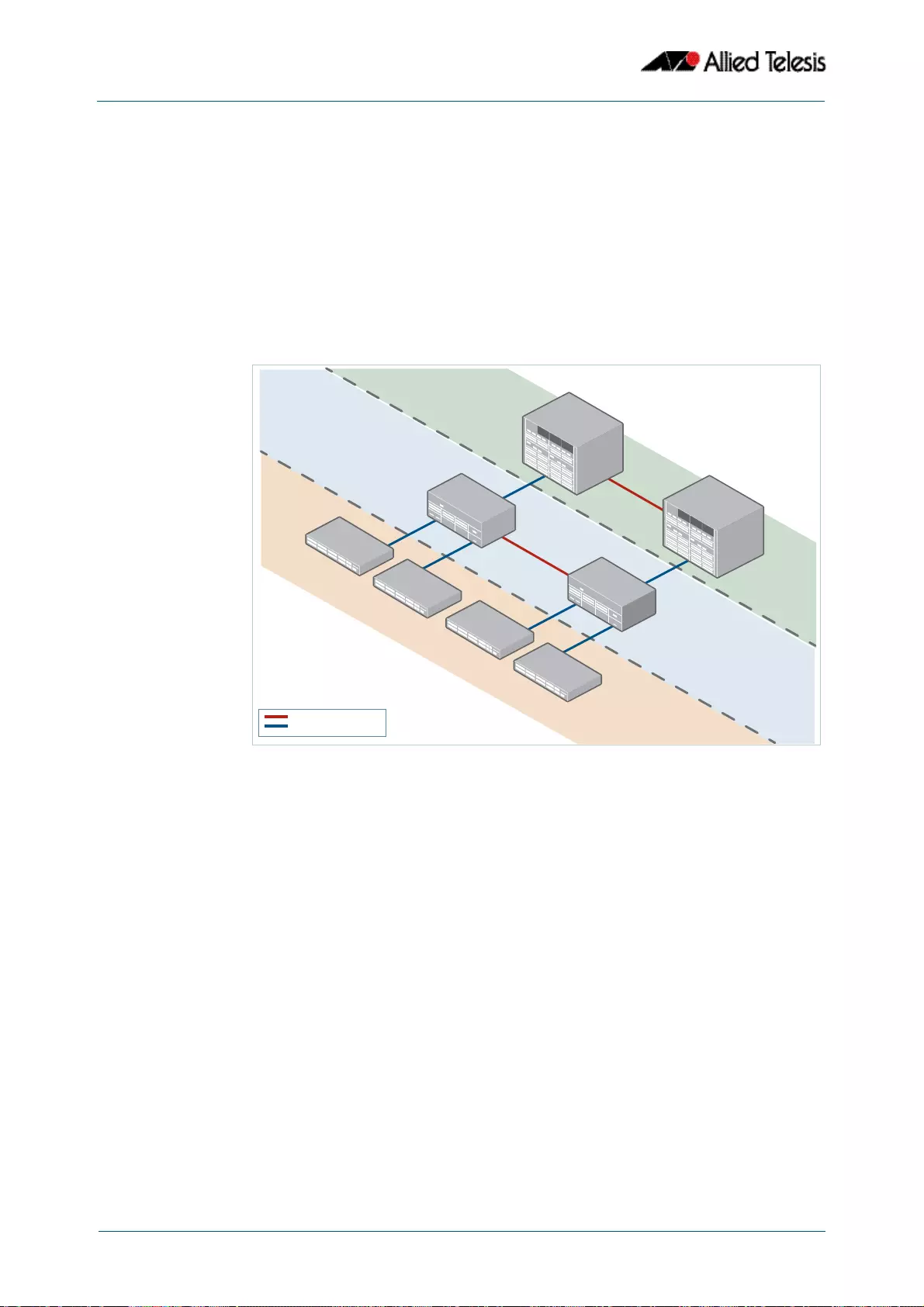
AMF Introduction and Configuration
Software Reference for GS900MX/MPX Series Switches
60.8 AlliedWare PlusTM Operating System - Version 5.4.4E-1.x C613-50065-01 REV B
Nodes within a domain must be connected in either a chain or ring topology. This means
that a maximum of two crosslinks should be configured on any single node. The
advantage of an AMF domain is that two links from a domain to a single higher level
domain will provide redundant AMF links. We recommend that an AMF domain should
only be connected to a single higher level domain, though it may be connected to
multiple lower level domains. We also recommend that you set a maximum number of 12
nodes per domain.
Hop-Count The vertical distance of a domain from the core domain is known as its Hop-Count. The
illustration“Core distance hop-counts between domains” on page 60.8 shows the
relationship between nodes, domains and core distance (hop-count).
Figure 60-2: Core distance hop-counts between domains
Node provisioning Node provisioning enables you to configure a node before it is physically present in the
AMF network. When the node is eventually connected to an expectant port, it will
automatically set itself up with the previously stored configuration files and release.
AMF
Member node
AMF
Member node
AMF
Member node
AMF
Member node
AMF
Member node
AMF
Member node
Node ID2
AMF crosslink
AMF link
Node ID3
Node ID4
Node ID5
Node ID6
Node ID7
Node ID8
Node ID1
CORE DISTANCE 1
CORE DISTANCE 0
CORE DISTANCE 2
AMF
Master node
AMF
Master node
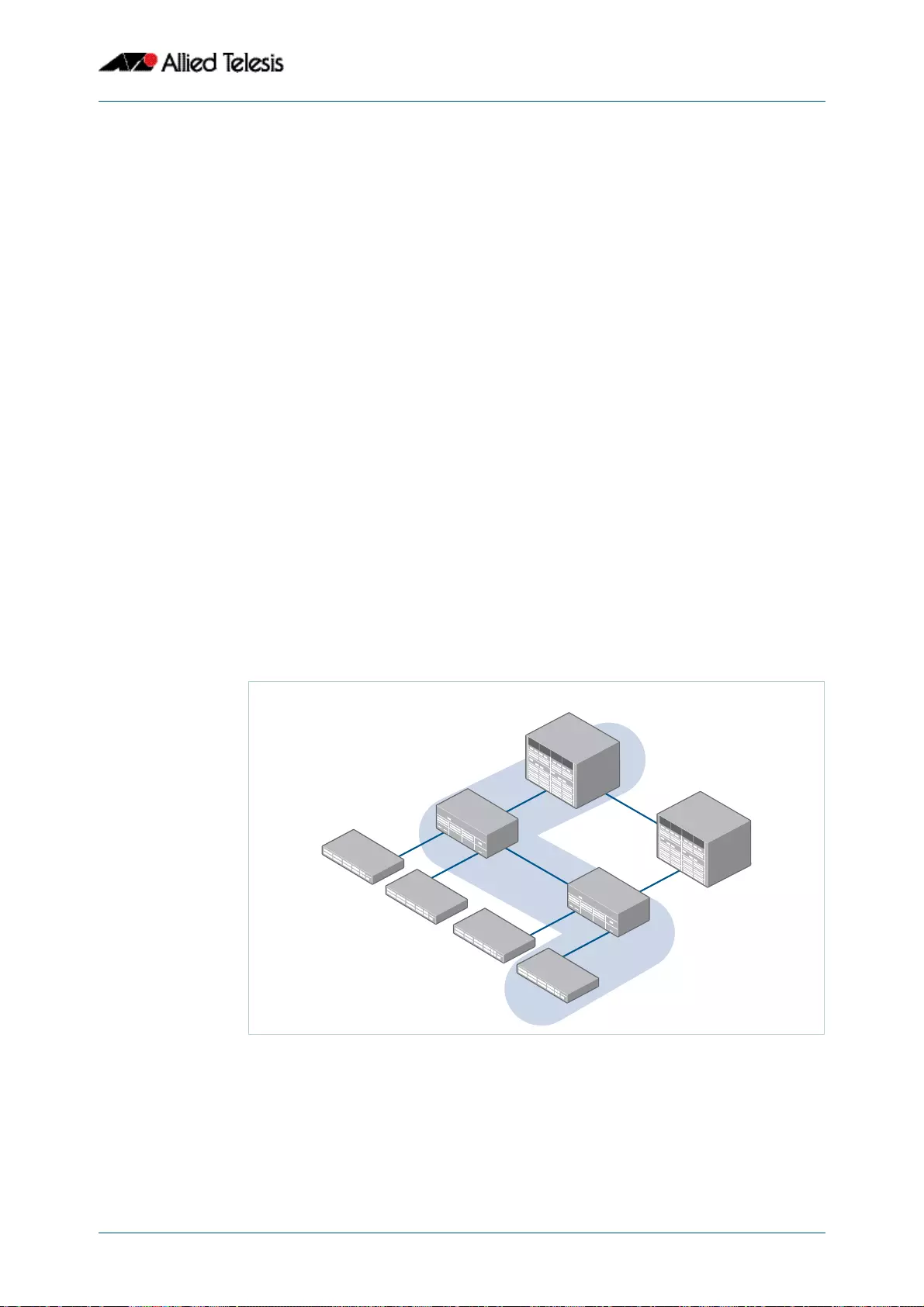
AMF Introduction and Configuration
Software Reference for GS900MX/MPX Series Switches
C613-50065-01 REV B AlliedWare PlusTM Operating System - Version 5.4.4E-1.x 60.9
AMF Network Operational Concepts
Retention and Use of the ‘Manager’ Username
The default username for an AlliedWare Plus login is “manager”, with a documented
default password. Users should change this password on all their nodes to provide login
security.
It is possible to add new usernames and passwords to nodes, but to retain the ability to
centrally manage the network, usernames should be uniformly configured across all AMF
nodes within the AMF network.
Note that managing a network with AMF is incompatible with user authentication via
RADIUS or TACACS+. Use the normal local database for user authentication.
Working-Set
Conceptually a working set is a collection of switches that can then be configured
centrally as if there were a single device. A working set may comprise a pre-defined group
that has been automatically created based on some common set of physical attributes
such as switch type etc, or it may be created by a network user for ease of configuration.
Specifying or selecting a working-set allows CLI commands to be executed on all nodes
within the selected working-set with a single command. A working-set can be defined,
selected and configured from any node within an AMF network. The illustration“AMF
working-set” on page 60.9 shows a number of switches which comprise a working set.
Figure 60-3: AMF working-set
Master 1
Member 1
AMF
working-set
Master 2
Member 2
Member 6
Member 5
Member 4
Member 3
AMF Network

AMF Introduction and Configuration
Software Reference for GS900MX/MPX Series Switches
60.10 AlliedWare PlusTM Operating System - Version 5.4.4E-1.x C613-50065-01 REV B
AMF Restricted Login
By default, a user logged into any node on an AMF network is able to manage any other
node by using either working-sets or AMF remote login (provided the login username
exists on all nodes). Where the access provided by this feature is too wide, or contravenes
network security restrictions, this access can be limited by running the command “atmf
restricted-login” on page 61.47. This command will not be saved in the running
configuration; it is a network property that can be enabled or disabled from any AMF
master. The status of restricted-login will be retained over a reboot.
When restricted login is enable on the network, only the AMF Master nodes are able to
create working-sets or manage other devices via AMF remote-logins. Other nodes may
remote login to the AMF Master, but they will require password authentication on that
master, and will then be able to create working-sets originating from the Master.
Note that once you have run this command, certain other commands that utilize the AMF
working-set command, such as the include, atmf reboot-rolling and show atmf group
members commands, will operate only on master nodes.
Loop-Free Data Plane
The current version of AMF does not control the data plane, so it is a requirement that the
network is configured such that the data plane (i.e. the paths defined by the data VLANs) is
kept loop free.
Aggregators
Dynamic Aggregators (LACP) cannot be used on ports configured as AMF links or cross-
links. Therefore any aggregated links in an AMF network need to be configured as static
aggregators.
VCStacks
If any VCStacks are included as AMF nodes it is a requirement that the VCS virtual MAC
feature is enabled to ensure correct operation of the AMF network. If the VCStack is
running as an AMF master node and backup is required, then removable external storage
media should be installed in both stack members.
AMF External Removable Media
In order to maintain a recovery capability, all AMF master nodes require external storage
media installed, such as a USB or SD card. This external storage is used to hold a backup of
all relevant files from all nodes within the AMF network, including other master nodes, so
it must be large enough to accommodate all of the backed up files. Files that are backed
up include all configuration files, release files, and scripts, but do not include files like core
dumps, exception logs, or technical support files.
Typically a 4GB capacity external media device would be of sufficient size to hold backups
for a 40 node AMF network.

AMF Introduction and Configuration
Software Reference for GS900MX/MPX Series Switches
C613-50065-01 REV B AlliedWare PlusTM Operating System - Version 5.4.4E-1.x 60.11
AMF Interaction with QoS and ACLs
It's important that ACL and QoS rules do not block any traffic on VLANs 4091 and 4092
because they are the default AMF control VLANs. Similarly, ACL and QoS rules should not
block any Layer 3 traffic on 172.31.0.* or 172.31.128.* these being the default AMF
management traffic subnets. Packets with protocol type 0xfbae and BPDU packets that
use the MAC address: 0180.c200.002e should also not be blocked.
With AMF enabled, the number of ACLs on the switches decreases from 2049 to 2048. If
this is problematic and you are not using AMF, you can disable AMF, which will allow the
previous maximum of 2049.
NTP and AMF
AMF uses NTP to synchronize the system clocks across nodes within the network. For this
to operate, one or more external NTP servers must be configured on the network, and
every node on the network must be configured to use the external server or servers.
Alternatively, you can configure an AlliedWare Plus device as the NTP master, but this NTP
master must not be a member of the AMF network. Otherwise, NTP synchronization issues
can occur.
To configure an AlliedWare Plus device as an NTP master, use the command:
The primary function of NTP within an AMF network is to ensure that time and date
stamps on backups are consistent across member nodes within the backup. This is
particularly important in an AMF network that has multiple AMF master nodes, to ensure
that node recovery is performed with the most up-to-date backup.
Configuring NTP on the AMF network
Before you configure NTP on the AMF network, we recommend setting all nodes in the
network to the same time, date, and timezone, to ensure NTP synchronization. To do this,
create an AMF working-set of the whole network and set the date and time, for example:
Once you have configured all nodes with the same time, date and timezone, configure the
working-set of all nodes with the IP address of the NTP server, for example:
Note The AMF control VLANs and AMF management subnets can be manually
changed.
awplus(config)# ntp master 11
awplus(config)# atmf working-set group all
awplus(config)# clock set 16:47:00 11 Sep 2014
awplus(config)# clock timezone utc plus 12
awplus(config)# ntp server 172.31.0.1

AMF Introduction and Configuration
Software Reference for GS900MX/MPX Series Switches
60.12 AlliedWare PlusTM Operating System - Version 5.4.4E-1.x C613-50065-01 REV B
You can then check that the nodes have synchronized with the NTP server using the show
ntp status command, for example:
awplus# show ntp status
awplus#show ntp status
Clock is synchronized, stratum 13, reference is 172.31.0.1
actual frequency is 7.1420 PPM, precision is 2**-18
reference time is d7bba834.19f1a68f (16:48:52.101 utc Thu Sep 11
2014)
clock offset is -1.286 msec, root delay is 2.237 msec
root dispersion is 45.213 msec

AMF Introduction and Configuration
Software Reference for GS900MX/MPX Series Switches
C613-50065-01 REV B AlliedWare PlusTM Operating System - Version 5.4.4E-1.x 60.13
Configuring AMF
The following configuration example uses a simplified network to explain the steps
required to configure AMF. Note that this example describes a full AMF network, but
GS900MX/MPX switches can only be configured as AMF edge switches with a single
uplink.
Figure 60-4: Simple AMF single master example
Member 1
Member 2
Member 4
Member 3
port1.0.1
AMF crosslink
AMF up/down link
port1.1.3 port1.1.3
port1.0.1
port1.1.2 port1.1.2
port1.1.1 port1.1.2
port1.1.1 port1.1.1
AMF
Master 1

AMF Introduction and Configuration
Software Reference for GS900MX/MPX Series Switches
60.14 AlliedWare PlusTM Operating System - Version 5.4.4E-1.x C613-50065-01 REV B
.
Table 60-2: Configure the AMF master node
Description Prompt Command
Step 1. Set the host name.
Enter Global Configuration mode (awplus#) configure terminal
Set the host name awplus(config)#) hostname AMF_Master
Note that host names are used as the AMF node name and MUST BE UNIQUE within the AMF network.
Step 2. Set the AMF network name.
Set the AMF network name. AMF_Master(config)# atmf network-name atmf1
Note that the AMF network name must be the same on all nodes within the AMF network, and the device must be
rebooted before the AMF network name takes effect.
Step 3. Configure the switch to be the AMF master.
AMF_Master(config)# atmf master
An AMF network must have at least one master configured. A license is required for each AMF master in the AMF network.
If an AT-SBx8100 with dual CFCs is configured as an AMF master a license is only required on the CFC master, as the license
with be synchronized across CFCs. If an AT-SBx908 or AT-x930 Series switch is configured as an AMF master, a license is
required to be installed on all stack members.
Step 4. Configure the data VLANs.
AMF_Master(config)# vlan database
AMF_Master(config-vlan)# vlan 2-3
Step 5. Configure ports as AMF-links.
AMF_Master(config)# interface port1.1.1-1.1.2
AMF_Master(config-if)# switchport atmf-link
Step 6. Configure data VLANs on AMF-links as required.
AMF_Master(config-if)# switchport trunk allowed vlan
add 2-3
Step 7. Save the configuration and reboot the switch.
AMF_Master# copy running-config startup-
config
Building configuration...[OK]
AMF_Master# reload
Are you sure you want to reboot the whole chassis? (y/n): y

AMF Introduction and Configuration
Software Reference for GS900MX/MPX Series Switches
C613-50065-01 REV B AlliedWare PlusTM Operating System - Version 5.4.4E-1.x 60.15
.
Table 60-3: Configure the first member node (Member1)
Description Prompt Command
Step 1. Set the host name.
Enter Global Configuration mode (awplus#) configure terminal
Set the host name awplus(config)#) hostname Member1
Note that host names are used as the AMF node name and MUST BE UNIQUE within the AMF network.
Step 2. Set the AMF network name.
Set the AMF network name to atmf1. Member1(config)# atmf network-name atmf1
Note that the AMF network name must be the same on all nodes within the AMF network, and the device must be
rebooted before the AMF network name takes effect.
Step 3. Configure the data VLANs.
Enter the VLAN Configuration mode Member1(config)# vlan database
Create VLANs 2 and 3 Member1(config-vlan)# vlan 2-3
Step 4. Configure ports as AMF-links.
Enter Interface Configuration mode for
ports 1.1.1 to 1.1.3 Member1(config)# interface port1.1.1-1.1.3
Configure these ports as AMF links Member1(config-if)# switchport atmf-link
Step 5. Configure data VLANs on the AMF-links as required.
Set VLANs 2 to 3 to be data VLANs Member1(config-if)# switchport trunk allowed vlan
add 2-3
Step 6. Configure AMF-crosslink.
Enter the Interface Configuration mode
for port 1.1.2 Member1(config)# interface port1.1.2
Set this port to be an AMF-crosslink Member1(config-if)# switchport atmf-crosslink
Member1(config-if)# switchport trunk native vlan
none
Note that AMF links and crosslinks do not need to be configured with data VLANs and can be used solely to provide AMF
management VLAN redundancy.
Step 7. Save the configuration and reboot the switch.
Member1# copy running-config startup-
config
Building configuration...[OK]
Member1# reload
Are you sure you want to reboot the whole chassis? (y/n): y

AMF Introduction and Configuration
Software Reference for GS900MX/MPX Series Switches
60.16 AlliedWare PlusTM Operating System - Version 5.4.4E-1.x C613-50065-01 REV B
.
.
Table 60-4: Configure the first member node (Member2)
Description Prompt Command
Step 1. Set the host name.
Enter Global Configuration mode awplus#) configure terminal
Set the host name awplus(config)#) hostname Member2
Note that host names are used as the AMF node name and MUST BE UNIQUE within the AMF network.
Step 2. Set the AMF network name.
Set the AMF network name to atmf1. Member2(config)# atmf network-name atmf1
Note that the AMF network name must be the same on all nodes within the AMF network, and the device must be
rebooted before the AMF network name takes effect.
Step 3. Configure the data VLANs.
Enter the VLAN Configuration mode Member2(config)# vlan database
Create VLANs 2 and 3 Member2(config-vlan)# vlan 2-3
Step 4. Configure ports as AMF-links.
Enter Interface Configuration mode for
ports 1.1.1 to 1.1.3 Member2(config)# interface port1.1.1-1.1.3
Configure these ports as AMF links Member2(config-if)# switchport atmf-link
Step 5. Configure data VLANs on the AMF-links as required.
Set VLANs 2 to 3 to be data VLANs Member2(config-if)# switchport trunk allowed vlan
add 2-3
Step 6. Configure AMF-crosslink.
Enter the Interface Configuration mode
for port 1.1.2 Member2(config)# interface port1.1.2
Set this port to be an AMF-crosslink Member2(config-if)# switchport atmf-crosslink
Member2(config-if)# switchport trunk native vlan
none
Note that AMF links and crosslinks do not need to be configured with data VLANs and can be used solely to provide AMF
management VLAN redundancy.
Step 7. Save the configuration and reboot the switch.
Member2# copy running-config startup-
config
Building configuration...[OK]
Member2# reload
Are you sure you want to reboot the whole chassis? (y/n): y

AMF Introduction and Configuration
Software Reference for GS900MX/MPX Series Switches
C613-50065-01 REV B AlliedWare PlusTM Operating System - Version 5.4.4E-1.x 60.17
Table 60-5: Configure the first member node (Member3)
Description Prompt Command
Step 1. Set the host name.
Enter Global Configuration mode (awplus#) configure terminal
Set the host name awplus(config)#) hostname Member3
Note that host names are used as the AMF node name and MUST BE UNIQUE within the AMF network.
Step 2. Set the AMF network name.
Set the AMF network name to atmf1. Member3(config)# atmf network-name atmf1
Note that the AMF network name must be the same on all nodes within the AMF network, and the device must be
rebooted before the AMF network name takes effect.
Step 3. Configure the data VLANs
Enter the VLAN Configuration mode Member3(config)# vlan database
Create VLANs 2 and 3 Member3(config-vlan)# vlan 2-3
Step 4. Configure ports as AMF-links.
Enter Interface Configuration mode for
ports 1.0.1 to 1.0.3 Member3(config)# interface port1.0.1-1.0.3
Configure these ports as AMF links Member3(config-if)# switchport atmf-link
Step 5. Configure data VLANs on the AMF-links as required.
Set VLANs 2 to 3 to be data VLANs Member3(config-if)# switchport trunk allowed vlan
add 2-3
Step 6. Configure AMF-crosslink.
Enter the Interface Configuration mode
for port 1.0.2 Member3(config)# interface port1.0.2
Set this port to be an AMF crosslink Member3(config-if)# switchport atmf-crosslink
Member3(config-if)# switchport trunk native vlan
none
Note that AMF links and crosslinks do not need to be configured with data VLANs and can be used solely to provide AMF
management VLAN redundancy.
Step 7. Save the configuration and reboot the switch.
Member3# copy running-config startup-
config
Building configuration...[OK]
Member3# reload
Are you sure you want to reboot the whole chassis? (y/n): y

AMF Introduction and Configuration
Software Reference for GS900MX/MPX Series Switches
60.18 AlliedWare PlusTM Operating System - Version 5.4.4E-1.x C613-50065-01 REV B
.
Table 60-6: Configure the first member node (Member4)
Description Prompt Command
Step 1. Set the host name.
Enter Global Configuration mode (awplus#) configure terminal
Set the host name awplus(config)#) hostname Member4
Note that host names are used as the AMF node name and MUST BE UNIQUE within the AMF network.
Step 2. Set the AMF network name.
Set the AMF network name to atmf1. Member4(config)# atmf network-name atmf1
Note that the AMF network name must be the same on all nodes within the AMF network, and the device must be
rebooted before the AMF network name takes effect.
Step 3. Configure the data VLANs.
Enter the VLAN Configuration mode Member4(config)# vlan database
Create VLANs 2 and 3 Member4(config-vlan)# vlan 2-3
Step 4. Configure ports as AMF-links.
Enter Interface Configuration mode for
ports 1.0.1 to 1.0.3 Member4(config)# interface port1.0.1-1.0.3
Configure these ports as AMF links Member4(config-if)# switchport atmf-link
Step 5. Configure data VLANs on the AMF-links as required.
Set VLANs 2 to 3 to be data VLANs Member4(config-if)# switchport trunk allowed vlan
add 2-3
Step 6. Configure AMF-crosslink.
Enter the Interface Configuration mode
for port 1.0.2 Member4(config)# interface port1.0.2
Set this port to be an AMF crosslink Member4(config-if)# switchport atmf-crosslink
Member4(config-if)# switchport trunk native vlan
none
Note that AMF links and crosslinks do not need to be configured with data VLANs and can be used solely to provide AMF
management VLAN redundancy.
Step 7. Save the configuration and reboot the switch.
Member4# copy running-config startup-
config
Building configuration...[OK]
Member4# reload
Are you sure you want to reboot the whole chassis? (y/n): y

AMF Introduction and Configuration
Software Reference for GS900MX/MPX Series Switches
C613-50065-01 REV B AlliedWare PlusTM Operating System - Version 5.4.4E-1.x 60.19
Verifying the AMF Network
To check that all nodes have joined the AMF network use the show atmf command on
page 61.56 with the summary parameter. You can run this command from any node in an
AMF network.
Figure 60-5: Checking AMF configuration using the show atmf summary command
The Current AMF Nodes field in the output above shows that all 5 nodes have joined the
AMF network.
Use the show atmf nodes command on page 61.80 to check information on individual
nodes:
Figure 60-6: Output from the show atmf nodes command
Note that the Parent field in the output above refers to the parent domain and not the
upstream device. In the example output above, Member2 is the domain controller for the
parent domain for Member3 and Member4.
Use the show atmf links command on page 61.69 to check information on individual AMF
links:
AMF_Master#show atmf summary
ATMF Summary Information:
ATMF Status : Enabled
Network Name : atmf1
Node Name : AMF_Master
Role : Master
Current ATMF Nodes : 5
AMF_Master#
AMF_Master#show atmf nodes
Node Information:
* = Local device
SC = Switch Configuration:
C = Chassis S = Stackable N = Standalone
Node Device ATMF Node
Name Type Master SC Parent Depth
---------------------------------------------------------------------
* AMF_Master AT-SBx81CFC400 Y C none 0
Member1 SwitchBlade x908 N S AMF_Master 1
Member2 SwitchBlade x908 N S AMF_Master 1
Member4 x510-52GTX N S Member2 2
Member3 x510-52GTX N S Member2 2
Current ATMF node count 5

AMF Introduction and Configuration
Software Reference for GS900MX/MPX Series Switches
60.20 AlliedWare PlusTM Operating System - Version 5.4.4E-1.x C613-50065-01 REV B
Figure 60-7: Checking output with the show atmf links command
switch1# show atmf links
ATMF Links Brief:
Local Link Port ATMF Adjacent Adjacent Link
Port Type Status State Node Ifindex State
--------------------------------------------------------------------------------
sa1 Crosslink Up TwoWay Building_1 4501 Forwarding
1.0.1 Downlink Up Full Bld1_Floor_1 5001 Forwarding
1.0.2 Downlink Up Full Bld1_Floor_2 5003 Forwarding
1.0.3 Downlink Up Full Bld2_Floor_1 6101 Forwarding
1.0.4 Crosslink Down Init *switch3 Blocking
* = provisioned

AMF Introduction and Configuration
Software Reference for GS900MX/MPX Series Switches
C613-50065-01 REV B AlliedWare PlusTM Operating System - Version 5.4.4E-1.x 60.21
Configuring Multiple Nodes at the Same
Time: the Unified CLI
The unified CLI is a central component of AMF. It provides you with a configuration and
display interface that can control a selected collection of nodes, or the entire AMF
network, from a single point. This control is provided through the atmf working-set
command.
The working-set An AMF working-set is a set of nodes that can be collectively configured from a single
device. Working sets can either arbitrarily user defined or automatically created (a pre-
defined working-set). Specifying or selecting a working-set enables CLI commands to be
executed on all nodes within the working-set by using a single command. A working-set
can be defined, selected, and configured from any node within an AMF network.
By default, when you first log into a node that is part of an AMF network, you are implicitly
placed into the working-set group local, a working-set that contains only the local node.
In this instance the CLI prompt when you log in will be either:
■ the host-name, if one has been assigned, or
■in the case of a new node in safe mode, a host name based on its MAC address
followed by the usual prompt (> or #)
To create a working set containing a set of nodes use the command atmf working-set
followed by a comma separated list of the nodes you wish to control. Whenever you select
a working set containing any nodes other than the local device, the CLI prompt will
display the AMF network name, followed by the number of nodes contained in the
working set in square brackets (atmf1[2] in the following example).
To return to just controlling the local device from any other working set, use the command
atmf working-set group local.
Note For security reasons you can limit the action of working sets by applying
“restrictive login.” For more information, see “atmf restricted-login” on
page 61.47
Node1> enable
Node1#
Node1# atmf working-set Node1,Node2
Node1,Node2
Working set join
atmf1[2]#

AMF Introduction and Configuration
Software Reference for GS900MX/MPX Series Switches
60.22 AlliedWare PlusTM Operating System - Version 5.4.4E-1.x C613-50065-01 REV B
Working-Set Groups
AMF contains the ability to have working-set groups, so that it is not always necessary to
use a comma separated list to specify a working-set.
AMF working-set groups can be split into two types:
■Automatic
■User-defined
Automatic working-set groups
There are three automatic working-set groups that will exist on every AMF network:
1. All—all nodes within the AMF network.
2. Current—the current working-set of nodes. This group is useful for adding additional
nodes to the current working-set.
3. Local—the local device
In any AMF network there will also be a number of other automatic working-set groups
that are dependent on the platform types which exist within the network. To see the
platform dependent automatic working-set groups that exist on the AMF network use the
command show atmf group with the automatic parameter:
To select a working-set group use the atmf working-set command with the group
parameter, followed by the group name. You can specify a single group, a comma-
separated list of groups, or a comma-separated list of individual nodes followed by a
comma-separated list of groups:
x908_VCS_1#show atmf group members automatic
Retrieving Automatic groups from:
x510_1 Master x908_VCS_2 x908_VCS_1
ATMF Group membership
Automatic Total
Groups Members Members
poe 1 Master
x510 1 x510_1
SBx8100 1 Master
x900 2 x908_VCS_2 x908_VCS_1
x908_VCS_1# atmf working-set x510_1,x510_2 group x900
x510_1, x510_2, x908_VCS_1, x908_VCS_2
Working set join
atmf1[4]#

AMF Introduction and Configuration
Software Reference for GS900MX/MPX Series Switches
C613-50065-01 REV B AlliedWare PlusTM Operating System - Version 5.4.4E-1.x 60.23
If you specify a partially invalid working-set node list or group list, only the valid nodes or
groups will join the working set. If you specify a completely invalid working-set, you will
create a working-set containing no nodes. The switch will generate a warning message to
alert you that the current working-set is empty:
User-defined working-set groups
In addition to the automatic working-set groups, you can create user-defined groups for
arbitrary sets of nodes that you wish to group together, for example, all AMF master
nodes.
To create a user-defined working-set group:
1. Create a working-set containing the desired nodes.
2. In global configuration mode use the command “atmf group (membership)” on
page 61.19.
You can see all user-defined working-set groups that exist on the AMF network with the
command “show atmf group members” on page 61.67:
Executing Commands on Working-Sets
Executing commands on a working-set of nodes is very similar to executing commands on
a single AlliedWare Plus device.
When a command is executed that is valid for all nodes within the working-set, the output
is displayed for each of the nodes separately. However, output will be grouped when it is
the same for more than one node.
atmf1[3]# atmf working-set group x511
% Warning – working set is now empty
atmf1[0]#
Master# atmf working-set Master1,Master2
Master1,Master2
Working set join
atmf1[2]# conf t
atmf1[2]# atmf group new-group-name
x908_VCS_1#show atmf group members user-defined
Retrieving Automatic groups from:
x510_1 Master1, Master2, x908_VCS_2 x908_VCS_1
ATMF Group membership
User-defined Total
Groups Members Members
----------------------------------------------------------------
Masters 2 Master1 Master2
Master#

AMF Introduction and Configuration
Software Reference for GS900MX/MPX Series Switches
60.24 AlliedWare PlusTM Operating System - Version 5.4.4E-1.x C613-50065-01 REV B
Here is an example output of the show arp command run from a working-set:
Invalid working-set commands
Some commands can only be executed on certain nodes within the working-set. In this
case the command will be attempted on all nodes within the working-set. For any node
for which the command is not valid, the command execution will fail and the output
displayed will indicate the nodes on which the command succeeded and nodes on which
the command failed.
Below is example output from the show card command run from a working-set, which is
only a valid command for the SBx8100 series switches.
atmf1[4]#show arp
=======
Master:
=======
IP Address MAC Address Interface Port Type
172.31.0.1 eccd.6d7d.a542 ATMF sa1 dynamic
172.31.0.3 0000.cd2b.0329 ATMF sa1 dynamic
172.31.0.10 0000.cd37.0163 ATMF sa1 dynamic
=======
x510_1:
=======
IP Address MAC Address Interface Port Type
172.31.0.2 eccd.6d03.10f9 ATMF sa4 dynamic
===========
x908_VCS_1:
===========
IP Address MAC Address Interface Port Type
172.31.0.2 0000.cd37.1050 ATMF sa1 dynamic
===========
x908_VCS_2:
===========
IP Address MAC Address Interface Port Type
172.31.0.2 0000.cd37.1050 ATMF sa3 dynamic
atmf1[4]#

AMF Introduction and Configuration
Software Reference for GS900MX/MPX Series Switches
C613-50065-01 REV B AlliedWare PlusTM Operating System - Version 5.4.4E-1.x 60.25
Sub-configuration limitations for some nodes in a
working-set
There will be some instances where a sub-configuration mode is only valid for some of the
nodes in the working-set. One example of this would be when entering interface
configuration mode for a port that exists on some members of the working-set and not on
others. For example:
In the example above the interface port1.1.1 exists on two of the nodes in the working-
set, but does not exist on nodes “Master” or “x510_1”. The interface configuration mode
fails for these nodes, and a warning message is output to indicate this. Inside the square
brackets, the first number indicates the total number of nodes in the working-set, and the
second number indicates the number of nodes in the sub-configuration mode that has
been entered. Any configuration commands configured in this mode will only be
executed on the nodes that successfully entered the sub-configuration mode.
Entering exit while in this mode will return to global configuration mode for all nodes
within the working-set:
atmf1[4]# show card
=======
Master:
=======
Slot Card Type State
-----------------------------------------------
1 AT-SBx81GP24 Online
2 AT-SBx81GP24 Online
3 AT-SBx81GP24 Online
4 AT-SBx81XS6 Online
5 AT-SBx81CFC400 Online (Active)
6 - -
7 - -
8 - -
9 - -
10 - -
11 - -
12 - -
-----------------------------------------------
===============================
x510_1, x908_VCS_1, x908_VCS_2:
===============================
% Invalid input detected at '^' marker.
atmf1[4]# conf t
atmf1[4](config)# int port1.1.1
% Can't find interface port1.1.1
atmf1[4:2](config-if)# conf t
atmf1[4:2](config-if)# exit
atmf1[4](config)# (config)#

AMF Introduction and Configuration
Software Reference for GS900MX/MPX Series Switches
60.26 AlliedWare PlusTM Operating System - Version 5.4.4E-1.x C613-50065-01 REV B
Interactive Commands
It is inappropriate to execute interactive commands simultaneously across multiple
nodes within a working-set. These commands can only be executed on the local node
working-set or on a working-set with a single member.
When any interactive commands are entered from within a working-set they will give an
error:
The list of current interactive commands, including any optional parameters, are:
■ping
■mtrace/mstat
■traceroute
■boot system
■boot configuration-file
■banner login
■tcpdump
■edit
■copy
■mail
■move
■terminal monitor
atmf1[4]# ping 4.2.2.1
% Working set must contain only single node for this command

AMF Introduction and Configuration
Software Reference for GS900MX/MPX Series Switches
C613-50065-01 REV B AlliedWare PlusTM Operating System - Version 5.4.4E-1.x 60.27
AMF Backups
AMF backups are a valuable part of AMF network operation. They are the mechanism by
which AMF master nodes update their records of the AMF network. By default, AMF
master nodes are configured to perform automatic scheduled backups of the entire AMF
network once per day at 3.00am. AMF backups can be stored on remote file servers or
external removable media such as USB sticks or SD cards. These backup files can be used
in the recovery of a failed node.
Note that this feature will operate only on AMF master nodes.
Using External Media Storage
If storing data on external media, it is a requirement that all AMF masters have external
removable media installed with sufficient capacity to hold all of the relevant files stored in
the Flash on every node in the AMF network.
Typically a 4 GB capacity external media storage would be of sufficient size to hold
backups for a 40 node AMF network.
The AMF node backup system has been designed such that the external media used to
store the backup data can still be used to store other data. However, care needs to be
taken to ensure that enough space is reserved for future AMF backups.
■AMF requires up to 128 MB backup space for SBx8100 nodes and up to 64 MB backup
space for other nodes. The output from the show atmf backup command on page
61.60 will provide warnings if capacity on the backup media falls below a safe level.
Here is an output example from the show atmf backup command showing a backup
media space warning:
Figure 60-8: Output showing backup media space warning
Safe removal of external storage media
Removing external storage media, or rebooting the master node, while an AMF backup is
underway could potentially cause corruption to files in the backup. Although files
damaged as a result of mishandling backup media will be replaced during the next
backup cycle, if the file system on the media becomes damaged, it may require
reformatting before being inserted into the AMF master. To avoid any damage to the AMF
backup files or file system, we recommend that the following procedure be followed
before rebooting or removing any external storage media from an AMF master.
1. Disable backups to prevent a scheduled backup from occurring while the card is
being removed.
2. Terminate any backup already in process.
master1#show atmf backup
Scheduled Backup ...... Disabled
Schedule ............ 1 per day starting at 12:45
Next Backup Time .... 25 May 2014 12:45
Backup Media .......... SD (Total 3827.0MB, Free 7.1MB)
WARNING: Space on backup media is below 64MB
Current Action ........ Idle
Started ............. -
Current Node ........ -

AMF Introduction and Configuration
Software Reference for GS900MX/MPX Series Switches
60.28 AlliedWare PlusTM Operating System - Version 5.4.4E-1.x C613-50065-01 REV B
3. Verify that it is safe to remove the media by checking that backups are disabled and
that there are no backups currently in progress.
Figure 60-9: Example of the safe external storage media removal procedure
Once the media has been reinstalled, ensure that the backup scheduler is re-enabled.
Performing a Manual Backup
Whenever a new device is physically added to the AMF network as a provisioned node, we
advise that you perform a manual backup from the AMF master.
To perform a manual backup of the entire AMF network, on the AMF master enter the
command atmf backup now command on page 61.8:
To check the status of the AMF backup use the show atmf backup command on page
61.60.
Figure 60-10: Example output from the show atmf backup command entered during
a backup
Below is example output from the show atmf backup command entered after the backup
has completed.
master1#conf t
master1(config)#no atmf backup enable
master1(config)#exit
master1#atmf backup stop
master1#show atmf backup
Scheduled Backup ...... Disabled
Schedule ............ 1 per day starting at 12:45
Next Backup Time .... 25 May 2014 12:45
Backup Media .......... SD (Total 3827.0MB, Free 3257.1MB)
Current Action ........ Idle
Started ............. -
Current Node ........ -
Master1# atmf backup now
Master1(config)# atmf backup enable
Master1(config)# exit
AMF_Master#show atmf backup
Scheduled Backup ...... Enabled
Schedule ............ 1 per day starting at 03:00
Next Backup Time .... 14 Dec 2013 03:00
Backup Media .......... USB (Total 3692.6MB, Free 1782.7MB)
Current Action ........ Doing manual backup
Started ............. 13 Dec 2012 05:20
Current Node ........ Member1
Node Name Date Time In ATMF On Media Status
------------------------------------------------------------------------------
AMF_Master 13 Dec 2012 05:20:16 Yes Yes Good
Member1 - - Yes Yes -
Member2 - - Yes No -
Member3 - - Yes No -
Member4 - - Yes No -

AMF Introduction and Configuration
Software Reference for GS900MX/MPX Series Switches
C613-50065-01 REV B AlliedWare PlusTM Operating System - Version 5.4.4E-1.x 60.29
Figure 60-11: Example output from the show atmf backup command entered after
backup was completed
Note that the file system used by the AMF backup does not support the backing up of files
that have the same name but have different case (e.g. “test.txt” and “TEST.txt”), and only
one of these files will be stored in the backup. For this reason we recommend that all files
on a node be given unique file names.
Backing up to Remote Servers
System backup data can be held on up to two remote backup servers rather than on the
master node’s external media. These servers are used for both backup and recovery.
Each AMF master supports a maximum of two remote file servers. The remote backup file
servers are mounted on the Master’s file system using SSH and appear as folders.
Configuring a
backup to a
remote server
First configure the servers. After you have configured the servers you can check the
backup media, location, log details and server status using the show atmf backup
command. You can also manually synchronize the contents of an active server and other
configured servers, if required. The following steps show how to set up two backup
servers:
1. Use the command “atmf backup server” on page 61.10 for backup server 1
This command configures a remote file server(s) as the destination for AMF backups.
Configuration of a remote server will switch the backup to remote server functionality
and disable any further backup to external media. Use the no variant of this
command to remove the destination servers and revert to backup from external
media.
Note that if no servers are configured, the backup will go to external media. If no
servers are configured and no external media exists, no backup will occur.
2. Repeat step (1) for backup server 2
You should now have two file servers configured to backup your network.
3. Use the “atmf backup now” on page 61.8 to force a manual backup of your network.
4. Use the command “show atmf backup” on page 61.60.
AMF_Master#show atmf backup
Scheduled Backup ...... Enabled
Schedule ............ 1 per day starting at 03:00
Next Backup Time .... 13 Dec 2013 03:00
Backup Media .......... USB (Total 3692.6MB, Free 1651.1MB)
Current Action ........ Idle
Started ............. -
Current Node ........ -
Node Name Date Time In ATMF On Media Status
------------------------------------------------------------------------------
ATMF_Master 13 Dec 2013 05:20:16 Yes Yes Good
Member1 13 Dec 2013 05:20:27 Yes Yes Good
Member2 13 Dec 2013 05:20:40 Yes Yes Good
Member3 13 Dec 2013 05:20:52 Yes Yes Good
Member4 13 Dec 2013 05:21:08 Yes Yes Good
Note This step is optional. Alternatively you could wait until the next scheduled back
occurs.

AMF Introduction and Configuration
Software Reference for GS900MX/MPX Series Switches
60.30 AlliedWare PlusTM Operating System - Version 5.4.4E-1.x C613-50065-01 REV B
If you forced a manual backup, you will probably want to display the location and
state of each configured file server. The display from this command also shows
diagnostic results that test connectivity to each server by using the optional
server-status parameter.
Below is example output from the show atmf backup command showing the
configuration of two remote backup file servers.
Figure 60-12: Output from the show atmf backup command showing the
configuration of two remote backup file servers
You can use the show atmf backup with the parameter server-status to display the
results of the diagnostics that test connectivity to each server:
Figure 60-13: Output from the show atmf backup command showing diagnostic test
results from each server
x900a#show atmf backup
Scheduled Backup ...... Enabled
Schedule ............ 24 per day starting at 14:25
Next Backup Time .... 19 May 2014 11:25
Backup Bandwidth ...... Unlimited
Backup Media .......... FILE SERVER (Total 503837.5MB, Free 186818.0MB)
Server Config .........
Synchronization ..... Synchronized
Last Run .......... 19 May 2014 11:09:50
1 .................. Configured (Mounted)
Host .............. 10.36.150.54
Username .......... user_1
Path .............. temp/x900a_1
Port .............. -
* 2 .................. Configured (Mounted, Primary)
Host .............. tb165.test.com
Username .......... user_2
Path .............. temp/x900a_2
Port .............. -
Current Action ........ Idle
Started ............. -
Current Node ........ -
--------------------------------------------------------------------------------
Node Name Date Time In ATMF On Media Status
Synchronization Date Time From Id To Id Status
-------------------------------------------------------------------------------
-
x210a 19 May 2014 11:09:37 Yes Yes Good
19 May 2014 11:09:46 2 1 Good
x610a 19 May 2014 11:09:17 Yes Yes Good
19 May 2014 11:09:19 2 1 Good
x610b 19 May 2014 11:09:49 Yes Yes Good
19 May 2014 11:09:49 2 1 Good
x610c 19 May 2014 11:09:20 Yes Yes Good
19 May 2014 11:09:20 2 1 Good
x610d 19 May 2014 11:09:19 Yes Yes Good
19 May 2014 11:09:19 2 1 Good
x900a 19 May 2014 11:09:49 Yes Yes Good
19 May 2014 11:09:50 2 1 Good
x908stk 19 May 2014 11:09:47 Yes Yes Good
19 May 2014 11:09:48 Yes Yes Good
Master1#sh atmf backup server-status
Id Last Check State
-------------------------------------
1 186 s File server ready
2 1 s SSH no route to host
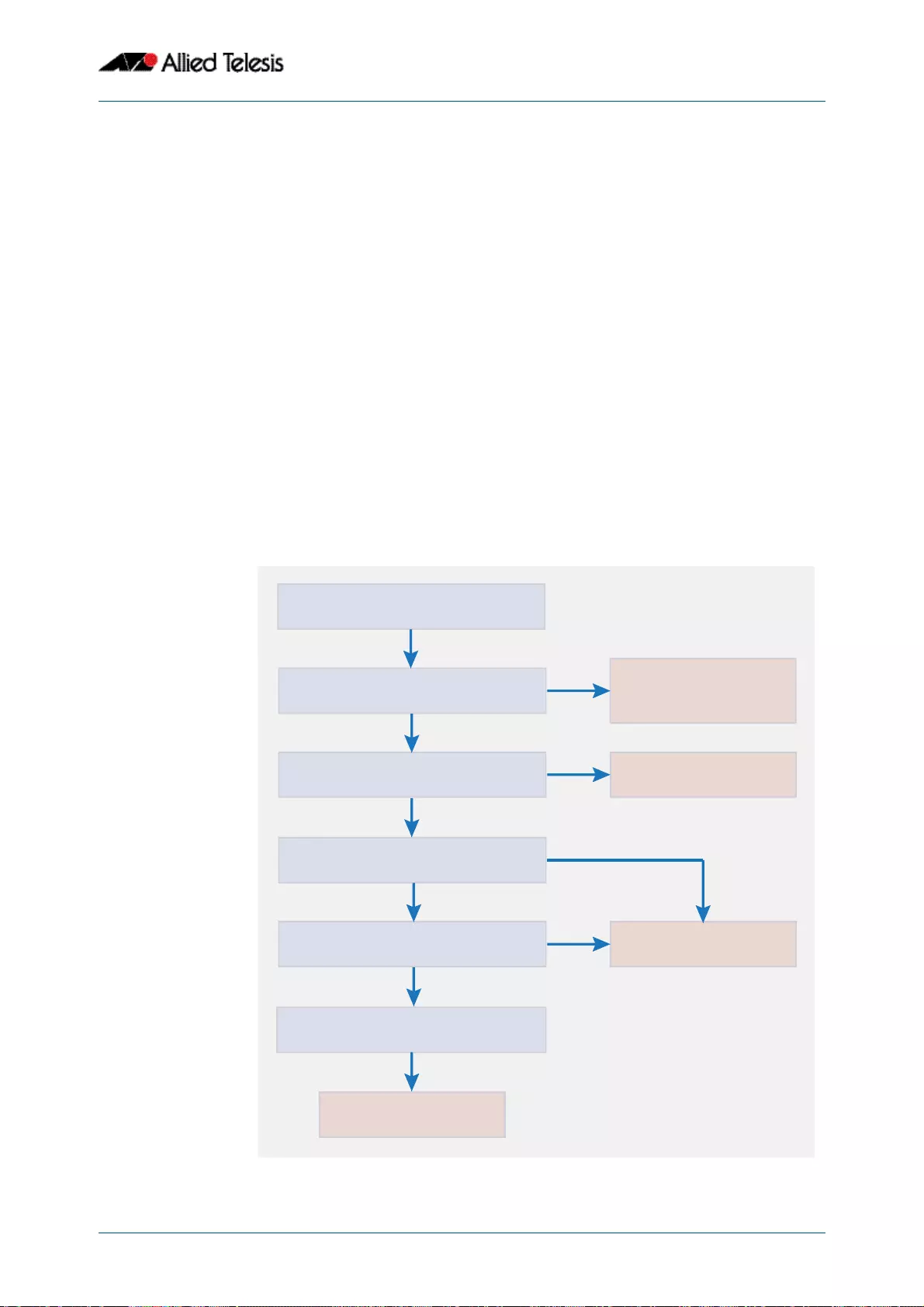
AMF Introduction and Configuration
Software Reference for GS900MX/MPX Series Switches
C613-50065-01 REV B AlliedWare PlusTM Operating System - Version 5.4.4E-1.x 60.31
Node Recovery
Automatic Node Recovery
With AMF, you can replace a failed node with another device and let AMF automatically
load the appropriate configuration onto the replacement device.
For this to work, the replacement device must have no configuration file. This means it
must be either:
■a factory-new device, or
■a used device that has been returned to a “clean” state (see “Restoring a Node to a
“Clean” State” on page 60.32)
To replace a failed device with a new device of a different platform or with a different node
name, you need to provision the network to expect the new device. See “Node
Provisioning” on page 60.42.
When a switch boots up, it goes through the process in the following flowchart to
determine what configuration to use. This flowchart indicates when automatic node
recovery will be successful.
Figure 60-14: How a switch determines which configuration to use
Automatic node recovery is not intended to recover multiple nodes simultaneously. If
multiple nodes have failed, recover them one at a time.
Is the node already congured?
Is the node connected to
an AMF network?
Does the AMF network
recognise the node?
Can the node successfully download its
conguration from the AMF master?
Download the latest backed-up or
provisioned conguration and reboot
Run the default
conguration
Run that conguration.
This may include connecting
to the AMF network
Run the safe mode
conguration
The node is now running
the desired conguration
YES
YES
YES
YES
NO
NO
NO
NO
Start here

AMF Introduction and Configuration
Software Reference for GS900MX/MPX Series Switches
60.32 AlliedWare PlusTM Operating System - Version 5.4.4E-1.x C613-50065-01 REV B
Figure 60-15: Example log output showing automatic node recovery
Recovery progress indication
This is a visual feature that displays the recovery status during automatic recovery. This
feature uses two distinct flash patterns to indicate the following states:
When using this feature during a recovery failure, you can turn off the failure-alert
indication and return the port LEDs to their normal running state. To do this, use the
command “atmf recover led-off” on page 61.45.
You can repeat this process until the recovery failure has been fixed.
Note that the Find me and ecofriendly LED features cannot be used while AMF recovery
progress indication is active.
Restoring a Node to a “Clean” State
When replacing a failed device, your replacement device should be one of the following
types, in order for AMF automatic node recovery to work:
■A factory-new device
■A used device that has been returned to a “clean” state
Caution Do not make any changes to the device's configuration while a node
recovery is underway. A log message will appear on the console or other
VTY session indicating when recovery has finished (whether successfully or
with errors). This message can also be found by viewing the log with the
show log command.
23:03:15 awplus ATMF[863]: ATMF network detected
23:03:15 awplus ATMF[863]: ATMF safe config applied (forwarding disabled)
23:03:25 awplus ATMF[863]: Shutting down all non ATMF ports
23:03:26 x510_1 ATMF[863]: Automatic node recovery started
23:03:26 x510_1 ATMF[863]: Attempting to recover as x510_1
23:03:26 x510_1 ATMF[863]: Checking master node availability
23:03:32 x510_1 ATMF[863]: Master has joined. 2 members in total.
23:03:32 x510_1 ATMF[863]: x908_VCS_2 has joined. 3 members in total.
23:03:32 x510_1 ATMF[863]: x908_VCS_1 has joined. 4 members in total.
23:03:37 x510_1 ATMFFSR[2950]: Retrieving recovery data from master node Master
23:05:18 x510_1 ATMFFSR[2950]: File recovery from master node succeeded. Node will
now reboot
Flushing file system buffers...
Unmounting any remaining filesystems...
Restarting system.
Recovery State LED Indication (green)
Recovery in progress Progressive strobing of all port LEDs.
Recovery failure All port LEDs alternating on and off, flashing at
the same time.

AMF Introduction and Configuration
Software Reference for GS900MX/MPX Series Switches
C613-50065-01 REV B AlliedWare PlusTM Operating System - Version 5.4.4E-1.x 60.33
A clean device is one that has had its previous configuration components removed. The
process of cleaning is required when replacing a failed device with one that, although in
working condition, has been used previously and still retains components of its previous
configuration.
If you keep on-site spares, store them with clean configurations and current releases.
When you upgrade your network to a new AlliedWare Plus version, we recommend you
upgrade your spare devices too.
To clean up a previously used device, use the atmf cleanup command on page 61.14. This
command erases all data from NVS and Flash apart from:
■The boot release file (a .rel file) and its release setting file
■v1 license files /.configs/.swfeature.lic
■v2 license files /.configs/.sw_v2.lic
The device is then rebooted to put it into a clean state. The device can then be used for
automatic node recovery.
Any other user files that remain in Flash will be overwritten during the automatic recovery
process. If there are any files stored in the Flash of the replacement device that need to be
retained, back these files up prior to installing the device into the AMF network.
Manual Node Recovery
There are certain situations where automatic recovery may fail. Automatic recovery has
been designed to be cautious in its approach to recovering nodes for reasons such as:
■The backup stored on the AMF master not having a “Good” status
■The replacement device having a release of the AlliedWare Plus Operating System
installed on it that is old enough to be incompatible with AW+ on the neighbor or the
master.
When these situations occur, automatic node recovery will fail.
In this failed state, the replacement device will have the AMF safe configuration mode
applied (see “AMF Safe Configuration Procedures” on page 60.35). After investigating
the failure and taking remedial action, you may want to initiate manual node recovery. To
do this, enter the following command:
where:
■node_name is the host name of the device you wish to recover.
■master_node_name is the host name of the AMF master that contains the backup
you want to use for the recovery.
The manual recovery command will bypass the usual checks performed by automatic
node recovery. Make sure that the backup configuration stored on the specified AMF
master is correct before you execute the command.
If you attempt to manually recover a node with the backup file of a node from a different
platform, the release file from the backup will be incompatible and won’t be copied to the
replacement device. Instead, the existing release on the replacement device will be used,
in order to ensure the device can join the AMF network and function correctly.
amf1# atmf recover {<node_name>} {<master_node_name>}

AMF Introduction and Configuration
Software Reference for GS900MX/MPX Series Switches
60.34 AlliedWare PlusTM Operating System - Version 5.4.4E-1.x C613-50065-01 REV B
Figure 60-16: Example output showing manual recovery
Node Recovery on VCStacks
Node recovery on VCStacks that are part of an AMF network is somewhat different to node
recovery of standalone devices.
This is because VCStack has its own node recovery mechanism that has different
requirements to AMF.
In the extremely unlikely situation of needing to replace an entire VCStack that is a
member of an AMF network, you can use AMF automatic node recovery to first recover
Stack ID 1, which will become the VCStack master.
The replacement device which will become the VCStack master must be a clean unit (see
“Restoring a Node to a “Clean” State” on page 60.32).
The procedure for recovering an entire stack is as follows:
1. Connect a clean device to the AMF network, and power it on. The connections into the
AMF network should be between the appropriately configured AMF links on the
neighboring node, and the ports previously configured as AMF links in the backup for
the failed node configuration.
2. The AMF network should detect the replacement device and begin automatic node
recovery. Wait until automatic node recovery completes, then check that the
replacement device has come up correctly as VCStack ID 1, and that the configuration
is correct.
3. Configure the next replacement device as VCStack ID 2. Ensure it is installed with a
compatible release and the same set of licenses that exist on ID 1. Connect the VCStack
cables and power it on.
4. VCStack ID 1 should detect ID 2 and synchronize the configuration and firmware
release. Once this has completed, check that the VCStack has formed correctly, and
then connect the remaining network connections.
For any additional VCStack members, repeat the last two steps, ensuring that the VCStack
ID is set to the next sequential value for each additional device that is added to the
VCStack.
For more information on VC Stacking, see:
■ “VCStack Introduction” on page 81.2
■ “Replacing a stack member” on page 81.16
amf1#atmf recover x510_1 Master
This command will erase ALL flash contents. Continue node recovery? (y/n)y
Manual node recovery successfully initiated
x510_1#23:15:32 x510_1 ATMFFSR[8477]: Retrieving recovery data from master node
Master
23:17:17 x510_1 ATMFFSR[8477]: Manual node recovery completed
x510_1#

AMF Introduction and Configuration
Software Reference for GS900MX/MPX Series Switches
C613-50065-01 REV B AlliedWare PlusTM Operating System - Version 5.4.4E-1.x 60.35
AMF Safe Configuration
If AMF automatic node recovery fails, AMF contains a safety net feature that puts the
replacement node into a safe configuration state. This is to prevent an unconfigured
device from joining the network and creating loops.
Detecting AMF Safe Configuration Operation
A log message will be generated when AMF safe configuration is applied. This message
will appear in the log some time after the startup sequence.
The message will also be output to the console or any connected VTY session.
AMF Safe Configuration Procedures
The procedures for AMF safe configuration are shown below:
■A special VLAN is created in the disabled state and given the name
atmf_node_recovery_safe_vlan. The VID of this VLAN is determined dynamically to
ensure that it does not conflict with either of the AMF management VLANs, or any
other VLANs that are detected on the AMF network.
■All ports are removed from their default VLAN membership (VLAN 1).
■All ports are set as tagged members of the safe VLAN.
■Additionally, all ports that are not an AMF link or cross-link are shut down. The links
and crosslinks are detected by AMF and added to the dynamic configuration. This is
done to ensure correct behavior of static aggregators and Layer 3 protocols
configured on the neighboring devices.
Figure 60-17: Example output from the show vlan command with the brief
parameter set for a device in AMF safe configuration mode
awplus#sh vlan brief
VLAN ID Name Type State Member ports (u)-Untagged, (t)-Tagged
======= ================ ======= ======= =======================================
1 default STATIC ACTIVE
4090 atmf_node_recovery_safe_vlan
STATIC SUSPEND port1.0.1(t) port1.0.2(t) port1.0.3(t)
port1.0.4(t) port1.0.5(t) port1.0.6(t)
port1.0.7(t) port1.0.8(t) port1.0.9(t)
port1.0.10(t) port1.0.11(t)
port1.0.12(t) port1.0.13(t)
port1.0.14(t) port1.0.15(t)
port1.0.16(t) port1.0.17(t)
port1.0.18(t) port1.0.19(t)
port1.0.20(t) port1.0.21(t)
port1.0.22(t) port1.0.23(t)
port1.0.24(t)

AMF Introduction and Configuration
Software Reference for GS900MX/MPX Series Switches
60.36 AlliedWare PlusTM Operating System - Version 5.4.4E-1.x C613-50065-01 REV B
Figure 60-18: Example output from the show running-config command for a device
in AMF safe configuration mode
Undoing an AMF Safe Configuration
If your node has had AMF safe configuration applied, you can use normal CLI
configuration commands to modify the running-configuration to whatever configuration
is required.
See below for an example of returning a device from AMF safe configuration mode to
having default VLAN and port settings. Note that in this example a 24-port device has
been used.
awplus#show running-config
...
!
vlan database
vlan 4090 name atmf_node_recovery_safe_vlan
vlan 4090 state disable
!
interface port1.0.1-1.0.4
shutdown
switchport
switchport mode trunk
switchport trunk allowed vlan add 4090
switchport trunk native vlan none
!
interface port1.0.5
switchport
switchport atmf-link
switchport mode trunk
switchport trunk allowed vlan add 4090
switchport trunk native vlan none
!
interface port1.0.6-1.0.24
shutdown
switchport
switchport mode trunk
switchport trunk allowed vlan add 4090
switchport trunk native vlan none
!
...
awplus# configure terminal
awplus(config)# interface port1.0.1-port1.0.24
awplus(config-if)# switchport trunk native vlan 1
awplus(config-if)# switchport trunk allowed vlan remove 4090
awplus(config-if)# switchport mode access
% port1.0.5 has ATMF link configured so
its mode cannot be changed

AMF Introduction and Configuration
Software Reference for GS900MX/MPX Series Switches
C613-50065-01 REV B AlliedWare PlusTM Operating System - Version 5.4.4E-1.x 60.37
In order to retain connectivity to the AMF network, AMF link and crosslink settings should
not be changed. In the example above you can see that port1.0.5 is an automatically
configured AMF link. You can also see the error message indicating it was skipped by the
“switchport mode access” on page 17.16. This is because AMF links must be in trunk
mode.
awplus(config-if)# no shutdown
awplus(config-if)# exit
awplus(config-if)# vlan database
awplus(config-if)# no vlan 4090
awplus(config-if)# end
Caution No changes should be made to the device's configuration while a node
recovery is underway. A log message will appear on the console or other
logged in session indicating when recovery has finished (whether
successfully or with errors). This message can also be found by viewing the
log with the command “show log” on page 10.37.

AMF Introduction and Configuration
Software Reference for GS900MX/MPX Series Switches
60.38 AlliedWare PlusTM Operating System - Version 5.4.4E-1.x C613-50065-01 REV B
Rolling-Reboot Firmware Upgrade
The rolling-reboot firmware upgrade feature enables nodes within an AMF network to be
rebooted and upgraded in a rolling sequence so that downtime and management
overheads are minimized. First, specify a set of nodes within the AMF network using the
atmf working-set command, then use the atmf reboot-rolling command. All nodes in
the specified working-set will be rebooted and upgraded one by one, starting with the
nodes furthest from the core domain, and ending with nodes closest to, or in, the core
domain.
Once the rebooted node has finished running its configuration and has brought its ports
up, it re-joins the AMF network and the next node in the working-set is rebooted and
upgraded.
To upgrade firmware, a download URL can be selected from any media location.
Supported media locations include:
■flash:
■card:
■usb:
■tftp:
■scp:
■http:
The latest compatible release for a node will be selected from one of these locations.
Several checks need to be performed to ensure the upgrade will succeed. This includes
checking that the current node release boots from Flash and that there is enough space in
Flash on this node. The new release name is updated using the boot system backup
command. The old release will become the backup release file.
Note that if the release file is to be copied from a remote location (e.g. via TFTP or HTTP),
the URL should specify the exact release filename without using wild card characters.
The node is rebooted and the new software version will be used. On bootup, the software
release is verified. Should an upgrade fail, the upgrading unit will fail back to its old
software version. At the completion of this command, a report is run showing the release
upgrade status of each node.
The force parameter enforces a node reboot, even though the node may not be suitable
for upgrading software. This command can take a significant amount of time to complete.
Note The atmf rolling-reboot command can also be used to reboot a set of nodes
without upgrading the firmware.
Note Rolling-reboot firmware upgrades can be performed on a working-set that
includes the controlling node, although in this instance the user will not be
presented with a summary report upon completion.

AMF Introduction and Configuration
Software Reference for GS900MX/MPX Series Switches
C613-50065-01 REV B AlliedWare PlusTM Operating System - Version 5.4.4E-1.x 60.39
Here is an example of a Rolling-reboot firmware upgrade summary report:
==================================================================================
ATMF Rolling Reboot Complete
Node Name Reboot Status Release Name Release Status
----------------------------------------------------------------------------------
Node1 Rebooted x510-main-20121018-2.rel Upgraded
Node2 Rebooted x900-main-20121018-2.rel Upgraded
Node3 Rebooted x900-main-20121018-2.rel Upgraded
Node4 Rebooted x510-main-20121018-2.rel Upgraded
==================================================================================

AMF Introduction and Configuration
Software Reference for GS900MX/MPX Series Switches
60.40 AlliedWare PlusTM Operating System - Version 5.4.4E-1.x C613-50065-01 REV B
Performing a Rolling-Reboot Upgrade
To perform a Rolling-reboot firmware upgrade on all nodes in the AMF network, first
select all nodes using the default working-set group all:
Next, using the atmf reboot-rolling command, specify the path to the release files to use
for the upgrade. In the following example the release files are stored on the external USB
storage media installed in the node controlling the Rolling-reboot firmware upgrade, in a
directory called “rel”. Note that because the node controlling the Rolling-reboot firmware
upgrade is included in the nodes to be upgraded, a message is output indicating that no
summary will be available on completion.
Although in this example no summary report was generated, you can refer to the progress
messages output on the console to confirm that the upgrades were successful. You can
also use the atmf working-set and the show boot commands to confirm the current
boot image for each node in the AMF network.
SBx8100# atmf working-set group all
SBx8100, SBx908-VCS1, SBx908-VCS2, x510_1, x510_2:
Working set join
csg_vcf[5]#atmf reboot-rolling usb:/rel/*.rel
Retrieving data from SBx8100
Retrieving data from SBx908-VCS2
Retrieving data from x510_1
Retrieving data from x510_2
Retrieving data from SBx908-VCS1
ATMF Rolling Reboot Nodes:
Timeout
Node Name (Minutes) New Release File Status
---------------------------------------------------------------------
x510_2 9 x510-main-20121203-1.rel Release ready
x510_1 6 x510-main-20121203-1.rel Release ready
SBx908-VCS1 9 x900-main-20121203-1.rel Release ready
SBx908-VCS2 9 x900-main-20121203-1.rel Release ready
SBx8100 11 SBx81CFC400-main-20121203 Release ready
-1.rel
% The controlling node (SBx8100) is included in the
rolling reboot and will be rebooted last.
No summary will be available on completion.
Continue upgrading releases ? (y/n):
=====================================================================
Copying Release : x510-main-20121203-1.rel to x510_2
Updating Release : x510-main-20121203-1.rel information on x510_2
==================================================================
ATMF Rolling Reboot: Rebooting x510_2
====================================================================
02:11:32 SBx8100 ATMF[1973]: x510_2 has left. 4 members in total.
% x510_2 has left the working-set
02:13:30 SBx8100 ATMF[1973]: x510_2 has joined. 5 members in total.
Reboot of x510_2 has completed

AMF Introduction and Configuration
Software Reference for GS900MX/MPX Series Switches
C613-50065-01 REV B AlliedWare PlusTM Operating System - Version 5.4.4E-1.x 60.41
=====================================================================
Copying Release : x510-main-20121203-1.rel to x510_1
Updating Release : x510-main-20121203-1.rel information on x510_1
=====================================================================
ATMF Rolling Reboot: Rebooting x510_1
====================================================================
02:14:13 SBx8100 ATMF[1973]: x510_1 has left. 4 members in total.
% x510_1 has left the working-set
02:15:53 SBx8100 ATMF[1973]: x510_1 has joined. 5 members in total.
Reboot of x510_1 has completed
=================================================
Copying Release : x900-main-20121203-1.rel to SBx908-VCS1
Updating Release : x900-main-20121203-1.rel information on SBx908-VCS1
====================================================================
ATMF Rolling Reboot: Rebooting SBx908-VCS1
====================================================================
02:19:02 SBx8100 ATMF[1973]: x510_1 has left. 4 members in total.
02:19:02 SBx8100 ATMF[1973]: SBx908-VCS1 has left. 3 members in total.
% SBx908-VCS1 has left the working-set
02:20:48 SBx8100 ATMF[1973]: SBx908-VCS1 has joined. 4 members in total.
Reboot of SBx908-VCS1 has completed
02:20:51 SBx8100 ATMF[1973]: x510_1 has joined. 5 members in total.
=================================================================
Copying Release : x900-main-20121203-1.rel to SBx908-VCS2
Updating Release : x900-main-20121203-1.rel information on SBx908-VCS2
=====================================================================
ATMF Rolling Reboot: Rebooting SBx908-VCS2
====================================================================
02:21:54 SBx8100 ATMF[1973]: x510_2 has left. 4 members in total.
02:21:54 SBx8100 ATMF[1973]: SBx908-VCS2 has left. 3 members in total.
% SBx908-VCS2 has left the working-set
02:23:35 SBx8100 ATMF[1973]: SBx908-VCS2 has joined. 4 members in total.
Reboot of SBx908-VCS2 has completed
=====================================================================
Copying Release : SBx81CFC400-main-20121203-1.rel to SBx8100
02:23:39 SBx8100 ATMF[1973]: x510_2 has joined. 5 members in total.
Updating Release : SBx81CFC400-main-20121203-1.rel information on SBx8100
=====================================================================
ATMF Rolling Reboot: Rebooting SBx8100
=====================================================================
02:24:07 SBx8100 ATMF: reboot-rolling Rebooting SBx8100 at request of user manager.

AMF Introduction and Configuration
Software Reference for GS900MX/MPX Series Switches
60.42 AlliedWare PlusTM Operating System - Version 5.4.4E-1.x C613-50065-01 REV B
Node Provisioning
You can pre-configure, or provision, a port for a future node before the node is added to
the network. A provisioned node can be created as a new unique entity, or can be cloned
using the backup data from an existing node. When you connect the new node to the
provisioned port in the AMF network, its configuration is loaded from the information
stored in the backup media.
AMF commands are used to create and configure a provisioned node and to specify the
port(s) that the node is expected to appear on.
When to use node
provisioning
Node provisioning can be used in these instances:
■For future extension of the AMF network. You can pre-configure future AMF network
nodes via the atmf provision node commands. The following figure illustrates the
position of a future, provisioned node. Port1.1.5 on Member 2 and port1.0.3 on
Member 4 would need to be configured to expect the future node
Figure 60-19: Provisioning for a future node
■For replacing an existing node with a new node of a different platform (e.g. replacing
an x310 switch with an x510), and/or with a different host name. Using the atmf
provision node commands you can configure the ports on adjacent nodes to accept
a replacement AMF member.
Creating a new
provisioned node
You can pre-configure nodes by creating a new directory or by cloning an existing node
(see Table 60-7 and Table 60-8).
Note If you are replacing an existing node with a new node of the same platform and
host name, refer to “Node Recovery” on page 60.31. In this case, node
provisioning is not necessary, and node recovery will suffice.
Member 1
Member 2
Member 4
Member 3
port1.0.1
AMF crosslink
AMF up/down link
port1.1.3 port1.1.3
port1.0.1
port1.1.2 port1.1.2
port1.1.1 port1.1.2
port1.1.1 port1.1.1
AMF
Master 1
Future
node
port1.1.5
port1.0.3

AMF Introduction and Configuration
Software Reference for GS900MX/MPX Series Switches
C613-50065-01 REV B AlliedWare PlusTM Operating System - Version 5.4.4E-1.x 60.43
These two methods can briefly be described as:
1. Using the atmf provision node create command on page 61.33.
This command creates an “empty” directory to which release and configuration files
can be added for use on a future node. You can copy configuration and release files
from existing switches into the new directory. Alternatively, you can create the
configuration files by following the instructions in these sections:
« “Creating and Using Configuration Files” on page 6.8
« “Configuring AMF” on page 60.13.
2. Using the atmf provision node clone command on page 61.29.
This command creates a new directory and copies most settings and files from
another backup or provisioned node. You can make additional changes manually to
these files, if needed.
We recommend that you select the donor node to be as close as possible to the new
node, and for it to contain the same number of ports. This will limit the number of
manual changes that will be required to the replicated configuration of the new node.
AMF stores the configuration files for the provisioned node on the master node’s backup
media or a remote backup server. These files are automatically loaded onto the new
node’s Flash when it is introduced to the network.
Configuring
adjacent nodes
You need to configure the AMF links and cross-links on the adjacent node before the new
node is connected. Later, when the provisioned node is introduced to the AMF network,
the adjacent node(s) will recognize it and the new node will automatically join the AMF
network.
If you plan to replace an existing AMF node with one that has a different host name, use
the “atmf provision” on page 61.28 to configure the adjacent node to expect the new
node in the future. This command is used to configure all AMF links and cross-links to the
new node.
If you plan to extend your AMF network via ports that have not been used before, you
must first fully configure the ports beforehand. Such configuration includes using the
“atmf provision” on page 61.28 and other commands, some of which are shown in the
following tables.
More information on configuring switches can be found in “Creating and Using
Configuration Files” on page 6.8.
Table 60-7 on page 60.44 outlines the procedures to follow if you want to:
■create a provisioned node.
■configure the existing node(s) that the provisioned node will eventually connect to.
Table 60-8 on page 60.45 outlines the procedures to follow if you want to:
■clone a provisioned node.
■configure the existing node(s) that the provisioned node will eventually connect to.
Note that these examples describe steps for any AMF node, but GS900MX/MPX switches
can only be configured as AMF edge switches with a single uplink and no cross-links.

AMF Introduction and Configuration
Software Reference for GS900MX/MPX Series Switches
60.44 AlliedWare PlusTM Operating System - Version 5.4.4E-1.x C613-50065-01 REV B
Table 60-7: Procedure for creating a provisioned node and configuring its adjacent node(s)
Step a. Enter Privileged Exec
mode
Member_4>enable
Step b. Set the name of the
provisioned node to
“future_node”
Member_4#atmf provision node future_node create
This command sets up an empty directory on the backup media for use with
a provisioned node.
Step c. Copy and set release file To copy a release file from member4’s Flash into the future_node directory,
and set that release file to load onto future_node when it first boots up,
enter the following commands:
Member_4#atmf provision node future_node locate
Member_4#copy flash:member4.rel ./future_node.rel
Member_4#atmf provision node future_node configure boot
system future_node.rel
OR
Member_4#atmf provision node future_node locate
Member_4#copy current-software member4.rel ./
future_node.rel
Member_4#atmf provision node future_node configure boot
system future_node.rel
For information on downloading AlliedWare Plus release files see the
Download Centre at www.alliedtelesis.com/support
For information on copying files see “Copying Files to and from Your
Device” on page 6.12
Step d. Copy and set
configuration file
To copy a configuration file named current.cfg from member4’s Flash into
the future_node directory, and set that configuration file to load onto
future_node when it first boots up, enter the following commands:
Member_4#atmf provision node future_node locate
Member_4#copy flash:current.cfg ./future_node.cfg
Member_4#atmf provision node future_node configure boot
config future_node.cfg
For information on configuring a switch see “Creating and Using
Configuration Files” on page 6.8
For information on configuring a switch for AMF see “Configuring AMF” on
page 60.13
Step e. Edit configuration file if
necessary.
Note that it is important to give the provisioned node a unique hostname.
To alter the config file in the AlliedWare Plus text editor, use the edit
command on page 7.24.
For information on configuring a switch see “Creating and Using
Configuration Files” on page 6.8
For information on configuring a switch for AMF see “Configuring AMF” on
page 60.13

AMF Introduction and Configuration
Software Reference for GS900MX/MPX Series Switches
C613-50065-01 REV B AlliedWare PlusTM Operating System - Version 5.4.4E-1.x 60.45
Table 60-8: Procedure for cloning a provisioned node and configuring its adjacent nodes
Step f. Copy and set license file To copy a license certificate named member_4.txt from member4’s Flash
into the future_node directory, and set that license certificate to load onto
future_node when it first boots up, enter the following commands:
Member_4#atmf provision node future_node locate
Member_4#copy flash:member_4.txt ./future_node.txt
Member_4#atmf provision node future_node license-cert
future_node.txt
For information on licensing for AMF see the atmf provision node license-
cert command on page 61.37.
Step g. Configure the port
node(s) that will be
connected to the
provisioned node. In this
example, port1.0.3 on
member4 is being
configured as an AMF
link and to expect the
provisioned node
future_node
Member_4#configure terminal
Member_4(config)#interface port1.0.3
Member_4(config-if)#switchport atmf-link
Member_4(config-if)#switchport trunk native vlan none
Member_4(config-if)#atmf provision future_node
Member_4(config-if)#exit
Member_4(config)#exit
Member_4#atmf working-set group local
Note that AMF links and crosslinks do not need to be configured with data
VLANs and can be used solely to provide AMF management VLAN
redundancy.
Step g can be repeated to configure the ports on other adjacent nodes that
will be connected to the provisioned node.
Step a. Enter Privileged Exec
mode
AMF_Master1>enable
Step b. Set the name of the
provisioned node to
“future_node”. In this
example, the
provisioned node will
be a clone of
member_3
AMF_Master1#atmf provision node future_node clone member_3
If further changes are required, follow the commands shown in Step c in
Table 60-7 above.
Step c. Configure the port
node(s) that will be
connected to the
provisioned node. In
this example, port1.0.3
on member_4 is being
configured as an AMF
link and to expect the
provisioned node
future_node
AMF_Master1#atmf working-set member_4
member_4#configure terminal
member_4(config)#interface port1.0.3
member_4(config-if)#switchport atmf-link
member_4(config-if)#switchport trunk native vlan none
member_4(config-if)#atmf provision future_node
member_4(config-if)#exit
member_4(config)#exit
member_4#atmf working-set group local
AMF_Master1#
Note that AMF links and crosslinks do not need to be configured with data
VLANs and can be used solely to provide AMF management VLAN
redundancy.
Step c can be repeated to configure the ports on other adjacent nodes to
expect the provisioned node.

AMF Introduction and Configuration
Software Reference for GS900MX/MPX Series Switches
60.46 AlliedWare PlusTM Operating System - Version 5.4.4E-1.x C613-50065-01 REV B
Connecting a
provisioned node
to an AMF network
When you add the new node to the AMF network, its settings and files are automatically
downloaded from the master node’s backup media, or a remote backup server, to the new
node’s Flash.
All you need to do is cable the new device into the network. The switch’s port LEDs will
flash to show that its settings are being loaded. Progressive strobing of all the port LEDs
indicates that a recovery is underway. For more information on the node recovery LEDs
see “Recovery progress indication” on page 60.32.
The following example shows the expected output when a provisioned node named
future_node joins the AMF network to replace a node called member_5.
21:57:35 awplus ATMF[999]: ATMF network detected
21:57:35 awplus ATMF[999]: ATMF safe config applied (forwarding disabled)
21:57:45 awplus ATMF[999]: Shutting down all non ATMF ports
21:57:45 awplus ATMF[999]: member_5 has left. 0 member in total.
21:57:45 x510-2 ATMF[999]: future_node has joined. 1 member in total.
21:57:45 x510-2 ATMF[999]: Automatic node recovery started
21:57:45 x510-2 ATMF[999]: Attempting to recover as future_node
21:57:46 x510-2 ATMF[999]: Checking master node availability
21:57:52 x510-2 ATMF[999]: AMF_Master1 has joined. 2 members in total.
21:57:54 x510-2 ATMF[999]: member_1 has joined. 3 members in total.
21:57:56 x510-2 ATMF[999]: member_2 has joined. 4 members in total.
21:58:00 x510-2 ATMF[999]: member_3 has joined. 5 members in total.
21:58:03 x510-2 ATMF[999]: member_4 has joined. 6 members in total.
21:58:04 x510-2 ATMFFSR[6779]: Retrieving recovery data from master node
AMF_Master1
21:58:34 x510-2 ATMFFSR[6779]: Licence installed from certificate.
21:58:35 x510-2 ATMFFSR[6779]: File recovery from master node succeeded. Node will
now reboot

Software Reference for GS900MX/MPX Series Switches
C613-50065-01 REV B AlliedWare PlusTM Operating System - Version 5.4.4E-1.x 61.1
Chapter 61: AMF Commands
Introduction ........................................................................................................................................ 61.3
AMF on GS900MX/MPX Series Switches: AMF Edge..................................................... 61.3
AMF Naming Convention ....................................................................................................... 61.3
atmf backup ........................................................................................................................................ 61.4
atmf backup bandwidth................................................................................................................. 61.5
atmf backup delete .......................................................................................................................... 61.6
atmf backup enable ......................................................................................................................... 61.7
atmf backup now .............................................................................................................................. 61.8
atmf backup server.........................................................................................................................61.10
atmf backup stop ............................................................................................................................61.12
atmf backup synchronize.............................................................................................................61.13
atmf cleanup.....................................................................................................................................61.14
atmf distribute firmware ..............................................................................................................61.15
atmf domain vlan............................................................................................................................61.17
atmf enable .......................................................................................................................................61.18
atmf group (membership) ...........................................................................................................61.19
atmf log-verbose.............................................................................................................................61.21
atmf management subnet...........................................................................................................61.22
atmf management vlan ................................................................................................................61.24
atmf master .......................................................................................................................................61.26
atmf network-name .......................................................................................................................61.27
atmf provision ..................................................................................................................................61.28
atmf provision node clone...........................................................................................................61.29
atmf provision node configure boot config..........................................................................61.31
atmf provision node configure boot system ........................................................................61.32
atmf provision node create .........................................................................................................61.33
atmf provision node delete .........................................................................................................61.35
atmf provision node license-cert...............................................................................................61.37
atmf provision node locate .........................................................................................................61.39
atmf reboot-rolling.........................................................................................................................61.40
atmf recover......................................................................................................................................61.44
atmf recover led-off........................................................................................................................61.45
atmf remote-login...........................................................................................................................61.46
atmf restricted-login ......................................................................................................................61.47
atmf working-set .............................................................................................................................61.48
clear atmf links statistics...............................................................................................................61.49
debug atmf........................................................................................................................................61.50
debug atmf packet .........................................................................................................................61.52
erase factory-default ......................................................................................................................61.55
show atmf ..........................................................................................................................................61.56
show atmf backup ..........................................................................................................................61.60
show atmf detail..............................................................................................................................61.63
show atmf group.............................................................................................................................61.65
show atmf group members.........................................................................................................61.67
show atmf links ................................................................................................................................61.69
show atmf links detail....................................................................................................................61.70
show atmf links statistics..............................................................................................................61.76

AMF Commands
Software Reference for GS900MX/MPX Series Switches
61.2 AlliedWare PlusTM Operating System - Version 5.4.4E-1.x C613-50065-01 REV B
show atmf memory ........................................................................................................................61.79
show atmf nodes.............................................................................................................................61.80
show atmf provision nodes.........................................................................................................61.81
show atmf tech ................................................................................................................................61.82
show atmf working-set .................................................................................................................61.84
show debugging atmf...................................................................................................................61.85
show debugging atmf packet ....................................................................................................61.86
show running-config atmf...........................................................................................................61.87
switchport atmf-link.......................................................................................................................61.88
type atmf node ................................................................................................................................61.89

AMF Commands
Software Reference for GS900MX/MPX Series Switches
C613-50065-01 REV B AlliedWare PlusTM Operating System - Version 5.4.4E-1.x 61.3
Introduction
This chapter provides an alphabetical reference for AMF commands.
AMF on GS900MX/MPX Series Switches: AMF Edge
The GS900MX/MPX Series are edge switches, and can only join the edge of an AMF
network.
GS900MX/MPX switches cannot act as AMF master nodes. For completeness, this chapter
includes the commands for configuring AMF master nodes, but these commands are not
supported on GS900MX/MPX switches.
Each GS900MX/MPX switch can only have a single link to the rest of the AMF network,
which must be an uplink to a switch that is closer to the AMF master. They cannot act as
intermediate nodes, and they cannot link to other nodes at the same level of the heirarchy
as themselves.
This functionality is known as “AMF Edge”.
AMF Naming Convention
When AMF is enabled on a switch, it will automatically be assigned a host name. If a host
name has already been assigned, by using the command “hostname” on page 8.17, this
will remain. If however, no host name has been assigned, then the name applied will be
the prefix, host_ followed (without a space) by the MAC address of the device. For
example, a device whose MAC address is 0016.76b1.7a5e will have the name
host_0016_76b1_7a5e assigned to it.
To efficiently manage your network using AMF, we strongly advise that you devise a
naming convention for your network switches, and accordingly apply an appropriate
hostname to each switch in your AMF network.

AMF Commands
Software Reference for GS900MX/MPX Series Switches
61.4 AlliedWare PlusTM Operating System - Version 5.4.4E-1.x C613-50065-01 REV B
atmf backup
This command can only be applied to a master node. It manually schedules an AMF
backup to start at a specified time and to execute a specified number of times per day.
Use the no variant of this command to disable the schedule.
Syntax atmf backup {default|<hh:mm> frequency <1-24>}
no atmf backup enable
Default Backups run daily at 03:00 AM, by default
Mode Global Configuration
Usage Running this command only configures the schedule. To enable the schedule, you should
then apply the command atmf backup enable.
Example To schedule backup requests to begin at 11 am and execute twice per day
(11 am and 11 pm), use the following command:
Related Commands atmf backup enable
atmf backup stop
show atmf backup
Parameter Description
default Restore the default backup schedule.
<hh:mm>Sets the time of day to apply the first backup, in hours and
minutes. Note that this parameter uses the 24 hour clock.
backup Enables AMF backup to external media.
frequency <1-24>Sets the number of times within a 24 hour period that
backups will be taken.
VCF_1# configure terminal
VCF_1(config)# atmf backup 11:00 frequency 2
Caution File names that comprise identical text, but with differing case, such as
Test.txt and test.txt, will not be recognized as being different on a FAT32
based backup media such as a USB storage device. However, these filenames
will be recognized as being different on your Linux based switch. Therefore,
for good practice, ensure that you apply a consistent case structure for your
back-up file names.

AMF Commands
Software Reference for GS900MX/MPX Series Switches
C613-50065-01 REV B AlliedWare PlusTM Operating System - Version 5.4.4E-1.x 61.5
atmf backup bandwidth
This command sets the maximum bandwidth in kilobytes per second (kBps) available to
the AMF backup process. This command enables you to restrict the bandwidth that is
utilized for downloading file contents during a backup.
Use the no variant of this command to reset (to its default value of zero) the maximum
bandwidth in kilobytes per second (kBps) available when initiating an AMF backup. A
value of zero tells the backup process to transfer files using unlimited bandwidth.
Syntax atmf backup bandwidth <0-1000>
no atmf backup bandwidth
Default The default value is zero, allowing unlimited bandwidth when executing an AMF backup.
Mode Global Configuration
Examples To set an atmf backup bandwidth of 750 kBps, use the commands:
To set the atmf backup bandwidth to the default value for unlimited bandwidth, use the
commands:
Related Commands show atmf backup
Note This command will only run on an AMF master. An error message will be
generated if the command is attempted on node that is not a master.
Also note that setting the bandwidth value to zero will allow the transmission of
as much bandwidth as is available, which can exceed the maximum configurable
speed of 1000 kBps. In effect, zero means unlimited.
Parameter Description
<0-1000> Sets the bandwidth in kilobytes per second (kBps)
node2# configure terminal
node2(config)# atmf backup bandwidth 750
node2# configure terminal
node2(config)# no atmf backup bandwidth

AMF Commands
Software Reference for GS900MX/MPX Series Switches
61.6 AlliedWare PlusTM Operating System - Version 5.4.4E-1.x C613-50065-01 REV B
atmf backup delete
This command removes the backup file from the external media of a specified AMF node.
Syntax atmf backup delete <node-name>
Mode Privileged Exec
Example To delete the backup file from node2, use the following command:
Related Commands show atmf backup
atmf backup now
atmf backup stop
Parameter Description
<node-name> The AMF node name of the backup file to be deleted.
Node_1# atmf backup delete node2

AMF Commands
Software Reference for GS900MX/MPX Series Switches
C613-50065-01 REV B AlliedWare PlusTM Operating System - Version 5.4.4E-1.x 61.7
atmf backup enable
This command enables automatic AMF backups on the AMF master node that you are
connected to. By default, automatic backup starts at 3:00 AM. However, this schedule can
be changed by the atmf backup command on page 61.4. Note that backups are initiated
and stored only on the master nodes.
Use the no variant of this command to disable any AMF backups that have been
scheduled and previously enabled.
Syntax atmf backup enable
no atmf backup enable
Default Automatic AMF backup functionality is enabled on the AMF master when it is configured
and external media, i.e. an SD card or a USB storage device or remote server, is detected.
Mode Global Configuration
Usage A warning message will appear if you run the atmf backup enable command with either
insufficient or marginal memory availability on your external storage device.
You can use the command “show atmf backup” on page 61.60 to check the amount of
space available on your external storage device.
Example To turn on automatic AMF backup, use the following command:
Related Commands show atmf
show atmf backup
atmf backup
atmf backup now
atmf enable
AMF_Master_1# configure terminal
AMF_Master_1(config)# atmf backup enable

AMF Commands
Software Reference for GS900MX/MPX Series Switches
61.8 AlliedWare PlusTM Operating System - Version 5.4.4E-1.x C613-50065-01 REV B
atmf backup now
This command initiates an immediate AMF backup of either all AMF members, or a
selected AMF member. Note that this backup information is stored in the external media
on the master node of the switch on which this command is run, even though the selected
AMF member may not be a master node.
Syntax atmf backup now [<nodename>]
Default A backup is initiated for all nodes on the AMF (but stored on the master nodes).
Mode Privileged Exec
Usage Although this command will select the AMF node to be backed-up; it can only be run from
any AMF master node.
Example 1 In this example, an AMF member has not been assigned a host name. The following
command is run on the AMF_Master_2 node to immediately backup the device -
identified by its MAC address of 0016.76b1.7a5e:
Example 2 In this example, an AMF member has the host name, office_annex. The following
command will immediately backup this device:
This command is initiated on the switch’s master node named AMF_Master_2 and
initiates an immediate backup on the switch named office_annex.
Parameter Description
<nodename>
or
<hostname>
The name of the AMF member to be backed up - as set by the
command “hostname” on page 8.17. Where no name has been
assigned to this device, then you must apply the prefix, host
underscore followed (without a space) by the MAC address of the
device to be backed up. For example host_0016_76b1_7a5e
Note that the node-name appears as the command Prompt when in
Privileged Exec mode.
Note The backup produced will be for the selected node but the backed-up config will
reside on the external media of the AMF master node on which the command
was run. However, this process will result in the information on one master being
more up-to-date. To maintain concurrent backups on both masters, you can
apply the backup now command to the master working-set. This is shown in
“Example 4” on page 61.9.
AMF_Master_2# atmf backup now host_0016_76b1_7a5e
Note When a host name is derived from its MAC address, the syntax format entered
changes from XXXX.XXXX.XXXX to XXXX_XXXX_XXXX.
AMF_Master_2# atmf backup now office_annex

AMF Commands
Software Reference for GS900MX/MPX Series Switches
C613-50065-01 REV B AlliedWare PlusTM Operating System - Version 5.4.4E-1.x 61.9
Example 3 To initiate from AMF_master_1 an immediate backup of all AMF member nodes, use the
following command:
Example 4 To initiate an immediate backup of the node with the host-name “office_annex” and store
the configuration on both masters, use the following process:
From the AMF_master_1, set the working-set to comprise only of the automatic group,
master nodes.
This command returns the following display:
Backup the AMF member with the host name, office_annex on both the master nodes as
defined by the working set.
Note that the [2] shown in the command prompt indicates a 2 node working-set.
Related Commands atmf backup
atmf backup stop
hostname
show atmf backup
AMF_Master_1# amf backup now
AMF_Master_1# atmf working-set group master
============================
AMF_Master_1, AMF_Master_2
===============================
Working set join
AMF_Master[2]# atmf backup now office_annex

AMF Commands
Software Reference for GS900MX/MPX Series Switches
61.10 AlliedWare PlusTM Operating System - Version 5.4.4E-1.x C613-50065-01 REV B
atmf backup server
This command configures remote file servers as the destination for AMF backups.
Use the no variant of this command to remove the destination server(s). When all servers
are removed the system will revert to backup from external media.
Syntax atmf backup server id {1|2} <hostlocation> username <username>[path
<path>|port <1-65535>]
no atmf backup server id {1|2}
Defaults Remote backup servers are not configured. The default SSH TCP port is 22. The path
utilized on the remote file server is the home directory of the username.
Mode Global Exec
Usage The hostname and username parameters must both be configured.
Examples To configure a remote backup server at 192.168.1.1 with the login username of backup1,
the backup repository on atmf/network/location/ port 1024, use the command:
Parameter Description
id Remote server backup server identifier.
{1|2}The backup server identifier number (1 or 2). Note that there can
be up to two backup servers, numbered 1 and 2 respectively, and
you would need to run this command separately for each server.
<hostlocation>Either the name or the IP address (IPv4 or IPv6) of the selected
backup server (1 or 2).
username Configure the username to log in with on the selected remote file
server.
<username>The selected remote file server’s username.
path The location of the backup files on the selected remote file server.
By default this will be the home directory of the username used
to log in with.
<path>The directory path utilized to store the backup files on the
selected remote file server. No spaces are allowed in the path.
port The connection to the selected remote backup file server using
SSH. By default SSH connects to a device on TCP port 22 but this
can be changed with this command.
<1-65535>A TCP port within the specified range.
AMF_Master_1# configure terminal
AMF_Master_1(config)# atmf backup server id 1 192.168.1.1
username backup1 path atmf/network/
location/port 1024

AMF Commands
Software Reference for GS900MX/MPX Series Switches
C613-50065-01 REV B AlliedWare PlusTM Operating System - Version 5.4.4E-1.x 61.11
To configure server 1 with an ipv4 address and a username of backup1, use the
commands:
To configure server 1 with an ipv6 address and a username of backup1, use the command:
To configure server 2 with a hostname and username, use the command:
To configure server 2 with a hostname and username in addition, the optional path and
port parameters, use the command:
To unconfigure the AMF remote backup file server 1, use the command:
Related Commands show atmf backup
AMF_Master_1# configure terminal
AMF_Master_1(config)# atmf backup server id 1 192.168.1.1
username backup1
AMF_backup1_1# configure terminal
AMF_Master_1(config)# atmf backup server id 1 FFEE::01 username
backup1
AMF_Master_1# configure terminal
AMF_Master_1(config)# atmf backup server id 2 www.example.com
username backup2
AMF_Master_1# configure terminal
AMF_Master_1(config)# atmf backup server id 2 www.example.com
username backup2 path tokyo port 1024
AMF_Master_1# configure terminal
AMF_Master_1(config)# no atmf backup server id 1

AMF Commands
Software Reference for GS900MX/MPX Series Switches
61.12 AlliedWare PlusTM Operating System - Version 5.4.4E-1.x C613-50065-01 REV B
atmf backup stop
Running this command stops a backup that is currently running on the master node you
are logged onto. Note that if you have two masters and want to stop both, then you can
either run this command separately on each master node, or add both masters to a
working set, and issue this command to the working set.
Syntax atmf backup stop
Mode Privileged Exec
Usage This command is used to halt an AMF backup that is in progress. In this situation the
backup process will finish on its current node and then stop.
Example To stop a backup that is currently executing on master node VCF-1, use the following
command:
Related Commands atmf backup
atmf backup enable
atmf backup now
show atmf backup
AMF_Master_1# amf backup stop

AMF Commands
Software Reference for GS900MX/MPX Series Switches
C613-50065-01 REV B AlliedWare PlusTM Operating System - Version 5.4.4E-1.x 61.13
atmf backup synchronize
For the master node you are connected to, this command initiates a system backup of files
from the node’s active remote file server to its backup remote file server. Note that this
process happens automatically each time the network is backed up.
Syntax atmf backup synchronize
Mode Privileged Exec
Example When connected to the master node AMF_Master_1, the following command will initiate
a backup of all system related files from its active remote file server to its backup remote
file server.
Related Commands show atmf backup
atmf backup enable
show atmf
AMF_Master_1# atmf backup synchronize

AMF Commands
Software Reference for GS900MX/MPX Series Switches
61.14 AlliedWare PlusTM Operating System - Version 5.4.4E-1.x C613-50065-01 REV B
atmf cleanup
This command erases all data from NVS and all data from Flash excluding the following:
■The current release file and its /flash/.release file
■The backup release file and /flash/.backup file
■v1 license files /flash/.configs/.swfeature.lic
■v2 license files /flash/.configs/.sw_v2.lic
It then reboots to put the device in a clean state ready to be used as a replacement node
on a provisioned port.
Syntax atmf cleanup
Mode Privileged Exec
Usage This command is an alias to the erase factory-default command on page 61.55.
Example To erase data, use the command:
Related Commands erase factory-default
Node_1(config)# atmf cleanup
This command will erase all NVS, all flash contents except
for the boot release, and any license files, and then
reboot the switch. Continue? (y/n):y

AMF Commands
Software Reference for GS900MX/MPX Series Switches
C613-50065-01 REV B AlliedWare PlusTM Operating System - Version 5.4.4E-1.x 61.15
atmf distribute firmware
This command can be used to upgrade software one AMF node at a time. A URL can be
selected from any media location. The latest compatible release for a node will be selected
from this location.
Several procedures are performed to ensure the upgrade will succeed. This includes
checking the current node release boots from flash. If there is enough space on flash the
software release is copied to flash on the new location.
The new release name is updated using the boot system command. The old release will
become the backup release file. If a release file exists in a remote device (such as TFTP or
HTTP, for example) then the URL should specify the exact release filename without using a
wild card character.
The command will continue to upgrade software until all nodes are upgraded. At the end
of the upgrade cycle the reboot command should be used on the working-set.
Syntax atmf distribute firmware <url>
Mode Privileged Exec
Examples To upgrade nodes in a atmf network with a predefined AMF group called sw_team, use
the following commands:
Output
Parameter Description
<url>The URL of the file. See “URL Syntax” on page 6.12 for valid URL
syntax.
SW_Team1# atmf working-set group sw_team
=============================
SW_Team1, SW_Team2, SW_Team3:
=============================
Working set join
ATMF_NETWORK[3]# atmf distribute firmware card:*.rel

AMF Commands
Software Reference for GS900MX/MPX Series Switches
61.16 AlliedWare PlusTM Operating System - Version 5.4.4E-1.x C613-50065-01 REV B
Output
Related Commands atmf working-set
Retrieving data from SW_Team1
Retrieving data from SW_Team2
Retrieving data from SW_Team3
ATMF Firmware Upgrade:
Node Name New Release File Status
----------------------------------------------------------------
SW_Team1 x510-main-20140204-2.rel Release ready
SW_Team2 x610-main-20140204-2.rel Release ready
SW_Team3 x610-main-20140204-2.rel Release ready
Continue the rolling reboot ? (y/n):y
================================================================
Copying Release : x510-main-20140204-2.rel to SW_Team1
Updating Release : x510-main-20140204-2.rel information on SW_Team1
================================================================
Copying Release : x610-main-20140204-2.rel to SW_Team2
Updating Release : x610-main-20140204-2.rel information on SW_Team2
================================================================
Copying Release : x610-main-20140204-2.rel to SW_Team3
Updating Release : x610-main-20140204-2.rel information on SW_Team3
================================================================
New firmware will not take effect until nodes are rebooted.
================================================================
ATMF_NETWORK[3]#

AMF Commands
Software Reference for GS900MX/MPX Series Switches
C613-50065-01 REV B AlliedWare PlusTM Operating System - Version 5.4.4E-1.x 61.17
atmf domain vlan
The AMF domain vlan is one of the internal VLANs that are used to communicate
information about the state of the AMF network between nodes. AMF uses its internal
VLANS (the management VLAN and the domain VLAN) to communicate its inter nodal
network status information. These VLANs must be reserved for AMF and not used for other
purposes.
When an AMF network is first created all its nodes are assigned a domain VLAN with a
default (domain) VID of 4091. An important point conceptually is that although this VLAN
then exists globally across the AMF network, it is assigned separately to each domain. The
AMF network therefore can be thought of as comprising a series of domain VLANS each
having the same VID and each being applied to a horizontal slice (domain) of the AMF. It
follows therefore that the domain VLANs are only applied to ports that form cross-links
and not to ports that form uplinks/downlinks.
If you assign a VLAN ID to this VLAN (i.e. changing its value from the default of 4091) then
you will need to do this separately on every device within the AMF network. The AMF
domain subnet will then be applied to this new VID when all devices within the AMF
network are next rebooted.
Use the no variant of this command to reset the VLAN ID to its default value of 4091.
Syntax atmf domain vlan <2-4090>
no atmf domain vlan .
Default The default domain VLAN ID for the AMF is 4091.
Mode Global Configuration
Usage The VLANs involved in this process, must be reserved for AMF and cannot be used for
other purposes. This command enables you to change the domain VLAN to match your
network’s specific configuration.
As part of its automatic creation process, this VLAN will also be assigned an IP subnet
address based on the value configured by the command “atmf management subnet” on
page 61.22. Refer to this command for more information.
Examples To change the AMF domain VLAN to 4000 use the following commands:
Parameter Description
<2-4090>The VLAN number in the range 2 to 4090.
Caution Setting this command, then rebooting the switch will only apply the AMF VLAN for the
switch being configured. The new domain vlan will not become effective for the AMF
network until all its member nodes have been updated, and all its member switches
rebooted.
VCF-1# configure terminal
VCF-1(config)# atmf domain vlan 4000

AMF Commands
Software Reference for GS900MX/MPX Series Switches
61.18 AlliedWare PlusTM Operating System - Version 5.4.4E-1.x C613-50065-01 REV B
To reset the AMF domain VLAN to its default of 4091, use the following commands:
atmf enable
This command manually enables (turns on) the AMF feature for the switch being
configured.
Use the no variant of this command to disable (turn off) the AMF feature on the member
node.
Syntax atmf enable
no atmf enable
Default Once AMF is configured, the AMF feature starts automatically when the switch starts up.
Mode Global Configuration
Usage The switch does not auto negotiate AMF domain specific settings such as the Network
Name. You should therefore, configure your switch with any domain specific (non default)
settings before enabling AMF.
Examples To turn on the AMF the feature:
To turn off the AMF feature:
This command returns the following display:
VCF-1# configure terminal
VCF-1(config)# no atmf domain vlan
MyNode# config terminal
MyNode(config)# atmf enable
MyNode(config)# no atmf enable
% Warning: The ATMF network config has been set to enable
% Save the config and restart the system for this change to take
effect.

AMF Commands
Software Reference for GS900MX/MPX Series Switches
C613-50065-01 REV B AlliedWare PlusTM Operating System - Version 5.4.4E-1.x 61.19
atmf group (membership)
This command configures a switch to be a member of one or more AMF groups. Groups
exist in three forms: Implicit Groups, Automatic Groups, and User-defined Groups.
■Implicit Groups
« all - All nodes in the AMF
« current - The current working-set
« local - The originating node.
Note that the Implicit Groups do not appear in show group output.
■Automatic Groups - These are defined by hardware architecture, e.g. x510, x610, x900,
x8100.
■User-defined Groups - These enable you to define arbitrary groups of AMF members
based on your own criteria.
Each node in the AMF is automatically assigned membership to the implicit groups, and
the automatic groups that are appropriate to its node type, e.g. x610, PoE. Similarly, nodes
that are configured as masters are automatically assigned to the master group.
Use the no variant of this command to remove the membership.
Syntax atmf group <group-list>
no atmf group <group-list>
Mode Global Configuration
Usage You can use this command to define your own arbitrary groups of AMF members based on
your own network’s configuration requirements. Applying a node to a non existing group
will result in the group automatically being created.
Note that the master nodes are automatically assigned to be members of the pre-existing
master group.
The following example configures the switch to be members of three groups; two are
company departments, and one comprises all devices located in building_2. To avoid
having to run this command separately on each device that is to be added to these
groups, you can remotely assign all of these devices to a working-set, then use the
capabilities of the working-set to apply the atmf group (membership) command to all
members of the working set.
Parameter Description
<group-list> A list of group names. These should be entered as a comma
delimited list without spaces.

AMF Commands
Software Reference for GS900MX/MPX Series Switches
61.20 AlliedWare PlusTM Operating System - Version 5.4.4E-1.x C613-50065-01 REV B
Example To specify the switch to become a member of AMF groups named, Marketing, Sales, and
Building_2, use the following command:
First add the nodes “master_node1” and “member_node_1” to the working-set:
This command returns the following output confirming that the nodes “master_node”
and “node_2” are now part of the working-set:
This command returns the following output displaying the groups that are members of
the working-set.
Related Commands show atmf group
show atmf group members
VCF-1# configure terminal
VCF-1(config)# atmf group marketing,sales,building_2
master_node# atmf working-set master_node1,member_node_1
====================
master_node1, member_node_1
=======================
Working set join
atmf-net[2]# configure terminal
Add the groups building1 and sales to the working-set
atmf-net[2](config)# atmf group building1,sales
atmf-net[2](config)# exit
Show the groups that are members of the working-set
atmf-net[2]# show atmf group
====================
master_node1
=======================
AMF group information
building1, sales, master, poe, x8100

AMF Commands
Software Reference for GS900MX/MPX Series Switches
C613-50065-01 REV B AlliedWare PlusTM Operating System - Version 5.4.4E-1.x 61.21
atmf log-verbose
This command limits the number of log messages displayed on the console or
permanently logged.
Syntax atmf log-verbose <1-3>
no atmf log-verbose
Default The default log display is 3.
Usage This command is intended for use in large networks where verbose output can make the
console unusable for periods of time while nodes are joining and leaving.
Mode Global Configuration
Example To set the log-verbose to noise level 2, use the command:
Validation
Command
show atmf
Parameter Description
<1-3> The verbose limitation (3 = noisiest, 1 = quietest)
VCF-1# configure terminal
VCF-1(config)# atmf log-verbose 2

AMF Commands
Software Reference for GS900MX/MPX Series Switches
61.22 AlliedWare PlusTM Operating System - Version 5.4.4E-1.x C613-50065-01 REV B
atmf management subnet
This command is used to assign a subnet that will be allocated to the AMF management
and domain management VLANs. From the address space defined by this command, two
subnets are created, a management subnet component and a domain component, as
explained in the Usage section of this command description.
AMF uses these internal IPv4 subnets when exchanging its inter nodal status packets.
These subnet addresses must be reserved for AMF and should be used for no other
purpose.
The new management subnet will not become effective until all members of the AMF
network have been updated and all its units rebooted.
Use the no variant of this command to remove the assigned subnet VLANs.
Syntax atmf management subnet <a.b.0.0>
no atmf management subnet
Default 172.31.0.0 (Note that a subnet mask of 255.255.0.0 will automatically be applied).
Mode Global Configuration
Usage Typically a network administrator would use this command to change the default subnet
address to match local network requirements.
As previously mentioned, running this command will result in the creation of a further two
subnets (within the class B address space assigned) and the mask will extend from /16 to
/17.
For example, if the management subnet is assigned the address 172.31.0.0/16, this will
result in the automatic creation of the following two subnets:
■172.31.0.0/17 assigned to the atmf management vlan
■172.31.128.0/17 assigned to the atmf domain vlan.
Parameter Description
<a.b.0.0> The IP address selected for the management subnet.
Because a mask of 255.255.0.0 (i.e. /16) will be applied
automatically, an IP address in the format a.b.0.0 must
be selected.
Usually this subnet address is selected from an
appropriate range from within the private address
space of 172.16.0 to 172.31.255.255, or 192.168.0.0 as
defined in RFC1918.

AMF Commands
Software Reference for GS900MX/MPX Series Switches
C613-50065-01 REV B AlliedWare PlusTM Operating System - Version 5.4.4E-1.x 61.23
Examples To change the AMF management subnet address on node VCF-1 to 172.25.0.0:
To change the AMF management subnet address on node VCF-1 back to its default of
172.31.0.0:
VCF-1# configure terminal
VCF-1(config)# atmf management subnet 172.25.0.0
VCF-1# configure terminal
VCF-1(config)# no atmf management subnet

AMF Commands
Software Reference for GS900MX/MPX Series Switches
61.24 AlliedWare PlusTM Operating System - Version 5.4.4E-1.x C613-50065-01 REV B
atmf management vlan
The AMF management VLAN is created when the AMF network is first initiated and is
assigned its default VID of 4092. This command enables you to change the VID from this
default value.
The AMF management vlan is one of the internal VLANs that are used to communicate
information about the state of the AMF network between nodes. AMF uses its internal
VLANS (such as the management VLAN and the domain VLAN) to communicate its inter
nodal network status information. These VLANs must be reserved for AMF and not used
for other purposes.
If you assign a VLAN ID to this VLAN (i.e. change its value from the default of 4092) then
you will need to do this separately on every device within the AMF. The AMF management
subnet will then be applied to this new VID when all devices within the AMF network are
next rebooted.
Use the no variant of this command to restore the VID to the default of 4092.
Syntax atmf management vlan <2-4090>
no atmf management vlan
Default The default VLAN ID for the AMF is 4092.
Mode Global Configuration
Usage You can use this command to change the management VLAN to meet your network’s
requirements and standards, particularly in situations where the default address value is
unacceptable.
Examples To change the AMF management VLAN to 4090 use the following commands:
Parameter Description
<2-4090>The VID assigned to the AMF management VLAN.
Note Although the value applied by default lies outside the user configurable range.
You can use the “no” form of this command to reset the VLAN to its default value.
Note This VLAN will automatically be assigned an IP subnet address based on the
value configured by the command “atmf management subnet” on
page 61.22. Refer to this command description for further details.
VCF-1# configure terminal
VCF-1(config)# atmf management vlan 4090

AMF Commands
Software Reference for GS900MX/MPX Series Switches
C613-50065-01 REV B AlliedWare PlusTM Operating System - Version 5.4.4E-1.x 61.25
To reset the AMF domain VLAN to its default of 4092, use the following commands:
Related Commands atmf domain vlan
show atmf
VCF-1# configure terminal
VCF-1(config)# no atmf management vlan

AMF Commands
Software Reference for GS900MX/MPX Series Switches
61.26 AlliedWare PlusTM Operating System - Version 5.4.4E-1.x C613-50065-01 REV B
atmf master
This command configures the switch to be an AMF master node and automatically creates
an AMF master group. The master node is considered to be the core of the AMF network,
and must be present for the AMF to form. The AMF master has its node depth set to 0.
Note that the node depth vertical distance is determined by the number of uplinks/
downlinks that exist between the node and its master.
An AMF master node must be present for an AMF network to form. Up to two AMF master
nodes may exist in a network, and they must be connected by an AMF crosslink.
If the crosslink between two AMF masters fails, then one of the masters will become
isolated from the rest of the AMF network.
Use the no variant of this command to remove the switch as an AMF master node. The
node will retain its node depth of 0 until the network is rebooted.
Syntax atmf master
no atmf master
Default The switch is not configured to be an AMF master node.
Mode Global Configuration
Example To specify that this node is an AMF master, use the following command:
Related Commands show atmf
show atmf group
Note Master nodes are an essential component of an AMF network. In order to run
AMF, an AMF License is required for each master node.
Note Node depth is the vertical distance (or level) from the master node (whose depth
value is 0).
VCF-1# configure terminal
VCF-1(config)# atmf master
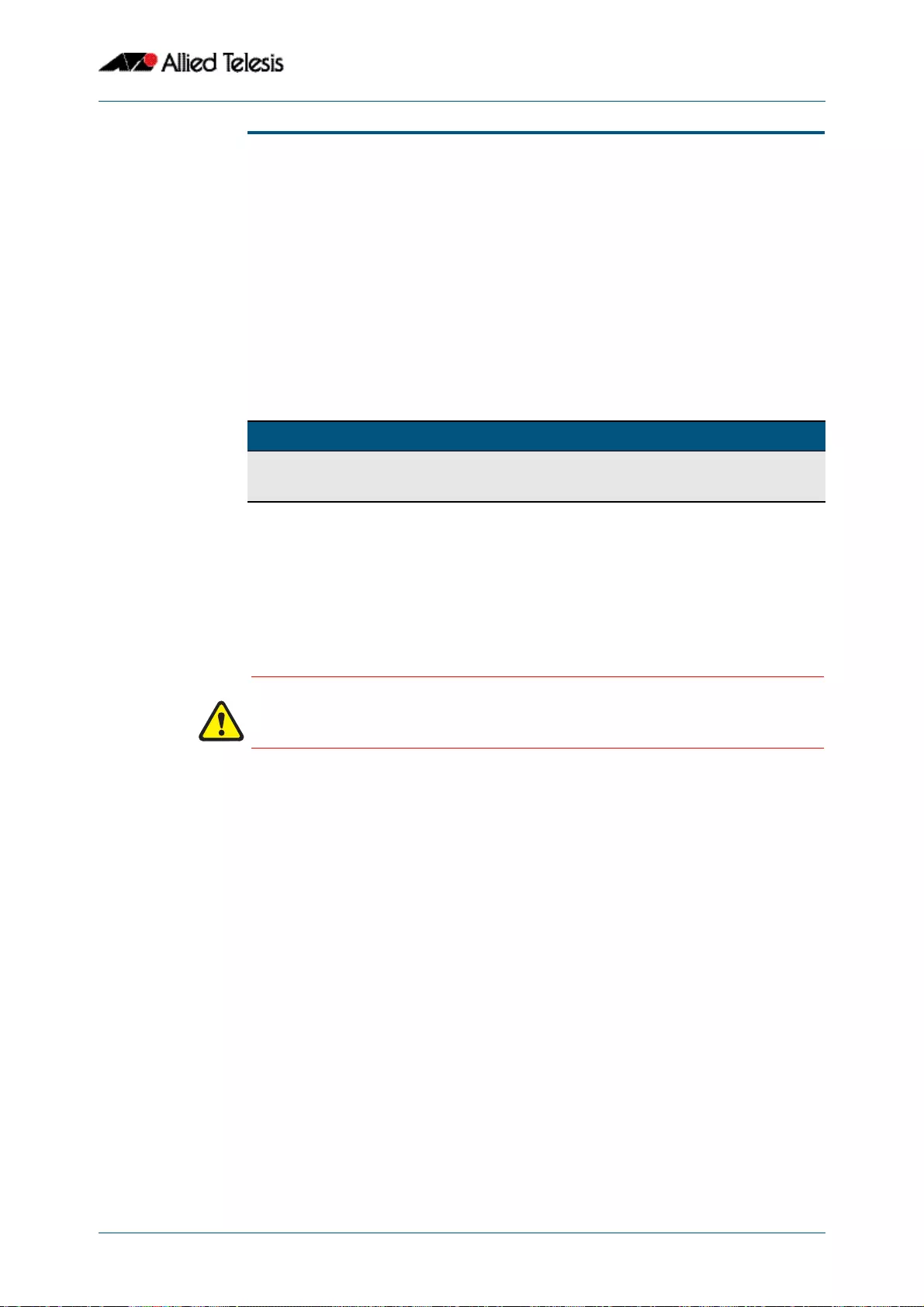
AMF Commands
Software Reference for GS900MX/MPX Series Switches
C613-50065-01 REV B AlliedWare PlusTM Operating System - Version 5.4.4E-1.x 61.27
atmf network-name
This command applies an AMF network name to a (prospective) AMF node. In order for an
AMF network to be valid, its network-name must be configured on at least two nodes, one
of which must be configured as a master and have an AMF License applied. These nodes
may be connected using either AMF downlinks or crosslinks.
For more information on configuring an AMF master node, see “atmf master” on
page 61.26.
Use the no variant of this command to remove the AMF network name.
Syntax atmf network-name <name>
no atmf network-name
Mode Global Configuration
Usage This is one of the essential commands when configuring AMF and must be entered on
each node that is to be part of the AMF. This command will not take effect until the
particular node is rebooted.
A switching node (master or member) may be a member of only one AMF network.
Example To set the AMF network name to amf_net use the command:
Parameter Description
<name> The AMF network name. Up to 15 printable characters
can be entered for the network-name.
Caution Ensure that you enter the correct network name. Entering an incorrect name will
cause the AMF network to fragment (at the next reboot).
Node_1(config)# atmf network-name amf_net

AMF Commands
Software Reference for GS900MX/MPX Series Switches
61.28 AlliedWare PlusTM Operating System - Version 5.4.4E-1.x C613-50065-01 REV B
atmf provision
This command configures a specified port on an AMF node to accept a provisioned node,
via an AMF link, some time in the future.
Use the no variant of this command to remove the provisioning on the node.
Syntax atmf provision [<nodename>]
no atmf provision
Default No provision.
Mode Interface Configuration
Usage The port should be configured as an AMF link or cross link and should be “down” to add or
remove a provisioned node.
Example To provision an AMF node named node1 for port1.0.1, use the command:
Related Commands switchport atmf-link
show atmf links
Parameter Description
<nodename> The name of the provisioned node that will appear on
the AMF network in the future.
host1(config)# interface port1.0.1
host1(config-if)# atmf provision node1

AMF Commands
Software Reference for GS900MX/MPX Series Switches
C613-50065-01 REV B AlliedWare PlusTM Operating System - Version 5.4.4E-1.x 61.29
atmf provision node clone
This command sets up a space on the backup media for use with a provisioned node and
copies into it almost all files and directories from a chosen backup or provisioned node.
Alternatively, you can set up a new, unique provisioned node by using the command atmf
provision node create.
Syntax atmf provision node <nodename> clone <source nodename>
Mode Privileged Exec
Usage This command is only available on master nodes in the AMF network.
You must run either this command or atmf provision node create command, before you
can use other “atmf provision node” commands using the specified node name. If a
backup or provisioned node already exists for the specified node then you must delete it
before using the atmf provision node clone command.
When using this command it is important to be aware of the following:
■A copy of <media>:atmf/<atmf_name>/nodes/<source_node>/flash will be made for
the provisioned node and stored in the backup media.
■The directory <node_backup_dir>/flash/.config/ssh is excluded from the copy.
■All contents of <root_backup_dir>/nodes/<nodename> will be deleted or
overwritten.
■Settings for the expected location of other provisioned nodes are excluded from the
copy.
The active and backup configuration files are automatically modified in the following
ways:
■The “hostname” command is modified to match the name of the provisioned node.
■The “stack virtual-chassis-id” command is removed, if present.
Example To copy from the backup of Switch2 to create backup files for the new provisioned node
Switch3 use the following command:
Figure 61-1: Sample output from the atmf provision node clone command
Parameter Description
<nodename> The name that will be assigned to the clone when
connected.
<source nodename> The name of the node whose configuration is to be
copied for loading to the clone.
switch1# atmf provision node switch3 clone switch2
switch1#atmf provision node switch3 clone switch2
Copying...
Successful operation

AMF Commands
Software Reference for GS900MX/MPX Series Switches
61.30 AlliedWare PlusTM Operating System - Version 5.4.4E-1.x C613-50065-01 REV B
To confirm that a new provisioned node has been cloned, use the command:
The output from this command is shown in Figure 61-2, below, and shows the details of
the new provisioned node switch3.
Figure 61-2: Sample output from the show atmf backup command
switch1# show atmf backup
switch1#show atmf backup
Scheduled Backup ...... Enabled
Schedule ............ 1 per day starting at 03:00
Next Backup Time .... 01 Jan 2014 03:00
Backup Bandwidth ...... Unlimited
Backup Media .......... USB (Total 7446.0MB, Free 7297.0MB)
Server Config .........
Synchronization ..... Unsynchronized
Last Run .......... -
1 .................. Unconfigured
2 .................. Unconfigured
Current Action ........ Idle
Started ............. -
Current Node ........ -
---------------------------------------------------------------
Node Name Date Time In ATMF On Media Status
---------------------------------------------------------------
switch3 - - No Yes Prov
switch1 01 Jan 2014 00:05:49 No Yes Good
switch2 01 Jan 2014 00:05:44 Yes Yes Good

AMF Commands
Software Reference for GS900MX/MPX Series Switches
C613-50065-01 REV B AlliedWare PlusTM Operating System - Version 5.4.4E-1.x 61.31
atmf provision node configure boot config
This command sets the configuration file to use during the next boot cycle. This command
can also set a backup configuration file to use if the main configuration file cannot be
accessed for an AMF provisioned node. To unset the boot configuration or the backup
boot configuration use the no boot command.
Use the no variant of this command to set back to the default.
Syntax atmf provision node <nodename> configure boot config [backup]
[<file-path|URL>]
atmf provision node [<nodename>] configure no boot config [backup]
Default No boot configuration files or backup configuration files are specified for the provisioned
node.
Mode Privileged Exec
Usage When using this command to set a backup configuration file, the specified AMF
provisioned node must exist. The specified file must exist in the flash directory created for
the provisioned node in the AMF remote backup media.
Examples To set the configuration file branch.cfg on the AMF provisioned node node1, use the
command:
To set the configuration file backup.cfg as the backup to the main configuration file on
the AMF provisioned node node1, use the command:
To unset the boot configuration, use the command:
To unset the backup boot configuration, use the command:
Related Commands atmf provision node configure boot system
show atmf provision nodes
Parameter Description
<nodename> The name of the provisioned node.
<file-path|URL> The path or URL and name of the configuration file.
MasterNodeName# atmf provision node node1 configure boot
config branch.cfg
MasterNodeName# atmf provision node node1 configure boot
config backup usb:/atmf/amf_net/nodes/node1/
config/backup.cfg
MasterNodeName# atmf provision node node1 configure no boot
config
MasterNodeName# atmf provision node node1 configure no boot
config backup

AMF Commands
Software Reference for GS900MX/MPX Series Switches
61.32 AlliedWare PlusTM Operating System - Version 5.4.4E-1.x C613-50065-01 REV B
atmf provision node configure boot system
This command sets the release file that will load onto a specified provisioned node during
the next boot cycle. This command can also set the backup release file to be loaded for an
AMF provisioned node. To unset the boot system release file or the backup boot release
file use the no boot command.
Use the no variant of this command to set back to the default.
This command can only be run on amf master nodes.
Syntax atmf provision node <nodename> configure boot system [backup]
[<file-path|URL>]
atmf provision node <nodename> configure no boot system [backup]
Default No boot release file or backup release files are specified for the provisioned node.
Mode Privileged Exec
Usage When using this command to set a backup release file, the specified AMF provisioned
node must exist. The specified file must exist in the flash directory created for the
provisioned node in the AMF remote backup media.
Examples To set the release file x900-5.4.4-1.rel on the AMF provisioned node node1, use
the command:
To set the backup release file 900-5.4.4-1.rel as the backup to the main release file
on the AMF provisioned node node1, use the command:
To unset the boot release, use the command:
To unset the backup boot release, use the command:
Related Commands atmf provision node configure boot config
show atmf provision nodes
Parameter Description
<nodename> The name of the provisioned node.
<file-path|URL> The path or URL and name of the release file.
MasterNodeName# atmf provision node node1 configure boot
system x900-5.4.4-1.rel
MasterNodeName# atmf provision node node1 configure boot
system backup card:/atmf/amf_net/nodes/
node1/flash/x900-5.4.4-1.rel
MasterNodeName# atmf provision node node1 configure no boot
system
MasterNodeName# atmf provision node node1 configure no boot
system backup

AMF Commands
Software Reference for GS900MX/MPX Series Switches
C613-50065-01 REV B AlliedWare PlusTM Operating System - Version 5.4.4E-1.x 61.33
atmf provision node create
This command sets up an empty directory on the backup media for use with a provisioned
node. This directory can have configuration and release files copied to it from existing
switches. Alternatively, the configuration files can be created by the user.
An alternative way to create a new provisioned node is with the command atmf provision
node clone.
This command can only run on amf master nodes.
Syntax atmf provision node <nodename> create
Mode Privileged Exec
Usage This command is only available on master nodes in the AMF network.
The atmf provision node create atmf command (or atmf provision node clone) must
be executed before you can use other “atmf provision node” commands with the specified
node name. If a backup or provisioned node already exists for the specified node name
then you must delete it before using this command.
A date and time is assigned to the new provisioning directory reflecting when this
command was executed. If there is a backup or provisioned node with the same name on
another AMF master then the most recent one will be used.
Example To create a new provisioned node named switch2 use the command:
Running this command will create the following directories:
■<media>:atmf/<atmf_name>/nodes/<node>
■<media>:atmf/<atmf_name>/nodes/<node>/flash
To confirm the new node’s settings, use the command:
The output for the show atmf backup command is shown in Figure 61-3, and shows
details for the new provisioned node switch2.
Parameter Description
<nodename> The name of the node that is being provisioned.
switch1# atmf provision node switch2 create
switch1# show atmf backup

AMF Commands
Software Reference for GS900MX/MPX Series Switches
61.34 AlliedWare PlusTM Operating System - Version 5.4.4E-1.x C613-50065-01 REV B
Figure 61-3: Sample output from the show atmf backup command
For instructions on how to configure on a provisioned node refer to “Configuring AMF”
on page 60.13 and “Creating and Using Configuration Files” on page 6.8.
Related commands atmf provision node clone
switch1#show atmf backup
Scheduled Backup ...... Enabled
Schedule ............ 1 per day starting at 03:00
Next Backup Time .... 02 Jan 2014 03:00
Backup Bandwidth ...... Unlimited
Backup Media .......... USB (Total 7446.0MB, Free 7315.2MB)
Server Config .........
Synchronization ..... Unsynchronized
Last Run .......... -
1 .................. Unconfigured
2 .................. Unconfigured
Current Action ........ Idle
Started ............. -
Current Node ........ -
---------------------------------------------------------------
Node Name Date Time In ATMF On Media Status
---------------------------------------------------------------
switch2 - - No Yes Prov
switch1 01 Jan 2014 00:05:49 No Yes Good

AMF Commands
Software Reference for GS900MX/MPX Series Switches
C613-50065-01 REV B AlliedWare PlusTM Operating System - Version 5.4.4E-1.x 61.35
atmf provision node delete
This command deletes files that have been created for loading onto a provisioned node. It
can only be run on master nodes.
Syntax atmf provision node <nodename> delete
Mode Privileged Exec
Usage This command is only available on master nodes in the AMF network. The command will
only work if the provisioned node specified in the command has already been set up
(although the device itself is still yet to be installed). Otherwise, an error message is shown
when the command is run.
You may want to use the atmf provision node delete command to delete a provisioned
node that was created in error or that is no longer needed.
This command cannot be used to delete backups created by the AMF backup procedure.
In this case, use the command atmf backup delete to delete the files.
Example To delete backup files for a provisioned node named switch3 use the command:
To confirm that the backup files for provisioned node switch3 have been deleted use the
command:
The output should show that the provisioned node switch3 no longer exists in the backup
file, as shown in Figure 61-4:
Parameter Description
<nodename> The name of the provisioned node to be deleted.
Note This command allows provisioned entries to be deleted even if they have been
referenced by the atmf provision command, so take care to only delete
unwanted entries.
switch1# atmf provision node switch3 delete
switch1# show atmf backup

AMF Commands
Software Reference for GS900MX/MPX Series Switches
61.36 AlliedWare PlusTM Operating System - Version 5.4.4E-1.x C613-50065-01 REV B
Figure 61-4: Sample output showing the show atmf backup command
Related commands atmf provision node create
switch1#show atmf backup
Scheduled Backup ...... Enabled
Schedule ............ 1 per day starting at 03:00
Next Backup Time .... 01 Jan 2014 03:00
Backup Bandwidth ...... Unlimited
Backup Media .......... USB (Total 7446.0MB, Free 7297.0MB)
Server Config .........
Synchronization ..... Unsynchronized
Last Run .......... -
1 .................. Unconfigured
2 .................. Unconfigured
Current Action ........ Idle
Started ............. -
Current Node ........ -
---------------------------------------------------------------
Node Name Date Time In ATMF On Media Status
---------------------------------------------------------------
switch1 01 Jan 2014 00:05:49 No Yes Good
switch2 01 Jan 2014 00:05:44 Yes Yes Good

AMF Commands
Software Reference for GS900MX/MPX Series Switches
C613-50065-01 REV B AlliedWare PlusTM Operating System - Version 5.4.4E-1.x 61.37
atmf provision node license-cert
This command is used to set up the license certificate for a provisioned node.
The certificate file usually has all the license details for the network, and can be stored
anywhere in the network. This command makes a hidden copy of the certificate file and
stores it in the space set up for the provisioned node on AMF backup media.
For node provisioning, the new device has not yet been part of the AMF network, so the
user is unlikely to know its product ID or its MAC address. When such a device joins the
network, assuming that this command has been applied successfully, the copy of the
certificate file will be applied automatically to the provisioned node.
Once the new device has been resurrected on the network and the certificate file has been
downloaded to the provisioned node, the hidden copy of the certificate file is deleted
from AMF backup media.
Use the no variant of this command to set it back to the default.
This command can only be run on amf master nodes.
Syntax atmf provision node {<nodename>} license-cert <file-path|URL>
no atmf provision node {<nodename>} license-cert
Default No license certificate file is specified for the provisioned node.
Mode Privileged Exec
Usage This command is only available on master nodes in the AMF network. It will only operate if
the provisioned node specified in the command has already been set up, and if the license
certification is present in the backup file. Otherwise, an error message is shown when the
command is run.
Example 1 To apply the license certificate cert1.txt stored on tftp server for AMF provisioned node
“Switch2”, use the command:
Example 2 To apply the license certificate cert2.txt stored on AMF master's flash directory for AMF
provisioned node “host2”, use the command:
To confirm that the license certificate has been applied to the provisioned node, use the
command show atmf provision nodes. The output from this command is shown
Figure 61-5 below, and displays license certification details in the last line.
Parameter Description
<nodename> The name of the provisioned node.
<file-path|URL> The name of the certificate file. This can include the
file-path of the file.
switch1# atmf provision node switch2 license-cert
tftp://192.168.1.1/cert1.txt
switch1# atmf provision node switch2 license-cert/
cert2.txt

AMF Commands
Software Reference for GS900MX/MPX Series Switches
61.38 AlliedWare PlusTM Operating System - Version 5.4.4E-1.x C613-50065-01 REV B
Figure 61-5: Sample output from the show atmf provision nodes command
Related commands show atmf provision nodes
switch1#show atmf provision nodes
ATMF Provisioned Node Information:
Backup Media .............: SD (Total 3827.0MB, Free 3481.1MB)
Node Name : switch2
Date & Time : 06-May-2014 & 23:25:44
Provision Path : card:/atmf/nodes
Boot configuration :
Current boot image : x510-1766_atmf_backup.rel (file exists)
Backup boot image : x510-main-20140113-2.rel (file exists)
Default boot config : flash:/default.cfg (file exists)
Current boot config : flash:/abc.cfg (file exists)
Backup boot config : flash:/xyz.cfg (file exists)
Software Licenses :
Repository file : ./.configs/.sw_v2.lic
: ./.configs/.swfeature.lic
Certificate file : card:/atmf/lok/nodes/awplus1/flash/.atmf-lic-cert
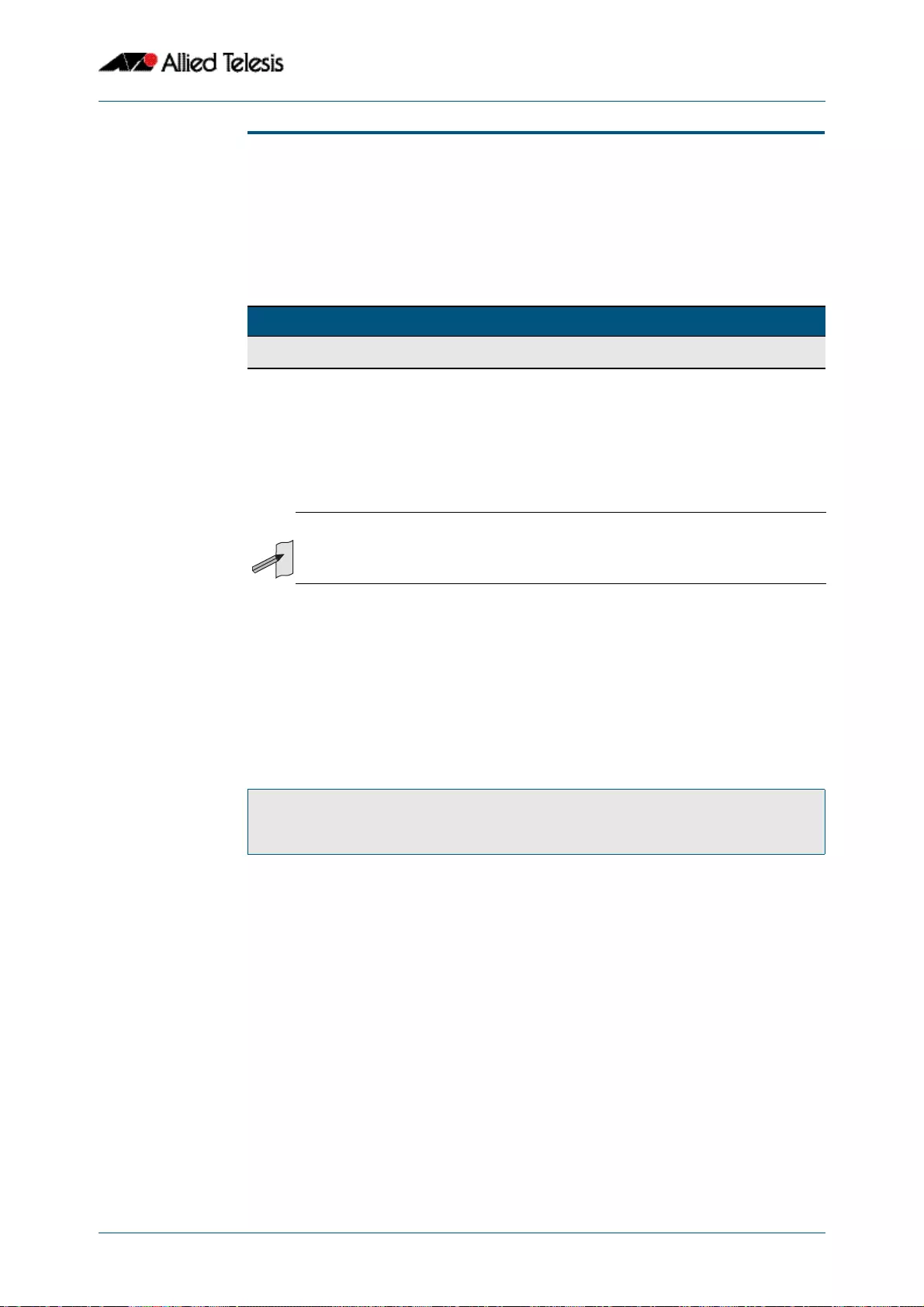
AMF Commands
Software Reference for GS900MX/MPX Series Switches
C613-50065-01 REV B AlliedWare PlusTM Operating System - Version 5.4.4E-1.x 61.39
atmf provision node locate
This command changes the present working directory to the directory of a provisioned
node. This makes it easier to edit files and create a unique provisioned node in the backup.
This command can only be run on amf master nodes.
Syntax atmf provision node <nodename> locate
Mode Privileged Exec
Usage This command is only available on master nodes in the AMF network.The command will
only work if the provisioned node specified in the command has already been set up.
Otherwise, an error message is shown when the command is run.
Example To change the working directory that happens to be on switch1 to the directory of
provisioned node switch2, use the following command:
The directory of the node switch2 should now be the working directory. You can use the
command pwd to check this, as shown in the following figure.
Figure 61-6: Sample output from the pwd command
The output above shows that the working directory is now the flash of switch2.
Related commands atmf provision node create
atmf provision node clone
pwd
Parameter Description
<nodename> The name of the provisioned node.
Note We advise that after running this command, you return to a known working
directory, typically flash.
switch1# atmf provision node switch2 locate
switch2#pwd
card:/atmf/building_2/nodes/switch2/flash

AMF Commands
Software Reference for GS900MX/MPX Series Switches
61.40 AlliedWare PlusTM Operating System - Version 5.4.4E-1.x C613-50065-01 REV B
atmf reboot-rolling
This command enables you to reboot the nodes in an AMF working-set, one at a time, as a
rolling sequence in order to minimize downtime. Once a rebooted node has finished
running its configuration and its ports are up, it re-joins the AMF network and the next
node is rebooted.
By adding the url parameter, you can also upgrade your switches’ software one AMF node
at a time.
The force command enforces a node reboot even if a previous node does not rejoin the
AMF network. In this situation the unsuitable node will time-out and the rolling reboot
process stops. However, with the force parameter applied, the process will ignore the
timeout and move on to reboot the next node in the sequence.
This command can take a significant amount of time to complete.
Syntax atmf reboot-rolling [force] [<url>]
Mode Privileged Exec
Usage You can load the software from a variety of locations. The latest compatible release for a
node will be selected from your selected location - based on the parameters and URL you
have entered.
For example card:/5.4.3/x*-5.4.3-*.rel will select from the folder card:/5.4.3 the latest file
that matches the selection x (wildcard) -5.4.3-(wildcard).rel. Because x* is applied, each
switch type will be detected and its appropriate release file will be installed.
Other allowable entries are:
■card:*.rel:
Used when loading SW from SD cards.
■tftp:ip address:
Used when loading SW from a TFTP server.
■usb:
Used when loading SW from a USB flash drive.
■flash:
Used when loading SW from flash memory, i.e. from one x900 switch to another.
■scp:
Used when loading SW from a secure copy.
■http:
Used when loading SW from an HTTP file server site.
Parameter Description
force Ignore a failed node and move on to the next node. Where a
node fails to reboot a timeout is applied based on the time
taken during the last reboot.
<url>The url path to the software upgrade file.

AMF Commands
Software Reference for GS900MX/MPX Series Switches
C613-50065-01 REV B AlliedWare PlusTM Operating System - Version 5.4.4E-1.x 61.41
Several checks are performed to ensure the upgrade will succeed. These include checking
the current node release boots from flash. If there is enough space on flash, the software
release is copied to flash to a new location on each node as it is processed. The new
release name will be updated using the “boot system <release-name>” command, and the
old release will become the backup release file.
On bootup the software release is verified. Should an upgrade fail, the upgrading unit will
revert back to its previous software version. At the completion of this command, a report
is run showing the release upgrade status of each node.
Example 1 To reboot all x510 nodes in an AMF network, use the following command:
This command returns the following type of screen output:
Note If you are using TFTP or HTTP, for example, to access a file on a remote device
then the URL should specify the exact release filename without using wild card
characters.
Note Take care when removing external media or rebooting your switches. Removing
an external media while files are being written entails a significant risk of causing
a file corruption.
Bld2_Floor_1# atmf working-set group x510
===================
node1, node2, node3:
=====================
Working set join
AMF_NETWORK_Name[3]#
ATMF_NETWORK[3]# atmf reboot-rolling

AMF Commands
Software Reference for GS900MX/MPX Series Switches
61.42 AlliedWare PlusTM Operating System - Version 5.4.4E-1.x C613-50065-01 REV B
When the reboot has completed, a number of status screens appear. The selection of
these screens will depend on the parameters set.
Bld2_Floor_1#atmf working-set group x510
=============================
SW_Team1, SW_Team2, SW_Team3:
=============================
Working set join
ATMF_NETWORK[3]#atmf reboot-rolling
ATMF Rolling Reboot Nodes:
Timeout
Node Name (Minutes)
-----------------------------
SW_Team1 14
SW_Team2 8
SW_Team3 8
Continue the rolling reboot ? (y/n):y
==================================================
ATMF Rolling Reboot: Rebooting SW_Team1
==================================================
% SW_Team1 has left the working-set
Reboot of SW_Team1 has completed
==================================================
ATMF Rolling Reboot: Rebooting SW_Team2
==================================================
% SW_Team2 has left the working-set
Reboot of SW_Team2 has completed
==================================================
ATMF Rolling Reboot: Rebooting SW_Team3
==================================================
% SW_Team3 has left the working-set
Reboot of SW_Team3 has completed
==================================================
ATMF Rolling Reboot Complete
Node Name Reboot Status
-----------------------------------
SW_Team1 Rebooted
SW_Team2 Rebooted
SW_Team3 Rebooted
==================================================

AMF Commands
Software Reference for GS900MX/MPX Series Switches
C613-50065-01 REV B AlliedWare PlusTM Operating System - Version 5.4.4E-1.x 61.43
Example 2 To update firmware releases, use the following command:
.
Node_1# atmf working-set group all
ATMF_NETWORK[9]# atmf reboot-rolling card:/5.4.3/x*-5.4.3-*.rel
ATMF Rolling Reboot Nodes:
Timeout
Node Name (Minutes) New Release File Status
--------------------------------------------------------------
SW_Team1 8 x510-5.4.3-0.5.rel Release Ready
SW_Team2 10 x510-5.4.3-0.5.rel Release Ready
SW_Team3 8 --- Not Supported
HW_Team1 6 --- Incompatible
Bld2_Floor_1 6 x900-5.4.3-0.5.rel Release Ready
Bld1_Floor_2 2 x610-5.4.3-0.5.rel Release Ready
Bld1_Floor_1 4 --- Incompatible
Building_1 2 --- Incompatible
Building_2 2 x900-5.4.3-0.5.rel Release Ready
Continue upgrading releases ? (y/n):

AMF Commands
Software Reference for GS900MX/MPX Series Switches
61.44 AlliedWare PlusTM Operating System - Version 5.4.4E-1.x C613-50065-01 REV B
atmf recover
This command is used to manually initiate the recovery (or replication) of an AMF node,
usually when a node is being replaced. The recovery/replication process involves loading
the configuration file for a node that is either about to be replaced or has experienced
some problem. The configuration file of the device being replaced is selected by the
nodename parameter, and the master node holding the configuration file is specified by
the parameter <master-nodename>.
If the <nodename> parameter is not entered then the node will attempt to use one that
has been previously configured. If the replacement node has no previous configuration
(and has no previously used nodename), then the recovery will fail.
If the <master-nodename> parameter is not specified then the device will poll all known
AMF masters and execute an election process (based on the last successful backup and its
timestamp) to determine which master node to use. If no valid backup master is found,
then this command will fail.
Syntax atmf recover [<nodename> <master-nodename>]
Mode Privileged Exec
Usage No error checking occurs when this command is run, and regardless of the last backup
status, the recovering node will attempt to load its configuration from the master node
specified by the master-nodename parameter.
Note that if the node has previously been configured, we recommend that you suspend
any AMF backup before running this command. This is to prevent corruption of the
backup files on the AMF master as it attempts to both backup and recover the node at the
same time.
Example To recover the AMF node named Node_10 from the AMF master node named Master_2,
use the following command:
Related Commands atmf backup stop
show atmf backup
show atmf
Parameter Description
<nodename>The name of the device whose configuration is to be
recovered or replicated.
<master-nodename>The name of the master device that holds the required
configuration information.
Note that although you can omit both the nodename and
the master nodename; you can only omit the master
nodename if you also omit the nodename.
Master_2# atmf recover Node_10 Master_2

AMF Commands
Software Reference for GS900MX/MPX Series Switches
C613-50065-01 REV B AlliedWare PlusTM Operating System - Version 5.4.4E-1.x 61.45
atmf recover led-off
This command turns off the recovery failure flashing port LEDs. It reverts the LED’s
function to their normal operational mode, and in doing so assists with resolving the
recovery problem. You can repeat this process until the recovery failure has been resolved.
For more detailed information see “Recovery progress indication” on page 60.32.
Syntax atmf recover led-off
Default Normal operational mode
Mode Privileged Exec
Example To revert the LEDs on Node1 from recovery mode display, to their normal operational
mode, use the command:
Related Commands atmf recover
Node1# atmf recover led-off

AMF Commands
Software Reference for GS900MX/MPX Series Switches
61.46 AlliedWare PlusTM Operating System - Version 5.4.4E-1.x C613-50065-01 REV B
atmf remote-login
Use this command to remotely login to other AMF nodes in order to run commands as if
you were a local user of that node.
Syntax atmf remote-login [user <name>] <nodename>
Mode Privileged Exec (This command will only run at privilege level 15)
Usage You do not need a valid login on the local device in order to run this command. The
session will take you to the enable prompt on the new device. If the remote login session
exits for any reason (i.e. device reboot) you will be returned to the originating node.
The software will not allow you to run multiple remote login sessions. You must exit an
existing session before starting a new one.
Example 1 To remotely login from node Node10 to Node20 use the following command:
Example 2 In this example, user Whitney is a valid user of node5. She can remotely login from node5
to node3 by using the following commands:
Parameter Description
<name> User name.
<nodename> Node name.
Node10# atmf remote-login node20
node5# atmf remote-login user whitney
node3
Type 'exit' to return to node5#
node3> enable
Note In the above example the user name whitney is valid on both nodes.
Therefore, to prevent unauthorized access, user names should be unique across
all nodes within the AMF network.

AMF Commands
Software Reference for GS900MX/MPX Series Switches
C613-50065-01 REV B AlliedWare PlusTM Operating System - Version 5.4.4E-1.x 61.47
atmf restricted-login
This command restricts the use of the “atmf working-set” on page 61.48 command on
all AMF master nodes to privilege 15 users only. Once entered on any AMF master node,
this command will propagate across the network.
Note that once you have run this command, certain other commands that utilize the AMF
working-set command, such as the include, atmf reboot-rolling and show atmf group
members commands, will operate only on master nodes.
Use the no variant of this command to disable restricted login on the AMF network. This
allows access to the atmf working-set command from any node in the AMF network.
Syntax atmf restricted-login
no atmf restricted-login
Mode Privileged Exec
Default Master nodes operate with atmf restricted-login disabled.
Member nodes operate with atmf restricted-login enabled.
Example To enable restricted login, use the command
Validation
Command
show atmf
Note The default conditions of this command vary from those applied by its “no”
variant. This is because the restricted-login action is only applied by master
nodes, and in the absence of a master node, the default is to apply the restricted
action to all member nodes with AMF configured.
In the presence of a master node, its default of “atmf restricted-login disabled”
will permeate to all its member nodes. Similarly, any change in this command’s
status that is made on a master node, will also permeate to all its member nodes
Node_20(config)# atmf restricted-login node20

AMF Commands
Software Reference for GS900MX/MPX Series Switches
61.48 AlliedWare PlusTM Operating System - Version 5.4.4E-1.x C613-50065-01 REV B
atmf working-set
The AMF working-set command enables you to execute commands across an individually
listed set (or preselected group) of AMF nodes. Group selection is made using the atmf
group (membership) command on page 61.19.
This command opens a session on multiple network devices. When you change the
working set to anything other than the local device, the prompt will change to the AMF
network name, followed by the size of the working set, shown in square brackets. This
command has to be run at privilege level 15.
In addition to the user defined groups, the following system assigned groups are
automatically created:
■Implicit Groups
« all - All nodes in the AMF
« current - All nodes that comprise the current working-set
« local - The originating node.
■Automatic Groups - These can be defined by hardware architecture, e.g. x510, x610,
x900, x8100, or by certain AMF nodal designations such as master.
Note that the Implicit Groups do not appear in show group output.
If a node is an AMF master it will be automatically added to the master group.
Syntax atmf working-set {[<node-list>][group{<group-list>|all|local|
current}]}
Default Needs to be entered
Mode Privileged Exec
Example 1 To add all nodes in the AMF to the working-set, use the command:
Parameter Description
<node-list> A comma delimited list (without spaces) of nodes to be included
in the working-set.
group The AMF group.
<group-list> A comma delimited list (without spaces) of groups to be included
in the working-set. Note that this can include either defined
groups, or any of the Automatic, or Implicit Groups shown earlier
in the bulleted list of groups.
all All nodes in the AMF.
local Local node
Running this command with the parameters group local will
return you to the local prompt and local node connectivity.
current Nodes in current list.
node1# atmf working-set group all

AMF Commands
Software Reference for GS900MX/MPX Series Switches
C613-50065-01 REV B AlliedWare PlusTM Operating System - Version 5.4.4E-1.x 61.49
This command displays an output screen similar to the one shown below:
Example 2 To return to the local prompt, and connectivity to only the local node; use the command:
clear atmf links statistics
This command resets the values of all AMF link, port, and global statistics to zero.
Syntax clear atmf links statistics
Mode Privilege Exec
Example To reset the AMF link statistics values, use the command:
Related Commands show atmf links statistics
Note This command adds the implicit group “all” to the working set, where “all”
comprises all nodes in the AMF.
=========================================
node1, node2, node3, node4, node5, node6:
==============================================
Working set join
ATMF_NETWORK_Name[6]#
ATMF_NETWORK_Name[6]# atmf working-set group local
node1#
Parameter Description
node1, node2 The name of the nodes - as set by the hostname command on page
8.17.
ATMF_Network_Name The name of the AMF network - as set by the atmf network-name
command on page 61.27.
[6] The number of nodes in the working-set.
node_1# clear atmf links statistics

AMF Commands
Software Reference for GS900MX/MPX Series Switches
61.50 AlliedWare PlusTM Operating System - Version 5.4.4E-1.x C613-50065-01 REV B
debug atmf
This command enables the AMF debugging facilities, and displays information that is
relevant (only) to the current node. The detail of the debugging displayed depends on the
parameters specified.
If no additional parameters are specified, then the command output will display all AMF
debugging information, including link events, topology discovery messages and all
notable AMF events.
The “no” variant of this command disables either all AMF debugging information, or only
the particular information as selected by the command’s parameters.
Syntax debug atmf [link|crosslink|database|neighbor|error|all]
no debug atmf [link|crosslink|database|neighbor|error|all]
Default All debugging facilities are disabled.
Mode User Exec and Global Configuration
Usage If no additional parameters are specified, then the command output will display all AMF
debugging information, including link events, topology discovery messages and all
notable AMF events.
Examples To debug all AMF debugging, use the command:
To debug all AMF link debugging, use the command:
To debug all AMF crosslink debugging, use the command:
Parameter Description
link Output displays debugging information relating to uplink or
downlink information.
crosslink Output displays all crosslink events.
database Output displays only notable database events.
neighbor Output displays only notable AMF neighbor events.
error Output displays AMF error events.
all Output displays all AMF events.
Note An alias to the no variant of this command is “undebug atmf” on
page 61.92.
node_1# debug atmf
node_1# debug atmf link
node_1# debug atmf crosslink

AMF Commands
Software Reference for GS900MX/MPX Series Switches
C613-50065-01 REV B AlliedWare PlusTM Operating System - Version 5.4.4E-1.x 61.51
To debug all AMF database debugging, use the command:
To debug all AMF neighbor debugging, use the command:
To debug all AMF error debugging, use the command:
To debug all AMF facilities, use the command:
Related Commands no debug all
node_1# debug atmf database
node_1# debug atmf neighbor
node_1# debug atmf error
node_1# debug atmf all

AMF Commands
Software Reference for GS900MX/MPX Series Switches
61.52 AlliedWare PlusTM Operating System - Version 5.4.4E-1.x C613-50065-01 REV B
debug atmf packet
This command configures AMF Packet debugging parameters. The debug only displays
information relevant to the current node. The command has following parameters:
Syntax debug atmf packet[[direction {rx|tx|both}][level {1|2|3}][timeout
<seconds>][num-pkts <quantity>][filter node <name> ][interface
<ifname>][pkt-type {[1][2][3][4][5][6][7][8][9][10][11]]]
Simplified Syntax
Default Level 1, both Tx and Rx, a timeout of 60 seconds with no filters applied.
Mode User Exec and Global Configuration
Usage If no additional parameters are specified, then the command output will apply a default
selection of parameters shown below:
debug atmf packet [direction {rx|tx|both}]
[level {[1][2|3}]
[timeout <seconds>]
[num-pkts <quantity>]
debug atmf packet filter [node <name>]
[interface <ifname>]
[pkt-type [1][2][3][4][5][6][7][8][9][10][11]]
Note You can combine the syntax components shown, but when doing so, you
must retain their original order.
Note An alias to the no variant of this command - undebug atmf - can be found
elsewhere in this chapter.
Parameter Description
direction Sets debug to packet received, transmitted, or both
rx packets received by this node
tx Packets sent from this node
1AMF Packet Control header Information, Packet Sequence
Number. Enter 1 to select this level.
2AMF Detailed Packet Information. Enter 2 to select this level.
3AMF Packet HEX dump. Enter 3 to select this level.
timeout Sets the execution timeout for packet logging
<seconds> Seconds
num-pkts Sets the number of packets to be dumped

AMF Commands
Software Reference for GS900MX/MPX Series Switches
C613-50065-01 REV B AlliedWare PlusTM Operating System - Version 5.4.4E-1.x 61.53
pkts The actual number of packets
filter Sets debug to filter packets
node Sets the filter on packets for a particular Node
<name> The name of the remote node
interface Sets the filter to dump packets from an interface (portx.x.x) on the
local node
ifname Interface port or virtual-link
pkt-type Sets the filter on packets with a particular AMF packet type
1Crosslink Hello BPDU packet with crosslink links information. Enter
1 to select this packet type.
2Crosslink Hello BPDU packet with downlink domain information.
Enter 2 to select this packet type.
3Crosslink Hello BPDU packet with uplink information. Enter 3 to
select this packet type.
4Downlink and uplink hello BPDU packets. Enter 4 to select this
packet type.
5Non broadcast hello unicast packets. Enter 5 to select this packet
type.
6Stack hello unicast packets. Enter 6 to select this packet type.
7Database description. Enter 7 to select this packet type.
8DBE request. Enter 8 to select this packet type.
9DBE update. Enter 9 to select this packet type.
10 DBE bitmap update. Enter 10 to select this packet type.
11 DBE acknowledgment. Enter 11 to select this packet type.
Parameter Description

AMF Commands
Software Reference for GS900MX/MPX Series Switches
61.54 AlliedWare PlusTM Operating System - Version 5.4.4E-1.x C613-50065-01 REV B
Examples To set a packet debug on node 1 with level 1 and no timeout, use the command:
To set a packet debug with level 3 and filter packets received from AMF node 1:
To enable send and receive 500 packets only on vlink1 for packet types 1, 7, and 11, use
the command:
This example applies the debug atmf packet command and combines many of its options:
node_1# debug atmf packet direction tx timeout 0
node_1# debug atmf packet direction tx level 3 filter
node_1
node_1# debug atmf packet num-pkts 500 filter interface
vlink1 pkt-type 1 7 11
node_1# debug atmf packet direction rx level 1 num-pkts
60 filter node x900 interface port1.0.1 pkt-
type 4 7 10

AMF Commands
Software Reference for GS900MX/MPX Series Switches
C613-50065-01 REV B AlliedWare PlusTM Operating System - Version 5.4.4E-1.x 61.55
erase factory-default
This command erases all data from NVS and all data from flash excluding the following:
■The current release file and its /flash/.release file
■The backup release file and /flash/.backup file
■v1 license files /flash/.configs/.swfeature.lic
■v2 license files /flash/.configs/.sw_v2.lic
The device is then rebooted and returns the switch to its factory default condition. The
switch can then be used for automatic node recovery.
Syntax erase factory-default
Mode Global Configuration.
Usage This command is an alias to the atmf cleanup command on page 61.14.
Example To erase data, use the command:
Related Commands atmf cleanup
Node_1(config)# erase factory-default
This command will erase all NVS, all flash contents except
for the boot release, and any license files, and then
reboot the switch. Continue? (y/n):y

AMF Commands
Software Reference for GS900MX/MPX Series Switches
61.56 AlliedWare PlusTM Operating System - Version 5.4.4E-1.x C613-50065-01 REV B
show atmf
Displays information about the current AMF node.
Syntax show atmf [summary|tech|nodes|session]
Default Only summary information is displayed.
Mode User Exec and Privileged Exec
Usage AMF uses internal VLANs to communicate between nodes about the state of the AMF
network. Two VLANs have been selected specifically for this purpose. Once these have
been assigned, they are reserved for AMF and cannot be used for other purposes
Example 1 To show summary information on AMF node_1 use the following command:
The following figure shows some example output from running this command for a
specific AMF node.
Example 2 To show information specific to AMF nodes use the following command:
Parameter Description
summary Displays summary information about the current AMF node.
tech Displays global AMF information.
nodes Displays a list of AMF nodes together with brief details.
session Displays information on an AMF session.
node_1 show atmf summary
Figure 61-7: Output from the show atmf summary command
node_1#show atmf
ATMF Summary Information:
ATMF Status : Enabled
Network Name : ATMF_NET
Node Name : node_1
Role : Master
Current ATMF Nodes : 8
node_1 show atmf nodes

AMF Commands
Software Reference for GS900MX/MPX Series Switches
C613-50065-01 REV B AlliedWare PlusTM Operating System - Version 5.4.4E-1.x 61.57
The show amf session command displays all CLI (Command Line Interface) sessions for
users that are currently logged in and running a CLI session. For example, in the case
below, node_1 and node5 have active users logged in.
Example 3 To display AMF active sessions, use the following command:
Figure 61-8: Output from the show atmf nodes command
Node Information:
* = Local device
SC = Switch Configuration:
C = Chassis S = Stackable N = Standalone
Node Device AMF Node
Name Type Master SC Parent Depth
--------------------------------------------------------------------------------
Building_1 AT-SBx8112 Y C - 0
* Building_2 x900-12XT/S Y N - 0
Bld1_Floor_1 SwitchBlade x908 N S Building_1 1
Bld1_Floor_2 x600-24Ts/XP N N Building_1 1
Bld2_Floor_1 x610-24Ts-POE+ N N Building_1 1
SW_Team1 x510-28GPX N N Bld1_Floor_2 2
Current AMF node count 8
node_1 show atmf session
Figure 61-9: Output from the show atmf session command
node_1#show atmf session
CLI Session Neighbors
Session ID : 73518
Node Name : node_1
PID : 7982
Link type : Broadcast-cli
MAC Address : 0000.0000.0000
Options : 0
Our bits : 0
Link State : Full
Domain Controller : 0
Backup Domain Controller : 0
Database Description Sequence Number : 00000000
First Adjacency : 1
Number Events : 0
DBE Retransmit Queue Length : 0
DBE Request List Length : 0
Session ID : 410804
Node Name : node5
PID : 17588
Link type : Broadcast-cli
MAC Address : 001a.eb56.9020
Options : 0
Our bits : 0
Link State : Full
Domain Controller : 0
Backup Domain Controller : 0
Database Description Sequence Number : 00000000
First Adjacency : 1
Number Events : 0
DBE Retransmit Queue Length : 0
DBE Request List Length : 0

AMF Commands
Software Reference for GS900MX/MPX Series Switches
61.58 AlliedWare PlusTM Operating System - Version 5.4.4E-1.x C613-50065-01 REV B
The AMF tech command collects all the AMF commands, and displays them. You can use
this command when you want to see an overview of the AMF network.
Example 4 To display AMF technical information, use the following command:
node_1 show atmf tech
Figure 61-10: Output from the show atmf tech command
node_1#show atmf tech
ATMF Summary Information:
ATMF Status : Enabled
Network Name : ATMF_NET
Node Name : node_1
Role : Master
Current ATMF Nodes : 8
ATMF Technical information:
Network Name : ATMF_NET
Domain : node_1's domain
Node Depth : 0
Domain Flags : 0
Authentication Type : 0
MAC Address : 0014.2299.137d
Board ID : 287
Domain State : DomainController
Domain Controller : node_1
Backup Domain Controller : node2
Domain controller MAC : 0014.2299.137d
Parent Domain : -
Parent Domain Controller : -
Parent Domain Controller MAC : 0000.0000.0000
Number of Domain Events : 0
Crosslink Ports Blocking : 0
Uplink Ports Waiting on Sync : 0
Crosslink Sequence Number : 7
Domains Sequence Number : 28
Uplink Sequence Number : 2
Number of Crosslink Ports : 1
Number of Domain Nodes : 2
Number of Neighbors : 5
Number of Non Broadcast Neighbors : 3
Number of Link State Entries : 1
Number of Up Uplinks : 0
Number of Up Uplinks on This Node : 0
DBE Checksum : 84fc6
Number of DBE Entries : 0
Management Domain Ifindex : 4391
Management Domain VLAN : 4091
Management ifindex : 4392
Management VLAN : 4092
Table 61-1: Parameter definitions from the show atmf tech command
Parameter Definition
ATMF Status The Node’s AMF status, either Enabled or Disabled.
Network Name The AMF network that a particular node belongs to.
Node Name The name assigned to a particular node.
Role The role configured for this AMF device, either Master or Member.
Current ATMF Nodes The count of AMF nodes in an AMF Network.
Node Address An Address used to access a remotely located node (.atmf).

AMF Commands
Software Reference for GS900MX/MPX Series Switches
C613-50065-01 REV B AlliedWare PlusTM Operating System - Version 5.4.4E-1.x 61.59
Related Commands show atmf detail
Node ID A Unique identifier assigned to a Node on an AMF network.
Node Depth The number of nodes in path from this node to level of the AMF root node. It can be thought
of as the vertical depth of the AMF network from a particular node to the zero level of the AMF
root node.
Domain State The state of Node in a Domain in AMF network as Controller/Backup.
Recovery State The AMF node recovery status. Indicates whether a node recovery is in progress on this device
- Auto, Manual, or None.
Management VLAN The VLAN created for traffic between Nodes of different domain (up/down links).
■VLAN ID - In this example VLAN 4092 is configured as the Management VLAN.
■Management Subnet - Network prefix for the subnet.
■Management IP Address - The IP address allocated for this traffic.
■Management Mask - The subnet mask used to create a subnet for this traffic
(255.255.128.0).
Domain VLAN The VLAN assigned for traffic between Nodes of same domain (crosslink).
■VLAN ID - In this example VLAN 4091 is configured as the domain VLAN.
■Domain Subnet. The subnet address used for this traffic.
■Domain IP Address. The IP address allocated for this traffic.
■Domain Mask. The subnet mask used to create a subnet for this traffic
(255.255.128.0).
Device Type The Product Series Name.
ATMF Master The 'Y' if the node belongs to a Core domain.
SC The Switch Configuration, C - Chassis(SBx81series), S - Stackable (VCS) and N - Standalone.
Parent The a Node to which the current node has an active uplink.
Node Depth The the number of nodes in path from this node to the Core domain.
Table 61-1: Parameter definitions from the show atmf tech command (cont.)
Parameter Definition
Note You can manage your show output, or make it a more selective, by using a command
modifier. For information on using show-command modifiers see “Controlling “show”
Command Output” on page 1.35.

AMF Commands
Software Reference for GS900MX/MPX Series Switches
61.60 AlliedWare PlusTM Operating System - Version 5.4.4E-1.x C613-50065-01 REV B
show atmf backup
This command displays information about AMF backup status for all the nodes in an AMF
network. It can only be run on AMF master nodes.
Syntax show atmf backup [logs|server-status|synchronize [logs]]
Mode Privileged Exec
Example 1 To display the AMF backup information, use the command:
Parameter Description
logs Displays detailed log information.
server-status Displays connectivity diagnostics information for each
configured remote file server.
synchronize Display the file server synchronization status
logs For each remote file server, display the logs for the last
synchronization
node_1# show atmf backup
Node_1# show atmf backup
ScheduledBackup ......Enabled
Schedule............1 per day starting at 03:00
Next Backup Time....19 May 2012 03:00
Backup Media..........SD (Total 1974.0 MB, Free197.6MB)
Current Action........Starting manual backup
Started...............18 May 2012 10:08
CurrentNode...........atmf_testbox1
Node Name Date Time In ATMF Status
--------------------------------------------------------------------------------
atmf_testbox1 17May 2014 09:58:59 Yes Errors
atmf_testbox2 17May 2014 10:01:23 Yes Good
Node_1#show atmf backup logs
Log File Location: card:/atmf/office/logs/rsync_<nodename>.log
Node
Name Log Details------------------------------------------------------------------
atmf_testbox2
2014/05/22 03:41:32 [30299]File list size: 6199
2014/05/22 03:41:32 [30299]File list generation time: 0.011 seconds
2014/05/22 03:41:32 [30299]File list transfer time: 0.000 seconds
2014/05/22 03:41:32 [30299]Total bytes sent: 696
2014/05/22 03:41:32 [30299]Total bytes received: 16.03K
2014/02/20 03:41:32 [30299]sent 696 bytes rece ived 16.03Kbytes 33.45 K
bytes/sec
2014/05/22 03:41:32 [30299]total size is 21.73M speedup is 1298.93
2014/05/22 03:41:32 [30297]sent 626 bytes received 6203 bytes total
size 43451648

AMF Commands
Software Reference for GS900MX/MPX Series Switches
C613-50065-01 REV B AlliedWare PlusTM Operating System - Version 5.4.4E-1.x 61.61
Example 2 To display the AMF backup information with the optional parameter server-status,
use the command:
Node_1# show atmf backup server-status
Node1#sh atmf backup server-status
Id Last Check State
-------------------------------------
1 186 s File server ready
2 1 s SSH no route to host
Table 61-2: Parameter definitions from the show atmf backup server-status command
Parameter Definition
Scheduled Backup Indicates whether AMF backup scheduling is enabled or disabled.
Schedule Displays the configured backup schedule.
Next Backup Time Displays the date and time of the next scheduled.
Backup Media The current backup medium in use. This will be one of USB, SD, or NONE. Note that the USB will
take precedence over the SD card. Utilized and available memory (MB) will be indicated if
backup media memory is present.
Current Action The task that the AMF backup mechanism is currently performing. This will be a combination
of either (Idle, Starting, Doing, Stopping), or (manual, scheduled).
Started The date and time that the currently executing task was initiated in the format DD MMM YYYY.
Current Node The name of the node that is currently being backed up.
Node Name The name of the node that is storing backup data - on its backup media.
Date The data of the last backup in the format DD MMM YYYY.
Time The time of the last backup in the format HH:MM:SS.
In ATMF Whether the node shown is active in the AMF network, (Yes or No).
Status The output can contain one of four values:
■“-” meaning that the status file cannot be found or cannot be read.
■“Errors” meaning that there are issues - note that the backup may still be deemed
successful depending on the errors.
■“Stopped” meaning that the backup attempt was manually aborted;.
■“Good” meaning that the backup was completed successfully.
Log File Location All backup attempts will generate a result log file in the identified directory based on the node
name. In the above example this would be: card:/amf/office/logs/rsync_amf_testbox1.log.
Log Details The contents of the backup log file.
server-status Displays connectivity diagnostics information for each configured remove file server.
Note You can manage your show output, or make it a more selective, by using a command
modifier. For information on using show-command modifiers see “Controlling “show”
Command Output” on page 1.35.

AMF Commands
Software Reference for GS900MX/MPX Series Switches
C613-50065-01 REV B AlliedWare PlusTM Operating System - Version 5.4.4E-1.x 61.63
show atmf detail
This command displays details about an AMF node. It can only be run on AMF master
nodes.
Syntax show atmf [detail]
Mode Privileged Exec
Example 1 To display the AMF node1 information in detail, use the command:
A typical output screen from this command is shown below:
Parameter Description
detail Displays output in greater depth.
node1# show atmf detail
node1#show atmf detail
ATMF Detail Information
Network Name : ATMF_NET
Node Name : Admin2
Node Address : Admin2.atmf
Node ID : 15
Node Depth : 0
Domain State : DomainController
Recovery State : None
Management VLAN
VLAN ID : 4092
Management Subnet : 172.31.0.0
Management IP Address : 172.31.0.1
Management Mask : 255.255.128.0
Domain VLAN
VLAN ID : 4091
Domain Subnet : 172.31.128.0
Domain IP Address : 172.31.128.1
Domain Mask : 255.255.128.0
Table 61-3: Parameter definitions from the show atmf details command
Parameter Definition
ATMF Status The Node’s AMF status, either Enabled or Disabled.
Network Name The AMF network that a particular node belongs to.
Node Name The name assigned to a particular node.
Role The role configured for this AMF device, either Master or Member.
Current ATMF Nodes The count of AMF nodes in an AMF Network.
Node Address An Address used to access a remotely located node. This is simply the Node Name plus the
dotted suffix atmf (.atmf).
Node ID A Unique identifier assigned to a Node on an AMF network.

AMF Commands
Software Reference for GS900MX/MPX Series Switches
61.64 AlliedWare PlusTM Operating System - Version 5.4.4E-1.x C613-50065-01 REV B
Node Depth The number of nodes in path from this node to level of the AMF root node. It can be thought
of as the vertical depth of the AMF network from a particular node to the zero level of the AMF
root node.
Domain State The state of Node in a Domain in AMF network as Controller/Backup.
Recovery State The AMF node recovery status. Indicates whether a node recovery is in progress on this device
- Auto, Manual, or None.
Management VLAN The VLAN created for traffic between Nodes of different domain (up/down links).
■VLAN ID - In this example VLAN 4092 is configured as the Management VLAN.
■Management Subnet - Network prefix for the subnet.
■Management IP Address - The IP address allocated for this traffic.
■Management Mask - The subnet mask used to create a subnet for this traffic
(255.255.128.0).
Domain VLAN The VLAN assigned for traffic between Nodes of same domain (crosslink).
■VLAN ID - In this example VLAN 4091 is configured as the domain VLAN.
■Domain Subnet. The subnet address used for this traffic.
■Domain IP Address. The IP address allocated for this traffic.
■Domain Mask. The subnet mask used to create a subnet for this traffic
(255.255.128.0).
Device Type The Product Series Name.
ATMF Master 'Y' if the node belongs to a Core domain.
SC The Switch Configuration, C - Chassis(SBx81series), S - Stackable (VCS) and N - Standalone.
Parent The a Node to which the current node has an active uplink.
Node Depth The number of nodes in the path from this node to the Core domain.
Table 61-3: Parameter definitions from the show atmf details command (cont.)
Parameter Definition

AMF Commands
Software Reference for GS900MX/MPX Series Switches
C613-50065-01 REV B AlliedWare PlusTM Operating System - Version 5.4.4E-1.x 61.65
show atmf group
This command can be used to display the group membership within to a particular AMF
node. It can also be used with the working-set command to display group membership
within a working set.
Each node in the AMF is automatically added to the group that is appropriate to its
hardware architecture, e.g. x510, x610. Nodes that are configured as masters are
automatically assigned to the master group.
You can create arbitrary groups of AMF members based on your own selection criteria.
You can then assign commands collectively to any of these groups.
Syntax show atmf group [user-defined|automatic]
Default All groups are displayed
Mode Privileged Exec
Example 1 To display group membership of node2, use the following command:
A typical output screen from this command is shown below:
This screen shows that node2 contains the groups, master and x510. Note that although
the node also contains the implicit groups, these do not appear in the show output.
Example 2 The following commands (entered on node2) will display all the automatic groups within
the working set containing node-1 and all nodes that have been pre-defined to contain
the sysadmin group:
First define the working-set:
Parameter Description
user-defined User-defined-group information display.
automatic Automatic group information display.
node2# show atmf group
ATMF group information
master, x510
node2#
Node-1# #atmf working-set node-1 group sysadmin

AMF Commands
Software Reference for GS900MX/MPX Series Switches
61.66 AlliedWare PlusTM Operating System - Version 5.4.4E-1.x C613-50065-01 REV B
A typical output screen from this command is shown below:
This confirms that the six nodes (node-1 to node-6) are now members of the working-set
and that these nodes reside within the AMF-Test-Network.
Note that to run this command, you must have previously entered the command “atmf
working-set” on page 61.48. This can be seen from the network level prompt, which in
this case is, ATM_Network[6}#.
ATMF group information
master, poe, x8100
===============================================
node-1, node-2, node-3, node-4, node-5, node-6:
=====================================================
ATMF group information
sysadmin, x8100
ATMF-Test-NETWORK[6]#
Figure 61-11: Sample output from the show atmf group command for a working set.
ATMF_NETWORK[6]#show atmf group
===============================
node-3, node-4, node-5, node-6:
===============================
ATMF group information
edge_switches, x510
Table 61-4: Parameter definitions from the show atmf group command for a
working set
Parameter Definition
ATMF group information Displays a list of nodes and the groups that they belong to,
for example:
■master - Shows a common group name for
Nodes configured as AMF masters.
■Hardware Arch - Shows a group for all Nodes
sharing a common Hardware architecture, e.g.
x8100, x900, x610, for example.
■User-defined - Arbitrary groups created by the
user for AMF nodes.

AMF Commands
Software Reference for GS900MX/MPX Series Switches
C613-50065-01 REV B AlliedWare PlusTM Operating System - Version 5.4.4E-1.x 61.67
show atmf group members
This command will display all group memberships within an AMF working-set. Each node
in the AMF working set is automatically added to automatic groups which are defined by
hardware architecture, e.g. x510, x610. Nodes that are configured as masters are
automatically assigned to the master group. User can define arbitrary groupings of AMF
members based on their own criteria, which can be used to select groups of nodes.
Syntax show atmf group members [user-defined|automatic]
Mode Privileged Exec
Example To display group membership of all nodes in a working-set, use the command:
Parameter Description
user-defined User defined group membership display.
automatic Automatic group membership display.
ATMF_NETWORK[9]# show atmf group members
Figure 61-12: Sample output from the show atmf group members command
ATMF Group membership
Automatic Total
Groups Members Members
----------------------------------------------------------------
master 1 Building_1
poe 1 HW_Team1
x510 3 SW_Team1 SW_Team2 SW_Team3
x900 1 Bld1_Floor_2
x610 1 HW_Team1
x8100 2 Building_1 Building_2
ATMF Group membership
User-defined Total
Groups Members Members
----------------------------------------------------------------
marketing 1 Bld1_Floor_1
software 3 SW_Team1 SW_Team2 SW_Team3
Table 61-5: Parameter definitions from the show atmf group members
command
Parameter Definition
Automatic Groups Lists the Automatic Groups and their nodal composition.
The sample output shows AMF nodes based on same
Hardware type or belonging to same Master group.
User-defined Groups Shows grouping of AMF nodes in user defined groups.
Total Members Shows the total number of members in each group.
Members Shows the list of AMF Nodes in each group.

AMF Commands
Software Reference for GS900MX/MPX Series Switches
C613-50065-01 REV B AlliedWare PlusTM Operating System - Version 5.4.4E-1.x 61.69
show atmf links
This command displays brief information about AMF links on a switch, such as link status
and adjacent nodes.
Provisioned node names will be displayed with a trailing * character, and will not have an
entry under Adjacent Ifindex.
This command can only be run on AMF master nodes.
Syntax show atmf links
Mode User Exec and Privileged Exec
Example To display the AMF links brief details, use the following command:
Related Commands no debug all
clear atmf links statistics
show atmf
show atmf nodes
switch1# show atmf links brief

AMF Commands
Software Reference for GS900MX/MPX Series Switches
61.70 AlliedWare PlusTM Operating System - Version 5.4.4E-1.x C613-50065-01 REV B
show atmf links detail
This command displays detailed information on all the links configured in the AMF
network. It can only be run on AMF master nodes.
Syntax show atmf links [detail]
Mode User Exec
Example To display the AMF link details use this command:
The output from this command will display all the internal data held for AMF links.
Parameter Description
detail Detailed AMF links information.
switch1# show atmf links detail
Figure 61-13: Sample output from the show atmf links detail command
switch1# show atmf links details
ATMF Links Detail:
Port : sa1
Ifindex : 4501
VR ID : 0
Port Status : Up
Port State : Full
Port BPDU Receive Count : 44441
Adjacent Node Name : Building_2
Adjacent Ifindex : 4501
Adjacent VR ID : 0
Adjacent MAC : 0014.2299.137d
Port Last Message Response : 0

AMF Commands
Software Reference for GS900MX/MPX Series Switches
C613-50065-01 REV B AlliedWare PlusTM Operating System - Version 5.4.4E-1.x 61.71
Port : port2.0.2
Ifindex : 6002
VR ID : 0
Port Status : Down
Port State : Init
Port BPDU Receive Count : 0
Link State Entries:
Node.Ifindex : Building_2.4501 -
Building_1.4501
Transaction ID : 3 - 3
MAC Address : 0014.2299.137d -
eccd.6d03.10e3
Link State : Full - Full
Domain Nodes Tree:
Node : Building_2
Links on Node : 1
Link 0 : Building_2.4501 -
Building_1.4501
Forwarding State : Forwarding
Node : Building_1
Links on Node : 1
Link 0 : Building_2.4501 -
Building_1.4501
Forwarding State : Forwarding
Crosslink Transaction Entries:
Node : Building_2
Transaction ID : 3
Uplink Transaction ID : 3
Uplink Information:
Waiting for Sync : 0
Transaction ID : 3
Number of Links : 0
Number of Local Uplinks : 0
Uplink Information:
Waiting for Sync : 0
Transaction ID : 3
Number of Links : 0
Number of Local Uplinks : 0
Originating Node : Building_2
Domain : -'s domain
Node : Building_2
Ifindex : 0
VR ID : 0
Transaction ID : 3
Flags : 32
Domain Controller : -
Domain Controller MAC : 0000.0000.0000
Figure 61-13: Sample output from the show atmf links detail command (cont.)

AMF Commands
Software Reference for GS900MX/MPX Series Switches
61.72 AlliedWare PlusTM Operating System - Version 5.4.4E-1.x C613-50065-01 REV B
Downlink Domain Information:
Domain : Bld2_Floor_1's domain
Domain Controller : Bld2_Floor_1
Domain Controller MAC : eccd.6d3f.fef7
Number of Links : 2
Number of Links Up : 2
Number of Links on This Node : 1
Links are Blocked : 0
Node Transaction List
Node : Building_2
Transaction ID : 7
Domain List
Domain : Bld2_Floor_1's domain
Node : Building_2
Ifindex : 5002
Transaction ID : 7
Flags : 1
Domain : Bld2_Floor_1's domain
Node : Building_1
Ifindex : 7002
Transaction ID : 7
Flags : 1
----------------------------------------------------------------
Up/Downlink Ports Information
----------------------------------------------------------------
Port : port1.3.1
Ifindex : 7001
VR ID : 0
Port Status : Up
Port State : Full
Adjacent Node : Bld1_Floor_1
Adjacent Internal ID : 4
Adjacent Ifindex : 6001
Adjacent Board ID : 290
Adjacent VR ID : 0
Adjacent MAC : 0000.cd37.0ea4
Adjacent Domain Controller : Bld1_Floor_1
Adjacent Domain Controller MAC : 0000.cd37.0ea4
Port Forwarding State : Blocking
Port BPDU Receive Count : 0
Port Sequence Number : 12
Port Adjacent Sequence Number : 9
Port Last Message Response : 0
Port : port1.3.2
Ifindex : 7002
VR ID : 0
Port Status : Up
Port State : Full
Adjacent Node : Bld2_Floor_1
Adjacent Internal ID : 3
Adjacent Ifindex : 5001
Adjacent Board ID : 333
Adjacent VR ID : 0
Adjacent MAC : eccd.6d3f.fef7
Adjacent Domain Controller : Bld2_Floor_1
Adjacent Domain Controller MAC : eccd.6d3f.fef7
Port Forwarding State : Blocking
Port BPDU Receive Count : 0
Port Sequence Number : 15
Port Adjacent Sequence Number : 8
Port Last Message Response : 0
Figure 61-13: Sample output from the show atmf links detail command (cont.)

AMF Commands
Software Reference for GS900MX/MPX Series Switches
C613-50065-01 REV B AlliedWare PlusTM Operating System - Version 5.4.4E-1.x 61.73
Table 61-6: Parameter definitions from the show atmf links detail command output
Parameter Definition
Port Status Shows status of the local port on the Node as UP/DOWN.
Adjacent Node Shows Adjacent AMF Node to this Node.
Adjacent IfIndex Shows interface on the Adjacent AMF Node connected to this Node.
Link State Shows state of AMF link Forwarding/Blocking.
Crosslink Ports
Information Show details of all Crosslink ports on this Node:
■Port - Name of the Port or static aggregation (sa<*>).
■Ifindex - Interface index for the crosslink port.
■VR ID - Virtual router id for the crosslink port.
■Port Status - Shows status of the local port on the Node as UP/DOWN.
■Port State - Same as AMF state as described above.
■Port BPDU Receive Count - The number of AMF protocol PDU's received.
■Adjacent Node Name - name of the adjacent node in the domain.
■Adjacent Ifindex - Ifindex of the adjacent node in the domain.
■Adjacent VR ID - Virtual router id of the adjacent node in the domain.
■Adjacent MAC - MAC address of the adjacent node in the domain.
■Port Last Message Response - Response from the remote neighbor to our
AMF last hello packet.
Link State Entries Show all the link state database entries:
■Node.Ifindex - Shows adjacent Node names and Interface index.
■Transaction ID - Shows transaction id of the current crosslink transaction.
■MAC Address - Shows adjacent Node MAC addresses.
■Link State - Shows AMF states of adjacent nodes on the link.
Domain Nodes Tree Shows all the nodes in the domain:
■Node - Name of the node in the domain.
■Links on Node - Number of crosslinks on a vertex/node.
■Link no - Shows adjacent Node names and Interface index.
■Forwarding State - Shows state of AMF link Forwarding/Blocking.
Crosslink Transaction
Entries Shows all the transaction entries:
■Node - Name of the AMF node.
■Transaction ID - transaction id of the node.
■Uplink Transaction ID - transaction id of the remote node.

AMF Commands
Software Reference for GS900MX/MPX Series Switches
61.74 AlliedWare PlusTM Operating System - Version 5.4.4E-1.x C613-50065-01 REV B
Uplink Information Show all uplink entries.
■Waiting for Sync - Flag if uplinks are currently waiting for synchronization.
■Transaction ID - Shows transaction id of the local node.
■Number of Links - Number of up downlinks in the domain.
■Number of Local Uplinks - Number of uplinks on this node to the parent
domain.
■Originating Node - Node originating the uplink information.
■Domain - Name of the parent uplink domain.
■Node - Name of the node in the parent domain, that is connected to the
current domain.
■Ifindex - Interface index of the parent node's link to the current domain.
■VR ID - Virtual router id of the parent node’s link to the current domain.
■Transaction ID - Transaction identifier for the neighbor in crosslink.
■Flags - Used in domain messages to exchange the state:
ATMF_DOMAIN_FLAG_DOWN = 0
ATMF_DOMAIN_FLAG_UP = 1
ATMF_DOMAIN_FLAG_BLOCK = 2
ATMF_DOMAIN_FLAG_NOT_PRESENT = 4
ATMF_DOMAIN_FLAG_NO_NODE = 8
ATMF_DOMAIN_FLAG_NOT_ACTIVE_PARENT = 16
ATMF_DOMAIN_FLAG_NOT_LINKS = 32
ATMF_DOMAIN_FLAG_NO_CONFIG = 64
■Domain Controller - Domain Controller in the uplink domain
■Domain Controller MAC - MAC address of Domain Controller in uplink
domain
Downlink Domain
Information Shows all the downlink entries:
■Domain - Name of the downlink domain.
■Domain Controller - Controller of the downlink domain.
■Domain Controller MAC - MAC address of the domain controller.
■Number of Links - Total number of links to this domain from the Node.
■Number of Links Up - Total number of links that are in UP state.
■Number of Links on This Node - Number of links terminating on this node.
■Links are Blocked - 0 links are not blocked to the domain. 1 All links are
blocked to the domain.
Node Transaction List List of transactions from this downlink domain node.
■Node - 0 links are not blocked to the domain. 1 All links are blocked to the
domain.
■Transaction ID - Transaction id for this node.
■Domain List: Shows list of nodes in the current domain and their links to the
downlink domain.:
■Domain - Domain name of the downlink node.
■Node - Name of the node in the current domain.
■Ifindex - Interface index for the link from the node to the downlink domain.
■Transaction ID - Transaction id of the node in the current domain.
■Flags - As mentioned above.
Table 61-6: Parameter definitions from the show atmf links detail command output(cont.)
Parameter Definition

AMF Commands
Software Reference for GS900MX/MPX Series Switches
C613-50065-01 REV B AlliedWare PlusTM Operating System - Version 5.4.4E-1.x 61.75
Related Commands no debug all
clear atmf links statistics
show atmf
Up/Downlink Ports
Information Shows all the configured up and down link ports on this node:
■Port - Name of the local port.
■Ifindex - Interface index of the local port.
■VR ID - Virtual router id for the local port.
■Port Status - Shows status of the local port on the Node as UP/DOWN.
■Port State - AMF state of the local port.
■Adjacent Node - nodename of the adjacent node.
■Adjacent Internal ID - Unique node identifier of the remote node.
■Adjacent Ifindex - Interface index for the port of adjacent AMF node.
■Adjacent Board ID - Product identifier for the adjacent node.
■Adjacent VR ID - Virtual router id for the port on adjacent AMF node.
■Adjacent MAC - MAC address for the port on adjacent AMF node.
■Adjacent Domain Controller - nodename of the Domain controller for
Adjacent AMF node.
■Adjacent Domain Controller MAC - MAC address of the Domain controller
for Adjacent AMF node.
■Port Forwarding State - Local port forwarding state Forwarding or Blocking.
■Port BPDU Receive Count - count of AMF protocol PDU's received.
■Port Sequence Number - hello sequence number, incremented every time
the data in the hello packet changes.
■Port Adjacent Sequence Number - remote ends sequence number used to
check if we need to process this packet or just note it arrived.
■Port Last Message Response - response from the remote neighbor to our last
hello packet.
Table 61-6: Parameter definitions from the show atmf links detail command output(cont.)
Parameter Definition
Note You can manage your show output, or make it a more selective, by using a command
modifier. For information on using show-command modifiers see “Controlling “show”
Command Output” on page 1.35.

AMF Commands
Software Reference for GS900MX/MPX Series Switches
61.76 AlliedWare PlusTM Operating System - Version 5.4.4E-1.x C613-50065-01 REV B
show atmf links statistics
This command displays details of the AMF links configured on the device and also displays
statistics about the AMF packet exchanges between the devices.
It is also possible to display the AMF link configuration and packet exchange statistics for a
specified interface.
This command can only be run on AMF master nodes
Syntax show atmf links statistics [interface [<port_number>]]
Mode User Exec
Example 1 To display AMF link statistics for the whole switch, use the command:
Parameter Description
interface Specifies that the command applies to a specific interface
(port) or range of ports. Where both the interface and port
number are unspecified, full statistics (not just those relating to
ports will be displayed.
<port_number>Enter the port number for which statistics are required. A port
range or a static channel can also be specified.
Where no port number is specified, statistics will be displayed
for all ports on the switch.
switch1# show atmf links statistics

AMF Commands
Software Reference for GS900MX/MPX Series Switches
C613-50065-01 REV B AlliedWare PlusTM Operating System - Version 5.4.4E-1.x 61.77
Figure 61-14: Sample output from the show atmf links statistics command
switch1# show atmf links statistics
ATMF Statistics:
Receive Transmit
---------------------------------------------------------------
Crosslink Hello 7 14
Crosslink Hello Domain 18 38
Crosslink Hello Uplink 3 12
Hello Link 32 31
Hello Neighbor 55 57
Hello Stack 0 0
Database Description 12 112
Database Request 5 4
Database Reply 0 5
Database Update 35 9
Database Update Bitmap 0 10
Database Acknowlegde 112 74
Transmit Fails 0 0
Discards 0 0
Total AMF Packets 300 366
ATMF Database Statistics:
Database Entries 18
Database Full Ages 0
ATMF Packet Discards:
Type0 0 Type1 0 Type2 0
Type3 0 Type4 0 Type5 0
Type6 0 Type7 0 Type8 0
Type9 0 Type10 0 Type11 0
Type12 0 Type13 0 Type14 0
Type15 0 Type16 0 Type17 0
Type18 0 Type19 0 Type20 0
Type21 0 Type22 0

AMF Commands
Software Reference for GS900MX/MPX Series Switches
61.78 AlliedWare PlusTM Operating System - Version 5.4.4E-1.x C613-50065-01 REV B
Table 61-7: Parameter definitions from the show atmf links statistics command output
Related Commands no debug all
clear atmf links statistics
show atmf
Parameter Definition
Receive Shows a count of AMF protocol packets received per message type.
Transmit Shows the number of AMF protocol packets transmitted per message type.
Database Entries Shows the number of AMF elements existing in the distributed database.
Database Full Ages Shows the number of times the entries aged in the database.
ATMF Packet Discards Shows the number of discarded packets of each type:
■Type0: The number of discarded crosslink hello msgs received on a non
crosslink port.
■Type1: The number of discarded tx update packets - bad checksum.
■Type2: The number of discarded tx update bitmap packets - bad checksum.
■Type3: The number of discarded tx update packets - neighbor not in the
correct state.
■Type4: The number of discarded update packets - bad checksum.
■Type5: The number of discarded update packets - neighbor not in the
correct state.
■Type6: The number of discarded update bitmap packets - bad checksum.
■Type7: The number of discarded crosslink hello msgs received on a non
crosslink port.
■Type8: The number of discarded crosslink hello msg received on a port that
is not in the correct state.
■Type9: The number of discarded crosslink domain hello msgs received on a
non crosslink port.
■Type10: The number of discarded crosslink domain hello msgs received on a
port that is not in the correct state.
■Type11: The number of crosslink uplink hello msgs received on a non
crosslink port.
■Type12: The number of discarded crosslink uplink hello msgs ignored on a
port that is not in the correct state.
■Type13: The number of messages with an incorrect name for this AMF
network.
■Type14: The number of over-long packets received on a port.
■Type15: The number of messages with a bad protocol version received on a
port.
■Type16: The number of messages with a bad packet checksum calculation
received on a port.
■Type17: The number of messages with a bad authentication type received
on a port.
■Type18: The number of messages with a bad simple password received on a
port.
■Type19: The number of discarded packets with an unsupported
authentication type received on a port.
■Type20: The number of discarded packets with an unknown neighbor
received on a port.
Note You can manage your show output, or make it a more selective, by using a command
modifier. For information on using show-command modifiers see “Controlling “show”
Command Output” on page 1.35.

AMF Commands
Software Reference for GS900MX/MPX Series Switches
C613-50065-01 REV B AlliedWare PlusTM Operating System - Version 5.4.4E-1.x 61.79
show atmf memory
This command displays a summary of the AMF memory usage. It can only be run on AMF
master nodes.
Syntax show atmf memory
Mode User Exec
Example To display AMF memory allocations on Node_1, use the command:
node_1# show atmf memory
Figure 61-15: Sample output from the show atmf memory command
node_1#show atmf memory
ATMF Memory Allocation:
Total memory allocated : 30020 (bytes)
Total memory allocations : 77
Line 1238 number 1 memory 28 (bytes)
Line 244 number 2 memory 88 (bytes)
Line 3753 number 2 memory 1872 (bytes)
Line 1616 number 8 memory 320 (bytes)
Line 1391 number 1 memory 60 (bytes)
Line 1837 number 15 memory 600 (bytes)
Line 288 number 1 memory 17716 (bytes)
Line 3916 number 1 memory 1520 (bytes)
...
Line 4205 number 1 memory 1520 (bytes)
Line 206 number 4 memory 1524 (bytes)
Line 549 number 1 memory 232 (bytes)
Line 3495 number 1 memory 56 (bytes)
Line 2628 number 2 memory 72 (bytes)
Line 678 number 1 memory 32 (bytes)
Line 1423 number 1 memory 48 (bytes)
Line 1733 number 3 memory 492 (bytes)
Line 1611 number 8 memory 256 (bytes)
ATMF Memory Deallocation:
Total memory deallocated : 4958 (bytes)
Total memory deallocations : 45
Line 1395 number 4 memory 400 (bytes)
Line 1956 number 1 memory 164 (bytes)
Line 1247 number 1 memory 52 (bytes)
Line 876 number 2 memory 80 (bytes)
Line 166 number 1 memory 232 (bytes)
Line 415 number 7 memory 587 (bytes)
Line 418 number 3 memory 300 (bytes)
Line 822 number 2 memory 80 (bytes)
Line 2341 number 4 memory 160 (bytes)
Line 3025 number 2 memory 88 (bytes)
Line 144 number 3 memory 1596 (bytes)
Line 146 number 6 memory 312 (bytes)
Line 2349 number 4 memory 160 (bytes)
Line 1111 number 1 memory 59 (bytes)
Line 1393 number 4 memory 688 (bytes)
------------------------------------------------------
Total memory in use : 4958 (bytes)
Total memory items : 45

AMF Commands
Software Reference for GS900MX/MPX Series Switches
61.80 AlliedWare PlusTM Operating System - Version 5.4.4E-1.x C613-50065-01 REV B
show atmf nodes
This command displays all nodes currently configured within the AMF network. It displays
a topographical representation of the network infrastructure.
Syntax show atmf nodes
Mode Privileged Exec
Example To display AMF information for all nodes in the AMF, use the command:
node_1# show atmf nodes
Figure 61-16: Sample output from the show atmf nodes command.
node1#show atmf nodes
Node Information:
* = Local device
SC = Switch Configuration:
C = Chassis S = Stackable N = Standalone
Node Device ATMF Node
Name Type Master SC Parent Depth
--------------------------------------------------------------------------------
Building_1 AT-SBx8112 Y C - 0
* Building_2 x900-12XT/S Y N - 0
Bld1_Floor_1 SwitchBlade x908 N S Building_1 1
Bld1_Floor_2 x600-24Ts/XP N N Building_1 1
Bld2_Floor_1 x610-24Ts-POE+ N N Building_1 1
SW_Team1 x210-24GT N N Bld1_Floor_2 2
Current ATMF node count 6

AMF Commands
Software Reference for GS900MX/MPX Series Switches
C613-50065-01 REV B AlliedWare PlusTM Operating System - Version 5.4.4E-1.x 61.81
show atmf provision nodes
This command displays information about each provisioned node with details about date
and time of creation, boot and configuration files available in the backup, and license files
present in the provisioned backup. This includes nodes that have joined the network but
are yet to run their first backup.
This command can only be run on AMF master nodes.
Syntax show atmf provision nodes
Mode Privileged Exec
Usage This command is only available on master nodes in the AMF network. The command will
only work if provisioned nodes have already been set up. Otherwise, an error message is
shown when the command is run.
Example To show the details of all the provisioned nodes in the backup use the command:
Figure 61-17: Sample output from the show atmf provision nodes command
Related commands atmf provision node create
atmf provision node clone
atmf provision node configure boot config
atmf provision node configure boot system
show atmf backup
NodeName# show atmf provision nodes
switch1#show atmf provision nodes
ATMF Provisioned Node Information:
Backup Media .............: SD (Total 3827.0MB, Free 3481.1MB)
Node Name : switch2
Date & Time : 06-May-2014 & 23:25:44
Provision Path : card:/atmf/provision_nodes
Boot configuration :
Current boot image : x510-1766_atmf_backup.rel (file exists)
Backup boot image : x510-main-20140113-2.rel (file exists)
Default boot config : flash:/default.cfg (file exists)
Current boot config : flash:/abc.cfg (file exists)
Backup boot config : flash:/xyz.cfg (file exists)
Software Licenses :
Repository file : ./.configs/.sw_v2.lic
: ./.configs/.swfeature.lic
Certificate file : card:/atmf/nodes/awplus1/flash/.atmf-lic-cert

AMF Commands
Software Reference for GS900MX/MPX Series Switches
61.82 AlliedWare PlusTM Operating System - Version 5.4.4E-1.x C613-50065-01 REV B
show atmf tech
This command collects and displays all the AMF command output. The command can thus
be used to display a complete picture of an AMF network.
Syntax show atmf tech
Mode Privileged Exec
Example To display output for all AMF commands, use the command:
NodeName# show atmf tech
Figure 61-18: Sample output from the show atmf tech command.
node1#show atmf tech
ATMF Summary Information:
ATMF Status : Enabled
Network Name : ATMF_NET
Node Name : node1
Role : Master
Current ATMF Nodes : 8
ATMF Technical information:
Network Name : ATMF_NET
Domain : node1's domain
Node Depth : 0
Domain Flags : 0
Authentication Type : 0
MAC Address : 0014.2299.137d
Board ID : 287
Domain State : DomainController
Domain Controller : node1
Backup Domain Controller : node2
Domain controller MAC : 0014.2299.137d
Parent Domain : -
Parent Domain Controller : -
Parent Domain Controller MAC : 0000.0000.0000
Number of Domain Events : 0
Crosslink Ports Blocking : 0
Uplink Ports Waiting on Sync : 0
Crosslink Sequence Number : 7
Domains Sequence Number : 28
Uplink Sequence Number : 2
Number of Crosslink Ports : 1
Number of Domain Nodes : 2
Number of Neighbors : 5
Number of Non Broadcast Neighbors : 3
Number of Link State Entries : 1
Number of Up Uplinks : 0
Number of Up Uplinks on This Node : 0
DBE Checksum : 84fc6
Number of DBE Entries : 0
Management Domain Ifindex : 4391
Management Domain VLAN : 4091
Management ifindex : 4392
Management VLAN : 4092
...
...

AMF Commands
Software Reference for GS900MX/MPX Series Switches
C613-50065-01 REV B AlliedWare PlusTM Operating System - Version 5.4.4E-1.x 61.83
Table 61-8: Parameter definitions from the show atmf tech command
Parameter Definition
ATMF Status Shows status of AMF feature on the Node as
Enabled/Disabled.
Network Name The name of the AMF network to which this node belongs.
Node Name The name assigned to the node within the AMF network.
Role The role configured on the switch within the AMF - either master or member.
Current ATMF Nodes A count of the AMF nodes in the AMF network.
Node Address The identity of a node (in the format name.atmf ) that enables its access it from a remote
location.
Node ID A unique identifier assigned to an AMF node.
Node Depth The number of nodes in path from this node to the core domain.
Domain State A node’s state within an AMF Domain - either controller or backup.
Recovery State The AMF node recovery status. Indicates whether a node recovery is in progress on this
device - either Auto, Manual, or None.
Management VLAN The VLAN created for traffic between nodes of different domains (up/down links).
VLAN ID - In this example VLAN 4092 is configured as the Management VLAN.
Management Subnet - the Network prefix for the subnet.
Management IP Address - the IP address allocated for this traffic.
Management Mask - the Netmask used to create a subnet for this traffic 255.255.128.0
(= prefix /17)
Domain VLAN The VLAN assigned for traffic between Nodes of same domain (crosslink).
VLAN ID - In this example VLAN 4091 is configured as the domain VLAN.
Domain Subnet - the Subnet address used for this traffic.
Domain IP Address - the IP address allocated for this traffic.
Domain Mask - the Netmask used to create a subnet for this traffic 255.255.128.0 (= prefix
/17)
Device Type Shows the Product Series Name.
ATMF Master Indicates the nodes membership of the core domain (membership is indicated by Y)
SC Shows switch configuration:
■C - Chassis (such as SBx8100 series)
■S - Stackable (VCS)
■N - Standalone
Parent A node to which connects to the present node’s uplink, i.e. one layer higher in the
hierarchy.
Node Depth Shows the number of nodes in path from the current node to the Core domain.
Note The show atmf tech command can produce very large output. For this reason
only the most significant terms are defined in this table.

AMF Commands
Software Reference for GS900MX/MPX Series Switches
61.84 AlliedWare PlusTM Operating System - Version 5.4.4E-1.x C613-50065-01 REV B
show atmf working-set
This command displays the nodes that form the current AMF working-set.
Syntax show atmf working-set
Mode Privileged Exec
Example To show current members of the working-set, use the command:
Related Commands atmf working-set
show atmf
show atmf group
ATMF_NETWORK[6]# show atmf working-set
Figure 61-19: Sample output from the show atmf working-set command.
ATMF Working Set Nodes:
node1, node2, node3, node4, node5, node6
Working set contains 6 nodes

AMF Commands
Software Reference for GS900MX/MPX Series Switches
C613-50065-01 REV B AlliedWare PlusTM Operating System - Version 5.4.4E-1.x 61.85
show debugging atmf
This command shows the debugging modes status for AMF.
Syntax show debugging atmf
Mode User Exec and Global Configuration
Example To display the AMF debugging status, use the command:
Related Commands debug atmf packet
node_1# show debugging atmf
Figure 61-20: Sample output from the show debugging atmf command.
node1# show debugging atmf
ATMF debugging status:
ATMF link debugging is on
ATMF crosslink debugging is on
ATMF database debugging is on
ATMF neighbor debugging is on
ATMF packet debugging is on
ATMF error debugging is on

AMF Commands
Software Reference for GS900MX/MPX Series Switches
61.86 AlliedWare PlusTM Operating System - Version 5.4.4E-1.x C613-50065-01 REV B
show debugging atmf packet
This command shows details of AMF Packet debug command.
Syntax show debugging atmf packet
Mode User Exec and Global Configuration
Example To display the AMF packet debugging status, use the command:
Related Commands debug atmf
debug atmf packet
node_1# show debug atmf packet
Figure 61-21: Sample output from the show debugging atmf packet command.
ATMF packet debugging is on
=== ATMF Packet Debugging Parameters===
Node Name: x900
Port name: port1.0.1
Limit: 500 packets
Direction: TX
Info Level: Level 2
Packet Type Bitmap:
2. Crosslink Hello BPDU pkt with downlink domain info
3. Crosslink Hello BPDU pkt with uplink info
4. Down and up link Hello BPDU pkts
6. Stack hello unicast pkts
8. DBE request
9. DBE update
10. DBE bitmap update

AMF Commands
Software Reference for GS900MX/MPX Series Switches
C613-50065-01 REV B AlliedWare PlusTM Operating System - Version 5.4.4E-1.x 61.87
show running-config atmf
This command displays the running system information that is specific to AMF.
Syntax show running-config atmf
Mode User Exec and Global Configuration
Example To display the current configuration of AMF, use the following commands:
Related Commands show running-config
no debug all
node_1# show running-config atmf
Note You can manage your show output, or make it a more selective, by using a command
modifier. For information on using show-command modifiers see “Controlling “show”
Command Output” on page 1.35.

AMF Commands
Software Reference for GS900MX/MPX Series Switches
61.88 AlliedWare PlusTM Operating System - Version 5.4.4E-1.x C613-50065-01 REV B
switchport atmf-link
This command enables you to configure a port or aggregator to be an AMF uplink/
downlink. Running this command will automatically place the port or aggregator into
trunk mode.
Use the no variant of this command to remove any AMF-link that may exist for the
selected port or aggregated link.
Syntax switchport atmf-link
no switchport atmf-link
Mode Interface Configuration
Example To make a switchport 1.0.1 an AMF uplink, use the following commands
Node_1# configure terminal
Node_1(config)# interface port1.0.1
Node_1(config-if)# switchport atmf-link
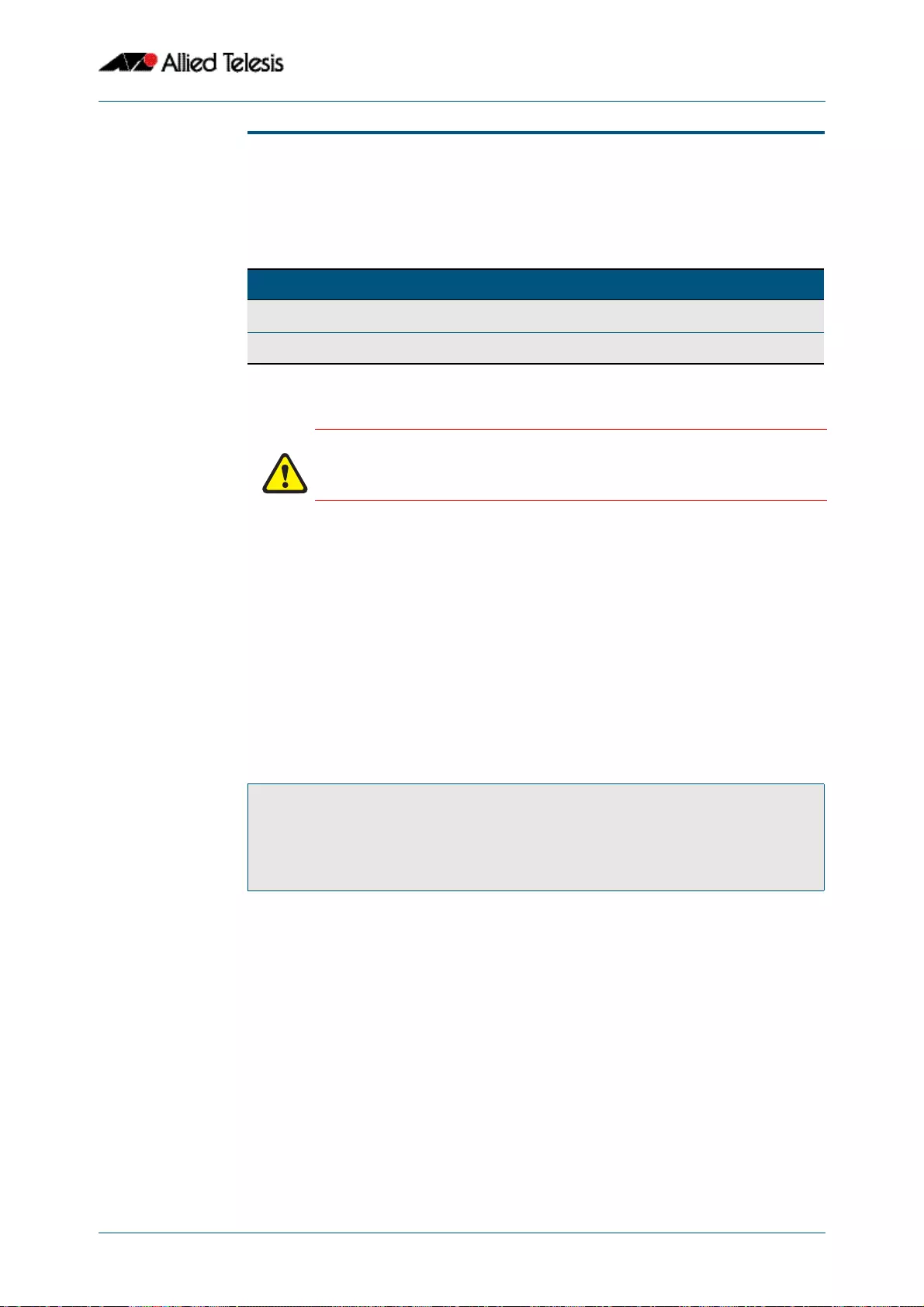
AMF Commands
Software Reference for GS900MX/MPX Series Switches
C613-50065-01 REV B AlliedWare PlusTM Operating System - Version 5.4.4E-1.x 61.89
type atmf node
This command configures a trigger to be activated at an AMF node join event or leave
event.
Syntax type atmf node {join|leave}
Mode Trigger Configuration
Example 1 To configure trigger 5 to activate at an AMF node leave event, use the following
commands. In this example the command is entered on node-1:
Example 2 The following commands will configure trigger 5 to activate if an AMF node join event
occurs on any node within the working set:
This command returns the following display:
Note that the running the above command changes the prompt from the name of the
local node, to the name of the AMF-Network followed, in square brackets, by the number
of member nodes in the working set.
Parameter Description
join AMF node join event.
leave AMF node leave event.
Caution Only configure this trigger on one device because it is a network wide
event.
node1(config)# trigger 5
node1(config-trigger) type atmf node leave
node1# atmf working-set group all
====================
node1, node2, node3:
====================
Working set join
AMF-Net[3]# conf t
AMF-Net[3](config)# trigger 5
AMF-Net[3](config-trigger)# type atmf node leave
AMF-Net[3](config-trigger)# description “E-mail on AMF Exit”
AMF-Net[3](config-trigger)# active

AMF Commands
Software Reference for GS900MX/MPX Series Switches
61.90 AlliedWare PlusTM Operating System - Version 5.4.4E-1.x C613-50065-01 REV B
Enter the name of the script to run at the trigger event.
Display the trigger configurations
This command returns the following display:
Display the triggers configured on each of the nodes in the AMF Network.
AMF-Net[3](config-trigger)# script 1 email_me.scp
AMF-Net[3](config-trigger)# end
AMF-Net[3]# show trigger
=======
node1:
========
TR# Type & Details Description Ac Te Tr Repeat #Scr Days/Date
-------------------------------------------------------------------------------
001 Periodic (2 min) Periodic Status Chk Y N Y Continuous 1 smtwtfs
005 ATMF node (leave) E-mail on ATMF Exit Y N Y Continuous 1 smtwtfs
-------------------------------------------------------------------------------
==============
Node2, Node3,
==============
TR# Type & Details Description Ac Te Tr Repeat #Scr Days/Date
-------------------------------------------------------------------------------
005 ATMF node (leave) E-mail on ATMF Exit Y N Y Continuous 1 smtwtfs
-------------------------------------------------------------------------------
AMF-Net[3]# show running-config trigger

AMF Commands
Software Reference for GS900MX/MPX Series Switches
C613-50065-01 REV B AlliedWare PlusTM Operating System - Version 5.4.4E-1.x 61.91
This command returns the following display:
Related Commands show trigger
========
Node1:
========
trigger 1
type periodic 2
script 1 atmf.scp
trigger 5
type atmf node leave
description “E-mail on ATMF Exit”
script 1 email_me.scp
!
============
Node2, Node3:
============
trigger 5
type atmf node leave
description “E-mail on ATMF Exit”
script 1 email_me.scp
!

AMF Commands
Software Reference for GS900MX/MPX Series Switches
61.92 AlliedWare PlusTM Operating System - Version 5.4.4E-1.x C613-50065-01 REV B
undebug atmf
This command is an alias for the no variant of the debug atmf command on page 61.50.
The IPv4 addresses shown may include those specified for documentation purposes in
RFC 5737: 192.0.2.0/24, 198.51.100.0/24, 203.0.113.0/24. These addresses should not be
used for practical networks (other than for testing purposes), nor should they appear in
any public network.

Software Reference for GS900MX/MPX Series Switches
C613-50065-01 REV B AlliedWare PlusTM Operating System - Version 5.4.4E-1.x 62.1
Chapter 62: NTP Introduction and
Configuration
Introduction ........................................................................................................................................ 62.2
Overview .............................................................................................................................................. 62.2
NTP on the Switch............................................................................................................................. 62.3
Troubleshooting................................................................................................................................ 62.4
Configuration Example ................................................................................................................... 62.5

NTP Introduction and Configuration
Software Reference for GS900MX/MPX Series Switches
62.2 AlliedWare PlusTM Operating System - Version 5.4.4E-1.x C613-50065-01 REV B
Introduction
This chapter describes the Network Time Protocol (NTP) service provided by the switch,
and how to configure and monitor NTP on the switch.
NTP is a protocol for synchronizing the time clocks on a collection of network devices
using a distributed client/server mechanism. NTP uses UDP (User Datagram Protocol) as
the transport mechanism. NTP evolved from the Time Protocol (RFC 868) and the ICMP
Timestamp message (RFC 792).
NTP provides protocol mechanisms to specify the precision and estimated error of the
local clock and the characteristics of the reference clock to which it may be synchronized.
For detailed information about the commands used to configure NTP, see Chapter 63,
NTP Commands.
Overview
NTP uses a subnetwork with primary reference clocks, gateways, secondary reference
clocks, and local hosts. These are organized into a hierarchy with the more accurate clocks
near the top and less accurate ones near the bottom.
A number of primary reference clocks, synchronized to national standards, are connected
to widely accessible resources (such as backbone gateways or switches) operating as
primary time servers. The primary time servers use NTP between them to crosscheck
clocks, to mitigate errors due to equipment or propagation failures, and to distribute time
information to local secondary time servers. The secondary time servers redistribute the
time information to the remaining local hosts.
The hierarchical organization and distribution of time information reduces the protocol
overhead, and allows selected hosts to be equipped with cheaper but less accurate clocks.
NTP provides information which organizes this hierarchy on the basis of precision or
estimated error.
■An NTP entity may be in one of the following operating modes; however, the switch’s
implementation of NTP supports two modes: client and server.
■An NTP entity operating in a client mode sends periodic messages to its peers,
requesting synchronization by its peers.
■An NTP entity enters the server mode temporarily when it receives a client request
message from one of its peers, and remains in server mode until the reply to the
request has been transmitted.
■An NTP entity operating in symmetric active mode sends messages announcing its
willingness to synchronize and be synchronized by its peers.
■An NTP entity enters symmetric passive mode in response to a message from a peer
operating in Symmetric Active mode. An NTP entity operating in this mode
announces its willingness to synchronize and be synchronized by its peers.
■An NTP entity operating in broadcast mode periodically sends messages announcing
its willingness to synchronize all of its peers but not to be synchronized by any of
them.

NTP Introduction and Configuration
Software Reference for GS900MX/MPX Series Switches
C613-50065-01 REV B AlliedWare PlusTM Operating System - Version 5.4.4E-1.x 62.3
The same message format is used for both requests and replies. When a request is
received, the server interchanges addresses and ports, fills in or overwrites certain fields in
the message, recalculates the checksum, and returns it immediately. The information
included in the NTP message allows each client/ server peer to determine the
timekeeping characteristics of its peers, including the expected accuracies of their clocks.
Each peer uses this information and selects the best time from possibly several other
clocks, updates the local clock, and estimates its accuracy.
There is no provision in NTP for peer discovery, acquisition, or authentication. Data
integrity is provided by the IP and UDP checksums. No reachability, circuit-management,
duplicate-detection, or retransmission facilities are provided or necessary.
By its very nature clock synchronization requires long periods of time (hours or days) and
multiple comparisons in order to maintain accurate timekeeping. The more comparisons
performed, the greater the accuracy of the timekeeping.
NTP on the Switch
The implementation of NTP on the switch is based on the following RFCs:
■RFC 958, Network Time Protocol (NTP)
■RFC 1305, Network Time Protocol (Version 3) Specification, Implementation and
Analysis
■RFC 1510, The Kerberos Network Authentication Service (V5)
Two modes of operation are supported: client and server. The switch is in client mode
most of the time where it polls the configured peer at least once every preconfigured
minimum time period.
The peer that the switch refers to must be a more accurate clock source than the switch
itself or another switch directly connected to a more accurate clock source. The switch
operates as a secondary time server. It cannot operate as a primary time server unless the
primary clock source is operating in server mode. A primary clock source usually operates
in broadcast mode, which is not supported by the switch’s implementation of NTP. When
the switch receives a valid reply from the peer, it synchronizes its own internal clock
according to the information from the reply.
If the switch receives a synchronization request from an NTP client, it temporarily changes
to server mode. It replies to the request with the current time from the switch’s internal
clock along with other information useful for synchronization. The switch’s internal clock is
accurate to 0.005 seconds.

NTP Introduction and Configuration
Software Reference for GS900MX/MPX Series Switches
62.4 AlliedWare PlusTM Operating System - Version 5.4.4E-1.x C613-50065-01 REV B
Troubleshooting
Problem The switch is not assigning the time to devices on the LAN.
Solutions ■Check that the NTP peer’s IP address is entered correctly.
■Check that the NTP peer can reach the switch, by pinging the switch from the NTP
peer.
Problem The switch’s clock does not synchronize with the NTP peer.
Solution ■The switch’s clock can synchronize with the NTP peer only when its initial time is
similar to the NTP peer’s time (after setting the UTC offset). Manually set the switch’s
time so that it is approximately correct, and enable NTP again.
■Check that the UTC offset is correct.
Problem The switch’s time is incorrect, even though it assigns the correct time to devices on the
LAN.
Solution The UTC offset is probably incorrect, or needs to be adjusted for the beginning or end of
summer time.

NTP Introduction and Configuration
Software Reference for GS900MX/MPX Series Switches
C613-50065-01 REV B AlliedWare PlusTM Operating System - Version 5.4.4E-1.x 62.5
Configuration Example
NTP requires the IP module to be enabled and configured correctly.
The switch's implementation of NTP supports two modes: client and server mode. When a
synchronization request is received from a client (e.g. a PC on a LAN), the switch enters
server mode and responds with time information derived from the switch's own internal
clock. Periodically the switch enters client mode, sending synchronization requests to a
predefined peer to synchronize its own internal clock. The peer is assumed to be a primary
clock source or another switch connected directly to a primary clock source.
This example illustrates how to configure two switches, one at a Head Office and one at a
Regional Office, to provide a network time service. The Head Office switch is connected to
a primary time server and provides the most accurate time information. The switch at the
Regional Office uses the Head Office switch as its peer to avoid the cost of an additional
WAN connection but provides slightly less accurate time information.
To configure NTP on the switch, the NTP module must be enabled and an NTP peer must
be defined. NTP transfers time information in UTC format.
To set the switch to automatically change the time when summer time starts and ends,
enable a summer time offset setting.
Example configuration parameters for a network time service:
Step 1: Enable NTP and define the NTP peer.
The NTP feature must be enabled on all switches that are to provide a network time
service. Each switch must have a peer defined where the switch synchronizes its own
internal clock. Enable NTP on the Head Office switch and specify a primary time server as
the peer by using the commands:
Note that you can also specify an IPv6 address for an NTP peer:
Step 2: Configure the NTP parameters.
On each switch, the offset of local time from UTC time must be specified. In this example,
both switches are in the same time zone, which is 12 hours ahead of UTC time. Use the
following commands on both switches:
Note that the range of offset is <0-12>.
Site Regional Office Head Office
Switch name RG1 HO1
IP Address of Switch 10.5.35.114 10.12.25.4
IP Address of Peer 10.5.35.113 172.16.7.3
awplus# configure terminal
awplus(config)# ntp peer 172.16.7.3
awplus# configure terminal
awplus(config)# ntp peer 2001:0db8:010d::1
awplus(config)# clock timezone utc plus 12

NTP Introduction and Configuration
Software Reference for GS900MX/MPX Series Switches
62.6 AlliedWare PlusTM Operating System - Version 5.4.4E-1.x C613-50065-01 REV B
Step 3: Check the NTP configuration.
Check the NTP configuration on each switch by using the command:
This command displays the following information on the Head Office switch.
awplus# show ntp status
Clock is synchronized, stratum 0, actual frequency is 0.0000
Hz, precision is 20 reference time is 00000000.00000000
(6:28:16.000 UTC Fri Feb 7 2036)clock offset is 0.000 msec,
root delay is 0.000 msec root dispersion is 0.000 msec,

Software Reference for GS900MX/MPX Series Switches
C613-50065-01 REV B AlliedWare PlusTM Operating System - Version 5.4.4E-1.x 63.1
Chapter 63: NTP Commands
Command List .................................................................................................................................... 63.2
ntp access-group............................................................................................................................... 63.2
ntp authenticate................................................................................................................................ 63.3
ntp authentication-key ................................................................................................................... 63.4
ntp broadcastdelay .......................................................................................................................... 63.5
devicentp master .............................................................................................................................. 63.6
ntp peer ................................................................................................................................................ 63.7
ntp server ............................................................................................................................................. 63.9
ntp source ..........................................................................................................................................63.11
ntp trusted-key ................................................................................................................................63.13
show counter ntp............................................................................................................................63.14
show ntp associations ...................................................................................................................63.15
show ntp status................................................................................................................................63.16

NTP Commands
Software Reference for GS900MX/MPX Series Switches
63.2 AlliedWare PlusTM Operating System - Version 5.4.4E-1.x C613-50065-01 REV B
Command List
This chapter provides an alphabetical reference for commands used to configure the
Network Time Protocol (NTP). For more information, see Chapter 62, NTP Introduction
and Configuration.
For information about modifying or redirecting the output from show commands to a file,
see “Controlling “show” Command Output” on page 1.35.
ntp access-group
This command creates an NTP access group, and applies a basic IP access list to it. This
allows you to control access to NTP services.
The no variant of this command removes the configured NTP access group.
Syntax ntp access-group [peer|query-only|serve|serve-only] [<1-99>|
<1300-1999>]
no ntp access-group [peer|query-only|serve|serve-only]
Mode Global Configuration
Examples To create an NTP peer access group for an extended IP access list, use the commands:
To disable the NTP peer access group created above, use the commands:
Parameter Description
peer Allows time requests and NTP control queries, and allows the system
to synchronize itself to a system whose address passes the access list
criteria.
query-only Allows only NTP control queries from a system whose address passes
the access list criteria.
serve Allows time requests and NTP control queries, but does not allow the
system to synchronize itself to a system whose address passes the
access list criteria.
serve-only Allows only time requests from a system whose address passes the
access list criteria.
<1-99>Standard IP access list.
<1300-1999>Expanded IP access list.
awplus# configure terminal
awplus(config)# ntp access-group peer 1998
awplus# configure terminal
awplus(config)# no ntp access-group peer

NTP Commands
Software Reference for GS900MX/MPX Series Switches
C613-50065-01 REV B AlliedWare PlusTM Operating System - Version 5.4.4E-1.x 63.3
ntp authenticate
This command enables NTP authentication. This allows NTP to authenticate the
associations with other systems for security purposes.
The no variant of this command disables NTP authentication.
Syntax ntp authenticate
no ntp authenticate
Mode Global Configuration
Examples To enable NTP authentication, use the commands:
To disable NTP authentication, use the commands:
awplus# configure terminal
awplus(config)# ntp authenticate
awplus# configure terminal
awplus(config)# no ntp authenticate

NTP Commands
Software Reference for GS900MX/MPX Series Switches
63.4 AlliedWare PlusTM Operating System - Version 5.4.4E-1.x C613-50065-01 REV B
ntp authentication-key
This command defines each of the authentication keys. Each key has a key number, a type,
and a value. Currently, the only key type supported is MD5.
The no variant of this disables the authentication key assigned previously using ntp
authentication-key.
Syntax ntp authentication-key <keynumber> md5 <key>
no ntp authentication-key <keynumber> md5 <key>
Mode Global Configuration
Examples To define an authentication key number 134343 and a key value mystring, use the
commands:
To disable the authentication key number 134343 with the key value mystring, use the
commands:
Parameter Description
<keynumber> <1-4294967295> The key number.
<key>The authentication key.
awplus# configure terminal
awplus(config)# ntp authentication-key 134343 md5 mystring
awplus# configure terminal
awplus(config)# no ntp authentication-key 134343 md5 mystring

NTP Commands
Software Reference for GS900MX/MPX Series Switches
C613-50065-01 REV B AlliedWare PlusTM Operating System - Version 5.4.4E-1.x 63.5
ntp broadcastdelay
Use this command to set the estimated round-trip delay for broadcast packets.
Use the no variant of this command to reset the round-trip delay for broadcast packets to
the default offset of 0 microseconds.
Syntax ntp broadcastdelay <delay>
no ntp broadcastdelay
Default 0 microsecond offset, which can only be applied with the no variant of this command.
Mode Global Configuration
Examples To set the estimated round-trip delay to 23464 microseconds for broadcast packets, use
these commands:
To reset the estimated round-trip delay for broadcast packets to the default setting (0
microseconds), use these commands:
Parameter Description
<delay> <1-999999> The broadcast delay in microseconds.
awplus# configure terminal
awplus(config)# ntp broadcastdelay 23464
awplus# configure terminal
awplus(config)# no ntp broadcastdelay

NTP Commands
Software Reference for GS900MX/MPX Series Switches
63.6 AlliedWare PlusTM Operating System - Version 5.4.4E-1.x C613-50065-01 REV B
devicentp master
Use this command to make the device to be an authoritative NTP server, even if the
system is not synchronized to an outside time source. Note that no stratum number is set
by default.
Use the no variant of this command to stop the device being the designated NTP server.
Syntax ntp master [<stratum>]
no ntp master
Mode Global Configuration
Usage The stratum number is null by default and must be set using this command. The stratum
levels define the distance from the reference clock and exist to prevent cycles in the
hierarchy. Stratum 1 is used to indicate time servers, which are more accurate than
Stratum 2 servers. For more information on the Network Time Protocol go to:
www.ntp.org//
Examples To stop the device from being the designated NTP server use the commands:
To make the device the designated NTP server with stratum number 2 use the commands:
Parameter Description
<stratum><1-15> The stratum number defines the configured level that is set
for this master within the NTP hierarchy.
awplus# configure terminal
awplus(config)# no ntp master
awplus# configure terminal
awplus(config)# ntp master 2

NTP Commands
Software Reference for GS900MX/MPX Series Switches
C613-50065-01 REV B AlliedWare PlusTM Operating System - Version 5.4.4E-1.x 63.7
ntp peer
Use this command to configure an NTP peer association. An NTP association is a peer
association if this system is willing to either synchronize to the other system, or allow the
other system to synchronize to it.
Use the no variant of this command to remove the configured NTP peer association.
Syntax ntp peer {<peeraddress>|<peername>}
ntp peer {<peeraddress>|<peername>} [prefer] [key <key>]
[version <version>]
no ntp peer {<peeraddress>|<peername>}
Mode Global Configuration
Examples See the following commands for options to configure NTP peer association, key and NTP
version for the peer with an IPv4 address of 192.0.2.23:
To remove an NTP peer association for this peer with an IPv4 address of 192.0.2.23,
use the following commands:
Parameter Description
<peeraddress>Specify the IP address of the peer, entered in the form
A.B.C.D for an IPv4 address, or in the form X:X::X:X for
an IPv6 address.
<peername>Specify the peer hostname. The peer hostname can resolve
to an IPv4 and an IPv6 address.
prefer Prefer this peer when possible.
key <key><1-4294967295>
Configure the peer authentication key.
version <version> <1-4>
Configure for this NTP version.
awplus# configure terminal
awplus(config)# ntp peer 192.0.2.23
awplus(config)# ntp peer 192.0.2.23 prefer
awplus(config)# ntp peer 192.0.2.23 prefer version 4
awplus(config)# ntp peer 192.0.2.23 prefer version 4 key 1234
awplus(config)# ntp peer 192.0.2.23 version 4 key 1234
awplus(config)# ntp peer 192.0.2.23 version 4
awplus(config)# ntp peer 192.0.2.23 key 1234
awplus# configure terminal
awplus(config)# no ntp peer 192.0.2.23

NTP Commands
Software Reference for GS900MX/MPX Series Switches
63.8 AlliedWare PlusTM Operating System - Version 5.4.4E-1.x C613-50065-01 REV B
See the following commands for options to configure NTP peer association, key and NTP
version for the peer with an IPv6 address of 2001:0db8:010d::1:
To remove an NTP peer association for this peer with an IPv6 address of
2001:0db8:010d::1, use the following commands:
Related Commands ntp server
ntp source
awplus# configure terminal
awplus(config)# ntp peer 2001:0db8:010d::1
awplus(config)# ntp peer 2001:0db8:010d::1 prefer
awplus(config)# ntp peer 2001:0db8:010d::1 prefer version 4
awplus(config)# ntp peer 2001:0db8:010d::1 prefer version 4 key
1234
awplus(config)# ntp peer 2001:0db8:010d::1 version 4 key 1234
awplus(config)# ntp peer 2001:0db8:010d::1 version 4
awplus(config)# ntp peer 2001:0db8:010d::1 key 1234
awplus# configure terminal
awplus(config)# no ntp peer 2001:0db8:010d::1

NTP Commands
Software Reference for GS900MX/MPX Series Switches
C613-50065-01 REV B AlliedWare PlusTM Operating System - Version 5.4.4E-1.x 63.9
ntp server
Use this command to configure an NTP server. This means that this system will
synchronize to the other system, and not vice versa.
Use the no variant of this command to remove the configured NTP server.
Syntax ntp server {<serveraddress>|<servername>}
ntp server {<serveraddress>|<servername>} [prefer] [key <key>]
[version <version>]
no ntp server {<serveraddress>|<servername>}
Mode Global Configuration
Examples See the following commands for options to configure an NTP server association, key and
NTP version for the server with an IPv4 address of 192.0.1.23:
To remove an NTP peer association for this peer with an IPv4 address of 192.0.1.23,
use the following commands:
Parameter Description
<serveraddress>Specify the IP address of the peer, entered in the form
A.B.C.D for an IPv4 address, or in the form X:X::X.X
for an IPv6 address.
<servername>Specify the server hostname. The server hostname can
resolve to an IPv4 and an IPv6 address.
prefer Prefer this server when possible.
key <key><1-4294967295>
Configure the server authentication key.
version <version> <1-4>
Configure for this NTP version.
awplus# configure terminal
awplus(config)# ntp server 192.0.1.23
awplus(config)# ntp server 192.0.1.23 prefer
awplus(config)# ntp server 192.0.1.23 prefer version 4
awplus(config)# ntp server 192.0.1.23 prefer version 4 key 1234
awplus(config)# ntp server 192.0.1.23 version 4 key 1234
awplus(config)# ntp server 192.0.1.23 version 4
awplus(config)# ntp server 192.0.1.23 key 1234
awplus# configure terminal
awplus(config)# no ntp server 192.0.1.23

NTP Commands
Software Reference for GS900MX/MPX Series Switches
63.10 AlliedWare PlusTM Operating System - Version 5.4.4E-1.x C613-50065-01 REV B
See the following commands for options to configure an NTP server association, key and
NTP version for the server with an IPv6 address of 2001:0db8:010e::2:
To remove an NTP peer association for this peer with an IPv6 address of
2001:0db8:010e::2, use the following commands:
Related Commands ntp peer
ntp source
awplus# configure terminal
awplus(config)# ntp server 2001:0db8:010e::2
awplus(config)# ntp server 2001:0db8:010e::2 prefer
awplus(config)# ntp server 2001:0db8:010e::2 prefer version 4
awplus(config)# ntp server 2001:0db8:010e::2 prefer version 4
key 1234
awplus(config)# ntp server 2001:0db8:010e::2 version 4 key 1234
awplus(config)# ntp server 22001:0db8:010e::2 version 4
awplus(config)# ntp server 2001:0db8:010e::2 key 1234
awplus# configure terminal
awplus(config)# no ntp server 2001:0db8:010e::2

NTP Commands
Software Reference for GS900MX/MPX Series Switches
C613-50065-01 REV B AlliedWare PlusTM Operating System - Version 5.4.4E-1.x 63.11
ntp source
Use this command to configure an IPv4 or an IPv6 address for the NTP source interface.
This command defines the socket used for NTP messages, and only applies to NTP client
behavior.
Use the no variant of this command to remove the configured IPv4 or IPv6 address from
the NTP source interface.
Syntax ntp source <source-address>
no ntp source
Default An IP address is selected based on the most appropriate egress interface used to reach the
NTP peer if a configured NTP client source IP address is unavailable or is an invalid IP
address.
Mode Global Configuration
Usage Adding an IPv4 or an IPv6 address allows you to select which source interface NTP uses for
peering. The IPv4 or IPv6 address configured using this command is matched to the
interface.
When selecting a source IP address to use for NTP messages to the peer, if the configured
NTP client source IP address is unavailable then default behavior will apply, and an
alternative source IP address is automatically selected. This IP address is based on the
most appropriate egress interface used to reach the NTP peer. The configured NTP client
source IP may be unavailable if the interface is down, or an invalid IP address is configured
that does not reside on the device.
Note that this command only applies to NTP client behavior. The egress interface that the
NTP messages use to reach the NTP server determined by the ntp peer and ntp server
commands.
Examples To configure the NTP source interface with the IPv4 address 192.0.1.23, enter the
commands:
To configure the NTP source interface with the IPv6 address 2001:0db8:010e::2,
enter the commands:
Parameter Description
<source-address>Specify the IP address of the NTP source interface, entered
in the form A.B.C.D for an IPv4 address, or in the form
X:X::X.X for an IPv6 address.
awplus# configure terminal
awplus(config)# ntp source 192.0.1.23
awplus# configure terminal
awplus(config)# ntp source 2001:0db8:010e::2

NTP Commands
Software Reference for GS900MX/MPX Series Switches
63.12 AlliedWare PlusTM Operating System - Version 5.4.4E-1.x C613-50065-01 REV B
To remove a configured address for the NTP source interface, use the following
commands:
Related Commands ntp peer
ntp server
awplus# configure terminal
awplus(config)# no ntp source

NTP Commands
Software Reference for GS900MX/MPX Series Switches
C613-50065-01 REV B AlliedWare PlusTM Operating System - Version 5.4.4E-1.x 63.13
ntp trusted-key
This command defines a list of trusted authentication keys. If a key is trusted, this system
will be ready to synchronize to a system that uses this key in its NTP packets.
Use the no variant of this command to remove a configured trusted authentication key.
Syntax ntp trusted-key <1-4294967295>
no ntp trusted-key <1-4294967295>
Mode Global Configuration
Examples To define a trusted authentication key numbered 234675, use the following commands:
To remove the trusted authentication key numbered 234675, use the following
commands:
Parameter Description
<1-4294967295>The specific key number.
awplus# configure terminal
awplus(config)# ntp trusted-key 234676
awplus# configure terminal
awplus(config)# no ntp trusted-key 234676

NTP Commands
Software Reference for GS900MX/MPX Series Switches
63.14 AlliedWare PlusTM Operating System - Version 5.4.4E-1.x C613-50065-01 REV B
show counter ntp
This command displays packet counters for NTP.
Syntax show counter ntp
Mode User Exec and Privileged Exec
Output Figure 63-1: Example output from the show counter ntp command
Example To display counters for NTP, use the command:
NTP counters
Pkts Sent ......... 0
Pkts Received ......... 70958
Pkts Processed ......... 0
Pkts current version ......... 0
Pkts old version ......... 0
Pkts unknown version ......... 0
Pkts access denied ......... 70958
Pkts bad length ......... 0
Pkts bad auth ......... 0
Pkts rate exceed ......... 0
Table 63-1: Parameters in the output from the show counter ntp command
Parameter Description
Pkts Sent Total number of NTP client and server packets sent by your
device.
Pkts Received Total number of NTP client and server packets received by your
device.
Pkts Processed The number of packets processed by NTP. NTP processes a
packet once it has determined that the packet is valid by
checking factors such as the packet’s authentication, format,
access rights and version.
Pkts current
version
The number of version 4 NTP packets received.
Pkts old
version
The number of NTP packets received that are from an older
version, down to version 1, of NTP. NTP is compatible with these
versions and processes these packets.
Pkts unknown
version
The number of NTP packets received that are an earlier version
than version 1, or a higher version than version 4. NTP cannot
process these packets.
Pkts access
denied The number of NTP packets received that do not match any
access list statements in the NTP access-groups. NTP drops these
packets.
Pkts bad
length
The number of NTP packets received that do not conform to the
standard packet length. NTP drops these packets.
Pkts bad auth The number of NTP packets received that failed authentication.
NTP drops these packets. Packets can only fail authentication if
NTP authentication is enabled with the ntp authenticate
command.
Pkts rate
exceed
The number of packets dropped because the packet rate
exceeded its limits.
awplus# show counter ntp

NTP Commands
Software Reference for GS900MX/MPX Series Switches
C613-50065-01 REV B AlliedWare PlusTM Operating System - Version 5.4.4E-1.x 63.15
show ntp associations
Use this command to display the status of NTP associations. Use the detail option for
displaying detailed information about the associations.
Syntax show ntp associations [detail]
Mode User Exec and Privileged Exec
Example See the sample output of the show ntp associations and show ntp associations detail
commands displaying the status of NTP associations.
Figure 63-2: Example output from the show ntp associations command
awplus#show ntp associations
address ref clock st when poll reach delay offset disp
~192.0.2.23 INIT 16 - 512 000 0.0 0.0 0.0
* master (synced), # master (unsynced), + selected, - candidate, ~ configured
awplus#
Figure 63-3: Example output from the show ntp associations detail command
awplus#show ntp associations detail
192.0.2.23 configured, sane, valid, leap_sub, stratum 16
ref ID INIT, time 00000000.00000000 (06:28:16.000 UTC Thu Feb 7 2036)
our mode client, peer mode unspec, our poll intvl 512, peer poll intvl 1024
root delay 0.00 msec, root disp 0.00, reach 000,
delay 0.00 msec, offset 0.0000 msec, dispersion 0.00
precision 2**-19,
org time 00000000.00000000 (06:28:16.000 UTC Thu Feb 7 2036)
rcv time 00000000.00000000 (06:28:16.000 UTC Thu Feb 7 2036)
xmt time cf11f2a4.cedde5e4 (00:39:00.808 UTC Tue Feb 2 2010)
filtdelay = 0.00 0.00 0.00 0.00 0.00 0.00 0.00 0.00
filtoffset = 0.00 0.00 0.00 0.00 0.00 0.00 0.00 0.00
filterror = 16000.00 16000.00 16000.00 16000.00 16000.00 16000.00 16000.0
0 16000.00
Table 63-2: Parameters in the output from the show ntp associations command
Parameter Description
address Peer IP address
ref clock IP address for reference clock
st Stratum. The number of hops between the server and the accurate
time source.
poll Time between NTP requests from the device to the server.
reach Shows whether or not the NTP server responded to the last request.
delay Round trip delay between the device and the server.
offset Difference between the device clock and the server clock.
disp Lowest measure of error associated with peer offset based on delay.

NTP Commands
Software Reference for GS900MX/MPX Series Switches
63.16 AlliedWare PlusTM Operating System - Version 5.4.4E-1.x C613-50065-01 REV B
show ntp status
Use this command to display the status of the Network Time Protocol (NTP).
Syntax show ntp status
Mode User Exec and Privileged Exec
Example See the sample output of the show ntp status command displaying information about
the Network Time Protocol.
Figure 63-4: Example output from the show ntp status command
awplus#sh ntp status
Clock is synchronized, stratum 3, reference is 127.127.1.0
actual frequency is 0.0000 Hz, precision is 2**-19
reference time is cf11f3f2.c7c081a1 (00:44:34.780 UTC Tue Feb 2
2010)
clock offset is 0.000 msec, root delay is 0.000 msec
root dispersion is 7947729.000 msec,
awplus#

Software Reference for GS900MX/MPX Series Switches
C613-50065-01 REV B AlliedWare PlusTM Operating System - Version 5.4.4E-1.x 64.1
Chapter 64: Dynamic Host Configuration
Protocol (DHCP) Introduction
Introduction ........................................................................................................................................ 64.2
DHCP .............................................................................................................................................. 64.2
DHCP Relay Agents ................................................................................................................... 64.2
Configuring the DHCP Client ........................................................................................................ 64.3
DHCP Relay Agent Introduction .................................................................................................. 64.4
Configuring the DHCP Relay Agent .................................................................................... 64.4
DHCP Relay Agent Information Option (Option 82) ..................................................... 64.5

Dynamic Host Configuration Protocol (DHCP) Introduction
Software Reference for GS900MX/MPX Series Switches
64.2 AlliedWare PlusTM Operating System - Version 5.4.4E-1.x C613-50065-01 REV B
Introduction
This chapter describes the Dynamic Host Configuration Protocol (DHCP) support provided
by your device. This includes how to configure your device to:
■use the DHCP client to obtain IP addresses for its own interfaces
■act as a DHCP relay agent
DHCP
DHCP is widely used to dynamically assign host IP addresses from a centralized server that
reduces the overhead of administrating IP addresses. DHCP helps conserve the limited IP
address space because IP addresses no longer need to be permanently assigned to hosts.
DHCP centrally manages IP address assignment for a large number of subscribers.
DHCP is based on BOOTP, and is defined in RFC 2131. It extends the BOOTP mechanism by
providing:
■a method for passing configuration information to hosts on a TCP/IP network
■automatic allocation of reusable network addresses
■other additional configuration options
DHCP is designed to interoperate with BOOTP clients and DHCP clients, without the
BOOTP clients needing any change to their initialization software.
DHCP Relay Agents
DHCP relay agents pass BOOTP and DHCP messages between servers and clients.
Networks where the DHCP or BOOTP server does not reside on the same IP subnet as its
clients need the intermediate routers to act as relay agents. A maximum number of 400
DHCP relay agents (one per interface) can be configured on the device. Once this limit has
been reached, any further attempts to configure DHCP relay agents will not be successful.

Dynamic Host Configuration Protocol (DHCP) Introduction
Software Reference for GS900MX/MPX Series Switches
C613-50065-01 REV B AlliedWare PlusTM Operating System - Version 5.4.4E-1.x 64.3
Configuring the DHCP Client
You can configure an interface on your device with a static IP address, or with a dynamic IP
address assigned using your device’s DHCP client. When you use the DHCP client, it
obtains the IP address for the interface, and other IP configuration parameters, from a
DHCP server. To configure an interface and gain its IP configuration using the DHCP client,
use the command:
The DHCP client supports the following IP configuration options:
■Option 1—the subnet mask for your device.
■Option 51—lease expiration time.
If an IP interface is configured to get its IP address and subnet mask from DHCP, the
interface does not take part in IP routing until the IP address and subnet mask have been
set by DHCP.
For information on configuring a static IP address on an interface, see the ip address
command on page 25.11.
awplus(config)# interface <ifname>
awplus(config-if)# ip address dhcp [client-id <interface>]
[hostname <hostname>]

Dynamic Host Configuration Protocol (DHCP) Introduction
Software Reference for GS900MX/MPX Series Switches
64.4 AlliedWare PlusTM Operating System - Version 5.4.4E-1.x C613-50065-01 REV B
DHCP Relay Agent Introduction
DHCP relay agents pass BOOTP messages between servers and clients. Networks where
the DHCP or BOOTP server does not reside on the same IP subnet as its clients need the
routers attached to the subnet to act as DHCP relay agents.
Note that both BOOTP and DHCP use BOOTP messages, allowing DHCP relay agents to
relay all their packets.
Your device’s DHCP Relay Agent relays these message types:
■BOOTREQUEST messages originating from any of the device’s interfaces to a user-
defined destination
■BOOTREPLY messages addressed to BOOTP clients on networks directly connected to
the device
The DHCP relay agent ignores BOOTREPLY messages addressed to clients on networks not
directly connected to the device. The device treats these as ordinary IP packets for
forwarding.
A BOOTREQUEST message is relayed via unicast.
The hops field in a BOOTP message records the number of DHCP relay agents the message
has been through. If the value of the hops field exceeds a predefined threshold, the DHCP
relay agent discards the message.
Configuring the DHCP Relay Agent
To enable the DHCP relay agent on your device, use the commands:
Note DHCP relay agent is enabled by default on your switch. You only need to enter a
service dhcp-relay command if DHCP relay agent is disabled on your switch.
You must define a relay destination on one of the device’s interfaces before the relay agent
can relay packets. This is the path to the DHCP server. To define a relay destination on the
currently specified interface, on which there are DHCP clients, use the commands:
You can define more than one relay destination on your device. The following table
describes how the DHCP relay agent forwards the packets.
To delete a DHCP relay destination, use the command:
awplus# configure terminal
awplus(config)# service dhcp-relay
awplus(config)# interface <interface-name>
awplus(config-if)# ip dhcp-relay server-address <ip-address>
If an interface has... Then the relay agent relays BOOTP packets it
receives on that interface to...
one relay destination defined the relay destination.
multiple relay destinations defined each defined relay destination.
awplus(config-if)# no ip dhcp-relay server-address <ip-address>

Dynamic Host Configuration Protocol (DHCP) Introduction
Software Reference for GS900MX/MPX Series Switches
C613-50065-01 REV B AlliedWare PlusTM Operating System - Version 5.4.4E-1.x 64.5
See the ip dhcp-relay server-address command on page 65.13 and the service dhcp-
relay command on page 65.15 for command description and command examples..
When the ‘hops’ field in a BOOTP message exceeds a predefined threshold the BOOTP
message is discarded. The default of the threshold is 10. To set the threshold, use the
command:
To display the current configuration of the DHCP relay agent, use the command:
DHCP Relay Agent Information Option (Option 82)
You can use DHCP Relay Agent Information Option (Option 82) to protect your switch
from spoofing attacks, where untrusted hosts can send requests for IP addresses to access
the network. The switch relays these requests to DHCP servers and the servers send IP
address leases in response. Untrusted hosts could then use these IP addresses for spoofing
attacks. Option 82 contains information about the location of a DHCP client for the DHCP
server.
Enabling the DCHP Relay Agent Information Option feature on the switch allows the
switch to insert extra information into the DHCP packets that it is relaying. This
information enables accurate identification of a subscriber, as it states which interface on
which relay switch the subscriber is connected to. The information is stored in an optional
field in the DHCP packet header, the relay agent-information option field, with the option
ID 82.
The DHCP relay agent inserts the Option 82 information into the DHCP packets that it is
relaying to a DHCP server. DHCP servers that are configured to recognize Option 82 may
use the information to implement IP addresses, or other parameter assignment policies,
based on the network location of the client device. Alternatively, the server can simply log
this information to create a detailed audit trail of the locations of the clients to which
given addresses were allocated at given times.
If Option 82 insertion is enabled, then the DHCP packet flow is as follows:
■The DHCP client generates a DHCP request and broadcasts it on the network.
■The DHCP relay agent intercepts the broadcast DHCP request packet and inserts the
Option 82 field in the packet.
■The DHCP relay agent unicasts the DHCP request that includes the Option 82 field to
the DHCP server.
■The DHCP server receives the packet.
■If the DHCP server supports Option 82, then it echoes the Option 82 field in the DHCP
reply. If the server does not support Option 82, it ignores the option and does not
echo it in the reply.
■The DHCP server unicasts the reply to the relay agent.
■The relay agent removes the Option 82 field and forwards the packet to the switch
port connected to the DHCP client that sent the DHCP request.
For information about DHCP Relay Agent Information Option (Option 82), see RFC 3046.
awplus(config-if)# ip dhcp-relay maxhops <1-255>
awplus# show ip dhcp-relay [interface <interface-name>]

Dynamic Host Configuration Protocol (DHCP) Introduction
Software Reference for GS900MX/MPX Series Switches
64.6 AlliedWare PlusTM Operating System - Version 5.4.4E-1.x C613-50065-01 REV B
To enable the relay agent to insert its details into the Option 82 field in requests received
from clients on a particular interface, use the command:
The Option 82 field contains sub-options. You can specify a value for the Remote ID
sub-option, which contains information that identifies the host. To specify a value for the
Remote ID, use the command:
If a Remote ID value is not specified, the Remote ID sub-option is set to the switch’s MAC
address. You can also configure the Remote ID value as an alphanumeric string.
Note that the Option 82 agent information added by DHCP Relay differs from the
information inserted by DHCP snooping (see “DHCP Relay Agent Option 82” on
page 55.4).
Dealing with client-originated packets that already contain
Option 82 information
It is possible for the requests arriving from the clients to the relay agent to already contain
Option 82 data. There are two main circumstances in which this can occur:
1. A client is maliciously inserting bogus information into the packet in an attempt to
subvert the process of identifying the client’s location. In this case, you would want to
drop the packets that contain the bogus information (or remove bogus information).
2. A Layer 2 DHCP snooping switch, that sits between the clients and the DCHP relay, is
validly inserting the Option 82 information into the packets. The DHCP snooping
switch is not acting as a relay agent, but is inserting the Option 82 information. In this
case, you would want to forward the valid information to the DHCP server.
The action taken on packets with an Option 82 field is configurable. The command to
configure this action is shown below:
This command sets the action that the DHCP relay takes when a received DHCP client
request contains Option 82 information. Required parameters configure the switch to:
■Leave the existing Option 82 field untouched (keep parameter)
■Append its own Option 82 field after the existing field (append parameter - use this
when there is a trusted DHCP Snooping switch or another relay device between the
clients and the DHCP Relay)
■Drop the packet (drop parameter)
■Replace the existing Option 82 information with its own (the default - replace
parameter).
awplus(config)# interface <interface-name>
awplus(config-if)# ip dhcp-relay agent-option
awplus(config)# interface <interface-name>
awplus(config-if)# ip dhcp-relay agent-option remote-id
<remote-id>
awplus(config)# interface <interface-name>
awplus(config-if)# ip dhcp-relay information policy
{append|drop|keep|replace}

Dynamic Host Configuration Protocol (DHCP) Introduction
Software Reference for GS900MX/MPX Series Switches
C613-50065-01 REV B AlliedWare PlusTM Operating System - Version 5.4.4E-1.x 64.7
See the ip dhcp-relay information policy command on page 65.8 for a command
description and command examples.
Checking Option 82 information in DHCP server responses
To configure the switch to check for the presence of Option 82 information in response
packets returned from DHCP servers, configure DHCP-relay agent-option checking with
the Interface Configuration command:
This command enables the DHCP Relay Agent to check Option 82 information in response
packets returned from DHCP servers. If the information does not match the information it
has configured for its own client (downstream) interface then the DHCP relay agent drops
the packet.
See the ip dhcp-relay agent-option checking command on page 65.6 for a command
description and command examples.
Option 82 maximum message length
When a DHCP Relay (that has Option 82 insertion enabled) receives a request packet from
a DHCP client, it will append the Option 82 component data, and forward the packet to
the DHCP server. The DHCP client will sometimes issue packets containing pad option
fields that can be overwritten with Option 82 data.
Where there are insufficient pad option fields to contain all the Option 82 data, the DHCP
relay will increase the packet size to accommodate the Option 82 data. If the new
(increased) packet size exceeds that defined by the maximum-message-length
parameter, of the ip dhcp-relay max-message-length command then the DHCP relay
will drop the packet.
awplus(config)# interface <interface-name>
awplus(config-if)# ip dhcp-relay agent-option checking
awplus(config)# interface <interface-name>
awplus(config-if)# ip dhcp-relay max-message-length <548-1472>

Dynamic Host Configuration Protocol (DHCP) Introduction
Software Reference for GS900MX/MPX Series Switches
64.8 AlliedWare PlusTM Operating System - Version 5.4.4E-1.x C613-50065-01 REV B

Software Reference for GS900MX/MPX Series Switches
C613-50065-01 REV B AlliedWare PlusTM Operating System - Version 5.4.4E-1.x 65.1
Chapter 65: Dynamic Host Configuration
Protocol (DHCP) Commands
Command List .................................................................................................................................... 65.2
ip address dhcp.................................................................................................................................. 65.3
ip dhcp-relay agent-option ........................................................................................................... 65.4
ip dhcp-relay agent-option checking ........................................................................................ 65.6
ip dhcp-relay agent-option remote-id ...................................................................................... 65.7
ip dhcp-relay information policy................................................................................................. 65.8
ip dhcp-relay maxhops .................................................................................................................65.10
ip dhcp-relay max-message-length .........................................................................................65.11
ip dhcp-relay server-address.......................................................................................................65.13
service dhcp-relay...........................................................................................................................65.15
show counter dhcp-client............................................................................................................65.16
show counter dhcp-relay .............................................................................................................65.17
show dhcp lease ..............................................................................................................................65.19
show ip dhcp-relay .........................................................................................................................65.20

Dynamic Host Configuration Protocol (DHCP) Commands
Software Reference for GS900MX/MPX Series Switches
65.2 AlliedWare PlusTM Operating System - Version 5.4.4E-1.x C613-50065-01 REV B
Command List
This chapter provides an alphabetical reference for commands used to configure DHCP.
For more information, see Chapter 64, Dynamic Host Configuration Protocol (DHCP)
Introduction.
For information about modifying or redirecting the output from show commands to a file,
see “Controlling “show” Command Output” on page 1.35.

Dynamic Host Configuration Protocol (DHCP) Commands
Software Reference for GS900MX/MPX Series Switches
C613-50065-01 REV B AlliedWare PlusTM Operating System - Version 5.4.4E-1.x 65.3
ip address dhcp
This command activates the DHCP client on the interface you are configuring. This allows
the interface to use the DHCP client to obtain its IP configuration details from a DHCP
server on its connected network.
The client-id and hostname parameters are identifiers that you may want to set in order
to interoperate with your existing DHCP infrastructure. If neither option is needed, then
the DHCP server uses the MAC address field of the request to identify the host.
The DHCP client supports the following IP configuration options:
■Option 1 - the subnet mask for your device.
■Option 51 - lease expiration time.
The no variant of this command stops the interface from obtaining IP configuration details
from a DHCP server.
Syntax ip address dhcp [client-id <interface>] [hostname <hostname>]
no ip address dhcp
Mode Interface Configuration for a VLAN interface.
Examples To set the interface vlan10 to use DHCP to obtain an IP address, use the commands:
To stop the interface vlan10 from using DHCP to obtain its IP address, use the
commands:
Related Commands ip address
Validation
Commands
show running-config
show ip interface
Parameter Description
<interface> The name of the interface you are activating the DHCP client
on. If you specify this, then the MAC address associated with
the specified interface is sent to the DHCP server in the
optional identifier field.
Default: no default
<hostname> The hostname for the DHCP client on this interface. Typically
this name is provided by the ISP.
Default: no default
awplus# configure terminal
awplus(config)# interface vlan10
awplus(config-if)# ip address dhcp
awplus# configure terminal
awplus(config)# interface vlan10
awplus(config-if)# no ip address dhcp

Dynamic Host Configuration Protocol (DHCP) Commands
Software Reference for GS900MX/MPX Series Switches
65.4 AlliedWare PlusTM Operating System - Version 5.4.4E-1.x C613-50065-01 REV B
ip dhcp-relay agent-option
This command enables the DHCP Relay Agent to insert the DHCP Relay Agent Information
Option (Option 82) into the client-request packets that it relays to its DHCP server. This
allows the DHCP Relay Agent to pass on information to the server about the network
location of the client device. The DHCP Relay Agent strips the DHCP Relay Agent Option
82 field out of the DHCP server’s response, so that the DHCP client never sees this field.
When the DHCP Relay Agent appends its DHCP Relay Agent Option 82 data into the
packet, it first overwrites any pad options present; then if necessary, it increases the packet
length to accommodate the DHCP Relay Agent Option 82 data.
The no variant of this command stops the DHCP Relay Agent from appending the Option
82 field onto DHCP requests before forwarding it to the server.
For DHCP Relay Agent and DHCP Relay Agent Option 82 introductory information, see
“DHCP Relay Agent Introduction” on page 64.4. and “DHCP Relay Agent Information
Option (Option 82)” on page 64.5
Syntax ip dhcp-relay agent-option
no ip dhcp-relay agent-option
Default DHCP Relay Agent Information Option (Option 82) insertion is disabled by default.
Mode Interface Configuration for a VLAN interface.
Usage Use this command to alter the DHCP Relay Agent Option 82 setting when your switch is
the first hop for the DHCP client. To limit the maximum length of the packet, use the ip
dhcp-relay max-message-length command.
This command cannot be enabled if DHCP snooping is enabled on your switch (service
dhcp-snooping command on page 56.24), and vice versa.
Examples To make the DHCP Relay Agent listening on vlan15 append the DHCP Relay Agent
Option 82 field, use the commands:
To stop the DHCP Relay Agent from appending the DHCP Relay Agent Option 82 field on
vlan15, use the commands:
Note The DHCP-relay service might alter the content of the DHCP Relay Agent
Option 82 field, if the commands ip dhcp-relay agent-option and ip dhcp-
relay information policy have been configured.
awplus# configure terminal
awplus(config)# interface vlan15
awplus(config-if)# ip dhcp-relay agent-option
awplus# configure terminal
awplus(config)# interface vlan15
awplus(config-if)# no ip dhcp-relay agent-option

Dynamic Host Configuration Protocol (DHCP) Commands
Software Reference for GS900MX/MPX Series Switches
C613-50065-01 REV B AlliedWare PlusTM Operating System - Version 5.4.4E-1.x 65.5
Related Commands ip dhcp-relay agent-option remote-id
ip dhcp-relay information policy
ip dhcp-relay max-message-length
service dhcp-relay

Dynamic Host Configuration Protocol (DHCP) Commands
Software Reference for GS900MX/MPX Series Switches
65.6 AlliedWare PlusTM Operating System - Version 5.4.4E-1.x C613-50065-01 REV B
ip dhcp-relay agent-option checking
This command enables the DHCP Relay Agent to check DHCP Relay Agent Information
Option (Option 82) information in response packets returned from DHCP servers. If the
information does not match the information it has for its own client (downstream)
interface then the DHCP Relay Agent drops the packet. Note that ip dhcp-relay
agent-option must be configured.
The DHCP Relay Agent Option 82 field is included in relayed client DHCP packets if:
■DHCP Relay Agent Option 82 is enabled (ip dhcp-relay agent-option), and
■DHCP Relay Agent is enabled on the switch (service dhcp-relay)
For DHCP Relay Agent and DHCP Relay Agent Option 82 introductory information, see
“DHCP Relay Agent Introduction” on page 64.4. and “DHCP Relay Agent Information
Option (Option 82)” on page 64.5
Syntax ip dhcp-relay agent-option checking
no ip dhcp-relay agent-option checking
Mode Interface Configuration for a VLAN interface.
Examples To make the DHCP Relay Agent listening on vlan10 check the DHCP Relay Agent
Information Option (Option 82) field, use the commands:
To stop the DHCP Relay Agent on vlan10 from checking the DHCP Relay Agent
Information Option (Option 82) field, use the commands:
Related Commands ip dhcp-relay agent-option
ip dhcp-relay agent-option remote-id
ip dhcp-relay information policy
service dhcp-relay
awplus# configure terminal
awplus(config)# interface vlan10
awplus(config-if)# ip dhcp-relay agent-option
awplus(config-if)# ip dhcp-relay agent-option checking
awplus# configure terminal
awplus(config)# interface vlan10
awplus(config-if)# no ip dhcp-relay agent-option checking

Dynamic Host Configuration Protocol (DHCP) Commands
Software Reference for GS900MX/MPX Series Switches
C613-50065-01 REV B AlliedWare PlusTM Operating System - Version 5.4.4E-1.x 65.7
ip dhcp-relay agent-option remote-id
Use this command to specify the Remote ID sub-option of the DHCP Relay Agent Option
82 field the DHCP Relay Agent inserts into clients’ request packets. The Remote ID
identifies the device that is inserting the DHCP Relay Agent Option 82 information. If a
Remote ID is not specified, the Remote ID sub-option is set to the switch’s MAC address.
Use the no variant of this command to return the Remote ID for an interface.
For DHCP Relay Agent and DHCP Relay Agent Option 82 introductory information, see
“DHCP Relay Agent Introduction” on page 64.4. and “DHCP Relay Agent Information
Option (Option 82)” on page 64.5
Syntax ip dhcp-relay agent-option remote-id <remote-id>
no ip dhcp-relay agent-option remote-id
Default The Remote ID is set to the switch’s MAC address by default.
Mode Interface Configuration for a VLAN interface.
Usage The Remote ID sub-option is included in the DHCP Relay Agent Option 82 field of relayed
client DHCP packets if:
■DHCP Relay Agent Option 82 is enabled (ip dhcp-relay agent-option), and
■DHCP Relay Agent is enabled on the switch (service dhcp-relay)
Examples To set the Remote ID to myid for client DHCP packets received on vlan1, use the
commands:
To remove the Remote ID specified for vlan1, use the commands:
Related Commands ip dhcp-relay agent-option
ip dhcp-relay agent-option checking
show ip dhcp-relay
Parameter Description
<remote-id>An alphanumeric (ASCII) string, 1 to 63 characters in length.
Additional characters allowed are hyphen (-), underscore (_)
and hash (#). Spaces are not allowed.
awplus# configure terminal
awplus(config)# interface vlan1
awplus(config-if)# ip dhcp-relay agent-option remote-id myid
awplus# configure terminal
awplus(config)# interface vlan1
awplus(config-if)# no ip dhcp-relay agent-option remote-id

Dynamic Host Configuration Protocol (DHCP) Commands
Software Reference for GS900MX/MPX Series Switches
65.8 AlliedWare PlusTM Operating System - Version 5.4.4E-1.x C613-50065-01 REV B
ip dhcp-relay information policy
This command sets the policy for how the DHCP relay deals with packets arriving from the
client that contain DHCP Relay Agent Option 82 information.
If the command ip dhcp-relay agent-option has not been configured, then this command
has no effect at all - no alteration is made to Option 82 information in packets arriving
from the client side.
However, if the command ip dhcp-relay agent-option has been configured, this
command modifies how the DHCP relay service deals with cases where the packet arriving
from the client side already contains DHCP Relay Agent Option 82 information.
This command sets the action that the DHCP relay should take when a received DHCP
client request contains DHCP Relay Agent Option 82 information.
By default, the DHCP Relay Agent replaces any existing DHCP Relay Agent Option 82 field
with its own DHCP Relay Agent field. This is equivalent to the functionality of the replace
parameter.
The no variant of this command returns the policy to the default behavior - i.e. replacing
the existing DHCP Relay Agent Option 82 field.
For DHCP Relay Agent and DHCP Relay Agent Option 82 introductory information, see
“DHCP Relay Agent Introduction” on page 64.4 and “DHCP Relay Agent Information
Option (Option 82)” on page 64.5
Syntax ip dhcp-relay information policy {append|drop|keep|replace}
no ip dhcp-relay information policy
Mode Interface Configuration for a VLAN interface.
Examples To make the DHCP Relay Agent listening on vlan15 drop any client requests that already
contain DHCP Relay Agent Option 82 information, use the commands:
To reset the DHCP relay information policy to the default policy for interface vlan15, use
Note The DHCP-relay service might alter the content of the DHCP Relay Agent
Option 82 field, if the commands ip dhcp-relay agent-option and ip dhcp-
relay information policy have been configured.
Parameter Description
append The DHCP Relay Agent appends the DHCP Relay Agent Option 82 field
of the packet with its own DHCP Relay Agent Option 82 details.
drop The DHCP Relay Agent discards the packet.
keep The DHCP Relay Agent forwards the packet without altering the DHCP
Relay Agent Option 82 field.
replace The DHCP Relay Agent replaces the existing DHCP Relay Agent details
in the DHCP Relay Agent Option 82 field with its own details before
forwarding the packet.
awplus# configure terminal
awplus(config)# interface vlan15
awplus(config-if)# ip dhcp-relay information policy drop

Dynamic Host Configuration Protocol (DHCP) Commands
Software Reference for GS900MX/MPX Series Switches
C613-50065-01 REV B AlliedWare PlusTM Operating System - Version 5.4.4E-1.x 65.9
the commands:
Related Commands ip dhcp-relay agent-option
ip dhcp-relay agent-option checking
awplus# configure terminal
awplus(config)# interface vlan15
awplus(config-if)# no ip dhcp-relay information policy

Dynamic Host Configuration Protocol (DHCP) Commands
Software Reference for GS900MX/MPX Series Switches
65.10 AlliedWare PlusTM Operating System - Version 5.4.4E-1.x C613-50065-01 REV B
ip dhcp-relay maxhops
This command sets the hop count threshold for discarding BOOTP messages. When the
hops field in a BOOTP message exceeds the threshold, the DHCP Relay Agent discards the
BOOTP message. The hop count threshold is set to 10 hops by default.
Use the no variant of this command to reset the hop count to the default.
For DHCP Relay Agent introductory information, see “DHCP Relay Agent Introduction”
on page 64.4. For Option 82 introductory information, see “DHCP Relay Agent
Information Option (Option 82)” on page 64.5.
Syntax ip dhcp-relay maxhops <1-255>
no ip dhcp-relay maxhops
Default The default hop count threshold is 10 hops.
Mode Interface Configuration for a VLAN interface.
Example To set the maximum number of hops to 5 for packets received on interface vlan15, use
the commands:
Related Commands service dhcp-relay
Parameter Description
<1-255>The maximum hop count value.
awplus# configure terminal
awplus(config)# interface vlan15
awplus(config-if)# ip dhcp-relay maxhops 5

Dynamic Host Configuration Protocol (DHCP) Commands
Software Reference for GS900MX/MPX Series Switches
C613-50065-01 REV B AlliedWare PlusTM Operating System - Version 5.4.4E-1.x 65.11
ip dhcp-relay max-message-length
This command applies when the switch is acting as a DHCP Relay Agent and DHCP Relay
Agent Option 82 insertion is enabled. It sets the maximum DHCP message length (in
bytes) for the DHCP packet with its DHCP Relay Agent Option 82 data inserted. From this
value it calculates the maximum packet size that it will accept at its input. Packets that
arrive greater than this value will be dropped.
The no variant of this command sets the maximum message length to its default of 1400
bytes.
For DHCP Relay Agent introductory information, see “DHCP Relay Agent Introduction”
on page 64.4. For Option 82 introductory information, see “DHCP Relay Agent
Information Option (Option 82)” on page 64.5.
Syntax ip dhcp-relay max-message-length <548-1472>
no ip dhcp-relay max-message-length
Default The default is 1400 bytes.
Mode Interface Configuration for a VLAN interface.
Usage When a DHCP Relay Agent (that has DHCP Relay Agent Option 82 insertion enabled)
receives a request packet from a DHCP client, it will append the DHCP Relay Agent Option
82 component data, and forward the packet to the DHCP server. The DHCP client will
sometimes issue packets containing pad option fields that can be overwritten with Option
82 data.
Where there are insufficient pad option fields to contain all the DHCP Relay Agent Option
82 data, the DHCP Relay Agent will increase the packet size to accommodate the DHCP
Relay Agent Option 82 data. If the new (increased) packet size exceeds that defined by the
maximum-message-length parameter, then the DHCP Relay Agent will drop the packet.
Example To set the maximum DHCP message length to 1200 bytes for packets arriving in interface
vlan7, use the commands:
Parameter Description
<548-1472> The maximum DHCP message length (this is the message
header plus the inserted DHCP option fields in bytes).
Note Before setting this command, you must first run the ip dhcp-relay
agent-option command on page 65.4. This will allow the DHCP Relay Agent
Option 82 fields to be appended.
awplus# configure terminal
awplus(config)# interface vlan7
awplus(config-if)# ip dhcp-relay max-message-length 1200

Dynamic Host Configuration Protocol (DHCP) Commands
Software Reference for GS900MX/MPX Series Switches
65.12 AlliedWare PlusTM Operating System - Version 5.4.4E-1.x C613-50065-01 REV B
To reset the maximum DHCP message length to the default of 1400 bytes for packets
arriving in interface vlan7, use the commands:
Related Commands service dhcp-relay
awplus# configure terminal
awplus(config)# interface vlan7
awplus(config-if)# no ip dhcp-relay max-message-length

Dynamic Host Configuration Protocol (DHCP) Commands
Software Reference for GS900MX/MPX Series Switches
C613-50065-01 REV B AlliedWare PlusTM Operating System - Version 5.4.4E-1.x 65.13
ip dhcp-relay server-address
This command adds a DHCP server for the DHCP Relay Agent to forward client DHCP
packets to on a particular interface. You can add up to five DHCP servers on each device
interface that the DHCP Relay Agent is listening on.
The no variant of this command deletes the specified DHCP server from the list of servers
available to the DHCP relay agent.
For DHCP Relay Agent introductory information, see “DHCP Relay Agent Introduction”
on page 64.4. For Option 82 introductory information, see “DHCP Relay Agent
Information Option (Option 82)” on page 64.5.
The no ip dhcp-relay command removes all DHCP relay settings from the interface.
Syntax ip dhcp-relay server-address <ip-address>
no ip dhcp-relay server-address <ip-address>
no ip dhcp-relay
Mode Interface Configuration for a VLAN interface.
Usage See also the service dhcp-relay command to enable the DHCP Relay Agent on your
device. The ip dhcp-relay server-address command defines a relay destination on an
interface on the device, needed by the DHCP Relay Agent to relay DHCP client packets to a
DHCP server.
Examples To enable the DHCP Relay Agent to relay DHCP packets on interface vlan2 to the DHCP
server with the IPv4 address 192.0.2.200, use the commands:
To remove the DHCP server with the IPv4 address 192.0.2.200 from the list of servers
available to the DHCP Relay Agent on interface vlan2, use the commands:
Parameter Description
<ip-address>Specify the IPv4 address of the DHCP server for DHCP Relay
Agent to forward client DHCP packets to, in dotted
decimal notation. The IPv4 address uses the format
A.B.C.D.
awplus# configure terminal
awplus(config)# service dhcp-relay
awplus(config)# interface vlan2
awplus(config-if)# ip dhcp-relay server-address 192.0.2.200
awplus# configure terminal
awplus(config)# interface vlan2
awplus(config-if)# no ip dhcp-relay server-address 192.0.2.200

Dynamic Host Configuration Protocol (DHCP) Commands
Software Reference for GS900MX/MPX Series Switches
65.14 AlliedWare PlusTM Operating System - Version 5.4.4E-1.x C613-50065-01 REV B
To disable DHCP relay on vlan10, use the commands:
Related Commands service dhcp-relay
awplus# configure terminal
awplus(config)# interface vlan10
awplus(config-if)# no ip dhcp-relay

Dynamic Host Configuration Protocol (DHCP) Commands
Software Reference for GS900MX/MPX Series Switches
C613-50065-01 REV B AlliedWare PlusTM Operating System - Version 5.4.4E-1.x 65.15
service dhcp-relay
This command enables the DHCP Relay Agent on the device. However, on a given IP
interface, no DHCP forwarding takes place until at least one DHCP server is specified to
forward/relay all clients’ DHCP packets to.
The no variant of this command disables the DHCP Relay Agent on the device for all
interfaces.
Syntax service dhcp-relay
no service dhcp-relay
Mode Global Configuration
Usage A maximum number of 400 DHCP Relay Agents (one per interface) can be configured on
the device. Once this limit has been reached, any further attempts to configure DHCP
Relay Agents will not be successful.
Default The DHCP-relay service is enabled by default.
Examples To enable the DHCP relay global function, use the commands:
To disable the DHCP relay global function, use the commands:
Related Commands ip dhcp-relay agent-option
ip dhcp-relay agent-option checking
ip dhcp-relay information policy
ip dhcp-relay maxhops
ip dhcp-relay server-address
awplus# configure terminal
awplus(config)# service dhcp-relay
awplus# configure terminal
awplus(config)# no service dhcp-relay

Dynamic Host Configuration Protocol (DHCP) Commands
Software Reference for GS900MX/MPX Series Switches
65.16 AlliedWare PlusTM Operating System - Version 5.4.4E-1.x C613-50065-01 REV B
show counter dhcp-client
This command shows counters for the DHCP client on your device.
For information on output options, see “Controlling “show” Command Output” on
page 1.35.
Syntax show counter dhcp-client
Mode User Exec and Privileged Exec
Example To display the message counters for the DHCP client on your device, use the command:
Output Figure 65-1: Example output from the show counter dhcp-client command
Related Commands ip address dhcp
awplus# show counter dhcp-client
show counter dhcp-client
DHCPDISCOVER out ......... 10
DHCPREQUEST out ......... 34
DHCPDECLINE out ......... 4
DHCPRELEASE out ......... 0
DHCPOFFER in ......... 22
DHCPACK in ......... 18
DHCPNAK in ......... 0
Table 65-1: Parameters in the output of the show counter dhcp-client command
Parameter Description
DHCPDISCOVER out The number of DHCP Discover messages sent by the client.
DHCPREQUEST out The number of DHCP Request messages sent by the client.
DHCPDECLINE out The number of DHCP Decline messages sent by the client.
DHCPRELEASE out The number of DHCP Release messages sent by the client.
DHCPOFFER in The number of DHCP Offer messages received by the client.
DHCPACK in The number of DHCP Acknowledgement messages received
by the client.
DHCPNAK in The number of DHCP Negative Acknowledgement messages
received by the client.

Dynamic Host Configuration Protocol (DHCP) Commands
Software Reference for GS900MX/MPX Series Switches
C613-50065-01 REV B AlliedWare PlusTM Operating System - Version 5.4.4E-1.x 65.17
show counter dhcp-relay
This command shows counters for the DHCP Relay Agent on your device.
For information on output options, see “Controlling “show” Command Output” on
page 1.35.
Syntax show counter dhcp-relay
Mode User Exec and Privileged Exec
Examples To display counters for the DHCP Relay Agent on your device, use the following command:
Output Figure 65-2: Example output from the show counter dhcp-relay command
awplus# show counter dhcp-relay
awplus#show counter dhcp-relay
DHCP relay counters
Requests In ......... 4
Replies In ......... 4
Relayed To Server ......... 4
Relayed To Client ......... 4
Out To Server Failed ......... 0
Out To Client Failed ......... 0
Invalid hlen ......... 0
Bogus giaddr ......... 0
Corrupt Agent Option ......... 0
Missing Agent Option ......... 0
Bad Circuit ID ......... 0
Missing Circuit ID ......... 0
Bad Remote ID ......... 0
Missing Remote ID ......... 0
Option Insert Failed ......... 0
Table 65-2: Parameters in the output of the show counter dhcp-relay command
Parameter Description
Requests In The number of DHCP Request messages received from
clients.
Replies In The number of DHCP Reply messages received from
servers.
Relayed To Server The number of DHCP Request messages relayed to servers.
Relayed To Client The number of DHCP Reply messages relayed to clients.
Out To Server
Failed
The number of failures when attempting to send request
messages to servers. This is an internal debugging counter.
Out To Client
Failed
The number of failures when attempting to send reply
messages to clients. This is an internal debugging counter.
Invalid hlen The number of incoming messages dropped due to an
invalid hlen field.
Bogus giaddr The number of incoming DHCP Reply messages dropped
due to the bogus giaddr field.

Dynamic Host Configuration Protocol (DHCP) Commands
Software Reference for GS900MX/MPX Series Switches
65.18 AlliedWare PlusTM Operating System - Version 5.4.4E-1.x C613-50065-01 REV B
Corrupt Agent
Option
The number of incoming DHCP Reply messages dropped
due to a corrupt relay agent information option field.
Note that Agent Option counters only increment on errors
occurring if the ip dhcp-relay agent-option command is
configured for an interface. Messages generating the errors
are only dropped if the ip dhcp-relay agent-option
checking command is configured on the interface as well
as the ip dhcp-relay agent-option command.
Missing Agent
Option
The number of incoming DHCP Reply messages dropped
due to a missing relay agent information option field.
Note that Agent Option counters only increment on errors
occurring if the ip dhcp-relay agent-option command is
configured for an interface. Messages generating the errors
are only dropped if the ip dhcp-relay agent-option
checking command is configured on the interface as well
as the ip dhcp-relay agent-option command.
Bad Circuit ID The number of incoming DHCP Reply messages dropped
due to a bad circuit ID.
Note that Agent Option counters only increment on errors
occurring if the ip dhcp-relay agent-option command is
configured for an interface. Messages generating the errors
are only dropped if the ip dhcp-relay agent-option
checking command is configured on the interface as well
as the ip dhcp-relay agent-option command
Missing Circuit ID The number of incoming DHCP Reply messages dropped
due to a missing circuit ID.
Note that Agent Option counters only increment on errors
occurring if the ip dhcp-relay agent-option command is
configured for an interface. Messages generating the errors
are only dropped if the ip dhcp-relay agent-option
checking command is configured on the interface as well
as the ip dhcp-relay agent-option command
Bad Remote ID The number of incoming DHCP Reply messages dropped
due to a bad remote ID.
Note that Agent Option counters only increment on errors
occurring if the ip dhcp-relay agent-option command is
configured for an interface. Messages generating the errors
are only dropped if the ip dhcp-relay agent-option
checking command is configured on the interface as well
as the ip dhcp-relay agent-option command
Missing Remote ID The number of incoming DHCP Reply messages dropped
due to a missing remote ID.
Note that Agent Option counters only increment on errors
occurring if the ip dhcp-relay agent-option command is
configured for an interface. Messages generating the errors
are only dropped if the ip dhcp-relay agent-option
checking command is configured on the interface as well
as the ip dhcp-relay agent-option command
Option Insert
Failed The number of incoming DHCP Request messages dropped
due to an error adding the DHCP Relay Agent information
(option-82). This counter increments when:
■the DHCP Relay Agent is set to drop packets with the
DHCP Relay Agent Option 82 field already filled by
another DHCP Relay Agent. This policy is set with the ip
dhcp-relay information policy command.
■there is a packet error that stops the DHCP Relay Agent
from being able to append the packet with its DHCP
Relay Agent Information Option (Option 82) field.
Table 65-2: Parameters in the output of the show counter dhcp-relay com-
Parameter Description

Dynamic Host Configuration Protocol (DHCP) Commands
Software Reference for GS900MX/MPX Series Switches
C613-50065-01 REV B AlliedWare PlusTM Operating System - Version 5.4.4E-1.x 65.19
show dhcp lease
This command shows details about the leases that the DHCP client has acquired from a
DHCP server for interfaces on the device.
For information on output options, see “Controlling “show” Command Output” on
page 1.35.
Syntax show dhcp lease [<interface>]
Mode User Exec and Privileged Exec
Example To show the current lease expiry times for all interfaces, use the command:
To show the current lease for vlan1, use the command:
Output Figure 65-3: Example output from the show dhcp lease command
Related Commands ip address dhcp
Parameter Description
<interface> Interface name to display DHCP lease details for.
awplus# show dhcp lease
awplus# show dhcp lease vlan1
Interface vlan1
----------------------------------------------------------------
IP Address: 192.168.22.4
Expires: 13 Mar 2007 20:10:19
Renew: 13 Mar 2007 18:37:06
Rebind: 13 Mar 2007 19:49:29
Server:
Options:
subnet-mask 255.255.255.0
routers 19.18.2.100,12.16.2.17
dhcp-lease-time 3600
dhcp-message-type 5
domain-name-servers 192.168.100.50,19.88.200.33
dhcp-server-identifier 192.168.22.1
domain-name alliedtelesis.com
Interface vlan2
----------------------------------------------------------------
IP Address: 100.8.16.4
Expires: 13 Mar 2007 20:15:39
Renew: 13 Mar 2007 18:42:25
Rebind: 13 Mar 2007 19:54:46
Server:
Options:
subnet-mask 255.255.0.0
routers 10.58.1.51
dhcp-lease-time 1000
dhcp-message-type 5
dhcp-server-identifier 100.8.16.1

Dynamic Host Configuration Protocol (DHCP) Commands
Software Reference for GS900MX/MPX Series Switches
65.20 AlliedWare PlusTM Operating System - Version 5.4.4E-1.x C613-50065-01 REV B
show ip dhcp-relay
This command shows the configuration of the DHCP Relay Agent on each interface.
For information on output options, see “Controlling “show” Command Output” on
page 1.35.
Syntax show ip dhcp-relay [interface <interface-name>]
Mode User Exec and Privileged Exec
Example To display the DHCP Relay Agent’s configuration on the interface vlan100, use the
command:
Output Figure 65-4: Example output from the show ip dhcp-relay command
Related Commands ip dhcp-relay agent-option
ip dhcp-relay agent-option checking
ip dhcp-relay information policy
ip dhcp-relay maxhops
ip dhcp-relay server-address
Parameter Description
<interface-name> Name of a specific interface. This displays the DHCP
configuration for the specified interface only.
awplus# show ip dhcp-relay interface vlan100
DHCP Relay Service is enabled
vlan100 is up, line protocol is up
Maximum hop count is 10
Insertion of Relay Agent Option is disabled
Checking of Relay Agent Option is disabled
The Remote Id string for Relay Agent Option is 0000.cd28.074c
Relay information policy is to append new relay agent
information
List of servers : 192.168.1.200

Software Reference for GS900MX/MPX Series Switches
C613-50065-01 REV B AlliedWare PlusTM Operating System - Version 5.4.4E-1.x 66.1
Chapter 66: SNMP Introduction
Introduction ........................................................................................................................................ 66.2
Network Management Framework ............................................................................................ 66.2
Structure of Management Information..................................................................................... 66.4
Names ............................................................................................................................................ 66.5
Instances ....................................................................................................................................... 66.6
Syntax............................................................................................................................................. 66.7
Access............................................................................................................................................. 66.7
Status.............................................................................................................................................. 66.7
Description................................................................................................................................... 66.7
The SNMP Protocol........................................................................................................................... 66.8
SNMP Versions ............................................................................................................................ 66.8
SNMP Messages.......................................................................................................................... 66.9
Polling versus Event Notification ......................................................................................... 66.9
Message Format for SNMPv1 and SNMPv2c..................................................................66.10
SNMP Communities (Version v1 and v2c).......................................................................66.11
SNMPv3 Entities........................................................................................................................66.11
SNMPv3 Message Protocol Format ...................................................................................66.12
SNMPv1 and SNMPv2c..................................................................................................................66.13
SNMP MIB Views for SNMPv1 and SNMPv2c..................................................................66.13
SNMP Communities ................................................................................................................66.13
Configuration Example (SNMPv1 and v2).......................................................................66.15
SNMPv3...............................................................................................................................................66.18
SNMP MIB Views for SNMPv3 ..............................................................................................66.18
SNMP Groups ............................................................................................................................66.18
SNMP Users ................................................................................................................................66.18
Configuration Example (SNMPv3) .....................................................................................66.19
Using SNMP to Manage Files and Software...........................................................................66.20
Copy a File to or from a TFTP Server .................................................................................66.20
Upgrade Software and Configuration Files....................................................................66.22
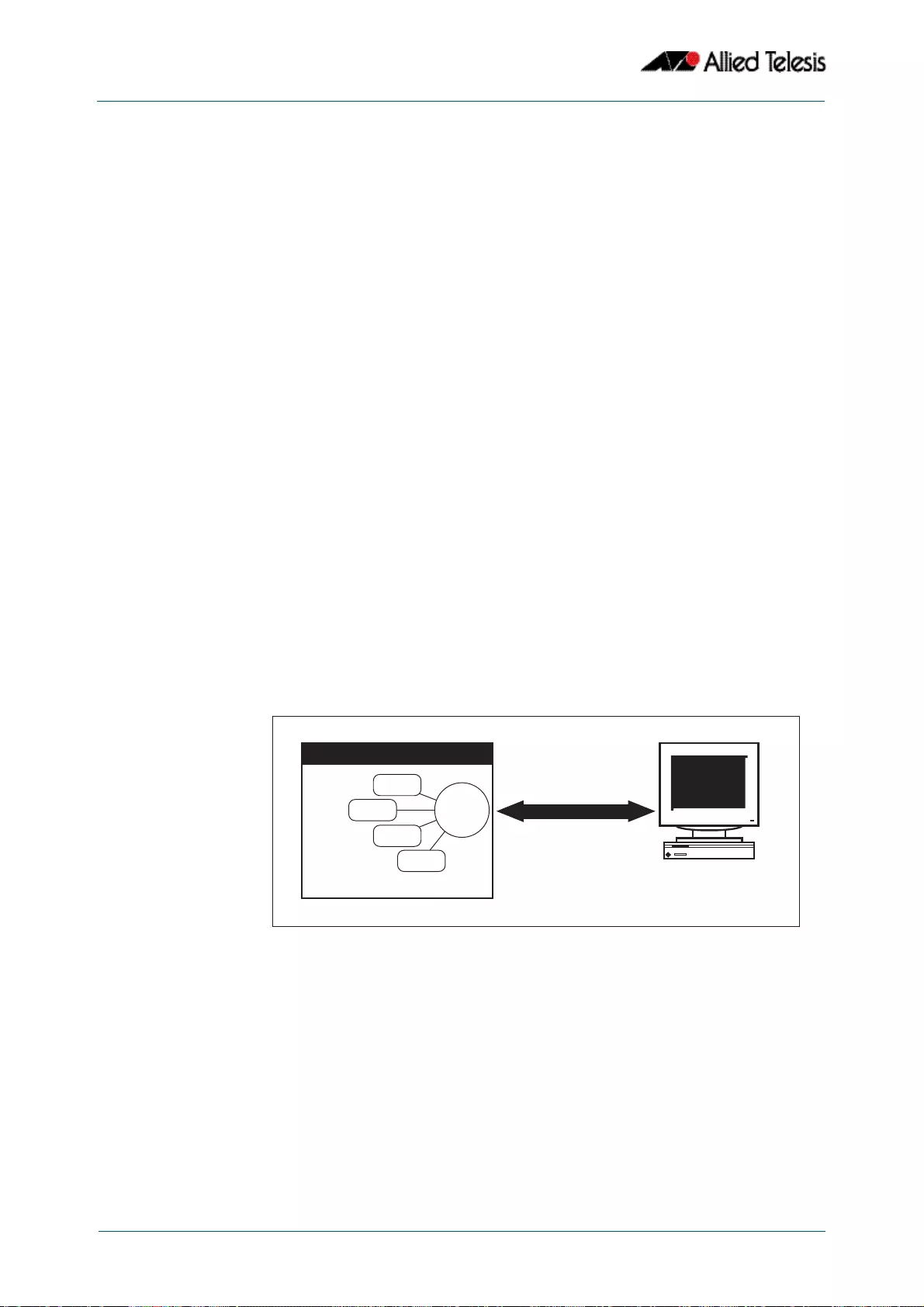
SNMP Introduction
Software Reference for GS900MX/MPX Series Switches
66.2 AlliedWare PlusTM Operating System - Version 5.4.4E-1.x C613-50065-01 REV B
Introduction
The Simple Network Management Protocol (SNMP) is the network management protocol
of choice for the Internet and IP-based internetworks.
This chapter describes the main features of SNMP Version 1 (SNMPv1), SNMP Version 2c
(SNMPv2c) and Version 3 (SNMPv3). It also describes support for SNMP on the switch, and
how to configure the switch’s SNMP agent.
Unless a particular version of SNMP is named, “SNMP” in this chapter refers to versions
SNMPv1, SNMPv2c and SNMPv3.
See also Chapter 67, SNMP Commands and Chapter 68, SNMP MIBs.
Network Management Framework
A network management system has the following components:
■One or more managed devices, each containing an agent that provides the
management functions. A managed device may be any computing device with a
network capability, for example, a host system, workstation, terminal server, printer,
router, switch, bridge, hub or repeater.
■One or more Network Management Stations (NMS). An NMS is a host system
running a network management protocol and network management applications,
enabling the user to manage the network.
■A network management protocol used by the NMS and agents to exchange
information.
Figure 66-1: Components of a network management system
The Internet-standard Network Management Framework is the framework used for
network management in the Internet. The framework was originally defined by the
following documents:
■RFC 1155, Structure and identification of management information for TCP/IP based
internets (referred to as the SMI), details the mechanisms used to describe and name
the objects to be managed.
■RFC 1213, Management Information Base for network management of TCP/ IP-based
internets: MIB-II (referred to as MIB-II), defines the core set of managed objects for the
Internet suite of protocols. The set of managed objects can be extended by adding
other MIBs specific to particular protocols, interfaces or network devices.
■RFC 1157, A Simple Network Management Protocol (SNMP), is the protocol used for
communication between management stations and managed devices.
Network
Management
Protocol
Network Management
Station
Agent
Object
Object
Object
Object
Managed Device
SNMP1

SNMP Introduction
Software Reference for GS900MX/MPX Series Switches
C613-50065-01 REV B AlliedWare PlusTM Operating System - Version 5.4.4E-1.x 66.3
Subsequent documents that have defined SNMPv2c are:
■RFC 1901, Introduction to Community-based SNMPv2
■RFC 1902, Structure of Management Information for Version 2 of the Simple Network
Management Protocol (SNMPv2)
■RFC 1903, Textual Conventions for Version 2 of the Simple Network Management Protocol
(SNMPv2)
■RFC 1904, Conformance Statements for Version 2 of the Simple Network Management
Protocol
■RFC 1905, Protocol Operations for Version 2 of the Simple Network Management Protocol
(SNMPv2)
■RFC 1906, Transport Mappings for Version 2 of the Simple Network Management Protocol
(SNMPv2)
■RFC 1907, Management Information Base for Version 2 of the Simple Network
Management Protocol (SNMPv2)
■RFC 2576, Coexistence between Version 1, Version 2, and Version 3 of the Internet-
standard Network Management Framework
■RFC 2578, Structure of Management Information Version 2 (SMIv2)
■RFC 2579, Textual Conventions for SMIv2
■RFC 2580, Conformance Statements for SMIv2
Subsequent documents that have defined SNMPv3 are:
■RFC 3410, Introduction and Applicability Statements for Internet Standard Management
Framework
■RFC 3411, An Architecture for Describing Simple Network Management Protocol (SNMP)
Management Frameworks
■RFC 3412, Message Processing and Dispatching for the Simple Network Management
Protocol (SNMP)
■RFC 3413, Simple Network Management Protocol (SNMP) Applications
■RFC 3414, User-based Security Model (USM) for version 3 of the Simple Network
Management Protocol (SNMPv3)
■RFC 3415, View-based Access Control Model (VACM) for the Simple Network Management
Protocol (SNMP)
■RFC 3416, Version 2 of the Protocol Operations for the Simple Network Management
Protocol (SNMP)
■RFC 3417, Transport Mappings for the Simple Network Management Protocol (SNMP)
■RFC 3418, Management Information Base (MIB) for the Simple Network Management
Protocol (SNMP)
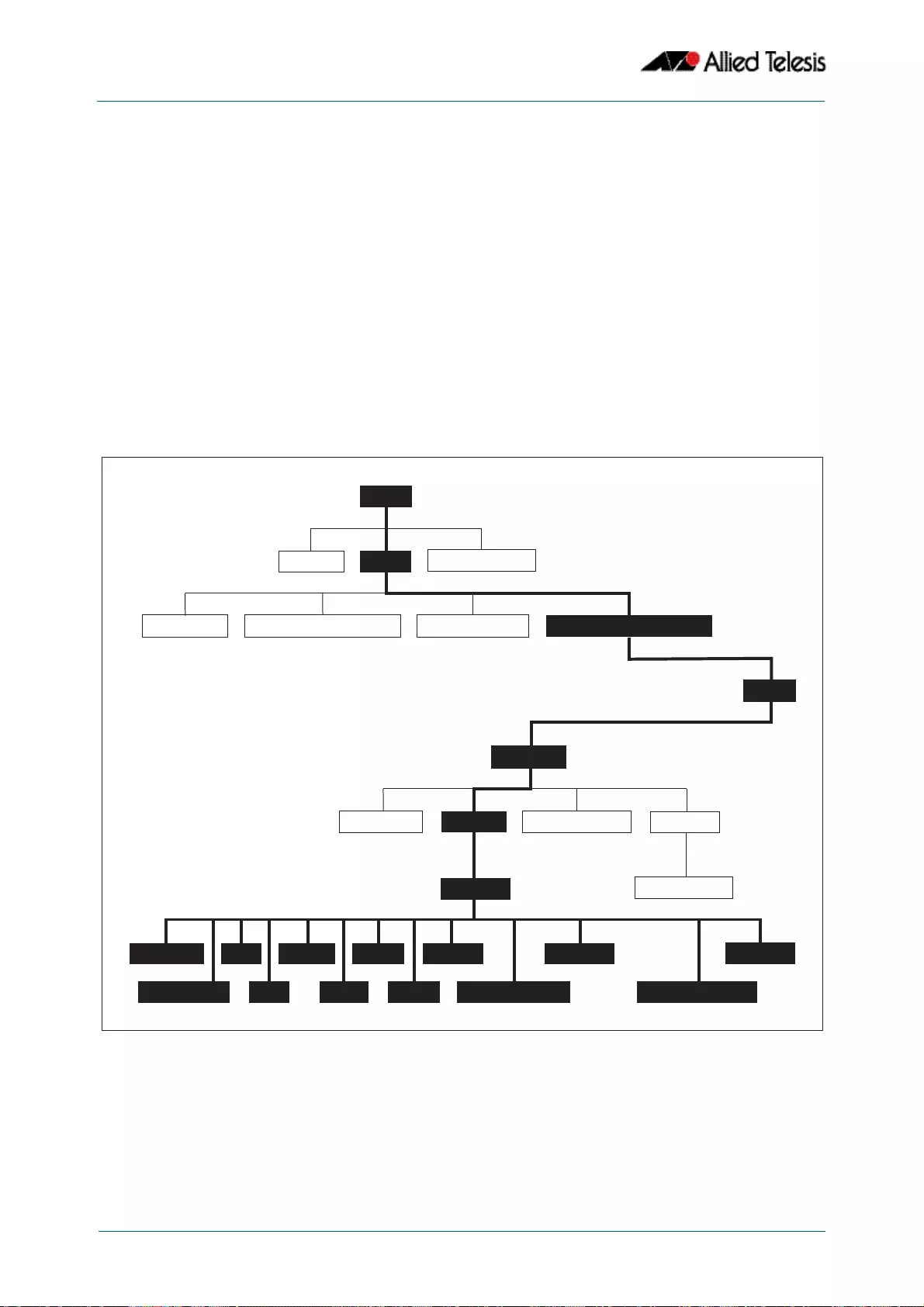
SNMP Introduction
Software Reference for GS900MX/MPX Series Switches
66.4 AlliedWare PlusTM Operating System - Version 5.4.4E-1.x C613-50065-01 REV B
Structure of Management Information
The structure of management information (SMI) defines the schema for a collection of
managed objects residing in a virtual store called the management information base
(MIB). The information in a MIB includes administrative and operational configuration
information, as well as counters of system events and activities.
The MIB is organized into a tree-like hierarchy in which nodes are each assigned an
identifier consisting of a non-negative integer and an optional brief textual description.
Each managed object is represented by a leaf node and is defined by its name, syntax,
access mode, status and description. It can also be specifically identified by its unique
position within the tree. This position is expressed as a series of dot-delimited sub-
identifiers that start at the root node and end in the sub-identifier at the particular object’s
leaf node. For example, in Figure 66-2 the object named interfaces would be uniquely
identified by the string of individual sub-identifiers, 1.3.6.1.2.1.2.
Figure 66-2: Top levels of the Internet-standard Management Information Base (MIB)
Objects defined in the Internet-standard MIB (MIB-II) reside in the mib(1) sub-tree.
system (1)
interfaces (2)
at (3)
ip (4)
icmp (5)
tcp (6)
udp (7)
egp (8)
cmot (9)
transmission (10)
snmp (11)
mib-2 (1)
internet (1)
enterprises (1)
directory (1) private (4)
experimental (3)mgmt (2)
mib (1)dod (6)
member-body (2)
standard (0) registration-authority (1) identified-organisation (3)
iso (1)
ccitt (0)
root
joint-iso-ccitt (2)
SNMP2
dot1dBridge (17)
host (25)
...
...

SNMP Introduction
Software Reference for GS900MX/MPX Series Switches
C613-50065-01 REV B AlliedWare PlusTM Operating System - Version 5.4.4E-1.x 66.5
Names
Names are used to identify managed objects, and are hierarchical in nature. An object
identifier is a globally unique, authoritatively assigned sequence of non-negative integers
which traverse the MIB tree from the root to the node containing the object.
Object identifiers may be represented in one of the following forms:
■Dotted notation lists the integer values found by traversing the tree from the root to
the node in question, separated by dots. For example, the following identifies the
MIB-II sub-tree:
1.3.6.1.2.1
The following identifies the sysDescr object in the system group of MIB-II:
1.3.6.1.2.1.1.1
■Textual notation lists the textual descriptions found by traversing the tree from the
root to the node in question, separated by spaces and enclosed in braces. The
following example identifies the internet sub-tree:
{ iso org dod 1}
The name may be abbreviated to a relative form. The following example identifies the
first (directory) node of the internet sub-tree:
{ internet 1}
■Combined notation lists both the integer values and textual descriptions found by
traversing the tree from the root to the node in question. The integer value is placed
in parentheses after the textual description. The labels are separated by spaces and
enclosed in braces. For example, the following identifies the first (directory) node in
the internet sub-tree:
{iso(1) org(3) dod(6) internet(1) 1}
The name may be abbreviated to the following:
directory(1)
Since there is no effective limit to the magnitude of non-negative integers, and no
effective limit to the depth of the tree, the MIB provides an unlimited name space.
An object is also usually assigned an object descriptor. The object descriptor is a unique,
mnemonic, printable string intended for humans to use when discussing the MIB.

SNMP Introduction
Software Reference for GS900MX/MPX Series Switches
66.6 AlliedWare PlusTM Operating System - Version 5.4.4E-1.x C613-50065-01 REV B
Instances
Objects are just templates for data types. An actual value that can be manipulated by an
NMS is an instance of an object. An instance is named by appending an instance identifier
to the end of the object’s object identifier. The instance identifier depends on the object’s
data type:
■If the object is not a column in a table, the instance identifier is 0 (zero). For example,
the instance of the sysDescr object is:
sysDescr.0
or 1.3.6.1.2.1.1.1.0
■If the object is a column in a table, the method used to assign an instance identifier
varies. Typically, the value of the index column or columns is used.
The object ifTable in MIB-II contains information about interfaces and is indexed by the
interface number, ifIndex. The instance of the ifDescr object for the first interface is:
ifDescr.1
or 1.3.6.1.2.1.2.2.1.2.1
If the index column is an IP address, the entire IP address is used as the instance identifier.
The object ipRouteTable in MIB-II contains information about IP routes and is indexed by
the destination address, ipRouteDest. The instance of the ipRouteNextHop object for the
route 131.203.9.0 is:
ipRouteNextHop.131.203.9.0
or 1.3.6.1.2.1.4.21.1.7.131.203.9.0
If the table has more than one index, the values of all the index columns are combined to
form the instance identifier. The object tcpConnTable in MIB-II contains information about
existing TCP connections and is indexed by the local IP address (tcpConnLocalAddress),
the local port number (tcpConnLocalPort), the remote IP address (tcpConnRemAddress)
and the remote port number (tcpConnRemPort) of the TCP connection. The instance of
the tcpConnState object for the connection between 131.203.8.36,23 and
131.203.9.197,1066 is:
tcpConnState.131.203.8.36.23.131.203.9.197.1066
or 1.3.6.1.2.1.6.13.1.1.131.203.8.36.23.131.203.9.197.1066

SNMP Introduction
Software Reference for GS900MX/MPX Series Switches
C613-50065-01 REV B AlliedWare PlusTM Operating System - Version 5.4.4E-1.x 66.7
Syntax
The syntax of an object describes the abstract data structure corresponding to that object
type. For example, INTEGER or OCTET STRING.
Access
The access mode of an object describes the level of access for the object.
Access modes for MIB objects:
Status
The status of an object describes the implementation requirements for the object.
Status values for MIB objects:
Description
The definition of an object may include an optional textual description of the meaning
and use of the object. This description is often essential for successful understanding of
the object.
Access Description
Read-only The object’s value can be read but not set.
Read-write The object’s value can be read and set.
Write-only The object’s value can be set but not read.
Not-accessible The object’s value cannot be read or set.
Status Description
Mandatory Managed devices must implement the object.
Optional Managed devices may implement the object.
Obsolete Managed devices need no longer implement the object.
Deprecated Managed devices should implement the object. However, the
object may be deleted from the next version of the MIB. A new
object with equal or superior functionality is defined.

SNMP Introduction
Software Reference for GS900MX/MPX Series Switches
66.8 AlliedWare PlusTM Operating System - Version 5.4.4E-1.x C613-50065-01 REV B
The SNMP Protocol
The SNMP protocol provides a mechanism for management entities, or stations, to extract
information from the Management Information Base (MIB) of a managed device.
The normal method of accessing information in a MIB is to use a Network Management
Station (NMS), typically a PC or workstation, to send commands to the managed device (in
this case the switch) using the SNMP protocol.
SNMP can use a number of different protocols as its underlying transport mechanism, but
the most common transport protocol, and the only one supported by the switch, is UDP.
Therefore the IP module must be enabled and properly configured in order to use SNMP.
SNMP trap messages are sent to UDP port 162; all other SNMP messages are sent to UDP
port 161. The switch’s SNMP agent accepts SNMP messages up to the maximum UDP
length the switch can receive.
Other transport mappings have been defined (e.g. OSI [RFC 1418], AppleTalk [RFC 1419]
and IPX [RFC 1420]), but the standard transport mapping for the Internet (and the one the
switch uses) is UDP. The IP module must be enabled and configured correctly. See
Chapter 25, IP Addressing and Protocol Commands for detailed descriptions of the
commands required to enable and configure IP.
SNMP Versions
The switch supports SNMP version 1 (SNMPv1), SNMP version 2c (SNMPv2c) and SNMP
Version 3 (SNMPv3). The three versions operate similarly.
SNMPv2c updated the original protocol, and offered the following main enhancements:
■a new format for trap messages.
■the get-bulk-request PDU allows for the retrieval of large amounts of data, including
tables, with one message.
■more error codes mean that error responses to set messages have more detail than is
possible with SNMPv1.
■three new exceptions to errors can be returned for get, get-next and get-bulk-request
messages. These are: noSuchObject, noSuchInstance, and endOfMibView.
SNMPv3 provides significant enhancements to address the security weaknesses existing
in the earlier versions. This is achieved by implementing two new major features:
■Authentication - by using password hashing and time stamping.
■Privacy - by using message encryption.
Support for multiple versions of SNMP is achieved by responding to each SNMP request
with a response of the same version. For example, if an SNMPv1 request is sent to the
switch, an SNMPv1 response is returned. If an SNMPv2c request is sent, an SNMPv2c
response is returned. Therefore, authentication and encryption functions are not invoked
when messages are detected as having either an SNMPv1 or SNMPv2c protocol format.

SNMP Introduction
Software Reference for GS900MX/MPX Series Switches
C613-50065-01 REV B AlliedWare PlusTM Operating System - Version 5.4.4E-1.x 66.9
SNMP Messages
The SNMP protocol is termed simple because it has only six operations, or messages—get,
get-next, get-response, set, and trap, and SNMPv2c also has the get-bulk-request
message. The replies from the managed device are processed by the NMS and generally
used to provide a graphical representation of the state of the network. The two major
SNMP operations available to a management station for interacting with a client are the
get and set operations. The SNMP set operator can lead to security breaches, since SNMP
is not inherently very secure. When forced to operate in either SNMPv1 or v2 mode, when
operating with older management stations for example, care must be taken in the choice
and safe-guarding of community names, which are effectively passwords for SNMP.
Polling versus Event Notification
SNMP employs a polling paradigm. A Network Management Station (NMS) polls the
managed device for information as and when it is required, by sending get-request, get-
next-request, and/or get-bulk-request PDUs to the managed device. The managed device
responds by returning the requested information in a get-response PDU. The NMS may
manipulate objects in the managed device by sending a set-request PDU to the managed
device.
The only time that a managed device initiates an exchange of information is in the special
case of a trap PDU. A managed device may generate a limited set of traps to notify the
NMS of critical events that may affect the ability of the NMS to communicate with the
managed device or other managed devices on the network, and therefore to “manage”
the network. Such events include the restarting or re-initialization of a device, a change in
the status of a network link (up or down), or an authentication failure.

SNMP Introduction
Software Reference for GS900MX/MPX Series Switches
66.10 AlliedWare PlusTM Operating System - Version 5.4.4E-1.x C613-50065-01 REV B
Message Format for SNMPv1 and SNMPv2c
Table 66-1: Fields in an SNMP message
Table 66-2: SNMP PDUs
Table 66-3: Generic SNMP traps
Field Function
Version The version of the SNMP protocol. The value is version-1 (0) for
the SNMP protocol as defined in RFC 1157, or version-2c (1) for
the SNMP protocol as defined in RFC 1902.
Community The name of an SNMP community, for authentication purposes
SNMP PDU An SNMP Protocol Data Unit (PDU).
PDU Function
get-request Sent by an NMS to an agent, to retrieve the value of an object.
get-next-request Sent by an NMS to an agent, to retrieve the value of the next
object in the sub-tree. A sub-tree is traversed by issuing a get-
request PDU followed by successive get-next-request PDUs.
get-bulk-request Sent by an NMS to an agent to request a large amount of data
with a single message. This is for SNMPv2c messages.
set-request Sent by an NMS to an agent, to manipulate the value of an
object. SNMP PDU Version Community
get-response Sent by an agent to an NMS in response to a get-request, get-
next-request, get-bulk-response, or set-request PDU.
trap Sent by an agent to an NMS to notify the NMS of a extraordinary
event.
report Although not explicitly defined in the RFCs, reports are used for
specific purposes such as EngineID discovery and time
synchronization.
Value Meaning
coldStart The agent is re-initializing itself. Objects may be altered.
warmStart The agent is re-initializing itself. Objects are not altered.
linkDown An interface has changed state from up to down.
linkUp An interface has changed state from down to up.
authenticationFailure An SNMP message has been received with an invalid
community name.
egpNeighborLoss An EGP peer has transitioned to down state.

SNMP Introduction
Software Reference for GS900MX/MPX Series Switches
C613-50065-01 REV B AlliedWare PlusTM Operating System - Version 5.4.4E-1.x 66.11
SNMP Communities (Version v1 and v2c)
A community is a relationship between an NMS and an agent. The community name is
used like a password for a trivial authentication scheme. Both SNMPv1 and SNMPv2c
provide security based on the community name only. The concept of communities does
not exist for SNMPv3, which instead provides for a far more secure communications
method using entities, users, and groups.
SNMPv3 Entities
Entities comprise one of the basic components of the SNMPv3 enhanced architecture.
They define the functionality and internal structure of the SNMP managers and agents. An
in-depth description of entities can be found in RFC 3411, on which the following text is
based. SNMPv3 defines two entity types, a manager and an agent. Both entity types
contain two basic components: an SNMP engine and a set of applications.
SNMP engine
The engine provides the basic services to support the agents component applications, in
this respect it performs much of the functionality expected of the ISO Session and
Presentation layers. These functions include message transmission and reception,
authentication and encryption, and access control to its managed objects database (MIB).
The SNMP engine comprises the following components:
■Dispatcher
■Message processing Subsystem
■Security Subsystem
■Access Control Subsystem
The only security subsystem presently supported is the user based security model (USM).
Each SNMP engine is identified by an snmpEngineID that must be unique within the
management system. A one to one association exists between an engine and the entity
that contains it.
Entity applications
The following applications are defined within the agent applications:
■Command Generator
■Notification Receiver
■Proxy Forwarder
■Command Responder
■Notification Originator
■Other
Caution We strongly recommend removing community membership from all
SNMPv3 configured devices to prevent access to them via SNMPv1 and
SNMv2c, which could bypass the additional SNMPv3 security features.

SNMP Introduction
Software Reference for GS900MX/MPX Series Switches
66.12 AlliedWare PlusTM Operating System - Version 5.4.4E-1.x C613-50065-01 REV B
SNMPv3 Message Protocol Format
Table 66-4: SNMPv3 PDUs
Value Meaning
msgVersion Identifies the message format to be SNMPv3.
msgID An identifier used between SNMP entities to coordinate
message requests and responses. Note that a message
response takes the msgID value of the initiating
message.
msgMaxSize Conveys the maximum message size (in octets) an
integer between 484 and 231-1, supported by the sender
of the message. Specified as msgFlags. A single octet
whose last three bits indicate the operational mode for
privacy, authentication, and report.
msgSecurityModel An identifier used to indicate the security mode (i.e.
SNMPv1, SNMPv2c or SNMPv3 to be used when
processing the message. Note that although only the
SNMPv3 identifier is accepted by the switch, these
earlier version message formats are detected by the
msgVersion field and processed appropriately.
msgAuthoritativeEngineID The ID of the authoritative engine that relates to a
particular message, i.e. the source engine ID for Traps,
Responses and Reports, and the destination engine for
Gets, GetNexts, Sets, and Informs.
msgAuthoritativeEngineBoots A value that represents the number of times the
authoritative engine has rebooted since its installation.
Its value has the range 1 to 231-1.
msgAuthoritativeEngineTime The number of seconds since the authoritative engine
snmpEngineBoots counter was last incremented.
msgUserName The name of the user (principal) on whose behalf the
message is being exchanged.
msgAuthenticationParameters If the message has been authenticated, this field
contains a serialized OCTET STRING representing the first
12 octets of the HMAC-MD5-96 output done over the
whole message.
msgPrivacyParameters For encrypted data, this field contains the “salt” used to
create the DES encryption Initialization Vector (IV).
ContextEngineID Within a particular administrative domain, this field
uniquely identifies an SNMP entity that may realize an
instance of a context with a particular contextName
ContextName A unique name given to a context within a particular
SNMP entity.

SNMP Introduction
Software Reference for GS900MX/MPX Series Switches
C613-50065-01 REV B AlliedWare PlusTM Operating System - Version 5.4.4E-1.x 66.13
SNMPv1 and SNMPv2c
Although software levels 2.6.3 and higher support the specific facilities of SNMP v1 and v2,
their documentation is available to provide backward compatibility with older network
management systems. The far superior security features offered by implementing
SNMPv3 should be used wherever possible.
The switch’s implementation of SNMPv1 is based on RFC 1157, A Simple Network
Management Protocol (SNMP), and RFC 1812, Requirements for IP Version 4 Routers.
When the SNMP agent is disabled, the agent does not respond to SNMP request
messages. The agent is disabled by default. The current state and configuration of the
SNMP agent can be displayed.
SNMP MIB Views for SNMPv1 and SNMPv2c
An SNMP MIB view is a arbitrary subset of objects in the MIB. Objects in the view may be
from any part of the object name space, and not necessarily the same sub-tree. An SNMP
community profile is the pairing of an SNMP access mode (read-only or read-write) with
the access mode defined by the MIB for each object in the view. For each object in the
view, the community profile defines the operations that can be performed on the object.
Pairing an SNMP community with an SNMP community profile determines the level of
access that the agent affords to an NMS that is a member of the specified community.
When an agent receives an SNMP message, it checks the community name encoded in the
message. If the agent knows the community name, the message is deemed to be
authentic and the sending SNMP entity is accepted as a member of the community. The
community profile associated with the community name then determines the sender’s
view of the MIB and the operations that can be performed on objects in the view.
SNMP Communities
SNMP communities were introduced into SNMPv1 and retained in version 2c. Although
the switch’s software still supports communities, this is to provide backward compatibility
with legacy management systems. Communities should not be used where a secure
network is required. Instead, use the secure network features offered by SNMPv3.
An SNMP community is a pairing of an SNMP agent with a set of SNMP application
entities. Communities are the main configuration item in the switch’s implementation of
SNMPv1 and v2, and are defined in terms of a list of IP addresses which define the SNMP
application entities (trap hosts and management stations) in the community.
Important community names act as passwords and provide minimal authentication. Any
SNMP application entity that knows a community name can read the value of any instance
of any object in the MIB implemented in the switch. Any SNMP application entity that
knows the name of a community with write access can change the value of any instance of
any object in the MIB implemented in the switch, possibly affecting the operation of the
switch. For this reason, take care with the security of community names.
When a trap is generated by the SNMP agent it is forwarded to all trap hosts in all
communities. The community name and manager addresses are used to provide trivial
authentication. An incoming SNMP message is deemed authentic if it contains a valid
community name and originated from an IP address defined as a management station for
that community.
When a community is disabled, the SNMP agent behaves as if the community does not
exist and generates authentication failure traps for messages directed to the disabled
community.

SNMP Introduction
Software Reference for GS900MX/MPX Series Switches
66.14 AlliedWare PlusTM Operating System - Version 5.4.4E-1.x C613-50065-01 REV B
The SNMP agent does not support a default community called “public” with read-only
access, traps disabled and open access as mandated in RFC 1812, as this is a security hole
open for users who wish to use the switch with minimal modification to the default
configuration. The default configuration of the switch has no defined communities.
Communities must be explicitly created.
SNMP authentication (for SNMPv1 and v2) is a mechanism whereby an SNMP message is
declared to be authentic, that is from an SNMP application entity actually in the
community to which the message purports to belong. The mechanism may be trivial or
secure. The only form of SNMP authentication implemented by the switch’s SNMP agent is
trivial authentication. The authentication failure trap may be generated as a result of the
failure to authentication an SNMP message.
Switch interfaces can be enabled or disabled via SNMP by setting the ifAdminStatus
object in the ifTable of MIB-II MIB to ‘Up(1)’ or ‘Down(2)’ for the corresponding ifIndex. If it
is not possible to change the status of a particular interface the switch returns an SNMP
error message.
The switch’s implementation of the ifOperStatus object in the ifTable of MIB-II MIB
supports two additional values—”Unknown(4)” and “Dormant(5)” (e.g. an inactive dial-on-
demand interface).
An SNMP MIB view is a subset of objects in the MIB that pertain to a particular network
element. For example, the MIB view of a hub would be the objects relevant to
management of the hub, and would not include IP routing table objects, for example. The
switch’s SNMP agent does not allow the construction of MIB views. The switch supports all
relevant objects from all MIBs that it implements.
Note that the switch’s standard set and show commands can also be used to access
objects in the MIBs supported by the switch.
Defining
management
stations within
communities
You can add management stations to a community either individually, by entering just its
IP address, or you can enter a range of management stations by entering an IP address
that ends with a ‘/’ character followed by a number between 1 and 32. The number that
follows the ‘/’ character operates as an address mask to define a range of addresses for the
management stations. The following example shows how to allocate a band of three
binary addresses to a portion of the subnet 146.15.1.X
Example In this example we make provision for up to 8 possible management stations within a
community called “admin”.
Step 1:
Decide on the number of management stations that you want to assign to a particular
subnet, then decide how many binary digits are required to define this number of
addresses. In this case we need up to 8 management stations, so we will assign 3 binary
digits (3 binary digits can provide 8 different values). To assign the last 3 binary digits for
management stations, we assign a prefix that is a count of all binary digits in the address
minus those to be assigned as management stations. In this case the prefix is 29; this
being the number of binary digits in an IP address (32) minus the number of digits
assigned to the management stations (3).
Caution An unauthorized person with knowledge of the appropriate SNMP
community name could bring an interface up or down. Community names
act as passwords for the SNMP protocol. When creating an SNMP
community with write access, take care to select a secure community name
and to ensure that only authorized personnel know it.

SNMP Introduction
Software Reference for GS900MX/MPX Series Switches
C613-50065-01 REV B AlliedWare PlusTM Operating System - Version 5.4.4E-1.x 66.15
Step 2:
The method used in this step depends on whether or not the community already exists.
■If the community called “admin” does not exist, create a new community called
“admin” and allocate a three binary digit block of addresses to the address subnet
146.15.1.X.
■If the community called “admin” already exists, allocate a three binary digit block of
addresses to an existing community called “admin” with the address subnet
146.15.1.X.
For security reasons, the common management prefix should be larger than the IP subnet.
This prevents stations on one subnet from being considered valid management stations
on a different subnet.
Configuration Example (SNMPv1 and v2)
This example shows how to configure the switch’s SNMP agent. Two network
management stations have been set up on a large network. The central NMS (IP address
192.168.11.5) monitors devices on the network and uses SNMP set messages to manage
devices on the network. Trap messages are sent to this management station. The regional
network management station (IP addresses 192.168.16.1) is used just to monitor devices
on the network by using SNMP get messages. Link traps are enabled for all interfaces on
this particular switch.
IP and VLANs must be correctly configured in order to access the SNMP agent in the
switch. This is because the IP module handles both the TCP transport functions, and the
UDP functions that enable datagrams to transport SNMP messages. See Chapter 25, IP
Addressing and Protocol Commands for commands that enable and configure IP.
To configure SNMP Step 1: Enable the SNMP agent.
Enable the SNMP agent and enable the generation of authenticate failure traps to monitor
unauthorized SNMP access. SNMP is enabled by default in AlliedWare Plus.
Step 2: Create a community with write access for the central NMS.
Create a write access community called “example1rw” for use by the central network
management station at 192.168.11.5 Use an ACL to give the central NMS SNMP access to
the switch using that community name.
Care must be taken with the security of community names. Do not use the names “private”
or “public” in your network because they are too obvious. Community names act as
passwords and provide only trivial authentication. Any SNMP application entity that
knows a community name can read the value of any instance of any object in the MIB
implemented in the switch. Any SNMP application entity that knows the name of a
community with write access can change the value of any instance of any object in the
MIB implemented in the switch, possibly affecting the operation of the switch.
SNMP V1 or V2c provide very minimal security. If security is a concern, you should use
SNMPv3.
awplus(config)# snmp-server enable trap auth
awplus(config)# access-list 66 permit 192.168.11.5
awplus(config)# snmp-server community example1rw rw 66

SNMP Introduction
Software Reference for GS900MX/MPX Series Switches
66.16 AlliedWare PlusTM Operating System - Version 5.4.4E-1.x C613-50065-01 REV B
Step 3: Create a community with read-only access for the regional
NMS.
Create a read-only access community called “example2ro” for use by the regional network
management station at 192.168.16.1. Use an ACL to give the regional NMS SNMP access to
the switch using that community name.
Step 4: Enable link traps.
Enable link traps for the desired interfaces. In this example, the NSMs are in VLAN 2 and
VLAN 3 and other ports are in VLAN 1 for simplicity.
Note that link traps on VLANs are sent when the last port in the VLAN goes down. You will
only see a trap for a VLAN if the trap host is in a different VLAN.
You can also enable link traps on channel groups and switch ports. For example, to enable
traps on a range of switch ports:
You can also enable link traps on channel groups and switch ports. For example, to enable
traps on a range of switch ports:
Step 5: Configure trap hosts.
Specify the IP address or addresses that the traps will get sent to. In this example, traps will
be sent to both NMSes.
Step 6: Check the configuration.
Check that the current configuration of the SNMP communities matches the desired
configuration:
awplus(config)# access-list 67 permit 192.168.16.1
awplus(config)# snmp-server community example2ro ro 67
awplus(config)# interface vlan1-3
awplus(config-if)# snmp trap link-status
awplus(config)# int port1.0.4-1.0.6
awplus(config-if)# snmp trap link-status
awplus(config)# snmp-server host 192.168.11.5 version 2c
example1rw
awplus(config)# snmp-server host 192.168.16.1 version 2c
example2ro
awplus# show snmp-server
awplus# show snmp-server community
awplus# show run snmp

SNMP Introduction
Software Reference for GS900MX/MPX Series Switches
C613-50065-01 REV B AlliedWare PlusTM Operating System - Version 5.4.4E-1.x 66.17
This is the output of the show snmp-server community command for this example:
This is the output of the show run snmp command for this example:
Check that the interface link up/down traps have been correctly configured:
This is the output of the show interface command for this example:
SNMP community information:
Community Name ........... example1rw
Access ................. Read-write
View ................... none
Community Name ........... example2ro
Access ................. Read-only
View ................... none
no snmp-server ip
snmp-server enable trap auth
snmp-server community example1rw rw 66
snmp-server community example2ro 67
snmp-server host 192.168.1.2 version 2c example1rw
snmp-server host 192.168.2.2 version 2c example2ro
!
awplus# show interface vlan1-3
Interface vlan1
Scope: both
Link is UP, administrative state is UP
Hardware is VLAN, address is 0009.41fd.c029
index 201 metric 1 mtu 1500
arp ageing timeout 300
<UP,BROADCAST,RUNNING,MULTICAST>
SNMP link-status traps: Sending (suppressed after 20 traps in 60 sec)
Bandwidth 1g
input packets 4061, bytes 277043, dropped 0, multicast packets 3690
output packets 190, bytes 18123, multicast packets 0 broadcast packets 0
Interface vlan2
Scope: both
Link is DOWN, administrative state is UP
Hardware is VLAN, address is 0009.41fd.c029
IPv4 address 192.168.11.50/24 broadcast 192.168.11.255
index 202 metric 1 mtu 1500
arp ageing timeout 300
<UP,BROADCAST,MULTICAST>
SNMP link-status traps: Sending (suppressed after 20 traps in 60 sec)
Bandwidth 1g
input packets 568, bytes 42309, dropped 0, multicast packets 0
output packets 183, bytes 18078, multicast packets 0 broadcast packets 0
Interface vlan3
Scope: both
Link is DOWN, administrative state is UP
Hardware is VLAN, address is 0009.41fd.c029
IPv4 address 192.168.16.50/24 broadcast 192.168.16.255
index 203 metric 1 mtu 1500
arp ageing timeout 300
<UP,BROADCAST,MULTICAST>
SNMP link-status traps: Sending (suppressed after 20 traps in 60 sec)
input packets 0, bytes 0, dropped 0, multicast packets 0
output packets 0, bytes 0, multicast packets 0 broadcast packets 0

SNMP Introduction
Software Reference for GS900MX/MPX Series Switches
66.18 AlliedWare PlusTM Operating System - Version 5.4.4E-1.x C613-50065-01 REV B
SNMPv3
SNMPv3 is the third version of the Simple Network Management Protocol. The
architecture comprises the following:
■entities that may be either managers, agents, or both
■a management information base (MIB)
■a transport protocol
At least one manager node runs the SNMP management software in every configuration.
Managed devices such as routers, servers, and workstations are equipped with an agent
software module. The agent provides access to local objects in the MIB that reflect activity
and resources at the node. The agent also responds to manager commands to retrieve
values from, and set values in the MIB.
SNMP MIB Views for SNMPv3
An SNMP MIB view is a arbitrary subset of objects in the MIB. Objects in the view may be
from any part of the object name space, and not necessarily the same sub-tree.
SNMP Groups
Groups were introduced as part of SNMPv3. They are the means by which users are
assigned their views and access control policy. Once a group has been created, users can
be added to them. In practice a number of groups would be created, each with varying
views and access security requirements. Users would then be added to their most
appropriate groups. Each Group name and Security Level pair must be unique within a
switch.
SNMP Users
Users were introduced as part of SNMPv3. From a system perspective a user is represented
as an entity stored in a table that defines the access and authentication criteria to be
applied to access or modify the SNMP MIB data.
Note SNMP Target Addresses and Target Params in SNMPv3 are not currently
supported in Alliedware Plus software.

SNMP Introduction
Software Reference for GS900MX/MPX Series Switches
C613-50065-01 REV B AlliedWare PlusTM Operating System - Version 5.4.4E-1.x 66.19
Configuration Example (SNMPv3)
This example shows how to configure the switch's SNMP agent. Two network
management stations have been set up on a large network. The central NMS (IP address
192.168.11.5) monitors devices on the network and uses SNMP set messages to manage
devices on the network. Trap messages are sent to this management station.
The IP module must be enabled and correctly configured in order to access the SNMP
agent in the switch, since the IP module handles the UDP datagrams used to transport
SNMP messages.
To configure SNMP Step 1: Enable the SNMP agent.
Enable the SNMP agent and enable the generation of authenticate failure traps to monitor
unauthorized SNMP access. SNMP is enabled by default in AlliedWare Plus.
Step 2: Add SNMP views.
You can specify views using their OID or the predefined MIB name.
Step 3: Add SNMP group.
Step 4: Add SNMP users.
Add users to the groups by using commands such as:
awplus(config)# snmp-server view atmib 1.3.6.1.2.14
included
awplus(config)# snmp-server view atmib alliedtelesis
included
awplus(config)# snmp-server group ord-user noauth read
atmib
awplus(config)# snmp-server group admin-user auth read
atmib write atmib notify atmi
awplus(config)# snmp-server user ken admin-user auth md5
mercury

SNMP Introduction
Software Reference for GS900MX/MPX Series Switches
66.20 AlliedWare PlusTM Operating System - Version 5.4.4E-1.x C613-50065-01 REV B
Using SNMP to Manage Files and Software
The Allied Telesis Enterprise MIB (Chapter 68, SNMP MIBs) includes objects for managing
files and software on the switch. This section includes procedures for using MIB objects on
the switch to perform some common tasks, via an SNMP management application:
■“Copy a File to or from a TFTP Server” on page 66.20
■“Upgrade Software and Configuration Files” on page 66.22
For more details about the Allied Telesis Enterprise MIB and public MIBs on the switch, see
Chapter 68, SNMP MIBs.
Copy a File to or from a TFTP Server
Use this procedure to copy a file (for example, a software version file) to the switch from a
TFTP server, or to copy a file (for example, a configuration file) from the switch to a TFTP
server. The MIB objects in this procedure reside in the module atFilev2 { modules 600 },
with object ID 1.3.6.1.4.1.207.8.4.4.4.600. For detailed descriptions of the MIB objects used
in this procedure, and other file management MIB objects, see “AT-FILEv2-MIB” on
page 68.32. Other MIB objects can be used in a similar way for moving and deleting files
on the switch.
Table 66-5: Procedure for copying a file to or from a device using a TFTP server
Do this ...
By setting or reading this MIB
object ... Whose object ID is ... To this value ...
1. If the source device is part
of a stack, set the stack ID.
For a standalone switch,
keep the default value, 1.
atFilev2SourceStackId { atFilev2Operation 1 } <stack-id>
2. If the destination device is
part of a stack, set the
stack ID.
atFilev2DestinationStackId { atFilev2Operation 4 } <stack-id>
3. Set the source device. atFilev2SourceDevice { atFilev2Operation 2 } 4 (TFTP) or
1 (Flash)
4. Set the destination device. atFilev2DestinationDevice { atFilev2Operation 5 } 4 (TFTP) or
1 (Flash)
5. Set the source filename.
Include the path (if any)
but not the device.
atFilev2SourceFileName { atFilev2Operation 3 } <source-filename>
e.g. /awp/config/
admin.cfg
6. Set the destination
filename. Include the path
(if any) but not the device.
atFilev2DestinationFileName { atFilev2Operation 6 } <dest-filename>
e.g. /config/admin.cfg

SNMP Introduction
Software Reference for GS900MX/MPX Series Switches
C613-50065-01 REV B AlliedWare PlusTM Operating System - Version 5.4.4E-1.x 66.21
7. Set the IP address of the
TFTP server.
atFilev2TftpIPAddr {atFilev2Tftp_4 1} <ip-addr>
8. Check that no other
transfer is in progress, and
that the required
parameters have been set.
atFilev2CopyBegin { atFilev2Operation 7 } Read: idle
9. Start the file transfer. atFilev2CopyBegin { atFilev2Operation 7 } Set: 1
10. Monitor file transfer
progress. atFilev2CopyBegin { atFilev2Operation 7 } Read:
In progress:
copying <src> -->
<dst>
or
Success:
copy <src> --> <dst>
success
or
Failure:
copy <src> --> <dst>
failure: <err-msg>
Table 66-5: Procedure for copying a file to or from a device using a TFTP server
Do this ...
By setting or reading this MIB
object ... Whose object ID is ... To this value ...

SNMP Introduction
Software Reference for GS900MX/MPX Series Switches
66.22 AlliedWare PlusTM Operating System - Version 5.4.4E-1.x C613-50065-01 REV B
Upgrade Software and Configuration Files
Use this procedure to upgrade to a new software version and boot configuration file. For
detailed descriptions of the MIB objects used in this procedure, and other MIB objects for
managing software installation and configuration files, see “AT-SETUP-MIB” on
page 68.57.
Table 66-6: Procedure for upgrading to a new software version and boot configuration
Do this ...
By reading or
setting this MIB
object ... Whose object ID is ... To this value ...
1. Check that you have
enough flash memory
for the currently running
software file, the new
software version file,
and any configuration
scripts required.
2. Check the version and
name of the software
currently running.
currSoftVersion
currSoftName
1.3.6.1.4.1.207.8.4.4.4.500.2.1.1
1.3.6.1.4.1.207.8.4.4.4.500.2.1.2
Read:
<software-name>
<software-version>
3. If you do not already
have the currently
running software as a
software version file in
flash, save the currently
running software with a
file name to the flash
root.
currSoftSaveToFile 1.3.6.1.4.1.207.8.4.4.4.500.2.1.4 Set:
<backup-filename.rel>
4. Check that the file saved
successfully. (The most
common failures result
from lack of flash
memory space.)
currSoftSaveStatus 1.3.6.1.4.1.207.8.4.4.4.500.2.1.5 Read:
■1 (idle) - there is no release
file save operation in
progress
■2 (success) - the last release
file save operation
completed successfully
■3 (failure) - the last release
file save operation failed
■4 (saving) - a release file
save operation is currently
in progress
5. Copy the new software
version file to flash
memory on the device
See Table 66-5.
6. Set the new release file
to be the current release
that the device will
install and run the next
time it restarts. Include
the path.
nextBootPath 1.3.6.1.4.1.207.8.4.4.4.500.2.2.2 Set:
<next-filename>
e.g.:
flash:/release.rel
7. Check the version of
release file set to install
next.
nextBootVersion 1.3.6.1.4.1.207.8.4.4.4.500.2.2.1 Read:
<software-version>

SNMP Introduction
Software Reference for GS900MX/MPX Series Switches
C613-50065-01 REV B AlliedWare PlusTM Operating System - Version 5.4.4E-1.x 66.23
8. Set the previous release
file to be the backup
release that the device
will install and run if the
device fails to boot
successfully with the
new release file.
Include the path.
bckpPath 1.3.6.1.4.1.207.8.4.4.4.500.2.3.2 Set:
<backup-filename>
e.g.:
flash:/release.rel
9. Check the version of
backup release file.
bckpVersion 1.3.6.1.4.1.207.8.4.4.4.500.2.3.1 Read:
<software-version>
10. If necessary, copy a
configuration file to the
device (Table 66-5), or
save the current running
configuration to a file in
the root directory of
flash. To save the
running configuration,
specify the filename, but
not a device or path.
See Table 66-5.
or
runCnfgSaveAs 1.3.6.1.4.1.207.8.4.4.4.500.3.1.1 Set:
<filename.cfg>
e.g.:
myconfig.cfg
11. Check and if necessary
set the file the device
will use for
configuration when it
restarts.
Include the full path.
bootCnfgPath 1.3.6.1.4.1.207.8.4.4.4.500.3.2.1 Read/set:
<filename.cfg>
e.g.:
flash:/myconfig.cfg
12. Check that a boot
configuration file
matching the boot
configuration path
exists.
bootCnfgExists 1.3.6.1.4.1.207.8.4.4.4.500.3.2.2 Read:
TRUE (1)
or
FALSE (2)
13. Check that the default
configuration file
flash:/default.cfg exists.
dfltCnfgExists 1.3.6.1.4.1.207.8.4.4.4.500.3.3.2 Read:
TRUE (1)
or
FALSE (2)
14. Restart the device. restartDevice 1.3.6.1.4.1.207.8.4.4.4.500.1 1
Table 66-6: Procedure for upgrading to a new software version and boot configuration(cont.)
Do this ...
By reading or
setting this MIB
object ... Whose object ID is ... To this value ...

SNMP Introduction
Software Reference for GS900MX/MPX Series Switches
66.24 AlliedWare PlusTM Operating System - Version 5.4.4E-1.x C613-50065-01 REV B

Software Reference for GS900MX/MPX Series Switches
C613-50065-01 REV B AlliedWare PlusTM Operating System - Version 5.4.4E-1.x 67.1
Chapter 67: SNMP Commands
Command List .................................................................................................................................... 67.2
debug snmp........................................................................................................................................ 67.2
show counter snmp-server............................................................................................................ 67.4
show debugging snmp................................................................................................................... 67.8
show running-config snmp........................................................................................................... 67.8
show snmp-server............................................................................................................................. 67.9
show snmp-server community .................................................................................................... 67.9
show snmp-server group .............................................................................................................67.10
show snmp-server user.................................................................................................................67.10
show snmp-server view ................................................................................................................67.11
snmp trap link-status .....................................................................................................................67.12
snmp trap link-status suppress ..................................................................................................67.13
snmp-server ......................................................................................................................................67.15
snmp-server community ..............................................................................................................67.16
snmp-server contact ......................................................................................................................67.17
snmp-server enable trap ..............................................................................................................67.18
snmp-server engineID local .......................................................................................................67.20
snmp-server engineID local reset..............................................................................................67.22
snmp-server group.........................................................................................................................67.23
snmp-server host ............................................................................................................................67.24
snmp-server location .....................................................................................................................67.26
snmp-server source-interface.....................................................................................................67.27
snmp-server startup-trap-delay.................................................................................................67.28
snmp-server user.............................................................................................................................67.29
snmp-server view............................................................................................................................67.31
undebug snmp ................................................................................................................................67.32

SNMP Commands
Software Reference for GS900MX/MPX Series Switches
67.2 AlliedWare PlusTM Operating System - Version 5.4.4E-1.x C613-50065-01 REV B
Command List
This chapter provides an alphabetical reference for commands used to configure SNMP.
For more information, see Chapter 66, SNMP Introduction, and Chapter 68, SNMP
MIBs.
For information about modifying or redirecting the output from show commands to a file,
see “Controlling “show” Command Output” on page 1.35.
debug snmp
This command enables SNMP debugging.
The no variant of this command disables SNMP debugging.
Syntax debug snmp [all|detail|error-string|process|receive|send|xdump]
no debug snmp [all|detail|error-string|process|receive|send|xdump]
Mode Privileged Exec and Global Configuration
Example To start SNMP debugging, use the command:
To start SNMP debugging, showing detailed SNMP debugging information, use the
command:
Parameter Description
all Enable or disable the display of all SNMP debugging information.
detail Enable or disable the display of detailed SNMP debugging
information.
error-string Enable or disable the display of debugging information for SNMP
error strings.
process Enable or disable the display of debugging information for
processed SNMP packets.
receive Enable or disable the display of debugging information for
received SNMP packets.
send Enable or disable the display of debugging information for sent
SNMP packets.
xdump Enable or disable the display of hexadecimal dump debugging
information for SNMP packets.
awplus# debug snmp
awplus# debug snmp detail

SNMP Commands
Software Reference for GS900MX/MPX Series Switches
C613-50065-01 REV B AlliedWare PlusTM Operating System - Version 5.4.4E-1.x 67.3
To start SNMP debugging, showing all SNMP debugging information, use the command:
Related Commands show debugging snmp
terminal monitor
undebug snmp
awplus# debug snmp all

SNMP Commands
Software Reference for GS900MX/MPX Series Switches
67.4 AlliedWare PlusTM Operating System - Version 5.4.4E-1.x C613-50065-01 REV B
show counter snmp-server
This command displays counters for SNMP messages received by the SNMP agent.
Syntax show counter snmp-server
Mode User Exec and Privileged Exec
Example To display the counters for the SNMP agent, use the command:
Output Figure 67-1: Example output from the show counter snmp-server command
awplus# show counter snmp-server
SNMP-SERVER counters
inPkts ......... 11
inBadVersions ......... 0
inBadCommunityNames ......... 0
inBadCommunityUses ......... 0
inASNParseErrs ......... 0
inTooBigs ......... 0
inNoSuchNames ......... 0
inBadValues ......... 0
inReadOnlys ......... 0
inGenErrs ......... 0
inTotalReqVars ......... 9
inTotalSetVars ......... 0
inGetRequests ......... 2
inGetNexts ......... 9
inSetRequests ......... 0
inGetResponses ......... 0
inTraps ......... 0
outPkts ......... 11
outTooBigs ......... 0
outNoSuchNames ......... 2
outBadValues ......... 0
outGenErrs ......... 0
outGetRequests ......... 0
outGetNexts ......... 0
outSetRequests ......... 0
outGetResponses ......... 11
outTraps ......... 0
UnSupportedSecLevels ......... 0
NotInTimeWindows ......... 0
UnknownUserNames ......... 0
UnknownEngineIDs ......... 0
WrongDigest ......... 0
DecryptionErrors ......... 0
UnknownSecModels ......... 0
InvalidMsgs ......... 0
UnknownPDUHandlers ......... 0

SNMP Commands
Software Reference for GS900MX/MPX Series Switches
C613-50065-01 REV B AlliedWare PlusTM Operating System - Version 5.4.4E-1.x 67.5
Table 67-1: Parameters in the output of show counter snmp-server
Parameter Meaning
inPkts The total number of SNMP messages received by the
SNMP agent.
inBadVersions The number of messages received by the SNMP agent
for an unsupported SNMP version. It drops these
messages.The SNMP agent on your device supports
versions 1, 2C, and 3.
inBadCommunityNames The number of messages received by the SNMP agent
with an unrecognized SNMP community name. It drops
these messages.
inBadCommunityUses The number of messages received by the SNMP agent
where the requested SNMP operation is not permitted
from SNMP managers using the SNMP community
named in the message.
inASNParseErrs The number of ASN.1 or BER errors that the SNMP agent
has encountered when decoding received SNMP
Messages.
inTooBigs The number of SNMP PDUs received by the SNMP agent
where the value of the error-status field is ‘tooBig'. This
is sent by an SNMP manager to indicate that an
exception occurred when processing a request from the
agent.
inNoSuchNames The number of SNMP PDUs received by the SNMP agent
where the value of the error-status field is
‘noSuchName'. This is sent by an SNMP manager to
indicate that an exception occurred when processing a
request from the agent.
inBadValues The number of SNMP PDUs received by the SNMP agent
where the value of the error-status field is ‘badValue'.
This is sent by an SNMP manager to indicate that an
exception occurred when processing a request from the
agent.
inReadOnlys The number of valid SNMP PDUs received by the SNMP
agent where the value of the error-status field is
‘readOnly'. The SNMP manager should not generate a
PDU which contains the value ‘readOnly' in the error-
status field. This indicates that there is an incorrect
implementations of the SNMP.
inGenErrs The number of SNMP PDUs received by the SNMP agent
where the value of the error-status field is ‘genErr'.
inTotalReqVars The number of MIB objects that the SNMP agent has
successfully retrieved after receiving valid SNMP
Get-Request and Get-Next PDUs.
inTotalSetVars The number of MIB objects that the SNMP agent has
successfully altered after receiving valid SNMP Set-
Request PDUs.
inGetRequests The number of SNMP Get-Request PDUs that the SNMP
agent has accepted and processed.
inGetNexts The number of SNMP Get-Next PDUs that the SNMP
agent has accepted and processed.
inSetRequests The number of SNMP Set-Request PDUs that the SNMP
agent has accepted and processed.

SNMP Commands
Software Reference for GS900MX/MPX Series Switches
67.6 AlliedWare PlusTM Operating System - Version 5.4.4E-1.x C613-50065-01 REV B
inGetResponses The number of SNMP Get-Response PDUs that the
SNMP agent has accepted and processed.
inTraps The number of SNMP Trap PDUs that the SNMP agent
has accepted and processed.
outPkts The number of SNMP Messages that the SNMP agent
has sent.
outTooBigs The number of SNMP PDUs that the SNMP agent has
generated with the value ‘tooBig’ in the error-status
field. This is sent to the SNMP manager to indicate that
an exception occurred when processing a request from
the manager.
outNoSuchNames The number of SNMP PDUs that the SNMP agent has
generated with the value `noSuchName' in the
error-status field. This is sent to the SNMP manager to
indicate that an exception occurred when processing a
request from the manager.
outBadValues The number of SNMP PDUs that the SNMP agent has
generated with the value ‘badValue’ in the error-status
field. This is sent to the SNMP manager to indicate that
an exception occurred when processing a request from
the manager.
outGenErrs The number of SNMP PDUs that the SNMP agent has
generated with the value ‘genErr' in the error-status
field. This is sent to the SNMP manager to indicate that
an exception occurred when processing a request from
the manager.
outGetRequests The number of SNMP Get-Request PDUs that the SNMP
agent has generated.
outGetNexts The number of SNMP Get-Next PDUs that the SNMP
agent has generated.
outSetRequests The number of SNMP Set-Request PDUs that the SNMP
agent has generated.
outGetResponses The number of SNMP Get-Response PDUs that the
SNMP agent has generated.
outTraps The number of SNMP Trap PDUs that the SNMP agent
has generated.
UnSupportedSecLevels The number of received packets that the SNMP agent
has dropped because they requested a securityLevel
unknown or not available to the SNMP agent.
NotInTimeWindows The number of received packets that the SNMP agent
has dropped because they appeared outside of the
authoritative SNMP agent’s window.
UnknownUserNames The number of received packets that the SNMP agent
has dropped because they referenced an unknown
user.
UnknownEngineIDs The number of received packets that the SNMP agent
has dropped because they referenced an unknown
snmpEngineID.
WrongDigest The number of received packets that the SNMP agent
has dropped because they didn't contain the expected
digest value.
Table 67-1: Parameters in the output of show counter snmp-server (cont.)
Parameter Meaning

SNMP Commands
Software Reference for GS900MX/MPX Series Switches
C613-50065-01 REV B AlliedWare PlusTM Operating System - Version 5.4.4E-1.x 67.7
Related Commands show snmp-server
DecryptionErrors The number of received packets that the SNMP agent
has dropped because they could not be decrypted.
UnknownSecModels The number of messages received that contain a
security model that is not supported by the server. Valid
for SNMPv3 messages only.
InvalidMsgs The number of messages received where the security
model is supported but the authentication fails. Valid
for SNMPv3 messages only.
UnknownPDUHandlers The number of times the SNMP handler has failed to
process a PDU. This is a system debugging counter.
Table 67-1: Parameters in the output of show counter snmp-server (cont.)
Parameter Meaning

SNMP Commands
Software Reference for GS900MX/MPX Series Switches
67.8 AlliedWare PlusTM Operating System - Version 5.4.4E-1.x C613-50065-01 REV B
show debugging snmp
This command displays whether SNMP debugging is enabled or disabled.
Syntax show debugging snmp
Mode User Exec and Privileged Exec
Example To display the status of SNMP debugging, use the command:
Output Figure 67-2: Example output from the show debugging snmp command
Related Commands debug snmp
show running-config snmp
This command displays the current configuration of SNMP on your device.
Syntax show running-config snmp
Mode Privileged Exec
Example To display the current configuration of SNMP on your device, use the command:
Output Figure 67-3: Example output from the show running-config snmp command
Related Commands show snmp-server
awplus# show debugging snmp
Snmp (SMUX) debugging status:
Snmp debugging is on
awplus# show running-config snmp
snmp-server contact AlliedTelesis
snmp-server location Philippines
snmp-server group grou1 auth read view1 write view1 notify view1
snmp-server view view1 1 included
snmp-server community public
snmp-server user user1 group1 auth md5 password priv des
password

SNMP Commands
Software Reference for GS900MX/MPX Series Switches
C613-50065-01 REV B AlliedWare PlusTM Operating System - Version 5.4.4E-1.x 67.9
show snmp-server
This command displays the status and current configuration of the SNMP server.
Syntax show snmp-server
Mode Privileged Exec
Example To display the status of the SNMP server, use the command:
Output Figure 67-4: Example output from the show snmp-server command
Related Commands debug snmp
show counter snmp-server
snmp-server
snmp-server engineID local
snmp-server engineID local reset
show snmp-server community
This command displays the SNMP server communities configured on the device. SNMP
communities are specific to v1 and v2c.
Syntax show snmp-server community
Mode Privileged Exec
Example To display the SNMP server communities, use the command:
Output Figure 67-5: Example output from the show snmp-server community command
Related Commands show snmp-server
snmp-server community
awplus# show snmp-server
SNMP Server .......................... Enabled
IP Protocol .......................... IPv4
SNMPv3 Engine ID (configured name) ... Not set
SNMPv3 Engine ID (actual) ............ 0x80001f888021338e4747b8e607
awplus# show snmp-server community
SNMP community information:
Community Name ........... public
Access ................. Read-only
View ................... none

SNMP Commands
Software Reference for GS900MX/MPX Series Switches
67.10 AlliedWare PlusTM Operating System - Version 5.4.4E-1.x C613-50065-01 REV B
show snmp-server group
This command displays information about SNMP server groups. This command is used
with SNMP version 3 only.
Syntax show snmp-server group
Mode Privileged Exec
Example To display the SNMP groups configured on the device, use the command:
Output Figure 67-6: Example output from the show snmp-server group command
Related Commands show snmp-server
snmp-server group
show snmp-server user
This command displays the SNMP server users and is used with SNMP version 3 only.
Syntax show snmp-server user
Mode Privileged Exec
Example To display the SNMP server users configured on the device, use the command:
Output Figure 67-7: Example output from the show snmp-server user command
Related Commands show snmp-server
snmp-server user
awplus# show snmp-server group
SNMP group information:
Group name .............. guireadgroup
Security Level ........ priv
Read View ............. guiview
Write View ............ none
Notify View ........... none
Group name .............. guiwritegroup
Security Level ........ priv
Read View ............. none
Write View ............ guiview
Notify View ........... none
awplus# show snmp-server user
Name Group name Auth Privacy
------- ------------- ------- ----------
freddy guireadgroup none none

SNMP Commands
Software Reference for GS900MX/MPX Series Switches
C613-50065-01 REV B AlliedWare PlusTM Operating System - Version 5.4.4E-1.x 67.11
show snmp-server view
This command displays the SNMP server views and is used with SNMP version 3 only.
Syntax show snmp-server view
Mode Privileged Exec
Example To display the SNMP server views configured on the device, use the command:
Output Figure 67-8: Example output from the show snmp-server view command
Related Commands show snmp-server
snmp-server view
awplus# show snmp-server view
SNMP view information:
View Name ............... view1
OID .................... 1
Type ................... included

SNMP Commands
Software Reference for GS900MX/MPX Series Switches
67.12 AlliedWare PlusTM Operating System - Version 5.4.4E-1.x C613-50065-01 REV B
snmp trap link-status
Use this command to enable SNMP to send link status notifications (traps) for the
interfaces when an interface goes up (linkUp) or down (linkDown).
Use the no variant of this command to disable the sending of link status notifications.
Syntax snmp trap link-status
no snmp trap link-status
Default By default, link status notifications are disabled.
Mode Interface Configuration
Usage The link status notifications can be enabled for the following interface types:
■device port (e.g. port 1.0.1)
■VLAN (e.g. vlan2)
■static and dynamic link aggregation (e.g. sa2, po2)
To specify where notifications are sent, use the snmp-server host command on page
67.24. To configure the device globally to send other notifications, use the snmp-server
enable trap command on page 67.18.
Examples To enable SNMP to send link status notifications for ports 1.0.2 to 1.0.6, use following
commands:
To disable the sending of link status notifications for port 1.0.2, use following commands:
Related Commands show interface
snmp trap link-status suppress
snmp-server enable trap
snmp-server host
awplus# configure terminal
awplus(config)# interface port1.0.2-1.0.6
awplus(config-if)# snmp trap link-status
awplus# configure terminal
awplus(config)# interface port1.0.2
awplus(config-if)# no snmp trap link-status

SNMP Commands
Software Reference for GS900MX/MPX Series Switches
C613-50065-01 REV B AlliedWare PlusTM Operating System - Version 5.4.4E-1.x 67.13
snmp trap link-status suppress
Use this command to enable the suppression of link status notifications (traps) for the
interfaces beyond the specified threshold, in the specified interval.
Use the no variant of this command to disable the suppression of link status notifications
for the ports.
Syntax snmp trap link-status suppress {time {<1-60>|default}|
threshold {<1-20>|default}}
no snmp trap link-status suppress
Default By default, if link status notifications are enabled (they are enabled by default), the
suppression of link status notifications is enabled: notifications that exceed the
notification threshold (default 20) within the notification timer interval (default 60
seconds) are not sent.
Mode Interface Configuration
Usage An unstable network can generate many link status notifications. When notification
suppression is enabled, a suppression timer is started when the first link status notification
of a particular type (linkUp or linkDown) is sent for an interface. If the threshold number of
notifications of this type is sent before the timer reaches the suppress time, any further
notifications of this type generated for the interface during the interval are not sent. At the
end of the interval, the sending of link status notifications resumes, until the threshold is
reached in the next interval.
Examples To enable the suppression of link status notifications for ports 1.0.2 to 1.0.6 after 10
notifications have been sent in 40 seconds, use following commands:
Parameter Description
time Set the suppression timer for link status notifications.
<1-60>The suppress time in seconds.
default The default suppress time in seconds (60).
threshold Set the suppression threshold for link status notifications. This is the
number of link status notifications after which to suppress further
notifications within the suppression timer interval.
<1-20>The number of link status notifications.
default The default number of link status notifications (20).
awplus# configure terminal
awplus(config)# interface port1.0.2-1.0.6
awplus(config-if)# snmp trap link-status suppress time 40
threshold 10

SNMP Commands
Software Reference for GS900MX/MPX Series Switches
67.14 AlliedWare PlusTM Operating System - Version 5.4.4E-1.x C613-50065-01 REV B
To disable the suppression link status notifications for port 1.0.2, use following commands:
Related Commands show interface
snmp trap link-status
awplus# configure terminal
awplus(config)# interface port1.0.2
awplus(config-if)# no snmp trap link-status suppress

SNMP Commands
Software Reference for GS900MX/MPX Series Switches
C613-50065-01 REV B AlliedWare PlusTM Operating System - Version 5.4.4E-1.x 67.15
snmp-server
Use this command to enable the SNMP agent (server) on the device. The SNMP agent
receives and processes SNMP packets sent to the device, and generates notifications
(traps) that have been enabled by the snmp-server enable trap command on page 67.18.
Use the no variant of this command to disable the SNMP agent on the device. When SNMP
is disabled, SNMP packets received by the device are discarded, and no notifications are
generated. This does not remove any existing SNMP configuration.
Syntax snmp-server [ip|ipv6]
no snmp-server [ip|ipv6]
Default By default, the SNMP agent is enabled for both IPv4 and IPv6. If neither the ip parameter
nor the ipv6 parameter is specified for this command, then SNMP is enabled or disabled
for both IPv4 and IPv6.
Mode Global Configuration
Examples To enable SNMP on the device for both IPv4 and IPv6, use the commands:
To enable the SNMP agent for IPv4 on the device, use the commands:
To disable the SNMP agent for both IPv4 and IPv6 on the device, use the commands:
To disable the SNMP agent for IPv4, use the commands:
Related Commands show snmp-server
show snmp-server community
show snmp-server user
snmp-server community
snmp-server contact
snmp-server enable trap
snmp-server engineID local
snmp-server group
snmp-server host
snmp-server location
snmp-server view
Parameter Description
ip Enable or disable the SNMP agent for IPv4.
ipv6 Enable or disable the SNMP agent for IPv6.
awplus# configure terminal
awplus(config)# snmp-server
awplus# configure terminal
awplus(config)# snmp-server ip
awplus# configure terminal
awplus(config)# no snmp-server
awplus(config)# no snmp-server ipv4

SNMP Commands
Software Reference for GS900MX/MPX Series Switches
67.16 AlliedWare PlusTM Operating System - Version 5.4.4E-1.x C613-50065-01 REV B
snmp-server community
This command creates an SNMP community, optionally setting the access mode for the
community. The default access mode is read only. If view is not specified, the community
allows access to all the MIB objects. The SNMP communities are only valid for SNMPv1 and
v2c and provide very limited security. Communities should not be used when operating
SNMPv3.
The no variant of this command removes an SNMP community. The specified community
must already exist on the device.
Syntax snmp-server community <community-name> {view <view-name>|ro|rw|
<access-list>}
no snmp-server community <community-name> [{view <view-name>|<access-
list>}]
Mode Global Configuration
Example The following command creates an SNMP community called “public” with read only
access to all MIB variables from any management station.
The following command removes an SNMP community called “public”
Related Commands show snmp-server
show snmp-server community
snmp-server view
Parameter Description
<community-name> Community name. The community name is a case sensitive
string of up to 20 characters.
view Configure SNMP view. If view is not specified, the community
allows access to all the MIB objects.
<view-name> View name. The view name is a string up to 20 characters long
and is case sensitive.
ro Read-only community.
rw Read-write community.
<access-list> <1-99> Access list number.
awplus# configure terminal
awplus(config)# snmp-server community public ro
awplus# configure terminal
awplus(config)# no snmp-server community public

SNMP Commands
Software Reference for GS900MX/MPX Series Switches
C613-50065-01 REV B AlliedWare PlusTM Operating System - Version 5.4.4E-1.x 67.17
snmp-server contact
This command sets the contact information for the system. The contact name is:
■displayed in the output of the show system command
■stored in the MIB object sysContact
The no variant of this command removes the contact information from the system.
Syntax snmp-server contact <contact-info>
no snmp-server contact
Mode Global Configuration
Example To set the system contact information to “support@alliedtelesis.co.nz”, use the command:
Related Commands show system
snmp-server location
snmp-server group
Parameter Description
<contact-info> The contact information for the system, from 0 to 255 characters
long. Valid characters are any printable character and spaces.
awplus# configure terminal
awplus(config)# snmp-server contact support@alliedtelesis.co.nz

SNMP Commands
Software Reference for GS900MX/MPX Series Switches
67.18 AlliedWare PlusTM Operating System - Version 5.4.4E-1.x C613-50065-01 REV B
snmp-server enable trap
Use this command to enable the device to send the specified notifications (traps).
Note that the Environmental Monitoring traps are enabled by default. So you do not need
to issue this command for the Environmental Monitoring traps since these are enabled by
default. SNMP environmental monitoring traps defined in AT-ENVMONv2-MIB are enabled
by default.
Use the no variant of this command to disable the sending of the specified notifications.
Syntax snmp-server enable trap {[atmf][atmflink][atmfnode][atmfrr][auth]
[dhcpsnooping] [epsr] [lldp] [loopprot] [mstp] [nsm]
[power-inline] [rmon] [thrash-limit] [vcs]}
no snmp-server enable trap {[atmf][atmflink][atmfnode][atmfrr][auth]
[dhcpsnooping] [epsr] [lldp] [loopprot] [mstp] [nsm]
[power-inline] [rmon] [thrash-limit] [vcs]}
Default By default, no notifications are generated.
Mode Global Configuration
Parameter Description
atmf ATMF traps.
atmflink ATMF Link traps.
atmfnode ATMF Node traps.
atmfrr ATMF Reboot Rolling traps.
auth Authentication failure.
dhcpsnooping DHCP snooping and ARP security traps. These notifications must
also be set using the ip dhcp snooping violation command on
page 56.22, and/or the arp security violation command on
page 56.3.
epsr EPSR traps.
lldp Link Layer Discovery Protocol (LLDP) traps. These notifications
must also be enabled using the lldp notifications command on
page 70.13, and/or the lldp med-notifications command on
page 70.8.
loopprot Loop Protection traps.
mstp MSTP traps.
nsm NSM traps.
power-inline Power-inline traps (Power Ethernet MIB RFC 3621).
rmon RMON traps.
thrash-limit MAC address Thrash Limiting traps.
vcs VCS traps.

SNMP Commands
Software Reference for GS900MX/MPX Series Switches
C613-50065-01 REV B AlliedWare PlusTM Operating System - Version 5.4.4E-1.x 67.19
Usage This command cannot be used to enable link status notifications globally. To enable link
status notifications for particular interfaces, use the snmp trap link-status command.
To specify where notifications are sent, use the snmp-server host command.
Note that more than one trap can be configured with one command entry, and also note
this command applied to notifications send by SNMP version 3.
Examples To enable the device to send a notification if an atmf node changes its status, use the
following commands:
To enable the device to send PoE related traps, use the following commands:
To disable PoE traps being sent out by the device, use the following commands:
To enable the device to send MAC address Thrash Limiting traps, use the following
commands:
To disable the device from sending MAC address Thrash Limiting traps, use the following
commands:
Related Commands show snmp-server
show ip dhcp snooping
snmp trap link-status
snmp-server host
awplus# configure terminal
awplus(config)# snmp-server enable trap atmfnode
awplus# configure terminal
awplus(config)# snmp-server enable trap power-inline
awplus# configure terminal
awplus(config)# no snmp-server enable power-inline
awplus# configure terminal
awplus(config)# snmp-server enable trap thrash-limit
awplus# configure terminal
awplus(config)# no snmp-server enable trap thrash-limit

SNMP Commands
Software Reference for GS900MX/MPX Series Switches
67.20 AlliedWare PlusTM Operating System - Version 5.4.4E-1.x C613-50065-01 REV B
snmp-server engineID local
Use this command to configure the SNMPv3 engine ID. The SNMPv3 engine ID is used to
uniquely identify the SNMPv3 agent on a device when communicating with SNMP
management clients. Once an SNMPv3 engine ID is assigned, this engine ID is
permanently associated with the device until you change it.
Use the no variant of this command to set the user defined SNMPv3 engine ID to a system
generated pseudo-random value by resetting the SNMPv3 engine. The no snmp-server
engineID local command has the same effect as the snmp-server engineID local default
command. Note that the snmp-server engineID local reset command is used to force
the system to generate a new engine ID when the current engine ID is also system
generated.
Syntax snmp-server engineID local {<engine-id>|default}
no snmp-server engineID local
Mode Global Configuration
Usage All devices must have a unique engine ID which is permanently set unless it is configured
by the user.
In a stacked environment, if the same engine ID was automatically generated for all
members of the stack, conflicts would occur if the stack was dismantled. Therefore, each
member of the stack will generate its own engine ID and the stack master's ID is used
when transmitting SNMPv3 packets. Should a master failover occur, a different engine ID is
transmitted. You can modify this behavior by manually assigning all stack members the
same engine ID using the snmp-server engineID local command. However, should you
decide to separate the stack and use the devices individually, you must remember to
change or remove this configuration to prevent conflicts.
Example To set the SNMPv3 engine ID to 800000cf030000cd123456, use the following commands:
To set a user defined SNMPv3 engine ID back to a system generated value, use the
following commands:
Parameter Description
<engine-id> Specify SNMPv3 Engine ID value, a string of up to 27 characters.
default Set SNMPv3 engine ID to a system generated value by resetting the
SNMPv3 engine, provided the current engine ID is user defined. If the
current engine ID is system generated, use the snmp-server
engineID local reset command to force the system to generate a
new engine ID.
awplus# configure terminal
awplus(config)# snmp-server engineID local
800000cf030000cd123456
awplus# configure terminal
awplus(config)# no snmp-server engineID local

SNMP Commands
Software Reference for GS900MX/MPX Series Switches
C613-50065-01 REV B AlliedWare PlusTM Operating System - Version 5.4.4E-1.x 67.21
Output The following example shows the engine ID values after configuration:
Validation
Commands
show snmp-server
Related Commands snmp-server engineID local reset
snmp-server group
awplus(config)#snmp-server engineid local asdgdfh231234d
awplus(config)#exit
awplus#show snmp-server
SNMP Server .......................... Enabled
IP Protocol .......................... IPv4
SNMPv3 Engine ID (configured name) ... asdgdfh231234d
SNMPv3 Engine ID (actual) ............ 0x80001f888029af52e149198483
awplus(config)#no snmp-server engineid local
awplus(config)#exit
awplus#show snmp-server
SNMP Server .......................... Enabled
IP Protocol .......................... IPv4
SNMPv3 Engine ID (configured name) ... Not set
SNMPv3 Engine ID (actual) ............ 0x80001f888029af52e149198483

SNMP Commands
Software Reference for GS900MX/MPX Series Switches
67.22 AlliedWare PlusTM Operating System - Version 5.4.4E-1.x C613-50065-01 REV B
snmp-server engineID local reset
Use this command to force the device to generate a new pseudo-random SNMPv3 engine
ID by resetting the SNMPv3 engine. If the current engine ID is user defined, use the snmp-
server engineID local command to set SNMPv3 engine ID to a system generated value.
Syntax snmp-server engineID local reset
Mode Global Configuration
Example To force the SNMPv3 engine ID to be reset to a system generated value, use the
commands:
Validation
Commands
show snmp-server
Related Commands snmp-server engineID local
awplus# configure terminal
awplus(config)# snmp-server engineID local reset

SNMP Commands
Software Reference for GS900MX/MPX Series Switches
C613-50065-01 REV B AlliedWare PlusTM Operating System - Version 5.4.4E-1.x 67.23
snmp-server group
This command is used with SNMP version 3 only, and adds an SNMP group, optionally
setting the security level and view access modes for the group. The security and access
views defined for the group represent the minimum required of its users in order to gain
access.
The no variant of this command deletes an SNMP group, and is used with SNMPv3 only.
The group with the specified authentication/encryption parameters must already exist.
Syntax snmp-server group <groupname> {auth|noauth|priv} [read <readname>|
write <writename>|notify <notifyname>]
no snmp-server group <groupname> {auth|noauth|priv}
Mode Global Configuration
Examples To add SNMP group, for ordinary users, user the following commands:
To delete SNMP group usergroup, use the following commands
Related Commands snmp-server
show snmp-server
show snmp-server group
show snmp-server user
Parameter Description
<groupname>Group name. The group name is a string up to 20 characters long
and is case sensitive.
auth Authentication.
noauth No authentication and no encryption.
priv Authentication and encryption.
read Configure read view.
<readname>Read view name.
write Configure write view.
<writename>Write view name. The view name is a string up to 20 characters long
and is case sensitive.
notify Configure notify view.
<notifyname>Notify view name. The view name is a string up to 20 characters long
and is case sensitive.
awplus# configure terminal
awplus(config)# snmp-server group usergroup noauth read
useraccess write useraccess
awplus# configure terminal
awplus(config)# no snmp-server group usergroup noauth

SNMP Commands
Software Reference for GS900MX/MPX Series Switches
67.24 AlliedWare PlusTM Operating System - Version 5.4.4E-1.x C613-50065-01 REV B
snmp-server host
This command specifies an SNMP trap host destination to which Trap or Inform messages
generated by the device are sent.
For SNMP version 1 and 2c you must specify the community name parameter. For SNMP
version 3, specify the authentication/encryption parameters and the user name. If the
version is not specified, the default is SNMP version 1. Inform messages can be sent
instead of traps for SNMP version 2c and 3.
Use the no variant of this command to remove an SNMP trap host. The trap host must
already exist.
The trap host is uniquely identified by:
■host IP address (IPv4 or IPv6),
■inform or trap messages,
■community name (SNMPv1 or SNMP v2c) or the authentication/encryption
parameters and user name (SNMP v3).
Syntax snmp-server host {<ipv4-address>|<ipv6-address>} [traps] [version 1]
<community-name>]
snmp-server host {<ipv4-address>|<ipv6-address>} [informs|traps]
version 2c <community-name>
snmp-server host {<ipv4-address>|<ipv6-address>} [informs|traps]
version 3 {auth|noauth|priv} <user-name>
no snmp-server host {<ipv4-address>|<ipv6-address>} [traps]
[version 1] <community-name>
no snmp-server host {<ipv4-address>|<ipv6-address>} [informs|traps]
version 2c <community-name>
no snmp-server host {<ipv4-address>|<ipv6-address>} [informs|traps]
version 3 {auth|noauth|priv} <user-name>
Parameter Description
<ipv4-address> IPv4 trap host address in the format A.B.C.D, for example,
192.0.2.2.
<ipv6-address>IPv6 trap host address in the format x:x::x:x for example,
2001:db8::8a2e:7334.
informs Send Inform messages to this host.
traps Send Trap messages to this host (default).
version SNMP version to use for notification messages. Default:
version 1.
1 Use SNMPv1(default).
2c Use SNMPv2c.
3 Use SNMPv3.
auth Authentication.
noauth No authentication.

SNMP Commands
Software Reference for GS900MX/MPX Series Switches
C613-50065-01 REV B AlliedWare PlusTM Operating System - Version 5.4.4E-1.x 67.25
Mode Global Configuration
Examples To configure the device to send generated traps to the IPv4 host destination 192.0.2.5
with the SNMPv2c community name public, use the following command:
To configure the device to send generated traps to the IPv6 host destination
2001:db8::8a2e:7334 with the SNMPv2c community name private, use the
following command:
To remove a configured trap host of 192.0.2.5 with the SNMPv2c community name public,
use the following command:
Related Commands snmp trap link-status
snmp-server enable trap
snmp-server view
priv Encryption.
<community-name>The SNMPv1 or SNMPv2c community name.
<user-name>SNMPv3 user name.
Parameter(cont.) Description(cont.)
awplus# configure terminal
awplus(config)# snmp-server host 192.0.2.5 version 2c public
awplus# configure terminal
awplus(config)# snmp-server host 2001:db8::8a2e:7334 version 2c
private
awplus# configure terminal
awplus(config)# no snmp-server host 192.0.2.5 version 2c public

SNMP Commands
Software Reference for GS900MX/MPX Series Switches
67.26 AlliedWare PlusTM Operating System - Version 5.4.4E-1.x C613-50065-01 REV B
snmp-server location
This command sets the location of the system. The location is:
■displayed in the output of the show system command
■stored in the MIB object sysLocation
The no variant of this command removes the configured location from the system.
Syntax snmp-server location <location-name>
no snmp-server location
Mode Global Configuration
Example To set the location to “server room 523”, use the following commands:
Related Commands show snmp-server
show system
snmp-server contact
Parameter Description
<location-name>The location of the system, from 0 to 255 characters long. Valid
characters are any printable character and spaces.
awplus# configure terminal
awplus(config)# snmp-server location server room 523

SNMP Commands
Software Reference for GS900MX/MPX Series Switches
C613-50065-01 REV B AlliedWare PlusTM Operating System - Version 5.4.4E-1.x 67.27
snmp-server source-interface
Use this command to specify the interface that SNMP traps or informs originate from. You
cannot specify an interface that does not already have an IP address assigned to the
interface.
Use the no variant of this command to reset to the default source interface that SNMP
traps or informs originate from (the Egress interface as sent from by default).
Syntax snmp-server source-interface {traps|informs} <interface-name>
no snmp-server source-interface {traps|informs}
Default By default the source interface is the Egress interface where traps or informs were sent
from.
Mode Global Configuration
Usage An SNMP trap or inform sent from an SNMP server has the notification IP address of the
interface where it was sent from. Use this command to monitor notifications from an
interface.
Example To set the interface that SNMP informs originate from to port 1.0.2 for inform packets, use
the following commands:
To reset the interface to the default source interface (the Egress interface) that SNMP traps
originate from for trap packets, use the following commands:
Validation
Commands
show running-config
Parameter Description
traps SNMP traps.
informs SNMP informs.
<interface-name>Interface name (with an IP address already assigned).
awplus# configure terminal
awplus(config)# snmp-server source-interface informs port1.0.2
awplus# configure terminal
awplus(config)# no snmp-server source-interface traps

SNMP Commands
Software Reference for GS900MX/MPX Series Switches
67.28 AlliedWare PlusTM Operating System - Version 5.4.4E-1.x C613-50065-01 REV B
snmp-server startup-trap-delay
Use this command to set the time in seconds after following completion of the device
startup sequence before the device sends any SNMP traps (or SNMP notifications).
Use the no variant of this command to restore the default startup delay of 30 seconds.
Syntax snmp-server startup-trap-delay <delay-time>
no snmp-server startup-trap-delay
Default The SNMP server trap delay time is 30 seconds. The no variant restores the default.
Mode Global Configuration
Example To delay the device sending SNMP traps until 60 seconds after device startup, use the
following commands:
To restore the sending of SNMP traps to the default of 30 seconds after device startup, use
the following commands:
Validation
Commands
show snmp-server
Parameter Description
<delay-time>Specify an SNMP trap delay time in seconds in the range of 30
to 600 seconds.
awplus# configure terminal
awplus(config)# snmp-server startup-trap-delay 60
awplus# configure terminal
awplus(config)# no snmp-server startup-trap-delay

SNMP Commands
Software Reference for GS900MX/MPX Series Switches
C613-50065-01 REV B AlliedWare PlusTM Operating System - Version 5.4.4E-1.x 67.29
snmp-server user
Use this command to create or move users as members of specified groups. This
command is used with SNMPv3 only.
The no variant of this command removes an SNMPv3 user. The specified user must already
exist.
Syntax snmp-server user <username> <groupname> [encrypted] [auth {md5|
sha} <auth-password>] [priv {des|aes} <privacy-password>]
no snmp-server user <username>
Mode Global Configuration
Usage Additionally this command provides the option of selecting an authentication protocol
and (where appropriate) an associated password. Similarly, options are offered for
selecting a privacy protocol and password.
■Note that each SNMP user must be configured on both the manager and agent
entities. Where passwords are used, these passwords must be the same for both
entities.
■Use the encrypted parameter when you want to enter already encrypted passwords
in encrypted form as displayed in the running and startup configs stored on the
device. For example, you may need to move a user from one group to another group
and keep the same passwords for the user instead of removing the user to apply new
passwords.
■User passwords are entered using plaintext without the encrypted parameter and are
encrypted according to the authentication and privacy protocols selected.
Parameter Description
<username>User name. The user name is a string up to 20 characters
long and is case sensitive.
<groupname>Group name. The group name is a string up to 20
characters long and is case sensitive.
encrypted Use the encrypted parameter when you want to enter
encrypted passwords.
auth Authentication protocol.
md5 MD5 Message Digest Algorithms.
sha SHA Secure Hash Algorithm.
<auth-password>Authentication password. The password is a string of 8 to
20 characters long and is case sensitive.
priv Privacy protocol.
des DES Data Encryption Standard.
aes AES Advanced Encryption Standards.
<privacy-password>Privacy password. The password is a string of 8 to 20
characters long and is case sensitive.

SNMP Commands
Software Reference for GS900MX/MPX Series Switches
67.30 AlliedWare PlusTM Operating System - Version 5.4.4E-1.x C613-50065-01 REV B
■User passwords are viewed as encrypted passwords in running and startup configs
shown from show running-config and show startup-config commands respectively.
Copy and paste encrypted passwords from running-configs or startup-configs to
avoid entry errors.
Examples To add SNMP user authuser as a member of group usergroup, with authentication
protocol md5, authentication password Authpass, privacy protocol des and privacy
password Privpass, use the following commands
Validate the user is assigned to the group using the following command:
To enter existing SNMP user authuser with existing passwords as a member of group
newusergroup with authentication protocol md5 plus the encrypted authentication
password 0x1c74b9c22118291b0ce0cd883f8dab6b74, privacy protocol des plus the
encrypted privacy password 0x0e0133db5453ebd03822b004eeacb6608f, use the
following commands
Validate the user has been moved from the first group using the following command:
To delete SNMP user authuser, use the following commands:
Related Commands show snmp-server user
snmp-server view
awplus# configure terminal
awplus(config)# snmp-server user authuser usergroup auth md5
Authpass priv des Privpass
awplus#show snmp-server user
Name Group name Auth Privacy
------- ------------- ------- ----------
authuser usergroup md5 des
awplus# configure terminal
awplus(config)# snmp-server user authuser newusergroup
encrypted auth md5
0x1c74b9c22118291b0ce0cd883f8dab6b74 priv des
0x0e0133db5453ebd03822b004eeacb6608f
Note Copy and paste the encrypted passwords from the running-config or the
startup-config displayed, using the show running-config and show startup-
config commands respectively, into the command line to avoid key stroke
errors issuing this command.
awplus#show snmp-server user
Name Group name Auth Privacy
------- ------------- ------- ----------
authuser newusergroup md5 des
awplus# configure terminal
awplus(config)# no snmp-server user authuser

SNMP Commands
Software Reference for GS900MX/MPX Series Switches
C613-50065-01 REV B AlliedWare PlusTM Operating System - Version 5.4.4E-1.x 67.31
snmp-server view
Use this command to create an SNMP view that specifies a sub-tree of the MIB. Further
sub-trees can then be added by specifying a new OID to an existing view. Views can be
used in SNMP communities or groups to control the remote manager’s access.
The no variant of this command removes the specified view on the device. The view must
already exist.
Syntax snmp-server view <view-name> <mib-name> {included|excluded}
no snmp-server view <view-name>
Mode Global Configuration
Examples The following command creates a view called “loc” that includes the system location MIB
sub-tree.
To remove the view “loc” use the following command
Related Commands show snmp-server view
snmp-server community
Note The object identifier must be specified in a sequence of integers separated by
decimal points.
Parameter Description
<view-name>SNMP server view name.
The view name is a string up to 20 characters long and is case
sensitive.
<mib-name>Object identifier of the MIB.
included Include this OID in the view.
excluded Exclude this OID in the view.
awplus(config)# snmp-server view loc 1.3.6.1.2.1.1.6.0 included
awplus(config)# no snmp-server view loc

Software Reference for GS900MX/MPX Series Switches
C613-50065-01 REV B AlliedWare PlusTM Operating System - Version 5.4.4E-1.x 68.1
Chapter 68: SNMP MIBs
Introduction ........................................................................................................................................ 68.2
About MIBs ................................................................................................................................... 68.2
About SNMP................................................................................................................................. 68.2
Obtaining MIBs ........................................................................................................................... 68.2
Loading MIBs ............................................................................................................................... 68.3
Allied Telesis Enterprise MIB ......................................................................................................... 68.5
AT-ALMMON-MIB....................................................................................................................... 68.6
AT-ATMF-MIB............................................................................................................................... 68.8
AT-BOARDS-MIB .......................................................................................................................68.13
AT-DHCPSN-MIB.......................................................................................................................68.17
AT-DNS-CLIENT-MIB................................................................................................................68.20
AT-ENVMONv2-MIB.................................................................................................................68.21
AT-EPSRv2-MIB .........................................................................................................................68.29
AT-FILEv2-MIB ...........................................................................................................................68.32
AT-IP-MIB.....................................................................................................................................68.39
AT-LICENSE-MIB........................................................................................................................68.41
AT-LOG-MIB ...............................................................................................................................68.44
AT-LOOPPROTECT-MIB ..........................................................................................................68.46
AT-MIBVERSION-MIB...............................................................................................................68.48
AT-NTP-MIB ................................................................................................................................68.49
AT-PRODUCTS-MIB..................................................................................................................68.52
AT-RESOURCE-MIB...................................................................................................................68.55
AT-SETUP-MIB ...........................................................................................................................68.57
AT-SMI-MIB.................................................................................................................................68.66
AT-SYSINFO-MIB.......................................................................................................................68.68
AT-TRIGGER-MIB.......................................................................................................................68.73
AT-USER-MIB..............................................................................................................................68.75
AT-VCSTACK-MIB......................................................................................................................68.77
Other Enterprise MIBs....................................................................................................................68.82
Public MIBs ........................................................................................................................................68.83

SNMP MIBs
Software Reference for GS900MX/MPX Series Switches
68.2 AlliedWare PlusTM Operating System - Version 5.4.4E-1.x C613-50065-01 REV B
Introduction
This chapter describes the Management Information Bases (MIBs) and managed objects
supported by the AlliedWare Plus™ Operating System. The following topics are covered:
■“Allied Telesis Enterprise MIB” on page 68.5 describes the objects implemented in
the Allied Telesis Enterprise MIB
■“Public MIBs” on page 68.83 describes the public MIBs supported by the
AlliedWare PlusTM Operating System, and any variations from the standard
implementation.
About MIBs
A MIB is a collection of managed objects organized into a tree-like hierarchy of nodes in
which the managed objects form the leaves. Within the tree, each node is identified by a
non-negative integer identifier that is unique among the node’s siblings. The address, or
object identifier, of any node within the tree is expressed as a series of dot-delimited node
identifiers that trace the path from the root of the tree to the node. For example, the
object identifier for the sysDescr object is 1.3.6.1.2.1.1.1.
For more information about MIBs and the structure of management information, see
Chapter 66, SNMP Introduction.
About SNMP
A network management station (NMS) uses a protocol known as Simple Network
Management Protocol (SNMP) to query or change the values of objects in the MIB of
managed devices.
A managed device uses SNMP to respond to queries from an NMS, and to send unsolicited
alerts (traps) to an NMS in response to events.
For more information about the Simple Network Management Protocol (SNMP), see
Chapter 66, SNMP Introduction.
For information about configuring SNMP, see Chapter 67, SNMP Commands.
Obtaining MIBs
You can download MIBs from the following locations:
Note This chapter does not indicate which MIB objects are not-accessible (and
therefore cannot be queried directly). Please consult the MIB files for that
information.
Download this MIB... From this location...
Allied Telesis Enterprise MIB The MIB files are available with the software files from
the Support area at
www.alliedtelesis.com/support/software
Public MIBs defined in RFCs www.rfc-editor.org/rfc.html
IANAifType-MIB www.iana.org/assignments/ianaiftype-mib

SNMP MIBs
Software Reference for GS900MX/MPX Series Switches
C613-50065-01 REV B AlliedWare PlusTM Operating System - Version 5.4.4E-1.x 68.3
Loading MIBs
Individual MIBs define a portion of the total MIB for a device. For example, the MAU-MIB
defines objects for managing IEEE 802.3 medium attachment units (MAUs), and forms a
sub-tree under mib-2 with the object identifier snmpDot3MauMgt (1.3.6.1.2.1.26).
All the objects within a MIB are assigned object identifiers relative to a parent object. Most
MIBs import the object identifier of the parent object, along with other object identifiers,
textual conventions, macros and syntax types from the MIBs where they are defined. This
creates dependencies between MIBs.
Some network management stations and MIB compilers will generate errors if you load a
MIB that depends on another MIB that has not already been loaded. To avoid these errors,
we recommend that you load MIBs in the following order:
1. RFC 1212
RFC 1239
RFC 2257
RFC 3410
2. RFC1155-SMI (RFC 1155)
SNMPv2-SMI (RFC 2578)
SNMPv2-PDU (RFC 3416)
3. RFC1213-MIB (RFC 1213)
RFC 1215
SNMPv2-TC (RFC 2579)
SNMPv2-CONF (RFC 2580)
4. IP-MIB (RFC 2011)
TCP-MIB (RFC 2012)
UDP-MIB (RFC 2013)
IP-FORWARD-MIB (RFC 2096)
SNMP-MPD-MIB (RFC 2572)
RMON-MIB (RFC 2819)
HCNUM-TC (RFC 2856)
SNMP-FRAMEWORK-MIB (RFC 3411)
SNMP-MPD-MIB (RFC 3412)
SNMPv2-TM (RFC 3417)
SNMPv2-MIB (RFC 3418)
INET-ADDRESS-MIB (RFC 4001)
IANAifType-MIB
5. IF-MIB (RFC 2863)
SNMP-TARGET-MIB (RFC 3413)
6. SNMP-COMMUNITY-MIB (RFC 2576)
EtherLike-MIB (RFC 3635)
MAU-MIB (RFC 3636)
BRIDGE-MIB (RFC 4188)
DISMAN-PING-MIB (RFC 4560)

SNMP MIBs
Software Reference for GS900MX/MPX Series Switches
68.4 AlliedWare PlusTM Operating System - Version 5.4.4E-1.x C613-50065-01 REV B
SNMP-NOTIFICATION-MIB (RFC 3413)
SNMP-PROXY-MIB (RFC 3413)
7. P-BRIDGE-MIB (RFC 2674)
Q-BRIDGE-MIB (RFC 2674)
RSTP-MIB (RFC 4318)
LLDP-MIB
LLDP-EXT-DOT1-MIB
LLDP-EXT-DOT3-MIB
LLDP-EXT-MED-MIB
POE-MIB
8. AT-SMI-MIB
9. AT-BOARDS-MIB
AT-PRODUCT-MIB
AT-SETUP-MIB
AT-SYSINFO-MIB
AT-TRIGGER-MIB
AT-VCSTACK-MIB
AT-USER-MIB
AT-RESOURCE-MIB
AT-LICENSE-MIB
AT-LOOPPROTECT-MIB
AT-DNS-CLIENT--MIB
AT-NTP-MIB
AT-EPSRv2-MIB
AT-FILEv2-MIB
AT-LOG-MIB
AT-IP-MIB
AT-ENVMONv2-MIB
AT-MIBVERSION-MIB
AT-DHCPSN-MIB
AT-ALMMON-MIB

SNMP MIBs
Software Reference for GS900MX/MPX Series Switches
C613-50065-01 REV B AlliedWare PlusTM Operating System - Version 5.4.4E-1.x 68.5
Allied Telesis Enterprise MIB
The Allied Telesis Enterprise MIB defines a portion of the Management Information Base
(MIB) for managing Allied Telesis products and features that are not supported by public
MIBs. Objects defined in this MIB reside in the private(4) subtree and have the object
identifier alliedTelesis ({ enterprises 207 }).
This document describes only those portions of the Allied Telesis Enterprise MIB
supported by the AlliedWare Plus™ Operating System. Figure 68-1 shows the structure of
the Allied Telesis Enterprise MIB. Each component MIB is detailed in the following sections
of this chapter.
Figure 68-1: The Allied Telesis Enterprise MIB sub-tree of the Internet-standard Management Information
Base (MIB)
internet
OID 1.3.6.1
directory (1) experimental (3)
mgmt (2)
MIB_at.eps
products (1)
private (4)
alliedTelesis (207)
enterprises (1)
mibObject (8)
brouterMib (4)
atRouter (4)
objects (1) traps (2) sysinfo (3) arInterfaces (5) modules (4) protocols (6)
mib (1)
routerSwitch (14)
bridgeRouter (1)
Agents (7)
industrial
switch (24)

SNMP MIBs
Software Reference for GS900MX/MPX Series Switches
68.6 AlliedWare PlusTM Operating System - Version 5.4.4E-1.x C613-50065-01 REV B
AT-ALMMON-MIB
AT-ALMMON-MIB defines objects for managing alarms Table 68-1. Objects in this group
have the object identifier sysinfo ({ atRouter 3 }).
Table 68-1: .Objects defined by the atAlmMon MIB
Object / Object Identifier Description
atAlmMon
{atAlmMon 24}
(OID 1.3.6.1.4.1.207.8.4.4.3.26)
The AT Alarm Monitoring v2 MIB for managing and
reporting device alarms.
atAlmMonActionTable
{ atAlmMon 1}
(207.8.4.4.3.26.1)
Table of information defining alarm monitoring inputs and
consequent actions (i.e. fault LED and relay outputs),
indexed by:
1. atAlmMonActionStackMemberId
2. atAlmMonActionIndex
atAlmMonActionEntry
{ atAlmMonActionTable 1 }
(207.8.4.4.3.26.1.1)
A description and configuration of what to do for a specific
monitored alarm.
atAlmMonActionStackMemberId
{ atAlmMonActionEntry 1 }
(207.8.4.4.3.26.1.1.1)
The index of the stack member of this alarm action. Read
only.
atAlmMonActionIndex
{ atAlmMonActionEntry 2 }
(207.8.4.4.3.26.1.1.2)
The numeric identifier of this alarm action. Read only.
atAlmMonAlarmType
{ alAlmMonActionEntry 3 }
(207.8.4.4.3.26.1.1.3)
The type of alarm that this action monitors. Read only.
Values can be:
1. alarmTypeInvalid (0)
2. externalPSU (1)
3. epsr (2)
4. contactInput (3)
5. portLinkDown (4)
6. loopDetect (5)
7. mainPse (6)
8. portPoeFailure (7)
9. temperature (8)
atAlmMonAlarmTypeSelection
{ atAlmMonActionEntry 4}
The 1-based index of the alarm of the particular type (as
categorized by AlmMonAlarmType).
atAlmMonActionDescription
{ atAlmMonActionEntry 5}
The description of this alarm monitoring entry. Read only.
atAlmMonActionUseRelay1
{ atAlmMonActionEntry 6 }
Indicates/controls whether or not this alarm monitor
drives the first relay output. Read-write.
Values can be:
■Unused (1)
■Used (2)
atAlmMonActionUseRelay2
{ alAlmMonActionEntry 7 }
Indicates/controls whether or not this alarm monitor
drives the second relay output. Read-write.
Values can be:
■Unused (1)
■Used (2)

SNMP MIBs
Software Reference for GS900MX/MPX Series Switches
C613-50065-01 REV B AlliedWare PlusTM Operating System - Version 5.4.4E-1.x 68.7
atAlmMonActionUseRelay3
{ atAlmMonActionEntry 8 }
Indicates/controls whether or not this alarm monitor
drives the third relay output. Read-write.
Values can be:
■Unused (1)
■Used (2)
atAlmMonActionUseFaultLed
{ alAlmMonActionEntry 9 }
Indicates/controls whether or not this alarm monitor
drives the fault LED. Read-write.
Values can be:
■Unused (1)
■Used (2)
atAlmMonAbnormalState
{ atAlmMonActionEntry 10 }
Indicates/sets the abnormal (i.e., alarm active) state for a
contact input. Only used for contactInput alarm monitors,
ignored for all other types. Read-write.
Values can be:
■open (1)
■closed (2)
atAlmMonActionState
{ atAlmMonActionEntry 11 }
Indicates the current state of this alarm monitor. Read only.
Values can be:
■Inactive (1)
■Active (2)
Object / Object Identifier Description

SNMP MIBs
Software Reference for GS900MX/MPX Series Switches
68.8 AlliedWare PlusTM Operating System - Version 5.4.4E-1.x C613-50065-01 REV B
AT-ATMF-MIB
The ATMF-MIB defines objects for managing ATMF. Objects and triggers are shown
diagrammatically in Figure 68-2 on page 68.8 and Figure 68-3 on page 68.9. Objects in
this group have the object identifier ATMF ({ modules 603 }). These are shown listed in
Figure 68-2 on page 68.10.
Figure 68-2: The upper levels of the AT-ATMF MIB sub-tree
ATMF_mib_tree-Upper.eps_
mibObject (8)
brouterMib (4)
atRouter (4)
modules (4)
products (1)
bridgeRouter (1) routerSwitch (14)
protocols (6)
arInterfaces
sysinfo (3)traps (2)objects (1)
enterprises (1)
alliedTelesis (207)
at-AtmfTraps (1)
207.8.4.4.4.603.0

SNMP MIBs
Software Reference for GS900MX/MPX Series Switches
C613-50065-01 REV B AlliedWare PlusTM Operating System - Version 5.4.4E-1.x 68.9
Figure 68-3: The Lower levels of the AT-ATMF MIB sub-tree
ATMF_mib_tree-Lower.eps_
modules (4) protocols (6)
arInterfaces
sysinfo (3)traps (2)objects (1)
at-AtmfTraps (0)
atAtmfBackupStatusTrap (1)
atAtmfNodeStatusChangeTrap (2)
atAtmfNodeRecoveryTrap (3)
atAtmfInterfaceStatusChangeTrap (4)
atAtmfIExternalMediaLowMemoryTrap (5)
atAtmfRollingRebootCompleteTrap (6)
atAtmfRollingRebootReleaseCompleteTrap (7)
atAtmfTrapNodeName (1)
atAtmfTrapMasterNodeName (2)
atAtmfTrapBackupStatus (3)
atAtmfTrapNodeName (1)
atAtmfTrapNodeStatusChange (2)
atAtmfTrapNetworkName (3)
atAtmfTrapNodeName (1)
atAtmfTrapMasterNodeName (2)
atAtmfTrapNodeRecoveryStatus (3)
atAtmfTrapNodeName (1)
atAtmfTrapInterfaceName (2)
atAtmfTrapInterfaceStatusChange (3)
atAtmfTrapNodeName (1)
atAtmfTrapRollingRebootStatus (2)
atAtmfTrapRollingRebootReleaseName (3)
atAtmfTrapRollingRebootReleaseStatus (4)
atAtmfTrapMasterNodeName (1)
atAtmfTrapMediaType (2)
atAtmfTrapMediaTotal (3)
atAtmfTrapMediaFree (4)
atAtmfTrapNodeName (1)
atAtmfTrapRollingRebootStatus (2)
at-Atmf (603)
atAtmfTrapNodeName (1)
atAtmfTrapMasterNodeName (2)
atAtmfTrapInterfaceName (4)
atAtmfTrapNetworkName (3)
atAtmfTrapInterfaceName (4)atAtmfTrapBackupStatus (5)
atAtmfTrapInterfaceName (4)atAtmfTrapNodeStatusChange (6)
atAtmfTrapInterfaceName (4)atAtmfTrapInterfaceStatusChange
atAtmfTrapInterfaceName (4)atAtmfTrapNodeRecoveryStatus (8)
atAtmfTrapInterfaceName (4)atAtmfTrapMediaType (9)
atAtmfTrapInterfaceName (4)atAtmfTrapMediaTotal (10)
atAtmfTrapInterfaceName (4)atAtmfTrapMediaFree (11)
atAtmfTrapInterfaceName (4)atAtmfTrapInterfaceName (4)atAtmfTrapRollingRebootStatus (12)
atAtmfTrapInterfaceName (4)atAtmfTrapInterfaceName (4)atAtmfTrapRollingRebootReleaseName (13)
atAtmfTrapInterfaceName (4)atAtmfTrapInterfaceName (4)atAtmfTrapRollingRebootStatus (14)
atAtmfTrapVariable (1)
atAtmfSummaryNodeName (1)
atAtmfSummaryNetworkName (4)
atAtmfSummaryParentName (5)
atAtmfSummaryCoreDistance (6)
atAtmfSummaryDomainId (7)
atAtmfSummaryNodes (7)
atAtmfSummaryRestrictedLogin (8)
atAtmfSummaryRole (3)
atAtmfSummaryStatus (2)
atAtmfSummary (2)
disabled (1)
enabled (2)
atAtmfNodeName
disabled (1)
enabled (2)
member (1)
master (2)
atAtmfNodeTable (3)
atAtmfNodeEntry (1)

SNMP MIBs
Software Reference for GS900MX/MPX Series Switches
68.10 AlliedWare PlusTM Operating System - Version 5.4.4E-1.x C613-50065-01 REV B
Table 68-2: AT-ATMF MIB Objects
Object Object Identifier Description
atmf { modules 603 }
1.3.6.1.4.1.207.8.4.4.4.603
Root of the Allied Telesis ATMF MIB under the private(4)
node defined in RFC1155-SMI.
atAtmfTraps {atmf 0}
207.8.4.4.4.603.0
Sub-tree of objects describing ATMF traps.
atAtmfBackup
StatusTrap
atAtmfTraps 1 This trap is generated when an ATMF master attempts to
backup a node’s FLASH contents. It states whether the
backup of an individual node, or all nodes, to a master node
has passed or failed. Its objects are:
1. atAtmfTrapNodeName
2. atAtmfTrapMasterNodeName
3. atAtmfTrapBackupStatus
atAtmfNode
StatusChange
Trap
atAtmfTraps 2 This trap is generated when an ATMF node joins or leaves
the ATMF network. It states whether a node has <left|
joined> an ATMF network. Its objects are:
1. atAtmfTrapNodeName
2. atAtmfTrapNodeStatusChange
3. atAtmfTrapNetworkName
atAtmfNode
RecoveryTrap
atAtmfTraps 3 This trap is generated when an attempt has been made to
recover an ATMF node. It states whether an attempt to
recover a node from the specified master has passed or
failed. Its objects are:
1. atAtmfTrapNodeName
2. atAtmfTrapMasterNodeName
3. atAtmfTrapNodeRecoveryStatus
atAtmfInterface
StatusChangeTrap
atAtmfTraps 4 This trap is generated when an ATMF interface status
change occurs. It states that an interface on a node has
changed status to either blocking or forwarding.
Its objects are:
1. atAtmfTrapNodeName
2. atAtmfTrapInterfaceName
3. atAtmfTrapInterfaceStatusChange
atAtmfExternal
MediaLowMemory
Trap
atAtmfTraps 5 This trap is generated when the available external storage
on the ATMF master node falls below a nominated
threshold. It states that the external USB or SD card storage
on a master node has fallen below the designated threshold
and specifies the total available memory <xxx MB> and the
total free memory <xxx MB>. Its objects are:
1. atAtmfTrapMasterNodeName
2. atAtmfTrapMediaType
3. atAtmfTrapMediaTotal
4. atAtmfTrapMediaFree
atAtmfRolling
RebootComplete
Trap
atAtmfTraps 6 This trap is generated when the ATMF rolling reboot
process has finished on a particular ATMF node. Nominally,
it states that the ATMF rolling reboot,
executed against the specified node, has returned a reboot
status of either failed or passed. Its objects are:
1. atAtmfTrapNodeName
2. atAtmfTrapRollingRebootStatus

SNMP MIBs
Software Reference for GS900MX/MPX Series Switches
C613-50065-01 REV B AlliedWare PlusTM Operating System - Version 5.4.4E-1.x 68.11
atAtmfRolling
RebootRelease
CompleteTrap
atAtmfTraps 7 This trap is generated when the ATMF rolling reboot
process attempts to push a new software release to a
specified ATMF node. Nominally, it states that the ATMF
rolling reboot release process, executed from the specified
node has returned a reboot status of either failed or passed,
the name of the attempted release file and the release
status of either “failed” or “passed”. Its objects are:
1. atAtmfTrapNodeName
2. atAtmfTrapRollingRebootStatus
3. atAtmfTrapRollingRebootReleaseName
4. atAtmfTrapRollingRebootReleaseStatus
atAtmfTrapVariable atmf 1 Sub-tree of objects describing ATMF traps.
atAtmfTrapNode
Name
atAtmfTrapVariable 1 The ATMF trap node name.
atAtmfTrapMaster
NodeName
atAtmfTrapVariable 2 The ATMF trap master node name.
atAtmfTrapNetwork
Name
atAtmfTrapVariable 3 The ATMF trap network name.
atAtmfTrapInterface
Name
atAtmfTrapVariable 4 The ATMF interface name, “Trap”.
atAtmfTrapBackup
Status
atAtmfTrapVariable 5 The status of the last trap backup attempt on either a
specified ATMF node or all nodes in the ATMF network. Its
objects are:
1. failed(1)
2. passed(2)
atAtmfTrapNode
StatusChange
atAtmfTrapVariable 6 An ATMF trap node has changed its status in the ATMF
network. Its objects are:
1. left(1)
2. joined(2)
AtmfTrapInterface
StatusChange
atAtmfTrapVariable 7 An ATMFtrap interface has changed its status. Its objects
are:
1. blocking(1)
2. forwarding(2)
atAtmfTrapNode
RecoveryStatus
atAtmfTrapVariable 8 The status of the last recovery attempt. Its objects are:
1. failed(1)
2. passed(2)
atAtmfTrapMedia
Type
atAtmfTrapVariable 9 The media type resident on the ATMF node - USB or SD.
atAtmfTrapMedia
Total
atAtmfTrapVariable 10 The total memory available on the resident media, in MB.
atAtmfTrapMedia
Free
atAtmfTrapVariable 11 The free memory available on the resident media, in MB.
Each node has a maximum flash of 64MB.
atAtmfTrapRolling
RebootStatus
atAtmfTrapVariable 12 The status of the last rolling reboot for a node. Its objects
are:
1. failed(1)
2. passed(2)
atAtmfTrapRolling
RebootRelease
Name
atAtmfTrapVariable 13 The name of the last rolling reboot release.
Table 68-2: AT-ATMF MIB Objects(cont.)
Object Object Identifier Description

SNMP MIBs
Software Reference for GS900MX/MPX Series Switches
68.12 AlliedWare PlusTM Operating System - Version 5.4.4E-1.x C613-50065-01 REV B
atAtmfTrapRollingR
ebootReleaseStatus
atAtmfTrapVariable 14 The release update status of the last rolling reboot for a
node. Its objects are:
1. failed(1)
2. passed(2)
atAtmfSummary atmf 2
atAtmfSummary
NodeName
atAtmfSummary 1 The name assigned to a particular node.
atAtmfSummary
Status
atAtmfSummary 2 The Node's ATMF status.
atAtmfSummary
Role
atAtmfSummary 3 The role configured for this ATMF device, either Master or
Member.
atAtmfSummary
NetworkName
atAtmfSummary 4 The ATMF network that a particular node belongs to.
atAtmfSummary
ParentName
atAtmfSummary 5 The parent name of the node or 'none'.
atAtmfSummary
CoreDistance
atAtmfSummary 6 The ATMF core distance for this node.
atAtmfSummary
DomainId
atAtmfSummary 7 The ATMF domain Id for this node.
atAtmfSummary
RestrictedLogin
atAtmfSummary 8 The login for this ATMF device is restricted to only those
devices that are designated ATMF Masters. Its objects are:
1. disabled(1)
2. enabled(2)
atAtmfSummary
Nodes
atAtmfSummary 9 The number of ATMF nodes known to this device.
atAtmfNodeTable atmf 3 ATMF Node Entry.
atAtmfNodeName atAtmfNodeTable 1 The name assigned to a particular node.
Table 68-2: AT-ATMF MIB Objects(cont.)
Object Object Identifier Description

SNMP MIBs
Software Reference for GS900MX/MPX Series Switches
C613-50065-01 REV B AlliedWare PlusTM Operating System - Version 5.4.4E-1.x 68.13
AT-BOARDS-MIB
AT-BOARDS-MIB defines object identifiers for components of Allied Telesis products—
base CPU and expansion boards, interface types, and chip sets. Objects in this MIB have
the object identifier objects ({ atRouter 1 }), and are organized into the following groups:
■Base CPU and expansion boards (Table 68-3). These object identifiers are for use with
the hrDeviceID object in the Host Resources MIB (see “Public MIBs” on page 68.83).
■Interface types (Table 68-4).
■Chip sets (Table 68-5).
Table 68-3: Object identifiers for base CPU and expansion boards
Object Object Identifier Description
boards {objects 1}
pprx90024XT {boards 271} x900-24XT Enhanced Gigabit Layer 3+ Expandable Switch,
24 x 10/100/1000BASE-T copper ports (RJ-45 connectors),
2 x 20 Gigabit expansion bays
pprx90024XS {boards 272} x900-24XS Enhanced Gigabit Layer 3+ Expandable Switch,
24 x 10/100/1000BASE-T copper ports (RJ-45 connectors),
2 x 20 Gigabit expansion bays
pprAtXum10Gi {boards 273} XEM-1XP Expansion Module, 1 x 10Gbe XFP port
pprAtXum12SFPi {boards 274} XEM-12S Expansion Module, 12 x SFP Gigabit ports
pprAtXum12Ti {boards 275} XEM-12T Expansion Module, 12 x 10/100/100BASE-T
copper ports (RJ-45 connectors)
pprAtXum12TiN {boards 280} XEM-12T-N Expansion Module, 12 x 10/100/100BASE-T
copper ports (RJ-45 connectors), NEBS compliant
pprx90024XTN {boards 281} x900-24XT Enhanced Gigabit Layer 3+ Expandable Switch,
24 x 10/100/1000BASE-T copper ports (RJ-45 connectors),
2 x 20 Gigabit expansion bays, NEBS compliant
pprSwitchBladex908 {boards 282} Switchblade x908 8 Slot Layer 3 Switch Chassis
pprx90012XTS {boards 288} AT-x900-12XT/S Advanced Gigabit Layer 3+ Expandable
Switch, 12 x combo ports (10/100/1000BASE-T copper or
SFP), 1 x 30Gbps expansion bay
pprAt9524TS {boards 290} x600-24Ts/XP, 24 x 1000BASE-T ports (RJ45 connectors),
4 x SFP (combo) ports
pprAt9524TSXP {boards 291} x600-24Ts/XP, 24 x 1000BASE-T ports (RJ45 connectors),
4 x SFP (combo) ports, 2 x XFP ports
pprAt9548TS {boards 294} x600-44Ts, 44 x 1000BASE-T ports, 4 x SFP ports
pprAt9548TSXP {boards 295} x600-44Ts/XP, 44 x 1000BASE-T ports, 4 x SFP ports,
2xXFP ports
pprXem2XP {boards 306} XEM-2XP Expansion Module, 2 x 10Gbe XFP port
pprATStackXG {boards 307} x600 Expansion Module, Stacking
pprATEMXP {boards 308} x600 Expansion Module, 2 x 10G XFP ports
pprATLBM {boards 309} x600 Expansion Module, loopback
pprAtSBx8112 {boards 316} AT-SBx8112, SwitchBlade x8112 chassis
pprAtSBx81CFC400 {boards 317} AT-SBx81CFC, Control Fabric Card for SwitchBlade x8112
pprAtSBx81GP24 {boards 318} AT-SBx81GP24, 24 x 1G PoE line card
pprAtSBxPWRSYSAC {boards 320} AT-SBxPWR SYS/AC, system power supply unit for the
SwitchBlade x8112 (AC input)

SNMP MIBs
Software Reference for GS900MX/MPX Series Switches
68.14 AlliedWare PlusTM Operating System - Version 5.4.4E-1.x C613-50065-01 REV B
pprAtSBxPWRPOEAC {boards 321} AT-SBxPWR POE/AC, PoE power supply unit for the
SwitchBlade x8112 (AC input)
pprAtSBxFAN12 {boards 322} AT-SBxFAN12, fan tray for the SwitchBlade x8112
pprAtPWR05DC {boards 323} AT-PWR05, DC power supply unit for SwitchBlade x908
pprXem2XT {boards 325} XEM-2XT Expansion Module, 2 x 10Gbe copper XEM port
pprx60024TSPOE {boards 326} x600-24Ts-POE, 24 x 1000BASE-T PoE ports (RJ45
connectors), 4 x SFP (combo) ports
pprx60024TSPOEPLUS {boards 327} x600-24Ts-POE+, 24 x 1000BASE-T PoE+ ports (RJ45
connectors), 4 x SFP (combo) ports
pprx61048TsXPOEPlus {boards 331} x610-48Ts/X-POE+, 48 x 1000BASE-T PoE+ ports (RJ45
connectors), 2 x SFP (combo) ports, 2 x SFP+ ports
pprx61048TsPOEPlus {boards 332} x610-48Ts-POE+, 48 x 1000BASE-T PoE+ ports (RJ45
connectors), 4 x SFP (combo) ports
pprx61024TsXPOEPlus {boards 333} x610-24Ts/X-POE+, 24 x 1000BASE-T PoE+ ports (RJ45
connectors), 4 x SFP (combo) ports, 2 x SFP+ ports
pprx61024TsPOEPlus {boards 334} x610-24Ts-POE+, 24 x 1000BASE-T PoE+ ports (RJ45
connectors), 4 x SFP (combo) ports
pprPWR800 {boards 336} AT-PWR800, 800W power supply unit
pprPWR1200 {boards 337} AT-PWR1200, 1200W power supply unit
pprPWR250 {boards 338} AT-PWR250, 250W power supply unit
pprx61048TsX {boards 339} x610-48Ts/X, 48 x 1000BASE-T ports (RJ45 connectors),
2 x SFP (combo) ports, 2 x SFP+ ports
pprx61048Ts {boards 340} x610-48Ts, 48 x 1000BASE-T ports (RJ45 connectors),
4 x SFP (combo) ports
pprx61024TsX {boards 341} x610-24Ts/X, 24 x 1000BASE-T ports (RJ45 connectors),
4 x SFP (combo) ports, 2 x SFP+ ports
pprx61024Ts {boards 342} x610-24Ts, 24 x 1000BASE-T ports (RJ45 connectors),
4 x SFP (combo) ports
pprPWR250DC {boards 351} AT-PWR250DC, 250W DC power supply unit
pprAtSBx81GT24 {boards 352} AT-SBx81GT24, 24 x 1G copper line card
pprAtSBx81GS24a {boards 353} AT-SBx81GS24a, 24 x 1G SFP line card
pprAtSBx81XS6 {boards 354} AT-SBx81XS6, 6 x 10G SFP+ line card
pprx2109GT { boards 367 } AT-x210-9GT, 8xGigbit, 1xSFP/T
pprx21016GT { boards 368 } AT-x210-16GT, 14xGigbit, 2xcombo SFP/T
pprx21024GT { boards 369 } AT-x210-24GT, 20xGigbit, 4xcombo SFP/T
pprx51028GTX {boards 370} AT-x510-28GTX board with 24 10/100/1000 Base-T ports
and four 10Gb/s SFP+ ports.
pprx51028GPX {boards 371} AT-x510-28GPX board with 24 10/100/1000 Base-T ports,
four 10 Gb/s SFP+ ports and PSE function available on pins
1/2 and 3/6 (Mode A) of every copper port.
pprx51028GSX {boards 372} AT-x510-28GSX with 24 100/1000 SFP ports and four 10
Gb/s SFP+ ports.
pprx51052GTX {boards 373} AT-x510-52GTX board with 48 10/100/1000 Base-T ports
and four 10 Gb/s SFP+ ports.
pprx51052GPX {boards 374} AT-x510-52GPX board with 48 10/100/1000 Base-T ports,
four 10 Gb/s SFP+ ports and PSE function available on pins
1/2 and 3/6 (Mode A) of every copper port.
Table 68-3: Object identifiers for base CPU and expansion boards(cont.)
Object Object Identifier Description

SNMP MIBs
Software Reference for GS900MX/MPX Series Switches
C613-50065-01 REV B AlliedWare PlusTM Operating System - Version 5.4.4E-1.x 68.15
pprAtSBx8106 {boards 375} AT-SBx8106, SwitchBlade x8106 chassis
pprAtSBxFAN06 {boards 376} AT-SBxFAN06, fan tray for the SwitchBlade x8106
pprAtSBx81CFC960 { boards 377 } AT-SBx81CFC960 Control Fabric Card for SwitchBlade
x8100 Series chassis, four 10GbE SFP+ ports.
pprAtSBx81GT40 { boards 381 } AT-SBx81GT40 RJ point five line card.
pprPWR100R {boards 384} AT-PWR100R, 100W power supply unit
pprPWR250DCR {boards 385} AT-PWR250R-DC, 250W DC power supply unit
pprx510DP52GTX {boards 386} AT-x510DP-52GTX board with 48 10/100/1000 Base-T
ports and four 10 Gb/s SFP+ ports.
pprxIX528GPX {boards 387} AT-IX5-28GPX board with 24 10/100/1000 Base-T ports,
four 10 Gb/s SFP+ ports and PSE function available on pins
1/2 and 3/6 (Mode A) of every copper port.
pprx31026FT {boards 393} AT-x310-26FT board with 24 10/100 Base-T ports, two 10/
100/1000 Base-T ports, and four 10 Gb/s SFP+ ports.
pprx31050FT {boards 394} AT-x310-50FT board with 48 10/100 Base-T ports, two 10/
100/1000 Base-T ports, and four 10 Gb/s SFP+ ports.
pprx31026FP { boards 395 } AT-x310-26FP board with 24 10/100 Base-T ports, two 10/
100/1000 Base-T ports, four 10 Gb/s SFP+ ports, plus PSE
function available on pins 1/2 and 3/6 (Mode A) of every
copper port.
pprx31050FP { boards 396 } AT-x310-50FP board with 48 10/100 Base-T ports, two 10/
100/1000 Base-T ports, four 10 Gb/s SFP+ ports, plus PSE
function available on pins 1/2 and 3/6 (Mode A) of every
copper port.
pprIE2006GT { boards 410 } IE200-6GT L2+ managed industrial Switch with 4 x 10/100/
1000T LAN ports and 2 x SFP uplinks (100/1000X).
Note that this is a single board device.
pprIE2006GP { boards 411 } IE200-6GP L2+ managed industrial Switch with 4 x 10/100/
1000T LAN ports (with 802.3at PoE+) and 2 x SFP uplinks
(100/1000X).
Note that this is a single board device.
pprIE2006GPW { boards 412 } IE200-6GPW L2+ managed industrial Switch with 4 x 10/
100/1000T LAN ports (with 802.3at PoE+) and 2 x SFP
uplinks (100/1000X) and 802.11bgn wireless.
Note that this is a single board device.
Table 68-3: Object identifiers for base CPU and expansion boards(cont.)
Object Object Identifier Description
Table 68-4: Object identifiers for interface types
Object Object Identifier Description
iftypes {objects 3}
ifaceEth {iftypes 1} Ethernet
ifaceSyn {iftypes 2} Synchronous
ifaceAsyn {iftypes 3} Asynchronous
ifaceBri {iftypes 4} BRI ISDN
ifacePri {iftypes 5} PRI ISDN
ifacePots {iftypes 6} POTS (voice)
ifaceGBIC {iftypes 7} GBIC (Gigabit Interface Converter)
chipMips_4kcCpu { chips 6 } Dual MIPS CPU

SNMP MIBs
Software Reference for GS900MX/MPX Series Switches
68.16 AlliedWare PlusTM Operating System - Version 5.4.4E-1.x C613-50065-01 REV B
Table 68-5: Object identifiers for chip sets
Object Object Identifier Description
chips {objects 4}
chip68020Cpu {chips 1} MC68020 CPU
chip68340Cpu {chips 2} MC68340 CPU
chip68302Cpu {chips 3} MC68302 CPU
chip68360Cpu {chips 4} MC68360 CPU
chip860TCpu {chips 5} MPC860T CPU
chipMips4kcCpu {chips 6} Dual MIPS CPU
chipRtc1 {chips 21} Real Time Clock v1
chipRtc2 {chips 22} Real Time Clock v2
chipRtc3 {chips 23} Real Time Clock v3
chipRtc4 {chips 24} Real Time Clock v4
chipRam1mb {chips 31} 1 MB RAM
chipRam2mb {chips 32} 2 MB RAM
chipRam3mb {chips 33} 3 MB RAM
chipRam4mb {chips 34} 4 MB RAM
chipRam6mb {chips 36} 6 MB RAM
chipRam8mb {chips 38} 8 MB RAM
chipRam12mb {chips 42} 12 MB RAM
chipRam16mb {chips 46} 16 MB RAM
chipRam20mb {chips 50} 20 MB RAM
chipRam32mb {chips 62} 32 MB RAM
chipFlash1mb {chips 71} 1 MB FLASH memory
chipFlash2mb {chips 72} 2 MB FLASH memory
chipFlash3mb {chips 73} 3 MB FLASH memory
chipFlash4mb {chips 74} 4 MB FLASH memory
chipFlash6mb {chips 76} 6 MB FLASH memory
chipFlash8mb {chips 78} 8 MB FLASH memory
chipPem {chips 120} Processor Enhancement Module

SNMP MIBs
Software Reference for GS900MX/MPX Series Switches
C613-50065-01 REV B AlliedWare PlusTM Operating System - Version 5.4.4E-1.x 68.17
AT-DHCPSN-MIB
This MIB contains objects for displaying and managing DHCP snooping and ARP security
information on the switch. (Table 68-6). The objects reside in the module atDhcpsn
{ modules 537 }, organized in the following groups:
■The DHCP Snooping Events group (atDhcpsnEvents) contains notifications (traps)
■The DHCP Snooping table (atDhcpsnVariablesTable) contains DHCP snooping
information
■The ARP Security table (atArpsecVariablesTable) contains ARP security information
Table 68-6: Objects defined in AT-DHCPSN-MIB
Object Object Identifier Description
atDhcpsn {modules 537} This MIB file contains definitions of managed objects
for DHCP Snooping in AlliedWare PlusTM.
atDhcpsnEvents {atDhcpsn 1} DHCP Snooping notifications (traps)
atDhcpsnTrap { atDhcpsnEvents 1 } DHCP Snooping violation notification.
atArpsecTrap { atDhcpsnEvents 2 } DHCP Snooping ARP Security violation notification.
atDhcpsnVariablesTab
le {atDhcpsn 1} The DHCP Snooping table. This table contains rows of
DHCP Snooping information.
atDhcpsnVariablesEnt
ry
{ atDhcpsnVariablesTable 1 } A set of parameters that describe the DHCP Snooping
features.
atDhcpsnIfIndex {atDhcpsnVariablesEntry 1} Ifindex of the port that the packet was received on.
atDhcpsnVid {atDhcpsnVariablesEntry 2} VLAN ID of the port that the packet was received on.
atDhcpsnSmac {atDhcpsnVariablesEntry 3} Source MAC address of the packet that caused the
trap.
atDhcpsnOpcode {atDhcpsnVariablesEntry 4} Opcode value of the BOOTP packet that caused the
trap. Only bootpRequest(1) or bootpReply(2) is valid.
atDhcpsnCiaddr {atDhcpsnVariablesEntry 5} Ciaddr value of the BOOTP packet that caused the
trap.
atDhcpsnYiaddr {atDhcpsnVariablesEntry 6} Yiaddr value of the BOOTP packet that caused the
trap.
atDhcpsnGiaddr {atDhcpsnVariablesEntry 7} Giaddr value of the BOOTP packet that caused the
trap.
atDhcpsnSiaddr {atDhcpsnVariablesEntry 8} Siaddr value of the BOOTP packet that caused the
trap.
atDhcpsnChaddr {atDhcpsnVariablesEntry 9} Chaddr value of the BOOTP packet that caused the
trap.

SNMP MIBs
Software Reference for GS900MX/MPX Series Switches
68.18 AlliedWare PlusTM Operating System - Version 5.4.4E-1.x C613-50065-01 REV B
atDhcpsnVioType {atDhcpsnVariablesEntry 10} The reason that the trap was generated.
■invalidBootp(1) indicates that the received BOOTP
packet was invalid. For example, it is neither
BootpRequest nor BootpReply.
■ invalidDhcpAck(2) indicates that the received
DHCP ACK was invalid.
■invalidDhcpRelDec(3) indicates the DHCP Release
or Decline was invalid.
■invalidIp(4) indicates that the received IP packet
was invalid.
■maxBindExceeded(5) indicates that if the entry was
added, the maximum bindings configured for the
port would be exceeded.
■opt82InsertErr(6) indicates that the insertion of
Option 82 failed.
■opt82RxInvalid(7) indicates that the received
Option 82 information was invalid.
■opt82RxUntrusted(8) indicates that Option 82
information was received on an untrusted port.
■opt82TxUntrusted(9) indicates that Option 82
would have been transmitted out an untrusted
port.
■replyRxUntrusted(10) indicates that a BOOTP Reply
was received on an untrusted port.
■srcMacChaddrMismatch(11) indicates that the
source MAC address of the packet did not match
the BOOTP CHADDR of the packet.
■staticEntryExisted(12) indicates that the static
entry to be added already exists.
■dbAddErr(13) indicates that adding an entry to the
database failed.
atArpsecVariablesTabl
e
{atDhcpsn 2} The ARP Security table. This table contains rows of
DHCP Snooping ARP Security information.
atArpsecVariablesEntr
y{ atArpsecVariablesTable 1 } A set of parameters that describe the DHCP Snooping
ARP Security features.
atArpsecIfIndex {atArpsecVariablesEntry 1} Ifindex of the port that the ARP packet was received
on.
atArpsecClientIP {atArpsecVariablesEntry 2} Source IP address of the ARP packet.
atArpsecSrcMac {atArpsecVariablesEntry 3} Source MAC address of the ARP packet.
atArpsecVid {atArpsecVariablesEntry 4} VLAN ID of the port that the ARP packet was received
on.
Table 68-6: Objects defined in AT-DHCPSN-MIB(cont.)
Object Object Identifier Description

SNMP MIBs
Software Reference for GS900MX/MPX Series Switches
C613-50065-01 REV B AlliedWare PlusTM Operating System - Version 5.4.4E-1.x 68.19
atArpsecVioType {atArpsecVariablesEntry 5} The reason that the trap was generated.
■srcIpNotFound(1) indicates that the Sender IP
address of the ARP packet was not found in the
DHCP Snooping database.
■badVLAN(2) indicates that the VLAN of the DHCP
Snooping binding entry associated with the
Sender IP address of the ARP packet does not
match the VLAN that the ARP packet was received
on.
■badPort(3) indicates that the port of the DHCP
Snooping binding entry associated with the
Sender IP address of the ARP packet does not
match the port that the ARP packet was received
on.
■srcIpNotAllocated(4) indicates that the CHADDR of
the DHCP Snooping binding entry associated with
the Sender IP address of the ARP packet does not
match the Source MAC and/or the ARP source MAC
of the ARP packet.
Table 68-6: Objects defined in AT-DHCPSN-MIB(cont.)
Object Object Identifier Description

SNMP MIBs
Software Reference for GS900MX/MPX Series Switches
68.20 AlliedWare PlusTM Operating System - Version 5.4.4E-1.x C613-50065-01 REV B
AT-DNS-CLIENT-MIB
AT-DNS-CLIENT-MIB contains definitions of managed objects for the Allied Telesis DNS
Client Configuration.
Objects in this group have the object identifier atDns ({ Modules 501 }). Table 68-7 lists
the objects supported by the AlliedWare PlusTM Operating System.
Table 68-7: Objects defined in AT-DNS-CLIENT-MIB
Object Object Identifier Description
atDnsClient {atDns 1} MIB File for DNS Client Configuration.
atDNSServerIndexNext { atDnsClient 1 } The next available value for the object
‘atDNSServerIndex’. The value is used by a
management application to create an entry in the
‘atDNSServerTable’.
atDNSServerTable { atDnsClient 2 } Table of information about the Domain Name
System (DNS) Server configurations in the system,
indexed by ‘atDNSServerIndex’.
atDNSServerEntry { atDNSServerTable 1 } Information about a single DNS Server Configuration.
atDNSServerIndex { atDNSServerEntry 1 } The index corresponding to the particular DNS Server
Configuration. When creating a new entry in the
table, the value of this object must be equal to the
value in the ‘atDNSServerIndexNext’.
atDNSServerAddrType { atDNSServerEntry 2 } The Internet Address Type of the ‘atDNSServerAddr’
object. Can be one of the following:
unknown (0)
1. ipv4 (1) - default
2. ipv6 (2) - not supported
3. ipv4z (3) - not supported
4. ipv6z (4) - not supported
5. dns (16) - not supported
atDNSServerAddr { atDNSServerEntry 3 } The IP Address of the DNS Server. When a new entry
is created, this object is set to the default of ‘0.0.0.0’
{ ‘00000000’h }. The management application will
change this to the desired value using a SET
operation.
atDNSServerStatus { atDNSServerEntry 4 } The status of the current entry (row). Can be one of
the following:
1. active (1)
2. createAndGo (4)
3. destroy (6)
To create a new entry the management application
must set this object with value ‘createAndGo (4)’.
To delete an entry, the management application
must set this object with value ‘destroy (6)’. Once an
entry is deleted, all subsequent entries in the table
will be renumbered.
The default is 1 (active)

SNMP MIBs
Software Reference for GS900MX/MPX Series Switches
C613-50065-01 REV B AlliedWare PlusTM Operating System - Version 5.4.4E-1.x 68.21
AT-ENVMONv2-MIB
The AT Environment Monitoring v2 MIB (atEnvMonv2-MIB) has the object path
207.8.4.4.3.12. It contains objects for managing and reporting data relating to fans,
voltage rails, temperature sensors and power supply units installed in the device (Table
68-8). Objects in this group have the object identifier EnvMonv2 ({ sysinfo 12 }).
Table 68-8: Objects defined in AT-ENVMONV2-MIB
Object / Object Identifier Description
atEnvMonv2Notifications
{ atEnvMonv2 0 }
OID (207.8.4.4.3.12.0)
A collection of traps (notification) objects for monitoring
fans, voltage rails, temperature sensors, and power supply
bays.
atEnvMonv2FanAlarmSetNotify
{ atEnvMonv2Notifications 1 }
OID (207.8.4.4.3.12.0.1)
A notification that is generated when the monitored speed
of a fan drops below its lower threshold. It returns the
value of:
1. atEnvMonv2FanStackMemberId
2. atEnvMonv2FanBoardIndex
3. atEnvMonv2FanIndex
4. atEnvMonv2FanDescription
5. atEnvMonv2FanLowerThreshold
6. atEnvMonv2FanCurrentSpeed
atEnvMonv2FanAlarmClearedNotify
{ atEnvMonv2Notifications 2 }
Notification generated when the monitored speed of a fan
returns to an acceptable value, the fan having previously
been in an alarm condition. It returns the value of:
1. atEnvMonv2FanStackMemberId
2. atEnvMonv2FanBoardIndex
3. atEnvMonv2FanIndex
4. atEnvMonv2FanDescription
5. atEnvMonv2FanLowerThreshold
6. atEnvMonv2FanCurrentSpeed
atEnvMonv2VoltAlarmSetNotify
{ atEnvMonv2Notifications 3 }
Notification generated when the voltage of a monitored
voltage rail, goes out of tolerance by either dropping
below its lower threshold, or exceeding its upper
threshold. It returns the value of:
1. atEnvMonv2VoltageStackMemberId
2. atEnvMonv2VoltageBoardIndex
3. atEnvMonv2VoltageIndex
4. atEnvMonv2VoltageDescription
5. atEnvMonv2VoltageUpperThreshold
6. atEnvMonv2VoltageLowerThreshold
7. atEnvMonv2VoltageCurrent (i.e. the voltage currently
being measured).
atEnvMonv2VoltAlarmClearedNotify
{ atEnvMonv2Notifications 4 }
Notification generated when the voltage of a monitored
voltage rail returns to an acceptable value, having
previously been in an alarm condition. It returns the value
of:
1. atEnvMonv2VoltageStackMemberId
2. atEnvMonv2VoltageBoardIndex
3. atEnvMonv2VoltageIndex
4. atEnvMonv2VoltageDescription
5. atEnvMonv2VoltageUpperThreshold
6. atEnvMonv2VoltageLowerThreshold
7. atEnvMonv2VoltageCurrent (i.e. the voltage currently
being measured).

SNMP MIBs
Software Reference for GS900MX/MPX Series Switches
68.22 AlliedWare PlusTM Operating System - Version 5.4.4E-1.x C613-50065-01 REV B
atEnvMonv2TempAlarmSetNotify
{ atEnvMonv2Notifications 5 }
Notification generated when a monitored temperature
exceeds its upper threshold. It returns the value of:
1. atEnvMonv2TemperatureStackMemberId
2. atEnvMonv2TemperatureBoardIndex
3. atEnvMonv2TemperatureIndex
4. atEnvMonv2TemperatureDescription
5. atEnvMonv2TemperatureUpperThreshold
6. atEnvMonv2TemperatureCurrent
atEnvMonv2TempAlarmClearedNotify
{ atEnvMonv2Notifications 6 }
Notification generated when a monitored temperature
returns to an acceptable value, having previously been in
an alarm condition. It returns the value of:
1. atEnvMonv2TemperatureStackMemberId
2. atEnvMonv2TemperatureBoardIndex
3. atEnvMonv2TemperatureIndex
4. atEnvMonv2TemperatureDescription
5. atEnvMonv2TemperatureUpperThreshold
atEnvMonv2PsbAlarmSetNotify
{ atEnvMonv2Notifications 7 }
Notification generated when a monitored parameter of a
power supply bay device goes out of tolerance. It returns
the value of:
1. atEnvMonv2PsbSensorStackMemberId
2. atEnvMonv2PsbSensorBoardIndex
3. atEnvMonv2PsbSensorIndex
4. atEnvMonv2PsbSensorType
5. atEnvMonv2PsbSensorDescription
atEnvMonv2PsbAlarmClearedNotify
{ atEnvMonv2Notifications 8 }
Notification generated when a monitored parameter of a
power supply bay device returns to an acceptable value,
having previously been in an alarm condition. It returns
the value of:
1. atEnvMonv2PsbSensorStackMemberId
2. atEnvMonv2PsbSensorBoardIndex
3. atEnvMonv2PsbSensorIndex
4. atEnvMonv2PsbSensorType
5. atEnvMonv2PsbSensorDescription
atEnvMonv2ContactInputOpenNotify
{ atEnvMonv2Notifications 9 }
Notification generated when a monitored contact input
opens. It returns the value of:
1. atEnvMonv2ContactInputStackMemberId
2. atEnvMonv2ContactInputBoardIndex
3. atEnvMonv2ContactInputIndex
4. atEnvMonv2ContactInputDescription
atEnvMonv2ContactInputCloseNotify
{ atEnvMonv2Notifications 10 }
Notification generated when a monitored contact input
closes. It returns the value of:
1. atEnvMonv2ContactInputStackMemberId
2. atEnvMonv2ContactInputBoardIndex
3. atEnvMonv2ContactInputIndex
4. atEnvMonv2ContactInputDescription
Table 68-8: Objects defined in AT-ENVMONV2-MIB(cont.)
Object / Object Identifier Description

SNMP MIBs
Software Reference for GS900MX/MPX Series Switches
C613-50065-01 REV B AlliedWare PlusTM Operating System - Version 5.4.4E-1.x 68.23
atEnvMonv2ExternalPSUAlarmSetNotify
{ atEnvMonv2Notifications 11 }
Notification generated when supply potential of a
monitored external power supply is not present. It returns
the value of:
1. atEnvMonv2ExternalPSUStackMemberId
2. atEnvMonv2ExternalPSUBoardIndex
3. atEnvMonv2ExternalPSUIndex
4. atEnvMonv2ExternalPSUDescription
atEnvMonv2ExternalPSUAlarmClearedNotify
{ atEnvMonv2Notifications 12 }
Notification generated when supply potential of a
monitored external power supply returns to an acceptable
level, having previously been in alarm condition. It returns
the value of:
1. atEnvMonv2ExternalPSUStatusStackMemberId
2. atEnvMonv2ExternalPSUStatusBoardIndex
3. atEnvMonv2ExternalPSUStatusIndex
4. atEnvMonv2ExternalPSUStatusDescription
atEnvMonv2FanTable
{ EnvMonv2 1 }
OID (207.8.4.4.3.12.1)
Table of information about fans installed in the device that
have their fan speeds monitored by environment
monitoring hardware, indexed by:
1. atEnvMonv2FanStackMemberId
2. atEnvMonv2FanBoardIndex
3. atEnvMonv2FanIndex
atEnvMonv2FanEntry
{ atEnvMonv2FanTable 1 }
Description, current speed, lower threshold speed and
current status of a single fan.
atEnvMonv2FanStackMemberId
{ atEnvMonv2FanEntry 1 }
Index of the stack member hosting this fan.
atEnvMonv2FanBoardIndex
{ atEnvMonv2FanEntry 2 }
Index of the board hosting this fan in the board table.
atEnvMonv2FanIndex
{ atEnvMonv2FanEntry 3 }
Numeric identifier of this fan on its host board.
atEnvMonv2FanDescription
{ atEnvMonv2FanEntry 4 }
Description of this fan.
atEnvMonv2FanCurrentSpeed
{ atEnvMonv2FanEntry 5 }
Current speed of this fan in revolutions per minute.
atEnvMonv2FanLowerThreshold
{ atEnvMonv2FanEntry 6 }
Minimum acceptable speed of the fan in revolutions per
minute.
atEnvMonv2FanStatus
{ atEnvMonv2FanEntry 7 }
Whether this fan is currently in an alarm condition. The
values can be:
1. Failed. Means that the current speed is too low.
2. Good. Means that the current speed is acceptable.
atEnvMonv2VoltageTable
{ atEnvMonv2 2 }
Table of information about voltage rails in the device that
are monitored by environment monitoring hardware,
indexed by:
1. atEnvMonv2VoltageStackMemberId
■atEnvMonv2VoltageBoardIndex
■atEnvMonv2VoltageIndex
atEnvMonv2VoltageEntry
{ atEnvMonv2VoltageTable 1 }
Description, current value, upper & lower threshold
settings and current status of a single voltage rail.
atEnvMonv2VoltageStackMemberId
{ atEnvMonv2VoltageEntry 1 }
Index of the stack member hosting this voltage sensor.
Table 68-8: Objects defined in AT-ENVMONV2-MIB(cont.)
Object / Object Identifier Description

SNMP MIBs
Software Reference for GS900MX/MPX Series Switches
68.24 AlliedWare PlusTM Operating System - Version 5.4.4E-1.x C613-50065-01 REV B
atEnvMonv2VoltageBoardIndex
{ atEnvMonv2VoltageEntry 2 }
Index of the board hosting this voltage sensor in the board
table.
atEnvMonv2VoltageIndex
{ atEnvMonv2VoltageEntry 3 }
Numeric identifier of this voltage rail on its host board.
atEnvMonv2VoltageDescription
{ atEnvMonv2VoltageEntry 4 }
Description of this voltage rail.
atEnvMonv2VoltageCurrent
{ atEnvMonv2VoltageEntry 5 }
Current reading of this voltage rail in millivolts.
atEnvMonv2VoltageUpperThreshold
{ atEnvMonv2VoltageEntry 6 }
Maximum acceptable reading of this voltage rail in
millivolts.
atEnvMonv2VoltageLowerThreshold
{ atEnvMonv2VoltageEntry 7 }
Minimum acceptable reading of this voltage rail in
millivolts.
atEnvMonv2VoltageStatus
{ atEnvMonv2VoltageEntry 8 }
Whether this voltage rail is currently in an alarm condition.
Possible values are:
1. outOfRange (1) - means that the current reading is
outside the threshold range.
2. inRange (2) - means that the current reading is
acceptable.
atEnvMonv2TemperatureTable
{ atEnvMonv2 3 }
Table of information about temperature sensors in the
device that are monitored by environment monitoring
hardware, indexed by:
1. atEnvMonv2TemperatureStackMemberId
2. atEnvMonv2TemperatureBoardIndex
3. atEnvMonv2TemperatureIndex
4. atEnvMonv2TemperatureDescription
5. atEnvMonv2TemperatureCurrent
6. atEnvMonv2TemperatureUpperThreshold
7. atEnvMonv2TemperatureStatus
atEnvMonv2TemperatureEntry
{ atEnvMonv2TemperatureTable 1 }
Description, current value, upper threshold setting and
current status of a single temperature sensor.
atEnvMonv2TemperatureStackMemberId
{ atEnvMonv2TemperatureEntry 1 }
Index of the stack member hosting this temperature
sensor.
atEnvMonv2TemperatureBoardIndex
{ atEnvMonv2TemperatureEntry 2 }
Index of the board hosting this temperature sensor in the
board table.
atEnvMonv2TemperatureIndex
{ atEnvMonv2TemperatureEntry 3 }
Numeric identifier of this temperature sensor on its host
board.
atEnvMonv2TemperatureDescription
{ atEnvMonv2TemperatureEntry 4 }
Description of this temperature sensor.
atEnvMonv2TemperatureCurrent
{ atEnvMonv2TemperatureEntry 5 }
Current reading of this temperature sensor in degrees
Celsius.
atEnvMonv2TemperatureUpperThreshold
{ atEnvMonv2TemperatureEntry 6 }
Maximum acceptable reading for this temperature sensor
in degrees Celsius.
atEnvMonv2TemperatureStatus
{ atEnvMonv2TemperatureEntry 7 }
Whether this temperature sensor is currently in an alarm
condition. Can be:
1. outOfRange (1) - means that the current reading is
outside the threshold range.
2. inRange (2) - means that the current reading is
acceptable.
Table 68-8: Objects defined in AT-ENVMONV2-MIB(cont.)
Object / Object Identifier Description

SNMP MIBs
Software Reference for GS900MX/MPX Series Switches
C613-50065-01 REV B AlliedWare PlusTM Operating System - Version 5.4.4E-1.x 68.25
atEnvMonv2PsbObjects
{ atEnvMonv2 4 }
Collection of objects for monitoring power supply bays in
the system and any devices that are installed. It contains
the following objects:
1. atEnvMonv2PsbTable
■atEnvMonv2PsbSensorTable
atEnvMonv2PsbTable
{ atEnvMonv2PsbObjects 1 }
Table of information about power supply bays in the
system, indexed by:
1. atEnvMonv2PsbHostStackMemberId
2. atEnvMonv2PsbHostBoardIndex
3. atEnvMonv2PsbHostSlotIndex
4. atEnvMonv2PsbHeldBoardIndex
5. atEnvMonv2PsbHeldBoardId
6. atEnvMonv2PsbDescription
atEnvMonv2PsbEntry
{ atEnvMonv2PsbTable 1 }
Description and current status of a single power supply
bay device.
atEnvMonv2PsbHostStackMemberId
{ atEnvMonv2PsbEntry 1 }
Index of the stack member hosting this power supply bay.
atEnvMonv2PsbHostBoardIndex
{ atEnvMonv2PsbEntry 2 }
Index of the board hosting this power supply bay in the
board table.
atEnvMonv2PsbHostSlotIndex
{ atEnvMonv2PsbEntry 3 }
Index of this power supply bay slot on its host board. This
index is fixed for each slot, on each type of board.
atEnvMonv2PsbHeldBoardIndex
{ atEnvMonv2PsbEntry 4 }
Index of a board installed in this power supply bay. This
value corresponds to atEnvMonv2PsbSensorBoardIndex
for each sensor on this board. A value of 0 indicates that a
board is either not present or not supported.
atEnvMonv2PsbHeldBoardId
{ atEnvMonv2PsbEntry 5 }
Type of board installed in this power supply bay. The
values of this object are taken from the pprXxx object IDs
under the boards sub-tree in the parent MIB. A value of 0
indicates that a board is either not present or not
supported.
atEnvMonv2PsbDescription
{ atEnvMonv2PsbEntry 6 }
Description of this power supply bay.
atEnvMonv2PsbSensorTable
{ atEnvMonv2PsbObjects 2 }
Table of information about environment monitoring
sensors on devices installed in power supply bays, indexed
by:
1. atEnvMonv2PsbSensorStackMemberId
■atEnvMonv2PsbSensorBoardIndex
■atEnvMonv2PsbSensorIndex
atEnvMonv2PsbSensorEntry
{ atEnvMonv2PsbSensorTable 1 }
Description and current status of the sensor on a device
installed in a power supply bay.
atEnvMonv2PsbSensorStackMemberId
{ atEnvMonv2PsbSensorEntry 1 }
Index of the stack member hosting this sensor.
atEnvMonv2PsbSensorBoardIndex
{ atEnvMonv2PsbSensorEntry 2 }
Index of the board hosting this sensor in the board table.
atEnvMonv2PsbSensorIndex
{ atEnvMonv2PsbSensorEntry 3 }
Index of this power supply bay environmental sensor on its
host board.
Table 68-8: Objects defined in AT-ENVMONV2-MIB(cont.)
Object / Object Identifier Description

SNMP MIBs
Software Reference for GS900MX/MPX Series Switches
68.26 AlliedWare PlusTM Operating System - Version 5.4.4E-1.x C613-50065-01 REV B
atEnvMonv2PsbSensorType
{ atEnvMonv2PsbSensorEntry 4 }
Type of environmental variable this sensor detects. One of:
1. psbSensorTypeInvalid(0)
■fanSpeedDiscrete(1)
■temperatureDiscrete(2)
■voltageDiscrete(3)
atEnvMonv2PsbSensorDescription
{ atEnvMonv2PsbSensorEntry 5 }
Description of this power supply bay environmental
sensor.
atEnvMonv2PsbSensorStatus
{ atEnvMonv2PsbSensorEntry 6 }
Whether this environmental sensor is currently in an alarm
condition. One of:
1. failed (1) - the device is in a failure condition
2. good (2) - the device is functioning normally.
3. notPowered (3) - a PSU is installed, but not powered up
atEnvMonv2PsbSensorReading
{ atEnvMonv2PsbSensorEntry 7 }
An indication of whether this environmental sensor is
currently reading a value for the monitored device. A value
of 'no' indicates that there is no current reading, 'yes'
indicates that the monitored device is supplying a reading.
1. no
2. yes
atEnvMonv2Traps
{ atEnvMonv2 5 }
(207.8.4.4.3.12.5)
Note that objects under this portion of the tree have been
deprecated, and replaced by objects under the tree
portion 207.8.4.4.3.12.0.
atEnvMonv2FaultLedTable
{ atEnvMonv2 6 }
Table detailing any LED fault indications on the device,
indexed by:
1. atEnvMonv2FaultLedStackMemberId
atEnvMonv2FaultLedEntry
{ atEnvMonv2FaultLedTable 1 }
Information pertaining to a given fault LED.
atEnvMonv2FaultLedStackMemberId
{ atEnvMonv2FaultLedEntry 1 }
Index of the stack member hosting this fault LED.
atEnvMonv2FaultLed1Flash
{ atEnvMonv2FaultLedEntry 2 }
Indicates whether a fault LED is currently showing a system
failure by flashing once. Values can be:
1. heatsinkFanFailure (1) - indicates that one or more
heatsink fans have failed, or are operating below the
recommended speed
2. noFault (2)
atEnvMonv2FaultLed2Flashes
{ atEnvMonv2FaultLedEntry 3 }
Indicates whether a fault LED is currently showing a system
failure by flashing twice. Values can be:
1. chassisFanFailure (1) - indicates that one or both of the
chassis fans are not installed, or the fans are operating
below the recommended speed
2. noFault (2)
atEnvMonv2FaultLed3Flashes
{ atEnvMonv2FaultLedEntry 4 }
Indicates whether a fault LED is currently showing a system
failure by flashing three times. Values can be:
1. sensorFailure (1) - indicates that the ability to monitor
temperature or fans has failed
2. noFault (2)
atEnvMonv2FaultLed4Flashes
{ atEnvMonv2FaultLedEntry 5 }
Indicates whether a fault LED is currently showing a system
failure by flashing four times. Values can be:
1. xemInitialisationFailure (1) - indicates that a XEM failed
to initialise or is incompatible
2. noFault (2)
Table 68-8: Objects defined in AT-ENVMONV2-MIB(cont.)
Object / Object Identifier Description
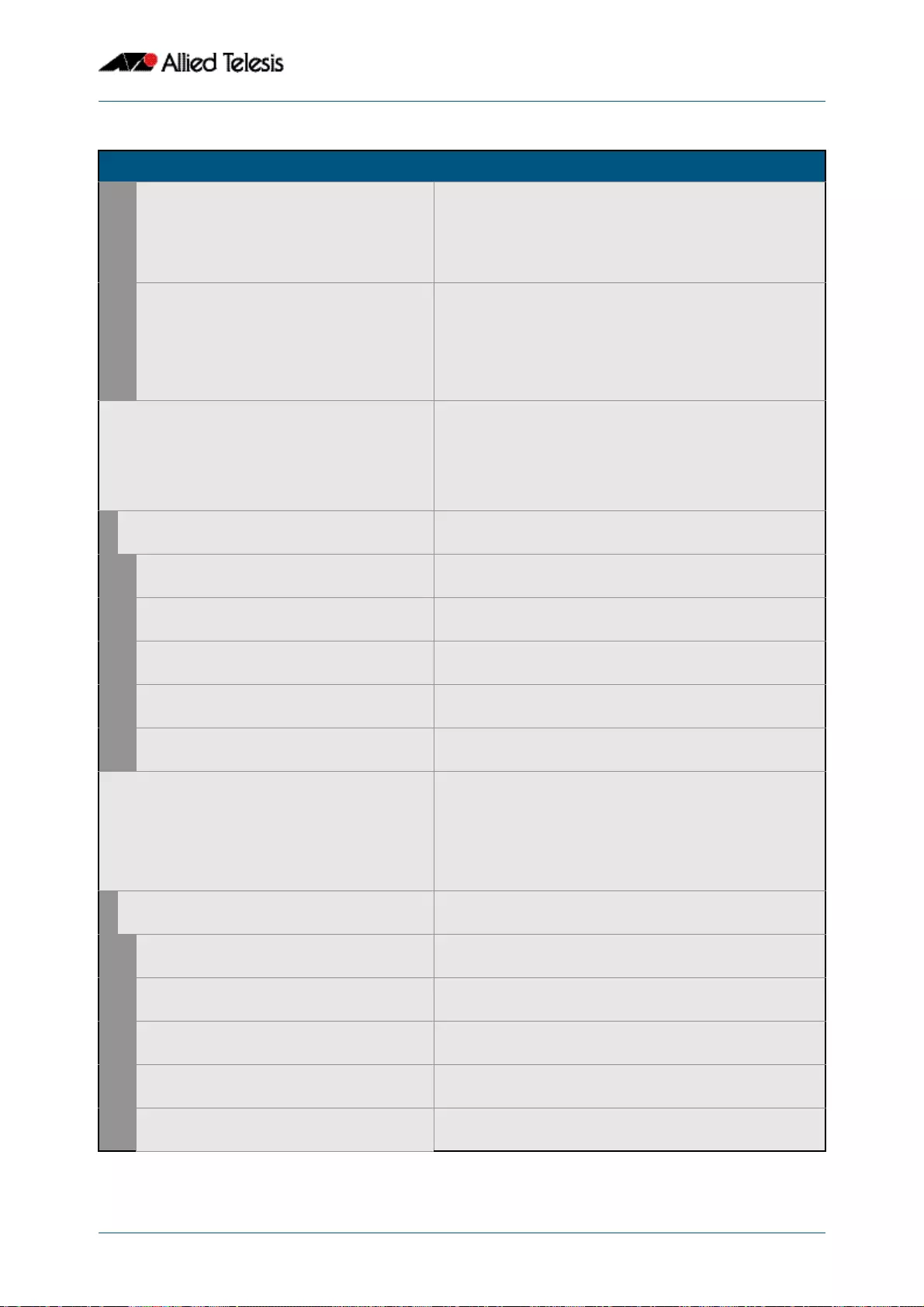
SNMP MIBs
Software Reference for GS900MX/MPX Series Switches
C613-50065-01 REV B AlliedWare PlusTM Operating System - Version 5.4.4E-1.x 68.27
atEnvMonv2FaultLed5Flashes
{ atEnvMonv2FaultLedEntry 6 }
Indicates whether a fault LED is currently showing a system
failure by flashing five times. Values can be:
1. alarmMonitorAlarm (1) - indicates that the Alarm
Monitor has detected one or more fault conditions.
2. noFault (2)
atEnvMonv2FaultLed6Flashes
{ atEnvMonv2FaultLedEntry 7 }
Indicates whether a fault LED is currently showing a system
failure by flashing six times. Values can be:
1. temperatureFailure (1) - indicates that the device’s
temperature has exceeded the recommended
threshold
2. noFault (2)
atEnvMonv2ContactInputTable
{ atEnvMonv2 7 }
(1.3.6.1.4.1.207.8.4.4.3.12.7)
Table of information about contact inputs available in the
device that are monitored by environment monitoring
hardware, indexed by:
■atEnvMonv2ContactInputStackMemberId
■atEnvMonv2ContactInputBoardIndex
■atEnvMonv2ContactInputIndex
atEnvMonv2ContactInputEntry
{ atEnvMonv2ContactInputTable 1 }
The description and current state of a contact input.
atEnvMonv2ContactInputStackMemberId
{ atEnvMonv2ContactInputEntry 1 }
Index of the stack member hosting this input contact.
atEnvMonv2ContactInputBoardIndex
{ atEnvMonv2ContactInputEntry 2 }
Index of the board hosting this input contact in the board
table.
atEnvMonv2ContactInputIndex
{ atEnvMonv2ContactInputEntry 3 }
The numeric identifier of this contact input on its host
board.
atEnvMonv2ContactInputDescription
{ atEnvMonv2ContactInputEntry 4 }
The description of this contact input.
atEnvMonv2ContactInputState
{ atEnvMonv2ContactInputEntry 5 }
Current state of the input contact - closed (1) or open (2).
atEnvMonv2ContactIOutputTable
{ atEnvMonv2 8}
Table of information about contact outputs available in
the device that are managed by environment monitoring
hardware, indexed by:
1. atEnvMonv2ContactOutputStackMemberId
2. atEnvMonv2ContactOutputBoardIndex
3. atEnvMonv2ContactOutputIndex
atEnvMonv2ContactOutputEntry
{ atEnvMonv2ContactOutputTable 1 }
atEnvMonv2ContactOutputStackMemberId
{ atEnvMonv2ContactInputEntry 1 }
Index of the stack member hosting this output contact.
atEnvMonv2ContactOutputBoardIndex
{ atEnvMonv2ContactInputEntry 2 }
Index of the board hosting this contact output in the board
table.
atEnvMonv2ContactOutputIndex
{ atEnvMonv2ContactInputEntry 3 }
The numeric identifier of this contact output on its host
board.
atEnvMonv2ContactOutputDescription
{ atEnvMonv2ContactInputEntry 4 }
The description of this contact output.
atEnvMonv2ContactOutputState
{ atEnvMonv2ContactInputEntry 5 }
Current state of the output contact - closed (1) or open (2).
Table 68-8: Objects defined in AT-ENVMONV2-MIB(cont.)
Object / Object Identifier Description

SNMP MIBs
Software Reference for GS900MX/MPX Series Switches
68.28 AlliedWare PlusTM Operating System - Version 5.4.4E-1.x C613-50065-01 REV B
atEnvMonv2ExternalPSUTable
{ atEnvMonv2 9}
Table of information about external power supply status
monitored by environment monitoring hardware, indexed
by:
1. atEnvMonv2ExternalPSUStatusStackMemberId
2. atEnvMonv2ExternalPSUStatusBoardIndex
3. atEnvMonv2ExternalPSUStatusIndex
atEnvMonv2ExernalPSUEntry
{ atEnvMonv2ExternalPSUStatusTable 1 }
atEnvMonv2ExternalPSUStackMemberId
{ atEnvMonv2ExternalPSUEntry 1 }
Index of the stack member hosting this external power
supply.
atEnvMonv2ExternalPSUBoardIndex
{ atEnvMonv2ExternalPSUEntry 2 }
Index of the board hosting this external power supply in
the board table.
atEnvMonv2ExternalPSUIndex
{ atEnvMonv2ExternalPSUEntry 3 }
The numeric identifier of this external power supply on its
host board.
atEnvMonv2ExternalPSUDescription
{ atEnvMonv2ExternalPSUEntry 4 }
The description of this external power supply.
atEnvMonv2ExternalPSUState
{ atEnvMonv2ExternalPSUEntry 5 }
Current state of the output contact - good (1) or failed (2).
Table 68-8: Objects defined in AT-ENVMONV2-MIB(cont.)
Object / Object Identifier Description
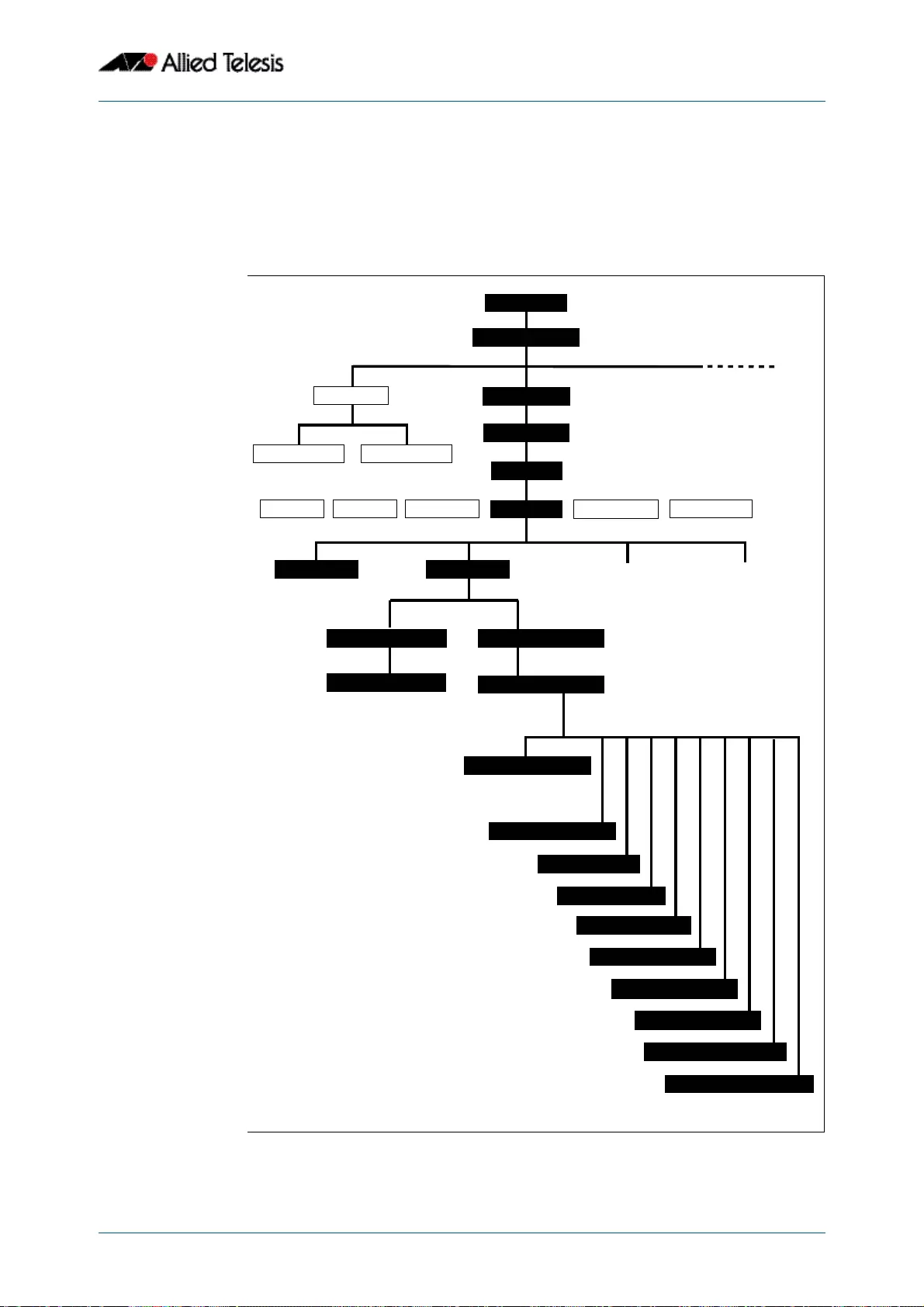
SNMP MIBs
Software Reference for GS900MX/MPX Series Switches
C613-50065-01 REV B AlliedWare PlusTM Operating System - Version 5.4.4E-1.x 68.29
AT-EPSRv2-MIB
The EPSRv2 Group-MIB defines objects for managing Epsrv2 objects and triggers
(Figure 68-4, Table ). Objects in this group have the object identifier Epsrv2
({ modules 536 }).
Figure 68-4: The AT-EPSRv2 MIB sub-tree
EPSR2_MIB_Tree
mibObject (8)
brouterMib (4)
atRouter (4)
modules (4)
at-EpsrMib (1)
Epsrv2Notify (1)
at-Epsrv2 (536)
Epsrv2Notifications (0) Epsrv2VariablesTable (2)
Epsrv2VariablesEntry (1)
Epsrv2NodeType (1)
Epsrv2DomainName (2)
Epsrv2DomainId (3)
Epsrv2CurrentState (5)
Epsrv2FromState (4)
Epsrv2ControlVlanId (6)
Epsrv2PrimaryIfIndex (7)
Epsrv2PrimaryIfIndex (7)
Epsrv2PrimaryIfIndex (7)
Epsrv2PrimaryIfState (8)
Epsrv2SecondaryIfIndex (9)
Epsrv2SecondaryIfState (10)
masterNode (1)
transitNode (2)
Epsrv2NodeType
Epsrv2DomainName
Epsrv2DomainID
Epsrv2FromState
Epsrv2CurrentState
Epsrv2ControlVlanId
PrimaryIfIndex
Epsrv2PrimaryIfState
Epsrv2SecondaryIfIndex
Epsrv2SecondaryIfState
products (1)
bridgeRouter (1) routerSwitch (14)
protocols (6)
arInterfaces
sysinfo (3)traps (2)objects (1)
enterprises (1)
alliedTelesis (207)

SNMP MIBs
Software Reference for GS900MX/MPX Series Switches
68.30 AlliedWare PlusTM Operating System - Version 5.4.4E-1.x C613-50065-01 REV B
.
atEpsrv2Objects Defined in the AT-EPSRV2 MIB
Object Object Identifier Description
{at-Epsrv2} {modules 536} The root of the Epsrv2 object sub tree.
{ atEpsrv2Notifications } {at-Epsrv2 0}
{atEpsrv2Notify} { atEpsrv2Notifications 1 } EPSR Master/Transit node state transition trap.
Note that there is a one to one relationship
between nodes and domains.
{Epsrv2NodeType} { atEpsrv2VariablesEntry 1 } The EPSR node type: either master or transit.
{atEpsrv2DomainName} { atEpsrv2VariablesEntry 2 } The name of the EPSR domain.
{atEpsrv2DomainID} { atEpsrv2VariablesEntry 3 } The ID of the EPSR domain.
{ Epsrv2FromState } { atEpsrv2VariablesEntry 4 } The previous state of the EPSR domain
{ Epsrv2Current State } { atEpsrv2VariablesEntry 5 } The current state of the EPSR domain.
{Epsrv2ControlVlanId} { atEpsrv2VariablesEntry 6 } The VLAN identifier for the control VLAN.
{ Epsrv2PrimaryIfIndex } { atEpsrv2VariablesEntry 7 } The IfIndex of the primary interface.
{ atEpsrv2PrimaryIfState } { atEpsrv2VariablesEntry 8 } The current state of the primary interface.
{ atEpsrv2SecondaryIfIndex } { atEpsrv2VariablesEntry 9 } The IfIndex of the secondary interface.
{ atEpsrv2SecondaryIfState } { atEpsrv2VariablesEntry 10 } The state of the secondary interface.
{ atEpsrv2VariablesTable } {at-Epsrv2 2} The enterprise Epsrv2VariablesTable.
{ atEpsrv2VariablesEntry } { atEpsrv2VariablesTable 1} Contains entries within the enterprise
atEpsrv2VariablesTable.
{atEpsrv2NodeType} { atEpsrv2VariablesEntry 1 } The EPSR domain node type: either
1. master (1)
2. transit (2)
{atEpsrv2DomainName} {Epsrv2NodeType 2} The name of the EPSR domain.
{atEpsrv2DomainID} {Epsrv2NodeType 3} The ID of the EPSR domain.
{ atEpsrv2FromState } {Epsrv2NodeType 4} The previous state of the EPSR domain
{atEpsrv2Current State} {Epsrv2NodeType 5} The current state of the EPSR domain.
{ atEpsrv2ControlVlanId } {Epsrv2NodeType 6} The VLAN identifier for the control VLAN.
{ Epsrv2PrimaryIfIndex } {Epsrv2NodeType 7} The IfIndex of the primary interface.
{ atEpsrv2PrimaryIfState } {Epsrv2NodeType 8} The current state of the primary interface.
{ atEpsrv2SecondaryIfIndex } {Epsrv2NodeType 9} The IfIndex of the secondary interface.
{ atEpsrv2SecondaryIfState } { Epsrv2NodeType 10 } The state of the secondary interface.
TEXTUAL CONVENTIONS
{ atEpsrv2NodeState } The trap states that can be advertised for an EPSR
domain node. The following states are defined:
1. idle (1)
2. complete (2)
3. failed (3)
4. linksUp (4)
5. linksDown (5)
6. preForward (6)
7. unknown (7)

SNMP MIBs
Software Reference for GS900MX/MPX Series Switches
C613-50065-01 REV B AlliedWare PlusTM Operating System - Version 5.4.4E-1.x 68.31
{atEpsrv2InterfaceState} The trap states that can be advertised for an EPSR
interface. The following states are defined:
1. unknown (1)
2. down (2)
3. blocked (3)
4. forward (4)
atEpsrv2Objects Defined in the AT-EPSRV2 MIB(cont.)
Object Object Identifier Description

SNMP MIBs
Software Reference for GS900MX/MPX Series Switches
68.32 AlliedWare PlusTM Operating System - Version 5.4.4E-1.x C613-50065-01 REV B
AT-FILEv2-MIB
This MIB contains objects for displaying and managing file content of Flash, USB storage
devices and NVS, and copying, moving and deleting files from local and remote sources
(Table 68-9).
The objects reside in the module atFilev2 { modules 600 }, organized in the following
groups:
■The file operation devices - object for various devices supported for file operations
■The File Info Table - information about all files, including pathnames, that are present
on the device
■The USB storage device table - information about the USB storage device configured
on the device
The procedure in “Copy a File to or from a TFTP Server” on page 66.20 shows how to
use these MIB objects to upgrade to a new software version and boot configuration file.
Table 68-9: Objects defined in AT-FILEv2-MIB
Object Object Identifier Description
atFilev2 { modules 600 } MIB containing objects for listing and managing
files.
atFilev2FileOperation {atFilev2 3} Collection of file operation objects available for
configuration, to enable copying, moving and
deleting files.
atFilev2SourceStackID { atFilev2Operation 1 } Specifies the Stack ID of the source file. Set an
integer corresponding to the stack ID of the stack
member to use as the source. For devices that are
not capable of being stacked, set with the value 1.
This value is ignored if the source device is set to
TFTP.
atFilev2SourceDevice { atFilev2Operation 2 } Specifies the source device for the file to be copied.
Valid values are 1 to 5. Set a value that corresponds
with the various devices, as below:
■1 - Flash - default
■2 - Card - not supported
■3 - NVS
■4 - TFTP
■5 - USB
For copying files, you may use any combination of
devices for the source and destination, except for
copying from TFTP to TFTP.
For moving files you cannot use TFTP as source or
destination.
For deleting files, the source cannot be TFTP.
You must fully configure all required parameters
before an operation can commence. Where a TFTP
operation is configured, an IP address must also be
set via atFilev2TftpIPAddr.
To copy a file from TFTP to Flash, use 4 for source
and 1 for destination.
atFilev2SourceFilename { atFilev2Operation 3 } Specifies the filename of the source file to copy,
move or delete. Include any path as required, but
the storage type is not necessary.
For example, to copy the file latest.cfg from the
backupconfigs/routers directory on the TFTP server,
you would set:
backupconfigs/routers/latest.cfg

SNMP MIBs
Software Reference for GS900MX/MPX Series Switches
C613-50065-01 REV B AlliedWare PlusTM Operating System - Version 5.4.4E-1.x 68.33
atFilev2DestinationStackID { atFilev2Operation 4 } Specifies the Stack ID for the destination file. For
devices that are not capable of being stacked, set
with the value 1. This value is ignored if the
destination device is set to TFTP, or if a deletion
operation is carried out.
atFilev2DestinationDevice { atFilev2Operation 5 } Specifies the destination device for the files to be
copied into. Valid values are 1 to 5. Set a value that
corresponds with the various devices, as below:
■1 - Flash - default
■2 - Card - not supported
■3 - NVS
■4 - TFTP
■5 - USB
For copying files, you may use any combination of
devices for the source and destination, except for
copying from TFTP to TFTP.
For moving files you cannot use TFTP as source or
destination.
For deleting files, this object is ignored.
You must fully configure all required parameters
before an operation can commence. Where a TFTP
operation is configured, an IP address must also be
set via atFilev2TftpIPAddr.
To copy a file from TFTP to Flash, use 4 for source
and 1 for destination.
atFilev2DestinationFilename { atFilev2Operation 6 } Specifies the destination filename of the file to be
copied or moved. Include any path as required, but
the storage type is not necessary.
The destination filename does not need to be the
same as the source filename, and this object is
ignored for file deletion operations.
For example, to copy a release file from the TFTP
server to the backup release directory on Flash, you
would set:
backuprelease/latest.rel
Note: If the destination is set to Flash, card or NVS,
any file at the destination that shares the destination
filename will be overwritten by a move or copy
operation.
Table 68-9: Objects defined in AT-FILEv2-MIB(cont.)
Object(cont.) Object Identifier Description

SNMP MIBs
Software Reference for GS900MX/MPX Series Switches
68.34 AlliedWare PlusTM Operating System - Version 5.4.4E-1.x C613-50065-01 REV B
atFilev2CopyBegin { atFilev2Operation 7 } Represents the status of the copy file operation, in
the form of octet string.
A read on this object can return several possible
values, depending on the current status of the
system and the various file operation objects:
■idle - There is no file operation in progress and all
required objects have been set correctly. Setting
a '1' to this object will begin the file copy.
■Error codes: [1-7] - A copy operation cannot be
started until these errors are resolved. See below
for key.
■[action]ing x [--> y] - A file operation is currently
in progress. You cannot start another operation
while the object is returning this value.
■[action] x [--> y] success - The last copy, move or
delete operation was successfully completed.
■[action] x [--> y] failure: [err] - The last copy, move
or delete operation failed, with the error
message attached. Common failures include lack
of space on the destination file system, incorrect
source file names or communication errors with
remote services.
Upon reading a success or failure message, the
message will be cleared and the next read will result
in either an 'idle' message or an 'Error codes'
message if not all required objects have been
correctly set. If the read returned 'idle', a new file
operation can now be started.
Following are possible values returned as Error
codes for file copy:
■1 - atFilev2SourceDevice has not been set
■2 - atFilev2SourceFilename has not been set
■3 - atFilev2DestinationDevice has not been set
■4 - atFilev2DestinationFilename has not been set
■5 - atFilev2SourceDevice and
atFilev2DestinationDevice are both set to TFTP
■6 - the combination of source device, stackID and
filename is the same as the destination device,
stackID and filename (i.e. it is not valid to copy a
file onto itself.
■7 - TFTP IP address has not been set and TFTP has
been set for one of the devices
Provided all above requirements are met,
immediately upon executing the SNMP set, the
device will indicate that it was a success. The actual
file copy itself will be started and continue on the
device until it has completed. For large files,
operations can take several minutes to complete.
Subsequent reads of the object will return one of
messages shown in the first table, to allow for
tracking of the progress of the copy operation.
Table 68-9: Objects defined in AT-FILEv2-MIB(cont.)
Object(cont.) Object Identifier Description

SNMP MIBs
Software Reference for GS900MX/MPX Series Switches
C613-50065-01 REV B AlliedWare PlusTM Operating System - Version 5.4.4E-1.x 68.35
atFilev2MoveBegin { atFilev2Operation 8 } Represents the status of the move file operation, in
the form of octet string.
A read on this object can return several possible
values, depending on the current status of the
system and the various file operation objects:
■idle - There is no file operation in progress and all
required objects have been set correctly. Setting
a '1' to this object will begin the file move.
■Error codes: [1-6] - A move operation cannot be
started until these errors are resolved. See below
for key.
■[action]ing x [--> y] - A file operation is currently
in progress. You cannot start another operation
while the object is returning this value.
■[action] x [--> y] success - The last copy, move or
delete operation was successfully completed.
■[action] x [--> y] failure: [err] - The last copy, move
or delete operation failed, with the error
message attached. Common failures include lack
of space on the destination file system, incorrect
source file names or communication errors with
remote services.
Upon reading a success or failure message, the
message will be cleared and the next read will result
in either an 'idle' message or an 'Error codes'
message if not all required objects have been
correctly set. If the read returned 'idle', a new file
operation can now be started.
Following are possible values returned as Error
codes for file move:
■1 - atFilev2SourceDevice has not been set
■2 - atFilev2SourceFilename has not been set
■3 - atFilev2DestinationDevice has not been set
■4 - atFilev2DestinationFilename has not been set
■5 - either atFilev2SourceDevice or
atFilev2DestinationDevice are set to TFTP
■6 - the combination of source device, stackID and
filename is the same as the destination device,
stackID and filename (i.e. it is not valid to move a
file onto itself.
Provided all above requirements are met,
immediately upon executing the SNMP set, the
device will indicate that it was a success. The actual
file move itself will be started and continue on the
device until it has completed. For large files,
operations can take several minutes to complete.
Subsequent reads of the object will return one of
messages shown in the first table, to allow for
tracking of the progress of the move operation.
Table 68-9: Objects defined in AT-FILEv2-MIB(cont.)
Object(cont.) Object Identifier Description

SNMP MIBs
Software Reference for GS900MX/MPX Series Switches
68.36 AlliedWare PlusTM Operating System - Version 5.4.4E-1.x C613-50065-01 REV B
atFilev2DeleteBegin { atFilev2Operation 9 } Represents the status of the delete file operation, in
the form of octet string.
A read on this object can return several possible
values, depending on the current status of the
system and the various file operation objects:
■idle - There is no file operation in progress and all
required objects have been set correctly. Setting
a '1' to this object will begin the file deletion.
■Error codes: [1-3] - A delete operation cannot be
started until these errors are resolved. See below
for key.
■[action]ing x [--> y] - A file operation is currently
in progress. You cannot start another operation
while the object is returning this value.
■[action] x [--> y] success - The last copy, move or
delete operation was successfully completed.
■[action] x [--> y] failure: [err] - The last copy, move
or delete operation failed, with the error
message attached. Common failures include lack
of space on the destination file system, incorrect
source file names or communication errors with
remote services.
Upon reading a success or failure message, the
message will be cleared and the next read will result
in either an 'idle' message or an 'Error codes'
message if not all required objects have been
correctly set. If the read returned 'idle', a new file
operation can be started.
File deletion operations ignore the values set in the
atFilev2DestinationStackID,
atFilev2DestinationDevice and
atFilev2DestinationFilename objects.
The file deletion operation is equivalent to the CLI
'delete force [file]' command, so it is possible to
delete any normally-protected system files, such as
the currently configured boot release.
Following are possible values returned as Error
codes for file move:
■1 - atFilev2SourceDevice has not been set
■2 - atFilev2SourceFilename has not been set
■3 - atFilev2SourceDevicehas not been set to TFTP
Provided all above requirements are met,
immediately upon executing the SNMP set, the
device will indicate that it was a success. The actual
file move itself will be started and continue on the
device until it has completed. For large files,
operations can take several minutes to complete.
Subsequent reads of the object will return one of
messages shown in the first table, to allow for
tracking of the progress of the move operation.
atFilev2Flash_1 { atFilev2Operation 10 } Represents the Flash operation device object
atFilev2Card_2 { atFilev2Operation 11 } Represents the Card operation device object
atFilev2Nvs_3 { atFilev2Operation 12 } Represents the NVS operation device object
atFilev2Tftp_4 { atFilev2Operation 13 } Represents the TFTP operation device object
atFilev2TftpIPAddr {atFilev2Tftp_4 1} The IP address of the TFTP server that is to be used
for the file copy process. This IP Address needs to be
reachable from the device, or the file copy will fail.
Table 68-9: Objects defined in AT-FILEv2-MIB(cont.)
Object(cont.) Object Identifier Description

SNMP MIBs
Software Reference for GS900MX/MPX Series Switches
C613-50065-01 REV B AlliedWare PlusTM Operating System - Version 5.4.4E-1.x 68.37
atFilev2Usb { atFilev2Operation 15 } Represents the USB storage device operation device
object.
atFilev2InfoEntry { atFilev2InfoTable 1 } An entry in the list of files, containing information
about a single file.
atFilev2InfoFilepath { atFilev2InfoEntry 1 } The full path and name of the file. Files are sorted in
alphabetical order and any filepath that is longer
than 112 characters will not be displayed due to
SNMP Object Identifier length limitations.
atFilev2InfoFileSize { atFilev2InfoEntry 2 } The size of the file in bytes.
atFilev2InfoFileCreationTime { atFilev2InfoEntry 3 } File creation time in the form <MMM DD YYYY
HH:MM:SS>. For example, Sep 7 2008 06:07:54.
atFilev2InfoFileIsDirectory { atFilev2InfoEntry 4 } This object will return the value TRUE if the entry is a
directory, or FALSE if it is not.
atFilev2InfoFileIsReadable { atFilev2InfoEntry 5 } This object will return the value TRUE if the file is
readable, or FALSE if it is not.
atFilev2InfoFileIsWriteable { atFilev2InfoEntry 6 } This object will return the value TRUE if the file is
writeable, or FALSE if it is not.
atFilev2InfoFileIsExecutable { atFilev2InfoEntry 7 } This object will return the value TRUE if the file is
executable, or FALSE if it is not.
atFilev2USBMediaTable {atFilev2 6} The USB storage device table, containing
information related to USB storage devices.
atFilev2USBMediaEntry { atFilev2USBMediaTable
1} Data pertaining to a USB storage device instance.
atFilev2USBMediaStackMem
berId
{atFilev2USBMediaEntry
1}
The index of the stack member hosting this USB
media. For devices that are not capable of being
stacked, this object will always return the value 1.
atFilev2USBMediaPresence {atFilev2USBMediaEntry
2}
This object indicates whether or not a USB storage
device is inserted in a slot. Possible values are:
■notPresent (1)
■present (2)
atFilev2FileViewerStackId atFilev2FileViewer 1 The stack ID of the stack member for which files will
be displayed in the FileViewer table. For devices that
are not capable of being stacked, this variable will
always read as 1, and will cause an error on being
written to with any value other than 1.
Write this variable with the stack ID of the stack
member for which a view of files is required. If the
stack member doesn't exist, an error will be
returned. For a chassis switch, it corresponds to the
card ID.
Note that the other variables specifying the files to
view will not be altered by changing the stack ID,
which means that the file view table could be empty
if a non-existant device or path has been referenced
previously.
Table 68-9: Objects defined in AT-FILEv2-MIB(cont.)
Object(cont.) Object Identifier Description

SNMP MIBs
Software Reference for GS900MX/MPX Series Switches
68.38 AlliedWare PlusTM Operating System - Version 5.4.4E-1.x C613-50065-01 REV B
atFilev2FileViewerDevice atFilev2FileViewer 2 The file system device for which files will be
displayed in the FileViewer table. The values
supported for this variable are identical to the values
for other variables in the MIB, although not all values
will actually result in the display of files.
The different devices and whether they will result in
the display of files are:
■1 - Flash - Onboard Flash - supported
■2 - Card - Removable SD card - supported
■3 - NVS - Onboard battery backed RAM -
supported
■4 - FTP - not supported
■5 - USB - Removable USB media - supported
Setting this variable to a unsupported value will
result in an error, but setting to a value that is
supported but on a device that doesn't contain that
type of device will not. However, no files will be
displayed in the File Viewer table in this case.
atFilev2FileViewerCurrentPa
th
atFilev2FileViewer 3 The file system path for which files will be displayed
in the FileViewer table. This path will always read as
a full pathname starting with the '/' character.
Setting this variable will specify a new directory for
which files will be displayed. The path specified
must be the full path, relative setting of path does
not work. Only paths with invalid characters in them
will cause an error, paths specifying non-existent
directories will be accepted, but no files will be
displayed in the File Viewer table in this case.
atFilev2FileViewerTable atFilev2FileViewer 4 A list of all files, not including pathnames, that are
present on the device specified by
atFilev2FileViewerStackId and
atFilev2FileViewerDevice, in the path specified by
atFilev2FileViewerCurrentPath.
Hidden and system files are not displayed.
If the Stack ID, device and path are invalid (the path
is for a non-existent directory), the table will be
empty. This will allow an MIB walk through the table
even though the setup parameters are incorrect.
atFilev2FileViewerEntry atFilev2FileViewerTable
1
An entry in the list of files, containing information
about a single file.
atFilev2FileViewerName atFilev2FileViewerEntry
1
The name of the file. Files are sorted in alphabetical
order, and any name that is longer than 112
characters will not be displayed due to SNMP OID
length limitations.
atFilev2FileViewerSize atFilev2FileViewerEntry
2
The size of the file in bytes.
atFilev2FileViewerCreationTi
me
atFilev2FileViewerEntry
3
File creation time in the form <MMM DD YYYY
HH:MM:SS>. For example, Sep 7 2008 06:07:54.
atFilev2FileViewerIsDirector
yatFilev2FileViewerEntry
4Returns TRUE if the entry is a directory, FALSE
otherwise.
atFilev2FileViewerIsReadabl
e
atFilev2FileViewerEntry
5
Returns TRUE if the file is readable, FALSE otherwise.
atFilev2FileViewerIsWriteabl
e
atFilev2FileViewerEntry
6
Returns TRUE if the file is writeable, FALSE otherwise.
atFilev2FileViewerIsExecuta
ble atFilev2FileViewerEntry
7Returns TRUE if the file is executable, FALSE
otherwise.
Table 68-9: Objects defined in AT-FILEv2-MIB(cont.)
Object(cont.) Object Identifier Description

SNMP MIBs
Software Reference for GS900MX/MPX Series Switches
C613-50065-01 REV B AlliedWare PlusTM Operating System - Version 5.4.4E-1.x 68.39
AT-IP-MIB
This MIB contains objects for Allied Telesis specific IP address management (Table 68-10).
The objects reside in the module atIpMib { modules 602 }.
Table 68-10: Objects defined in AT-IP-MIB
Object Object Identifier Description
atIpMib {modules 602} MIB containing objects for IP addressing
management.
AtIpAddressAssignmentTyp
e
Textual Convention Object containing conditional coded values for
the IP address assignment type being applied to
the interface, referred to by objects in this MIB.
The possible values and explanation are:
■notSet (0) - indicates that the IP address
assignment type has not yet been configured.
This value can only ever be read.
■primary (1) - indicates that the address is a
primary IP address; only one primary address
is allowed per interface.
■secondary (2) - indicates that the address is a
secondary IP address; any number of
secondary IP addresses may be applied
AtIpAddressTable {atIpMib 1} A table containing mappings between primary or
secondary IP addresses, and the interfaces they
are assigned to. Indexed by:
■atIpAddressAddrType
■atIpAddressAddr
AtIpAddressEntry { AtIpAddressTable 1 } Information about the address mapping for a
particular interface.
atIpAddressAddrType { AtIpAddressEntry 1 } An indication of the IP version of
‘atIpAddressAddr’
atIpAddressAddr { AtIpAddressEntry 2 } The IP address to which this entry's addressing
information pertains. The address type of this
object is specified in object
‘atIpAddressAddrType’.
atIpAddressPrefixLen { AtIpAddressEntry 3 } An integer, specifying the prefix length of the IP
address represented by this entry.
atIpAddressLabel { AtIpAddressEntry 4 } The name assigned to the IP address represented
by this entry.
atIpAddressIfIndex { AtIpAddressEntry 5 } The index value that uniquely identifies the
interface to which this entry is applicable. The
interface identified by a particular value of this
index corresponds to the interface identified by
the same value of the IF-MIB's ifIndex.
atIpAddressAssignmentTyp
e
{ AtIpAddressEntry 6 } The IP address assignment type for this entry
(primary or secondary), as described in the
Textual Convention
‘AtIpAddressAssignmentType’.

SNMP MIBs
Software Reference for GS900MX/MPX Series Switches
68.40 AlliedWare PlusTM Operating System - Version 5.4.4E-1.x C613-50065-01 REV B
atIpAddressRowStatus { AtIpAddressEntry 7 } The current status of the IP address entry.
The following values may be returned when
reading this object:
■active (1)
« The IP address is currently mapped to an
interface and is valid.
■notReady (3)
« The IP address is currently partially
configured and is not mapped to an
interface.
The following values may be written to this
object:
■active (1)
« An attempt will be made to map the IP
address to the configured interface.
■createAndWait (5)
« An attempt will be made to create a new
IP address entry.
■destroy (6)
« The IP address setting will be removed
from the device.
An entry cannot be made active until its
atIpAddressPrefixLen, atIpAddressIfIndex and
atIpAddressAssignmentType objects have been
set to valid values.
Table 68-10: Objects defined in AT-IP-MIB(cont.)
Object Object Identifier Description

SNMP MIBs
Software Reference for GS900MX/MPX Series Switches
C613-50065-01 REV B AlliedWare PlusTM Operating System - Version 5.4.4E-1.x 68.41
AT-LICENSE-MIB
The AT-LICENSE-MIB contains objects for managing the AlliedWare PlusTM Operating
System software licenses: listing applied software licenses, adding new licenses and
deleting existing licenses (Table 68-11). The objects reside in the module license { sysinfo
22 }, organized in the following groups:
■Base Software License Table - a table containing the installed base software licenses
on the device
■Installed Software License Table - a list of installed software licenses; used also to
remove software license from the device
■Available Software Features Table
■LicenseNew - Objects used to install a new license
■LicenseStackRemove - Objects used to remove a license across a stack of devices
Table 68-11: Objects defined in AT-LICENSE-MIB
Object Object Identifier Description
license {sysinfo 22} MIB containing objects for listing applied software
licenses, adding new licenses, and deleting existing
licenses.
baseLicenseTable {license 1} Table containing information about base software
licenses installed on a device. Indexed by:
■baseLicenseStkId
baseLicenseEntry { baseLicenseTable 1 } Information about a single license installed on the
device.
baseLicenseStkId { baseLicenseEntry 1 } The stack member ID of the device hosting the
license.
baseLicenseName { baseLicenseEntry 2 } The name of the base license.
baseLicenseQuantity { baseLicenseEntry 3 } The number of licenses issued for this entry.
baseLicenseType { baseLicenseEntry 4 } The type of base license issued.
baseLicenseIssueDate { baseLicenseEntry 5 } The date of issue of the base license.
baseLicenseExpiryDate { baseLicenseEntry 6 } The expiry date of the base license.
baseLicenseFeatures { baseLicenseEntry 7 } The feature set that this license enables, in the
format of an octet string. Each bit in the returned
octet string represents a particular feature that can
be license-enabled. The bit position within the string
maps to the feature entry with the same index, in
licenseFeatureTable. A binary ‘1’ indicates that the
feature is included in the license; a binary ‘0’
indicates that the feature is not included in the
license.
licenseTable {license 2} Table containing information about software
licenses installed on the device. Indexed by:
■licenseStackId
■licenseIndex
licenseEntry {licenseTable 1} Information about a single installed software license
on the device.
licenseStackId {licenseEntry 1} The stack member ID of the device hosting the
license.
licenseIndex {licenseEntry 2} The index number of the license entry.
licenseName {licenseEntry 3} The name of the license.
licenseCustomer {licenseEntry 4} The name of the customer of the license.

SNMP MIBs
Software Reference for GS900MX/MPX Series Switches
68.42 AlliedWare PlusTM Operating System - Version 5.4.4E-1.x C613-50065-01 REV B
licenseQuantity {licenseEntry 5} The number of licenses issued for this entry.
licenseType {licenseEntry 6} The type of license issued.
licenseIssueDate {licenseEntry 7} The date of issue of the license.
licenseExpiryDate {licenseEntry 8} The expiry date of the license.
licenseFeatures {licenseEntry 9} The feature set that this license enables, in the
format of octet string.
Each bit in the returned octet string represents a
particular feature that can be license-enabled. The
bit position within the string maps to the feature
entry with the same index, in licenseFeatureTable.
A binary ‘1’ indicates that the feature is included in
the license; a binary ‘0’ indicates that the feature is
not included in the license.
licenseRowStatus { licenseEntry 10 } The current status of the license. The following
values may be returned when reading this object:
1. active (1) - the license is currently installed and
valid
2. notInService (2) - the license has expired or is
invalid
The following value may be written to this object:
3. destroy (6) - the license will be removed from the
device; this may result in some features being
disabled.
Note that a stacked device that has a license deleted
may not be able to rejoin the stack after reboot,
unless the license is also deleted on all other devices
in the stack.
licenseFeatureTable {license 3} Table containing all available Software Features. A
feature must be license-enabled to be utilized on
the device.
licenseFeatureEntry { licenseFeatureTable 1 } Information about a single feature that must be
license-enabled in order to be utilized on the device.
licenseFeatureIndex {licenseFeatureEntry 1} The index number of the feature which must be
license-enabled.
licenseFeatureName {licenseFeatureEntry 2} The name of the feature under licensing control.
licenseFeatureStkMembers {licenseFeatureEntry 3} The set of stack members on which the feature is
enabled, in the format of an octet string.
Each bit in the string maps to an individual stacking
member, e.g. bit one represents stacking member
one, bit two represents stacking member two.
A bit value of ‘1’ indicates that the applicable
feature is enabled on the matching device; a bit
value of ‘0’ indicates that the feature is disabled.
licenseNew {license 4} Group of objects available for updates, used when
installing a new software license on the device.
licenseNewStackId {licenseNew 1} The ID of the stacking member upon which the new
license is to be installed.
The value zero (0) indicates that the license should
be applied to all stack members.
licenseNewName {licenseNew 2} The name of the new license to be installed.
licenseNewKey {licenseNew 3} The key for the new license to be installed.
Table 68-11: Objects defined in AT-LICENSE-MIB(cont.)
Object Object Identifier Description

SNMP MIBs
Software Reference for GS900MX/MPX Series Switches
C613-50065-01 REV B AlliedWare PlusTM Operating System - Version 5.4.4E-1.x 68.43
licenseNewInstall {licenseNew 4} Used to install new licenses. Values can be:
1. true (1)
2. false (2)
To commence installation, a valid license name and
key must first have been set via the
licenseNewName and licenseNewKey respectively.
This object should then be set to the value true (1). If
either the license name or key is invalid, the write
operation will fail.
Once installed, the software modules affected by
any newly enabled features will automatically be
restarted.
Note that a stacked device that has a new license
installed on it may not be able to rejoin the stack
after reboot, unless the license is also added to all
other devices in the stack.
When read, the object will always return the value
false (2).
licenseNewInstallStatus {licenseNew 5} The current status of the last license installation
request.
One of the following values is returned when
reading this object:
■idle (1)
■processing (2)
■success (3)
■failed (4)
When a stack license installation operation is
complete the first read of this object will return
either a success (3) or a failure (4) indication.
Subsequent reads of this object will then return an
idle (1) indication.
licenseStackRemove {license 5} Group of objects used when removing a software
license across a stack of devices.
licenseStackRemoveName { licenseStackRemove 1 } The name of the license to be removed from all
devices across the stack, on which the license
currently exists.
licenseStackRemoveExecute { licenseStackRemove 2 } When set to the value true (1), the system will
attempt to remove the named license from all
devices across the stack on which the license
currently exists.
All devices in a stack must be from the same product
family and the named license must activate the
same feature set on all devices.
licenseStackRemoveStatus { licenseStackRemove 3 } The current status of the last requested stack license
removal request.
One of the following values is returned when
reading this object:
■idle (1)
■processing (2)
■success (3)
■failed (4)
When a stack license removal operation is complete
the first read of this object will return either a
success (3) or failure (4) indication. Subsequent
reads of this object will then return an idle (1)
indication.
Table 68-11: Objects defined in AT-LICENSE-MIB(cont.)
Object Object Identifier Description

SNMP MIBs
Software Reference for GS900MX/MPX Series Switches
68.44 AlliedWare PlusTM Operating System - Version 5.4.4E-1.x C613-50065-01 REV B
AT-LOG-MIB
The AT Log MIB contains objects for listing log entries from the buffered and permanent
logs (Table 68-12). The objects reside in the module log { modules 601 }, organized in the
following groups:
■Log Table - objects containing the information from log messages issued by the
system, ordered from oldest to newest entry
■Log Options - contains objects used to set up the log options configuration
Table 68-12: Objects defined in AT-LOG-MIB
Object Object Identifier Description
log {modules 601} MIB containing objects for listing log entries from
the buffered and permanent logs.
logTable {log 1} A list of log entries from the source specified in
the ‘logSource’ object. The list is ordered from
oldest entry to newest entry.
Indexed by:
■logIndex
logEntry {logTable 1} Information about a single log entry, from the
source specified in the ‘logSource’ object.
logIndex {logEntry 1} An index integer. This index is not directly tied to
any specific log entry. Over time, the log will grow
larger and eventually older entries will be
removed from the log.
logDate {logEntry 2} The date of the log entry. Data resides in the
format octet string, in the form YYYY MMM DD,
e.g. 2008 Oct 9.
logTime {logEntry 3} The time of the log entry. Data resides in the
format octet string, in the form HH:MM:SS, e.g.
07:15:04.
logFacility {logEntry 4} The syslog facility that generated the log entry, in
the format octet string. See the reference manual
for more information.
logSeverity {logEntry 5} The severity level of the log entry, in the format
octet string. Severities are given below:
■emerg Emergency, system is unusable
■alert Action must be taken immediately
■crit Critical conditions
■errr Error conditions
■warning Warning conditions
■notice Normal, but significant, conditions
■info Informational messages
■debug Debug-level messages
logProgram {logEntry 6} The program that generated the log entry, in the
format octet string. See the reference manual for
more information.
logMessage {logEntry 7} The message of thew log entry, in the format
octet string.
logOptions {log 2} Contains objects used to set up the required log
options configuration.

SNMP MIBs
Software Reference for GS900MX/MPX Series Switches
C613-50065-01 REV B AlliedWare PlusTM Operating System - Version 5.4.4E-1.x 68.45
logSource { logOptions 1 } An integer indicating the source from which the
log entries are retrieved. The valid values are:
■1 - Buffered log (default)
■2 - Permanent log.
This information is used when retrieving the
logTable objects, and also specifies the log to be
cleared when the ‘clearLog’ object is set.
logAll { logOptions 2 } An integer indicating whether to display all log
entries in the logTable objects, or not. The valid
values are:
■0 - to display only the most recent log
messages. This is the default
■1 - to show all available log entries.
Note: Choosing to display all log entries may
result in delays of several seconds when accessing
the logTable objects.
clearLog { logOptions 3 } An integer indicating whether to clear the log
that is specified by the ‘logSource’ object. Valid
values are:
■0 - do not clear log
■1 - clear log
Table 68-12: Objects defined in AT-LOG-MIB(cont.)
Object Object Identifier Description
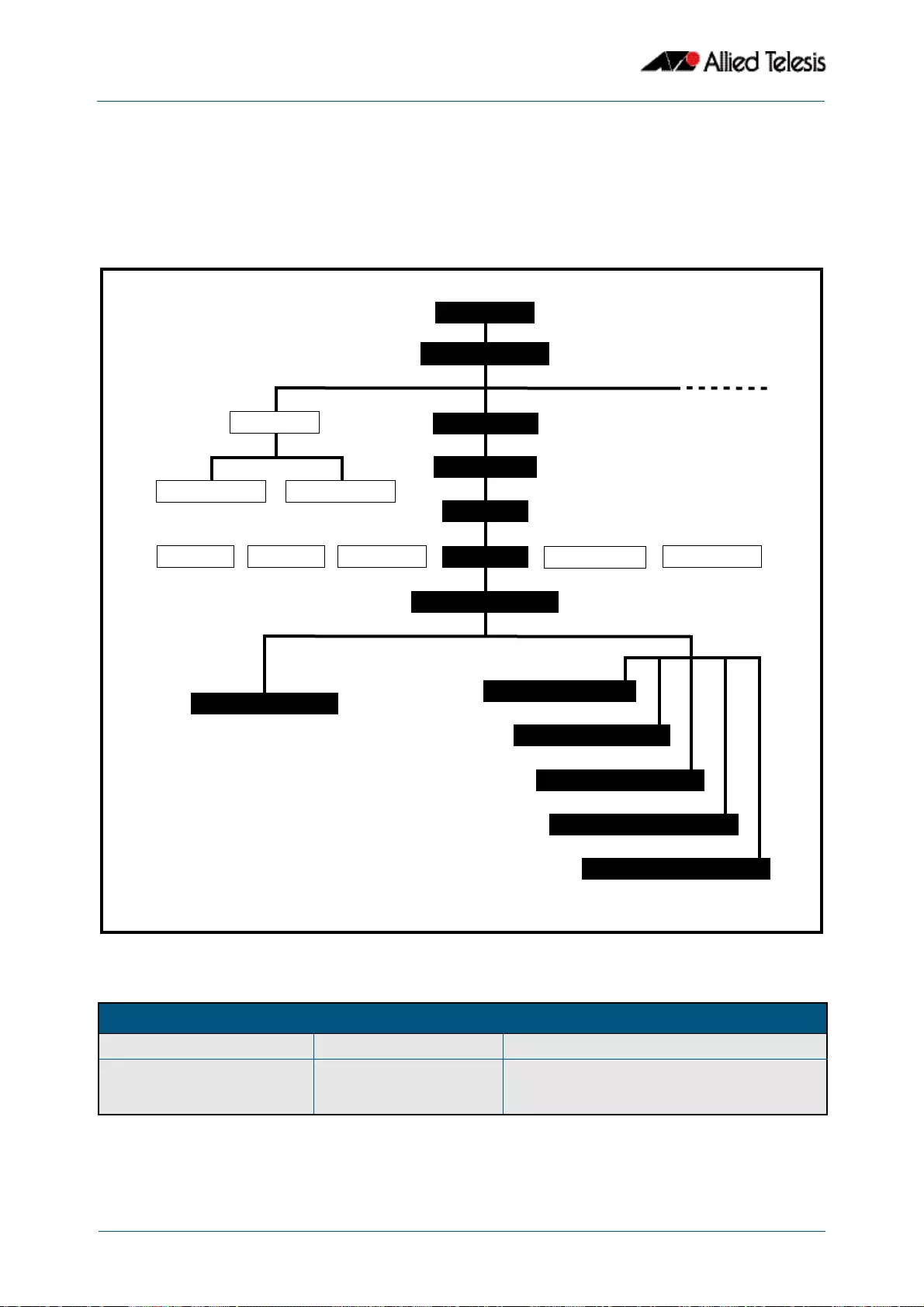
SNMP MIBs
Software Reference for GS900MX/MPX Series Switches
68.46 AlliedWare PlusTM Operating System - Version 5.4.4E-1.x C613-50065-01 REV B
AT-LOOPPROTECT-MIB
The atLoopProtect-MIB (Figure 68-5, Table 68-13) defines objects for managing Loop
Protection objects and triggers. Objects in this group have the object identifier
atLoopProtect ({ modules 4 }).
Figure 68-5: The ATLoopProtect MIB Sub-tree
LoopProtect_MIB_
alliedTelesis (207)
enterprises (1)
mibObject (8)
brouterMib (4)
atRouter (4)
modules (4)
atLoopProtectTrap (0) atLoopProtectAction (1)
atLoopProtectIfIndex (2)
atLoopProtectRxLDFIfIndex (4)
atLoopProtectVlanId (3)
atLoopProtectDetectedLoopBlockedTrap (1)
atLoopProtectRecoverLoopBlockedTrap (2)
atLoopProtectDetectedByLoopDetectionTrap (3)
products (1)
bridgeRouter (1) routerSwitch (14)
protocols (6)
arInterfaces
sysinfo (3)traps (2)objects (1)
atLoopProtectRxLDFVlanId (5)
atLoopProtect (54)
Table 68-13: Objects Defined in the AT-Loop Protect MIB
Object Object Identifier Description
{ atLoopProtect } {modules 54} The root of the Loop Protect object sub tree.
{ atLoopProtectTrap } { atLoopProtect0 } The Loop Protection node state transition trap.
List of traps (notifications) generated for Loop
Protection.

SNMP MIBs
Software Reference for GS900MX/MPX Series Switches
C613-50065-01 REV B AlliedWare PlusTM Operating System - Version 5.4.4E-1.x 68.47
{ atLoopProtectDetected
LoopBlockedTrap }
{ atLoopProtectTrap1 } Notification generated when the Loop
Protection feature blocks an interface with a
loop. The following bindings are associated with
this trap:
1. atLoopProtectIfIndex
2. atLoopProtectVlanId
3. atLoopProtectAction
{ atLoopProtectRecover
LoopBlockedTrap }
{ atLoopProtectTrap2 } Notification generated when the Loop
Protection feature restores a blocked interface
back to normal operation. The following
bindings are associated with this trap:
1. atLoopProtectIfIndex
2. atLoopProtectVlanId
3. atLoopProtectAction
{ atLoopProtectDetected
ByLoopDetectionTrap }
{ atLoopProtectTrap3 } Notification generated when the Loop
Protection feature detects a loop by Loop
Detection method. The following bindings are
associated with this trap:
1. atLoopProtectIfIndex
2. atLoopProtectVlanId
3. atLoopProtectRxLDFIfIndex
4. atLoopProtectRxLDFVlanId
{ atLoopProtectAction } { atLoopProtect1 } The Action for the Loop Protection feature. The
following values are defined:
1. atLoopProtectAction-LearnDisable (0)
2. atLoopProtectAction-LearnEnable (1)
3. atLoopProtectAction-PortDisable (2)
4. atLoopProtectAction-PortEnable (3)
5. atLoopProtectAction-LinkDown (4)
6. atLoopProtectAction-LinkUp (5)
7. atLoopProtectAction-VlanDisable (6)
8. atLoopProtectAction-VlanEnable (7)
{ atLoopProtectIfIndex } { atLoopProtect2 } The interface on which the loop was detected.
{ atLoopProtectVlanId } { atLoopProtect3 } The VLAN ID on which the loop was detected.
{ atLoopProtectRxLDFIfIndex } { atLoopProtect4 } The interface on which the loop detection frame
was received.
{ atLoopProtectRxLDFVlanId } { atLoopProtect5 } The VLAN ID on which the loop detection frame
was received.
Table 68-13: Objects Defined in the AT-Loop Protect MIB(cont.)
Object Object Identifier Description

SNMP MIBs
Software Reference for GS900MX/MPX Series Switches
68.48 AlliedWare PlusTM Operating System - Version 5.4.4E-1.x C613-50065-01 REV B
AT-MIBVERSION-MIB
The AT-MIBVERSION-MIB contains an object to display the last software release that
contained changes to the supported AT Enterprise MIB definition files (Table 68-14).
Objects in this group have the object identifier atMibsetVersion ({ sysinfo 15 }).
Table 68-14: Object defined in AT-MIBVERSION-MIB
Object Object Identifier Description
atMibVersion { sysinfo 15 } This object returns a five digit integer which indicates the
last software release that contained changes to the
supported AT Enterprise MIB definition files. For example,
If the currently loaded software release on the device is
5.3.1-0.3 but the Enterprise MIBs have not changed since
5.3.1-0.1, then the value returned will be 53101.

SNMP MIBs
Software Reference for GS900MX/MPX Series Switches
C613-50065-01 REV B AlliedWare PlusTM Operating System - Version 5.4.4E-1.x 68.49
AT-NTP-MIB
This MIB contains objects for managing the Allied Telesis Network Time Protocol (NTP)
configuration (Table 68-15). The objects reside in the module atNtp { modules 502 },
organized in the following groups:
■NTP Peer/Server Table - a table containing information on the Network Time Protocol
(NTP) peers or server configurations in the system.
■Associations Table - a list of installed software; used also to remove software from the
device.
■Status Table - Objects in this group are not supported.
Table 68-15: Objects defined in AT-NTP-MIB
Object Object Identifier Description
atNtp {modules 502} MIB containing objects for configuring NTP.
atNtpPeerIndexNext { atNtp 6 } The next available index number to be used for
object ‘atNtpPeerIndex’.
atNtpPeerTable { atNtp 7 } Table containing information on the Network
Time Protocol (NTP) peers or server
configurations in the system.
Indexed by:
■atNtpPeerIndex
atNtpPeerEntry { atNtpPeerTable 1 } Information about a single NTP server or peer
configuration.
atNtpPeerIndex { atNtpPeerEntry 1 } The index number corresponding to a particular
NTP server or peer configuration in the system.
To create a new entry, the value of this object
should be the same as that of the value of
atNtpPeerIndexNext object, otherwise the entry
creation will fail.
atNtpPeerNameAddr { atNtpPeerEntry 2 } The host name, or the IP address of the NTP peer.
When a new row (entry) is created, this object is
set with a default of ‘0.0.0.0’, and the
management application should change it to a
desired value by using a SET operation.
atNtpPeerMode { atNtpPeerEntry 3 } The mode of the peer. Can be one of the
following:
■server (1)
■peer (2) - default
atNtpPeerPreference { atNtpPeerEntry 4 } The values in this object specifies whether this
peer is the preferred one. Valid values are 0 to 2:
■0 - unknown - default
■1 - not preferred
■2 - preferred
When the value is ‘not preferred’ (1) NTP chooses
the peer with which to synchronize the time on
the local system.
If the object is set to ‘preferred’ (2) NTP will
choose the corresponding peer to synchronize
the time with.

SNMP MIBs
Software Reference for GS900MX/MPX Series Switches
68.50 AlliedWare PlusTM Operating System - Version 5.4.4E-1.x C613-50065-01 REV B
atNtpPeerVersion { atNtpPeerEntry 5 } The NTP version the peer supports. Can be one of
the following:
■0 - unknown - default
■1 - version 1
■2 - version 2
■3 - version 3
■4 - version 4
atNtpPeerKeyNumber { atNtpPeerEntry 6 } The authentication key number.
Default number is 0.
atNtpPeerRow Status { atNtpPeerEntry 7 } The current status of this peer entry.
The following values may be returned when
reading this object:
■active (1) - this value is returned on reading of
this entry.
■createAndGo (4) - this value is set by the
management application when creating a
new entry
■destroy (6) - value set by the management
application when deleting the entry.
When an entry is deleted, all subsequent entries
in the table will be re-indexed.
atNtpAssociationTable { atNtp 10 } Table containing information on the Network
Time Protocol (NTP) associations.
Indexed by:
■atNtpAssociationIndex
atNtpAssociationEntry { atNtpAssociationTable 1 } Information about a single NTP server or peer
configuration.
atNtpAssociationIndex { atNtpAssociationEntry 1 } The index number corresponding to a particular
NTP server or peer configuration in the system.
To create a new entry, the value of this object
should be the same as that of the value of
atNtpPeerIndexNext object, otherwise the entry
creation will fail.
atNtpAssociationPeerAddr { atNtpAssociationEntry 2 } The host name, or the IP address of the NTP peer.
When a new row (entry) is created, this object is
set with a default of ‘0.0.0.0’, and the
management application should change it to a
desired value by using a SET operation.
atNtpAssociationStatus { atNtpAssociationEntry 3 } The status of this association. Can be one of the
following:
■master (synced)
■master (unsynced)
■selected
■candidate
■configured
■unknown
atNtpAssociationConfigure
d
{ atNtpAssociationEntry 4 } The value in this object specifies whether the
association is from configuration or not. Value can
be:
■configured
■dynamic
atNtpAssociationRefClkAdd
r
{ atNtpAssociationEntry 5 } The IP Address for the reference clock.
atNtpAssociationStratum { atNtpAssociationEntry 6 } The stratum of the peer clock.
Table 68-15: Objects defined in AT-NTP-MIB(cont.)
Object Object Identifier Description

SNMP MIBs
Software Reference for GS900MX/MPX Series Switches
C613-50065-01 REV B AlliedWare PlusTM Operating System - Version 5.4.4E-1.x 68.51
atNtpAssociationPoll { atNtpAssociationEntry 7 } The time between NTP requests from the device
to the server, in seconds.
atNtpAssociationReach { atNtpAssociationEntry 8 } An integer that indicates the reachability status of
the peer.
atNtpAssociationDelay { atNtpAssociationEntry 9 } The round trip delay between the device and the
server.
atNtpAssociationOffset { atNtpAssociationEntry 10 } The difference between the device clock and the
server clock.
atNtpAssociationDisp { atNtpAssociationEntry 11 } The lowest measure of error associated with peer
offset, based on delay, in seconds.
atNtpStatus { atNtp 11 } Group of objects containing system status
information. The objects in this group are not
supported.
atNtpSysClockSync { atNtpStatus 1 } Not supported.
atNtpSysStratum { atNtpStatus 2 } Not supported.
atNtpSysReference { atNtpStatus 3 } Not supported.
atNtpSysFrequency { atNtpStatus 4 } Not supported.
atNtpSysPrecision { atNtpStatus 5 } Not supported.
atNtpSysRefTime { atNtpStatus 6 } Not supported.
atNtpSysClkOffset { atNtpStatus 7 } Not supported.
atNtpSysRootDelay { atNtpStatus 8 } Not supported.
atNtpSysRootDisp { atNtpStatus 9 } Not supported.
Table 68-15: Objects defined in AT-NTP-MIB(cont.)
Object Object Identifier Description

SNMP MIBs
Software Reference for GS900MX/MPX Series Switches
68.52 AlliedWare PlusTM Operating System - Version 5.4.4E-1.x C613-50065-01 REV B
AT-PRODUCTS-MIB
AT-PRODUCT-MIB defines object identifiers for Allied Telesis products. Objects in this MIB
have the object identifier products ({ alliedTelesis 1 }) OID 1.3.6.1.4.1.207.1.
Table 68-16 lists object identifiers for products supported by the AlliedWare PlusTM
Operating System.
Table 68-16: Object identifiers for Allied Telesis products supported by the AlliedWare PlusTM Operating System
Object Object Identifier Description
products { alliedTelesis 1 }
swhub {products 4} Subtree beneath which switching hubs are defined.
at_x200_GE52T {swhub 181} x200-GE52T layer two switch
at_x200_GE28T { swhub 182} x200-GE28T layer two switch
at_x210_9GT { swhub 196} x210-9GT, 8xGigbit, 1xSFP/T
at_x210_16GT { swhub 197} x210-16GT, 14xGigbit, 2xcombo SFP/T
at_x210_24GT { swhub 198} x210-24GT, 20xGigbit, 4xcombo SFP/T
at_x310_26FT { swhub 216} AT-x310-26FT layer two switch with 24 10/100 Base-T
ports, two 10/100/1000 Base-T ports, and four 10 Gb/s
SFP+ ports.
at_x310_50FT { swhub 217} AT-x310-50FT layer two switch with 48 10/100 Base-T
ports, two 10/100/1000 Base-T ports, and four 10 Gb/s
SFP+ ports.
at_x310_26FP { swhub 218} AT-x310-26FP layer two switch with 24 10/100 Base-T
ports, two 10/100/1000 Base-T ports, four 10 Gb/s SFP+
ports, plus PSE function available on pins 1/2 and 3/6
(Mode A) of every copper port.
at_x310_50FP { swhub 219} AT-x310-50FP layer two switch with 48 10/100 Base-T
ports, two 10/100/1000 Base-T ports, four 10 Gb/s SFP+
ports, plus PSE function available on pins 1/2 and 3/6
(Mode A) of every copper port.
routerSwitch {products 14} Subtree beneath which router and (non industrial)
switch product MIB object IDs are assigned.
at_SwitchBladex908 { routerSwitch 69 } Switchblade x908 8 Slot Layer 3 Switch Chassis
at_x900_12XTS { routerSwitch 70 } AT-x900-12XT/S Advanced Gigabit Layer 3+ Expandable
Switch, 12 x combo ports (10/100/1000BASE-T copper
or SFP), 1 x 30Gbps expansion bay
at_x900_24XT { routerSwitch 75 } x900-24XT Enhanced Gigabit Layer 3+ Expandable
Switch, 24 x 10/100/1000BASE-T copper ports (RJ-45
connectors), 2 x 20 Gigabit expansion bays
at_x900_24XS { routerSwitch 76 } x900-24XS Enhanced Gigabit Layer 3+ Expandable
Switch, 24 x 10/100/1000BASE-T copper ports (RJ-45
connectors), 2 x 20 Gigabit expansion bays
at_x900_24XT_N { routerSwitch 77 } x900-24XT-N Enhanced Gigabit Layer 3+ Expandable
Switch, 24 x 10/100/1000BASE-T copper ports (RJ-45
connectors), 2 x 20 Gigabit expansion bays, NEBS
compliant
at_x600_24Ts { routerSwitch 80 } x600-24Ts Stackable Managed L2+/L3 Ethernet Switch,
24 x 1000BASE-T copper ports, 4 x SFP (combo) ports
at_x600_24TsXP { routerSwitch 81 } x600-24Ts/XP Stackable Managed L2+/L3 Ethernet
Switch, 24 x 1000BASE-T copper ports, 4 x SFP (combo)
ports, 2 x XFP ports
at_x600_48Ts { routerSwitch 82 } x600-48Ts Stackable Managed L2+/L3 Ethernet Switch,
48 x 1000BASE-T copper ports, 4 x SFP ports

SNMP MIBs
Software Reference for GS900MX/MPX Series Switches
C613-50065-01 REV B AlliedWare PlusTM Operating System - Version 5.4.4E-1.x 68.53
at_x600_48TsXP { routerSwitch 83 } x600-48Ts/XP Stackable Managed L2+/L3 Ethernet
Switch, 48 x 1000BASE-T copper ports, 4 x SFP ports,
2xXFP ports
at_x600-24TsPoE { routerSwitch 91} x600-24Ts-POE Stackable Managed L2+/L3 Ethernet
PoE Switch, 24 x 1000BASE-T PoE ports, 4 x SFP (combo)
ports
at_x600_24TPoEPlus {routerSwitch 92} x600-24Ts-POE+ Stackable Managed L2+/L3 Ethernet
PoE+ Switch, 24 x 1000BASE-T PoE+ ports, 4 x SFP
(combo) ports
x610_48Ts_X_POEPlus {routerSwitch 93} x610-48Ts/X-POE+ Stackable Managed L2+/L3 Ethernet
PoE+ Switch, 48 x 1000BASE-T PoE+ ports, 2 x SFP
(combo) ports, 2 x SFP+ ports
x610_48Ts_POEPlus {routerSwitch 94} x610-48Ts-POE+ Stackable Managed L2+/L3 Ethernet
PoE+ Switch, 48 x 1000BASE-T PoE+ ports, 4 x SFP
(combo) ports
x610_24Ts_X_POEPlus {routerSwitch 95} x610-24Ts/X-POE+ Stackable Managed L2+/L3 Ethernet
PoE+ Switch, 24 x 1000BASE-T PoE+ ports, 4 x SFP
(combo) ports, 2 x SFP+ ports
x610_24Ts_POEPlus {routerSwitch 96} x610-24Ts-POE+ Stackable Managed L2+/L3 Ethernet
PoE+ Switch, 24 x 1000BASE-T PoE+ ports, 4 x SFP
(combo) ports
x610_48Ts_X {routerSwitch 97} x610-48Ts/X Stackable Managed L2+/L3 Ethernet
Switch, 48 x 1000BASE-T copper ports, 2 x SFP (combo)
ports, 2 x SFP+ ports
x610_48Ts {routerSwitch 98} x610-48Ts Stackable Managed L2+/L3 Ethernet Switch,
24 x 1000BASE-T copper ports, 4 x SFP (combo) ports
x610_24Ts_X {routerSwitch 99} x610-24Ts/X Stackable Managed L2+/L3 Ethernet
Switch, 24 x 1000BASE-T copper ports, 4 x SFP (combo)
ports, 2 x SFP+ ports
x610_24Ts {routerSwitch 100} x610-24Ts Stackable Managed L2+/L3 Ethernet Switch,
24 x 1000BASE-T copper ports, 4 x SFP (combo) ports
x610_24SP_X {routerSwitch 101} x610-24SP/X Stackable Managed L2+/L3 Ethernet
Switch, 24 x SFP (combo) ports, 2 x SFP+ ports
x510_28GTX {routerSwitch 109} x510-28GTX Stackable Managed L2+/L3 Ethernet
Switch with 24 x 10/100/1000 Base-T ports and 4 x
10 Gb/s SFP+ ports.
x510_28GPX {routerSwitch 110} x510-28GPX Stackable Managed L2+/L3 Ethernet
Switch with 24 x 10/100/1000 Base-T ports with PoE, 4 x
10 Gb/s SFP+ ports.
x510_28GSX {routerSwitch 111} x510-28GSX Stackable Managed L2+/L3 Ethernet
Switch with 24 x 100/1000 SFP ports and 4 x 10 Gb/s
SFP+ ports.
x510_52GTX {routerSwitch 112} x510-52GTX Stackable Managed L2+/L3 Ethernet
Switch with 48 x 10/100/1000 Base-T ports and 4 x
10 Gb/s SFP+ ports.
x510_52GPX {routerSwitch 113} x510-52GPX Stackable Managed L2+/L3 Ethernet
Switch with 48 x 10/100/1000 Base-T ports with PoE,
and 4 x 10 Gb/s SFP+ ports.
at-SBx8106 {routerSwitch 114} AT-SBx8106, SwitchBlade x8106 chassis.
x510DP_52GTX {routerSwitch 116} x510DP-52GTX Stackable Managed L2+/L3 Ethernet
Switch with 48 x 10/100/1000 Base-T ports and 4 x
10 Gb/s SFP+ ports.
Table 68-16: Object identifiers for Allied Telesis products supported by the AlliedWare PlusTM Operating
Object Object Identifier Description

SNMP MIBs
Software Reference for GS900MX/MPX Series Switches
68.54 AlliedWare PlusTM Operating System - Version 5.4.4E-1.x C613-50065-01 REV B
IX5_28GPX {routerSwitch 117} IX5-28GPX Stackable Managed L2+ Ethernet Switch
with 24 x 10/100/1000 Base-T ports with PoE, 4 x 10 Gb/
s SFP+ ports.
industrialSwitch {products 24} Subtree beneath which industrial switch product MIB
object IDs are assigned.
at_IE200_6GT {industrialSwitch 1} IE200-6GT L2+ managed industrial Switch with 4 x 10/
100/1000T LAN ports and 2 x SFP uplinks (100/1000X).
at_IE200_6GP {industrialSwitch 2} IE200-6GP L2+ managed industrial Switch with 4 x 10/
100/1000T LAN ports (with 802.3at PoE+) and 2 x SFP
uplinks (100/1000X).
at_IE200_6GPW {industrialSwitch 3} IE200-6GPW L2+ managed industrial Switch with 4 x 10/
100/1000T LAN ports (with 802.3at PoE+) and 2 x SFP
uplinks (100/1000X) and 802.11bgn wireless.
Table 68-16: Object identifiers for Allied Telesis products supported by the AlliedWare PlusTM Operating
Object Object Identifier Description
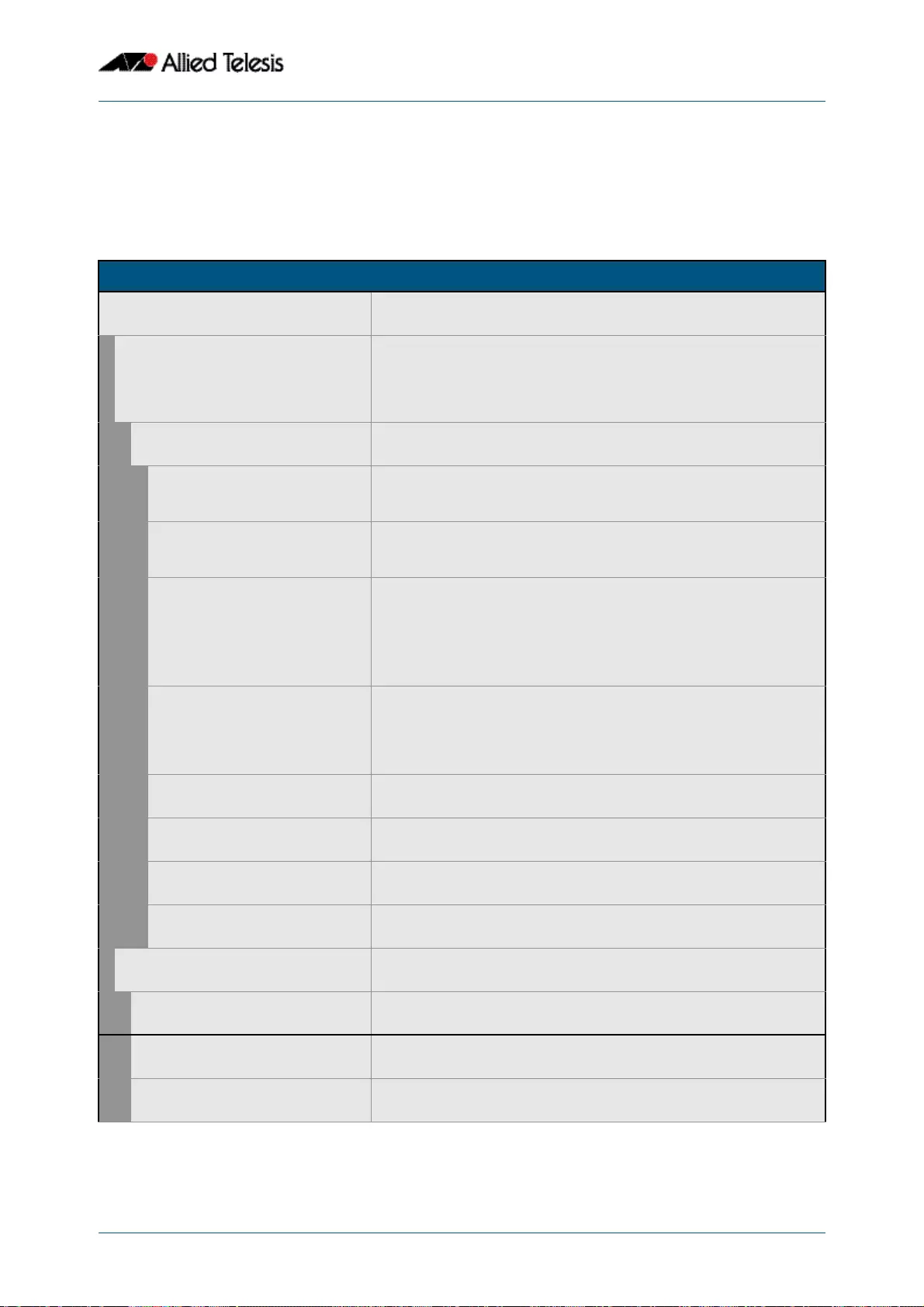
SNMP MIBs
Software Reference for GS900MX/MPX Series Switches
C613-50065-01 REV B AlliedWare PlusTM Operating System - Version 5.4.4E-1.x 68.55
AT-RESOURCE-MIB
The AT-RESOURCE-MIB contains objects for displaying system hardware resource and host
information (Table 68-17). Objects in this group have the object identifier rsc ({ sysinfo
21 }).
Table 68-17: Objects defined in AT-RESOURCE-MIB
Object and OID Description
resource
{ sysinfo 21 }
Contains objects for displaying system hardware resource and host
information.
rscBoardTable
{ resource 1}
Table containing information about boards installed in a device.
Indexed by:
1. rscStkId
2. rscResourceId
rscBoardEntry
{rscBoardTable 1}
Information about a single board installed in the device.
rscStkId
{rscBoardEntry 1}
The ID of the stack member. It is a number from 1 to 8, assigned to a
stackable unit by the operating system when it is stacked. A default
of 1 is given to a stand-alone unit.
rscResourceId
{rscBoardEntry 2}
The resource ID number of the board. It is a number assigned to a
hardware resource when the operating system detects its existence.
Can be a value in range 1 to 4294967294.
rscBoardType
{rscBoardEntry 3}
The type of board. Can be one of the following:
1. Base
2. Expansion
3. Fan module
4. PSU
rscBoardName
{rscBoardEntry 4}
The name of the board. Can be one of the following:
1. SwitchBlade x908
2. XEM-12S
3. AT-PWR05-AC
rscBoardId
{rscBoardEntry 5}
The ID number of the board. Its value is an Allied Telesis assigned
number, such as 274 for the XEM-12S, or 255 for the AT-9924Ts.
rscBoardBay
{rscBoardEntry 6}
The board installation location. Its value can be Bay1, Bay2, PSU1. For
a base board, it has a value of a single character space.
rscBoardRevision
{rscBoardEntry 7}
The revision number of the board.
rscBoardSerialNumber
{rscBoardEntry 8}
The serial number of the board.
hostInfoTable
{ resource 2 }
Table containing general system information. Indexed by rscStkId.
hostInfoEntry
{ hostInfoTable 1 }
Information about a single system parameter
hostInfoDRAM
{ hostInfoTable 2 }
The host DRAM information.
hostInfoFlash
{ hostInfoTable 3 }
The host Flash information.

SNMP MIBs
Software Reference for GS900MX/MPX Series Switches
68.56 AlliedWare PlusTM Operating System - Version 5.4.4E-1.x C613-50065-01 REV B
hostInfoUptime
{ hostInfoTable 4 }
The host up-time.
hostInfoBootloaderVersion
{ hostInfoTable 5 }
The host boot loader version.
Table 68-17: Objects defined in AT-RESOURCE-MIB(cont.)
Object and OID Description

SNMP MIBs
Software Reference for GS900MX/MPX Series Switches
C613-50065-01 REV B AlliedWare PlusTM Operating System - Version 5.4.4E-1.x 68.57
AT-SETUP-MIB
AT-SETUP-MIB defines objects for managing software installation and configuration files
(Figure 68-6, Table 68-18). Objects in this group have the object identifier setup
({ modules 500 }). The procedure in Table 66-6 on page 66.22 shows how to use these
MIB objects to upgrade to a new software version and boot configuration file. For objects
used for file copying, see “AT-FILEv2-MIB” on page 68.32.

SNMP MIBs
Software Reference for GS900MX/MPX Series Switches
68.58 AlliedWare PlusTM Operating System - Version 5.4.4E-1.x C613-50065-01 REV B
Figure 68-6: The AT-SETUP-MIB sub-tree
setup_mib_tree
mibObject (8)
brouterMib (4)
atRouter (4)
modules (4)
products (1)
bridgeRouter (1) routerSwitch (14)
protocols (6)arInterfacessysinfo (3)traps (2)objects (1)
enterprises (1)
alliedTelesis (207)
setup (500)
firmware (2)
currentFirmware (1)
currSoftVersion (1)
currSoftName (2)
deviceConfiguration (3) serviceConfig (5) guiConfig (6)
currSoftSaveToFile (4)
currSoftSaveStatus (5)
currSoftLastSaveResult (6)
nextBootVersion (1)
nextBootPath (2)
nextBootFirmware (2)
nextBootSetStatus (3)
nextBootLastSetResult (4)
backupFirmware (3)
backupVersion (1)
backupPath (2)
backupSetStatus (3)
backupLastSetResult (4)
serviceConfig (5)
restartStkMemberDevice (4)
srvcSshEnable (2)
srvcTelnetEnable (1)
runningConfig (1)
runCnfgSaveAsStatus (2)
runCnfgLastSaveResult (3)
runCnfgSaveAs (1)
bootCnfgPath (1)
bootCnfgExists (2)
nextBootConfig (2)
bootCnfgLastSetResult (4)
bootCnfgSetStatus (3)
guiAppletSwVer (2)
guiAppletConfig (1)
guiAppletSysSwVer (1)
dfltCnfgPath (1)
dfltCnfgExists (2)
defaultConfig (3)
backupCnfgPath (1)
backupCnfgExists (2)
backupConfig (4)
backupCnfgSetStatus (3)
backupCnfgLastSetResult (4)

SNMP MIBs
Software Reference for GS900MX/MPX Series Switches
C613-50065-01 REV B AlliedWare PlusTM Operating System - Version 5.4.4E-1.x 68.59
Table 68-18: Objects defined in AT-SETUP-MIB
Object Identifier Description Object Identifier
restartDevice {setup1} Object for restarting the device. When set to ‘1’, the
device will restart immediately.
Note:
This object has been deprecated. Use instead the
restartStkMemberDevice object.
firmware {setup2} Objects for managing the software version files that
the device will install and run.
currentFirmware {firmware1} Information about the current software version
installed on the device.
currSoftVersion { currentFirmware 1 } Current software version.
currSoftName { currentFirmware 2 } Current software name.
currSoftSaveAs { currentFirmware 3 } The file name to save the currently running software
to the root of the Flash. Only one save operation can
be executed at a time across all SNMP users.
Note:
This object has been deprecated. Use instead the
currSoftSaveToFile, currSoftSaveStatus and
currSoftLastSaveResult objects.
currSoftSaveToFile { currentFirmware 4 } Set with a URL to save the currently running software
to the root of Flash or USB flash drive (e.g. 'flash:/
filename.rel' or 'USB:/filename.rel'). The URL must not
contain whitespace characters.
Only one save operation can be executed at a time
across all SNMP users and an operation may not be
started unless the current value of currSoftSaveStatus
is 'idle'. Immediately upon executing the set action,
the actual firmware save operation is started and will
continue on the device until it has completed or a
failure occurs.
When read, this object will return the URL of the last
firmware save operation that was attempted.
currSoftSaveStatus { currentFirmware 5 } This object will return the status of any current
operation to store the running software to a release
file. The following values may be returned:
1. (idle) - there is no release file save operation in
progress
2. (success) - the last release file save operation
completed successfully
3. (failure) - the last release file save operation failed
4. (saving) - a release file save operation is currently in
progress
When a read of this object returns a value of 'success'
or 'failure', it will immediately be reset to 'idle' and a
new operation may be initiated if desired. A detailed
description of the last completed operation may be
determined by reading currSoftLastSaveResult.
currSoftLastSaveResult { currentFirmware 6 } Gives an indication of the result of the last completed
SNMP operation to save the running firmware to a
release file.

SNMP MIBs
Software Reference for GS900MX/MPX Series Switches
68.60 AlliedWare PlusTM Operating System - Version 5.4.4E-1.x C613-50065-01 REV B
nextBootFirmware {firmware2} Information about the software version to be installed
on the device when booting.
nextBootVersion {nextBootFirmware1} Provides information on the software version
(major.minor.interim, for example version 5.4.1) that
the device will boot from. A zero will be returned if the
version cannot be determined.
nextBootPath {nextBootFirmware2} The full path to the release file that will be used the
next time the device is rebooted. The URL must not
contain whitespace characters.
Only one set operation can be executed at a time
across all SNMP users and an operation may not be
started unless the current value of nextBootSetStatus
is 'idle'.
Immediately upon executing the set action, the
system will attempt to set the new configuration path,
and the process will continue on the device until it has
completed or a failure occurs.
This object can be set with an empty string in order to
clear the current boot firmware. Otherwise, the path
should be of the form ‘flash:/filename.cfg’ or
'card:/filename.cfg'.
In order to set this object, the file must meet the
following conditions:
■it must exist
■it must be located in the root of Flash (on the
active master in a stacked environment) or USB
flash drive
■it must not be the same as the backup release file
■it must have a .rel suffix
■it must pass several internal checks to ensure that
it is a genuine release file
■in a stacked environment, there must be enough
disk space available to store the release file on
each stack member
nextBootSetStatus {nextBootFirmware3} Returns the status of any current operation to set the
next boot release file. The following values may be
returned:
■1 (idle) - there is no boot release setting operation
in progress
■2 (success) - the last boot release setting operation
completed successfully
■3 (failure) - the last boot release setting operation
failed
■5 (syncing) - a boot release setting operation is
currently in progress and the file is being
synchronized across the stack
When a read of this object returns a value of 'success'
or 'failure', it will immediately be reset to 'idle' and a
new operation may be initiated if desired. A detailed
description of the last completed operation may be
determined by reading nextBootLastSetResult.
nextBootLastSetResult {nextBootFirmware4} Gives an indication of the result of the last completed
SNMP operation to set the boot release filename.
Table 68-18: Objects defined in AT-SETUP-MIB
Object Identifier Description Object Identifier

SNMP MIBs
Software Reference for GS900MX/MPX Series Switches
C613-50065-01 REV B AlliedWare PlusTM Operating System - Version 5.4.4E-1.x 68.61
backupFirmware {firmware3} Information about the backup software version and
path.
backupVersion { backupFirmware 1 } Provides information on the backup software version
(major.minor.interim, for example version 5.4.1) that
the device will boot from. A zero will be returned if the
version cannot be determined.
backupPath { backupFirmware 2 } The full path to the backup release file that will be
used the next time the device is rebooted. The URL
must not contain whitespace characters.
Only one set operation can be executed at a time
across all SNMP users and an operation may not be
started unless the current value of backupSetStatus is
'idle'. Immediately upon executing the set action, the
system will attempt to set the new configuration path,
and the process will continue on the device until it has
completed or a failure occurs.
This object can be set with an empty string in order to
clear the current backup firmware. Otherwise, the
path should be of the form ‘flash:/filename.cfg’ or
'card:/filename.cfg'.
In order to set this object, the file must meet the
following conditions:
■it must exist
■it must be located in the root of Flash (on the
active master in a stacked environment) or USB
flash drive
■it must not be the same as the configured main
release file
■it must have a .rel suffix
■it must pass several internal checks to ensure that
it is a genuine release file
■in a stacked environment, there must be enough
disk space available to store the release file on
each stack member
backupSetStatus { backupFirmware 3 } Returns the status of any current operation to set the
backup boot release file. The following values may be
returned:
■1 (idle) - there is no backup boot release setting
operation in progress
■2 (success) - the last backup boot release setting
operation completed successfully
■3 (failure) - the last backup boot release setting
operation failed
■5 (syncing) - a backup boot release setting
operation is currently in progress and the file is
being synchronized across the stack
When a read of this object returns a value of 'success'
or 'failure', it will immediately be reset to 'idle' and a
new operation may be initiated if desired. A detailed
description of the last completed operation may be
determined by reading backupLastSetResult.
backupLastSetResult { backupFirmware 4 } Gives an indication of the result of the last completed
SNMP operation to set the backup boot release
filename.
deviceConfiguration {setup3 Objects for managing device configuration.
runningConfig { deviceConfiguration
1}
Table 68-18: Objects defined in AT-SETUP-MIB
Object Identifier Description Object Identifier

SNMP MIBs
Software Reference for GS900MX/MPX Series Switches
68.62 AlliedWare PlusTM Operating System - Version 5.4.4E-1.x C613-50065-01 REV B
runCnfgSaveAs { runningConfig 1 } Set with a URL to save the currently running software
to the root of Flash or USB flash drive (e.g. 'flash:/
filename.rel' or 'usb:/filename.rel'). The URL must not
contain whitespace characters.
Only one set operation can be executed at a time
across all SNMP users and an operation may not be
started unless the current value of
runCnfgSaveAsStatus is 'idle'. Immediately upon
executing the set action, the system will attempt to
save the running configuration and the process will
continue on the device until it has completed or a
failure occurs.
When read, this object will return the URL of the last
firmware save operation that was attempted.
runCnfgSaveAsStatus { runningConfig 2 } Returns the status of any current operation to save
the running configuration. The following values may
be returned:
1. (idle) - there is no config file save operation in
progress
2. (success) - the last config file save operation
completed successfully
3. (failure) - the last config file save operation failed
4. (saving) - a config file save operation is currently in
progress
When a read of this object returns a value of 'success'
or 'failure', it will immediately be reset to 'idle' and a
new operation may be initiated if desired. A detailed
description of the last completed operation may be
determined by reading runCnfgLastSaveResult.
runCnfgLastSaveResult { runningConfig 3 } Gives an indication of the result of the last completed
SNMP operation to save the running configuration.
nextBootConfig { deviceConfiguration
2}
bootCnfgPath {nextBootConfig 1} The full path to the configuration file that will be used
the next time the device is rebooted. The URL must
not contain whitespace characters.
Only one set operation can be executed at a time
across all SNMP users and an operation may not be
started unless the current value of bootCnfgSetStatus
is 'idle'. Immediately upon executing the set action,
the system will attempt to set the new configuration
path, and the process will continue on the device until
it has completed or a failure occurs.
This object can be set with an empty string in order to
clear the current boot configuration. Otherwise, the
path should be of the form ‘flash:/myconfig.cfg’ or
'card:/filename.cfg'.
In order to set this object, the file must meet the
following conditions:
■it must exist
■it must be located in the root of Flash (on the
active master in a stacked environment) or USB
flash drive
■it must have a .cfg suffix
■in a stacked environment, there must be enough
disk space available to store the configuration file
on each stack member
Table 68-18: Objects defined in AT-SETUP-MIB
Object Identifier Description Object Identifier

SNMP MIBs
Software Reference for GS900MX/MPX Series Switches
C613-50065-01 REV B AlliedWare PlusTM Operating System - Version 5.4.4E-1.x 68.63
bootCnfgExists {nextBootConfig 2} This object will return the value TRUE if the currently
defined boot configuration file exists, or FALSE if it
does not.
bootCnfgSetStatus {nextBootConfig 3} Returns the status of any current operation to set the
next boot configuration file. The following values may
be returned:
■1 (idle) - there is no boot configuration setting
operation in progress
■2 (success) - the last boot configuration setting
operation completed successfully
■3 (failure) - the last boot configuration setting
operation failed
■5 (syncing) - a boot configuration setting
operation is currently in progress and the file is
being synchronized across the stack
When a read of this object returns a value of 'success'
or 'failure', it will immediately be reset to 'idle' and a
new operation may be initiated if desired. A detailed
description of the last completed operation may be
determined by reading bootCnfgLastSetResult.
bootCnfgLastSetResult {nextBootConfig 4} Gives an indication of the result of the last completed
SNMP operation to set the boot configuration
filename.
defaultConfig { deviceConfiguration
3}
dfltCnfgPath { defaultConfig 1 } The full path of the configuration file to use as backup
when the device is rebooted.
This object is not settable. The default configuration
file is always ‘flash:/default.cfg’.
dfltCnfgExists { defaultConfig 2 } This object will return the value TRUE if the currently
defined default configuration file exists, or FALSE if it
does not.
backupConfig { deviceConfiguration
4}
Table 68-18: Objects defined in AT-SETUP-MIB
Object Identifier Description Object Identifier

SNMP MIBs
Software Reference for GS900MX/MPX Series Switches
68.64 AlliedWare PlusTM Operating System - Version 5.4.4E-1.x C613-50065-01 REV B
backupCnfgPath {backupConfig 1} The full path to the backup configuration file that will
be used the next time the device is rebooted. The URL
must not contain whitespace characters.
Only one set operation can be executed at a time
across all SNMP users and an operation may not be
started unless the current value of
backupCnfgSetStatus is 'idle'. Immediately upon
executing the set action, the system will attempt to
set the new backup configuration path, and the
process will continue on the device until it has
completed or a failure occurs.
This object can be set with an empty string in order to
clear the current boot configuration. Otherwise, the
path should be of the form ‘flash:/myconfig.cfg’ or
'card:/filename.cfg'.
In order to set this object, the file must meet the
following conditions:
■it must exist
■it must be located in the root of Flash (on the
active master in a stacked environment) or USB
flash drive
■it must have a .cfg suffix
■in a stacked environment, there must be enough
disk space available to store the configuration file
on each stack member
backupCnfgExists {backupConfig 2} This object will return the value TRUE if the currently
defined backup configuration file exists, or FALSE if it
does not.
backupCnfgSetStatus {backupConfig 3} Returns the status of any current operation to set the
next backup boot configuration file. The following
values may be returned:
■1 (idle) - there is no backup boot configuration
setting operation in progress
■2 (success) - the last backup boot configuration
setting operation completed successfully
■3 (failure) - the last backup boot configuration
setting operation failed
■5 (syncing) - a backup boot configuration setting
operation is currently in progress and the file is
being synchronized across the stack
When a read of this object returns a value of 'success'
or 'failure', it will immediately be reset to 'idle' and a
new operation may be initiated if desired. A detailed
description of the last completed operation may be
determined by reading backupCnfgLastSetResult.
backupCnfgLastSetRes
ult
{backupConfig 4} Gives an indication of the result of the last completed
SNMP operation to set the backup boot configuration
filename.
Table 68-18: Objects defined in AT-SETUP-MIB
Object Identifier Description Object Identifier

SNMP MIBs
Software Reference for GS900MX/MPX Series Switches
C613-50065-01 REV B AlliedWare PlusTM Operating System - Version 5.4.4E-1.x 68.65
restartStkMemberDevice {setup 4} This object causes a specified device to restart
immediately. The restart is initiated by setting its
value to the device's stack member ID. Setting its
value to zero will cause all devices in the stack, or a
standalone device, to restart. Reading the object will
always return zero.
serviceConfig {setup 5}
srvcTelnetEnable { serviceConfig 1 } This object is used to either read or set the state of the
telnet server on a device. Telnet can be enabled by
setting the value of this object to ‘enable(1)’ or can be
disabled by setting the value ‘disable(2)’.
srvcSshEnable { serviceConfig 2 } This object is used to either read or set the state of the
SSH server on a device. SSH can be enabled by setting
the value of this object to ‘enable(1)’ or can be
disabled by setting the value ‘disable(2)’.
guiConfig {setup 6}
guiAppletConfig {guiConfig 1}
guiAppletSysSwVer { guiAppletConfig 1 } This object represents the system software release
that the currently selected GUI applet was designed
to run on.
The system automatically searches for GUI applet files
that reside in the root directory of the Flash memory,
and selects the latest available file that is applicable to
the currently running system software. This is the
applet that will be uploaded to a user's web browser
when they initiate the GUI.
{ guiAppletConfig 2 } This object represents the software version of the
currently selected GUI applet.
The system automatically searches for GUI applet files
residing in the root directory of the Flash memory,
and selects the latest available one that is applicable
to the currently running system software. This is the
applet that will be uploaded to a user's web browser
when they initiate the GUI.
Table 68-18: Objects defined in AT-SETUP-MIB
Object Identifier Description Object Identifier
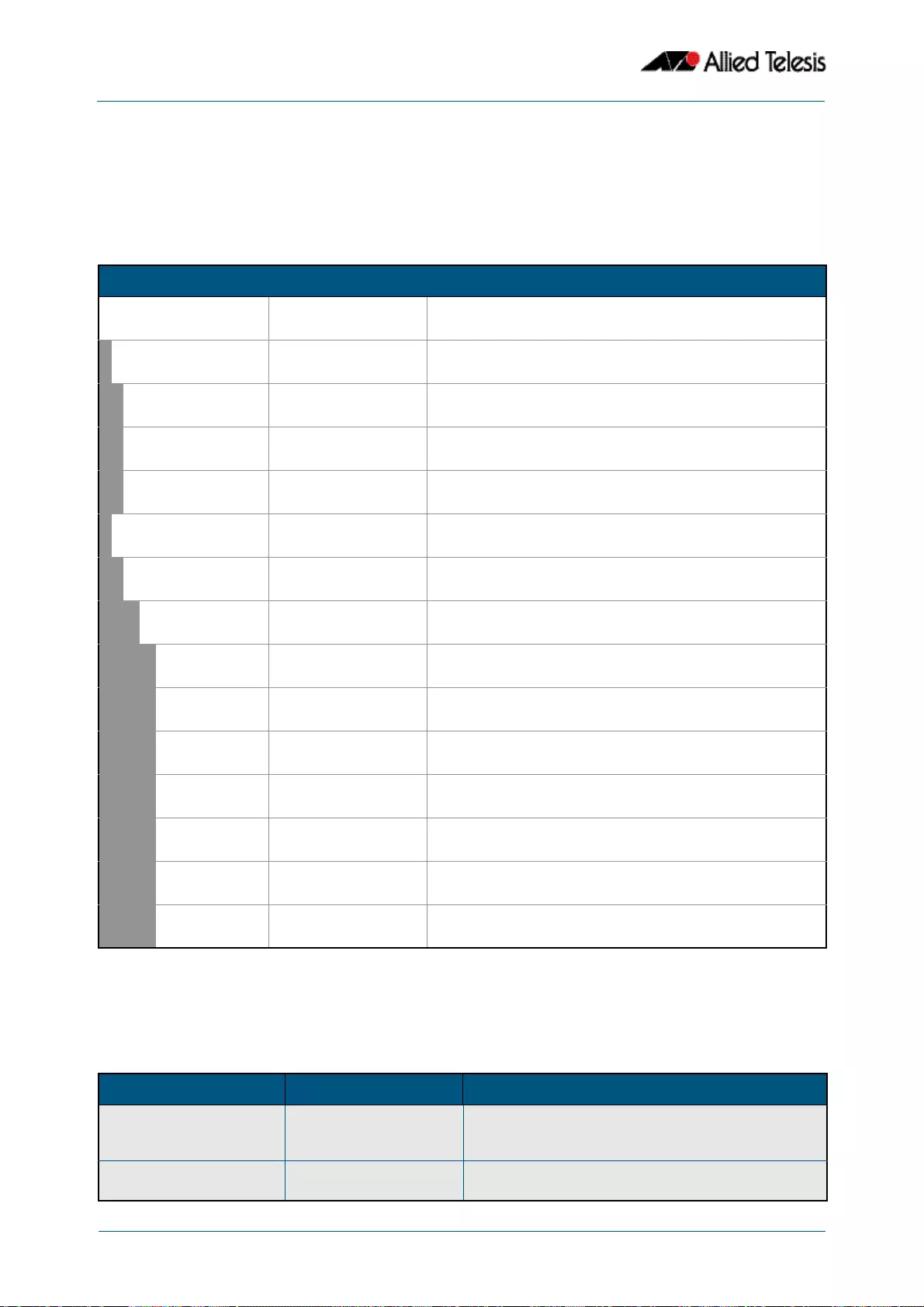
SNMP MIBs
Software Reference for GS900MX/MPX Series Switches
68.66 AlliedWare PlusTM Operating System - Version 5.4.4E-1.x C613-50065-01 REV B
AT-SMI-MIB
AT-SMI-MIB defines the high-level structure and root objects of the Allied Telesis
Enterprise MIB (Table 68-19). These objects are imported by other component MIBs of the
Allied Telesis Enterprise MIB.
Table 68-20 lists the major modules of the AT-SMI-MIB grouped by their object identifiers.
Note that this is also the order in which they are described in this chapter.
Table 68-19: AT Enterprise MIB - High Level Structure
Object Object Identifier Description
alliedTelesis { enterprises 207 }
1.3.6.1.4.1.207
Root of the Allied Telesis Enterprise MIB under the private(4)
node defined in RFC1155-SMI.
products { alliedTelesis 1 }
1.3.6.1.4.1.207.1
Sub-tree of all product OIDs. Described in
“AT-PRODUCTS-MIB” on page 68.52.
bridgeRouter {products 1}
1.3.6.1.4.1.207.1.1
Sub-tree of bridge product MIB objects (not applicable for
AlliedWare Plus).
routerSwitch {products 14}
1.3.6.1.4.1.207.1.2
Sub-tree for all router and switch product MIB objects.
industrialSwitch { products 24 }
1.3.6.1.4.1.207.1.24
Sub-tree for industrial switch product MIB objects.
mibObject { alliedTelesis 8 }
1.3.6.1.4.1.207.8
Sub-tree for all managed objects.
brouterMib {mibObject 4}
1.3.6.1.4.1.207.8.4
Sub-tree of objects for managing bridges, routers, and
switches.
atRouter { brouterMib 4 }
1.3.6.1.4.1.207.8.4.4
Sub-tree of objects for managing multiprotocol routers and
switches.
objects { atRouter 1 }
1.3.6.1.4.1.207.8.4.4.1
Sub-tree of OIDs for boards, releases, interface types, and
chips.
traps { atRouter 2 }
1.3.6.1.4.1.207.8.4.4.2
Sub-tree for generic traps (not applicable for AlliedWare
Plus).
sysinfo { atRouter 3 }
1.3.6.1.4.1.207.8.4.4.3
Sub-tree of objects describing general system information.
modules { atRouter 4 }
1.3.6.1.4.1.207.8.4.4.4
Sub-tree of objects for monitoring and managing software
features.
arInterfaces { atRouter 5 }
1.3.6.1.4.1.207.8.4.4.5
Sub-tree of objects describing boards, slots and physical
interfaces.
protocols { atRouter 6 }
1.3.6.1.4.1.207.8.4.4.6
Sub-tree of OIDs for protocols.
atAgents { atRouter 7 }
1.3.6.1.4.1.207.8.4.4.7
Sub-tree of objects describing variations from standards.
Table 68-20: AT-SMI-MIBs Listed by Object Group
MIB Section OID Description
AT-SMI-MIB This section describes the structure of management
information for the Allied Telesis Enterprise object,
alliedTelesis { 1.3.6.1.4.1.207 }.
AT-PRODUCTS-MIB 1.3.6.1.4.1.207.1 Object identifiers for Allied Telesis products. See
“AT-PRODUCTS-MIB” on page 68.52.

SNMP MIBs
Software Reference for GS900MX/MPX Series Switches
C613-50065-01 REV B AlliedWare PlusTM Operating System - Version 5.4.4E-1.x 68.67
AT-BOARDS-MIB 1.3.6.1.4.1.207.8.4.4.1.1 Object identifiers for boards, interface types, and chip
sets. See “AT-BOARDS-MIB” on page 68.13.
AT-SYSINFO-MIB 1.3.6.1.4.1.207.8.4.4.3 Objects that describe generic system information and
environmental monitoring. See “AT-SYSINFO-MIB”
on page 68.68.
AT-ENVMONv2-MIB 1.3.6.1.4.1.207.8.4.4.3.12 Objects and traps for monitoring fans, voltage rails,
temperature sensors, and power supply bays. See
“AT-ENVMONv2-MIB” on page 68.21.
AT-VCSTACK-MIB 1.3.6.1.4.1.207.8.4.4.3.13 Objects for managing Virtual Chassis Stacking (VCS).
See “AT-ENVMONv2-MIB” on page 68.21.
AT-MIBVERSION-MIB 1.3.6.1.4.1.207.8.4.4.3.15 Object to display the last software release that
contained changes to the support AT Enterprise MIB
definition files. See “AT-MIBVERSION-MIB” on
page 68.48.
AT-USER-MIB 1.3.6.1.4.1.207.8.4.4.3.20 Objects for displaying information of users currently
logged into a device, or configured in the Local User
Data base of the device. See “AT-USER-MIB” on
page 68.75.
AT-RESOURCE-MIB 1.3.6.1.4.1.207.8.4.4.3.21 Objects for displaying system hardware resource
information. See “AT-RESOURCE-MIB” on
page 68.55.
AT-LICENSE-MIB 1.3.6.1.4.1.207.8.4.4.3.22 Objects for managing software licenses on devices
using AlliedWare PlusTM Operating System. See
“AT-LICENSE-MIB” on page 68.41.
AT-TRIGGER-MIB 1.3.6.1.4.1.207.8.4.4.4.53 Objects for managing triggers. See
“AT-TRIGGER-MIB” on page 68.73.
AT-LOOPPROTECT-MIB 1.3.6.1.4.1.207.8.4.4.4.54 Objects for managing Allied Telesis Loop Protection.
See “AT-LOOPPROTECT-MIB” on page 68.46.
AT-SETUP-MIB 1.3.6.1.4.1.207.8.4.4.4.500 Objects for managing software installation and
configuration files. See “AT-SETUP-MIB” on
page 68.57.
AT-DNS-CLIENT-MIB 1.3.6.1.4.1.207.8.4.4.4.501 Objects for managing Allied Telesis DNS Client
Configuration. See “AT-DNS-CLIENT-MIB” on
page 68.20.
AT-NTP-MIB 1.3.6.1.4.1.207.8.4.4.4.502 Objects for managing Allied Telesis Network Time
Protocol (NTP) configuration. See “AT-NTP-MIB” on
page 68.49.
AT-EPSRv2-MIB 1.3.6.1.4.1.207.8.4.4.4.536 Objects for managing Allied Telesis EPSR. See “AT-
EPSRv2-MIB” on page 68.29.
AT-DHCPSN-MIB 1.3.6.1.4.1.207.8.4.4.4.537 Objects for managing Allied Telesis DHCP Snooping.
See “AT-DHCPSN-MIB” on page 68.17.
AT-FILEv2-MIB 1.3.6.1.4.1.207.8.4.4.4.600 Objects for displaying and managing file content on
local, stacked, and remote sources. See
“AT-FILEv2-MIB” on page 68.32.
AT-LOG-MIB 1.3.6.1.4.1.207.8.4.4.4.601 Objects for listing log entries from the buffered and
permanent logs. See “AT-LOG-MIB” on page 68.44.
AT-IP-MIB 1.3.6.1.4.1.207.8.4.4.4.602 Objects for Allied Telesis specific IP address
management. See “AT-IP-MIB” on page 68.39.
AT-ALMMON-MIB 1.3.6.1.4.1.207.8.4.4.3.26 Objects for managing Allied Telesis Alarm Monitor.
Table 68-20: AT-SMI-MIBs Listed by Object Group(cont.)
MIB Section OID Description

SNMP MIBs
Software Reference for GS900MX/MPX Series Switches
68.68 AlliedWare PlusTM Operating System - Version 5.4.4E-1.x C613-50065-01 REV B
AT-SYSINFO-MIB
AT-SYSINFO-MIB defines objects that describe generic system information and environmental
monitoring. Objects in this group have the object identifier sysinfo ({ atRouter 3 }). Table
68-21 lists the objects supported by the AlliedWare PlusTM sysinfo MIB.
Table 68-21: Objects defined in AT-SYSINFO-MIB
Object Description
sysinfo
{ atRouter 3 }
(1.3.6.1.4.1.207.8.4.4.3)
Subtree containing generic system information.
fanAndPs
{sysinfo 1 }
(1.3.6.1.4.1.207.8.4.4.3.1)
A collection of objects for monitoring fans and power
supplies. For devices running the AlliedWare PlusTM
Operating System, these objects are superceded by objects
in the AT-ENVMON-MIB (see “AT-ENVMONv2-MIB” on
page 68.21).
restartGroup
{sysinfo 2 }
A collection of objects and traps for activating and
monitoring restarts. This group is not supported by devices
running the AlliedWare PlusTM Operating System.
cpu
{sysinfo 3 }
A collection of objects containing information about the
CPU utilization over different periods of time. All values are
expressed as a percentage - integer in range 0 to 100.
cpuUtilisationMax
{cpu 1 }
Maximum CPU utilization since the device was last
restarted.
cpuUtilisationAvg
{cpu 2 }
Average CPU utilization since the device was last restarted.
cpuUtilisationAvgLastMinute
{cpu 3 }
Average CPU utilization over the past minute.
cpuUtilisationAvgLast10Seconds
{cpu 4 }
Average CPU utilization over the past ten seconds.
cpuUtilisationAvgLastSecond
{cpu 5 }
Average CPU utilization over the past second.
cpuUtilisationAvgMaxLast5Minutes
{cpu 6 }
Maximum CPU utilization over the last 5 minutes.
cpuUtilisationAvgLast5Minutes
{cpu 7 }
Average CPU utilization over the past 5 minutes.
cpuUtilisationStackTable
{cpu 8 }
A list of stack members.
cpuUtilisationStackEntry
{cpuUtilisationStackTable 1}
A set of parameters that describe the CPU utilization of a
stack member
cpuUtilisationStackId
{cpuUtilisationStackEntry 1}
Stack member ID.
cpuUtilisationStackMax
{cpuUtilisationStackEntry 2}
Maximum CPU utilization since the router was last
restarted. Expressed as a percentage.
cpuUtilisationStackAvg
{cpuUtilisationStackEntry 3}
Average CPU utilization since the router was last restarted.
Expressed as a percentage.
cpuUtilisationStackAvgLastMinute
{cpuUtilisationStackEntry 4}
Average CPU utilisation over the past minute. Expressed as
a percentage.

SNMP MIBs
Software Reference for GS900MX/MPX Series Switches
C613-50065-01 REV B AlliedWare PlusTM Operating System - Version 5.4.4E-1.x 68.69
cpuUtilisationStackAvgLast10Second
s
{cpuUtilisationStackEntry 5}
Average CPU utilisation over the past ten seconds.
Expressed as a percentage.
cpuUtilisationStackAvgLastSecond
{cpuUtilisationStackEntry 6}
Average CPU utilisation over the past second. Expressed as
a percentage.
cpuUtilisationStackMaxLast5Minutes
{cpuUtilisationStackEntry 7}
Maximum CPU utilisation over the last 5 minutes. Expressed
as a percentage.
cpuUtilisationStackAvgLast5Minutes
{cpuUtilisationStackEntry 8}
Average CPU utilisation over the past 5 minutes. Expressed
as a percentage.
sysTemperature
{sysinfo 4 }
A collection of objects and traps for monitoring and
managing the temperature status. For devices running the
AlliedWare PlusTM Operating System.
atContactDetails
{sysinfo 5 }
Contact details for Allied Telesis.
memory
{sysinfo 7 }
A collection of objects and traps for monitoring memory
usage and status.
atEnvMonv2
{sysinfo 12 }
AT Environment Monitoring v2 MIB for managing and
reporting data relating to voltage rails, fan speeds,
temperature sensors and power supply units.
Objects under this portion of the OID are shown in the
“AT-ENVMONv2-MIB” on page 68.21.
vcstack
{sysinfo 13 }
A collection of objects for managing Virtual Chassis
Stacking in AlliedWare PlusTM.
See “AT-VCSTACK-MIB” on page 68.77.
atPortInfo
{sysinfo 14 }
Objects containing information about the transceiver of an
interface. This portion of the object tree is documented
separately in: “AT-PORTINFO” on page 68.70.
atVlanInfo
{sysinfo 16 }
A collection of objects for counting bytes or incoming
frames within a selected VLAN. Note that these objects are
only appropriate for the IX5, x510 and x610 series products.
{sysinfo 17 } to {sysinfo 19 } These objects are not supported on your switch.
user
{sysinfo 20 }
Contains objects for displaying information of users
currently logged into a device, or configured in its local
database.
Objects under this portion of the OID are shown in the
“AT-USER-MIB” on page 68.75.
resource
{sysinfo 21 }
Contains objects for displaying hardware resource
information.
Objects under this portion of the OID are shown in the
“AT-RESOURCE-MIB” on page 68.55.
license
{sysinfo 22 }
This MIB, is used for listing applied software licenses,
adding new licenses, and deleting existing licenses.
Objects under this portion of the OID are shown in the
“AT-LICENSE-MIB” on page 68.41.
chassis
{sysinfo 23 }
This MIB is used for accessing trap notifications on chassis
based products. Note that these objects are only
appropriate for the x8100 series products.
Table 68-21: Objects defined in AT-SYSINFO-MIB
Object Description

SNMP MIBs
Software Reference for GS900MX/MPX Series Switches
68.70 AlliedWare PlusTM Operating System - Version 5.4.4E-1.x C613-50065-01 REV B
AT-PORTINFO
This table defines objects for managing interface port objects such as transceivers. Objects in
this group have the object identifier atPortInfo ({ sysinfo 14 }), OID path,
1.3.6.1.4.1.207.8.4.4.3.14.
Table 68-22: Objects defined in AT-ATPORTINFO portion of the MIB
Object / Object Identifier Description
atPortInfo
{sysinfo 14}
This object returns information about interface transceivers.
atPortInfoTransceiverTable
{atPortInfo 1}
A table of information about the transceiver of a interface.
atPortInfoTransceiverEntry
{atPortInfoTransceiverTable 1}
The description, the transceiver type of a interface.
atPortInfoTransceiverifIndex
{atPortInfoTransceiverEntry 1}
The ifIndex for the interface represented by this entry of the
interfaces table.
atPortInfoTransceiverType
{atPortInfoTransceiverEntry 2}
This object indicates the type of transceiver on a interface.
It contains the following value list objects:

SNMP MIBs
Software Reference for GS900MX/MPX Series Switches
C613-50065-01 REV B AlliedWare PlusTM Operating System - Version 5.4.4E-1.x 68.71
The type of transceiver on an interface can be one of the
following:
■rj45(1)
■sfp-px(2)
■sfp-bx10(3)
■sfp-fx(4)
■sfp-100base-lx(5)
■sfp-t(6)
■sfp-cx(7)
■sfp-zx-cwdm(8)
■sfp-lx(9)
■sfp-sx(10)
■sfp-oc3-lr(11)
■sfp-oc3-ir(12)
■sfp-oc3-mm(13)
■xfp-srsw(14)
■xfp-lrlw(15)
■xfp-erew(16)
■xfp-sr(17)
■xfp-lr(18)
■xfp-er(19)
■xfp-lrm(20)
■xfp-sw(21)
■xfp-lw(22)
■xfp-ew(23)
■unknown(24)
■empty(25)
■sfpp-sr(26)
■sfpp-lr(27)
■sfpp-er(28)
■sfpp-lrm(29)
■inf-1-x-copper-pasv(30)
■inf-1-x-copper-actv(31)
■inf-1-x-lx(32)
■inf-1-x-sx(33)
■cx4(34)
Table 68-22: Objects defined in AT-ATPORTINFO portion of the MIB(cont.)
Object / Object Identifier Description

SNMP MIBs
Software Reference for GS900MX/MPX Series Switches
68.72 AlliedWare PlusTM Operating System - Version 5.4.4E-1.x C613-50065-01 REV B
atPortRenumberEvents
{atPortInfo 2}
The number of times that port number values (represented by the
dot1dBasePort object in BRIDGE-MIB), have been re-assigned due
to stack member leave/join events or XEM hot-swap events, since
the system was initialized.
Table 68-22: Objects defined in AT-ATPORTINFO portion of the MIB(cont.)
Object / Object Identifier Description

SNMP MIBs
Software Reference for GS900MX/MPX Series Switches
C613-50065-01 REV B AlliedWare PlusTM Operating System - Version 5.4.4E-1.x 68.73
AT-TRIGGER-MIB
AT-TRIGGER-MIB defines objects for managing triggers (Table 68-23). Objects in this
group have the object identifier trigger ({ modules 53 }). All objects in this group have read
only access.
Table 68-23: Objects defined in AT-TRIGGER-MIB
Object Identifier Description
triggerTraps
{ trigger 0 }
Sub-tree for all trigger traps.
triggerTrap
{ triggerTraps 1 }
Notification generated when a trigger is activated. It
returns the value of triggerLastTriggerActivated.
triggerLastTriggerActivated
{ trigger 1 }
Trigger number of the most recent trigger activated on the
switch.
triggerConfigInfoTable
{ trigger 9 }
Table of information about each trigger that has been
configured, indexed by triggerNumber.
triggerConfigInfoEntry
{ triggerConfigInfoTable 1 }
Information about the configuration of a single trigger.
triggerNumber
{ triggerConfigInfoEntry 1 }
ID number of the trigger.
Values are in range 1- 250.
triggerName
{ triggerConfigInfoEntry 2 }
Name and description of the trigger.
triggerTypeDetail
{ triggerConfigInfoEntry 3 }
Trigger type and its activation conditions.
triggerActiveDaysOrDate
{ triggerConfigInfoEntry 4 }
The days of a week or the date on which the trigger can be
activated.
triggerActivateAfter
{ triggerConfigInfoEntry 5 }
Time after which the trigger can be activated.
triggerActivateBefore
{ triggerConfigInfoEntry 6 }
Time before which the trigger can be activated.
triggerActiveStatus
{ triggerConfigInfoEntry 7 }
Whether or not the trigger can be activated.
triggerTestMode
{ triggerConfigInfoEntry 8 }
Whether or not the trigger is operating in diagnostic (test)
mode.
triggerSnmpTrap
{ triggerConfigInfoEntry 9 }
Whether or a not an SNMP trap will be generated when the
trigger is activated.
triggerRepeatTimes
{ triggerConfigInfoEntry 10 }
Whether the trigger can repeat an unlimited number of
times (continuous) or a specified number of times. If the
trigger can repeat only a specified number of times, then
the number of times the trigger has already been activated
is displayed in brackets.
triggerLasttimeModified
{ triggerConfigInfoEntry 11 }
Date and time that the trigger configuration was last
modified.
triggerNumberOfActivation
{ triggerConfigInfoEntry 12 }
Number of times the trigger has been activated since the
last restart of the device.
triggerLasttimeActivation
{ triggerConfigInfoEntry 13 }
Date and time that the trigger was last activated.
triggerNumberOfScripts
{ triggerConfigInfoEntry 14 }
Number of scripts that this trigger will execute.
Values are in range 0-5.

SNMP MIBs
Software Reference for GS900MX/MPX Series Switches
68.74 AlliedWare PlusTM Operating System - Version 5.4.4E-1.x C613-50065-01 REV B
triggerScript1
{ triggerConfigInfoEntry 15 }
Name of the first script that this trigger will execute if the
trigger is activated.
triggerScript2
{ triggerConfigInfoEntry 16 }
Name of the second script that this trigger will execute if
the trigger is activated.
triggerScript3
{ triggerConfigInfoEntry 17 }
Name of the third script that this trigger will execute if the
trigger is activated.
triggerScript4
{ triggerConfigInfoEntry 18 }
Name of the fourth script that this trigger will execute if
the trigger is activated.
triggerScript5
{ triggerConfigInfoEntry 19 }
Name of the fifth script that this trigger will execute if the
trigger is activated.
triggerCounters
{ trigger 10 }
Collection of counters for trigger activations.
triggerNumOfActivation
{ triggerCounters 1 }
Number of times a trigger has been activated.
triggerNumOfActivationToday
{ triggerCounters 2 }
Number of times a trigger has been activated today.
triggerNumOfPerodicActivationToday
{ triggerCounters 3 }
Number of times a periodic trigger has been activated
today.
triggerNumOfInterfaceActivationToday
{ triggerCounters 4 }
Number of times an interface trigger has been activated
today.
triggerNumOfResourceActivationToday
{ triggerCounters 5 }
Number of times a CPU or memory trigger has been
activated today.
triggerNumOfRebootActivationToday
{ triggerCounters 6 }
Number of times a reboot trigger has been activated
today.
triggerNumOfPingPollActivationToday
{ triggerCounters 7 }
Number of times a ping-poll trigger has been activated
today.
triggerNumOfStackMasterFailActivationToday
{ triggerCounters 8 }
Number of times a stack master fail trigger has been
activated today.
triggerNumOfStackMemberActivationToday
{ triggerCounters 9 }
Number of times a stack member trigger has been
activated today.
Table 68-23: Objects defined in AT-TRIGGER-MIB(cont.)
Object Identifier Description

SNMP MIBs
Software Reference for GS900MX/MPX Series Switches
C613-50065-01 REV B AlliedWare PlusTM Operating System - Version 5.4.4E-1.x 68.75
AT-USER-MIB
The AT-USER-MIB contains objects for displaying information about users currently logged
into a device, or configured in the Local User Database of the device (Table 68-24).
Objects in this group have the object identifier user ({ sysinfo 20 }).
Table 68-24: Objects defined in AT-U SER-MIB
Object Object Identifier Description
userInfoTable
(207.8.4.4.3.20.1)
{user 1} Table containing information about
users. Each entry in the table
represents a user currently logged
into the device.
Indexed by: rscBoardType and
rscBoardIndex.
userInfoEntry { userInfoTable 1 } Information about a single user
logged into the device.
userInfoType { userInfoEntry 1 } The type of connection through
which the user logged into the
device. Can be:
1. console (1)
2. aux (2)
3. telnet (3)
4. script (4)
5. stack (5)
userInfoIndex { userInfoEntry 2 } Index of the line upon which the user
logged into the device. Can be a
value in range 1 to 16.
userInfoName { userInfoEntry 3 } User name of the user logged into
the device.
userInfoPrivilegeLevel { userInfoEntry 4 } The user’s privilege level. Can be a
value in range 1 to 15.
userInfoIdleTime { userInfoEntry 5 } The amount of time since the user
was last active, in the form hh:mm:ss.
userInfoLocation { userInfoEntry 6 } The user location or login method. It
can be an IP Address used by the
user to telnet into the device, or an
asyn port.
userInfoPasswordLifetime { userInfoEntry 7 } The number of days remaining until
the user’s password expires.
Depending on the current user
setting it will display one of the
following:
No Expiry - the password will never
expire (default setting)
x days - where x is the remaining
lifetime of the current password
(maximum lifetime value is 1000
days)
-x days (expired) - indicating that the
current password expired x days ago
userInfoPasswordLastChange { userInfoEntry 8 } The number of days since the
password was last altered.

SNMP MIBs
Software Reference for GS900MX/MPX Series Switches
68.76 AlliedWare PlusTM Operating System - Version 5.4.4E-1.x C613-50065-01 REV B
userConfigTable {user 2}
or (207.8.4.4.3.20.2)
Table containing user configuration
information. Each entry in the table
relates to a user configured in the
Local User Database of the device.
Indexed by userConfigIndex.
userConfigEntry { userConfigTable 1 } Information about a single user
configured in the Local User
Database of the device.
userConfigIndex { userConfigEntry 1 } Unique number used to identify
entries in the userConfigTable.
userConfigName { userConfigEntry 2 } The user’s name.
userConfigPrivilegeLevel { userConfigEntry 3 } The privilege level granted to the
user. Can be a value in range 1 to 15.
userSecurityPasswordRules {user 3}
or (207.8.4.4.3.20.3)
Information about user password
security rules.
userSecurityPasswordHistory { userSecurityPasswordRules 1 } The number of previous passwords
that are retained for comparison
when a user password is created. A
new password must be unique when
compared against the previous
history. A value of 0 represents no
restriction. The maximum number of
retained passwords is 15.
userSecurityPasswordLifetime { userSecurityPasswordRules 2 } The maximum number of days that
the password may persist before a
change is required. 0 means no
expiry. The maximum value is 1000.
userSecurityPasswordWarning { userSecurityPasswordRules 3 } The number of days before the
password expires that a warning
message is displayed when the user
logs in. A value of 0 indicates no
warning. The maximum value is 1000
but must always be less than the
password lifetime.
userSecurityPasswordMinLength { userSecurityPasswordRules 4 } The minimum allowable password
length.
userSecurityPasswordMinCategory { userSecurityPasswordRules 5 } The minimum number of different
categories that the password must
satisfy to be considered valid.
Categories are split into four groups:
upper-case letters
lower-case letters
digits
special symbols. ASCII characters not
included in the previous three
categories.
userSecurityPasswordForced { userSecurityPasswordRules 6 } Whether or not a user with an
expired password is forced to
change their password at the next
login. At login a user with an expired
password is prompted to change
their password. If the new password
meets the current security password
rules the user is allowed to log in,
otherwise they are rejected.
userSecurityPasswordReject { userSecurityPasswordRules 7 } Whether or not a user login attempt
with an expired password is rejected.
If the user is not rejected then they
can log in.
Table 68-24: Objects defined in AT-U SER-MIB (cont.)
Object Object Identifier Description

SNMP MIBs
Software Reference for GS900MX/MPX Series Switches
C613-50065-01 REV B AlliedWare PlusTM Operating System - Version 5.4.4E-1.x 68.77
AT-VCSTACK-MIB
AT-VCSTACK-MIB defines objects for managing Virtual Chassis Stacking (Table 68-25).
Objects in this group have the object identifier vcstack ({ sysinfo 13 }).
Figure 68-7 on page 68.77 shows the tree structure of the AT-VCSTACK objects.
Figure 68-7: The AT-VCSTACK MIB sub-tree
VCStack_MIB
vcstackRoleChangeNotify (1)
vcstackMemberJoinNotify (2)
vcstackMemberLeaveNotify (3)
vcstackResiliencyLinkHealthCheckReceivingNotify (4)
vcstackResiliencyLinkHealthCheckTimeOutNotify (5 )
vcstackStkPortLinkUpNotify (6)
vcstackStkPortLinkDownNotify (7)
vcstackNbrMemberIdNotify (8)
vcstackStkPortNameNotify (9)
vcstackId (1)
vcstackPendingId (2)
vcstackMacAddr (3)
vcstackPriority (4)
vcstackRole (5)
vcstackLastRoleChange (6)
vcstackHostname (7)
vcstackProductType (8)
vcstackSWVersionAutoSync (9)
vcstackFallbackConfigStatus (10)
vcstackFallbackConfigFilename (11)
vcstackResiliencyLinkStatus (12)
vcstackResiliencyLinkInterfaceName (13)
vcstackActiveStkHardware (14)
vcstackStkPort1Status (15)
vcstackStkPort1NeighbourId (16)
vcstackStkPort2Status (17)
vcstackStkPort2NeighbourId (18)
vcstackNumMembersJoined (19)
vcstackNumMembersLeft (20)
vcstackNumIdConflict (21)
vcstackNumMasterConflict (22)
vcstackNumMasterFailover (23)
vcstackNumStkPort1NbrIncompatible (24)
vcstackNumStkPort2NbrIncompatible (25)
protocols (6)arInterfaces (5)traps (2)objects (1) modules (4)
sysinfo (3)
vcstackTable (5)
vcstackNotifications (0)
vcstackEntry (1)
vcstack (13)
vcstackStatus (1)
vcstackMgmtVlanId (3)
vcstackOperational Status (2)
vcstackMgmtVlanSubnetAddr (4)
vcstackVirtualMacAddressStatus (7)
vcstackVirtualChassisId (8)
vcstackVirtualMacAddr (9)
vcstackMasterId (10)

SNMP MIBs
Software Reference for GS900MX/MPX Series Switches
68.78 AlliedWare PlusTM Operating System - Version 5.4.4E-1.x C613-50065-01 REV B
Table 68-25: Objects defined in AT-VCSTACK-MIB
Object Object Identifier Description
vcstack { sysinfo (13) } Overall stack status.
vcstackNotifications { vcstack 0 } List of traps (notifications)
generated for the stack:
vcstackRoleChangeNotify { vcstackNotifications
1}
The stack status can take one
of the following states:
1. normalOperation (1)
2. operatingInFailoverState
(2)
3. standaloneUnit (3)
4. ringTopologyBroken (4)
vcstackMemberJoinNotify { vcstackNotifications
2}
Notification generated when a
member joins the stack.
Displays the objects:
1. vcstackId
2. vcstackNbrMemberId
vcstackMemberLeaveNotify { vcstackNotifications
3}
Notification generated when a
member leaves the stack.
Displays the objects:
1. vcstackId
2. vcstackNbrMemberId
vcstackResiliencyLinkHealthCheckReceivingNo
tify
{ vcstackNotifications
4}
Notification generated when
the resiliency link is activated.
Displays the objects:
1. vcstackId
2. vcstackResiliencyLinkInterfa
ceName
vcstackResiliencyLinkHealthCheckTimeOutNot
ify
{ vcstackNotifications
5}
Notification generated when
the backup member’s receive
timer has timed-out,
indicating that the Backup has
lost contact with the Master
via the resiliency link. Displays
the objects:
1. vcstackId
2. vcstackResiliencyLinkInterfa
ceName
vcstackStkPortLinkUpNotify { vcstackNotifications
6}
Notification generated when
the stack port link is up.
Displays the objects:
1. vctasckId
2. vcstackStkPortName
vcstackStkPortLinkDownNotify { vcstackNotifications
7}
Notification generated when
the stack port link is down.
Displays the objects:
1. vcstackId
2. vcstackStkPortName
vvcstackNbrMemberIdNotify { vcstackNotifications
8} The stack member id related
to this trap
vcstackStkPortNameNotify { vcstackNotifications
9}
The stack port name related to
this trap

SNMP MIBs
Software Reference for GS900MX/MPX Series Switches
C613-50065-01 REV B AlliedWare PlusTM Operating System - Version 5.4.4E-1.x 68.79
vcstackOperationalStatus { vcstack 2 } The operational status of the
stack can be either:
1. enabled (1)
2. disabled (2)
vcstackMgmtVlanId { vcstack 3 } The current stacking
management VLAN ID
vcstackMgmtVlanSubnetAddr { vcstack 4 } The current stacking
management VLAN subnet
address
vcstackTable { vcstack 5 } Table of information about
stack members, indexed by
vcstackId.
vcstackEntry { vcstackTable 1 } Information about a single
stack member, indexed by
vcstackId.
vcstackId { vcstackEntry 1 } Stack member ID.
vcstackPendingId { vcstackEntry 2 } Pending stack member ID.
vcstackMacAddr { vcstackEntry 3 } Stack member's hardware
MAC address.
vcstackPriority { vcstackEntry 4 } Priority for election of the
stack master. The lowest
number has the highest
priority.
vcstackRole { vcstackEntry 5 } Stack member's role in the
stack. Can be one of the
following:
1. leaving (1)
2. discovering (2)
3. synchronizing (3)
4. backupMember (4)
5. pendingMaster (5)
6. disabledMaster (6)
7. fallbackMaster (7)
8. activeMaster (8)
vcstackLastRoleChange { vcstackEntry 6 } Time and date when the stack
member last changed its role
in the stack.
vcstackHostname { vcstackEntry 7 } Stack member's hostname.
vcstackProductType { vcstackEntry 8 } Stack members product type.
vcstackSWVersionAutoSync { vcstackEntry 9 } Whether or not the stack
member's software is
automatically upgraded.
vcstackFallbackConfigStatus { vcstackEntry 10 } Status of the fallback
configuration file. Can be one
of:
1. fileExists (1)
2. fileNotFound (2)
3. notConfigured (3)
Table 68-25: Objects defined in AT-VCSTACK-MIB(cont.)
Object Object Identifier Description

SNMP MIBs
Software Reference for GS900MX/MPX Series Switches
68.80 AlliedWare PlusTM Operating System - Version 5.4.4E-1.x C613-50065-01 REV B
vcstackFallbackConfigFilename { vcstackEntry 11 } Filename of the fallback
configuration file.
vcstackResiliencyLinkStatus { vcstackEntry 12 } Status of the stack members
resiliency link.
Can be one of:
1. configured (1)
2. successful (2)
3. failed (3)
4. notConfigured (4)
vcstackResiliencyLinkInterfaceName { vcstackEntry 13 } Name of the interface the
resiliency link is configured
on.
vcstackActiveStkHardware { vcstackEntry 14 } Stack ports hardware type.
Can be one of:
1. value (0) is now obsolete
2. xemStk (1)
3. builtinStackingPorts (2)
4. none (3) is now obsolete
5. stackXG (4)
vcstackStkPort1Status { vcstackEntry 15 } Status of stack-port 1. Can be
one of the following:
1. down (1)
2. neighbourIncompatible (2)
3. discoveringNeighbour (3)
4. learnedNeighbour (4)
vcstackStkPort1NeighbourId { vcstackEntry 16 } ID of the neighbor on stack-
port 1.
Zero indicates no learned
neighbor.
vcstackStkPort2Status { vcstackEntry 17 } Status of stack-port 2. Can be
one of:
1. down (1)
2. neighbourIncompatible (2)
3. discoveringNeighbour (3)
4. learnedNeighbour (4)
vcstackStkPort2NeighbourId { vcstackEntry 18 } ID of the neighbor on stack-
port 2.
Zero indicates no learned
neighbor.
vcstackNumMembersJoined { vcstackEntry 19 } Number of times the stack has
acquired a member.
vcstackNumMembersLeft { vcstackEntry 20 } Number of times the stack has
lost a member.
vcstackNumIdConflict { vcstackEntry 21 } Number of times that a stack
member ID conflict has
occurred.
vcstackNumMasterConflict { vcstackEntry 22 } Number of times that a stack
master conflict has occurred.
vcstackNumMasterFailover { vcstackEntry 23 } Number of times that the
stack master has failed.
Table 68-25: Objects defined in AT-VCSTACK-MIB(cont.)
Object Object Identifier Description

SNMP MIBs
Software Reference for GS900MX/MPX Series Switches
C613-50065-01 REV B AlliedWare PlusTM Operating System - Version 5.4.4E-1.x 68.81
vcstackNumStkPort1NbrIncompatible { vcstackEntry 24 } Number of times that the
neighbor on stack port 1 was
incompatible.
vcstackNumStkPort2NbrIncompatible { vcstackEntry 25 } Number of times that the
neighbor on stack port 2 was
incompatible.
vcstackVirtualMacAddressStatus {vcstack 7} Indicates whether the virtual
MAC address is enabled or
disabled. Read-only object.
vcstackVirtualChassisId {vcstack 8} Displays the current virtual
chassis ID.
Read-only object.
vcstackVirtualMacAddr {vcstack 9} Displays the virtual MAC
address used by the stack.
Read-only object.
vcstackMasterId {vcstack 10} Displays the stack ID of the
master unit, or the stack ID of
the standalone unit.
Read-only object
Table 68-25: Objects defined in AT-VCSTACK-MIB(cont.)
Object Object Identifier Description

SNMP MIBs
Software Reference for GS900MX/MPX Series Switches
68.82 AlliedWare PlusTM Operating System - Version 5.4.4E-1.x C613-50065-01 REV B
Other Enterprise MIBs
In general, all objects are supported except where the relevant protocol or feature is either
not supported or not applicable to the device. The following MIBs although under the
Enterprise Branch (OID 1.3.6.1.4.1) and utilized by AlliedWare Plus products are not within
the AlliedTelesis branch of the MIB object tree.

SNMP MIBs
Software Reference for GS900MX/MPX Series Switches
C613-50065-01 REV B AlliedWare PlusTM Operating System - Version 5.4.4E-1.x 68.83
Public MIBs
The following table lists the public MIBs supported by the AlliedWare PlusTM Operating
System. In general, all objects are supported except where the relevant protocol or feature
is either not supported or not applicable to the device. Any variations from the standard
are listed.
Public MIBs Supported by AlliedWare PlusTM
MIB Name Reference / Implementation
IANAifType-MIB www.iana.org/assignments/ianaiftype-mib, IANAifType
textual convention.
RFC1155-SMI RFC 1155, Structure and Identification of Management
Information for TCP/IP-based Internets.
-RFC 1212, Concise MIB Definitions.
RFC1213-MIB See IP-MIB.
-RFC 1215, A Convention for Defining Traps for use with the
SNMP.
-RFC 1239, Reassignment of Experimental MIBs to Standard
MIBs.
IP-MIB The IP MIB tree encompasses IP-MIB, RFC1213-MIB and
IP-FORWARD-MIB definitions. The following documents
define the components:
■RFC 1213, Management Information Base for Network
Management of TCP/IP-based internets: MIB-II
■RFC 4292, IP Forwarding Table MIB
■RFC 4293, Management Information Base for the Internet
Protocol (IP)
The following objects are supported:
■ipForwarding
■ipDefaultTTL
■All ipAddrTable objects except ipAdEntReasmMaxSize
■All ipNetToPhysicalTable objects except
ipNetToPhysicalRowStatus (all read-only)
■ipCidrRouteNumber
■All ipCidrRouteTable objects except ipCidrRouteTos
All other objects in these MIBs are not supported.
Note that an Enterprise version of ipAddressTable objects is
provided by atIpAddressTable in AT-IP-MIB. This provides
equivalent functionality along with support for primary and
secondary IP addresses.
TCP-MIB RFC 2012, SNMPv2 Management Information Base for the
Transmission Control Protocol using SMIv2.
UDP-MIB RFC 2013, SNMPv2 Management Information Base for the
User Datagram Protocol using SMIv2.
IP-FORWARD-MIB See IP-MIB.
-RFC 2257, Agent Extensibility (AgentX) Protocol Version 1.
SNMP-MPD-MIB RFC 2572, Message Processing and Dispatching for the Simple
Network Management Protocol (SNMP).
SNMP-COMMUNITY-MIB RFC 2576, Coexistence between Version 1, Version 2, and
Version 3 of the Internet-standard Network Management
Framework.
SNMPv2-SMI RFC 2578, Structure of Management Information Version 2
(SMIv2).
SNMPv2-TC RFC 2579, Textual Conventions for SMIv2.

SNMP MIBs
Software Reference for GS900MX/MPX Series Switches
68.84 AlliedWare PlusTM Operating System - Version 5.4.4E-1.x C613-50065-01 REV B
SNMPv2-CONF RFC 2580, Conformance Statements for SMIv2.
P-BRIDGE-MIB RFC 2674, Definitions of Managed Objects for Bridges with
Traffic Classes, Multicast Filtering and Virtual LAN Extensions.
The following objects are not supported:
■dot1dTpPortOverflowTable
■dot1dTrafficClassesEnabled
■dot1dGmrpStatus
■dot1dPortCapabilitiesTable
■dot1dUserPriority
■dot1dTrafficClassPriority
■dot1dPortOutboundAccessPriorityTable
■all objects in the dot1dGarp group
■all objects in the dot1dGmrp group
The following read-write object is implemented as
read-only:
■dot1dPortNumTrafficClasses
Q-BRIDGE-MIB RFC 2674, Definitions of Managed Objects for Bridges with
Traffic Classes, Multicast Filtering and Virtual LAN Extensions.
The following objects are not supported:
■dot1qGvrpStatus
■dot1qFdbId
■dot1qTpFdbAddress
■dot1qTpGroupTable
■dot1qForwardAllTable
■dot1qForwardUnregisteredTable
■all objects in the dot1qStatic group
■dot1qVlanTimeMark
■dot1qVlanIndex
■dot1qVlanCurrentEgressPorts
■dot1qVlanCurrentUntaggedPorts
■dot1qVlanForbiddenEgressPorts
■dot1qPortGvrpStatus
■dot1qPortGvrpFailedRegistrations
■dot1qPortGvrpLastPduOrigin
■dot1qPortRestrictedVlanRegistration
■dot1qPortVlanStatisticsTable
■dot1qPortVlanHCStatisticsTable
■dot1qLearningConstraintsTable
The following read-write objects are implemented as
read-only:
■dot1qPvid
■dot1qPortAcceptableFrameTypes
HOST-RESOURCES-MIB RFC 2790, Host Resources MIB.
The following objects are not supported:
■hrStorageAllocationFailures
■All objects in hrDevice
■All objects in hrSWRun
■All objects in hrSWRunPerf
■All objects in hrSWInstalled
■All objects in hrMIBAdminInfo
SNMPv2-PDU RFC 3416, Version 2 of the Protocol Operations for the Simple
Network Management Protocol (SNMP).
Public MIBs Supported by AlliedWare PlusTM(cont.)
MIB Name Reference / Implementation

SNMP MIBs
Software Reference for GS900MX/MPX Series Switches
C613-50065-01 REV B AlliedWare PlusTM Operating System - Version 5.4.4E-1.x 68.85
SNMPv2-TM RFC 3417, Transport Mappings for the Simple Network
Management Protocol (SNMP).
SNMPv2-MIB RFC 3418, Management Information Base (MIB) for the Simple
Network Management Protocol (SNMP).
POE-MIB RFC 3621, Power Ethernet MIB.
In each of the following objects, if one entry is set then all
other entries for the same object in the table are set to the
same value.
■pethMainPseUsageThreshold
■pethNotificationControlEnable
The following objects indicate PSE threshold usage
notification:
■pethMainPowerUsageOnNotification
■pethMainPowerUsageOffNotification
The following read-write object is implemented as
read-only:
■pethPsePortPowerPairs
EtherLike-MIB RFC 3635, Definitions of Managed Objects for the Ethernet-like
Interface Types.
The following objects are deprecated:
■dot3StatsEtherChipSet
■all objects in the dot3Tests group
■all objects in the dot3Errors group
The following read-write object is implemented as
read-only:
■dot3PauseAdminMode
MAU-MIB RFC 3636, Definitions of Managed Objects for IEEE 802.3
Medium Attachment Units (MAUs).
The following objects are not supported:
■all objects in the dot3RpMauBasicGroup group
■ifMauTypeListBits
■ifMauHCFalseCarriers
■all object identifiers in the dot3MauType group
■ifMauAutoNegCapabilityBits
■ifMauAutoNegCapAdvertisedBits
■ifMauAutoNegCapReceivedBits
■ifMauAutoNegRemoteFaultAdvertised
■ifMauAutoNegRemoteFaultReceived
■all objects in the mauMod group
The following objects are deprecated:
■ifMauTypeList
■all objects in the dot3BroadMauBasicGroup group
■ifMauAutoNegCapability
■ifMauAutoNegCapAdvertised
■ifMauAutoNegCapReceived
The following read-write object is implemented as
read-only:
■ifMauStatus
INET-ADDRESS-MIB RFC 4001, Textual Conventions for Internet Network Addresses.
Public MIBs Supported by AlliedWare PlusTM(cont.)
MIB Name Reference / Implementation

SNMP MIBs
Software Reference for GS900MX/MPX Series Switches
68.86 AlliedWare PlusTM Operating System - Version 5.4.4E-1.x C613-50065-01 REV B
In general, all objects are supported except where the relevant protocol or feature is either
not supported or not applicable to the device. The following table lists the private MIBs
supported by the AlliedWare PlusTM Operating System. Any variations from the standard
are listed.
BRIDGE-MIB RFC 4188, Definitions of Managed Objects for Bridges.
The following read-write objects are implemented as read-
only:
■dot1dStpPortEnable
■dot1dStpPortPathCost
The following objects are not supported:
■dot1dStaticTable
■dot1dBaseDelayExceededDiscards
■dot1dBasePortMtuExceededDiscards
RSTP-MIB RFC 4318, Definitions of Managed Objects for Bridges with
Rapid Spanning Tree Protocol.
The following read-write objects are implemented as read-
only:
■dot1dStpPortProtocolMigration
■dot1dStpPortAdminEdgePort
■dot1dStpPortAdminPointToPoint
■dot1dStpPortAdminPathCost
The following object is deprecated:
■dot1dStpPathCostDefault
DISMAN-PING-MIB RFC 4560, Definitions of Managed Objects for Remote Ping,
Traceroute, and Lookup Operations.
The following (lldpLocManAddrTable and
lldpConfigManAddrTable) read-write object is
implemented as read-only:
■pingMaxConcurrentRequests
You can specify multiple ping operations, but the device
only performs one ping at a time
(pingMaxConcurrentRequests).
The device uses ICMP echo for ping operations
(pingImplementationTypeDomains).
LLDP-MIB IEEE Standard 802.1AB-2005, Section 12, LLDP MIB Definitions.
The following local management address table supports
only a single management address per port:
■lldpConfigManAddrTable
LLDP-EXT-DOT1-MIB IEEE Standard 802.1AB-2005, Annex F, IEEE 802.1
Organizationally Specific TLVs., Section F.7.1, IEEE 802.1LLDP
extension MIB module.
In each of the following tables, if one entry is set, all other
entries in the table are set to the same value.
■lldpXdot1ConfigVlanNameTxEnable
■lldpXdot1ConfigProtoVlanTxEnable
■lldpXdot1ConfigProtocolTxEnable
LLDP-EXT-DOT3-MIB IEEE Standard 802.1AB-2005, Annex G, IEEE 802.3
Organizationally Specific TLVs, Section G.7.1, IEEE 802.3 LLDP
extension MIB module
LLDP-EXT-MED-MIB ANSI/TIA-1057- 2006, Section 13.3, LLDP-MED MIB Definition
RIPv2-MIB RFC1724 - RIP Version 2 MIB Extension
Public MIBs Supported by AlliedWare PlusTM(cont.)
MIB Name Reference / Implementation

Software Reference for GS900MX/MPX Series Switches
C613-50065-01 REV B AlliedWare PlusTM Operating System - Version 5.4.4E-1.x 69.1
Chapter 69: LLDP, LLDP-MED and Voice VLAN
Introduction and Configuration
Introduction ........................................................................................................................................ 69.2
Link Layer Discovery Protocol ...................................................................................................... 69.2
LLDP-MED ............................................................................................................................................ 69.3
Voice VLAN .......................................................................................................................................... 69.3
LLDP Advertisements ...................................................................................................................... 69.4
Type-Length-Value (TLV).........................................................................................................69.4
LLDP-MED: Location Identification TLV ............................................................................. 69.7
Transmission and Reception......................................................................................................... 69.8
LLDP-MED Operation ............................................................................................................... 69.9
Storing LLDP Information ............................................................................................................69.10
Configuring LLDP............................................................................................................................69.11
Configure LLDP.........................................................................................................................69.12
Configure LLDP-MED..............................................................................................................69.14
Configure Authentication for Voice VLAN......................................................................69.18

LLDP, LLDP-MED and Voice VLAN Introduction and Configuration
Software Reference for GS900MX/MPX Series Switches
69.2 AlliedWare PlusTM Operating System - Version 5.4.4E-1.x C613-50065-01 REV B
Introduction
This chapter describes the Link Layer Discovery Protocol (LLDP), LLDP for Media Endpoint
Devices (LLDP-MED) and Voice VLAN, and general configuration information for these.
LLDP is designed to be managed with the Simple Network Management Protocol (SNMP),
and SNMP-based Network Management Systems (NMS). LLDP can be configured, and the
information it provides can be accessed, using either the command line interface or SNMP.
■For detailed descriptions of the commands used to configure LLDP and LLDP-MED,
see Chapter 70, LLDP Commands.
■For Voice VLAN commands, see Chapter 17, VLAN Commands.
■For information about the LLDP and LLDP-MED MIBs, see “Public MIBs” on
page 68.83.
Link Layer Discovery Protocol
Link Layer Discovery Protocol (LLDP) is a Layer 2 protocol defined by the IEEE Standard
802.1AB-2005. This switch supports LLDP as specified in this standard, including Annex F
and Annex G.
LLDP enables Ethernet network devices, such as switches and routers, to transmit and/or
receive device-related information to or from directly connected devices on the network,
and to store such information learned about other devices. The data sent and received by
LLDP is useful for many reasons. The switch can discover neighbors—other devices
directly connected to it. Devices can use LLDP to advertise some parts of their Layer 2
configuration to their neighbors, enabling some kinds of misconfiguration to be more
easily detected and corrected.
LLDP is a link level (“one hop”) protocol; LLDP information can only be sent to and received
from devices that are directly connected to each other, or connected via a hub or repeater.
Advertised information is not forwarded on to other devices on the network.
The information transmitted in LLDP advertisements flows in one direction only, from one
device to its neighbors, and the communication ends there. Transmitted advertisements
do not solicit responses, and received advertisements do not solicit acknowledgment.
LLDP operates over physical ports (Layer 2) only. For example, it can be configured on
switch ports that belong to static or dynamic aggregated links (channel groups), but not
on the aggregated links themselves; and on switch ports that belong to VLANs, but not on
the VLANs themselves.
LLDP provides a way for the switch to:
■transmit information about itself to neighbors
■receive device information from neighbors
■store and manage information in an LLDP MIB
Each port can be configured to transmit local information, receive neighbor information,
or both.

LLDP, LLDP-MED and Voice VLAN Introduction and Configuration
Software Reference for GS900MX/MPX Series Switches
C613-50065-01 REV B AlliedWare PlusTM Operating System - Version 5.4.4E-1.x 69.3
LLDP defines:
■a set of common advertisements (“LLDP Advertisements” on page 69.4)
■a protocol for transmitting and receiving advertisements (“Transmission and
Reception” on page 69.8)
■a method for storing the information that is contained within received
advertisements (“Storing LLDP Information” on page 69.10)
Interactions LLDP has the following interactions with other switch features:
■Spanning tree
Ports blocked by a spanning tree protocol can still transmit and receive LLDP
advertisements.
■802.1x
Ports blocked by 802.1x port authorization cannot transmit or receive LLDP
advertisements. If LLDP has stored information for a neighbor on the port before it
was blocked, this information will eventually time out and be discarded.
■VLAN tagging
LLDP packets are untagged; they do not contain 802.1Q header information with
VLAN identifier and priority tagging.
■Virtual Chassis Stacking (VCStack) resiliency link
When a port is configured as a VCStack resiliency link port, LLDP does not operate on
the port; LLDP neither transmits nor receives advertisements, and any LLDP
configuration and data stored for the port, including counters, is discarded.
■Mirror ports
LLDP does not operate on mirror analyzer ports.
LLDP-MED
LLDP for Media Endpoint Devices (LLDP-MED), is an extension of LLDP used between LAN
network connectivity devices, such as this switch, and the media endpoint devices
connected to them, such as IP phones. LLDP-MED is specified in ANSI/TIA-1057-2006. Of
the application types specified in ANSI/TIA-1057-2006, the switch supports Application
Type 1: Voice.
LLDP-MED uses the LLDP advertisement, transmission and storage mechanisms, but
transmits, receives, and stores data specifically related to managing the voice endpoint
devices. This includes information about network policy, location, hardware configuration,
and, for Power over Ethernet-capable devices, power management.
Voice VLAN
Many IP phones (or other IP voice devices) have two interfaces: one to connect to the
network and another that allows a computer or similar device to connect to the network
via the IP phone. It is often desirable to treat the voice and data traffic separately so that
appropriate Quality of Service (QoS) policies can be applied to each. The Voice VLAN
feature uses LLDP-MED to convey configuration information (such as VLAN ID and User
Priority tagging, and DiffServ Code Point (DSCP)—“Differentiated Services
Architecture” on page 40.4) for the voice traffic to the IP phone. In response, the IP

LLDP, LLDP-MED and Voice VLAN Introduction and Configuration
Software Reference for GS900MX/MPX Series Switches
69.4 AlliedWare PlusTM Operating System - Version 5.4.4E-1.x C613-50065-01 REV B
phone sends voice traffic according to this configuration. The data traffic coming through
the IP phone from the PC is sent with the default configuration, typically untagged with
normal priority.
LLDP Advertisements
LLDP transmits advertisements as packets called LLDP Data Units (LLDPDUs). An LLDPDU
consists of a set of Type-Length-Value elements (TLV), each of which contains a particular
type of information about the device or port transmitting it.
Type-Length-Value (TLV)
A single LLDPDU contains multiple TLVs. TLVs are short information elements that
communicate complex data, such as variable length strings, in a standardized format.
Each TLV advertises a single type of information, such as its device ID, type, or
management addresses. The following table describes fields in a TLV.
LLDP sends mandatory TLVs in each advertisement; it can also be configured to send one
or more optional TLVs, from the following groups:
■Mandatory Base TLVs, included in all LLDP advertisements. See IEEE 802.1AB-2005.
■Optional Base TLVs, which may be included in any LLDP advertisements. See
IEEE 802.1AB-2005.
■IEEE 802.1 Organizationally Specific TLVs (802.1 TLVs). See IEEE 802.1AB-2005 Annex F.
■IEEE 802.3 Organizationally Specific TLVs (802.3 TLVs). See IEEE 802.1AB-2005 Annex G.
■LLDP-MED Organizationally Specific TLVs (LLDP-MED TLVs), included in LLDP-MED
advertisements. See ANSI/TIA-1057- 2006.
Mandatory and optional TLVs for LLDP and LLDP-MED advertisements are shown in
Table 69-2.
Table 69-1: Fields in a Type Length Value element
Field Description
Type Identifies the kind of information. It consists of a 7-bit Type code.
Length Identifies the length of the information. It consists of a 9-bit value
that specifies the number of bytes of data in the Value field.
Value Contains the actual value of the advertised information. This is a
variable length data field.
Table 69-2: TLVs in LLDP advertisements
TLV Description
Mandatory Base TLVs—IEEE 802.1AB-2005
Chassis ID Identifies the device's chassis. On this switch, this is the MAC
address of the switch or stack.
Port ID Identifies the port that transmitted the LLDPDU.

LLDP, LLDP-MED and Voice VLAN Introduction and Configuration
Software Reference for GS900MX/MPX Series Switches
C613-50065-01 REV B AlliedWare PlusTM Operating System - Version 5.4.4E-1.x 69.5
Time To Live (TTL) Indicates the length of time in seconds for which the information
received in the LLDPDU remains valid. If the value is greater than
zero, the information is stored in the LLDP remote system MIB. If
the value is zero, the information previously received is no longer
valid, and is removed from the MIB.
End of LLDPDU Signals that there are no more TLVs in the LLDPDU.
Optional Base TLVs—IEEE 802.1AB-2005
Port description A description of the device’s port in alpha-numeric format.
System name The system's assigned name in alpha-numeric format.
System description A description of the device in alpha-numeric format. This includes
information about the device’s hardware and operating system.
System capabilities The device’s router and bridge functions, and whether or not
these functions are currently enabled.
Management
address
The address of the local LLDP agent. This can be used to obtain
information related to the local device.
IEEE 802.1 Organizationally Specific TLVs (802.1 TLVs)—IEEE 802.1AB-2005
Annex F
Port VLAN VLAN identifier that the local port associates with untagged or
priority tagged frames.
Port & Protocol
VLANs
Whether Port & Protocol VLAN is supported and enabled on the
port, and the list of Port & Protocol VLAN identifiers.
VLAN Names List of VLAN names that the port is assigned to.
Protocol IDs List of protocols that are accessible through the port, for instance:
■9000 (Loopback)
■00 26 42 42 03 00 00 00 (STP)
■00 27 42 42 03 00 00 02 (RSTP)
■00 69 42 42 03 00 00 03 (MSTP)
■888e01 (802.1x)
■aa aa 03 00 e0 2b 00 bb (EPSR)
■88090101 (LACP)
■00540000e302 (Loop protection)
■0800 (IPv4)
■0806 (ARP)
■86dd (IPv6)
Table 69-2: TLVs in LLDP advertisements(cont.)
TLV Description

LLDP, LLDP-MED and Voice VLAN Introduction and Configuration
Software Reference for GS900MX/MPX Series Switches
69.6 AlliedWare PlusTM Operating System - Version 5.4.4E-1.x C613-50065-01 REV B
IEEE 802.3 Organizationally Specific TLVs (802.3 TLVs)—IEEE 802.1AB-2005
Annex G
MAC/PHY
Configuration/
Status
The current values of the following for the port:
■Speed and duplex mode auto-negotiation support
■Auto-negotiation status
■PMD (physical media dependent) auto-negotiation advertised
capability
■Operational MAU type
This TLV is always included in LLDP-MED advertisements.
Power Via MDI The power-via-MDI capabilities.
On devices that are LLDP-MED and PoE-capable, we recommend
using the Extended Power-via-MDI TLV instead of this TLV.
Link Aggregation Whether the link is capable of being aggregated, whether it is
currently in an aggregation and if in an aggregation, the port of
the aggregation.
Maximum Frame
Size
The maximum supported 802.3 frame size that the sending
device is capable of receiving—larger frames will be dropped.
LLDP-MED Organizationally Specific TLVs (LLDP-MED TLVs)—ANSI/TIA-1057- 2006
LLDP-MED
Capabilities
Indicates an LLDP-MED capable device, and advertises which
LLDP-MED TLVs are supported and enabled, and the device type.
For this switch, the device type is Network Connectivity Device.
An advertisement containing this TLV is an LLDP-MED
advertisement.
Network Policy Network policy information configured on the port for connected
media endpoint devices. The switch supports Application Type 1:
Voice, including the following network policy for connected voice
devices to use for voice data:
■Voice VLAN ID
■Voice VLAN User Priority tagging
■Voice VLAN Diffserv Code Point (DSCP)
Location
Identification
Location information configured for the port, in one or more of
the following formats:
■Civic address
■Coordinate-based LCI
■Emergency Location Identification Number (ELIN)
For more information, see “LLDP-MED: Location Identification
TLV” on page 69.7.
Extended
Power-via-MDI
For PoE-capable devices, this TLV includes:
■Power Type field: Power Sourcing Entity (PSE).
■Power Source field: current power source, either Primary
Power Source or Backup Power Source.
■Power Priority field: power priority configured on the port.
■Power Value field: In TLVs transmitted by Power Sourcing
Equipment (PSE) such as this switch, this advertises the power
that the port can supply over a maximum length cable based
on its current configuration (that is, it takes into account
power losses over the cable). In TLVs received from Powered
Device (PD) neighbors, the power value is the power the
neighbor requests.
Available on devices that are PoE-capable.
Table 69-2: TLVs in LLDP advertisements(cont.)
TLV Description

LLDP, LLDP-MED and Voice VLAN Introduction and Configuration
Software Reference for GS900MX/MPX Series Switches
C613-50065-01 REV B AlliedWare PlusTM Operating System - Version 5.4.4E-1.x 69.7
LLDP-MED: Location Identification TLV
Location information can be configured for each port, and advertised to remote devices,
which can then transmit this information in calls; the location associated with voice
devices is particularly important for emergency call services. All ports may be configured
with the location of the switch, or each port may be configured with the location of the
remote voice device connected to it.
The location information for a particular port can be configured using one or more of the
following three data formats: coordinate-based, Emergency Location Identification
Number (ELIN), and civic address. Up to one location of each type can be assigned to a
port.
Location configuration information (LCI) in all configured data formats is transmitted in
Location Identification TLVs. When LLDP receives a Location Identification TLV, it updates
the remote entry in the LLDP-MED MIB with this information.
Co-ordinate LCI Coordinate-based location data format uses geospatial data, that is, latitude, longitude,
and altitude (height or floors), including indications of resolution, with reference to a
particular datum: WGS 84, NAD83—North American Vertical Datum of 1988 (NAVD88), or
NAD83—Mean Lower Low Water (MLLW). For more information, see RFC 3825, Dynamic
Host Configuration Protocol Option for Coordinate-based Location Configuration
Information.
ELIN LCI Emergency Location Identification Number (ELIN) location data format provides a unique
number for each location for Emergency Call Services (ECS). In North America, ELINs are
typically 10 digits long; ELINs up to 25 digits are supported.
Civic Address LCI The Civic Address location data format uses common street address format, as described
in RFC4776.
Inventory
Management TLV
Set
Includes the following TLVs, based on the current hardware
platform and the software version, identical on every port on the
switch:
■Hardware Revision
■Firmware Revision
■Software Revision
■Serial Number
■Manufacturer Name
■Model Name
■Asset ID
On Virtual Chassis Stacking devices, the inventory information is
based on the current master.
Table 69-2: TLVs in LLDP advertisements(cont.)
TLV Description

LLDP, LLDP-MED and Voice VLAN Introduction and Configuration
Software Reference for GS900MX/MPX Series Switches
69.8 AlliedWare PlusTM Operating System - Version 5.4.4E-1.x C613-50065-01 REV B
Transmission and Reception
Table 69-3 describes the LLDP transmission and reception processes. Additional LLDP-
MED processes are described in “LLDP-MED Operation” on page 69.9.
Table 69-3: LLDP transmission and reception processes
When ... and ... then ...
LLDP is enabled Ports are configured to transmit
LLDP advertisements
Regular LLDP advertisements are sent via these
ports at intervals determined by the transmit
interval. Each advertisement contains local
information (from the Local Systems MIB) for all the
mandatory TLVs and the optional TLVs that the port
is configured to send.
Ports are configured to receive
LLDP advertisements
Information received in advertisements via these
ports is stored in the Neighbor table (Remote
Systems MIB). This information is retained until it is
replaced by a more recent advertisement from the
same neighbor or it times out (the TTL elapses).
Local information
changes
The transmission delay time has
elapsed since the last
advertisement was transmitted
New advertisements are sent containing the new
set of local information.
Neighbor
information changes
Notifications are enabled, and
the notification interval has
elapsed since the last notification
was sent
The SNMP notification (trap) lldpRemTablesChange
is sent.
LLDP transmission
and reception is
disabled on a port.
An LLDP command was used to
do this It transmits a final ‘shutdown’ LLDPDU with a Time-
To-Live (TTL) TLV that has a value of “0”. This tells
any remote neighboring devices to remove the
information associated with this switch from their
remote systems MIB. Then it stops transmitting and
receiving advertisements. The neighbor
information remains in the Remote Systems MIB
until it times out.
A shutdown command was used
on the port
It makes a best effort to send a shutdown LLDPDU.
Then it stops transmitting and receiving
advertisements. The neighbor information remains
in the Remote Systems MIB until it times out.
Something else disabled LLDP,
such as Virtual Chassis Stacking
(VCStack) failover
It does not send a shutdown LLDPDU. It stops
transmitting and receiving advertisements. The
neighbor information remains in the Remote
Systems MIB until it times out.
It is enabled again LLDP reinitializes and resumes transmitting and
receiving advertisements after the reinitialization
interval has elapsed.
The Neighbor table
has 1600 neighbors It discards any further neighbors.
LLDP receives a
LLDPDU or TLV with
a detectable error
It discards the incorrect TLV.
LLDP receives a TLV it
does not recognize It contains no basic format errors It stores it for possible later retrieval by network
management (in the unrecognized TLV information
table lldpRemUnknownTLVTable in the LLDP MIB).

LLDP, LLDP-MED and Voice VLAN Introduction and Configuration
Software Reference for GS900MX/MPX Series Switches
C613-50065-01 REV B AlliedWare PlusTM Operating System - Version 5.4.4E-1.x 69.9
LLDP-MED Operation
When LLDP is enabled, LLDP-MED is enabled by default, and uses the same LLDP
transmission and reception process described in Table 69-3. When LLDP receives an
advertisement indicating a newly connected LLDP-MED-capable device on a port, it
transmits one LLDP-MED advertisement per second via this port, a configurable number
of times (the fast start count). Thereafter, it sends regular advertisements at the LLDP
transmit interval. When the last advertisement for an LLDP-MED-capable device
connected to the port times out, it stops sending LLDP-MED advertisements via the port.
If LLDP-MED notifications are enabled for a port, and SNMP traps for LLDP are enabled,
LLDP-MED generates a Topology Change Notification (LLDP-MED lldpXMedTopology
ChangeDetected) when a new LLDP-MED compliant IP telephony device is connected to a
port or removed from a port. This notification includes the following information:
■IP Phone Chassis ID and Chassis ID sub-type (IP address)
■LLDP Endpoint Device Class
■Switch Chassis ID (MAC address) and Port ID where the device is attached.

LLDP, LLDP-MED and Voice VLAN Introduction and Configuration
Software Reference for GS900MX/MPX Series Switches
69.10 AlliedWare PlusTM Operating System - Version 5.4.4E-1.x C613-50065-01 REV B
Storing LLDP Information
When an LLDP device receives a valid LLDP advertisement from a neighboring network
device, it stores the information in an IEEE-defined Simple Network Management Protocol
(SNMP) Management Information Base (MIB).
LLDP stores information in the LLDP MIB defined in Section 12 of the IEEE Standard
802.1AB-2005, its extensions defined in Annex F, Annex G, and ANSI/TIA-1057- 2006, about:
LLDP-EXT-MED-MIB ANSI/TIA-1057- 2006, Section 13.3, LLDP-MED MIB Definition
■Local system information. This is the information that LLDP can transmit in
advertisements to its neighbors.
■Remote systems information. This is the data that the device receives in
advertisements from its neighbors.
■LLDP configuration. This can be used with SNMP to configure LLDP on the device.
■LLDP statistics. This includes information about LLDP operation on the device,
including packet and event counters.
This information can be accessed either via SNMP, or directly using the command line
interface.
Local system Information about your device is called local system information. The LLDP local system
MIB maintains this information, which consists of device details, as well as any user-
configured information that you have set up for your switch, for example a port
description or a management address.
LLDP on this device can store one management address per port, and transmit this in
LLDP advertisements. It can store multiple management addresses received from each
neighbor.
Remote systems Information gained from neighboring devices is called remote system information. The
LLDP remote systems MIB maintains this information.
The length of time for which neighbor information remains in the LLDP remote systems
MIB is determined by the Time-To-Live (TTL) value of received LLDPDUs. When it receives
an advertisement from a neighbor, LLDP starts a timer based on the Time To Live (TTL)
information in the advertisement. The Time To Live (TTL) information in an advertisement
is:
TTL=transmit interval x holdtime multiplier. If the TTL elapses, for instance if the neighbor
has been removed, LLDP deletes the neighbor’s information from the MIB. This ensures
that only valid LLDP information is stored.
Whenever a new neighbor is discovered, or an existing neighbor sends an advertisement
with new information that differs from the previous advertisement, for example a new or
changed TLV, a remote tables change event is activated. If SNMP notifications are enabled,
the notification lldpRemTablesChange is sent.
To prevent the remote systems MIB from using large amounts of memory and possibly
affecting the operation of your switch, it limits the number of neighbors it stores
information for to 1600. If it is storing information from 1600 neighbors, and detects any
more neighbors, it is considered to have too many neighbors, and discards
advertisements from the rest. There is no per-port limit to the number of neighbors.
SNMP utilities An SNMP utility can read the Neighbors table MIB (Remote Systems Data in the LLDP MIB)
on a device to find out about the LLDP neighbors it is directly connected to on each port.
Then it can read the Neighbors table MIB on each of these neighbors to find out about
their neighboring LLDP devices, and so on.

LLDP, LLDP-MED and Voice VLAN Introduction and Configuration
Software Reference for GS900MX/MPX Series Switches
C613-50065-01 REV B AlliedWare PlusTM Operating System - Version 5.4.4E-1.x 69.11
Configuring LLDP
You can configure LLDP on the device using either:
■the command line interface. For detailed descriptions of the commands, see
Chapter 70, LLDP Commands, or
■SNMP—see Chapter 68, SNMP MIBs.
This section includes the following command line interface configuration procedures:
■“Configure LLDP” on page 69.12— This procedure includes configuration for LLDP
between network connectivity devices; it does not include LLDP-MED. If you are
configuring LLDP-MED only, use the following procedure instead of this one.
■“Configure LLDP-MED” on page 69.14—This procedure includes the LLDP
configuration required to support LLDP-MED, as well as specific LLDP-MED and Voice
VLAN configuration.
■“Configure Authentication for Voice VLAN” on page 69.18—This procedure
includes 802.1X port authentication configuration including dynamic VLAN
assignment to be used with LLDP-MED. Use the previous procedure before using this
one.
Because LLDP is often used together with SNMP, consider configuring SNMP before you
configure LLDP. LLDP transmits large amounts of data about the network. For security
reasons, we recommend configuring SNMP for SNMP version 3 only (for read and write
access). Remove all SNMPv1 and SNMPv2 configuration. See Chapter 66, SNMP
Introduction, and Chapter 67, SNMP Commands.

LLDP, LLDP-MED and Voice VLAN Introduction and Configuration
Software Reference for GS900MX/MPX Series Switches
69.12 AlliedWare PlusTM Operating System - Version 5.4.4E-1.x C613-50065-01 REV B
Configure LLDP
Use the procedure in Table 69-4 below to configure LLDP.
Some optional TLVs send information that can be configured by other commands. If LLDP
will be configured to send these TLVs, consider whether to configure the corresponding
parameters first.
■Port Description. See the description (interface) command on page 12.2.
■System Name. See the hostname command on page 8.17.
Table 69-4: Configuration procedure for LLDP
Step 1. Enable LLDP
1. awplus#configure terminal Enter Configuration mode.
2. awplus(config)#lldp run Enable LLDP.
Step 2. Configure ports for LLDP
Configure each port to determine whether and which LLDP messages are transmitted and received. If all the
ports running LLDP require the same configuration, configure them all together. Otherwise repeat these
commands for each port or group of ports that requires a particular configuration.
3. awplus(config)# interface <port-list>Enter Interface Configuration mode for the switch
ports.
4. awplus(config-if)#lldp tlv-select {[<tlv>]...}
awplus(config-if)#lldp tlv-select all
By default, the mandatory TLVs are included in
LLDP messages. Enable the transmission of one or
more optional TLVs through these port as
required.
5. awplus(config-if)#exit Return to Global Configuration mode.
6. awplus(config)#interface <port-list>By default, transmission and reception of LLDP
advertisements is enabled on all ports. Enter
Interface Configuration mode for any switch ports
that should have transmission or reception
disabled.
7. awplus(config-if)#no lldp {[transmit]
[receive]}
Disable transmission and/or reception as required.
8. awplus(config-if)#exit Return to Global Configuration mode.
9. awplus(config)#exit Return to Privileged Exec mode.
Step 3. Check LLDP configuration
10. awplus#show lldp
awplus#show lldp interface [<port-list>]
awplus#show lldp local-info [base] [dot1] [dot3]
[med] [interface <port-list>]
awplus#show running-config lldp
Review the LLDP configuration.
Step 4. Monitor LLDP
11. awplus#show lldp neighbors
awplus#show lldp neighbors detail
awplus#show lldp statistics
awplus#show lldp statistics interface [<port-list>]
Monitor LLDP operations and display neighbor
information as required.

LLDP, LLDP-MED and Voice VLAN Introduction and Configuration
Software Reference for GS900MX/MPX Series Switches
C613-50065-01 REV B AlliedWare PlusTM Operating System - Version 5.4.4E-1.x 69.13
Step 5. Advanced LLDP configuration
The configuration procedure above and the defaults for other settings suit most networks. Use the following
commands for fine tuning if necessary.
Timer intervals should be long enough not to create unnecessarily high numbers of advertisements when there
are topology changes. However, be aware that if the intervals are long, a neighbor’s information can continue
to be stored after its information has changed, or after it is disconnected.
12. awplus#configure terminal Enter Configuration mode.
13. awplus(config)#interface <port-list>Enter Interface Configuration mode for the switch
ports.
14. awplus(config-if)#lldp management-address
<ipaddr>
Override the default LLDP management address
advertised through this port if required. This must
be an IPv4 address that is already configured on
the device. To see the management address that
will be advertised, use the show lldp local-info
command on page 70.39.
15. awplus(config-if)#lldp notifications By default, SNMP notifications are not transmitted.
Enable them for these ports if required. (SNMP
LLDP traps (notifications) must also be enabled.)
16. awplus(config-if)#exit Return to Global Configuration mode.
17. awplus(config)#lldp timer <5-32768>The transmit interval determines how often
regular LLDP transmits advertisements from each
port. The transmit interval must be at least four
times the transmission delay.
Default: 30 seconds
18. awplus(config)#lldp notification-interval <5-
3600>
The notification interval determines the minimum
interval between sending SNMP notifications
(traps).
Default: 5 seconds
19. awplus(config)#lldp tx-delay <1-8192>A series of successive changes over a short period
of time can trigger the agent to send a large
number of LLDPDUs. To prevent this, there is a
transmission delay timer. This establishes a
minimum length of time that must elapse
between successive LLDP transmissions. The
transmission delay cannot be greater than a
quarter of the transmit interval.
Default: 2 seconds
20. awplus(config)#lldp reinit <1-10>Reinitialization delay timer determines the
minimum time after disabling LLDP on a port
before it can reinitialize.
Default: 2 seconds
21. awplus(config)#lldp holdtime-multiplier <2-
10>
The transmit interval is multiplied by the holdtime
multiplier to give the Time To Live (TTL) value that
is advertised to neighbors.
Default: 4
22. awplus(config)#exit Return to Privileged Exec mode.
Step 6. Clear data
If necessary, you can clear either neighbor information or LLDP statistics for particular ports or all ports.
23. awplus#clear lldp table [interface <port-list>] Clear the information from the table of neighbor
information.
24. awplus#clear lldp statistics [interface <port-list>] Clear LLDP statistics (packet and event counters).
Table 69-4: Configuration procedure for LLDP (cont.)

LLDP, LLDP-MED and Voice VLAN Introduction and Configuration
Software Reference for GS900MX/MPX Series Switches
69.14 AlliedWare PlusTM Operating System - Version 5.4.4E-1.x C613-50065-01 REV B
Configure LLDP-MED
Use the procedure in Table 69-5 to configure LLDP-MED and Voice VLAN for voice devices
connected to the switch.
Consider whether you also need to configure:
■Simple Network Management Protocol (Chapter 67, SNMP Commands)
■802.1X port authentication (Chapter 47, 802.1X Commands, Chapter 43,
Authentication Commands, Chapter 45, AAA Commands)
■RADIUS server (Chapter 49, RADIUS Commands)
■Quality of Service (Chapter 41, QoS Commands)
■Access Control Lists (Chapter 37, IPv4 Hardware Access Control List (ACL)
Commands and Chapter 38, IPv4 Software Access Control List (ACL) Commands)
■Power over Ethernet (PoE), if the switch supports PoE (Chapter 23, Power over
Ethernet Commands)
In most cases, configuring LLDP-MED using SNMP or using the CLI command line interface
(CLI) described in Chapter 70, LLDP Commands has the same effect. However, the effect
of configuring location information using SNMP differs from the CLI. When location
information is assigned to a port by SNMP and a matching location is not found on the
device, then a new location is automatically created and assigned to the specified port. If
the location is unset by SNMP later, then the location is removed to prevent accumulating
SNMP-set location information. However, if the location is being used for other ports, the
automatically created location is not removed until no ports use it. Once it is modified or
assigned to other ports by CLI commands, the location remains even after no ports use
the location.
Table 69-5: Configuration procedure for Voice VLAN and LLDP-MED
Step 1. Configure a Voice VLAN
Create a VLAN for voice data from voice endpoint devices connected to ports on the switch. Specify the
network policy for voice data in this voice VLAN. LLDP-MED sends the network policy to voice devices
connected to these ports. The voice devices use this network policy to determine the VLAN, priority and DSCP
tagging of voice data it transmits.
1. awplus# configure terminal Enter Global Configuration mode.
2. awplus(config)# vlan database Enter VLAN Database Configuration mode.
3. awplus(config-vlan)# vlan <vid> [name
<vlan-name>] [state {enable|disable}]
Create a VLAN to be used for the voice data to and
from voice devices connected to the switch. By
default, the new VLAN is enabled.
4. awplus(config-vlan)# exit Return to global configuration mode.
5. awplus(config)# interface <port-list>Enter interface configuration mode for the ports
to be configured with the same network policy.
This may be all the switch ports with voice devices
connected to them, or a subset if the network
policy will differ between ports.
6. awplus(config-if)# switchport voice vlan
[<vid>|dot1p|dynamic|untagged]
Specify the VLAN tagging to be used for voice
data on these ports.
Use the dynamic option if the VLAN tagging will
be allocated dynamically by a RADIUS server.
Default: none.
7. awplus(config-if)# switchport voice vlan
priority <0-7>
Specify the priority-tagging that voice endpoint
devices should put into their data packets.
Default: 5.

LLDP, LLDP-MED and Voice VLAN Introduction and Configuration
Software Reference for GS900MX/MPX Series Switches
C613-50065-01 REV B AlliedWare PlusTM Operating System - Version 5.4.4E-1.x 69.15
8. awplus(config-if)# switchport voice dscp <0-
63>
Specify the DSCP value that voice endpoint
devices should put into their data packets.
Default: 0.
9. awplus(config-if)# exit Return to global configuration mode.
Step 2. Enable LLDP
10. awplus(config)# lldp run Enable LLDP on the switch.
Default: LLDP is disabled.
11. awplus(config)# interface <port-list>Enter interface configuration mode for the switch
ports LLDP is NOT to run on.
12. awplus(config-if)# no lldp {[transmit] [receive]} Disable transmission or reception on these ports
as required.
Default: transmit and receive enabled.
13. awplus(config-if)# exit Return to global configuration mode.
Step 3. Configure LLDP-MED location information
Create civic address, coordinate, and/or ELIN locations, and assign them to switch ports.
14. awplus(config)# location civic-location identifier
<civic-loc-id>
Specify a civic location ID, and enter configuration
mode for this identifier.
15. awplus(config-civic)# country <country>
awplus(config-civic)# city <city>
awplus(config-civic)# primary-road-name
<primary-road-name>
awplus(config-civic)# street-suffix <street-
suffix>
awplus(config-civic)# house-number <house-
number>
awplus(config-civic)# <other-civic-location-
parameters …>
Specify the civic address location information for
the civic address location ID. You must specify a
country first, using the upper-case two-letter
country code, and then at least one more
parameter. For the full set of parameters you can
use to specify civic address location, see the
location civic-location configuration command
on page 70.22.
16. awplus(config-civic)# exit Return to global configuration mode.
17. awplus(config)# location coord-location
identifier <coord-loc-id>
Specify a coordinate location identifier, and enter
configuration mode for this identifier.
18. awplus(config-coord)# latitude <latitude>
awplus(config-coord)# lat-resolution
<lat-resolution>
awplus(config-coord)# longitude <longitude>
awplus(config-coord)# long-resolution
<long-resolution>
awplus(config-coord)# altitude <altitude>
{meters|floor}
awplus(config-coord)# alt-resolution
<alt-resolution>
awplus(config-coord)# datum {wgs84|
nad83-navd|nad83-mllw}
Specify the coordinate location for the coordinate
location identifier.
19. awplus(config-coord)# exit Return to global configuration mode.
20. awplus(config)# location elin-location <elin>
identifier <elin-loc-id>
Specify an ELIN location identifier, and the ELIN
for this identifier.
Table 69-5: Configuration procedure for Voice VLAN and LLDP-MED(cont.)

LLDP, LLDP-MED and Voice VLAN Introduction and Configuration
Software Reference for GS900MX/MPX Series Switches
69.16 AlliedWare PlusTM Operating System - Version 5.4.4E-1.x C613-50065-01 REV B
21. awplus(config)# interface <port-list>Enter interface configuration mode for one or
more switch ports which require the same
location information.
22. awplus(config-if)# location civic-location-id
<civic-loc-id>
awplus(config-if)# location coord-location-id
<coord-loc-id>
awplus(config-if)# location elin-location-id
<elin-loc-id>
Assign the civic, coordinate, and/or ELIN location
identifier to these ports.
LLDP-MED will send the location information
associated with a port to the voice endpoint
device attached to it.
23. awplus(config-if)# exit Return to global configuration mode.
24. awplus(config)# exit Return to Privileged Exec mode.
Step 4. Review the LLDP configuration
25. awplus# show lldp Check general LLDP configuration settings.
26. awplus# show lldp interface [<port-list>] Check LLDP configuration for ports.
27. awplus# show lldp local-info [base] [dot1] [dot3]
[med] [interface <port-list>]
Check the information that may be transmitted in
LLDP advertisements from ports.
28. awplus# show location {civic-location|coord-
location|elin-location}
awplus# show location {civic-location|coord-
location|elin-location} identifier {<civic-loc-id>|
<coord-loc-id>|<elin-loc-id>}
awplus# show location {civic-location|coord-
location|elin-location} interface <port-list>
Check the location information.
29. awplus# show running-config lldp If you want to display all the LLDP configuration,
use this command.
Step 5. Monitor LLDP-MED
30. awplus# show lldp neighbors [interface <port-
list>]
awplus# show lldp neighbors detail [base] [dot1]
[dot3] [med] [interface <port-list>]
awplus# show lldp statistics
awplus# show lldp statistics interface [<port-list>]
Monitor LLDP operation.
Step 6. Advanced configuration
The configuration procedure above and the defaults for other settings suit most networks. Use the following
commands for fine tuning if necessary. For information about other advanced configuration for LLDP, including
LLDP timers, see Table 69-4.
31. awplus#configure terminal Enter Global Configuration mode.
32. awplus(config)# lldp faststart-count <1-10>By default, when LLDP-MED detects an LLDP-MED
capable device on a port, it sends 3
advertisements at 1s intervals. Change the fast
start count if required.
Default: fast start count is 3
Table 69-5: Configuration procedure for Voice VLAN and LLDP-MED(cont.)

LLDP, LLDP-MED and Voice VLAN Introduction and Configuration
Software Reference for GS900MX/MPX Series Switches
C613-50065-01 REV B AlliedWare PlusTM Operating System - Version 5.4.4E-1.x 69.17
33. awplus(config)# lldp non-strict-med-tlv-order-
check
By default non-strict order checking for LLDP-
MED advertisements is disabled. That is, strict
order checking is applied to LLDP-MED
advertisements, and LLDP-MED TLVs in non-
standard order are discarded.
If you require LLDP-MED advertisements with
non-standard TLV order to be received and
stored, enable non-strict order checking.
34. awplus(config)# interface <port-list>Enter interface configuration mode for switch
ports which will have the same advanced
configuration.
35. awplus(config-if)# lldp management-address
<ipaddr>
Override the default LLDP management address
advertised through this port if required. This must
be an IPv4 address that is already configured on
the device. To see the management address that
will be advertised, use the show lldp local-info
command on page 70.39.
36. awplus(config-if)# lldp med-notifications By default, SNMP notifications are not
transmitted. Enable LLDP-MED Topology Change
Detected notifications for these ports if required.
(SNMP LLDP traps (notifications) must also be
enabled.)
Default: LLDP-MED notifications disabled
37. awplus(config-if)# lldp tlv-select {[<tlv>]...} Enable the transmission of one or more optional
LLDP TLVs in LLDP-MED advertisements through
this port as required. The mac-phy-config TLV is
transmitted in LLDP-MED advertisements
whether or not it is enabled by this command.
Default: all mandatory TLVs are enabled.
38. awplus(config-if)# lldp med-tlv-select
{[capabilities] [network-policy] [location]
[power-management-ext] [inventory-
management]}
awplus(config-if)# lldp med-tlv-select all
awplus(config-if)# no lldp med-tlv-select
{[capabilities] [network-policy] [location]
[power-management-ext] [inventory-
management]}
awplus(config-if)# no lldp med-tlv-select all
Enable or disable the transmission of optional
LLDP-MED TLVs in LLDP-MED advertisements
through these ports as required.
Default: capabilities, network-policy, location,
power-management are enabled.
39. awplus(config-if)# exit Return to global configuration mode.
40. awplus(config)# exit Return to privileged exec mode.
Step 7. Clear data
If necessary, you can clear either neighbor information or LLDP statistics for particular ports or all ports.
41. awplus# clear lldp table [interface <port-list>] Clear the information from the table of neighbor
information.
42. awplus# clear lldp statistics [interface <port-list>] Clear LLDP statistics (packet and event counters).
Table 69-5: Configuration procedure for Voice VLAN and LLDP-MED(cont.)

LLDP, LLDP-MED and Voice VLAN Introduction and Configuration
Software Reference for GS900MX/MPX Series Switches
69.18 AlliedWare PlusTM Operating System - Version 5.4.4E-1.x C613-50065-01 REV B
Configure Authentication for Voice VLAN
Use the following procedure with LLDP-MED and Voice VLAN to configure 802.1X port
authentication and dynamic VLAN assignment using a RADIUS server.
This procedure assumes that you have already:
■configured Voice VLAN and LLDP-MED using the procedure in Table 69-5 on
page 69.14
■set switchport voice vlan to dynamic in the above procedure
Table 69-6: Configuration procedure for Voice VLAN with RADIUS authentication and dynamic VLAN
Step 1. Configure the IP address of the RADIUS server.
1. awplus#configure terminal Enter Global Configuration mode.
2. awplus(config)#radius-server host
<server-ip-address> key <key-string>
Configure the IP address for the RADIUS server.
Set the key that Network Access Servers (NAS) will
need to use to get access to this RADIUS server.
RADIUS server hosts configured using this
command are included in the default RADIUS
server group.
Step 2. Create VLANs.
3. awplus(config)# vlan database Enter VLAN Database Configuration mode.
4. awplus(config-vlan)# vlan <vid-range>Create the VLANs.
5. awplus(config-vlan)# exit Return to Global Configuration mode.
Step 3. Configure 802.1X port authentication.
6. awplus(config)# aaa authentication dot1x
default group radius
Enable 802.1X port authentication and set it to
use the default group of RADIUS servers that
contains all RADIUS server hosts configured using
the radius-server host command.
7. awplus(config)# interface <port-list>Enter interface configuration mode for the ports
that have users (PCs and phones) connected to
them.
8. awplus(config-if)# dot1x port-control auto Enable 802.1X for port authentication on these
ports.
9. awplus(config-if)# auth host-mode multi-
supplicant
Configure the ports to use multi-supplicant mode
for authentication, so that the phone and PC can
be dynamically allocated to different VLANs.
10. awplus(config-if)# auth dynamic-vlan-creation Configure the ports to accept dynamic VLAN
allocation.
In this procedure, the RADIUS server user groups
for both the PCs and the phones use the same
VLAN, so the default rule (deny) allows them both
the access they need to the port VLAN. For other
options, see the auth dynamic-vlan-creation
command on page 43.6.
Default: deny differently assigned VLAN IDs.
11. awplus(config-if)# exit Return to Global Configuration mode.

LLDP, LLDP-MED and Voice VLAN Introduction and Configuration
Software Reference for GS900MX/MPX Series Switches
C613-50065-01 REV B AlliedWare PlusTM Operating System - Version 5.4.4E-1.x 69.19
12. awplus(config)# exit Return to Privileged Exec mode.
Step 4. Review the authentication configuration.
13. awplus# show vlan {all|brief|dynamic|static|auto|
static-ports<1-4094>}
Check the VLAN configuration.
14. awplus# show dot1x [all] Check the 802.1X authentication configuration.
Table 69-6: Configuration procedure for Voice VLAN with RADIUS authentication and dynamic VLAN(cont.)

LLDP, LLDP-MED and Voice VLAN Introduction and Configuration
Software Reference for GS900MX/MPX Series Switches
69.20 AlliedWare PlusTM Operating System - Version 5.4.4E-1.x C613-50065-01 REV B

Software Reference for GS900MX/MPX Series Switches
C613-50065-01 REV B AlliedWare PlusTM Operating System - Version 5.4.4E-1.x 70.1
Chapter 70: LLDP Commands
Introduction ........................................................................................................................................ 70.2
Command List .................................................................................................................................... 70.2
clear lldp statistics............................................................................................................................. 70.2
clear lldp table.................................................................................................................................... 70.3
debug lldp ........................................................................................................................................... 70.4
lldp faststart-count ........................................................................................................................... 70.5
lldp holdtime-multiplier ................................................................................................................. 70.6
lldp management-address ............................................................................................................ 70.7
lldp med-notifications..................................................................................................................... 70.8
lldp med-tlv-select............................................................................................................................ 70.9
lldp non-strict-med-tlv-order-check ........................................................................................70.11
lldp notification-interval...............................................................................................................70.12
lldp notifications..............................................................................................................................70.13
lldp port-number-type..................................................................................................................70.14
lldp reinit ............................................................................................................................................70.15
lldp run................................................................................................................................................70.16
lldp timer............................................................................................................................................70.17
lldp tlv-select ....................................................................................................................................70.18
lldp transmit receive ......................................................................................................................70.20
lldp tx-delay ......................................................................................................................................70.21
location civic-location configuration.......................................................................................70.22
location civic-location identifier ................................................................................................70.26
location civic-location-id..............................................................................................................70.27
location coord-location configuration ....................................................................................70.28
location coord-location identifier .............................................................................................70.30
location coord-location-id ...........................................................................................................70.31
location elin-location.....................................................................................................................70.32
location elin-location-id................................................................................................................70.33
show debugging lldp ....................................................................................................................70.34
show lldp............................................................................................................................................70.35
show lldp interface .........................................................................................................................70.37
show lldp local-info........................................................................................................................70.39
show lldp neighbors ......................................................................................................................70.43
show lldp neighbors detail..........................................................................................................70.45
show lldp statistics..........................................................................................................................70.48
show lldp statistics interface.......................................................................................................70.49
show location ...................................................................................................................................70.51

LLDP Commands
Software Reference for GS900MX/MPX Series Switches
70.2 AlliedWare PlusTM Operating System - Version 5.4.4E-1.x C613-50065-01 REV B
Introduction
LLDP and LLDP-MED can be configured using the commands in this chapter, or by using
SNMP with the LLDP-MIB and LLDP-EXT-DOT1-MIB (“Public MIBs” on page 68.83). The
Voice VLAN feature can be configured using commands in Chapter 17, VLAN
Commands. For more information about LLDP, see Chapter 69, LLDP, LLDP-MED and
Voice VLAN Introduction and Configuration.
LLDP can transmit a lot of data about the network. Typically, the network information
gathered using LLDP is transferred to a Network Management System by SNMP. For
security reasons, we recommend using SNMPv3 for this purpose (Chapter 66, SNMP
Introduction, Chapter 67, SNMP Commands).
LLDP operates over physical ports only. For example, it can be configured on switch ports
that belong to static or dynamic channel groups, but not on the channel groups
themselves.
Command List
This chapter contains an alphabetical list of commands used to configure LLDP.
clear lldp statistics
This command clears all LLDP statistics (packet and event counters) associated with
specified ports. If no port list is supplied, LLDP statistics for all ports are cleared.
Syntax clear lldp statistics [interface <port-list>]
Mode Privileged Exec
Examples To clear the LLDP statistics on ports 1.0.1 and 1.0.6, use the command:
To clear all LLDP statistics for all ports, use the command:
Related Commands show lldp statistics
show lldp statistics interface
Parameter Description
<port-list>The ports for which the statistics are to be cleared.
awplus# clear lldp statistics interface port1.0.1,port1.0.6
awplus# clear lldp statistics

LLDP Commands
Software Reference for GS900MX/MPX Series Switches
C613-50065-01 REV B AlliedWare PlusTM Operating System - Version 5.4.4E-1.x 70.3
clear lldp table
This command clears the table of LLDP information received from neighbors through
specified ports. If no port list is supplied, neighbor information is cleared for all ports.
Syntax clear lldp table [interface <port-list>]
Mode Privileged Exec
Examples To clear the table of neighbor information received on ports 1.0.1 and 1.0.6, use the
command:
To clear the entire table of neighbor information received through all ports, use the
command:
Related Commands show lldp neighbors
Parameter Description
<port-list> The ports for which the neighbor information table is to be cleared.
awplus# clear lldp table interface port1.0.1,port1.0.6
awplus# clear lldp table

LLDP Commands
Software Reference for GS900MX/MPX Series Switches
70.4 AlliedWare PlusTM Operating System - Version 5.4.4E-1.x C613-50065-01 REV B
debug lldp
This command enables specific LLDP debug for specified ports. When LLDP debugging is
enabled, diagnostic messages are entered into the system log. If no port list is supplied,
the specified debugging is enabled for all ports.
The no variant of this command disables specific LLDP debug for specified ports. If no port
list is supplied, the specified debugging is disabled for all ports.
Syntax debug lldp {[rx][rxpkt][tx][txpkt]} [interface [<port-list>]]
debug lldp operation
no debug lldp {[rx][rxpkt][tx][txpkt]} [interface [<port-list>]]
no debug lldp operation
no debug lldp all
Default By default no debug is enabled for any ports.
Mode Privileged Exec
Examples To enable debugging of LLDP receive on ports 1.0.1 and 1.0.6, use the command:
To enable debugging of LLDP transmit with packet dump on all ports, use the command:
To disable debugging of LLDP receive on ports 1.0.1 and 1.0.6, use the command:
To turn off all LLDP debugging on all ports, use the command:
Related Commands show debugging lldp
show running-config lldp
terminal monitor
Parameter Description
rx LLDP receive debug.
rxpkt Raw LLDPDUs received in hex format.
tx LLDP transmit debug.
txpkt Raw Tx LLDPDUs transmitted in hex format.
<port-list>The ports for which debug is to be configured.
operation Debug for LLDP internal operation on the switch.
all Disables all LLDP debugging for all ports.
awplus# debug lldp rx interface port1.0.1,port1.0.6
awplus# debug lldp tx txpkt
awplus# no debug lldp rx interface port1.0.1,port1.0.6
awplus# no debug lldp all

LLDP Commands
Software Reference for GS900MX/MPX Series Switches
C613-50065-01 REV B AlliedWare PlusTM Operating System - Version 5.4.4E-1.x 70.5
lldp faststart-count
Use this command to set the fast start count for LLDP-MED. The fast start count
determines how many fast start advertisements LLDP sends from a port when it starts
sending LLDP-MED advertisements from the port, for instance, when it detects a new
LLDP-MED capable device.
The no variant of this command resets the LLDPD-MED fast start count to the default (3).
Syntax lldp faststart-count <1-10>
no lldp faststart-count
Default The default fast start count is 3.
Mode Global Configuration
Examples To set the fast start count to 5, use the command:
To reset the fast start count to the default setting (3), use the command:
Related Commands show lldp
Parameter Description
<1-10>The number of fast start advertisements to send.
awplus# configure terminal
awplus(config)# lldp faststart-count 5
awplus# configure terminal
awplus(config)# no lldp faststart-count

LLDP Commands
Software Reference for GS900MX/MPX Series Switches
70.6 AlliedWare PlusTM Operating System - Version 5.4.4E-1.x C613-50065-01 REV B
lldp holdtime-multiplier
This command sets the holdtime multiplier value. The transmit interval is multiplied by
the holdtime multiplier to give the Time To Live (TTL) value that is advertised to
neighbors.
The no variant of this command sets the multiplier back to its default.
Syntax lldp holdtime-multiplier <2-10>
no lldp holdtime-multiplier
Default The default holdtime multiplier value is 4.
Mode Global Configuration
Usage The Time-To-Live defines the period for which the information advertised to the neighbor
is valid. If the Time-To-Live expires before the neighbor receives another update of the
information, then the neighbor discards the information from its database.
Examples To set the holdtime multiplier to 2, use the commands:
To set the holdtime multiplier back to its default, use the commands:
Related Commands show lldp
Parameter Description
<2-10> The multiplier factor.
awplus# configure terminal
awplus(config)# lldp holdtime-multiplier 2
awplus# configure terminal
awplus(config)# no lldp holdtime-multiplier 2

LLDP Commands
Software Reference for GS900MX/MPX Series Switches
C613-50065-01 REV B AlliedWare PlusTM Operating System - Version 5.4.4E-1.x 70.7
lldp management-address
This command sets the IPv4 address to be advertised to neighbors (in the Management
Address TLV) via the specified ports. This address will override the default address for
these ports.
The no variant of this command clears the user-configured management IP address
advertised to neighbors via the specified ports. The advertised address reverts to the
default.
Syntax lldp management-address <ipaddr>
no lldp management-address
Default The local loopback interface primary IPv4 address if set, else the primary IPv4 interface
address of the lowest numbered VLAN the port belongs to, else the MAC address of the
device’s baseboard if no VLAN IP addresses are configured for the port.
Mode Interface Configuration
Usage To see the management address that will be advertised, use the show lldp interface
command or show lldp local-info command.
Examples To set the management address advertised by ports 1.0.1 and 1.06, to be 192.168.1.6, use
the commands:
To clear the user-configured management address advertised by ports 1.0.1 and 1.0.6, and
revert to using the default address, use the commands:
Related Commands show lldp interface
show lldp local-info
Parameter Description
<ipaddr>The IPv4 address to be advertised to neighbors, in dotted
decimal format. This must be one of the IP addresses already
configured on the device.
awplus# configure terminal
awplus(config)# interface port1.0.1,port1.0.6
awplus(config-if)# lldp management-address 192.168.1.6
awplus# configure terminal
awplus(config)# interface port1.0.1,port1.0.6
awplus(config-if)# no lldp management-address

LLDP Commands
Software Reference for GS900MX/MPX Series Switches
70.8 AlliedWare PlusTM Operating System - Version 5.4.4E-1.x C613-50065-01 REV B
lldp med-notifications
Use this command to enable LLDP to send LLDP-MED Topology Change Detected SNMP
notifications relating to the specified ports. The switch sends an SNMP event notification
when a new LLDP-MED compliant IP Telephony device is connected to or disconnected
from a port on the switch.
Use the no variant of this command to disable the sending of LLDP-MED Topology Change
Detected notifications relating to the specified ports.
Syntax lldp med-notifications
no lldp med-notifications
Default The sending of LLDP-MED notifications is disabled by default.
Mode Interface Configuration
Examples To enable the sending of LLDP-MED Topology Change Detected notifications relating to
ports 1.0.1 and 1.0.6, use the commands:
To disable the sending of LLDP-MED notifications relating to ports 1.0.1 and 1.0.6, use the
commands:
Related Commands lldp notification-interval
lldp notifications
snmp-server enable trap
show lldp interface
awplus# configure terminal
awplus(config)# interface port1.0.1,port1.0.6
awplus(config-if)# lldp med-notifications
awplus# configure terminal
awplus(config)# interface port1.0.1,port1.0.6
awplus(config-if)# no lldp med-notifications

LLDP Commands
Software Reference for GS900MX/MPX Series Switches
C613-50065-01 REV B AlliedWare PlusTM Operating System - Version 5.4.4E-1.x 70.9
lldp med-tlv-select
Use this command to enable LLDP-MED Organizationally Specific TLVs for transmission in
LLDP advertisements via the specified ports. The LLDP-MED Capabilities TLV must be
enabled before any of the other LLDP-MED Organizationally Specific TLVs are enabled.
Use the no variant of this command to disable the specified LLDP-MED Organizationally
Specific TLVs for transmission in LLDP advertisements via these ports. In order to disable
the LLDP-MED Capabilities TLV, you must also disable the rest of these TLVs. Disabling all
these TLVs disables LLDP-MED advertisements.
Syntax lldp med-tlv-select {[capabilities] [network-policy] [location]
[power-management-ext] [inventory-management]}
lldp med-tlv-select all
no lldp med-tlv-select {[capabilities] [network-policy] [location]
[power-management-ext] [inventory-management]}
no lldp med-tlv-select all
Parameter Description
capabilities LLDP-MED Capabilities TLV. When this is enabled, the
MAC/PHY Configuration/Status TLV from IEEE 802.3
Organizationally Specific TLVs is also automatically
included in LLDP-MED advertisements, whether or not it
has been explicitly enabled by the lldp tlv-select
command.
network-policy Network Policy TLV. This TLV is transmitted if Voice VLAN
parameters have been configured using the commands:
■switchport voice dscp
■switchport voice vlan
■switchport voice vlan priority
location Location Identification TLV. This TLV is transmitted if
location information has been configured using the
commands:
■location elin-location-id
■location civic-location identifier
■location civic-location configuration
■location coord-location identifier
■location coord-location configuration
■location elin-location
power-management-ext Extended Power-via-MDI TLV. This TLV is transmitted if
the port is PoE capable, and PoE is enabled (power-
inline enable command on page 23.7).
inventory-management Inventory Management TLV Set, including the following
TLVs:
■Hardware Revision
■Firmware Revision
■Software Revision
■Serial Number
■Manufacturer Name
■Model Name
■Asset ID

LLDP Commands
Software Reference for GS900MX/MPX Series Switches
70.10 AlliedWare PlusTM Operating System - Version 5.4.4E-1.x C613-50065-01 REV B
Default By default LLDP-MED Capabilities, Network Policy, Location Identification and Extended
Power-via-MDI TLVs are enabled. Therefore, if LLDP is enabled using the lldp run
command, by default LLDP-MED advertisements are transmitted on ports that detect
LLDP-MED neighbors connected to them.
Mode Interface Configuration
Usage LLDP-MED TLVs are only sent in advertisements via a port if there is an LLDP-MED-capable
device connected to it. To see whether there are LLDP-MED capable devices connected to
the ports, use the show lldp neighbors command.
Examples To enable inclusion of the Inventory TLV Set in advertisements transmitted via ports 1.0.1
and 1.0.6, use the commands:
To exclude the Inventory TLV Set in advertisements transmitted via ports 1.0.1 and 1.0.6,
use the commands:
To disable LLDP-MED advertisements transmitted via ports 1.0.1 and 1.0.6, disable all
these TLVs using the commands:
Related Commands lldp tlv-select
location elin-location-id
location civic-location identifier
location civic-location configuration
location coord-location identifier
location coord-location configuration
location elin-location
show lldp interface
switchport voice dscp
switchport voice vlan
switchport voice vlan priority
all All LLDP-MED Organizationally Specific TLVs.
Parameter(cont.) Description(cont.)
awplus# configure terminal
awplus(config)# interface port1.0.1,port1.0.6
awplus(config-if)# lldp med-tlv-select inventory-management
awplus# configure terminal
awplus(config)# interface port1.0.1,port1.0.6
awplus(config-if)# no lldp med-tlv-select inventory-management
awplus# configure terminal
awplus(config)# interface port1.0.1,port1.0.6
awplus(config-if)# no lldp med-tlv-select all

LLDP Commands
Software Reference for GS900MX/MPX Series Switches
C613-50065-01 REV B AlliedWare PlusTM Operating System - Version 5.4.4E-1.x 70.11
lldp non-strict-med-tlv-order-check
Use this command to enable non-strict order checking for LLDP-MED advertisements it
receives. That is, use this command to enable LLDP to receive and store TLVs from LLDP-
MED advertisements even if they do not use standard TLV order.
Use the no variant of this command to disable non-strict order checking for LLDP-MED
advertisements, that is, to set strict TLV order checking, so that LLDP discards any LLDP-
MED TLVs that occur before the LLDP-MED Capabilities TLV in an advertisement.
Syntax lldp non-strict-med-tlv-order-check
no lldp non-strict-med-tlv-order-check
Default By default TLV non-strict order checking for LLDP-MED advertisements is disabled. That is,
strict order checking is applied to LLDP-MED advertisements, according to ANSI/TIA-1057,
and LLDP-MED TLVs in non-standard order are discarded.
Mode Global Configuration
Usage The ANSI/TIA-1057 specifies standard order for TLVs in LLDP-MED advertisements, and
specifies that if LLDP receives LLDP advertisements with non-standard LLDP-MED TLV
order, the TLVs in non-standard order should be discarded. This implementation of LLDP-
MED follows the standard: it transmits TLVs in the standard order, and by default discards
LLDP-MED TLVs that occur before the LLDP-MED Capabilities TLV in an advertisement.
However, some implementations of LLDP transmit LLDP-MED advertisements with non-
standard TLV order. To receive and store the data from these non-standard
advertisements, enable non-strict order checking for LLDP-MED advertisements using this
command.
Examples To enable strict TLV order checking, use the commands:
To disable strict TLV order checking, use the commands:
Related Commands show running-config lldp
awplus# configure terminal
awplus(config)# lldp tlv-order-check
awplus# configure terminal
awplus(config)# no lldp tlv-order-check

LLDP Commands
Software Reference for GS900MX/MPX Series Switches
70.12 AlliedWare PlusTM Operating System - Version 5.4.4E-1.x C613-50065-01 REV B
lldp notification-interval
This command sets the notification interval. This is the minimum interval between LLDP
SNMP notifications (traps) of each kind (LLDP Remote Tables Change Notification and
LLDP-MED Topology Change Notification).
The no variant of this command sets the notification interval back to its default.
Syntax lldp notification-interval <5-3600>
no lldp notification-interval
Default The default notification interval is 5 seconds.
Mode Global Configuration
Examples To set the notification interval to 20 seconds, use the commands:
To set the notification interval back to its default, use the commands:
Related Commands lldp notifications
show lldp
Parameter Description
<5-3600>The interval in seconds.
awplus# configure terminal
awplus(config)# lldp notification-interval 20
awplus# configure terminal
awplus(config)# no lldp notification-interval

LLDP Commands
Software Reference for GS900MX/MPX Series Switches
C613-50065-01 REV B AlliedWare PlusTM Operating System - Version 5.4.4E-1.x 70.13
lldp notifications
This command enables the sending of LLDP SNMP notifications (traps) relating to
specified ports.
The no variant of this command disables the sending of LLDP SNMP notifications for
specified ports.
Syntax lldp notifications
no lldp notifications
Default The sending of LLDP SNMP notifications is disabled by default.
Mode Interface Configuration
Examples To enable sending of LLDP SNMP notifications for ports 1.0.1 and 1.0.6, use the
commands:
To disable sending of LLDP SNMP notifications for ports 1.0.1 and 1.0.6, use the
commands:
Related Commands lldp notification-interval
show lldp interface
snmp-server enable trap
awplus# configure terminal
awplus(config)# interface port1.0.1,port1.0.6
awplus(config-if)# lldp notifications
awplus# configure terminal
awplus(config)# interface port1.0.1,port1.0.6
awplus(config-if)# no lldp notifications

LLDP Commands
Software Reference for GS900MX/MPX Series Switches
70.14 AlliedWare PlusTM Operating System - Version 5.4.4E-1.x C613-50065-01 REV B
lldp port-number-type
This command sets the type of port identifier used to enumerate, that is to count, the
LLDP MIB local port entries. The LLDP MIB (IEEE Standard 802.1AB-2005, Section 12, LLDP
MIB Definitions.) requires the port number value to count LLDP local port entries.
This command also enables you to optionally set an interface index to enumerate the
LLDP MIB local port entries, if required by your management system.
The no variant of this command resets the type of port identifier back to the default
setting (number).
Syntax lldp port-number-type [number|ifindex]
no lldp port-number-type
Default The default port identifier type is number. The no variant of this command sets the port
identifier type to the default.
Mode Global Configuration
Examples To set the type of port identifier used to enumerate LLDP MIB local port entries to port
numbers, use the commands:
To set the type of port identifier used to enumerate LLDP MIB local port entries to
interface indexes, use the commands:
To reset the type of port identifier used to enumerate LLDP MIB local port entries the
default (port numbers), use the commands:
Related Commands show lldp
Parameter Description
number Set the type of port identifier to a port number to enumerate the
LLDP MIB local port entries.
ifindex Set the type of port identifier to an interface index to enumerate the
LLDP MIB local port entries.
awplus# configure terminal
awplus(config)# lldp port-number-type number
awplus# configure terminal
awplus(config)# lldp port-number-type ifindex
awplus# configure terminal
awplus(config)# no lldp port-number-type

LLDP Commands
Software Reference for GS900MX/MPX Series Switches
C613-50065-01 REV B AlliedWare PlusTM Operating System - Version 5.4.4E-1.x 70.15
lldp reinit
This command sets the value of the reinitialization delay. This is the minimum time after
disabling LLDP on a port before it can reinitialize.
The no variant of this command sets the reinitialization delay back to its default setting.
Syntax lldp reinit <1-10>
no lldp reinit
Default The default reinitialization delay is 2 seconds.
Mode Global Configuration
Examples To set the reinitialization delay to 3 seconds, use the commands:
To set the reinitialization delay back to its default, use the commands:
Related Commands show lldp
Parameter Description
<1-10> The delay in seconds.
awplus# configure terminal
awplus(config)# lldp reinit 3
awplus# configure terminal
awplus(config)# no lldp reinit

LLDP Commands
Software Reference for GS900MX/MPX Series Switches
70.16 AlliedWare PlusTM Operating System - Version 5.4.4E-1.x C613-50065-01 REV B
lldp run
This command enables the operation of LLDP on the device.
The no variant of this command disables the operation of LLDP on the device. The LLDP
configuration remains unchanged.
Syntax lldp run
no lldp run
Default LLDP is disabled by default.
Mode Global Configuration
Examples To enable LLDP operation, use the commands:
To disable LLDP operation, use the commands:
Related Commands show lldp
awplus# configure terminal
awplus(config)# lldp run
awplus# configure terminal
awplus(config)# no lldp run

LLDP Commands
Software Reference for GS900MX/MPX Series Switches
C613-50065-01 REV B AlliedWare PlusTM Operating System - Version 5.4.4E-1.x 70.17
lldp timer
This command sets the value of the transmit interval. This is the interval between regular
transmissions of LLDP advertisements.
The no variant of this command sets the transmit interval back to its default.
Syntax lldp timer <5-32768>
no lldp timer
Default The default transmit interval is 30 seconds.
Mode Global Configuration
Examples To set the transmit interval to 90 seconds, use the commands:
To set the transmit interval back to its default, use the commands:
Related Commands lldp tx-delay
show lldp
Parameter Description
<5-32768> The transmit interval in seconds. The transmit interval must be at
least four times the transmission delay timer (lldp tx-delay
command).
awplus# configure terminal
awplus(config)# lldp timer 90
awplus# configure terminal
awplus(config)# no lldp timer

LLDP Commands
Software Reference for GS900MX/MPX Series Switches
70.18 AlliedWare PlusTM Operating System - Version 5.4.4E-1.x C613-50065-01 REV B
lldp tlv-select
This command enables one or more optional TLVs, or all TLVs, for transmission in LLDP
advertisements via the specified ports. The TLVs can be specified in any order; they are
placed in LLDP frames in a fixed order (as described in IEEE 802.1AB). The mandatory TLVs
(Chassis ID, Port ID, Time To Live, End of LLDPDU) are always included in LLDP
advertisements.
In LLDP-MED advertisements the MAC/PHY Configuration/Status TLV will be always be
included regardless of whether it is selected by this command.
The no variant of this command disables the specified optional TLVs, or all optional TLVs,
for transmission in LLDP advertisements via the specified ports.
Syntax lldp tlv-select {[<tlv>]...}
lldp tlv-select all
no lldp tlv-select {[<tlv>]...}
no lldp tlv-select all
Default By default no optional TLVs are included in LLDP advertisements. The MAC/PHY
Configuration/Status TLV (mac-phy-config) is included in LLDP-MED advertisements
whether or not it is selected by this command.
Mode Interface Configuration
Parameter Description
<tlv>The TLV to transmit in LLDP advertisements. One of
these keywords:
■port-description (specified by the description
(interface) command on page 12.2)
■system-name (specified by the hostname command
on page 8.17)
■system-description
■system-capabilities
■management-address
■port-vlan
■port-and-protocol-vlans
■vlan-names
■protocol-ids
■mac-phy-config
■power-management (Power Via MDI TLV)
■link-aggregation
■max-frame-size
all All TLVs.

LLDP Commands
Software Reference for GS900MX/MPX Series Switches
C613-50065-01 REV B AlliedWare PlusTM Operating System - Version 5.4.4E-1.x 70.19
Examples To include the management-address and system-name TLVs in advertisements
transmitted via ports 1.0.1 and 1.0.6, use the commands:
To include all optional TLVs in advertisements transmitted via ports 1.0.1 and 1.0.6, use the
commands:
To exclude the management-address and system-name TLVs from advertisements
transmitted via ports 1.0.1 and 1.0.6, use the commands:
To exclude all optional TLVs from advertisements transmitted via ports 1.0.1 and 1.0.6, use
the commands:
Related Commands description (interface)
hostname
lldp med-tlv-select
show lldp interface
show lldp local-info
awplus# configure terminal
awplus(config)# interface port1.0.1,port1.0.6
awplus(config-if)# lldp tlv-select management-address system-
name
awplus# configure terminal
awplus(config)# interface port1.0.1,port1.0.6
awplus(config-if)# lldp tlv-select all
awplus# configure terminal
awplus(config)# interface port1.0.1,port1.0.6
awplus(config-if)# no lldp tlv-select management-address
system-name
awplus# configure terminal
awplus(config)# interface port1.0.1,port1.0.6
awplus(config-if)# no lldp tlv-select all

LLDP Commands
Software Reference for GS900MX/MPX Series Switches
70.20 AlliedWare PlusTM Operating System - Version 5.4.4E-1.x C613-50065-01 REV B
lldp transmit receive
This command enables transmission and/or reception of LLDP advertisements to or from
neighbors through the specified ports.
The no variant of this command disables transmission and/or reception of LLDP
advertisements through specified ports.
Syntax lldp {[transmit] [receive]}
no lldp {[transmit] [receive]}
Default LLDP advertisement transmission and reception are enabled on all ports by default.
Mode Interface Configuration
Examples To enable transmission of LLDP advertisements on ports 1.0.1 and 1.0.6, use the
commands:
To enable LLDP advertisement transmission and reception on ports 1.0.1 and 1.0.6, use
the commands:
To disable LLDP advertisement transmission and reception on ports 1.0.1 and 1.0.6, use
the commands:
Related Commands show lldp interface
Parameter Description
transmit Enable or disable transmission of LLDP advertisements via this port
or ports.
receive Enable or disable reception of LLDP advertisements via this port or
ports.
awplus# configure terminal
awplus(config)# interface port1.0.1,port1.0.6
awplus(config-if)# lldp transmit
awplus# configure terminal
awplus(config)# interface port1.0.1,port1.0.6
awplus(config-if)# lldp transmit receive
awplus# configure terminal
awplus(config)# interface port1.0.1,port1.0.6
awplus(config-if)# no lldp transmit receive

LLDP Commands
Software Reference for GS900MX/MPX Series Switches
C613-50065-01 REV B AlliedWare PlusTM Operating System - Version 5.4.4E-1.x 70.21
lldp tx-delay
This command sets the value of the transmission delay timer. This is the minimum time
interval between transmitting LLDP advertisements due to a change in LLDP local
information.
The no variant of this command sets the transmission delay timer back to its default
setting.
Syntax lldp tx-delay <1-8192>
no lldp tx-delay
Default The default transmission delay timer is 2 seconds.
Mode Global Configuration
Examples To set the transmission delay timer to 12 seconds, use the commands:
To set the transmission delay timer back to its default, use the commands:
Related Commands lldp timer
show lldp
Parameter Description
<1-8192> The transmission delay in seconds. The transmission delay cannot be
greater than a quarter of the transmit interval (lldp timer command).
awplus# configure terminal
awplus(config)# lldp tx-delay 12
awplus# configure terminal
awplus(config)# no lldp tx-delay

LLDP Commands
Software Reference for GS900MX/MPX Series Switches
70.22 AlliedWare PlusTM Operating System - Version 5.4.4E-1.x C613-50065-01 REV B
location civic-location configuration
Use these commands to configure a civic address location. The country parameter must
be specified first, and at least one of the other parameters must be configured before the
location can be assigned to a port.
Use the no variants of this command to delete civic address parameters from the location.
Syntax country <country>
state <state>
no state
county <county>
no county
city <city>
no city
division <division>
no division
neighborhood <neighborhood>
no neighborhood
street-group <street-group>
no street-group
leading-street-direction <leading-street-direction>
no leading-street-direction
trailing-street-suffix <trailing-street-suffix>
no trailing-street-suffix
street-suffix <street-suffix>
no street-suffix
house-number <house-number>
no house-number
house-number-suffix <house-number-suffix>
no house-number-suffix
landmark <landmark>
no landmark
additional-information <additional-information>
no additional-information
name <name>
no name
postalcode <postalcode>
no postalcode

LLDP Commands
Software Reference for GS900MX/MPX Series Switches
C613-50065-01 REV B AlliedWare PlusTM Operating System - Version 5.4.4E-1.x 70.23
building <building>
no building
unit <unit>
no unit
floor <floor>
no floor
room <room>
no room
place-type <place-type>
no place-type
postal-community-name <postal-community-name>
no postal-community-name
post-office-box <post-office-box>
no post-office-box
additional-code <additional-code>
no additional-code
seat <seat>
no seat
primary-road-name <primary-road-name>
no primary-road-name
road-section <road-section>
no road-section
branch-road-name <branch-road-name>
no branch-road-name
sub-branch-road-name <sub-branch-road-name>
no sub-branch-road-name
street-name-pre-modifier <street-name-pre-modifier>
no street-name-pre-modifier
streetname-post-modifier <streetname-post-modifier>
no streetname-post-modifier
Parameter Description
<country>Upper-case two-letter country code, as specified
in ISO 3166.
<state>State (Civic Address (CA) Type 1): national
subdivisions (state, canton, region).
<county>County (CA Type 2): County, parish, gun (JP),
district (IN).

LLDP Commands
Software Reference for GS900MX/MPX Series Switches
70.24 AlliedWare PlusTM Operating System - Version 5.4.4E-1.x C613-50065-01 REV B
<city>City (CA Type 3): city, township, shi (JP).
<division>City division (CA Type 4): City division, borough,
city district, ward, chou (JP).
<neighborhood>Neighborhood (CA Type 5): neighborhood,
block.
<street-group>Street group (CA Type 6): group of streets below
the neighborhood level.
<leading-street-
direction>
Leading street direction (CA Type 16).
<trailing-street-suffix>Trailing street suffix (CA Type 17).
<street-suffix>Street suffix (CA Type 18): street suffix or type.
<house-number>House number (CA Type 19).
<house-number-suffix> House number suffix (CA Type 20).
<landmark> Landmark or vanity address (CA Type 21).
<additional-information>Additional location information (CA Type 22).
<name> Name (CA Type 23): residence and office
occupant.
<postal-code> Postal/zip code (CA Type 24).
<building> Building (CA Type 25): structure.
<unit> Unit (CA Type 26): apartment, suite.
<floor> Floor (CA Type 27).
<room> Room (CA Type 28).
<place-type> Type of place (CA Type 29).
<postal-community-name>Postal community name (CA Type 30).
<post-office-box> Post office box (P.O. Box) (CA Type 31).
<additional-code> Additional code (CA Type 32).
<seat> Seat (CA Type 33): seat (desk, cubicle,
workstation).
<primary-road-name> Primary road name (CA Type 34).
<road-section> Road section (CA Type 35).
<branch-road-name> Branch road name (CA Type 36).
<sub-branch-road-name>Sub-branch road name (CA Type 37).
<street-name-pre-
modifier>
Street name pre-modifier (CA Type 38).
<street-name-post-
modifier>
Street name post-modifier (CA Type 39).
Parameter(cont.) Description(cont.)

LLDP Commands
Software Reference for GS900MX/MPX Series Switches
C613-50065-01 REV B AlliedWare PlusTM Operating System - Version 5.4.4E-1.x 70.25
Default By default no civic address location information is configured.
Mode Civic Address Location Configuration
Usage The country parameter must be configured before any other parameters can be
configured; this creates the location. The country parameter cannot be deleted. One or
more of the other parameters must be configured before the location can be assigned to a
port. The country parameter must be entered as an upper-case two-letter country code, as
specified in ISO 3166. All other parameters are entered as alpha-numeric strings. Do not
configure all the civic address parameters (this would generate TLVs that are too long).
Configure a subset of these parameters—enough to consistently and precisely identify
the location of the device. If the location is to be used for Emergency Call Service (ECS), the
particular ECS application may have guidelines for configuring the civic address location.
For more information about civic address format, see “LLDP-MED: Location
Identification TLV” on page 69.7.
To specify the civic address location, use the location civic-location identifier command.
To delete the civic address location, use the no variant of the location civic-location
identifier command. To assign the civic address location to particular ports, so that it can
be advertised in TLVs from those ports, use the command location civic-location-id
command.
Examples To configure civic address location 1 with location "27 Nazareth Avenue, Christchurch,
New Zealand" in civic-address format, use the commands:
Related Commands location civic-location-id
location civic-location identifier
show lldp local-info
show location
awplus# configure terminal
awplus(config)# location civic-location identifier 1
awplus(config-civic)# country NZ
awplus(config-civic)# city Christchurch
awplus(config-civic)# primary-road-name Nazareth
awplus(config-civic)# street-suffix Avenue
awplus(config-civic)# house-number 27

LLDP Commands
Software Reference for GS900MX/MPX Series Switches
70.26 AlliedWare PlusTM Operating System - Version 5.4.4E-1.x C613-50065-01 REV B
location civic-location identifier
Use this command to enter the Civic Address Location Configuration mode to configure
the specified location.
Use the no variant of this command to delete a civic address location. This also removes
the location from any ports it has been assigned to.
Syntax location civic-location identifier <civic-loc-id>
no location civic-location identifier <civic-loc-id>
Default By default there are no civic address locations.
Mode Global Configuration
Usage To configure the location information for this civic address location identifier, use the
location civic-location configuration command. To associate this civic location identifier
with particular ports, use the location elin-location-id command.
Up to 400 locations can be configured on the switch for each type of location information,
up to a total of 1200 locations.
Examples To enter Civic Address Location Configuration mode for the civic address location with ID
1, use the commands:
To delete the civic address location with ID 1, use the commands:
Related Commands location civic-location-id
location civic-location configuration
show location
show running-config lldp
Parameter Description
<civic-loc-id>A unique civic address location ID, in the range 1 to 4095.
awplus# configure terminal
awplus(config)# location civic-location identifier 1
awplus(config-civic)#
awplus# configure terminal
awplus(config)# no location civic-location identifier 1

LLDP Commands
Software Reference for GS900MX/MPX Series Switches
C613-50065-01 REV B AlliedWare PlusTM Operating System - Version 5.4.4E-1.x 70.27
location civic-location-id
Use this command to assign a civic address location to the ports. The civic address
location must already exist. This replaces any previous assignment of civic address
location for the ports. Up to one location of each type can be assigned to a port.
Use the no variant of this command to remove a location identifier from the ports.
Syntax location civic-location-id <civic-loc-id>
no location civic-location-id [<civic-loc-id>]
Default By default no civic address location is assigned to ports.
Mode Interface Configuration
Usage The civic address location associated with a port can be transmitted in Location
Identification TLVs via the port.
Before using this command, create the location using the following commands:
■location civic-location identifier command
■location civic-location configuration command
If a civic-address location is deleted using the no variant of the location civic-location
identifier command, it is automatically removed from all ports.
Examples To assign the civic address location 1 to port1.0.1, use the commands:
To remove a civic address location from port1.0.1, use the commands:
Related Commands lldp med-tlv-select
location civic-location identifier
location civic-location configuration
show location
Parameter Description
<civic-loc-id>Civic address location ID, in the range 1 to 4095.
awplus# configure terminal
awplus(config)# interface port1.0.1
awplus(config-if)# location civic-location-id 1
awplus# configure terminal
awplus(config)# interface port1.0.1
awplus(config-if)# no location civic-location-id

LLDP Commands
Software Reference for GS900MX/MPX Series Switches
70.28 AlliedWare PlusTM Operating System - Version 5.4.4E-1.x C613-50065-01 REV B
location coord-location configuration
Use this command to configure a coordinate-based location. All parameters must be
configured before assigning this location identifier to a port.
Syntax latitude <latitude>
lat-resolution <lat-resolution>
longitude <longitude>
long-resolution <long-resolution>
altitude <altitude> {meters|floor}
alt-resolution <alt-resolution>
datum {wgs84|nad83-navd|nad83-mllw}
Default By default no coordinate location information is configured.
Mode Coordinate Configuration
Usage Latitude and longitude values are always stored internally, and advertised in the Location
Identification TLV, as 34-bit fixed-point binary numbers, with a 25-bit fractional part,
irrespective of the number of digits entered by the user. Likewise altitude is stored as a 30-
bit fixed point binary number, with an 8-bit fractional part. Because the user-entered
decimal values are stored as fixed point binary numbers, they cannot always be
Parameter Description
<lat-resolution>Latitude resolution, as a number of valid bits, in the range 0 to
34.
<latitude>Latitude value in degrees in the range -90.0 to 90.0
<long-
resolution>
Longitude resolution, as a number of valid bits, in the range 0
to 34.
<longitude>Longitude value in degrees, in the range -180.0 to 180.0.
<alt-resolution>Altitude resolution, as a number of valid bits, in the range 0 to
30. A resolution of 0 can be used to indicate an unknown
value.
<altitude>Altitude value, in meters or floors.
meters The altitude value is in meters.
floors The altitude value is in floors.
datum The geodetic system (or datum) that the specified coordinate
values are based on.
wgs84 World Geodetic System 1984.
nad83-navd North American Datum 1983 - North American Vertical
Datum.
nad83-mllw North American Datum 1983 - Mean Lower Low Water vertical
datum.

LLDP Commands
Software Reference for GS900MX/MPX Series Switches
C613-50065-01 REV B AlliedWare PlusTM Operating System - Version 5.4.4E-1.x 70.29
represented exactly—the stored binary number is converted to a decimal number for
display in the output of the show location command. For example, a user-entered
latitude value of “2.77” degrees is displayed as “2.7699999809265136718750000”.
The lat-resolution, long-resolution, and alt-resolution parameters allow the user to
specify the resolution of each coordinate element as the number of valid bits in the
internally-stored binary representation of the value. These resolution values can be used
by emergency services to define a search area.
To specify the coordinate identifier, use the location coord-location identifier command.
To remove coordinate information, delete the coordinate location by using the no variant
of that command. To associate the coordinate location with particular ports, so that it can
be advertised in TLVs from those ports, use the location elin-location-id command.
Example To configure the location for the White House in Washington DC, which has the
coordinates based on the WGS84 datum of 38.89868 degrees North (with 22 bit
resolution), 77.03723 degrees West (with 22 bit resolution), and 15 meters height (with 9
bit resolution), use the commands:
Related Commands location coord-location-id
location coord-location identifier
show lldp local-info
show location
awplus# configure terminal
awplus(config)# location coord-location identifier 1
awplus(config-coord)# la-resolution 22
awplus(config-coord)# latitude 38.89868
awplus(config-coord)# lo-resolution 22
awplus(config-coord)# longitude -77.03723
awplus(config-coord)# alt-resolution 9
awplus(config-coord)# altitude 15 meters
awplus(config-coord)# datum wgs84

LLDP Commands
Software Reference for GS900MX/MPX Series Switches
70.30 AlliedWare PlusTM Operating System - Version 5.4.4E-1.x C613-50065-01 REV B
location coord-location identifier
Use this command to enter Coordinate Location Configuration mode for this coordinate
location.
Use the no variant of this command to delete a coordinate location. This also removes the
location from any ports it has been assigned to.
Syntax location coord-location identifier <coord-loc-id>
no location coord-location identifier <coord-loc-id>
Default By default there are no coordinate locations.
Mode Global Configuration
Usage Up to 400 locations can be configured on the switch for each type of location information,
up to a total of 1200 locations.
To configure this coordinate location, use the location coord-location configuration
command. To associate this coordinate location with particular ports, so that it can be
advertised in TLVs from those ports, use the location coord-location-id command.
Examples To enter Coordinate Location Configuration mode to configure the coordinate location
with ID 1, use the commands:
To delete coordinate location 1, use the commands:
Related Commands location coord-location-id
location coord-location configuration
show lldp local-info
show location
Parameter Description
<coord-loc-id>A unique coordinate location identifier, in the range 1 to
4095.
awplus# configure terminal
awplus(config)# location coord-location identifier 1
awplus(config-coord)#
awplus# configure terminal
awplus(config)# no location coord-location identifier 1

LLDP Commands
Software Reference for GS900MX/MPX Series Switches
C613-50065-01 REV B AlliedWare PlusTM Operating System - Version 5.4.4E-1.x 70.31
location coord-location-id
Use this command to assign a coordinate location to the ports. The coordinate location
must already exist. This replaces any previous assignment of coordinate location for the
ports. Up to one location of each type can be assigned to a port.
Use the no variant of this command to remove a location from the ports.
Syntax location coord-location-id <coord-loc-id>
no location coord-location-id [<coord-loc-id>]
Default By default no coordinate location is assigned to ports.
Mode Interface Configuration
Usage The coordinate location associated with a port can be transmitted in Location
Identification TLVs via the port.
Before using this command, configure the location using the following commands:
■location coord-location identifier command
■location coord-location configuration command
If a coordinate location is deleted using the no variant of the location coord-location
identifier command, it is automatically removed from all ports.
Examples To assign coordinate location 1 to port1.0.1, use the commands:
To remove a coordinate location from port1.0.1, use the commands:
Related Commands lldp med-tlv-select
location coord-location identifier
location coord-location configuration
show location
Parameter Description
<coord-loc-id>Coordinate location ID, in the range 1 to 4095.
awplus# configure terminal
awplus(config)# interface port1.0.1
awplus(config-if)# location coord-location-id 1
awplus# configure terminal
awplus(config)# interface port1.0.1
awplus(config-if)# no location coord-location-id

LLDP Commands
Software Reference for GS900MX/MPX Series Switches
70.32 AlliedWare PlusTM Operating System - Version 5.4.4E-1.x C613-50065-01 REV B
location elin-location
Use this command to create or modify an ELIN location.
Use the no variant of this command to delete an ELIN location, and remove it from any
ports it has been assigned to.
Syntax location elin-location <elin> identifier <elin-loc-id>
no location elin-location identifier <elin-loc-id>
Default By default there are no ELIN location identifiers.
Mode Global Configuration
Usage Up to 400 locations can be configured on the switch for each type of location information,
up to a total of 1200 locations.
To assign this ELIN location to particular ports, so that it can be advertised in TLVs from
those ports, use the location elin-location-id command.
Examples To create a new ELIN location with ID 1, and configure it with ELIN "1234567890", use the
commands:
To delete existing ELIN location with ID 1, use the commands:
Related Commands location elin-location-id
show lldp local-info
show location
Parameter Description
<elin> Emergency Location Identification Number (ELIN) for
Emergency Call Service (ECS), in the range 10 to 25 digits long. In
North America, ELINs are typically 10 digits long.
<elin-loc-id> A unique ELIN location identifier, in the range 1 to 4095.
awplus# configure terminal
awplus(config)# location elin-location 1234567890 identifier 1
awplus# configure terminal
awplus(config)# no location elin-location identifier 1

LLDP Commands
Software Reference for GS900MX/MPX Series Switches
C613-50065-01 REV B AlliedWare PlusTM Operating System - Version 5.4.4E-1.x 70.33
location elin-location-id
Use this command to assign an ELIN location to the ports. The ELIN location must already
exist. This replaces any previous assignment of ELIN location for the ports. Up to one
location of each type can be assigned to a port.
Use the no variant of this command to remove a location identifier from the ports.
Syntax location elin-location-id <elin-loc-id>
no location elin-location-id [<elin-loc-id>]
Default By default no ELIN location is assigned to ports.
Mode Interface Configuration
Usage An ELIN location associated with a port can be transmitted in Location Identification TLVs
via the port.
Before using this command, configure the location using the location elin-location
command.
If an ELIN location is deleted using the no variant of one of the location elin-location
command, it is automatically removed from all ports.
Examples To assign ELIN location 1 to port 1.0.1, use the commands:
To remove an ELIN location from port 1.0.1, use the commands:
Related Commands lldp med-tlv-select
location elin-location
show location
Parameter Description
<elin-loc-id>ELIN location identifier, in the range 1 to 4095.
awplus# configure terminal
awplus(config)# interface port1.0.1
awplus(config-if)# location elin-location-id 1
awplus# configure terminal
awplus(config)# interface port1.0.1
awplus(config-if)# no location elin-location-id

LLDP Commands
Software Reference for GS900MX/MPX Series Switches
70.34 AlliedWare PlusTM Operating System - Version 5.4.4E-1.x C613-50065-01 REV B
show debugging lldp
This command displays LLDP debug settings for specified ports. If no port list is supplied,
LLDP debug settings for all ports are displayed.
Syntax show debugging lldp [interface <port-list>]
Mode User Exec and Privileged Exec
Examples To display LLDP debug settings for all ports, use the command:
To display LLDP debug settings for ports 1.0.1 to 1.0.6, use the command:
Output Figure 70-1: Example output from the show debugging lldp command
Related Commands debug lldp
Parameter Description
<port-list>The ports for which the LLDP debug settings are shown.
awplus# show debugging lldp
awplus# show debugging lldp interface port1.0.1-1.0.6
LLDP Debug settings:
Debugging for LLDP internal operation is on
Port Rx RxPkt Tx TxPkt
------------------------------------
1.0.1 Yes Yes No No
1.0.2 Yes No No No
1.0.3 No No No No
1.0.4 Yes Yes Yes No
1.0.5 Yes No Yes No
1.0.6 Yes Yes Yes Yes
Table 70-1: Parameters in the output of the show debugging lldp command
Parameter Description
Port Port name.
Rx Whether debugging of LLDP receive is enabled on the port.
RxPkt Whether debugging of LLDP receive packet dump is enabled on the
port.
Rx Whether debugging of LLDP transmit is enabled on the port.
RxPkt Whether debugging of LLDP transmit packet dump is enabled on the
port.

LLDP Commands
Software Reference for GS900MX/MPX Series Switches
C613-50065-01 REV B AlliedWare PlusTM Operating System - Version 5.4.4E-1.x 70.35
show lldp
This command displays LLDP status and global configuration settings.
Syntax show lldp
Mode User Exec and Privileged Exec
Example To display LLDP status and global configuration settings, use the command:
Output
awplus# show lldp
Figure 70-2: Example output from the show lldp command
awplus# show lldp
LLDP Global Configuration: [Default Values]
LLDP Status ............... Enabled [Disabled]
Notification Interval ..... 5 secs [5]
Tx Timer Interval ......... 30 secs [30]
Hold-time Multiplier ...... 4 [4]
(Computed TTL value ....... 120 secs)
Reinitialization Delay .... 2 secs [2]
Tx Delay .................. 2 secs [2]
Port Number Type........... Ifindex [Port-Number]
Fast Start Count .......... 5 [3]
LLDP Global Status:
Total Neighbor Count ...... 47
Neighbors table last updated 0 hrs 0 mins 43 secs ago
Table 70-2: Parameters in the output of the show lldp command
Parameter Description
LLDP Status Whether LLDP is enabled. Default is disabled.
Notification
Interval
Minimum interval between LLDP notifications.
Tx Timer Interval Transmit interval between regular transmissions of LLDP
advertisements.
Hold-time
Multiplier
The holdtime multiplier. The transmit interval is multiplied
by the holdtime multiplier to give the Time To Live (TTL)
value that is advertised to neighbors.
Reinitialization
Delay The reinitialization delay. This is the minimum time after
disabling LLDP transmit on a port before it can reinitialize
again.
Tx Delay The transmission delay. This is the minimum time interval
between transmitting advertisements due to a change in
LLDP local information.
Port Number Type The type of port identifier used to enumerate LLDP MIB local
port entries, as set by the lldp port-number-type command.
Fast Start Count The number of times fast start advertisements are sent for
LLDP-MED.

LLDP Commands
Software Reference for GS900MX/MPX Series Switches
70.36 AlliedWare PlusTM Operating System - Version 5.4.4E-1.x C613-50065-01 REV B
Related Commands show lldp interface
show running-config lldp
Total Neighbor
Count
Number of LLDP neighbors discovered on all ports.
Neighbors table
last updated
The time since the LLDP neighbor table was last updated.
Table 70-2: Parameters in the output of the show lldp command(cont.)
Parameter Description

LLDP Commands
Software Reference for GS900MX/MPX Series Switches
C613-50065-01 REV B AlliedWare PlusTM Operating System - Version 5.4.4E-1.x 70.37
show lldp interface
This command displays LLDP configuration settings for specified ports. If no port list is
specified, LLDP configuration for all ports is displayed.
Syntax show lldp interface [<port-list>]
Mode User Exec and Privileged Exec
Examples To display LLDP configuration settings for ports 1.0.1 to 1.0.6, use the command:
To display LLDP configuration settings for all ports, use the command:
Output Figure 70-3: Example output from the show lldp interface command
Parameter Description
<port-list>The ports for which the LLDP configuration settings are to be shown.
awplus# show lldp interface port1.0.1-1.0.6
awplus# show lldp interface
awplus# show lldp interface port1.0.1-1.0.6
LLDP Port Status and Configuration:
* = LLDP is inactive on this port because it is a mirror analyser port
Notification Abbreviations:
RC = LLDP Remote Tables Change TC = LLDP-MED Topology Change
TLV Abbreviations:
Base: Pd = Port Description Sn = System Name
Sd = System Description Sc = System Capabilities
Ma = Management Address
802.1: Pv = Port VLAN ID Pp = Port And Protocol VLAN ID
Vn = VLAN Name Pi = Protocol Identity
802.3: Mp = MAC/PHY Config/Status Po = Power Via MDI (PoE)
La = Link Aggregation Mf = Maximum Frame Size
MED: Mc = LLDP-MED Capabilities Np = Network Policy
Lo = Location Identification Pe = Extended PoE In = Inventory
Optional TLVs Enabled for Tx
Port Rx/Tx Notif Management Addr Base 802.1 802.3 MED
-------------------------------------------------------------------------------
1.0.1 Rx Tx RC -- 192.168.100.123 PdSnSdScMa -------- -------- McNpLoPe--
*1.0.2 -- Tx RC -- 192.168.100.123 PdSnSdScMa -------- -------- McNpLoPe--
1.0.3 Rx Tx RC -- 192.168.100.123 Pd--SdScMa PvPpVnPi -------- McNpLoPe--
1.0.4 -- -- RC -- 192.168.100.123 PdSnSd--Ma -------- -------- McNpLoPe--
1.0.5 Rx Tx RC TC 192.168.100.123 PdSnSdScMa PvPpVnPi -------- McNpLoPe--
1.0.6 Rx Tx RC TC 192.168.100.123 Pd----ScMa -------- -------- McNpLoPe--
Table 70-3: Parameters in the output of the show lldp interface command
Parameter Description
Port Port name.
Rx Whether reception of LLDP advertisements is enabled on
the port.

LLDP Commands
Software Reference for GS900MX/MPX Series Switches
70.38 AlliedWare PlusTM Operating System - Version 5.4.4E-1.x C613-50065-01 REV B
Related Commands show lldp
show running-config lldp
Tx Whether transmission of LLDP advertisements is enabled on
the port.
Notif Whether sending SNMP notification for LLDP is enabled on
the port:
■RM = Remote Tables Change Notification
■TP = LLDP-MED Topology Change Notification
Management Addr Management address advertised to neighbors.
Base TLVs Enabled
for Tx List of optional Base TLVs enabled for transmission:
■Pd = Port Description
■Sn =System Name
■Sd = System Description
■Sc =System Capabilities
■Ma = Management Address
802.1 TLVs
Enabled for Tx List of optional 802.1 TLVs enabled for transmission:
■Pv = Port VLAN ID
■Pp = Port And Protocol VLAN ID
■Vn = VLAN Name
■Pi =Protocol Identity
802.3 TLVs
Enabled for Tx List of optional 802.3 TLVs enabled for transmission:
■Mp = MAC/PHY Configuration/Status
■Po = Power Via MDI (PoE)
■La = Link Aggregation
■Mf = Maximum Frame Size
MED TLVs Enabled
for Tx List of optional LLDP-MED TLVs enabled for transmission:
■Mc = LLDP-MED Capabilities
■Np = Network Policy
■Lo = Location Information,
■Pe = Extended Power-Via-MDI
■In = Inventory
Table 70-3: Parameters in the output of the show lldp interface command(cont.)
Parameter(cont.) Description (cont.)

LLDP Commands
Software Reference for GS900MX/MPX Series Switches
C613-50065-01 REV B AlliedWare PlusTM Operating System - Version 5.4.4E-1.x 70.39
show lldp local-info
This command displays local LLDP information that can be transmitted through specified
ports. If no port list is entered, local LLDP information for all ports is displayed.
Syntax show lldp local-info [base] [dot1] [dot3] [med] [interface
<port-list>]
Mode User Exec and Privileged Exec
Usage Whether and which local information is transmitted in advertisements via a port depends
on:
■whether the port is set to transmit LLDP advertisements (lldp transmit receive
command)
■which TLVs it is configured to send (lldp tlv-select command, lldp med-tlv-select
command)
Examples To display local information transmitted via port 1.0.1, use the command:
To display local information transmitted via all ports, use the command:
Parameter Description
base Information for base TLVs.
dot1 Information for 802.1 TLVs.
dot3 Information for 802.3 TLVs.
med Information for LLDP-MED TLVs.
<port-list>The ports for which the local information is to be shown.
awplus# show lldp local-info interface port1.0.1
awplus# show lldp local-info

LLDP Commands
Software Reference for GS900MX/MPX Series Switches
70.40 AlliedWare PlusTM Operating System - Version 5.4.4E-1.x C613-50065-01 REV B
Output Figure 70-4: Example output from the show lldp local-info command
LLDP Local Information:
Local port1.0.1:
Chassis ID Type .................. MAC address
Chassis ID ....................... 0015.77c9.7453
Port ID Type ..................... Interface alias
Port ID .......................... port1.0.1
TTL .............................. 120
Port Description ................. [not configured]
System Name ...................... awplus
System Description ............... Allied Telesis router/switch, AW+
v5.4.3A
System Capabilities - Supported .. Bridge, Router
- Enabled .... Bridge, Router
Management Address ............... 192.168.1.6
Port VLAN ID (PVID) .............. 1
Port & Protocol VLAN - Supported . Yes
- Enabled ... No
- VIDs ...... 0
VLAN Names ....................... default
Protocol IDs ..................... 9000, 0026424203000000, 888e01, aaaa03,
88090101, 00540000e302, 0800, 0806, 86dd
MAC/PHY Auto-negotiation ......... Supported, Enabled
Advertised Capability ....... 1000BaseTFD, 100BaseTXFD, 100BaseTX,
10BaseTFD, 10BaseT
Operational MAU Type ........ 1000BaseTFD (30)
Power Via MDI (PoE) .............. Supported, Enabled
Port Class .................. PSE
Pair Control Ability ........ Disabled
Power Class ................. Unknown
Link Aggregation ................. Supported, Disabled
Maximum Frame Size ............... 1522
LLDP-MED Device Type ............. Network Connectivity
LLDP-MED Capabilities ............ LLDP-MED Capabilities, Network Policy,
Location Identification,
Extended Power - PSE, Inventory
Network Policy ................... [not configured]
Location Identification .......... Civic Address
Country Code ................ NZ
City ........................ Christchurch
Street Suffix ............... Avenue
House Number ................ 27
Primary Road Name ........... Nazareth
Location Identification .......... ELIN
ELIN ........................ 123456789012
Extended Power Via MDI (PoE) ..... PSE
Power Source ................ Primary Power
Power Priority .............. Low
Power Value ................. 4.4 Watts
Inventory Management:
Hardware Revision ........... A-0
Firmware Revision ........... 1.1.0
Software Revision ........... v5.4.3A
Serial Number ............... G1Q78900B
Manufacturer Name ........... Allied Telesis Inc.
Model Name .................. x610-48Ts/XP
Asset ID .................... [zero length]

LLDP Commands
Software Reference for GS900MX/MPX Series Switches
C613-50065-01 REV B AlliedWare PlusTM Operating System - Version 5.4.4E-1.x 70.41
Table 70-4: Parameters in the output of the show lldp local-info command
Parameter Description
Chassis ID Type Type of the Chassis ID.
Chassis ID Chassis ID that uniquely identifies the local device.
Port ID Type Type of the Port ID.
Port ID Port ID of the local port through which advertisements
are sent.
TTL Number of seconds that the information advertised by
the local port remains valid.
Port Description Port description of the local port, as specified by the
description (interface) command on page 12.2.
System Name System name, as specified by the hostname command
on page 8.17.
System Description System description.
System Capabilities
(Supported) Capabilities that the local port supports.
System Capabilities
(Enabled) Enabled capabilities on the local port.
Management
Addresses Management address associated with the local port. To
change this, use the lldp management-address
command.
Port VLAN ID (PVID) VLAN identifier associated with untagged or priority
tagged frames received via the local port.
Port & Protocol
VLAN (Supported) Whether Port & Protocol VLANs (PPV) is supported on the
local port.
Port & Protocol
VLAN (Enabled) Whether the port is in one or more Port & Protocol VLANs.
Port & Protocol
VLAN (VIDs) List of identifiers for Port & Protocol VLANs that the port is
in.
VLAN Names List of VLAN names for VLANs that the local port is
assigned to.
Protocol IDs List of protocols that are accessible through the local
port.
MAC/PHY Auto-
negotiation Auto-negotiation support and current status of the 802.3
LAN on the local port.
Power Via MDI (PoE) PoE-capability and current status on the local port.
Port Class Whether the device is a PSE (Power Sourcing Entity) or a
PD (Powered Device)

LLDP Commands
Software Reference for GS900MX/MPX Series Switches
70.42 AlliedWare PlusTM Operating System - Version 5.4.4E-1.x C613-50065-01 REV B
Related Commands description (interface)
hostname
lldp transmit receive
Pair Control
Ability Whether power pair selection can be controlled
Power Pairs Which power pairs are selected for power ("Signal Pairs"
or "Spare Pairs") if pair selection can be controlled
Power Class The power class of the PD device on the port (class 0, 1, 2,
3 or 4)
Link Aggregation Whether the link is capable of being aggregated and it is
currently in an aggregation.
Aggregated Port-ID Aggregated port identifier.
Maximum Frame Size The maximum frame size capability of the implemented
MAC and PHY.
LLDP-MED Device
Type LLDP-MED device type
LLDP-MED
Capabilities Capabilities LLDP-MED capabilities supported on the
local port.
Network Policy List of network policies configured on the local port.
VLAN ID VLAN identifier for the port for the specified application
type
Tagged Flag Whether the VLAN ID is to be used as tagged or untagged
Layer-2 Priority: Layer 2 User Priority (in the range 0 to 7)
DSCP Value Diffserv codepoint (in the range 0 to 63)
Location
Identification Location configured on the local port.
Extended Power Via
MDI (PoE) PoE-capability and current status of the PoE parameters
for Extended Power-Via-MDI TLV on the local port.
Power Source The power source the switch currently uses; either
primary power or backup power.
Power Priority The power priority configured on the port; either critical,
high or low.
Power Value The total power the switch can source over a maximum
length cable to a PD device on the port. The value shows
the power value in Watts from the PD side.
Inventory
Management Inventory information for the device.
Table 70-4: Parameters in the output of the show lldp local-info command(cont.)
Parameter Description

LLDP Commands
Software Reference for GS900MX/MPX Series Switches
C613-50065-01 REV B AlliedWare PlusTM Operating System - Version 5.4.4E-1.x 70.43
show lldp neighbors
This command displays a summary of information received from neighbors via specified
ports. If no port list is supplied, neighbor information for all ports is displayed.
Syntax show lldp neighbors [interface <port-list>]
Mode User Exec and Privileged Exec
Examples To display neighbor information received via all ports, use the command:
To display neighbor information received via ports 1.0.1 and 1.0.6 with LLDP-MED
configuration, use the command:
Output Figure 70-5: Example output from the show lldp neighbors command
Parameter Description
<port-list>The ports for which the neighbor information is to be shown.
awplus# show lldp neighbors
awplus# show lldp neighbors interface port1.0.1,port1.0.6
LLDP Neighbor Information:
Total number of neighbors on these ports .... 4
System Capability Codes:
O = Other P = Repeater B = Bridge W = WLAN Access Point
R = Router T = Telephone C = DOCSIS Cable Device S = Station Only
LLDP-MED Device Type and Power Source Codes:
1 = Class I 3 = Class III PSE = PoE Both = PoE&Local Prim = Primary
2 = Class II N = Network Con. Locl = Local Unkn = Unknown Back = Backup
Local Neighbor Neighbor Neighbor System MED
Port Chassis ID Port ID Sys Name Cap. Ty Pwr
----------------------------------------------------------------------------------
1.0.1 002d.3044.7ba6 port1.0.2 awplus OPBWRTCS
1.0.1 0011.3109.e5c6 port1.0.3 AT-9924 switch/route... --B-R---
1.0.6 0000.10cf.8590 port3 AR-442S --B-R---
1.0.6 00ee.4352.df51 192.168.1.2 Jim’s desk phone --B--T-- 3 PSE
Table 70-5: Parameters in the output of the show lldp neighbors command
Parameter Description
Local Port Local port on which the neighbor information was
received.
Neighbor Chassis ID Chassis ID that uniquely identifies the neighbor.
Neighbor Port Name Port ID of the neighbor.
Neighbor Sys Name System name of the LLDP neighbor.

LLDP Commands
Software Reference for GS900MX/MPX Series Switches
70.44 AlliedWare PlusTM Operating System - Version 5.4.4E-1.x C613-50065-01 REV B
Related Commands show lldp neighbors detail
Neighbor Capability Capabilities that are supported and enabled on the
neighbor.
System Capability System Capabilities of the LLDP neighbor.
MED Device Type LLDP-MED Device class (Class I, II, III or Network
Connectivity)
MED Power Source LLDP-MED Power Source
Table 70-5: Parameters in the output of the show lldp neighbors command(cont.)
Parameter Description

LLDP Commands
Software Reference for GS900MX/MPX Series Switches
C613-50065-01 REV B AlliedWare PlusTM Operating System - Version 5.4.4E-1.x 70.45
show lldp neighbors detail
This command displays in detail the information received from neighbors via specified
ports. If no port list is supplied, detailed neighbor information for all ports is displayed.
Syntax show lldp neighbors detail [base] [dot1] [dot3] [med] [interface
<port-list>]
Mode User Exec and Privileged Exec
Examples To display detailed neighbor information received via all ports, use the command:
To display detailed neighbor information received via ports 1.0.1, use the command:
Parameter Description
base Information for base TLVs.
dot1 Information for 802.1 TLVs.
dot3 Information for 803.1 TLVs.
med Information for LLDP-MED TLVs.
<port-list>The ports for which the neighbor information is to be shown.
awplus# show lldp neighbors detail
awplus# show lldp neighbors detail interface port1.0.1

LLDP Commands
Software Reference for GS900MX/MPX Series Switches
70.46 AlliedWare PlusTM Operating System - Version 5.4.4E-1.x C613-50065-01 REV B
Output Figure 70-6: Example output from the show lldp neighbors detail command
awplus# show lldp neighbors detail interface port1.0.1
LLDP Detailed Neighbor Information:
Local port1.0.1:
Neighbors table last updated 0 hrs 0 mins 40 secs ago
Chassis ID Type .................. MAC address
Chassis ID ....................... 0004.cd28.8754
Port ID Type ..................... Interface alias
Port ID .......................... port1.0.6
TTL .............................. 120 (secs)
Port Description ................. [zero length]
System Name ...................... awplus
System Description ............... Allied Telesis router/switch, AW+ v5.4.4
System Capabilities - Supported .. Bridge, Router
- Enabled .... Bridge, Router
Management Addresses ............. 0004.cd28.8754
Port VLAN ID (PVID) .............. 1
Port & Protocol VLAN - Supported . Yes
- Enabled ... Yes
- VIDs ...... 5
VLAN Names ....................... default, vlan5
Protocol IDs ..................... 9000, 0026424203000000, 888e01, 8100,
88090101, 00540000e302, 0800, 0806, 86dd
MAC/PHY Auto-negotiation ......... Supported, Enabled
Advertised Capability ....... 1000BaseTFD, 100BaseTXFD, 100BaseTX,
10BaseTFD, 10BaseT
Operational MAU Type ........ 1000BaseTFD (30)
Power Via MDI (PoE) .............. [not advertised]
Link Aggregation ................. Supported, Disabled
Maximum Frame Size ............... 1522 (Octets)
LLDP-MED Device Type ............. Network Connectivity
LLDP-MED Capabilities ............ LLDP-MED Capabilities, Network Policy,
Location Identification,
Extended Power - PSE, Inventory
Network Policy ................... [not advertised]
Location Identification .......... [not advertised]
Extended Power Via MDI (PoE) ..... PD
Power Source ............ PSE
Power Priority .......... High
Power Value ............. 4.4 Watts
Inventory Management:
Hardware Revision ....... X1-0
Firmware Revision ....... 1.1.0
Software Revision ....... v5.4.4
Serial Number ........... M1NB73008
Manufacturer Name ....... Allied Telesis Inc.
Model Name .............. AT-GS924MPX
Asset ID ................ [zero length]
Table 70-6: Parameters in the output of the show lldp neighbors detail command
Parameter Description
Chassis ID Type Type of the Chassis ID.
Chassis ID Chassis ID that uniquely identifies the
neighbor.
Port ID Type Type of the Port ID.
Port ID Port ID of the neighbor.
TTL Number of seconds that the information
advertised by the neighbor remains valid.
Port Description Port description of the neighbor’s port.

LLDP Commands
Software Reference for GS900MX/MPX Series Switches
C613-50065-01 REV B AlliedWare PlusTM Operating System - Version 5.4.4E-1.x 70.47
Related Commands show lldp neighbors
System Name Neighbor’s system name.
System Description Neighbor’s system description.
System Capabilities
(Supported)
Capabilities that the neighbor supports.
System Capabilities
(Enabled)
Capabilities that are enabled on the
neighbor.
Management Addresses List of neighbor’s management addresses.
Port VLAN ID (PVID) VLAN identifier associated with untagged or
priority tagged frames for the neighbor port.
Port & Protocol VLAN
(Supported)
Whether Port & Protocol VLAN is supported
on the LLDP neighbor.
Port & Protocol VLAN
(Enabled)
Whether Port & Protocol VLAN is enabled on
the LLDP neighbor.
Port & Protocol VLAN (VIDs) List of Port & Protocol VLAN identifiers.
VLAN Names List of names of VLANs that the neighbor’s
port belongs to.
Protocol IDs List of protocols that are accessible through
the neighbor’s port.
MAC/PHY Auto-negotiation Auto-negotiation configuration and status
Power Via MDI (PoE) PoE configuration and status of 802.3 Power-
Via-MDI TLV
Link Aggregation Link aggregation information
Maximum Frame Size The maximum frame size capability
LLDP-MED Device Type LLDP-MED Device type
LLDP-MED Capabilities LLDP-MED capabilities supported
Network Policy List of network policies
Location Identification Location information
Extended Power Via MDI (PoE) PoE-capability and current status
Inventory Management Inventory information
Table 70-6: Parameters in the output of the show lldp neighbors detail
Parameter Description

LLDP Commands
Software Reference for GS900MX/MPX Series Switches
70.48 AlliedWare PlusTM Operating System - Version 5.4.4E-1.x C613-50065-01 REV B
show lldp statistics
This command displays the global LLDP statistics (packet and event counters).
Syntax show lldp statistics
Mode User Exec and Privileged Exec
Example To display global LLDP statistics information, use the command:
Output
Related Commands clear lldp statistics
show lldp statistics interface
awplus# show lldp statistics
Figure 70-7: Example output from the show lldp statistics command
awplus# show lldp statistics
Global LLDP Packet and Event counters:
Frames: Out ................... 345
In .................... 423
In Errored ............ 0
In Dropped ............ 0
TLVs: Unrecognized .......... 0
Discarded ............. 0
Neighbors: New Entries ........... 20
Deleted Entries ....... 20
Dropped Entries ....... 0
Entry Age-outs ........ 20
Table 70-7: Parameters in the output of the show lldp statistics command
Parameter Description
Frames Out Number of LLDPDU frames transmitted.
Frames In Number of LLDPDU frames received.
Frames In Errored Number of invalid LLDPDU frames received.
Frames In Dropped Number of LLDPDU frames received and discarded for any
reason.
TLVs Unrecognized Number of LLDP TLVs received that are not recognized but
the TLV type is in the range of reserved TLV types.
TLVs Discarded Number of LLDP TLVs discarded for any reason.
Neighbors New
Entries
Number of times the information advertised by neighbors
has been inserted into the neighbor table.
Neighbors Deleted
Entries
Number of times the information advertised by neighbors
has been removed from the neighbor table.
Neighbors Dropped
Entries Number of times the information advertised by neighbors
could not be entered into the neighbor table because of
insufficient resources.
Neighbors Entry
Age-outs Entries
Number of times the information advertised by neighbors
has been removed from the neighbor table because the
information TTL interval has expired.

LLDP Commands
Software Reference for GS900MX/MPX Series Switches
C613-50065-01 REV B AlliedWare PlusTM Operating System - Version 5.4.4E-1.x 70.49
show lldp statistics interface
This command displays the LLDP statistics (packet and event counters) for specified ports.
If no port list is supplied, LLDP statistics for all ports are displayed.
Syntax show lldp statistics interface [<port-list>]
Mode User Exec and Privileged Exec
Examples To display LLDP statistics information for all ports, use the command:
To display LLDP statistics information for ports 1.0.1 and 1.0.6, use the command:
Output
Parameter Description
<port-list> The ports for which the statistics are to be shown.
awplus# show lldp statistics interface
awplus# show lldp statistics interface port1.0.1,port1.0.6
Figure 70-8: Example output from the show lldp statistics interface command
awplus# show lldp statistics interface port1.0.1,port1.0.6
LLDP Packet and Event Counters:
port1.0.1
Frames: Out ................... 27
In .................... 22
In Errored ............ 0
In Dropped ............ 0
TLVs: Unrecognized .......... 0
Discarded ............. 0
Neighbors: New Entries ........... 3
Deleted Entries ....... 0
Dropped Entries ....... 0
Entry Age-outs ........ 0
port1.0.6
Frames: Out ................... 15
In .................... 18
In Errored ............ 0
In Dropped ............ 0
TLVs: Unrecognized .......... 0
Discarded ............. 0
Neighbors: New Entries ........... 1
Deleted Entries ....... 0
Dropped Entries ....... 0
Entry Age-outs ........ 0
Table 70-8: Parameters in the output of the show lldp statistics interface command
Parameter Description
Frames Out Number of LLDPDU frames transmitted.
Frames In Number of LLDPDU frames received.

LLDP Commands
Software Reference for GS900MX/MPX Series Switches
70.50 AlliedWare PlusTM Operating System - Version 5.4.4E-1.x C613-50065-01 REV B
Related Commands clear lldp statistics
show lldp statistics
Frames In Errored Number of invalid LLDPDU frames received.
Frames In Dropped Number of LLDPDU frames received and discarded for any
reason.
TLVs Unrecognized Number of LLDP TLVs received that are not recognized but
the TLV type is in the range of reserved TLV types.
TLVs Discarded Number of LLDP TLVs discarded for any reason.
Neighbors New
Entries Number of times the information advertised by neighbors
has been inserted into the neighbor table.
Neighbors Deleted
Entries
Number of times the information advertised by neighbors
has been removed from the neighbor table.
Neighbors Dropped
Entries
Number of times the information advertised by neighbors
could not be entered into the neighbor table because of
insufficient resources.
Neighbors Entry
Age-outs Entries
Number of times the information advertised by neighbors
has been removed from the neighbor table because the
information TTL interval has expired.
Table 70-8: Parameters in the output of the show lldp statistics interface
Parameter Description

LLDP Commands
Software Reference for GS900MX/MPX Series Switches
C613-50065-01 REV B AlliedWare PlusTM Operating System - Version 5.4.4E-1.x 70.51
show location
Use this command to display selected location information configured on the switch.
Syntax show location {civic-location|coord-location|elin-location}
show location {civic-location|coord-location|elin-location}
identifier {<civic-loc-id>|<coord-loc-id>|<elin-loc-id>}
show location {civic-location|coord-location|elin-location} interface
<port-list>
Mode User Exec and Privileged Exec
Examples To display a civic address location configured on port1.0.1, use the command:
To display coordinate location information configured on the identifier 1, use the
command:
Parameter Description
civic-location Display civic location information.
coord-location Display coordinate location information.
elin-location Display ELIN location information.
<civic-loc-id>Civic address location identifier, in the range 1 to 4095.
<coord-loc-id>Coordinate location identifier, in the range 1 to 4095.
<elin-loc-id>ELIN location identifier, in the range 1 to 4095.
<port-list> Ports to display information about.
awplus# show location civic-location interface port1.0.1
Figure 70-9: Example output from the show location command
awplus# show location civic-location interface port1.0.1
Port ID Element Type Element Value
----------------------------------------------------------------
1.0.1 1 Country NZ
City Christchurch
Street-suffix Avenue
House-number 27
Primary-road-name Nazareth
awplus# show location coord-location identifier 1

LLDP Commands
Software Reference for GS900MX/MPX Series Switches
70.52 AlliedWare PlusTM Operating System - Version 5.4.4E-1.x C613-50065-01 REV B
The coordinate location information displayed may differ from the information entered
because it is stored in binary format. For more information, see the location coord-
location configuration command.
To display all ELIN location information configured on the switch, use the command:
Related Commands location elin-location-id
location civic-location identifier
location civic-location configuration
location coord-location identifier
location coord-location configuration
location elin-location
Figure 70-10: Example output from the show location command
awplus# show location coord-location identifier 1
ID Element Type Element Value
--------------------------------------------------------------------
1 Latitude Resolution 15 bits
Latitude 38.8986481130123138427734375 degrees
Longitude Resolution 15 bits
Longitude 130.2323232293128967285156250 degrees
Altitude Resolution 10 bits
Altitude 2.50000000 meters
Map Datum WGS 84
awplus# show location elin-location
Figure 70-11: Example output from the show location command
awplus# show location elin-location
ID ELIN
-----------------------------------
1 1234567890
2 5432154321

Software Reference for GS900MX/MPX Series Switches
C613-50065-01 REV B AlliedWare PlusTM Operating System - Version 5.4.4E-1.x 71.1
Chapter 71: SMTP Commands
Command List .................................................................................................................................... 71.2
debug mail........................................................................................................................................... 71.2
delete mail ........................................................................................................................................... 71.3
mail......................................................................................................................................................... 71.4
mail from .............................................................................................................................................. 71.5
mail smtpserver ................................................................................................................................. 71.6
show counter mail ............................................................................................................................ 71.7
show mail ............................................................................................................................................. 71.8
undebug mail ..................................................................................................................................... 71.8

SMTP Commands
Software Reference for GS900MX/MPX Series Switches
71.2 AlliedWare PlusTM Operating System - Version 5.4.4E-1.x C613-50065-01 REV B
Command List
This chapter provides an alphabetical reference for commands used to configure SMTP.
For information about modifying or redirecting the output from show commands to a file,
see “Controlling “show” Command Output” on page 1.35.
debug mail
This command turns on debugging for sending emails.
The no variant of this command turns off debugging for sending emails.
Syntax debug mail
no debug mail
Mode Privileged Exec
Examples To turn on debugging for sending emails, use the command:
To turn off debugging for sending emails, use the command:
Related Commands delete mail
mail
mail from
mail smtpserver
show mail
show counter mail
undebug mail
awplus# debug mail
awplus# no debug mail

SMTP Commands
Software Reference for GS900MX/MPX Series Switches
C613-50065-01 REV B AlliedWare PlusTM Operating System - Version 5.4.4E-1.x 71.3
delete mail
This command deletes mail from the queue.
Syntax delete mail [mail-id <mail-id>|all]
Mode Privileged Exec
Examples To delete a unique mail item 20060912142356.1234 from the queue, use the
command:
To delete all mail from the queue, use the command:
Related Commands debug mail
mail
mail from
mail smtpserver
show mail
Parameter Description
mail-id Deletes a single mail from the mail queue.
<mail-id>An unique mail ID number. Use the show mail
command to display this for an item of mail.
all Delete all the mail in the queue.
awplus# delete mail 20060912142356.1234
awplus# delete mail all

SMTP Commands
Software Reference for GS900MX/MPX Series Switches
71.4 AlliedWare PlusTM Operating System - Version 5.4.4E-1.x C613-50065-01 REV B
mail
This command sends an email using the SMTP protocol. If you specify a file the text inside
the file is sent in the message body.
If you do not specify the to, file, or subject parameters, the CLI prompts you for the
missing information.
Before you can send mail using this command, you must specify the sending email
address using the mail from command and a mail server using the mail smtpserver
command.
Syntax mail [{to <to>|subject <subject>|file <filename>}]
Mode Privileged Exec
Example To send an email to rei@nerv.com with the subject dummy plug
configuration, and with the message body inserted from the file plug.conf use
the command:
Related Commands debug mail
delete mail
mail from
mail smtpserver
show mail
show counter mail
Parameter Description
to The email recipient.
<to>Email address.
subject Description of the subject of this email. Use quote marks when the
subject text contains spaces.
<subject>String.
file File to insert as text into the message body.
<filename>String.
awplus# mail rei@nerv.com subject dummy plug configuration
filename plug.conf

SMTP Commands
Software Reference for GS900MX/MPX Series Switches
C613-50065-01 REV B AlliedWare PlusTM Operating System - Version 5.4.4E-1.x 71.5
mail from
This command sets an email address for the “mail from” SMTP command. You must specify
a sending email address with this command before you can send any email.
Syntax mail from <from>
Mode Global Configuration
Example To set the email address you are sending mail from to “kaji@nerv.com, use the command:
Related Commands delete mail
mail
mail smtpserver
show mail
Parameter Description
<from>The email address that the mail is sent from.
awplus(config)# mail from kaji@nerv.com

SMTP Commands
Software Reference for GS900MX/MPX Series Switches
71.6 AlliedWare PlusTM Operating System - Version 5.4.4E-1.x C613-50065-01 REV B
mail smtpserver
This command sets the IP address of the SMTP server that your device sends email to. You
must specify a mail server with this command before you can send any email.
Syntax mail smtpserver <ip-address>
Mode Global Configuration
Example To specify a mail server at 192.168.0.1, use the command:
Related Commands debug mail
delete mail
mail
mail from
show mail
show counter mail
Parameter Description
<ip-address>Internet Protocol (IP) Address for the mail server specified.
awplus# mail smtpserver 192.168.0.1

SMTP Commands
Software Reference for GS900MX/MPX Series Switches
C613-50065-01 REV B AlliedWare PlusTM Operating System - Version 5.4.4E-1.x 71.7
show counter mail
This command displays the mail counters.
Syntax show counter mail
Mode User Exec and Privileged Exec
Output Figure 71-1: Example output from the show counter mail command
Table 71-1: Parameters in the output of the show counter mail command
Example To show the emails in the queue use the command:
Related Commands debug mail
delete mail
mail
mail from
show mail
Mail Client (SMTP) counters
Mails Sent ......... 0
Mails Sent Fails ......... 1
Parameter Description
Mails Sent The number of emails sent successfully since the last device
restart.
Mails Sent Fails The number of emails the device failed to send since the last
device restart.
awplus# show counter mail

SMTP Commands
Software Reference for GS900MX/MPX Series Switches
71.8 AlliedWare PlusTM Operating System - Version 5.4.4E-1.x C613-50065-01 REV B
show mail
This command displays the emails in the queue.
Syntax show mail
Mode Privileged Exec
Example To display the emails in the queue use the command:
Related Commands delete mail
mail
show counter mail
undebug mail
This command applies the functionality of the no debug mail command on page 71.2.
awplus# show mail

Software Reference for GS900MX/MPX Series Switches
C613-50065-01 REV B AlliedWare PlusTM Operating System - Version 5.4.4E-1.x 72.1
Chapter 72: RMON Introduction and
Configuration
Introduction ........................................................................................................................................ 72.2
Overview .............................................................................................................................................. 72.2
RMON Configuration Example ..................................................................................................... 72.3

RMON Introduction and Configuration
Software Reference for GS900MX/MPX Series Switches
72.2 AlliedWare PlusTM Operating System - Version 5.4.4E-1.x C613-50065-01 REV B
Introduction
The chapter describes the Remote Network MONitoring (RMON) service on the switch,
and describes a configuration example showing how to set up an RMON alarm.
This RMON alarm configuration example described creates SNMP traps and log messages
when the rate of receipt of Broadcast packets on a switch port exceeds a threshold, and
creates SNMP traps and log messages when the rate of receipt of Broadcast packets on a
switch drops below a lower threshold.
For detailed information about the commands used to configure RMON, see Chapter 73,
RMON Commands
RMON is disabled by default in AlliedWare PlusTM. No RMON alarms or events are
configured.
Overview
The Remote Network MONitoring (RMON) MIB (RFC2819) was developed by the IETF to
support monitoring and protocol analysis of LANs with a focus on Layer 1 and 2
information in networks. RMON is an industry standard that provides the functionality in
network analyzers.
An RMON implementation operates in a client/server model. Monitoring devices (or
‘probes’) contain RMON agents that collect information and analyze packets. The probes
are servers and the Network Management applications that communicate with them are
clients. While agent configuration and data collection uses SNMP, RMON operates
differently than SNMP systems:
■Probes have responsibility for data collection and processing, reducing SNMP traffic
and reducing processing load for clients.
■Information is only transmitted to the management application when required, not
polled.
RMON is mainly used for ‘flow-based’ monitoring, while SNMP is mainly used for ‘device-
based’ management. RMON data collected deals mainly with traffic patterns on the
network, and SNMP data collected usually deals with the status of individual devices on
the network.
One disadvantage of flow based monitoring is that remote devices have much more of the
management burden, and require more resources. AlliedWare Plus minimizes the
management and resources burden by implementing a subset of the RMON MIB group to
provide a minimal RMON agent implementation supporting statistics, history, alarms, and
events.
The RMON groups supported in AlliedWare PlusTM are:
■Statistics - collects Ethernet statistics on a switch port, such as utilization and
collisions.
■History - collects a history of Ethernet statistics on a switch port.
■Alarms - monitor a MIB object for a specified interval, trigger an alarm at a specified
value (the ‘rising threshold’), and resets the alarm at another value (the ‘falling
threshold’). Alarms are used with events to trigger alarms, which generate logs or
SNMP traps.
■Events - specify the action to take when an event is triggered by an alarm.
The action of an event can generate a log or an SNMP trap.

RMON Introduction and Configuration
Software Reference for GS900MX/MPX Series Switches
C613-50065-01 REV B AlliedWare PlusTM Operating System - Version 5.4.4E-1.x 72.3
RMON Configuration Example
This configuration example sets up an RMON alarm to create SNMP traps and log
messages. This RMON alarm creates SNMP traps and log messages when the rate of
receipt of Broadcast packets on a switch port exceeds a threshold, and creates SNMP traps
and log messages when the rate of receipt of Broadcast packets on a switch port drops
below a lower threshold.
Step 1: Set up an RMON collection on the switch port that is being
monitored.
Use the following commands to configure this functionality:
This will cause the software to build a table in which it stores statistics relating to the
switch port.
Step 2: Define an RMON event that will be called by the alarm when
the thresholds are passed.
Create this as a ‘trap and log’ event, so that both an SNMP trap and a log message will
be generated. The trap will be sent to the SNMP community named ‘public’.
Use the following command to configure this functionality:
Step 3: Create the RMON alarm.
Every 5 seconds, the alarm checks the broadcast packet counter in RMON collection
stats 4. If the change in the value of that counter over the 5 second interval exceeds
5000 (1000 broadcasts per second), the alarm will trigger the event defined in step 2
above.
Additionally, when the rate broadcast falls below 500 broadcasts per 5 seconds, then
the alarm will trigger the event defined in step 2 above again.
Use the below command to configure this functionality:
For the variable ‘etherStatsBroadcastPkts.4’ in this command, note that ‘.4’
refers to the index number of the RMON collection stats 4 as defined on port1.0.4.
So, ‘etherStatsBroadcastPkts.4’ refers to ‘Received broadcasts’ in RMON
collection stats 4. Further counters for RMON are defined in section 5 of RFC 1757.
awplus# configure terminal
awplus(config)# interface port1.0.4
awplus(config-if)# rmon collection stats 4
awplus# configure terminal
awplus(config)# rmon event 10 log trap public
awplus# configure terminal
awplus(config)# rmon alarm 5 etherStatsBroadcastPkts.4
interval 5 delta
rising-threshold 5000 event 10
falling-threshold 500 event 10
alarmstartup 3

RMON Introduction and Configuration
Software Reference for GS900MX/MPX Series Switches
72.4 AlliedWare PlusTM Operating System - Version 5.4.4E-1.x C613-50065-01 REV B
Step 4: Enable RMON traps.
To ensure that the SNMP trap is sent, you need to enabled RMON traps, and you need
to define a trap host in SNMP. Use the below commands to configure this
functionality:
Note that the resulting log message will be of the form listed below:
awplus# configure terminal
awplus(config)# snmp-server
awplus(config)# snmp-server enable trap rmon
awplus(config)# snmp-server community public
awplus(config)# snmp-server host 192.168.2.254 version 2c
public
RMON [1024]: Alarm Index 5 alarm Rising Threshold 5000 alarm
Value 5117 alarm Rising event Index 10 event description
RMON_SNMP

Software Reference for GS900MX/MPX Series Switches
C613-50065-01 REV B AlliedWare PlusTM Operating System - Version 5.4.4E-1.x 73.1
Chapter 73: RMON Commands
Command List .................................................................................................................................... 73.2
rmon alarm.......................................................................................................................................... 73.2
rmon collection history................................................................................................................... 73.4
rmon collection stats ....................................................................................................................... 73.5
rmon event.......................................................................................................................................... 73.6
show rmon alarm .............................................................................................................................. 73.7
show rmon event .............................................................................................................................. 73.8
show rmon history............................................................................................................................ 73.9
show rmon statistics ......................................................................................................................73.10

RMON Commands
Software Reference for GS900MX/MPX Series Switches
73.2 AlliedWare PlusTM Operating System - Version 5.4.4E-1.x C613-50065-01 REV B
Command List
This chapter provides an alphabetical reference for commands used to configure Remote
Monitoring (RMON).
For an introduction to RMON and an RMON configuration example, see Chapter 72,
RMON Introduction and Configuration
RMON is disabled by default in AlliedWare PlusTM. No RMON alarms or events are
configured.
For information about modifying or redirecting the output from show commands to a file,
see “Controlling “show” Command Output” on page 1.35.
rmon alarm
Use this command to configure an RMON alarm to monitor the value of an SNMP object,
and to trigger specified events when the monitored object crosses specified thresholds.
To specify the action taken when the alarm is triggered, use the event index of an event
defined by the rmon event command.
Use the no variant of this command to remove the alarm configuration.
Syntax rmon alarm <alarm-index> <oid> interval <1-2147483647> {delta|
absolute} rising-threshold <1-2147483647> event <rising-event-
index> falling-threshold <1-2147483647> event <falling-event-
index> alarmstartup {1|2|3} [owner <owner>]
no rmon alarm <alarm-index>
Note Only alarms for switch port interfaces, not for VLAN interfaces, can be
configured.
Parameter Description
<alarm-index><1-65535> Alarm entry index value.
<oid>The variable SNMP MIB Object Identifier (OID) name to
be monitored, in the format
etherStatsEntry.field.<stats-index>.
For example, etherStatsEntry.5.22 is the OID for the
etherStatsPkts field in the etherStatsEntry table for the
interface defined by the <stats-index> 22 in the rmon
collection stats command.
interval <1-2147483647>Polling interval in seconds.
delta The RMON MIB alarmSampleType: the change in the
monitored MIB object value between the beginning
and end of the polling interval.
absolute The RMON MIB alarmSampleType: the value of the
monitored MIB object.

RMON Commands
Software Reference for GS900MX/MPX Series Switches
C613-50065-01 REV B AlliedWare PlusTM Operating System - Version 5.4.4E-1.x 73.3
Default By default, there are no alarms.
Mode Global Configuration
Usage RMON alarms have a rising and falling threshold. Once the alarm monitoring is operating,
you cannot have a falling alarm unless there has been a rising alarm and vice versa.
However, when you start RMON alarm monitoring, an alarm must be generated without
the other type of alarm having first been triggered. The alarmstartup parameter allows
this. It is used to say whether RMON can generate a rising alarm (1), a falling alarm (2) or
either alarm (3) as the first alarm.
Note that the SNMP MIB Object Identifier (OID) indicated in the command syntax with
<oid> must be specified as a dotted decimal value with the form
etherStatsEntry.field.<stats-index>.
Example To configure an alarm to monitor the change per minute in the etherStatsPkt value for
interface 22 (defined by stats-index 22 in the rmon collection stats command), to trigger
event 2 (defined by the rmon event command) when it reaches the rising threshold 400,
and to trigger event 3 when it reaches the falling threshold 200, and identify this alarm as
belonging to Maria, use the commands:
Related Commands rmon collection stats
rmon event
rising-threshold
<1-2147483647>
Rising threshold value of the alarm entry in seconds.
<rising-event-index><1-65535> The event to be triggered when the
monitored object value reaches the rising threshold
value. This is an event index of an event specified by
the rmon event command.
falling-threshold
<1-2147483647>
Falling threshold value of the alarm entry in seconds.
<falling-event-index><1-65535> The event to be triggered when the
monitored object value reaches the falling threshold
value. This is an event index of an event specified by
the rmon event command.
alarmstartup {1|2|3} Whether RMON can trigger a falling alarm (1), a rising
alarm (2) or either (3) when you first start monitoring.
See the Usage section for more information.
owner <owner>Arbitrary owner name to identify the alarm entry.
Parameter(cont.) Description(cont.)
awplus# configure terminal
awplus(config)# rmon alarm 229 etherStatsEntry.22.5 interval 60
delta rising-threshold 400 event 2 falling-
threshold 200 event 3 alarmstartup 3 owner
maria

RMON Commands
Software Reference for GS900MX/MPX Series Switches
73.4 AlliedWare PlusTM Operating System - Version 5.4.4E-1.x C613-50065-01 REV B
rmon collection history
Use this command to create a history statistics control group to store a specified number
of snapshots (buckets) of the standard RMON statistics for the switch port, and to collect
these statistics at specified intervals. If there is sufficient memory available, then the
device will allocate memory for storing the set of buckets that comprise this history
control.
Use the no variant of this command to remove the specified history control configuration.
Syntax rmon collection history <history-index> [buckets <1-65535>]
[interval <1-3600>] [owner <owner>]
no rmon collection history <history-index>
Default The default interval is 1800 seconds and the default buckets is 50 buckets.
Mode Interface Configuration
Example To create a history statistics control group to store 200 snapshots with an interval of 500
seconds, use the commands:
To disable the history statistics control group, use the commands:
Note Only a history for switch port interfaces, not for VLAN interfaces, can be
collected.
Parameter Description
<history-index><1-65535> A unique RMON history control entry index
value.
buckets <1-65535>Number of requested buckets to store snapshots. Default
50 buckets.
interval <1-3600>Polling interval in seconds. Default 1800 second polling
interval.
owner <owner>Owner name to identify the entry.
awplus# configure terminal
awplus(config)# interface port1.0.2
awplus(config-if)# rmon collection history 200 buckets 500
interval 600 owner herbert
awplus# configure terminal
awplus(config)# interface port1.0.2
awplus(config-if)# no rmon collection history 200

RMON Commands
Software Reference for GS900MX/MPX Series Switches
C613-50065-01 REV B AlliedWare PlusTM Operating System - Version 5.4.4E-1.x 73.5
rmon collection stats
Use this command to enable the collection of RMON statistics on a switch port, and assign
an index number by which to access these collected statistics.
Use the no variant of this command to stop collecting RMON statistics on this switch port.
Syntax rmon collection stats <collection-index> [owner <owner>]
no rmon collection stats <collection-index>
Default RMON statistics are not enabled by default.
Mode Interface Configuration
Example To enable the collection of RMON statistics with a statistics index of 200, use the
commands:
To to stop collecting RMON statistics, use the commands:
Note Only statistics for switch port interfaces, not for VLAN interfaces, can be
collected.
Parameter Description
<collection-index> <1-65535> Give this collection of statistics an index
number to uniquely identify it. This is the index to use to
access the statistics collected for this switch port.
owner <owner>An arbitrary owner name to identify this statistics
collection entry.
awplus# configure terminal
awplus(config)# interface port1.0.3
awplus(config-if)# rmon collection stats 200 owner myrtle
awplus# configure terminal
awplus(config)# interface port1.0.3
awplus(config-if)# no rmon collection stats 200

RMON Commands
Software Reference for GS900MX/MPX Series Switches
73.6 AlliedWare PlusTM Operating System - Version 5.4.4E-1.x C613-50065-01 REV B
rmon event
Use this command to create an event definition for a log or a trap or both. The event index
for this event can then be referred to by the rmon alarm command.
Use the no variant of this command to remove the event definition.
Syntax rmon event <event-index> [description <description>|owner <owner>|
trap <trap>]
rmon event <event-index> [log [description <description>|
owner <owner>|trap <trap>] ]
rmon event <event-index> [log trap [description <description>|
owner <owner] ]
no rmon event <event-index>
Default No event is configured by default.
Mode Global Configuration
Example To create an event definition for a log with an index of 299, use this command:
To to remove the event definition, use the command:
Related Commands rmon alarm
Note Only the events for switch port interfaces, not for VLAN interfaces, can be
collected.
Parameter Description
<event-index> <1-65535> Unique event entry index value.
log Log event type.
trap Trap event type.
log trap Log and trap event type.
description <description>Event entry description.
owner <owner>Owner name to identify the entry.
awplus# configure terminal
awplus(config)# rmon event 299 log description cond3 owner
alfred
awplus# configure terminal
awplus(config)# no rmon event 299

RMON Commands
Software Reference for GS900MX/MPX Series Switches
C613-50065-01 REV B AlliedWare PlusTM Operating System - Version 5.4.4E-1.x 73.7
show rmon alarm
Use this command to display the alarms and threshold configured for the RMON probe.
Syntax show rmon alarm
Mode User Exec and Privileged Exec
Example To display the alarms and threshold, use this command:
Related Commands rmon alarm
Note Only the alarms for switch port interfaces, not for VLAN interfaces, can be
shown.
awplus# show rmon alarm

RMON Commands
Software Reference for GS900MX/MPX Series Switches
73.8 AlliedWare PlusTM Operating System - Version 5.4.4E-1.x C613-50065-01 REV B
show rmon event
Use this command to display the events configured for the RMON probe.
Syntax show rmon event
Mode User Exec and Privileged Exec
Output Figure 73-1: Example output from the show rmon event command
Example To display the events configured for the RMON probe, use this command:
Related Commands rmon event
Note Only the events for switch port interfaces, not for VLAN interfaces, can be
shown.
awplus#sh rmon event
event Index = 787
Description TRAP
Event type log & trap
Event community name gopher
Last Time Sent = 0
Owner RMON_SNMP
event Index = 990
Description TRAP
Event type trap
Event community name teabo
Last Time Sent = 0
Owner RMON_SNMP
Note The following etherStats counters are not currently available for Layer 3
interfaces:
■etherStatsBroadcastPkts
■etherStatsCRCAlignErrors
■etherStatsUndersizePkts
■etherStatsOversizePkts
■etherStatsFragments
■etherStatsJabbers
■etherStatsCollisions
■etherStatsPkts64Octets
■etherStatsPkts65to127Octets
■etherStatsPkts128to255Octets
■etherStatsPkts256to511Octets
■etherStatsPkts512to1023Octets
■etherStatsPkts1024to1518Octets
awplus# show rmon event

RMON Commands
Software Reference for GS900MX/MPX Series Switches
C613-50065-01 REV B AlliedWare PlusTM Operating System - Version 5.4.4E-1.x 73.9
show rmon history
Use this command to display the parameters specified on all the currently defined RMON
history collections on the device.
Syntax show rmon history
Mode User Exec and Privileged Exec
Output Figure 73-2: Example output from the show rmon history command
Example To display the parameters specified on all the currently defined RMON history collections,
us the commands:
Related Commands rmon collection history
Note Only the history for switch port interfaces, not for VLAN interfaces, can be
shown.
awplus#sh rmon history
history index = 56
data source ifindex = 4501
buckets requested = 34
buckets granted = 34
Interval = 2000
Owner Andrew
history index = 458
data source ifindex = 5004
buckets requested = 400
buckets granted = 400
Interval = 1500
Owner trev
========================================================
Note The following etherStats counters are not currently available for Layer 3
interfaces:
■etherStatsBroadcastPkts
■etherStatsCRCAlignErrors
■etherStatsUndersizePkts
■etherStatsOversizePkts
■etherStatsFragments
■etherStatsJabbers
■etherStatsCollisions
■etherStatsPkts64Octets
■etherStatsPkts65to127Octets
■etherStatsPkts128to255Octets
■etherStatsPkts256to511Octets
■etherStatsPkts512to1023Octets
■etherStatsPkts1024to1518Octets
awplus# show rmon history

RMON Commands
Software Reference for GS900MX/MPX Series Switches
73.10 AlliedWare PlusTM Operating System - Version 5.4.4E-1.x C613-50065-01 REV B
show rmon statistics
Use this command to display the current values of the statistics for all the RMON statistics
collections currently defined on the device.
Syntax show rmon statistics
Mode User Exec and Privileged Exec
Example To display the current values of the statistics for all the RMON statistics collections, us the
commands:
Output Figure 73-3: Example output from the show rmon statistics command
Related Commands rmon collection stats
Note Only statistics for switch port interfaces, not for VLAN interfaces, can be shown.
awplus# show rmon statistics
awplus#show rmon statistics
rmon collection index 45
stats->ifindex = 4501
input packets 1279340, bytes 85858960, dropped 00, multicast packets 1272100
output packets 7306090, bytes 268724, multicast packets 7305660 broadcast
packets 290
rmon collection index 679
stats->ifindex = 5013
input packets 00, bytes 00, dropped 00, multicast packets 00
output packets 8554550, bytes 26777324, multicast packets 8546690 broadcast
packets 7720
Note The following etherStats counters are not currently available for Layer 3
interfaces:
■etherStatsBroadcastPkts
■etherStatsCRCAlignErrors
■etherStatsUndersizePkts
■etherStatsOversizePkts
■etherStatsFragments
■etherStatsJabbers
■etherStatsCollisions
■etherStatsPkts64Octets
■etherStatsPkts65to127Octets
■etherStatsPkts128to255Octets
■etherStatsPkts256to511Octets
■etherStatsPkts512to1023Octets
■etherStatsPkts1024to1518Octets

Software Reference for GS900MX/MPX Series Switches
C613-50065-01 REV B AlliedWare PlusTM Operating System - Version 5.4.4E-1.x 74.1
Chapter 74: Triggers Introduction
Introduction ........................................................................................................................................ 74.2
Trigger Facility.................................................................................................................................... 74.2
Configuring a Trigger ...................................................................................................................... 74.2
Troubleshooting Triggers .............................................................................................................. 74.5

Triggers Introduction
Software Reference for GS900MX/MPX Series Switches
74.2 AlliedWare PlusTM Operating System - Version 5.4.4E-1.x C613-50065-01 REV B
Introduction
This chapter provides information about the Trigger facility on this switch. For specific
configuration examples, see Chapter 75, Triggers Configuration. For detailed
descriptions of the commands used to configure triggers, see Chapter 76, Trigger
Commands.
Trigger Facility
The Trigger facility provides a powerful mechanism for automatic and timed management
of your device by automating the execution of commands in response to certain events.
For example, you can use triggers to deactivate a service during the weekends, or to
collect diagnostic information when the CPU usage is high.
A trigger is an ordered sequence of scripts that is executed when a certain event occurs. A
script is a sequence of commands stored as a plain text file on a file subsystem accessible
to the device, such as Flash memory. Each trigger may reference multiple scripts and any
script may be used by any trigger. When an event activates a trigger, the trigger executes
the scripts associated with it in sequence. One script is executed completely before the
next script begins. Various types of triggers are supported, each activated in a different
way.
Configuring a Trigger
The following describes the general steps to configure a trigger. For specific configuration
examples, see Chapter 75, Triggers Configuration.
Step 1: Create a configuration script
Create a configuration script with the commands you would like executed when the
trigger conditions are met. To create the configuration script using the CLI, use the
command:
Alternatively, you can create a script on a PC then load it onto your device using the
copy (URL) command.
Step 2: Enter the trigger configuration mode
You must be in the Global Configuration mode to reach the Trigger Configuration
mode. Use the command:
To create a trigger, and enter its configuration mode, use the command:
awplus# edit [<filename>]
awplus# configure terminal
awplus(config)# trigger <1-250>

Triggers Introduction
Software Reference for GS900MX/MPX Series Switches
C613-50065-01 REV B AlliedWare PlusTM Operating System - Version 5.4.4E-1.x 74.3
Step 3: Set the trigger type
The trigger type determines how the trigger is activated. To set the trigger to activate:
« when CPU usage reaches a certain level, use the command:
« when the link status of a particular interface changes, use the command:
« when the RAM usage reaches a certain level, use the command:
« periodically after a set number of minutes, use the command:
« when a ping poll identifies that a target device’s status has changed, use the
command:
« if your device reboots, use the command:
« at a specific time of the day, use the command:
Note that a combined limit of 10 triggers of the type periodic and type time can be
configured. If you attempt to add more than 10 triggers the following error message is
displayed:
Step 4: Set the time and days that the trigger can activate on
By default triggers can activate at any time of the day, on all days. If you want your
trigger to activate only during a specific time of the day, use the command:
If you want your trigger to activate only on a specific date, use the command:
awplus(config-trigger)# type cpu <1-100> [up|down|any]
awplus(config-trigger)# type interface <interface>
[up|down|any]
awplus(config-trigger)# type memory <1-100> [up|down|any]
awplus(config-trigger)# type periodic <1-1440>
awplus(config-trigger)# type ping-poll <1-100> {up|down}
awplus(config-trigger)# type reboot
awplus(config-trigger)# type time <hh:mm>
% Cannot configure more than 10 triggers with the type time or
periodic
awplus(config-trigger)# time {[after <hh:mm:ss>]
[before <hh:mm:ss>]}
awplus(config-trigger)# day <1-31> <month> <2000-2035>

Triggers Introduction
Software Reference for GS900MX/MPX Series Switches
74.4 AlliedWare PlusTM Operating System - Version 5.4.4E-1.x C613-50065-01 REV B
If you want the trigger to activate only on specific days of the week, use the
command:
Note that you can set either a specific date, or specific weekdays, but not both.
Step 5: Specify how often the trigger can activate
By default, triggers can activate an unlimited number of times, as long as the trigger
conditions are met. To set a limit on the number of times a trigger can activate, use
the command:
You device maintains two counters that track the number of times a trigger has
activated. One counts the total number of times the trigger is activated and is only
reset if the device restarts, or when the trigger is destroyed. The other counter tracks
the permitted number of repetitions. To reset this counter, use the repeat command
on page 76.6.
Step 6: Add the script to the trigger
You can add up to five scripts to the trigger. When a trigger is activated, it executes
the scripts in sequence, with the lowest numbered script activated first. The first script
runs to completion before the next script begins. To add a script, use the command:
Step 7: Specify a description for the trigger
Specify a description for the trigger, so that you can easily identify the trigger in show
commands and log output. Use the command:
Step 8: Verify the trigger’s configuration
To check the configuration of the trigger, use the command:
awplus(config-trigger)# day <weekday>
awplus(config-trigger)# repeat {forever|no|once|yes|
<1-4294967294>}
awplus(config-trigger)# script <1-5> {<filename>}
awplus(config-trigger)# description <description>
awplus(config-trigger)# show trigger [<1-250>|counter|
full]

Triggers Introduction
Software Reference for GS900MX/MPX Series Switches
C613-50065-01 REV B AlliedWare PlusTM Operating System - Version 5.4.4E-1.x 74.5
Troubleshooting Triggers
You can use the trigger diagnostic mode and trigger debugging to test your triggers and
troubleshoot any issues.
Diagnostic mode is set per trigger. In this mode the trigger activates if its trigger
conditions are met, but does not run any of its scripts. Your device generates a log
message to indicate that the trigger was activated. To place a trigger in diagnostic mode,
enter the trigger’s configuration mode and use the command:
To start debugging for triggers, use the command:
This generates detailed messages about how your device is processing the trigger
commands and activating the triggers.
Enabling and
Disabling
Triggers are enabled by default. This allows the trigger to activate as soon as its trigger
conditions are met. If you need to disable a trigger but do not want to delete the trigger,
use the command:
To enable the trigger again, use the command:
To delete the trigger, use the command:
awplus(config-trigger)# test
awplus(config-trigger)# debug trigger
awplus(config-trigger)# no active
awplus(config-trigger)# active
awplus(config-trigger)# no trigger <1-250>

Triggers Introduction
Software Reference for GS900MX/MPX Series Switches
74.6 AlliedWare PlusTM Operating System - Version 5.4.4E-1.x C613-50065-01 REV B

Software Reference for GS900MX/MPX Series Switches
C613-50065-01 REV B AlliedWare PlusTM Operating System - Version 5.4.4E-1.x 75.1
Chapter 75: Triggers Configuration
Introduction ........................................................................................................................................ 75.2
Restrict Internet Access................................................................................................................... 75.2
Capture Unusual CPU and RAM Activity................................................................................... 75.4
See Daily Statistics ............................................................................................................................ 75.6
Turn Off Power to Port LEDs.......................................................................................................... 75.7
Reduce Power Supplied to Ports ................................................................................................. 75.9
Capture Show Output and Save to a USB Storage Device ...............................................75.11
Load a Release File From a USB Storage Device ..................................................................75.12

Triggers Configuration
Software Reference for GS900MX/MPX Series Switches
75.2 AlliedWare PlusTM Operating System - Version 5.4.4E-1.x C613-50065-01 REV B
Introduction
The chapter describes how to configure triggers to:
■Restrict Internet Access
■Capture Unusual CPU and RAM Activity
■See Daily Statistics
■Turn Off Power to Port LEDs
■Capture Show Output and Save to a USB Storage Device
For more information about triggers, see Chapter 74, Triggers Introduction. For detailed
descriptions of the commands used to configure triggers, see Chapter 76, Trigger
Commands.
Restrict Internet Access
In the following configuration the ACME company wants to restrict its employees from
accessing popular video sharing websites as this is causing bandwidth problems during
work hours. The ACME company is happy for workers to access the site after work hours.
Employee PCs at ACME are on vlan2. Two triggers with associated scripts are needed:
■Trigger 1 activates at 8.30am and runs a script called shutdown.scp. This script adds
commands to restrict access to the specified sites
■Trigger 2 activates at 5.30pm and runs the script called open.scp. This script removes
the configuration specified by shutdown.scp
1. Create the shutdown.scp script
Create a configuration script using Access Control List commands to restrict users on
vlan2 from accessing the specific sites.
2. Create the open.scp script
Create a script to remove the ACL configuration specified in the shutdown.scp file.
3. Configure trigger 1
To create trigger 1, use the commands:
Set the trigger to activate at 8:30am, by using the command:
Set the trigger to activate on Monday, Tuesday, Wednesday, Thursday and Friday:
Add the script shutdown.scp to the trigger:
awplus# configure terminal
awplus(config)# trigger 1
awplus(config-trigger)# type time 08:30
awplus(config-trigger)# day mon tue wed thur fri
awplus(config-trigger)# script 1 shutdown.scp

Triggers Configuration
Software Reference for GS900MX/MPX Series Switches
C613-50065-01 REV B AlliedWare PlusTM Operating System - Version 5.4.4E-1.x 75.3
Specify a helpful description, such as Stops access to video sharing sites. Use the
command:
Change to Global Configuration mode:
4. Configure trigger 2
To create trigger 2, use the command:
Set the trigger to activate at 5.30pm:
Set the trigger to activate on Monday, Tuesday, Wednesday, Thursday and Friday:
Add the script open.scp to the trigger:
Specify a helpful description, such as Access allowed to video sharing sites. Use the
command:
5. Verify the configuration
To check the configuration of the triggers, use the commands:
awplus(config-trigger)# description Stops access to video
sharing sites
awplus(config-trigger)# exit
awplus(config)# trigger 2
awplus(config-trigger)# type time 17:30
awplus(config-trigger)# day mon tue wed thur fri
awplus(config-trigger)# script 1 open.scp
awplus(config-trigger)# description Access allowed to video
sharing sites
awplus# show trigger 1
awplus# show trigger 2

Triggers Configuration
Software Reference for GS900MX/MPX Series Switches
75.4 AlliedWare PlusTM Operating System - Version 5.4.4E-1.x C613-50065-01 REV B
Capture Unusual CPU and RAM Activity
The following configuration allows you to troubleshoot high CPU or RAM usage by the
device. It uses two triggers to capture show output, and places this output in a file.
■Trigger 3 activates the script cpu-usage.scp when CPU usage is over 90% and can
activate up to 5 times
■Trigger 4 activates the script ram-usage.scp when RAM usage is over 95%, and can
activate up to 10 times
1. Create the cpu-usage.scp configuration script
Create a script with the appropriate show command:
The output of the show cpu command has been redirected into a file. It is not possible
to display trigger script output on the terminal. Redirecting the command output to a
file means it is available for later inspection.
If the trigger activates on more than one occasion the contents of showcpu.txt will be
overwritten with the latest output. To keep a full record for all activations of this
trigger an ASH shell script can be added to the trigger to manage the output of the
configuration script. For example:
#!/bin/ash
date >> showcpu_bkup.txt
cat showcpu.txt >> showcpu_bkup.txt
This script concatenates that date and time of activation and the contents of
showcpu.txt onto the end of the backup file showcpu_bkup.txt in flash memory.
Note that the files may grow large accumulating data and consume available flash
memory.
2. Create the ram-usage.scp configuration script
Create a script with the appropriate show command:
The output of the show memory command has been redirected into a file. It is not
possible to display trigger script output on the terminal. Redirecting the command
output to a file means it is available for later inspection.
If the trigger activates on more than one occasion the contents of showcpu.txt will be
overwritten with the latest output. To keep a full record for all activations of this
trigger an ASH shell script can be added to the trigger to manage the output of the
configuration script. For example:
#!/bin/ash
date >> showmem_bkup.txt
cat showmem.txt >> showmem_bkup.txt
This script concatenates that date and time of activation and the contents of
showmem.scp onto the end of the backup file showmem_bkup.scp in flash memory.
Note that the files may grow large accumulating data and consume available flash
memory.
awplus# show cpu | redirect showcpu.txt
awplus# show memory | redirect showmem.txt

Triggers Configuration
Software Reference for GS900MX/MPX Series Switches
C613-50065-01 REV B AlliedWare PlusTM Operating System - Version 5.4.4E-1.x 75.5
3. Configure trigger 3
To create trigger 3, use the commands:
Set the trigger to activate when CPU usage exceeds 80%:
Add the script cpu-usage.scp to the trigger:
Return to Global Configuration mode:
4. Configure trigger 4
To create trigger 4, use the command:
Set the trigger to activate when RAM usage exceeds 95%:
Add the script cpu-usage.scp to the trigger:
5. Verify the configuration
To check the configuration of the triggers, use the command:
awplus# configure terminal
awplus(config)# trigger 3
awplus(config-trigger)# type cpu 90 up
awplus(config-trigger)# script 1 cpu-usage.scp
awplus(config-trigger)# exit
awplus(config)# trigger 4
awplus(config-trigger)# type cpu 95 up
awplus(config-trigger)# script 1 ram-usage.scp
awplus# show trigger 3
awplus# show trigger 4

Triggers Configuration
Software Reference for GS900MX/MPX Series Switches
75.6 AlliedWare PlusTM Operating System - Version 5.4.4E-1.x C613-50065-01 REV B
See Daily Statistics
The ACME company has recently set up QoS on its traffic to give traffic different priorities
to the ISP. ACME wants to assess how much traffic is dropped with the QoS bandwidths set
over the next week. To do this, they want to generate an hourly report on QoS traffic on
the first day that this is implemented.
■Trigger 5 activates the script qos-stats.scp every 60 minutes.
The trigger is set to only activate during work hours.
1. Create the qos-stats.scp script
Create a configuration script with the appropriate show commands. You can either
create the configuration script using the CLI with the edit command or create a script
on a PC then load it onto your device using the copy (URL) command on page 7.16.
2. Configure trigger 5
To create trigger 5, use the commands:
Set the trigger to activate periodically every 60 minutes:
Set the trigger to activate only during the hours of 8:00am and 6:00pm:
Add the script qos-stats.scp to the trigger:
3. Verify the configuration
To check the configuration of the trigger, use the command:
awplus# configure terminal
awplus(config)# trigger 5
awplus(config-trigger)# type periodic 60
awplus(config-trigger)# time after 8:00 before 18:00
awplus(config-trigger)# script 1 qos-stats.scp
awplus# show trigger 5

Triggers Configuration
Software Reference for GS900MX/MPX Series Switches
C613-50065-01 REV B AlliedWare PlusTM Operating System - Version 5.4.4E-1.x 75.7
Turn Off Power to Port LEDs
The following configuration allows you to conserve power by using the eco-friendly LED
(Light Emitting Diode) feature to turn off power to the port LEDs during non-work hours.
See the ecofriendly led command for a detailed command description and command
examples. See the section “Save Power with the Eco-Friendly Feature” on page 1.32.
■Trigger 6 activates at 5.30pm and runs a script called LEDoff.scp. This script adds
commands to turn off power to all the port LEDs
■Trigger 7 activates at 8.30am and runs the script called LEDon.scp. This script removes
the configuration specified by LEDoff.scp
1. Create the LEDoff.scp script
Create a configuration script with the commands that are executed when the trigger
conditions are met. You can either create the configuration script using the CLI with
the edit command or create a script on a PC then load it onto your device using the
copy (URL) command. The configuration script for this example is:
2. Create the LEDon.scp script
Create a script to remove the configuration specified in the LEDoff.scp file. The
configuration script for this example is:
3. Configure trigger 6
To create trigger 6, use the commands:
Set the trigger to activate at 5:30pm, by using the command:
Set the trigger to activate on Monday, Tuesday, Wednesday, Thursday and Friday:
!
enable
configure terminal
ecofriendly led
exit
exit
!
!
enable
configure terminal
no ecofriendly led
exit
exit
!
awplus# configure terminal
awplus(config)# trigger 6
awplus(config-trigger)# type time 17:30
awplus(config-trigger)# day mon tue wed thur fri

Triggers Configuration
Software Reference for GS900MX/MPX Series Switches
75.8 AlliedWare PlusTM Operating System - Version 5.4.4E-1.x C613-50065-01 REV B
Add the script LEDoff.scp to the trigger:
Specify a helpful description, such as Shutdown power to LEDs. Use the command:
Change to Global Configuration mode:
4. Configure trigger 7
To create trigger 7, use the command:
Set the trigger to activate at 8.30am:
Set the trigger to activate on Monday, Tuesday, Wednesday, Thursday and Friday:
Add the script LEDon.scp to the trigger:
Specify a helpful description, such as Turn on power to LEDs. Use the command:
5. Verify the configuration
To check the configuration of the triggers, use the commands:
awplus(config-trigger)# script 1 LEDoff.scp
awplus(config-trigger)# description Shutdown power to LEDs
awplus(config-trigger)# exit
awplus(config)# trigger 9
awplus(config-trigger)# type time 08:30
awplus(config-trigger)# day mon tue wed thur fri
awplus(config-trigger)# script 1 LEDon.scp
awplus(config-trigger)# description Turn on power to LEDs
awplus# show trigger 6
awplus# show trigger 7

Triggers Configuration
Software Reference for GS900MX/MPX Series Switches
C613-50065-01 REV B AlliedWare PlusTM Operating System - Version 5.4.4E-1.x 75.9
Reduce Power Supplied to Ports
The following configuration allows you to conserve power by using the eco-friendly LPI
(Low Power Idle) feature to reduce power supplied to the ports during non-work hours.
See the ecofriendly lpi command for a detailed command description and command
examples. See the section “Save Power with the Eco-Friendly Feature” on page 1.32.
■Trigger 6 activates at 5.30pm and runs a script called LPIon.scp. This script adds
commands to reduce power to all the ports.
■Trigger 7 activates at 8.30am and runs the script called LPIoff.scp. This script removes
the configuration specified by LPIon.scp.
1. Create the LPIon.scp script
Create a configuration script with the commands that are executed when the trigger
conditions are met. You can either create the configuration script using the CLI with
the edit command or create a script on a PC then load it onto your device using the
copy (URL) command. The configuration script for this example is:
2. Create the LPIoff.scp script
Create a script to remove the configuration specified in the LPIon.scp file. The
configuration script for this example is:
3. Configure trigger 6
To create trigger 6, use the commands:
Set the trigger to activate at 5:30pm, by using the command:
Set the trigger to activate on Monday, Tuesday, Wednesday, Thursday and Friday:
!
enable
configure terminal
ecofriendly lpi
exit
exit
!
!
enable
configure terminal
no ecofriendly lpi
exit
exit
!
awplus# configure terminal
awplus(config)# trigger 6
awplus(config-trigger)# type time 17:30
awplus(config-trigger)# day mon tue wed thur fri

Triggers Configuration
Software Reference for GS900MX/MPX Series Switches
75.10 AlliedWare PlusTM Operating System - Version 5.4.4E-1.x C613-50065-01 REV B
Add the script LPIon.scp to the trigger:
Specify a helpful description, such as Turn on LPI. Use the command:
Change to Global Configuration mode:
4. Configure trigger 7
To create trigger 7, use the command:
Set the trigger to activate at 8.30am:
Set the trigger to activate on Monday, Tuesday, Wednesday, Thursday and Friday:
Add the script LPIoff.scp to the trigger:
Specify a helpful description, such as Turn off LPI. Use the command:
5. Verify the configuration
To check the configuration of the triggers, use the commands:
awplus(config-trigger)# script 1 LPIon.scp
awplus(config-trigger)# description Turn on LPI
awplus(config-trigger)# exit
awplus(config)# trigger 9
awplus(config-trigger)# type time 08:30
awplus(config-trigger)# day mon tue wed thur fri
awplus(config-trigger)# script 1 LPIoff.scp
awplus(config-trigger)# description Turn off LPI
awplus# show trigger 6
awplus# show trigger 7

Triggers Configuration
Software Reference for GS900MX/MPX Series Switches
C613-50065-01 REV B AlliedWare PlusTM Operating System - Version 5.4.4E-1.x 75.11
Capture Show Output and Save to a USB
Storage Device
The following configuration allows you to automatically capture output from the show
tech-support command when a USB storage device is inserted into the switch. It uses a
script called by the USB storage device trigger to capture the show tech-support output
and places this output in a file on the USB storage device.
■Trigger 9 activates the script shtech-sup.scp when a USB storage device is inserted in
the switch
1. Create the shtech-sup.scp script
Create a configuration script with the commands that are executed when the trigger
conditions are met. You can either create the configuration script using the CLI with
the edit command or create a script on a PC then load it onto your device using the
copy (URL) command. The configuration script for this example is:
2. Configure trigger 9
To create trigger 9, use the commands:
Set the trigger to activate on the insertion of a USB storage device:
Add the script shtech-sup.scp to the trigger:
3. Verify the configuration
To check the configuration of the triggers, use the command:
!
enable
show tech-support outfile usb:support.txt.gz
exit
end
!
awplus# configure terminal
awplus(config)# trigger 9
awplus(config-trigger)# type usb in
awplus(config-trigger)# script 1 shtech-sup.scp
awplus# show trigger 9

Triggers Configuration
Software Reference for GS900MX/MPX Series Switches
75.12 AlliedWare PlusTM Operating System - Version 5.4.4E-1.x C613-50065-01 REV B
Load a Release File From a USB Storage
Device
The following configuration allows you to automatically load a release file from a USB
storage device into Flash memory when a USB storage device is inserted into the switch. It
uses a script called by the USB trigger to load the release file from the USB storage device.
Note that you can only specify that the release file is on a USB storage device if there is a
backup release file already specified in Flash. See the boot system backup command for
further information.
■Trigger 11 activates the script copy.scp when a USB storage device is inserted in the
switch
1. Create the copy.scp script
Create a configuration script with the commands that are executed when the trigger
conditions are met. You can either create the configuration script using the CLI with
the edit command or create a script on a PC then load it onto your device using the
copy (URL) command. The configuration script for this example is:
2. Configure trigger 11
To create trigger 11, use the commands:
Set the trigger to activate on the insertion of a USB storage device:
Add the script copy.scp to the trigger:
Specify a helpful description, such as Load a release file. Use the command:
After a USB storage device has been inserted in the switch, use the following two steps to
check the trigger and current boot configuration details.
Caution Anyone with physical access to the switch and who knows the name of the
release file loaded by the trigger could insert a USB storage device and
overwrite the boot configuration in Flash memory.
!
enable
copy usb flash GS900-5.4.4E-1.1.rel
wait 5
configure terminal
boot system GS900-5.4.4E-1.1.rel
exit
end
!
awplus# configure terminal
awplus(config)# trigger 11
awplus(config-trigger)# type usb in
awplus(config-trigger)# script 1 copy.scp
awplus(config-trigger)# description Load a release file

Triggers Configuration
Software Reference for GS900MX/MPX Series Switches
C613-50065-01 REV B AlliedWare PlusTM Operating System - Version 5.4.4E-1.x 75.13
1. Verify the trigger configuration
To check the configuration of the trigger, use the command:
Example output from this command is shown below:
2. Display the current boot configuration
To display the current boot configuration, use the command:
Example output from this command is shown below:
awplus# show trigger 11
awplus#show trigger 11
Trigger Configuration Details
------------------------------------------------------------
Trigger ..................... 11
Description ................. Load a release file
Type and details ............ USB (in)
Days ........................ smtwtfs
After ....................... 00:00:00
Before ...................... 23:59:59
Active ...................... Yes
Test ........................ No
Trap ........................ Yes
Repeat ...................... Continuous
Modified .................... Wed Sep 15 16:25:33 2010
Number of activations ....... 1
Last activation ............. Wed Sep 15 16:26:49 2010
Number of scripts ........... 1
1. copy.scp
2. <not configured>
3. <not configured>
4. <not configured>
5. <not configured>
------------------------------------------------------------
awplus# show boot
awplus#show boot
Boot configuration
------------------------------------------------------------
Current software : GS900-5.4.4E-1.1.rel
Current boot image : flash:/GS900-5.4.4E-1.1.rel
Backup boot image : flash:/GS900-5.4.4E-1.1.rel
Default boot config: flash:/default.cfg
Current boot config: flash:/atplab.cfg (file exists)
Backup boot config: flash:/default.cfg (file exists)

Triggers Configuration
Software Reference for GS900MX/MPX Series Switches
75.14 AlliedWare PlusTM Operating System - Version 5.4.4E-1.x C613-50065-01 REV B

Software Reference for GS900MX/MPX Series Switches
C613-50065-01 REV B AlliedWare PlusTM Operating System - Version 5.4.4E-1.x 76.1
Chapter 76: Trigger Commands
Command List .................................................................................................................................... 76.2
active (trigger) .................................................................................................................................... 76.2
day .......................................................................................................................................................... 76.3
debug trigger ..................................................................................................................................... 76.4
description (trigger) ......................................................................................................................... 76.5
repeat .................................................................................................................................................... 76.6
script ...................................................................................................................................................... 76.7
show debugging trigger ................................................................................................................ 76.9
show running-config trigger......................................................................................................... 76.9
show trigger......................................................................................................................................76.10
test........................................................................................................................................................76.15
time (trigger).....................................................................................................................................76.16
trap .......................................................................................................................................................76.18
trigger..................................................................................................................................................76.19
trigger activate.................................................................................................................................76.20
type atmf node.................................................................................................................................76.21
type cpu..............................................................................................................................................76.23
type interface....................................................................................................................................76.24
type memory ....................................................................................................................................76.25
type periodic.....................................................................................................................................76.26
type ping-poll...................................................................................................................................76.27
type reboot........................................................................................................................................76.27
type stack disabled-master..........................................................................................................76.28
type stack link...................................................................................................................................76.29
type stack master-fail.....................................................................................................................76.30
type stack member.........................................................................................................................76.31
type time ............................................................................................................................................76.32
type usb ..............................................................................................................................................76.33
undebug trigger ..............................................................................................................................76.33

Trigger Commands
Software Reference for GS900MX/MPX Series Switches
76.2 AlliedWare PlusTM Operating System - Version 5.4.4E-1.x C613-50065-01 REV B
Command List
This chapter provides an alphabetical reference for commands used to configure Triggers.
For more information, see Chapter 74, Triggers Introduction and Chapter 75, Triggers
Configuration.
For information about modifying or redirecting the output from show commands to a file,
see “Controlling “show” Command Output” on page 1.35.
active (trigger)
This command enables a trigger. This allows the trigger to activate when its trigger
conditions are met.
The no variant of this command disables a trigger. While in this state the trigger cannot
activate when its trigger conditions are met.
Syntax active
no active
Mode Trigger Configuration
Usage Configure a trigger first before you use this command to activate it. See the Configuring a
Trigger section in Chapter 74, Triggers Introduction for trigger configuration steps.
Examples To enable trigger 172, so that it can activate when its trigger conditions are met, use the
commands:
To disable trigger 182, preventing it from activating when its trigger conditions are met,
use the commands:
Related Commands show trigger
trigger
awplus# configure terminal
awplus(config)# trigger 172
awplus(config-trigger)# active
awplus# configure terminal
awplus(config)# trigger 182
awplus(config-trigger)# no active

Trigger Commands
Software Reference for GS900MX/MPX Series Switches
C613-50065-01 REV B AlliedWare PlusTM Operating System - Version 5.4.4E-1.x 76.3
day
This command specifies the days or date that the can trigger activate on. You can specify
either:
■A specific date
■A specific day of the week
■A list of days of the week
■every day
By default, the trigger can activate on any day.
Syntax day every-day
day <1-31> <month> <2000-2035>
day <weekday>
Mode Trigger Configuration
Usage For example trigger configurations that use the day command, see “Restrict Internet
Access” on page 75.2 and “Turn Off Power to Port LEDs” on page 75.7.
Examples To permit trigger 55 to activate on the 1 Jun 2010, use the commands:
To permit trigger 12 to activate on a Mondays, Wednesdays and Fridays, use the
commands:
Related Commands show trigger
trigger
Parameter Description
every-day Sets the trigger so that it can activate on any day.
<1-31>Day of the month the trigger is permitted to activate on.
<month>Sets the month that the trigger is permitted to activate on. Valid
keywords are: january, february, march, april, may, june, july,
august, september, october, november, and december.
<2000-2035>Sets the year that the trigger is permitted to activate in.
<weekday>Sets the days of the week that the trigger can activate on. You can
specify one or more week days in a space separated list. Valid
keywords are: monday, tuesday, wednesday, thursday, friday,
saturday, and sunday.
awplus# configure terminal
awplus(config)# trigger 55
awplus(config-trigger)# day 1 Jun 2010
awplus# configure terminal
awplus(config)# trigger 12
awplus(config-trigger)# day monday wednesday friday

Trigger Commands
Software Reference for GS900MX/MPX Series Switches
76.4 AlliedWare PlusTM Operating System - Version 5.4.4E-1.x C613-50065-01 REV B
debug trigger
This command enables trigger debugging. This generates detailed messages about how
your device is processing the trigger commands and activating the triggers.
The no variant of this command disables trigger debugging.
Syntax debug trigger
no debug trigger
Mode Privilege Exec
Examples To start trigger debugging, use the command:
To stop trigger debugging, use the command:
Related Commands show debugging trigger
show trigger
test
trigger
undebug trigger
awplus# debug trigger
awplus# no trigger

Trigger Commands
Software Reference for GS900MX/MPX Series Switches
C613-50065-01 REV B AlliedWare PlusTM Operating System - Version 5.4.4E-1.x 76.5
description (trigger)
This command adds an optional description to help you identify the trigger. This
description is displayed in show command outputs and log messages.
The no variant of this command removes a trigger’s description. The show command
outputs and log messages stop displaying a description for this trigger.
Syntax description <description>
no description
Mode Trigger Configuration
Examples To give trigger 240 the description daily status report, use the commands:
To remove the description from trigger 36, use the commands:
Related Commands show trigger
test
trigger
Parameter Description
<description> A word or phrase that uniquely identifies this trigger or its purpose.
Valid characters are any printable character and spaces, up to a
maximum of 40 characters.
awplus# configure terminal
awplus(config)# trigger 240
awplus(config-trigger)# description daily status report
awplus# configure terminal
awplus(config)# trigger 36
awplus(config-trigger)# no description

Trigger Commands
Software Reference for GS900MX/MPX Series Switches
76.6 AlliedWare PlusTM Operating System - Version 5.4.4E-1.x C613-50065-01 REV B
repeat
This command specifies the number of times that a trigger is permitted to activate. This
allows you to specify whether you want the trigger to activate:
■only the first time that the trigger conditions are met
■a limited number of times that the trigger conditions are met
■an unlimited number of times
Once the trigger has reached the limit set with this command, the trigger remains in your
configuration but cannot be activated. Use the repeat command again to reset the trigger
so that it is activated when its trigger conditions are met.
By default, triggers can activate an unlimited number of times. To reset a trigger to this
default, specify either yes or forever.
Syntax repeat {forever|no|once|yes|<1-4294967294>}
Mode Trigger Configuration
Examples To allow trigger 21 to activate only once, use the commands:
To allow trigger 22 to activate an unlimited number of times whenever its trigger
conditions are met, use the commands:
To allow trigger 23 to activate only the first 10 times the conditions are met, use the
commands:
Related Commands show trigger
trigger
Parameter Description
yes|forever The trigger repeats indefinitely, or until disabled.
no|once The trigger activates only once.
<1-4292967294> The trigger repeats the set number of times.
awplus# configure terminal
awplus(config)# trigger 21
awplus(config-trigger)# repeat no
awplus# configure terminal
awplus(config)# trigger 22
awplus(config-trigger)# repeat forever
awplus# configure terminal
awplus(config)# trigger 23
awplus(config-trigger)# repeat 10

Trigger Commands
Software Reference for GS900MX/MPX Series Switches
C613-50065-01 REV B AlliedWare PlusTM Operating System - Version 5.4.4E-1.x 76.7
script
This command specifies one or more scripts that are to be run when the trigger activates.
You can add up to five scripts to a single trigger.
The sequence in which the trigger runs the scripts is specified by the number you set
before the name of the script file. One script is executed completely before the next script
begins.
Scripts may be either ASH shell scripts, indicated by a .sh filename extension suffix, or
AlliedWare Plus™ scripts, indicated by a .scp filename extension suffix. AlliedWare Plus™
scripts only need to be readable.
The no variant of this command removes one or more scripts from the trigger’s script list.
The scripts are identified by either their name, or by specifying their position in the script
list. The all parameter removes all scripts from the trigger.
Syntax script <1-5> {<filename>}
no script {<1-5>|<filename>|all}
Mode Trigger Configuration
Examples To configure trigger 71 to run the script flash:/cpu_trig.sh in position 3 when the trigger
activates, use the commands:
To configure trigger 99 to run the scripts flash:reconfig.scp, flash:cpu_trig.sh and
flash:email.scp in positions 2, 3 and 5 when the trigger activates, use the following
commands:
To remove the scripts 1, 3 and 4 from trigger 71’s script list, use the commands:
Parameter Description
<1-5>The position of the script in execution sequence. The trigger runs the
lowest numbered script first.
<filename>The path to the script file.
awplus# configure terminal
awplus(config)# trigger 71
awplus(config-trigger)# script 3 flash:/cpu_trig.sh
awplus# configure terminal
awplus(config)# trigger 99
awplus(config-trigger)# script 2 flash:/reconfig.scp 3 flash:/
cpu_trig.sh 5 flash:/email.scp
awplus# configure terminal
awplus(config)# trigger 71
awplus(config-trigger)# no script 1 3 4

Trigger Commands
Software Reference for GS900MX/MPX Series Switches
76.8 AlliedWare PlusTM Operating System - Version 5.4.4E-1.x C613-50065-01 REV B
To remove the script flash:/cpu_trig.sh from trigger 71’s script list, use the commands:
To remove all the scripts from trigger 71’s script list, use the commands:
Related Commands show trigger
trigger
awplus# configure terminal
awplus(config)# trigger 71
awplus(config-trigger)# no script flash:/cpu_trig.sh
awplus# configure terminal
awplus(config)# trigger 71
awplus(config-trigger)# no script all

Trigger Commands
Software Reference for GS900MX/MPX Series Switches
C613-50065-01 REV B AlliedWare PlusTM Operating System - Version 5.4.4E-1.x 76.9
show debugging trigger
This command displays the current status for trigger utility debugging. Use this command
to show when trigger debugging has been turned on or off from the debug trigger
command.
Syntax show debugging trigger
Mode User Exec and Privileged Exec
Example To display the current configuration of trigger debugging, use the command:
Output Figure 76-1: Example output from the show debugging trigger command
Related Commands debug trigger
show running-config trigger
This command displays the current running configuration of the trigger utility.
Syntax show running-config trigger
Mode Privileged Exec
Example To display the current configuration of the trigger utility, use the command:
Output Figure 76-2: Example output from the show running-config trigger command
Related Commands show trigger
awplus# show debugging trigger
awplus#debug trigger
awplus#show debugging trigger
Trigger debugging status:
Trigger debugging is on
awplus#no debug trigger
awplus#show debugging trigger
Trigger debugging status:
Trigger debugging is off
awplus# show running-config trigger
trigger 1
type usb in
trigger 2
type usb out
!

Trigger Commands
Software Reference for GS900MX/MPX Series Switches
76.10 AlliedWare PlusTM Operating System - Version 5.4.4E-1.x C613-50065-01 REV B
show trigger
This command displays configuration and diagnostic information about the triggers
configured on the device. Specify the show trigger command without any options to
display a summary of the configuration of all triggers.
Syntax show trigger [<1-250>|counter|full]
Mode Privileged Exec
Example To get summary information about all triggers, use the following command:
Parameter Description
<1-250>Displays detailed information about a specific trigger, identified by its
trigger ID.
counter Displays statistical information about all triggers.
full Displays detailed information about all triggers.
awplus# show trigger
Figure 76-3: Example output from the show trigger command
awplus#show trigger
TR# Type & Details Name Ac Te Tr Repeat #Scr Days/Date
---------------------------------------------------------------------------------
001 USB (in) Y N Y Continuous 0 smtwtfs
002 USB (out) Y N Y Continuous 0 smtwtfs
003 CPU (80% any) Busy CPU Y N Y 5 1 smtwtfs
005 Periodic (30 min) Regular status check Y N N Continuous 1 -mtwtf-
007 Memory (85% up) High mem usage Y N Y 8 1 smtwtfs
011 Time (00:01) Weekend access Y N Y Continuous 1 ------s
013 Reboot Y N Y Continuous 2 smtwtfs
017 Interface (vlan1 ... Change config for... Y N Y Once 1 2-apr-2008
019 Ping-poll (5 up) Connection to svr1 Y N Y Continuous 1 smtwtfs
---------------------------------------------------------------------------------
Table 76-1: Parameters in the output of the show trigger command
Parameter Description
TR# Trigger identifier (ID).
Type &
Details
The trigger type, followed by the trigger details in brackets.
Name Descriptive name of the trigger configured with the description
(trigger) command.
Ac Whether the trigger is active (Y), or inactive (N).
Te Whether the trigger is in test mode (Y) or not (N).
Tr Whether or not the trigger is enabled to send SNMP traps. See the trap
command.

Trigger Commands
Software Reference for GS900MX/MPX Series Switches
C613-50065-01 REV B AlliedWare PlusTM Operating System - Version 5.4.4E-1.x 76.11
To display detailed information about trigger 3, use the command:
Figure 76-4: Example output from the show trigger command for a specific trigger
Repeat Whether the trigger repeats continuously, and if not, the configured
repeat count for the trigger. To see the number of times a trigger has
activated, use the show trigger <1-250> command.
#Scr Number of scripts associated with the trigger.
Days/Date Days or date when the trigger may be activated. For the days options,
the days are shown as a seven character string representing Sunday to
Saturday. A hyphen indicates days when the trigger cannot be
activated.
awplus# show trigger 3
awplus#show trigger 3
Trigger Configuration Details
------------------------------------------------------------
Trigger ..................... 1
Description ................. display cpu usage when pass 80%
Type and details ............ CPU (80% up)
Days ........................ 26-nov-2007
After ....................... 00:00:00
Before ...................... 23:59:59
Active ...................... Yes
Test ........................ No
Trap ........................ Yes
Repeat ...................... 123 (0)
Modified .................... Tue Dec 20 02:26:03 1977
Number of activations ....... 0
Last activation ............. not activated
Number of scripts ........... 1
1. shocpu.scp
2. <not configured>
3. <not configured>
4. <not configured>
5. <not configured>
------------------------------------------------------------
Table 76-1: Parameters in the output of the show trigger command(cont.)
Parameter Description

Trigger Commands
Software Reference for GS900MX/MPX Series Switches
76.12 AlliedWare PlusTM Operating System - Version 5.4.4E-1.x C613-50065-01 REV B
To display detailed information about all triggers, use the command:
awplus# show trigger full
Figure 76-5: Example output from the show trigger full command
awplus#show trigger full
Trigger Configuration Details
------------------------------------------------------------
Trigger ..................... 1
Description ................. <no description>
Type and details ............ USB (in)
Days ........................ smtwtfs
After ....................... 00:00:00
Before ...................... 23:59:59
Active ...................... Yes
Test ........................ No
Trap ........................ Yes
Repeat ...................... Continuous
Modified .................... Fri Sep 3 14:45:56 2010
Number of activations ....... 0
Last activation ............. not activated
Number of scripts ........... 0
1. <not configured>
2. <not configured>
3. <not configured>
4. <not configured>
5. <not configured>
Trigger ..................... 2
Description ................. <no description>
Type and details ............ USB (out)
Days ........................ smtwtfs
After ....................... 00:00:00
Before ...................... 23:59:59
Active ...................... Yes
Test ........................ No
Trap ........................ Yes
Repeat ...................... Continuous
Modified .................... Fri Sep 3 14:45:56 2010
Number of activations ....... 0
Last activation ............. not activated
Number of scripts ........... 0
1. <not configured>
2. <not configured>
3. <not configured>
4. <not configured>
5. <not configured>
Trigger ..................... 3
Description ................. Busy CPU
Type and details ............ CPU (80% up)
Days ........................ smtwtfs
Active ...................... Yes
Test ........................ No
Trap ........................ Yes
Repeat ...................... Continuous
Modified .................... Fri Feb 2 17:05:16 2007
Number of activations ....... 0
Last activation ............. not activated
Number of scripts ........... 2
1. flash:/cpu_alert.sh
2. flash:/reconfig.scp
3. <not configured>
4. <not configured>
5. <not configured>
------------------------------------------------------------

Trigger Commands
Software Reference for GS900MX/MPX Series Switches
C613-50065-01 REV B AlliedWare PlusTM Operating System - Version 5.4.4E-1.x 76.13
To display counter information about all triggers use the command:
Figure 76-6: Example output from the show trigger counter command
Table 76-2: Parameters in the output of the show trigger full and show trigger
commands for a specific trigger
Parameter Description
Trigger The ID of the trigger.
Description Descriptive name of the trigger.
Type and
details
The trigger type and its activation conditions.
Days The days on which the trigger is permitted to activate.
Date The date on which the trigger is permitted to activate. Only
displayed if configured, in which case it replaces “Days”.
Active Whether or not the trigger is permitted to activate.
Test Whether or not the trigger is operating in diagnostic mode.
Trap Whether or not the trigger is enabled to send SNMP traps.
Repeat Whether the trigger repeats an unlimited number of times
(Continuous) or for a set number of times. When the trigger can
repeat only a set number of times, then the number of times the
trigger has been activated is displayed in brackets.
Modified The date and time of the last time that the trigger was modified.
Number of
activations
Number of times the trigger has been activated since the last
restart of the device.
Last
activation
The date and time of the last time that the trigger was activated.
Number of
scripts
How many scripts are associated with the trigger, followed by
the names of the script files in the order in which they run.
awplus# show trigger counter
awplus#show trigger counter
Trigger Module Counters
------------------------------------------------------
Trigger activations ........................... 0
Time triggers activated today ................. 0
Periodic triggers activated today ............. 0
Interface triggers activated today ............ 0
Resource triggers activated today ............. 0
Reboot triggers activated today ............... 0
Ping-poll triggers activated today ............ 0
Stack master fail triggers activated today .... 0
Stack member triggers activated today ......... 0
------------------------------------------------------

Trigger Commands
Software Reference for GS900MX/MPX Series Switches
76.14 AlliedWare PlusTM Operating System - Version 5.4.4E-1.x C613-50065-01 REV B
Related Commands trigger
Table 76-3: Parameters in the output of the show trigger counter command
Parameter Description
Trigger activations Number of times a trigger has been activated.
Time triggers
activated today
Number of times a time trigger has been activated
today.
Periodic triggers
activated today
Number of times a periodic trigger has been activated
today.
Interface triggers
activated today
Number of times an interface trigger has been activated
today.
Resource triggers
activated today
Number of times a CPU or memory resource trigger has
been activated today.
Ping-poll triggers
activated today
Number of times a ping-poll trigger has been activated
today.

Trigger Commands
Software Reference for GS900MX/MPX Series Switches
C613-50065-01 REV B AlliedWare PlusTM Operating System - Version 5.4.4E-1.x 76.15
test
This command puts the trigger into a diagnostic mode. In this mode the trigger may
activate but when it does it will not run any of the trigger’s scripts. A log message will be
generated to indicate when the trigger has been activated.
The no variant of this command takes the trigger out of diagnostic mode, restoring
normal operation. When the trigger activates the scripts associated with the trigger will be
run, as normal.
Syntax test
no test
Mode Trigger Configuration
Usage Configure a trigger first before you use this command to diagnose it. See the Configuring
a Trigger section in Chapter 74, Triggers Introduction for trigger configuration steps.
Examples To put trigger 5 into diagnostic mode, where no scripts will be run when the trigger
activates, use the commands:
To take trigger 205 out of diagnostic mode, restoring normal operation, use the
commands:
Related Commands show trigger
trigger
awplus# configure terminal
awplus(config)# trigger 5
awplus(config-trigger)# test
awplus# configure terminal
awplus(config)# trigger 205
awplus(config-trigger)# no test
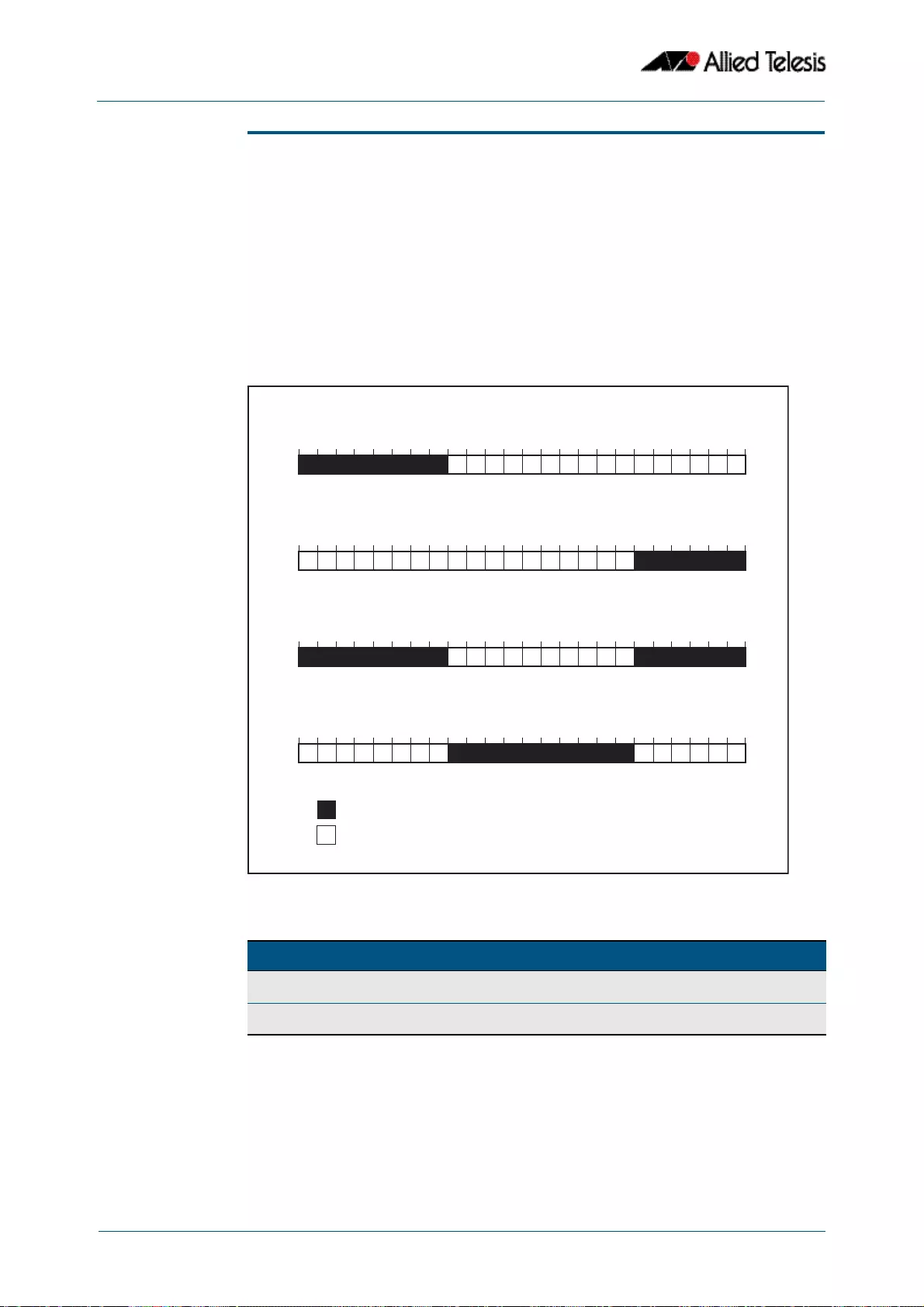
Trigger Commands
Software Reference for GS900MX/MPX Series Switches
76.16 AlliedWare PlusTM Operating System - Version 5.4.4E-1.x C613-50065-01 REV B
time (trigger)
This command specifies the time of day when the trigger is permitted to activate. The
after parameter specifies the start of a time period that extends to midnight during which
trigger may activate. By default the value of this parameter is 00:00:00 (am); that is, the
trigger may activate at any time. The before parameter specifies the end of a time period
beginning at midnight during which the trigger may activate. By default the value of this
parameter is 23:59:59; that is, the trigger may activate at any time. If the value specified for
before is later than the value specified for after, a time period from “after” to “before” is
defined, during which the trigger may activate. This command is not applicable to time
triggers (type time).
The following figure illustrates how the before and after parameters operate.
Syntax time {[after <hh:mm:ss>] [before <hh:mm:ss>]}
Mode Trigger Configuration
Usage For example trigger configurations that use the time (trigger) command, see “Restrict
Internet Access” on page 75.2 and “Turn Off Power to Port LEDs” on page 75.7.
00:00 06:00 12:00 18:00 00:00
00:00 06:00 12:00 18:00 00:00
00:00 06:00 12:00 18:00 00:00
00:00 06:00 12:00 18:00 00:00
BEFORE=08:00
AFTER=18:00
AFTER=18:00 BEFORE=08:00
AFTER=08:00 BEFORE=18:00
Period when trigger may activate.Key:
Period when trigger may not activate.
TRG_02
Parameter Description
after <hh:mm:ss>The earliest time of day when the trigger may be activated.
before <hh:mm:ss>The latest time of day when the trigger may be activated.

Trigger Commands
Software Reference for GS900MX/MPX Series Switches
C613-50065-01 REV B AlliedWare PlusTM Operating System - Version 5.4.4E-1.x 76.17
Examples To allow trigger 63 to activate between midnight and 10:30am, use the commands:
To allow trigger 64 to activate between 3:45pm and midnight, use the commands:
To allow trigger 65 to activate between 10:30am and 8:15pm, use the commands:
Related Commands show trigger
trigger
awplus# configure terminal
awplus(config)# trigger 63
awplus(config-trigger)# time before 10:30:00
awplus# configure terminal
awplus(config)# trigger 64
awplus(config-trigger)# time after 15:45:00
awplus# configure terminal
awplus(config)# trigger 65
awplus(config-trigger)# time after 10:30:00 before 20:15:00

Trigger Commands
Software Reference for GS900MX/MPX Series Switches
76.18 AlliedWare PlusTM Operating System - Version 5.4.4E-1.x C613-50065-01 REV B
trap
This command enables the specified trigger to send SNMP traps.
Use the no variant of this command to disable the sending of SNMP traps from the
specified trigger.
Syntax trap
no trap
Default SNMP traps are enabled by default for all defined triggers.
Mode Trigger Configuration
Usage You must configure SNMP before using traps with triggers. See the following SNMP
chapters:
Chapter 66, SNMP Introduction
Chapter 67, SNMP Commands
Chapter 68, SNMP MIBs
Since SNMP traps are enabled by default for all defined triggers, a common usage will be
for the no variant of this command to disable SNMP traps from a specified trap if the trap is
only periodic. Refer in particular to AT-TRIGGER-MIB for further information about the
relevant SNMP MIB.
Examples To enable SNMP traps to be sent from trigger 5, use the commands:
To disable SNMP traps being sent from trigger 205, use the commands:
Related Commands trigger
show trigger
awplus# configure terminal
awplus(config)# trigger 5
awplus(config-trigger)# trap
awplus# configure terminal
awplus(config)# trigger 205
awplus(config-trigger)# no trap

Trigger Commands
Software Reference for GS900MX/MPX Series Switches
C613-50065-01 REV B AlliedWare PlusTM Operating System - Version 5.4.4E-1.x 76.19
trigger
This command is used to access the Trigger Configuration mode for the specified trigger.
Once Trigger Configuration mode has been entered the trigger type information can be
configured and the trigger scripts and other operational parameters can be specified. At a
minimum the trigger type information must be specified before the trigger can become
active.
The no variant of this command removes a specified trigger and all configuration
associated with it.
Syntax trigger <1-250>
no trigger <1-250>
Mode Global Configuration
Examples To enter trigger configuration mode for trigger 12 use the command:
To completely remove all configuration associated with trigger 12, use the command:
Related Commands show trigger
trigger activate
Parameter Description
<1-250>A trigger ID.
awplus# trigger 12
awplus# no trigger 12

Trigger Commands
Software Reference for GS900MX/MPX Series Switches
76.20 AlliedWare PlusTM Operating System - Version 5.4.4E-1.x C613-50065-01 REV B
trigger activate
This command is used to manually activate a specified trigger from the Privileged Exec
mode, which has been configured with the trigger command from the Global
Configuration mode.
Syntax trigger activate <1-250>
Mode Privileged Exec
Usage This command manually activates a trigger without the normal trigger conditions being
met.
The trigger is activated even if it is configured as inactive. The scripts associated with the
trigger will be executed even if the trigger is in the diagnostic test mode.
Triggers activated manually do not have their repeat counts decremented or their 'last
triggered' time updated, and do not result in updates to the '[type] triggers today'
counters.
Example To manually activate trigger 12 use the command:
Related Commands show trigger
trigger
Parameter Description
<1-250>A trigger ID.
awplus# trigger activate 12
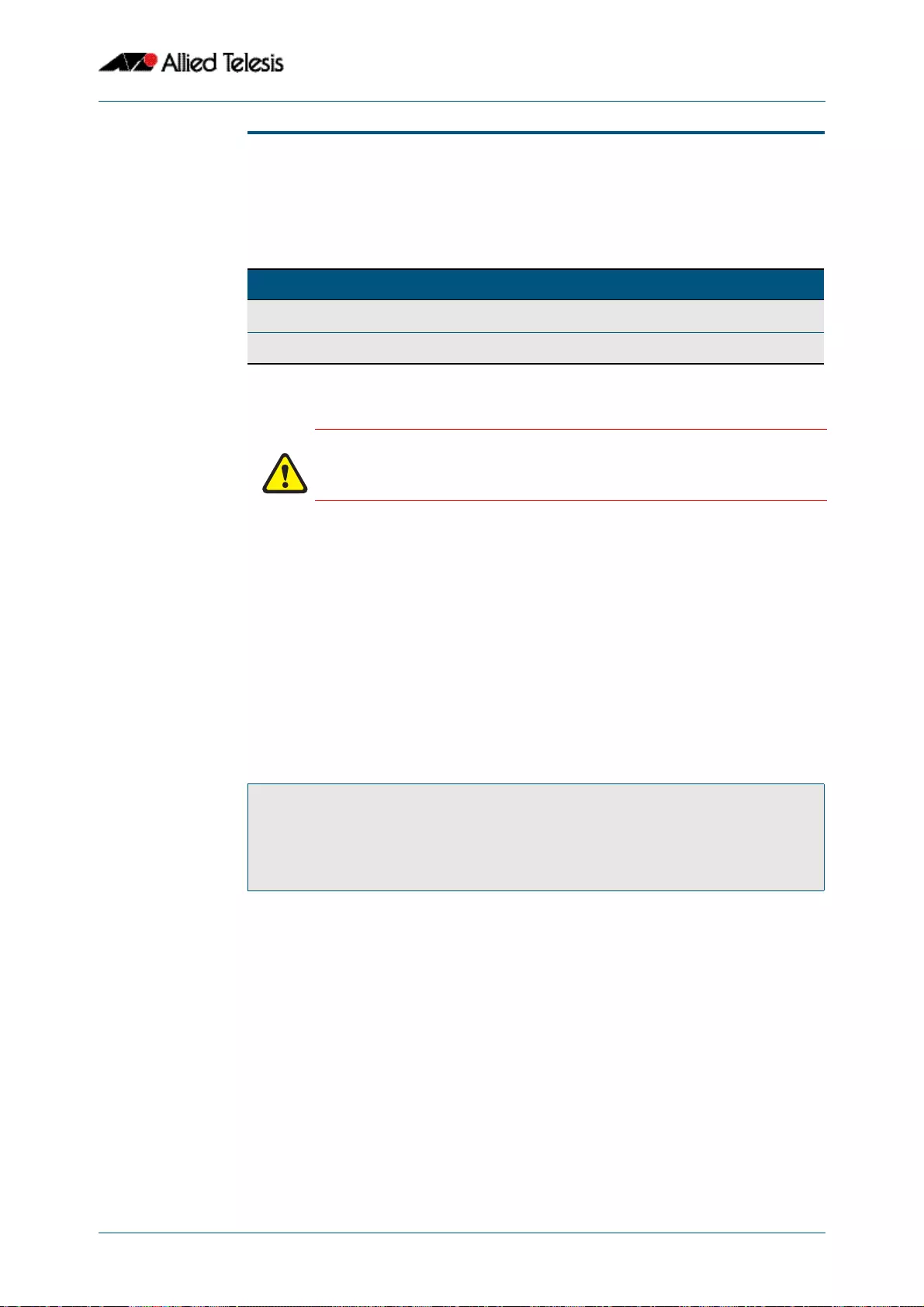
Trigger Commands
Software Reference for GS900MX/MPX Series Switches
C613-50065-01 REV B AlliedWare PlusTM Operating System - Version 5.4.4E-1.x 76.21
type atmf node
This command configures a trigger to be activated at an AMF node join event or leave
event.
Syntax type atmf node {join|leave}
Mode Trigger Configuration
Example 1 To configure trigger 5 to activate at an AMF node leave event, use the following
commands. In this example the command is entered on node-1:
Example 2 The following commands will configure trigger 5 to activate if an AMF node join event
occurs on any node within the working set:
This command returns the following display:
Note that the running the above command changes the prompt from the name of the
local node, to the name of the AMF-Network followed, in square brackets, by the number
of member nodes in the working set.
Parameter Description
join AMF node join event.
leave AMF node leave event.
Caution Only configure this trigger on one device because it is a network wide
event.
node1(config)# trigger 5
node1(config-trigger) type atmf node leave
node1# atmf working-set group all
====================
node1, node2, node3:
====================
Working set join
AMF-Net[3]# conf t
AMF-Net[3](config)# trigger 5
AMF-Net[3](config-trigger)# type atmf node leave
AMF-Net[3](config-trigger)# description “E-mail on AMF Exit”
AMF-Net[3](config-trigger)# active

Trigger Commands
Software Reference for GS900MX/MPX Series Switches
76.22 AlliedWare PlusTM Operating System - Version 5.4.4E-1.x C613-50065-01 REV B
Enter the name of the script to run at the trigger event.
Display the trigger configurations
This command returns the following display:
Display the triggers configured on each of the nodes in the AMF Network.
This command returns the following display:
Related Commands show trigger
AMF-Net[3](config-trigger)# script 1 email_me.scp
AMF-Net[3](config-trigger)# end
AMF-Net[3]# show trigger
=======
node1:
========
TR# Type & Details Description Ac Te Tr Repeat #Scr Days/Date
-------------------------------------------------------------------------------
001 Periodic (2 min) Periodic Status Chk Y N Y Continuous 1 smtwtfs
005 ATMF node (leave) E-mail on ATMF Exit Y N Y Continuous 1 smtwtfs
-------------------------------------------------------------------------------
==============
Node2, Node3,
==============
TR# Type & Details Description Ac Te Tr Repeat #Scr Days/Date
-------------------------------------------------------------------------------
005 ATMF node (leave) E-mail on ATMF Exit Y N Y Continuous 1 smtwtfs
-------------------------------------------------------------------------------
AMF-Net[3]# show running-config trigger
========
Node1:
========
trigger 1
type periodic 2
script 1 atmf.scp
trigger 5
type atmf node leave
description “E-mail on ATMF Exit”
script 1 email_me.scp
!
============
Node2, Node3:
============
trigger 5
type atmf node leave
description “E-mail on ATMF Exit”
script 1 email_me.scp
!

Trigger Commands
Software Reference for GS900MX/MPX Series Switches
C613-50065-01 REV B AlliedWare PlusTM Operating System - Version 5.4.4E-1.x 76.23
type cpu
This command configures a trigger to activate based on CPU usage level. Selecting the up
option causes the trigger to activate when the CPU usage exceeds the specified usage
level. Selecting the down option causes the trigger to activate when CPU usage drops
below the specified usage level. Selecting any causes the trigger to activate in both
situations. The default is any.
Syntax type cpu <1-100> [up|down|any]
Mode Trigger Configuration
Usage For an example trigger configuration that uses the type cpu command, see “Capture
Unusual CPU and RAM Activity” on page 75.4.
Examples To configure trigger 28 to be a CPU trigger that activates when CPU usage exceeds 80%
use the following commands:
To configure trigger 5 to be a CPU trigger that activates when CPU usage either rises
above or drops below 65%, use the following commands:
or
Related Commands show trigger
trigger
Parameter Description
<1-100>The percentage of CPU usage at which to trigger.
up Activate when CPU usage exceeds the specified level.
down Activate when CPU usage drops below the specified level
any Activate when CPU usage passes the specified level in either
direction
awplus# configure terminal
awplus(config)# trigger 28
awplus(config-trigger)# type cpu 80 up
awplus# configure terminal
awplus(config)# trigger 5
awplus(config-trigger)# type cpu 65
awplus# configure terminal
awplus(config)# trigger 5
awplus(config-trigger)# type cpu 65 any

Trigger Commands
Software Reference for GS900MX/MPX Series Switches
76.24 AlliedWare PlusTM Operating System - Version 5.4.4E-1.x C613-50065-01 REV B
type interface
This command configures a trigger to activate based on the link status of an interface. The
trigger can be activated when the interface becomes operational by using the up option,
or when the interface closes by using the down option. The trigger can also be configured
to activate when either one of these events occurs by using the any option.
Syntax type interface <interface> [up|down|any]
Mode Trigger Configuration
Example To configure trigger 19 to be an interface trigger that activates when port1.0.2
becomes operational, use the following commands:
Related Commands show trigger
trigger
Parameter Description
<interface>Interface name. This can be the name of a switch port, an
eth-management port, or a VLAN.
up Activate when interface becomes operational.
down Activate when the interface closes.
any Activate when any interface link status event occurs.
awplus# configure terminal
awplus(config)# trigger 19
awplus(config-trigger)# type interface port1.0.2 up

Trigger Commands
Software Reference for GS900MX/MPX Series Switches
C613-50065-01 REV B AlliedWare PlusTM Operating System - Version 5.4.4E-1.x 76.25
type memory
This command configures a trigger to activate based on RAM usage level. Selecting the up
option causes the trigger to activate when memory usage exceeds the specified level.
Selecting the down option causes the trigger to activate when memory usage drops
below the specified level. Selecting any causes the trigger to activate in both situations.
The default is any.
Syntax type memory <1-100> [up|down|any]
Mode Trigger Configuration
Examples To configure trigger 12 to be a memory trigger that activates when memory usage
exceeds 50% use the following commands:
To configure trigger 40 to be a memory trigger that activates when memory usage either
rises above or drops below 65%, use the following commands:
or
Related Commands show trigger
trigger
Parameter Description
<1-100>The percentage of memory usage at which to trigger.
up Activate when memory usage exceeds the specified level.
down Activate when memory usage drops below the specified level.
any Activate when memory usage passes the specified level in either
direction.
awplus# configure terminal
awplus(config)# trigger 12
awplus(config-trigger)# type memory 50 up
awplus# configure terminal
awplus(config)# trigger 40
awplus(config-trigger)# type memory 65
awplus# configure terminal
awplus(config)# trigger 40
awplus(config-trigger)# type memory 65 any

Trigger Commands
Software Reference for GS900MX/MPX Series Switches
76.26 AlliedWare PlusTM Operating System - Version 5.4.4E-1.x C613-50065-01 REV B
type periodic
This command configures a trigger to be activated at regular intervals. The time period
between activations is specified in minutes.
Syntax type periodic <1-1440>
Mode Trigger Configuration
Usage A combined limit of 10 triggers of the type periodic and time can be configured. If you
attempt to add more than 10 triggers the following error message is displayed:
For an example trigger configuration that uses the type periodic command, see “See
Daily Statistics” on page 75.6.
Example To configure trigger 44 to activate periodically at 10 minute intervals use the following
commands:
Related Commands show trigger
trigger
Parameter Description
<1-1440>The number of minutes between activations.
% Cannot configure more than 10 triggers with the type time or
periodic
awplus# configure terminal
awplus(config)# trigger 44
awplus(config-trigger)# type periodic 10

Trigger Commands
Software Reference for GS900MX/MPX Series Switches
C613-50065-01 REV B AlliedWare PlusTM Operating System - Version 5.4.4E-1.x 76.27
type ping-poll
This command configures a trigger that activates when Ping Polling identifies that a target
device’s status has changed. This allows you to run a configuration script when a device
becomes reachable or unreachable.
Syntax type ping-poll <1-100> {up|down}
Mode Trigger Configuration
Example To configure trigger 106 to activate when ping poll 12 detects that its target device is
now unreachable, use the following commands:
Related Commands show trigger
trigger
type reboot
This command configures a trigger that activates when your device is rebooted.
Syntax type reboot
Mode Trigger Configuration
Example To configure trigger 32 to activate when your device reboots, use the following
commands:
Related Commands show trigger
trigger
Parameter Description
<1-100>The ping poll ID.
up The trigger activates when ping polling detects that the target is
reachable.
down The trigger activates when ping polling detects that the target is
unreachable.
awplus# configure terminal
awplus(config)# trigger 106
awplus(config-trigger)# type ping-poll 12 down
awplus# configure terminal
awplus(config)# trigger 32
awplus(config-trigger)# type reboot

Trigger Commands
Software Reference for GS900MX/MPX Series Switches
76.28 AlliedWare PlusTM Operating System - Version 5.4.4E-1.x C613-50065-01 REV B
type stack disabled-master
This command (configured to the stack) configures a trigger to activate on a stack
member if it becomes the disabled master.
A disabled master has the same configuration as the active master, but has all its links
shutdown.
Although this command could activate any trigger script, the intention here is that the
script will reactivate the links from their previously shutdown state, to enable the user to
manage the switch. An appropriate trigger script must already exist that will apply the no
shutdown command on page 12.15 on the deactivated links.
If the stack virtual-mac command on page 82.25 command is enabled, the stack uses a
virtual MAC address. The stack will always use this MAC address and the new elected
master will still retain the originally configured virtual MAC address. If the stack virtual-
mac command is disabled, the stack will use the MAC address of the current master. If the
stack master fails, the stack MAC address changes to reflect the new master's MAC
address. See “Fixed or Virtual MAC Addressing” on page 81.13 for information on
virtual MAC addresses.
Syntax type stack disabled-master
Mode Trigger Configuration
Examples To configure trigger 82 to activate on a device if it becomes the disabled master, use the
commands:
Related Commands stack disabled-master-monitoring
trigger
type stack master-fail
type stack member
type stack link
Caution It is important that any ports that are configured as trunked ports across
master and stack members are disabled at their stack member termination
when operating in the fallback configuration. Otherwise, the trunked ports
will not function correctly on the switch that is connected downstream.
awplus#
configure terminal Enter the Global Configuration mode
awplus(config)#
trigger 82 Enter the Trigger Configuration mode for
trigger 82
awplus(config-trigger)#
type stack disabled master Sets the type of trigger
awplus(config-trigger)#
script 1 flash:/disabled.scp
awplus(config-trigger)#
exit

Trigger Commands
Software Reference for GS900MX/MPX Series Switches
C613-50065-01 REV B AlliedWare PlusTM Operating System - Version 5.4.4E-1.x 76.29
type stack link
This command (configured to the stack) initiates the action of a pre-configured trigger to
occur when a stacking link is either activated or deactivated.
Syntax type stack link {up|down}
Mode Trigger Configuration
Example To configure trigger 86 to activate when the stack link down event occurs, use the
commands:
Related Commands show trigger
trigger
type stack master-fail
Parameter Description
up Stack link up event
down Stack link down event
awplus# configure terminal
awplus(config)# trigger 86
awplus(config-trigger)# type stack link down

Trigger Commands
Software Reference for GS900MX/MPX Series Switches
76.30 AlliedWare PlusTM Operating System - Version 5.4.4E-1.x C613-50065-01 REV B
type stack master-fail
This command (configured to the stack) initiates the action of a pre-configured trigger to
occur when the stack enters the fail-over state.
Syntax type stack master-fail
Mode Trigger Configuration
Example To configure trigger 86 to activate when stack master fail-over event occurs, use the
commands:
Related Commands stack disabled-master-monitoring
trigger
type stack disabled-master
type stack member
type stack link
awplus# configure terminal
awplus(config)# trigger 86
awplus(config-trigger)# type stack master-fail

Trigger Commands
Software Reference for GS900MX/MPX Series Switches
C613-50065-01 REV B AlliedWare PlusTM Operating System - Version 5.4.4E-1.x 76.31
type stack member
This command (configured to the stack) initiates the action of a pre-configured trigger to
occur when a switch either joins or leaves the stack.
Syntax type stack member {join|leave}
Mode Trigger Configuration
Example To configure a pre-configured trigger number 86 to activate when a new switch joins the
stack.
Note that the number 86 has no particular significance: you can assign any (previously
created) numbered trigger.
:
Related Commands trigger
type stack master-fail
type stack link
Parameter Description
join Neighbor join event
leave Neighbor leave event
awplus# configure terminal
awplus(config)# trigger 86
awplus(config-trigger)# type stack member join

Trigger Commands
Software Reference for GS900MX/MPX Series Switches
76.32 AlliedWare PlusTM Operating System - Version 5.4.4E-1.x C613-50065-01 REV B
type time
This command configures a trigger that activates at a specified time of day.
Syntax type time <hh:mm>
Mode Trigger Configuration
Usage A combined limit of 10 triggers of the type time and type periodic can be configured. If
you attempt to add more than 10 triggers the following error message is displayed:
Example To configure trigger 86 to activate at 15:53, use the following commands:
Related Commands show trigger
trigger
Parameter Description
<hh:mm>The time to activate the trigger.
% Cannot configure more than 10 triggers with the type time or
periodic
awplus# configure terminal
awplus(config)# trigger 86
awplus(config-trigger)# type time 15:53

Trigger Commands
Software Reference for GS900MX/MPX Series Switches
C613-50065-01 REV B AlliedWare PlusTM Operating System - Version 5.4.4E-1.x 76.33
type usb
Use this command to configure a trigger that activates on either the removal or the
insertion of a USB storage device.
Syntax type usb {in|out}
Mode Trigger Configuration
Usage USB triggers cannot execute script files from a USB storage device.
For example trigger configurations that use the type usb command, see “Capture Show
Output and Save to a USB Storage Device” on page 75.11.
Examples To configure trigger 1 to activate on the insertion of a USB storage device, use the
commands:
Related Commands trigger
show running-config trigger
show trigger
undebug trigger
This command applies the functionality of the no debug trigger command.
Parameter Description
in Trigger activates on insertion of a USB storage device.
out Trigger activates on removal of a USB storage device.
awplus# configure terminal
awplus(config)# trigger 1
awplus(config-trigger)# type usb in

Trigger Commands
Software Reference for GS900MX/MPX Series Switches
76.34 AlliedWare PlusTM Operating System - Version 5.4.4E-1.x C613-50065-01 REV B

Software Reference for GS900MX/MPX Series Switches
C613-50065-01 REV B AlliedWare PlusTM Operating System - Version 5.4.4E-1.x 77.1
Chapter 77: Cable Fault Locator Introduction
Introduction to the Cable Fault Locator ................................................................................... 77.2
Capabilities................................................................................................................................... 77.2
TDR Operating Principles........................................................................................................77.2
Using the Cable Fault Locator ...................................................................................................... 77.3

Cable Fault Locator Introduction
Software Reference for GS900MX/MPX Series Switches
77.2 AlliedWare PlusTM Operating System - Version 5.4.4E-1.x C613-50065-01 REV B
Introduction to the Cable Fault Locator
The Cable Fault Locator (CFL) is a cable diagnostic tool located within the switch. For a
selected port, the CFL will display connection status or faults that exist in either the
connecting cable itself, or its terminations.
Capabilities
The CFL is designed to operate on cable systems that utilize the following:
■fixed copper ports, i.e. not using SFP type pluggable transceivers.
■unshielded twisted pair data cables such as CAT 5 or CAT 6 and up to 100 meters
long.
■cable terminations that use RJ-45 or RJ-0.5 connections.
■data rates from 10 Mbps to 1 Gbps (10 Gbps over copper cable is not supported).
The CFL operates using a technology known as Time Domain Reflectometry (TDR) to test
all four pairs of wires inside the cable.
Note that CFL cannot run on a port that is currently supplying power via PoE.
TDR Operating Principles
When a data cable is correctly terminated, the data energy traveling along it is absorbed
by its terminating load resistance. However, if the cable is unplugged, broken or short
circuited, this energy is reflected at the cable termination and travels back along the
cable towards its source connection.
To test the cable, the CFL generates a pulse at the cable source connection and monitors
the cable for the presence of a returning (reflected) pulse. By measuring the timing
between the transmitted and reflected pulses, the CFL can calculate the distance
between a fault (usually at the distant termination) and cable’s source connection. Also,
by detecting the polarity of the reflected signal, the CFL can determine whether the fault
is due to an open circuit, or a short circuit, condition.

Cable Fault Locator Introduction
Software Reference for GS900MX/MPX Series Switches
C613-50065-01 REV B AlliedWare PlusTM Operating System - Version 5.4.4E-1.x 77.3
Using the Cable Fault Locator
To run a CFL diagnostics test, use the command, “test cable-diagnostics tdr interface”
on page 78.4. This will return a prompt asking you to confirm whether or not you want
to continue with the test. This confirmation prompt is generated because the link is
unable to carry data during the test, typically taking between 1 and 2 seconds to
complete.
Example To run a CFL test on the cable inserted into port 1.0.1 use the following command:
Once the cable test has run you can display its results by running the show test cable-
diagnostics tdr command on page 78.3.
Output Figure 77-1: Example output from the show test cable-diagnostics tdr command
From the monitoring tests described, the CFL presents cable termination status
information as shown, together with explanations, in Table 77-1.
Table 77-1: Cable status table
awplus# test cable-diagnostics tdr interface
port1.0.1
This command returns the following message:
Link will go down while test is in progress. Continue? (y/n):
Select y to continue.
awplus# y
Answering y returns the following message:
Test started. This will take several seconds to complete. Use
"show test cable-diagnostics tdr" to print results.
Port Pair Length Status
------------------------------------------
1.0.1 A - OK
B - OK
C 5 +/- 5 m Open
Status Definition
OK The pair is good and is terminated.
Open The pair is not terminated.
Short (within-pair) There is a short between the two wires of the
pair.
Short (cross-pair) There is a short between wires of different pairs.
Error The test was unable to get a result. This error
condition may occur when connecting to
remote devices that issue idle traffic data when
operating in the 10/100 M mode.

Cable Fault Locator Introduction
Software Reference for GS900MX/MPX Series Switches
77.4 AlliedWare PlusTM Operating System - Version 5.4.4E-1.x C613-50065-01 REV B

Software Reference for GS900MX/MPX Series Switches
C613-50065-01 REV B AlliedWare PlusTM Operating System - Version 5.4.4E-1.x 78.1
Chapter 78: Cable Fault Locator Commands
Command List .................................................................................................................................... 78.2
clear test cable-diagnostics tdr .................................................................................................... 78.2
show test cable-diagnostics tdr................................................................................................... 78.3
test cable-diagnostics tdr interface............................................................................................78.4

Cable Fault Locator Commands
Software Reference for GS900MX/MPX Series Switches
78.2 AlliedWare PlusTM Operating System - Version 5.4.4E-1.x C613-50065-01 REV B
Command List
This chapter provides an alphabetical reference of commands used to test copper cables.
For more information, see Cable Tester Introduction.
clear test cable-diagnostics tdr
This command clears the results of the last cable test that was run.
Syntax clear test cable-diagnostics tdr
Mode Privileged Exec
Examples To clear the results of a previous cable-diagnostics test use the following commands:
awplus# clear test cable-diagnostics tdr

Cable Fault Locator Commands
Software Reference for GS900MX/MPX Series Switches
C613-50065-01 REV B AlliedWare PlusTM Operating System - Version 5.4.4E-1.x 78.3
show test cable-diagnostics tdr
This command displays the results of the last cable-diagnostics test that was run using the
TDR (Time Domain Reflectometry) on a fixed copper cable port.
The displayed status of the cable can be either:
■OK
■Open
■Short (within-pair)
■Short (across-pair)
■Error
Syntax show test cable-diagnostics tdr
no enable
Mode Privileged Exec
Examples To show the results of a cable-diagnostics test use the following command:
Output Figure 78-1: Example output from the show test cable-diagnostics tdr command
awplus# show test cable-diagnostics tdr
Port Pair Length Status
------------------------------------------
1.0.1 A - OK
B - OK
C 5 +/- 5 m Open

Cable Fault Locator Commands
Software Reference for GS900MX/MPX Series Switches
78.4 AlliedWare PlusTM Operating System - Version 5.4.4E-1.x C613-50065-01 REV B
test cable-diagnostics tdr interface
This command applies the Cable Fault Locator’s cable-diagnostics tests to twisted pair
data cables for a selected port. The tests will detect either correct, short circuit, or open,
circuit terminations. For more information on running the CFL, see the Cable Fault
Locator Introduction chapter.
The test can take several seconds to complete. See the related show command to display
the test results.
A new test can only be started if no other test is in progress. CFL cannot run on a port that
is currently supplying power via PoE.
The displayed status of the cable can be either, OK, Short (within-pair), or Open. The
“Open” or “Short” status is accompanied with the distance from the source port to the
incorrect termination.
Syntax test cable-diagnostics tdr interface <interface>
Example To run a cable test on the cable inserted into port 1.0.1 use the following command:
Parameter Description
cable-diagnostics The cable diagnostic tests.
tdr Time Domain Reflectometry.
interface Selects the interface to test.
<interface> Interface number of the port to be tested, i.e. 1.0.2.
awplus# test cable-diagnostics tdr interface
port1.0.1
You will receive the following message:
Link will go down while test is in progress. Continue? (y/n):
y Select y to continue.
awplus# y
You will then receive the following message:
Test started. This will take several seconds to complete. Use
"show test cable-diagnostics tdr" to print results.

Software Reference for GS900MX/MPX Series Switches
C613-50065-01 REV B AlliedWare PlusTM Operating System - Version 5.4.4E-1.x 79.1
Chapter 79: Ping Polling Introduction and
Configuration
Introduction ........................................................................................................................................ 79.2
How Ping Polling Works ................................................................................................................. 79.2
Configuring Ping Polling ................................................................................................................ 79.4
Creating a Polling Instance.....................................................................................................79.4
Customizing a Polling Instance ............................................................................................ 79.5
Troubleshooting Ping Polling ............................................................................................... 79.6
Interaction with Other Protocols................................................................................................. 79.7

Ping Polling Introduction and Configuration
Software Reference for GS900MX/MPX Series Switches
79.2 AlliedWare PlusTM Operating System - Version 5.4.4E-1.x C613-50065-01 REV B
Introduction
Ping polling lets your device regularly check whether it can reach other hosts on a
network. It works by sending ICMP Echo Requests to a host and waiting for replies sent
back. If ping polling indicates that a host’s status has changed, then your device can
respond to the new status. When a host is unreachable, ping polling continues monitoring
the host’s reachability.
You can configure triggers to activate when ping polling determines that the host’s status
has changed. For example, you could configure a trigger to run a script that opens and
configures an alternative link if the host at the other end of a preferred link becomes
unavailable. You could then configure a second trigger to run a script that automatically
returns traffic to the preferred link as soon as it is available again.
How Ping Polling Works
To determine a host’s reachability, your device regularly sends ICMP Echo Request packets
(“pings”) to the host. As long as your device receives ping responses from the host, it
considers the host to be reachable. If your device does not receive a reply to a set number
of ICMP Echo Requests, it considers that the host is unreachable. It continues to try to ping
the device, at an increased rate. After it receives a set number of responses, it considers the
device to be reachable again.
By default, a polling instance sends a ping every 30 seconds as long as it is receiving
replies. The frequency of this polling is controlled by the normal-interval command. When
a reply is not received, the polling instance increases the frequency at which it polls the
device. This frequency is controlled by the critical-interval command, and by default, is set
to send a packet every one second. It maintains this higher rate of polling until it has
received sufficient consecutive replies.
The polling instance determines whether a device is reachable or unreachable based on
the settings of the fail-count, sample-size, and up-count commands. To determine
whether a device is reachable, the polling instance counts the number of failed pings
within a set sample size. The sample size is set by the sample-size command, and by
default is 5 ping responses. Within the sample size, the number of failed pings that means
that the device is down is set by the fail-count command. By default this is set to 5. Once a
polling instance has determined that a device is unreachable, it must receive a set number
of consecutive replies before it changes the device’s status back to reachable. This number
is configured with the up-count command.
The following figure illustrates a polling instance where the device becomes unreachable,
then reachable. It uses this configuration:
awplus(config-ping-poll)# fail-count 4
awplus(config-ping-poll)# sample-size 5
awplus(config-ping-poll)# up-count 3
awplus(config-ping-poll)# critical-interval 1
awplus(config-ping-poll)# normal-interval 30

Ping Polling Introduction and Configuration
Software Reference for GS900MX/MPX Series Switches
C613-50065-01 REV B AlliedWare PlusTM Operating System - Version 5.4.4E-1.x 79.3
Figure 79-1: Interaction between states and parameters for ping polling
On some operating systems, some servers may respond to a ping even if no other
functionality is available, and therefore remain in an Up state while malfunctioning.
Responding to
status changes
To configuring your device to determine and respond to changes in a device’s reachability,
you will need to:
■create a polling instance to periodically ping the device
■create scripts to run when the device becomes unreachable and when it becomes
reachable again
■configure triggers to run these scripts
To set a trigger to activate when a device’s status changes, its trigger type must be ping-
poll. This is with the following command in the trigger’s configuration mode:
where up activates the trigger when the device is reachable, and down activates the
trigger when the device is unreachable.
If you use triggers to open a backup link to a remote device in the event of the primary link
failing (rather than the remote device failing), the backup link and primary link must point
to different IP addresses on the remote device. Otherwise, when the backup link points to
the IP address that your device is polling, your device receives ping replies through the
backup link, considers the device to be reachable again, and attempts to reopen the
primary link instead of using the backup link. See Chapter 74, Triggers Introduction for
more information about configuring Triggers with Ping Polling.
ping_02
Time
00:00:33
00:01:03
00:01:33
00:02:03
00:02:33
00:02:34
00:02:35
00:02:36
00:01:35
00:01:36
.
.
00:02:48
00:02:49
00:02:50
00:03:20
00:03:50
success
success
success
success
fail
success
fail
fail
fail
fail
.
.
success
success
success
success
success
Ping polling returns
to normal-interval rate
}
The device fails to
respond to 3 out of
4 polls (fail-count=3,
sample-size=4)
------ device determined unreachable ------
Polling continues at the
critical-interval rate
Polling Result
------ device determined reachable ------
}
The device responds to
3 consequtive pings
(up-count=3)
When polling first starts
it assumes the device is
down and uses the
critical-interval rate
00:00:01
00:00:02
00:00:03
success
success
success
}
Polling waits for the
device to respond to
3 consequtive pings
(up-count=3)
------ device determined reachable ------
Ping polling begins
polling at the
normal-interval rate
Begins polling at the
critical-interval rate
..
awplus(config-trigger)# type ping-poll <1-100> {up|down}

Ping Polling Introduction and Configuration
Software Reference for GS900MX/MPX Series Switches
79.4 AlliedWare PlusTM Operating System - Version 5.4.4E-1.x C613-50065-01 REV B
Configuring Ping Polling
This section contains:
■Creating a Polling Instance
This explains how to quickly create a polling instance using the ping polling defaults.
■Customizing a Polling Instance
This explains how to customize a ping poll and explains the other ping poll
commands.
■Troubleshooting Ping Polling
This explains how to use the debugging and monitoring commands for ping polling.
Creating a Polling Instance
The Ping Polling feature in the AlliedWare PlusTM OS allows you to easily configure polling
instances with a minimum of commands. To configure a ping poll suitable for most
network situations:
1. Create a polling instance by using the command:
The range <1-100> identifies the polling instance in the trigger commands and in
other ping poll commands. Your device can poll up to 100 IP addresses at once.
2. Set the IP address of the device you are polling by using the command:
3. Enable the polling instance by using the command:
4. If desired, set an optional description to identify the polling instance, by using the
command:
You do not need to configure any other commands for most networks, because
convenient defaults exist for all other ping poll settings. The following table summarizes
the default configuration created.
awplus(config)# ping-poll <1-100>
awplus(config-ping-poll)# ip {<ip-address>|<ipv6-address>}
awplus(config-ping-poll)# active
awplus(config-ping-poll)# description <description>
Command Default
Critical-interval 1 second
Fail-count 5
Length 32 bytes
Normal-interval 30 seconds

Ping Polling Introduction and Configuration
Software Reference for GS900MX/MPX Series Switches
C613-50065-01 REV B AlliedWare PlusTM Operating System - Version 5.4.4E-1.x 79.5
Customizing a Polling Instance
Once you’ve created a polling instance using the ping-poll and ip (ping-polling)
command, you may wish to customize the polling instance for your network.
Packet size If you find that larger packet types in your network are not reaching the polled device
while smaller ones such as ping do, you can increase the data bytes included in the ping
packets sent by the polling instance. This encourages the polling instance to change the
device’s status to unreachable when packet of the size you are interested in are being
dropped. To change the number of bytes sent in the data portion of the ping packets, use
the command:
Response timeout The polling instance determines that a device hasn’t responded to a ping if one second
elapses without a response to the ping. In networks where ping packets have a low
priority, you may need to set the allowed response time to a longer time period. To change
this, use the command:
Polling frequency By default, a polling instance polls a reachable device every 30 seconds. You can change
this by using the command:
Once the polling instance has determined that a ping has failed, it starts polling the device
at the frequency set as the critical interval—by default, one second. To change the
frequency set by the critical interval, use the command:
The critical interval enables the polling instance to quickly observe changes in the state of
the device, and should be set to a much lower value than the normal interval.
Configuring when
the device’s status
changes
The number of pings that the polling instance examines to consider a change in state is
controlled by the interaction of the sample-size, fail-count, and up-count commands. See
“How Ping Polling Works” on page 79.2 for an example showing this interaction.
Sample-size 5
Source-ip The IP address of the interface from which the ping packets are
transmitted
Time-out 1 second
Up-count 30
Command(cont.) Default(cont.)
awplus(config-ping-poll)# length <4-1500>
awplus(config-ping-poll)# timeout <1-30>
awplus(config-ping-poll)# normal-interval <1-65536>
awplus(config-ping-poll)# critical-interval <1-65536>

Ping Polling Introduction and Configuration
Software Reference for GS900MX/MPX Series Switches
79.6 AlliedWare PlusTM Operating System - Version 5.4.4E-1.x C613-50065-01 REV B
To determine whether a device is reachable, the polling instance counts the number of
failed pings within a sample of a set size. The sample size is 5 pings by default. To change
the sample size, use the command:
To change the number of failed pings that the sample must have, use the command:
If the sample size and fail count are the same, the unanswered pings must be consecutive.
If the sample size is greater than the fail count, a device that does not always reply to pings
may be declared unreachable.
The upcount is the number of consecutive pings that must be answered for the polling
instance to consider the device reachable again. To change this from the default of 30, use
the command:
Checking the
configuration
To check the settings and status of the polling instance, use the command:
Troubleshooting Ping Polling
To disable a polling instance, use the command:
The polling instance no longer sends ICMP echo requests to the polled device and the
counters for this polling instance are reset.
To clear the counters and change the status of a device to unreachable, enter the
Privileged Exec mode and use the command:
The polling instance changes to the polling frequency specified with the critical-interval
command. The device status changes to reachable once the device responses have
reached the up-count.
To start debugging for ping polling, use the command:
awplus(config-ping-poll)# sample-size <1-100>
awplus(config-ping-poll)# fail-count <1-100>
awplus(config-ping-poll)# up-count <1-100>
awplus(config-ping-poll)# show ping-poll [<1-100>|state {up|
down}] [brief]
awplus(config-ping-poll)# no active
awplus# clear ping-poll {<1-100>|all}
awplus# debug ping-poll <1-100>

Ping Polling Introduction and Configuration
Software Reference for GS900MX/MPX Series Switches
C613-50065-01 REV B AlliedWare PlusTM Operating System - Version 5.4.4E-1.x 79.7
Interaction with Other Protocols
Ping polling does not work if the polled host, your device, or any intermediate routers or
switches are configured to drop ICMP Echo Requests and Replies.
Ping and
Traceroute
Ping and Traceroute are not affected by ping polling. You can enter ping and trace
commands at any time and independent of the polling.

Ping Polling Introduction and Configuration
Software Reference for GS900MX/MPX Series Switches
79.8 AlliedWare PlusTM Operating System - Version 5.4.4E-1.x C613-50065-01 REV B

Software Reference for GS900MX/MPX Series Switches
C613-50065-01 REV B AlliedWare PlusTM Operating System - Version 5.4.4E-1.x 80.1
Chapter 80: Ping-Polling Commands
Command List .................................................................................................................................... 80.2
active (ping-polling)......................................................................................................................... 80.3
clear ping-poll .................................................................................................................................... 80.4
critical-interval.................................................................................................................................... 80.5
debug ping-poll................................................................................................................................. 80.6
description (ping-polling) .............................................................................................................. 80.7
fail-count .............................................................................................................................................. 80.8
ip (ping-polling)................................................................................................................................. 80.9
length (ping-poll data) ..................................................................................................................80.10
normal-interval ................................................................................................................................80.11
ping-poll .............................................................................................................................................80.12
sample-size........................................................................................................................................80.13
show counter ping-poll ................................................................................................................80.14
show ping-poll .................................................................................................................................80.16
source-ip.............................................................................................................................................80.20
timeout (ping polling) ...................................................................................................................80.21
up-count.............................................................................................................................................80.22
undebug ping-poll .........................................................................................................................80.22

Ping-Polling Commands
Software Reference for GS900MX/MPX Series Switches
80.2 AlliedWare PlusTM Operating System - Version 5.4.4E-1.x C613-50065-01 REV B
Command List
This chapter provides an alphabetical reference for commands used to configure Ping
Polling. For more information, see Chapter 79, Ping Polling Introduction and
Configuration.
For information about modifying or redirecting the output from show commands to a file,
see “Controlling “show” Command Output” on page 1.35.
Table 80-1: The following table lists the default values when configuring a ping poll
Default Value
Critical-interval 1 second
Description No description
Fail-count 5
Length 32 bytes
Normal-interval 30 seconds
Sample-size 5
Source-ip The IP address of the interface from which the ping packets are
transmitted
Time-out 1 second
Up-count 30

Ping-Polling Commands
Software Reference for GS900MX/MPX Series Switches
C613-50065-01 REV B AlliedWare PlusTM Operating System - Version 5.4.4E-1.x 80.3
active (ping-polling)
This command enables a ping-poll instance. The polling instance sends ICMP echo
requests to the device with the IP address specified by the ip (ping-polling) command.
By default, polling instances are disabled. When a polling instance is enabled, it assumes
that the device it is polling is unreachable.
The no variant of this command disables a ping-poll instance. The polling instance no
longer sends ICMP echo requests to the polled device. This also resets all counters for this
polling instance.
Syntax active
no active
Mode Ping-Polling Configuration
Examples To activate the ping-poll instance 43, use the commands:
To disable the ping-poll instance 43 and reset its counters, use the commands:
Related Commands debug ping-poll
ip (ping-polling)
ping-poll
show ping-poll
awplus# configure terminal
awplus(config)# ping-poll 43
awplus(config-ping-poll)# active
awplus# configure terminal
awplus(config)# ping-poll 43
awplus(config-ping-poll)# no active

Ping-Polling Commands
Software Reference for GS900MX/MPX Series Switches
80.4 AlliedWare PlusTM Operating System - Version 5.4.4E-1.x C613-50065-01 REV B
clear ping-poll
This command resets the specified ping poll, or all ping poll instances. This clears the ping
counters, and changes the status of polled devices to unreachable. The polling instance
changes to the polling frequency specified with the critical-interval command. The
device status changes to reachable once the device responses have reached the up-
count.
Syntax clear ping-poll {<1-100>|all}
Mode Privileged Exec
Examples To reset the ping poll instance 12, use the command:
To reset all ping poll instances, use the command:
Related Commands active (ping-polling)
ping-poll
show ping-poll
Parameter Description
<1-100>A ping poll ID number. The specified ping poll instance has its
counters cleared, and the status of the device it polls is
changed to unreachable.
all Clears the counters and changes the device status of all polling
instances.
awplus# clear ping-poll 12
awplus# clear ping-poll all

Ping-Polling Commands
Software Reference for GS900MX/MPX Series Switches
C613-50065-01 REV B AlliedWare PlusTM Operating System - Version 5.4.4E-1.x 80.5
critical-interval
This command specifies the time period in seconds between pings when the polling
instance has not received a reply to at least one ping, and when the device is unreachable.
This command enables the device to quickly observe changes in state, and should be set
to a much lower value than the normal-interval command.
The no variant of this command sets the critical interval to the default of one second.
Syntax critical-interval <1-65536>
no critical-interval
Default The default is 1 second.
Mode Ping-Polling Configuration
Examples To set the critical interval to 2 seconds for the ping-polling instance 99, use the
commands:
To reset the critical interval to the default of one second for the ping-polling instance 99,
use the commands:
Related Commands fail-count
normal-interval
sample-size
show ping-poll
timeout (ping polling)
up-count
Parameter Description
<1-65536>Time in seconds between pings, when the device has failed to
a ping, or the device is unreachable.
awplus# configure terminal
awplus(config)# ping-poll 99
awplus(config-ping-poll)# critical-interval 2
awplus# configure terminal
awplus(config)# ping-poll 99
awplus(config-ping-poll)# no critical-interval

Ping-Polling Commands
Software Reference for GS900MX/MPX Series Switches
80.6 AlliedWare PlusTM Operating System - Version 5.4.4E-1.x C613-50065-01 REV B
debug ping-poll
This command enables ping poll debugging for the specified ping-poll instance. This
generates detailed messages about ping execution.
The no variant of this command disables ping-poll debugging for the specified ping-poll.
Syntax debug ping-poll <1-100>
no debug ping-poll {<1-100>|all}
Mode Privileged Exec
Examples To enable debugging for ping-poll instance 88, use the command:
To disable all ping poll debugging, use the command:
To disable debugging for ping-poll instance 88, use the command:
Related Commands active (ping-polling)
clear ping-poll
ping-poll
show ping-poll
undebug ping-poll
Parameter Description
<1-100> A unique ping poll ID number.
all Turn off all ping-poll debugging.
awplus# debug ping-poll 88
awplus# no debug ping-poll all
awplus# no debug ping-poll 88

Ping-Polling Commands
Software Reference for GS900MX/MPX Series Switches
C613-50065-01 REV B AlliedWare PlusTM Operating System - Version 5.4.4E-1.x 80.7
description (ping-polling)
This command specifies a string to describe the ping-polling instance. This allows the
ping-polling instance to be recognized easily in show commands. Setting this command is
optional.
By default ping-poll instances do not have a description.
Use the no variant of this command to delete the description set.
Syntax description <description>
no description
Mode Ping-Polling Configuration
Examples To add the text “Primary Gateway” to describe the ping-poll instance 45, use the
commands:
To delete the description set for the ping-poll instance 45, use the commands:
Related Commands ping-poll
show ping-poll
Parameter Description
<description> The description of the target. Valid characters are any printable
character and spaces. There is no maximum character length.
awplus# configure terminal
awplus(config)# ping-poll 45
awplus(config-ping-poll)# description Primary Gateway
awplus# configure terminal
awplus(config)# ping-poll 45
awplus(config-ping-poll)# no description

Ping-Polling Commands
Software Reference for GS900MX/MPX Series Switches
80.8 AlliedWare PlusTM Operating System - Version 5.4.4E-1.x C613-50065-01 REV B
fail-count
This command specifies the number of pings that must be unanswered, within the total
number of pings specified by the sample-size command, for the ping-polling instance to
consider the device unreachable.
If the number set by the sample-size command and the fail-count commands are the
same, then the unanswered pings must be consecutive. If the number set by the sample-
size command is greater than the number set by the fail-count command, then a device
that does not always reply to pings may be declared unreachable.
The no variant of this command resets the fail count to the default.
Syntax fail-count <1-100>
no fail-count
Default The default is 5.
Mode Ping-Polling Configuration
Examples To specify the number of pings that must fail within the sample size to determine that a
device is unreachable for ping-polling instance 45, use the commands:
To reset the fail-count to its default of 5 for ping-polling instance 45, use the commands:
Related Commands critical-interval
normal-interval
ping-poll
sample-size
show ping-poll
timeout (ping polling)
up-count
Parameter Description
<1-100>The number of pings within the sample size that a reachable device
must fail to respond to before it is classified as unreachable.
awplus# configure terminal
awplus(config)# ping-poll 45
awplus(config-ping-poll)# fail-count 5
awplus# configure terminal
awplus(config)# ping-poll 45
awplus(config-ping-poll)# no fail-count

Ping-Polling Commands
Software Reference for GS900MX/MPX Series Switches
C613-50065-01 REV B AlliedWare PlusTM Operating System - Version 5.4.4E-1.x 80.9
ip (ping-polling)
This command specifies the IPv4 address of the device you are polling.
Syntax ip {<ip-address>|<ipv6-address>}
Mode Ping-Polling Configuration
Examples To set ping-poll instance 5 to poll the device with the IP address 192.168.0.1, use the
commands:
To set ping-poll instance 10 to poll the device with the IPv6 address 2001:db8::, use
the commands:
Related Commands ping-poll
source-ip
show ping-poll
Parameter Description
<ip-address>An IPv4 address in dotted decimal notation A.B.C.D
<ipv6-address> An IPv6 address in hexadecimal notation X:X::X:X
awplus# configure terminal
awplus(config)# ping-poll 5
awplus(config-ping-poll)# ip 192.168.0.1
awplus# configure terminal
awplus(config)# ping-poll 10
awplus(config-ping-poll)# ip 2001:db8::

Ping-Polling Commands
Software Reference for GS900MX/MPX Series Switches
80.10 AlliedWare PlusTM Operating System - Version 5.4.4E-1.x C613-50065-01 REV B
length (ping-poll data)
This command specifies the number of data bytes to include in the data portion of the
ping packet. This allows you to set the ping packets to a larger size if you find that larger
packet types in your network are not reaching the polled device, while smaller packets are
getting through. This encourages the polling instance to change the device’s status to
unreachable when the network is dropping packets of the size you are interested in.
The no variant of this command resets the data bytes to the default of 32 bytes.
Syntax length <4-1500>
no length
Default The default is 32.
Mode Ping-Polling Configuration
Examples To specify that ping-poll instance 12 sends ping packet with a data portion of 56 bytes, use
the commands:
To reset the number of data bytes in the ping packet to the default of 32 bytes for ping-
poll instance 3, use the commands:
Related Commands ping-poll
show ping-poll
Parameter Description
<4-1500>The number of data bytes to include in the data portion of the ping
packet.
awplus# configure terminal
awplus(config)# ping-poll 12
awplus(config-ping-poll)# length 56
awplus# configure terminal
awplus(config)# ping-poll 12
awplus(config-ping-poll)# length

Ping-Polling Commands
Software Reference for GS900MX/MPX Series Switches
C613-50065-01 REV B AlliedWare PlusTM Operating System - Version 5.4.4E-1.x 80.11
normal-interval
This command specifies the time period between pings when the device is reachable.
The no variant of this command resets the time period to the default of 30 seconds.
Syntax normal-interval <1-65536>
no normal-interval
Default The default is 30 seconds.
Mode Ping-Polling Configuration
Examples To specify a time period of 60 seconds between pings when the device is reachable for
ping-poll instance 45, use the commands:
To reset the interval to the default of 30 seconds for ping-poll instance 45, use the
commands:
Related Commands critical-interval
fail-count
ping-poll
sample-size
show ping-poll
timeout (ping polling)
up-count
Parameter Description
<1-65536>Time in seconds between pings when the target is reachable.
awplus# configure terminal
awplus(config)# ping-poll 45
awplus(config-ping-poll)# normal-interval 60
awplus# configure terminal
awplus(config)# ping-poll 45
awplus(config-ping-poll)# no normal-interval

Ping-Polling Commands
Software Reference for GS900MX/MPX Series Switches
80.12 AlliedWare PlusTM Operating System - Version 5.4.4E-1.x C613-50065-01 REV B
ping-poll
This command enters the ping-poll configuration mode. If a ping-poll exists with the
specified number, then this command enters its configuration mode. If no-ping poll exists
with the specified number, then this command creates a new ping poll with this ID
number.
To configure a ping-poll, create a ping poll using this command, and use the ip (ping-
polling) command to specify the device you want the polling instance to poll. It is not
necessary to specify any further commands unless you want to change a command’s
default.
The no variant of this command deletes the specified ping poll.
Syntax ping-poll <1-100>
no ping-poll <1-100>
Mode Global Configuration
Examples To create ping-poll instance 3 and enter ping-poll configuration mode, use the
commands:
To delete ping-poll instance 3, use the commands:
Related Commands active (ping-polling)
clear ping-poll
debug ping-poll
description (ping-polling)
ip (ping-polling)
length (ping-poll data)
show ping-poll
source-ip
Parameter Description
<1-100> A unique ping poll ID number.
awplus# configure terminal
awplus(config)# ping-poll 3
awplus(config-ping-poll)#
awplus# configure terminal
awplus(config)# no ping-poll 3

Ping-Polling Commands
Software Reference for GS900MX/MPX Series Switches
C613-50065-01 REV B AlliedWare PlusTM Operating System - Version 5.4.4E-1.x 80.13
sample-size
This command sets the total number of pings that the polling instance inspects when
determining whether a device is unreachable. If the number of pings specified by the fail-
count command go unanswered within the inspected sample, then the device is declared
unreachable.
If the numbers set in this command and fail-count command are the same, the
unanswered pings must be consecutive. If the number set by this command is greater
than that set with the fail-count command, a device that does not always reply to pings
may be declared unreachable.
You cannot set this command’s value lower than the fail-count value.
The polling instance uses the number of pings specified by the up-count command to
determine when a device is reachable.
The no variant of this command resets this command to the default.
Syntax sample-size <1-100>
no sample size
Default The default is 5.
Mode Ping-Polling Configuration
Examples To set the sample-size to 50 for ping-poll instance 43, use the commands:
To reset sample-size to the default of 5 for ping-poll instance 43, use the commands:
Related Commands critical-interval
fail-count
normal-interval
ping-poll
show ping-poll
timeout (ping polling)
up-count
Parameter Description
<1-100>Number of pings that determines critical and up counts.
awplus# configure terminal
awplus(config)# ping-poll 43
awplus(config-ping-poll)# sample-size 50
awplus# configure terminal
awplus(config)# ping-poll 43
awplus(config-ping-poll)# no sample-size

Ping-Polling Commands
Software Reference for GS900MX/MPX Series Switches
80.14 AlliedWare PlusTM Operating System - Version 5.4.4E-1.x C613-50065-01 REV B
show counter ping-poll
This command displays the counters for ping polling.
Syntax show counter ping-poll [<1-100>]
Mode User Exec and Privileged Exec
Output Figure 80-1: Example output from the show counter ping-poll command
Parameter Description
<1-100> A unique ping poll ID number. This displays the counters for the specified
ping poll only. If you do not specify a ping poll, then this command
displays counters for all ping polls.
Ping-polling counters
Ping-poll: 1
PingsSent ......... 15
PingsFailedUpState ......... 0
PingsFailedDownState ......... 0
ErrorSendingPing ......... 2
CurrentUpCount ......... 13
CurrentFailCount ......... 0
UpStateEntered ......... 0
DownStateEntered ......... 0
Ping-poll: 2
PingsSent ......... 15
PingsFailedUpState ......... 0
PingsFailedDownState ......... 0
ErrorSendingPing ......... 2
CurrentUpCount ......... 13
CurrentFailCount ......... 0
UpStateEntered ......... 0
DownStateEntered ......... 0
Ping-poll: 5
PingsSent ......... 13
PingsFailedUpState ......... 0
PingsFailedDownState ......... 2
ErrorSendingPing ......... 2
CurrentUpCount ......... 9
CurrentFailCount ......... 0
UpStateEntered ......... 0
DownStateEntered ......... 0
Table 80-2: Parameters in output of the show counter ping-poll command
Parameter Description
Ping-poll The ID number of the polling instance.
PingsSent The total number of pings generated by the polling
instance.
PingsFailedUpState The number of unanswered pings while the target
device is in the Up state. This is a cumulative counter
for multiple occurrences of the Up state.

Ping-Polling Commands
Software Reference for GS900MX/MPX Series Switches
C613-50065-01 REV B AlliedWare PlusTM Operating System - Version 5.4.4E-1.x 80.15
Example To display counters for the polling instances, use the command:
Related Commands debug ping-poll
ping-poll
show ping-poll
PingsFailedDownState Number of unanswered pings while the target device is
in the Down state. This is a cumulative counter for
multiple occurrences of the Down state.
ErrorSendingPing The number of pings that were not successfully sent to
the target device.
This error can occur when your device does not have a
route to the destination.
CurrentUpCount The current number of sequential ping replies.
CurrentFailCount The number of ping requests that have not received a
ping reply in the current sample-size window.
UpStateEntered Number of times the target device has entered the Up
state.
DownStateEntered Number of times the target device has entered the
Down state.
Table 80-2: Parameters in output of the show counter ping-poll command(cont.)
Parameter Description
awplus# show counter ping-poll

Ping-Polling Commands
Software Reference for GS900MX/MPX Series Switches
80.16 AlliedWare PlusTM Operating System - Version 5.4.4E-1.x C613-50065-01 REV B
show ping-poll
This command displays the settings and status of ping polls.
Syntax show ping-poll [<1-100>|state {up|down}] [brief]
Mode User Exec and Privileged Exec
Output Figure 80-2: Example output from the show ping-poll brief command
Parameter Description
<1-100>Displays settings and status for the specified polling instance.
state Displays polling instances based on whether the device they are
polling is currently reachable or unreachable.
up Displays polling instance where the device state is
reachable.
down Displays polling instances where the device state is
unreachable.
brief Displays a summary of the state of ping polls, and the devices they
are polling.
Ping Poll Configuration
----------------------------------------------------------
Id Enabled State Destination
----------------------------------------------------------
1 Yes Down 192.168.0.1
2 Yes Up 192.168.0.100
Table 80-3: Parameters in output of the show ping-poll brief command
Parameter Meaning
Id The ID number of the polling instance, set when creating the polling
instance with the ping-poll command.
Enabled Whether the polling instance is enabled or disabled.
State The current status of the device being polled:
Up The device is reachable.
Down The device is unreachable.
Critical
Up
The device is reachable but recently the polling
instance has not received some ping replies, so the
polled device may be going down.
Critical
Down
The device is unreachable but the polling instance
received a reply to the last ping packet, so the polled
device may be coming back up.

Ping-Polling Commands
Software Reference for GS900MX/MPX Series Switches
C613-50065-01 REV B AlliedWare PlusTM Operating System - Version 5.4.4E-1.x 80.17
Figure 80-3: Example output from the show ping-poll command
Destination The IP address of the polled device, set with the ip (ping-polling)
command.
Ping Poll Configuration
----------------------------------------------------------
Poll 1:
Description : Primary Gateway
Destination IP address : 192.168.0.1
Status : Down
Enabled : Yes
Source IP address : 192.168.0.10
Critical interval : 1
Normal interval : 30
Fail count : 10
Up count : 5
Sample size : 50
Length : 32
Timeout : 1
Debugging : Enabled
Poll 2:
Description : Secondary Gateway
Destination IP address : 192.168.0.100
Status : Up
Enabled : Yes
Source IP address : Default
Critical interval : 5
Normal interval : 60
Fail count : 20
Up count : 30
Sample size : 100
Length : 56
Timeout : 2
Debugging : Enabled
Table 80-4: Parameters in output of the show ping-poll command
Parameter Description
Description Optional description set for the polling instance with the
description (ping-polling) command.
Destination IP
address
The IP address of the polled device, set with the ip (ping-polling)
command.
Table 80-3: Parameters in output of the show ping-poll brief command(cont.)
Parameter Meaning

Ping-Polling Commands
Software Reference for GS900MX/MPX Series Switches
80.18 AlliedWare PlusTM Operating System - Version 5.4.4E-1.x C613-50065-01 REV B
Status The current status of the device being polled:
Up The device is reachable.
Down The device is unreachable.
Critica
l Up
The device is reachable but recently the polling
instance has not received some ping replies, so the
polled device may be going down.
Critica
l Down
The device is unreachable but the polling instance
received a reply to the last ping packet, so the polled
device may be coming back up.
Enabled Whether the polling instance is enabled or disabled. The active
(ping-polling) and no active commands enable and disable a
polling instance.
Source IP
address
The source IP address sent in the ping packets. This is set using
the source-ip command.
Critical
interval
The time period in seconds between pings when the polling
instance has not received a reply to at least one ping, and when
the device is unreachable. This is set with the critical-interval
command.
Normal
interval
The time period between pings when the device is reachable.
This is set with the normal-interval command.
Fail count The number of pings that must be unanswered, within the total
number of pings specified by the sample-size command, for the
polling instance to consider the device unreachable. This is set
using the fail-count command.
Up count The number of consecutive pings that the polling instance must
receive a reply to before classifying the device reachable again.
This is set using the up-count command.
Sample size The total number of pings that the polling instance inspects
when determining whether a device is unreachable. This is set
using the sample-size command.
Length The number of data bytes to include in the data portion of the
ping packet. This is set using the length (ping-poll data)
command.
Timeout The time in seconds that the polling instance waits for a response
to a ping packet. This is set using the timeout (ping polling)
command.
Debugging Indicates whether ping polling debugging is Enabled or
Disabled.
This is set using the debug ping-poll command.
Table 80-4: Parameters in output of the show ping-poll command(cont.)
Parameter Description

Ping-Polling Commands
Software Reference for GS900MX/MPX Series Switches
C613-50065-01 REV B AlliedWare PlusTM Operating System - Version 5.4.4E-1.x 80.19
Examples To display the ping poll settings and the status of all the polls, use the command:
To display a summary of the ping poll settings, use the command:
To display the settings for ping poll 6, use the command:
To display a summary of the state of ping poll 6, use the command:
To display the settings of ping polls that have reachable devices, use the command:
To display a summary of ping polls that have unreachable devices, use the command:
Related Commands debug ping-poll
ping-poll
awplus# show ping-poll
awplus# show ping-poll brief
awplus# show ping-poll 6
awplus# show ping-poll 6 brief
awplus# show ping-poll state up
awplus# show ping-poll 6 state down brief

Ping-Polling Commands
Software Reference for GS900MX/MPX Series Switches
80.20 AlliedWare PlusTM Operating System - Version 5.4.4E-1.x C613-50065-01 REV B
source-ip
This command specifies the source IP address to use in ping packets.
By default, the polling instance uses the address of the interface through which it
transmits the ping packets. It uses the device’s local interface IP address when it is set.
Otherwise, the IP address of the interface through which it transmits the ping packets is
used.
The no variant of this command resets the source IP in the packets to the device’s local
interface IP address.
Syntax source-ip {<ip-address>|<ipv6-address>}
no source-ip
Mode Ping-Polling Configuration
Examples To configure the ping-polling instance 43 to use the source IP address 192.168.0.1 in
ping packets, use the commands:
To configure the ping-polling instance 43 to use the source IPv6 address 2001:db8:: in
ping packets, use the commands:
To reset the source IP address to the device’s local interface IP address for ping-poll
instance 43, use the commands:
Related Commands description (ping-polling)
ip (ping-polling)
length (ping-poll data)
ping-poll
show ping-poll
Parameter Description
<ip-address>An IPv4 address in dotted decimal notation A.B.C.D
<ipv6-address> An IPv6 address in hexadecimal notation X:X::X:X
awplus# configure terminal
awplus(config)# ping-poll 43
awplus(config-ping-poll)# source-ip 192.168.0.1
awplus# configure terminal
awplus(config)# ping-poll 43
awplus(config-ping-poll)# source-ip 2001:db8::
awplus# configure terminal
awplus(config)# ping-poll 43
awplus(config-ping-poll)# no source-ip

Ping-Polling Commands
Software Reference for GS900MX/MPX Series Switches
C613-50065-01 REV B AlliedWare PlusTM Operating System - Version 5.4.4E-1.x 80.21
timeout (ping polling)
This command specifies the time in seconds that the polling instance waits for a response
to a ping packet. You may find a higher time-out useful in networks where ping packets
have a low priority.
The no variant of this command resets the set time out to the default of one second.
Syntax timeout <1-30>
no timeout
Default The default is 1 second.
Mode Ping-Polling Configuration
Examples To specify the timeout as 5 seconds for ping-poll instance 43, use the commands:
To reset the timeout to its default of 1 second for ping-poll instance 43, use the
commands:
Related Commands critical-interval
fail-count
normal-interval
ping-poll
sample-size
show ping-poll
up-count
Parameter Description
<1-30> Length of time, in seconds, that the polling instance waits for a
response from the polled device.
awplus# configure terminal
awplus(config)# ping-poll 43
awplus(config-ping-poll)# timeout 5
awplus# configure terminal
awplus(config)# ping-poll 43
awplus(config-ping-poll)# no timeout

Ping-Polling Commands
Software Reference for GS900MX/MPX Series Switches
80.22 AlliedWare PlusTM Operating System - Version 5.4.4E-1.x C613-50065-01 REV B
up-count
This command sets the number of consecutive pings that the polling instance must
receive a reply to before classifying the device reachable again.
The no variant of this command resets the up count to the default of 30.
Syntax up-count <1-100>
no up-count
Default The default is 30.
Mode Ping-Polling Configuration
Examples To set the upcount to 5 consecutive pings for ping-polling instance 45, use the
commands:
To reset the upcount to the default value of 30 consecutive pings for ping-polling instance
45, use the commands:
Related Commands critical-interval
fail-count
normal-interval
ping-poll
sample-size
show ping-poll
timeout (ping polling)
undebug ping-poll
This command applies the functionality of the no debug ping-poll command on page
80.6.
Parameter Description
<1-100> Number of replied pings before an unreachable device is classified as
reachable.
awplus# configure terminal
awplus(config)# ping-poll 45
awplus(config-ping-poll)# up-count 5
awplus# configure terminal
awplus(config)# ping-poll 45
awplus(config-ping-poll)# no up-count


Software Reference for GS900MX/MPX Series Switches
C613-50065-01 REV B AlliedWare PlusTM Operating System - Version 5.4.4E-1.x 81.1
Chapter 81: VCStack Introduction
VCStack Introduction....................................................................................................................... 81.2
Features of Virtual Chassis Stacking.................................................................................... 81.2
VCStack Capable Switches...................................................................................................... 81.3
The Physical Stack...................................................................................................................... 81.3
Two-Switch Stack Configuration.......................................................................................... 81.4
Multiple Switch Stack Configuration .................................................................................. 81.4
Resilient Stacked Topology.................................................................................................... 81.5
Stack Formation................................................................................................................................. 81.9
The Role of the Stack Master.................................................................................................. 81.9
Stack Management VLAN .....................................................................................................81.10
Stack Member Failure and Recovery........................................................................................81.13
Fixed or Virtual MAC Addressing .......................................................................................81.13
Stack Resiliency Link ...............................................................................................................81.14
Stack Failure Recovery ...........................................................................................................81.15
Stack Separation and Recovery ..........................................................................................81.16
Stack Maintenance ..................................................................................................................81.16
Disabled Master Monitoring (DMM).........................................................................................81.18
Provisioning (Stack Members)....................................................................................................81.20
Provisioned Board Classes ....................................................................................................81.20
Applying Hardware Provisioning.......................................................................................81.20
Removing Hardware Provisioning.....................................................................................81.22
Displaying Provisioned Configurations ...........................................................................81.23
Provisioning and Configuration Management .............................................................81.24
Software Version Auto Synchronization.................................................................................81.25
Introduction...............................................................................................................................81.25
How Auto Synchronization Works.....................................................................................81.25

VCStack Introduction
Software Reference for GS900MX/MPX Series Switches
81.2 AlliedWare PlusTM Operating System - Version 5.4.4E-1.x C613-50065-01 REV B
VCStack Introduction
This chapter describes Virtual Chassis Stacking (VCStack), its features, and basic
connection examples. For detailed descriptions of the commands used to configure
VCStack, see Chapter 82, Stacking Commands. Also, see Allied Telesis Support
Documentation for detailed instructions on how to install this feature.
VCStack is a group of physically separate switches that are configured to operate as a
single logical switch. In order to function as a VCStack, its component switches are
connected using high-speed stacking links.
Features of Virtual Chassis Stacking
Creating a VCStack greatly eases network management, because you can configure all the
stacked devices via a single IP address. Creating a VCStack will often eliminate your need
to configure protocols such as VRRP and Spanning Tree. VCStack also enables you to
create highly resilient networks. This resiliency can be applied in several ways.
Within the stack itself, switch interconnection is via two links. The second link is able to
provide an alternative data path, thus the stack will continue to function if a single switch
fails. Degraded performance might occur however, due to the reduced VCStack
bandwidth.
User ports can also be made extremely resilient by utilizing link aggregation. Aggregated
links can span ports, modules, and even switches within the stack. Creating aggregated
links that span multiple switches within a stack creates an extremely resilient
configuration. Communication will still exist even if a switch and its aggregated ports fail.
Refer to Figure 81-4 on page 81.6.
Caution Stack operation is only supported if stack virtual-mac is enabled.
For more information refer to:
“Enabling the stack virtual-mac” on page 81.13 and
“stack virtual-mac” on page 82.25

VCStack Introduction
Software Reference for GS900MX/MPX Series Switches
C613-50065-01 REV B AlliedWare PlusTM Operating System - Version 5.4.4E-1.x 81.3
VCStack Capable Switches
VCStack is supported on the following Allied Telesis switch types:
■SwitchBlade® x8100 Series (VCStack Plus)
■x900-24XT, x900-24XS, x900-24XT-N
■x900-12XT/s
■SwitchBlade® x908
■DC2552XS
■x610 Series
■x510 Series
■IX5-28GPX
■x310 Series
■GS900MX/MPX Series
Stacking connectivity and functionality varies slightly between switch types.Your
GS900MX/MPX Series switch can support a maximum of four devices per stack. Consult
the appropriate software reference for stacking functionality of other Allied Telesis
switches.
The Physical Stack
A VCStack can consist of up to four individual stack members interconnected via high-
speed stacking links (SFP+ ports 25 and 26, or 49 and 50). As the stack forms, its switch
members elect one of them to become the primary stack member called the stack master
(displayed in the show commands as the active master). The remaining switches then
become ordinary members of the stack, and are referred to as backup members.
VCStack cables and connections
Stack members are interconnected via the SFP+ ports shown in Figure 81-1. Note that
stacking cables should connect from port 49 on one stack member, to port 50 on the
other (or from port 25 on one stack member, to port 26 on the other).
Figure 81-1: Stacking ports
Note You can only create VCStacks using switches from within the same product group, for
example all x610 Series switches.
x510 Stacking-Ports.eps
CLASS 1
LASER PRODUCT
CONSOLE
S1/51
S2/52
49 SFP+
50
x510-52GTX
35179
468102
Stacking
Ports

VCStack Introduction
Software Reference for GS900MX/MPX Series Switches
81.4 AlliedWare PlusTM Operating System - Version 5.4.4E-1.x C613-50065-01 REV B
Two-Switch Stack Configuration
Ring configuration using two switches
This configuration, shown in Figure 81-2, uses two switches that are connected back to
back via two high-speed stacking links. Note that stacking port 25 must connect to
stacking port 26. Although in this configuration the stack can still function using only a
single high-speed stacking link, we recommend using both stacking links as shown.
Figure 81-2: Back-to-back topology
Multiple Switch Stack Configuration
Ring configuration using multiple switches
A VCStack using GS900MX/MPX series switches can comprise up to four stack members
connected in a ring topology. Figure 81-3 shows a ring comprising three stacked
switches. Because alternate paths are provided between the stack members’ stacking
links, this topology offers a very resilient configuration.
Figure 81-3: VCStack ring topology using GS900MX/MPX series switches
x510_Back-to-BackStack
.eps
CLASS1
LASER PRODUCT
CONSOLE
S1/51
S2/52
49 SFP+
50
x510-52GTX
35179
468102
CLASS 1
LASER PRODUCT
CONSOLE
S1/51
S2/52
49 SFP+
50
x510-52GTX
35179
468102
Stacking
Ports
Resiliency
Link
High Speed
Stacking Links
x510_RingStack.eps
CLASS1
LASER PRODUCT
CONSOLE
S1/51
S2/52
49 SFP+
50
x510-52GTX
35179
468102
CLASS1
LASER PRODUCT
CONSOLE
S1/51
S2/52
49 SFP+
50
x510-52GTX
35179
468102
CLASS1
LASER PRODUCT
CONSOLE
S1/51
S2/52
49 SFP+
50
x510-52GTX
35179
468102
Stacking
Ports
(1) Note that any switch port can be used to conect the resiliency link
Resiliency
Links 1

VCStack Introduction
Software Reference for GS900MX/MPX Series Switches
C613-50065-01 REV B AlliedWare PlusTM Operating System - Version 5.4.4E-1.x 81.5
Resilient Stacked Topology
Where network connectivity uptime is a major criteria, you can use virtual chassis stacking
to create highly reliable network configurations. The network shown in Figure 81-4
employs redundant links and switches to create a stacked network that offers extremely
reliable user connectivity.
Employing link aggregation rather than spanning tree to manage the parallel paths
enables the bandwidth of both data links to be utilized under normal conditions, whilst
enabling a single data link to operate should its partner link fail.

VCStack Introduction
Software Reference for GS900MX/MPX Series Switches
81.6 AlliedWare PlusTM Operating System - Version 5.4.4E-1.x C613-50065-01 REV B
Figure 81-4: VCStack resilient stacked topology example
The network depicted in the above figure employs two SwitchBlade® x908 switches to
form an expandable network core. These switches are stacked and so appear as a single
logical switch (note that smaller switches such as can be also be used to form the stacked
core or stacked distribution).
Resilient_SBx900
Servers
Stacking
Links
Server A ggregation
Core
Distribution
Edge
Stack
10 Gigabit link
1 Gigabit link
Link aggregation
x210-16x210-16x210-16
x210
x210
x510 or x610
x510 or x610
x210
x510 or x610
x210
x210
x210
SBx908
SBx908

VCStack Introduction
Software Reference for GS900MX/MPX Series Switches
C613-50065-01 REV B AlliedWare PlusTM Operating System - Version 5.4.4E-1.x 81.7
This network topology supplies multiple dual connections to a number of downstream
distribution switches that can in turn connect to user devices. Similarly, the dual network
paths provide very reliable connectivity to the servers portion of the network.
Resiliency link
The resiliency link carries no network data. Its function is to provide additional stack status
information to enable the stack members to more accurately decide whether it is
appropriate for one of them to take over the role of stack master if the existing master fails.
See “Stack Resiliency Link” on page 81.14.
Resiliency link configurations via switch ports
Two resiliency-link configurations that use switch ports are shown below. The first figure
shows the resiliency link connecting in a ring topology, whilst the second figure shows the
resiliency link connecting to the switch ports via a network hub. In both configurations,
the resiliency link connections are made using a designated VLAN running over switch-
port connections between each stack member. For more information on using the
resiliency link commands see the stack resiliencylink command on page 82.22 and the
switchport resiliencylink command on page 82.27.
Figure 81-5: Resiliency link connecting to switch ports over the ResiliencyLink VLAN
x310 Series
Stacking Links
Connecting to Switch PortsStack Resiliency Link -
ResiliencyLink VLAN
x310 Series
x310 Series
x310 Series

VCStack Introduction
Software Reference for GS900MX/MPX Series Switches
81.8 AlliedWare PlusTM Operating System - Version 5.4.4E-1.x C613-50065-01 REV B
Figure 81-6: Resiliency link connecting to switch ports over the ResiliencyLink VLAN
using a network hub
ResiliencyLink_viaHub-x310.eps
Network Hub
Stacking Links
Resiliency Links
to Switch Ports
x310 Series
Switches
x310 Series
Switches

VCStack Introduction
Software Reference for GS900MX/MPX Series Switches
C613-50065-01 REV B AlliedWare PlusTM Operating System - Version 5.4.4E-1.x 81.9
Stack Formation
As previously mentioned, a VCStack always contains a stack (active) master plus a number
of stack (backup) members. To be part of a stack, a switch must connect to the other
potential stack members via dedicated stacking ports. See Figure 81-7.
Figure 81-7: Stacking ports
Once the switches have been physically connected to form a stack, powering all the
members on automatically sets off a number of processes that enable the stack members
to detect the presence of the other stack members and form themselves into a VCStack.
The Role of the Stack Master
In addition to being a member of its VCStack, the stack master manages functions such as
software version control and distribution, routing processing, and network management.
Selecting the stack master
The stack members are able to automatically select which switch will become the stack
master. This selection is based on two components:
1. The stack member’s priority setting.
2. The stack member’s MAC address.
For both components, the lower the number the higher the priority will be. To set the
stack priority, run the stack priority command on page 82.19. Note that changes to these
settings will not take effect until the next master re-election. To display these components
run the show stack command on page 82.11.
The master is the switch with the lowest priority setting, or if the priority settings are
equal, the switch with the lowest MAC address will become the stack master. When a stack
member is initially booted, its priority value defaults to 128. Therefore, if all switches retain
their defaults, then the stack master will be determined by MAC address comparison.
x510 Stacking-Ports.eps
CLASS 1
LASER PRODUCT
CONSOLE
S1/51
S2/52
49 SFP+
50
x510-52GTX
35179
468102
Stacking
Ports

VCStack Introduction
Software Reference for GS900MX/MPX Series Switches
81.10 AlliedWare PlusTM Operating System - Version 5.4.4E-1.x C613-50065-01 REV B
The stack also assigns a stack-ID number to each member. This number provides a
unique reference number for switches within the stack; it plays no part in selecting the
stack master. The stack-ID is used as the first digit of the three component port
identifier numbers. For example, port number 2.0.14 has the stack-ID of 2.
You can change the stack-ID by using the stack renumber command on page 82.20.
Common stack configuration
Once the switches have configured themselves into a VCStack, they all share the same
configuration information and startup scripts.
Stack Management VLAN
Managing the stack is the same as managing an individual switch. You can connect to the
asynchronous console port of any stack member, or you can set an IP address on a
network VLAN (for example, VLAN 1) and use SSH for remote access.
As the switches form themselves into a stack, each switch creates a common stack
management VLAN and a management IP address. Both the VLAN ID and the IP address
are internal entities that are used between the stacked switches, via the stacking ports,
and therefore do not appear on the user network.
Initially the stack assigns the default VLAN tag ID of 4094 to the management VLAN, and
assigns an IP address from the subnet 192.168.255.0/27 to this VLAN as the management
IP address. Once the stack has formed, you can change both these settings. To change the
VLAN ID use the stack management vlan command on page 82.18. To change the
management IP address use the stack management subnet command on page 82.17.
Note however, that you must keep the 27 bit subnet mask, (/27 or 255.255.255.224).
Also note that the management VLAN ID and management IP subnet must be unique
across the stack’s internal and external network. This means you cannot use the
management VLAN ID or management IP subnet elsewhere in the user network. However,
note that stacks in the same network can all use the same management VLAN ID and
management IP subnet settings internally. To view the current settings for the stack
management VLAN ID and IP address, use the show stack command on page 82.11.
Note This last point is an important one to remember when using configuration
scripts. You should ensure that you modify your configuration scripts to match
any changes you have made to the stack-ID assignments.
Note The ability to independently set both a stack member’s priority and its ID
means that the stack master does not need to have an ID of 1, although
configuration is simplified by arranging for ID 1 to be the device with the
lowest priority value - and thereby forcing it to be the stack master. If you
create a stack using new switches, the following (simplified) process should
ensure that the master member has an ID of 1.
New switches are shipped with a Stack Member-ID of 1 and a priority of 128. If
four such switches are created as a stack, the switch with the lowest MAC
address will be selected to be the stack master (because all priority settings are
128). The remaining three stack member devices will then reboot. The stack
master does not reboot and retains its Stack Member-ID of 1.

VCStack Introduction
Software Reference for GS900MX/MPX Series Switches
C613-50065-01 REV B AlliedWare PlusTM Operating System - Version 5.4.4E-1.x 81.11
Stack member identification
When a switch becomes a stack member, it is assigned a Stack Member ID. A numeric ID
LED on the front panel indicates its stack member ID number. See Figure 81-8 on
page 81.11. Switches in a VCStack usually have stack IDs in the range 1 to 4 (although any
four numbers between 1 and 8 can be assigned). A stand-alone switch displays the ID
number 0.
Figure 81-8: Stack member ID display
In addition, depressing the “eco” button on this panel will change the LED display to
indicate the status of the switch within a stack, or whether it is operating as a stand alone
switch. See Figure 81-8 on page 81.11.
Figure 81-9: Stack_Member_Status display
Running commands on specific stack members
In some situations, you may want to obtain information that is specific to a particular stack
member. For many show commands, you can specify the desired stack member. For
example, to show the processes for stack member 2, use the following command:
awplus# show process 2
x510_Stack_Member_Display
S2/28
S1/27
CONSOLE
The switch is the master switch of a VCStack.
The switch is operating as a stand alone unit.
The switch is a backup member of the VCStack.
x510_Stack_Member_Status

VCStack Introduction
Software Reference for GS900MX/MPX Series Switches
81.12 AlliedWare PlusTM Operating System - Version 5.4.4E-1.x C613-50065-01 REV B
In other cases, you can use the remote-login command to log into the specific stack
member. For example, to see a directory listing for stack member 2, use the following
commands:
To return to the command prompt on the master stack member, type exit.
For more information on using this command, see the remote-login command on
page 82.5.
Running QoS within a VCStack
When you configure QoS on a VCStack, you need to make the following changes:
Switches within a VCStack exchange their stack management traffic and user data over
their high speed stacking links. The stack management traffic is pre-assigned to the egress
queue 7. This is the highest value queue, and (in a stacked configuration) its traffic should
not be shared with any user data. However, any CoS tagging of 7 applied to the incoming
data will automatically be assigned to queue 7. You will therefore need to reconfigure your
CoS to Queue settings to ensure that no user data is sent to queue 7.
To prevent this from happening, we recommend that you make appropriate changes to
your queue settings (mappings) to reflect the stacking requirement previously described.
For more information on this topic, see “Mapping CoS tags to traffic types” on
page 40.12.
This process should include (but not be limited to) running the following command to
ensure that any remaining user packets still carrying a CoS 7 tag will be mapped to egress
queue 6.
To remap priority CoS traffic to egress queue 6, run the following commands:
awplus# remote-login 2
awplus-2# enable
awplus-2# dir
awplus# config terminal
awplus(config)# mls qos map cos-queue 7 to 6

VCStack Introduction
Software Reference for GS900MX/MPX Series Switches
C613-50065-01 REV B AlliedWare PlusTM Operating System - Version 5.4.4E-1.x 81.13
Stack Member Failure and Recovery
Fixed or Virtual MAC Addressing
A VCStack operates using a single virtual MAC address. This address is configurable by
using the stack virtual-mac command on page 82.25.
Enabling the stack virtual-mac
When the stack virtual-mac command is enabled, the stack uses a virtual MAC address
selected from an allocated pool of MAC addresses. The stack will then always use this MAC
address even if the stack master fails or is removed from the stack. In this situation, the
new elected master will still retain the originally configured virtual MAC address.
The virtual MAC address will be used for all external ports, and VLAN interfaces, except the
management VLAN. Although each individual switch in the stack retains its own native
MAC address; this is only used over the stack management VLAN.
Virtual MAC
format and value
The virtual MAC address is selected from within the range 0000.cd37.0000 to
0000.cd37.0FFF.
This can be considered as a MAC prefix component of 0000.cd37.0xxx.
where xxx is called the stack virtual-chassis-ID, and has the range 000 to FFF.
By default, the virtual-chassis-ID is randomly selected from the available range.
To change the virtual MAC address, use the stack virtual-chassis-id command on
page 82.24.
Manually selected
virtual address
To manually select a virtual MAC address you enable the stack virtual MAC feature by
using the commands:
Note If one stack member has the virtual MAC address feature enabled and another
has the virtual MAC address feature disabled then they will be able to form
together as a stack. From master election onwards, the stack master’s virtual
MAC address setting will be used by the rest of the stack.
Caution Stack operation is only supported if stack virtual-mac is enabled.
Note Using the same virtual MAC address settings on stacks in the same network will result in
duplicate MAC addresses and network disruption.
Please ensure each stack in your network uses a unique virtual-chassis-ID.
awplus# configure terminal
awplus(config)# stack virtual-mac

VCStack Introduction
Software Reference for GS900MX/MPX Series Switches
81.14 AlliedWare PlusTM Operating System - Version 5.4.4E-1.x C613-50065-01 REV B
Then configure the stack virtual-chassis-id command on page 82.24 to set a stack
virtual-chassis-ID of your chosen value - entered as a decimal number within the range 0
to 4095. The value 120 is used in the following example:
Automatically
selected virtual
address
If you set the stack virtual-mac command without entering a value for the stack
virtual-chassis-ID, the switch will randomly select a virtual-chassis-ID from the allocated
range.
Disabling the stack virtual-mac
When the stack virtual-mac command is disabled, the stack will use the MAC address of
the current Master. If the stack master fails, the stack MAC address changes to reflect the
new master's MAC address. If the stack MAC address does change, ARP tables of devices
on the network will update to reflect the change in MAC address via ip gratuitous-arp-
link command on page 25.16.
Stack Resiliency Link
The purpose of the resiliency link is to provide the stack members with status information
that allows them to detect whether the stack master is still operational after a stack failure
occurs.
Using the resiliency link, a stack member can differentiate between the master suffering a
power-down or a software lock-up, where the master is offline, compared with a stacking-
link failure, where the master is still online but connectivity over the stacking cables has
been lost.
This enables the other stack members to either operate in the fall-back Disabled Master
mode, or to re-elect a new stack master. The “State change table” on page 81.14 shows
how the stack members respond to various problems occurring on the master node.
Stack recovery states
The following state-change-table shows stack member failure conditions and recovery
actions in situations where the resiliency link is present or absent.
awplus# configure terminal
awplus(config)# stack virtual-chassis-id 120
Table 81-1: State change table
Event on Master Node Reaction on Master
Reaction on Stack
Member with
resiliency link
Reaction on Stack
Member without
resiliency link
Both stack links removed No change Disabled master Re-elect master 2
Hardware reset (or fault) Reset / offline Re-elect master Re-elect master 2
Run the no stack enable
command3
No change Disabled master Disabled master
Software application problem
(lock-up or continual crashes)
Reboot as stack
member Re-elect master Re-elect master
Software crash or lock-up Frozen4Re-elect master Re-elect master
Power-down or PSU failure Powered down Re-elect master Re-elect master

VCStack Introduction
Software Reference for GS900MX/MPX Series Switches
C613-50065-01 REV B AlliedWare PlusTM Operating System - Version 5.4.4E-1.x 81.15
If a backup member becomes the Disabled master it will first disable all its switch ports,
then activate any triggers specified with the type stack disabled-master command that
have been configured.
1. The stack member assumes the role of stack master. In specific situations this
condition could result in a stack containing two masters. This would present problems
with network management and the control of links that were previously aggregated.
2. The following situation will apply to a switch that has been removed from the stack by
the using the “no stack enable” command:
« The switch will be unaware of further faults within the stack it was previously a
member of.
« Should this switch then be powered down, all links previously shut down (as a
result of running the no stack enable command) will remain down.
3. If the backup member’s ports are still up, this may cause downstream switches with
trunked ports to operate incorrectly.
Stack Failure Recovery
If the stack master either fails, or is removed, the other stack members will re-elect a new
stack master. The stack members automatically determine which of them becomes the
new stack master. See the Disabled Master Monitoring (DMM) and the Disabled master
sections for more information. Alternatively, you can manually configure a trigger with the
type stack disabled-master command on page 76.28 to activate on a stack member if it
becomes the disabled master.
Table 81-1 shows how the stack backup members would respond to various problems
occurring on the stack master stack.
Event on Stack Member Node Reaction on Master
Reaction on Stack
Member
Reaction on Stack
Member
Both stack links removed No change Disabled master1Re-elect master 2
Hardware reset (or fault) No change Reset/offline Reset/offline
Run the no stack enable
command3
No change Disabled master Disabled master
Software application failover
(lock-up or continual crashes)
No change Re-boot as backup
member
Reboot as stack member
software crash or lock-up No change Frozen4Frozen4
Power-down / PSU failure No change Powered Down Powered down
Table 81-1: State change table
Note When VCStack is used with EPSR, the EPSR failovertime must be set to at least 5
seconds to avoid any broadcast storms during failover. Broadcast storms may
occur if the switch cannot failover quickly enough before the EPSR failovertime
expires. See the epsr command for further information about the EPSR
failovertime.
See the reboot rolling command for further information about stack failover.

VCStack Introduction
Software Reference for GS900MX/MPX Series Switches
81.16 AlliedWare PlusTM Operating System - Version 5.4.4E-1.x C613-50065-01 REV B
Stack Separation and Recovery
Stack stubs occur when a fault results in the stack splitting into two, with one of the stack
members taking on the role of stack master. Where the stack master is still active after a
fault, and other stack members are not aware that the stack master is still active, the result
can be two independently operating stacks, or stubs.
When two stub stacks are reconnected, a dual master situation will be detected, and the
console log will display the message that a ‘duplicate master’ was detected. This situation
results in the re-election of the stack master based upon the lowest Priority ID, or, where
both members have the same Priority ID, the lowest MAC address. The ‘losing’ master and
other prospective stack members will then reboot and join the new stack as backup stack
members.
Stack Maintenance
Adding a stack member
An unstacked switch can be added to an existing stack (hot-swapped in) with minimal
impact on traffic. To do this, power down the new member switch, then connect its
stacking ports and power on the switch. The switch will boot as a member of the stack.
Replacing a stack member
A stack member can be removed from a stack (hot-swapped out) with minimal impact on
stack traffic. To do this, power-down the stack member, and disconnect its stacking ports.
You can seamlessly swap a stack member switch into the stack to replace another with the
same configuration. This provides a simple way to replace an out-of-service switch with
minimal impact, and minimal administration requirement. Before inserting the
replacement device into the stack, make sure that:
■The replacement device is running a compatible firmware version.
■You set the Stack ID on the replacement device to the same ID as the device being
replaced.
Once these requirements are met, insert the new stack member, reconnect the stacking
ports and power-up the new stack member.
Note Stubs are unlikely to cause network connectivity problems if a resiliency link is
used.
Note The existing Stack Member-ID and the device MAC address will have no effect
on the status of the new member switch. The stack will admit the new device as
an ordinary stack member and allocate it a new Stack Member-ID if its ID is one
that already exists.
However, for good practice we recommend pre-configuring the new member
with settings that are appropriate for when the new switch becomes a stack
member.
This is to avoid unexpected situations occurring when the stack is rebooted.
For example, if the new member had a priority setting that was lower than 128
and all the existing stack members were configured with the default; then,
when the stack is rebooted, the new member would be elected as the stack
master.

VCStack Introduction
Software Reference for GS900MX/MPX Series Switches
C613-50065-01 REV B AlliedWare PlusTM Operating System - Version 5.4.4E-1.x 81.17
Combining separate stacks
Two small (2 member) stacks can be combined into a single 4 member stack by physically
reconnecting the stack members and rebooting. Note that the likelihood of a successful
stack recombination is greatly increased if you set the stack IDs of each stack member to
be unique within the combined stack that you are creating.
For example, consider two individual 2 member stacks that are to be combined into one 4
member stack, where the members of each stack had the stack member IDs of 1 and 2.
Then, before you combine the stacks, you should renumber the member IDs of stack two
to be 3 and 4.
Disabled master
A properly functioning VCStack contains an (active) master and one or more (backup)
members. Under fault conditions it is possible for some of the stack members to lose
connectivity with the stack master. In this situation the stack members without master
connectivity will form themselves into a stack stub and elect a “Disabled Master” to
manage the stub until the fault is rectified. Once elected to this state the disabled master
will disable all of its own ports and those of all other stack members within the stub. Apart
from this, the operation and ‘look and feel’ of a disabled master is very similar to an active
master.
By disabling all the stub’s switchports, the disabled master avoids potential network
connectivity problems that could result from by having two stack masters using the same
configuration, or two switches in separated stubs trying to share the same “logical”
communications paths such as a non functioning aggregated links. The active master’s
ports are unaffected by this, and they will continue to forward traffic normally.
Note that status information for members of the stack stub can be accessed by logging
into the disabled master, in the same way as obtaining status information for a normal
stack.
Note In a stack of more than two units, several stack members could become
separated from the stack master. In this case, these stack members will form a
stack stub together. Only one stack member will become the disabled master.
The other switches will remain as backup stack members, but their switchports
will still be disabled. Status information for the stack members can be accessed
by logging into the disabled master, in the same way as obtaining status
information for a normal stack.

VCStack Introduction
Software Reference for GS900MX/MPX Series Switches
81.18 AlliedWare PlusTM Operating System - Version 5.4.4E-1.x C613-50065-01 REV B
Disabled Master Monitoring (DMM)
The stack resiliency link and disabled master state offer a unique prevention of
catastrophic network connectivity problems. However, when stack members become
separated, the network is still left in a fragile state where the stack master no longer has
the redundancy of a backup stack member. If the original stack master were to
subsequently fail whilst the stack was separated, then all network connectivity would be
lost if the disabled master’s switchports remained shut down.
The Disabled Master Monitoring (DMM) feature avoids this situation by continuing to
monitor the status of the original stack master (the active master) via the stack resiliency
link. When the DMM feature is enabled, the disabled master can detect a failure of the
original stack master within a few seconds. If a failure is detected, the disabled master
transitions to the active master state and automatically re-enables all its switchports. This
allows traffic forwarding via the stack to continue.
For more information about the disabled master state, see the section “Disabled master”
on page 81.17. Note that a disabled master has the same configuration as an active
master, but a disabled master has all its links shut down.
To enable the DMM feature, use the commands:
To disable the DMM feature, use the commands:
To show the status of DMM on the VCStack, use the command:
Table 81-2: Stack behavior comparison
Stack behavior with DMM disabled Stack behavior with DMM enabled
■The VCStack breaks with the Stack
Resiliency Link configured and
enabled.
■The VCStack breaks with the Stack
Resiliency Link configured and
enabled.
■The separated stack member becomes
a disabled master.
■The separated stack member
becomes a disabled master.
■The disabled master does not monitor
the active master.
■The disabled master monitors the
active master.
■If the active master fails then the
disabled master does not become the
active master (no state transition).
■If the active master fails then the
disabled master becomes the active
master (disabled to active transition).
■No switchports are re-enabled on the
disabled master. No traffic is
forwarded.
■Switchports on the disabled master
are re-enabled. Traffic is still
forwarded.
awplus# configure terminal
awplus(config)# stack disabled-master-monitoring
awplus# configure terminal
awplus(config)# no stack disabled-master-monitoring
awplus# show stack [detail]

VCStack Introduction
Software Reference for GS900MX/MPX Series Switches
C613-50065-01 REV B AlliedWare PlusTM Operating System - Version 5.4.4E-1.x 81.19
To apply a trigger upon transition from active master state to disabled master state, use
the command:
To apply a trigger upon transition from disabled master state to active master state, use
the command:
awplus# type stack disabled-master
awplus# type stack master-fail
Note A disabled master trigger allows you to specify a script to reconfigure the
disabled master on the fly, should a catastrophic failure separate the stack. This
is useful to configure an alternate IP address so you can still log in to the
disabled master via an SSH or a Telnet connection. The trigger script should use
the no shutdown command to re-enable any switchports needed for an SSH or
a Telnet management connection.

VCStack Introduction
Software Reference for GS900MX/MPX Series Switches
81.20 AlliedWare PlusTM Operating System - Version 5.4.4E-1.x C613-50065-01 REV B
Provisioning (Stack Members)
Stack member provisioning is the pre-configuration of a stack member’s position ready for
insertion at a later time. Provisioning enables a network administrator to pre-configure
vacant stack member capacity within a VCStack, ready to be hot-swapped in at a later
time. Later, when the stack member switch is physically added, its configuration is
automatically applied with the minimum network disruption. Provisioning is ON by
default, and cannot be disabled.
Provisioned capacity can be applied by either of the following actions:
■applying the switch provision (stack) command on page 82.26
■installing, then removing a provisionable device from its physical location, that is, a
switch from its stack.
Provisioned Board Classes
Provisioning introduces the concept of defined board classes. Table 81-3 lists the stack
member classes that have been defined for provisioning. Each board class is assigned a
class and an appropriate port count. Presently no further definitions have been made for
additional features such as media type, or PoE capability. This structure simplifies
configuration.
Applying Hardware Provisioning
As previously mentioned, provisioning is the pre-configuration of vacant (i.e. unused)
device capacity ready for device insertion at a later time.
Without
provisioning
On software versions prior to version 5.3.4, trying to configure an unused port will result in
the following error message:
Table 81-3: Provisioned stack member classes
Board Classes
Class Port Count
GS924MX 24 switch ports, plus 4 SFP+ ports, two of
which can be used for VCStacking.
GS924MPX 24 switch ports, plus 4 SFP+ ports, two of
which can be used for VCStacking. Also
has Power over Ethernet.
GS948MX 48 switch ports, plus 4 SFP+ ports, two of
which can be used for VCStacking.
GS948MPX 48 switch ports, plus 4 SFP+ ports, two of
which can be used for VCStacking. Also
has Power over Ethernet.
awplus(config)# interface port4.0.1
% Can't find interface port4.0.1

VCStack Introduction
Software Reference for GS900MX/MPX Series Switches
C613-50065-01 REV B AlliedWare PlusTM Operating System - Version 5.4.4E-1.x 81.21
With provisioning With provisioning, you can configure stack members and their ports ready for future
addition, even though they are not currently physically present:
For information on using this command, see “switch provision (stack)” on page 82.26.
Now that the switch is provisioned within the stack—although not yet physically
present—you can move on to provisionally configure the switch ports themselves. The
following example sets the port speed of port 2.0.1 to be 1000 Mbps.
You can apply provisional configuration to all interface related commands. However, you
cannot apply provisioning where it changes the network’s physical topology. For example,
you can't provision a switch as stack member 3 and then later change it - while its position
is still vacant - to stack member 4. In this situation, you would need to unprovision the
switch, then provision it again as stack member 4.
The following example creates a provisioned configuration that shows the association of
ports with a VLAN:
awplus(config)# switch 2 provision <switch-model>
awplus(config)# interface port2.0.1
awplus(config-if)# speed 1000
awplus# configure terminal
awplus(config)# vlan database
awplus(config-vlan)# vlan 12 state enable
awplus(config-vlan)# exit
awplus(config)# interface port2.0.1
awplus(config-if)# switchport mode access
awplus(config-if)# switchport access vlan 12
awplus(config-if)# exit
awplus(config)# interface port2.0.2-port2.0.26
awplus(config-if)# switchport mode access

VCStack Introduction
Software Reference for GS900MX/MPX Series Switches
81.22 AlliedWare PlusTM Operating System - Version 5.4.4E-1.x C613-50065-01 REV B
Provisioning error messages
The following error messages may appear when configuring provisioning:
Removing Hardware Provisioning
Hardware capacity that has been previously provisioned and is presently unoccupied can
be unprovisioned with the no switch provision command. This removes the provisioned
configurations for hardware that has either not yet been physically added to a switch or
VCStack, or has previously existed, but has been removed.
The no switch provision command will also delete any switch bay commands with the
same unit number and all associated interfaces, as well as all configuration for that switch.
You cannot unprovision hardware that is currently installed. A no switch command will
not succeed if the unit/unit.bay location is currently occupied. For example:
The following example displays the output of a show stack that includes a provisioned
VCStack member 3:
Table 81-4: Provisioning error messages (switch x [bay y] provision)
Error Message Comment
Switch %d must be
provisioned before bays can
be provisioned.
%d = stack member id
% Switch %d (%s) has 0
expansion bays. %d = stack member id
%s = board class
% Board class %s is
incompatible with this
system.
%s = board class from cmd line
% switch %d is already
populated with %s.
Indicates an attempt to provision a switch that
is already present.
% switch %d is already
provisioned for %s. Indicates an attempt to provision a switch that
is already provisioned.
Table 81-5: Provisioning error messages (no switch x [bay y] provision)
Error Message Comment
% switch %d bay %d is
currently populated by %s
You must remove hardware before
unprovisioning
awplus(config)# no switch 2 bay 2 provision
% switch 2 bay 2 is currently populated by
<module-type>
Virtual Chassis Stacking summary information
ID Pending ID MAC address Priority Status Role
1 - 0000.cd28.5377 128 Ready ActiveMaster
2 - 0000.cd29.95bf 128 Ready BackupMember
3 - 0000.0000.0000 - - Provisioned
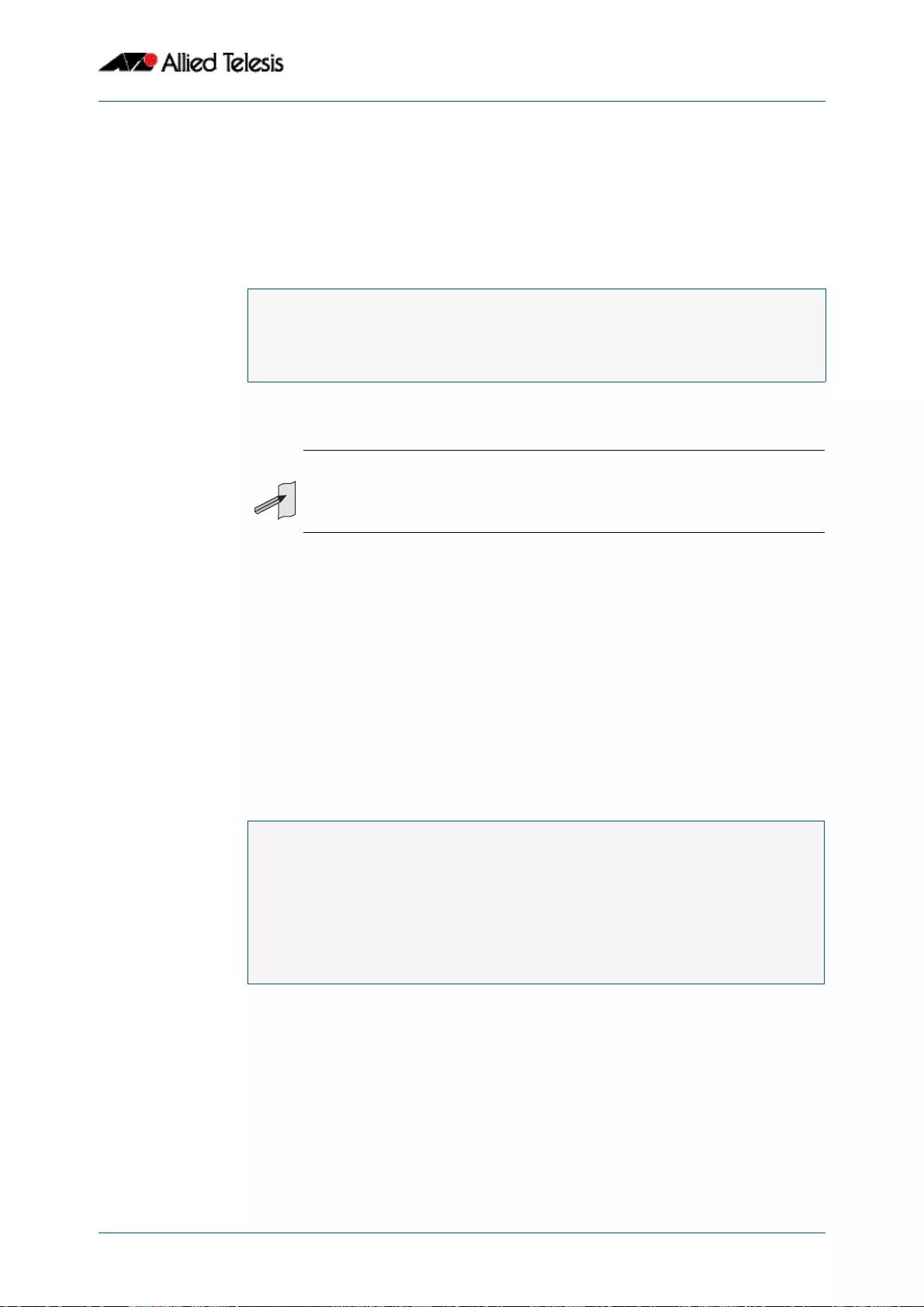
VCStack Introduction
Software Reference for GS900MX/MPX Series Switches
C613-50065-01 REV B AlliedWare PlusTM Operating System - Version 5.4.4E-1.x 81.23
Switch ID 3 is then unprovisioned:
Run the show stack command to confirm that switch 3 has been unprovisioned:
Displaying Provisioned Configurations
In this respect the major difference associated with provisioning, is that interface
configurations will still exist in the config files and will appear in show commands, even
though a device itself may not be physically installed. This (provisioning) could result from
device capability that has been preconfigured for future installation, or could result from
the removal of an installed device.
The show running-config command includes switch commands for existing hardware,
plus all non-existent, but provisioned, hardware. The following example output of the
show running-config command illustrates how provisioned and existing hardware is
displayed.
Displaying provisioned hardware status
The status, present or provisioned, appears in monitoring commands such as the
show interface brief command. The following sample output from the show interface
brief command shows the provisioning status of two configured stack members.
awplus(config)# no switch 3 provision
awplus# show stack
Virtual Chassis Stacking summary information
ID Pending ID MAC address Priority Status Role
1 - 0000.cd28.5377 128 Ready ActiveMaster
2 - 0000.cd29.95bf 128 Ready BackupMember
Note Ensure that you save your running configuration to your startup configuration
after making any provisioning changes using copy running-config startup-
config.
Figure 81-10: Sample display of existing and provisioned show output
sh running-config
!
switch 1 provision GS948MX
!
interface port1.0.1-1.0.12
switchport
switchport mode access
!
.end

VCStack Introduction
Software Reference for GS900MX/MPX Series Switches
81.24 AlliedWare PlusTM Operating System - Version 5.4.4E-1.x C613-50065-01 REV B
A more detailed inspection of the provisioned port2.0.3 is shown below. Note that the
MAC address is 0000.0000.0000, which is the value applied as a placeholder for all
provisioned ports. Also note that although the port is in the link DOWN state its
administrative state of UP PROVISIONED means that it can be further configured. For
example, it can be associated with a VLAN, or added to a link aggregation group.
Provisioning and Configuration Management
A benefit of provisioning is configuration settings are no longer dependent on the
existence of hardware devices. When a device is removed, all the interfaces for that device
are shut down and its provisioning status is set. This means that you can add or remove
physical hardware without affecting your network interfaces. Of course when ports go
down (i.e. are physically removed) there will be other changes to network configuration,
as protocols may re-converge or routes may be removed.
Switches within a VCStack can be hot-swapped without the need for reconfiguration.
The configuration of a newly inserted device that matches the provisioned board-class is
achieved on a best-effort basis. For example inserting a non-POE switch into a stack
member location configured for PoE will result in the failure of the PoE configuration
commands.
Take care that your provisioned configurations, match with the type of hardware that you
plan to install.
Figure 81-11: Sample show interface brief output showing hardware provisioning
status
awplus#show interface brief
Interface Status Protocol
port2.0.24 admin up down
port3.0.1 admin up provisioned
port3.0.2 admin up provisioned
Figure 81-12: Sample display showing provisioning status of a specific port
Interface port2.0.3
Scope: both
Link is DOWN, administrative state is UP PROVISIONED
Thrash-limiting
Status Unknown, Action learn-disable, Timeout 1(s)
Hardware is Ethernet, address is 0000.0000.0000
index 6801 metric 1 mtu 1500 mru 1522
<BROADCAST,MULTICAST>
SNMP link-status traps: Disabled
input packets 0, bytes 0, dropped 0, multicast packets 0
output packets 0, bytes 0, multicast packets 0 broadcast
pks0
awplus(config)# switch 2 bay 4 provision <product-type>
awplus(config)# interface port2.0.4
awplus(config-if)# shutdown

VCStack Introduction
Software Reference for GS900MX/MPX Series Switches
C613-50065-01 REV B AlliedWare PlusTM Operating System - Version 5.4.4E-1.x 81.25
Software Version Auto Synchronization
Introduction
Different software releases exhibit functional and operational differences. To maintain
consistent behavior across the stack, all new member switches must be running the same
software release before they can fully join the stack.
Manually upgrading the software release of each new stack member that joins a stack
would be a cumbersome process. The VCStack software version auto synchronization
feature automates this process by ensuring the same software release is used on all stack
members, and automatically upgrades stack members where required.
How Auto Synchronization Works
Software version comparison
When the stack is formed, it elects one of its switches to become the master. The software
release running on the stack master will then become the software version used
throughout the stack. After a master is elected, all the stack members compare their
current software version with the version that is running on the stack master.
If the comparison process detects differences between software versions, the software
version auto synchronization feature will automatically copy the master's software release
onto the appropriate stack members. Once the software release has successfully been
copied, this version will become the boot software for that particular stack member, which
will then reboot in order to load the new software release.
When auto-synchronization upgrades a stack member, the member’s current running
software will be set as the backup software release. If there are any problems loading the
new software, then the backup software release will be used to recover.
If the stack member does not have enough free Flash memory space for the new release,
then the new release will replace up to two older release files in Flash memory, which is
determined by software build dates of the older release files. The oldest release files are
replaced first.
Auto synchronization limitations
Because the stack master's software version gets applied to the rest of the stack, care must
be taken to ensure the correct switch is elected master. If the master is running an older
software release, then software version auto synchronization may downgrade the
software releases running on other stack members. For configuring which stack member
becomes the master, see the stack priority command on page 82.19.
Software version auto synchronization will not work if stack members are booting using
either a one-off boot or from TFTP or YMODEM. In these situations, any stack members
running different software will boot as standalone devices.

VCStack Introduction
Software Reference for GS900MX/MPX Series Switches
81.26 AlliedWare PlusTM Operating System - Version 5.4.4E-1.x C613-50065-01 REV B
Incompatible software releases
The software version auto synchronization feature will not always work if there have been
significant VCStack or system changes between the two different software releases. The
VCStack discovery of other stack members uses an internal “stack S/W version” to detect
compatibility between builds.
If the VCStack software between two stack members is incompatible, the software version
auto synchronization feature will not work. Instead, an “incompatible stack S/W version”
log message will be displayed and both stack members will boot as standalone devices.
This is an undesirable situation because both devices may load the same configuration
file, which could cause network conflicts. In order to avoid this situation when upgrading
the stack to a new major release, ensure the “boot system” command succeeds.
In general, the software version auto synchronization feature will work between
maintenance releases, such as between 5.4.4-0.1 and 5.4.4-0.2, but may not work between
major or minor releases that have new VCStack features, such as between 5.4.3-0.1 and
5.4.4-0.1. For information about which specific releases support auto synchronization, see
the New and Enhanced Features document for the release.
Upgrading stack software reliably
When upgrading a stack to a new software release, the boot system backup command
on page 7.11 will automatically synchronize the new software release across stack
members. If there is insufficient file space on a backup member, the boot system
command has an interactive mode that prompts you to delete old releases to free up file
space.
However, if you choose not to delete any release files, or if Flash space is taken up with
other types of files, then the boot system command can fail to set the preferred release on
the backup member. If you do not have enough space in Flash to add a backup release file,
then remove unused files in Flash using the delete command.
If you are unsure which files to delete, the following process may assist you.
Use the remote-login command to login to the backup member with insufficient free file
space, in this example member 2.
Look for any .rel (release) files, .jar (GUI), or .tgz and .gz (diagnostic) files that are no longer
needed and use the delete command to remove them.
Alternatively, you can use the file system commands directly from the master's console
prompt using the filepath of the backup member's Flash. Substitute awplus for the
hostname in the configuration, and use awplus-2 for stack member 2, and so on.
awplus# remote-login 2
awplus-2# enable
awplus-2# dir
awplus# dir awplus-2/flash:*
awplus# delete awplus-2/flash:/GS900-5.4.4E-
1.1.rel

Software Reference for GS900MX/MPX Series Switches
C613-50065-01 REV B AlliedWare PlusTM Operating System - Version 5.4.4E-1.x 82.1
Chapter 82: Stacking Commands
Introduction ........................................................................................................................................ 82.2
Command List .................................................................................................................................... 82.3
clear counter stack............................................................................................................................ 82.3
reboot rolling...................................................................................................................................... 82.4
reload rolling....................................................................................................................................... 82.4
remote-login....................................................................................................................................... 82.5
show counter stack........................................................................................................................... 82.6
show provisioning (stack) ............................................................................................................82.10
show stack .........................................................................................................................................82.11
stack disabled-master-monitoring ...........................................................................................82.15
stack enable ......................................................................................................................................82.16
stack management subnet..........................................................................................................82.17
stack management vlan ...............................................................................................................82.18
stack priority .....................................................................................................................................82.19
stack renumber................................................................................................................................82.20
stack renumber cascade...............................................................................................................82.21
stack resiliencylink ..........................................................................................................................82.22
stack virtual-chassis-id...................................................................................................................82.24
stack virtual-mac .............................................................................................................................82.25
switch provision (stack).................................................................................................................82.26
switchport resiliencylink...............................................................................................................82.27

Stacking Commands
Software Reference for GS900MX/MPX Series Switches
82.2 AlliedWare PlusTM Operating System - Version 5.4.4E-1.x C613-50065-01 REV B
Introduction
This chapter provides an alphabetical reference for each of the Stacking commands.
Also note the following stacking trigger commands that are documented in the Triggers
chapter:
type stack disabled-master command on page 76.28
type stack master-fail command on page 76.30
type stack member command on page 76.31
type stack link command on page 76.29
In addition to the stacking commands shown in this chapter, stacking content also exists
in the following commands:
hostname command on page 8.17
reboot command on page 8.22
reload command on page 8.23
show cpu command on page 8.25
show cpu history command on page 8.28
show exception log command on page 10.36
show file systems command on page 7.36
show memory command on page 8.35
show memory history command on page 8.38
show process command on page 8.42
show system command on page 8.46
Caution Stack operation is only supported if stack virtual-mac is enabled.
For more information refer to:
“Enabling the stack virtual-mac” on page 81.13 and
“stack virtual-mac” on page 82.25

Stacking Commands
Software Reference for GS900MX/MPX Series Switches
C613-50065-01 REV B AlliedWare PlusTM Operating System - Version 5.4.4E-1.x 82.3
Command List
clear counter stack
This command clears all stack counters for all stack members.
Syntax clear counter stack
Mode Privileged Exec
Example To clear all stack counters:
Related Commands show counter stack
awplus# clear counter stack

Stacking Commands
Software Reference for GS900MX/MPX Series Switches
82.4 AlliedWare PlusTM Operating System - Version 5.4.4E-1.x C613-50065-01 REV B
reboot rolling
This command reboots a stack in a rolling sequence to minimize downtime.
The stack master is rebooted, causing the remaining stack members to failover and elect a
new master. The rebooted unit remains separate from the remaining stack and boots up
as a stand-alone unit. Once the rebooted unit has finished running its configuration and
has brought its ports up, it reboots all the remaining stack members at once.
Syntax reboot rolling
Mode Privileged Exec
Usage If you are upgrading to a new software version, the new version must also support rollling
reboot.
Examples To rolling reboot the stack, use the following commands:
After running this command, the stack master will reboot immediately with the
configuration file settings. The remaining stack members will then reboot once the master
has finished re-configuring.
Related Commands boot system
epsr
reload rolling
This command performs the same function as the reboot rolling command on page 82.4.
Note When stacking is used with EPSR, the EPSR failovertime must be set to at least
5 seconds to avoid any broadcast storms during failover. Broadcast storms may
occur if the switch cannot failover quickly enough before the EPSR failovertime
expires. For further information about EPSR failovertime, see the epsr
command on page 58.4.
awplus# reboot rolling
Continue the rolling reboot of the stack? (y/n):
Continue the rolling reboot of the stack? (y/n):
awplus# y

Stacking Commands
Software Reference for GS900MX/MPX Series Switches
C613-50065-01 REV B AlliedWare PlusTM Operating System - Version 5.4.4E-1.x 82.5
remote-login
This command is used only on the master in order to log onto the CLI of another stack
member. In most respects the result of this is similar to being logged into the stack master.
Configuration commands are still applied to all stack members, but show commands, and
commands that access the file system are executed locally.
The specific output obtained will vary greatly depending on the show command chosen.
Syntax remote-login <stack-ID>
Mode Privileged Exec
Usage Note that some commands such as ping or telnet are not available when the remote-
login is used.
Example To log onto stack member 2, use the following command:
To return to the command prompt on the master stack member, type exit.
Parameter Description
<stack-ID>Stack member number, from 1 to 4.
awplus# remote-login 2

Stacking Commands
Software Reference for GS900MX/MPX Series Switches
82.6 AlliedWare PlusTM Operating System - Version 5.4.4E-1.x C613-50065-01 REV B
show counter stack
Use this command to display stack related counter information.
Syntax show counter stack
Default All counters are reset when the stack member is rebooted.
Mode User Exec and Privileged Exec
Usage This displays the stacking counter information for every stack member.
Examples To display the stacking counter information about the whole stack, use the following
command.
awplus# show counter stack
Figure 82-1: Example output from the show counter stack command
Virtual Chassis Stacking counters
Stack member 1:
Topology Event counters
Units joined ......... 1
Units left ......... 0
Links up ......... 1
Links down ......... 0
ID conflict ......... 0
Master conflict ......... 0
Master failover ......... 0
Master elected ......... 1
Master discovered ......... 0
SW autoupgrades ......... 0
Stack Port 1 Topology Event counters
Link up ......... 3
Link down ......... 2
Nbr re-init ......... 0
Nbr incompatible ......... 0
Nbr 2way comms ......... 1
Nbr full comms ......... 1
Stack Port 2 Topology Event counters
Link up ......... 0
Link down ......... 0
Nbr re-init ......... 0
Nbr incompatible ......... 0
Nbr 2way comms ......... 0
Nbr full comms ......... 0

Stacking Commands
Software Reference for GS900MX/MPX Series Switches
C613-50065-01 REV B AlliedWare PlusTM Operating System - Version 5.4.4E-1.x 82.7
Topology Message counters
Tx Total ......... 4
Tx Hellos ......... 4
Tx Topo DB ......... 0
Tx Topo update ......... 0
Tx Link event ......... 0
Tx Reinitialise ......... 0
Tx Port 1 ......... 4
Tx Port 2 ......... 0
Tx 1-hop transport ......... 4
Tx Layer-2 transport ......... 0
Rx Total ......... 1
Rx Hellos ......... 1
Rx Topo DB ......... 0
Rx Topo update ......... 0
Rx Link event ......... 0
Rx Reinitialise ......... 0
Rx Port 1 ......... 1
Rx Port 2 ......... 0
Rx 1-hop transport ......... 1
Rx Layer-2 transport ......... 0
Topology Error counters
Version unsupported ......... 0
Product unsupported ......... 0
XEM unsupported ......... 0
Too many units ......... 0
Invalid messages ......... 0
Resiliency Link counters
Health status good ......... 1
Health status bad ......... 0
Tx ......... 0
Tx Error ......... 0
Rx ...... 3600
Rx Error ......... 0
Stack member 2:
-- Output repeated for other stack members - details not shown--
Table 82-1: Parameters in the output of the show counter stack command
Parameters Description
Topology Event Counters
Units joined Number of times that the stack acquires a member.
Units left Number of times that the stack loses a member.
Links up Number of times that a stack link is up in the stack.
Links down Number of times that a stack link is down in the stack.
ID conflict Number of times that stack-ID conflicts.
Master conflict Number of times that stack master conflict occurs.
Master failover Number of times that stack master fails.
Master elected Number of times that stack master is elected.
Master
discovered
Number of times that stack master is discovered.
SW autoupgrades Number of times that the software in the stack members are
auto upgraded.
Stack port counters
Figure 82-1: Example output from the show counter stack command (cont.)

Stacking Commands
Software Reference for GS900MX/MPX Series Switches
82.8 AlliedWare PlusTM Operating System - Version 5.4.4E-1.x C613-50065-01 REV B
Link up Number of times that this unit's physical stack link has come
up.
Link down Number of times that this unit's physical stack link has come
down.
Nbr re-init Number of times that the neighbor is detected as having
reinitialised.
Nbr incompatible Number of times that the neighbor is detected as
incompatible.
Nbr 2way comms Number of times that the neighbor is in two way
communication status.
Nbr full comms Number of times that the neighbor is in full communication
status.
Topology message counters
Total Total number of topology messages.
Hellos Number of hello messages.
Topology DB Number of topology database messages.
Topology update Number of topology database update messages.
Link event Number of link event messages.
Reinitialise Number of reinitialise messages.
1-hop transport Number of 1-hop transport messages.
Layer-2
transport Number of layer 2 transport messages.
Link event Number of link event messages.
Reinitialise Number of reinitialise messages.
1-hop transport Number of 1-hop transport messages.
Layer-2
transport
Number of Layer 2 transport messages.
Topology error
counters
Reasons why a neighboring unit could not join the stack.
Version
unsupported Number of stack software version unsupported errors.
Product
unsupported
Number of product unsupported errors.
XEM unsupported Number of XEM unsupported errors.
Too many units Number of too many units errors.
Table 82-1: Parameters in the output of the show counter stack command (cont.)
Parameters Description

Stacking Commands
Software Reference for GS900MX/MPX Series Switches
C613-50065-01 REV B AlliedWare PlusTM Operating System - Version 5.4.4E-1.x 82.9
Related Commands show stack
switch provision (stack)
Invalid messages Number of invalid messages.
Health status
good
The number of times that the resiliency link has successfully
carried healthchecks following a failure at startup.
Health status
bad
The number of times that the resiliency link healthcheck has
timed out. A timeout occurs when a backup stack member
detects a delay greater than two seconds between
healthcheck messages received.
Rx The total number of healthcheck messages that a stack
member has received from the stack master.
Rx Error The total number of invalid healthcheck messages that have
been received from the master. This message is not applicable
to the stack master.
Table 82-1: Parameters in the output of the show counter stack command (cont.)
Parameters Description

Stacking Commands
Software Reference for GS900MX/MPX Series Switches
82.10 AlliedWare PlusTM Operating System - Version 5.4.4E-1.x C613-50065-01 REV B
show provisioning (stack)
Use this command to display the provisioning status of all installed or provisioned
hardware. Provisioning is the preconfiguration necessary to accommodate future
connection of hardware items such as a switch.
Syntax show provisioning
Mode User Exec and Privileged Exec
Example To show provisioning, use the following command:
Output Figure 82-2: Example output from the show provisioning command
Table 82-2: Parameters in the output of the show provisioning command
awplus# show provisioning
Switch provisioning summary information
ID Board class Status
1.0 AT-GS924 Hardware present
Parameter Description
ID The unit bay-location of the hardware provision.
Board class The hardware type.
Status The provisioned state:
■Hardware Present means that the hardware is currently
installed in the stack.
■Provisioned means that although the hardware is not
currently installed, the stack is preconfigured ready to
accept the hardware installation.

Stacking Commands
Software Reference for GS900MX/MPX Series Switches
C613-50065-01 REV B AlliedWare PlusTM Operating System - Version 5.4.4E-1.x 82.11
show stack
Use this command to display information about current stack members.
Syntax show stack [detail]
Default Display summary information only.
Mode User Exec and Privileged Exec
Usage This command displays information about current stack members. If the detail parameter
is specified, additional information will be displayed for each stack member. By default,
only summary information is displayed.
Example To display summary information about the stack, use the command:
Output Figure 82-3: Example output from the show stack command
Parameter Description
detail Display detailed stacking information.
awplus# show stack
Virtual Chassis Stacking summary information
ID Pending ID MAC address Priority Status Role
1 - 0000.cd28.07e1 128 Ready Active Master
2 - 0015.77c2.4d44 128 Ready Backup Member
3 - 0015.77c9.7464 128 Syncing Backup Member
4 - - - - Provisioned
Operational Status Normal operation
Stack MAC address 0000.cd28.07e1
Table 82-3: Parameters in the output from the show stack command
Parameter Description
ID Stack-ID.
MAC address Stack member MAC address.
Priority Stack member master election priority (between 0 and 255). Note
that the lowest number has the highest priority.
Role Stack member’s role in the stack, this can be one of:
■Active Master
■Disabled Master — this is the temporary master when there is a
communication break within the stack, but communication still
exists across the resiliency link. In this state all switch ports within
the stack are disabled by default, but a different configuration can
be run by a “type stack disabled-master” trigger.
■Backup Member — a device other than the stack master.
■Provisioned — indicates that the stack position is provisionally
configured, i.e. ready to accept a particular switch type into the
stack.

Stacking Commands
Software Reference for GS900MX/MPX Series Switches
82.12 AlliedWare PlusTM Operating System - Version 5.4.4E-1.x C613-50065-01 REV B
Example To display the detailed stacking information about the stack’s overall status:
Figure 82-4: Example output from the show stack detail command
awplus# show stack detail
Virtual Chassis Stacking detailed information
Stack Status:
----------------------------------------------------------------
Operational Status Normal operation
Management VLAN ID 4094
Management VLAN subnet address 192.168.255.0
Virtual Chassis ID 388 (0x184)
Virtual MAC address 0000.cd37.0184
Mixed mode Disabled
Disabled Master Monitoring Enabled
Stack member 1:
----------------------------------------------------------------
ID 1
Pending ID -
MAC address 0000.cd28.070d
Last role change Wed May 7 22:31:58 2014
Product type AT-GS924MPX
Role Active Master
Priority 1
Host name awplus
S/W version auto synchronizaion On
Resiliency link status Configured
Stack port 1.0.27 status learned neighbor 2
Stack port 1.0.28 status learned neighbor 3
Stack member 2:
----------------------------------------------------------------
ID 2
Pending ID -
MAC address 0000.cd29.716d
Last role change Wed May 7 23:47:21 2014
Product type AT-GS924MPX
Role Backup Member
Status Ready
Priority 2
Host name awplus-2
S/W version auto synchronization On
Resiliency link status Successful
Stack port 2.0.27 status learned neighbor 3
Stack port 2.0.28 status learned neighbor 1
Stack member 3:
----------------------------------------------------------------
ID 3
Pending ID -
MAC address 0015.77c2.4d9d
Last role change Wed May 7 22:31:58 2014
Product type AT-GS924MPX
Role Backup Member
Priority 3
Host name awplus-3
S/W version auto synchronizaion On
Resiliency link status Successful
Stack port 3.0.27 status learned neighbor 1
Stack port 3.0.28 status learned neighbor 2

Stacking Commands
Software Reference for GS900MX/MPX Series Switches
C613-50065-01 REV B AlliedWare PlusTM Operating System - Version 5.4.4E-1.x 82.13
Table 82-4: Parameters in the output from the show stack detail command
Parameter Description
Host name The host name of the stack member.
ID Stack-ID.
Last Role
Change The date and time the stack member last changed its role in the
stack.
MAC address Stack member MAC address.
Management VLAN
ID The VLAN ID currently used for stack management: the default
is 4094.
Management VLAN
subnet address The current stacking management VLAN subnet address.
Virtual Chassis
ID The Virtual Chassis ID determines the last 12 bits of the Virtual
MAC address: 0000.cd37.0xxx
Virtual MAC
Address The Virtual MAC address of the stack.
Disabled Master
Monitoring The current Disabled Master Monitoring status. This can be:
■Enabled
■Disabled
■Inactive
Operational
Status The status of the stack. This can be:
■Normal operation:
If any other status is displayed, it may warrant further
investigation.
■Stacking hardware disabled:
The stack enable command needs to be added to the
configuration to activate the stacking feature.
■Operating in failover mode:
This stack member has become separated from the rest of
the stack, or it failed to join the stack correctly.
■Standalone unit:
Stacking is enabled, but no other stack members are
present.
■Not all stack ports are up:
One or more stacking ports may be down, or stacking
discovery may not have detected the neighbor successfully.
Stack Status The stack’s overall status. Note that a warning is issued if the
stack is not connected in a standard ring topology.
Pending ID The pending stack member ID. This can be changed by the
stack renumber command on page 82.20. If there is no
pending ID, the “-” symbol will display.

Stacking Commands
Software Reference for GS900MX/MPX Series Switches
82.14 AlliedWare PlusTM Operating System - Version 5.4.4E-1.x C613-50065-01 REV B
Related Commands show counter stack
stack disabled-master-monitoring
stack resiliencylink
Stack port
status The status of the stack port. This can be:
■Down
■Neighbor incompatible
■Discovering neighbor
■Learned neighbor
Priority Stack member master election priority (between 1 and 255)
Note that the lowest number has the highest priority.
Product Type Stack member product type.
Provisioned Indicates that the stack position is provisionally configured, i.e.
ready to accept a particular switch type into the stack.
Resiliency link
status The current status of the resiliency link. The status can be one
of:
■Not configured (Master or Member).
■Configured (Master only).
■Successful:
Successfully receiving healthchecks from the Active Master.
■Failed (Member only):
Not receiving any healthchecks from the Active Master.
■Stopped:
The resiliency link is configured, but is inactive. This may
occur in a Disabled Master stack, for example if the Disabled
Master Monitoring feature is not used.
Role Stack member’s role in the stack, this can be one of:
■Active Master.
■Disabled Master — The temporary master when there is a
communication break within the stack, but communication
still exists across the resiliency link. In this state all switch
ports within the stack are disabled by default, but a different
configuration can be run by a “type stack disabled-master”
trigger command.
■Backup Member — a device other than the stack master.
■Discovering — joining the stack.
Status Indicates how readily a stack member can take over as master if
the current stack master were to fail.
■Init — the stack member is completing the startup
initialization.
■Syncing — the stack member is synchronizing state
information with the stack master following startup.
■Ready — the stack member is fully synchronized with the
current master and is ready to take over immediately.
Table 82-4: Parameters in the output from the show stack detail command (cont.)
Parameter Description

Stacking Commands
Software Reference for GS900MX/MPX Series Switches
C613-50065-01 REV B AlliedWare PlusTM Operating System - Version 5.4.4E-1.x 82.15
stack disabled-master-monitoring
This command enables the Disabled Master Monitoring (DMM) feature. If a stack member
becomes a disabled master, the DMM feature will use the stack resiliency link to continue
monitoring the health of the separated stack master.
Use the no variant of this command to disable the DMM feature.
Syntax stack disabled-master-monitoring
no stack disabled-master-monitoring
Default By default, Disabled Master Monitoring is enabled. However, it only operates if there is a
resiliency link.
Mode Global Configuration
Usage This command enables additional stack resiliency link functionality, which is used if a stack
separation occurs. For DMM to operate, a resiliency link must also be configured (stack
resiliencylink command on page 82.22). A stack separation could result in a stack
member becoming a disabled master, which has the configuration as a normal stack
master except that all its switchports are shutdown.
For more information about the disabled master state, see “Disabled master” on
page 81.17.
When the DMM feature is enabled, the disabled master will continue to monitor the
health of the original stack master over the stack resiliency link connection. If the original
stack master were to fail, when the DMM feature is enabled, then the disabled master will
detect this and will automatically re-enable its switchports. This ensures that the stack will
continue to pass network traffic, even if a catastrophic stack failure occurs.
For more information about the DMM feature when the stack member is a disabled
master, see “Disabled Master Monitoring (DMM)” on page 81.18.
Examples To enable the DMM feature, use the following commands:
To disable the DMM feature, use the following commands:
Related Commands switch provision (stack)
show stack
stack resiliencylink
type stack disabled-master
type stack master-fail
awplus# configure terminal
awplus(config)# stack disabled-master-monitoring
awplus# configure terminal
awplus(config)# no stack disabled-master-monitoring

Stacking Commands
Software Reference for GS900MX/MPX Series Switches
82.16 AlliedWare PlusTM Operating System - Version 5.4.4E-1.x C613-50065-01 REV B
stack enable
This command is used on a stackable stand-alone switch to manually turn on the VCStack
feature.
This command can also be run on a switch that has previously been removed from a stack
(by using the no variant of this command) and return it to stacking operation.
The no variant of this command removes a selected stack member switch, as specified by
the <stack-ID> selection in the command syntax, from the virtual chassis stack.
Syntax stack enable
no stack <stack-ID> enable
Default The VCStack feature is enabled by default. The feature automatically starts when hardware
is present.
Mode Global Configuration
Usage When stack enable is entered, the stack virtual-mac is automatically enabled. Using
virtual-mac is required in order to minimize disruption on failover.
Running the no variant of this command will remove the selected stack member from the
stack. At this point the removed member will act as a stand-alone master and will disable
all of its ports. The switch can then only be accessed via its console port. If the command is
run on the master then all current members of the stack will be disabled.
To return the switch to stack membership, first connect to the switch via its console port,
then run the stack enable command. Then save the configuration and run the reboot
command on page 8.22. This will reboot the switch and it will re-join the stack as an
ordinary member.
If the switch was previously the stack master, you might want to return it to its original
stack master status. To do this you must run the reboot command on page 8.22 again.
This time—because the switch is now a stack member—the command will reboot the
whole stack and result in a new master election.
Note the following condition of applying the no stack <stack-ID> enable command:
■If the specified stack-ID is not used by any current stack member, the command
will be rejected.
.
Example To turn on stacking on a stackable stand-alone unit, use the command:
Related Commands reboot
Parameter Description
<stack-ID>Stack member number, from 1 to 4.
Caution Disabling a stack member can significantly degrade the throughput
capability of the stack.
awplus# configure terminal
awplus(config)# stack enable

Stacking Commands
Software Reference for GS900MX/MPX Series Switches
C613-50065-01 REV B AlliedWare PlusTM Operating System - Version 5.4.4E-1.x 82.17
stack management subnet
This command configures the subnet address used by the stack management VLAN.
Use the no variant of this command to reset the stack’s VLAN subnet management
address back to the default address and mask (192.168.255.0/27).
Syntax stack management subnet <ip-address>
no stack management subnet
Default The default stacking management VLAN subnet address is 192.168.255.0 with a subnet
mask 255.255.255.224 or /27.
Mode Global Configuration
Usage This command configures the stack management VLAN subnet address.
The management VLAN will be used for high speed communication between stacked
units via the stacking ports. Although this command enables you to change the IP address
command, the subnet mask must always remain as shown.
The stack management IP subnet is solely used internally to the stacked devices, and
cannot be reached external to the stack. You should only change the stack management
VLAN subnet address if it causes a conflict within your network.
Note that several separate stacks can use the same default management VLAN subnet
address even though their user ports may share the same external network. If the stack
subnet address is changed, then the configuration for any new units must also be updated
before they are inserted into the stack.
If the management VLAN subnet address is changed by this command, you can use the no
variant of this command to reset it to it’s default.
Example To set the management VLAN subnet address to 192.168.255.144:
Related Commands stack management vlan
Parameter Description
<ip-address> The new subnet address for the stack management VLAN.
awplus# configure terminal
awplus(config)# stack management subnet 192.168.255.144

Stacking Commands
Software Reference for GS900MX/MPX Series Switches
82.18 AlliedWare PlusTM Operating System - Version 5.4.4E-1.x C613-50065-01 REV B
stack management vlan
Use this command to configure the stack management VLAN ID.
Use the no variant of this command to change the stack management VLAN ID back to the
default (VLAN ID 4094).
Syntax stack management vlan <2-4094>
no stack management vlan
Default VLAN ID 4094
Mode Global Configuration
Usage The management VLAN is used for high speed communication between stacked units.
This command enables you to change the ID of this VLAN.
The default stacking management VLAN ID is 4094, which is the last configurable VLAN ID
in the switch.
The stack management VLAN is created and configured automatically so that the stack
VLAN cannot be used in the stack's VLAN configuration commands (such as
awplus(config-vlan)# vlan <Stack management VLAN ID>).
The management VLAN should only be changed if the default stack VLAN ID needs to be
used in the stack's VLAN configuration.
Examples To set the management VLAN to 4000, enter the following commands:
To reset the management VLAN back to the default (4094), enter the following commands:
Related Commands stack management subnet
Parameter Description
<2-4094> Stack management VLAN ID.
Caution When the command is entered, the updated management VLAN
configuration will take effect once the stack is restarted.
If the management VLAN ID is changed by this command, you can use the
no variant of this command to change it back to default value.
awplus# configure terminal
awplus(config)# stack management vlan 4000
awplus# configure terminal
awplus(config)# no stack management vlan
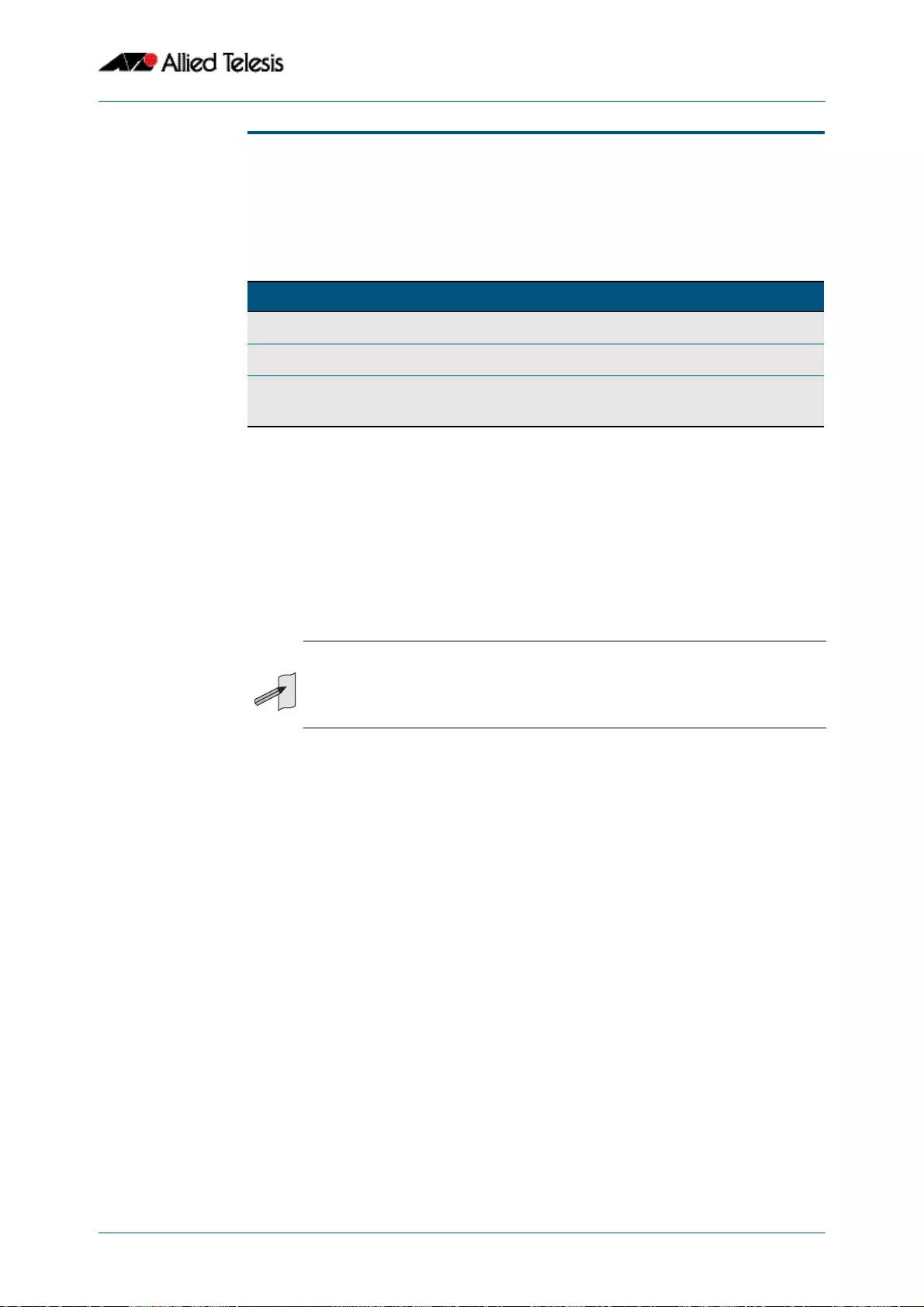
Stacking Commands
Software Reference for GS900MX/MPX Series Switches
C613-50065-01 REV B AlliedWare PlusTM Operating System - Version 5.4.4E-1.x 82.19
stack priority
Use this command to change a specific stack member's master-election priority.
Syntax stack <stack-ID> priority <0-255>
no stack <stack-ID> priority
Mode Global Configuration
Usage This command is used to change the value of a specific stack member's master-election
priority. If the specified stack-ID is not used by any current stack member, the
command will be rejected.
The election criteria selects the stack member with the lowest priority value to become
the stack master. Where two stack members both have the same lowest priority value,
then the stack member with the lowest MAC address will be elected as master.
Example To change the priority of stack member 2 to be 3, use the command:
Validation
Command
show stack
Parameter Description
<stack-ID> Stack member number, from 1 to 4.
priority The stack member’s election priority value.
<0-255> The stack member’s new priority value. The lowest value is assigned
the highest priority. The default is 128.
Note Assigning a new priority value will not immediately change the current stack
master. In order to force a master re-election after the new priority value is
assigned, use reboot stack-member <master's ID> to reboot the current stack
master, a new stack master will then be elected based on the new priority
values.
awplus# configure terminal
awplus(config)# stack 2 priority 3

Stacking Commands
Software Reference for GS900MX/MPX Series Switches
82.20 AlliedWare PlusTM Operating System - Version 5.4.4E-1.x C613-50065-01 REV B
stack renumber
Use this command to renumber a specific stack member.
Syntax stack <existing stack-ID> renumber <new stack-ID>
Default Every stack unit will initially try to use a stack-ID of 1.
Mode Global Configuration
Usage This command is used to change the ID of a specific stack member - primarily when
exchanging stack members. The changes made by this command will not take effect until
the switch is rebooted.
The existing stack-ID must already be assigned to an existing stack member. To avoid
duplicating IDs, a warning message will appear if you assign a new stack-ID that is
currently assigned to another stack member. However, you can continue to renumber the
stack-IDs and remove ID duplications. If you do not remove the duplications, then one of
the devices will be forced to automatically renumber to an unused ID. Once you have
removed any duplicate IDs, you can reboot the switch to implement your changes.
Note that the configured stack-ID is saved immediately on the renumbered member,
and so is not reliant on using the copy running-config command for it to take effect.
Example To renumber stack 1 to stack 2, use the commands:
Validation
Command
show stack
Parameter Description
<existing stack-ID>We recommend that you use only numbers 1 to 2 for
a 2 unit stack, or 1 to 4 for a four unit stack.
renumber Change the existing stack-ID.
<new stack-ID>We recommend that you use only numbers 1 to 2 for
a 2 unit stack, or 1 to 4 for a four unit stack.
Note This command does not alter any of the stacks's existing configuration, apart
from the stack-ID specified. For example, if stack member 2 were removed
from the stack and a new stack unit is assigned the member 2 stack-ID,
then the interface configuration that existed for the removed stack member 2
will be applied to the new stack member 2.
awplus# configure terminal
awplus(config)# stack 1 renumber 2

Stacking Commands
Software Reference for GS900MX/MPX Series Switches
C613-50065-01 REV B AlliedWare PlusTM Operating System - Version 5.4.4E-1.x 82.21
stack renumber cascade
This command is used to renumber the members of a stack so that their IDs are ordered
sequentially, relative to the member's physical position within the stack.
Syntax stack <stack-ID> renumber cascade [<stack-ID>]
Default If no stack-ID is specified, the member will take the default ID of 1.
Mode Global Configuration
Usage This command is used to renumber the members of a stack so that their stack-IDs are
ordered sequentially. This would normally be done either when the stack is initially
configured or following a major reconfiguration.
The renumber will start on the specified stack member. If that stack-ID is not used by any
of the existing stack member, the command will be rejected.
The starting stack member will be renumbered with the new stack-ID specified, or the
default of member ID of 1. The stack-ID of the next physically will be the starting members
ID +1, for example member ID 2. This renumbering will continue in cascading order
around the stack members.
The changes will take place immediately and reboot all stack members. For this reason a
confirmation prompt follows this command entry, asking whether you are sure you want
to renumber and reboot the entire stack.
Example
Related Commands show stack
switch provision (stack)
stack renumber
Caution Changing the stack numbering will upset the existing stack member
configurations such as port settings. This command is intended for use
when the stack is either initially commissioned, or has undergone a major
reconfiguration. In this situation you run the stack renumber command
(which will automatically reboot the switch), then configure the stack
members to meet the new requirements.
Parameter Description
<stack-ID> The ID of the stack member to start renumbering from, from 1 to 4.
renumber Change the existing stack-ID.
cascade Renumber the existing stack-ID in cascade order.
<stack-ID> The new ID for the first member renumbered, from 1 to 4.
awplus(config)# stack 1 renumber cascade
Any existing interface configuration may no longer be valid
Are you sure you want to renumber a nd reboot the enti re stack?(y/ n):
y

Stacking Commands
Software Reference for GS900MX/MPX Series Switches
82.22 AlliedWare PlusTM Operating System - Version 5.4.4E-1.x C613-50065-01 REV B
stack resiliencylink
This command configures the resiliency link used by the stack. The interface used may be
either an eth port or is a dedicated VLAN (resiliencylink VLAN) to which switch ports may
become members. This VLAN is dedicated to the resiliency link function and must not be
the stack management VLAN.
Syntax stack resiliencylink <interface>
no stack resiliencylink
Mode Global Configuration
Usage The resiliency-link is only used when a backup member loses connectivity with the master
via the stacking cables. Such a communication loss would occur if:
■a stacking link is removed or fails
■two or more stacking link cables are unplugged or fail
■the stack master itself fails due to a reboot or power failure
The resiliency-link allows the backup member to determine if the master is still present in
the network by the reception of healthcheck messages sent by the master over the
resiliency-link interface.
Reply healthcheck messages are received if the master is still online, but the stack will now
split into two different “stubs”. The stub containing the existing master will continue
operating as normal. The members in the masterless stub will now use a “type stack
disabled-master” trigger to run a configuration to form a second temporary stack. This
utilizes the remaining stack members' resources without conflicting directly with the
master's configuration. If no “type stack disabled-master” trigger was configured on the
switches, then the masterless stub members will disable their switch ports.
If no healthcheck messages are received, then the master is assumed to be completely
offline, and so the other stack members can safely take over the master's configuration.
Example To set the resiliency link to be VLAN 4093.
First use the stack resiliencylink command to create the resiliency vlan 4093
Parameters Description
<interface> The name of the interface that is connected to the resiliency
link.
Caution The purpose of the resiliency link is to enable the stack members
(particularly the backup master) to check the status of the master under
fault conditions. If the resiliency link is not configured, and the master loses
communication with its other stack members, then the stack will assume
the master is NOT present in the network, which could cause network
conflicts if the master is still online. Note that this is a change to the stacking
of releases prior to version 5.3.1.
awplus# configure terminal
awplus(config)# stack resiliencylink vlan4093

Stacking Commands
Software Reference for GS900MX/MPX Series Switches
C613-50065-01 REV B AlliedWare PlusTM Operating System - Version 5.4.4E-1.x 82.23
Next use the switchport resiliencylink command to assign the resiliencylink vlan to the
interface port, in this case port1.0.1.
Related Commands show stack
switch provision (stack)
show stack detail
stack disabled-master-monitoring
switchport resiliencylink
awplus# configure terminal
awplus(config)# interface port1.0.1
awplus(config-if)# switchport resiliencylink

Stacking Commands
Software Reference for GS900MX/MPX Series Switches
82.24 AlliedWare PlusTM Operating System - Version 5.4.4E-1.x C613-50065-01 REV B
stack virtual-chassis-id
This command specifies the stack virtual chassis ID. The ID selected will determine which
virtual MAC address the stack will use. The MAC address assigned to a stack must be
unique within its network.
Syntax stack virtual-chassis-id <id>
Mode Global Configuration
Usage The virtual-chassis-id entered will form the last 12 bits of a pre-selected MAC prefix
component; that is, 0000.cd37.0xxx. If you enable the stack virtual MAC address
feature (by using the stack virtual-mac command) without using the stack virtual-
chassis-id command to select the virtual-chassis-id, then the stack will select a virtual-
chassis-id from a number within the assigned range.
Example To set the stack virtual-chassis-id to 63 use the commands
This will result in a virtual MAC address of: 0000.cd37.003f.
Related Commands show running-config
show stack
switch provision (stack)
stack virtual-mac
Note The command will not take effect until the switch has been rebooted.
Parameter Description
<id>The value of the ID - enter a number in the range 0 to 4095.
awplus# configure terminal
awplus(config)# stack virtual-chassis-id 63

Stacking Commands
Software Reference for GS900MX/MPX Series Switches
C613-50065-01 REV B AlliedWare PlusTM Operating System - Version 5.4.4E-1.x 82.25
stack virtual-mac
This command enables the stack virtual MAC address feature. For more information on
this topic refer to “Fixed or Virtual MAC Addressing” on page 81.13. With this
command set, the value applied for the virtual MAC address is determined by the setting
of the command stack virtual-chassis-id command on page 82.24.
Syntax stack virtual-mac
no stack virtual mac
Mode Global Configuration
Usage Note that this command will not take effect until the switch has been rebooted.
Example
Related Commands show running-config
show stack
switch provision (stack)
stack virtual-chassis-id
Caution Stack operation is only supported if stack virtual-mac is enabled.
Before enabling the virtual MAC address feature, you should check that the
stack’s virtual-chassis-id is not already used by another stack in the network.
Otherwise the duplicate MAC addresses will cause problems for the network
traffic.
awplus# configure terminal
awplus(config)# stack virtual mac

Stacking Commands
Software Reference for GS900MX/MPX Series Switches
82.26 AlliedWare PlusTM Operating System - Version 5.4.4E-1.x C613-50065-01 REV B
switch provision (stack)
This command enables you to provide the configuration for a new stack member switch
prior to physically connecting it to the stack. To run this command, the stack position must
be vacant. The selected hardware type must be compatible existing stack hardware.
Use the no variant of this command to remove an existing switch provision.
Syntax switch <stack-ID> {provision|reprovision} {gs900-24|gs900-48}
no switch <stack-ID> provision
Mode Global Configuration
Usage Note that although the syntax appears to allow provisioning on up to 8 stackable
switches, in practice a maximum of 4 are configurable. Normally the stack members would
be numbered 1 to 4, and so the command could be run to provision any stack member
within this range; and we advise this procedure.
However, you could number the stack units with any numbers between 1-8. For example
you could number your four stack members 1, 2, 7 and 8. In this case you could provision
any of the stack members within this range. We advise against numbering your stacks in
this way.
Examples To provision a GS924MPX switch as stack member 3, use the following commands:
To remove the provision of the switch as stack member 3, use the following commands:
Related Commands show provisioning (stack)
show stack
switch provision (stack)
Parameter Description
<stack-ID>Stack member number, from 1 to 4.
provision Provides settings within the stack configuration ready for a spe-
cific switch type to become a stack member.
reprovision Reconfigure an existing provision configuration.
gs900-24 Provision a 24-port switch.
gs900-48 Provision a 48-port switch.
awplus# configure terminal
awplus(config)# switch 3 provision gs900-24
awplus# configure terminal
awplus(config)# no switch 3 provision

Stacking Commands
Software Reference for GS900MX/MPX Series Switches
C613-50065-01 REV B AlliedWare PlusTM Operating System - Version 5.4.4E-1.x 82.27
switchport resiliencylink
This command configures the switch port to be a member of the stack resiliency link
VLAN. Note that this switchport will only be used for stack resiliency-link traffic and will
not perform any other function, or carry any other traffic.
The no variant of this command removes the switchport from the resiliency link VLAN.
Syntax switchport resiliencylink
no switchport resiliencylink
Mode Interface Configuration
Usage Note that a resiliency link cannot be part of a static or dynamic aggregator group.
Examples To set the resiliency link to be VLAN 4093:
First, use the stack resiliencylink command to create the resiliency vlan4093
Next, use the switchport resiliencylink command to assign the resiliencylink vlan to the
port, in this case port1.0.1.
Related Commands stack resiliencylink
awplus# configure terminal
awplus(config)# stack resiliencylink vlan4093
awplus# configure terminal
awplus(config)# interface port1.0.1
awplus(config-if)# switchport resiliencylink

Stacking Commands
Software Reference for GS900MX/MPX Series Switches
82.28 AlliedWare PlusTM Operating System - Version 5.4.4E-1.x C613-50065-01 REV B

Software Reference for GS900MX/MPX Series Switches
C613-50065-01 REV B AlliedWare PlusTM Operating System - Version 5.4.4E-1.x A.1
Appendix A: Command List
A
aaa accounting auth-mac default ......................................................................................... 45.2
aaa accounting auth-web default......................................................................................... 45.4
aaa accounting commands ..................................................................................................... 45.8
aaa accounting dot1x..............................................................................................................45.10
aaa accounting login ...............................................................................................................45.12
aaa accounting update ...........................................................................................................45.14
aaa accounting wireless............................................................................................................ 45.6
aaa authentication auth-mac ...............................................................................................45.15
aaa authentication auth-web ...............................................................................................45.16
aaa authentication dot1x .......................................................................................................45.17
aaa authentication enable default group tacacs+........................................................45.18
aaa authentication enable default local ...........................................................................45.20
aaa authentication login ........................................................................................................45.21
aaa group server........................................................................................................................45.24
aaa local authentication attempts lockout-time ...........................................................45.25
aaa local authentication attempts max-fail.....................................................................45.26
accept-lifetime ............................................................................................................................. 31.3
access-group................................................................................................................................. 37.4
access-list extended (named) ................................................................................................. 38.4
access-list hardware (named) ...............................................................................................37.18
access-list standard (named) ................................................................................................38.27
access-list (extended numbered)........................................................................................38.12
access-list (hardware IP numbered) ..................................................................................... 37.6
access-list (hardware MAC numbered) .............................................................................37.15
access-list (standard numbered) .........................................................................................38.29
accounting login .......................................................................................................................45.27
activate............................................................................................................................................ 11.2
active (ping-polling)................................................................................................................... 80.3
active (trigger) .............................................................................................................................. 76.2
alliedware-behavior ................................................................................................................... 31.5
arp log ............................................................................................................................................. 25.6
arp security violation ................................................................................................................. 56.3
arp security .................................................................................................................................... 56.2
arp (IP address MAC) .................................................................................................................. 25.5
arp-aging-timeout ...................................................................................................................... 25.4
arp-mac-disparity........................................................................................................................ 25.3
atmf backup bandwidth...........................................................................................................61.5
atmf backup delete .................................................................................................................... 61.6
atmf backup enable ................................................................................................................... 61.7
atmf backup now ........................................................................................................................ 61.8
atmf backup server...................................................................................................................61.10
atmf backup stop ......................................................................................................................61.12
atmf backup synchronize.......................................................................................................61.13
atmf backup .................................................................................................................................. 61.4

Command List
Software Reference for GS900MX/MPX Series Switches
A.2 AlliedWare PlusTM Operating System - Version 5.4.4E-1.x C613-50065-01 REV B
atmf cleanup............................................................................................................................... 61.14
atmf distribute firmware ........................................................................................................61.15
atmf domain vlan......................................................................................................................61.17
atmf enable ................................................................................................................................. 61.18
atmf group (membership) .....................................................................................................61.19
atmf log-verbose.......................................................................................................................61.21
atmf management subnet.....................................................................................................61.22
atmf management vlan ..........................................................................................................61.24
atmf master.................................................................................................................................61.26
atmf network-name .................................................................................................................61.27
atmf provision node clone.....................................................................................................61.29
atmf provision node configure boot config....................................................................61.31
atmf provision node configure boot system ..................................................................61.32
atmf provision node create ................................................................................................... 61.33
atmf provision node delete...................................................................................................61.35
atmf provision node license-cert......................................................................................... 61.37
atmf provision node locate ...................................................................................................61.39
atmf provision ............................................................................................................................ 61.28
atmf reboot-rolling................................................................................................................... 61.40
atmf recover led-off..................................................................................................................61.45
atmf recover................................................................................................................................61.44
atmf remote-login ....................................................................................................................61.46
atmf restricted-login ................................................................................................................61.47
atmf working-set.......................................................................................................................61.48
auth auth-fail vlan........................................................................................................................43.3
auth critical.....................................................................................................................................43.5
auth dynamic-vlan-creation.....................................................................................................43.6
auth guest-vlan.............................................................................................................................43.9
auth host-mode.........................................................................................................................43.11
auth log.........................................................................................................................................43.13
auth max-supplicant................................................................................................................43.15
auth reauthentication .............................................................................................................43.16
auth roaming disconnected..................................................................................................43.17
auth roaming enable ...............................................................................................................43.19
auth supplicant-mac................................................................................................................43.21
auth timeout connect-timeout............................................................................................43.23
auth timeout quiet-period.....................................................................................................43.24
auth timeout reauth-period..................................................................................................43.25
auth timeout server-timeout ................................................................................................43.26
auth timeout supp-timeout ..................................................................................................43.27
auth two-step enable ..............................................................................................................43.28
auth-mac enable .......................................................................................................................43.31
auth-mac method.....................................................................................................................43.32
auth-mac password..................................................................................................................43.33
auth-mac reauth-relearning..................................................................................................43.34
auth-web enable .......................................................................................................................43.35
auth-web forward .....................................................................................................................43.36
auth-web max-auth-fail ..........................................................................................................43.38
auth-web method.....................................................................................................................43.39
auth-web-server blocking-mode ........................................................................................43.40
auth-web-server dhcp ipaddress ........................................................................................ 43.41
auth-web-server dhcp lease..................................................................................................43.42
auth-web-server dhcp-wpad-option.................................................................................43.43
auth-web-server gateway (deleted)................................................................................... 43.44
auth-web-server host-name .................................................................................................43.45
auth-web-server http-redirect (deleted) ..........................................................................43.46
auth-web-server intercept-port...........................................................................................43.47

Command List
Software Reference for GS900MX/MPX Series Switches
C613-50065-01 REV B AlliedWare PlusTM Operating System - Version 5.4.4E-1.x A.3
auth-web-server ipaddress.................................................................................................... 43.48
auth-web-server login-url...................................................................................................... 43.49
auth-web-server mode (deleted) ........................................................................................ 43.50
auth-web-server page logo...................................................................................................43.51
auth-web-server page sub-title ...........................................................................................43.52
auth-web-server page success-message..........................................................................43.53
auth-web-server page title .................................................................................................... 43.54
auth-web-server page welcome-message ......................................................................43.55
auth-web-server ping-poll enable......................................................................................43.56
auth-web-server ping-poll failcount..................................................................................43.57
auth-web-server ping-poll interval ....................................................................................43.58
auth-web-server ping-poll reauth-timer-refresh........................................................... 43.59
auth-web-server ping-poll timeout.................................................................................... 43.60
auth-web-server port...............................................................................................................43.61
auth-web-server redirect-delay-time ................................................................................ 43.62
auth-web-server redirect-url.................................................................................................43.63
auth-web-server session-keep .............................................................................................43.64
auth-web-server ssl intercept-port..................................................................................... 43.67
auth-web-server sslport (deleted) ......................................................................................43.66
auth-web-server ssl ..................................................................................................................43.65
autoboot enable.............................................................................................................................7.5
B
backpressure..................................................................................................................................15.2
banner exec...................................................................................................................................... 8.2
banner login (SSH).......................................................................................................................54.2
banner login (system)...................................................................................................................8.4
banner motd....................................................................................................................................8.5
boot config-file backup ...............................................................................................................7.8
boot config-file ...............................................................................................................................7.6
boot system backup....................................................................................................................7.11
boot system......................................................................................................................................7.9
C
cd .......................................................................................................................................................7.12
channel-group ..............................................................................................................................21.3
cisco-metric-behavior (RIP) ......................................................................................................31.7
class-map ........................................................................................................................................41.3
class...................................................................................................................................................41.2
clear aaa local user lockout....................................................................................................45.28
clear arp security statistics........................................................................................................56.4
clear arp-cache..............................................................................................................................25.9
clear atmf links statistics.........................................................................................................61.49
clear counter stack.......................................................................................................................82.3
clear exception log ......................................................................................................................10.2
clear ip dhcp snooping binding .............................................................................................56.5
clear ip dhcp snooping statistics............................................................................................56.6
clear ip igmp group.....................................................................................................................33.3
clear ip igmp interface ...............................................................................................................33.4
clear ip igmp ..................................................................................................................................33.2
clear ip prefix-list.......................................................................................................................38.35
clear ip rip route ...........................................................................................................................31.8
clear ipv6 mld group...................................................................................................................35.3
clear ipv6 mld interface .............................................................................................................35.3

Command List
Software Reference for GS900MX/MPX Series Switches
A.4 AlliedWare PlusTM Operating System - Version 5.4.4E-1.x C613-50065-01 REV B
clear ipv6 mld ................................................................................................................................35.2
clear ipv6 neighbors ...................................................................................................................27.2
clear lacp counters.......................................................................................................................21.5
clear line console............................................................................................................................5.2
clear line vty .....................................................................................................................................5.3
clear lldp statistics........................................................................................................................70.2
clear lldp table...............................................................................................................................70.3
clear log buffered.........................................................................................................................10.3
clear log permanent....................................................................................................................10.3
clear log ...........................................................................................................................................10.2
clear loop-protection counters ...............................................................................................15.3
clear mac address-table dynamic ..........................................................................................15.5
clear mac address-table static.................................................................................................15.4
clear mls qos interface policer-counters..............................................................................41.4
clear ping-poll ...............................................................................................................................80.4
clear port counter ........................................................................................................................15.7
clear power-inline counters interface...................................................................................23.3
clear spanning-tree detected protocols (RSTP and MSTP) ...........................................19.4
clear spanning-tree statistics ...................................................................................................19.3
clear ssh ...........................................................................................................................................54.3
clear test cable-diagnostics tdr ...............................................................................................78.2
clear test interface .......................................................................................................................13.2
clock set.............................................................................................................................................8.6
clock summer-time date..............................................................................................................8.7
clock summer-time recurring ....................................................................................................8.9
clock timezone..............................................................................................................................8.11
commit (IPv4) .............................................................................................................................37.35
configure terminal .........................................................................................................................4.2
copy current-software................................................................................................................7.12
copy debug ....................................................................................................................................7.13
copy proxy-autoconfig-file....................................................................................................43.68
copy running-config ...................................................................................................................7.14
copy startup-config.....................................................................................................................7.15
copy web-auth-https-file ....................................................................................................... 43.68
copy zmodem................................................................................................................................7.18
copy (URL).......................................................................................................................................7.16
create autoboot............................................................................................................................7.19
critical-interval ..............................................................................................................................80.5
crypto key destroy hostkey ......................................................................................................54.4
crypto key destroy userkey.......................................................................................................54.5
crypto key generate hostkey ...................................................................................................54.6
crypto key generate userkey....................................................................................................54.7
crypto key pubkey-chain knownhosts .................................................................................54.8
crypto key pubkey-chain userkey .......................................................................................54.10
D
day.....................................................................................................................................................76.3
deadtime (RADIUS server group) ...........................................................................................49.2
debug aaa ....................................................................................................................................45.29
debug arp security.......................................................................................................................56.7
debug atmf packet ................................................................................................................... 61.52
debug atmf..................................................................................................................................61.50
debug dot1x ..................................................................................................................................47.2
debug epsr .....................................................................................................................................58.3
debug igmp ...................................................................................................................................33.5

Command List
Software Reference for GS900MX/MPX Series Switches
C613-50065-01 REV B AlliedWare PlusTM Operating System - Version 5.4.4E-1.x A.5
debug ip dhcp snooping...........................................................................................................56.8
debug ip packet interface.........................................................................................................25.9
debug lacp......................................................................................................................................21.6
debug lldp ......................................................................................................................................70.4
debug mail .....................................................................................................................................71.2
debug mld ......................................................................................................................................35.4
debug mstp (RSTP and STP).....................................................................................................19.5
debug ping-poll............................................................................................................................80.6
debug power-inline ....................................................................................................................23.4
debug radius..................................................................................................................................49.3
debug rip.........................................................................................................................................31.9
debug snmp...................................................................................................................................67.2
debug ssh client ........................................................................................................................ 54.12
debug ssh server .......................................................................................................................54.13
debug trigger ................................................................................................................................76.4
default log buffered ....................................................................................................................10.4
default log console......................................................................................................................10.4
default log email ..........................................................................................................................10.5
default log host.............................................................................................................................10.5
default log monitor .....................................................................................................................10.6
default log permanent ...............................................................................................................10.6
default-action................................................................................................................................41.5
default-information originate (RIP) ....................................................................................31.10
default-metric (RIP)...................................................................................................................31.11
delete debug .................................................................................................................................7.21
delete mail ......................................................................................................................................71.3
delete................................................................................................................................................7.20
description (interface) ................................................................................................................12.2
description (ping-polling).........................................................................................................80.7
description (QoS policy-map)..................................................................................................41.6
description (trigger) ....................................................................................................................76.5
devicentp master .........................................................................................................................63.6
dir.......................................................................................................................................................7.22
disable (Privileged Exec mode).................................................................................................4.2
distance (RIP) .............................................................................................................................. 31.12
distribute-list (RIP) ....................................................................................................................31.13
dot1x control-direction..............................................................................................................47.3
dot1x eapol-version ....................................................................................................................47.5
dot1x eap ........................................................................................................................................47.4
dot1x initialize interface ............................................................................................................47.6
dot1x initialize supplicant.........................................................................................................47.7
dot1x keytransmit........................................................................................................................47.8
dot1x max-auth-fail.....................................................................................................................47.9
dot1x max-reauth-req .............................................................................................................47.11
dot1x port-control ....................................................................................................................47.12
dot1x timeout tx-period.........................................................................................................47.14
do.........................................................................................................................................................4.3
duplex ..............................................................................................................................................15.8
E
echo ..................................................................................................................................................11.3
ecofriendly led ..............................................................................................................................8.12
ecofriendly lpi................................................................................................................................8.13
edit (URL).........................................................................................................................................7.25
edit ....................................................................................................................................................7.24

Command List
Software Reference for GS900MX/MPX Series Switches
A.6 AlliedWare PlusTM Operating System - Version 5.4.4E-1.x C613-50065-01 REV B
egress-rate-limit ...........................................................................................................................41.7
enable password ............................................................................................................................5.4
enable secret ...................................................................................................................................5.7
enable (Privileged Exec mode)..................................................................................................4.4
end.......................................................................................................................................................4.6
epsr configuration .......................................................................................................................58.5
epsr datavlan .................................................................................................................................58.6
epsr enhancedrecovery enable ..............................................................................................58.7
epsr mode master controlvlan primary port......................................................................58.8
epsr mode transit controlvlan.................................................................................................58.9
epsr priority .................................................................................................................................58.10
epsr state......................................................................................................................................58.11
epsr trap .......................................................................................................................................58.12
epsr....................................................................................................................................................58.4
erase factory-default................................................................................................................61.55
erase proxy-autoconfig-file ...................................................................................................43.69
erase startup-config....................................................................................................................7.26
erase web-auth-https-file.......................................................................................................43.69
exec-timeout..................................................................................................................................5.10
exit.......................................................................................................................................................4.6
F
fail-count .........................................................................................................................................80.8
findme..............................................................................................................................................8.15
flowcontrol hardware (asyn/console)...................................................................................5.11
flowcontrol (switch port)...........................................................................................................15.9
fullupdate (RIP) ..........................................................................................................................31.14
H
help .....................................................................................................................................................4.7
hostname ........................................................................................................................................8.17
I
instance priority (MSTP).............................................................................................................19.8
instance vlan (MSTP)................................................................................................................19.10
interface (to configure) ..............................................................................................................12.3
ip address dhcp.............................................................................................................................65.3
ip address.....................................................................................................................................25.11
ip dhcp snooping agent-option allow-untrusted .........................................................56.11
ip dhcp snooping agent-option circuit-id vlantriplet.................................................. 56.12
ip dhcp snooping agent-option remote-id .....................................................................56.13
ip dhcp snooping agent-option ..........................................................................................56.10
ip dhcp snooping binding .....................................................................................................56.14
ip dhcp snooping database...................................................................................................56.15
ip dhcp snooping delete-by-client ..................................................................................... 56.16
ip dhcp snooping delete-by-linkdown ............................................................................. 56.17
ip dhcp snooping max-bindings .........................................................................................56.18
ip dhcp snooping subscriber-id...........................................................................................56.19
ip dhcp snooping trust............................................................................................................56.20
ip dhcp snooping verify mac-address ...............................................................................56.21
ip dhcp snooping violation ...................................................................................................56.22
ip dhcp snooping.........................................................................................................................56.9

Command List
Software Reference for GS900MX/MPX Series Switches
C613-50065-01 REV B AlliedWare PlusTM Operating System - Version 5.4.4E-1.x A.7
ip dhcp-relay agent-option checking...................................................................................65.6
ip dhcp-relay agent-option remote-id .................................................................................65.7
ip dhcp-relay agent-option ......................................................................................................65.4
ip dhcp-relay information policy............................................................................................65.8
ip dhcp-relay maxhops ........................................................................................................... 65.10
ip dhcp-relay max-message-length ...................................................................................65.11
ip dhcp-relay server-address.................................................................................................65.13
ip domain-list..............................................................................................................................25.13
ip domain-lookup .....................................................................................................................25.14
ip domain-name........................................................................................................................ 25.15
ip gratuitous-arp-link...............................................................................................................25.16
ip igmp snooping fast-leave ....................................................................................................33.7
ip igmp snooping querier .........................................................................................................33.8
ip igmp snooping report-suppression .................................................................................33.9
ip igmp snooping tcn query solicit.....................................................................................33.10
ip igmp snooping.........................................................................................................................33.6
ip igmp static-group ................................................................................................................ 33.12
ip igmp version ..........................................................................................................................33.13
ip name-server ...........................................................................................................................25.17
ip radius source-interface .........................................................................................................49.4
ip rip authentication key-chain............................................................................................31.15
ip rip authentication mode ................................................................................................... 31.18
ip rip authentication string....................................................................................................31.22
ip rip receive version................................................................................................................31.25
ip rip receive-packet.................................................................................................................31.24
ip rip send version 1-compatible.........................................................................................31.29
ip rip send version.....................................................................................................................31.27
ip rip send-packet .....................................................................................................................31.26
ip rip split-horizon.....................................................................................................................31.30
ip route.............................................................................................................................................29.3
ip rrp snooping .............................................................................................................................59.3
ip source binding ......................................................................................................................56.23
ip (ping-polling)............................................................................................................................80.9
ipv6 access-list extended proto..............................................................................................39.8
ipv6 access-list extended (named) ........................................................................................39.4
ipv6 access-list standard (named).......................................................................................39.16
ipv6 address autoconfig............................................................................................................27.5
ipv6 address ...................................................................................................................................27.3
ipv6 enable.....................................................................................................................................27.7
ipv6 forwarding ............................................................................................................................27.8
ipv6 mld access-group...............................................................................................................35.5
ipv6 mld limit.................................................................................................................................35.6
ipv6 mld snooping fast-leave ...............................................................................................35.10
ipv6 mld snooping mrouter.................................................................................................. 35.11
ipv6 mld snooping querier....................................................................................................35.13
ipv6 mld snooping report-suppression ............................................................................ 35.14
ipv6 mld snooping.......................................................................................................................35.8
ipv6 mld static-group ..............................................................................................................35.16
ipv6 nd managed-config-flag..................................................................................................27.9
ipv6 nd minimum-ra-interval ...............................................................................................27.10
ipv6 nd other-config-flag.......................................................................................................27.11
ipv6 nd prefix..............................................................................................................................27.12
ipv6 nd ra-interval..................................................................................................................... 27.14
ipv6 nd ra-lifetime.....................................................................................................................27.15
ipv6 nd reachable-time........................................................................................................... 27.16
ipv6 nd retransmission-time .................................................................................................27.17
ipv6 nd suppress-ra..................................................................................................................27.18

Command List
Software Reference for GS900MX/MPX Series Switches
A.8 AlliedWare PlusTM Operating System - Version 5.4.4E-1.x C613-50065-01 REV B
ipv6 neighbor .............................................................................................................................27.19
ipv6 opportunistic-nd..............................................................................................................27.20
ipv6 route..................................................................................................................................... 27.21
K
key chain ......................................................................................................................................31.32
key-string .....................................................................................................................................31.33
key ..................................................................................................................................................31.31
L
lacp port-priority ..........................................................................................................................21.7
lacp system-priority.....................................................................................................................21.8
lacp timeout...................................................................................................................................21.9
length (asyn) ..................................................................................................................................5.13
length (ping-poll data)............................................................................................................80.10
line.....................................................................................................................................................5.14
linkflap action.............................................................................................................................15.11
lldp faststart-count ......................................................................................................................70.5
lldp holdtime-multiplier ............................................................................................................70.6
lldp management-address .......................................................................................................70.7
lldp med-notifications................................................................................................................70.8
lldp med-tlv-select.......................................................................................................................70.9
lldp non-strict-med-tlv-order-check ..................................................................................70.11
lldp notification-interval.........................................................................................................70.12
lldp notifications........................................................................................................................70.13
lldp port-number-type............................................................................................................70.14
lldp reinit ......................................................................................................................................70.15
lldp run..........................................................................................................................................70.16
lldp timer......................................................................................................................................70.17
lldp tlv-select ..............................................................................................................................70.18
lldp transmit receive ................................................................................................................70.20
lldp tx-delay ................................................................................................................................70.21
location civic-location configuration................................................................................. 70.22
location civic-location identifier..........................................................................................70.26
location civic-location-id........................................................................................................70.27
location coord-location configuration..............................................................................70.28
location coord-location identifier .......................................................................................70.30
location coord-location-id ..................................................................................................... 70.31
location elin-location-id .........................................................................................................70.33
location elin-location...............................................................................................................70.32
log buffered size........................................................................................................................10.11
log buffered (filter) ......................................................................................................................10.8
log buffered ...................................................................................................................................10.7
log console (filter) ..................................................................................................................... 10.13
log console ..................................................................................................................................10.12
log email time.............................................................................................................................10.20
log email (filter).......................................................................................................................... 10.17
log email....................................................................................................................................... 10.16
log host time...............................................................................................................................10.26
log host (filter)............................................................................................................................10.23
log host ......................................................................................................................................... 10.22
log monitor (filter) ....................................................................................................................10.28
log permanent size...................................................................................................................10.33
log permanent (filter) ..............................................................................................................10.31

Command List
Software Reference for GS900MX/MPX Series Switches
C613-50065-01 REV B AlliedWare PlusTM Operating System - Version 5.4.4E-1.x A.9
log permanent ...........................................................................................................................10.30
login authentication ................................................................................................................ 45.30
logout.................................................................................................................................................4.7
log-rate-limit nsm .....................................................................................................................10.34
loop-protection action-delay-time.....................................................................................15.14
loop-protection action............................................................................................................15.13
loop-protection timeout ........................................................................................................ 15.15
loop-protection ......................................................................................................................... 15.12
M
mac address-table acquire .................................................................................................... 15.16
mac address-table ageing-time...........................................................................................15.17
mac address-table static.........................................................................................................15.18
mac address-table thrash-limit ............................................................................................15.19
mail from .........................................................................................................................................71.5
mail smtpserver ............................................................................................................................71.6
mail....................................................................................................................................................71.4
match access-group....................................................................................................................41.8
match cos........................................................................................................................................41.9
match dscp..................................................................................................................................41.10
match eth-format protocol.................................................................................................... 41.11
match ip-precedence ..............................................................................................................41.14
match mac-type ........................................................................................................................41.15
match tcp-flags..........................................................................................................................41.16
match vlan ................................................................................................................................... 41.17
max-fib-routes...............................................................................................................................8.19
maximum-access-list ...............................................................................................................38.36
maximum-paths ...........................................................................................................................29.5
maximum-prefix........................................................................................................................ 31.34
max-static-routes .........................................................................................................................8.20
mirror interface .......................................................................................................................... 15.20
mkdir.................................................................................................................................................7.27
mls qos cos ..................................................................................................................................41.18
mls qos enable ...........................................................................................................................41.19
mls qos map cos-queue to ....................................................................................................41.20
mls qos map premark-dscp to..............................................................................................41.21
move debug...................................................................................................................................7.29
move.................................................................................................................................................7.28
mru ....................................................................................................................................................12.5
mtu ....................................................................................................................................................12.7
N
neighbor (RIP).............................................................................................................................31.35
network (RIP)...............................................................................................................................31.36
no debug all ...................................................................................................................................8.21
no police....................................................................................................................................... 41.23
normal-interval ..........................................................................................................................80.11
ntp access-group..........................................................................................................................63.2
ntp authenticate...........................................................................................................................63.3
ntp authentication-key ..............................................................................................................63.4
ntp broadcastdelay .....................................................................................................................63.5

Command List
Software Reference for GS900MX/MPX Series Switches
A.10 AlliedWare PlusTM Operating System - Version 5.4.4E-1.x C613-50065-01 REV B
ntp peer ...........................................................................................................................................63.7
ntp server ........................................................................................................................................63.9
ntp source....................................................................................................................................63.11
ntp trusted-key ..........................................................................................................................63.13
O
offset-list (RIP).............................................................................................................................31.37
P
passive-interface (RIP) ............................................................................................................. 31.38
ping ipv6 ......................................................................................................................................27.22
ping-poll.......................................................................................................................................80.12
ping ................................................................................................................................................25.18
platform stop-unreg-mc-flooding ...................................................................................... 15.22
polarity..........................................................................................................................................15.24
police single-rate action .........................................................................................................41.24
police twin-rate action ............................................................................................................41.26
policy-map................................................................................................................................... 41.28
port-vlan-forwarding-priority..................................................................................................17.3
power-inline allow-legacy ........................................................................................................23.5
power-inline description...........................................................................................................23.6
power-inline enable....................................................................................................................23.7
power-inline max .........................................................................................................................23.8
power-inline priority ................................................................................................................23.10
power-inline usage-threshold..............................................................................................23.12
priority-queue ............................................................................................................................41.29
private-vlan association.............................................................................................................17.7
private-vlan ....................................................................................................................................17.6
privilege level ................................................................................................................................5.16
pwd ...................................................................................................................................................7.30
R
radius-server deadtime..............................................................................................................49.5
radius-server host ........................................................................................................................49.6
radius-server key ....................................................................................................................... 49.10
radius-server retransmit .........................................................................................................49.11
radius-server timeout ..............................................................................................................49.12
reboot rolling.................................................................................................................................82.4
reboot...............................................................................................................................................8.22
recv-buffer-size (RIP)................................................................................................................31.39
redistribute (RIP)........................................................................................................................31.40
region (MSTP) .............................................................................................................................19.11
reload rolling .................................................................................................................................82.4
reload................................................................................................................................................8.23
remark new-cos .........................................................................................................................41.32
remark-map.................................................................................................................................41.30
remote-login..................................................................................................................................82.5
repeat ...............................................................................................................................................76.6
restart rip graceful ....................................................................................................................31.41
revision (MSTP)...........................................................................................................................19.12
rip restart grace-period...........................................................................................................31.42
rmdir .................................................................................................................................................7.31

Command List
Software Reference for GS900MX/MPX Series Switches
C613-50065-01 REV B AlliedWare PlusTM Operating System - Version 5.4.4E-1.x A.11
rmon alarm.....................................................................................................................................73.2
rmon collection history..............................................................................................................73.4
rmon collection stats ..................................................................................................................73.5
rmon event.....................................................................................................................................73.6
route (RIP) ....................................................................................................................................31.43
router rip ......................................................................................................................................31.44
S
sample-size..................................................................................................................................80.13
script .................................................................................................................................................76.7
security-password forced-change .........................................................................................5.18
security-password history.........................................................................................................5.17
security-password lifetime .......................................................................................................5.19
security-password minimum-categories.............................................................................5.20
security-password minimum-length ....................................................................................5.21
security-password reject-expired-pwd ................................................................................5.22
security-password warning ......................................................................................................5.23
send-lifetime...............................................................................................................................31.45
server (Server Group)...............................................................................................................49.14
service advanced-vty..................................................................................................................5.24
service dhcp-relay.....................................................................................................................65.15
service dhcp-snooping ...........................................................................................................56.24
service http.....................................................................................................................................5.25
service password-encryption...................................................................................................5.26
service power-inline.................................................................................................................23.13
service ssh....................................................................................................................................54.14
service telnet..................................................................................................................................5.27
service test......................................................................................................................................13.3
service-policy input..................................................................................................................41.34
show aaa local user locked .................................................................................................... 45.31
show access-list (IPv4 Hardware ACLs) .............................................................................37.36
show access-list (IPv4 Software ACLs) ...............................................................................38.37
show arp security interface ...................................................................................................56.27
show arp security statistics....................................................................................................56.28
show arp security ......................................................................................................................56.26
show arp.......................................................................................................................................25.19
show atmf backup ....................................................................................................................61.60
show atmf detail........................................................................................................................61.63
show atmf group members...................................................................................................61.67
show atmf group.......................................................................................................................61.65
show atmf links detail.............................................................................................................. 61.70
show atmf links statistics........................................................................................................61.76
show atmf links ..........................................................................................................................61.69
show atmf memory ..................................................................................................................61.79
show atmf nodes....................................................................................................................... 61.80
show atmf provision nodes................................................................................................... 61.81
show atmf tech ..........................................................................................................................61.82
show atmf working-set ...........................................................................................................61.84
show atmf ....................................................................................................................................61.56
show auth two-step supplicant brief.................................................................................43.70
show auth-mac diagnostics .................................................................................................. 43.72
show auth-mac interface ....................................................................................................... 43.73
show auth-mac sessionstatistics .........................................................................................43.76
show auth-mac statistics interface .....................................................................................43.77
show auth-mac supplicant interface ................................................................................. 43.80

Command List
Software Reference for GS900MX/MPX Series Switches
A.12 AlliedWare PlusTM Operating System - Version 5.4.4E-1.x C613-50065-01 REV B
show auth-mac supplicant ....................................................................................................43.78
show auth-mac ..........................................................................................................................43.71
show auth-web diagnostics .................................................................................................. 43.83
show auth-web interface ....................................................................................................... 43.84
show auth-web sessionstatistics .........................................................................................43.87
show auth-web statistics interface..................................................................................... 43.88
show auth-web supplicant interface ................................................................................. 43.90
show auth-web supplicant....................................................................................................43.89
show auth-web-server page .................................................................................................43.92
show auth-web-server ............................................................................................................43.91
show auth-web..........................................................................................................................43.81
show autoboot..............................................................................................................................7.32
show banner login....................................................................................................................54.16
show boot.......................................................................................................................................7.33
show class-map .........................................................................................................................41.35
show clock ......................................................................................................................................8.24
show counter dhcp-client......................................................................................................65.16
show counter dhcp-relay .......................................................................................................65.17
show counter log ......................................................................................................................10.35
show counter mail .......................................................................................................................71.7
show counter ntp......................................................................................................................63.14
show counter ping-poll ..........................................................................................................80.14
show counter snmp-server.......................................................................................................67.4
show counter stack .....................................................................................................................82.6
show cpu history..........................................................................................................................8.28
show cpu.........................................................................................................................................8.25
show crypto key hostkey........................................................................................................ 54.17
show crypto key pubkey-chain knownhosts ..................................................................54.18
show crypto key pubkey-chain userkey ........................................................................... 54.19
show crypto key userkey........................................................................................................ 54.20
show debugging aaa ............................................................................................................... 45.32
show debugging arp security...............................................................................................56.30
show debugging atmf packet ..............................................................................................61.86
show debugging atmf.............................................................................................................61.85
show debugging dot1x .......................................................................................................... 47.15
show debugging epsr .............................................................................................................58.12
show debugging igmp ...........................................................................................................33.14
show debugging ip dhcp snooping...................................................................................56.31
show debugging ip packet....................................................................................................25.20
show debugging lacp..............................................................................................................21.11
show debugging lldp ..............................................................................................................70.34
show debugging mld ..............................................................................................................35.19
show debugging mstp............................................................................................................ 19.13
show debugging power-inline ............................................................................................ 23.14
show debugging radius.......................................................................................................... 49.16
show debugging rip.................................................................................................................31.47
show debugging snmp..............................................................................................................67.8
show debugging trigger ...........................................................................................................76.9
show debugging..........................................................................................................................8.30
show dhcp lease........................................................................................................................65.19
show diagnostic channel-group..........................................................................................21.12
show dot1x diagnostics..........................................................................................................47.18
show dot1x interface...............................................................................................................47.19
show dot1x sessionstatistics.................................................................................................47.24
show dot1x statistics interface.............................................................................................47.25
show dot1x supplicant interface.........................................................................................47.28
show dot1x supplicant............................................................................................................ 47.26

Command List
Software Reference for GS900MX/MPX Series Switches
C613-50065-01 REV B AlliedWare PlusTM Operating System - Version 5.4.4E-1.x A.13
show dot1x..................................................................................................................................47.16
show ecofriendly..........................................................................................................................8.31
show epsr common segments.............................................................................................58.16
show epsr config-check..........................................................................................................58.17
show epsr counters ..................................................................................................................58.19
show epsr summary.................................................................................................................58.20
show epsr <epsr-instance> counters ................................................................................ 58.18
show epsr <epsr-instance> ...................................................................................................58.18
show epsr..................................................................................................................................... 58.13
show etherchannel detail ......................................................................................................21.14
show etherchannel summary............................................................................................... 21.15
show etherchannel................................................................................................................... 21.13
show exception log..................................................................................................................10.36
show file systems .........................................................................................................................7.36
show file ..........................................................................................................................................7.35
show flowcontrol interface....................................................................................................15.25
show history.....................................................................................................................................4.8
show hosts...................................................................................................................................25.21
show interface access-group ................................................................................................ 37.38
show interface brief .................................................................................................................12.12
show interface memory.............................................................................................................8.33
show interface status...............................................................................................................12.13
show interface...............................................................................................................................12.9
show ip access-list ....................................................................................................................38.39
show ip dhcp snooping acl ...................................................................................................56.33
show ip dhcp snooping agent-option .............................................................................. 56.35
show ip dhcp snooping binding ......................................................................................... 56.36
show ip dhcp snooping interface ....................................................................................... 56.37
show ip dhcp snooping statistics........................................................................................56.39
show ip dhcp snooping ..........................................................................................................56.32
show ip dhcp-relay...................................................................................................................65.20
show ip domain-list..................................................................................................................25.21
show ip domain-name ............................................................................................................ 25.22
show ip igmp groups...............................................................................................................33.15
show ip igmp interface ........................................................................................................... 33.16
show ip igmp snooping statistics........................................................................................ 33.19
show ip interface....................................................................................................................... 25.23
show ip name-server ...............................................................................................................25.24
show ip protocols rip...............................................................................................................31.47
show ip rip database................................................................................................................31.49
show ip rip interface ................................................................................................................31.49
show ip rip ...................................................................................................................................31.48
show ip route database .............................................................................................................29.8
show ip route summary.............................................................................................................29.9
show ip route.................................................................................................................................29.6
show ip rrp snooping..................................................................................................................59.4
show ip sockets..........................................................................................................................25.25
show ip source binding .......................................................................................................... 56.42
show ipv6 access-list (IPv6 Software ACLs) .....................................................................39.20
show ipv6 forwarding ............................................................................................................. 27.23
show ipv6 interface brief........................................................................................................ 27.24
show ipv6 mld groups.............................................................................................................35.20
show ipv6 mld interface .........................................................................................................35.21
show ipv6 mld snooping mrouter ...................................................................................... 35.22
show ipv6 mld snooping statistics .....................................................................................35.23
show ipv6 neighbors ...............................................................................................................27.25
show ipv6 route summary.....................................................................................................27.28

Command List
Software Reference for GS900MX/MPX Series Switches
A.14 AlliedWare PlusTM Operating System - Version 5.4.4E-1.x C613-50065-01 REV B
show ipv6 route.........................................................................................................................27.26
show lacp sys-id......................................................................................................................... 21.16
show lacp-counter....................................................................................................................21.17
show lldp interface................................................................................................................... 70.37
show lldp local-info..................................................................................................................70.39
show lldp neighbors detail....................................................................................................70.45
show lldp neighbors ................................................................................................................70.43
show lldp statistics interface................................................................................................. 70.49
show lldp statistics ...................................................................................................................70.48
show lldp......................................................................................................................................70.35
show location .............................................................................................................................70.51
show log config .........................................................................................................................10.39
show log permanent................................................................................................................10.42
show log .......................................................................................................................................10.37
show loop-protection..............................................................................................................15.26
show mac address-table thrash-limit ................................................................................ 15.29
show mac address-table.........................................................................................................15.27
show mail........................................................................................................................................71.8
show memory allocations.........................................................................................................8.37
show memory history.................................................................................................................8.38
show memory pools ...................................................................................................................8.40
show memory shared.................................................................................................................8.41
show memory................................................................................................................................8.35
show mirror interface ..............................................................................................................15.31
show mirror .................................................................................................................................15.30
show mls qos interface policer-counters .........................................................................41.39
show mls qos interface queue-counters .......................................................................... 41.40
show mls qos interface storm-status .................................................................................41.41
show mls qos interface ...........................................................................................................41.37
show mls qos maps cos-queue............................................................................................41.42
show mls qos maps premark-dscp .....................................................................................41.43
show mls qos ..............................................................................................................................41.36
show ntp associations.............................................................................................................63.15
show ntp status .........................................................................................................................63.16
show ping-poll ...........................................................................................................................80.16
show platform classifier statistics utilization brief ........................................................15.33
show platform port ..................................................................................................................15.34
show platform............................................................................................................................15.32
show policy-map....................................................................................................................... 41.44
show port etherchannel ......................................................................................................... 21.18
show port-security interface.................................................................................................15.40
show port-security intrusion.................................................................................................15.41
show port-vlan-forwarding-priority......................................................................................17.8
show power-inline counters ................................................................................................. 23.18
show power-inline interface detail.....................................................................................23.22
show power-inline interface .................................................................................................23.20
show power-inline....................................................................................................................23.15
show privilege...............................................................................................................................5.28
show process .................................................................................................................................8.42
show provisioning (stack) ...................................................................................................... 82.10
show proxy-autoconfig-file...................................................................................................43.93
show radius statistics...............................................................................................................49.19
show radius .................................................................................................................................49.17
show reboot history....................................................................................................................8.44
show rmon alarm .........................................................................................................................73.7
show rmon event .........................................................................................................................73.8
show rmon history.......................................................................................................................73.9

Command List
Software Reference for GS900MX/MPX Series Switches
C613-50065-01 REV B AlliedWare PlusTM Operating System - Version 5.4.4E-1.x A.15
show rmon statistics ................................................................................................................ 73.10
show router-id...............................................................................................................................8.45
show running-config access-list.............................................................................................7.40
show running-config as-path access-list.............................................................................7.41
show running-config atmf..................................................................................................... 61.87
show running-config dhcp.......................................................................................................7.42
show running-config full...........................................................................................................7.43
show running-config interface ...............................................................................................7.44
show running-config ip route .................................................................................................7.46
show running-config ipv6 access-list ...................................................................................7.47
show running-config ipv6 route.............................................................................................7.48
show running-config key chain ..............................................................................................7.49
show running-config lldp .........................................................................................................7.50
show running-config log........................................................................................................ 10.43
show running-config power-inline........................................................................................7.51
show running-config route-map............................................................................................7.52
show running-config router-id ...............................................................................................7.54
show running-config router.....................................................................................................7.53
show running-config security-password.............................................................................7.55
show running-config snmp......................................................................................................67.8
show running-config ssh........................................................................................................54.21
show running-config trigger ...................................................................................................76.9
show running-config ..................................................................................................................7.38
show security-password configuration ...............................................................................5.29
show security-password user ..................................................................................................5.30
show snmp-server community ...............................................................................................67.9
show snmp-server group .......................................................................................................67.10
show snmp-server user...........................................................................................................67.10
show snmp-server view..........................................................................................................67.11
show snmp-server .......................................................................................................................67.9
show spanning-tree brief....................................................................................................... 19.17
show spanning-tree mst config...........................................................................................19.19
show spanning-tree mst detail interface ......................................................................... 19.22
show spanning-tree mst detail interface ......................................................................... 19.27
show spanning-tree mst detail ............................................................................................19.20
show spanning-tree mst instance interface....................................................................19.25
show spanning-tree mst instance.......................................................................................19.24
show spanning-tree mst interface...................................................................................... 19.26
show spanning-tree mst.........................................................................................................19.18
show spanning-tree statistics instance interface .......................................................... 19.31
show spanning-tree statistics instance.............................................................................19.30
show spanning-tree statistics interface............................................................................ 19.32
show spanning-tree statistics...............................................................................................19.29
show spanning-tree vlan range-index .............................................................................. 19.34
show spanning-tree ................................................................................................................. 19.14
show ssh client........................................................................................................................... 54.23
show ssh server allow-users.................................................................................................. 54.25
show ssh server deny-users...................................................................................................54.26
show ssh server..........................................................................................................................54.24
show ssh.......................................................................................................................................54.22
show stack ...................................................................................................................................82.11
show startup-config....................................................................................................................7.56
show static-channel-group ................................................................................................... 21.19
show storm-control..................................................................................................................15.42
show system environment .......................................................................................................8.47
show system interrupts .............................................................................................................8.48
show system mac.........................................................................................................................8.49

Command List
Software Reference for GS900MX/MPX Series Switches
A.16 AlliedWare PlusTM Operating System - Version 5.4.4E-1.x C613-50065-01 REV B
show system pci device .............................................................................................................8.50
show system pci tree ..................................................................................................................8.51
show system pluggable detail ................................................................................................8.55
show system pluggable diagnostics.....................................................................................8.59
show system pluggable.............................................................................................................8.52
show system serialnumber.......................................................................................................8.62
show system ..................................................................................................................................8.46
show tacacs+ .................................................................................................................................51.3
show tech-support ......................................................................................................................8.63
show telnet.....................................................................................................................................5.31
show test cable-diagnostics tdr..............................................................................................78.3
show trigger................................................................................................................................76.10
show users ......................................................................................................................................5.32
show version..................................................................................................................................7.57
show vlan classifier group interface...................................................................................17.11
show vlan classifier group......................................................................................................17.10
show vlan classifier interface group...................................................................................17.12
show vlan classifier rule ..........................................................................................................17.13
show vlan ........................................................................................................................................17.9
shutdown.....................................................................................................................................12.15
snmp trap link-status suppress............................................................................................ 67.13
snmp trap link-status...............................................................................................................67.12
snmp-server community ........................................................................................................ 67.16
snmp-server contact ................................................................................................................67.17
snmp-server enable trap ........................................................................................................ 67.18
snmp-server engineID local reset .......................................................................................67.22
snmp-server engineID local .................................................................................................67.20
snmp-server group...................................................................................................................67.23
snmp-server host ......................................................................................................................67.24
snmp-server location...............................................................................................................67.26
snmp-server source-interface...............................................................................................67.27
snmp-server startup-trap-delay...........................................................................................67.28
snmp-server user.......................................................................................................................67.29
snmp-server view...................................................................................................................... 67.31
snmp-server ................................................................................................................................67.15
source-ip.......................................................................................................................................80.20
spanning-tree autoedge (RSTP and MSTP)......................................................................19.35
spanning-tree bpdu .................................................................................................................19.36
spanning-tree cisco-interoperability (MSTP) ..................................................................19.38
spanning-tree edgeport (RSTP and MSTP) ......................................................................19.39
spanning-tree enable ..............................................................................................................19.40
spanning-tree errdisable-timeout enable........................................................................19.42
spanning-tree errdisable-timeout interval ......................................................................19.43
spanning-tree force-version..................................................................................................19.44
spanning-tree forward-time .................................................................................................19.45
spanning-tree guard root ......................................................................................................19.46
spanning-tree hello-time ....................................................................................................... 19.47
spanning-tree link-type ..........................................................................................................19.48
spanning-tree max-age ..........................................................................................................19.49
spanning-tree max-hops (MSTP).........................................................................................19.50
spanning-tree mode ................................................................................................................19.51
spanning-tree mst configuration........................................................................................19.52
spanning-tree mst instance path-cost .............................................................................. 19.54
spanning-tree mst instance priority...................................................................................19.56
spanning-tree mst instance restricted-role .....................................................................19.57
spanning-tree mst instance restricted-tcn ......................................................................19.58
spanning-tree mst instance ..................................................................................................19.53

Command List
Software Reference for GS900MX/MPX Series Switches
C613-50065-01 REV B AlliedWare PlusTM Operating System - Version 5.4.4E-1.x A.17
spanning-tree path-cost.........................................................................................................19.59
spanning-tree portfast bpdu-filter .....................................................................................19.62
spanning-tree portfast bpdu-guard...................................................................................19.64
spanning-tree portfast (STP)................................................................................................. 19.60
spanning-tree priority (bridge priority) ............................................................................ 19.66
spanning-tree priority (port priority) .................................................................................19.67
spanning-tree restricted-role................................................................................................19.68
spanning-tree restricted-tcn.................................................................................................19.68
spanning-tree transmit-holdcount.....................................................................................19.69
speed (asyn) ...................................................................................................................................8.66
speed ............................................................................................................................................. 15.43
ssh client.......................................................................................................................................54.29
ssh server allow-users..............................................................................................................54.33
ssh server authentication.......................................................................................................54.35
ssh server deny-users ..............................................................................................................54.37
ssh server resolve-host............................................................................................................54.38
ssh server scp..............................................................................................................................54.39
ssh server sftp.............................................................................................................................54.40
ssh server......................................................................................................................................54.31
ssh...................................................................................................................................................54.27
stack disabled-master-monitoring .....................................................................................82.15
stack enable ................................................................................................................................82.16
stack management subnet....................................................................................................82.17
stack management vlan .........................................................................................................82.18
stack priority ...............................................................................................................................82.19
stack renumber cascade......................................................................................................... 82.21
stack renumber..........................................................................................................................82.20
stack resiliencylink....................................................................................................................82.22
stack virtual-chassis-id ............................................................................................................82.24
stack virtual-mac .......................................................................................................................82.25
static-channel-group ...............................................................................................................21.20
storm-action................................................................................................................................41.45
storm-control level ................................................................................................................... 15.45
storm-downtime .......................................................................................................................41.46
storm-protection.......................................................................................................................41.47
storm-rate ....................................................................................................................................41.48
storm-window............................................................................................................................ 41.49
switch provision (stack) ..........................................................................................................82.26
switchport access vlan ............................................................................................................17.14
switchport atmf-link.................................................................................................................61.88
switchport enable vlan ...........................................................................................................17.15
switchport mode access.........................................................................................................17.16
switchport mode private-vlan trunk promiscuous....................................................... 17.18
switchport mode private-vlan trunk secondary ............................................................17.20
switchport mode private-vlan..............................................................................................17.17
switchport mode trunk ...........................................................................................................17.22
switchport private-vlan host-association.........................................................................17.23
switchport private-vlan mapping .......................................................................................17.24
switchport resiliencylink.........................................................................................................82.27
switchport trunk allowed vlan .............................................................................................17.25
switchport trunk native vlan................................................................................................. 17.28
switchport voice dscp .............................................................................................................17.29
switchport voice vlan priority............................................................................................... 17.32
switchport voice vlan............................................................................................................... 17.30
system territory (deprecated)..................................................................................................8.68

Command List
Software Reference for GS900MX/MPX Series Switches
A.18 AlliedWare PlusTM Operating System - Version 5.4.4E-1.x C613-50065-01 REV B
T
tacacs-server host ........................................................................................................................51.4
tacacs-server key ..........................................................................................................................51.7
tacacs-server timeout .................................................................................................................51.8
tcpdump....................................................................................................................................... 25.27
telnet server ...................................................................................................................................5.34
telnet ................................................................................................................................................5.33
terminal length .............................................................................................................................5.35
terminal monitor ..........................................................................................................................8.69
terminal resize...............................................................................................................................5.36
test cable-diagnostics tdr interface.......................................................................................78.4
test interface..................................................................................................................................13.4
test..................................................................................................................................................76.15
thrash-limiting............................................................................................................................15.46
time (trigger)...............................................................................................................................76.16
timeout (ping polling) .............................................................................................................80.21
timers (RIP)...................................................................................................................................31.50
traceroute ipv6........................................................................................................................... 27.29
traceroute ....................................................................................................................................25.28
trap .................................................................................................................................................76.18
trigger activate...........................................................................................................................76.20
trigger............................................................................................................................................76.19
trust dscp .....................................................................................................................................41.50
type atmf node ..........................................................................................................................61.89
type atmf node ..........................................................................................................................76.21
type cpu........................................................................................................................................76.23
type interface..............................................................................................................................76.24
type memory ..............................................................................................................................76.25
type periodic...............................................................................................................................76.26
type ping-poll.............................................................................................................................76.27
type reboot..................................................................................................................................76.27
type stack disabled-master.................................................................................................... 76.28
type stack link............................................................................................................................. 76.29
type stack master-fail...............................................................................................................76.30
type stack member...................................................................................................................76.31
type time ......................................................................................................................................76.32
type usb........................................................................................................................................76.33
U
undebug aaa...............................................................................................................................45.32
undebug all ....................................................................................................................................8.70
undebug dot1x..........................................................................................................................47.31
undebug epsr .............................................................................................................................58.20
undebug igmp ...........................................................................................................................33.20
undebug lacp ............................................................................................................................. 21.22
undebug mail................................................................................................................................71.8
undebug mstp ...........................................................................................................................19.69
undebug ping-poll ...................................................................................................................80.22
undebug radius .........................................................................................................................49.19
undebug rip ................................................................................................................................31.51
undebug snmp ..........................................................................................................................67.32
undebug ssh client...................................................................................................................54.41
undebug ssh server.................................................................................................................. 54.41
undebug trigger ........................................................................................................................76.33

Command List
Software Reference for GS900MX/MPX Series Switches
C613-50065-01 REV B AlliedWare PlusTM Operating System - Version 5.4.4E-1.x A.19
up-count.......................................................................................................................................80.22
username ........................................................................................................................................5.37
V
version........................................................................................................................................... 31.52
vlan classifier activate..............................................................................................................17.34
vlan classifier group .................................................................................................................17.35
vlan classifier rule ipv4 ............................................................................................................17.36
vlan classifier rule proto..........................................................................................................17.37
vlan database ............................................................................................................................. 17.40
vlan.................................................................................................................................................17.33
W
wait....................................................................................................................................................11.4
write file...........................................................................................................................................7.58
write memory................................................................................................................................7.58
write terminal ................................................................................................................................7.58
wrr-queue disable queues.....................................................................................................41.51
wrr-queue weight queues .....................................................................................................41.52
Z
(access-list extended ICMP filter) ........................................................................................38.15
(access-list extended IP filter) ...............................................................................................38.17
(access-list extended IP protocol filter)............................................................................. 38.20
(access-list extended TCP UDP filter) .................................................................................38.24
(access-list hardware ICMP filter) ........................................................................................37.20
(access-list hardware IP protocol filter).............................................................................37.23
(access-list hardware MAC filter) .........................................................................................37.29
(access-list hardware TCP UDP filter) .................................................................................37.32
(access-list standard named filter)......................................................................................38.31
(access-list standard numbered filter)............................................................................... 38.33
(ipv6 access-list extended IP protocol filter) ...................................................................39.11
(ipv6 access-list extended TCP UDP filter) ....................................................................... 39.14
(ipv6 access-list standard filter)............................................................................................39.18

Command List
Software Reference for GS900MX/MPX Series Switches
A.20 AlliedWare PlusTM Operating System - Version 5.4.4E-1.x C613-50065-01 REV B

Software Reference for GS900MX/MPX Series Switches
C613-50065-01 REV B AlliedWare PlusTM Operating System - Version 5.4.4E-1.x B.1
Appendix B: Glossary
Numerics .................................................................................................................................................B.2
A .................................................................................................................................................................B.2
B..................................................................................................................................................................B.5
C..................................................................................................................................................................B.6
D .................................................................................................................................................................B.8
E ............................................................................................................................................................... B.10
F ............................................................................................................................................................... B.11
G .............................................................................................................................................................. B.12
H .............................................................................................................................................................. B.12
I ................................................................................................................................................................ B.12
L ............................................................................................................................................................... B.14
M.............................................................................................................................................................. B.16
N .............................................................................................................................................................. B.18
P............................................................................................................................................................... B.18
Q .............................................................................................................................................................. B.20
R............................................................................................................................................................... B.21
S ............................................................................................................................................................... B.23
T ............................................................................................................................................................... B.26
U .............................................................................................................................................................. B.27
V............................................................................................................................................................... B.28
W ............................................................................................................................................................. B.29

Glossary
Software Reference for GS900MX/MPX Series Switches
B.2 AlliedWare PlusTM Operating System - Version 5.4.4E-1.x C613-50065-01 REV B
Numerics
10BaseT
10 Mbps/baseband/twisted pair. The IEEE standard for twisted pair Ethernet.
802.1X
IEEE 802.1x is an IEEE Standard for port-based Network Access Control (NAC). It is part of
the IEEE 802.1 group of networking protocols. It provides an authentication mechanism to
devices wishing to attach to a LAN, either establishing a point-to-point connection or
preventing it if authentication fails. It is used for securing wireless 802.11 access points
and is based on the Extensible Authentication Protocol (EAP). Authentication is required
on a per-port basis. The main components of an 802.1X implementation are:
■The authenticator - the port on this device that wishes to enforce authentication
before allowing access to services that are accessible behind it.
■The supplicant - the port that wishes to access services offered by the authenticator’s
system. The supplicant may be a port on a PC or other device connected to this
device.
■The authentication server - a device that uses the authentication credentials supplied
by the supplicant, via the authenticator, to determine if the authenticator should
grant access to its services.
See AAA and Tri-authentication.
For a configuration example see “Configuring 802.1X” on page 46.6. For a sample
configuration script see “Sample 802.1X-Authentication Configuration” on page 44.7.
A
AAA
AAA is the collective title for the three related functions of Authentication, Authorization
and Accounting. These function can be applied in a variety of methods with a variety of
servers.
Authentication is performed in the following contexts:
■Login authentication of user shell sessions on the console port, and via telnet/SSH.
■802.1X authentication of devices connecting to switch ports.
■MAC authentication of devices connecting to switch ports.
■Web-authentication of devices connecting to switch ports.
Accounting is performed in the following contexts:
■Accounting of console login sessions.
■Accounting of 802.1x authenticated connections.
■Accounting of MAC authenticated connections.
■Accounting of Web authenticated connections.

Glossary
Software Reference for GS900MX/MPX Series Switches
C613-50065-01 REV B AlliedWare PlusTM Operating System - Version 5.4.4E-1.x B.3
There are two types of servers that can be used:
■Local user database.
■RADIUS servers.
When 802.1X authentication, MAC authentication and Web-authentication are configured
to run simultaneously on a switch port this is called tri-authentication.
For more information see Chapter 44, AAA Introduction and Configuration. For a
configuration example see “Configuring AAA Login Authentication” on page 44.5. For
sample 802.1x, MAC authentication and Web-authentication configuration scripts see
“Sample Authentication Configurations” on page 44.7.
Access-list
See ACL.
ACL
Access Control List. An ACL is one filter, or a sequence of filters, that are applied to an
interface to either block, pass, or when using QoS, apply priority to, packets that match
the filter definitions. ACLs are used to restrict network access by hosts and devices and to
limit network traffic. See ACL sequence numbers and ACL types.
For more information see Chapter 36, Access Control Lists Introduction.
ACL sequence numbers
To help manage ACLs you can apply sequence numbers to filters. This allows you to
remove filters from named and numbered ACLs without having to reconfigure an ACL. The
ability to add sequence numbers to filters simplifies updates through the ability to
position a filter within an ACL. When you add a new filter, you can specify a sequence
number to position the filter in the ACL and you can also remove a current filter in an ACL
by specifying a sequence number.
For more information see “ACL Filter Sequence Numbers” on page 36.14.
ACL types
ACLs are separated into two different types, software ACLs and hardware ACLs.
Hardware ACLs are applied directly to an interface, or are used for QoS Classifications.
They can be either named, or can use the following numeric ranges:
■3000-3699 for Hardware IP ACLs
■4000-4699 for Hardware MAC ACLs
For more information see “Defining Hardware IP ACLs” on page 36.6 and “Defining
Hardware MAC ACLs” on page 36.5.
Software ACLs can be either named ACLs, using the standard or extended keyword
followed by a text string, or they can use the following numeric ranges:
■1-99
■100-199
■1300-1999
■2000-2699
Software ACLs are used in features such as SNMP, IGMP, BGP and OSPF.

Glossary
Software Reference for GS900MX/MPX Series Switches
B.4 AlliedWare PlusTM Operating System - Version 5.4.4E-1.x C613-50065-01 REV B
Active master
The switch that manages the stack, or VCStack, also referred to as the Stack master.
See Disabled master for information about how this relates to Stack master or Active
master.
Address resolution
The process of resolving and mapping hardware MAC addresses into their corresponding
network layer IP addresses. Depending on the underlying network, address resolution
may require broadcasts on a local network.
For more information see “ARP” on page B.4.
Adjacency
A state existing between two OSPF routers. These routers build their routing databases by
exchanging link state advertisements, often termed hello messages. When a pair has
completed the process, the routers are said to be “adjacent.”
AMF (also shown as ATMF in commands and output)
AMF (Allied Telesis Management Framework) is a suite of features that combine to simplify
network management across all supported network switches from the core to the edge.
Its major features are:
■Unified Command Line
■Configuration Backup and Recovery
■Rolling-Reboot Upgrade
■Node Provisioning
For more information see “AMF Introduction and Configuration” on page 60.1.
ARP
Address Resolution Protocol. ARP is used by your device to dynamically learn the Layer 2
address of devices in its networks. Most hosts also have a MAC physical address in addition
to the assigned IP address. For Ethernet, this is a 6-byte, globally unique number. ARP
enables your device to learn the physical address of the host that has a given IP address.
For more information see “Address Resolution Protocol (ARP)” on page 24.3.
ASCII
The American Standard Code for Information Interchange. A standard character-to-number
encoding widely used within the computer industry.
ASIC
Application Specific Integrated Circuit. An integrated circuit (chip) manufactured to
perform a specific function.

Glossary
Software Reference for GS900MX/MPX Series Switches
C613-50065-01 REV B AlliedWare PlusTM Operating System - Version 5.4.4E-1.x B.5
Asynchronous
Transmission in which each character is sent individually. The time intervals between
transmitted characters may be of unequal length. Transmission is controlled by start and
stop elements before and after each character. See “Synchronous” on page B.26
Autonegotiation
Autonegotiation lets the port adjust its speed and duplex mode to accommodate the
device connected to it. When the port connects to another autonegotiating device, they
negotiate the highest possible speed and Duplex mode for both of them.
B
BIST
Built In Self Test. A mechanism that permits the device to test itself.
B-MAC
Backbone MAC address.
BPDU
Bridge Protocol Data Unit. A Spanning tree protocol initializing packet sent at
configurable intervals to exchange information among bridges in the LAN.
For information on the standardized format for MSTP BPDU messages see “MSTP Bridge
Protocol Data Units (BPDUs)” on page 18.17.
Bridge
A device that connects two or more networks and forwards packets between them.
Bridges function at the data link layer or Layer 2 of the OSI reference model. A bridge will
filter, send or flood an incoming frame, base on the MAC address of that frame.
Broadcast
One device sends out data that is intended to be received and processed by every device
that it reaches.
Broadcast domain
A section of an Ethernet network comprising all the devices that will receive broadcast
packets sent by any device in the domain. Separated from the rest of the network by a
Layer 3 switch.
BOOTP
Bootstrap Protocol. BOOTP is a UDP-based protocol that enables a booting host to
dynamically configure itself without external interventions. A BOOTP server responds to
requests from BOOTP clients for configuration information, such as the IP address the
client should use.

Glossary
Software Reference for GS900MX/MPX Series Switches
B.6 AlliedWare PlusTM Operating System - Version 5.4.4E-1.x C613-50065-01 REV B
B-TAG
Backbone TAG Field.
B-VID
Backbone VLAN ID (tunnel).
B-VLAN
Backbone VLAN (tunnel).
C
CHAP
Challenge Handshake Authentication Protocol. CHAP is an authentication method used
by PPP servers to validate the identity of clients. CHAP verifies the identity of the client by
using a three-way handshake, and the verification is based on a shared secret by the client
and the server, such as the client's password.
CIST
Common and Internal Spanning Tree. The CIST is the default spanning tree instance of
MSTP, i.e. all VLANs that are not members of particular MSTIs are members of the CIST.
Also, an individual MST region can be regarded as a single virtual bridge by other MST
regions. The spanning tree that runs between regions is the CIST. The CIST is also the
spanning tree that runs between MST regions and Single Spanning Tree (SST) entities.
For more information see “Common and Internal Spanning Tree (CIST)” on page 18.15.
Classification
In ACLs and QoS, classification is the process of filtering and marking. Filtering involves
sorting your data into appropriate traffic types. Marking involves tagging the data so that
downstream ports and routers can apply appropriate service policy rules. There are two
reasons to classify data:
■To provide network security (security ACLs).
■To apply service quality criteria QoS.
The main application of security ACLs is to block undesired traffic. When using ACLs
though QoS, the same classification and action abilities are available, but QoS has some
additional fields that it can match on and also provides the ability to perform metering,
marking and remarking on packets that match the filter definitions.
For more information on QoS classification see “Classifying Your Data” on page 40.7.
Class maps
Class maps are among the pivotal QoS components. They provide the means that
associate the classified traffic with its appropriate QoS actions. They are the linking
elements for the following functions:
■Classification.
■policy mapping. See Policy maps.
■Premarking.

Glossary
Software Reference for GS900MX/MPX Series Switches
C613-50065-01 REV B AlliedWare PlusTM Operating System - Version 5.4.4E-1.x B.7
The relationship between a class map and a policy map can be one-to-one or many-to-
one.
For more information see “Class Maps” on page 40.7.
CLI
Command Line Interface. With three distinct modes, the CLI is very secure. In User exec
mode you can view settings and troubleshoot problems but you cannot make changes to
the system. In Privileged exec mode you can change system settings and restart the
device. You can only make configuration changes in Global configuration mode, which
reduces the risk of making accidental configuration changes.
For more information see “How to Work with Command Modes” on page 1.7.
C-MAC
Customer MAC Address.
Collision domain
A physical region of a local area network (LAN) in which data collisions can occur.
Control VLAN
In EPSR, the VLAN over which all control messages are sent and received. EPSR never
blocks this VLAN.
For more information see “Ring Components and Operation” on page 57.2.
CoS
Class of Service. CoS is a method for classifying traffic on a packet by packet basis using
information in the type-of-service (ToS) byte to provide different service levels to different
traffic. See QoS.
For more information see “CoS to Egress Queue Premarking” on page 40.11.
Cost
An indication of the overhead required to send packets across a certain interface.
C-TAG
Customer VLAN TAG.
C-VID
Customer VLAN ID.
C-VLAN
Customer VLAN.

Glossary
Software Reference for GS900MX/MPX Series Switches
B.8 AlliedWare PlusTM Operating System - Version 5.4.4E-1.x C613-50065-01 REV B
D
Data VLAN
In EPSR, a VLAN that needs to be protected from loops. Each EPSR domain has one or
more data VLANs.
For more information see “Ring Components and Operation” on page 57.2.
Designated bridge
Each bridge or LAN in the Spanning tree, except the Root bridge, has a unique parent,
known as the designated bridge. Each LAN has a single bridge, called the designated
bridge, that connects it to the next LAN on the path towards the root bridge.
For an overview of spanning tree operation see “Spanning Tree Operation” on
page 18.2.
DHCP
Dynamic Host Configuration Protocol. A method of automatically allocating IP addresses.
A DHCP server holds a pool of IP addresses from which it draws individual ones as it
allocates them to users when they log on.
For more information see Chapter 64, Dynamic Host Configuration Protocol (DHCP)
Introduction.
DHCP relay agent option 82
Enabling the DCHP Relay Agent Option 82 feature on the switch allows the switch to insert
extra information into the DHCP packets that it is relaying. The information is stored in a
specific optional field in the DHCP packet, namely, the agent-information field, which has
option ID 82.
Note that the DHCP Relay Agent Option 82 agent information inserted by the DHCP
snooping differs from the information added by DHCP Relay. The switch cannot be
configured to use both the DHCP relay agent option and DHCP snooping.
For information about the DHCP Relay Agent Option 82 information inserted by DHCP
snooping see “DHCP Relay Agent Option 82” on page 55.4.
DHCP snooping
DHCP snooping provides an extra layer of security on the switch via dynamic IP source
filtering. DHCP snooping filters out traffic received from unknown, or ‘untrusted’ ports,
and builds and maintains a DHCP snooping database.
With DHCP snooping, IP sources are dynamically verified, and filtered accordingly. IP
packets that are not sourced from recognized IP addresses can be filtered out. This ensures
the required traceability.
For more information see Chapter 55, DHCP Snooping Introduction and
Configuration. For a configuration example see “Configure DHCP Snooping” on
page 55.10.

Glossary
Software Reference for GS900MX/MPX Series Switches
C613-50065-01 REV B AlliedWare PlusTM Operating System - Version 5.4.4E-1.x B.9
Digital Diagnostics Monitoring (DDM)
Modern optical SFP transceivers support Digital Diagnostics Monitoring (DDM) functions.
This feature allows you to monitor real-time parameters of the SFP, such as optical output
power, optical input power, temperature, laser bias current, and transceiver supply
voltage. Additionally, RX LOS (Loss of Signal) is shown when the received optical level is
below a preset threshold. Monitoring these parameters allows you to check on the health
of all installed SFPs or a specific SFP transceiver. See also Trouble-shoot Fiber and
Pluggable Issues in Getting Started.
SFP transceivers that support DDM display the following output from the show system
pluggable detail and the show system pluggable diagnostics commands for
monitoring SFPs:
■Diagnostic Calibration: Specifies whether the pluggable supports DDM Internal
Calibration. Internal is displayed if the pluggable supports DDM Internal Calibration.
■Power Monitoring: Displays the received power measurement type, which can be
either OMA (Optical Module Amplitude) or Avg (Average Power) measured in μW.
For further information about the DDM feature on the switch for installed SFP transceivers,
see the show system pluggable detail command and the show system pluggable
diagnostics command in Chapter 8, System Configuration and Monitoring
Commands.
Disabled master
The Disabled Master is a variant of the Stack master or Active master and is used with
the DMM (disabled master monitoring)feature. The Disabled Master has the same
configuration as the Stack master or Active master, but has all its switchports disabled.
The Disabled Master is only used is the stack separates into two stubs. By having all
switchports disabled, the Disabled Master avoids potentially detrimental network
connectivity problems from having two Stack Masters or Active Masters having the same
configuration. The Stack Master’s or Active Master’s ports are unaffected by the Disabled
Master’s ports, so the Stack Master or Active Master continues to forward traffic normally.
For information about the Disabled Master and the Disabled Master Monitoring feature,
see the Disabled Master Monitoring (DMM) section in Chapter 81, VCStack
Introduction and the stack disabled-master-monitoring command in Chapter 82,
Stacking Commands.
DLF
Destination Lookup Failure. DLF is the event of receiving a unicast Ethernet frame with an
unknown destination address.
DMM (disabled master monitoring)
The Disabled Master Monitoring (DMM) features checks the status of the Active Master via
the Stack Resiliency Link. If the Active Master fails then the Disabled Master changes state
to Active Master. A Disabled Master has the same configuration as the Active Master, but
has all links shutdown. This change in state for the Disabled Master to become the Active
Master allows traffic forwarding to continue on the VCStack.
For information about the Disabled Master and the Disabled Master Monitoring feature,
see the Disabled Master Monitoring (DMM) section in Chapter 81, VCStack
Introduction and the stack disabled-master-monitoring

Glossary
Software Reference for GS900MX/MPX Series Switches
B.10 AlliedWare PlusTM Operating System - Version 5.4.4E-1.x C613-50065-01 REV B
DNS
Domain Name System. DNS allows you to access remote systems by entering human-
readable device host names rather than IP addresses. DNS works by creating a mapping
between a device name, such as www.alliedtelesis.com, and its IP address. These
mappings are held on DNS servers. The benefits of DNS are that domain names:
■Can map to a new IP address if the host’s IP address changes.
■Are easier to remember than an IP address.
■Allow organizations to use a domain name hierarchy that is independent of any IP
address assignment.
For more information see “DNS Client” on page 24.6.
DoS
Denial of Service. A generic term for attacks that reduce or stop the operation of a
network.
DSCP value
The Differentiated Services Code Point within the TOS field of an IP packet header. This is a
6-bit number in the range 0-63.
Duplex mode
See Full duplex and Half duplex.
Dynamic channel group
A dynamic channel group also known as a LACP channel group, an etherchannel, or a
LACP aggregator, enables a number of ports to be dynamically combined to form a single
higher bandwidth logical connection. See LACP.
For an more information see “Link Aggregation Control Protocol (LACP)” on page 20.3.
For a configuration example see “Configuring an LACP Channel Group” on page 20.5.
Dynamic Link Failover
Dynamic Link Failover (Host Attach) is a versatile feature that enables devices that do not
support link aggregation to form multiple active links by using Triggers and Scripts. You
can customize Dynamic Link Failover to suit almost any situation, from a simple redundant
backup link to multiple active links capable of basic load-sharing.
E
EAP
Extensible Authentication Protocol. EAP carries out the authentication exchange between
the supplicant and the authentication server.
EEE
The IEEE 802.3az Energy Efficient Ethernet (EEE) standard is a specification for lowering the
power consumption of Ethernet devices during periods of low link utilization. If no data is
being sent then the Ethernet device can enter a sleep state, called Low Power Idle (LPI), to
conserve the power consumed by the Ethernet device. See the LPI glossary entry.

Glossary
Software Reference for GS900MX/MPX Series Switches
C613-50065-01 REV B AlliedWare PlusTM Operating System - Version 5.4.4E-1.x B.11
Etherchannel
See Dynamic channel group.
Ethernet Protection Switching Ring
See EPSR.
EPSR
EPSR (Ethernet Protection Switching Ring) operates on physical rings of switches (note,
not on meshed networks). When all nodes and links in the ring are up, EPSR prevents a
loop by blocking data transmission across one port. When a node or link fails, EPSR detects
the failure rapidly and responds by unblocking the blocked port so that data can flow
around the ring. The EPSR components are:
■EPSR domain
■Master node
■Transit node
■Ring port
■Primary port
■Secondary port
■Control VLAN
■Data VLAN
For more information and example configurations see Chapter 57, EPSR Introduction
and Configuration.
EPSR domain
A protection scheme for an Ethernet ring that consists of one or more data VLANs and a
control VLAN.
For more information see “Ring Components and Operation” on page 57.2.
Egress
Outgoing packet process.
F
FDB
Forwarding Database.
FIB
Forwarding Information Base. The RIB (Routing Information Base) populates the FIB with
the best route to each destination. When your device receives an IP packet, and no filters
are active that would exclude the packet, it uses the FIB to find the most specific route to
the destination. If your device does not find a direct route to the destination, and no
default route exists, it discards the packet and sends an ICMP message to that effect back
to the source.
For more information see “RIB and FIB Routing Tables” on page 28.4.

Glossary
Software Reference for GS900MX/MPX Series Switches
B.12 AlliedWare PlusTM Operating System - Version 5.4.4E-1.x C613-50065-01 REV B
Full duplex
When a port is in full duplex mode, the port transmits and receives data simultaneously.
See Half duplex.
G
Guest VLAN
If 802.1X authentication has been configured on access ports in the network, you might
still want to provide limited network access to those users whose devices do not have
802.1x supplicant enabled, or who have unrecognized authentication credentials. The
mechanism to achieve this is known as a Guest VLAN. The idea is that if the users device
fails 802.1X authentication, or is not even performing any 802.1X authentication, then its
connection port can be put into the guest VLAN.
For more information see “Configuring a Guest VLAN” on page 2 and the auth guest-
vlan command on page 43.9. For a configuration example see “Configuring a Guest
VLAN” on page 42.2.
H
Half duplex
When a port is in half duplex mode, the port transmits or receives but not both at the
same time. See Full duplex.
Hardware ACLs
See ACL types.
I
ICMP
Internet Control Message Protocol. ICMP allows networking devices to send information
and control messages to other devices or hosts.
For more information see “Internet Control Message Protocol (ICMP)” on page 24.8.
ICMPv6
Internet Control Message Protocol Version 6. ICMPv6 is an implementation of ICMP for
IPv6.
For more information see “The Internet Control Message Protocol (ICMPv6)” on
page 26.7.
IGMP
Internet Group Management Protocol. IGMP is a communications protocol that hosts use
to indicate that they are interested in receiving a particular multicast stream.

Glossary
Software Reference for GS900MX/MPX Series Switches
C613-50065-01 REV B AlliedWare PlusTM Operating System - Version 5.4.4E-1.x B.13
IGMP querier or router
A device in a subnetwork that is the coordinator for all multicast streams and IGMP
membership information. Each subnet only has one active querier.
IGMP snooper
A device that spies on IGMP messages to create flow efficiencies by ensuring that
multicast data streams are only sent to interested ports. A snooper can decide on the best
path to send multicast packets at Layer 2 but does not initiate any IGMP communications.
For a configuration example see “IGMP Snooping and Querier Configuration Example”
on page 32.6.
Ingress
Incoming packet process.
IP directed broadcast
An IP directed broadcast is an IP packet whose destination address is a broadcast address
for some IP subnet, but originates from a node that is not itself part of that destination
subnet. When a directed broadcast packet reaches a switch that is directly connected to
its destination subnet, the packet is flooded as a broadcast on the destination subnet. IP
directed broadcast is enabled and disabled per VLAN interface. When enabled a directed
broadcast packet is forwarded to an enabled VLAN interface if received on another
subnet.
IP Helper
The IP Helper feature allows the switch to receive UDP broadcasts on one subnet, and
forward them as broadcasts or unicasts into another subnet, so a client can use an
application which uses UDP broadcast (such as Net-BIOS) when the client and server are
located in different subnets. The IP Helper feature forwards UDP broadcast network traffic
to specific hosts on another subnet and/or to the broadcast address of another subnet.
When the IP Helper feature is enabled on a VLAN interface, the UDP broadcast packets
received on the interface are processed for forwarding out through another interface into
another subnet.
I-SID
Extended Service ID.
ISP
Internet Service Provider. An organization that offers its customers access to the Internet.
The ISP connects its customers using a data transmission technology, such as dial-up or
DSL.
I-TAG
Extended Service TAG.

Glossary
Software Reference for GS900MX/MPX Series Switches
B.14 AlliedWare PlusTM Operating System - Version 5.4.4E-1.x C613-50065-01 REV B
L
LACP
Link Aggregation Control Protocol. LACP allows bundling of several physical ports to form
a single logical channel providing enhanced performance and redundancy. The
aggregated channel is viewed as a single link to each switch. The spanning tree views the
channel as one interface and not as multiple interfaces. When there is a failure in one
physical port, the other ports stay up and there is no disruption. LACP does not
interoperate with devices that use Port Aggregation Protocol (PAgP).
For an more information see “Link Aggregation Control Protocol (LACP)” on page 20.3.
LACP aggregator
See Dynamic channel group.
LACP channel group
See Dynamic channel group.
LAG
See Link aggregation group.
Layer 3 switch
A Layer 3 switch is an optimized combination of routing software and specialized
hardware. The software uses traditional methods (static routing commands, and routing
protocols) to build up a table of the best routes to network destinations, and then writes
them into a set of registers in the specialized forwarding hardware. The hardware then
forwards packets, based on their Layer 3 address content, at very high data rates, using the
values that are written into the registers.
LED
Light Emitting Diode (LED). An LED is a semiconductor that emits light by converting
electrical energy. Power lights on switches and status lights on switch ports are LEDs. You
can save power used by switch LEDs with the ecofriendly led command on page 8.12.
For more information and configuration examples see the section “Save Power with the
Eco-Friendly Feature” on page 1.32. For command information and examples see the
ecofriendly led command on page 8.12.
See also the LPI glossary entry.
Link aggregation group
A Link Aggregation Group is a collection of bundled switch ports for an aggregated link.
Link aggregation is the bonding together of two or more data channels into a single
channel that appears as single logical link of higher bandwidth increasing link
performance and reliability.
For an more information see “Link Aggregation Control Protocol (LACP)” on page 20.3.
For a configuration example see “Configuring an LACP Channel Group” on page 20.5

Glossary
Software Reference for GS900MX/MPX Series Switches
C613-50065-01 REV B AlliedWare PlusTM Operating System - Version 5.4.4E-1.x B.15
Link-local addresses
A link-local address is an IP (Internet Protocol) address that is only used for
communications in the local network, or for a point-to-point connection. Routing does
not forward packets with link-local addresses. IPv6 requires a link-local address is assigned
to each interface, which has the IPv6 protocol enabled, and when addresses are assigned
to interfaces for routing IPv6 packets.
Note that link-local addresses are retained in the system until they are negated by using
the no variant of the command that established them. See the ipv6 enable command for
more information.
Also note that the link-local address is retained in the system if the global address is
removed using another command, which was not used to establish the link-local address.
For example, if a link local address is established with the ipv6 enable command then it
will not be removed using a no ipv6 address command.
LLDP
Link Layer Discovery Protocol. LLDP is a Layer 2 protocol that enables Ethernet network
devices, such as switches and routers, to transmit and/or receive device-related
information to or from directly connected devices on the network, and to store such
information learned about other devices. LLDP is a link level (“one hop”) protocol; LLDP
information can only be sent to and received from devices that are directly connected to
each other, or connected via a hub or repeater. Advertised information is not forwarded
on to other devices on the network.
For more information see Chapter 69, LLDP, LLDP-MED and Voice VLAN Introduction
and Configuration.
For configuration examples see “Configuring LLDP” on page 69.11.
LLDPDU
LLDP Data Unit. See LLDP advertisements.
LLDP advertisements
LLDP transmits advertisements as packets called LLDP Data Units (LLDPDUs). An LLDPDU
consists of a set of Type-Length-Value elements (TLV), each of which contains a particular
type of information about the device or port transmitting it.
LLDP-MED
Link Layer Discovery Protocol Media Endpoint Discovery. LLDP-MED is an enhancement to
IEEE's 802.1AB LLDP, adding media and IP telephony-specific messages that can be
exchanged between the network and endpoint devices.
For more information see “LLDP-MED” on page 69.3, “LLDP-MED: Location
Identification TLV” on page 69.7 and “LLDP-MED Operation” on page 69.9. For the
procedure to configure LLDP-MED see “Configure LLDP-MED” on page 69.14.
LPI
Low Power Idle (LPI). LPI is a feature of the IEEE 802.3az Energy Efficient Ethernet (EEE)
standard. LPI lowers power consumption of switch ports during periods of low link
utilization when connected to IEEE 802.3az compliant host devices. If no data is sent then
the switch port can enter a sleep state, called Low Power Idle (LPI), to conserve power used
by the switch.

Glossary
Software Reference for GS900MX/MPX Series Switches
B.16 AlliedWare PlusTM Operating System - Version 5.4.4E-1.x C613-50065-01 REV B
For more information and configuration examples see the section Save Power with the
Eco-Friendly Feature command on page 1.32. For command information and examples
see the ecofriendly lpi command on page 8.13. See also the LED glossary entry.
LSA
Link State Advertisement. OSPF sends link-state advertisements (LSAs) to all other routers
within the same hierarchical area. Data on attached interfaces, metrics used, and other
variables, are included in OSPF LSAs. As OSPF routers accumulate link-state data, they use
the Shortest Path First (SPF) algorithm to calculate the shortest path to each node.
M
MAC address learning
A key optimization in Ethernet switching is that the flooding of unicast traffic is minimized.
This is based on switches knowing which port to forward traffic to for given destination
MAC addresses. Switches achieve this by the simple process of noting on which ports
packets arrive from given MAC addresses, as those will be the ports to which return
packets to those MAC addresses will need to be forwarded. This process is referred to as
MAC address learning.
MAC authentication
The way that MAC-based authentication works is that when the supplicant device starts
sending packets, the authenticating switch will extract the source MAC address from the
packets, and send a RADIUS request that uses this MAC address as the username and
password in the request. See AAA and Tri-authentication.
For a sample configuration script see “Sample MAC-Authentication Configuration” on
page 44.8.
Master node
In EPSR, the controlling node for a domain, responsible for polling the ring state,
collecting error messages, and controlling the flow of traffic in the domain.
Master node states are:
■Complete - the state when there are no link or node failures on the ring.
■Failed - the state when there is a link or node failure on the ring. This state indicates
that the master node received a Link-Down message or that the failover timer expired
before the master node’s secondary port received a Health message.
For more information see “Ring Components and Operation” on page 57.2.
MD5
Message Digest 5 authentication algorithm.
Metering
See Policing.
Metric
The sum of all the costs along the path to a given destination. See Cost.

Glossary
Software Reference for GS900MX/MPX Series Switches
C613-50065-01 REV B AlliedWare PlusTM Operating System - Version 5.4.4E-1.x B.17
MLD
Multicast Listener Discovery. MLD is used to exchange membership status information
between IPv6 routers that support multicasting and members of multicast groups on a
network segment. Host membership in a multicast group is reported by individual
member hosts, and membership status is periodically polled by multicast routers.
MLD snooping
MLD snooping is a feature whereby a Layer 2 switch listens to or “snoops” the MLD
messages passing through the switch or from member hosts and multicast routers. The
purpose of MLD snooping is to provide efficient Layer 2 multicast forwarding, by sending
only to hosts that have expressed an interest in receiving the multicast data.
For more information see Chapter 35, MLD Snooping Commands.
MSTI
Multiple Spanning Tree Instance. MSTP enables the grouping and mapping of VLANs to
different spanning tree instances. An MST Instance (MSTI) is a particular set of VLANs that
are all using the same spanning tree.
For more information see “Multiple Spanning Tree Instances (MSTI)” on page 18.12.
MSTP
Multiple Spanning Tree Protocol. MSTP is similar to Rapid Spanning Tree Protocol (RSTP) -
it provides loop resolution and rapid convergence. However it also has the extra
advantage of making it possible to have different forwarding paths for different multiple
spanning tree instances. This enables load balancing of network traffic across redundant
links. A device running MSTP is compatible with other devices running RSTP or STP.
For more information see “Multiple Spanning Tree Protocol (MSTP)” on page 18.11.
For a configuration example see “Configuring MSTP” on page 18.19.
MSTP regions
An MST region is a set of interconnected switches that all have the same values for the
following MST configuration identification elements:
■MST configuration name - the name of the MST region.
■Revision level - the revision number of configuration.
■Configuration Digest - the mapping of which VLANs are mapped to which MST
instances.
Each of the MST instances created are identified by an MSTI number. This number is
locally significant within the MST region. Therefore, an MSTI will not span across MST
regions.
For more information see “MSTP Regions” on page 18.13.
Multicast
One device sends out data that is intended to be received and processed by a selected
group of the devices it reaches.

Glossary
Software Reference for GS900MX/MPX Series Switches
B.18 AlliedWare PlusTM Operating System - Version 5.4.4E-1.x C613-50065-01 REV B
N
NAC
Network Access Control. NAC provides unprecedented control over user access to the
network in order to mitigate threats to network infrastructure. NAC uses 802.1X port-
based authentication with standards-compliant dynamic VLAN assignment, to assess a
user’s adherence to the network’s security policies, and either grant authentication or offer
remediation. NAC also supports alternatives to 802.1x port-based authentication, such as
Web-authentication to enable guest access, and MAC authentication for end points
that do not have an 802.1x supplicant. Furthermore, if multiple users share a port then
multi-authentication can be used and a Guest VLAN can be configured to provide a
catch-all for users without an 802.1x supplicant.
For more information see Chapter 46, 802.1X Introduction and Configuration and
Chapter 42, Authentication Introduction and Configuration.
NAS
Network Access Server. A NAS is a single point of access to a remote resource. The client
connects to the NAS. The NAS then connects to another resource asking whether the
client's supplied credentials are valid. Based on that answer the NAS then allows or
disallows access to the resource. The NAS contains no information about what resources
clients can connect to or what client credentials are valid. The NAS sends the credentials
the client supplied to a resource which then validates the client.
Next hop
IP routing involves forwarding packets from one router to the next, until they reach their
destination. Routers do not need to know the full path to a packet’s destination, they just
need to know the next router to forward the packet on to. This ‘next router’ is referred to
as the next hop of an IP route.
NTP
Network Time Protocol. NTP is a protocol for synchronizing the time clocks on a collection
of network devices using a distributed client/server mechanism.
For more information see Chapter 62, NTP Introduction and Configuration.
P
PAP
Password Authentication Protocol. PAP is an authentication protocol that uses a password
and is used by PPP to validate users before allowing them to access server resources. PAP
transmits plain text ASCII passwords over the network so it is not secure.
PDs
Powered Devices. PDs are devices such as IP phones, wireless LAN Access Points, and
network cameras. PDs receive power, in addition to data, over existing network
infrastructure and cabling. See PoE.

Glossary
Software Reference for GS900MX/MPX Series Switches
C613-50065-01 REV B AlliedWare PlusTM Operating System - Version 5.4.4E-1.x B.19
Ping
Ping tests the connectivity between two network devices to determine whether each
network device can “see” the other device.
Ping-of-death attack
A type of attack on a computer that involves sending a malformed or otherwise malicious
ping to a network device.
Ping polling
Ping polling is used to ensure that a device is still present, live, and contactable in the
network by periodically sending a packet to an IP address and waiting for a response.
Configurable actions can be performed if responses are no longer arriving.
For more information see Chapter 79, Ping Polling Introduction and Configuration. For
how to configure ping polling see “Configuring Ping Polling” on page 79.4.
PoE
Power over Ethernet. PoE is a mechanism for supplying power to network devices over the
same cabling used to carry network traffic. PoE supplies power to network devices called
Powered Devices (PDs).
For more information see Chapter 22, Power over Ethernet Introduction. For
configuration examples see “PoE and PoE+ Configuration” on page 22.13.
Policing
In QoS, once you have set-up your Classification and created your Class maps, you can
start conditioning your traffic flows. One tool used for traffic conditioning is the policer (or
meter). The principle of policing is to measure the data flow that matches the definitions
for a particular class-map; then, by selecting appropriate data rates, allocate the flows into
one of three categories, Red Yellow or Green. You then decide what action to apply to the
Red, Yellow and Green data.
For more information see “Policing (Metering) Your Data” on page 40.15.
Policy maps
Policy maps are the means by which you apply your Class maps to physical switch ports. A
policy map can be assigned to several ports, but a port cannot have more than one policy
map assigned to it. See QoS.
For more information see “Policy Maps” on page 40.10.
Port bit map
An efficient method for the storage of a list of ports. Each port is represented by a single
bit in a 32-bit or 64-bit value.
Port mirroring
Port mirroring enables traffic being received and transmitted on a switch port to be sent
to another switch port, the mirror port, usually for the purposes of capturing the data with
a protocol analyzer. The mirror port is the only switch port that does not belong to a VLAN,
and therefore does not participate in any other switching. Before the mirror port can be
set, it must be removed from all trunk groups and all VLANs except the default VLAN.

Glossary
Software Reference for GS900MX/MPX Series Switches
B.20 AlliedWare PlusTM Operating System - Version 5.4.4E-1.x C613-50065-01 REV B
PPP
Point-to-Point Protocol. A data link protocol used to establish a direct connection between
two networking nodes. PPP can provide connection authentication and transmission
encryption. PPPoE (Point-to-Point Protocol over Ethernet) is used over broadband
connections as is PPPoA (Point-to-Point Protocol over ATM) with DSL.
Premarking
In QoS, premarking relates to adding QoS markers to your incoming data traffic before it is
metered. QoS markers can be applied at both the link layer (within the CoS field), and at
the network layer (within the DSCP field). See Policing.
For more information see “Premarking and Remarking Your Traffic” on page 40.11.
Primary port
In EPSR, a ring port on the master node. This port determines the direction of the traffic
flow, and is always operational.
For more information see “Ring Components and Operation” on page 57.2.
Provisioning
Stack member provisioning is the pre-configuration of Stack member position ready for
insertion at a later time. Provisioning enables a network administrator to pre-configure
vacant stack member capacity within a VCStack, ready to be hot-swapped in at a later
time. Later, when the stack member switch is physically added, its configuration is
automatically applied with the minimum network disruption.
For more information see “Provisioning (Stack Members)” on page 81.20.
Proxy ARP
Proxy ARP allows hosts that do not support routing (i.e. they have no knowledge of the
network structure) to determine the physical addresses of hosts on other networks.
PSE
Power Sourcing Equipment. A device that can source power, such as an Ethernet switch, is
termed Power Sourcing Equipment. Power Sourcing Equipment can provide power, along
with data, over existing LAN cabling to Powered Devices (PDs). See PoE.
PSU
Power Supply Unit.
Q
Query Solicitation
Query Solicitation minimizes the loss of multicast data after a topology change on
networks that use EPSR or spanning tree (STP, RSTP, or MSTP) for loop protection.
Without Query Solicitation, when the underlying link layer topology changes, multicast
data flow can stop for up to several minutes, depending on which port goes down and
how much of the IGMP query interval remained at the time of the topology change. Query
Solicitation greatly reduces this disruption.
For more information see “Query Solicitation” on page 32.9.

Glossary
Software Reference for GS900MX/MPX Series Switches
C613-50065-01 REV B AlliedWare PlusTM Operating System - Version 5.4.4E-1.x B.21
QoS
Quality of Service. QoS enables you to both prioritize traffic and limit its available
bandwidth. The concept of QoS is a departure from the original networking protocols, in
which all traffic on the Internet or within a LAN had the same available bandwidth.
Without QoS, all traffic types are equally likely to be dropped if a link becomes
oversubscribed. This approach is now inadequate in many networks, because traffic levels
have increased and networks often carry time-critical applications such as streams of real-
time video data. QoS also enables service providers to easily supply different customers
with different amounts of bandwidth. Configuring Quality of Service involves two
separate stages:
■Classifying traffic into flows, according to a wide range of criteria. Classification is
performed by the switch’s Class maps.
■Acting on these traffic flows.
For more information see Chapter 40, Quality of Service (QoS) Introduction.
Quality of Service
See QoS.
R
RADIUS
Remote Authentication Dial-In User Service. RADIUS is a networking protocol that
provides centralized AAA (Authentication Authorization and Accounting) management
for clients to a network. RADIUS is a client/server protocol that runs in the application
layer, using UDP (User Datagram Protocol) for data transport. RADIUS authenticates users
before granting them access to network resources and can account for the usage of
network resources.
For more information see Chapter 48, RADIUS Introduction and Configuration. For
configuration examples see “RADIUS Configuration Examples” on page 48.15.
Redistribute
Advertise routes learned from one routing protocol into another routing protocol.
Remarking
In QoS, remarking relates to adding QoS markers to your incoming data traffic after it is
metered. QoS markers can be applied at both the link layer (within the CoS field), and at
the network layer (within the DSCP field). See Policing.
Remote network MONitoring
See RMON.

Glossary
Software Reference for GS900MX/MPX Series Switches
B.22 AlliedWare PlusTM Operating System - Version 5.4.4E-1.x C613-50065-01 REV B
Resiliency link
In VCStack, an extra, out-of-band, data link between stack members. In the event of loss of
communication across the stacking connection, the stack members can determine the
status of other members via communication on the resiliency link. This assists the stack
members in deciding the correct course of action when communication on the stack is
lost.
For more information see “Stack Resiliency Link” on page 81.14.
RIB
Routing Information Base. The RIB records all the routes that your device has learned. Your
device uses the RIB to advertise routes to its neighbor devices and to populate the FIB
(Forwarding Information Base).
For more information see “RIB and FIB Routing Tables” on page 28.4.
Ring port
In EPSR, a port that connects the node to the ring. On the master node, each ring port is
either the primary port or the secondary port. On transit nodes, ring ports do not have
roles.
For more information see “Ring Components and Operation” on page 57.2.
RMON
Remote Network MONitoring. RMON was developed by the IETF to support monitoring
and protocol analysis of LANs with a focus on Layer 1 and 2 information in networks.
RMON is an industry standard that provides the functionality in network analyzers. An
RMON implementation operates in a client/server model. Monitoring devices (or ‘probes’)
contain RMON agents that collect information and analyze packets. The probes are servers
and the Network Management applications that communicate with them are clients.
For more information see Chapter 72, RMON Introduction and Configuration. For a
configuration example see “RMON Configuration Example” on page 72.3.
Roaming Authentication
Roaming Authentication improves the usability of network security by enabling users to
move within the network without requiring them to re-authenticate each time they move.
If a supplicant (client device) moves from one wireless access point to another wireless
access point, and the wireless access points are connected to different ports, then the
switch (authenticator) recognizes that the supplicant has been authenticated and accepts
the supplicant without requiring re-authentication.
For more information see “Web-Authentication” on page 42.4.
Root bridge
A single Bridge is selected to become the Spanning tree’s unique root bridge. This is the
device that advertises the lowest Bridge ID. Each bridge is uniquely identified by its Bridge
ID, which comprises the bridge’s root priority (a spanning tree parameter) followed by its
MAC address.
For an overview of spanning tree operation see “Spanning Tree Operation” on
page 18.2.

Glossary
Software Reference for GS900MX/MPX Series Switches
C613-50065-01 REV B AlliedWare PlusTM Operating System - Version 5.4.4E-1.x B.23
Root path cost
A Spanning tree property. Each port connecting a Bridge to a LAN has an associated cost,
called the root path cost. This is the sum of the costs for each path between the particular
bridge port and the Root bridge. The Designated bridge for a LAN is the one that
advertises the lowest root path cost. If two bridges on the same LAN have the same lowest
root path cost, then the switch with the lowest bridge ID becomes the designated bridge.
For an overview of spanning tree operation see “Spanning Tree Operation” on
page 18.2.
RSTP
Rapid Spanning Tree Protocol. RSTP is an evolution of the Spanning Tree Protocol (STP)
which provides for faster spanning tree convergence after a topology change. A device
running RSTP is compatible with other devices running STP.
For more information see “Rapid Spanning Tree Protocol (RSTP)” on page 18.8. For a
configuration example see “Configuring RSTP” on page 18.9.
S
SCP
Secure Copy Protocol. SCP allows for secure file transfer to and from the switch, protecting
your network from unwanted downloads and unauthorized file copying.
For more information see “Copying with Secure Copy (SCP)” on page 6.17.
Script
A script is a sequence of commands stored as a plaintext file on a file subsystem accessible
to the device, such as Flash memory. Each Trigger may reference multiple scripts and any
script may be used by any trigger. When an event activates a trigger, the trigger executes
the scripts associated with it in sequence. One script is executed completely before the
next script begins.
See Dynamic Link Failover.
Secondary port
In EPSR, a second ring port on the master node. This port remains active, but blocks all
protected VLANs from operating unless the ring fails. Similar to the blocking port in an
STP/RSTP instance.
For more information see “Ring Components and Operation” on page 57.2.
SFTP
SSH File Transfer Protocol. SFTP provides a secure way to copy files onto your device from a
remote device.
For more information see “Copying with SSH File Transfer Protocol (SFTP)” on
page 6.17.
Software ACLs
See ACL types.

Glossary
Software Reference for GS900MX/MPX Series Switches
B.24 AlliedWare PlusTM Operating System - Version 5.4.4E-1.x C613-50065-01 REV B
Spanning tree
A loop free portion of a network topology. The network topology is dynamically pruned to
provide only one path for any packet. See STP, RSTP and MSTP.
Spanning Tree Protocol Root Guard
See STP root guard.
SSH
Secure Shell. SSH is a network protocol that uses strong authentication and encryption for
remote access across a nonsecure network. SSH provides sessions between a host running
a SSH server and a machine with a SSH client.
For more information see Chapter 52, Secure Shell (SSH) Introduction. For how to
configure a SSH server see “Configuring the SSH Server” on page 52.4. For how to
configure a SSH client see “Configuring the SSH Client” on page 52.9.
Stack
See VCStack.
Stack master
The switch that manages the stack, or VCStack, also referred to as the Active master.
See Disabled master for information about how this relates to Stack master or Active
master.
Stack member
An individual switch that is part of a VCStack.
S-TAG
Service VLAN TAG.
Static aggregator
See Static channel group.
Static channel group
A static channel group, also known as a static aggregator, enables a number of ports to be
manually configured to form a single logical connection of higher bandwidth. By using
static channel groups you increase channel reliability by distributing the data path over
more than one physical link.
Storm-control
Storm-control enables you to specify the threshold level for broadcasting, multicast, or
destination lookup failure (DLF) traffic for a port. Storm-control limits the specified traffic
type to the specified threshold.
For more information see “Storm Control” on page 14.12.

Glossary
Software Reference for GS900MX/MPX Series Switches
C613-50065-01 REV B AlliedWare PlusTM Operating System - Version 5.4.4E-1.x B.25
Storm protection
Storm protection uses QoS mechanisms to classify on traffic likely to cause a packet storm
(broadcast and multicast). With QoS storm protection, several actions are possible when a
storm is detected:
■You can disable the port physically.
■You can disable the port logically.
■You can disable the port for a particular VLAN.
For more information see “Storm Protection” on page 40.24.
STP
Spanning Tree Protocol. STP is the original bridge protocol defined by IEEE standard
802.1D-1988. It creates a single spanning tree over a network.
For more information see “Spanning Tree Protocol (STP)” on page 18.5. For a
configuration example see “Configuring STP” on page 18.6.
STP root guard
Spanning Tree Protocol Root Guard. STP Root Guard designates which devices can assume
the role of Root bridge in an STP network. This stops an undesirable device from taking
over this role, where it could either compromise network performance or cause a security
weakness.
See the spanning-tree guard root command on page 19.46.
Subnet address
A subnet portion of an IP address. In a subnetted network, the host portion of an IP
address is split into a subnet portion and a host portion using an address or subnet mask.
Subnet mask
A bit mask used to select bits from an Internet address for subnet addressing. The mask is
32 bits long and selects the network portion of the Internet address and one or more bits
of the local portion. Sometimes called address mask.
Superloop
Within an EPSR ring configuration, a superloop is a data loop whose path traverses more
than a single EPSR ring. This occurrence is a fault condition that is usually do to a break in a
physical segment that is shared by the two rings. For a superloop condition to occur, the
two physical rings must share one or more data VLANs. Superloops can be prevented by
employing Superloop Protection. For more information, See “Superloop Protection” on
page 57.18.
Switch instance
A single switch chip with its associated ports, internal data interfaces, hardware tables,
and packet buffer memory.
S-VID
Service VLAN ID.
S-VLAN
Service VLAN.

Glossary
Software Reference for GS900MX/MPX Series Switches
B.26 AlliedWare PlusTM Operating System - Version 5.4.4E-1.x C613-50065-01 REV B
Synchronous
Transmission in which the data characters and bits are transmitted at a fixed rate with the
transmitter and receiver synchronized. This eliminates the need for start-stop elements, as
in asynchronous transmission, but requires a flag character to be transmitted when there
is no data to transmit. See “Asynchronous” on page B.5
T
TACACS+
TACACS+ (Terminal Access Controller Access-Control System Plus) provides a method for
securely managing multiple network access points from a single management service.
TACACS+ is a TCP-based access control protocol that allows a device to forward a user's
username and password to an authentication server to determine whether access can be
allowed. In addition to this authentication service, TACACS+ can also provide
authorization and accounting services. One of the features of TACACS+ is the ability to
separate authentication, authorization and accounting so that these functions can be
provided independently on separate servers.
For information on the AlliedWare Plus implementation of TACACS+, see Chapter 50,
TACACS+ Introduction and Configuration and Chapter 51, TACACS+ Commands.
TCN
Topology Change Notification.
Thrash limiting
MAC address thrashing occurs when MAC addresses move rapidly between one or more
ports or trunks, for example, due to a network loop. Thrash limiting enables you to apply
actions to a port when thrashing is detected. It is supported on all port types and also on
aggregated ports.
For more information see “Thrash Limiting” on page 14.14
TLV
Type-Length-Value. A single LLDPDU contains multiple TLVs. TLVs are short information
elements that communicate complex data, such as variable length strings, in a
standardized format. Each TLV advertises a single type of information, such as its device ID,
type, or management addresses. See LLDP advertisements.
Traceroute
Traceroute is used to discover the route that packets pass between two systems running
the IP protocol. Traceroute sends an initial UDP packets with the Time To Live (TTL) field in
the IP header set starting at 1. The TTL field is increased by one for every subsequent
packet sent until the destination is reached. Each hop along the path between two
systems responds with a TTL exceeded packet (ICMP type 11) and from this the path is
determined.

Glossary
Software Reference for GS900MX/MPX Series Switches
C613-50065-01 REV B AlliedWare PlusTM Operating System - Version 5.4.4E-1.x B.27
Transit node
In EPSR, nodes other than the master node in the domain.
Transit node states are:
■Idle - the state when EPSR is first configured, before the master node determines that
all links in the ring are up. In this state, both ports on the node are blocked for the data
VLAN. From this state, the node can move to Links Up or Links Down.
■Links Up - the state when both the node’s ring ports are up and forwarding. From this
state, the node can move to Links Down.
■Links Down - the state when one or both of the node’s ring ports are down. From this
state, the node can move to Preforwarding.
■Pre-forwarding - the state when both ring ports are up, but one has only just come up
and is still blocked to prevent loops. From this state, the transit node can move to
Links Up if the master node blocks its secondary port, or to Links Down if another port
goes down.
For more information see “Ring Components and Operation” on page 57.2.
Tri-authentication
Authentication commands enable you to specify three different types of device
authentication: 802.1X authentication, MAC authentication, and Web-authentication.
All three types can be configured to run simultaneously on a switch port. The
simultaneous configuration and authentication of all three types on a port is called tri-
authentication.
For a configuration example see “Tri-Authentication Configuration” on page 42.25.
Trigger
A trigger is an ordered sequence of scripts that is executed when a certain event occurs.
Each trigger may reference multiple scripts and any Script may be used by any trigger.
When an event activates a trigger, the trigger executes the scripts associated with it in
sequence. One script is executed completely before the next script begins.
See Dynamic Link Failover.
Type-Length-Value
See TLV.
U
Unicast
Two individual devices hold a conversation just between themselves.

Glossary
Software Reference for GS900MX/MPX Series Switches
B.28 AlliedWare PlusTM Operating System - Version 5.4.4E-1.x C613-50065-01 REV B
V
VCStack
A group of two or more switches operating as a single switch. See Virtual Chassis
Stacking.
VCStack fast failover
VCStack Fast Failover provides absolutely minimal network downtime in the event of a
problem with the stack.
See the reboot rolling command on page 82.4.
VID
VLAN Identifier or VLAN ID. When you create a VLAN you give it a numerical VID which is
included in VLAN-tagged Ethernet frames to and from this VLAN.
Virtual Chassis Stacking
Virtual Chassis Stacking (VCStack™) is the name given to two or more Allied Telesis
switches that are configured to operate as a single switch. From a configuration and
management point of view, it is as though the switches are just one device with a
seamless transition from the ports of one stack member to the ports of the next.
For more information see Chapter 81, VCStack Introduction.
VLAN classification
A packet can be allocated VLAN membership based on its protocol, subnet, or port.
VLAN ID
See VID.
VLAN identifier
See VID.
VLAN tag
IEEE standard 802.1q defines an additional 4 byte tag field that can be inserted
immediately following the MAC address, plus any routing fields present. This field contains
a 12 bit VLAN identifier, commonly referred to as the VLAN tag. The VLAN tag is used to
determine which VLAN a given frame should be forwarded to.
Other tags included in the 802.1q tag field is a Tag Protocol Identifier tag, and a Type of
Service tag used to determine data priority.
Voice VLAN
Voice VLAN automatically separates voice and data traffic into two different VLANS. This
automatic separation places delay-sensitive traffic into a voice-dedicated VLAN, which
simplifies QoS configurations.
For more information see “Voice VLAN” on page 69.3.

Glossary
Software Reference for GS900MX/MPX Series Switches
C613-50065-01 REV B AlliedWare PlusTM Operating System - Version 5.4.4E-1.x B.29
VoIP
Voice over Internet Protocol. Enables the delivery of voice communications over IP
networks such as the Internet or other packet-switched networks instead of over
traditional telephony circuits.
W
Web-authentication
The switch sends a login screen to the client webbrowser which must be authenticated
before access is granted to the network. See AAA and Tri-authentication.
For a sample configuration script see “Sample Web-Authentication Configuration” on
page 44.9.
Wildcard mask
A subnet mask in which bits set to 0 indicate an exact match and bits set to 1 indicate
‘don’t care’.

Glossary
Software Reference for GS900MX/MPX Series Switches
B.30 AlliedWare PlusTM Operating System - Version 5.4.4E-1.x C613-50065-01 REV B























